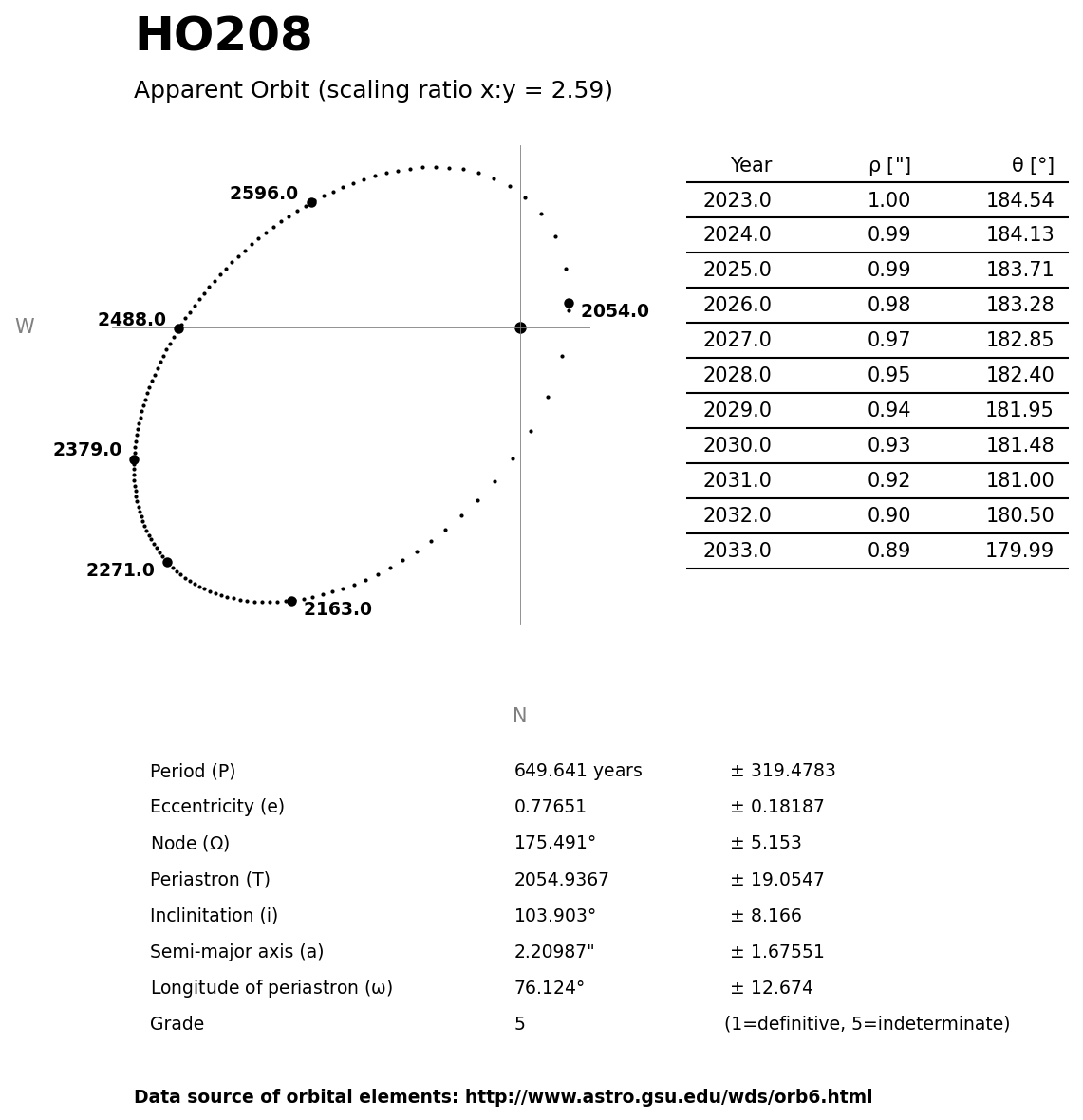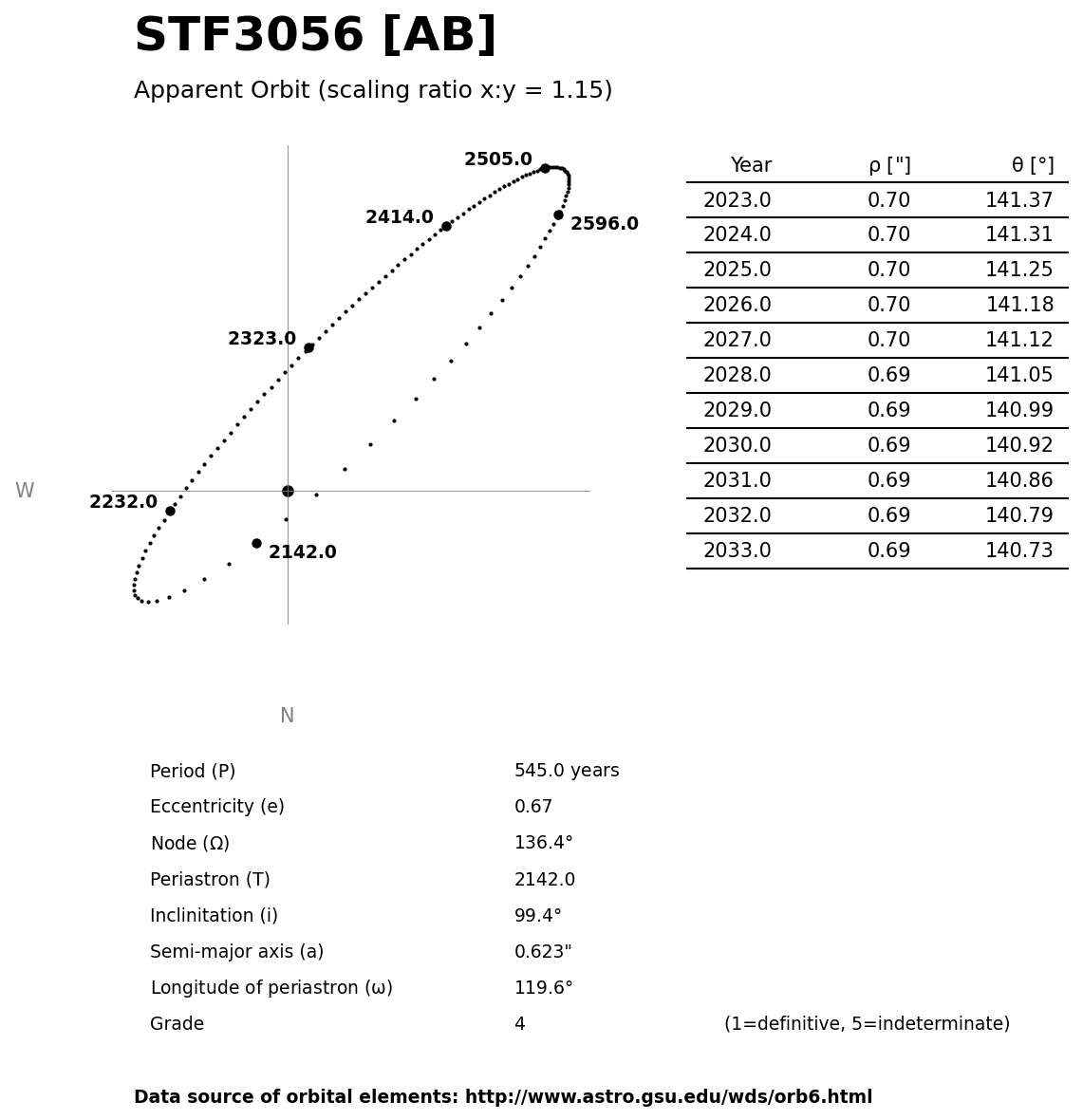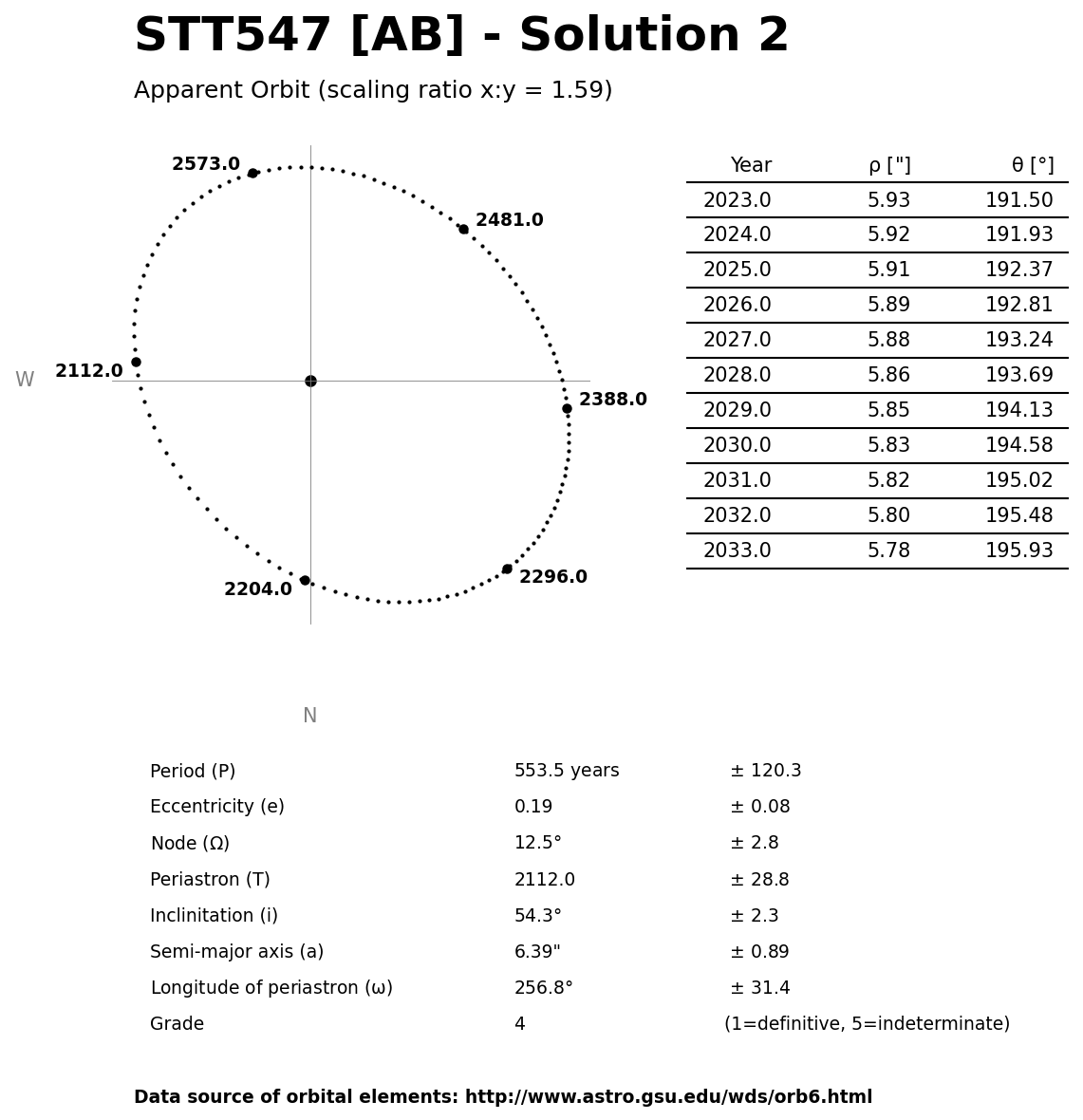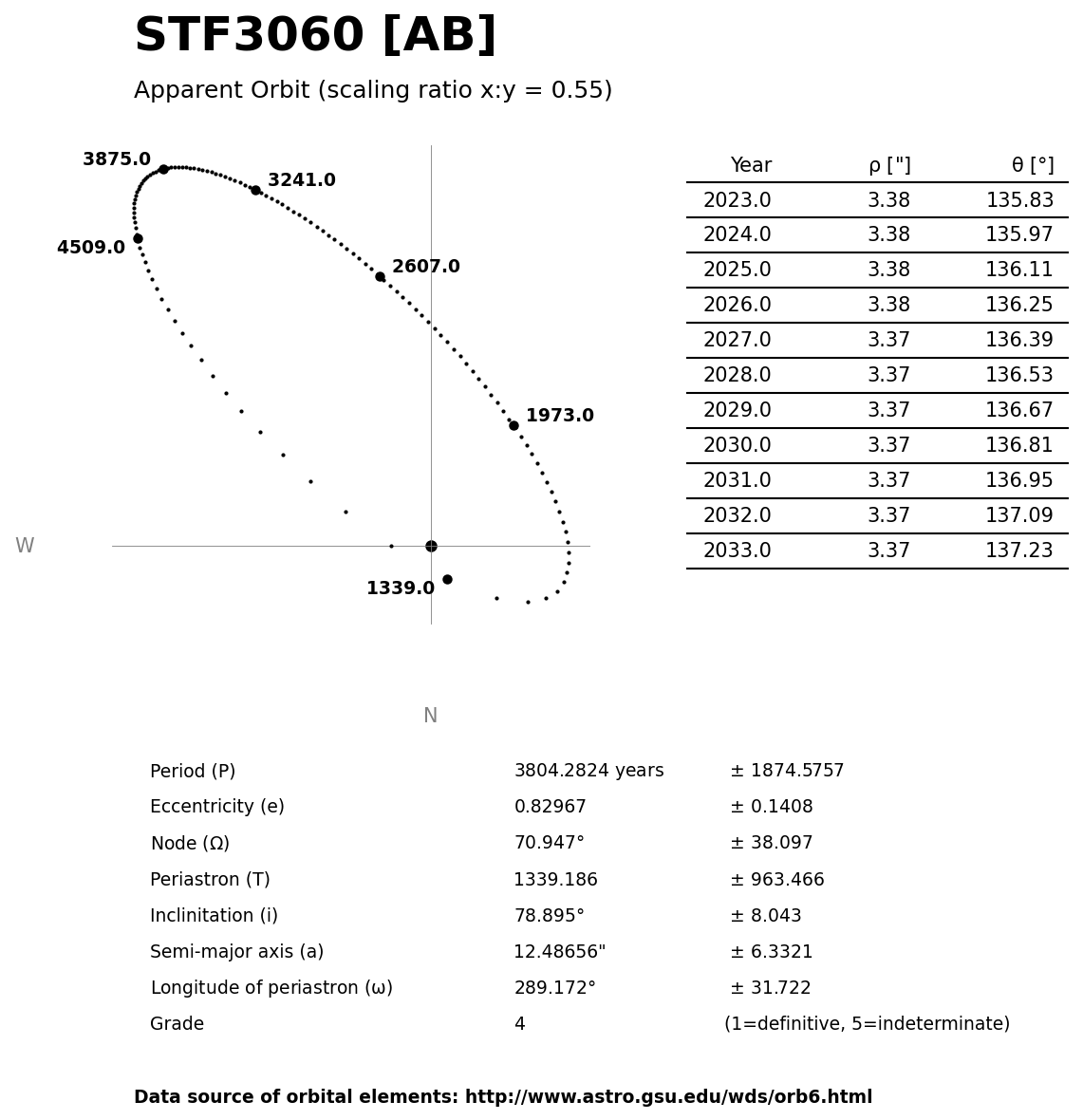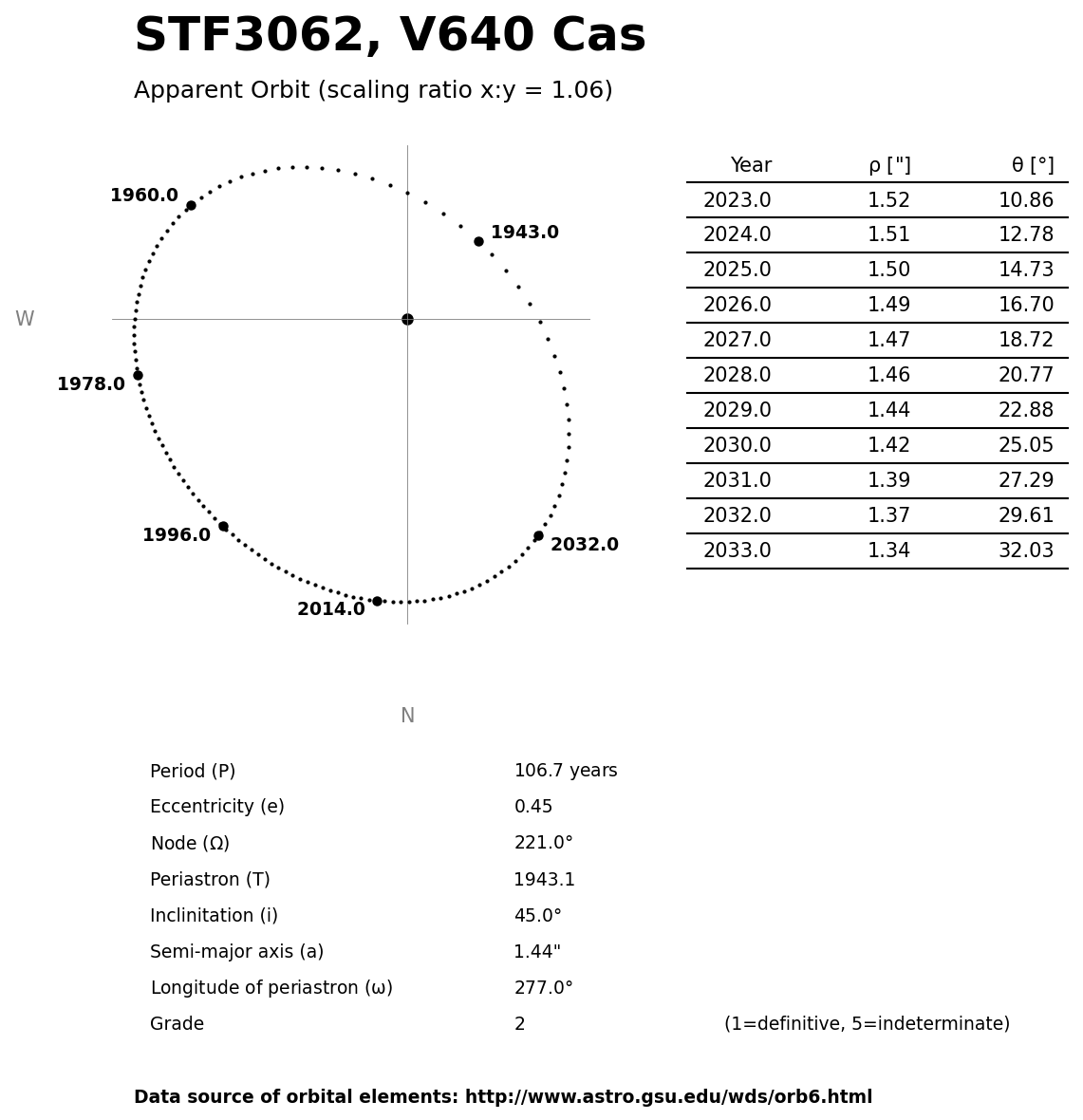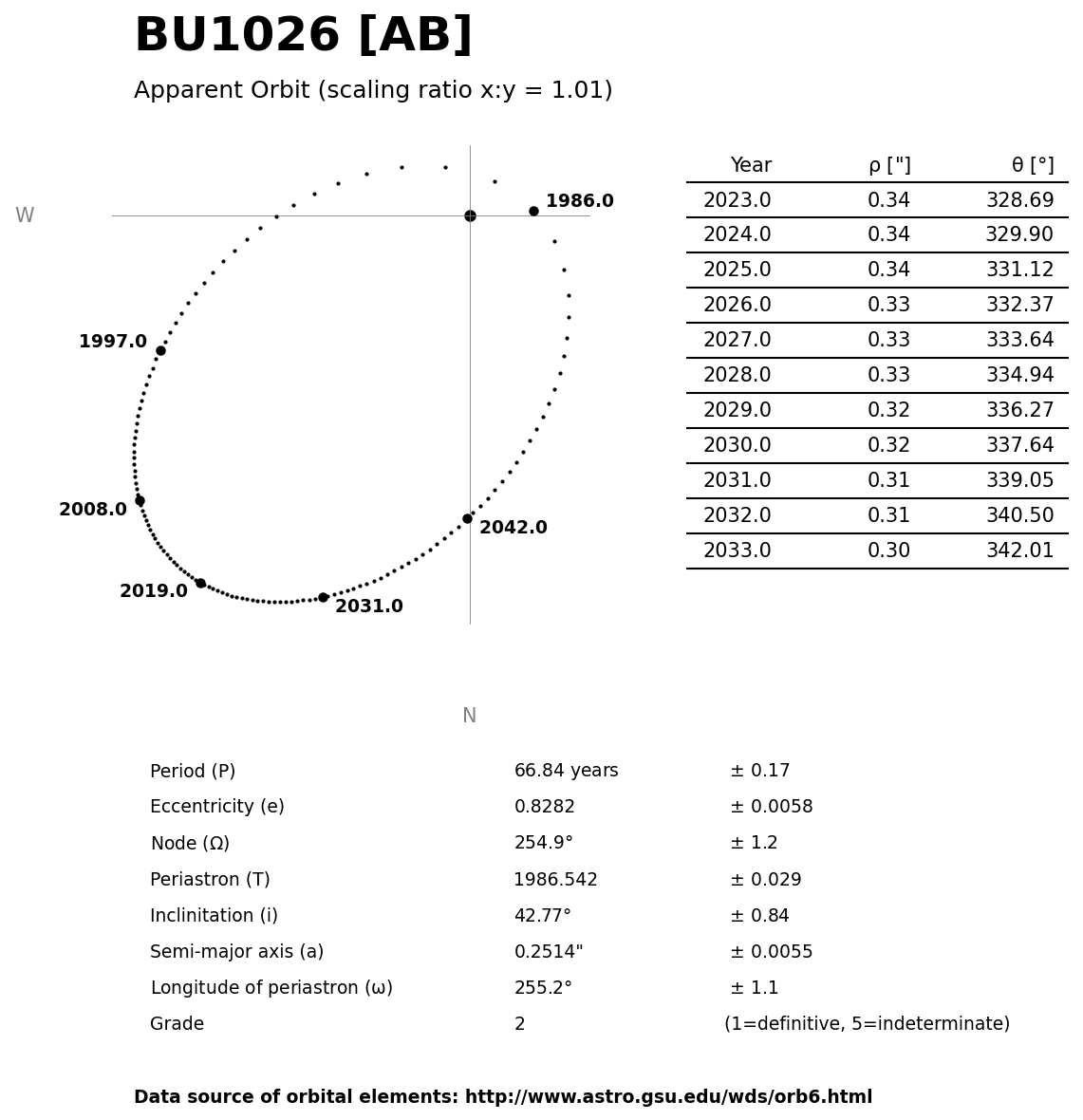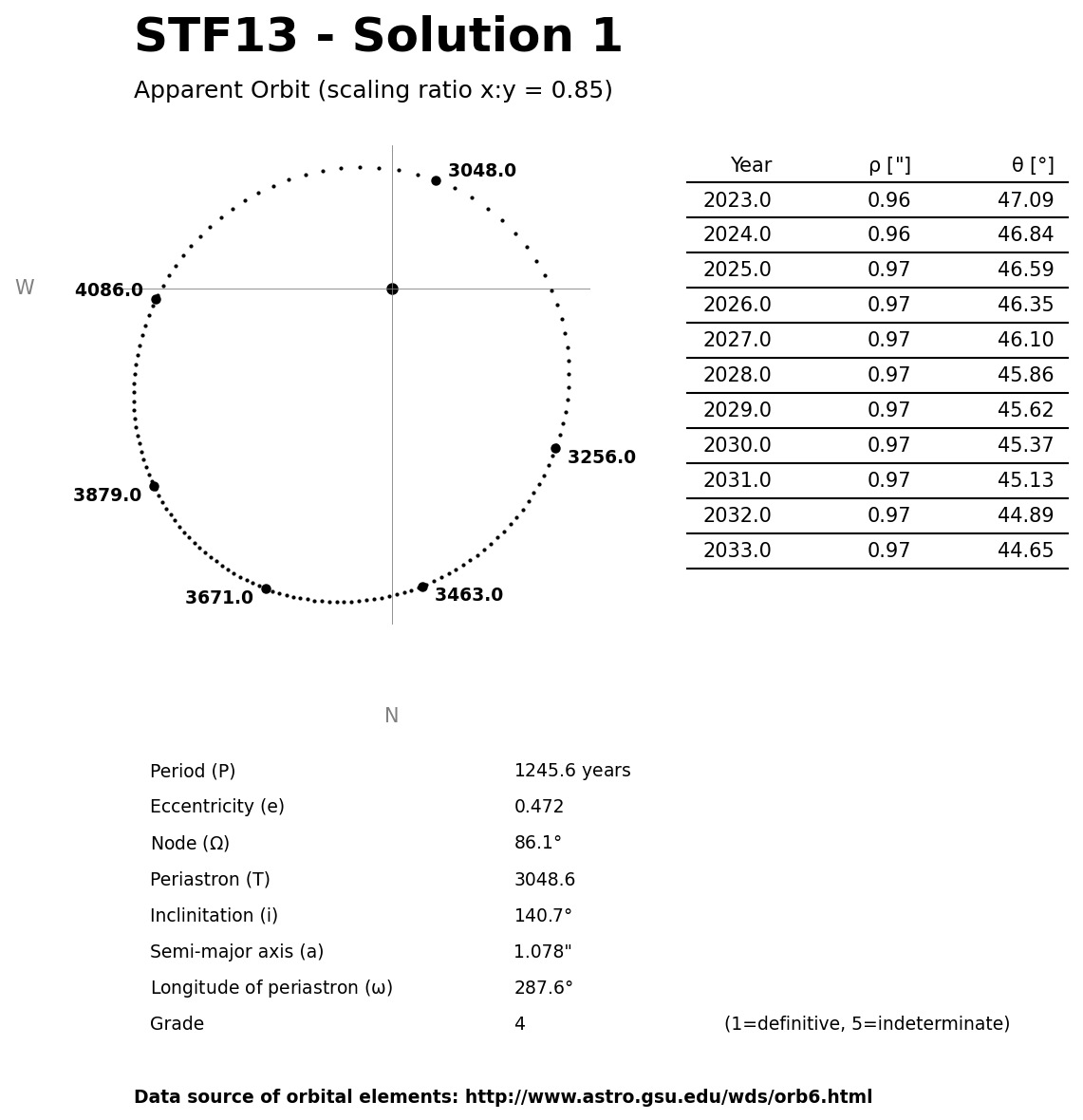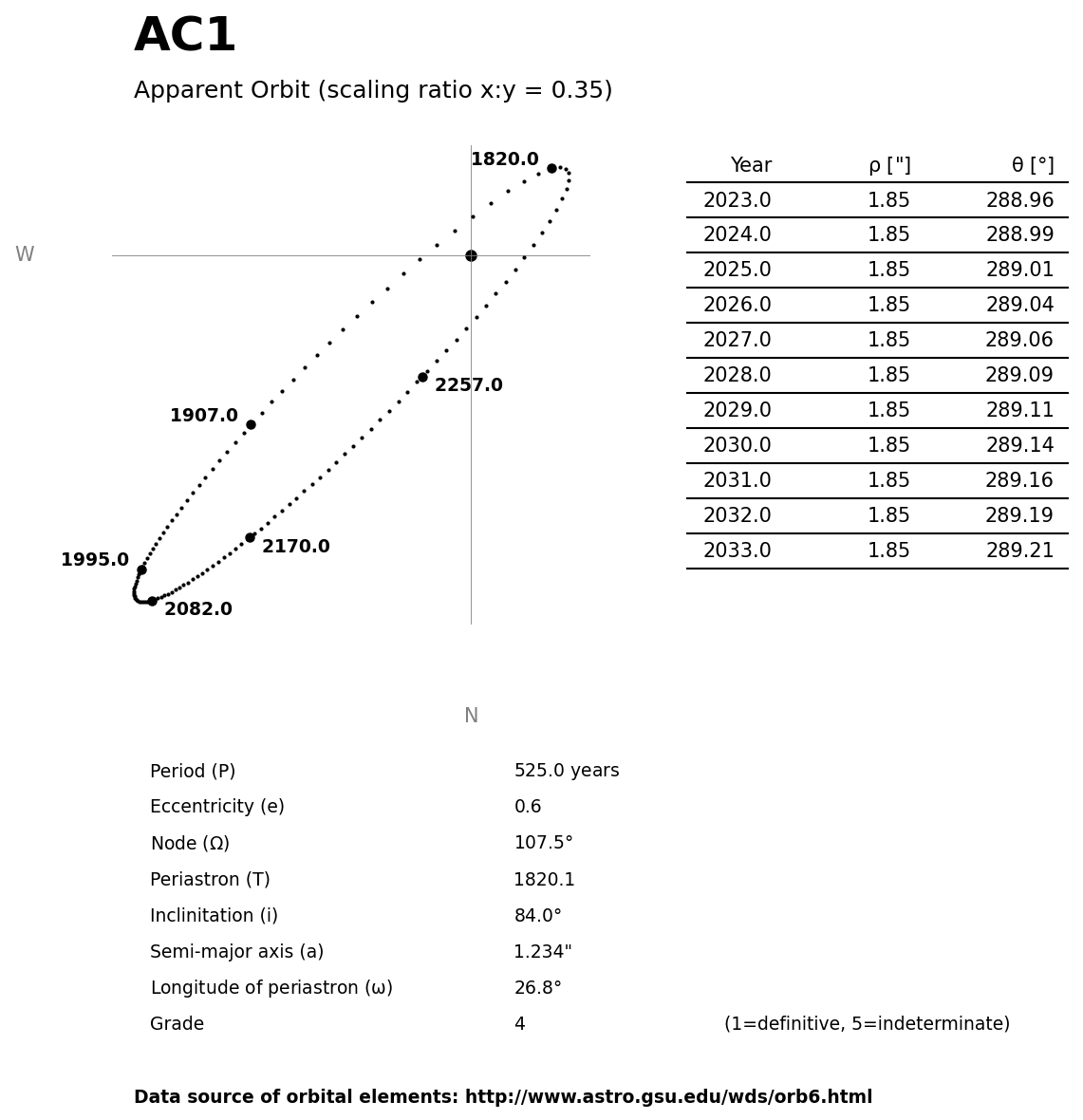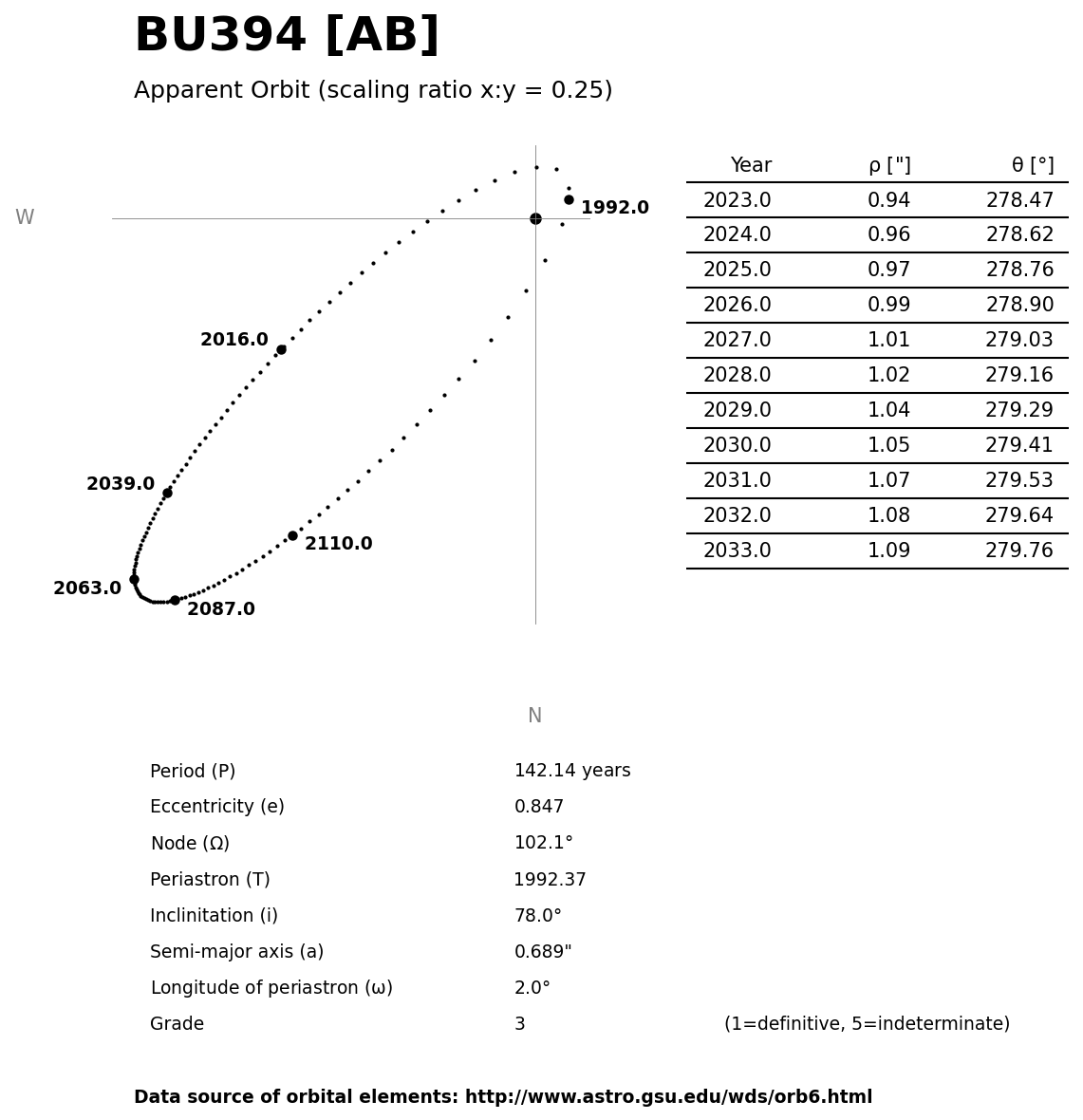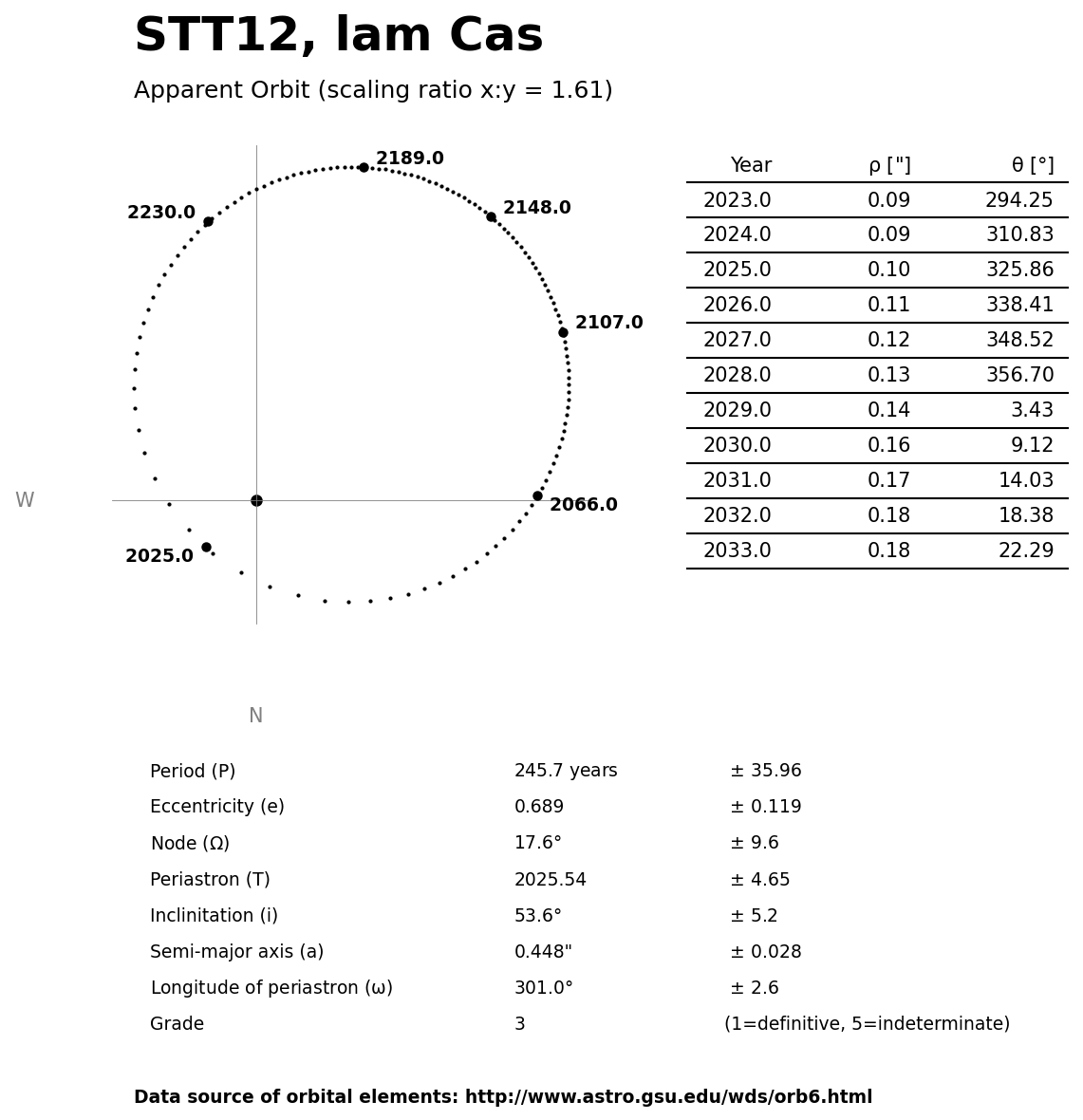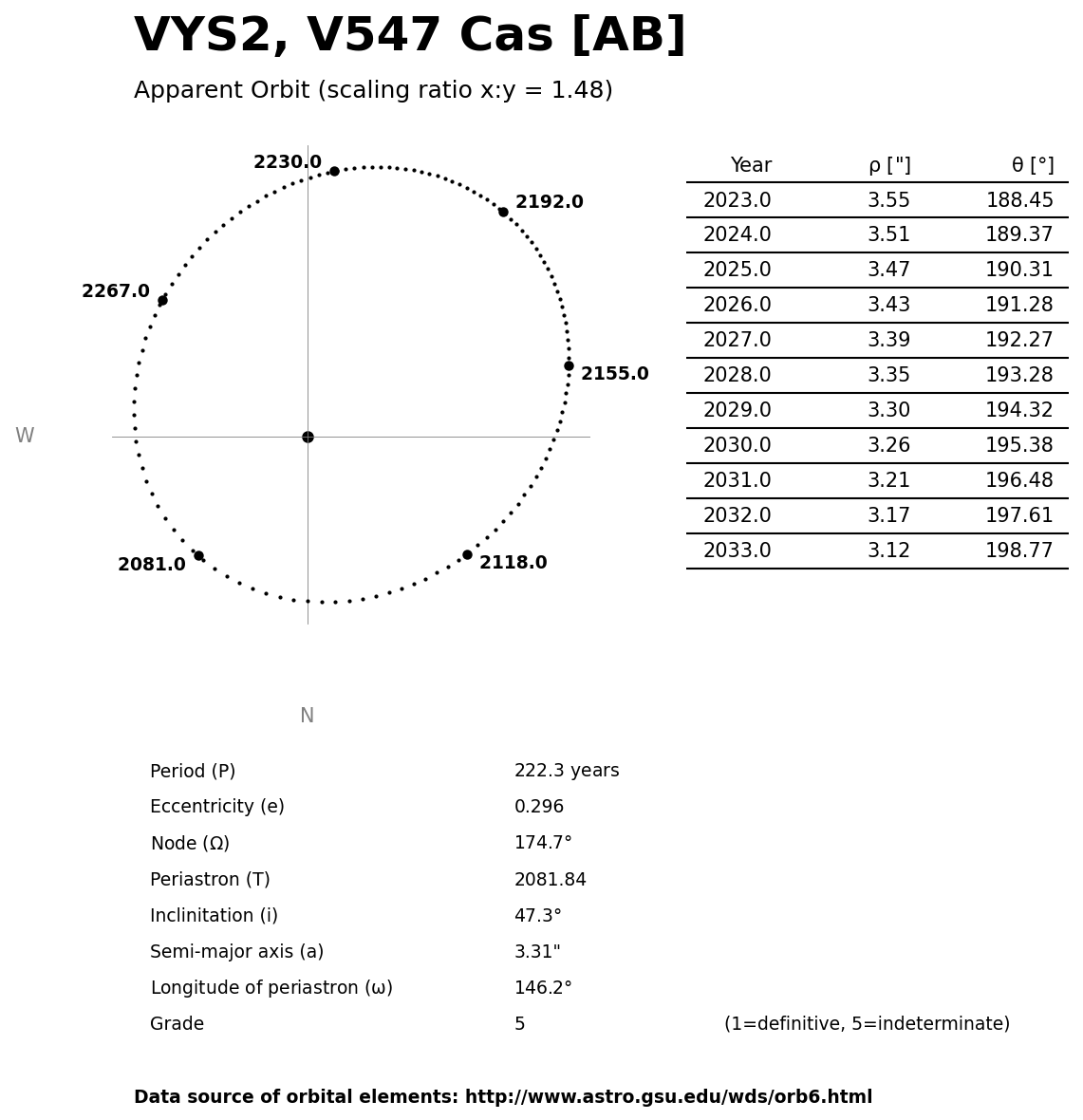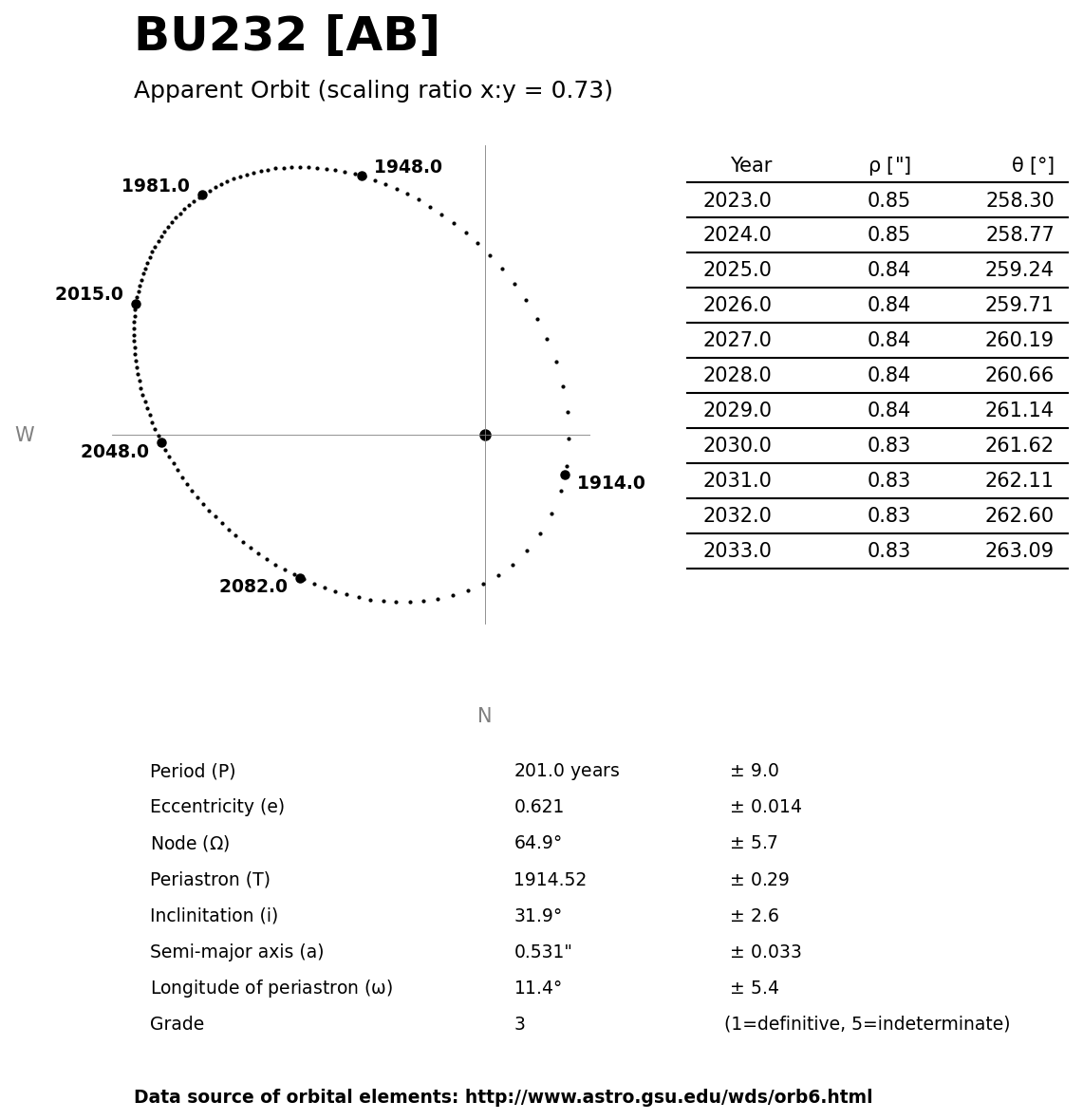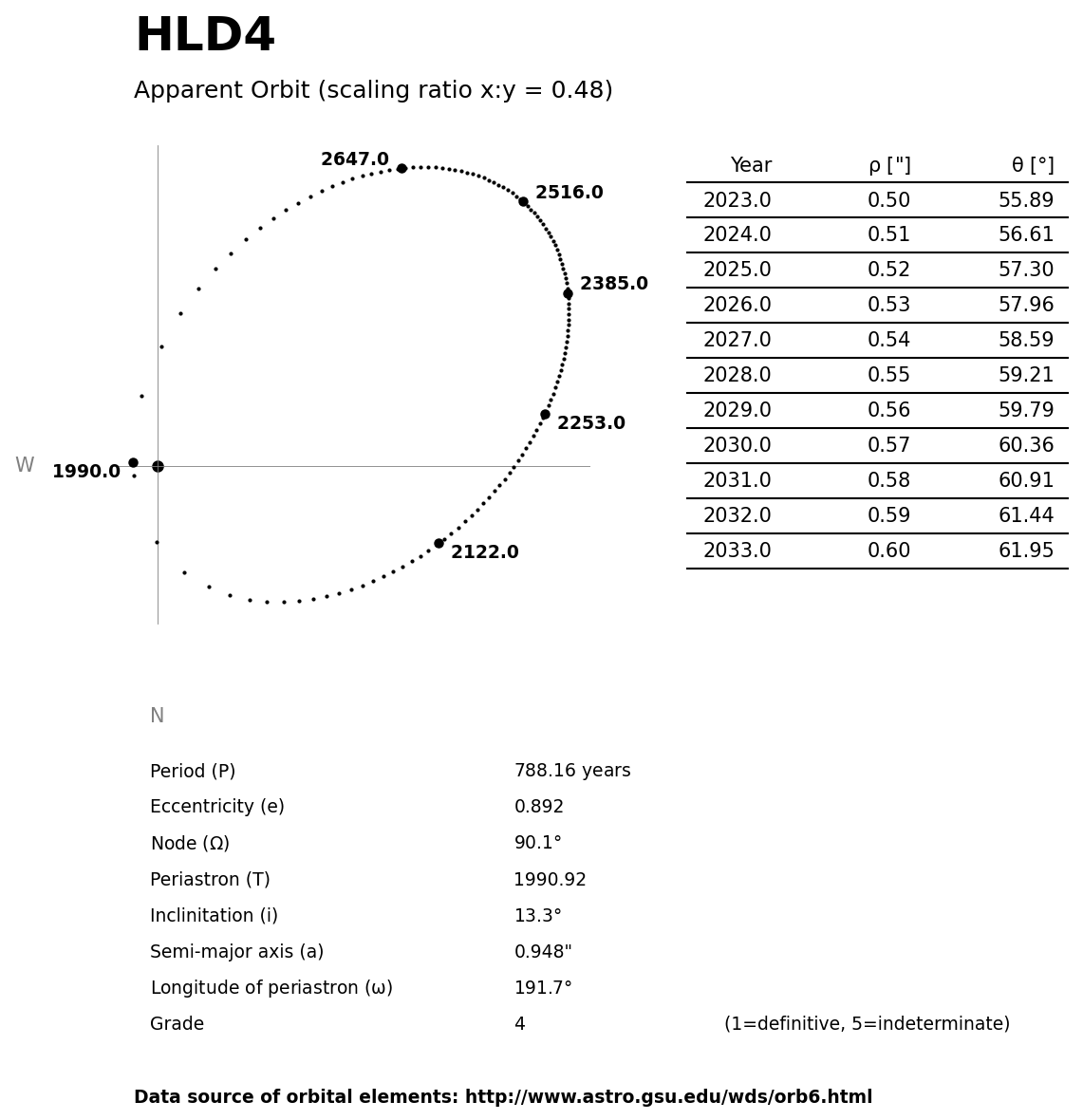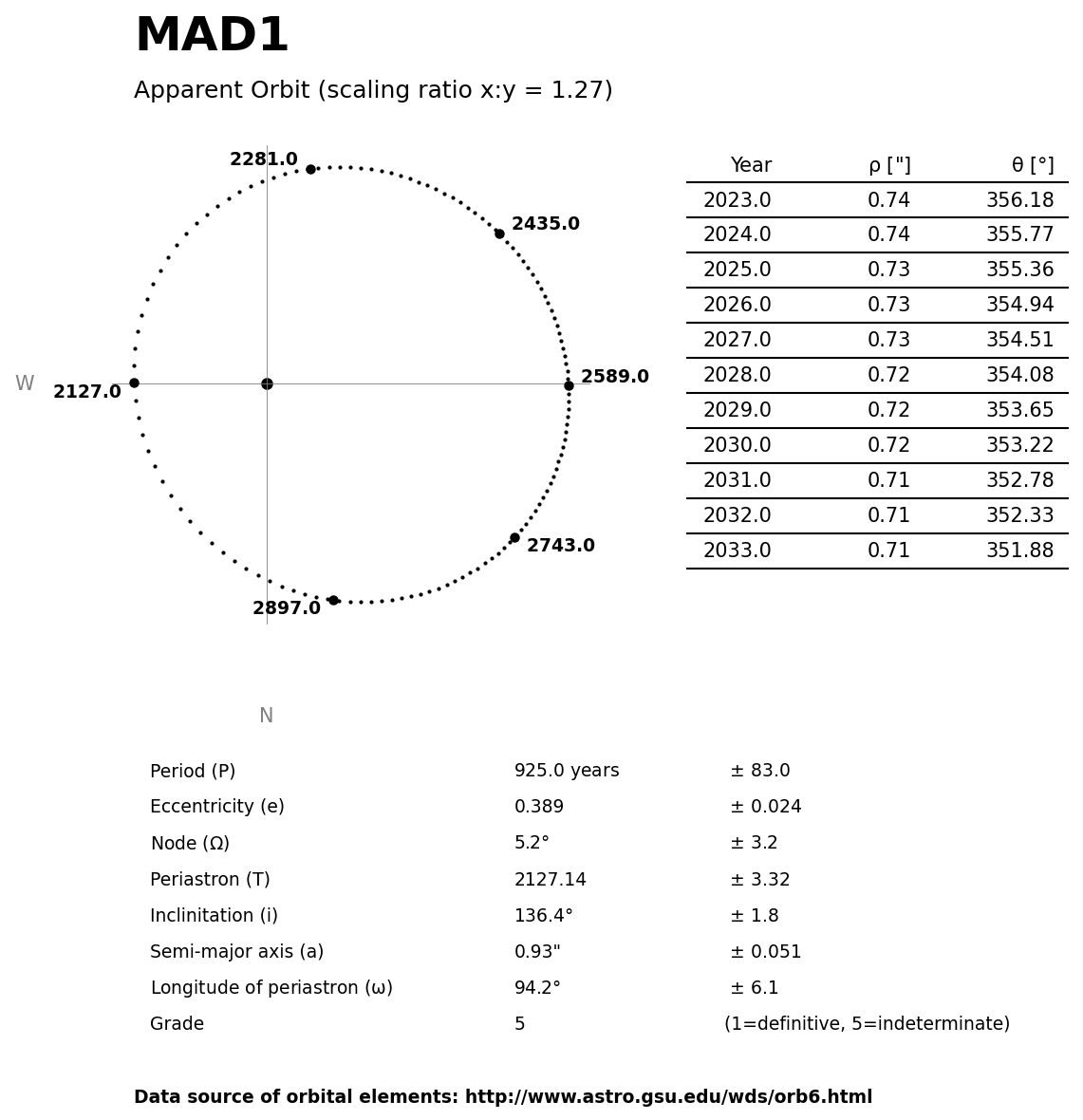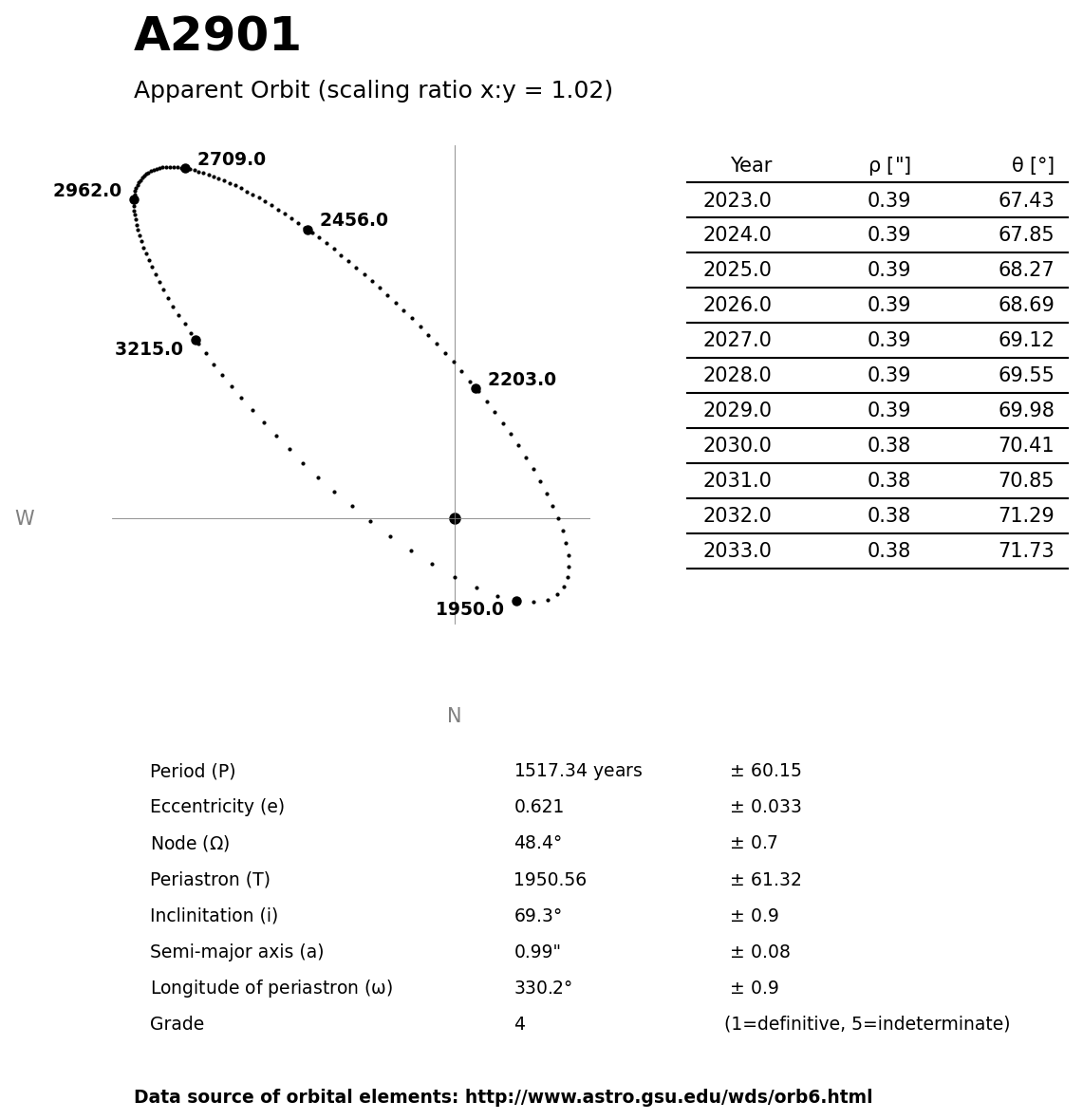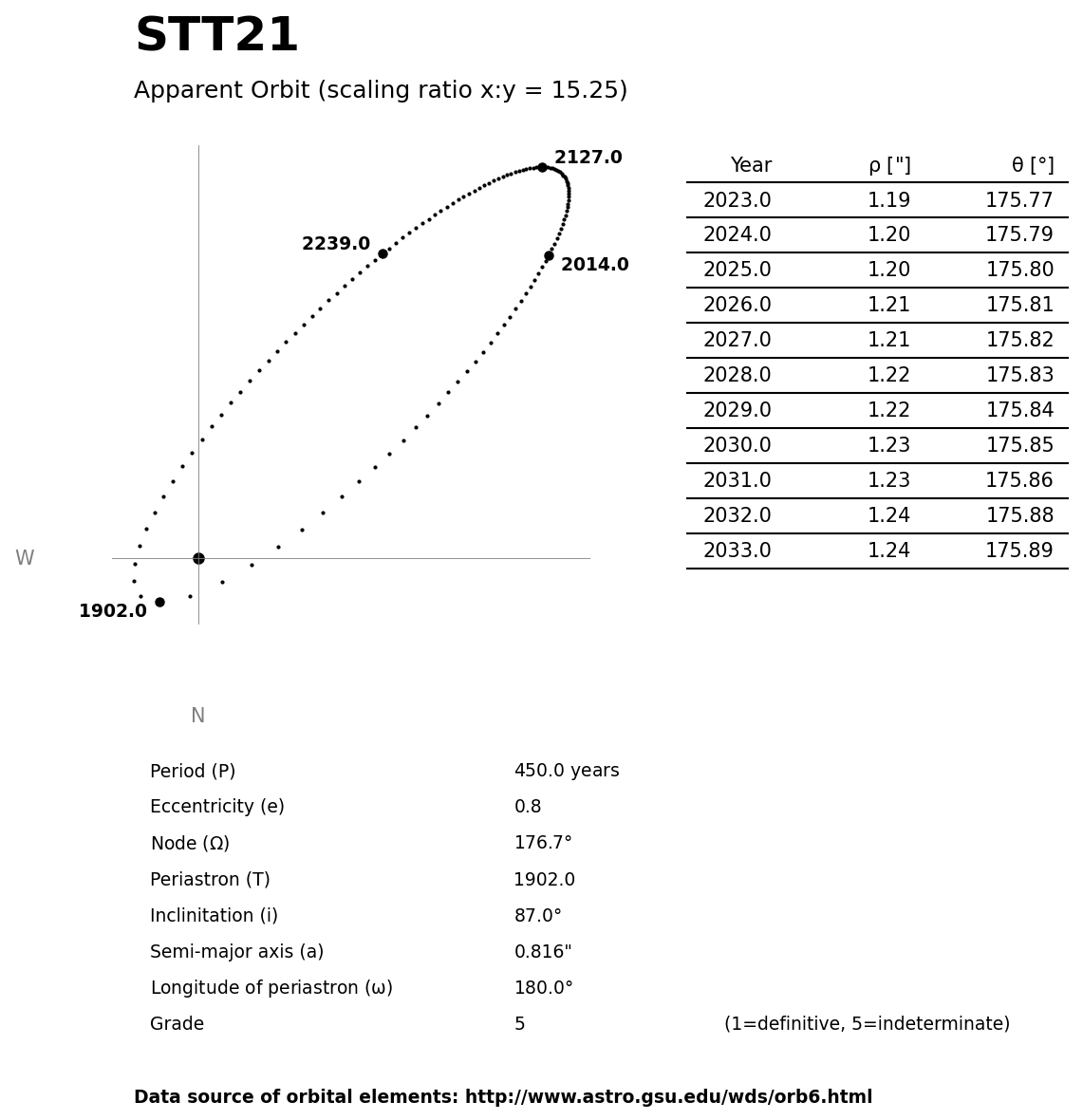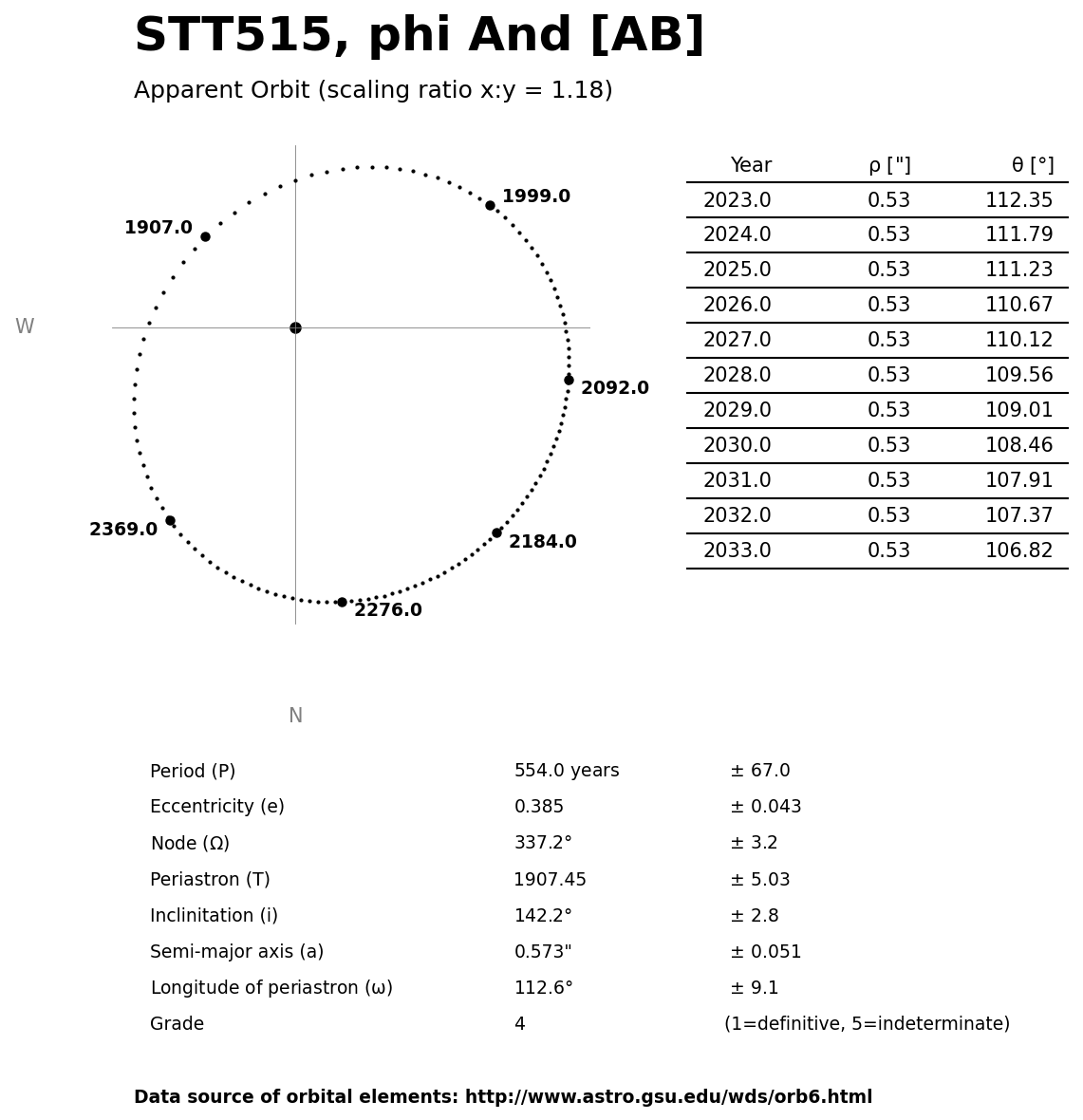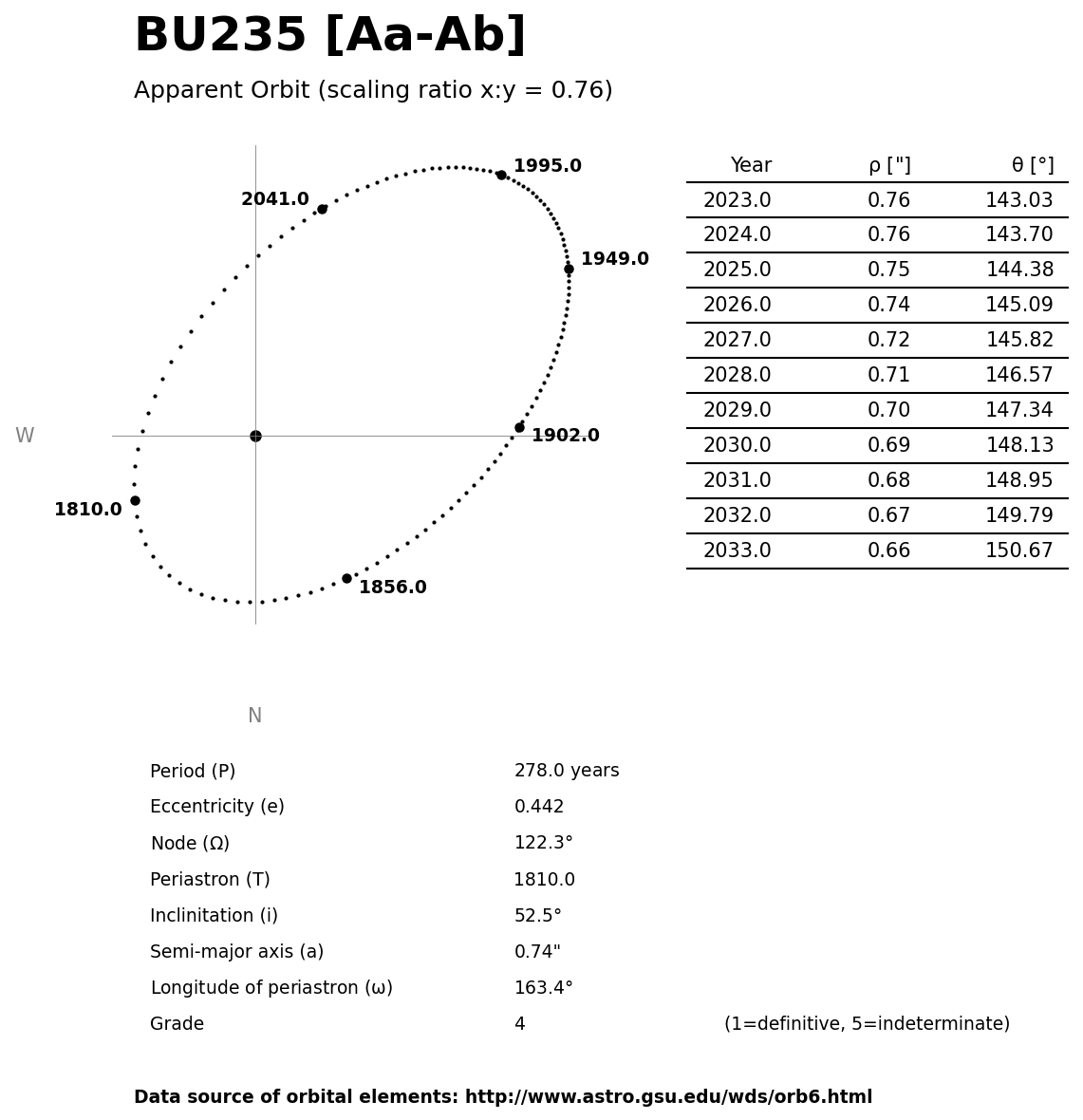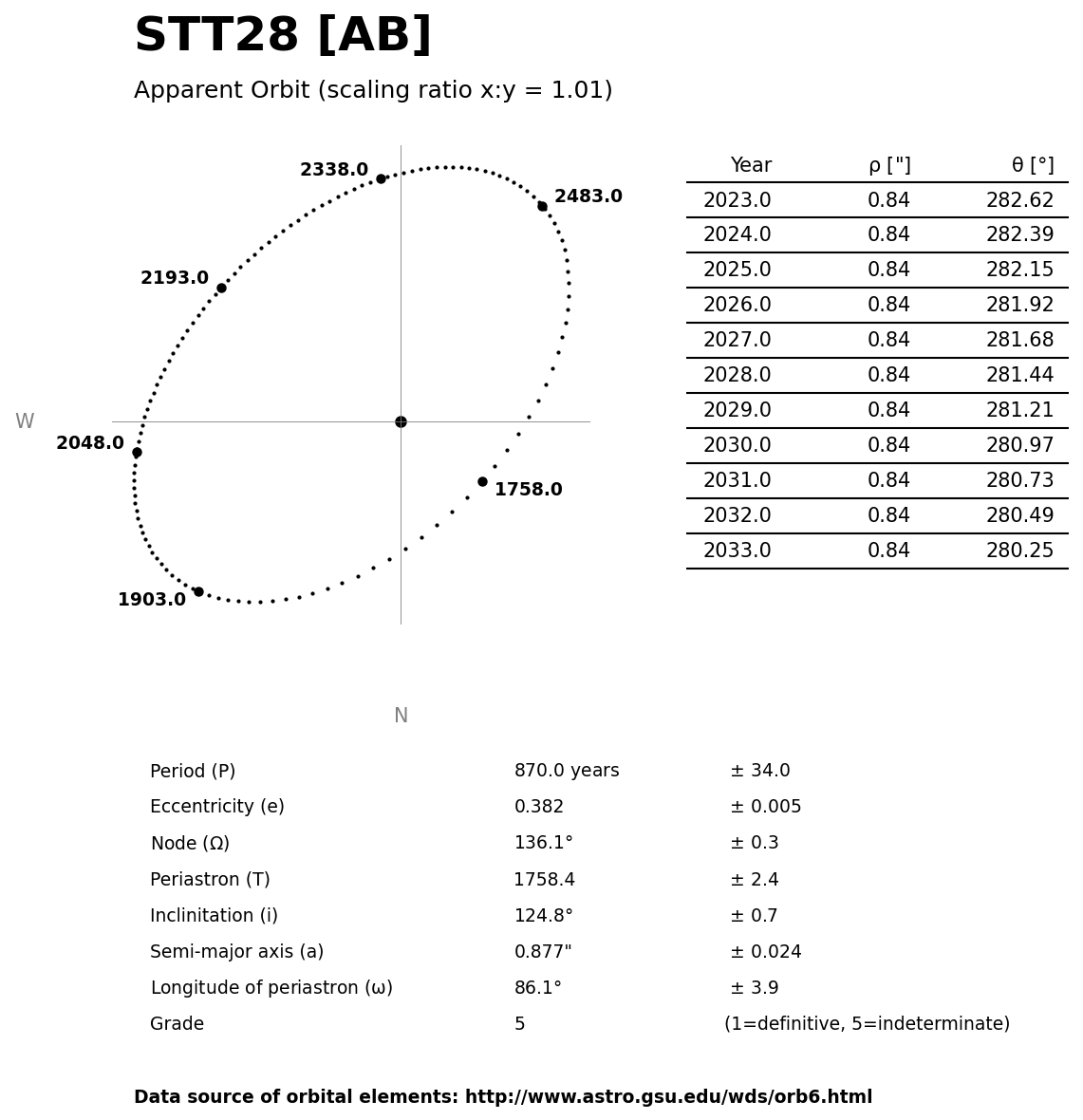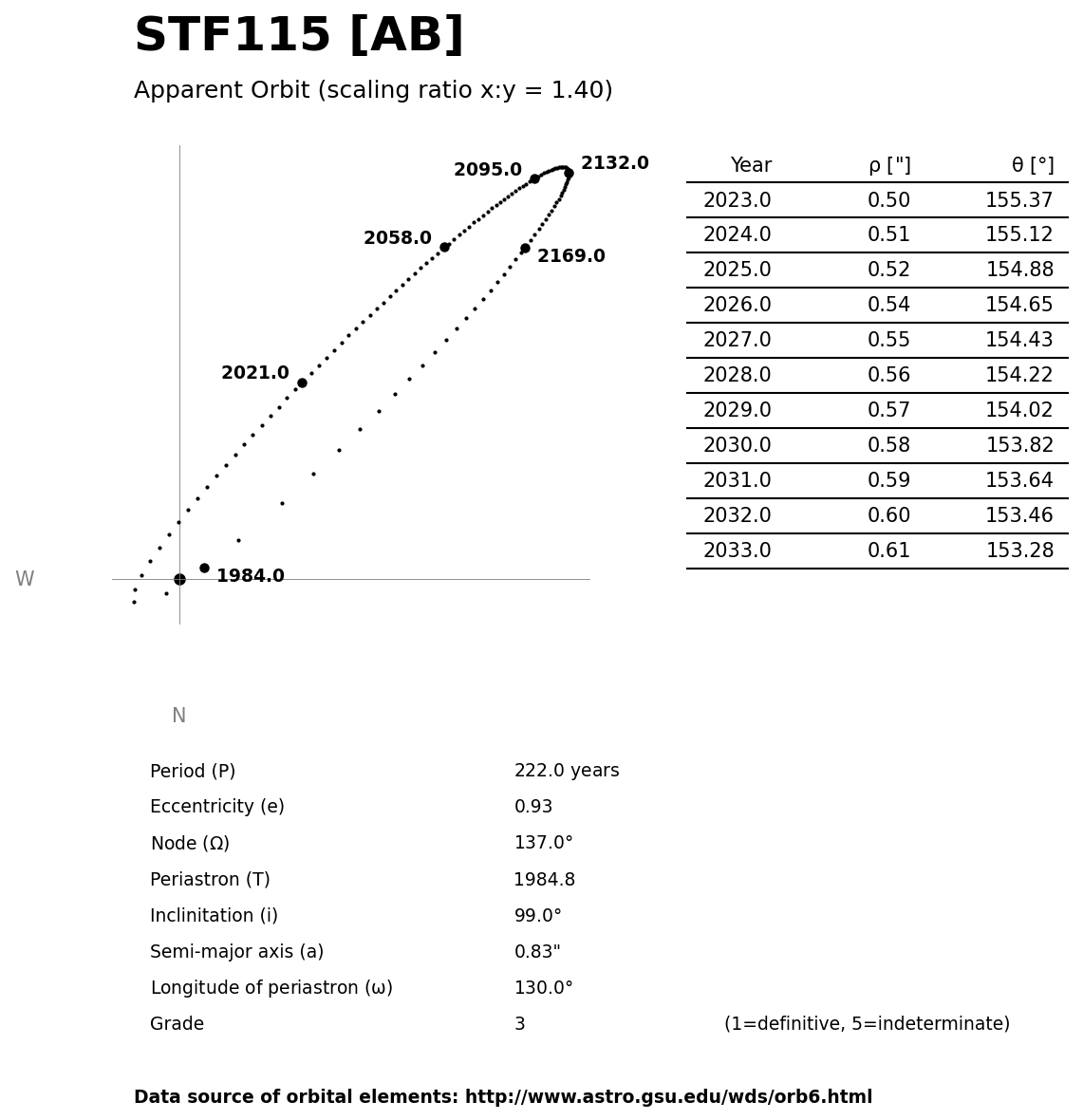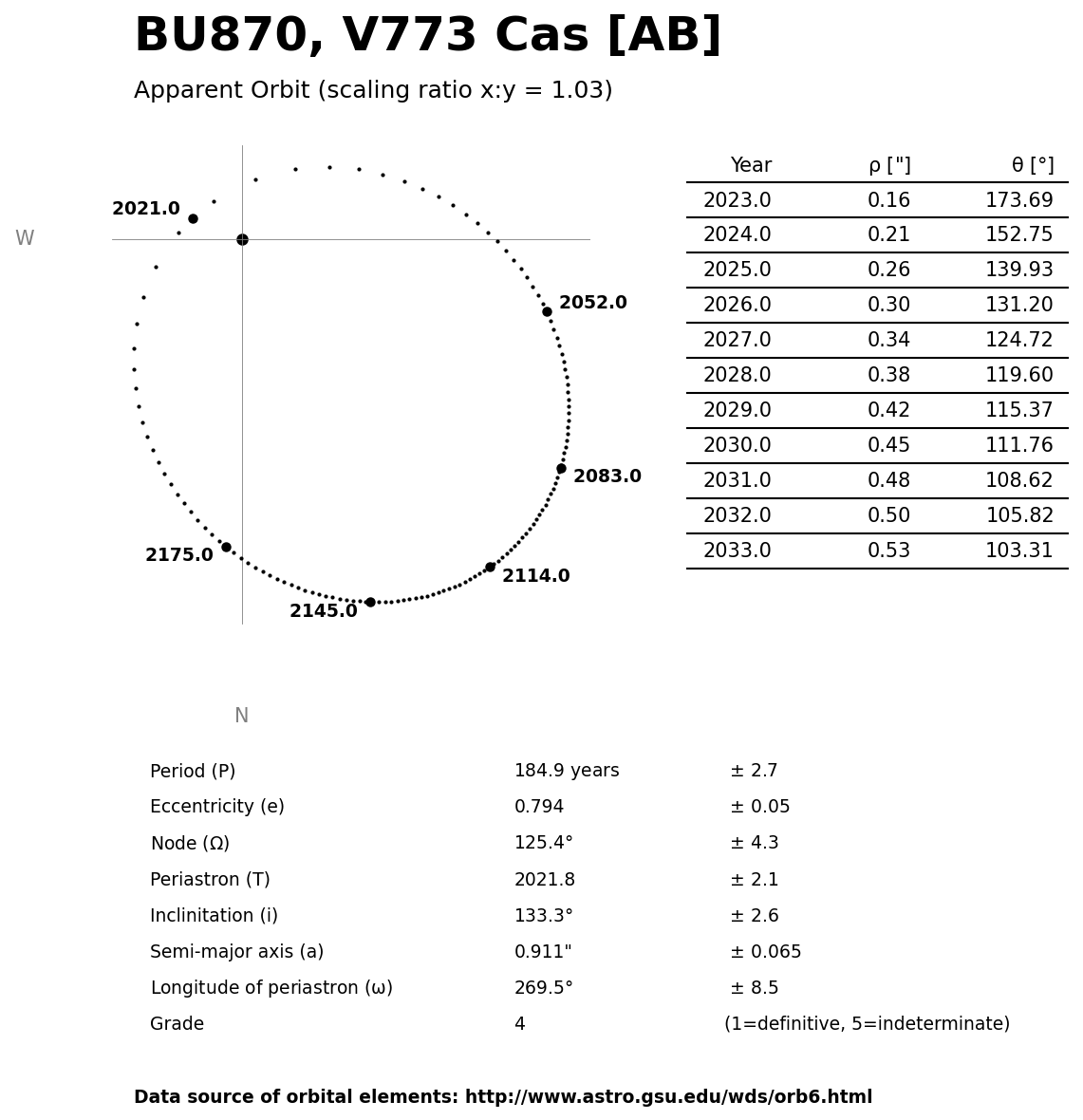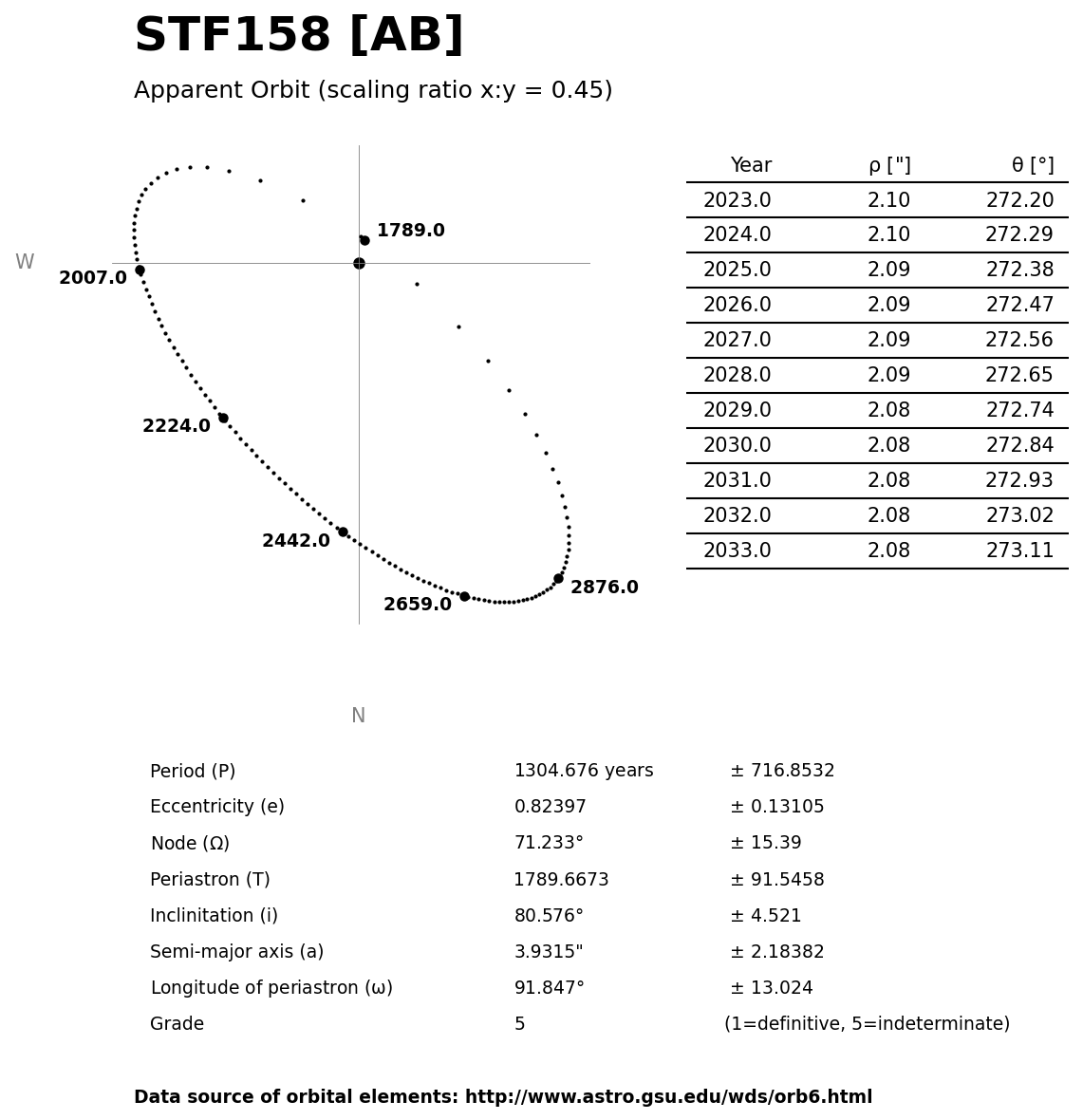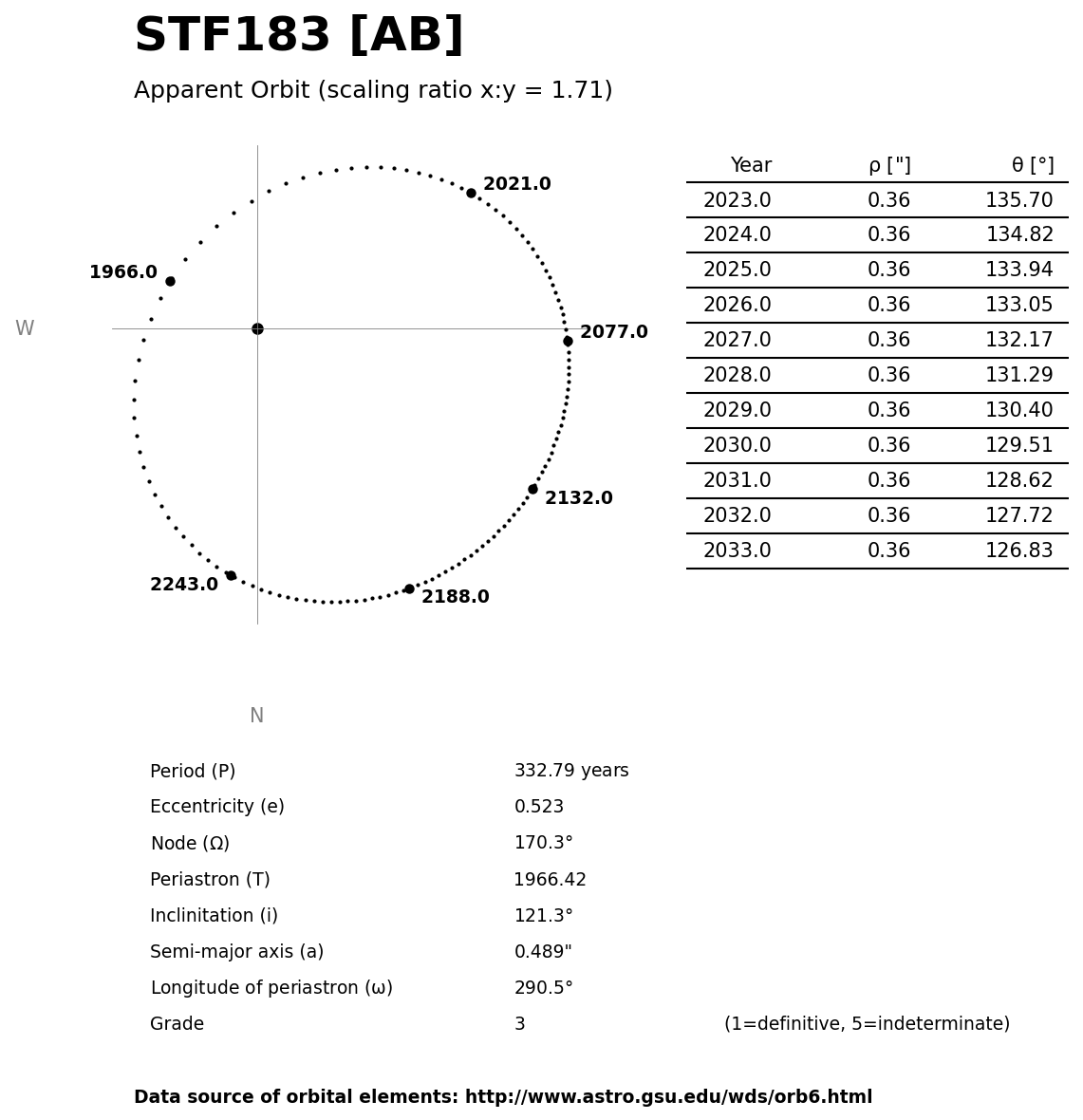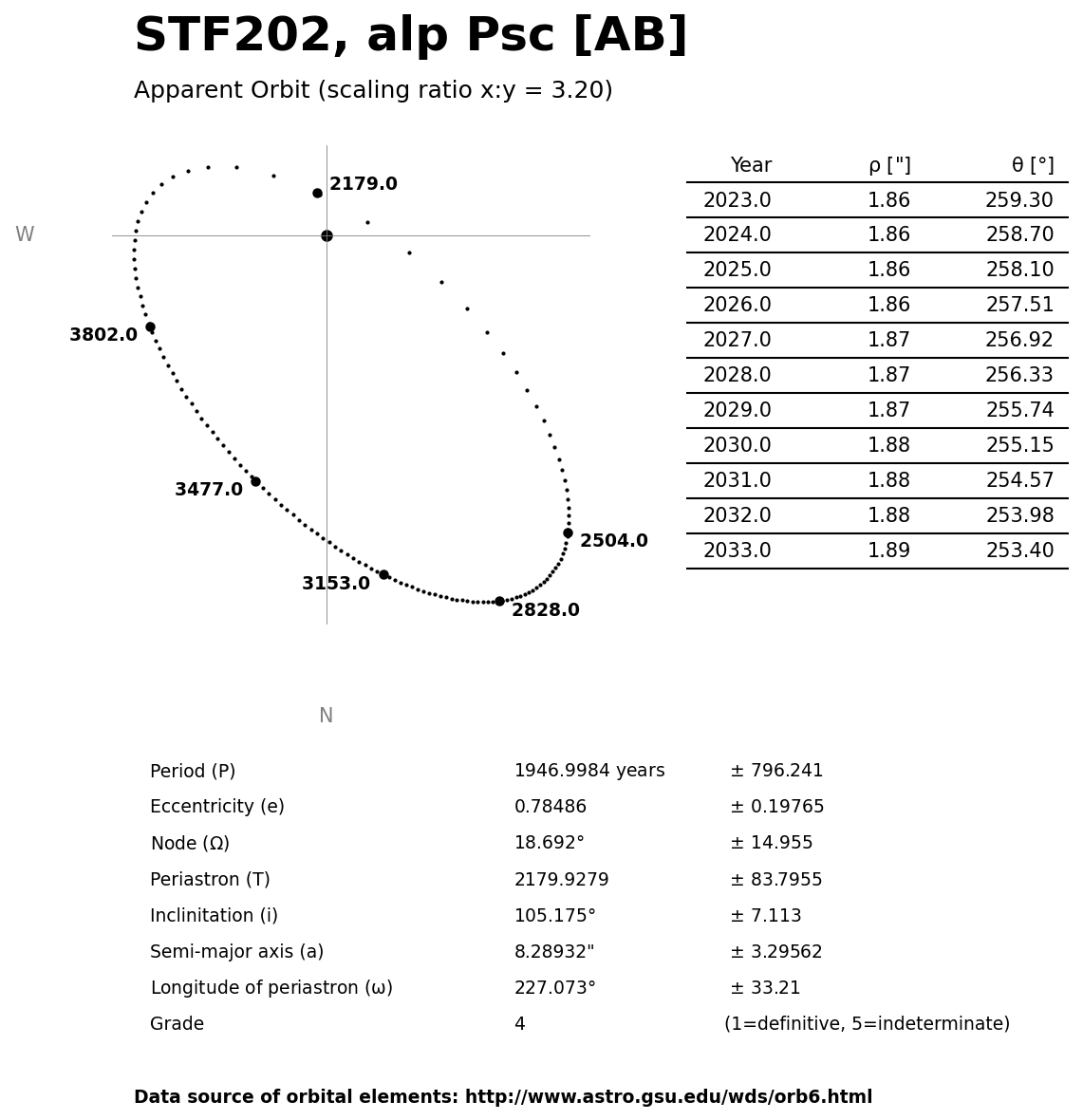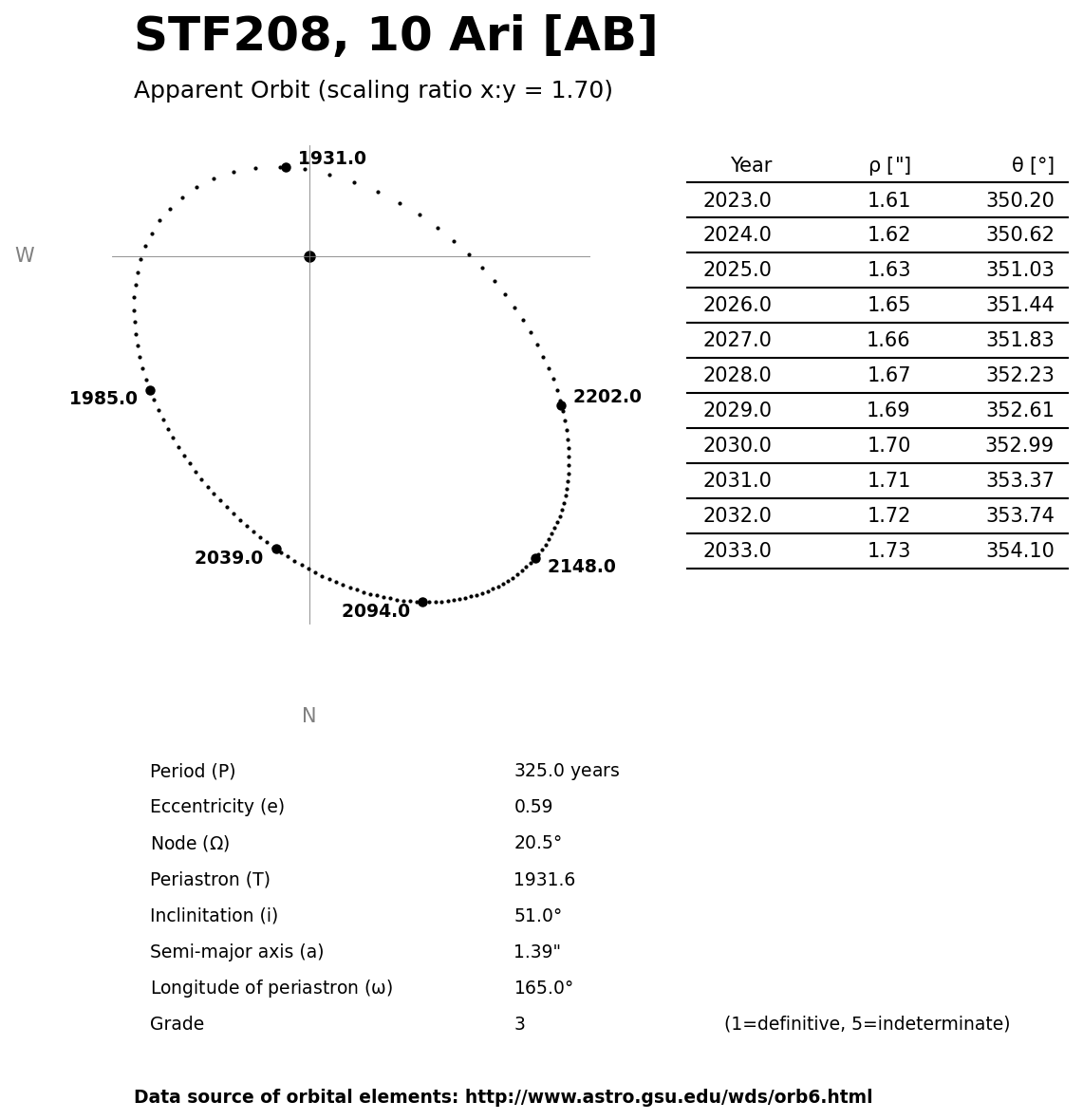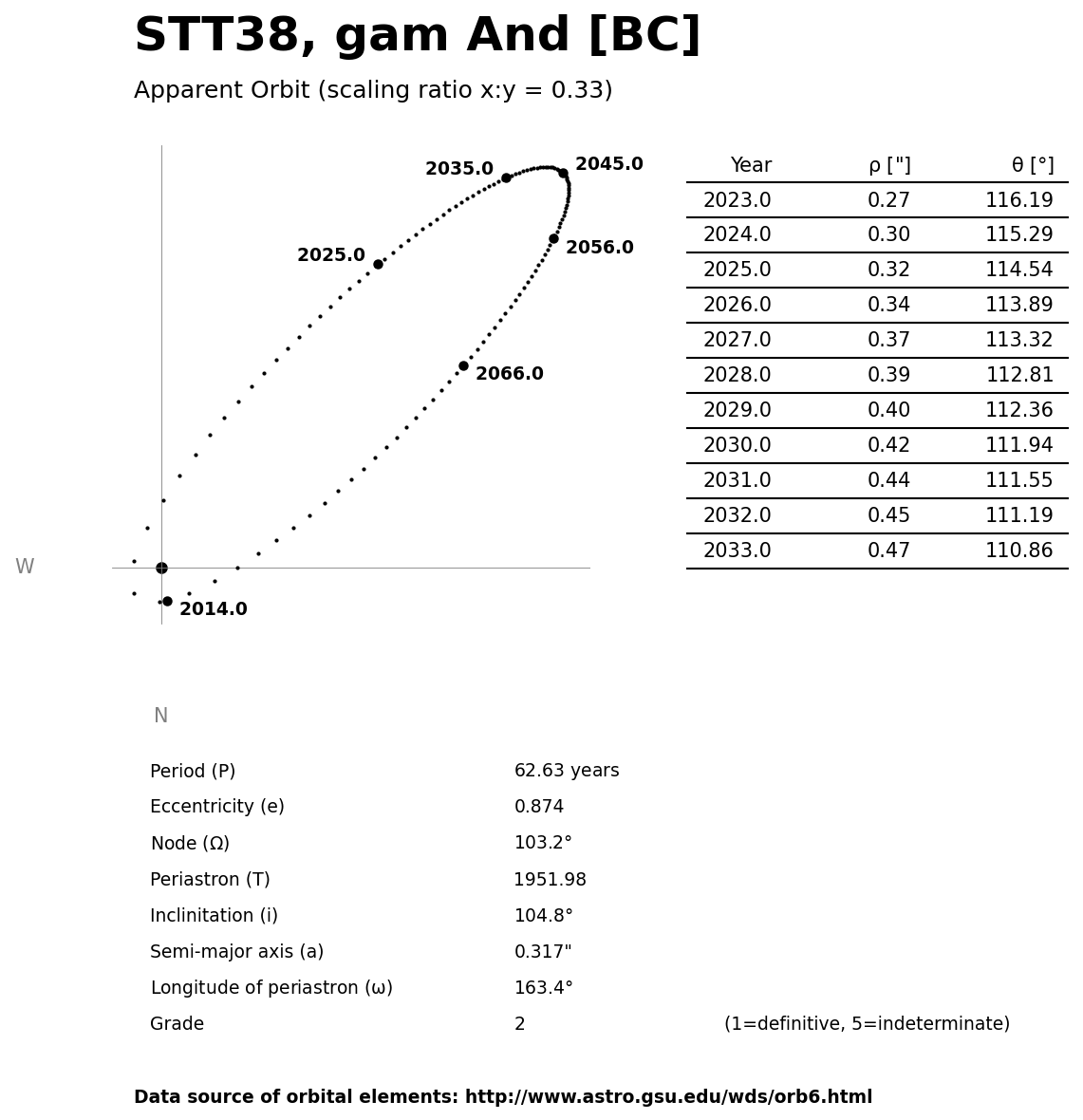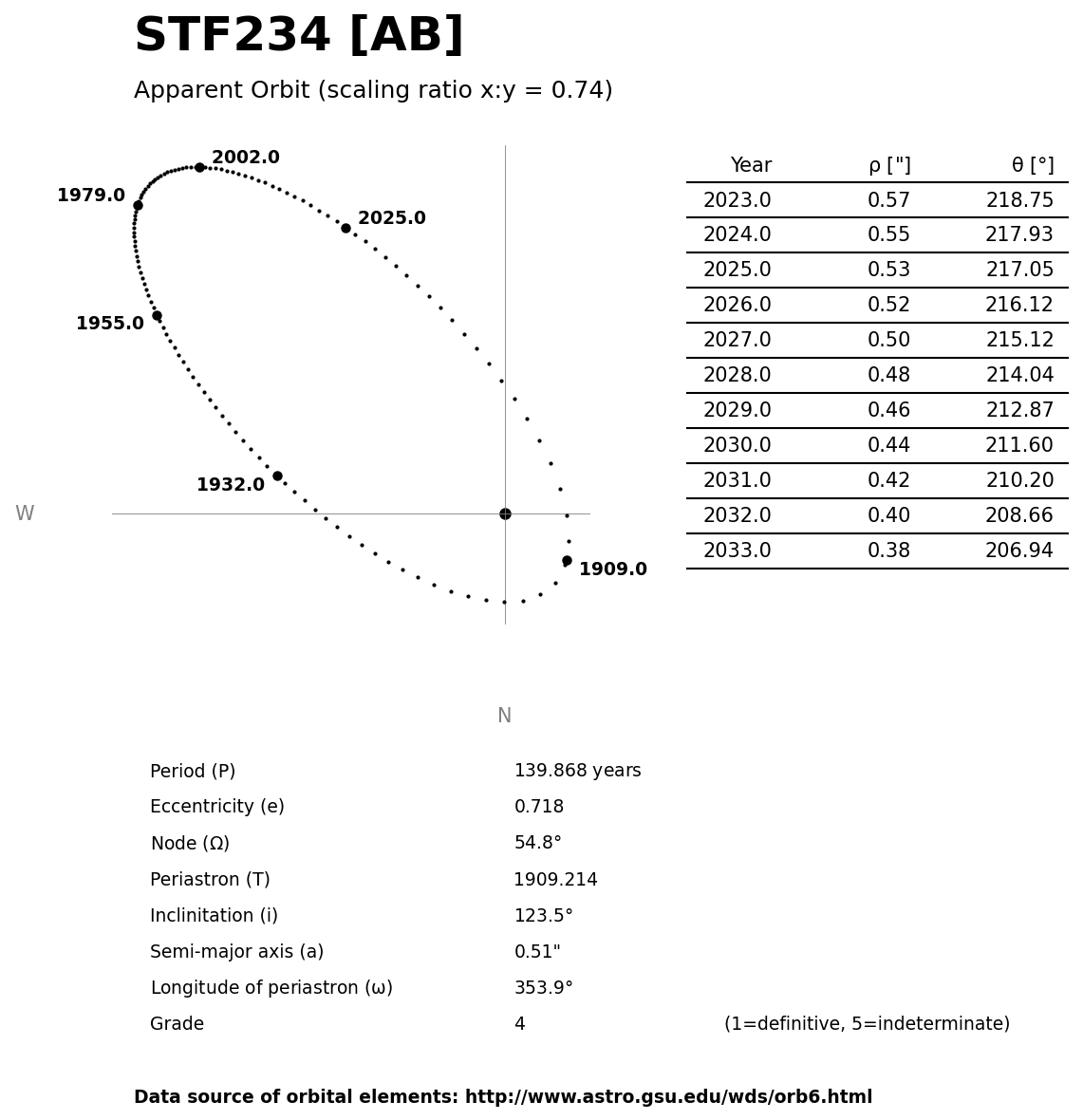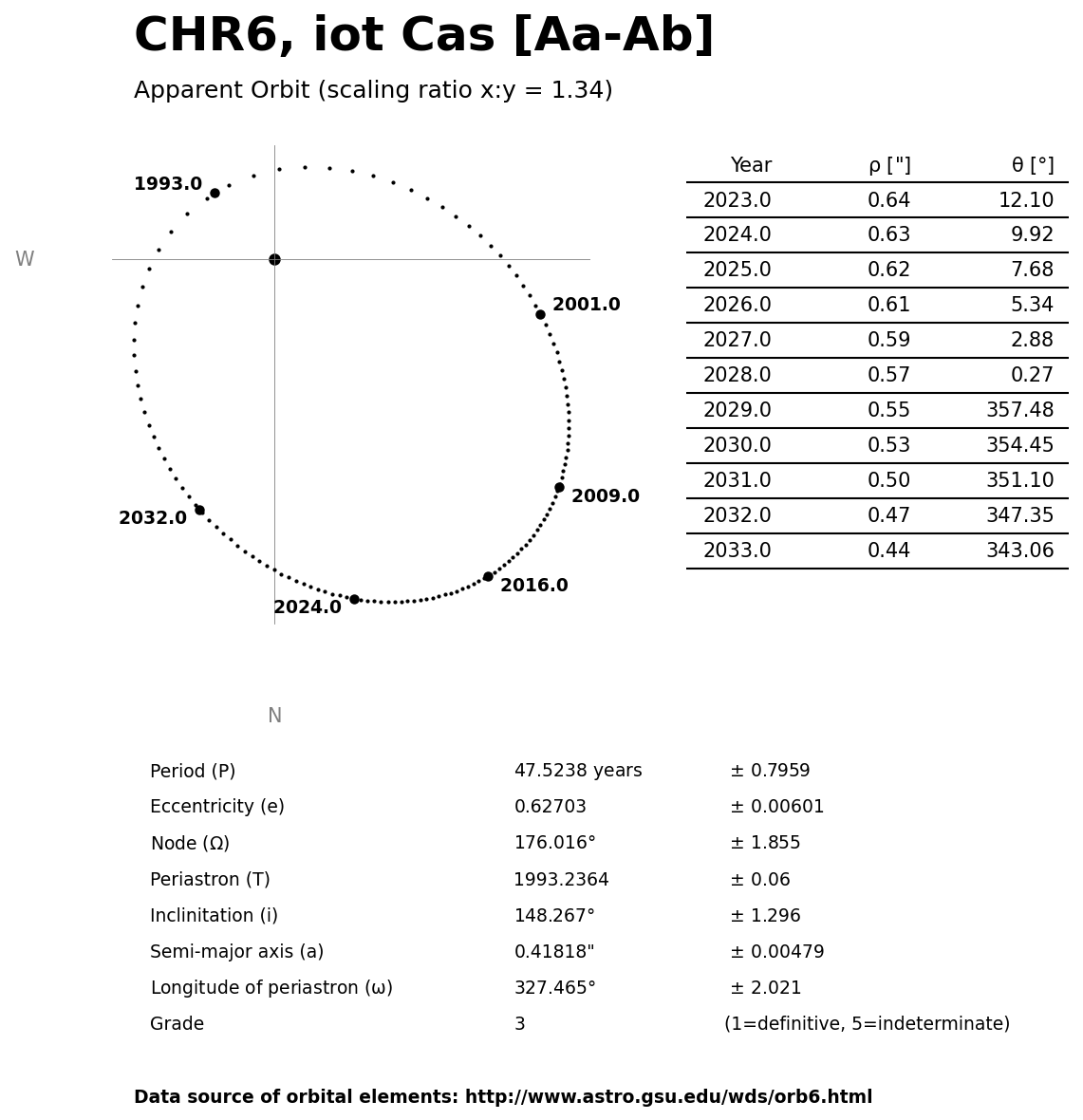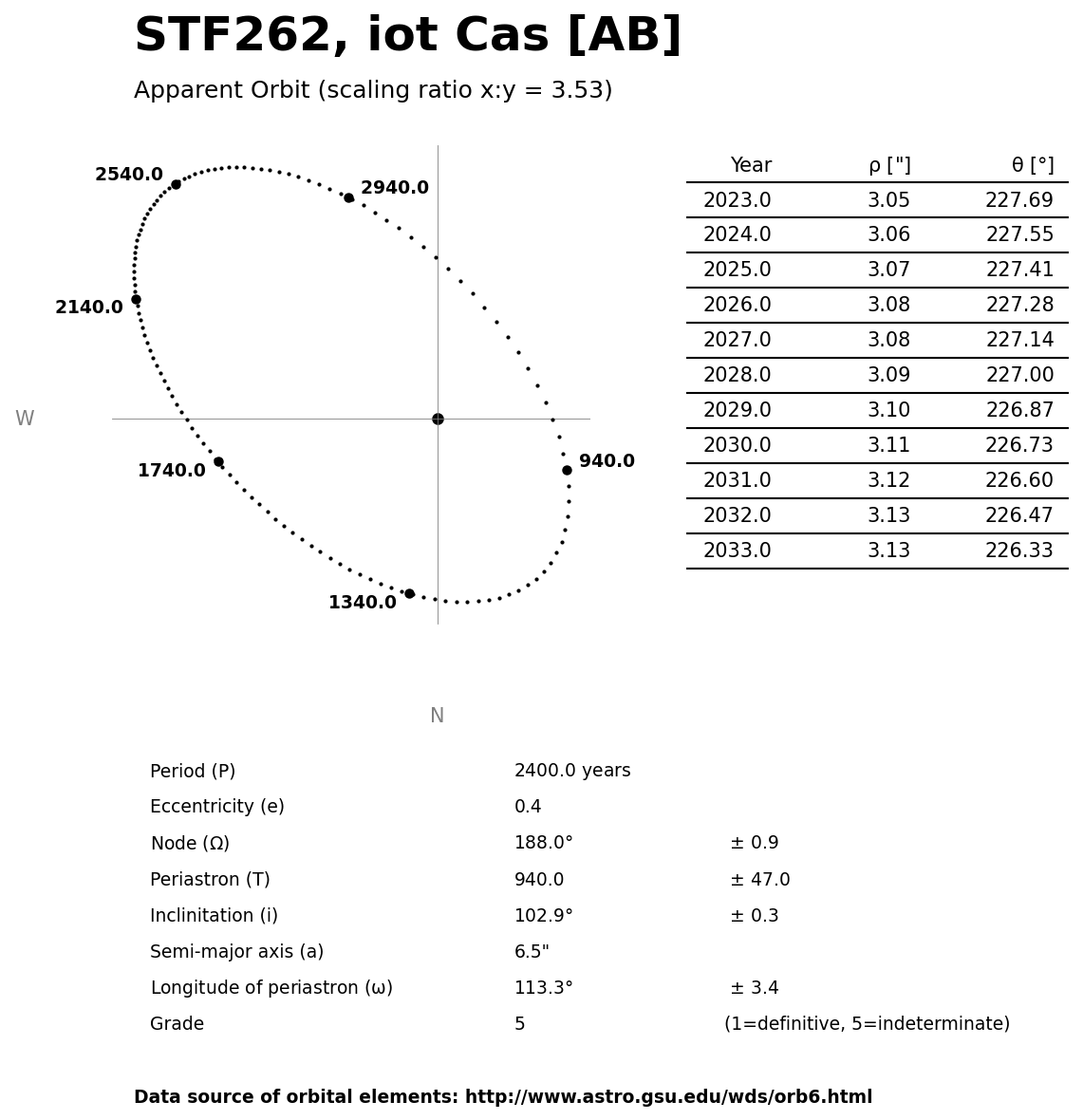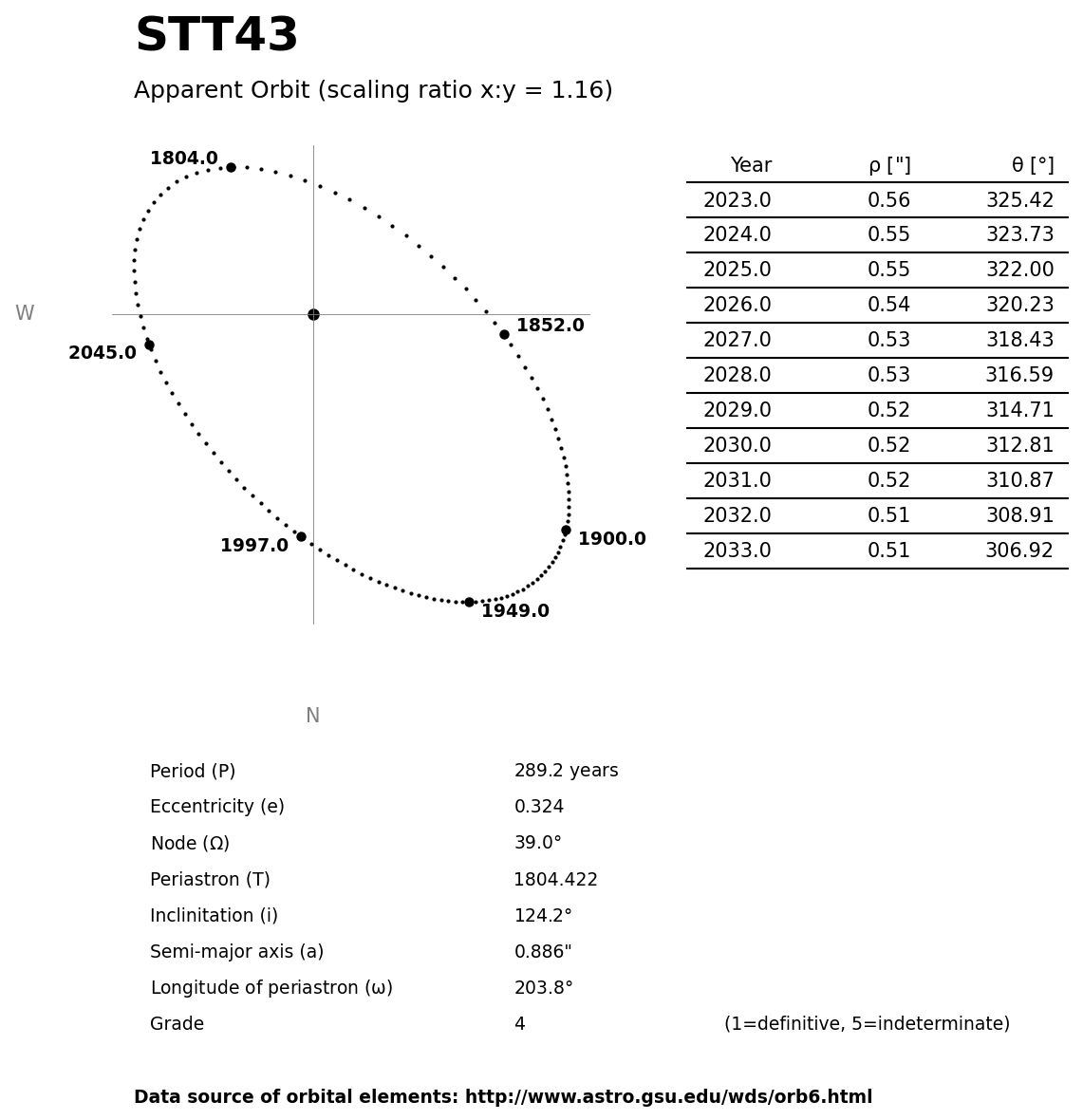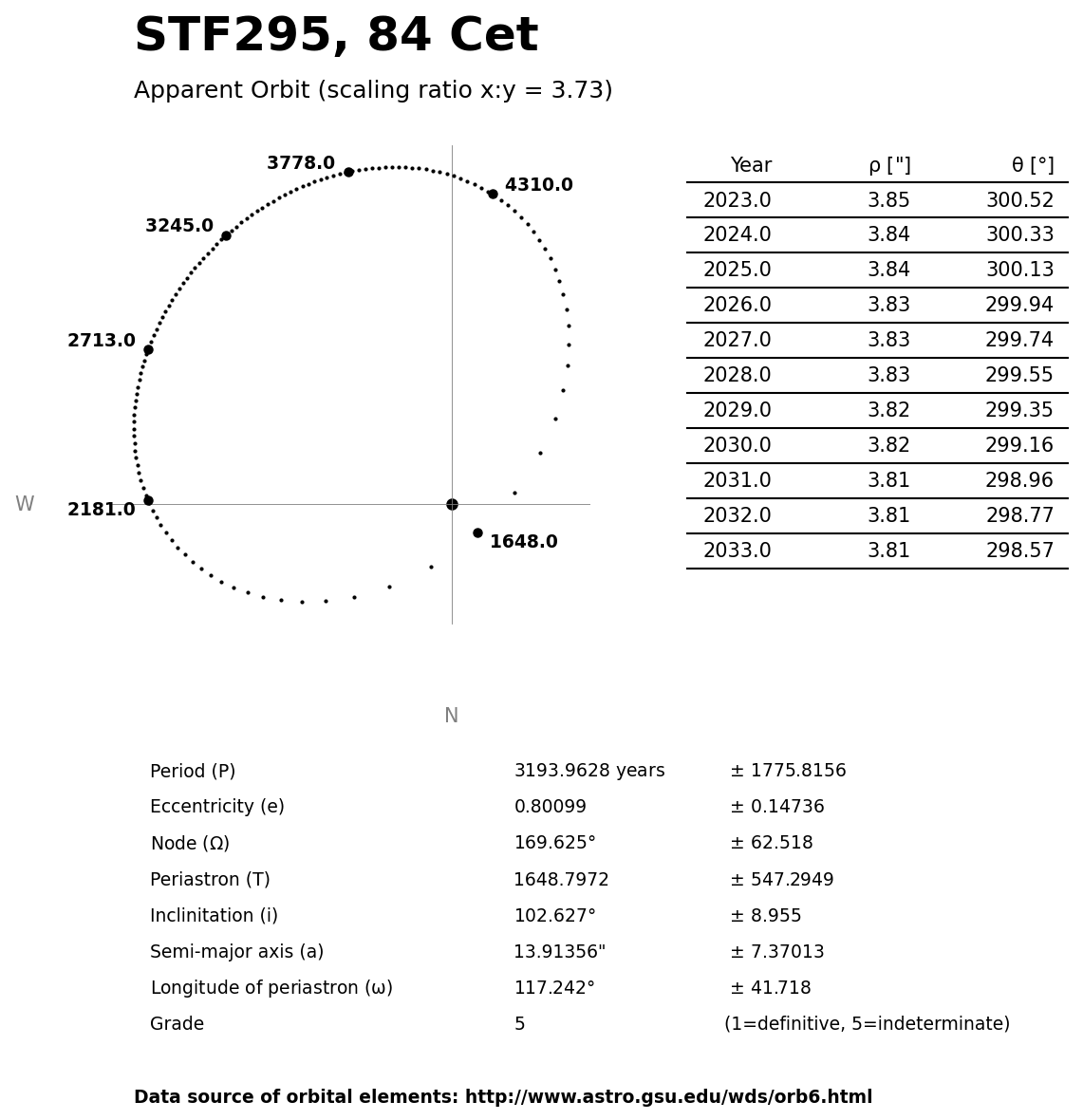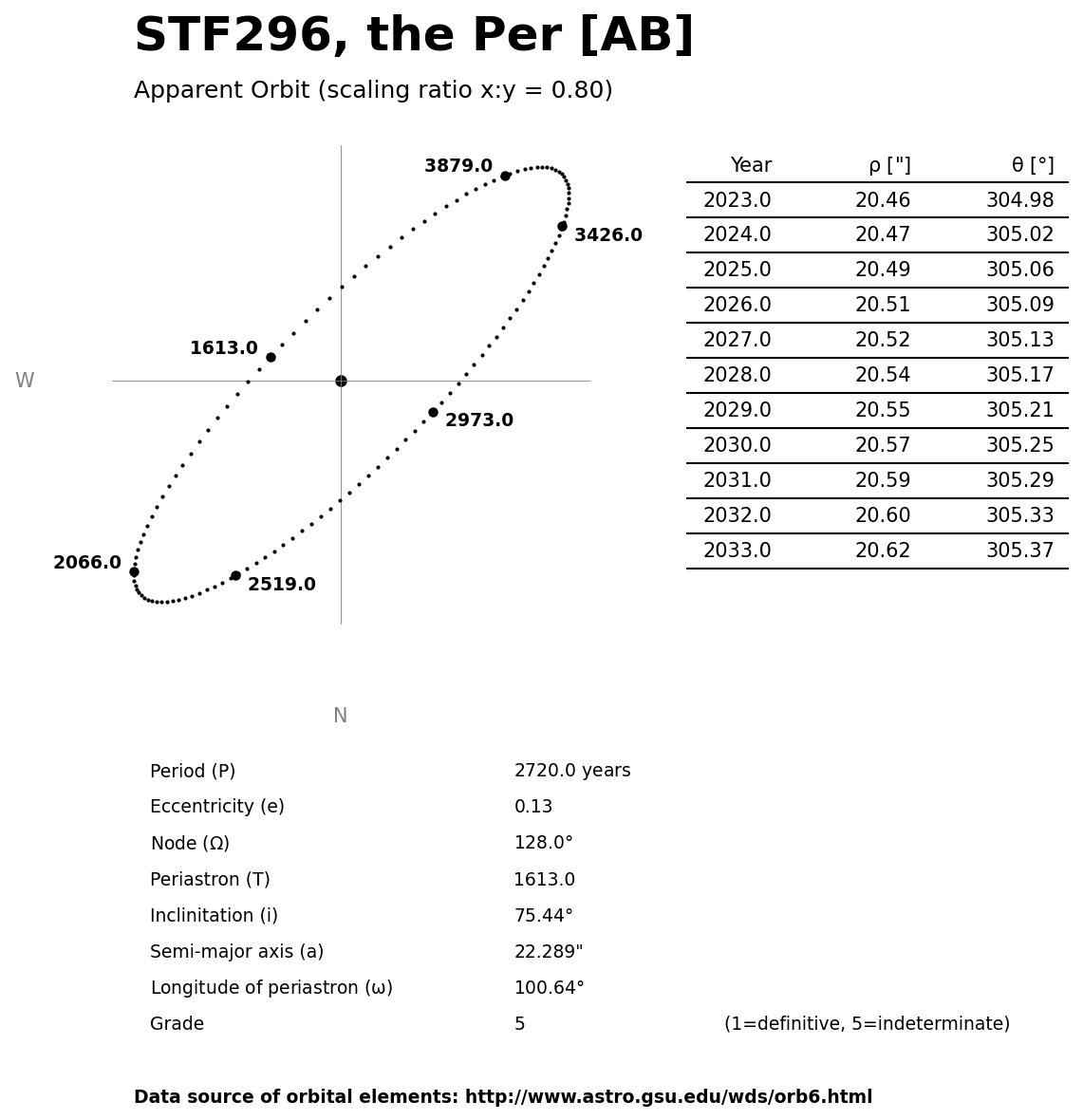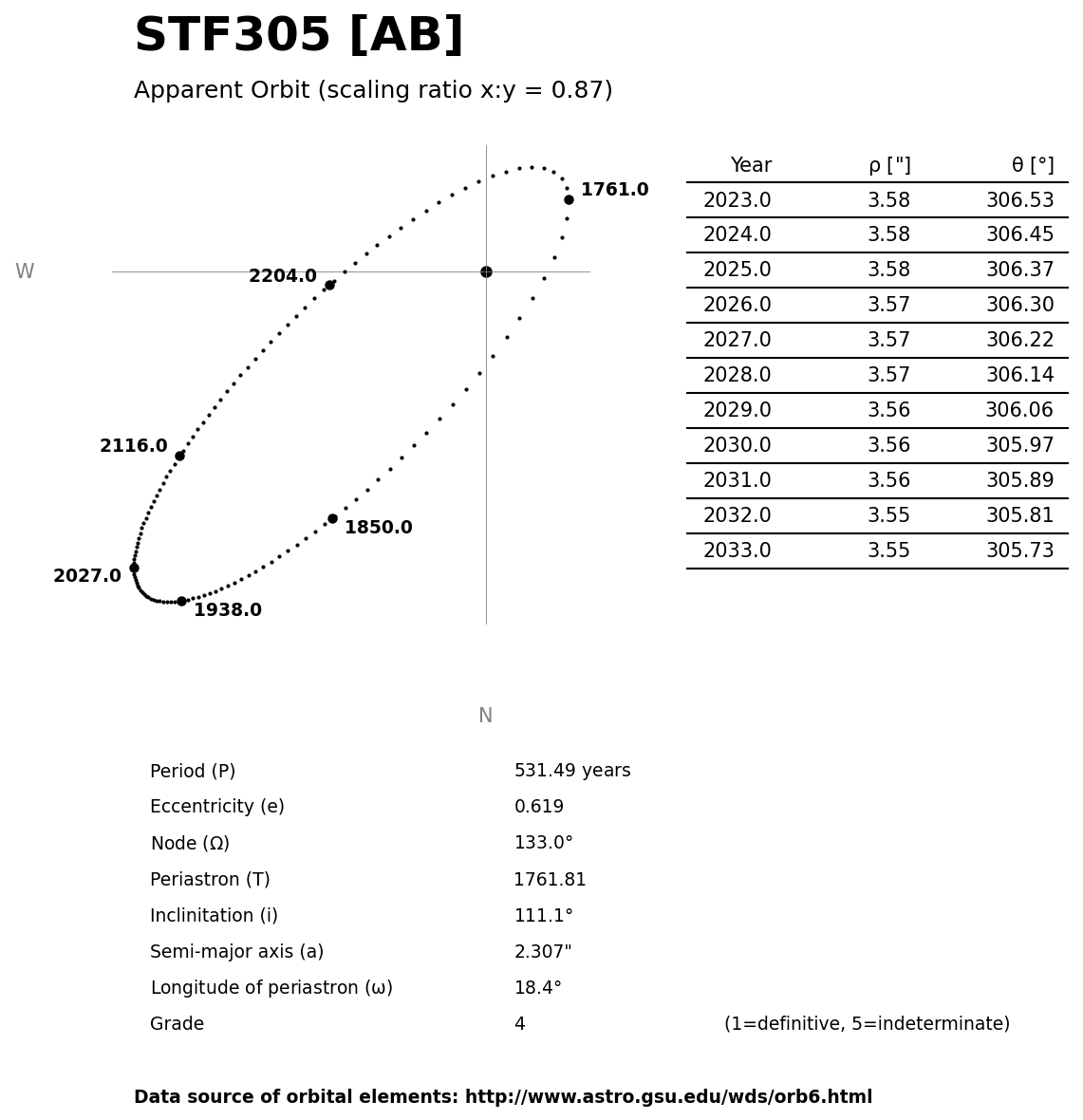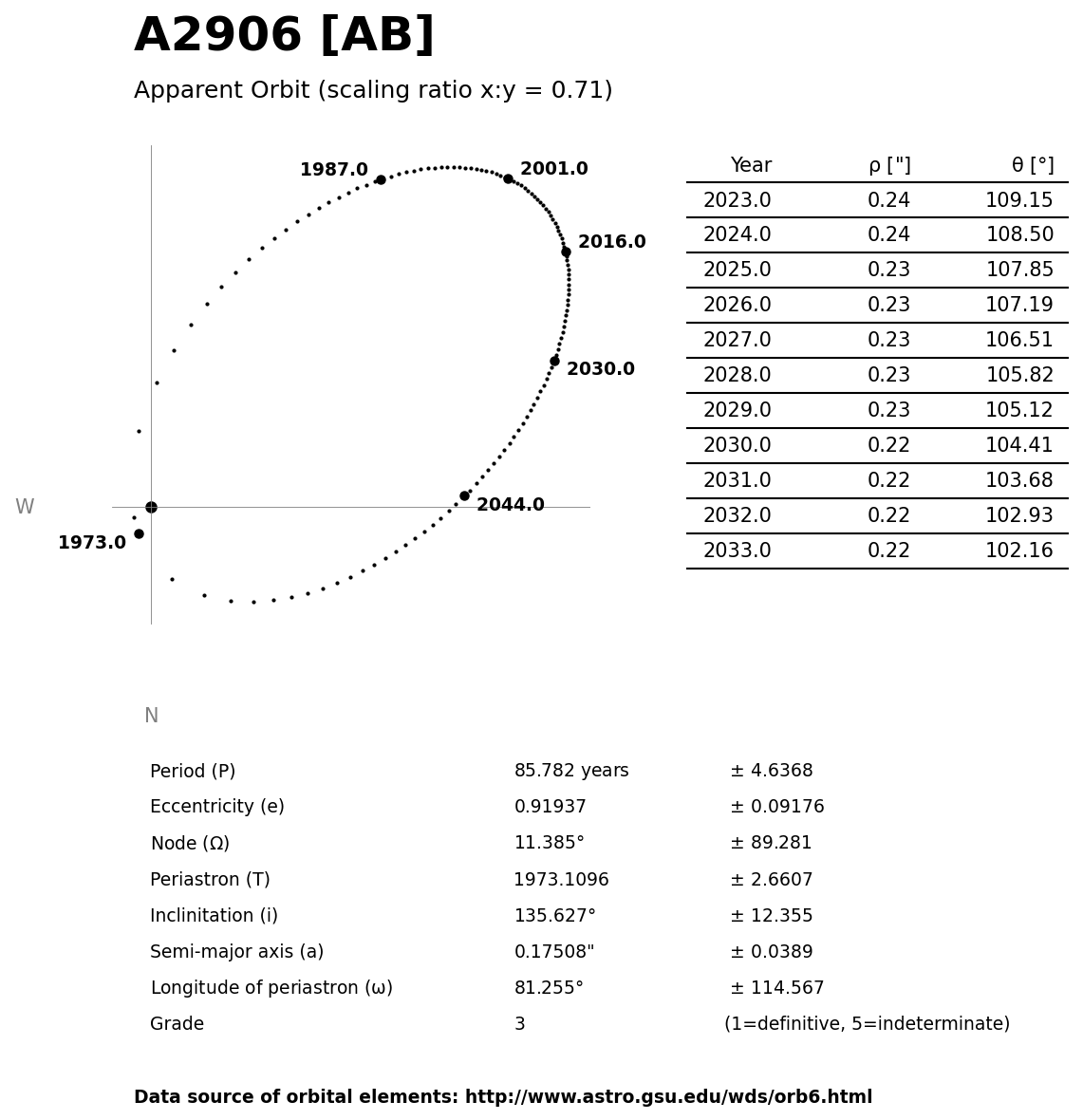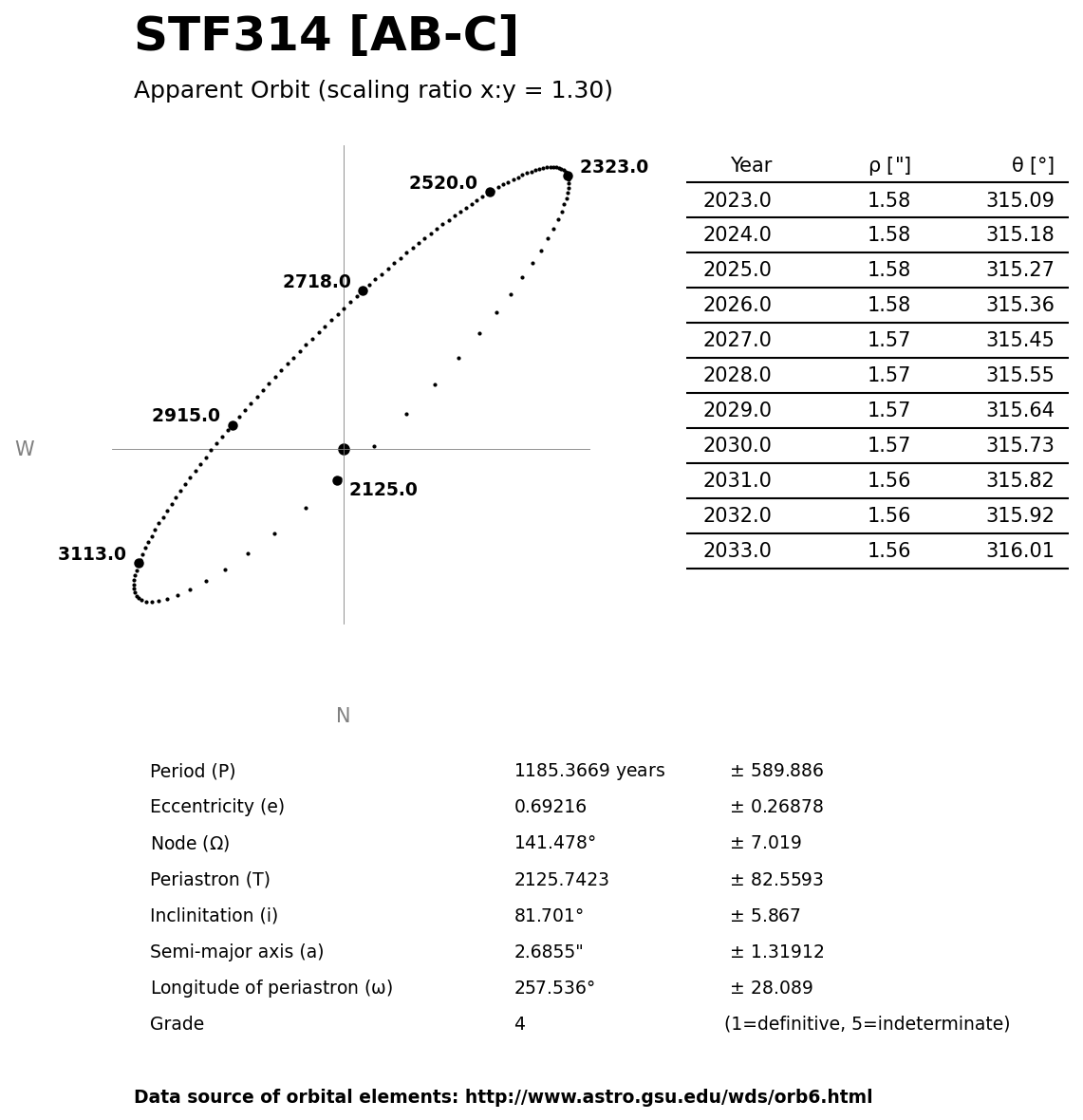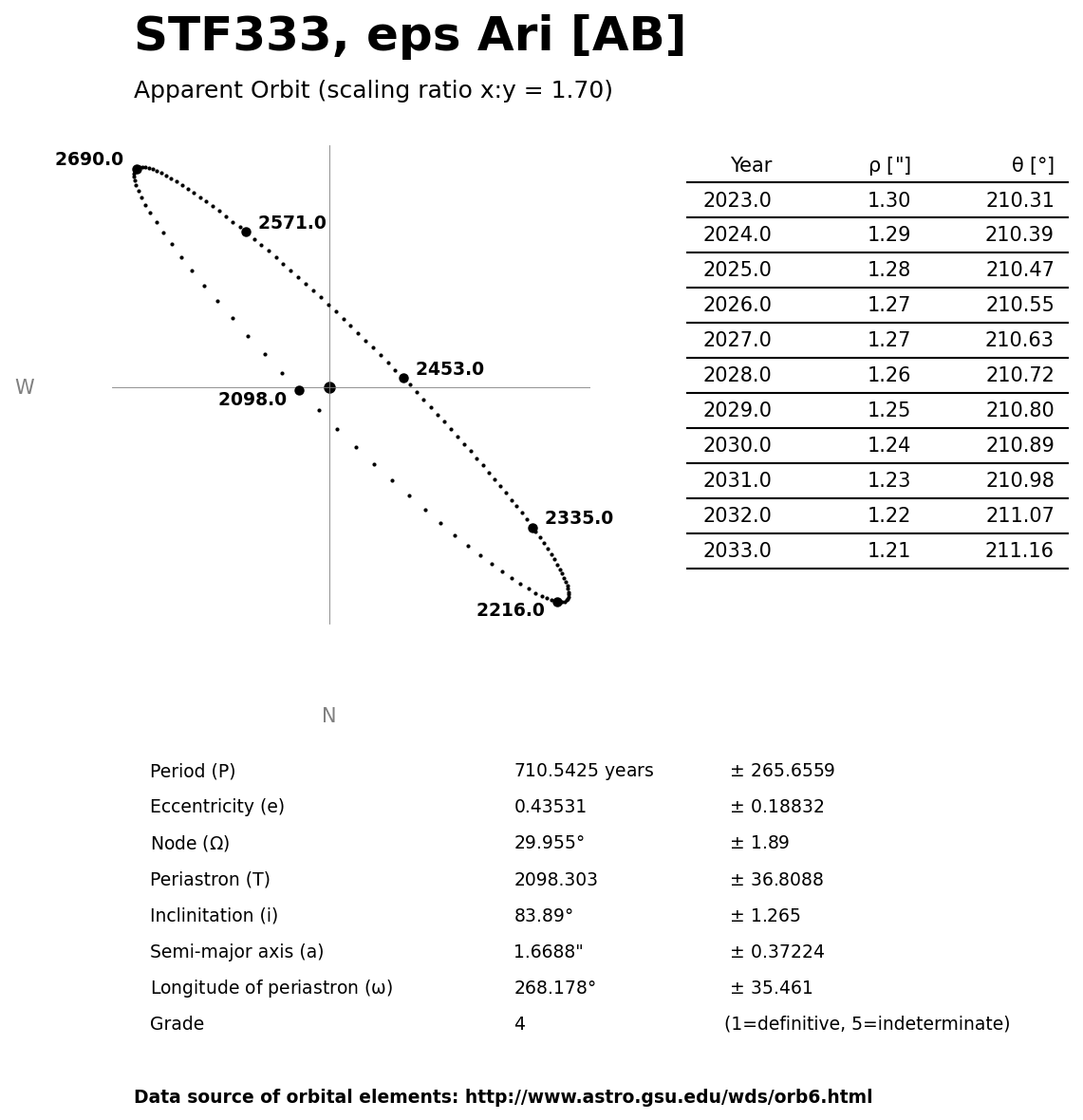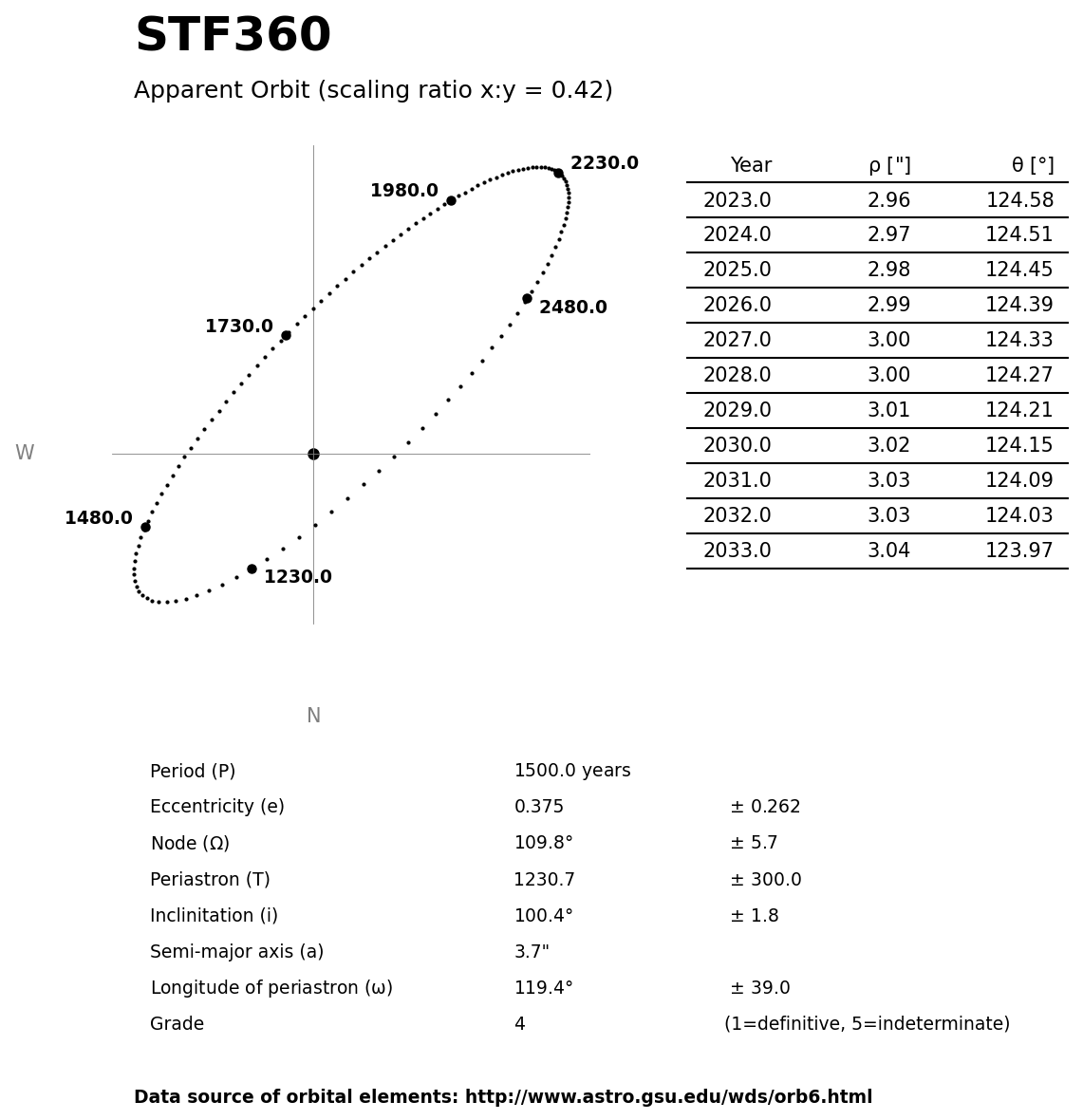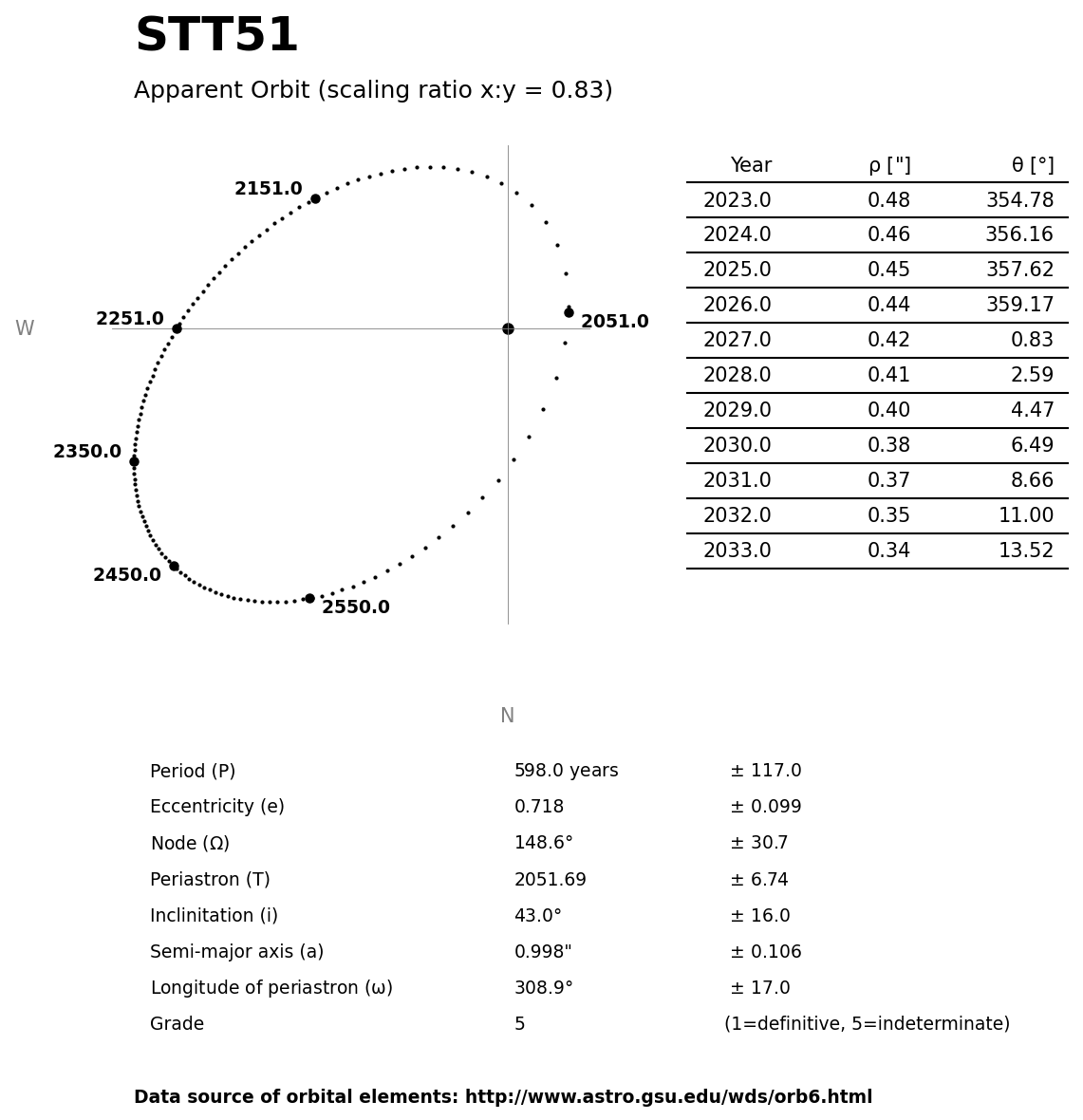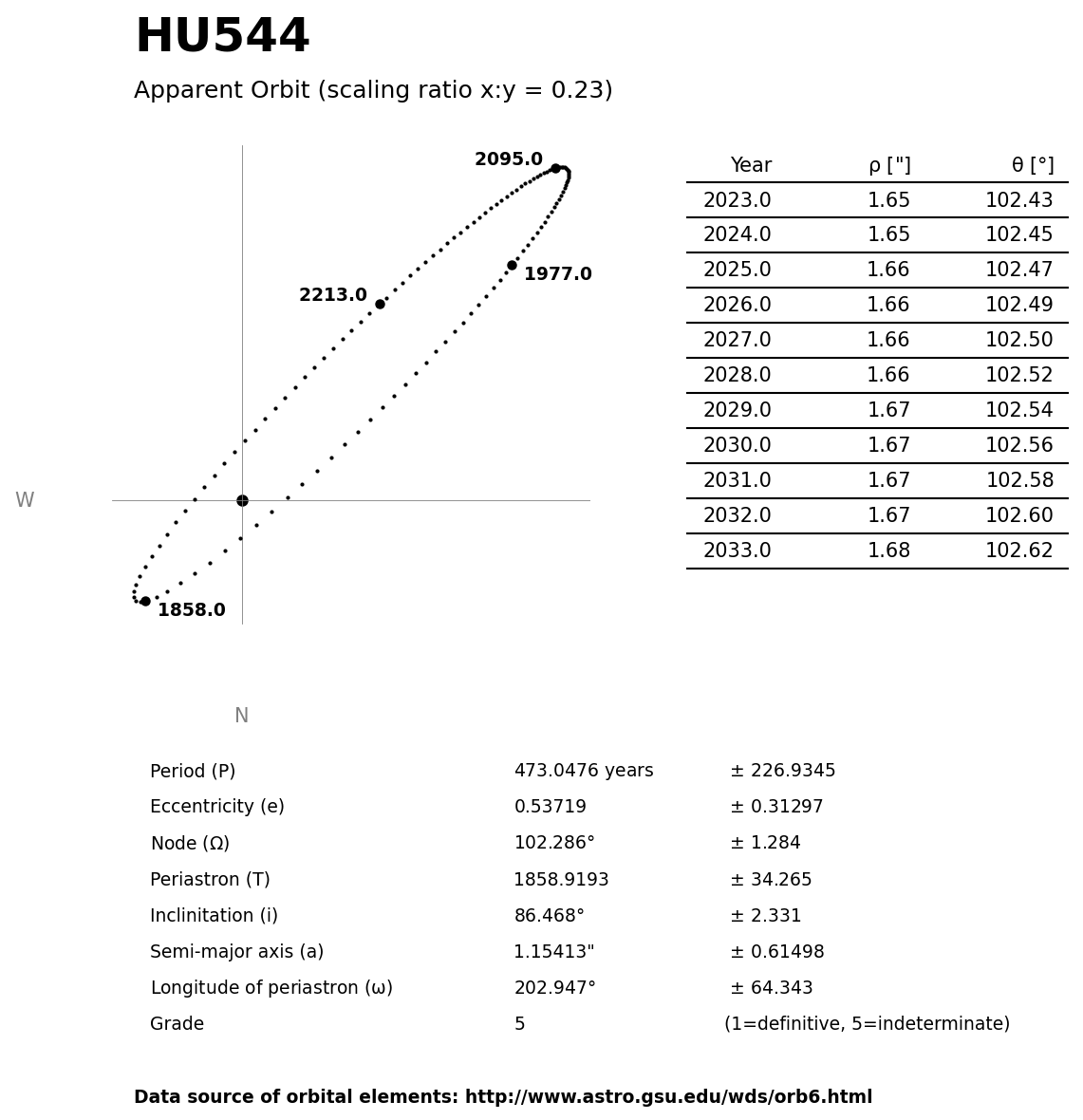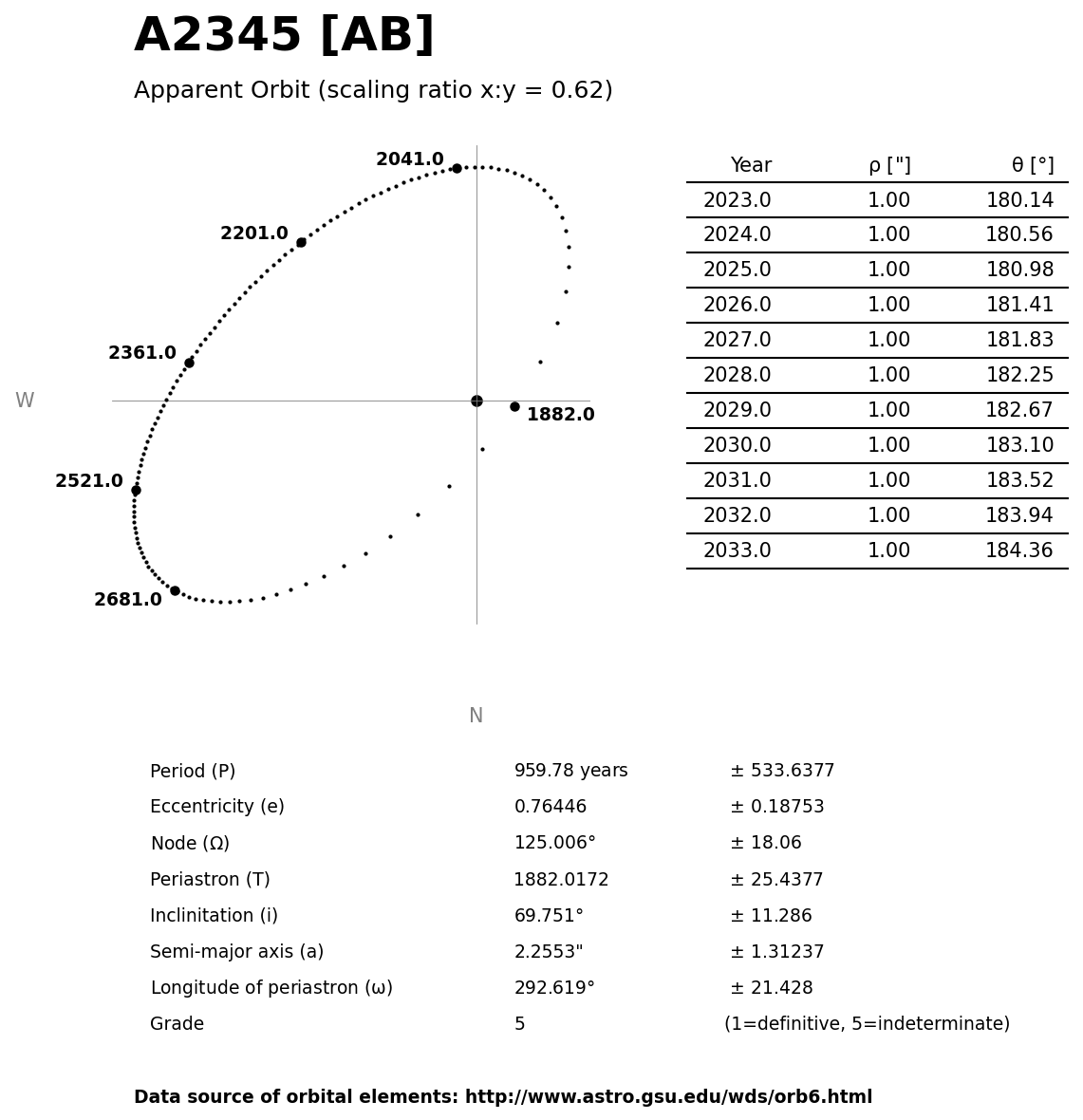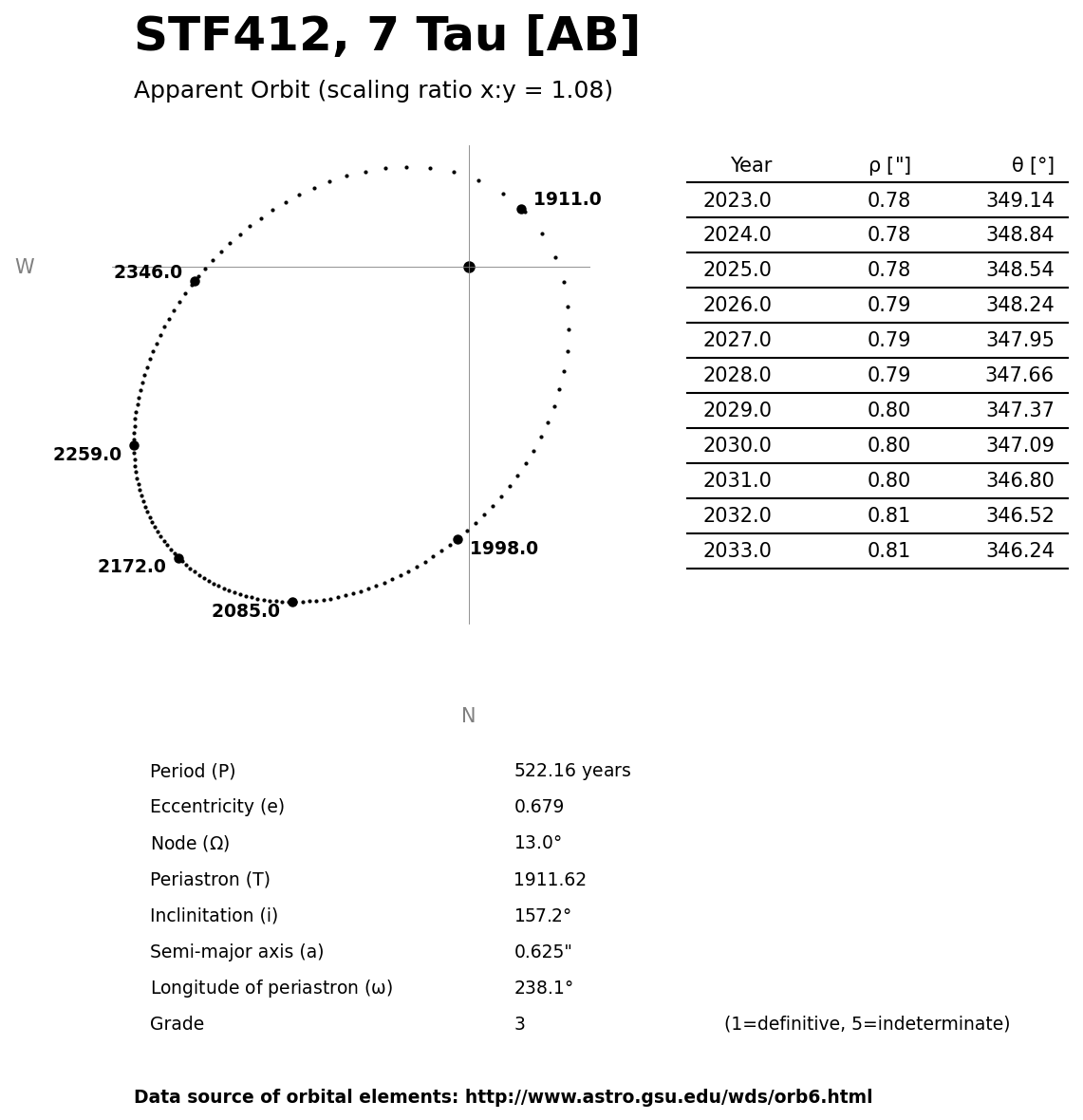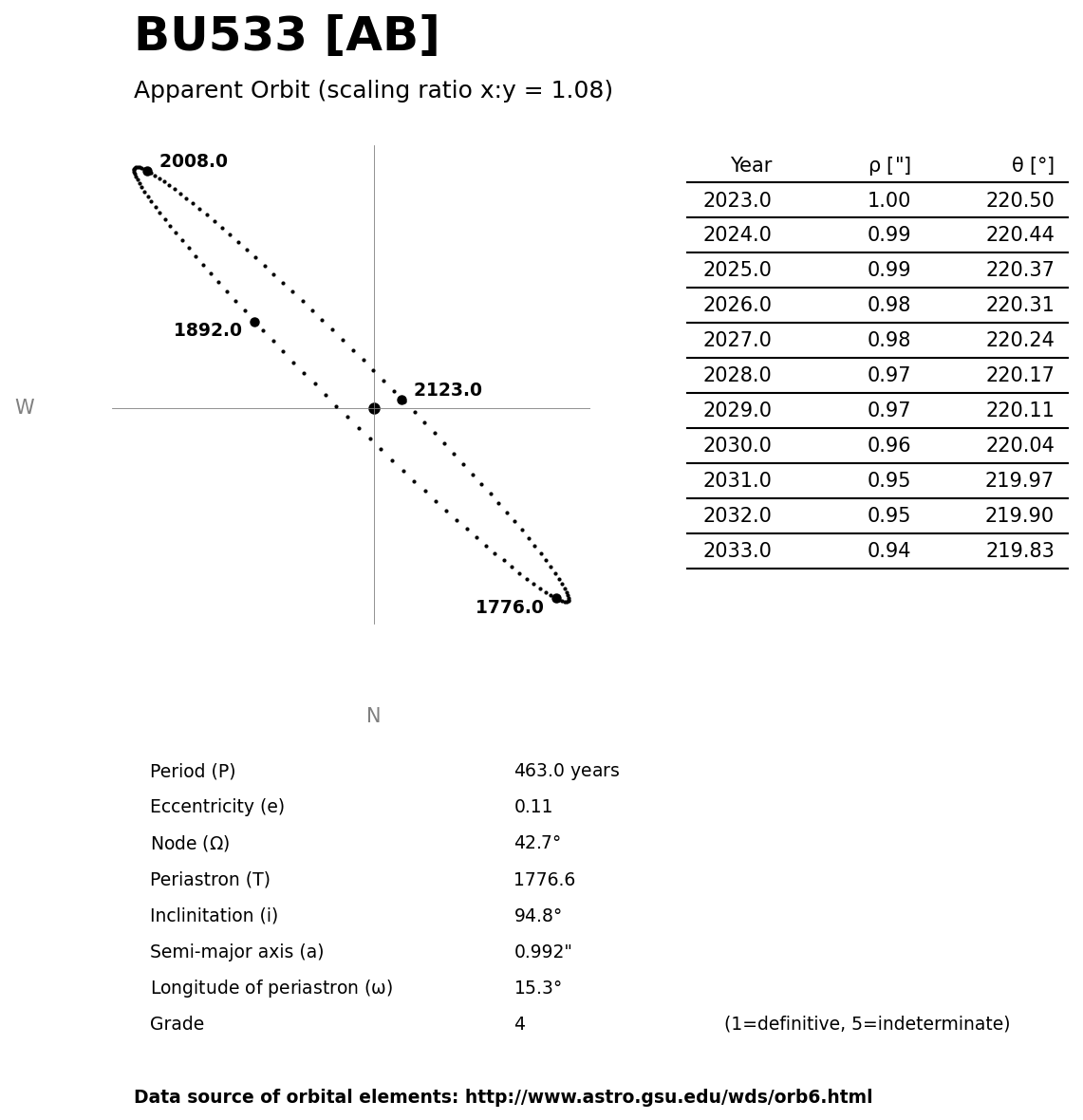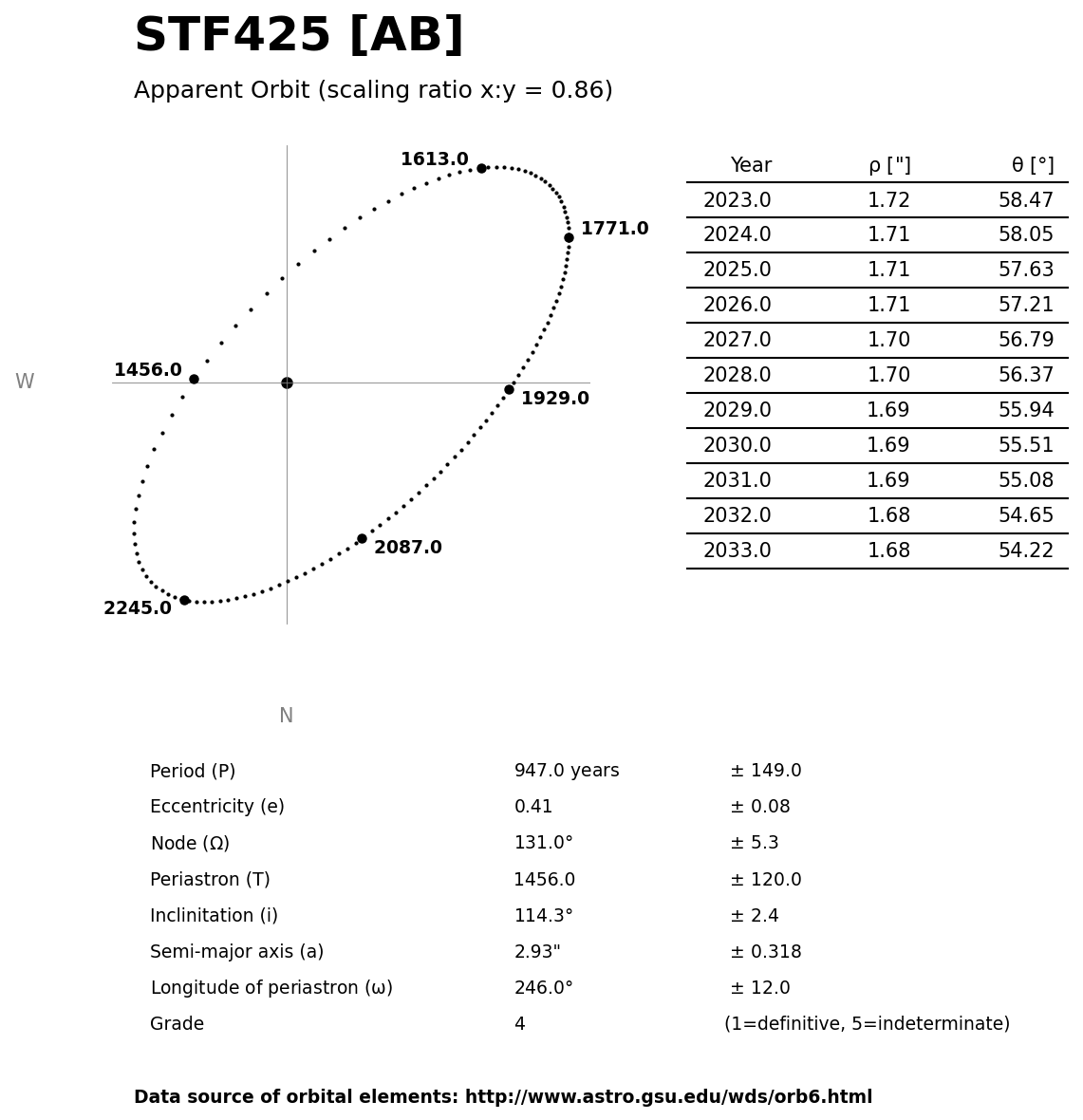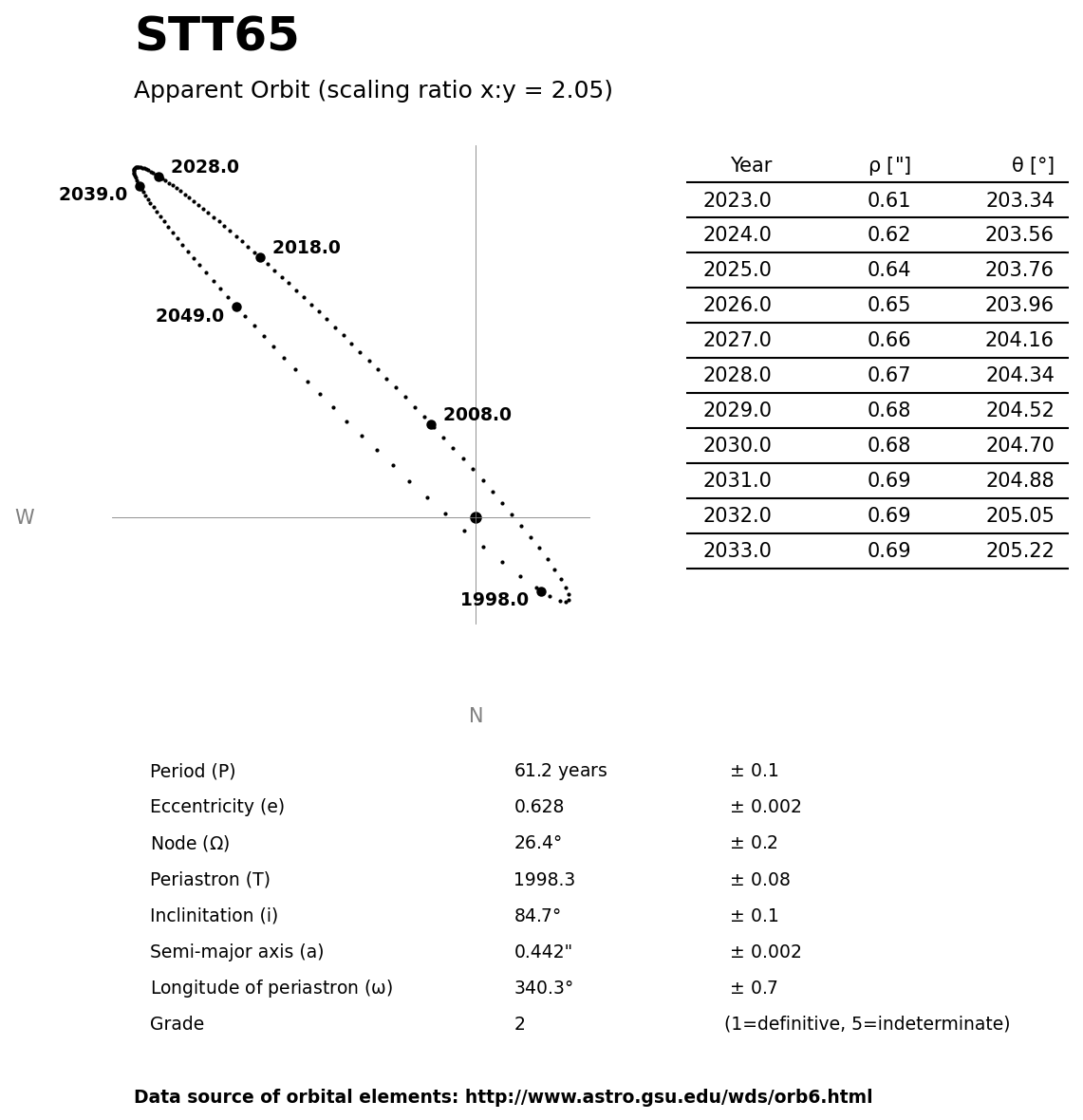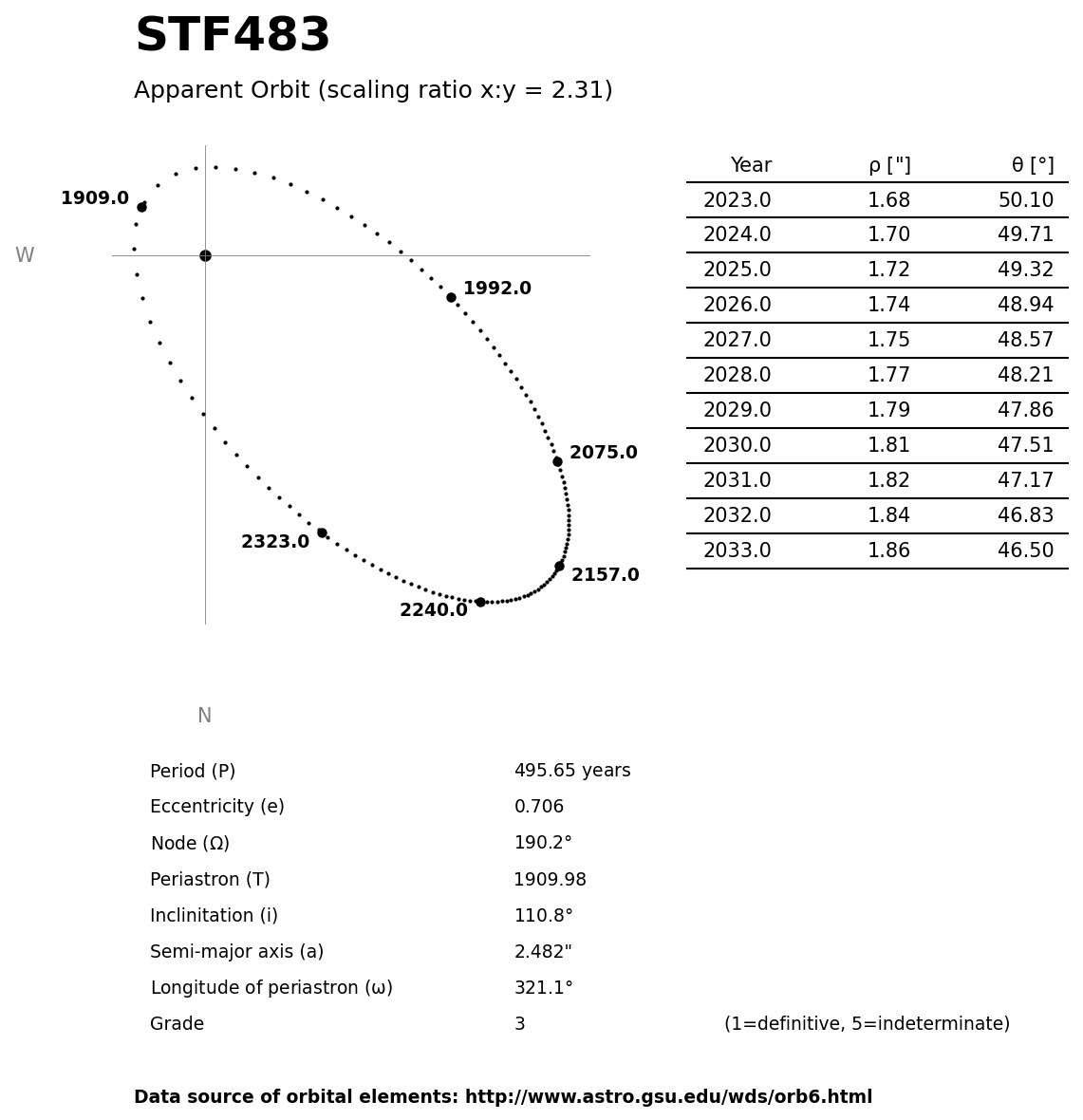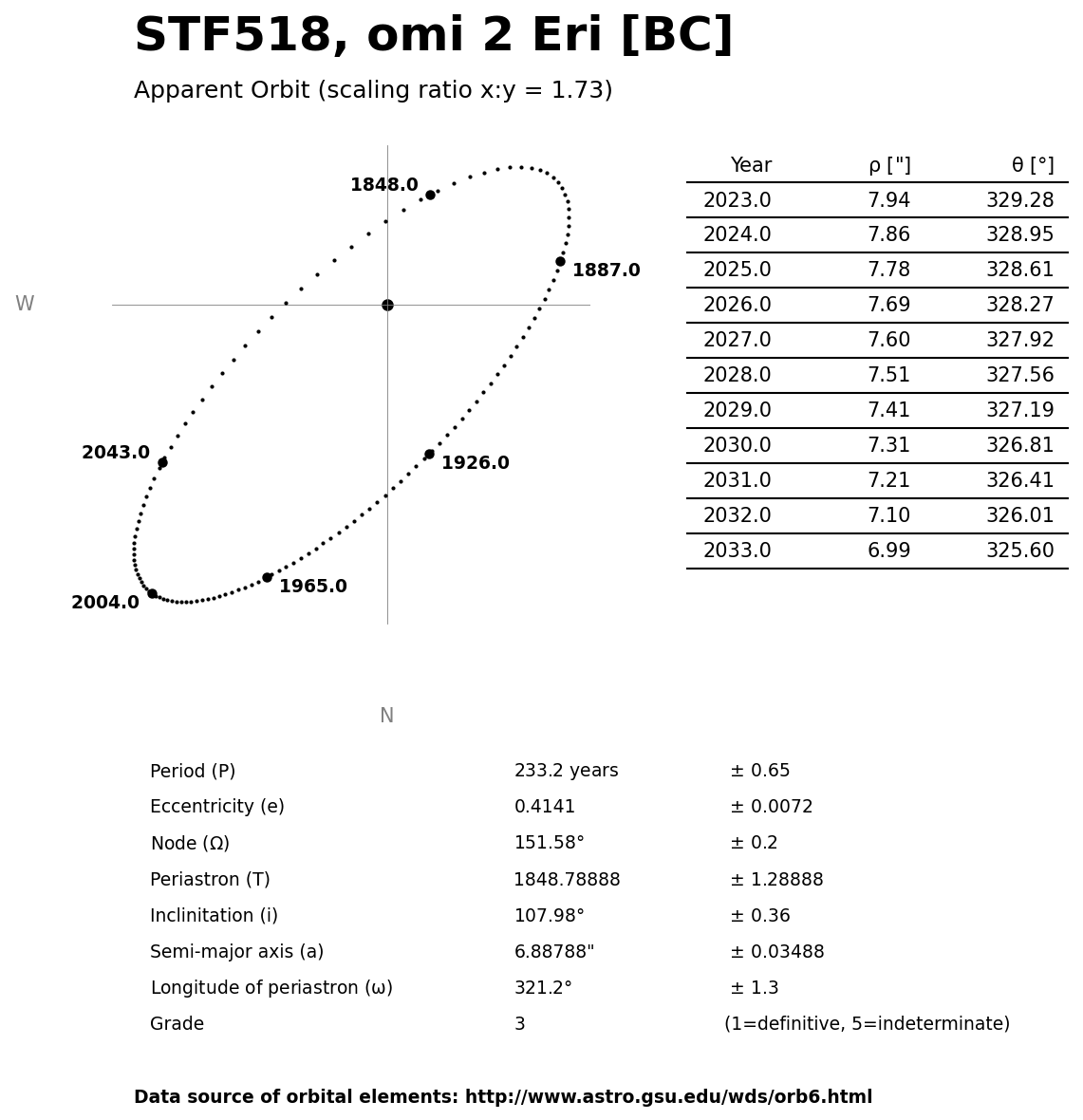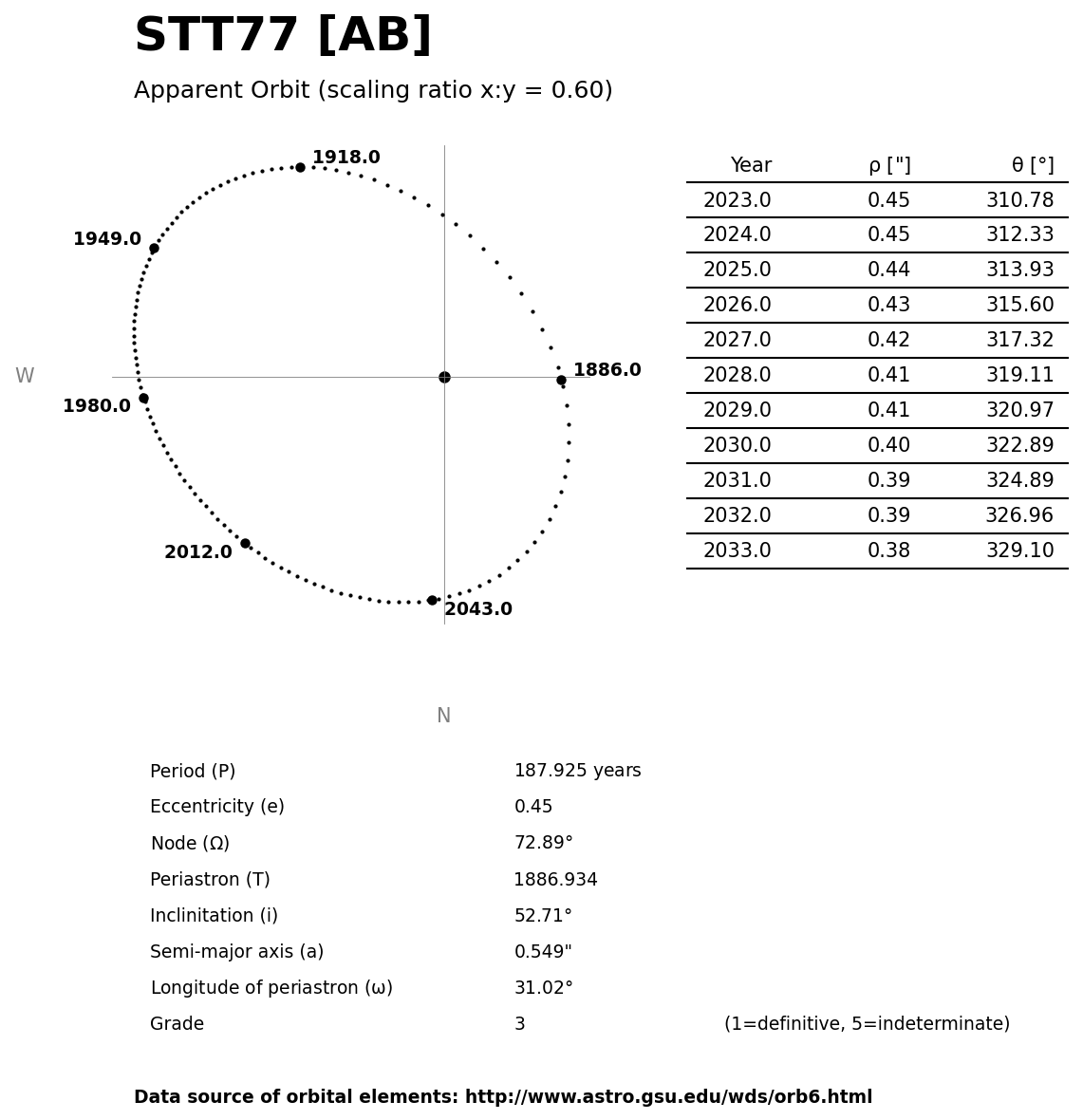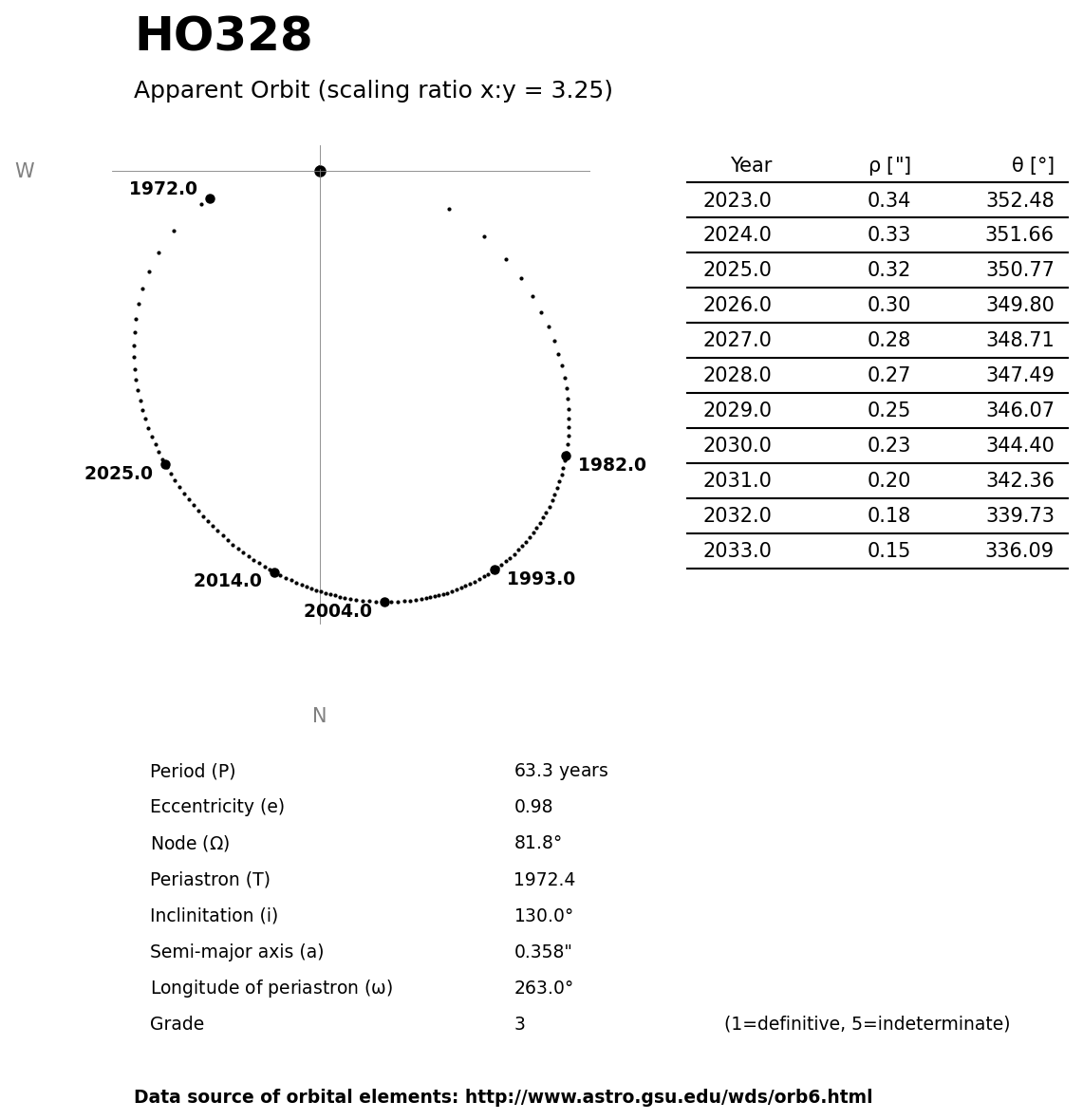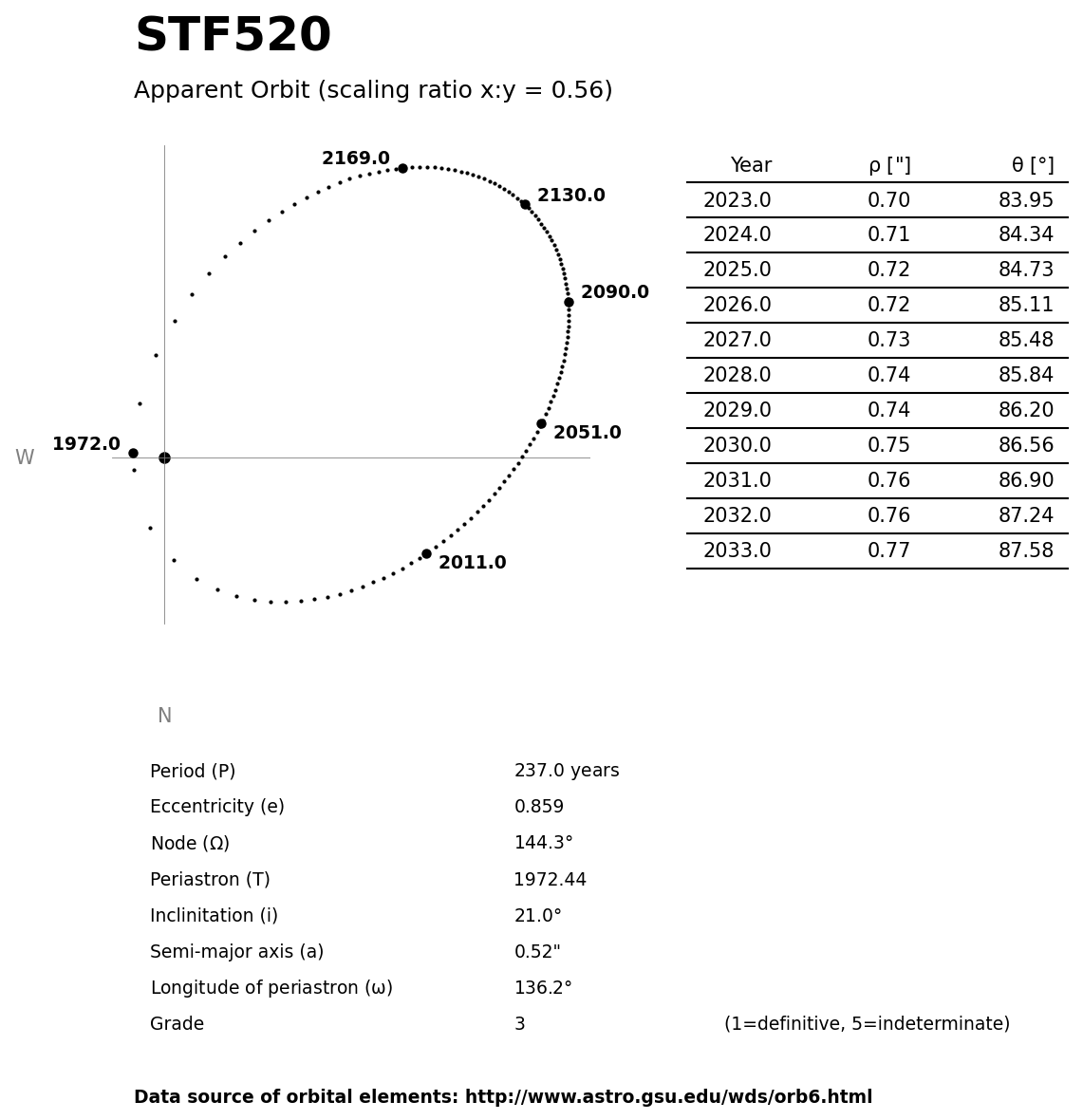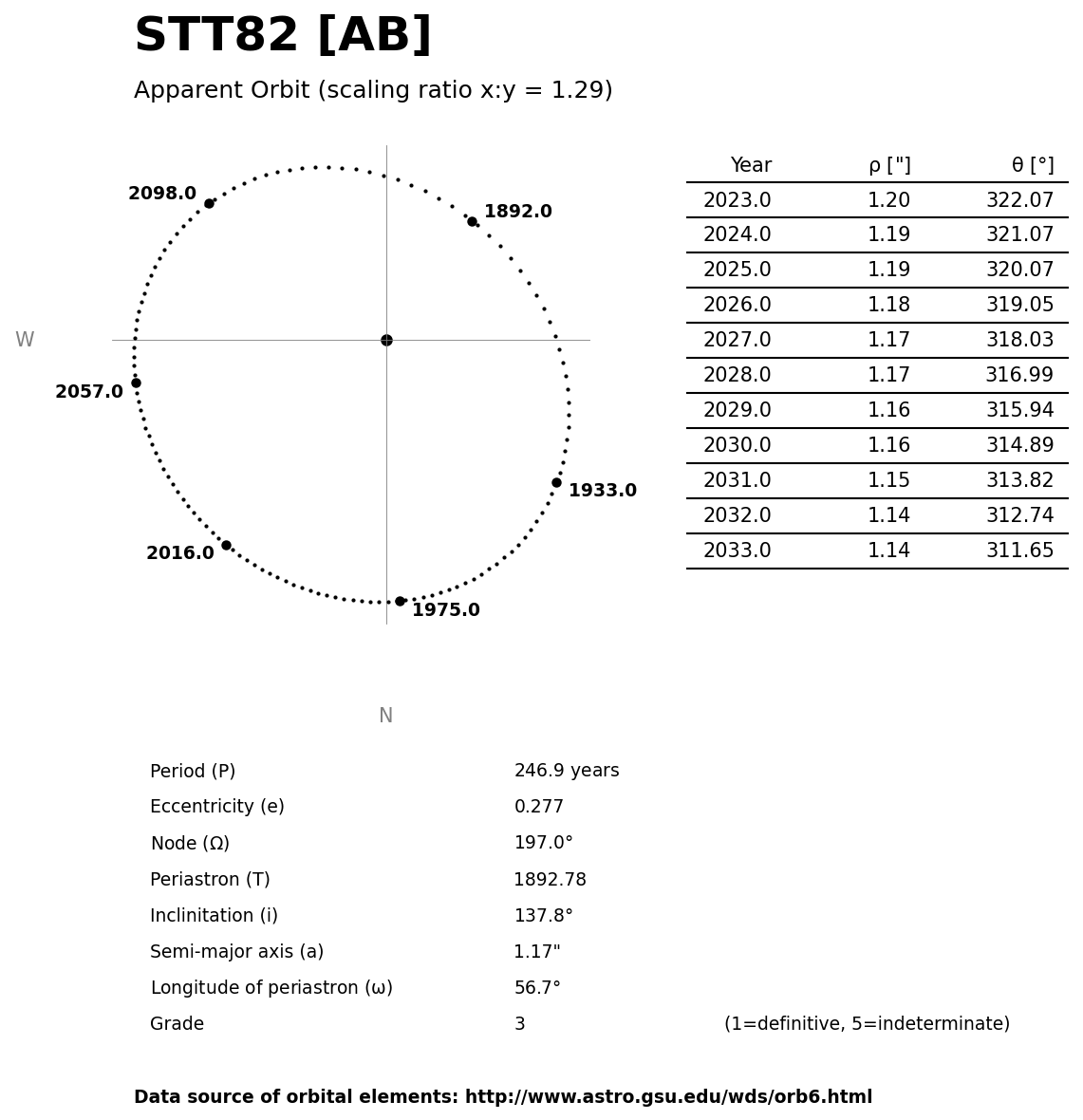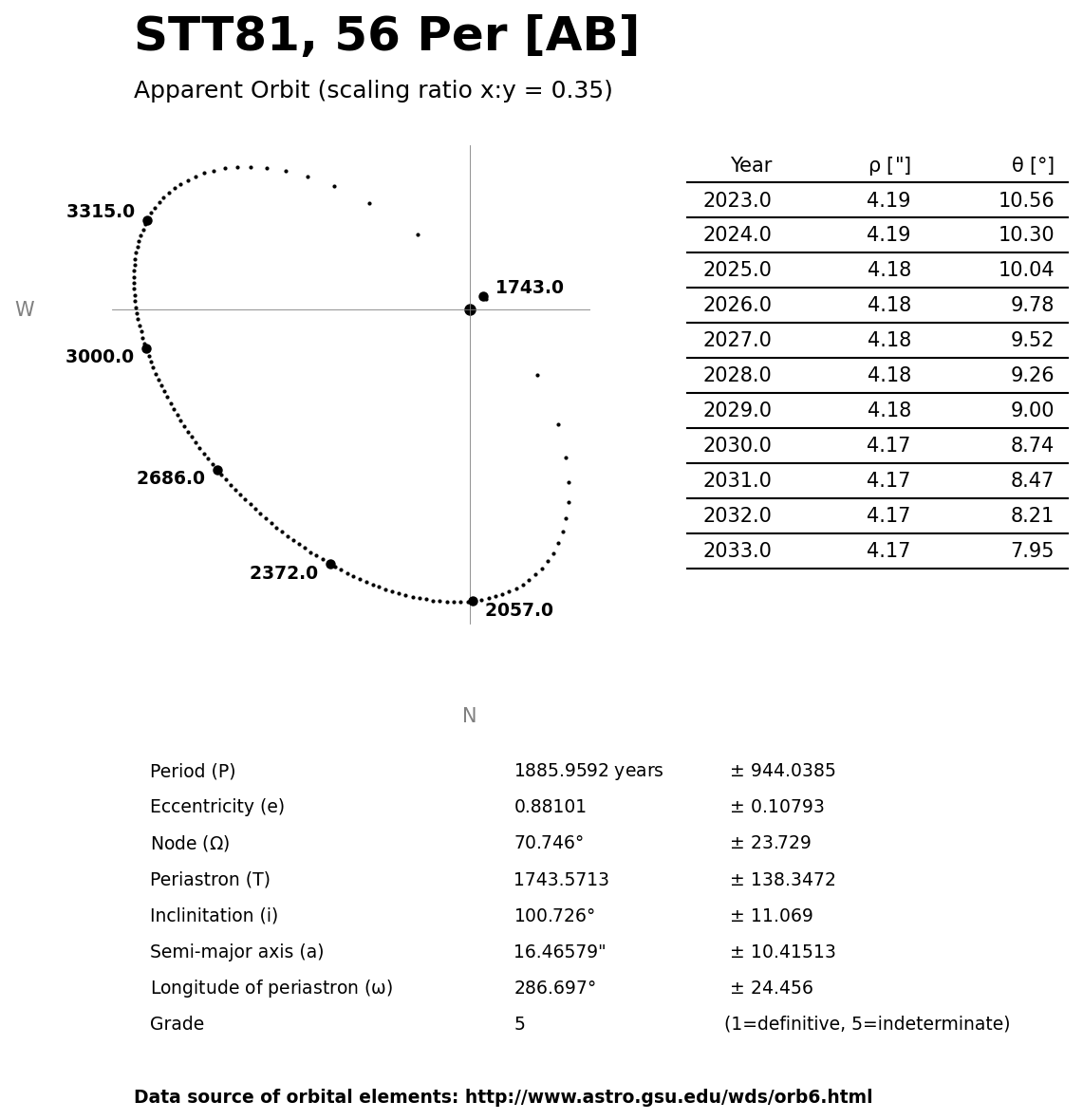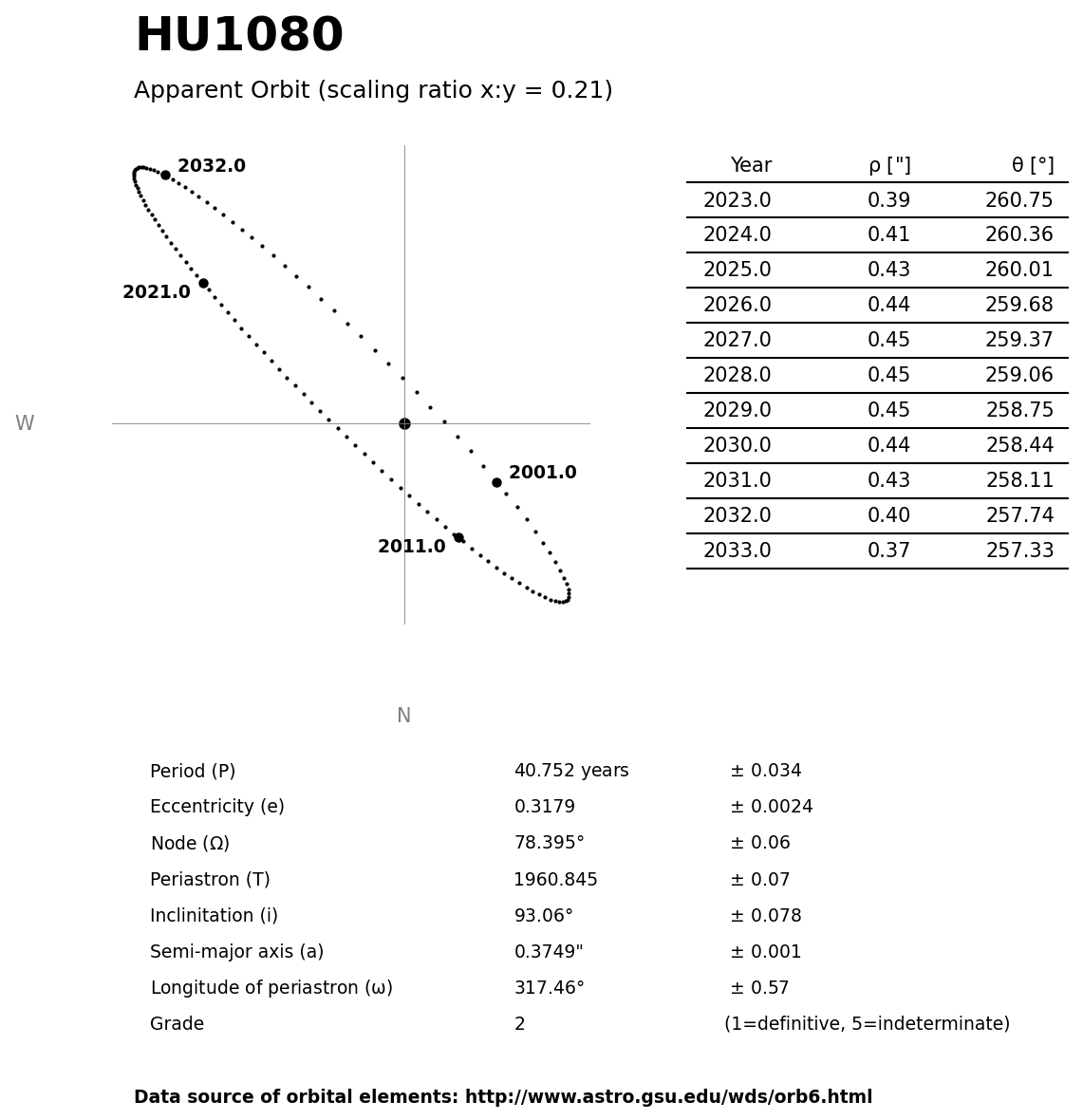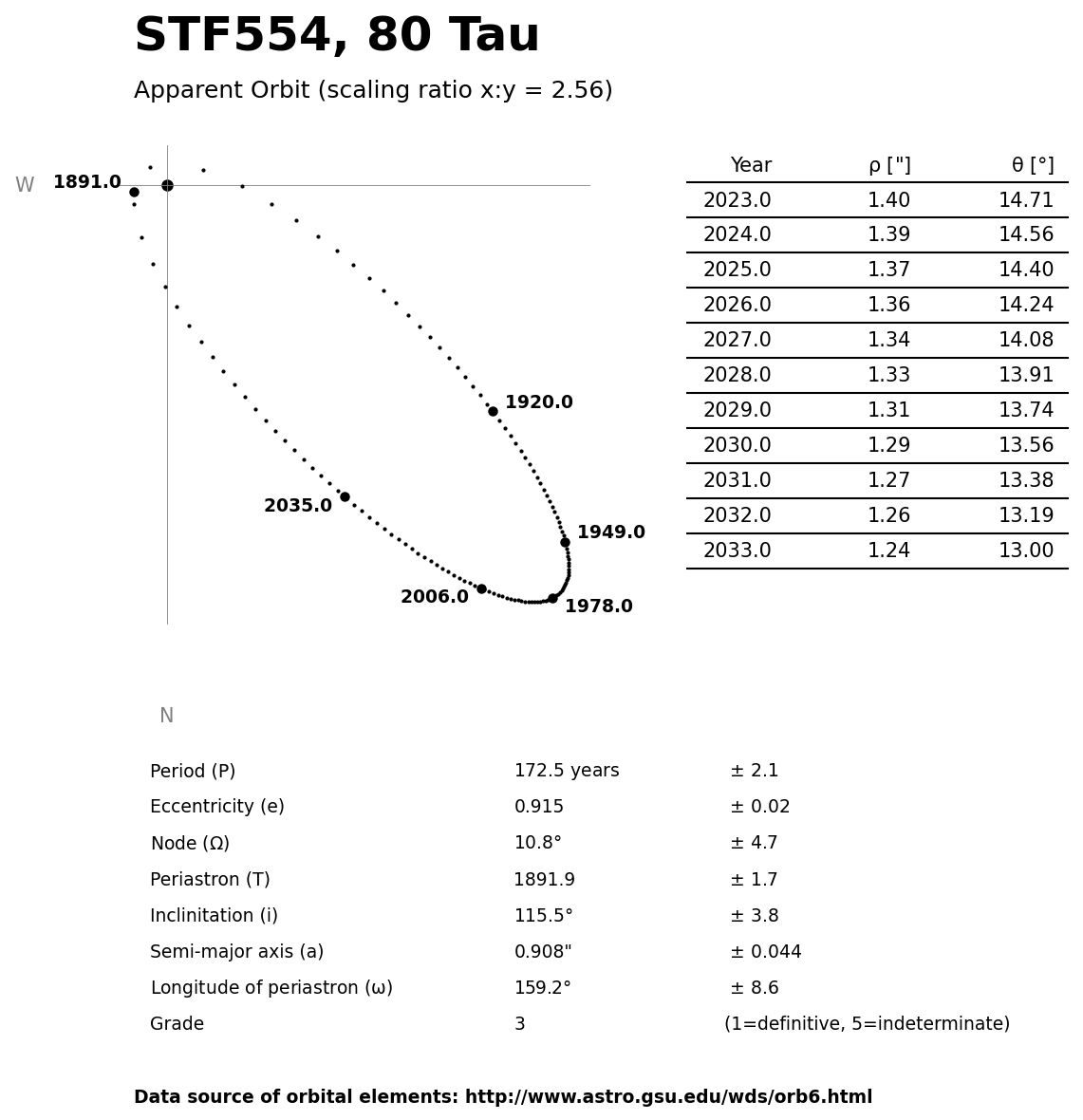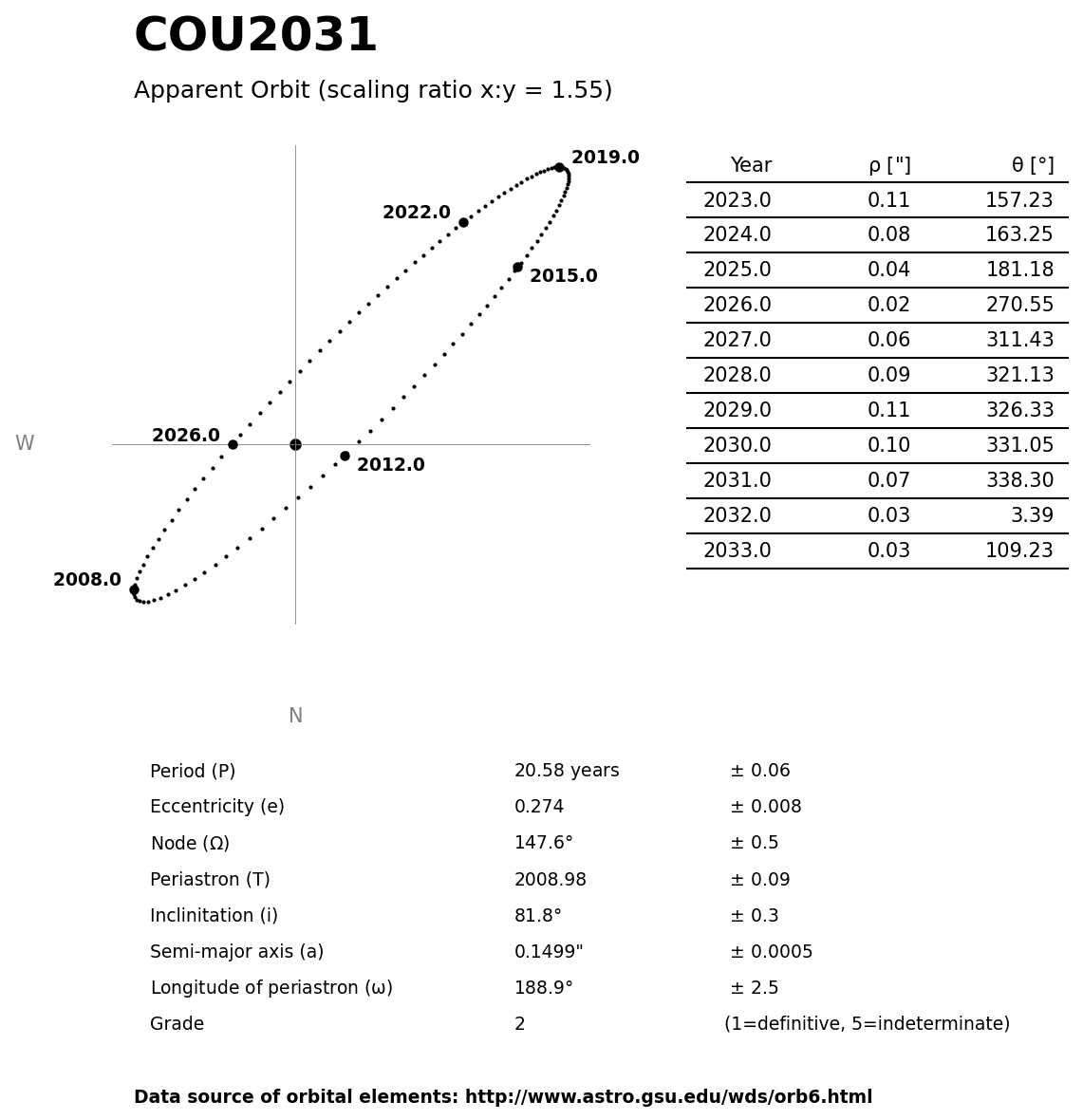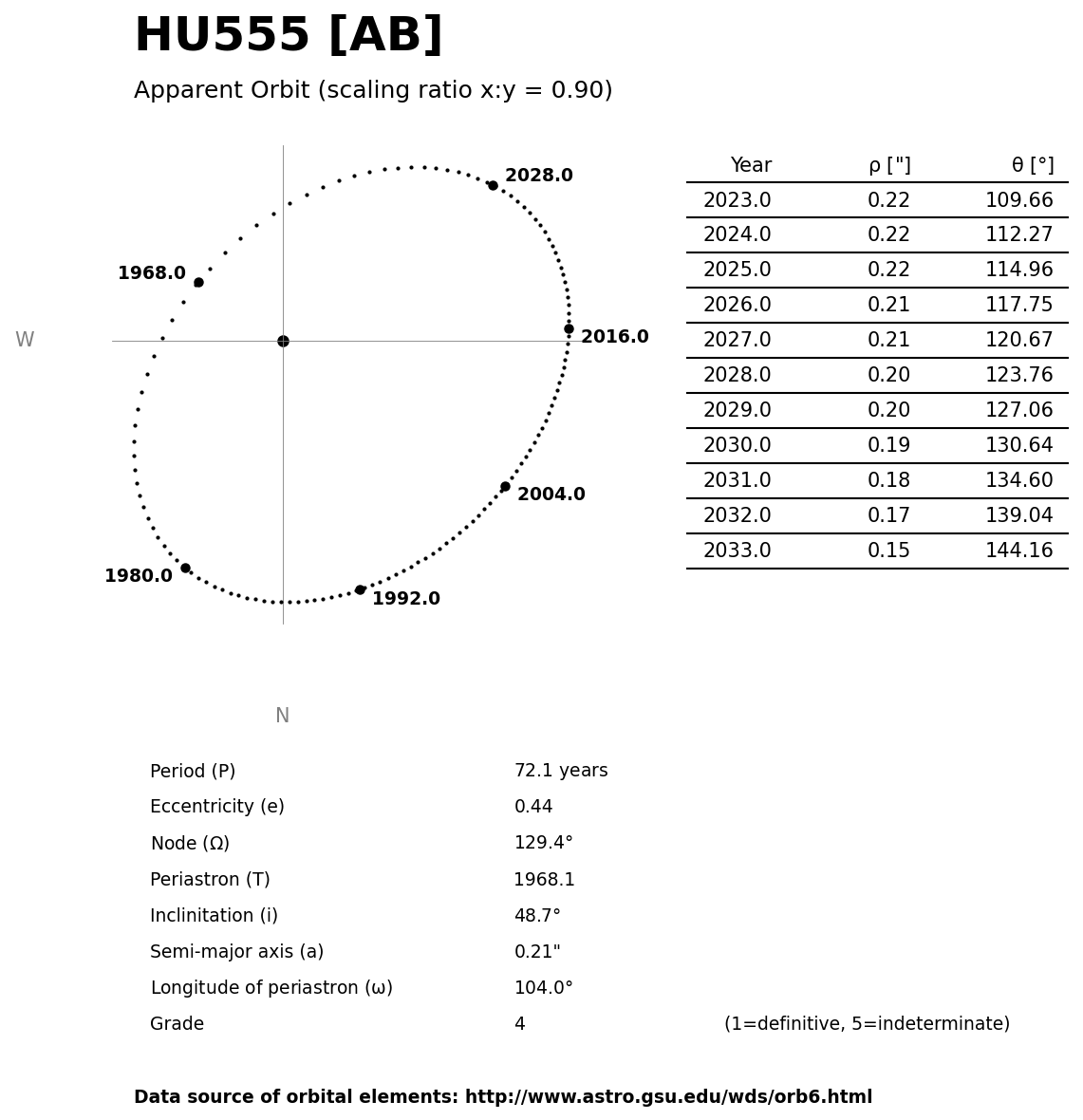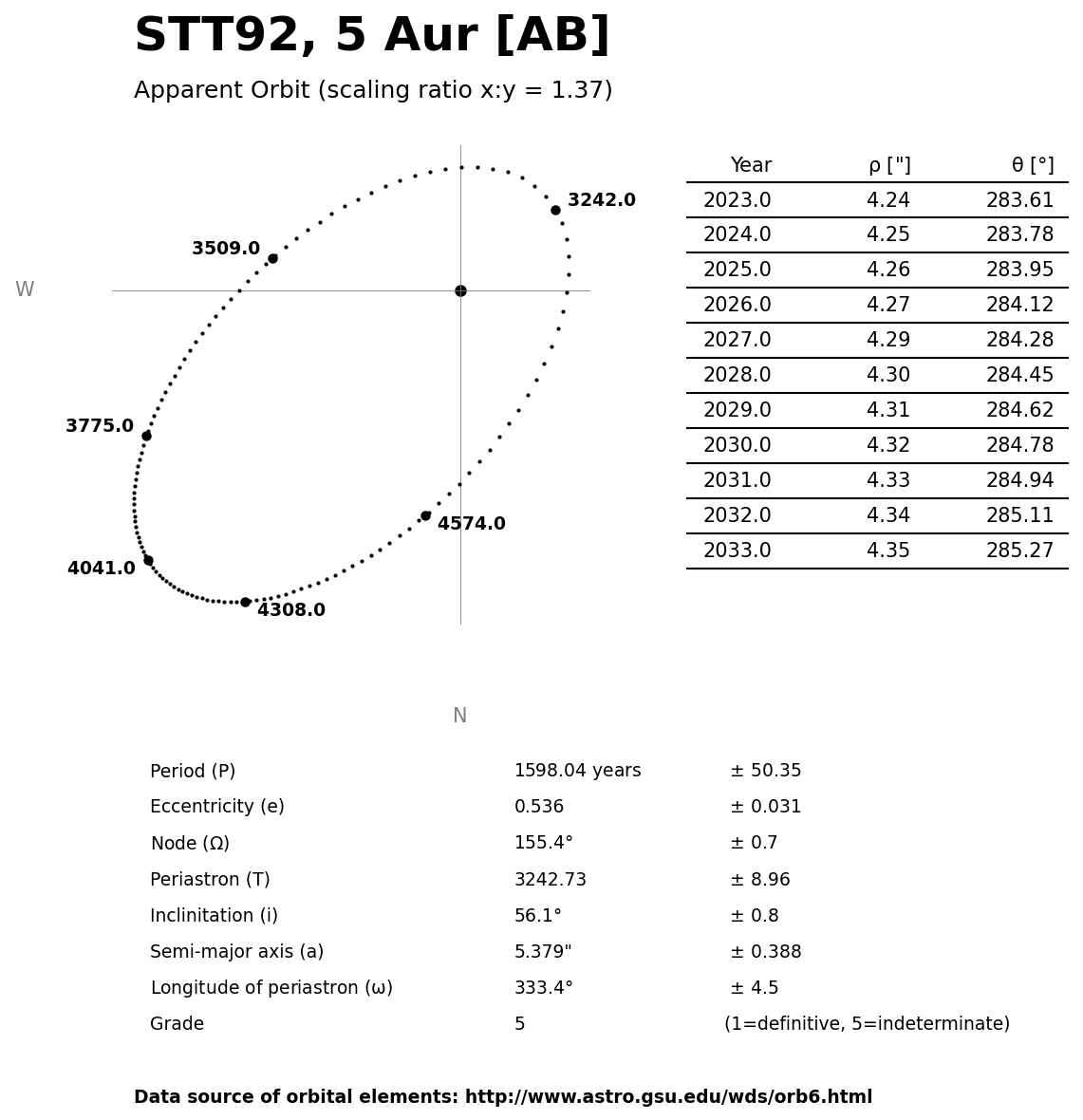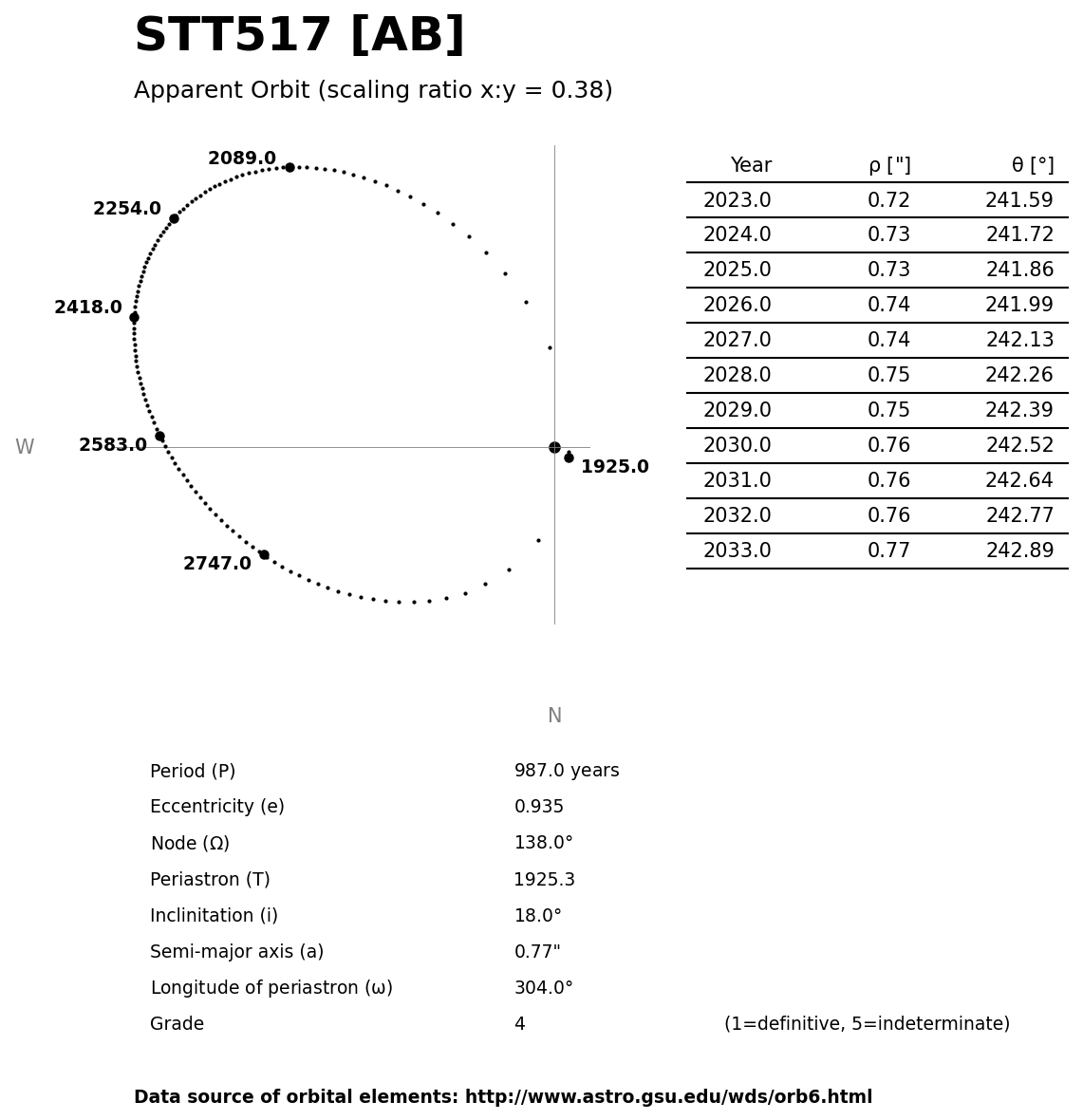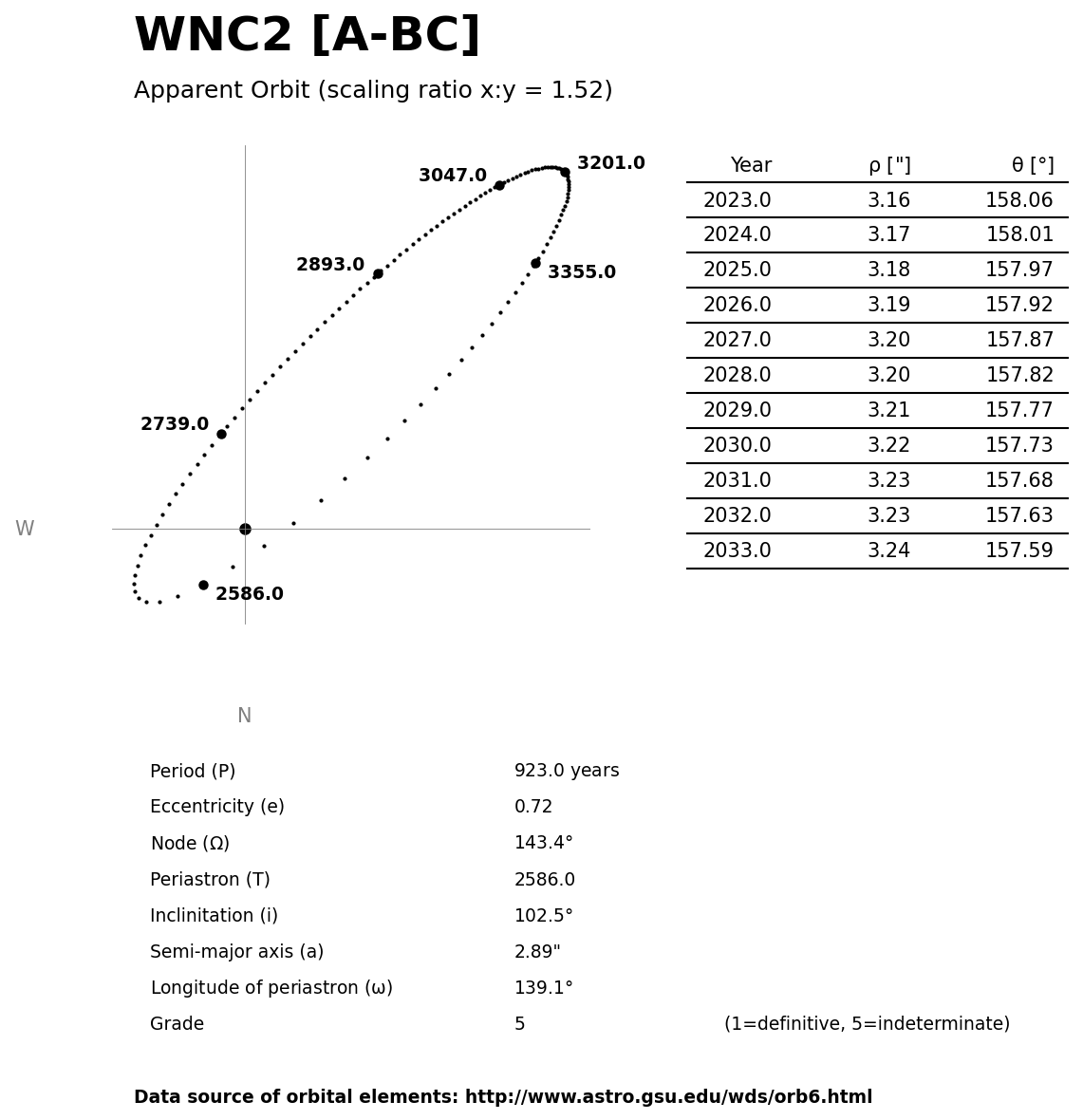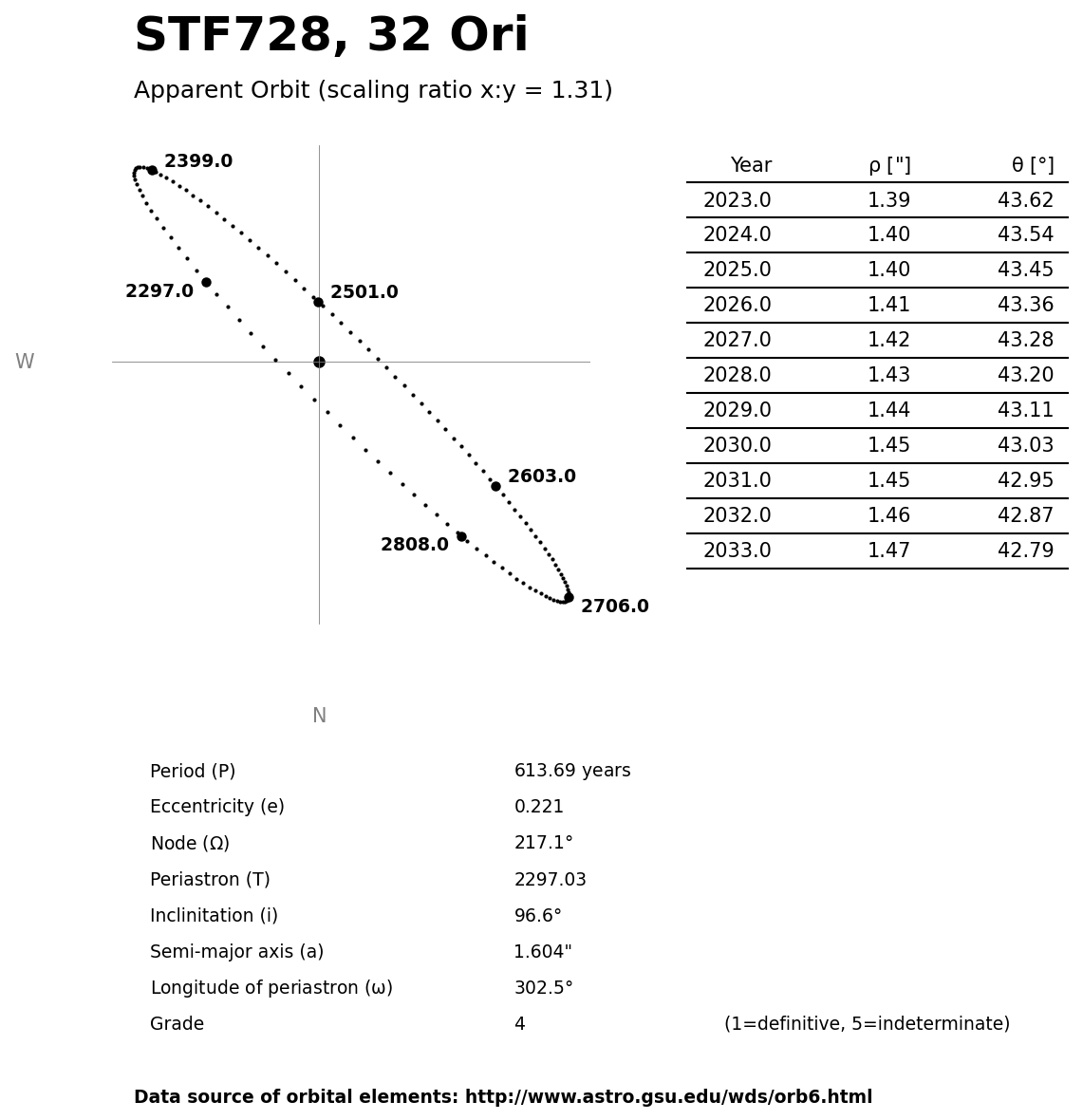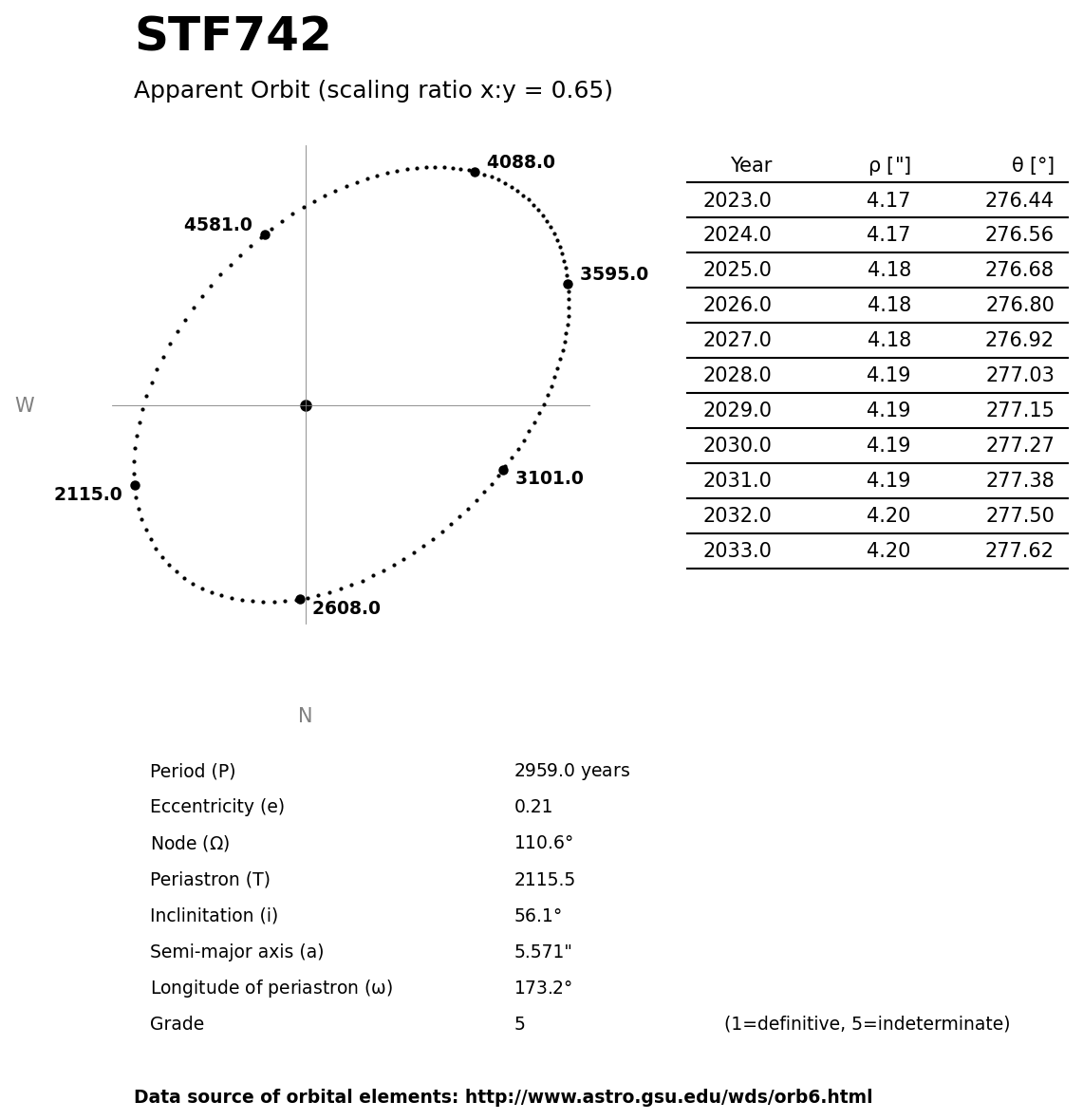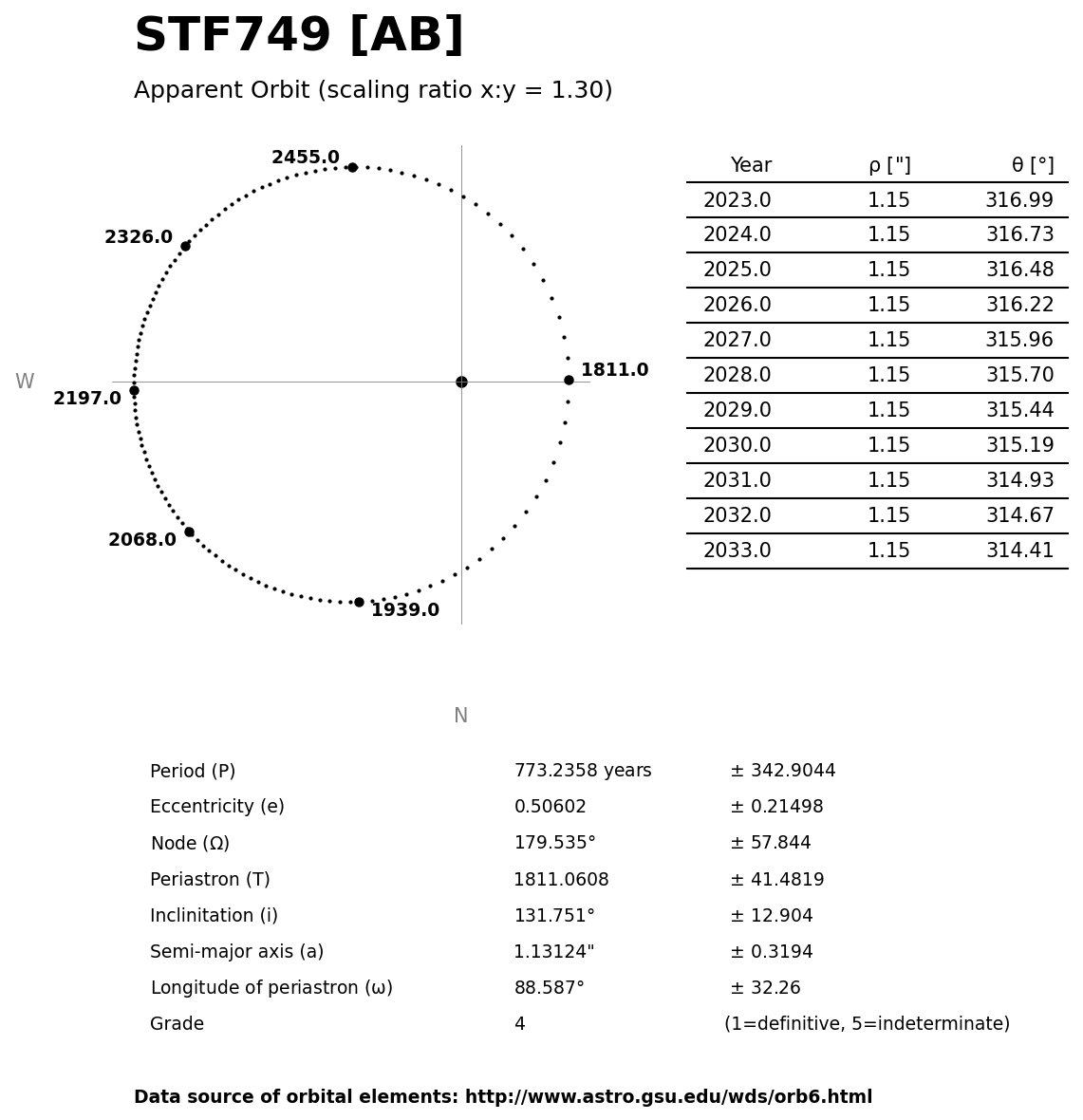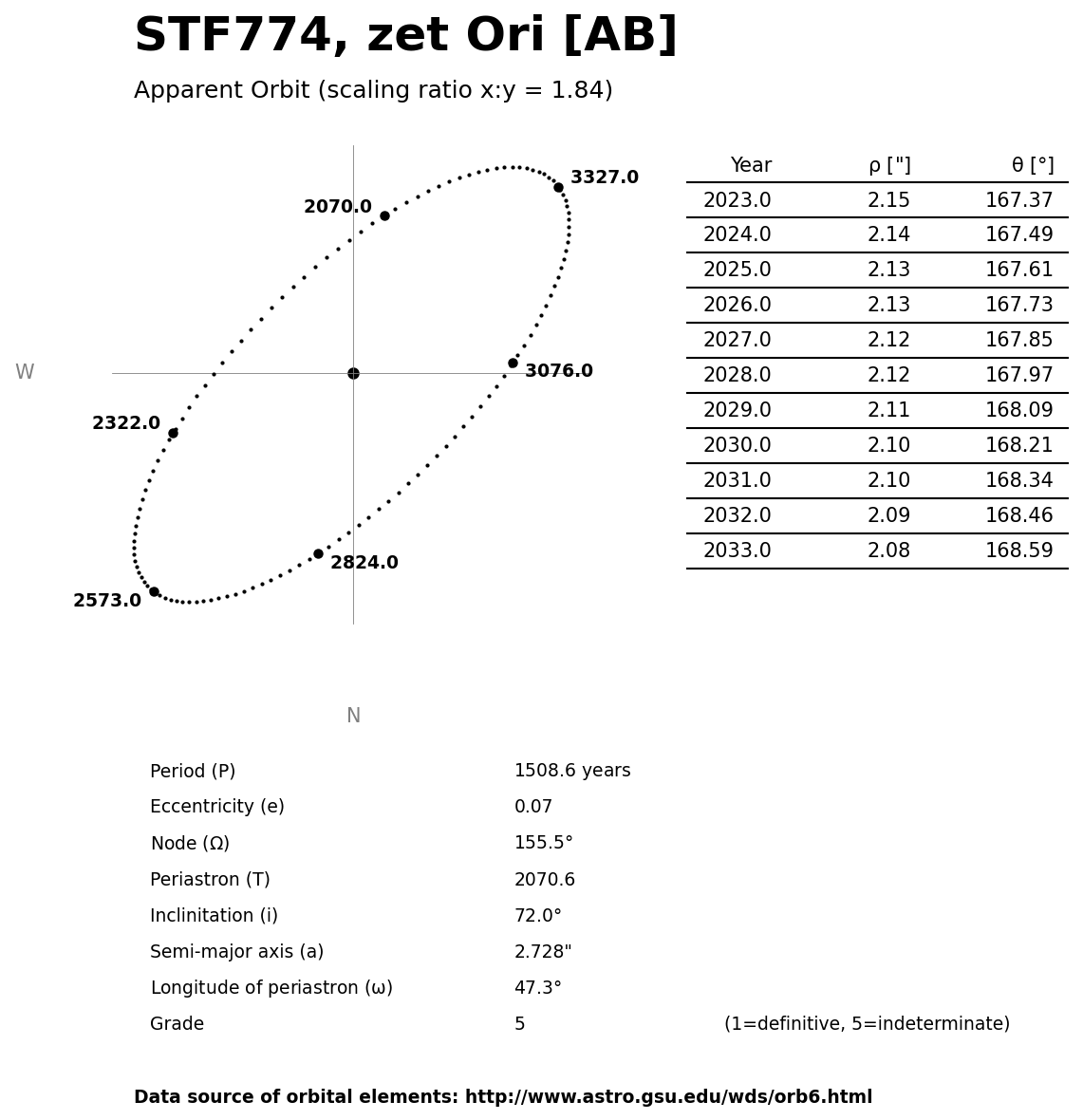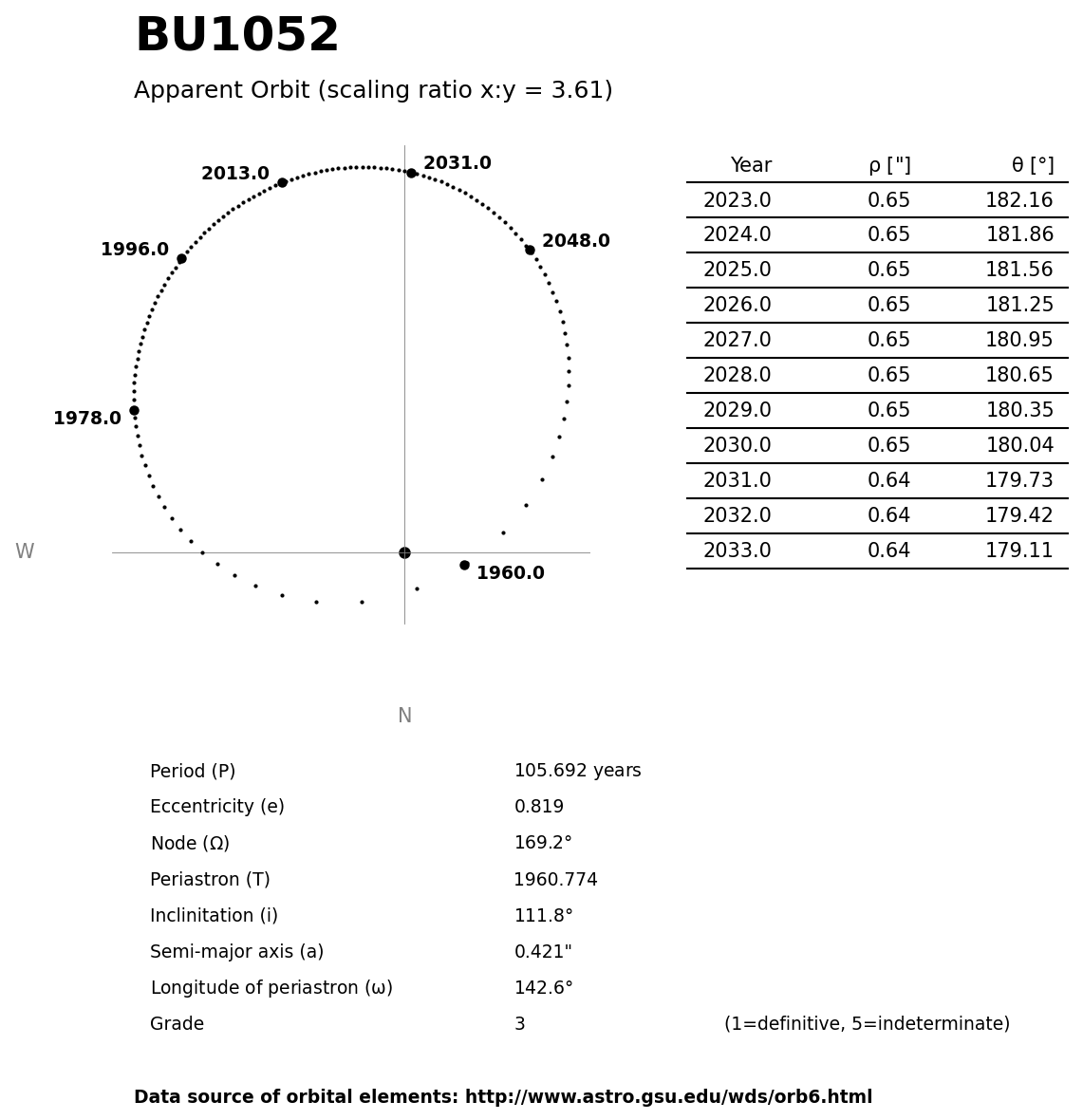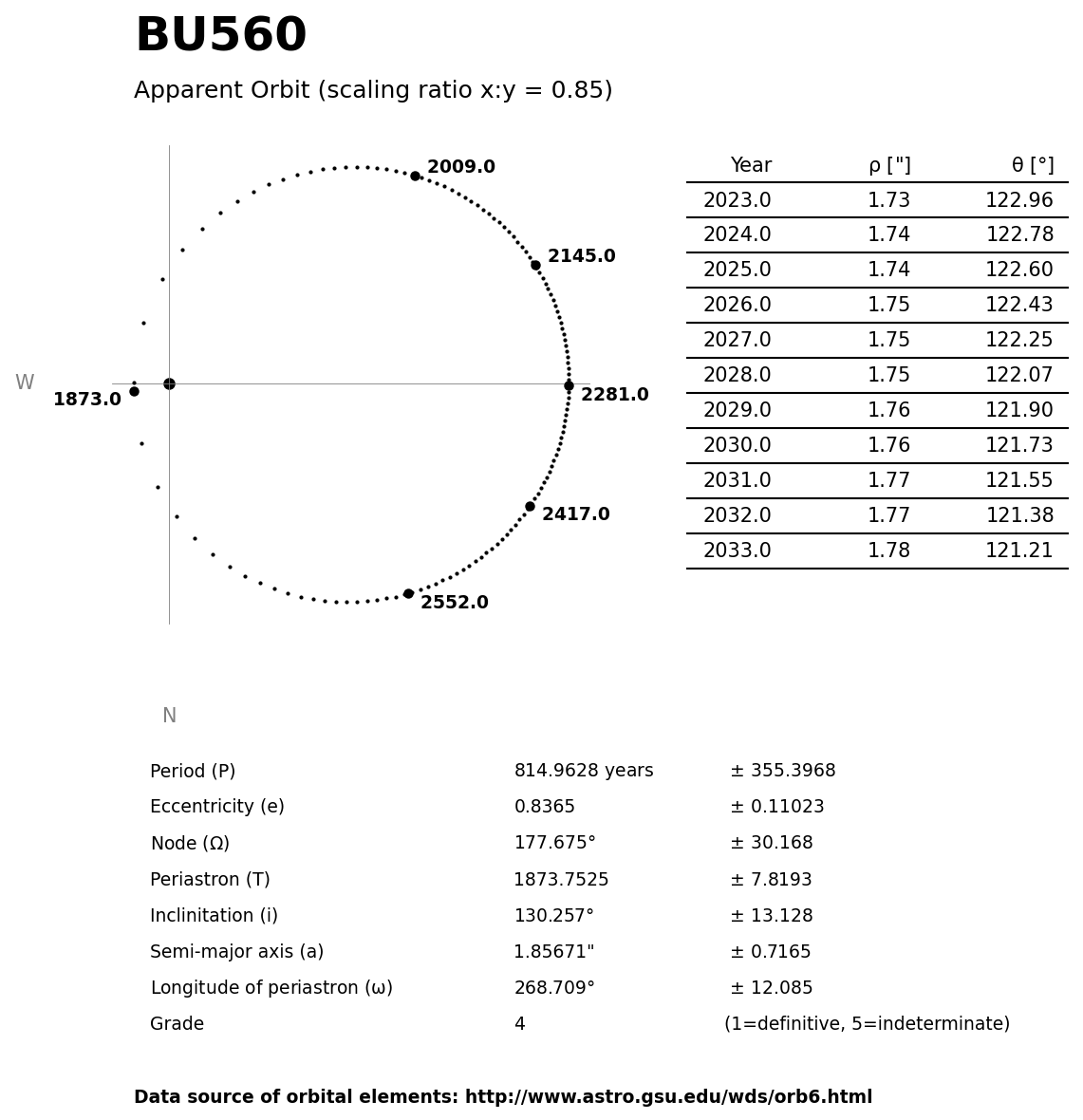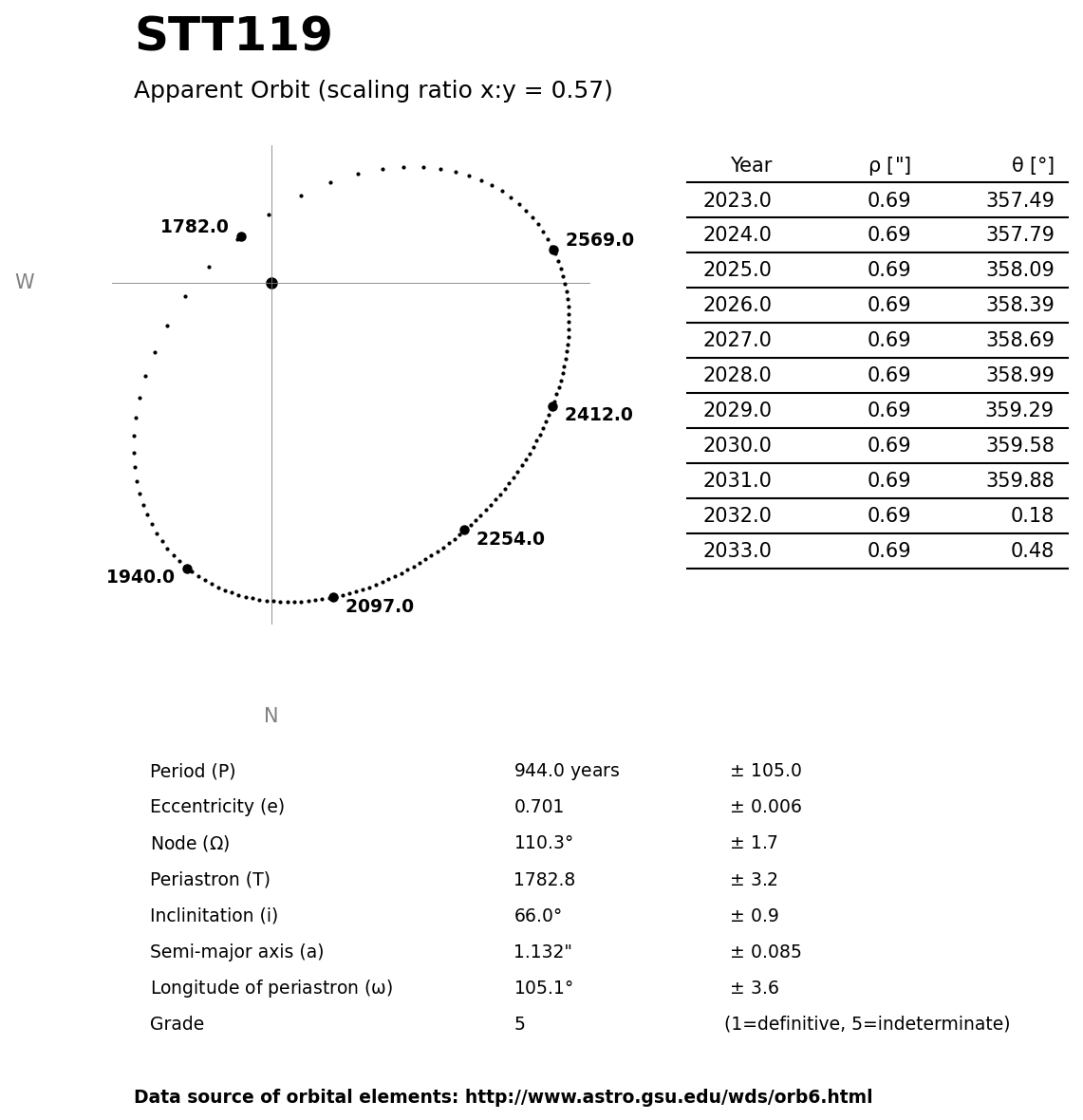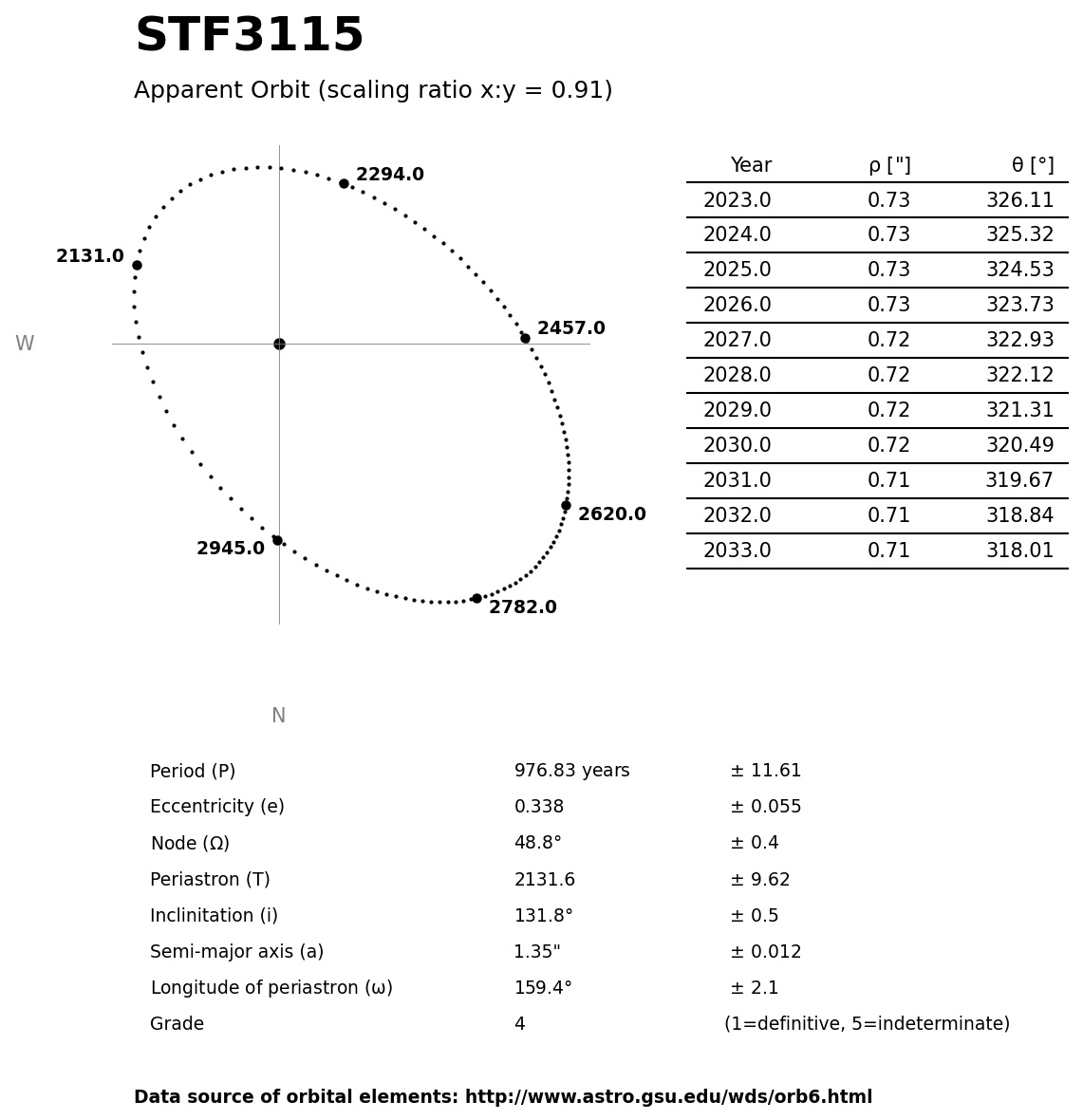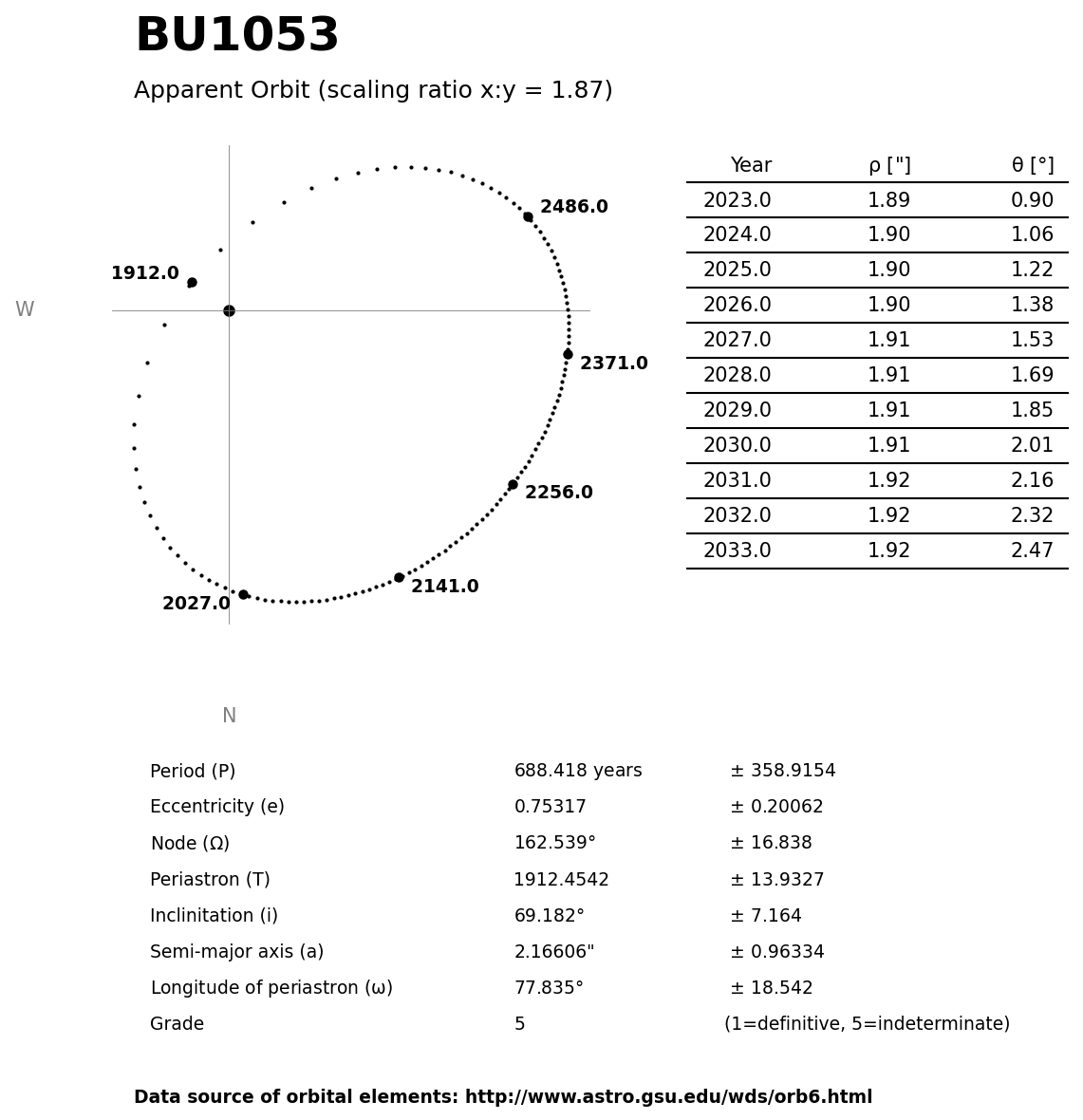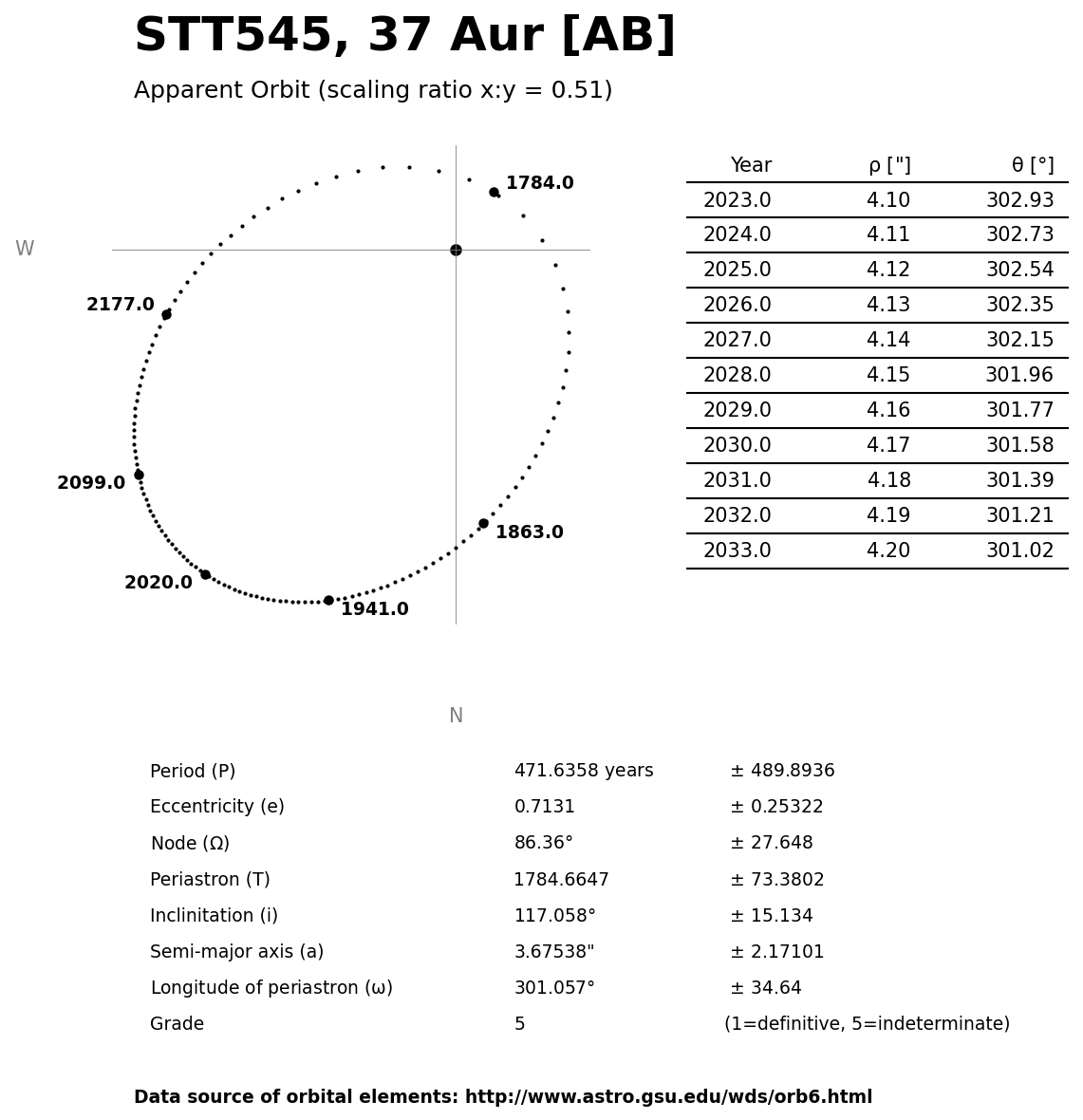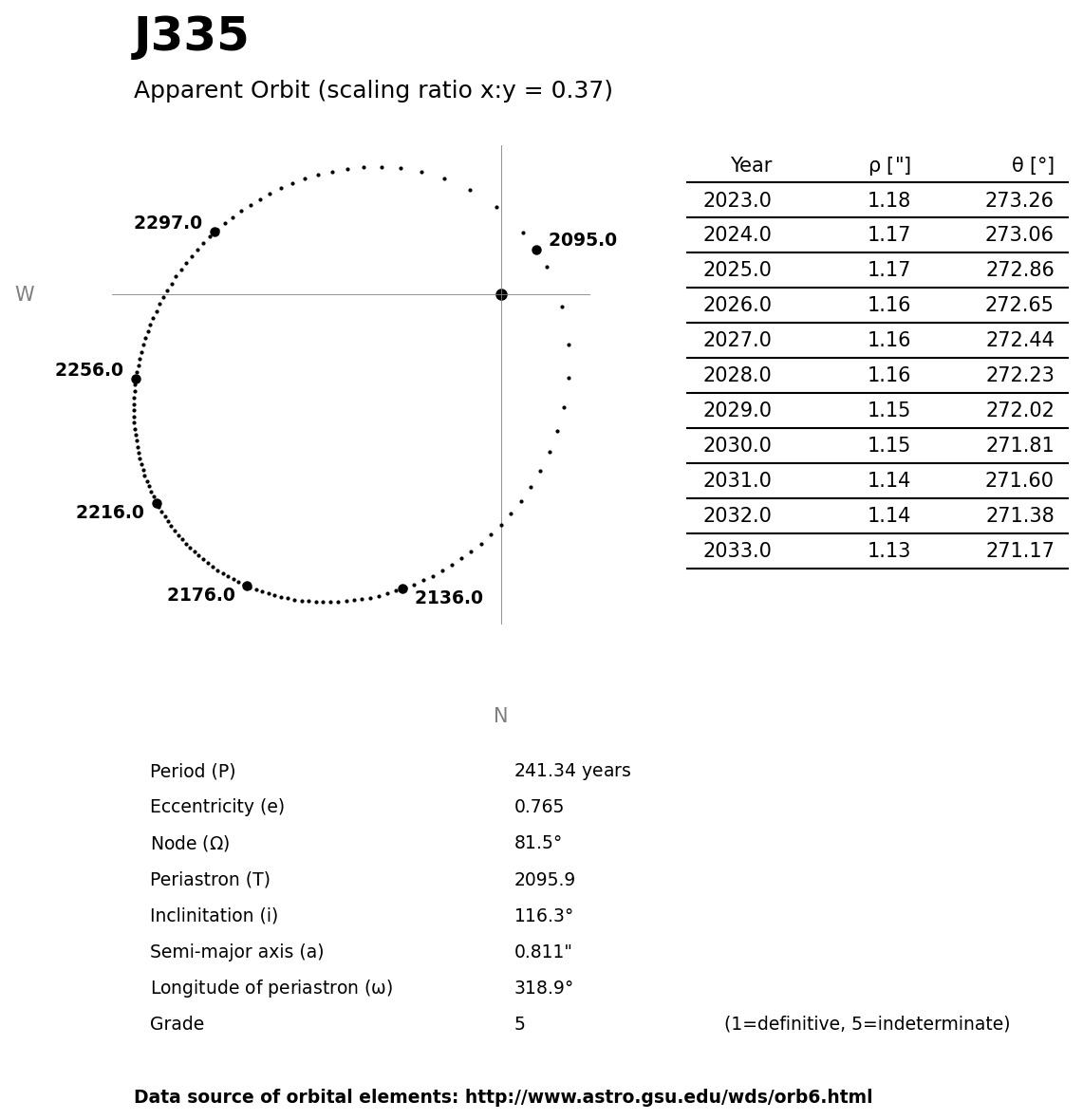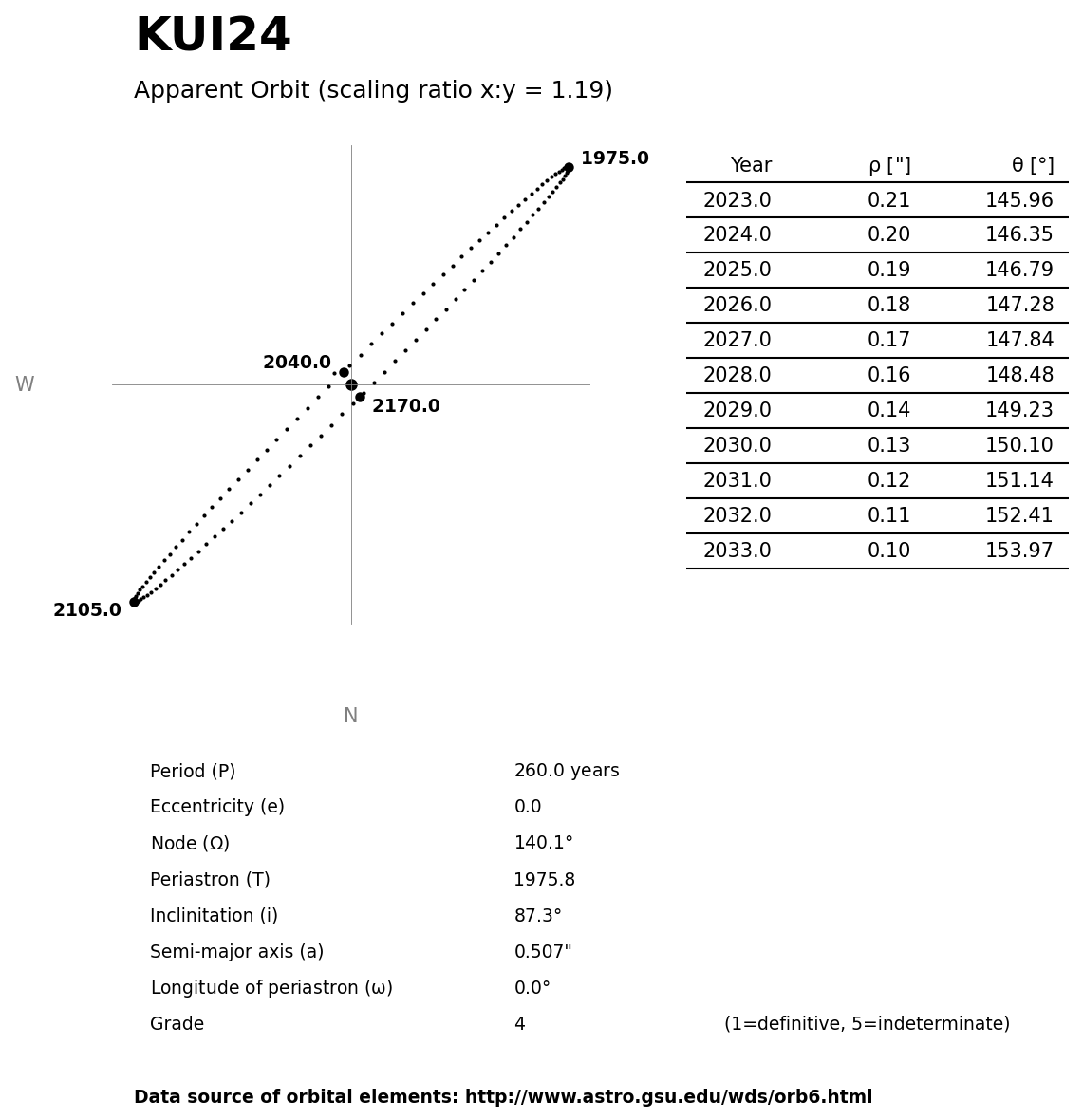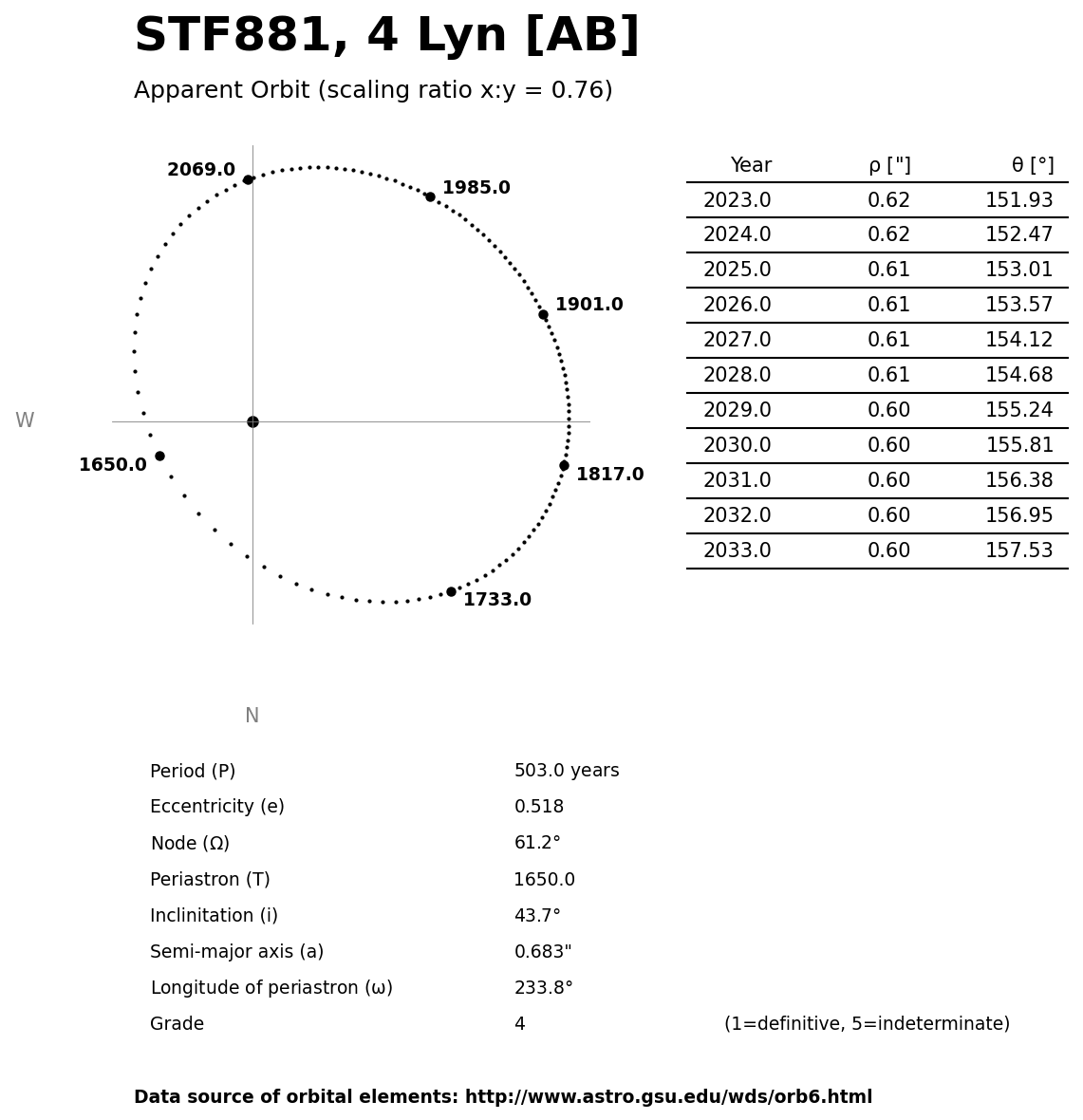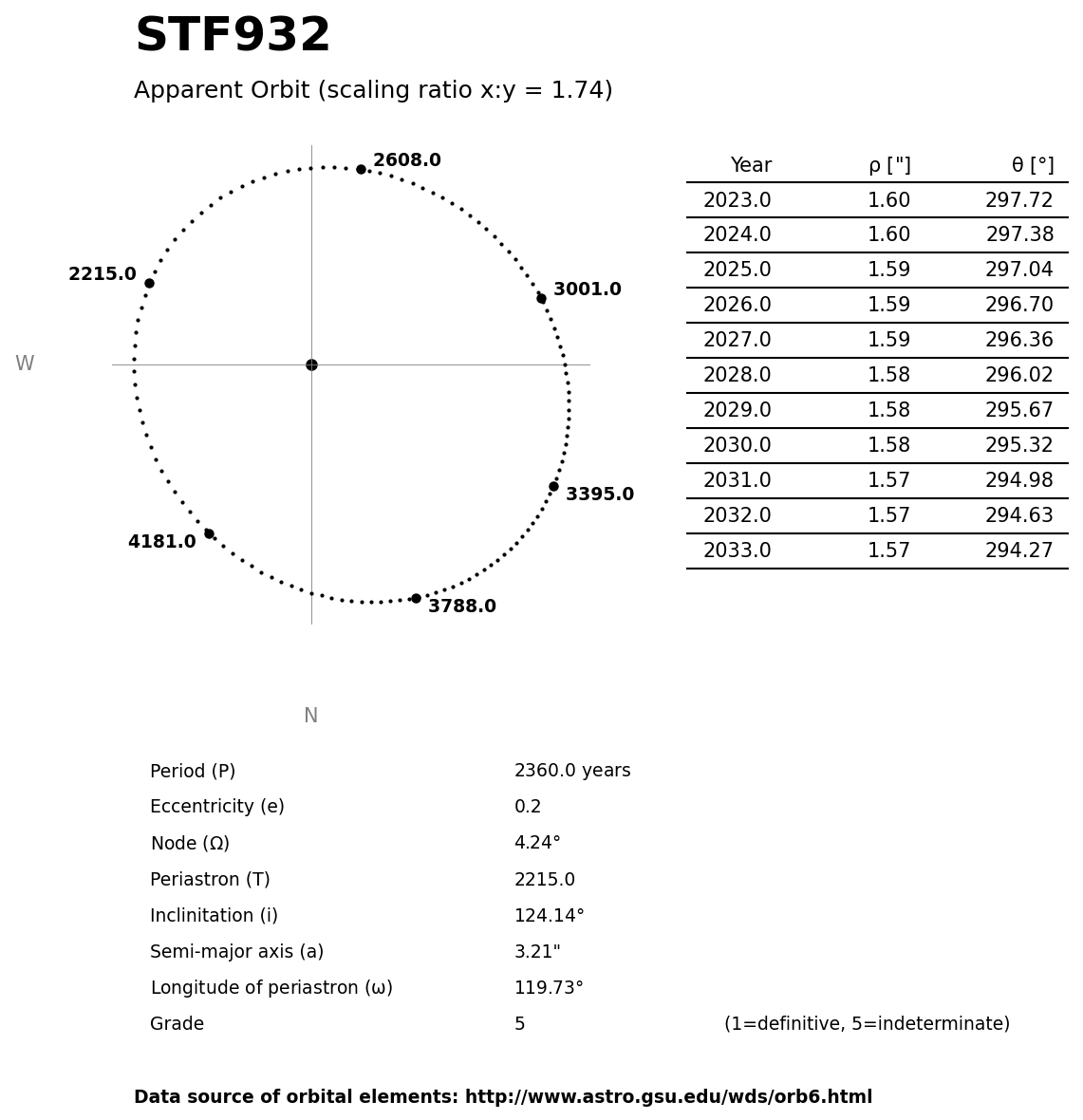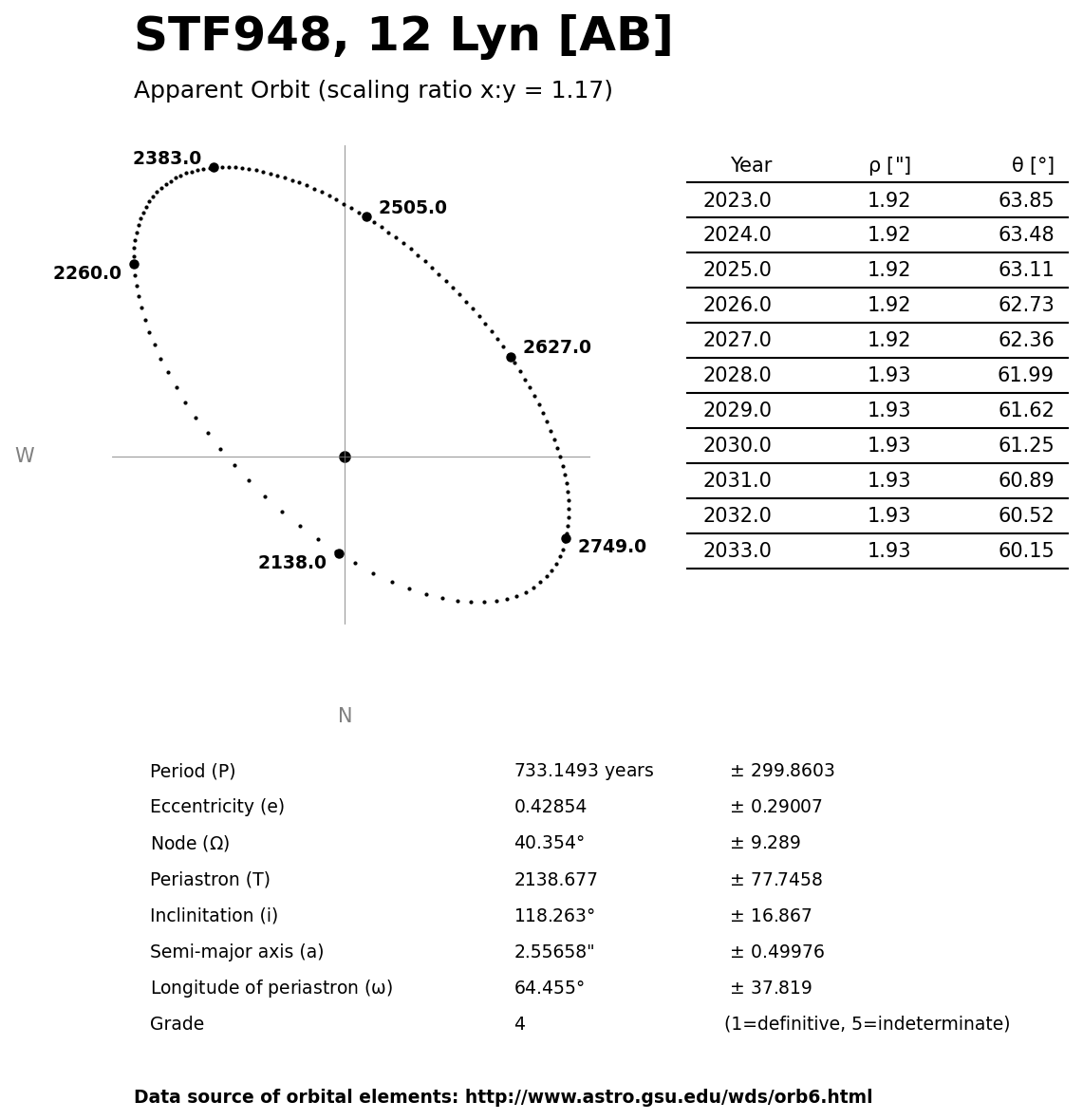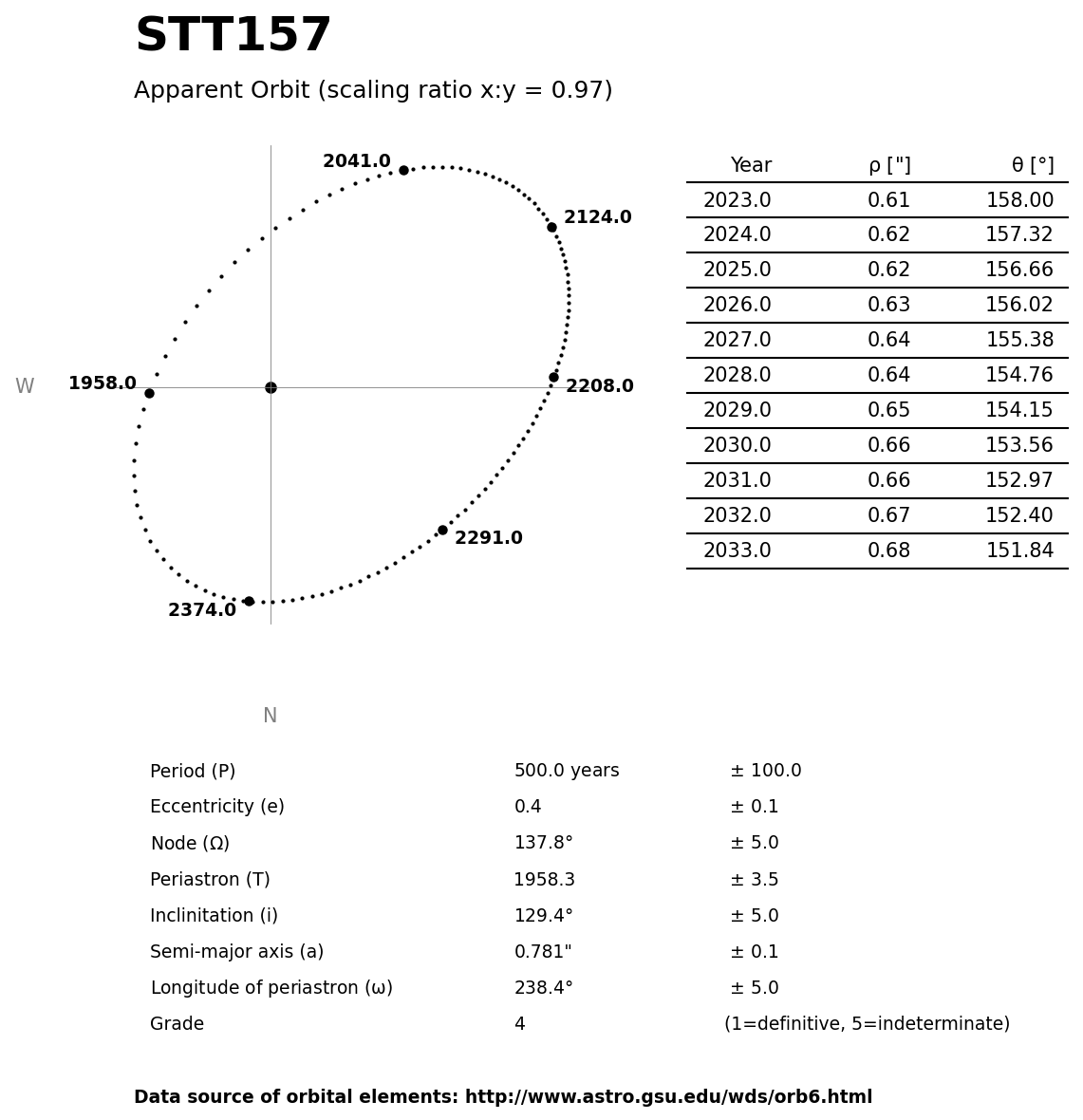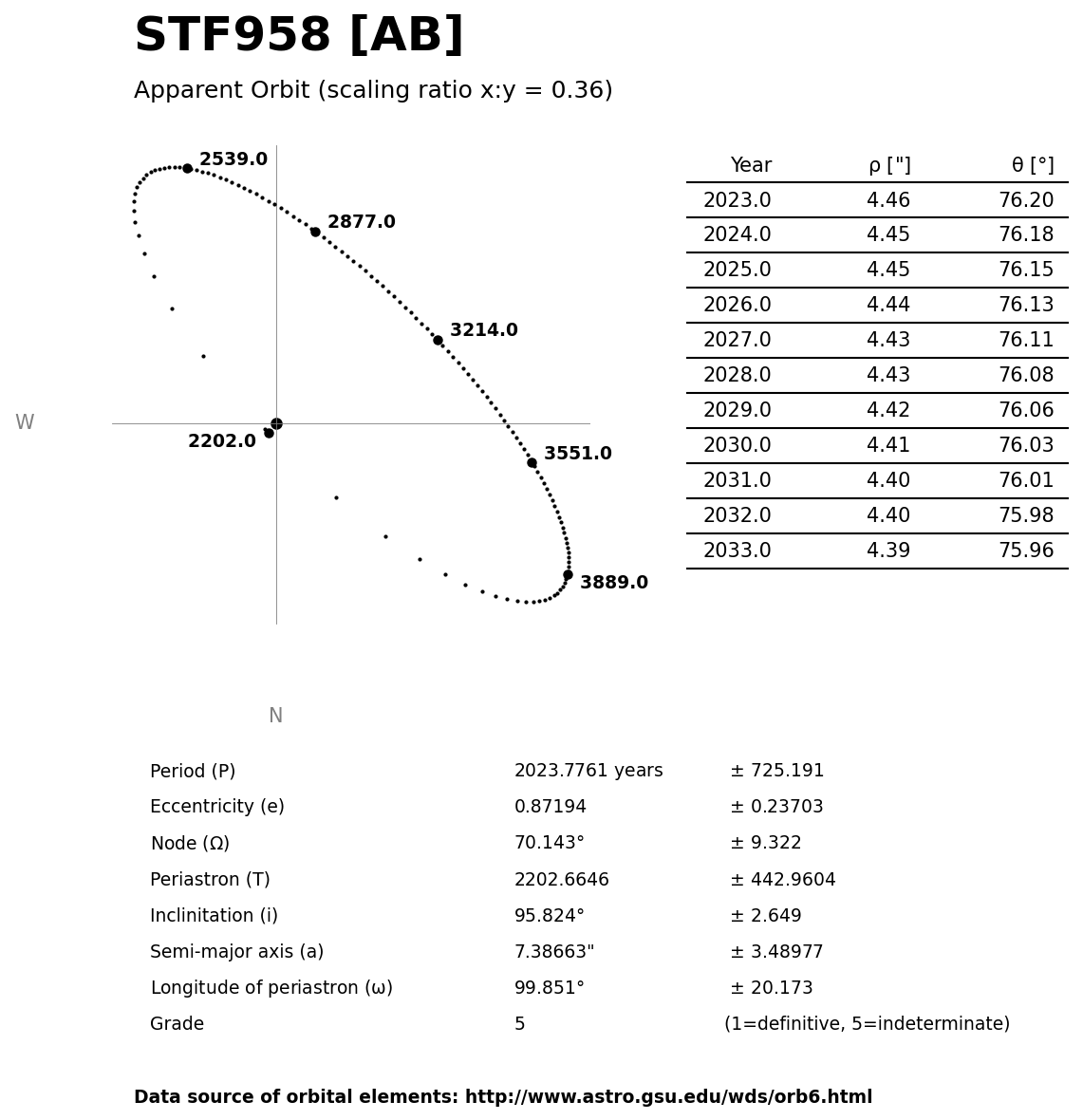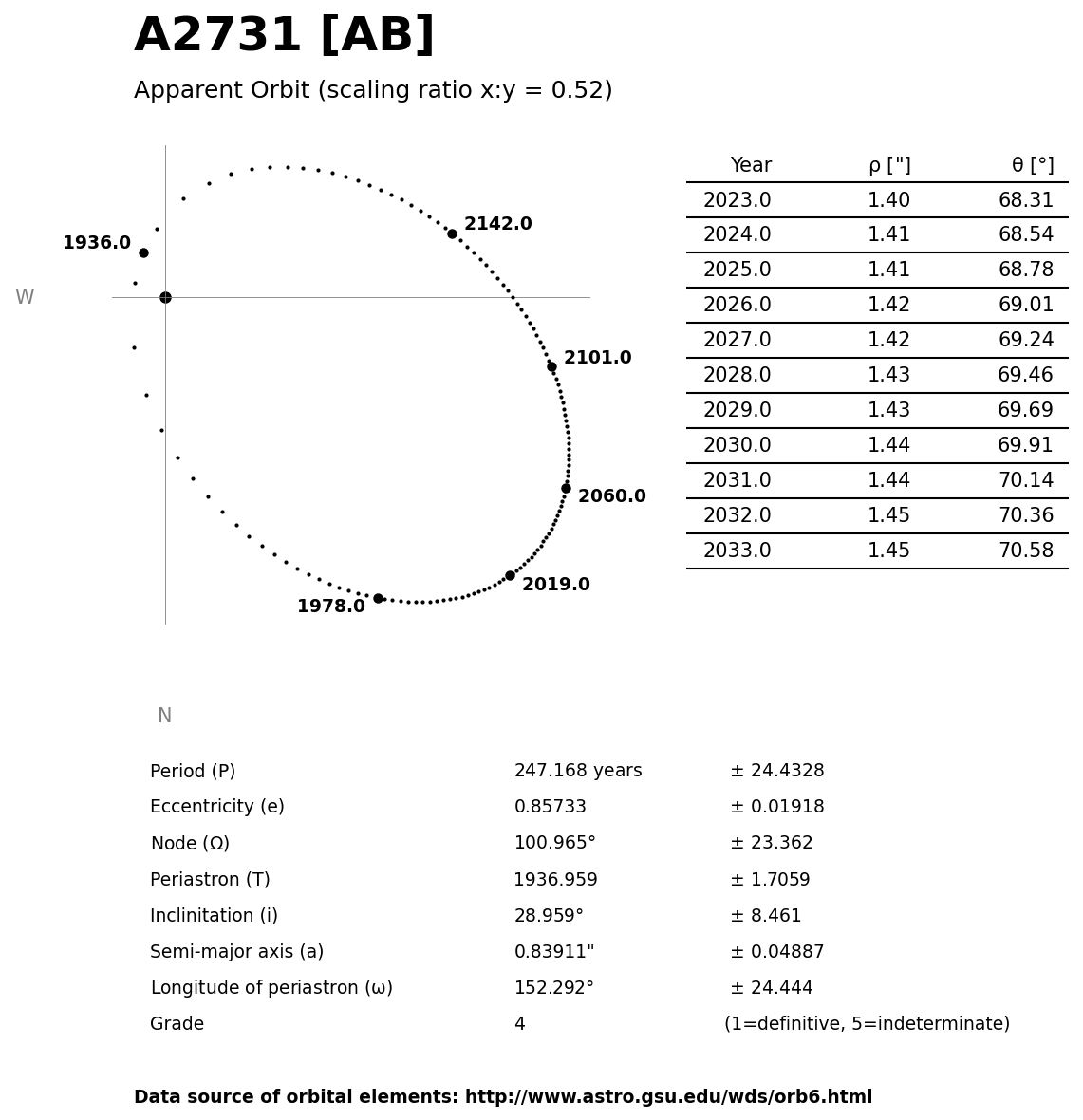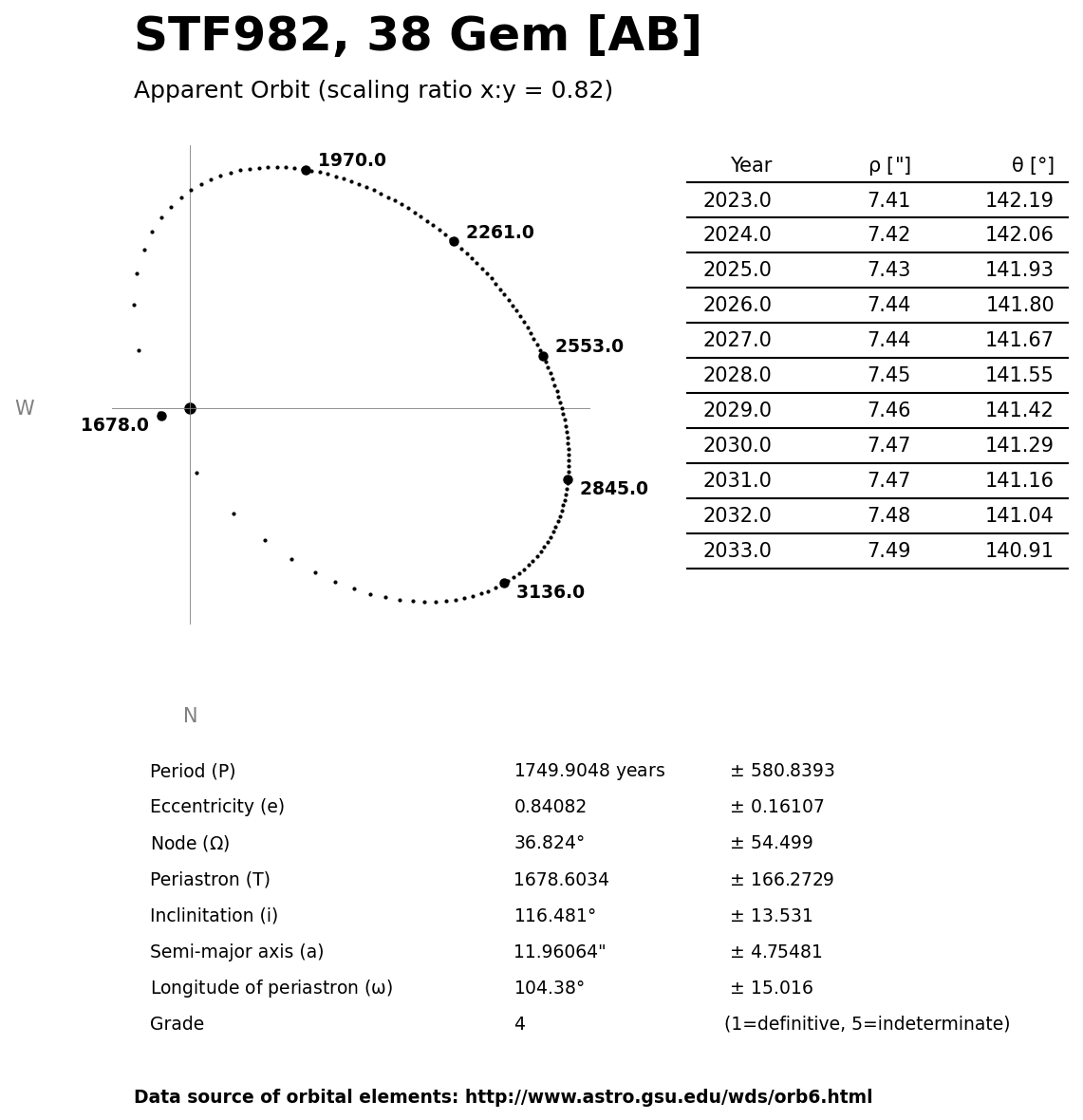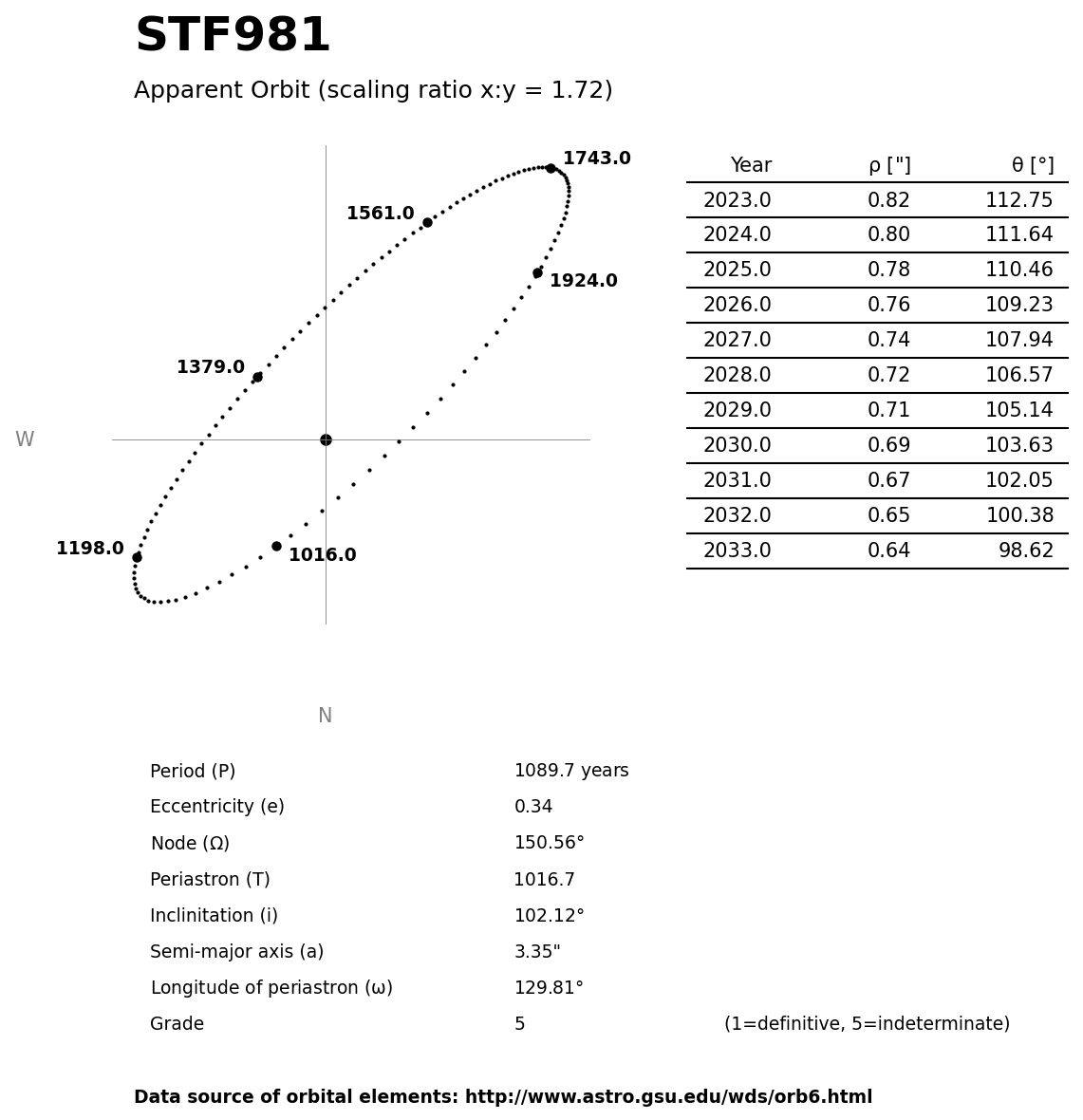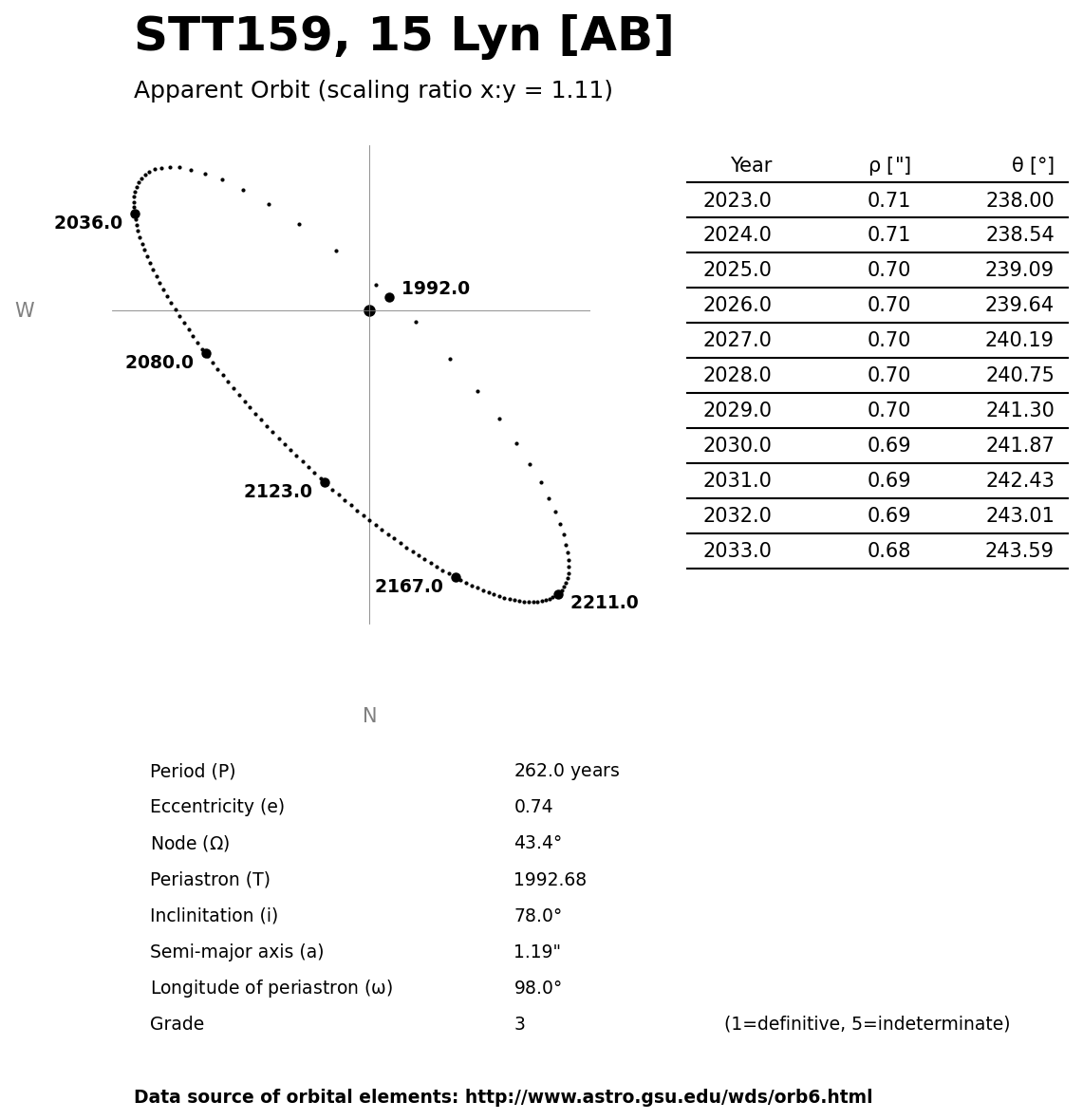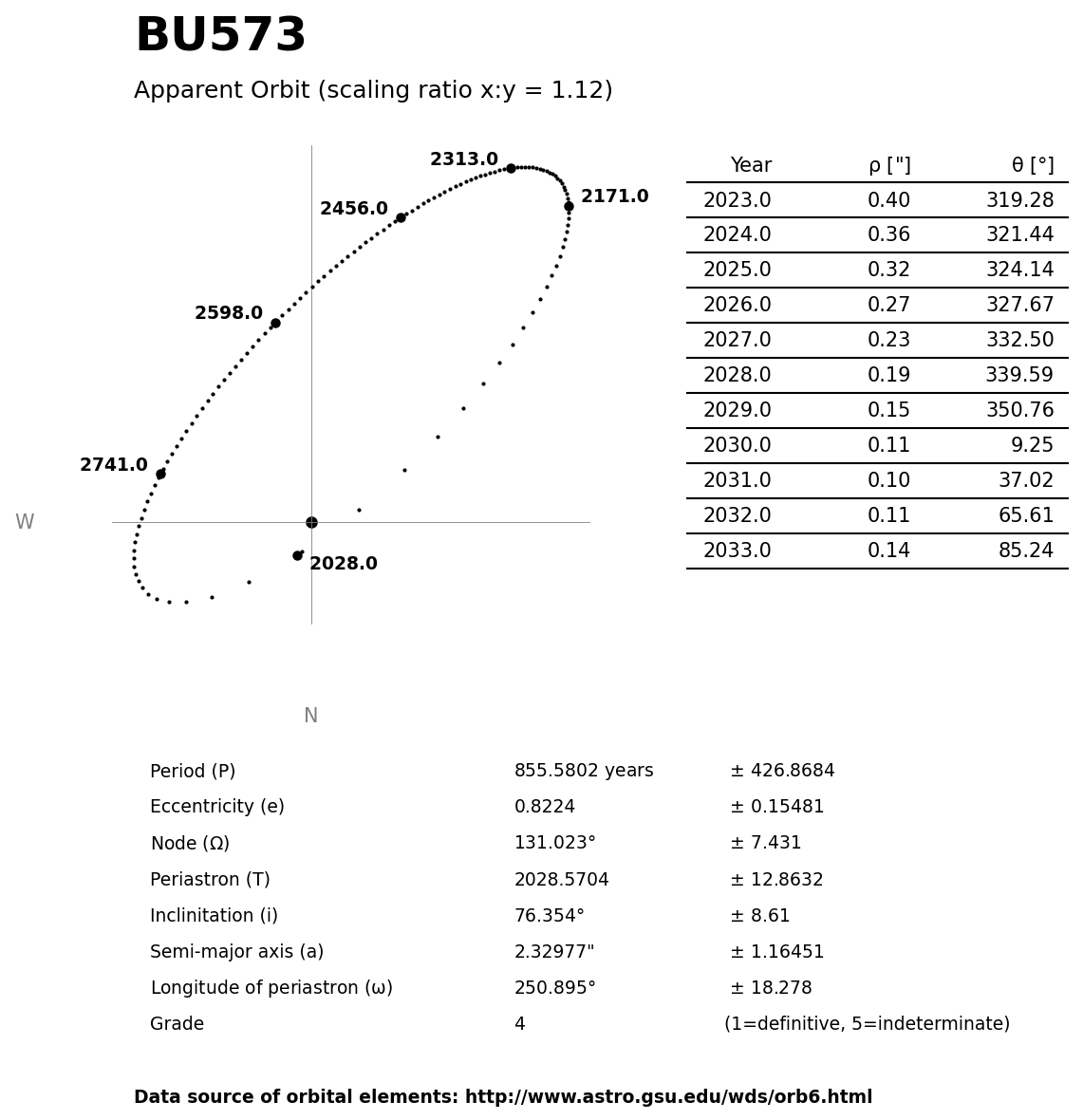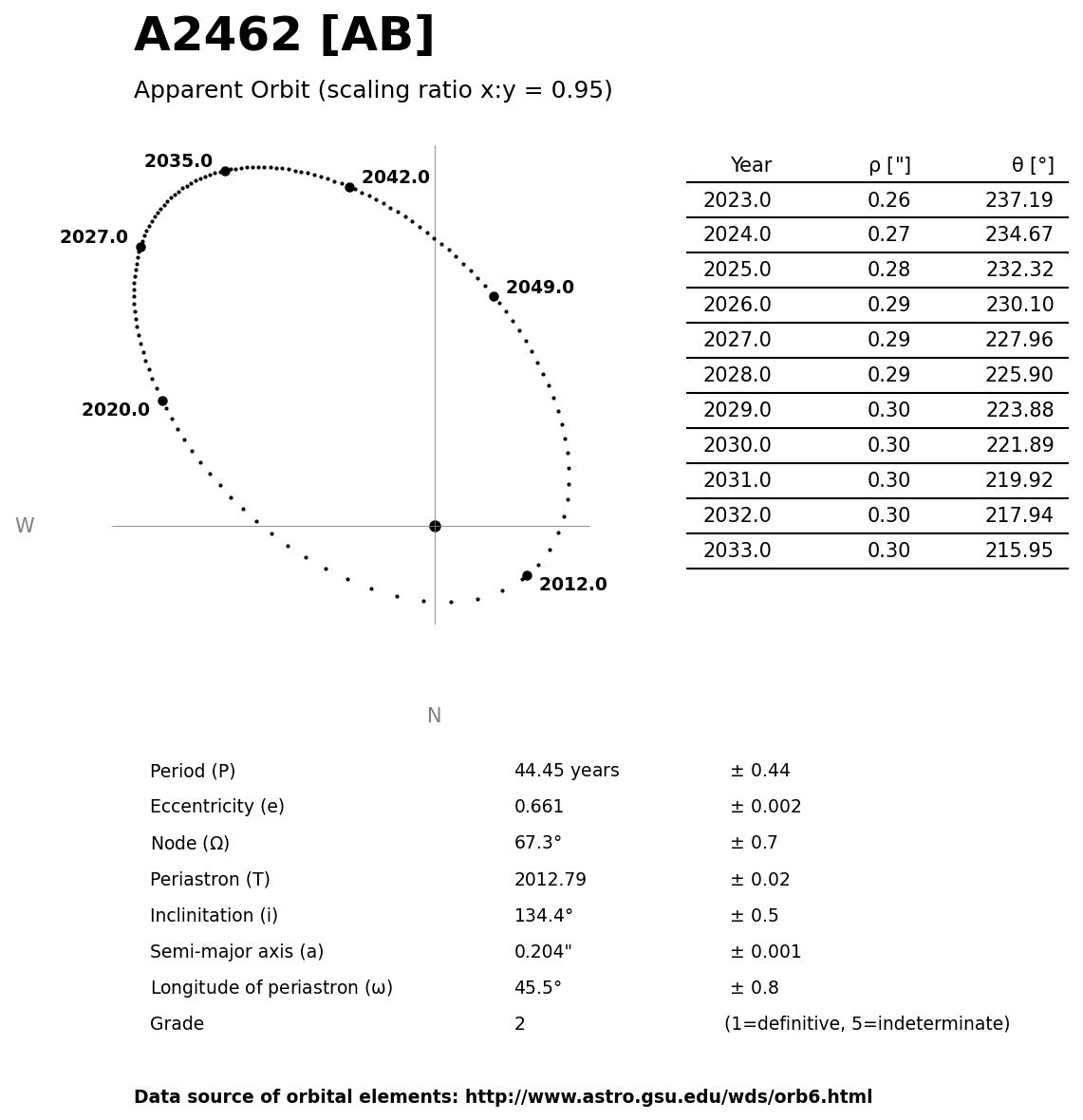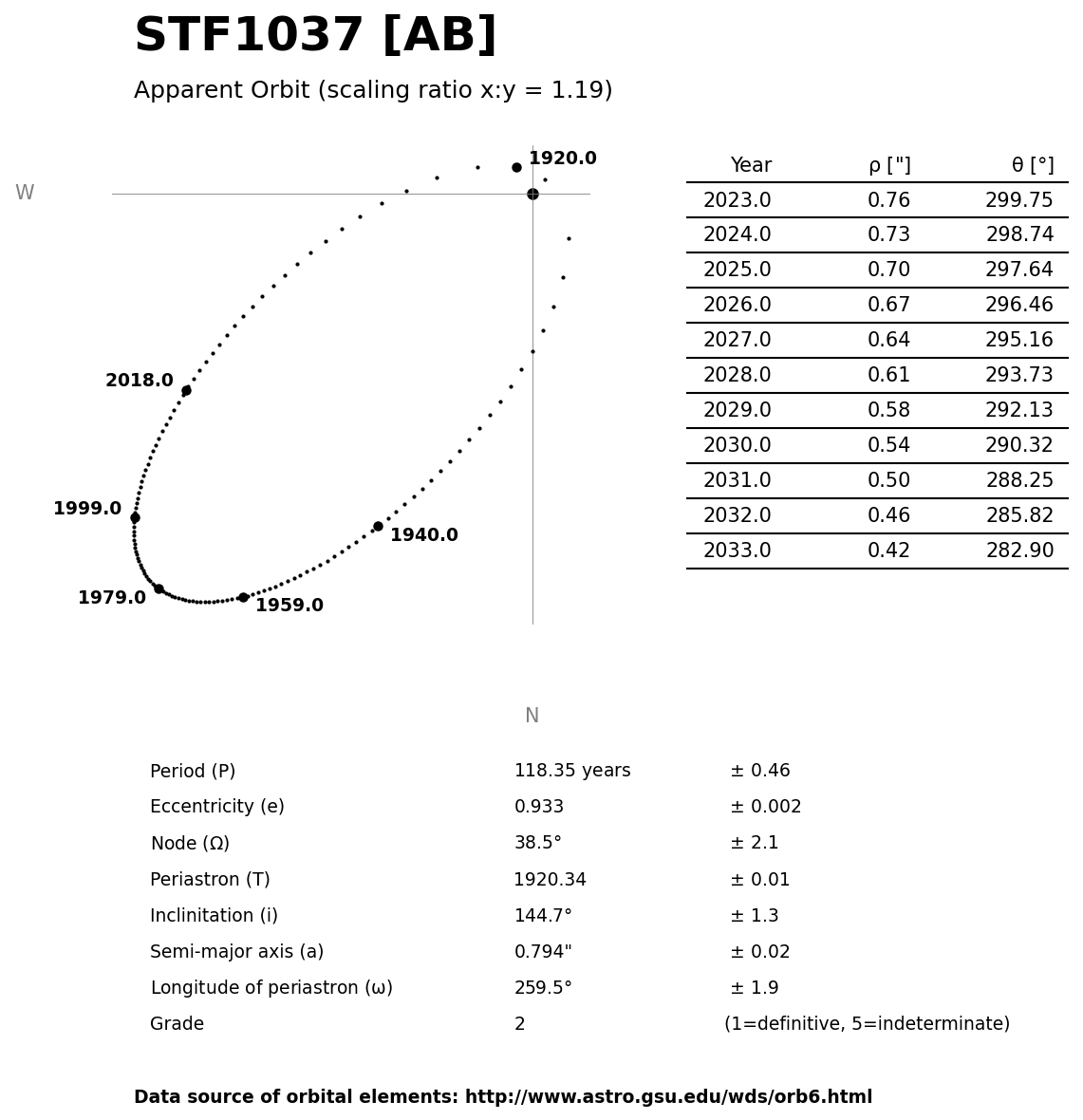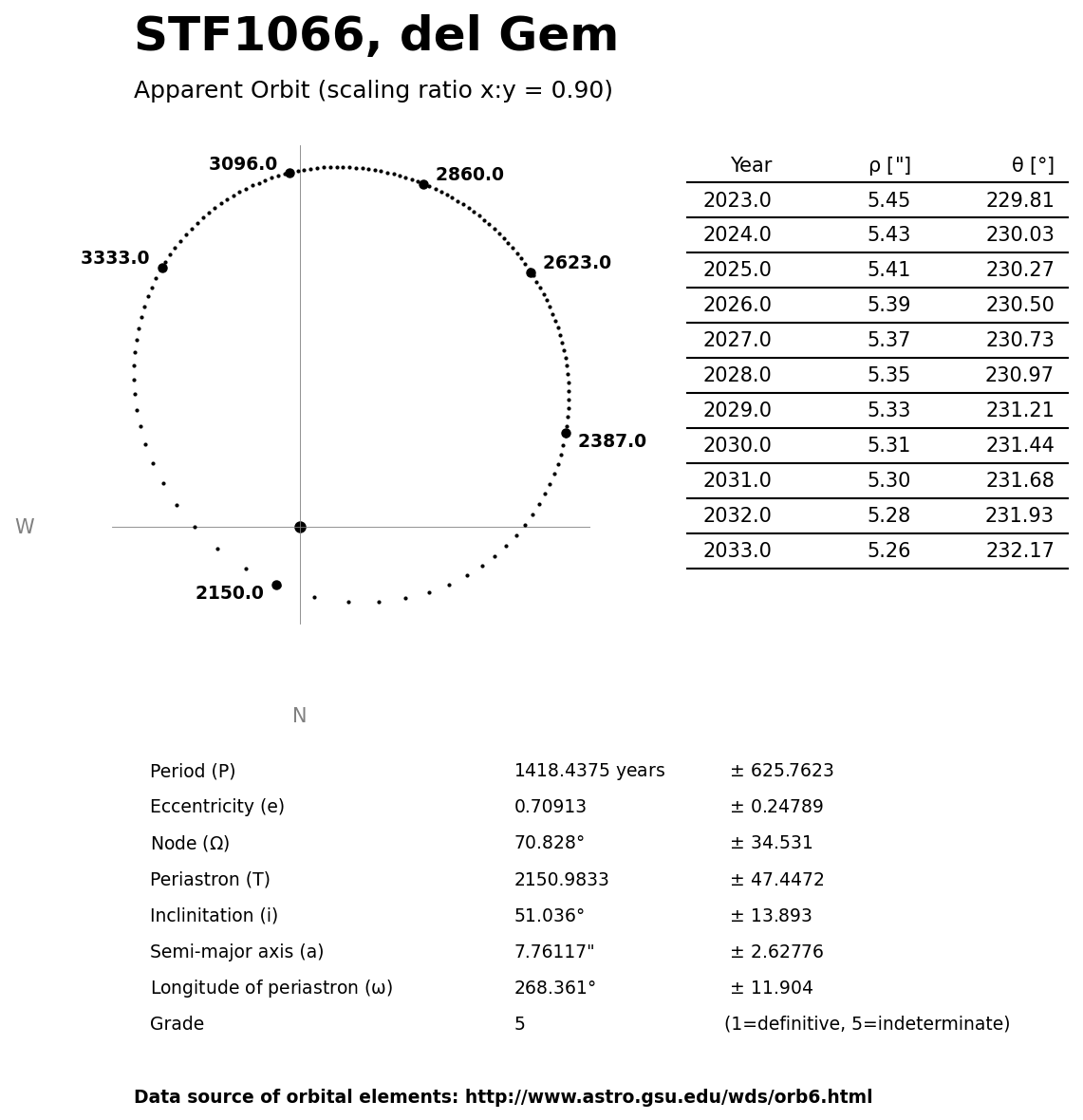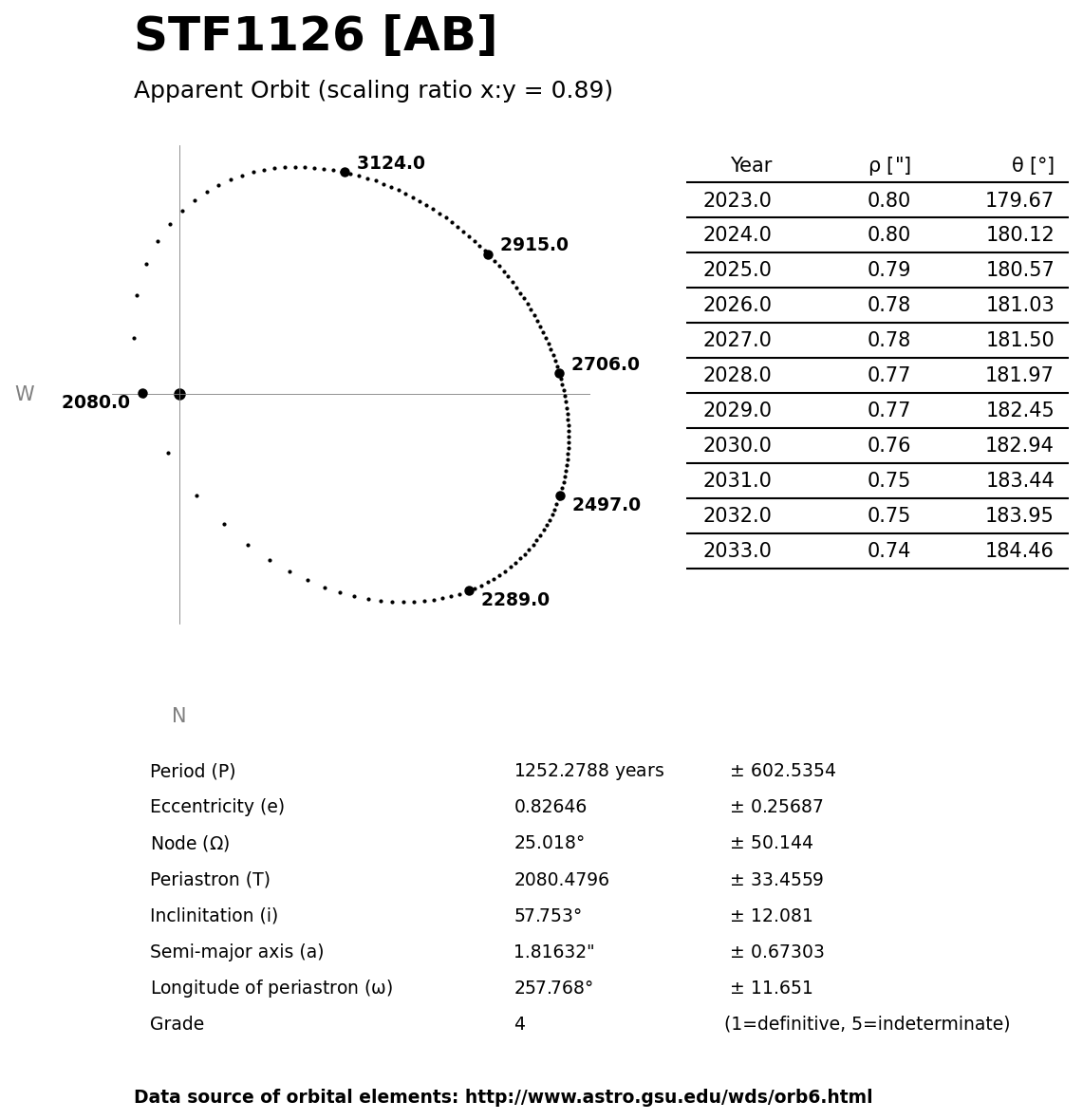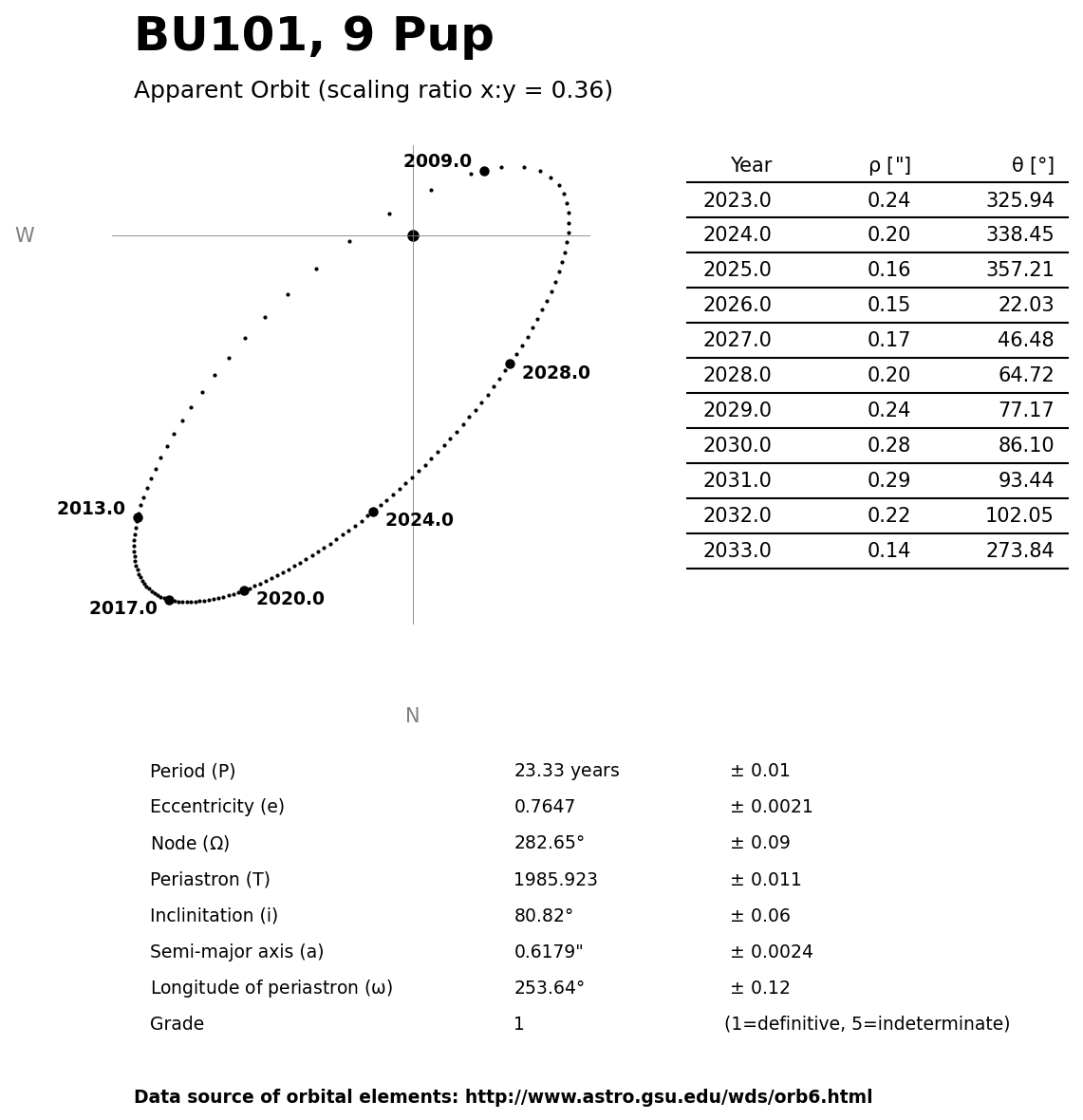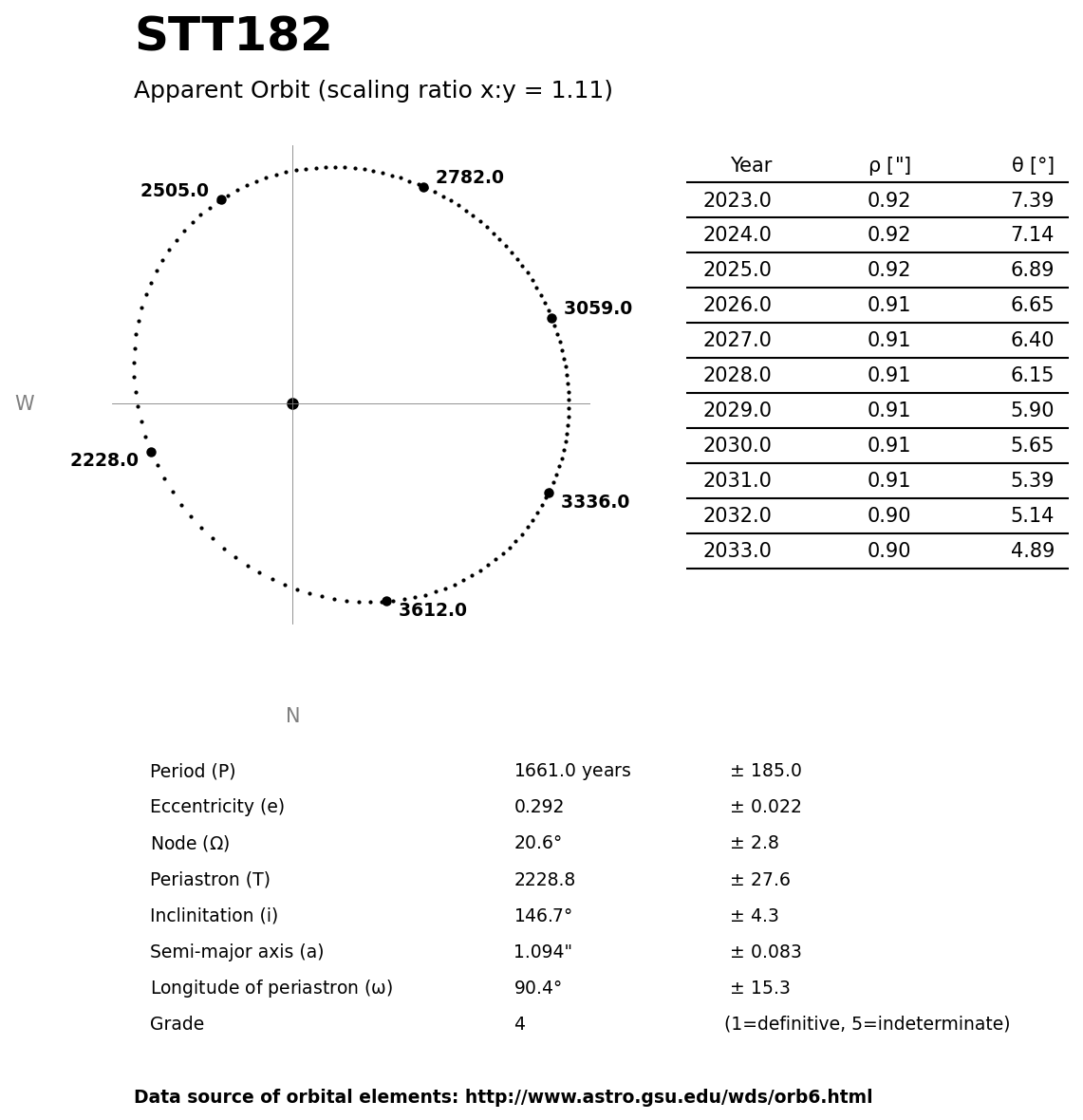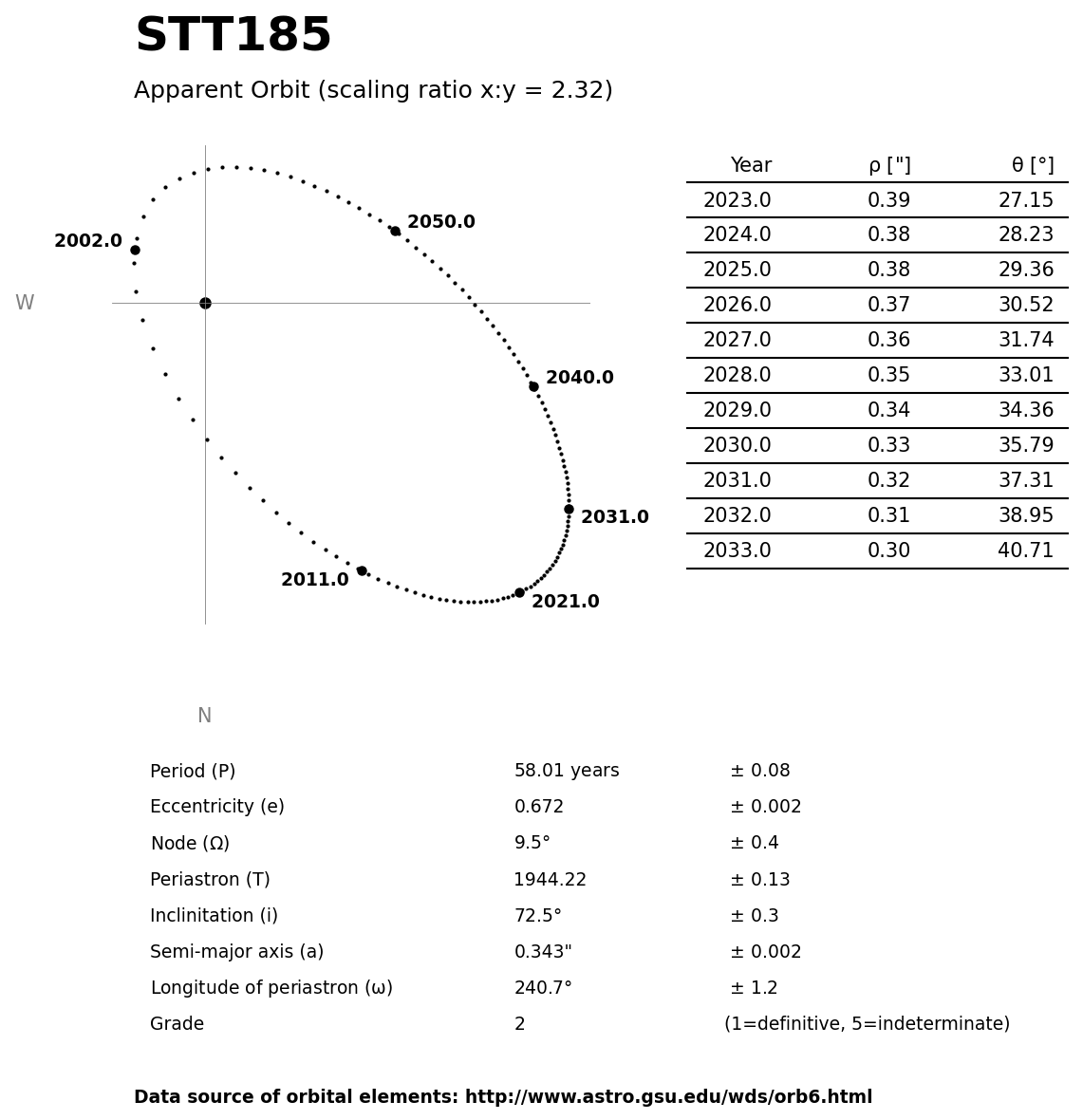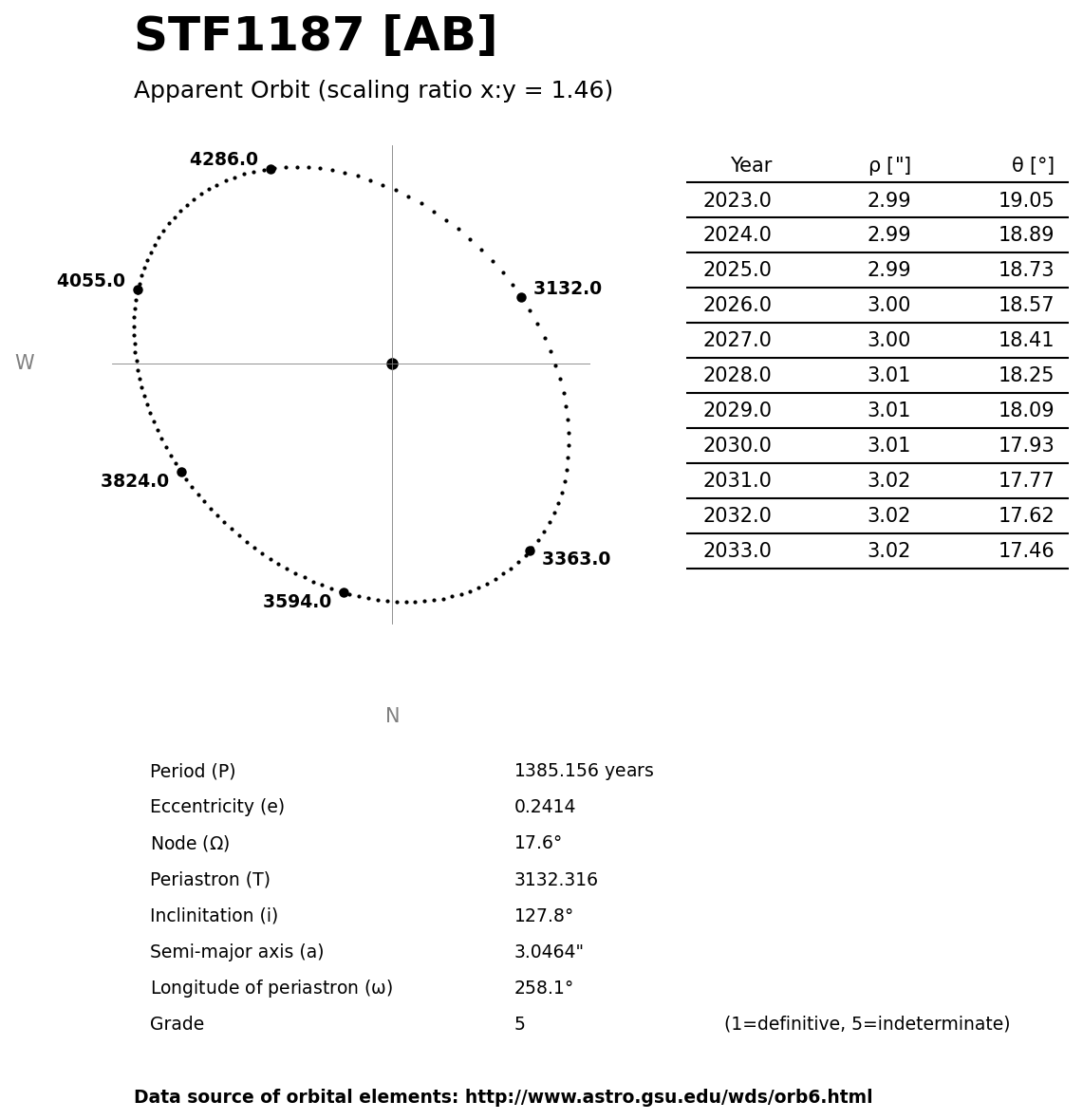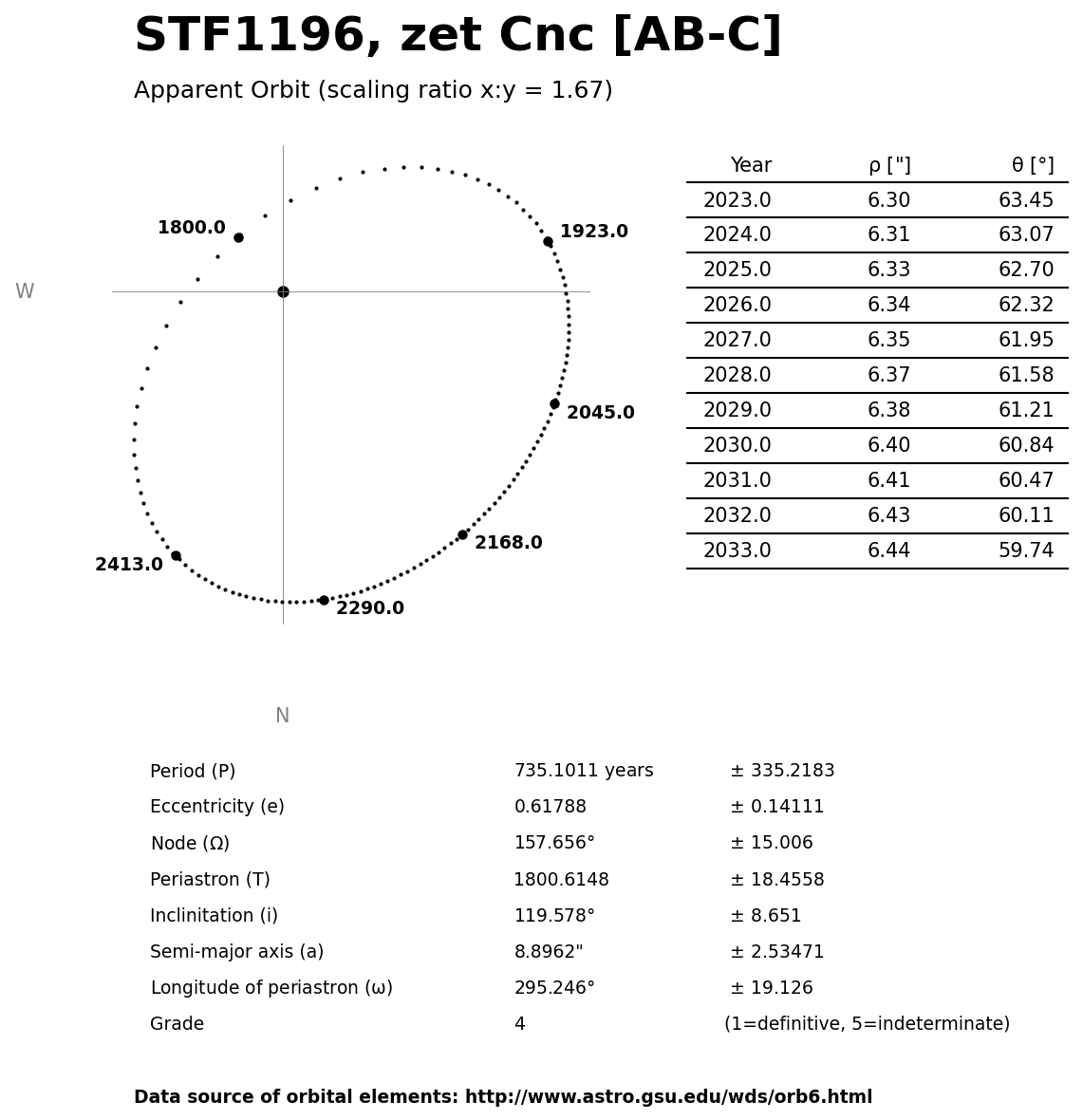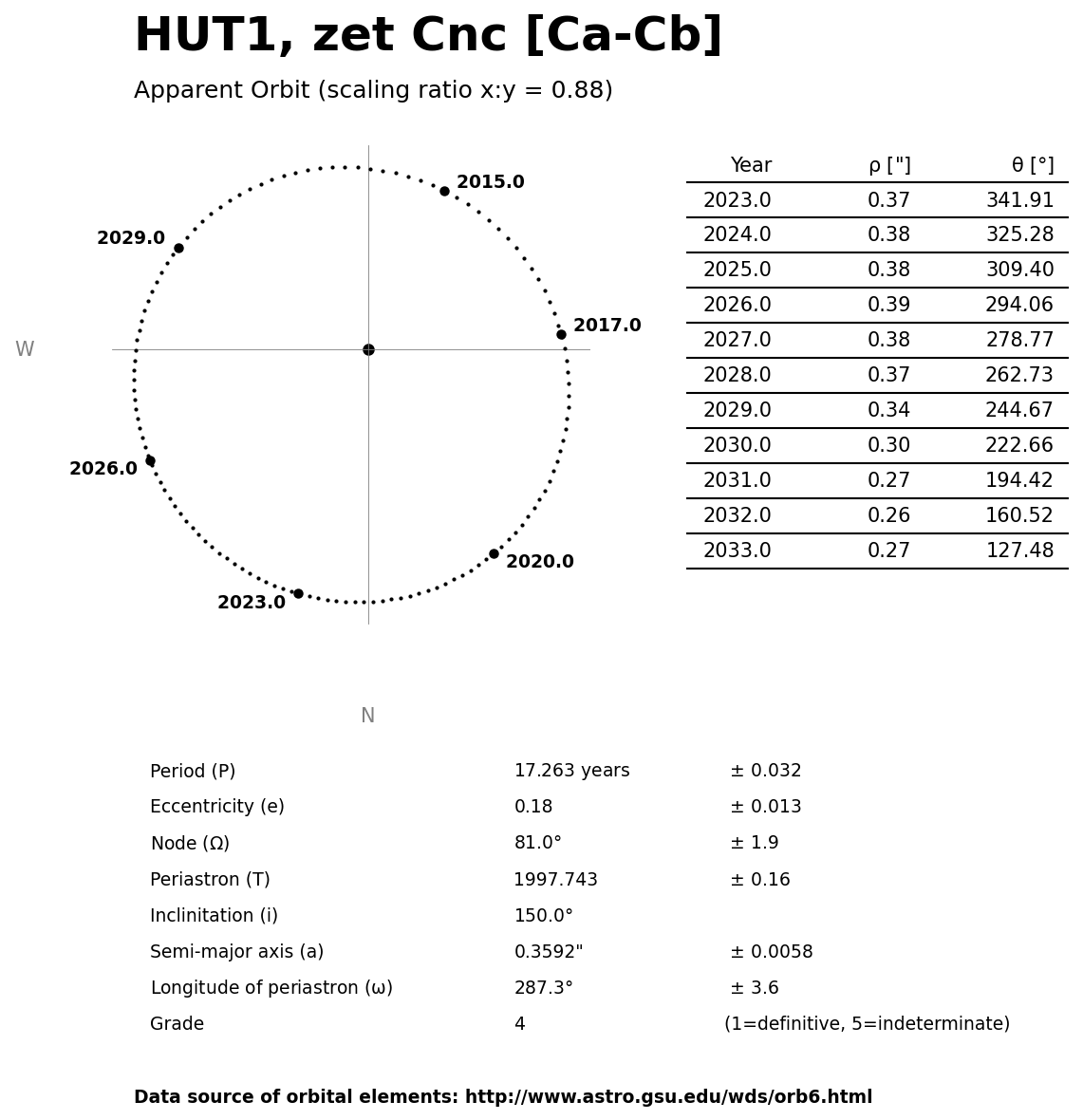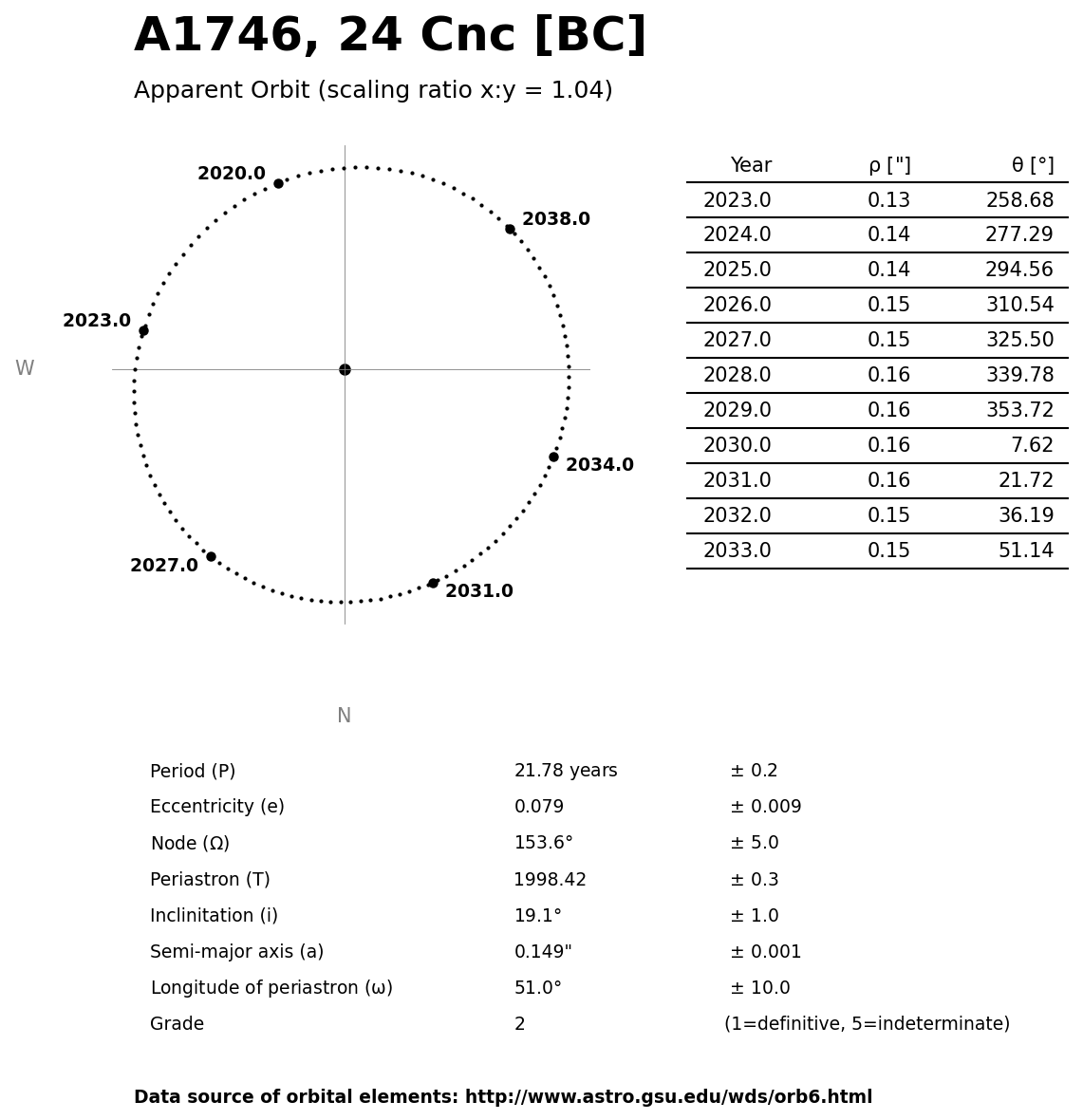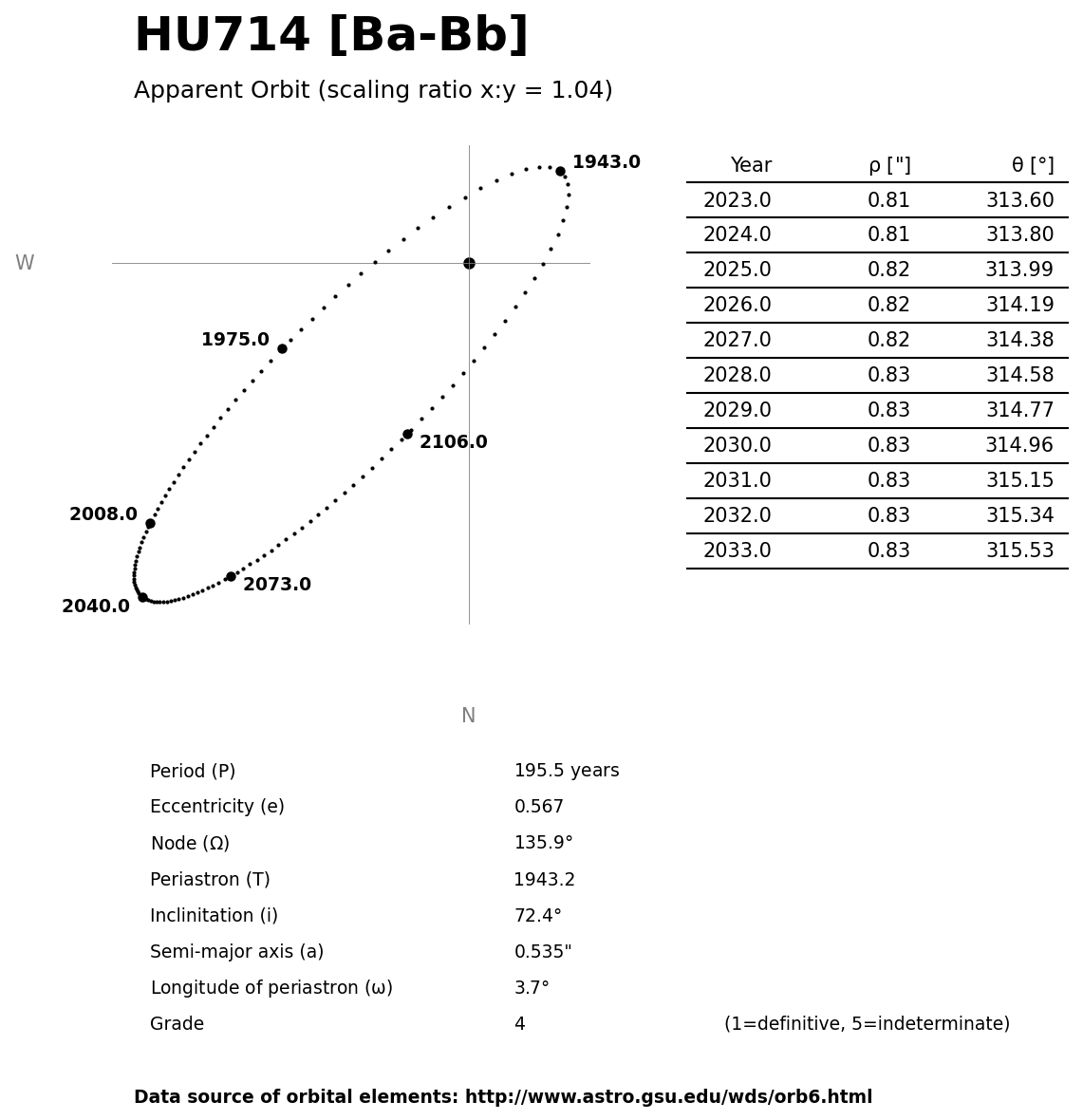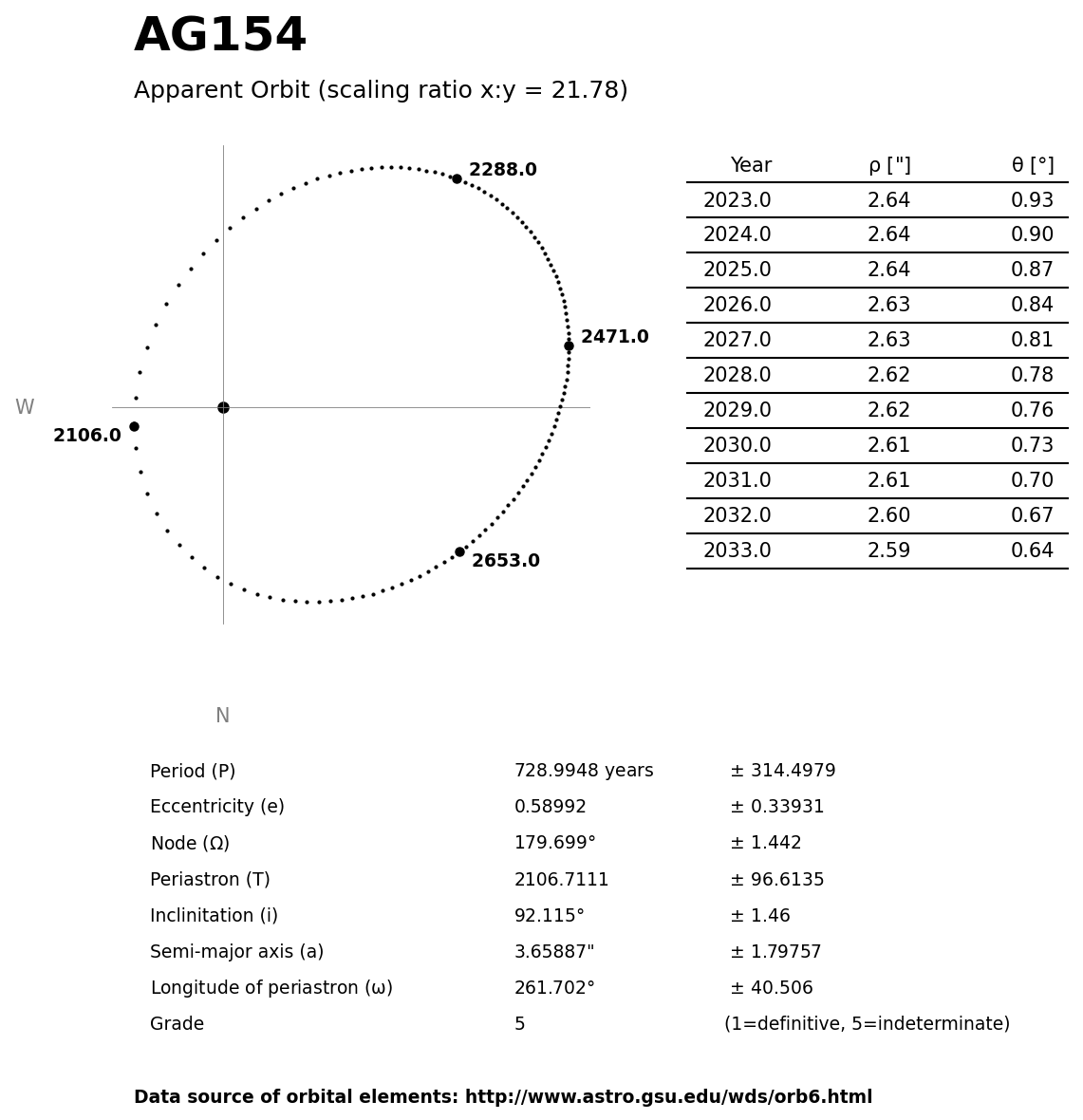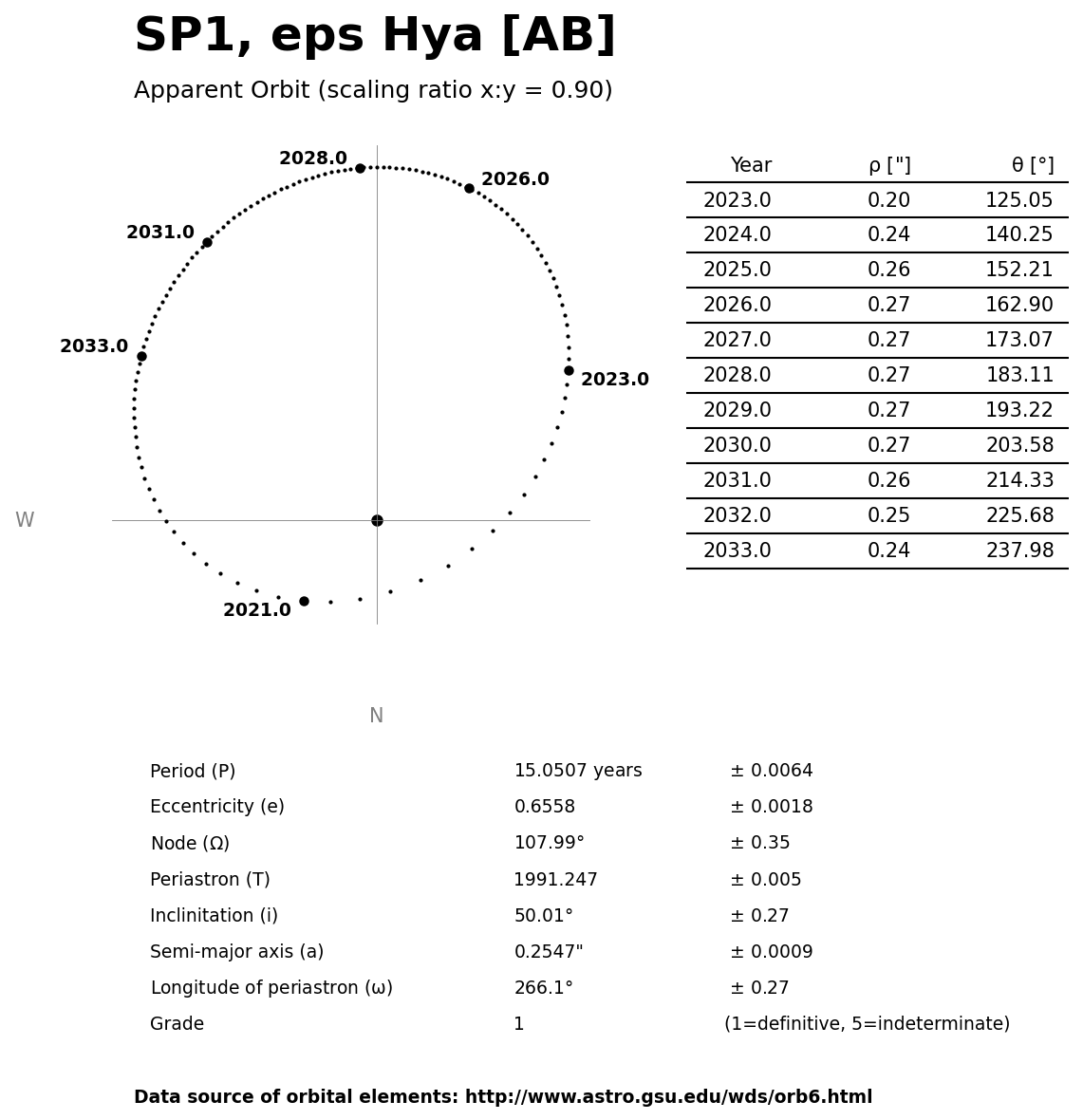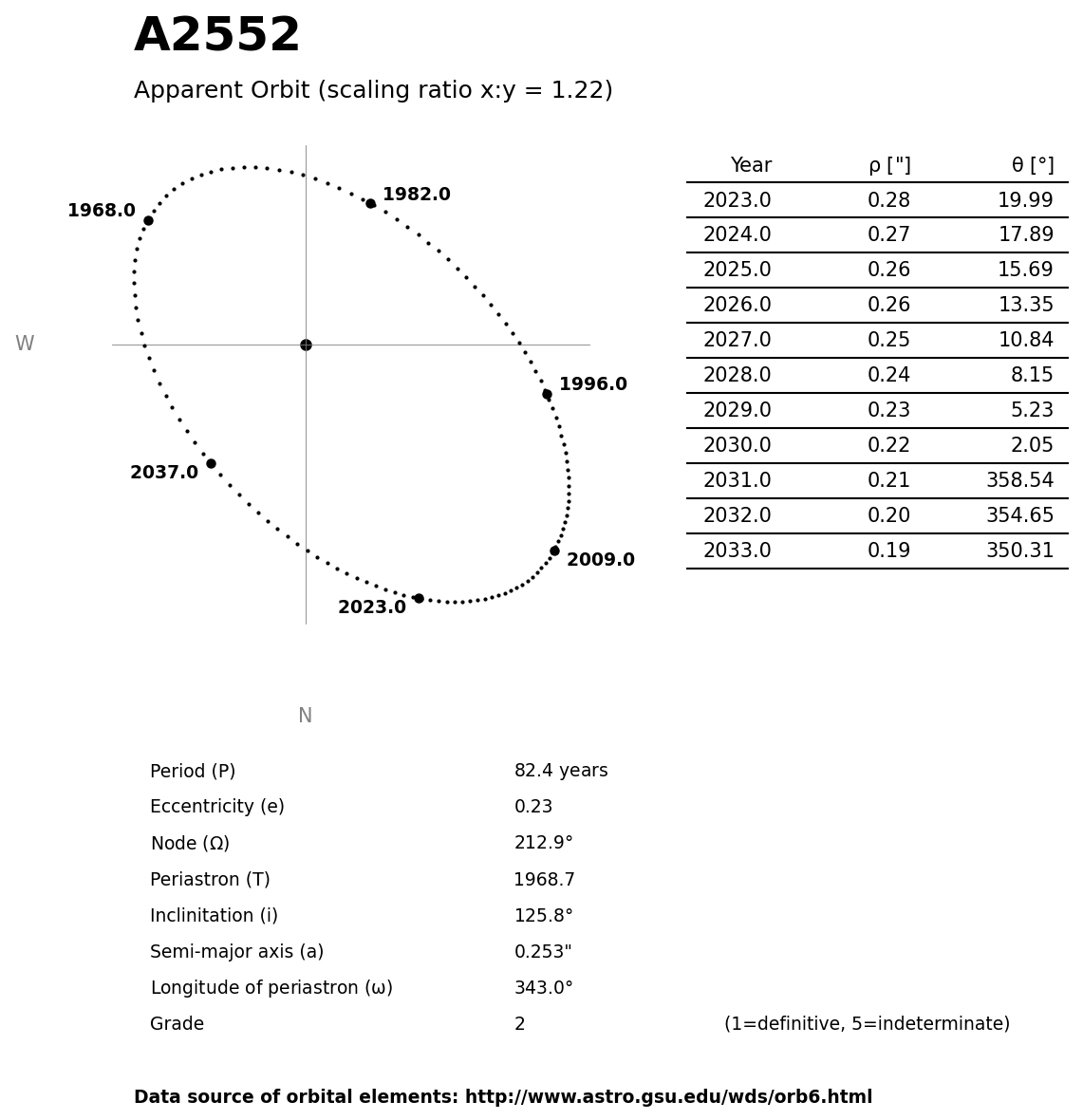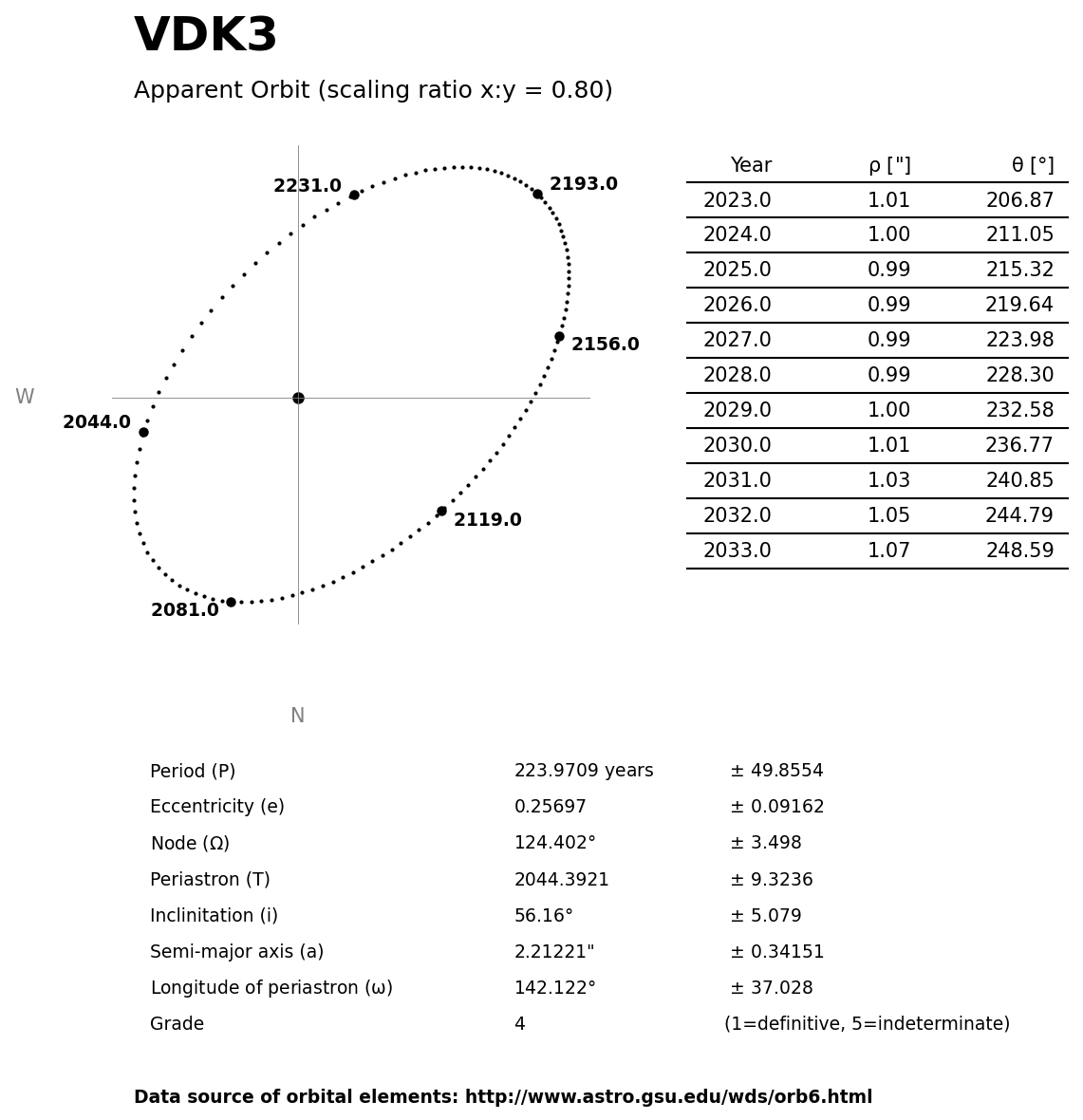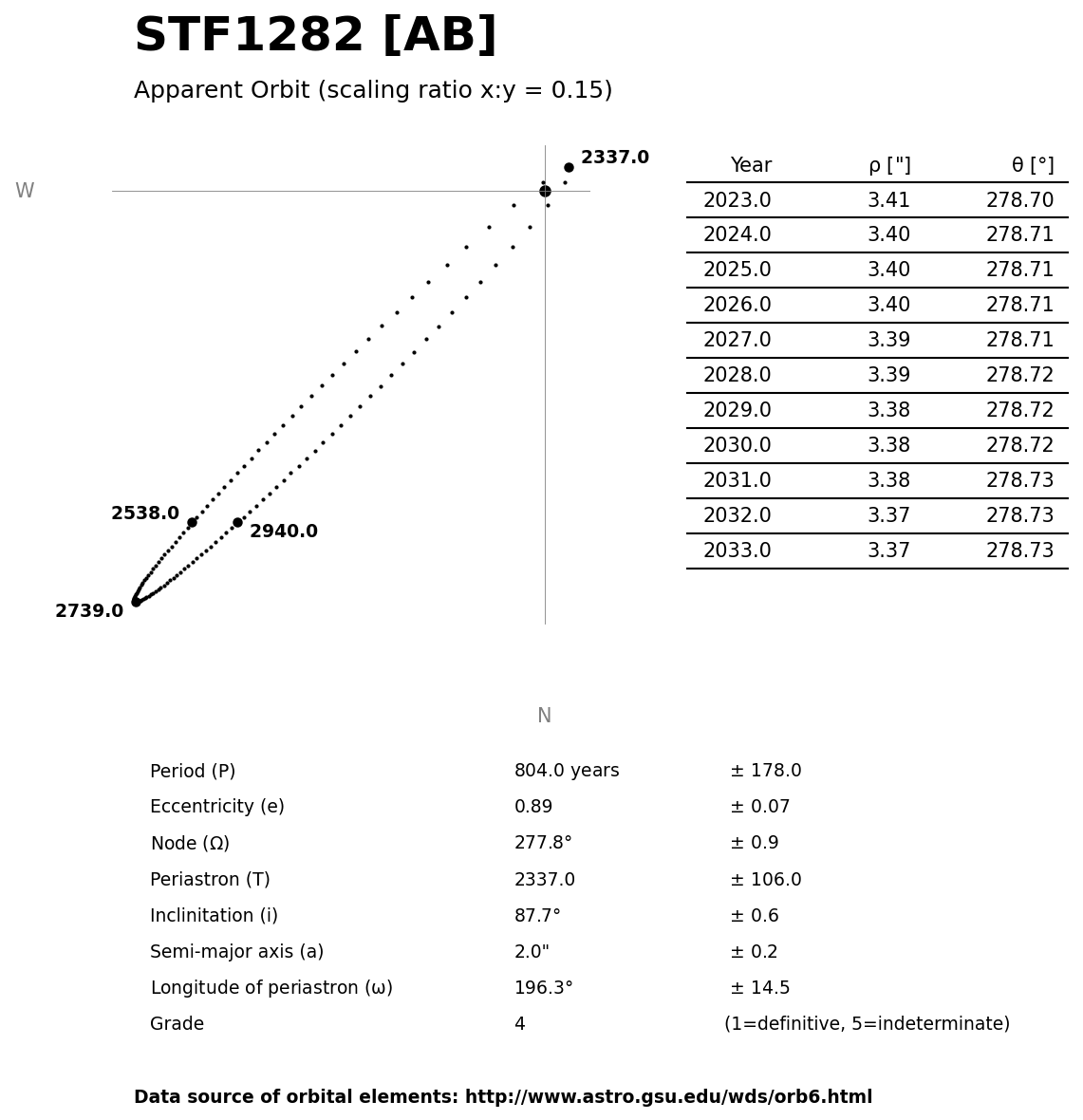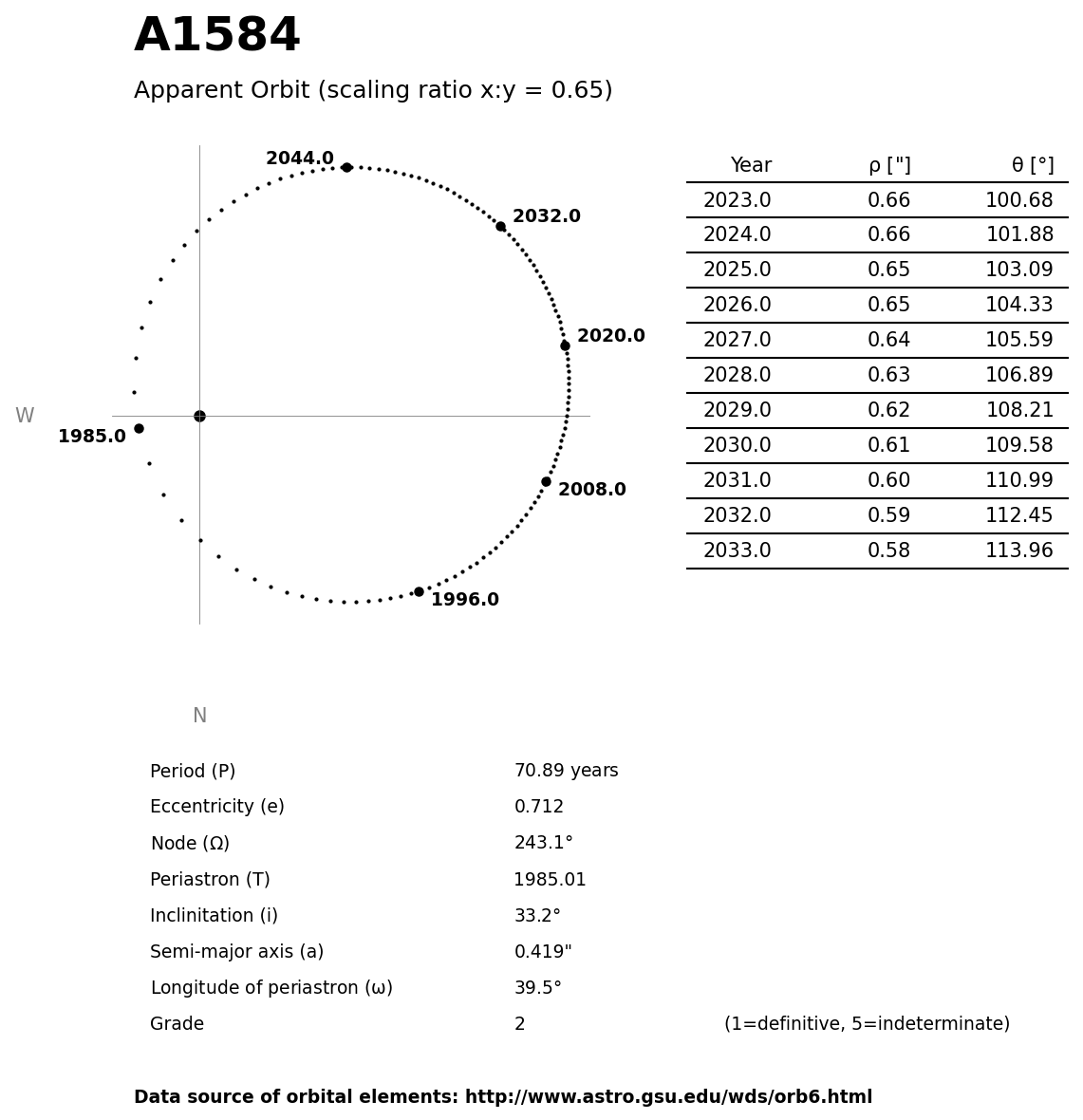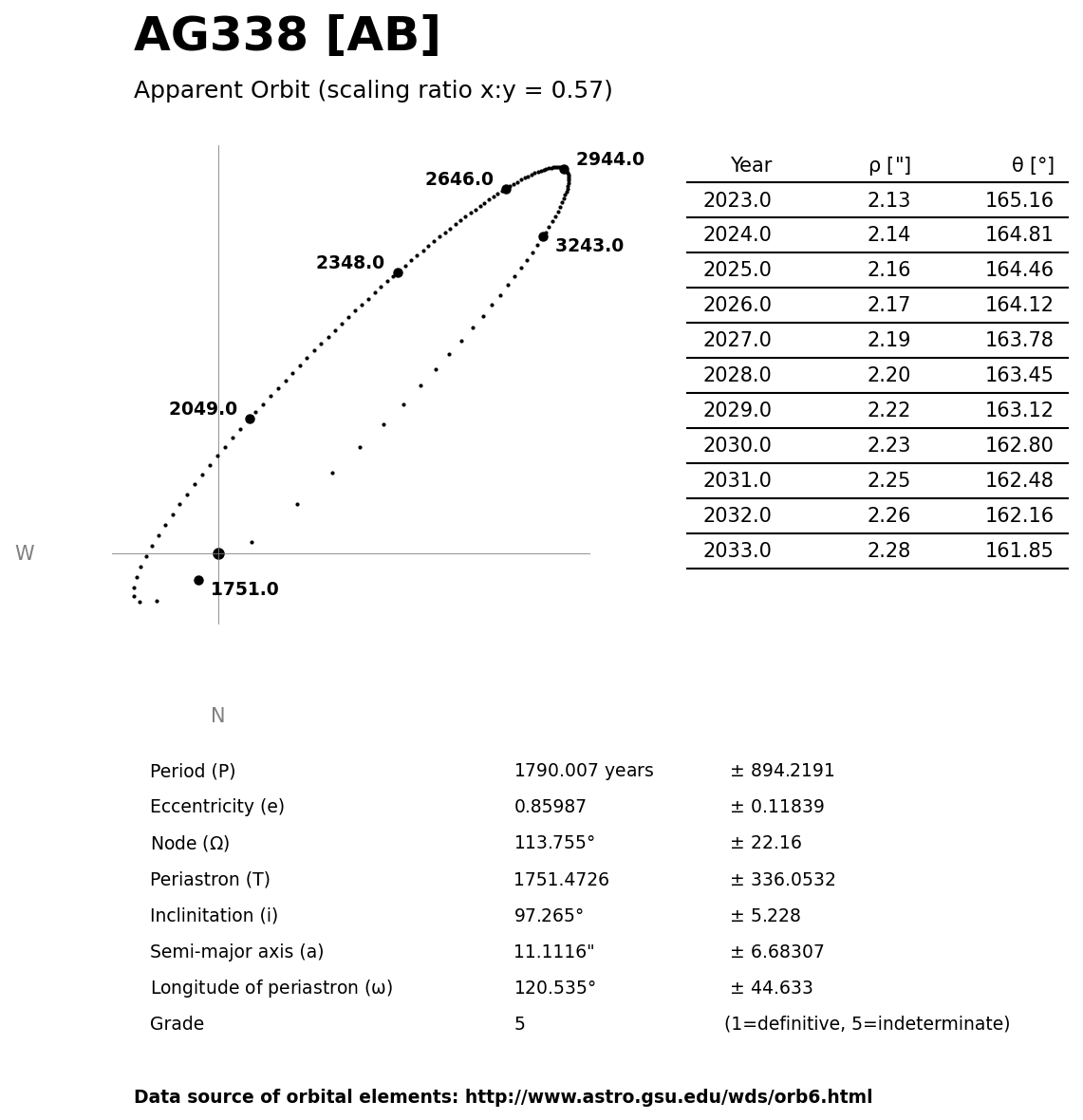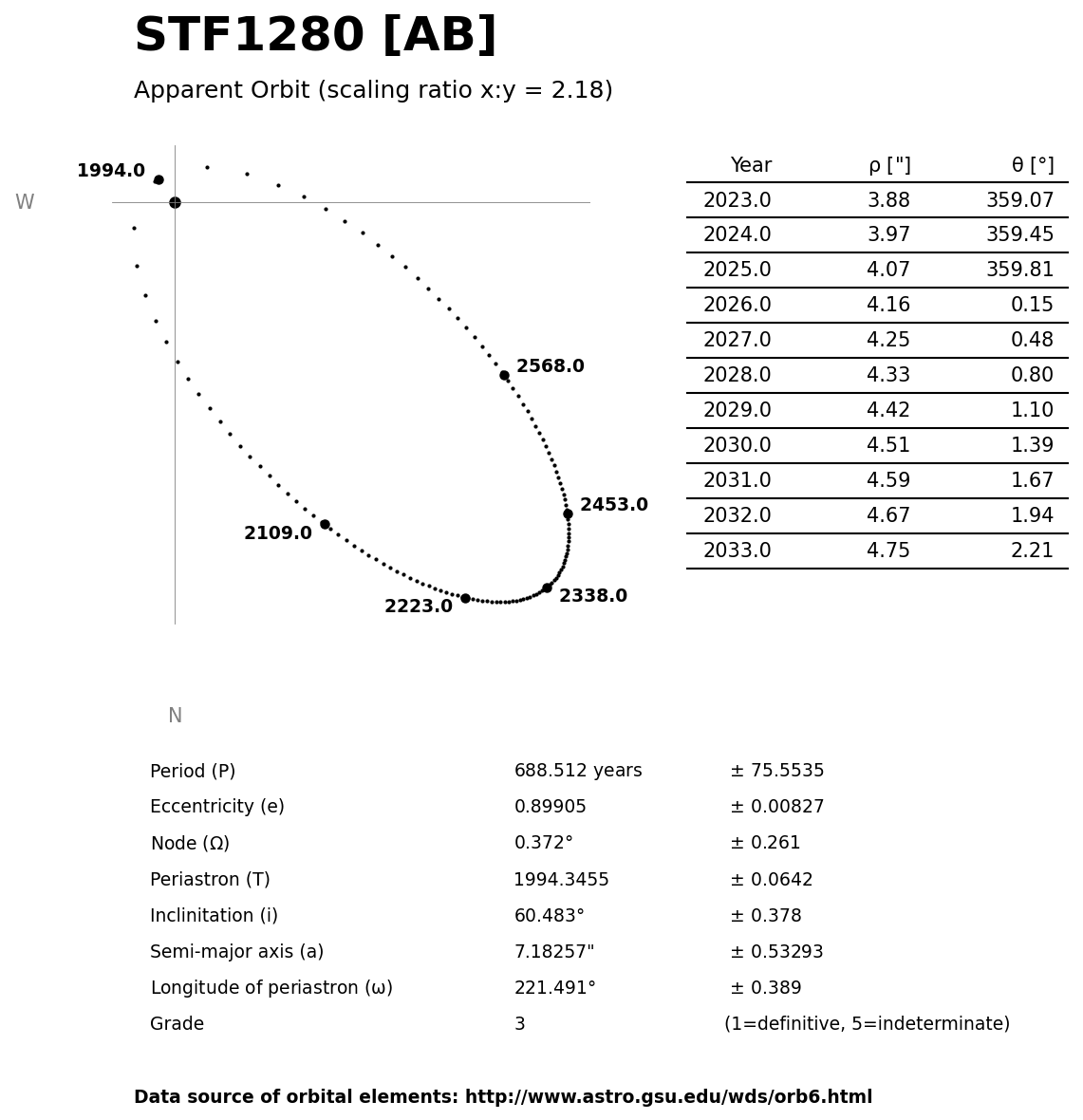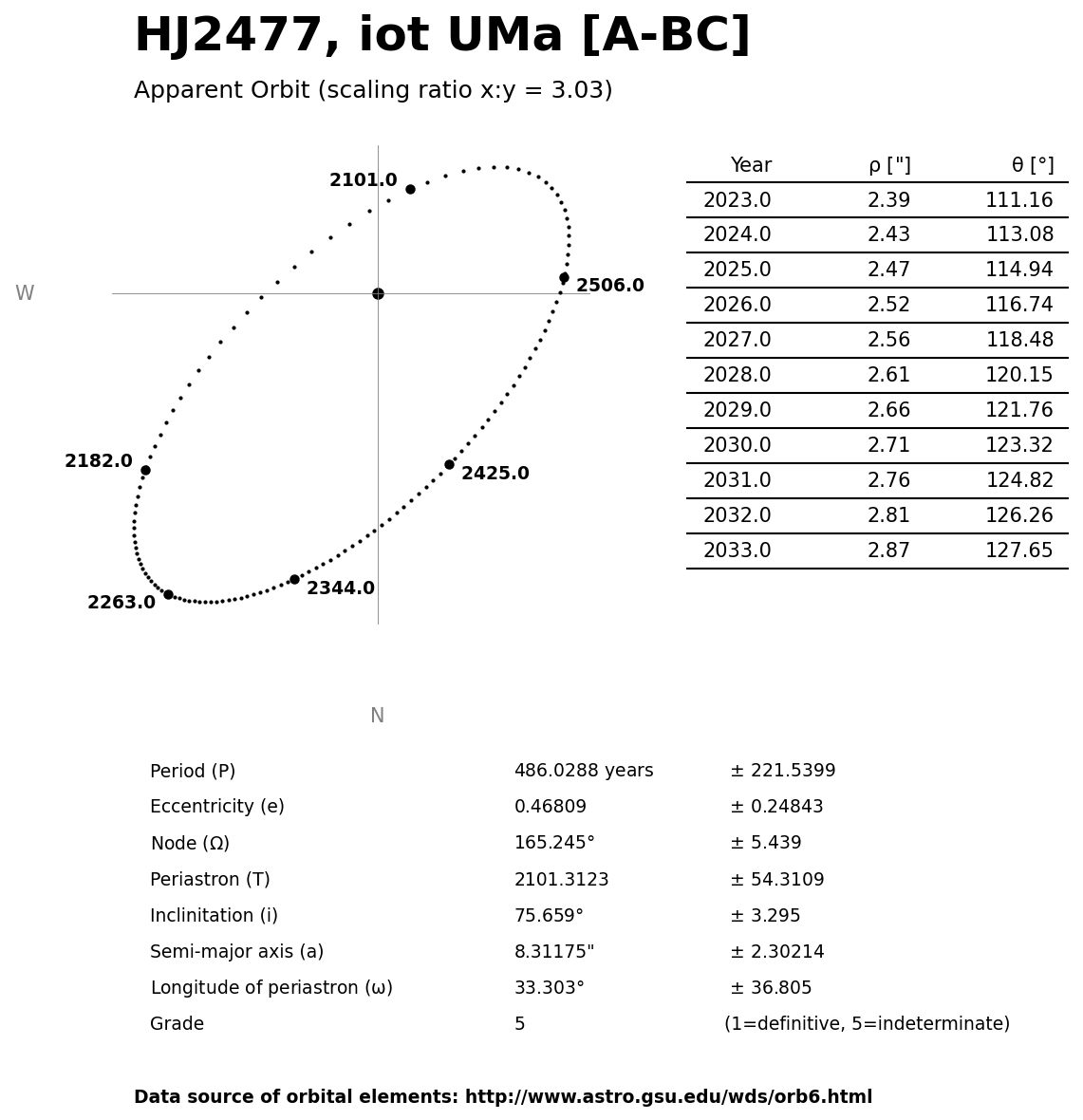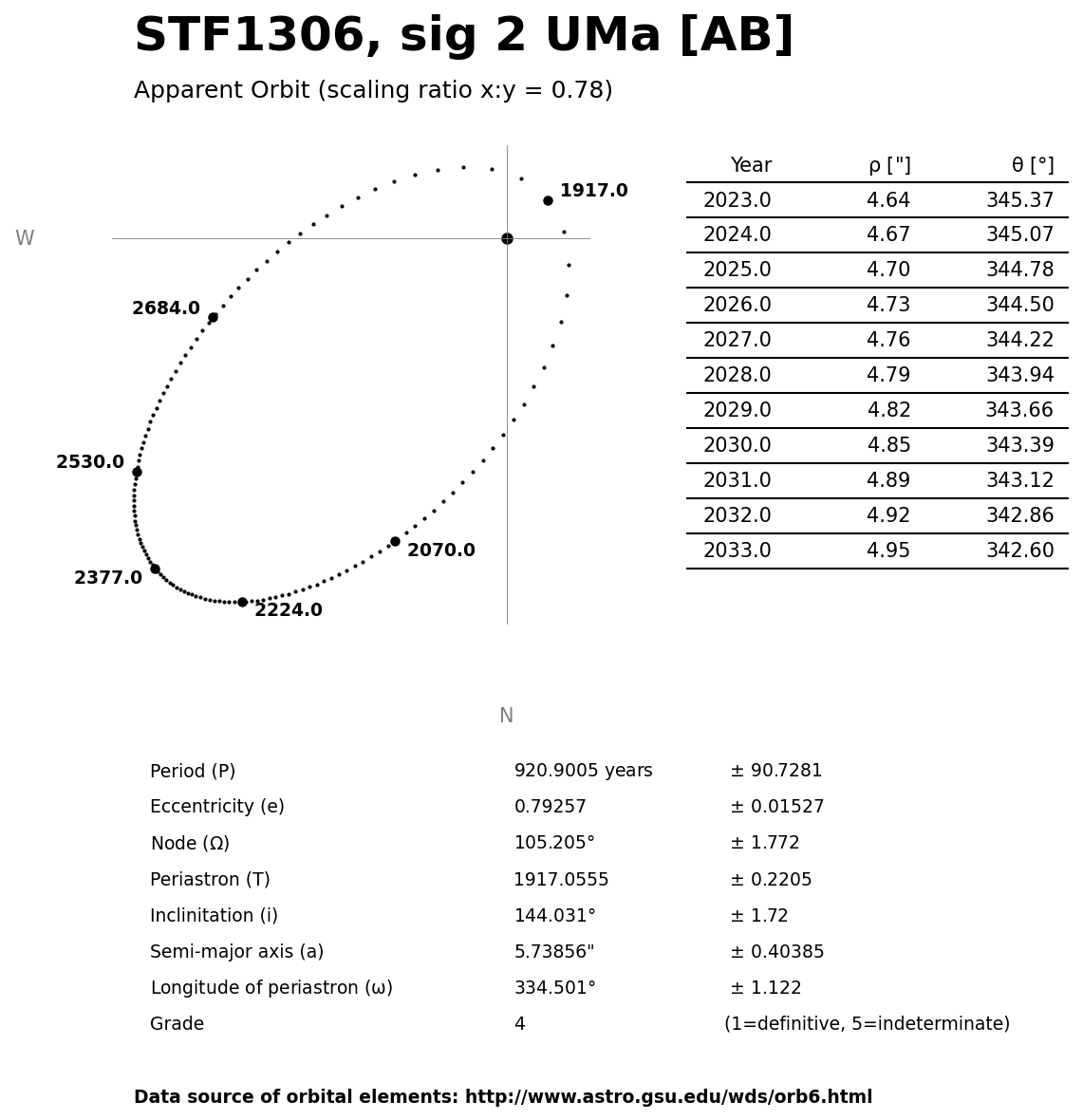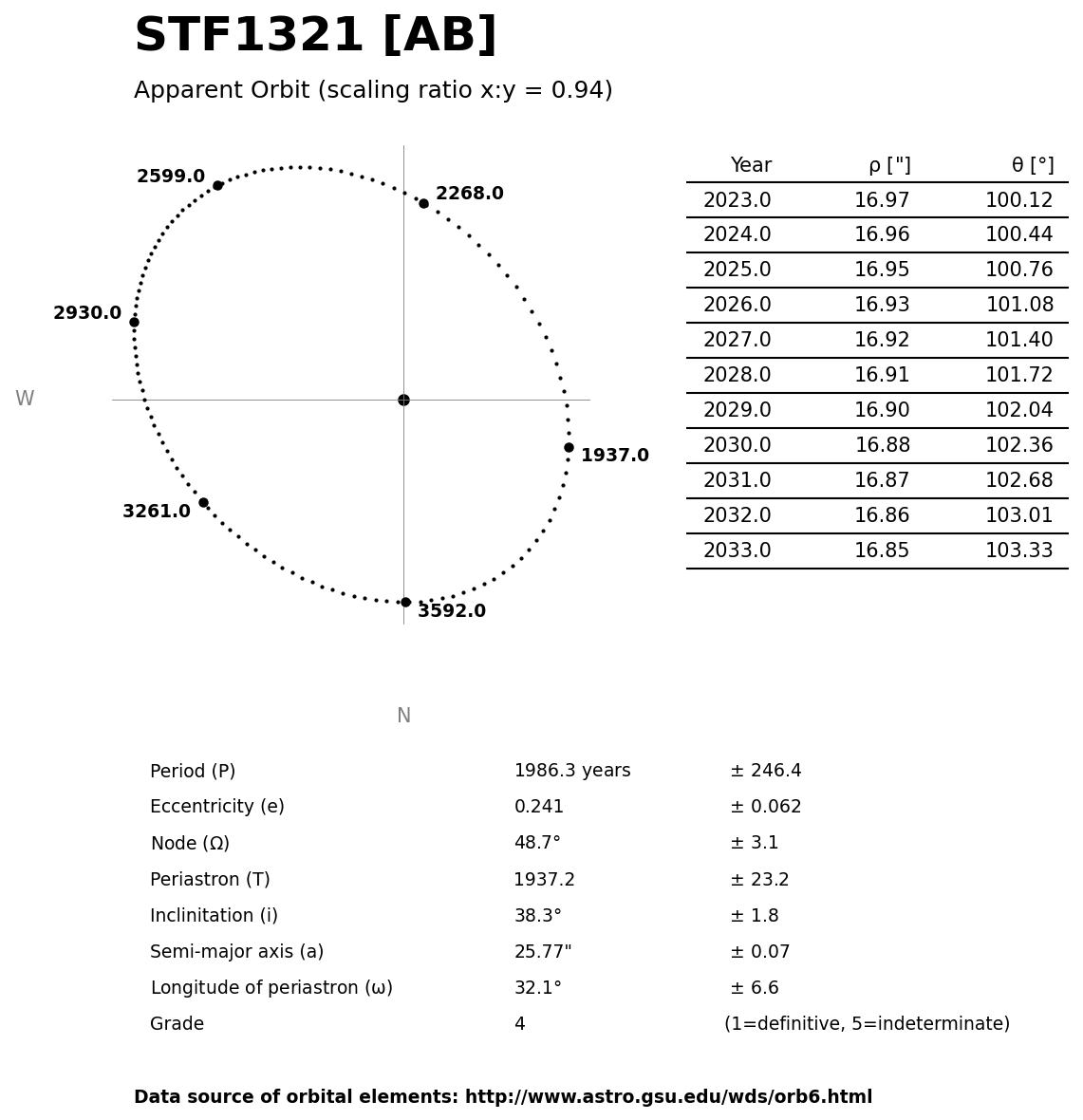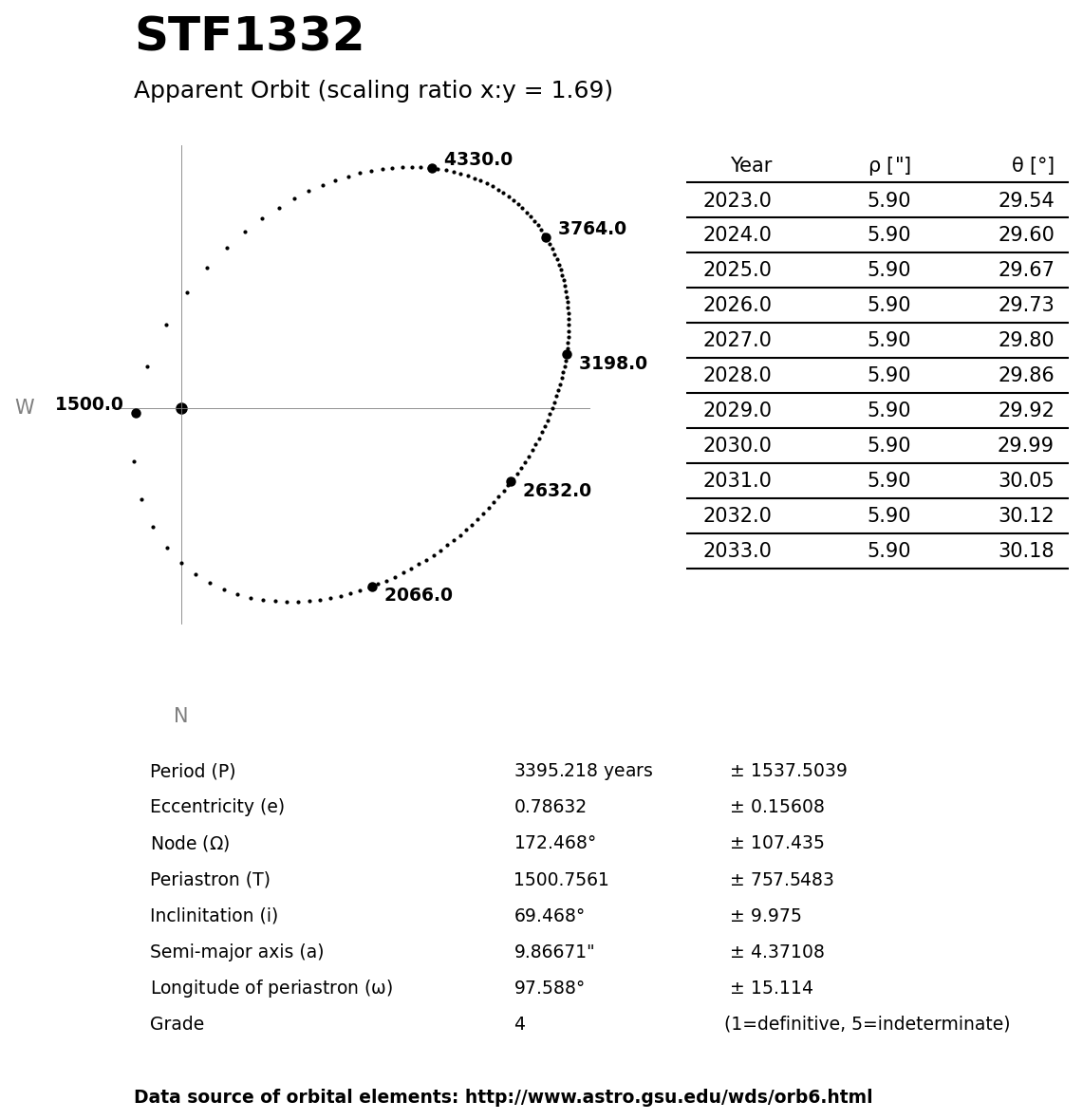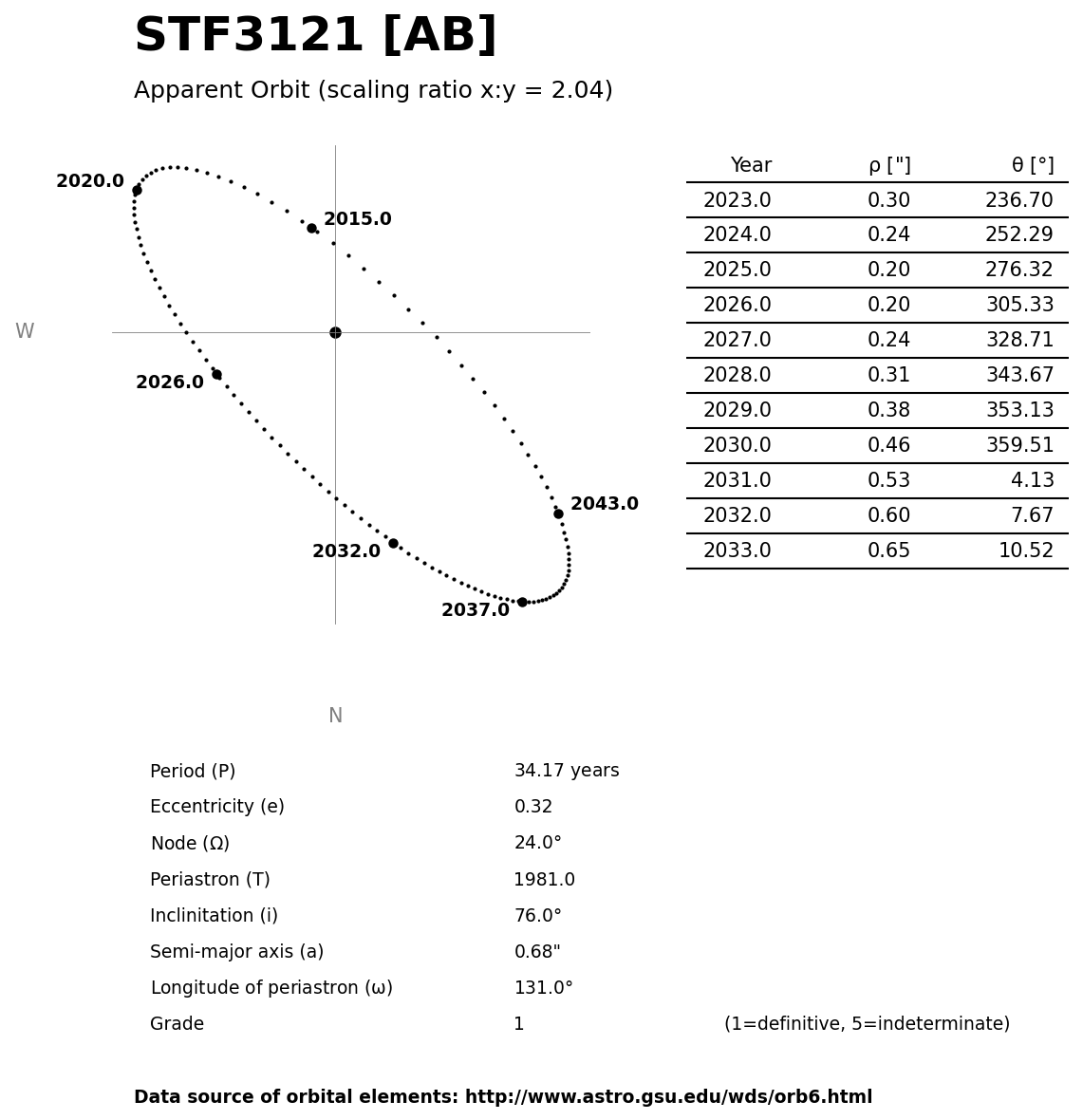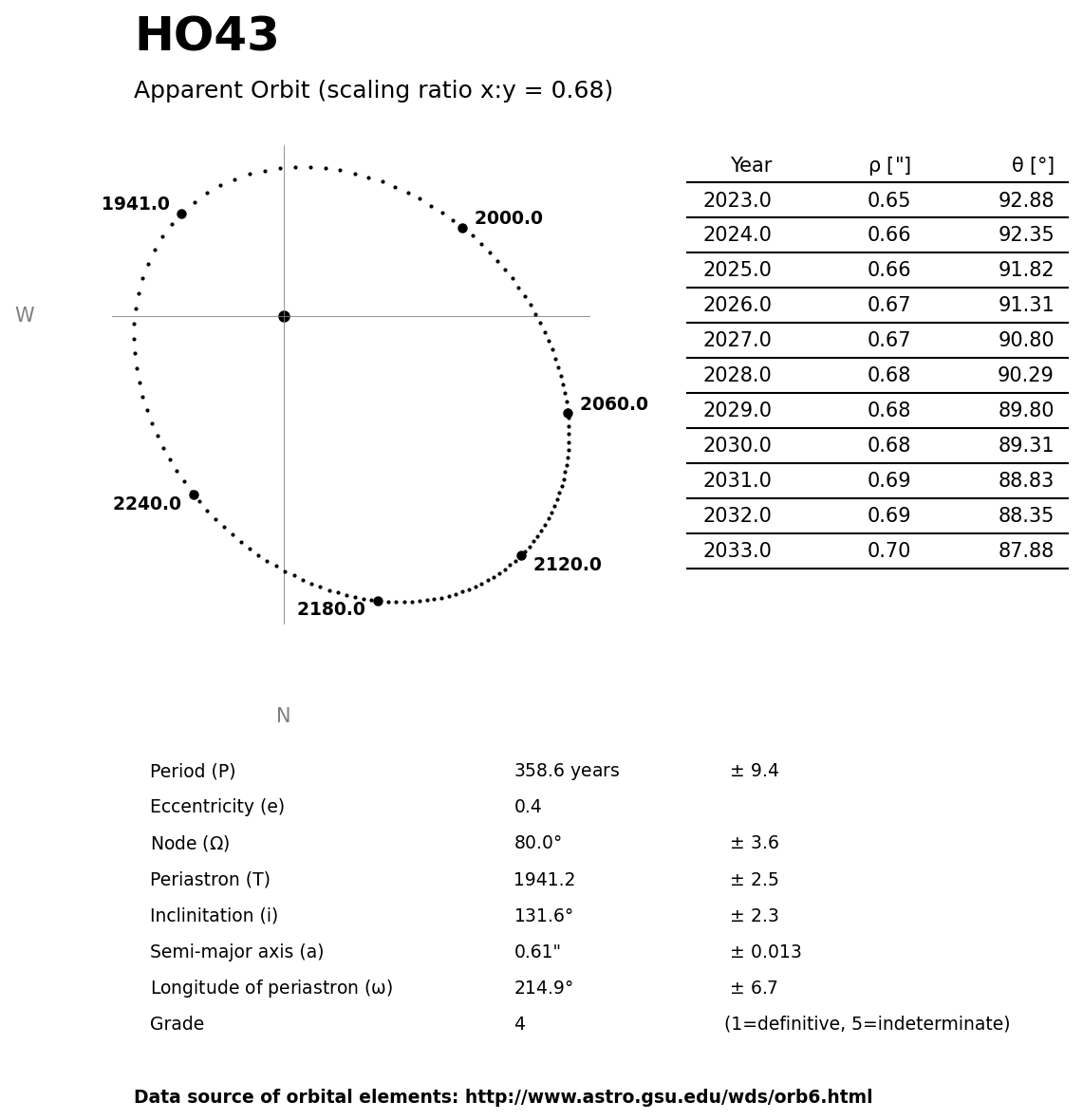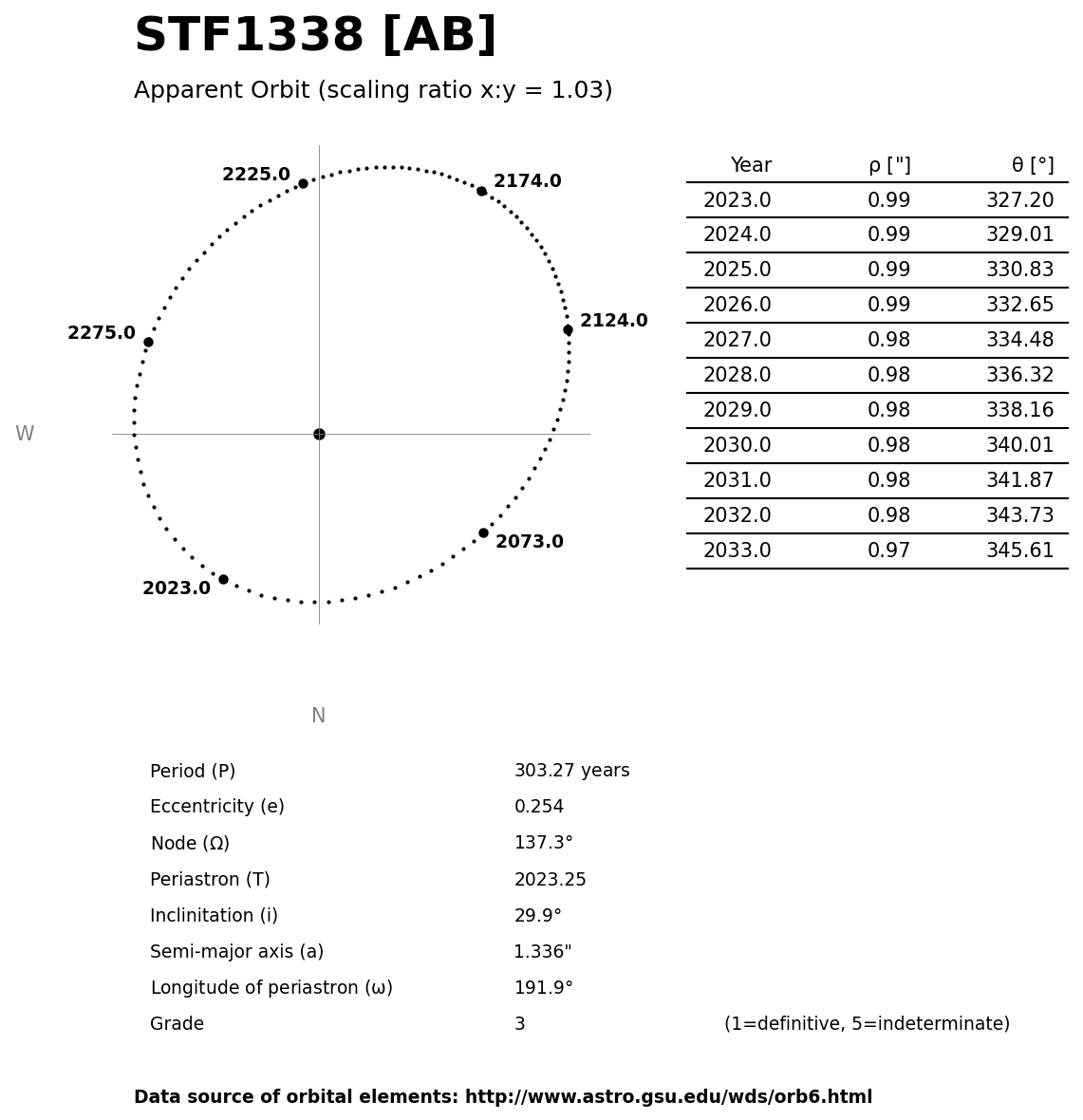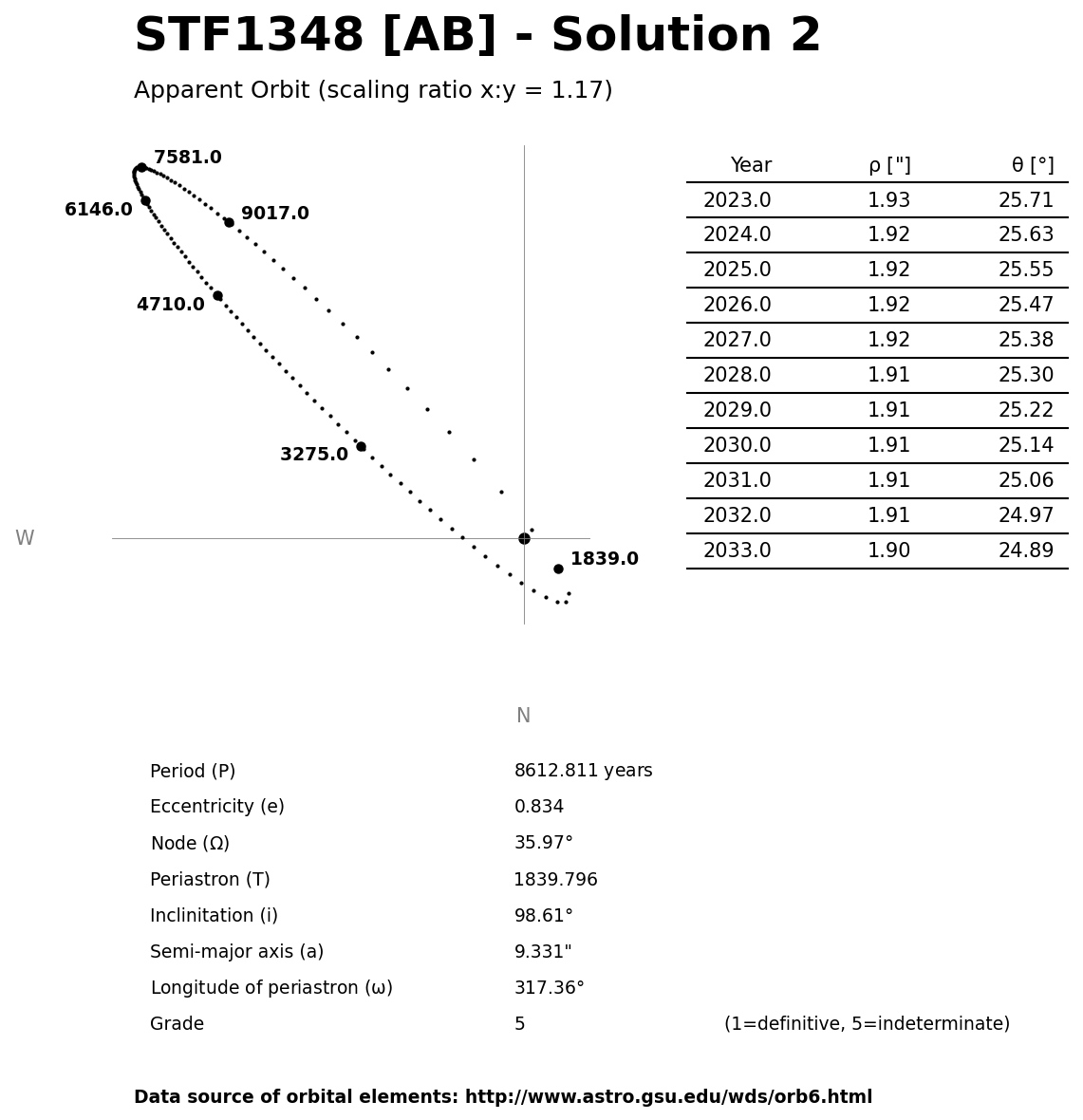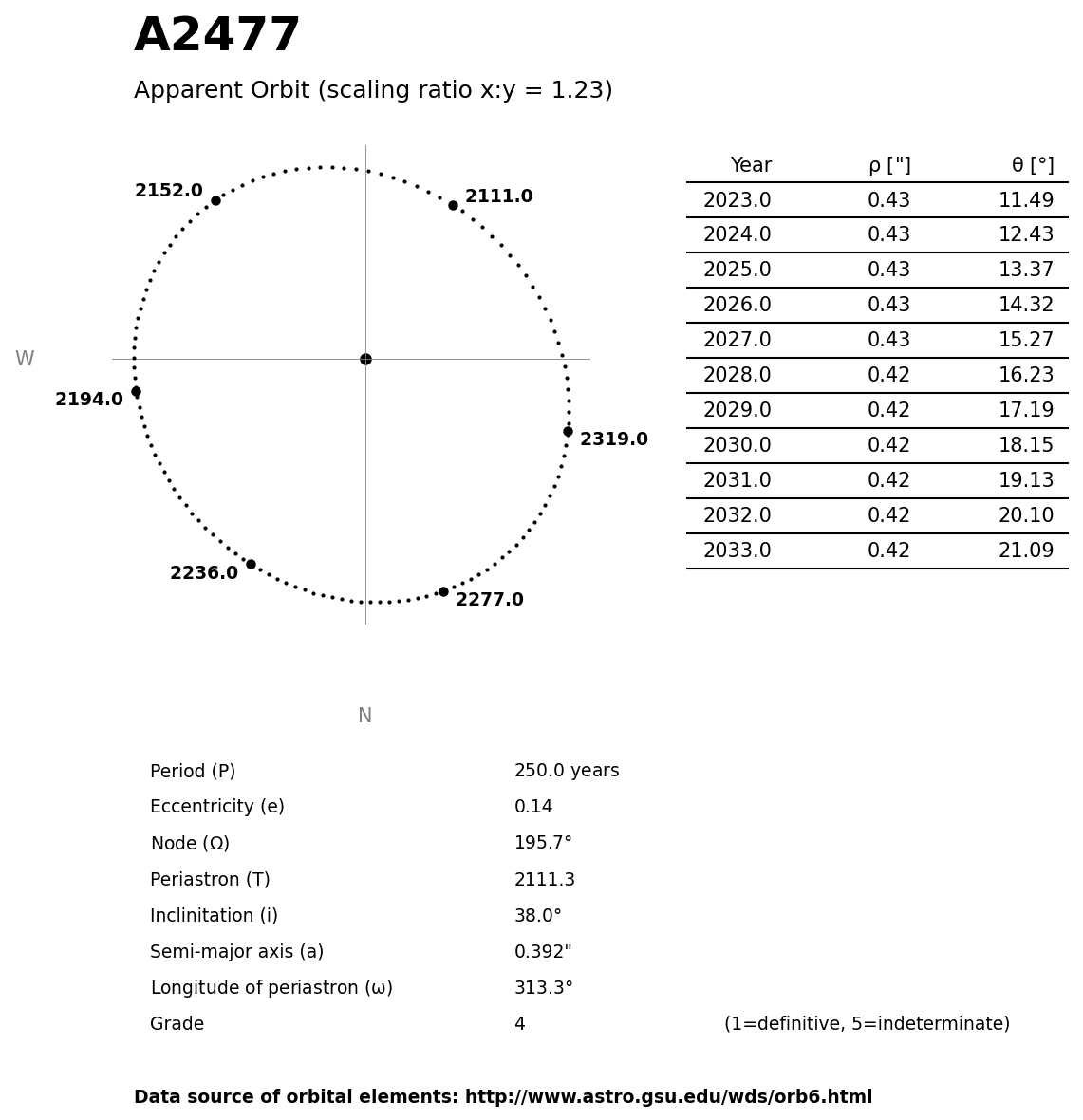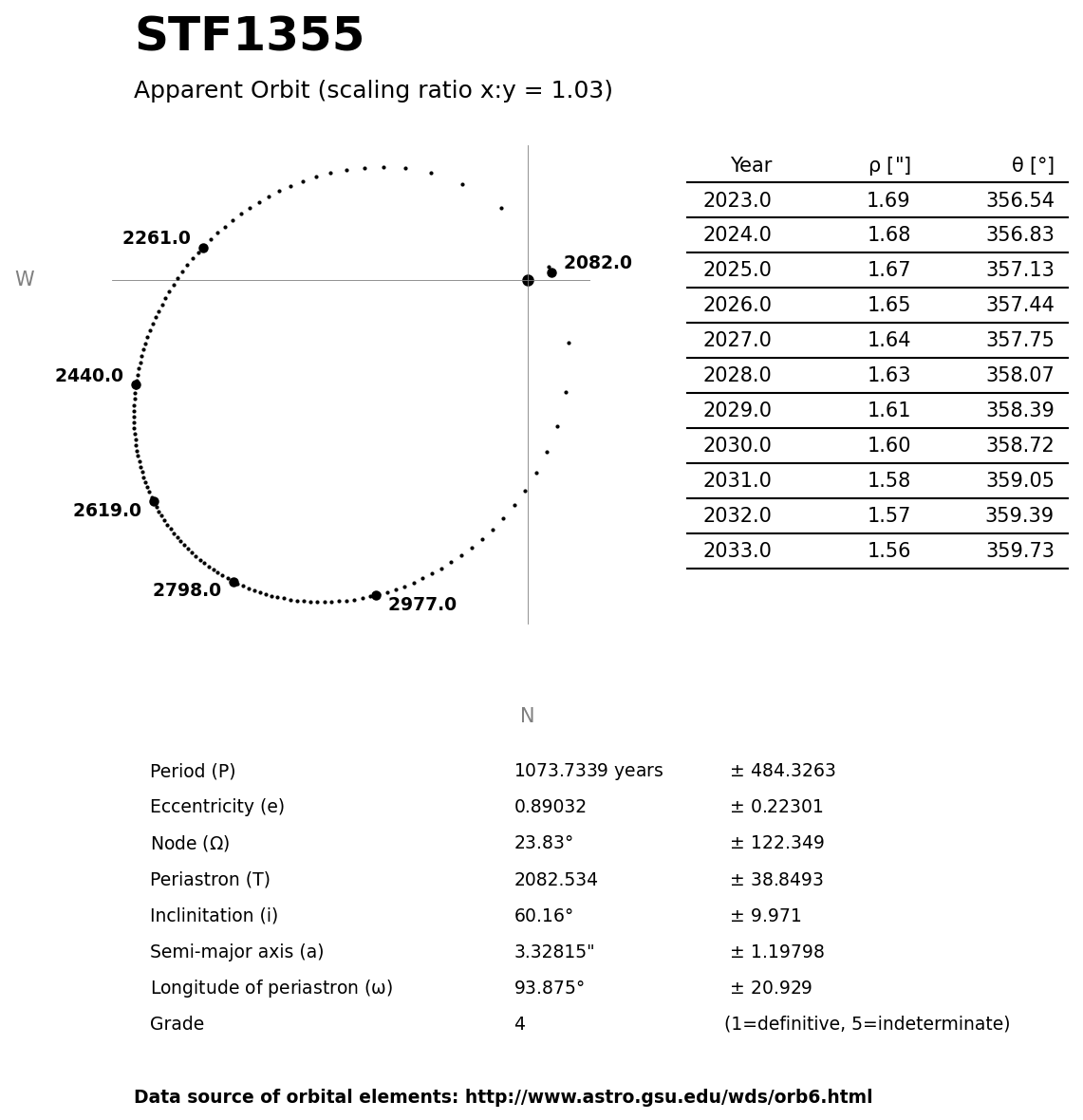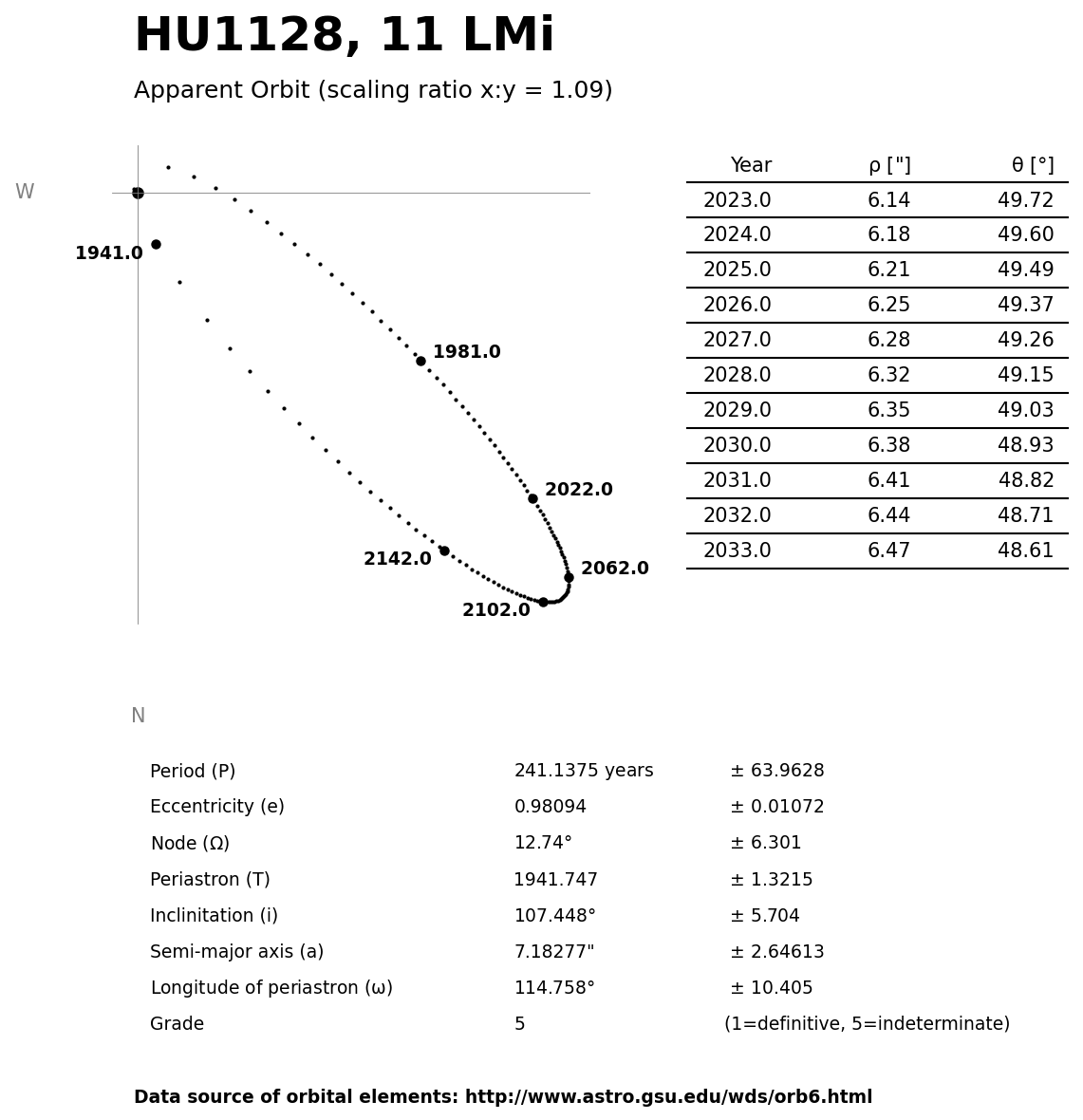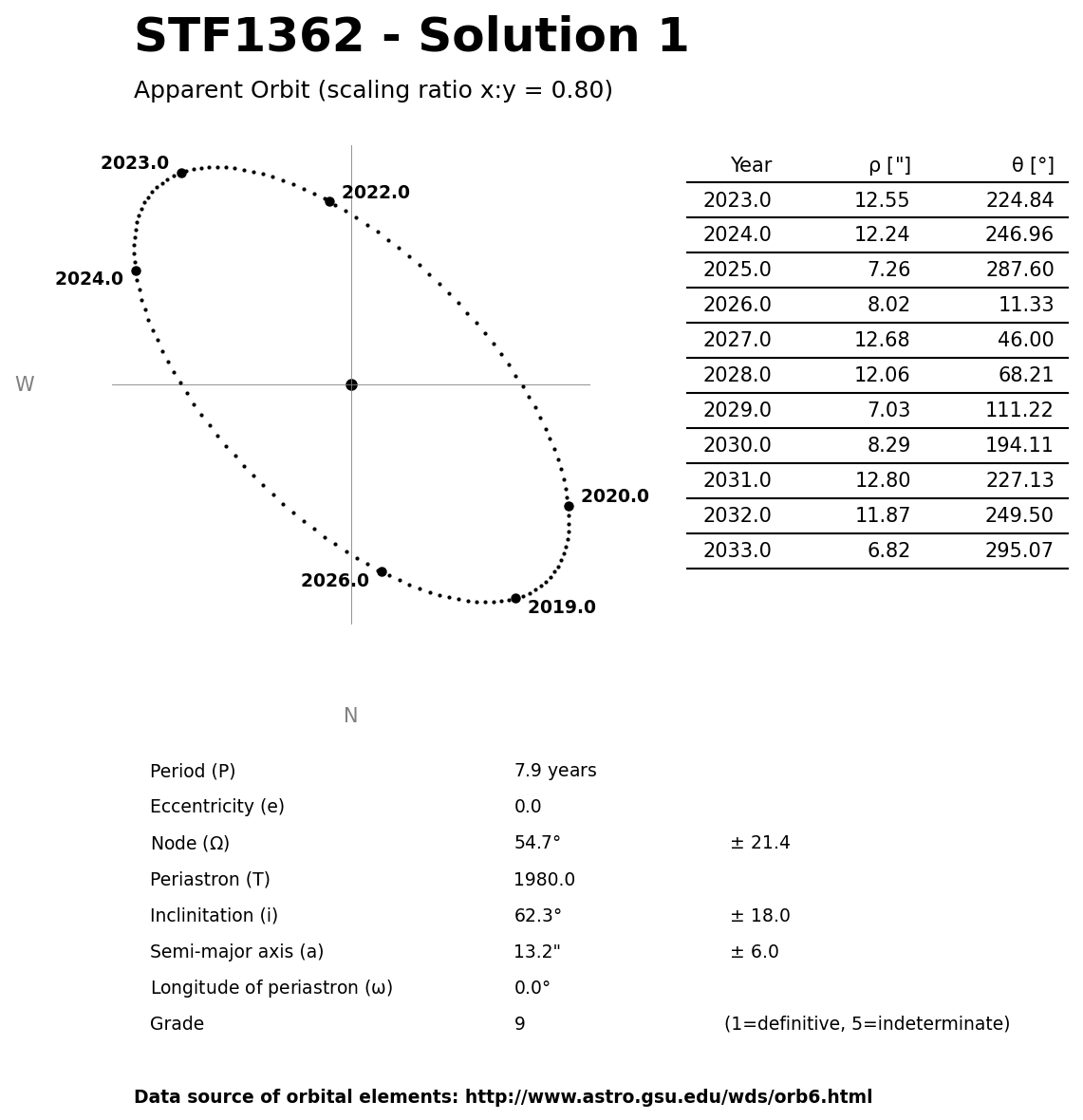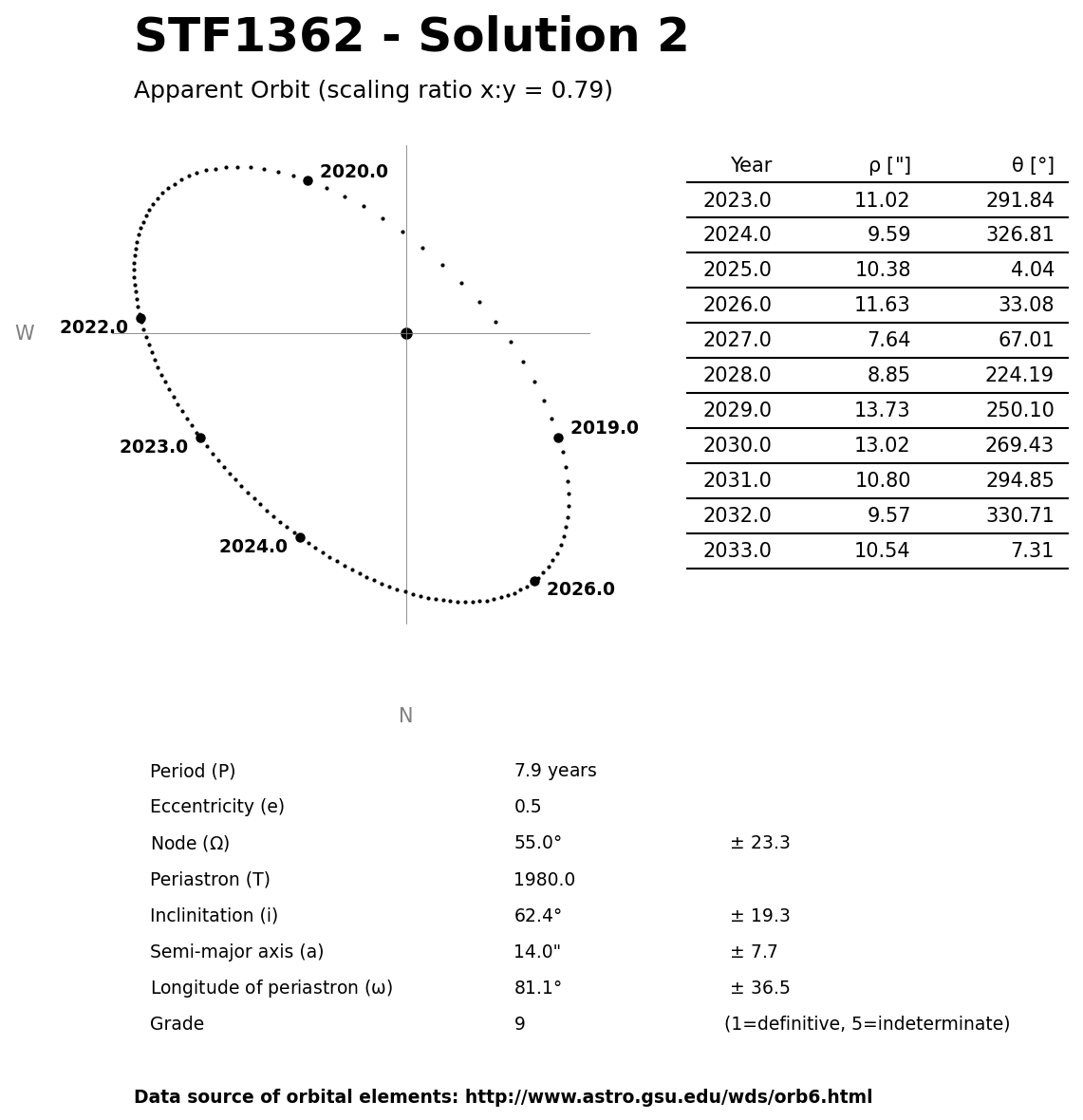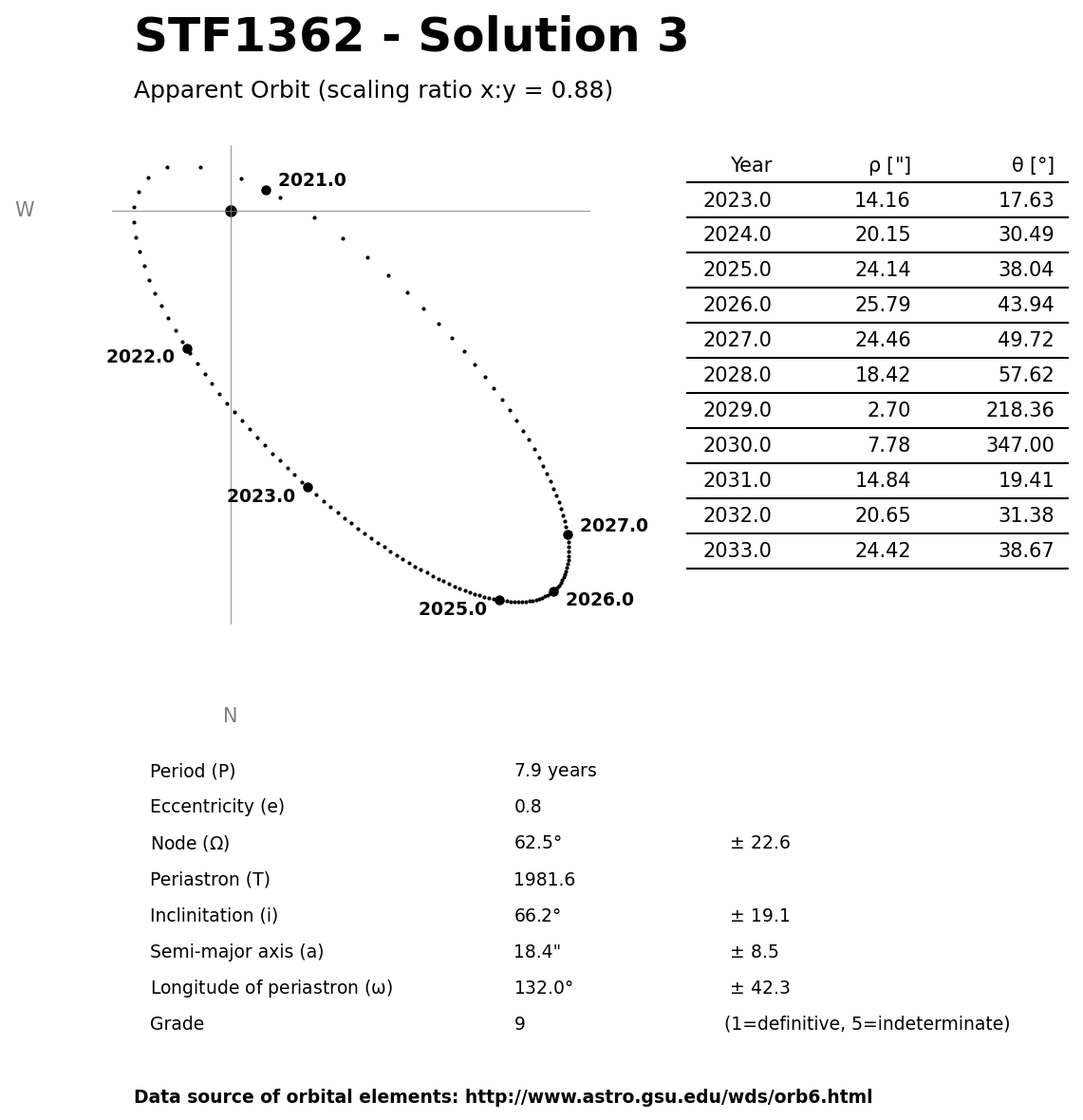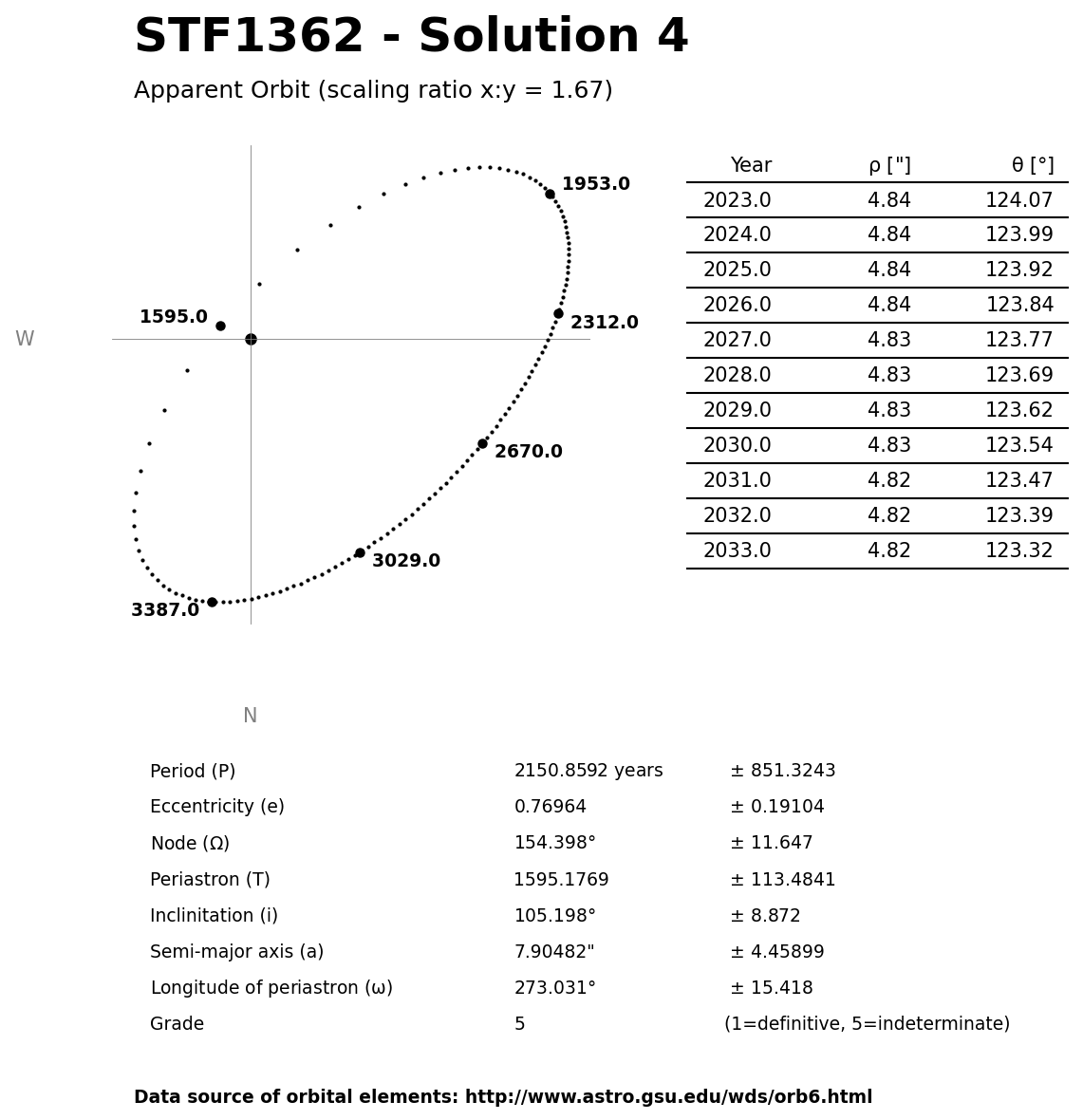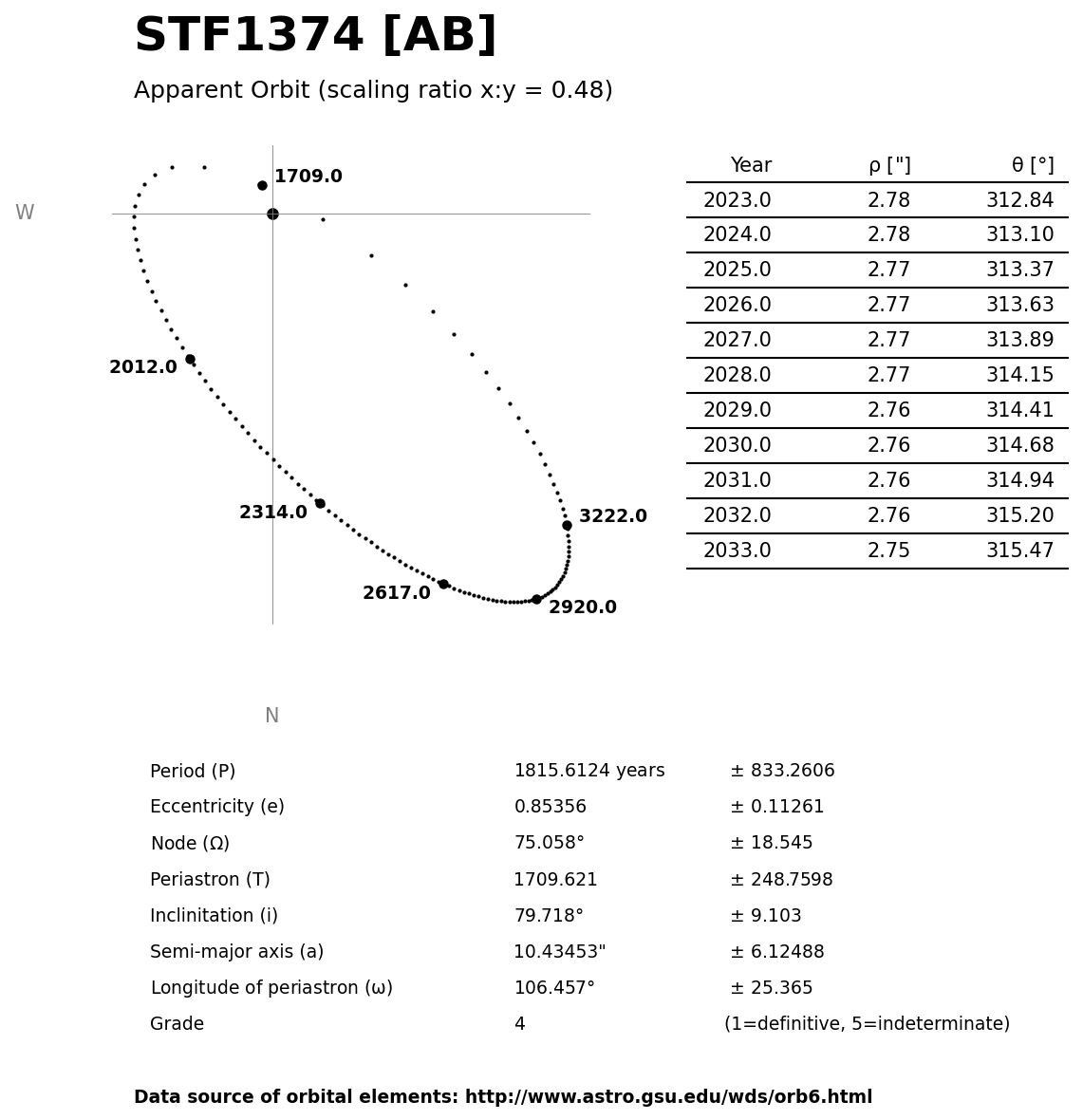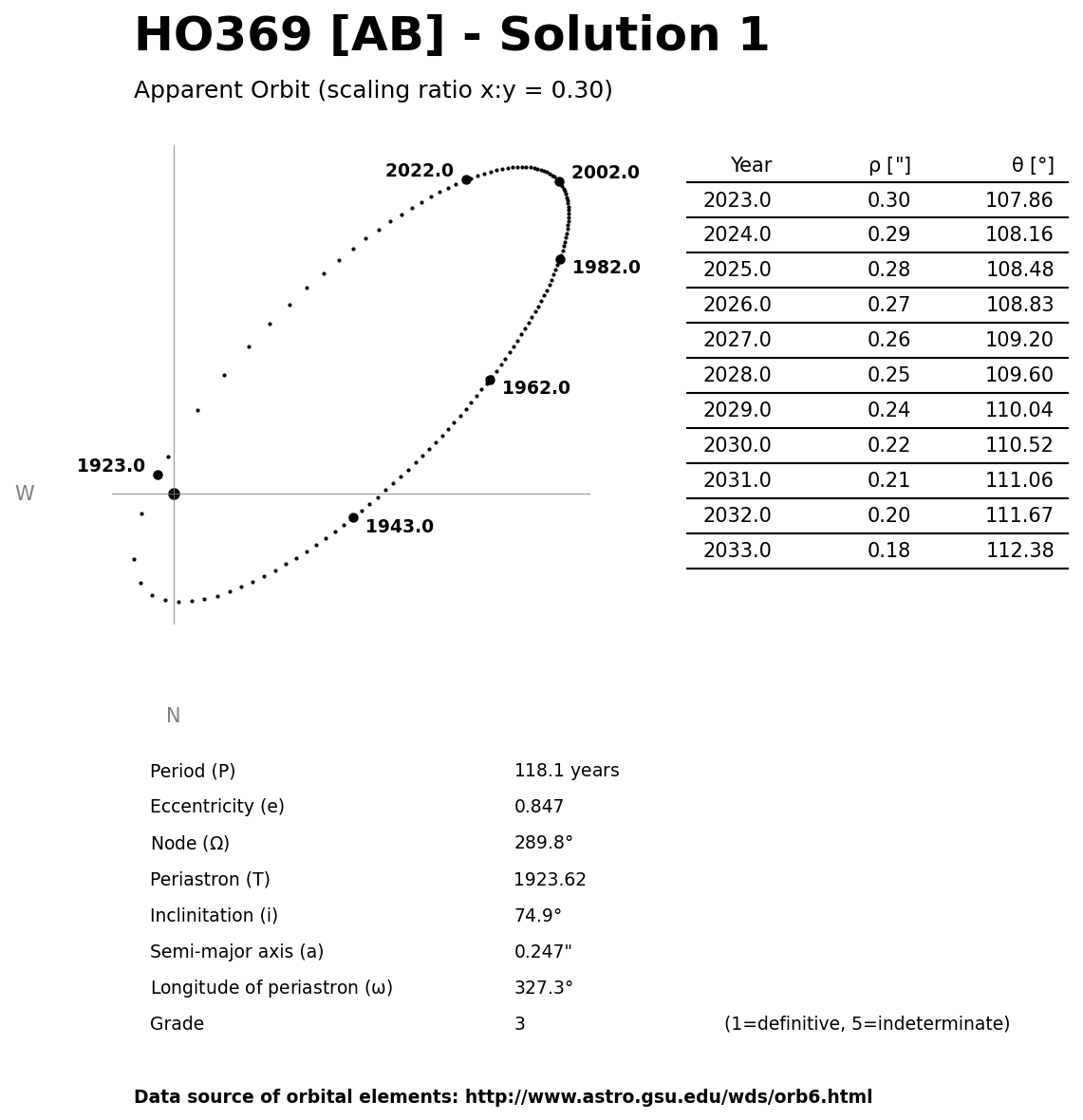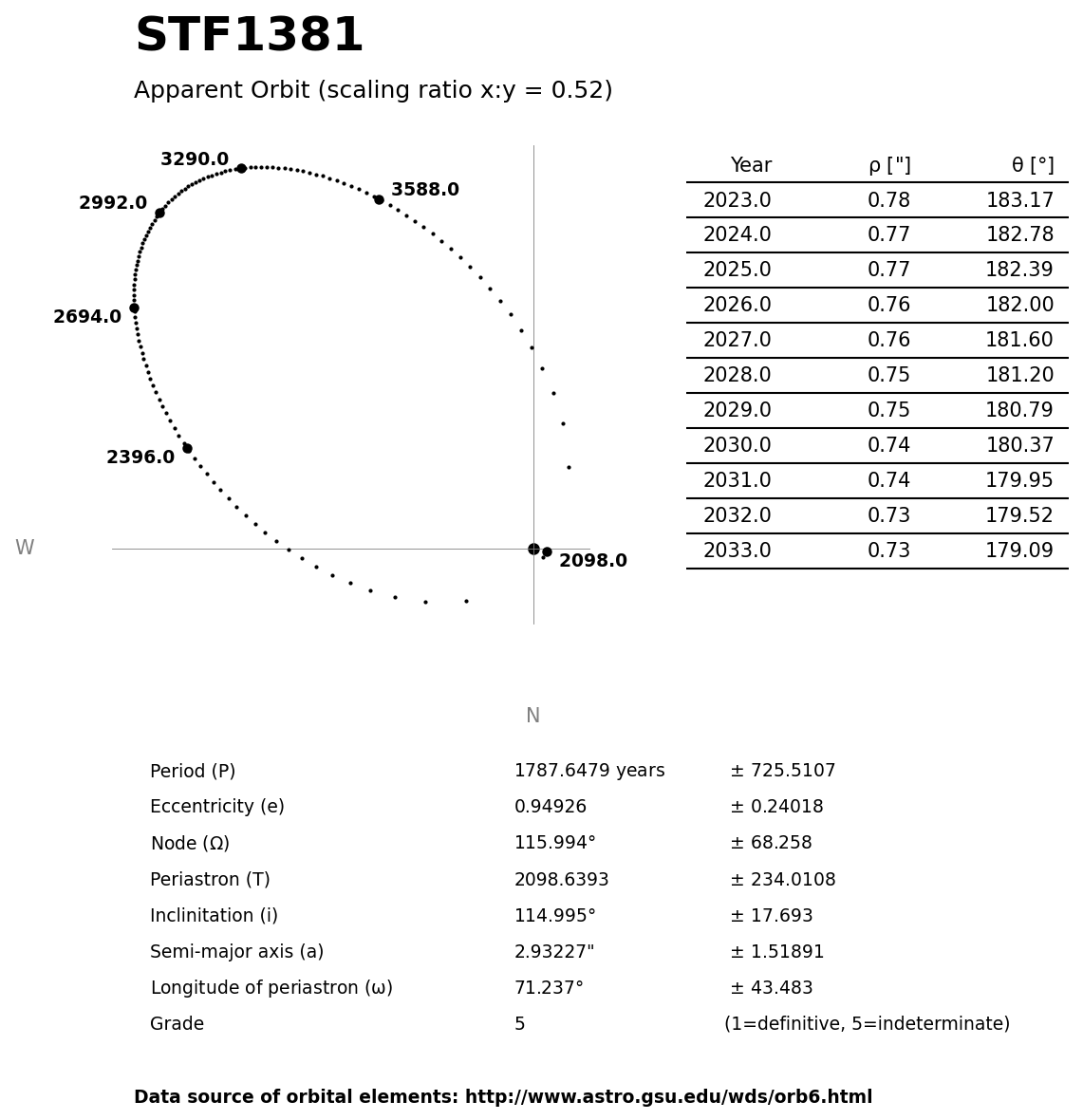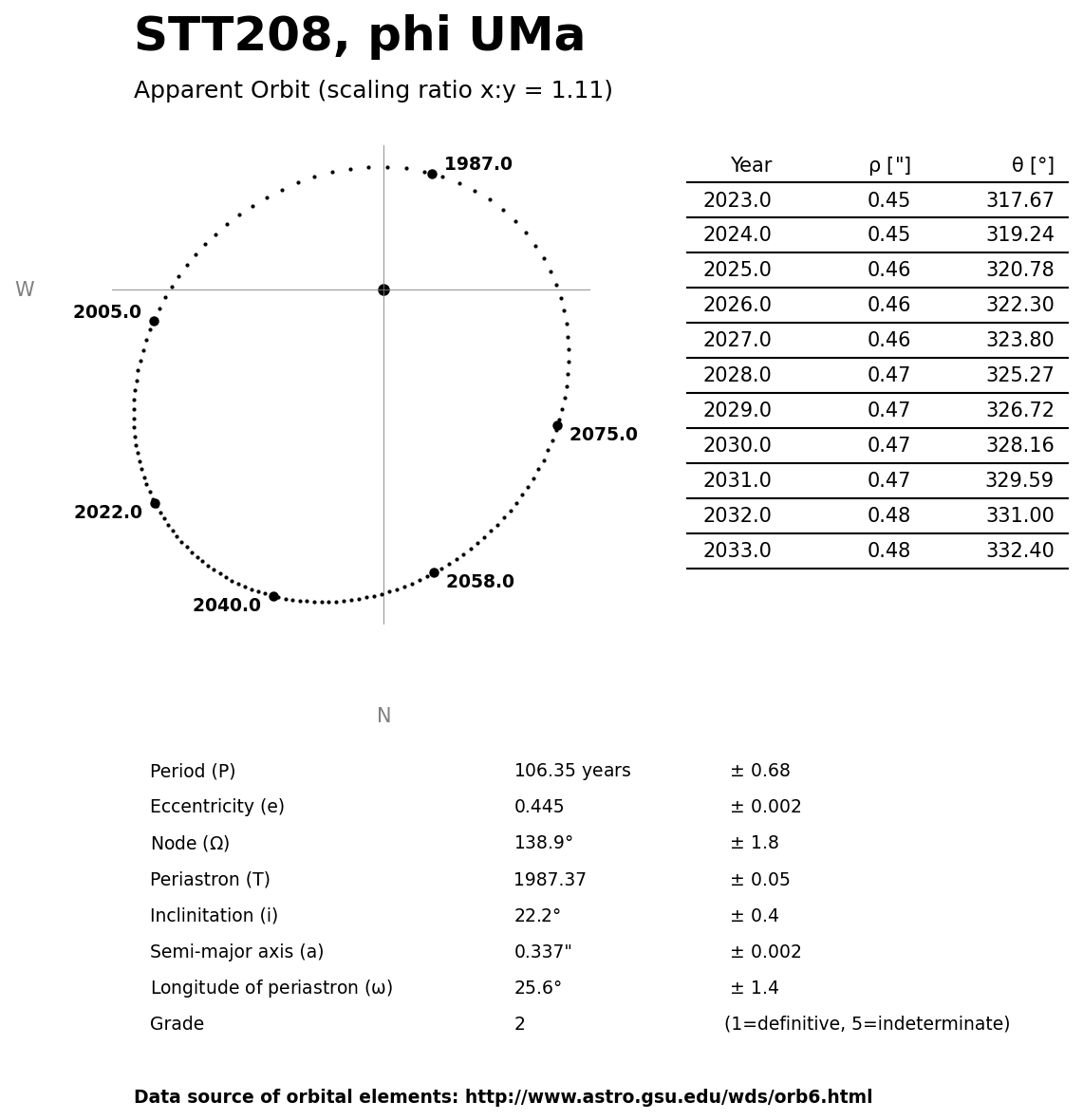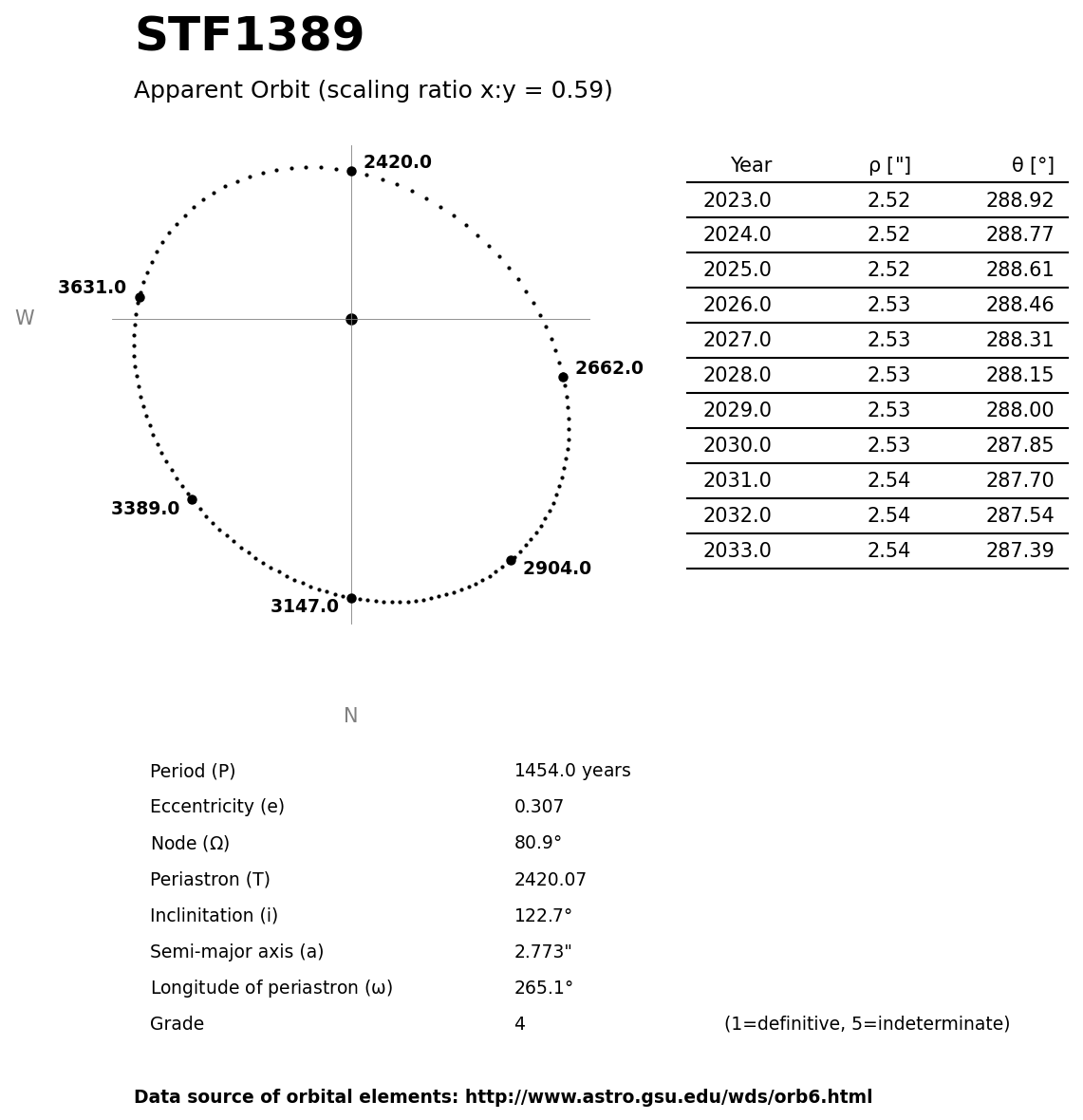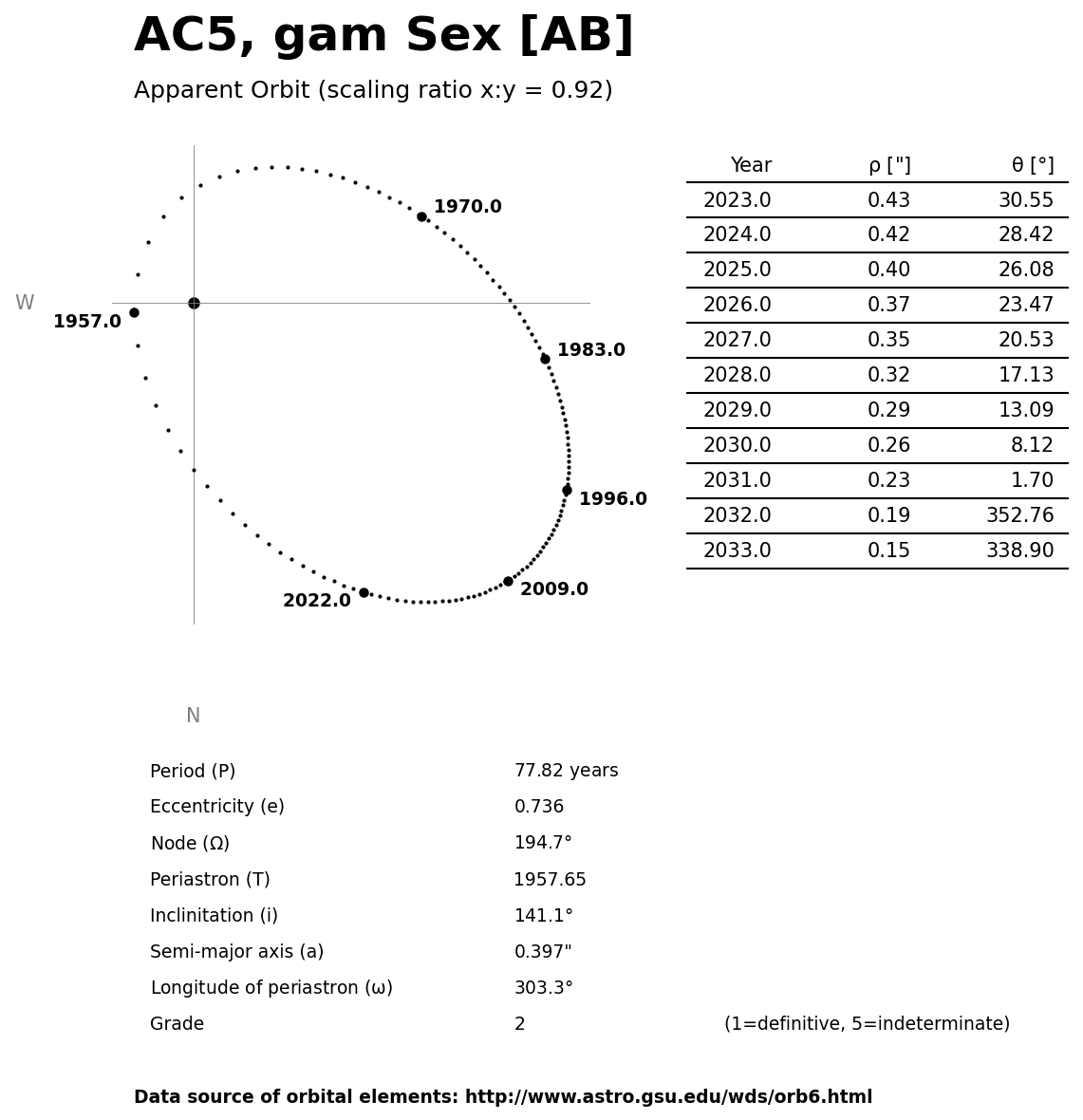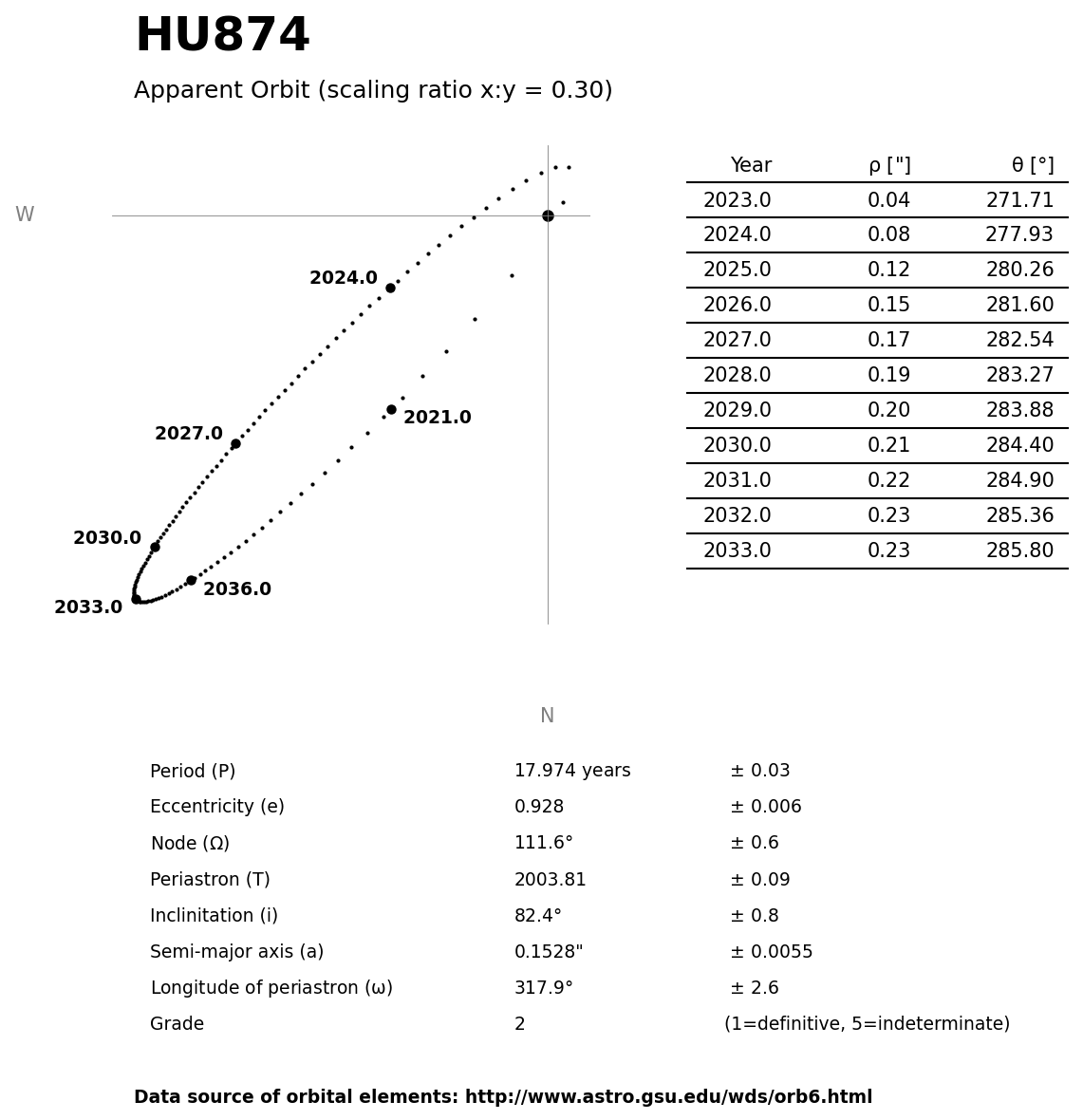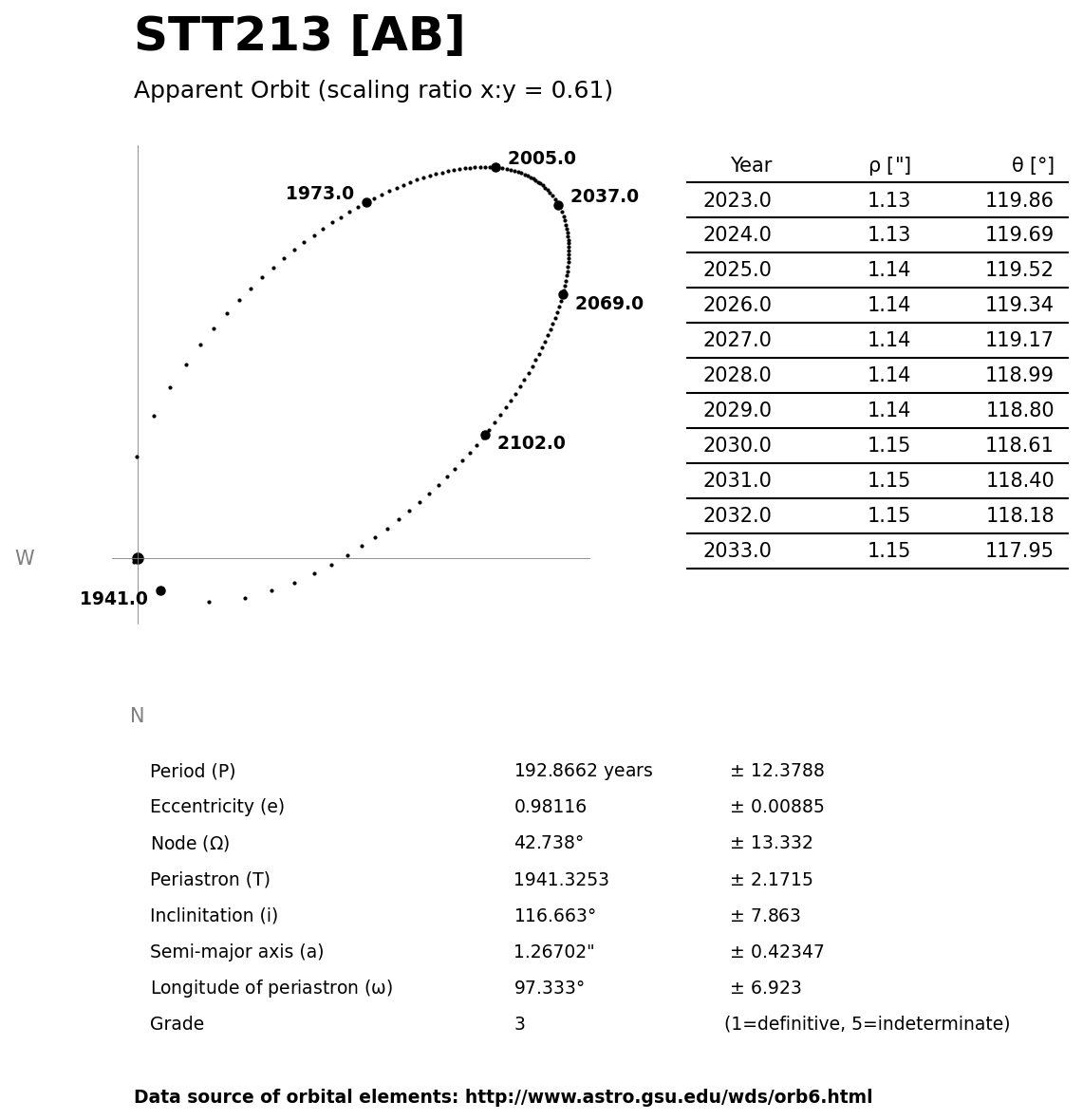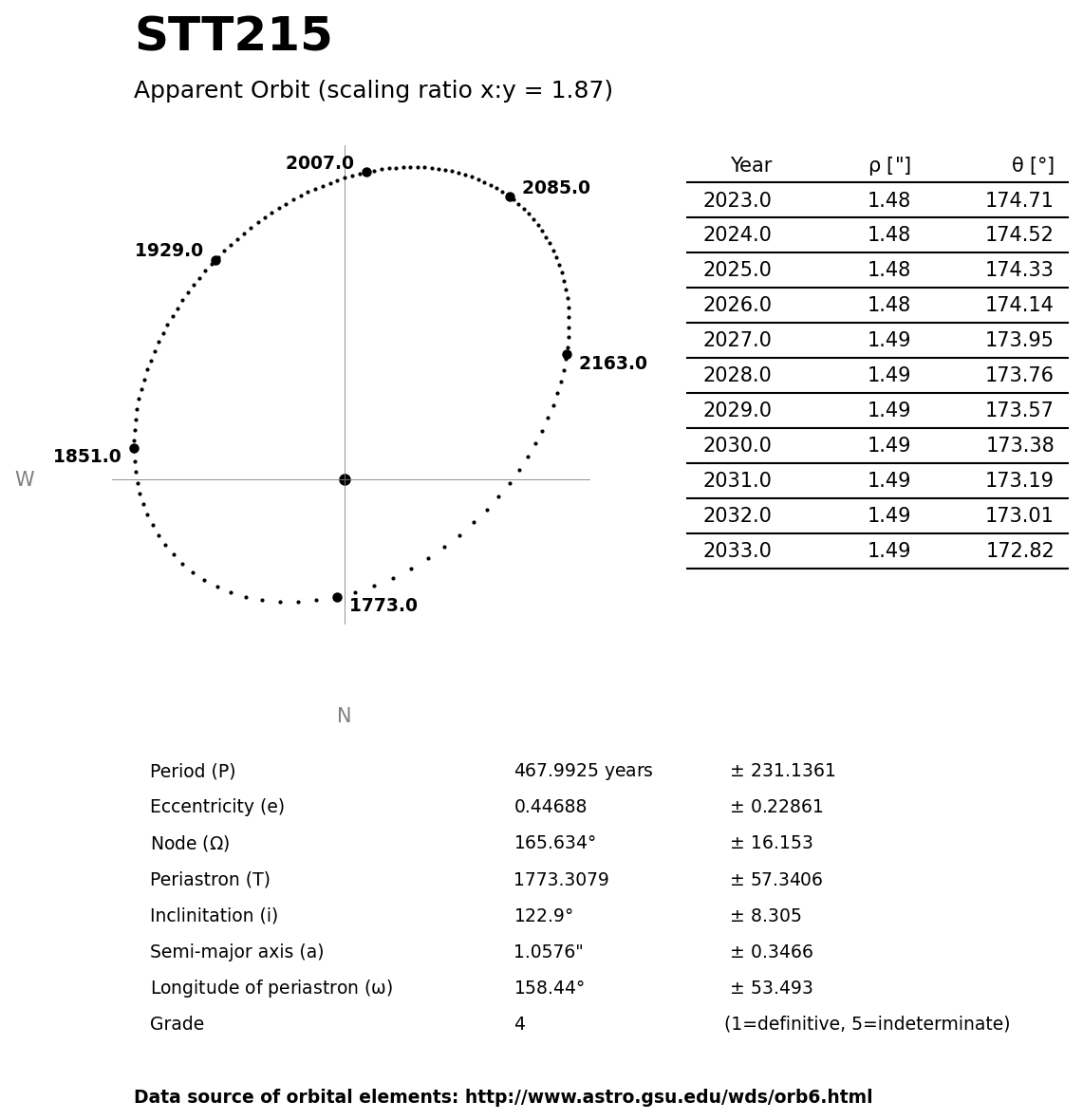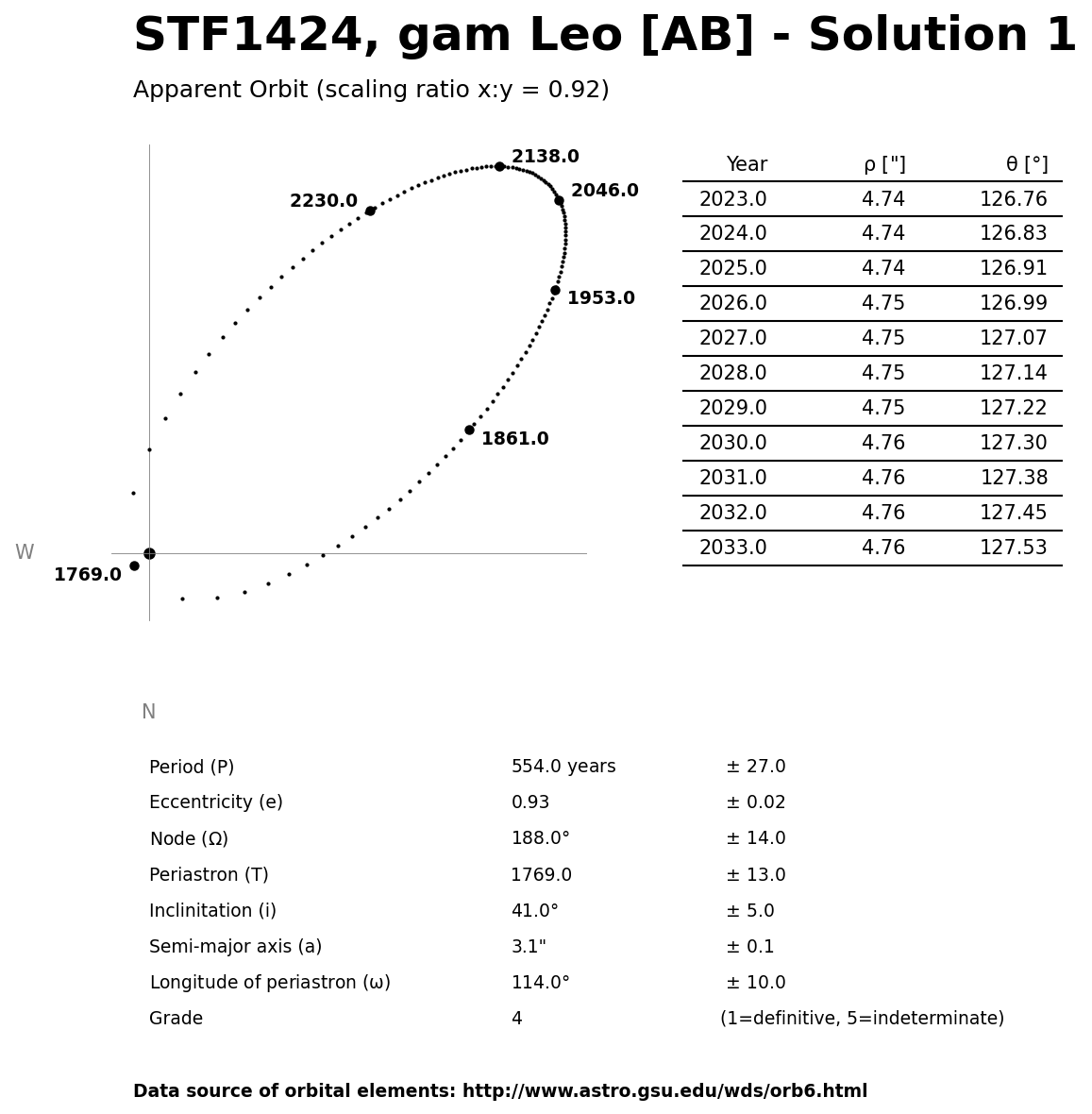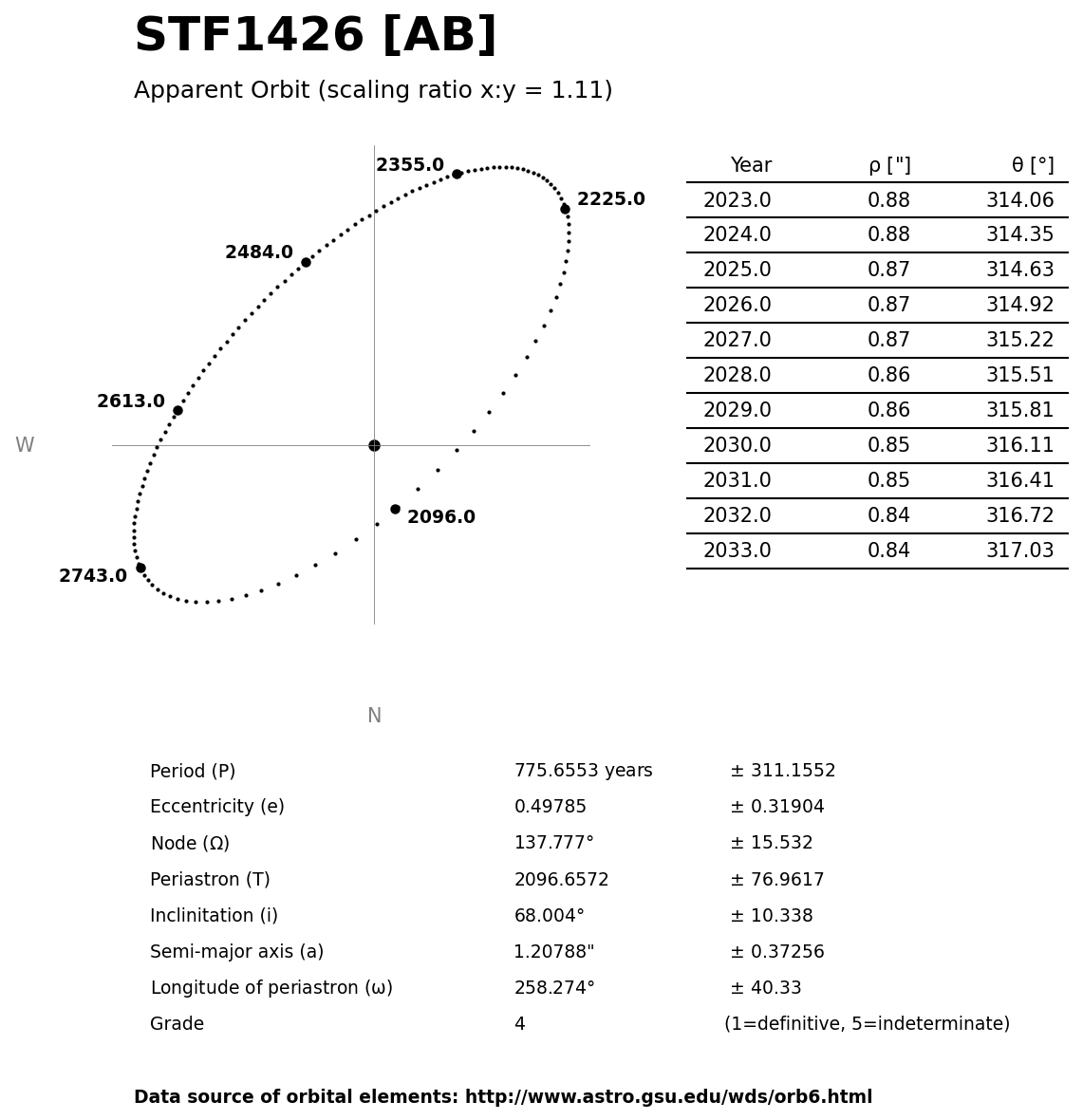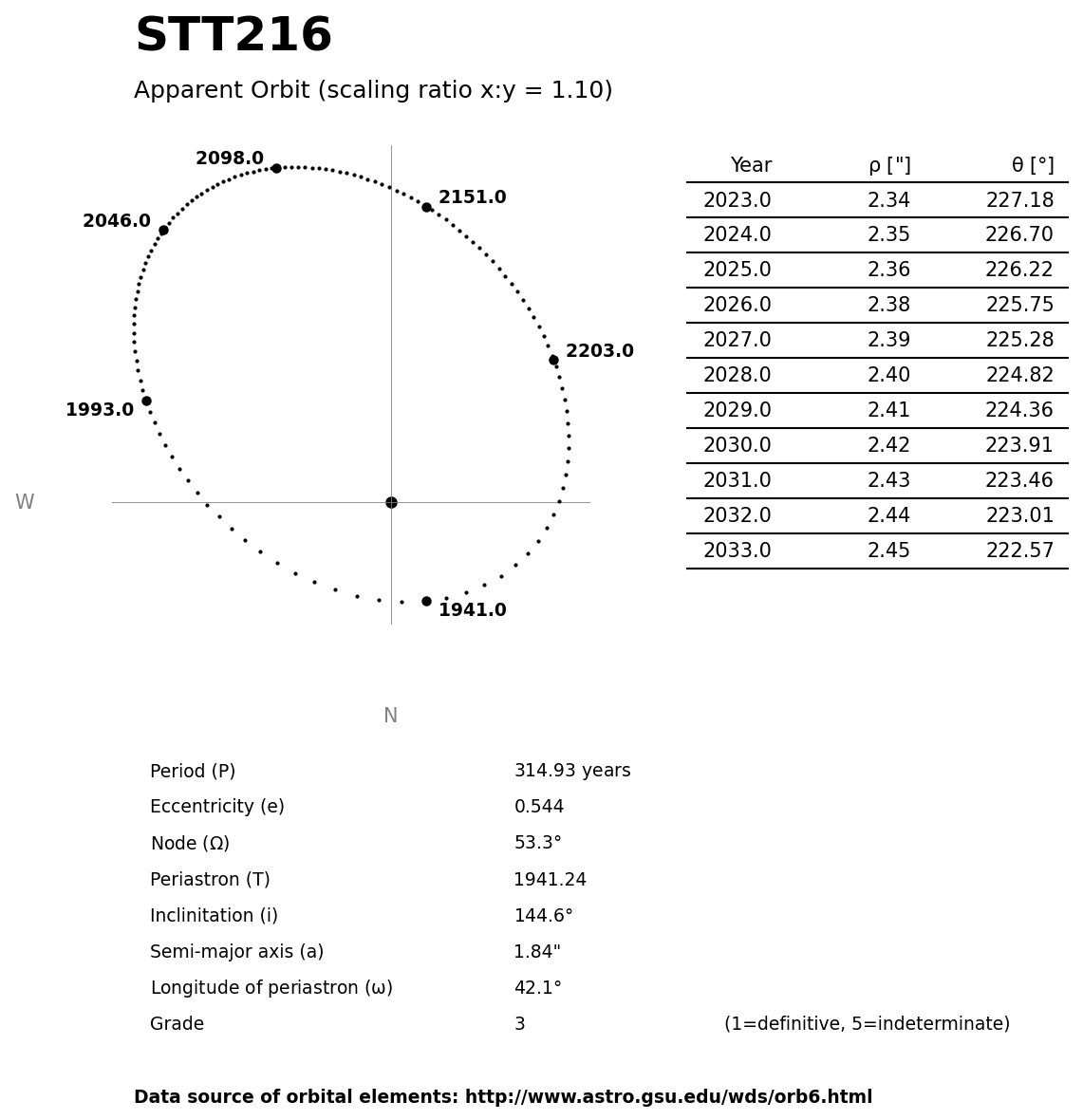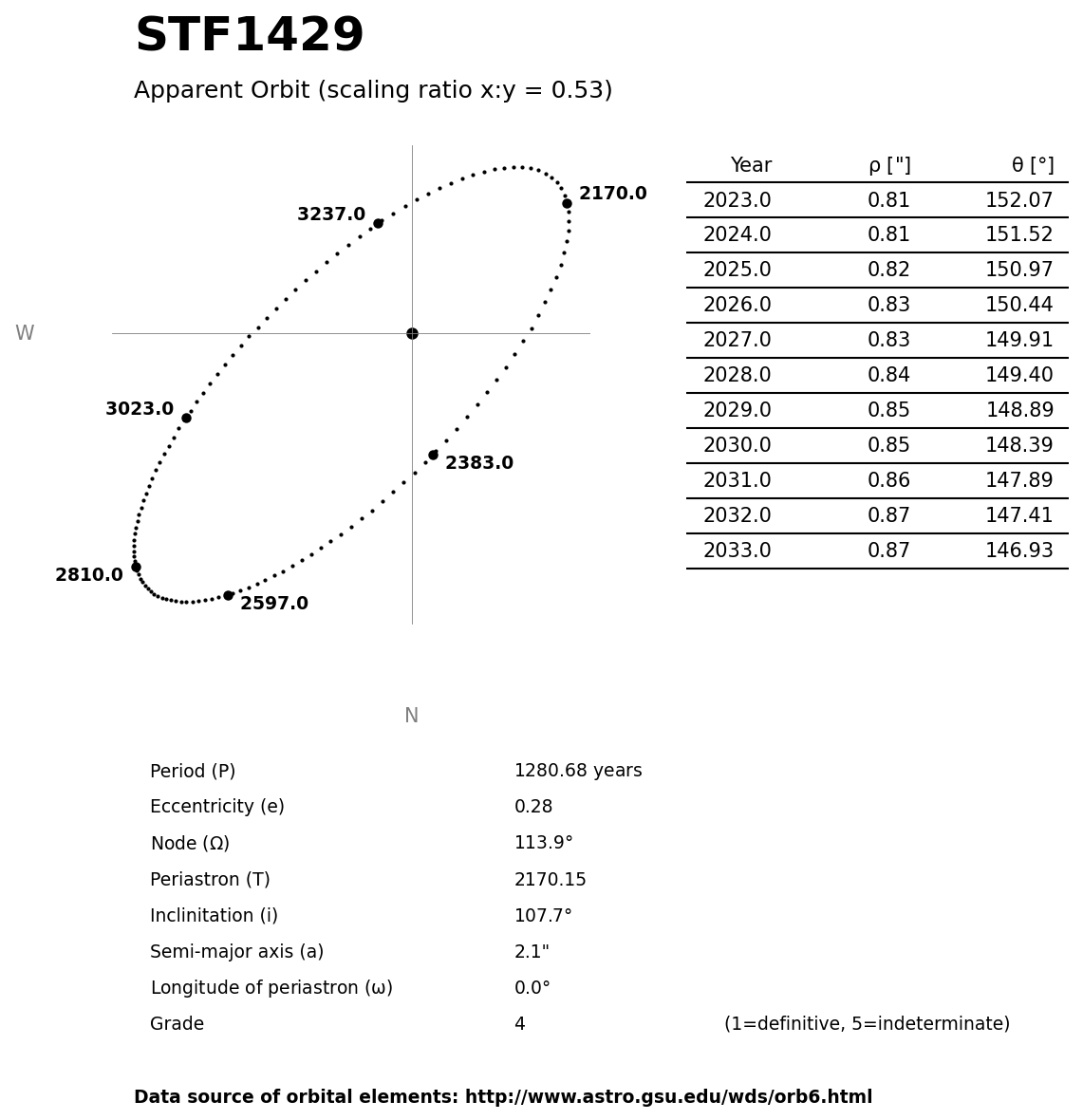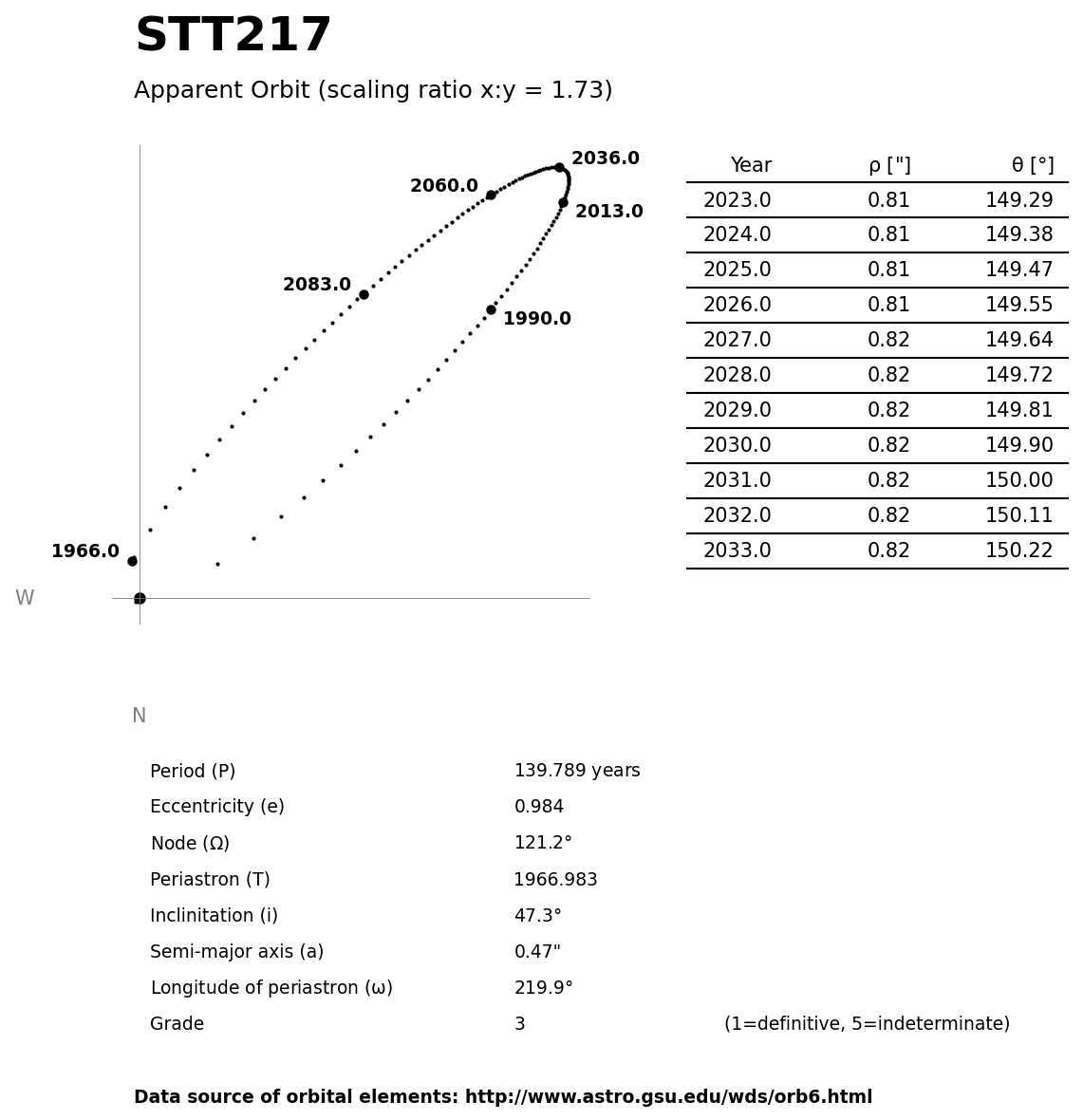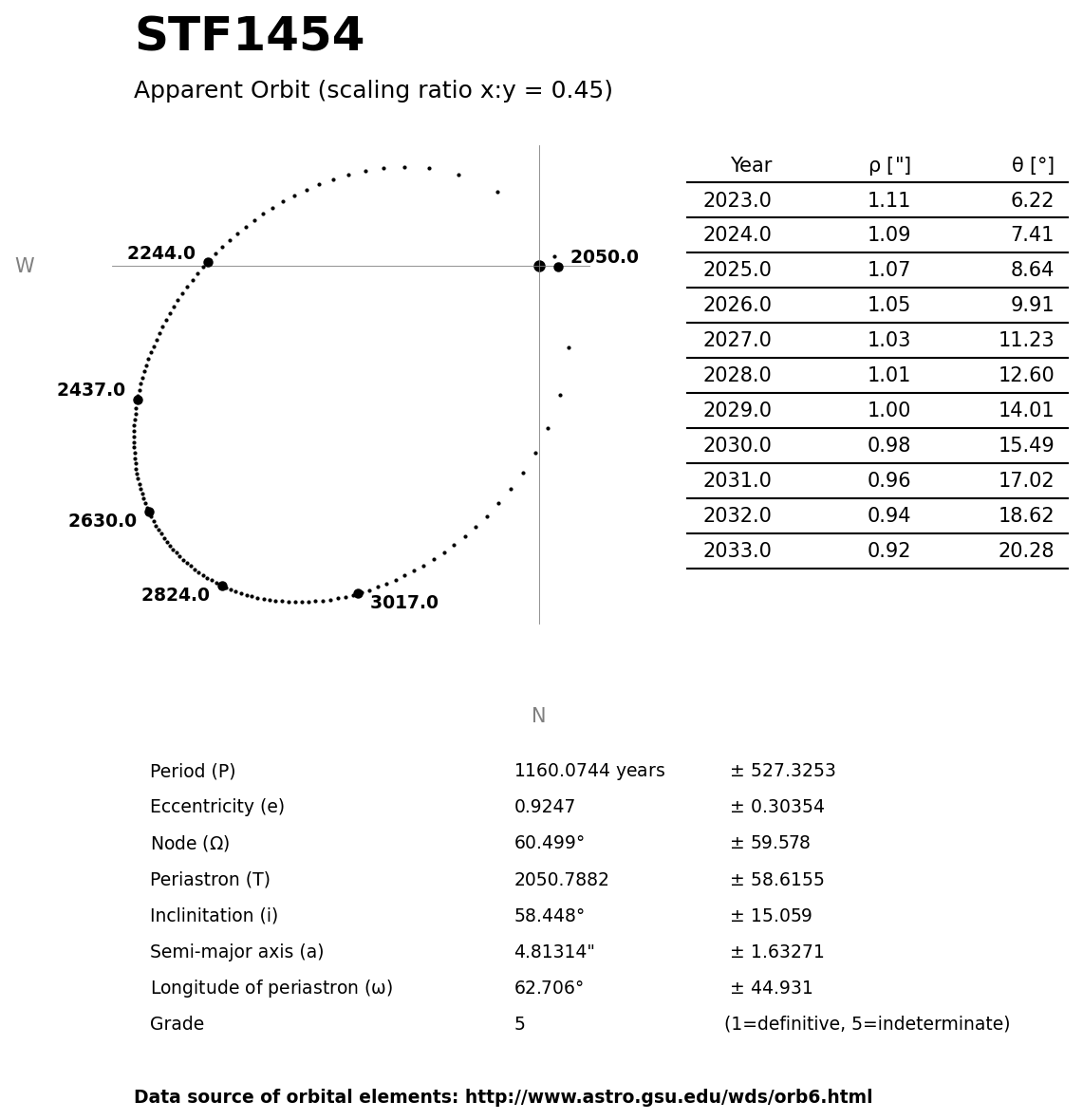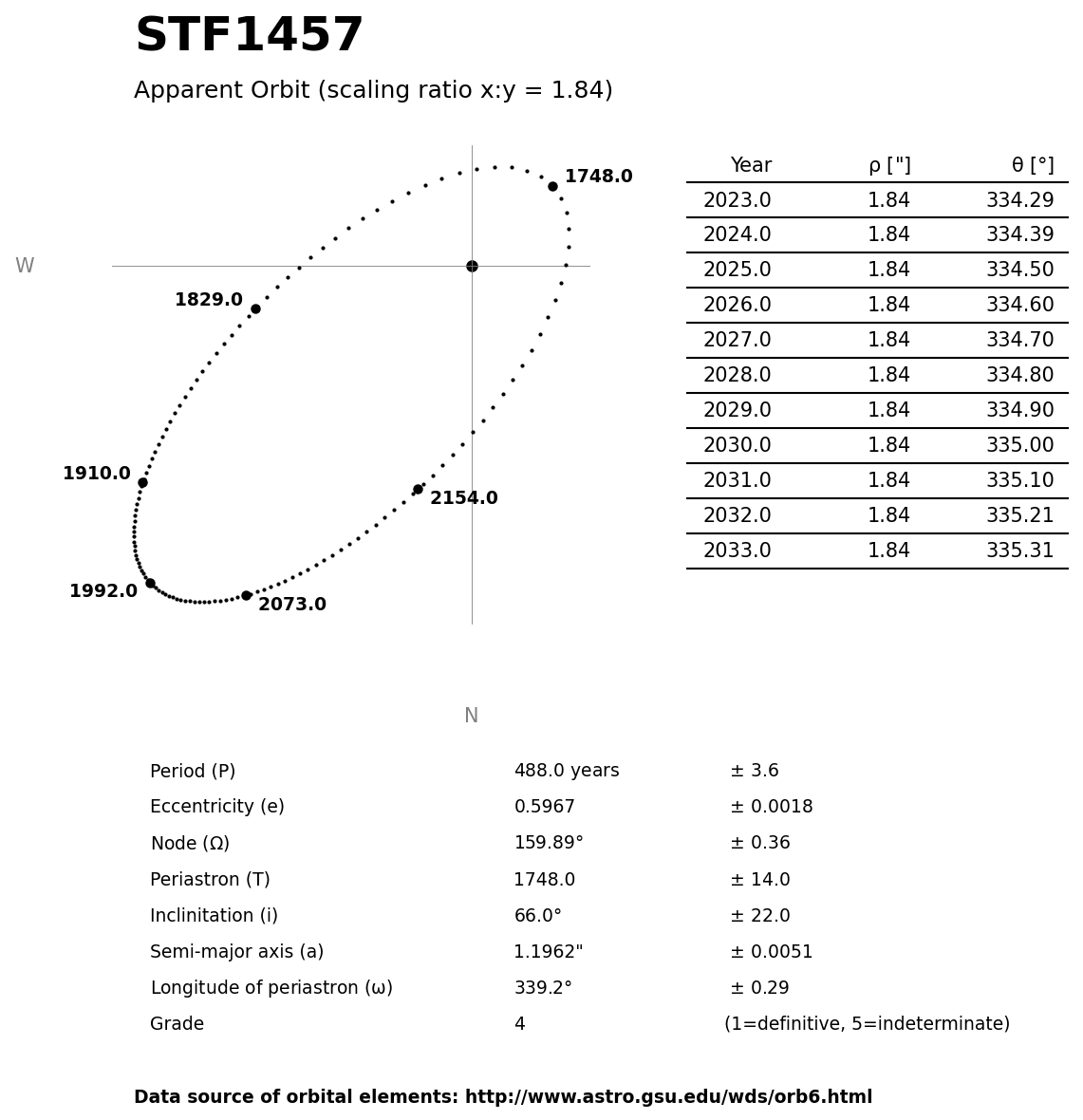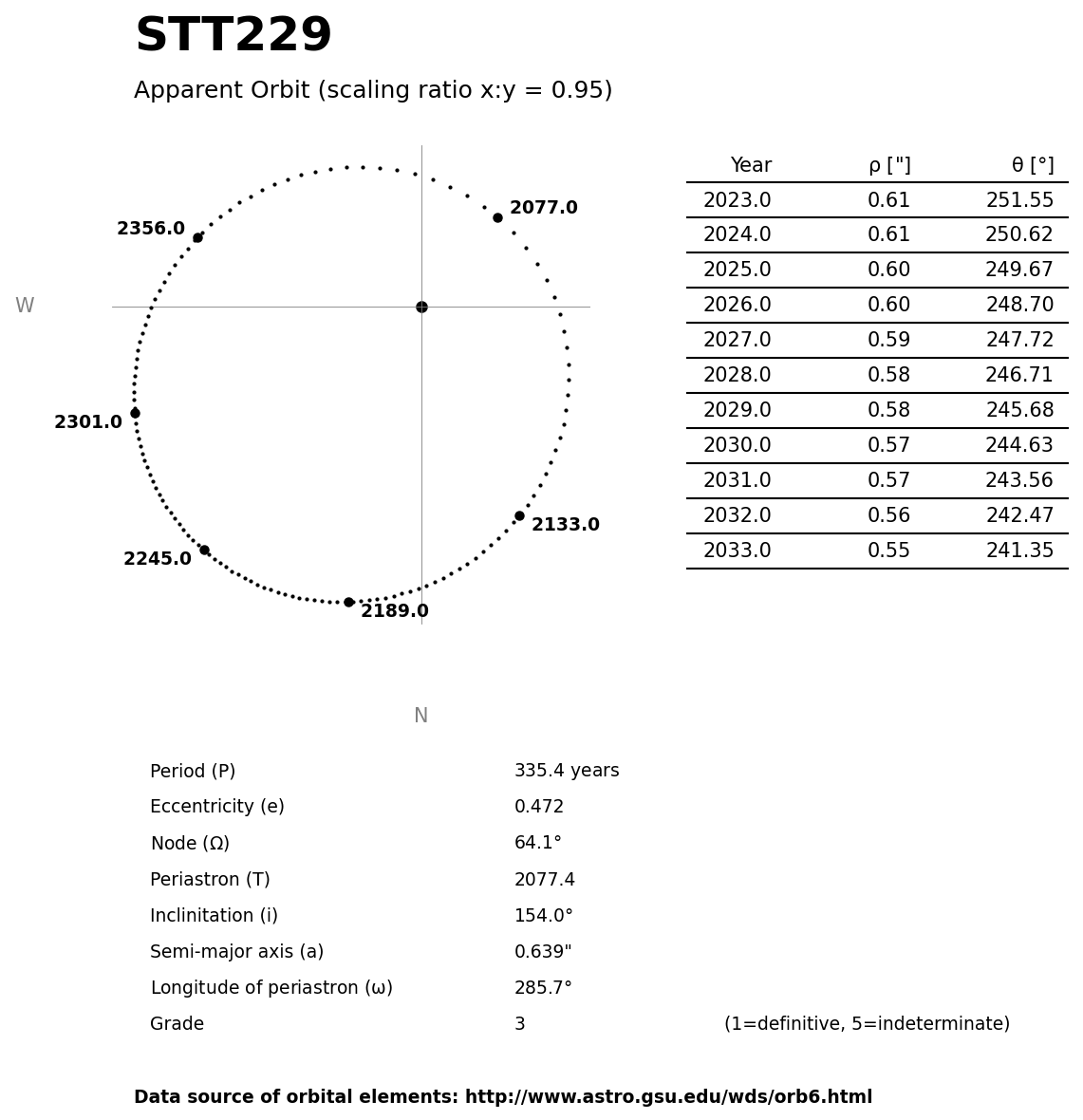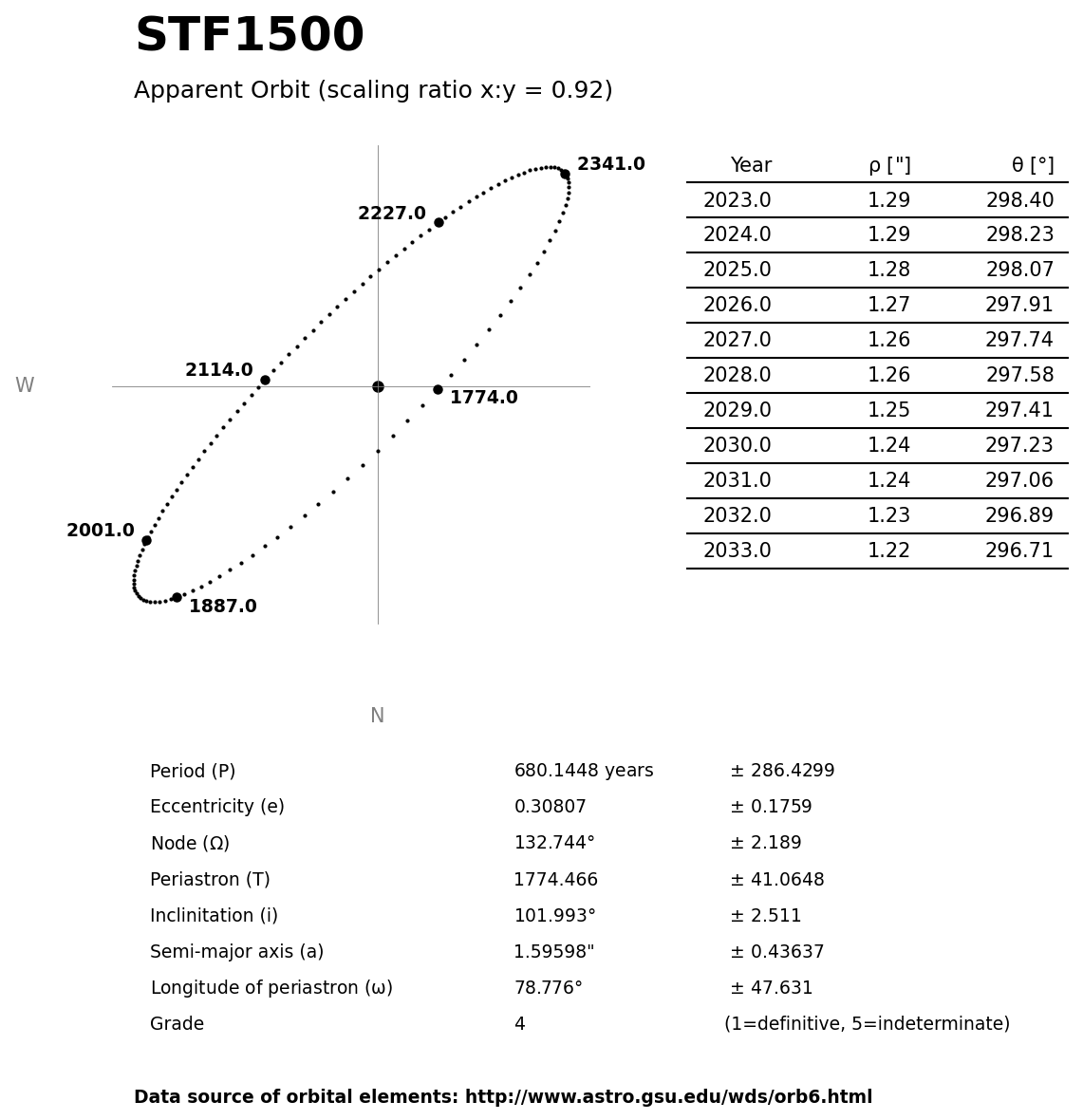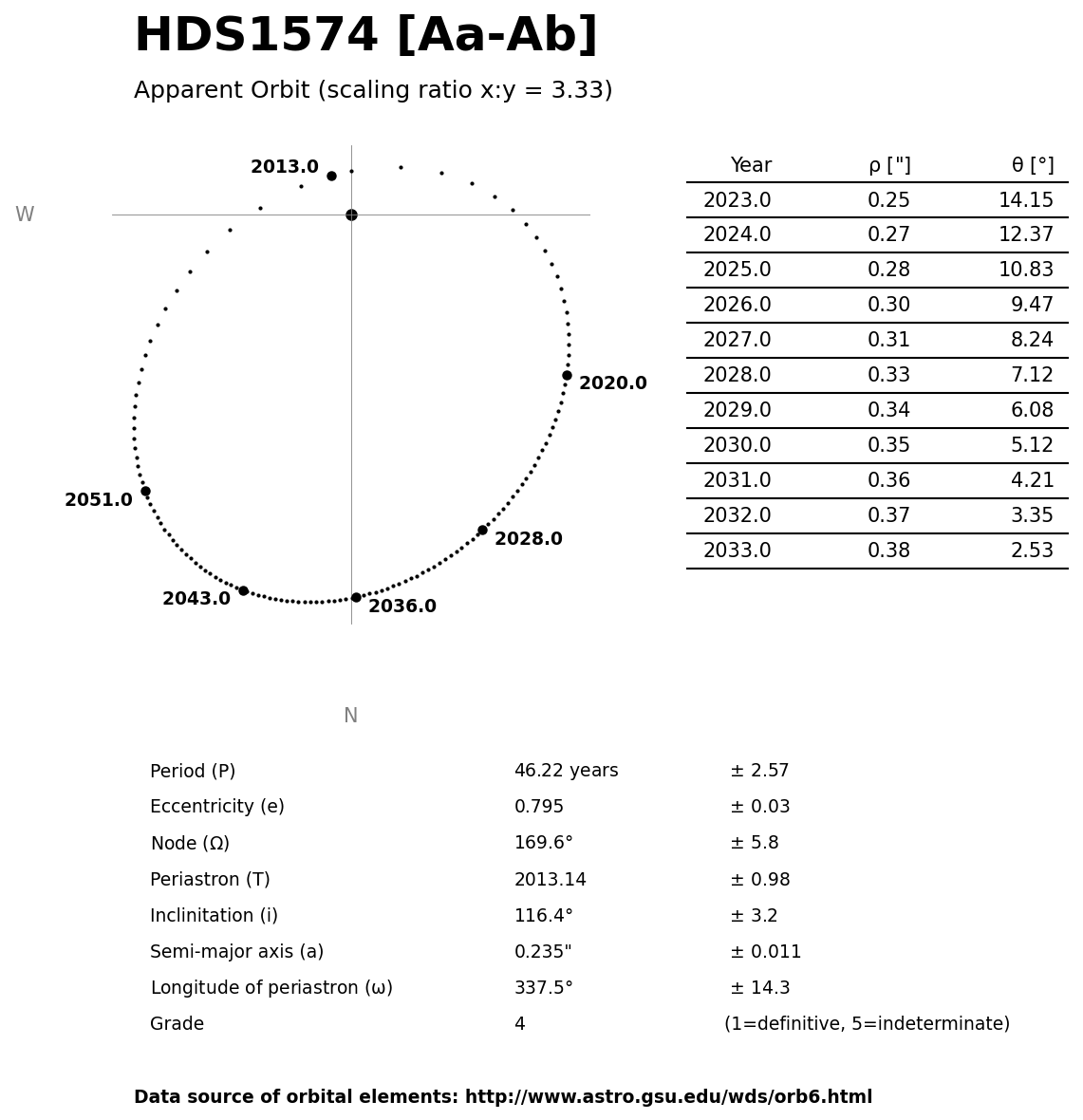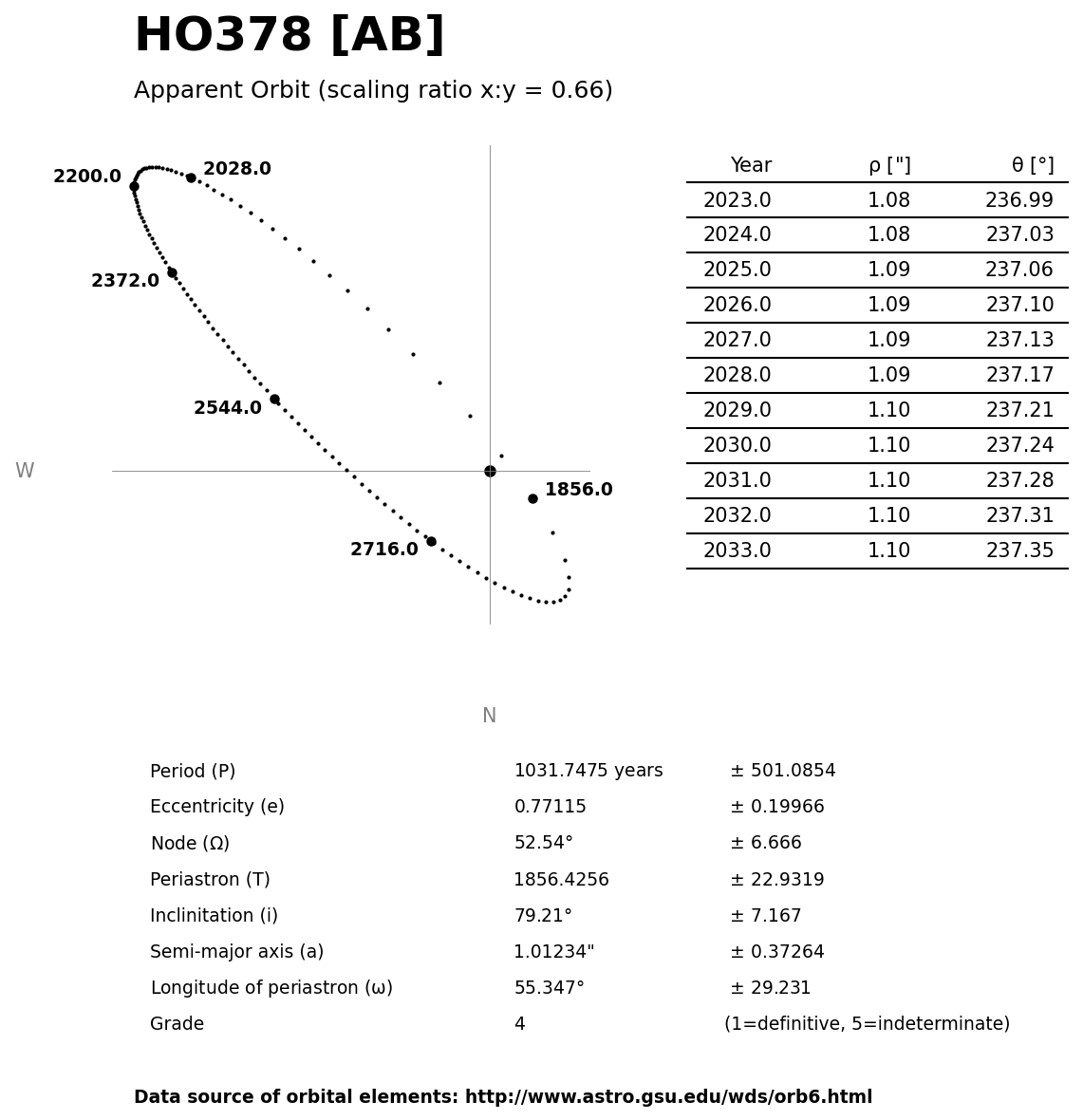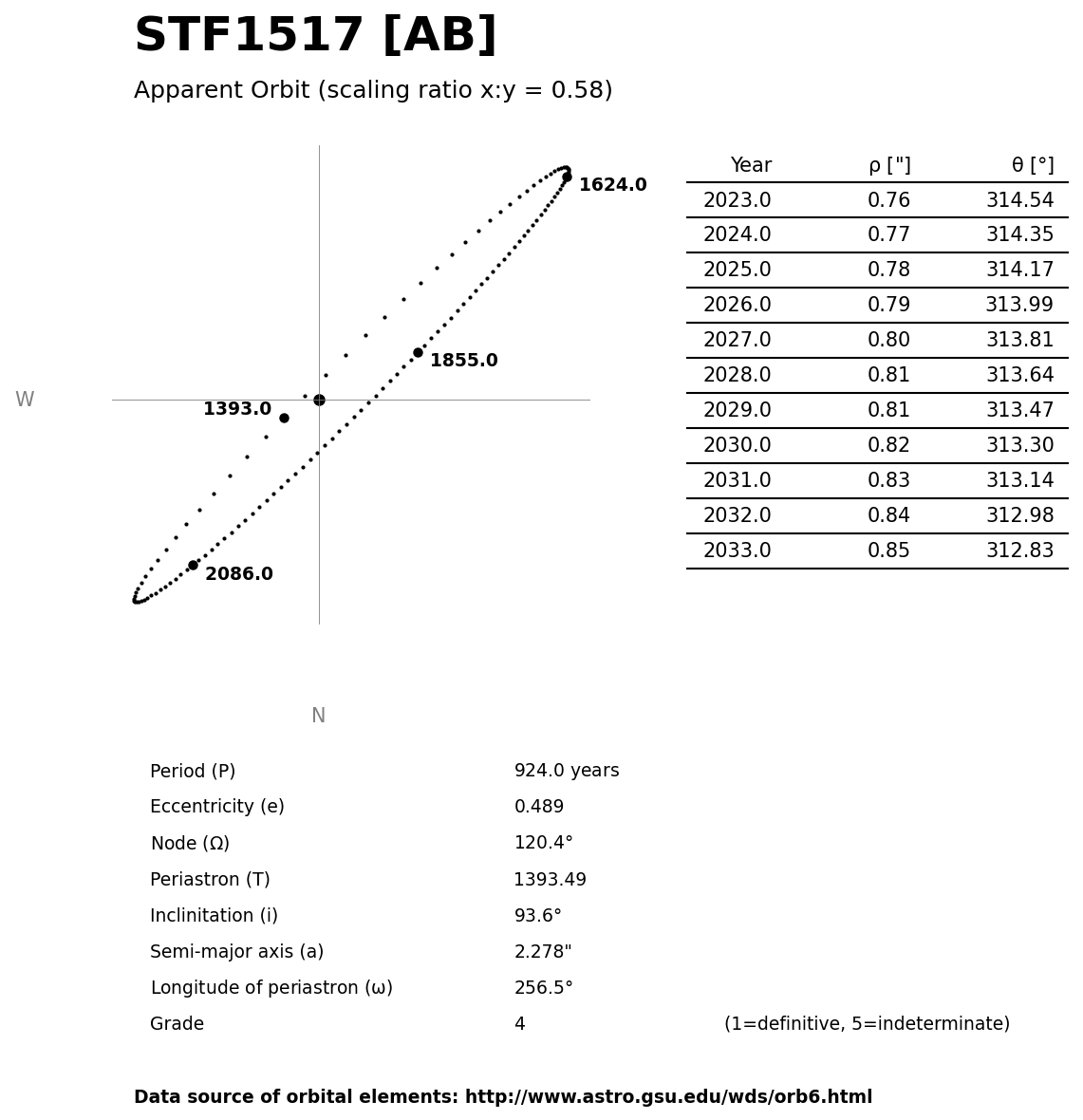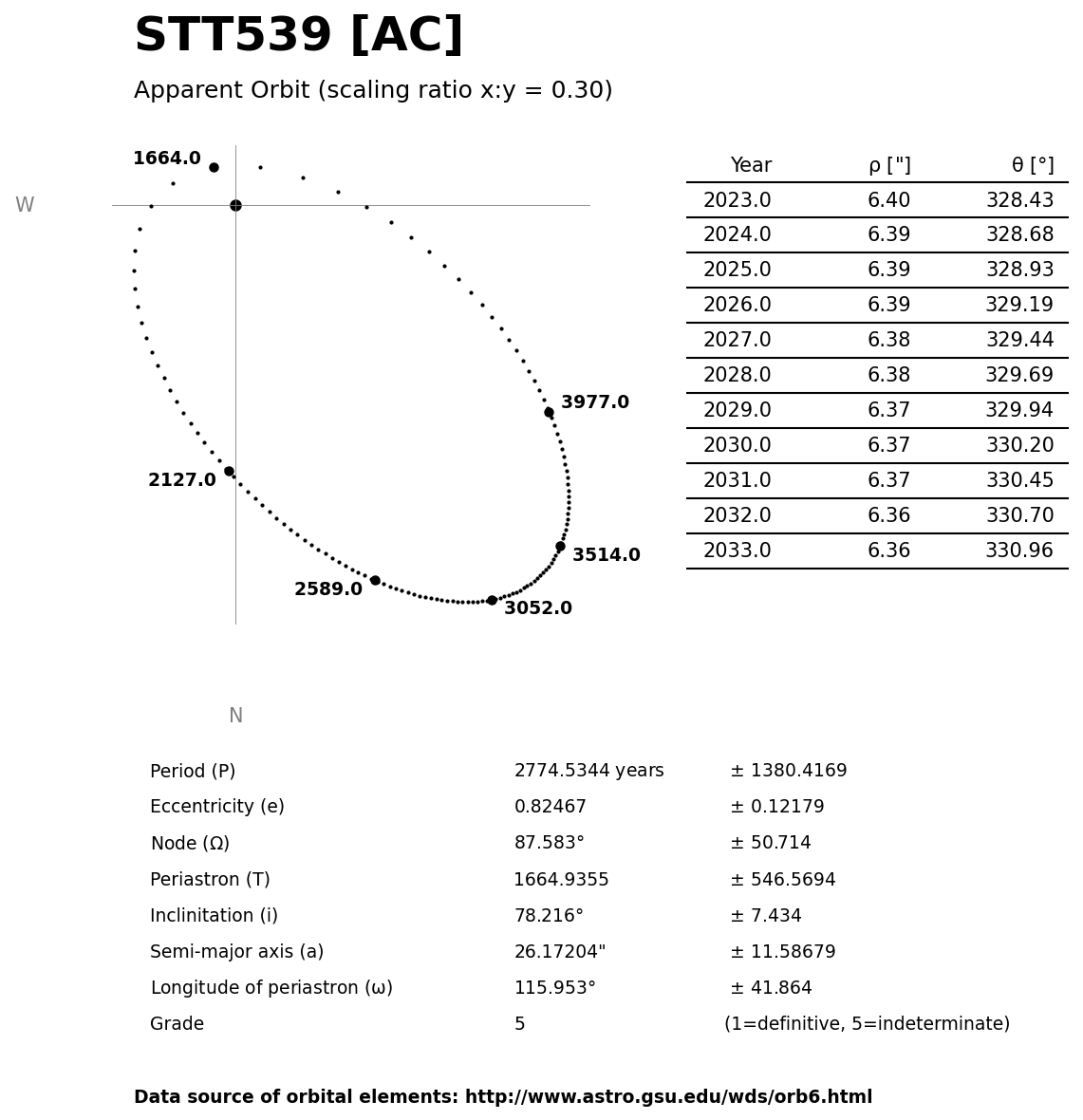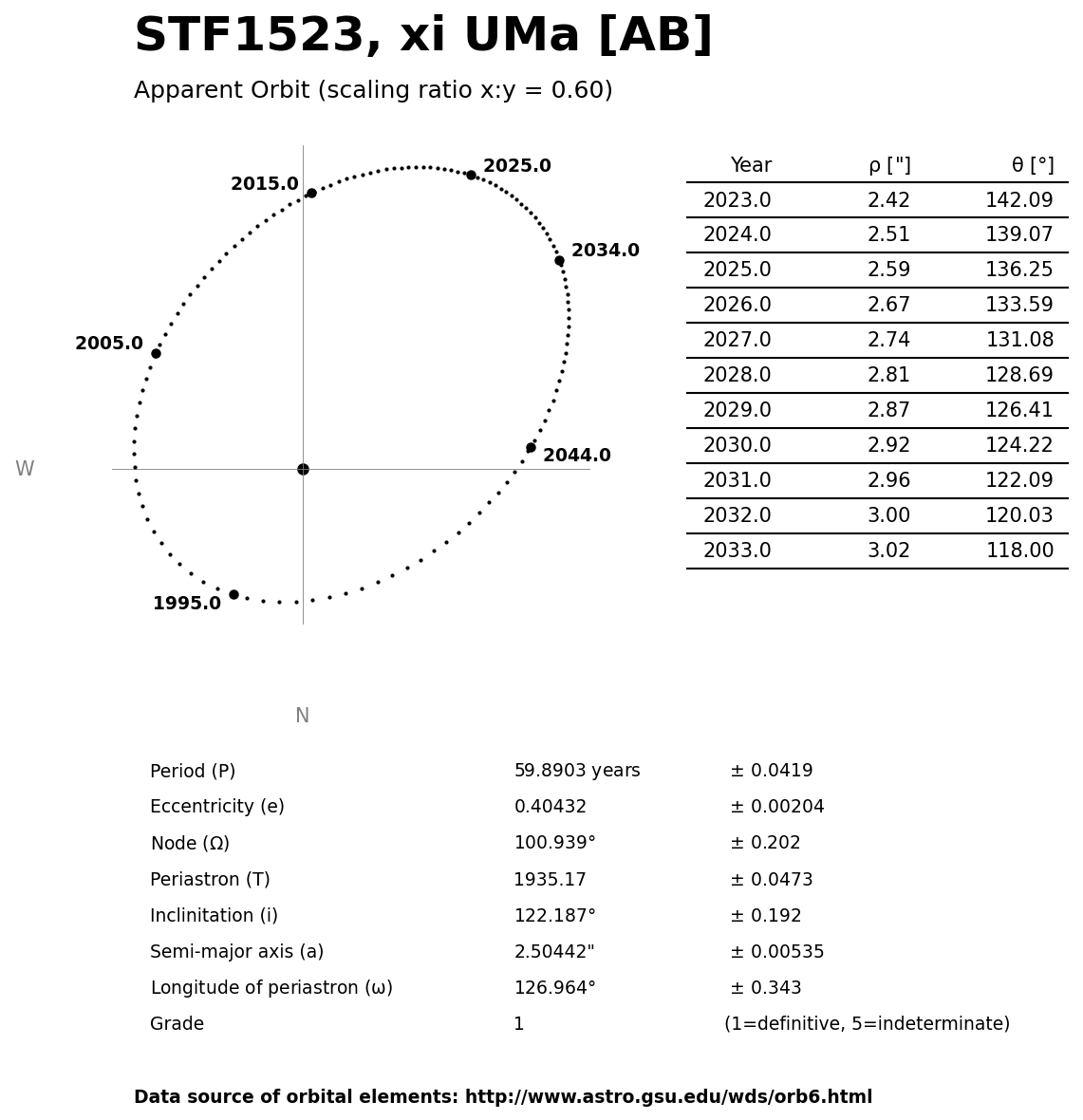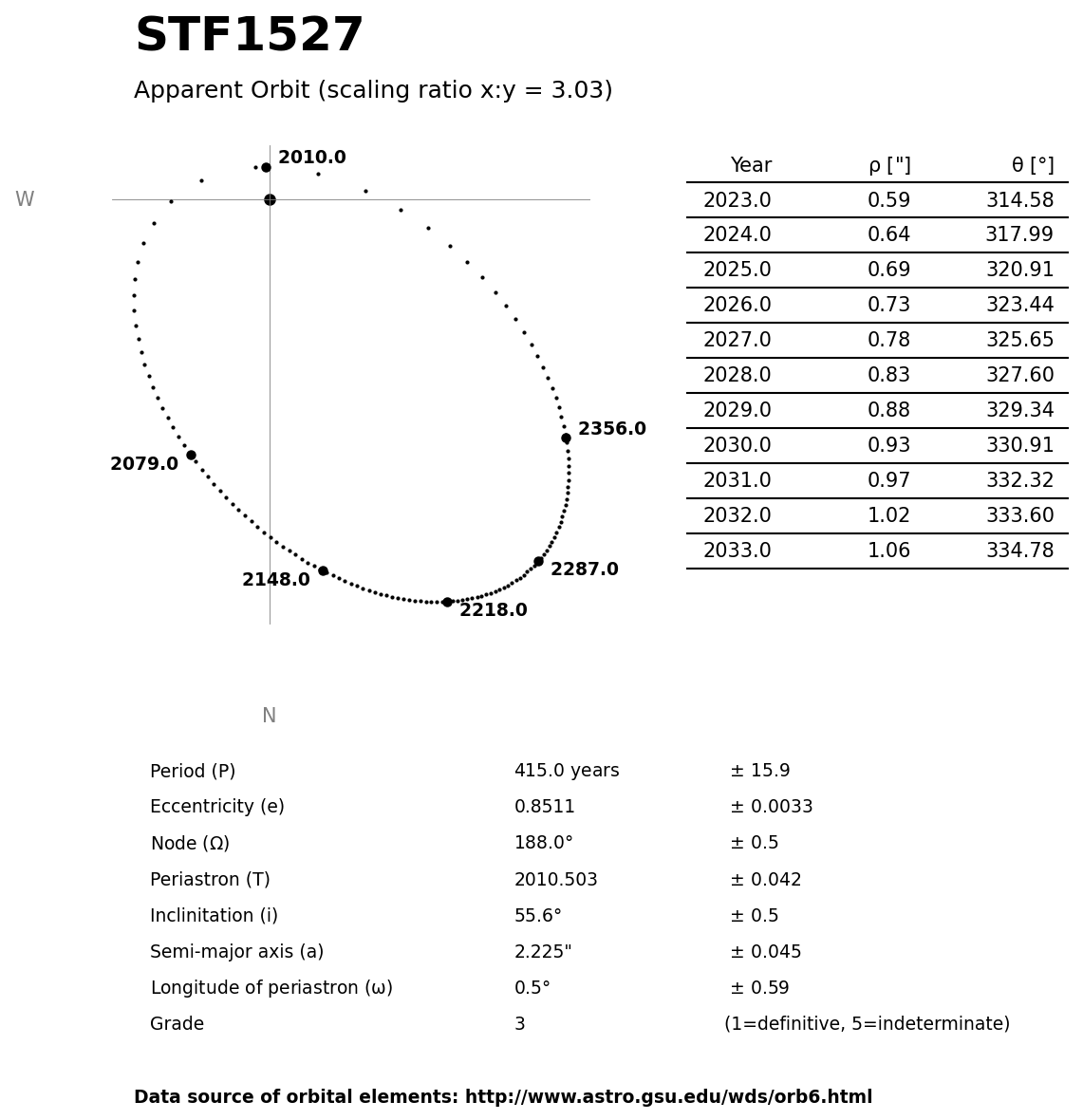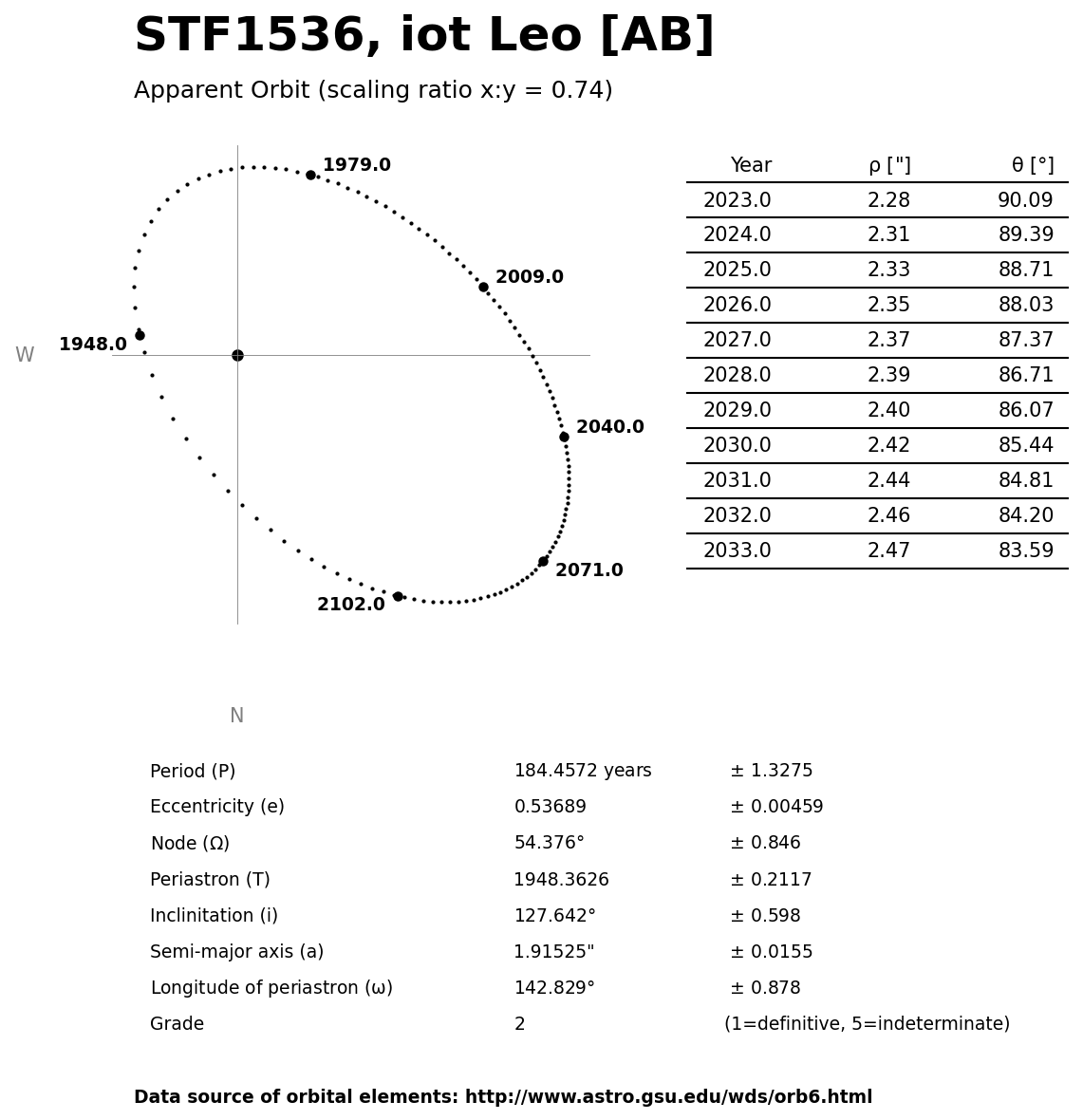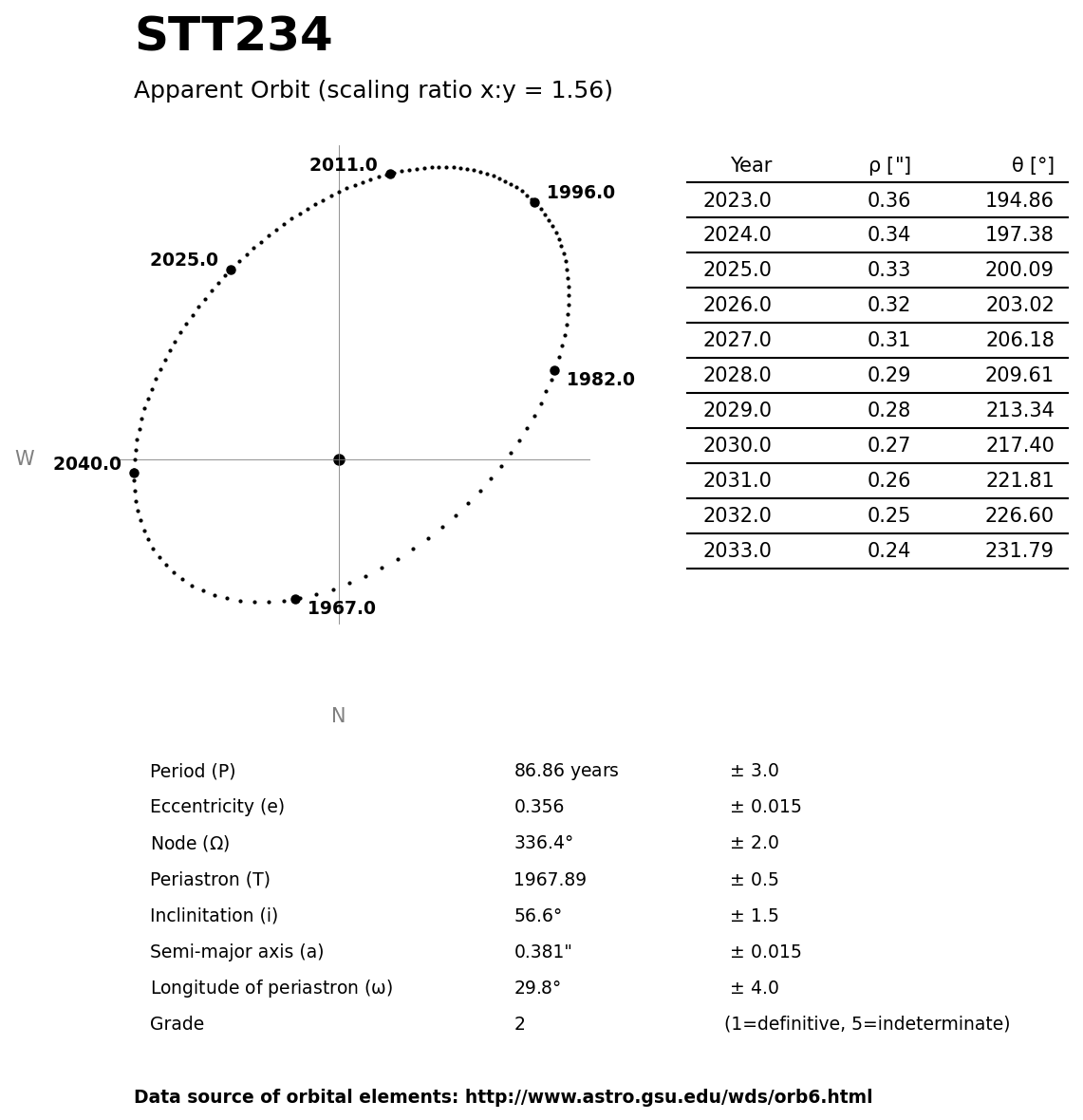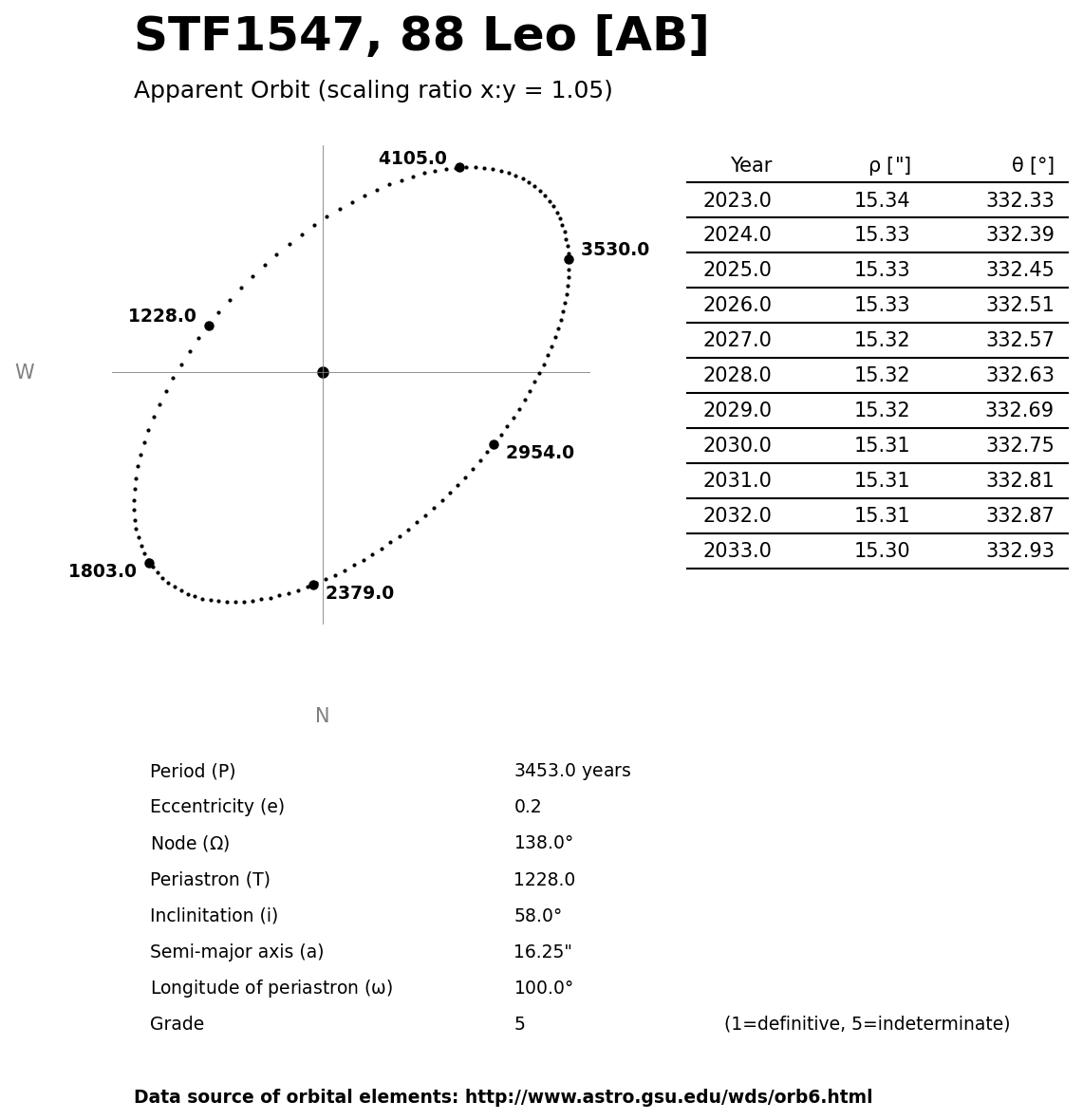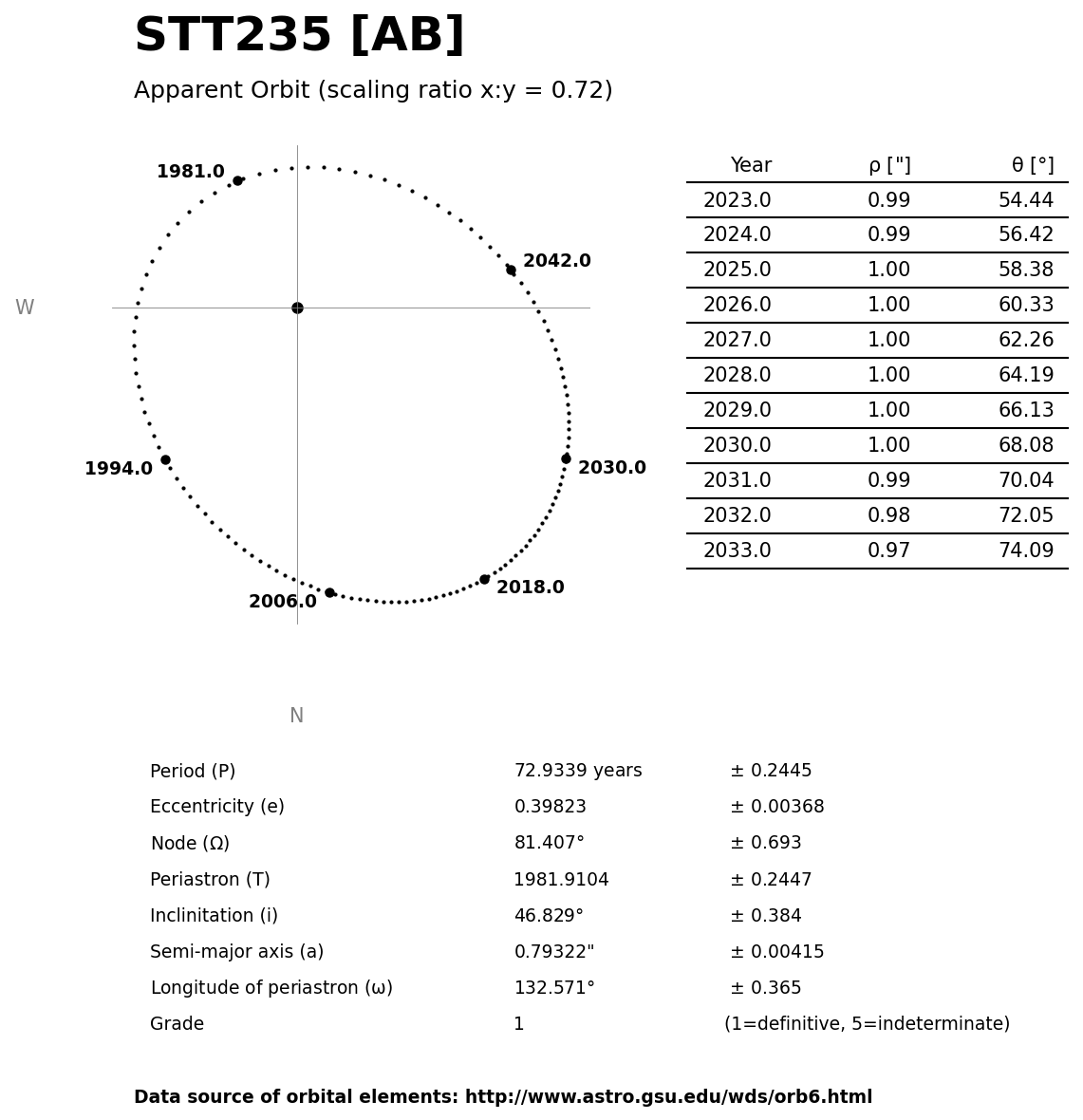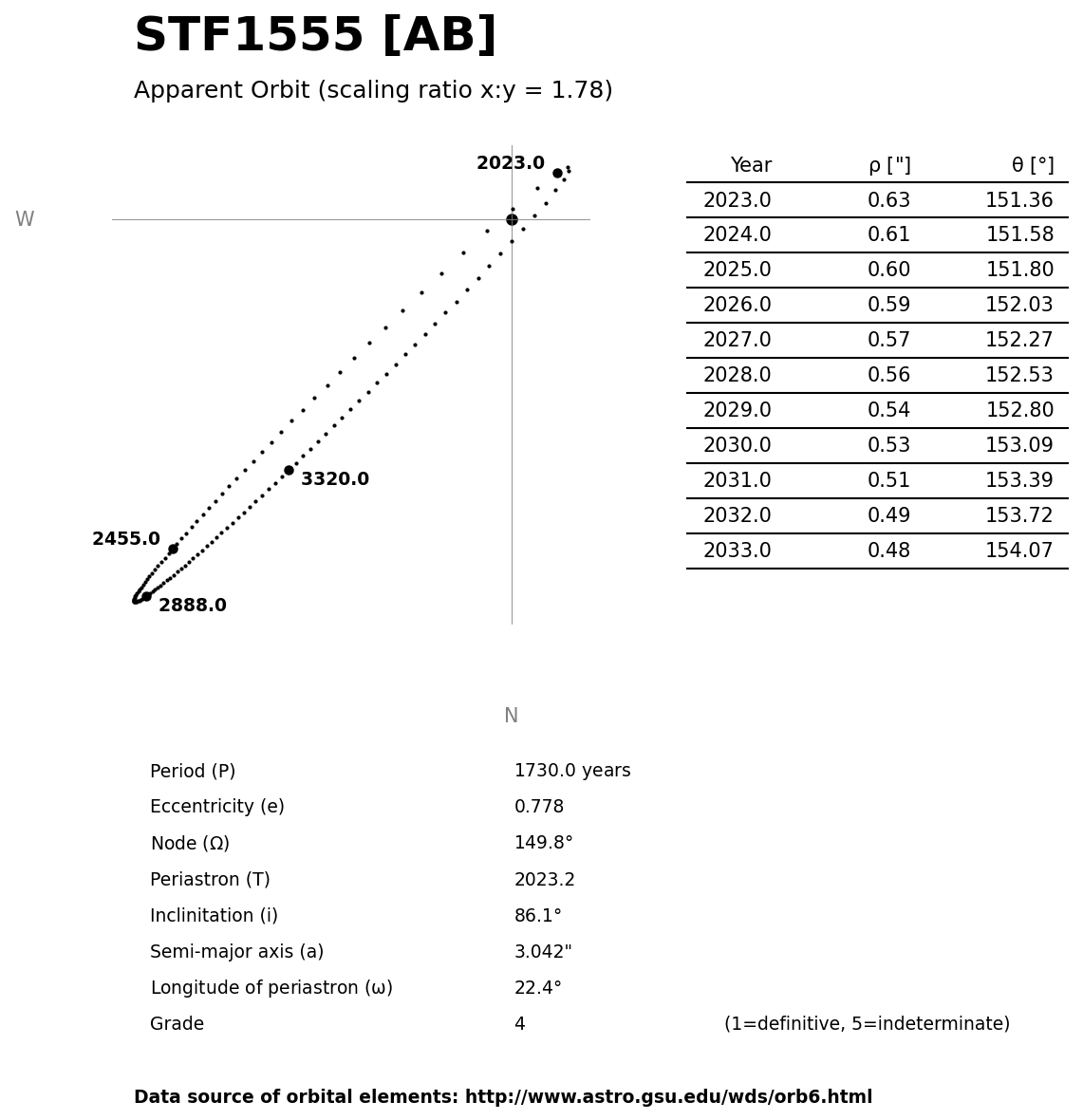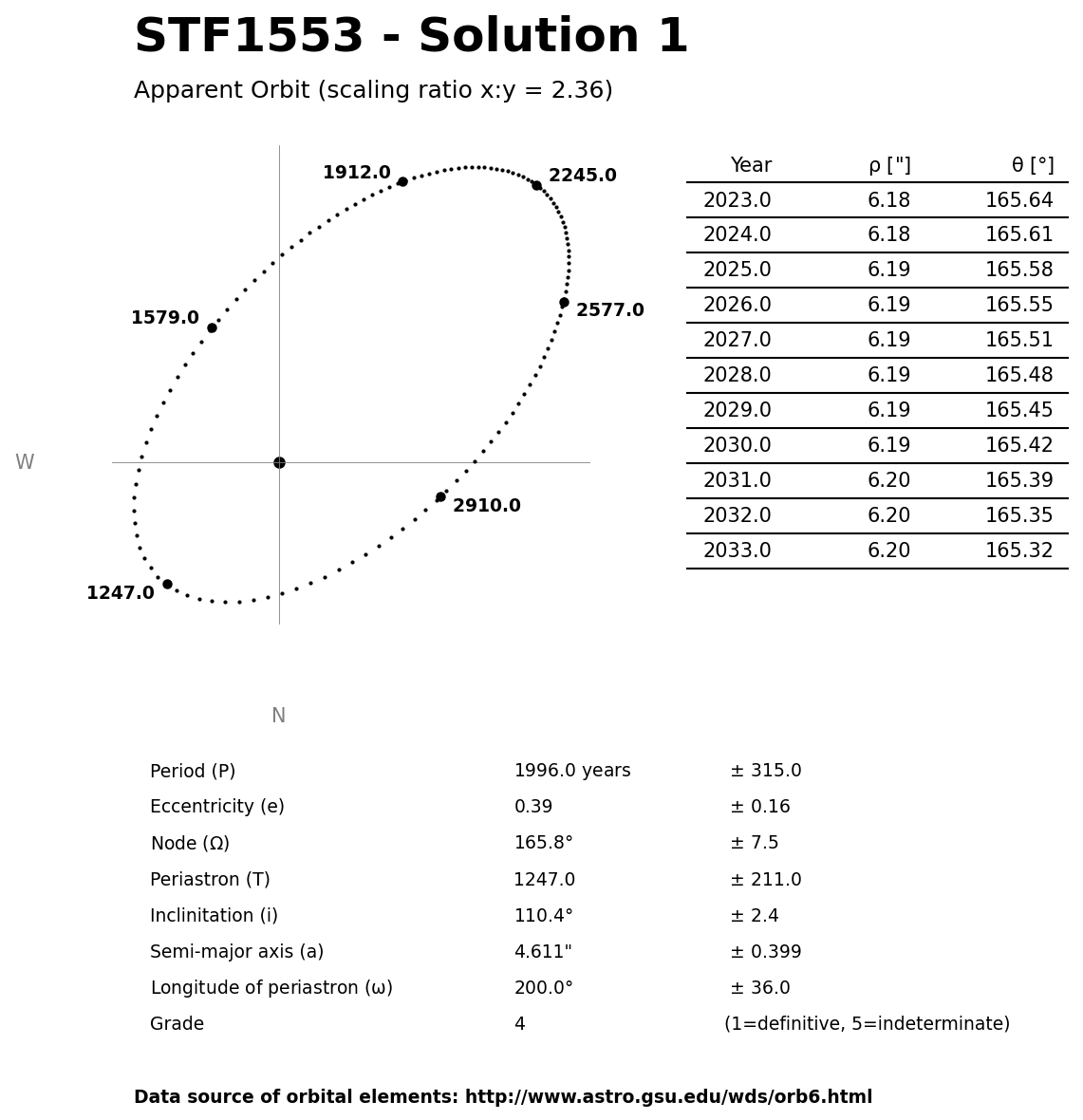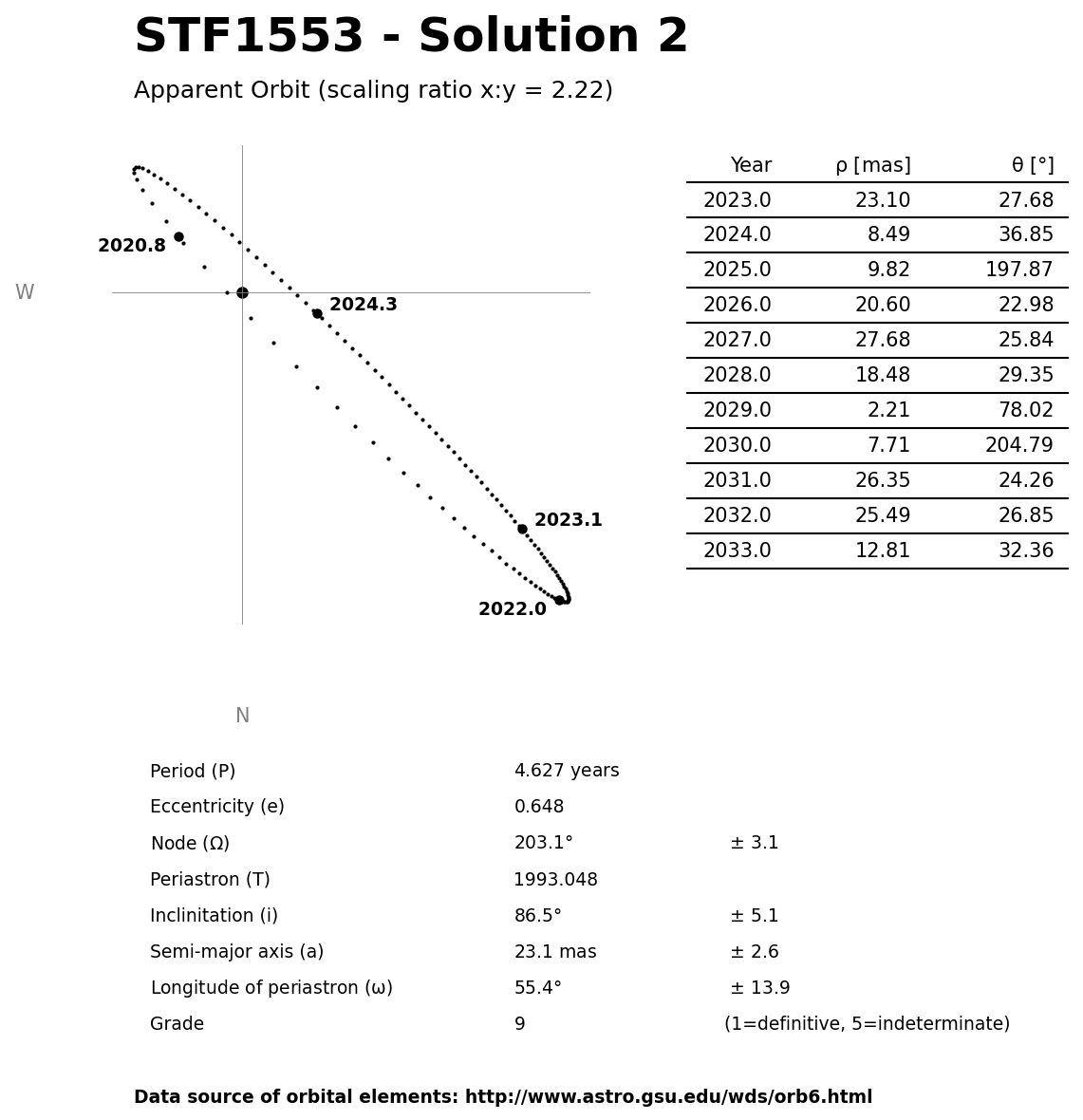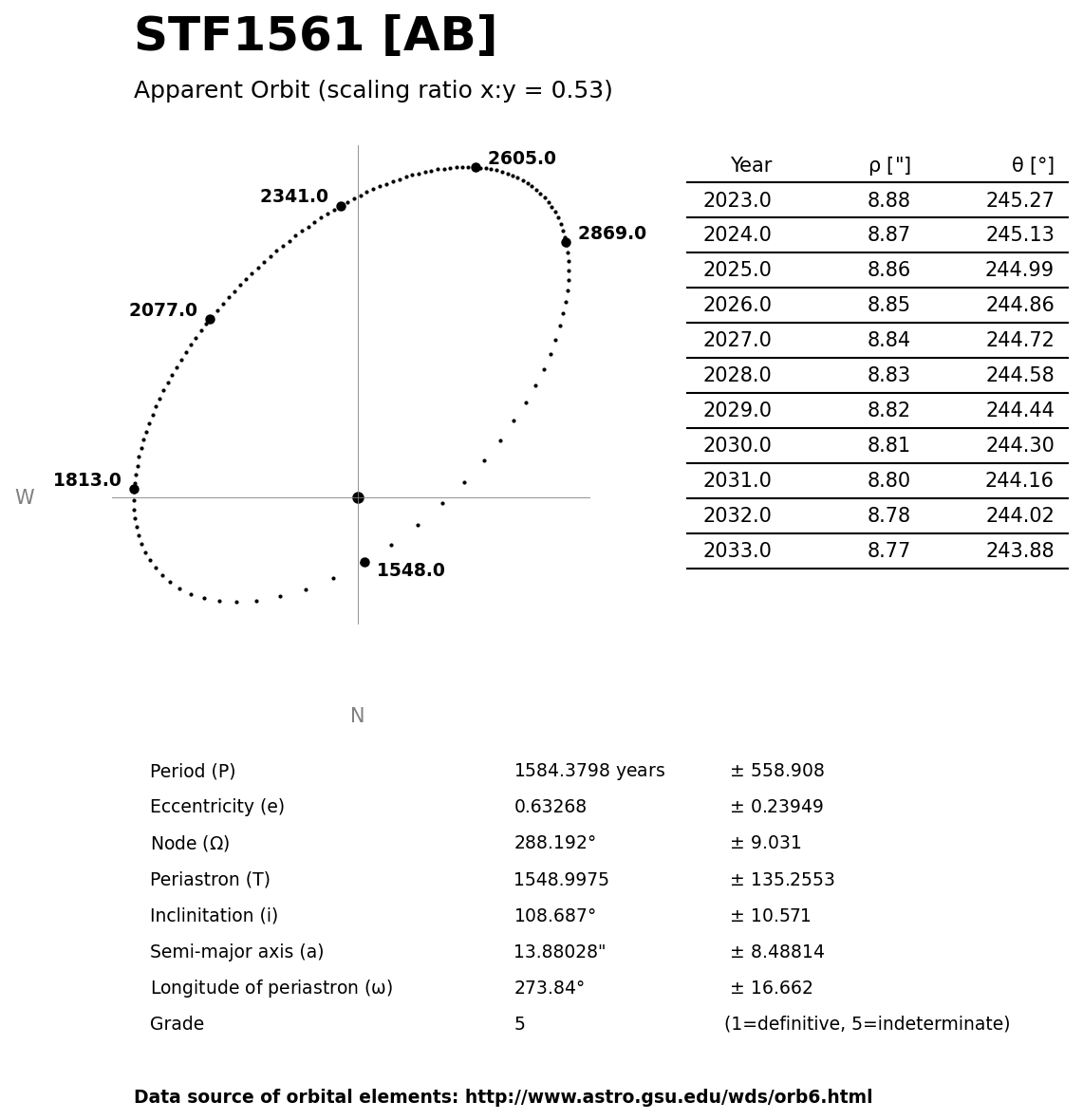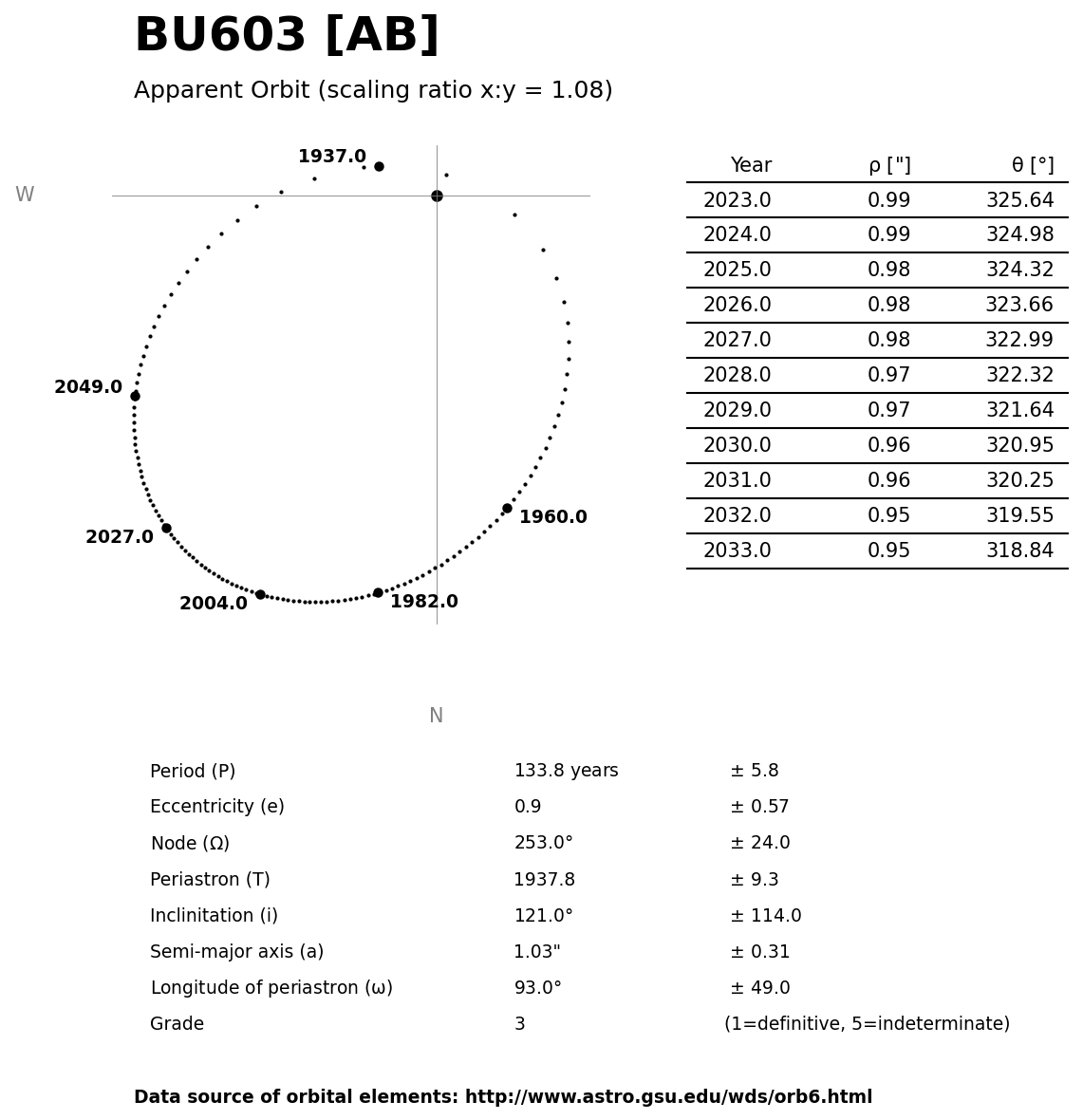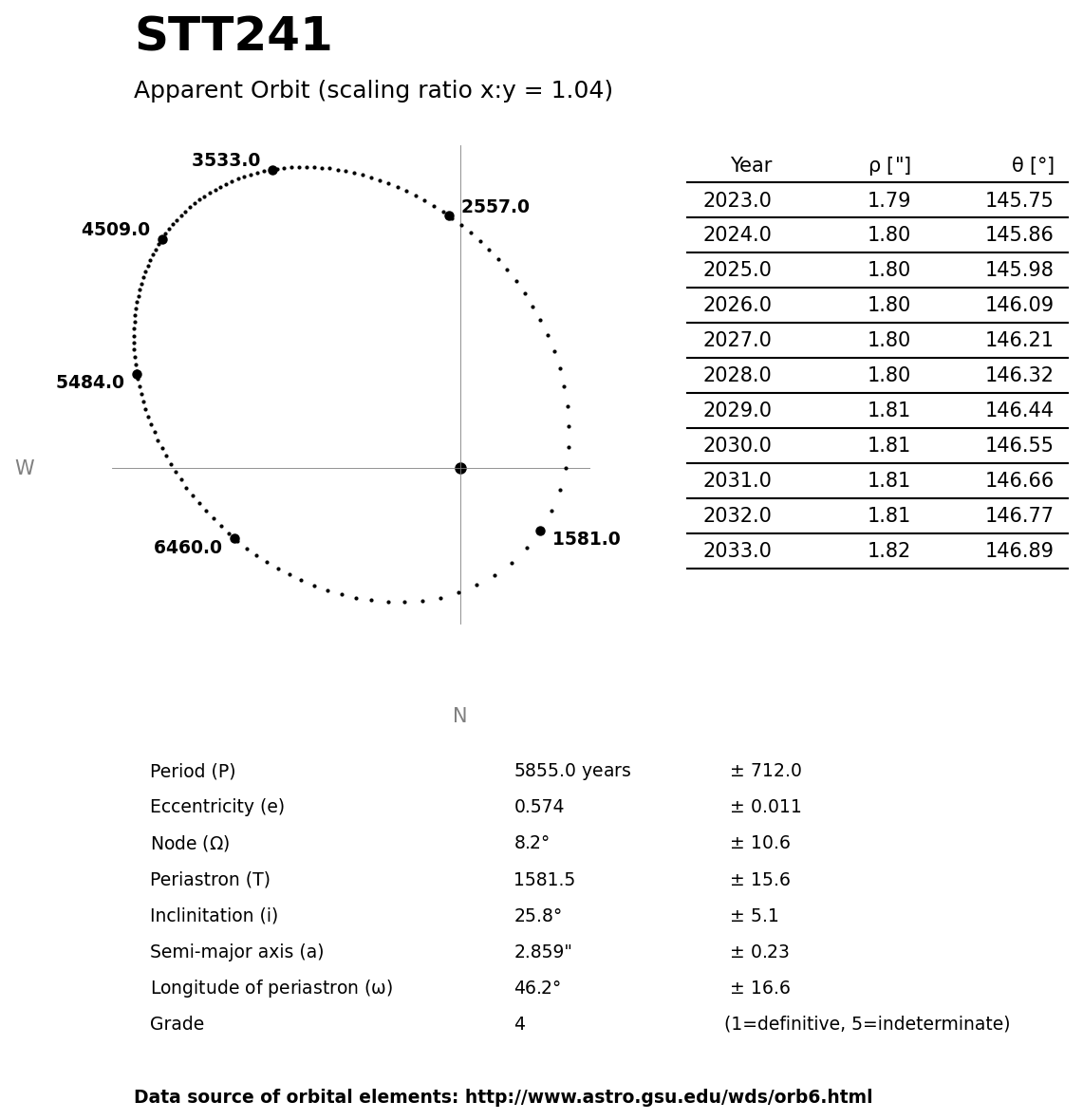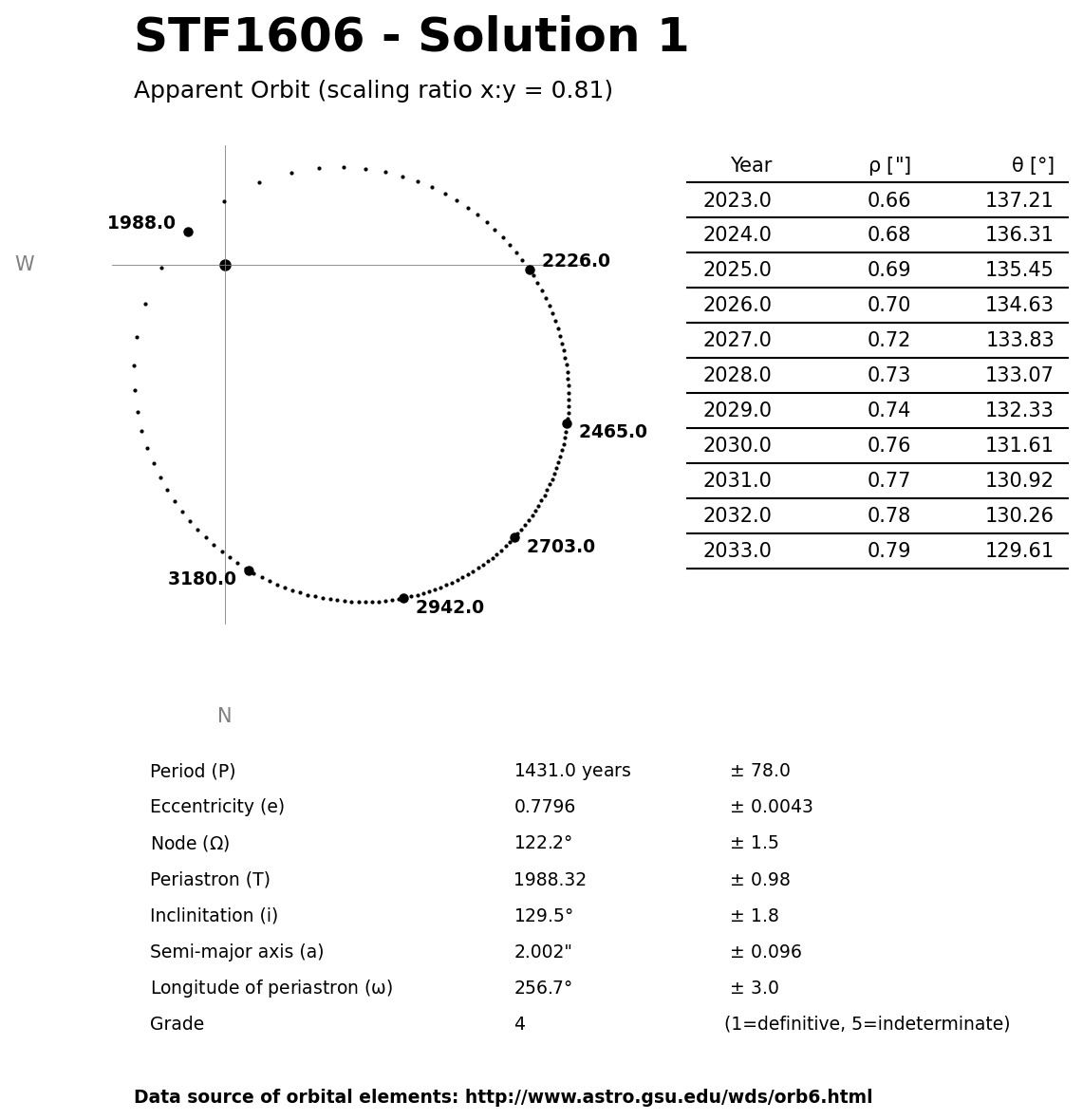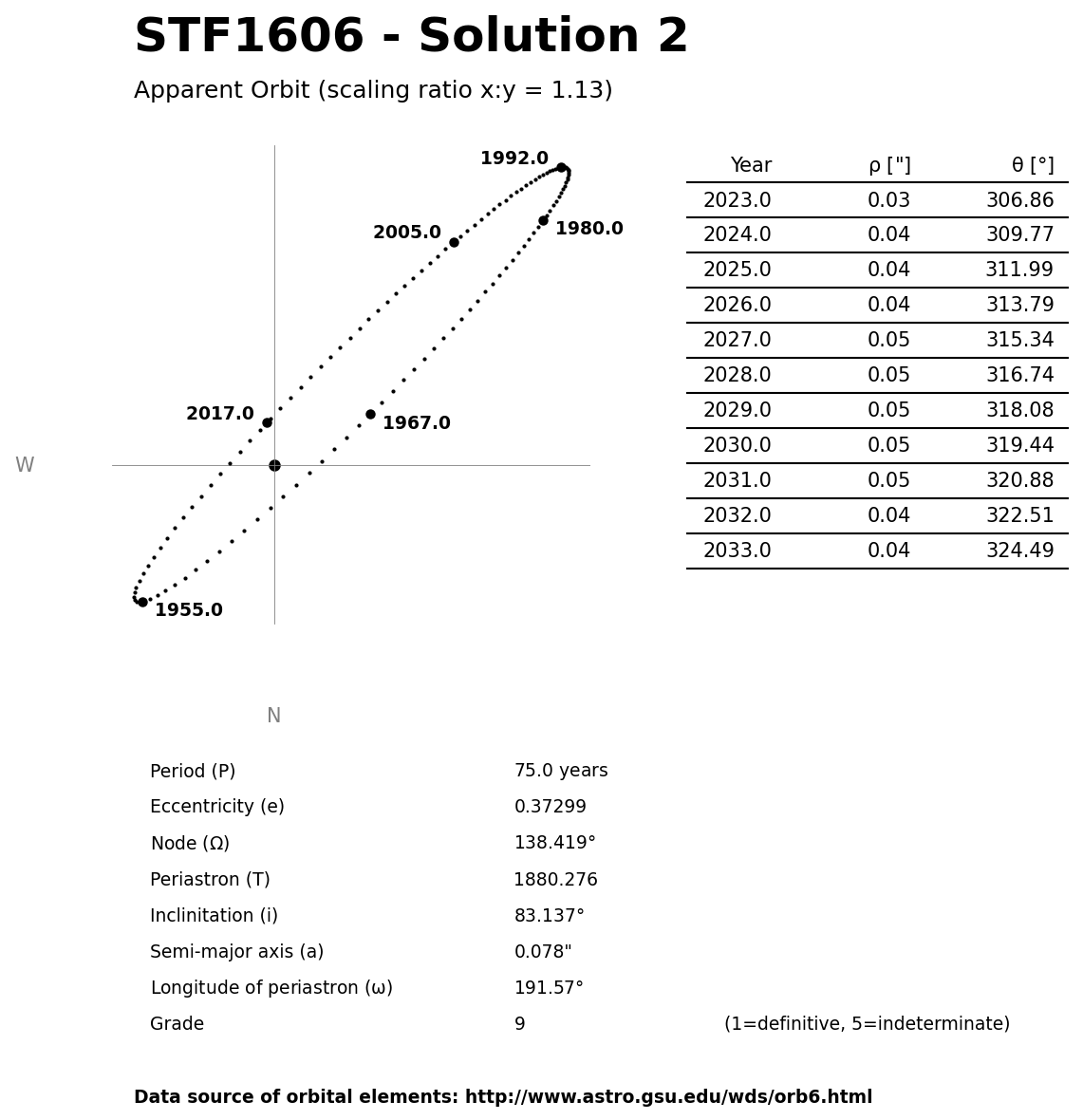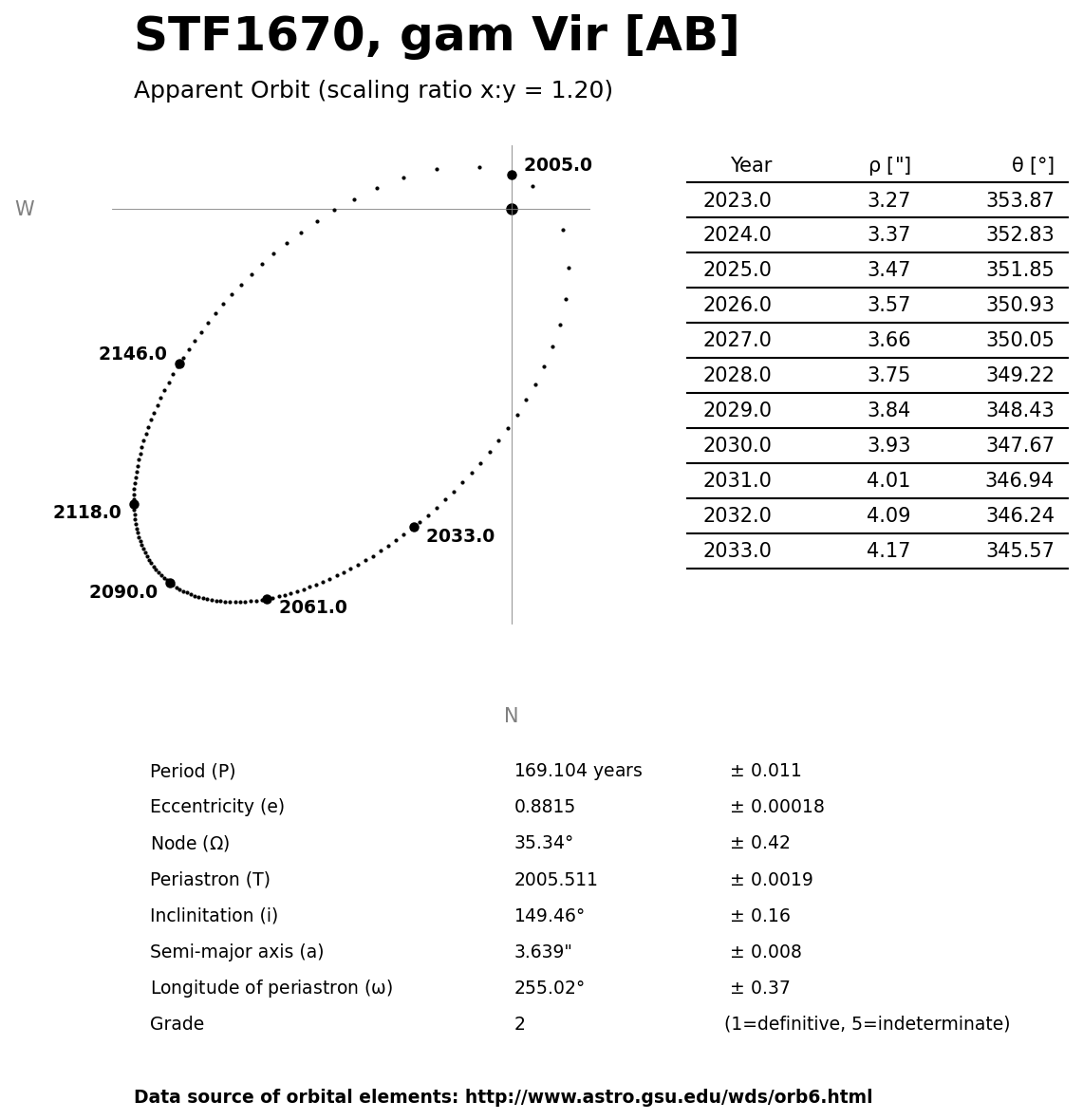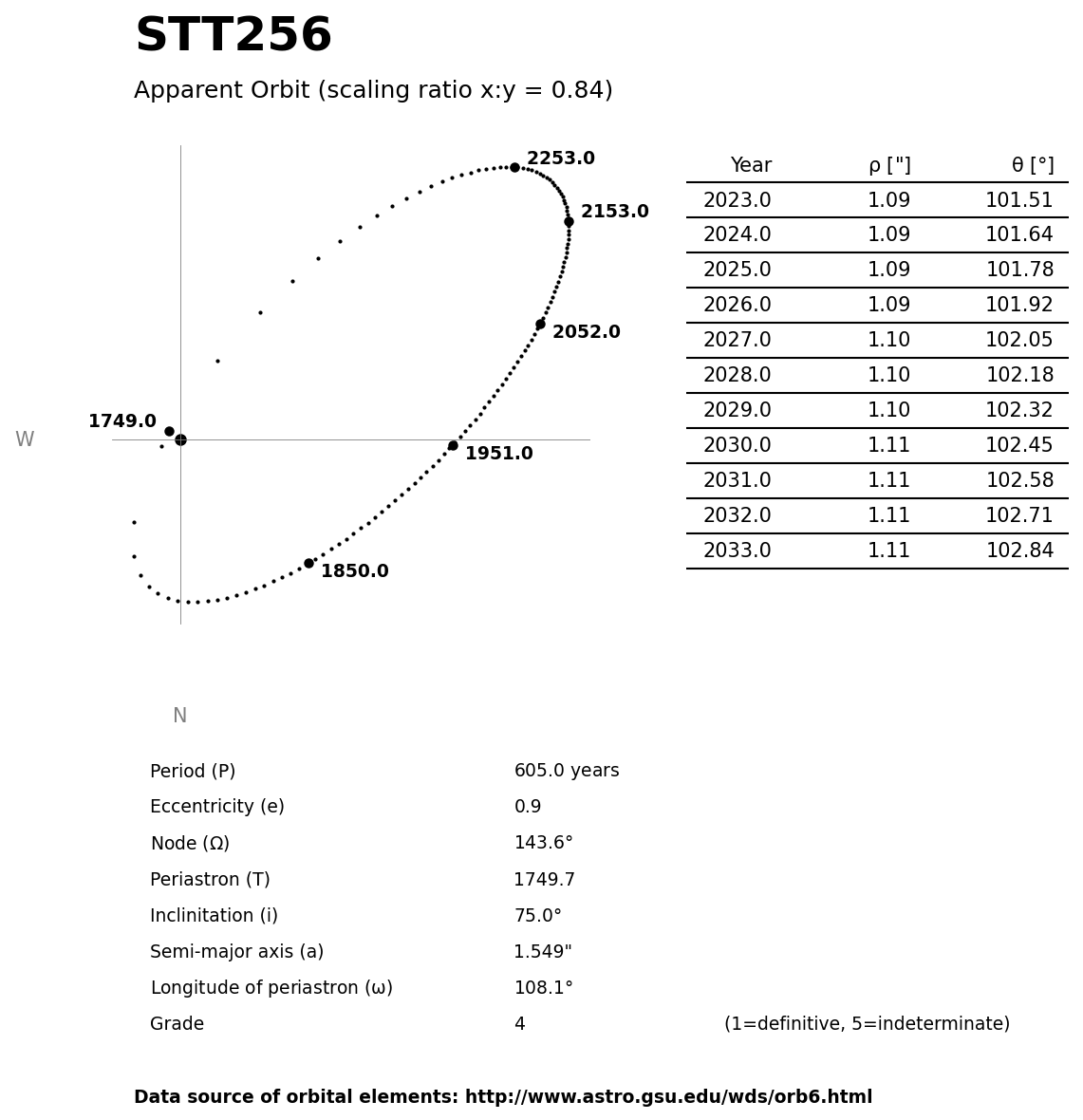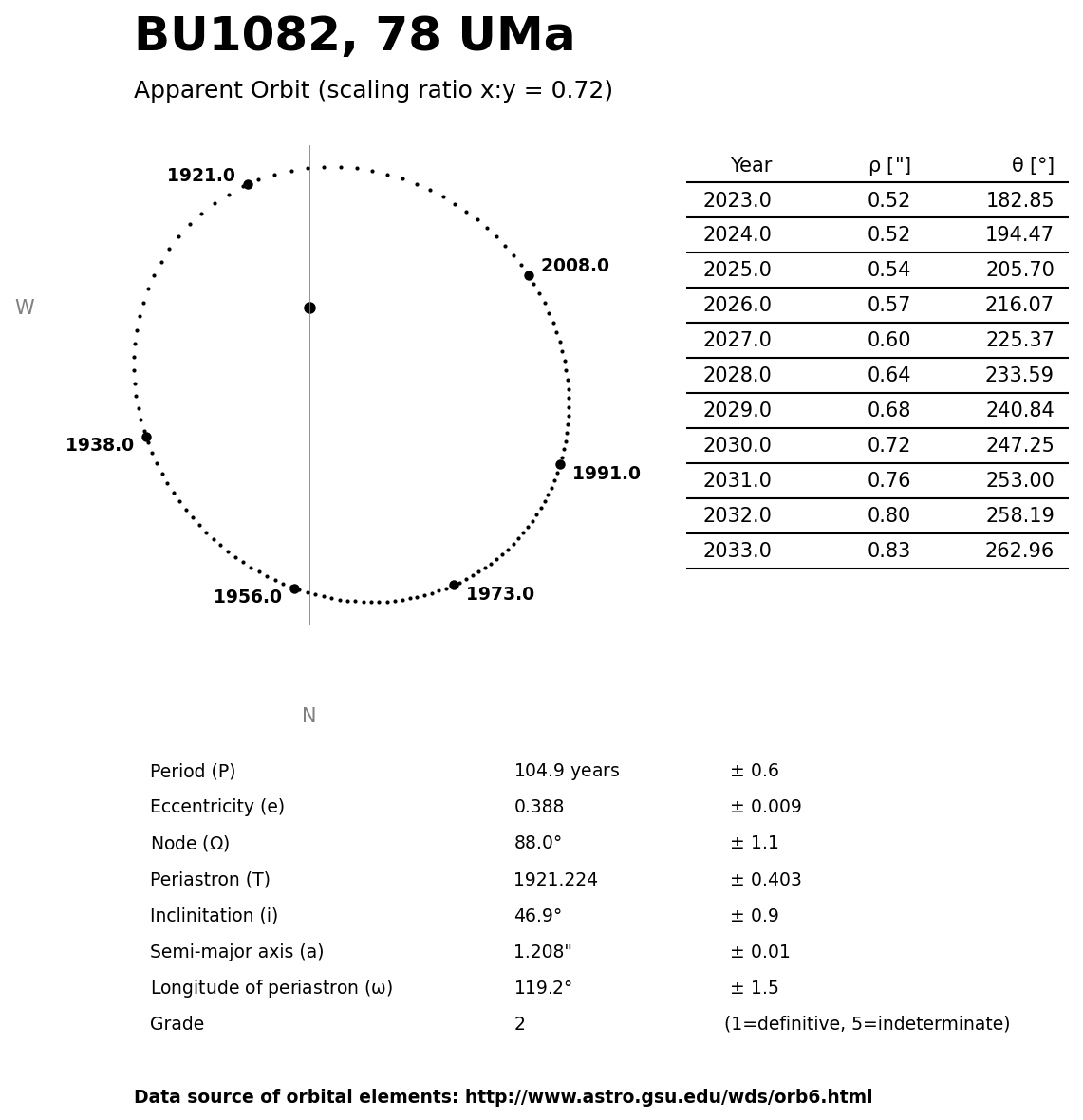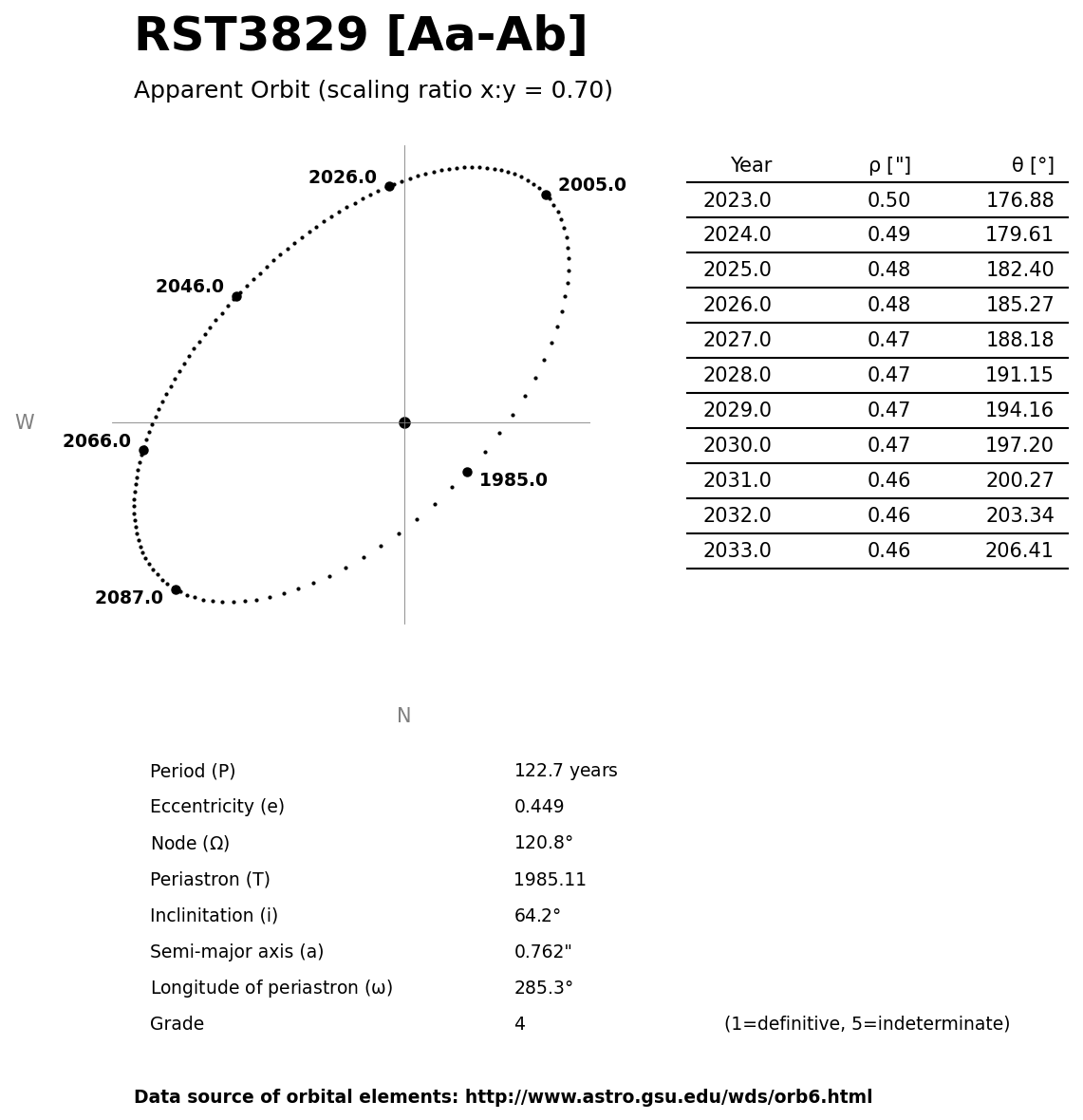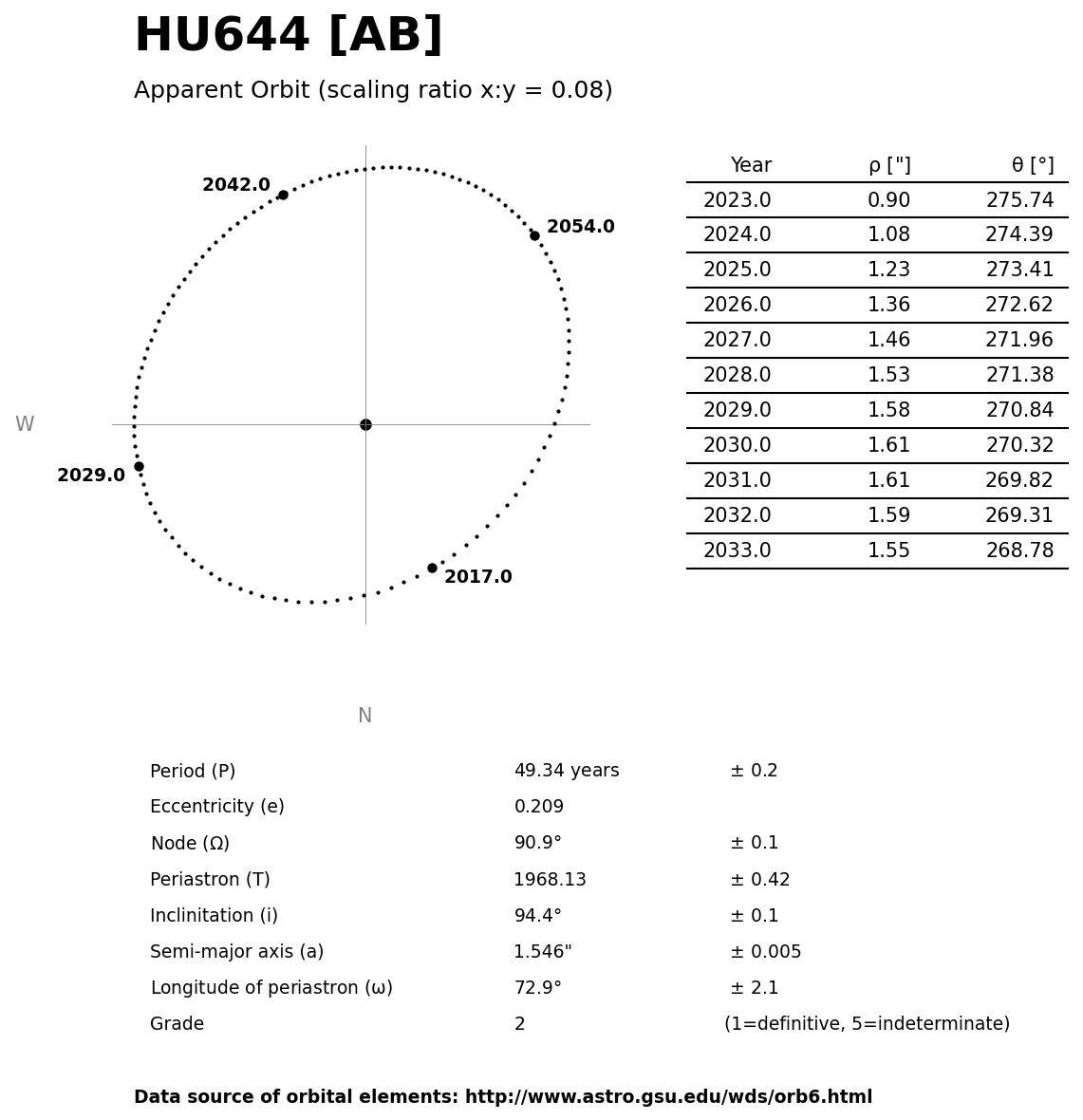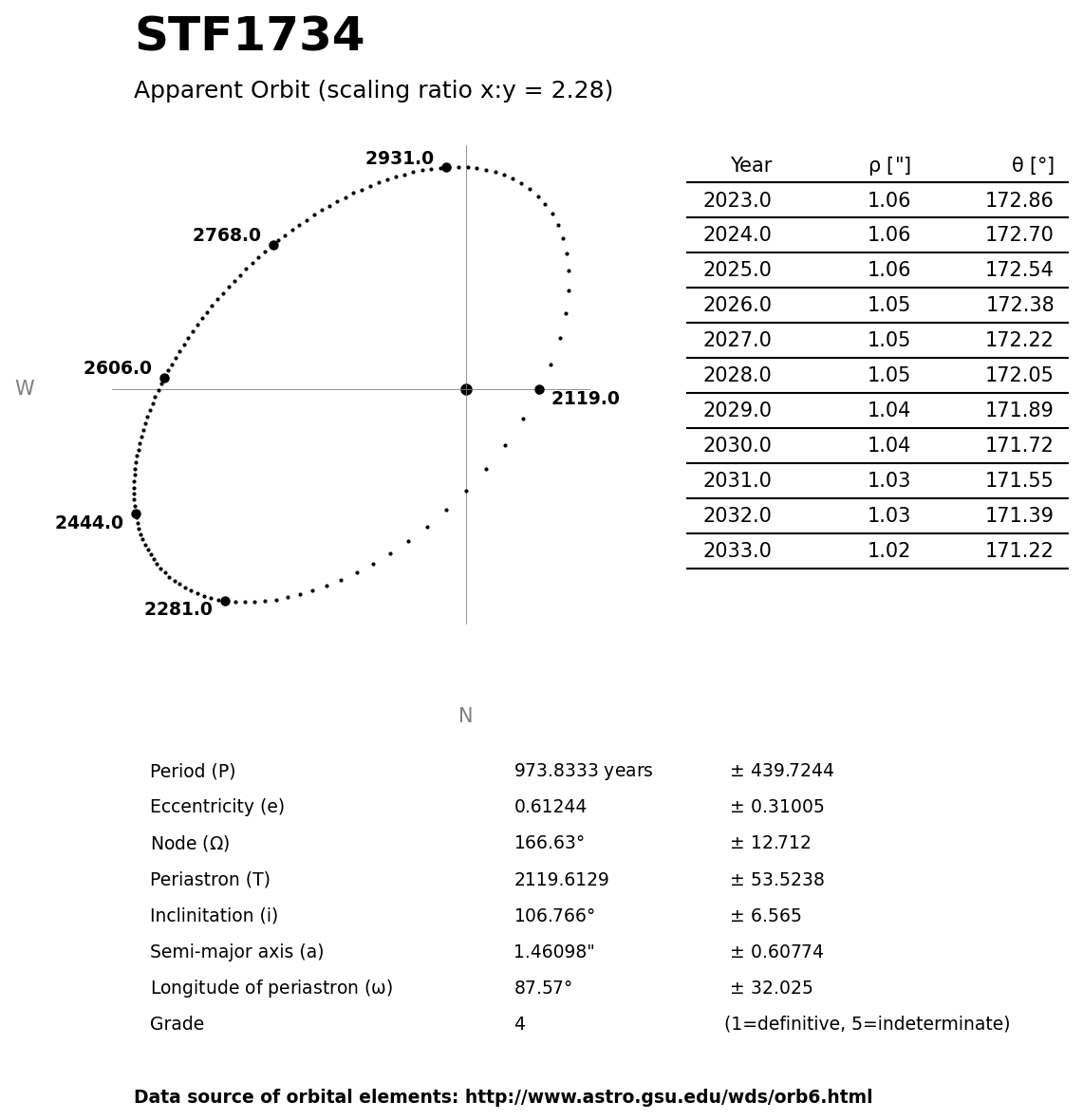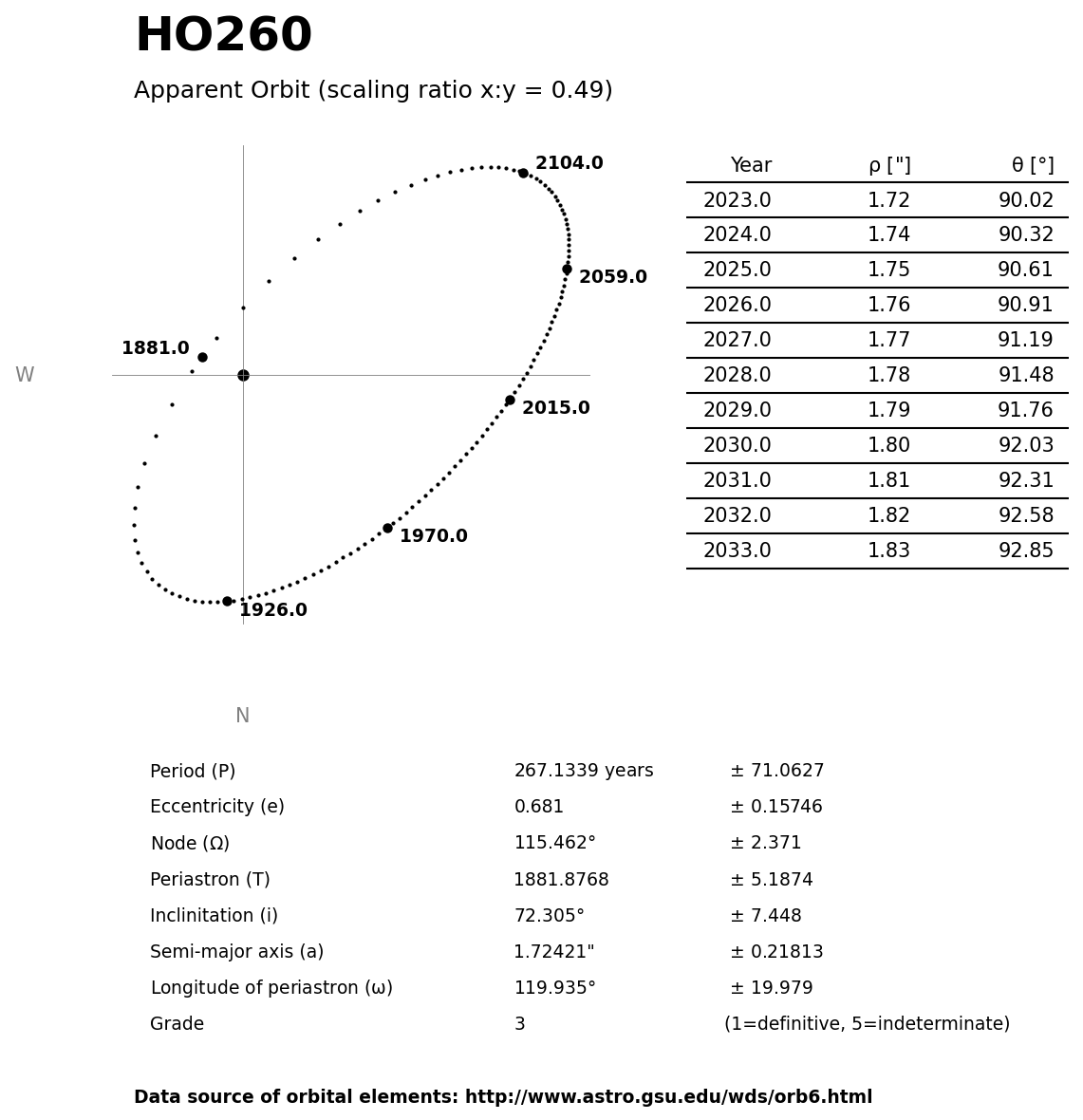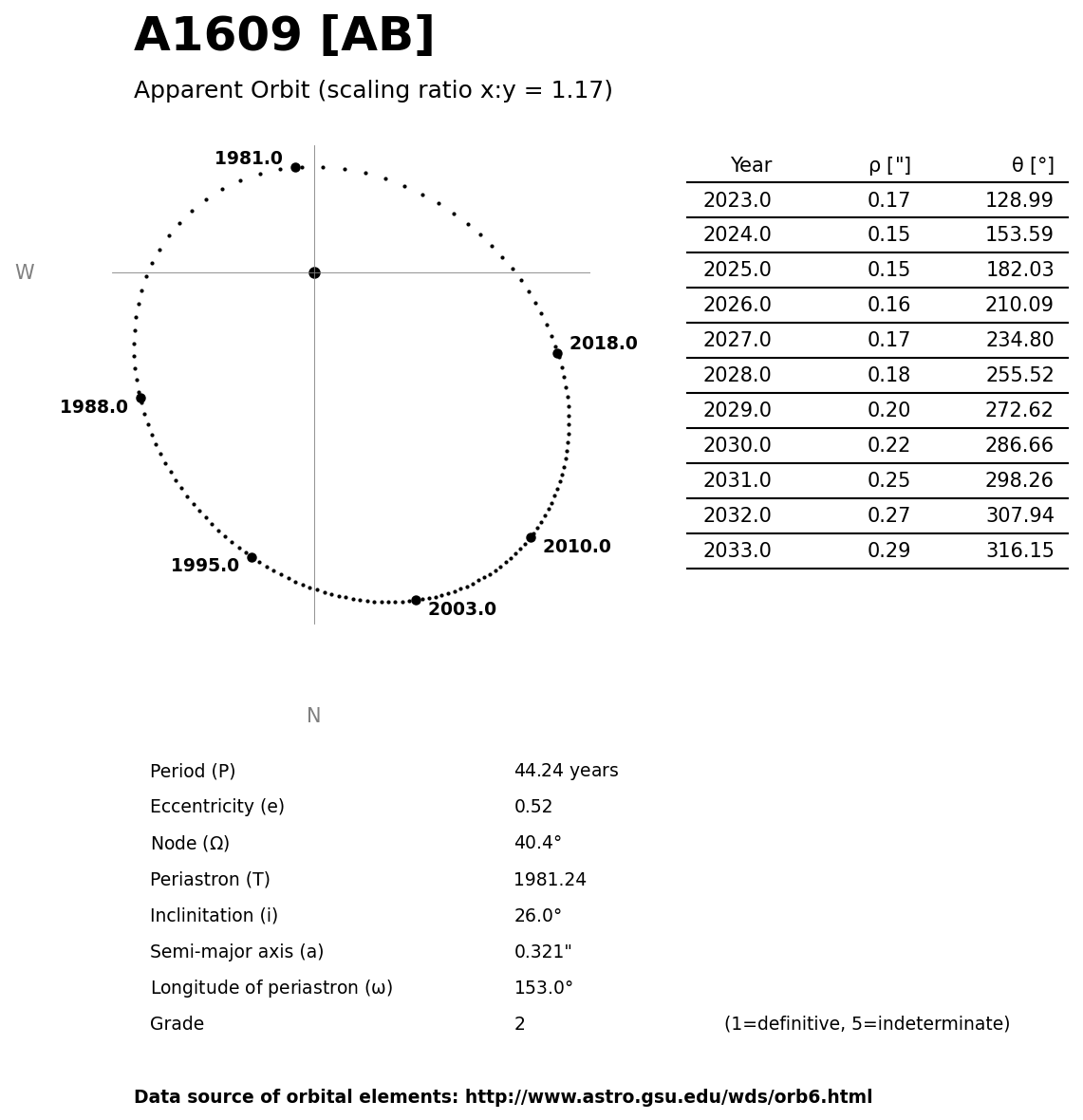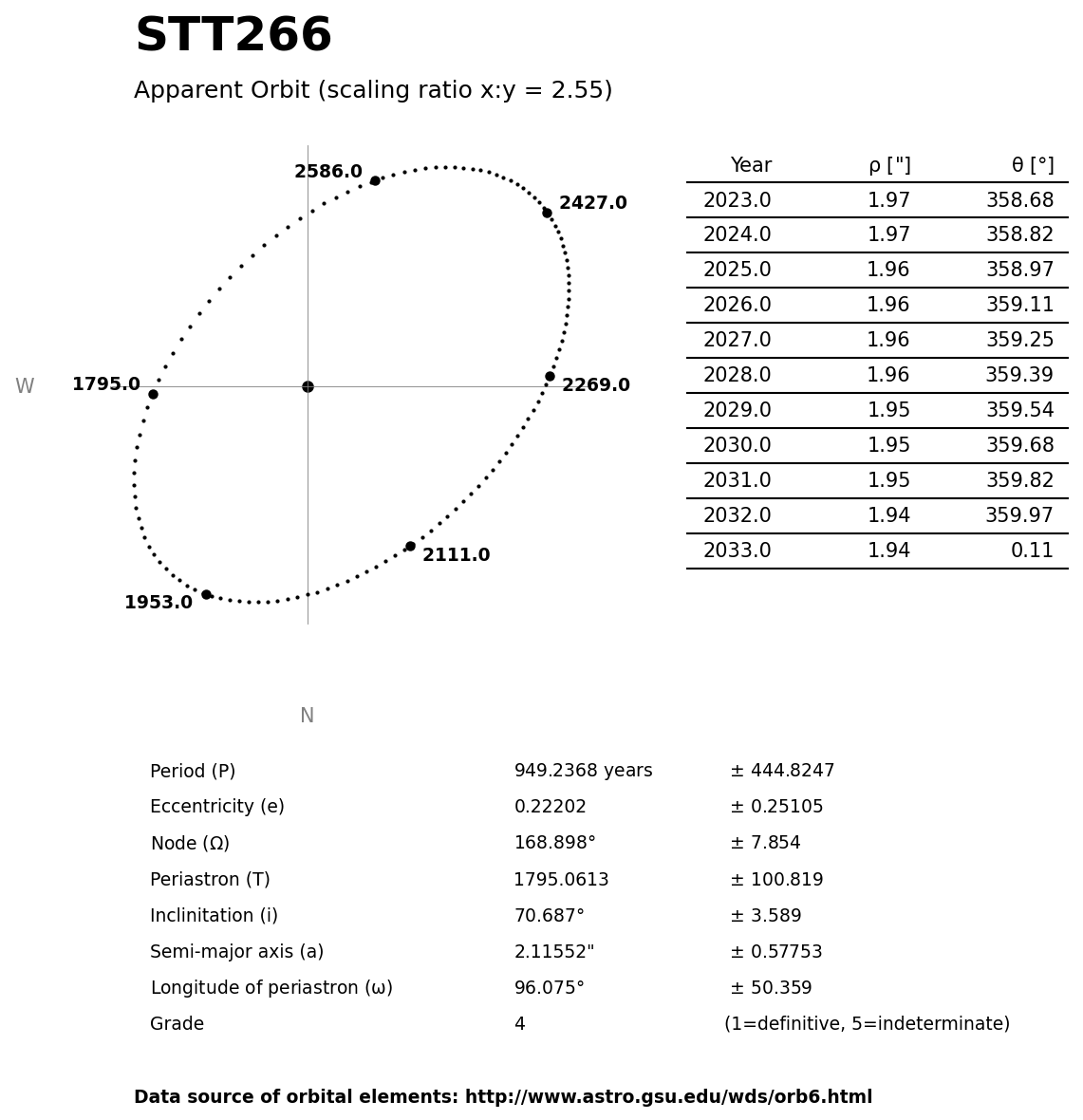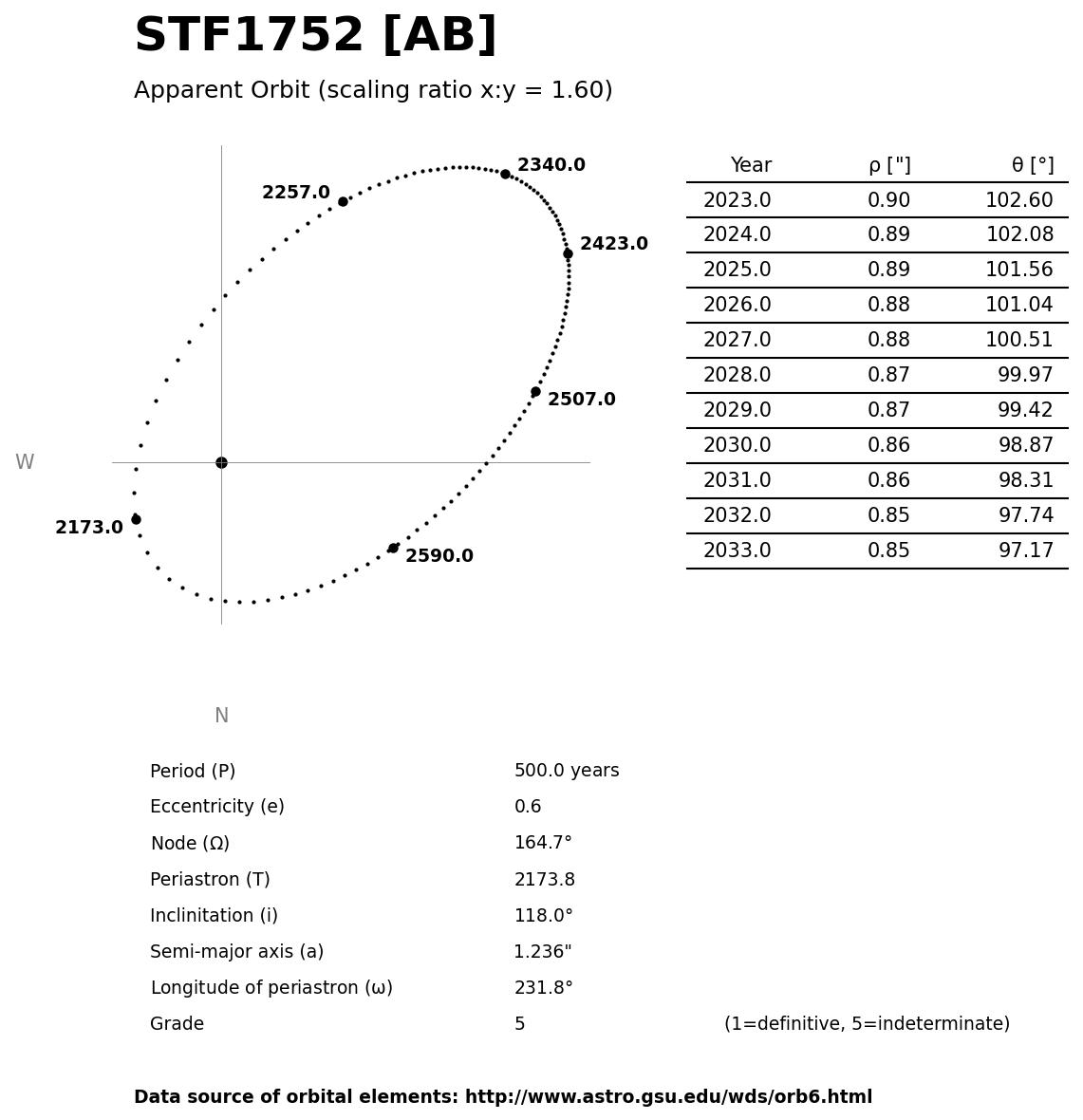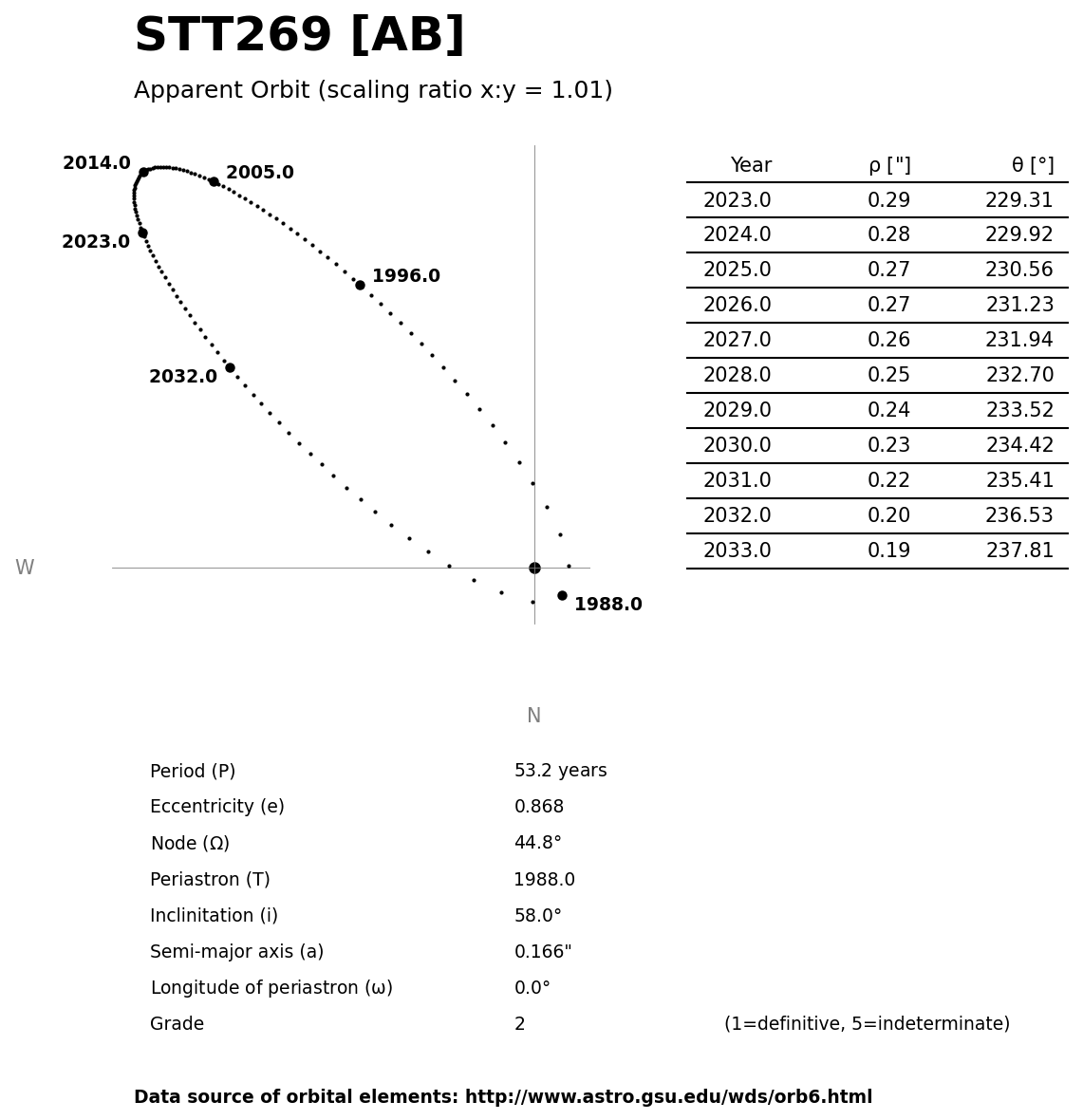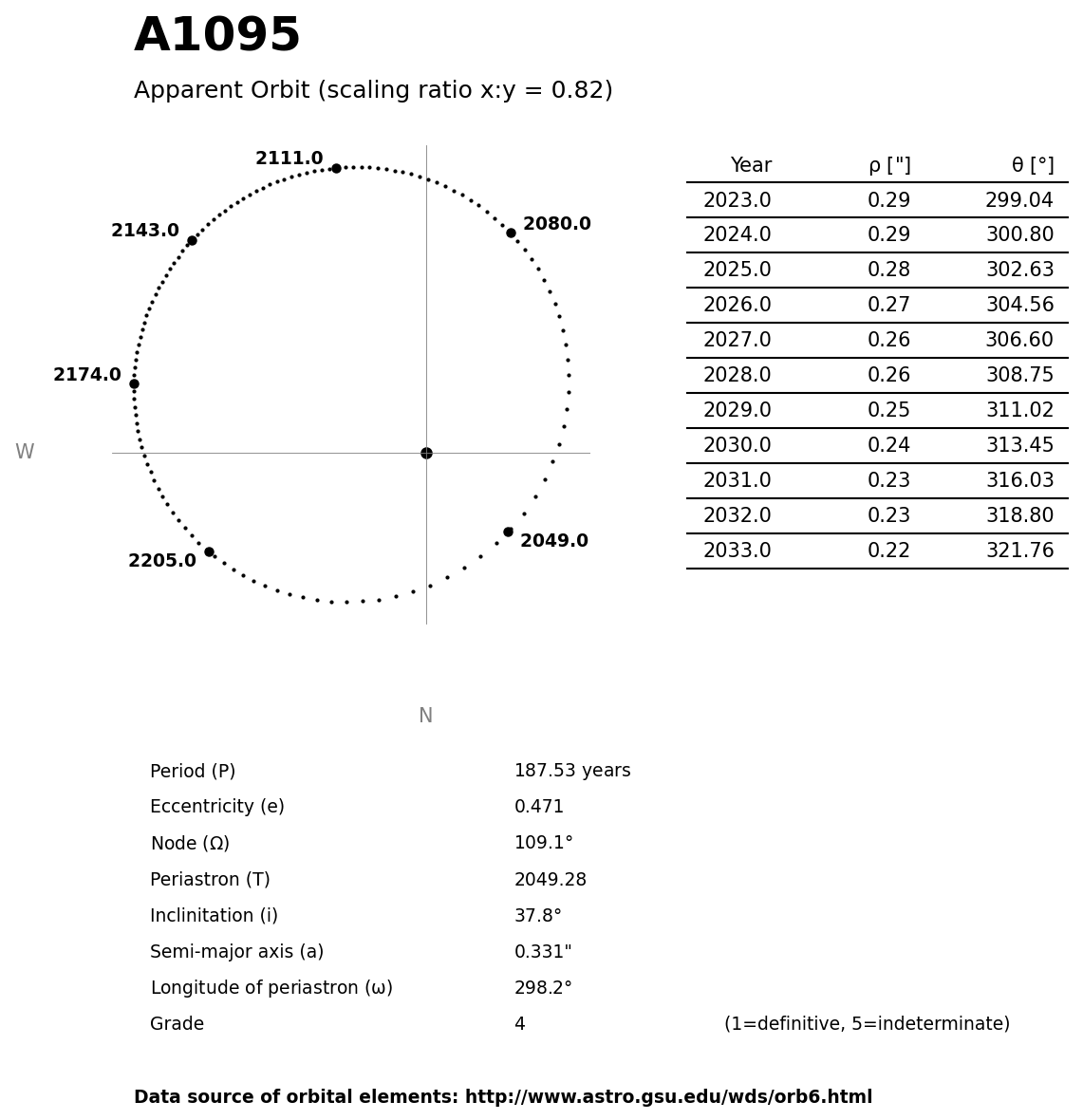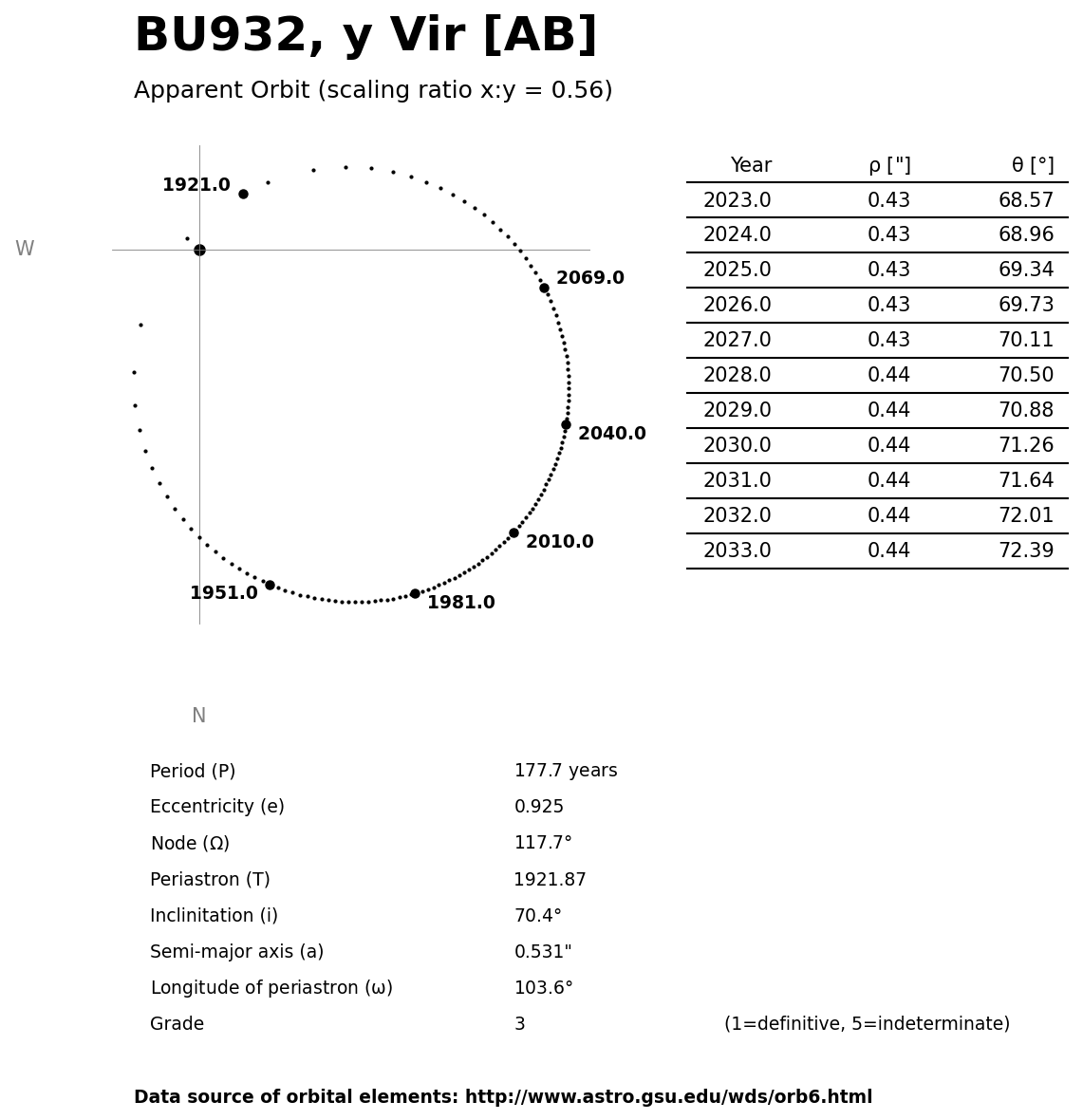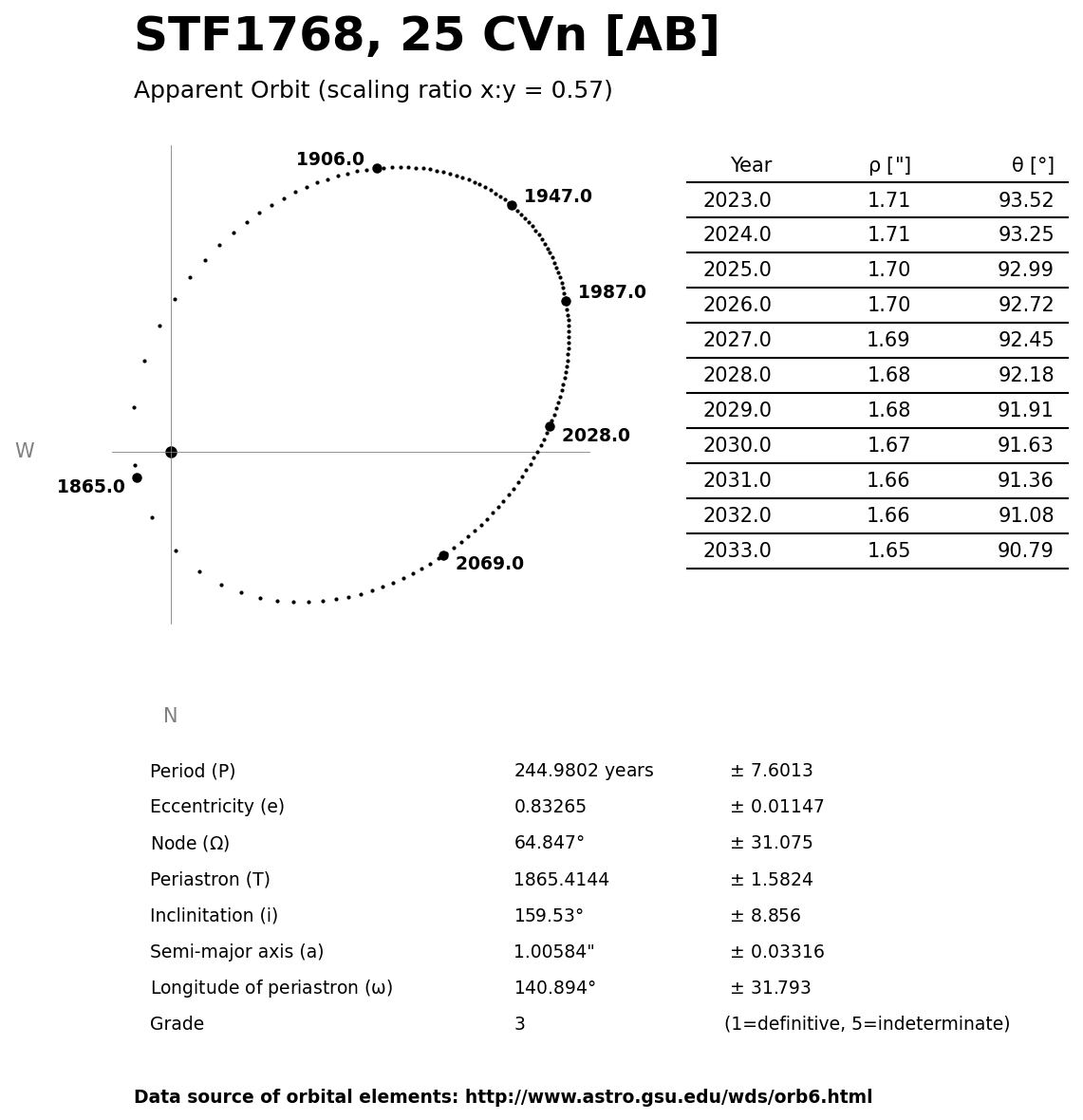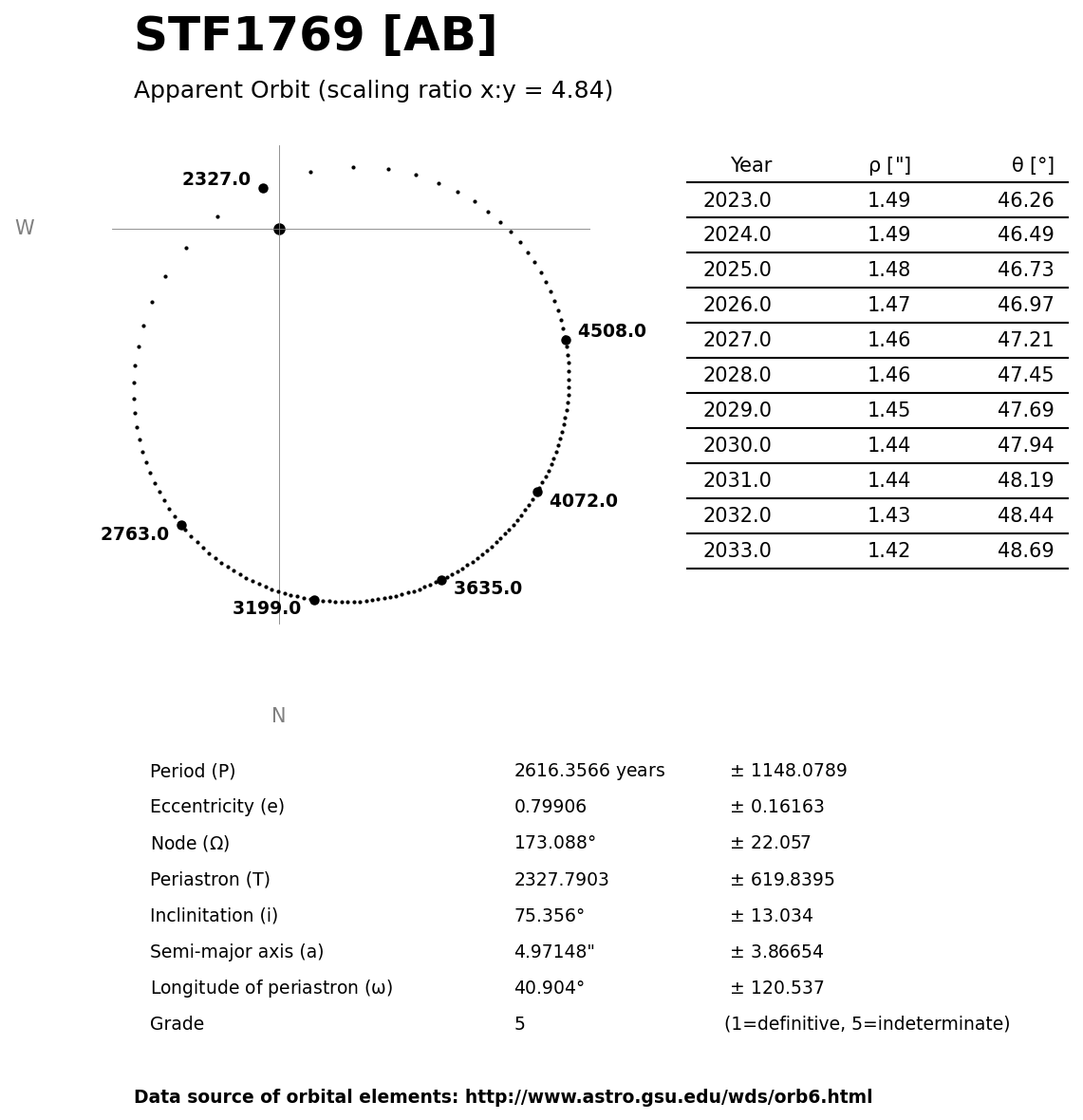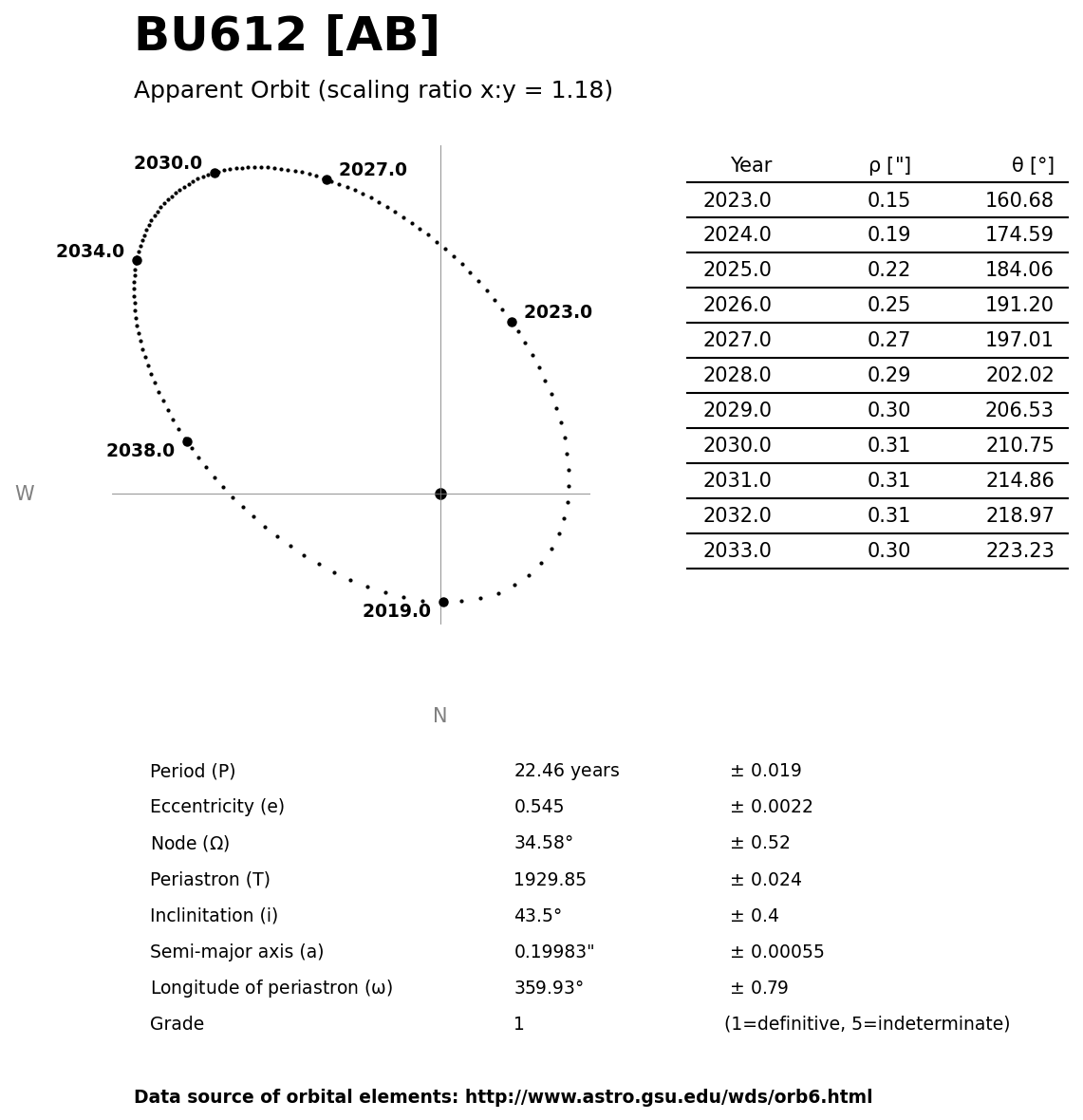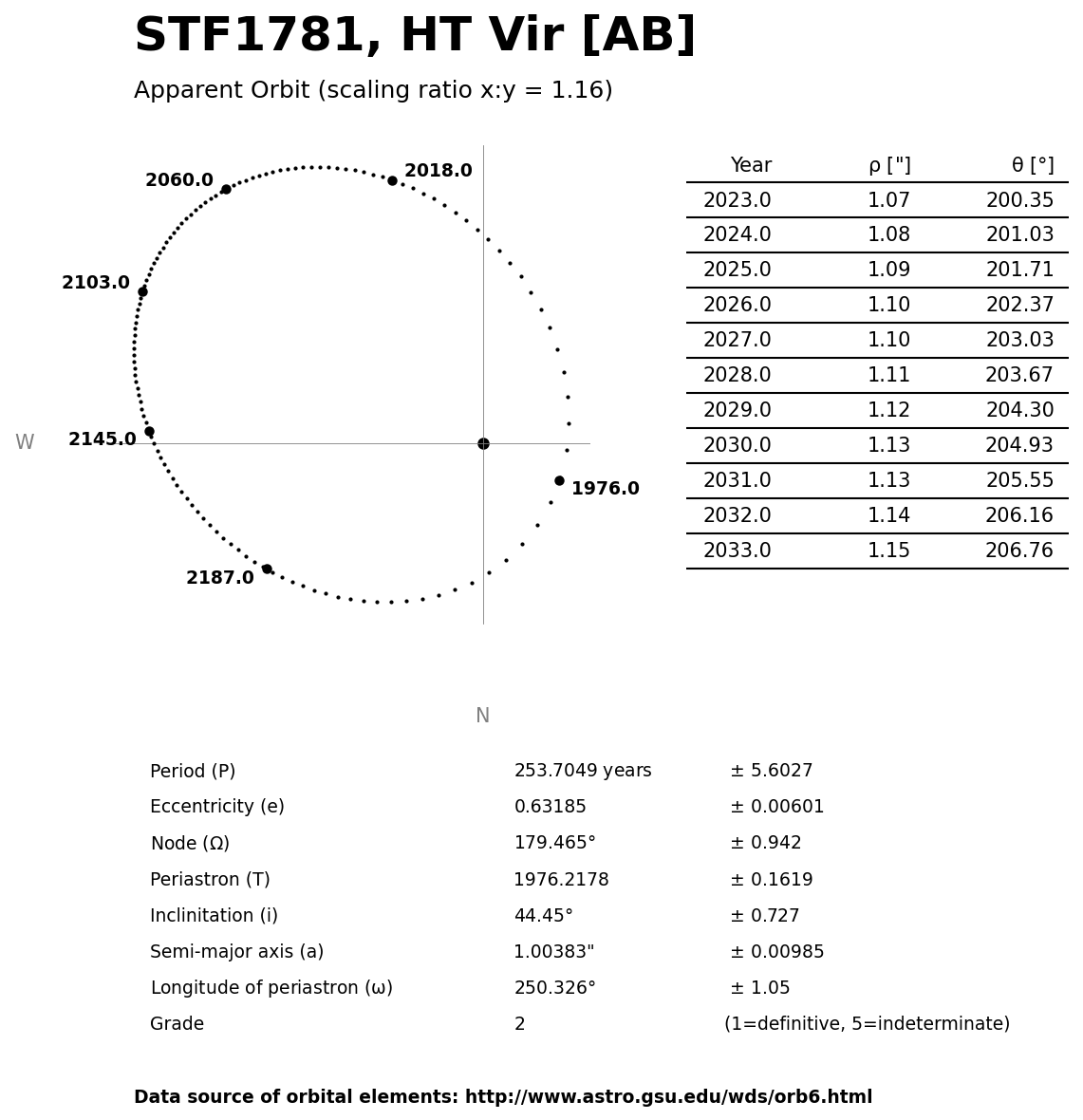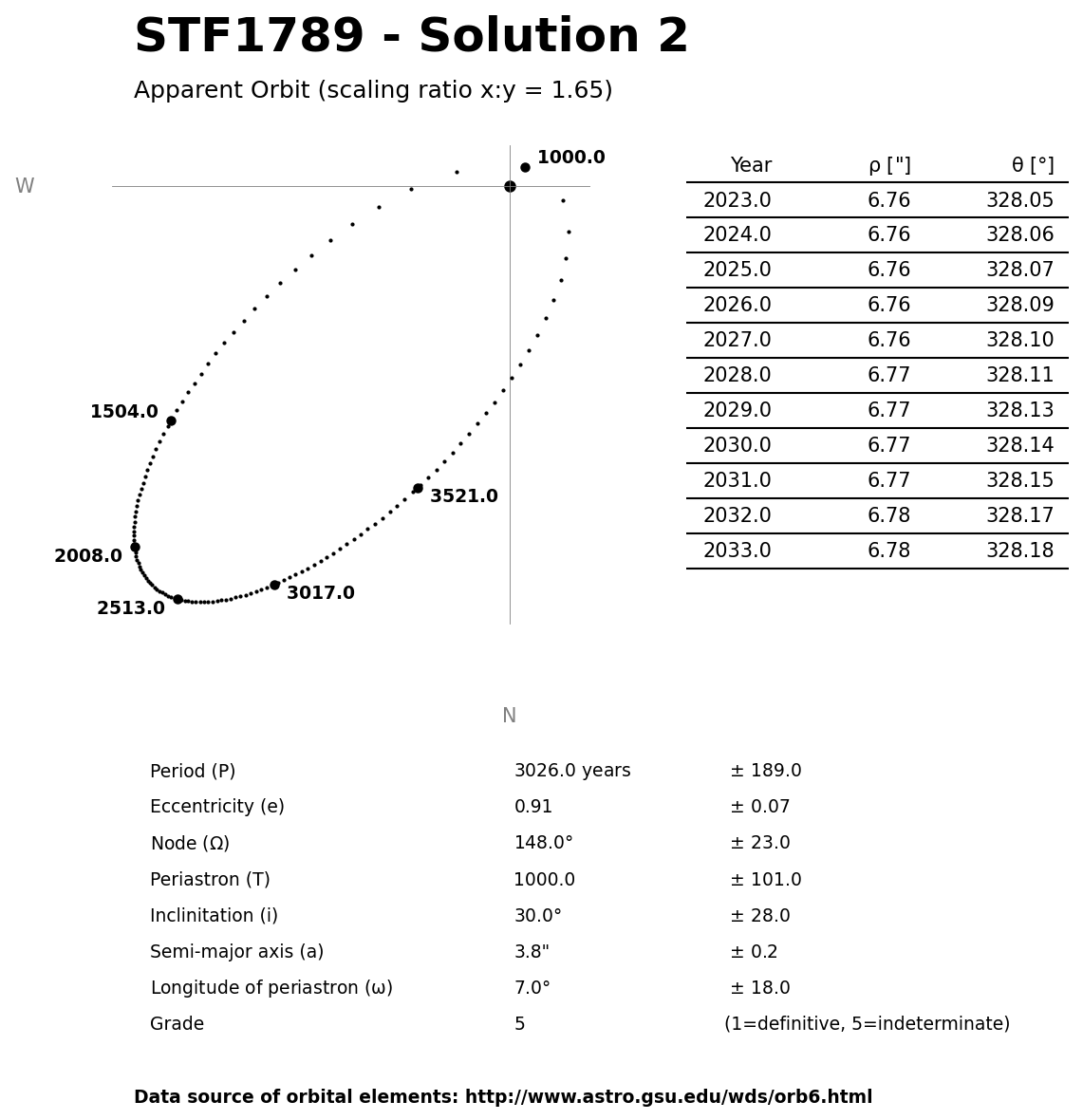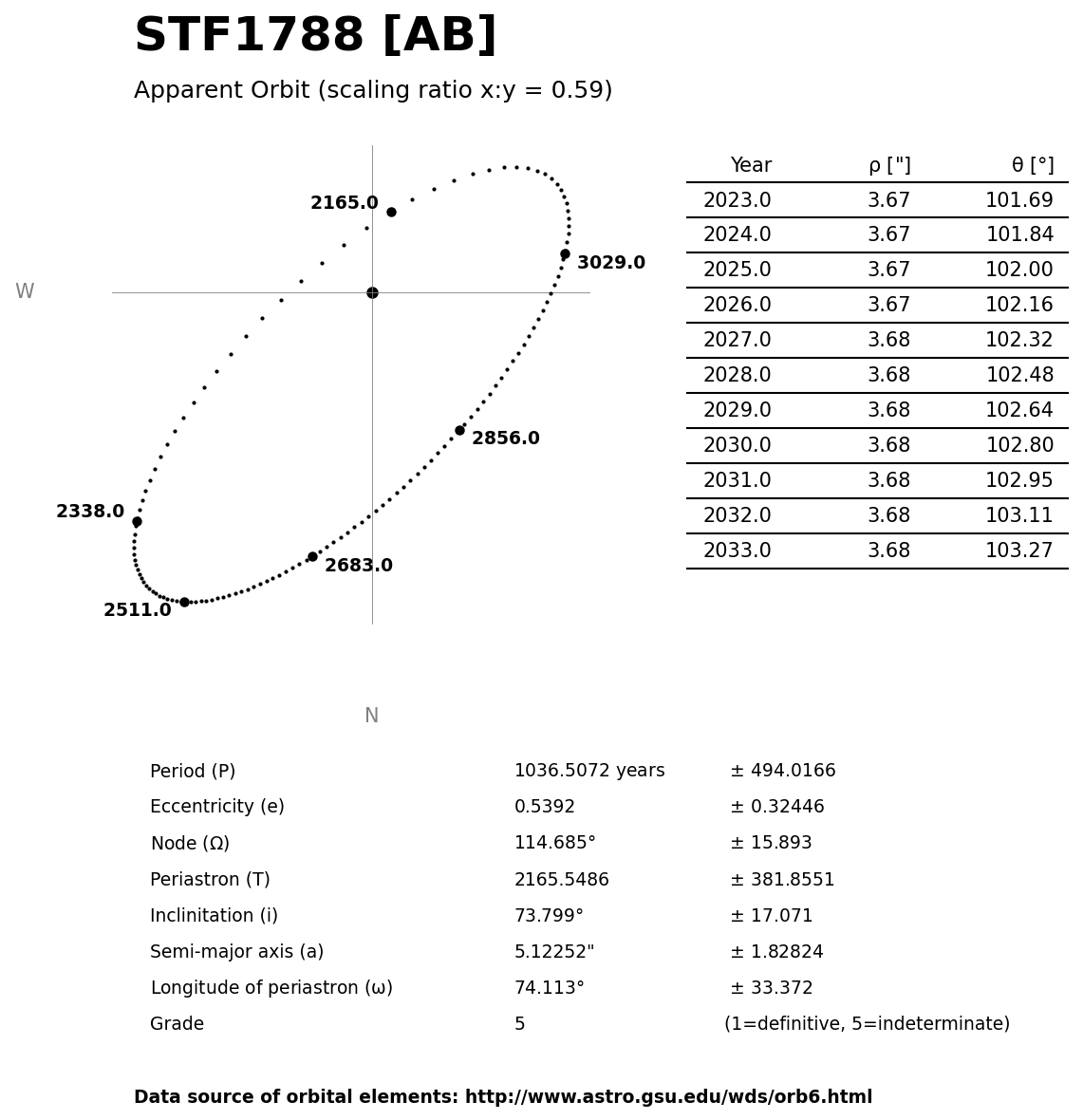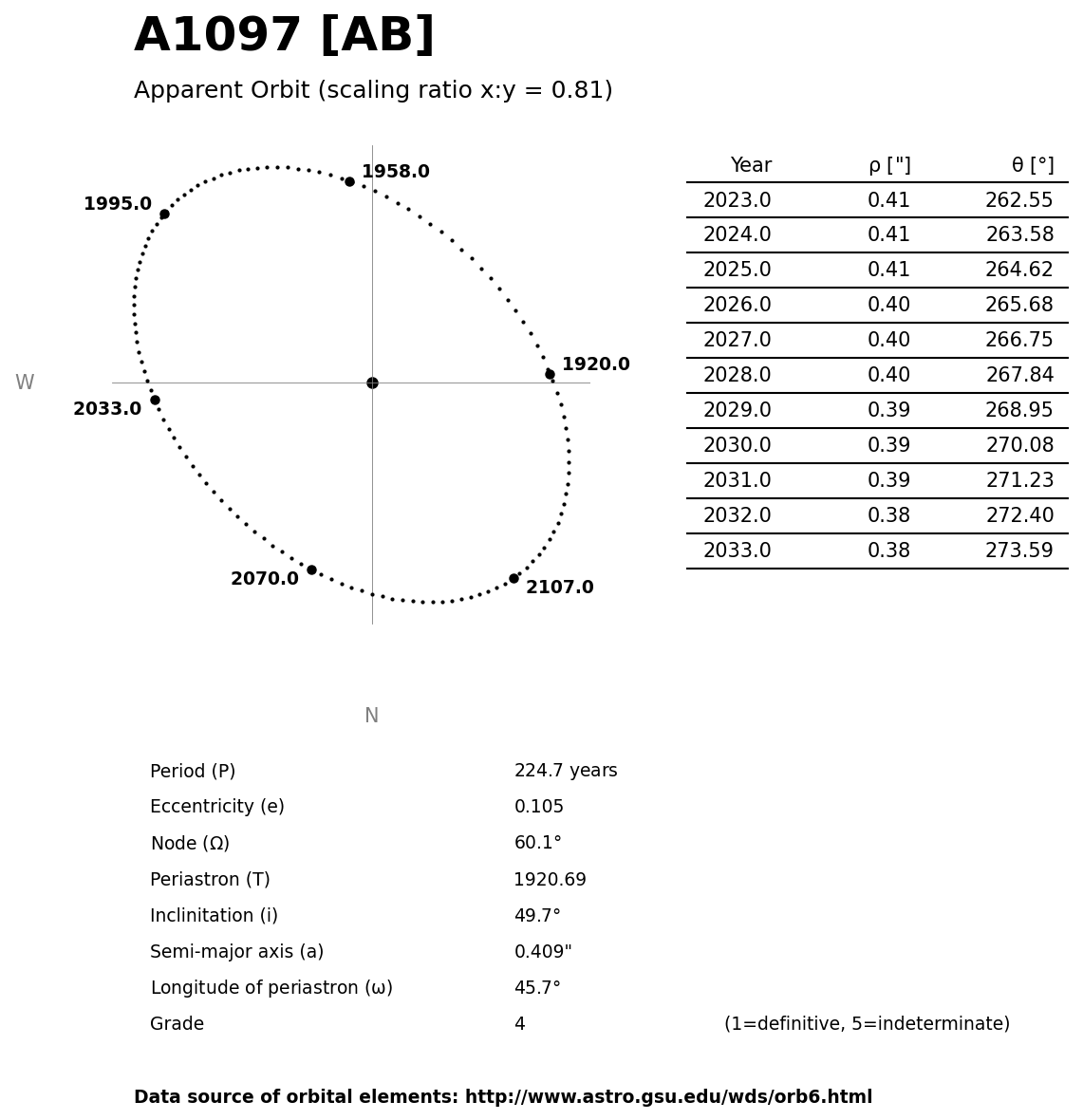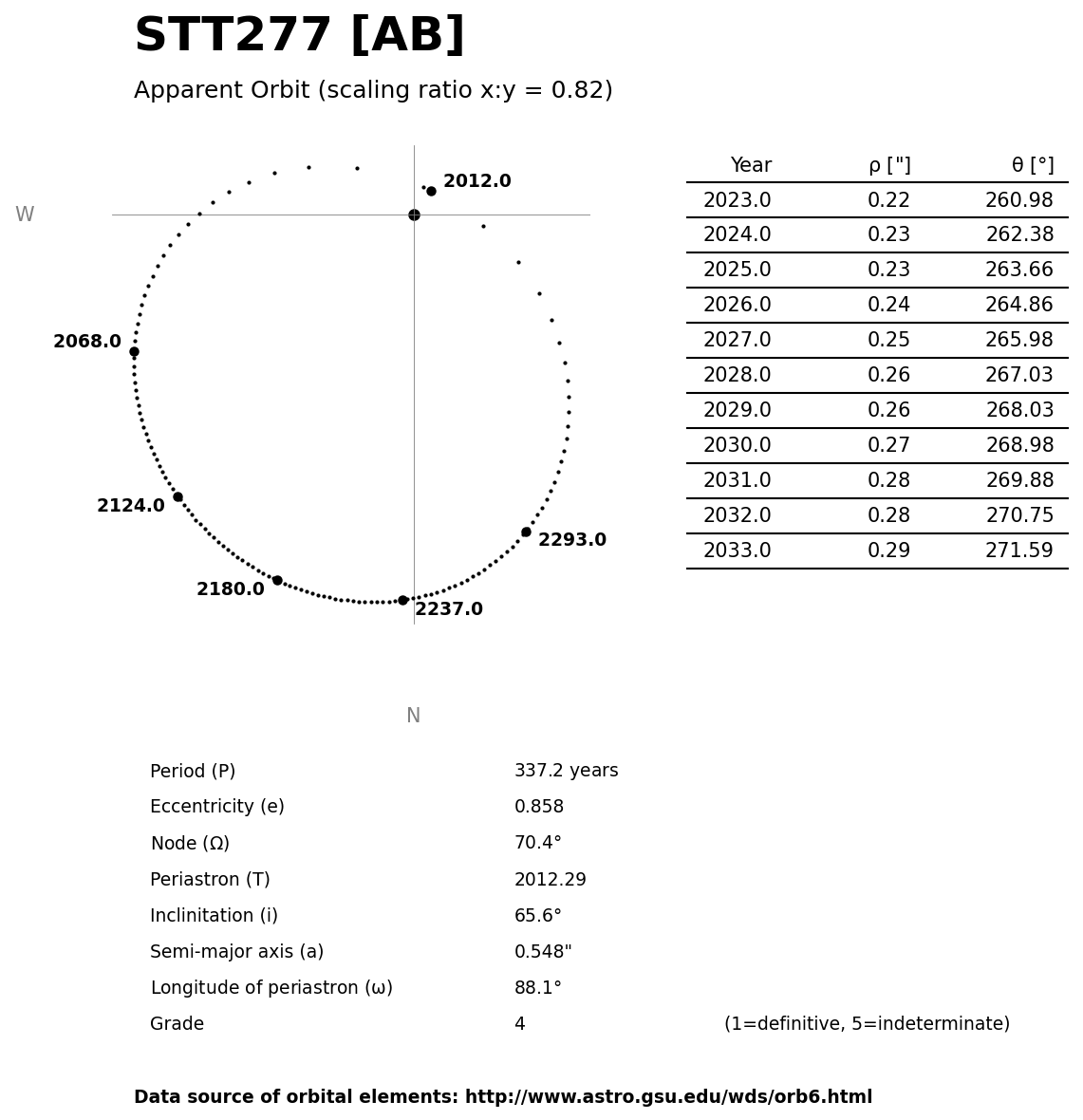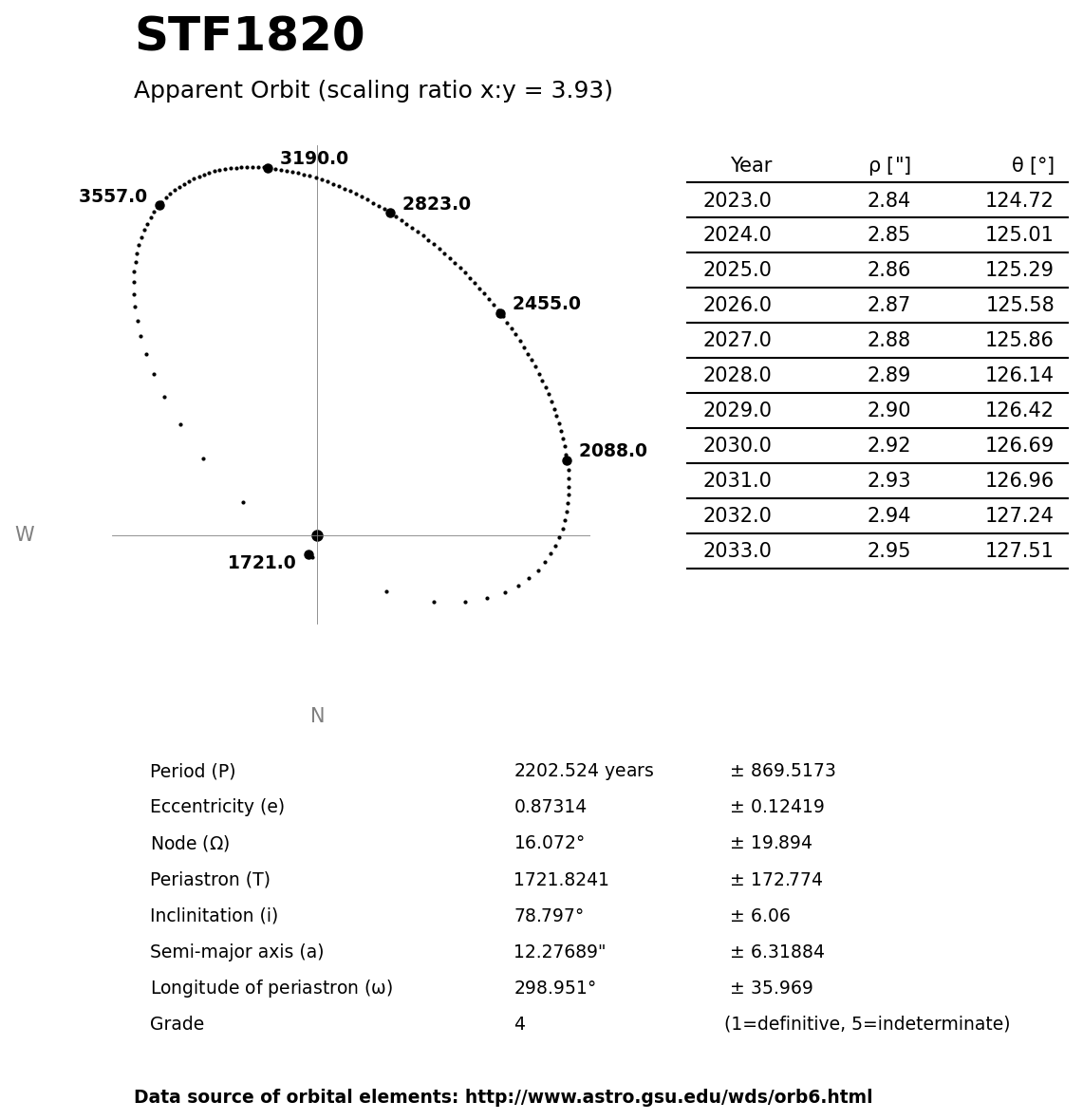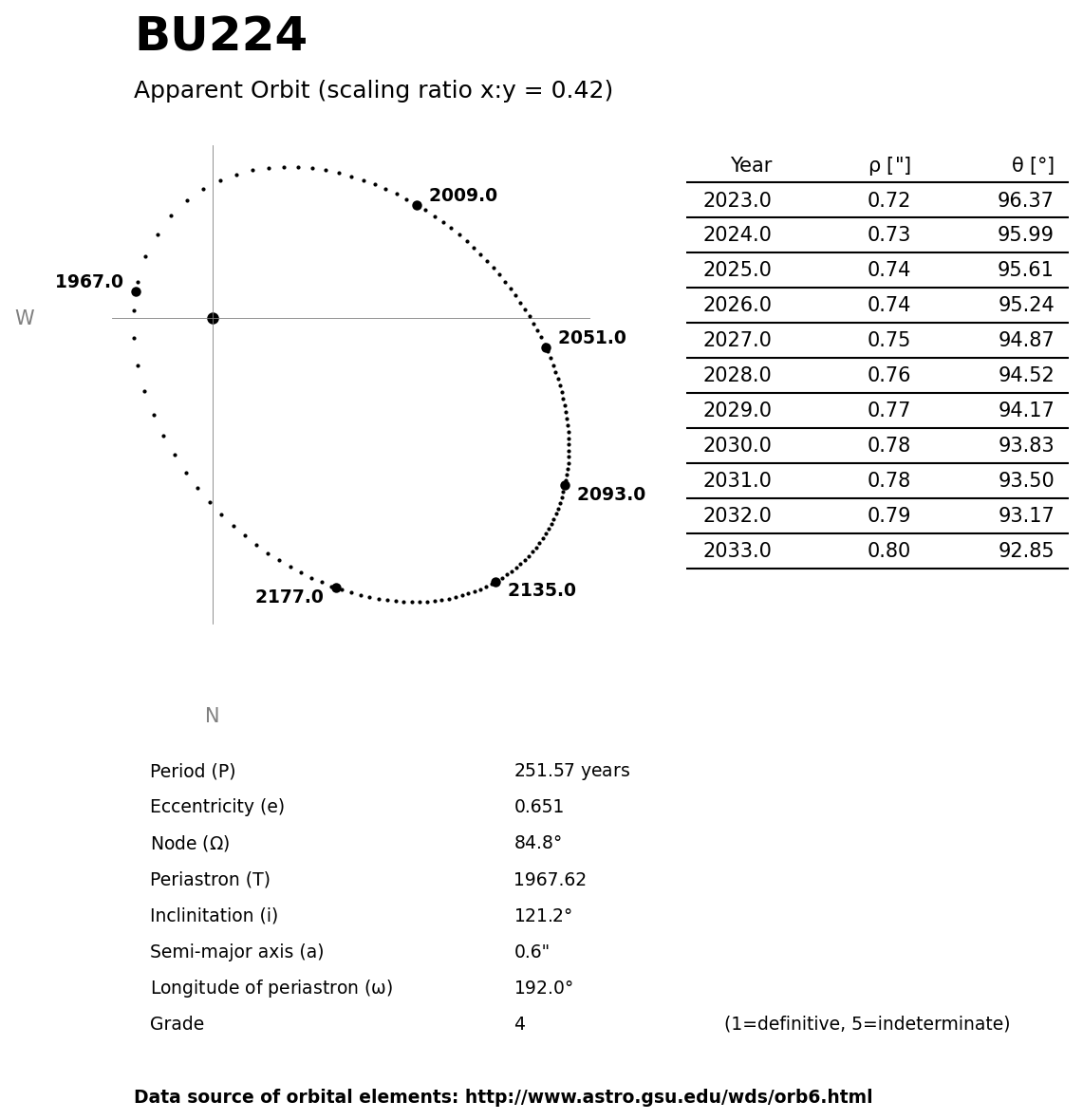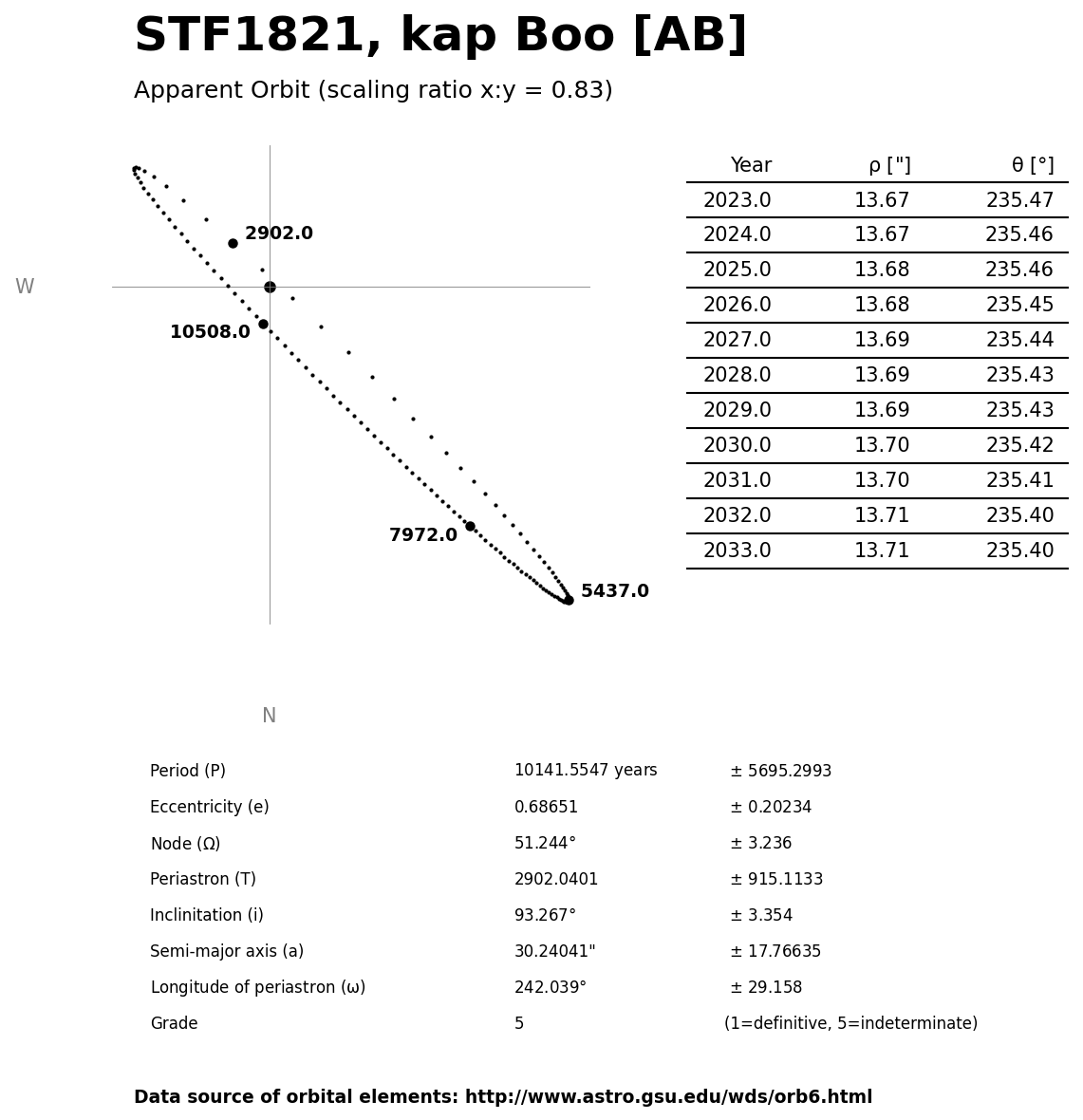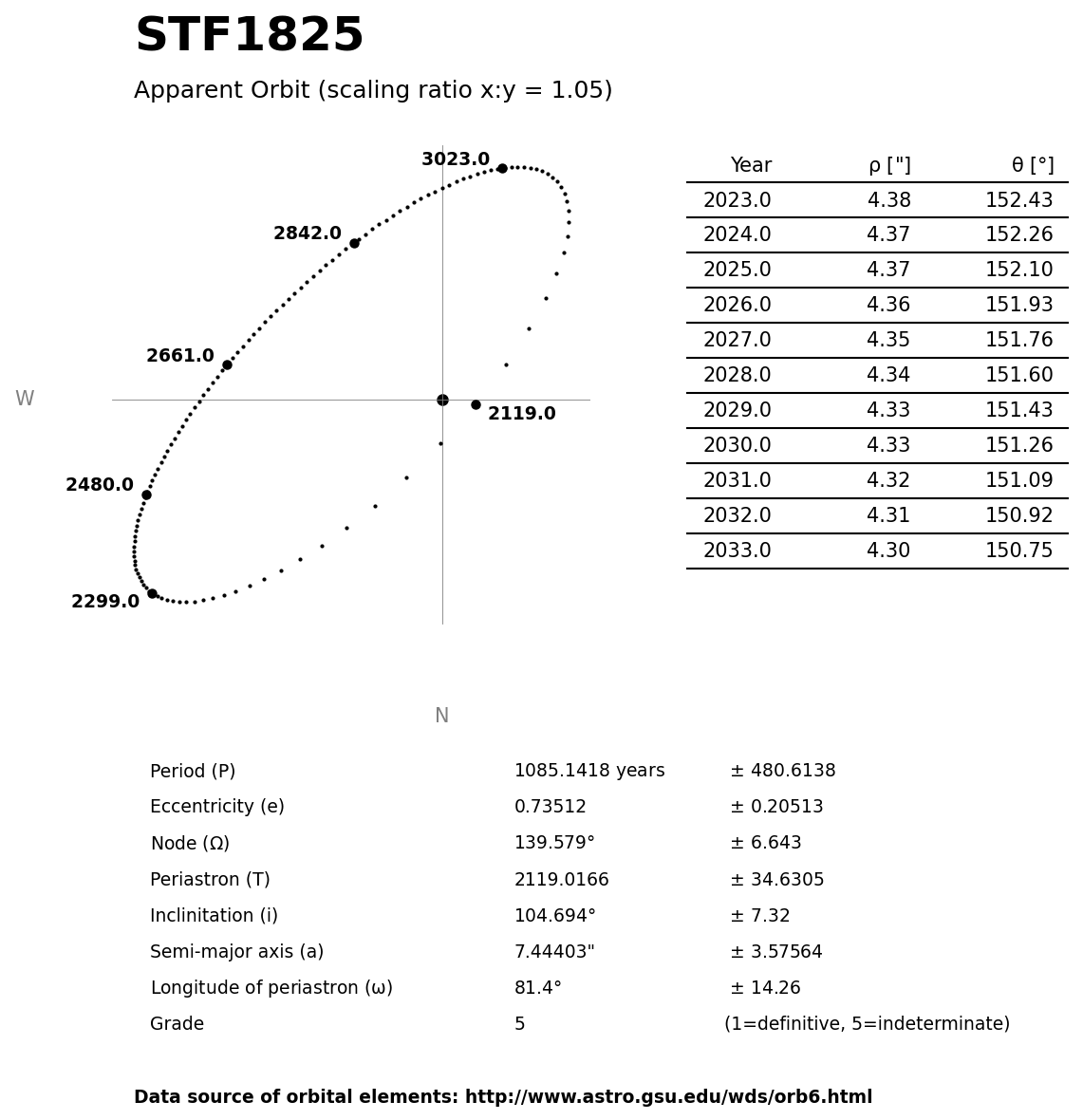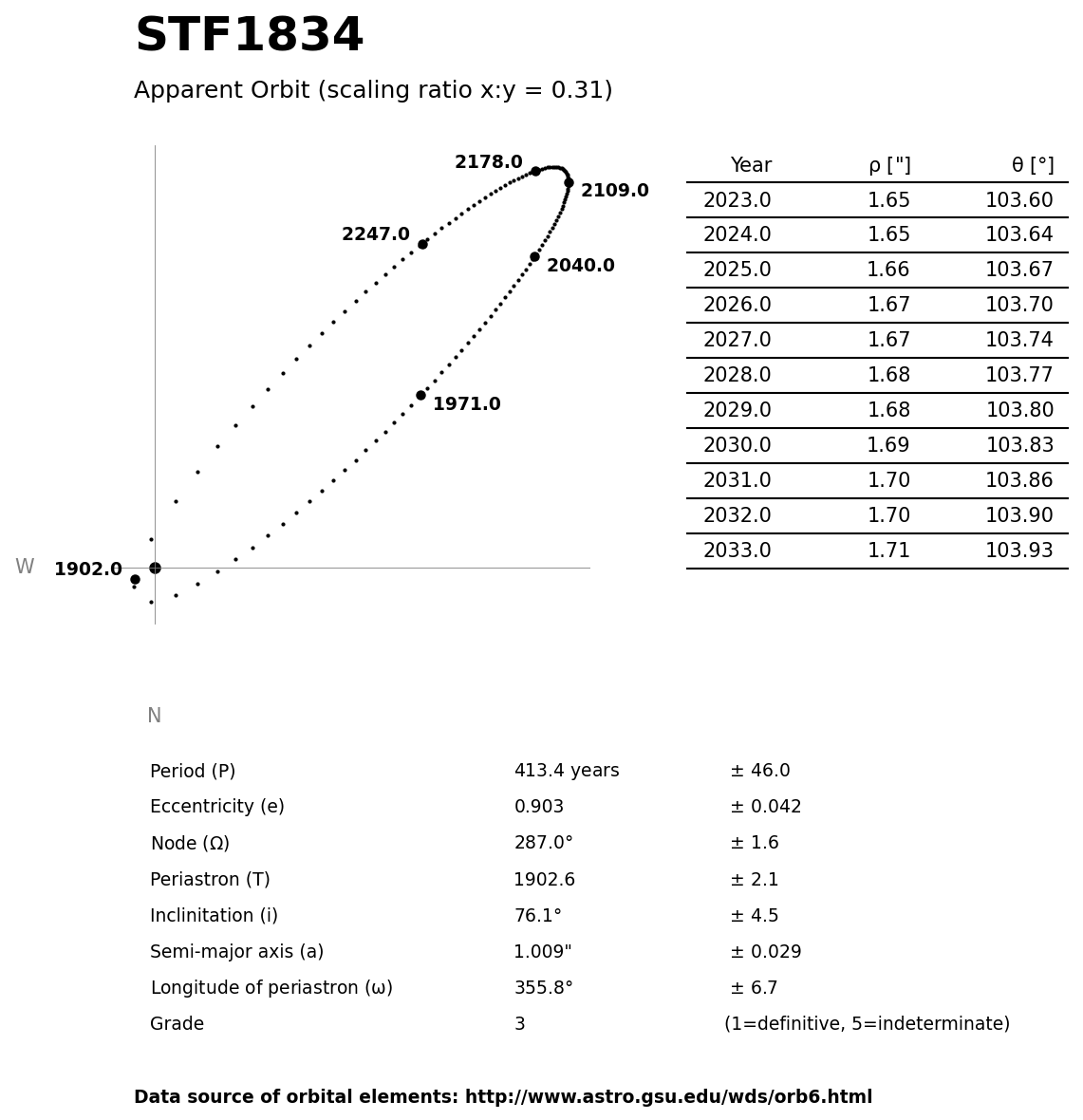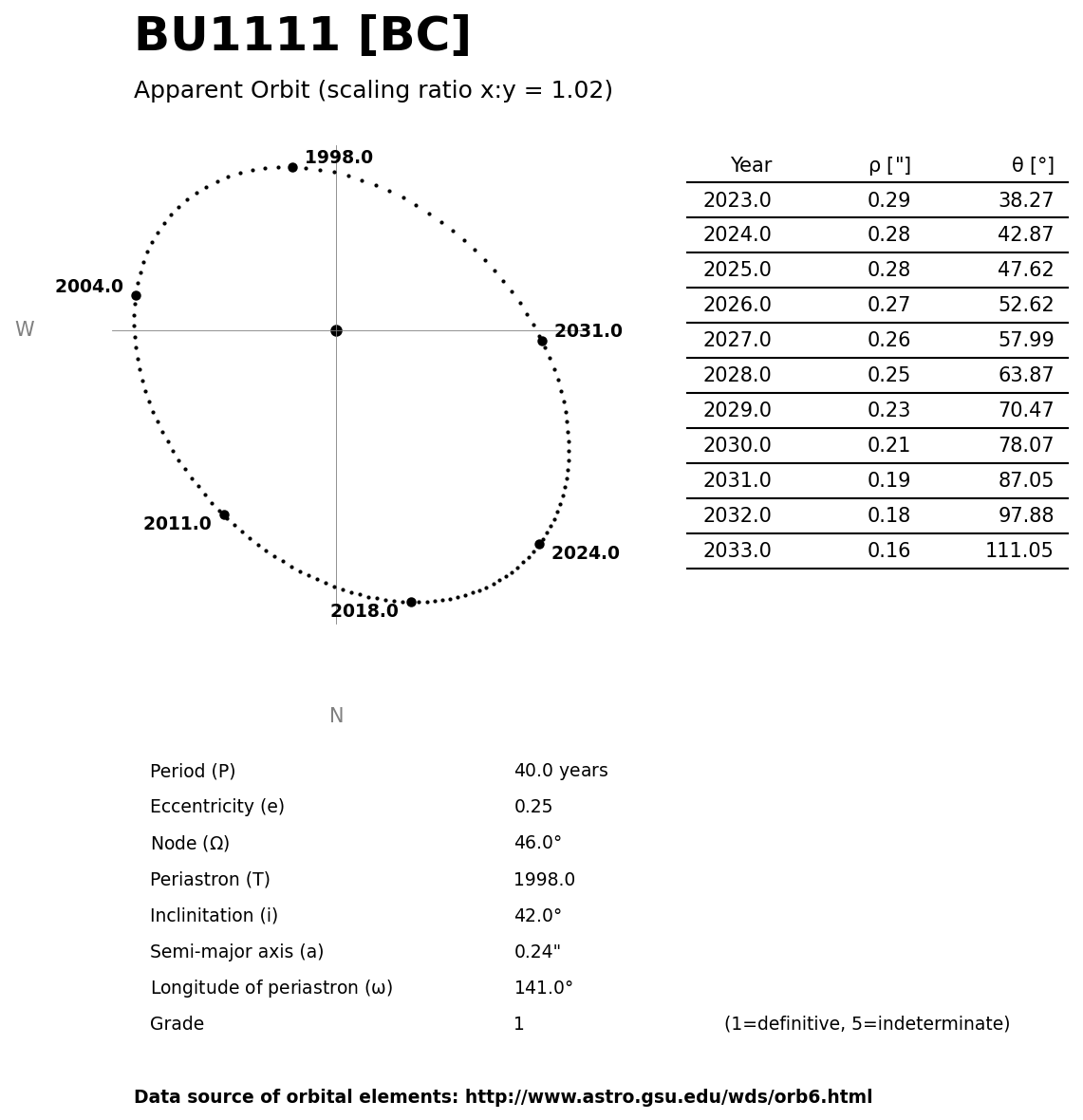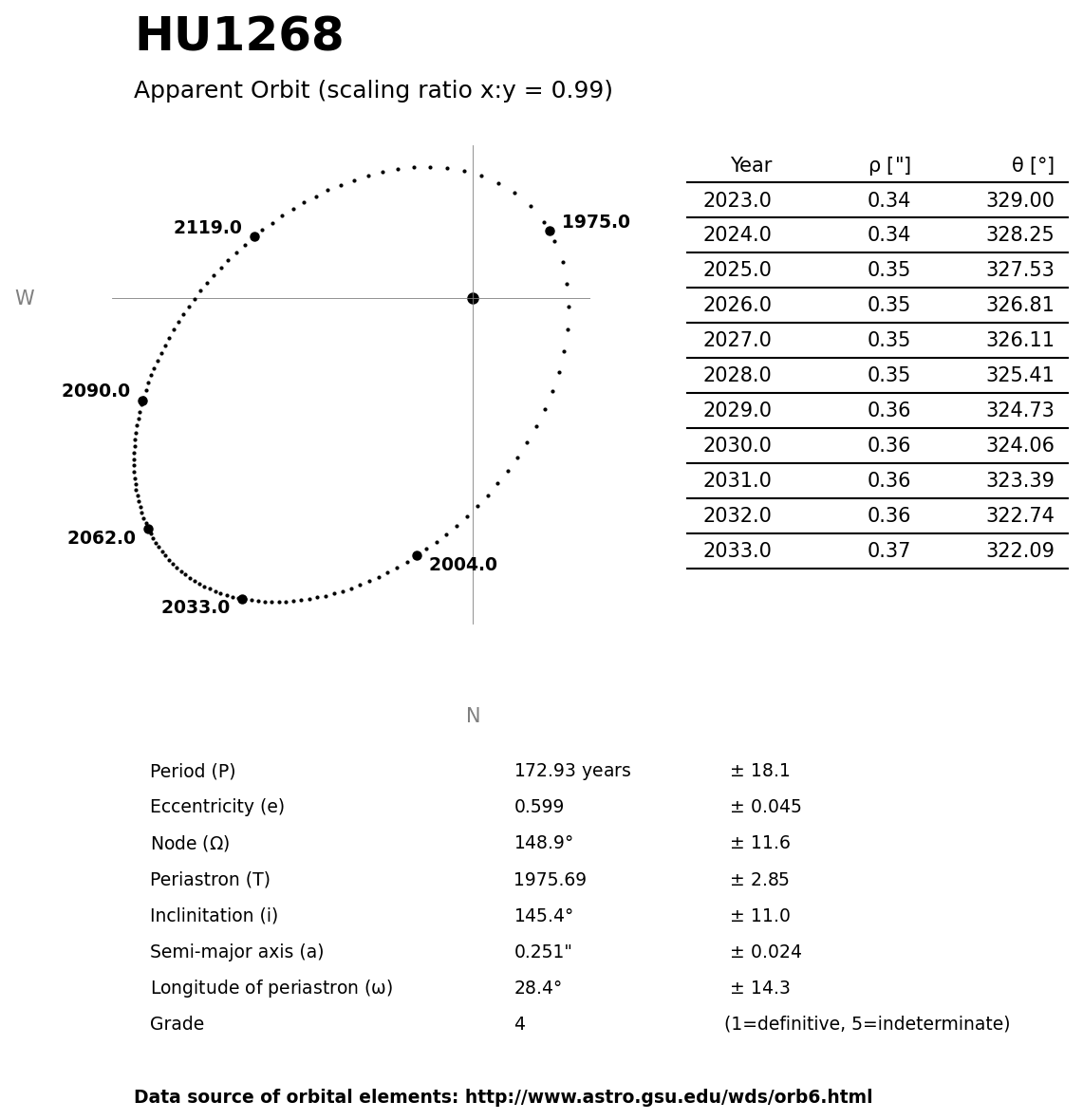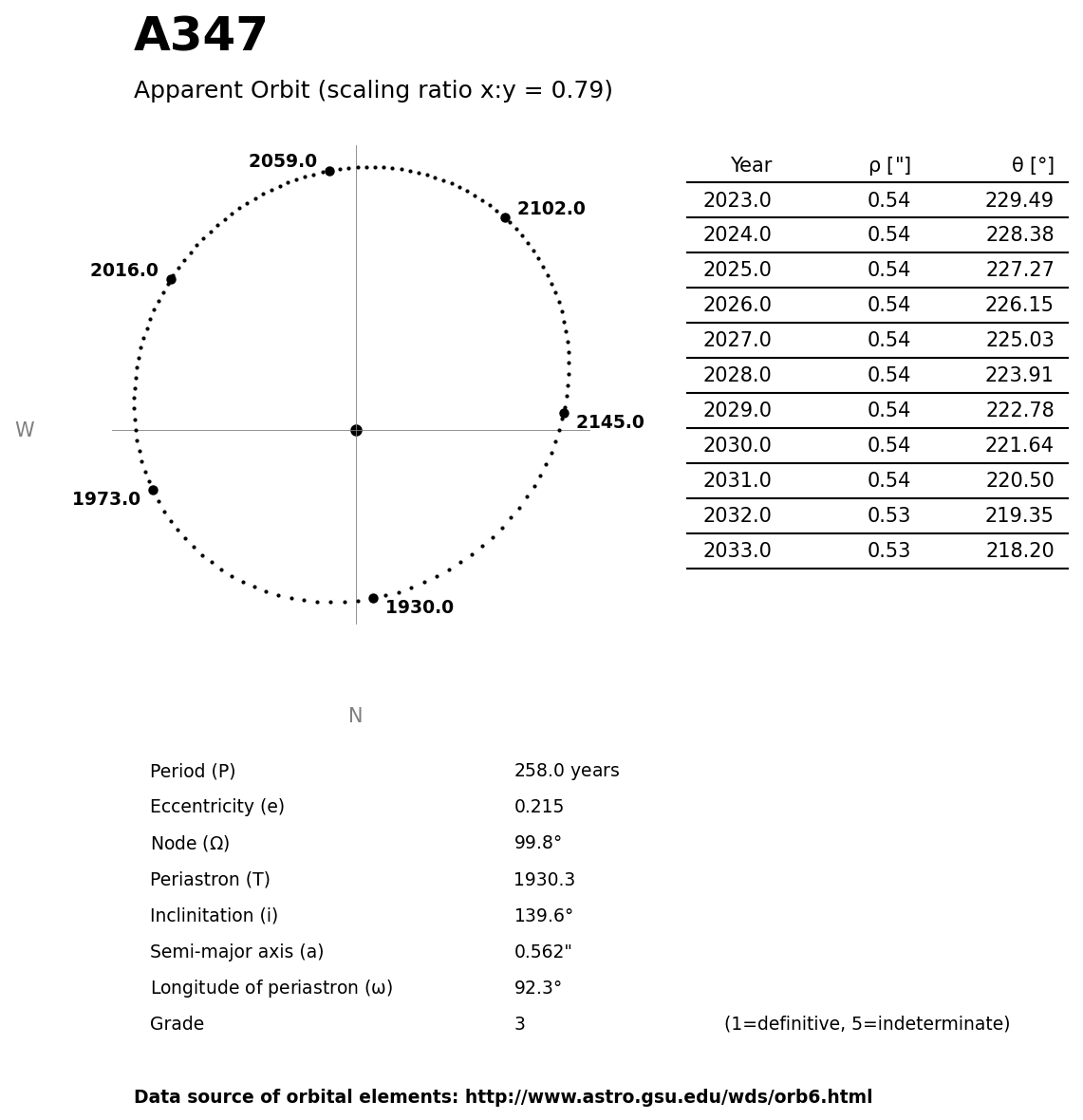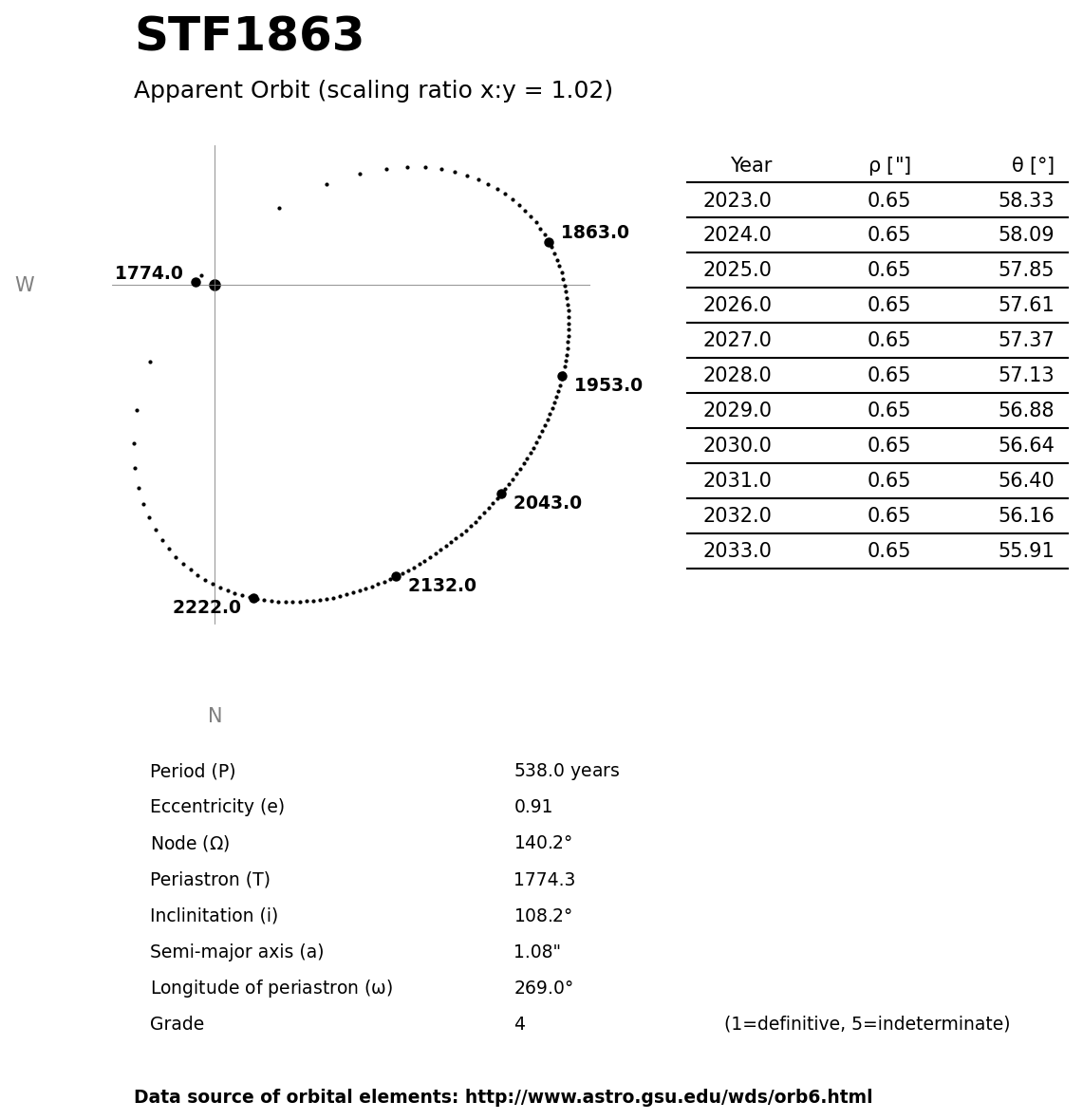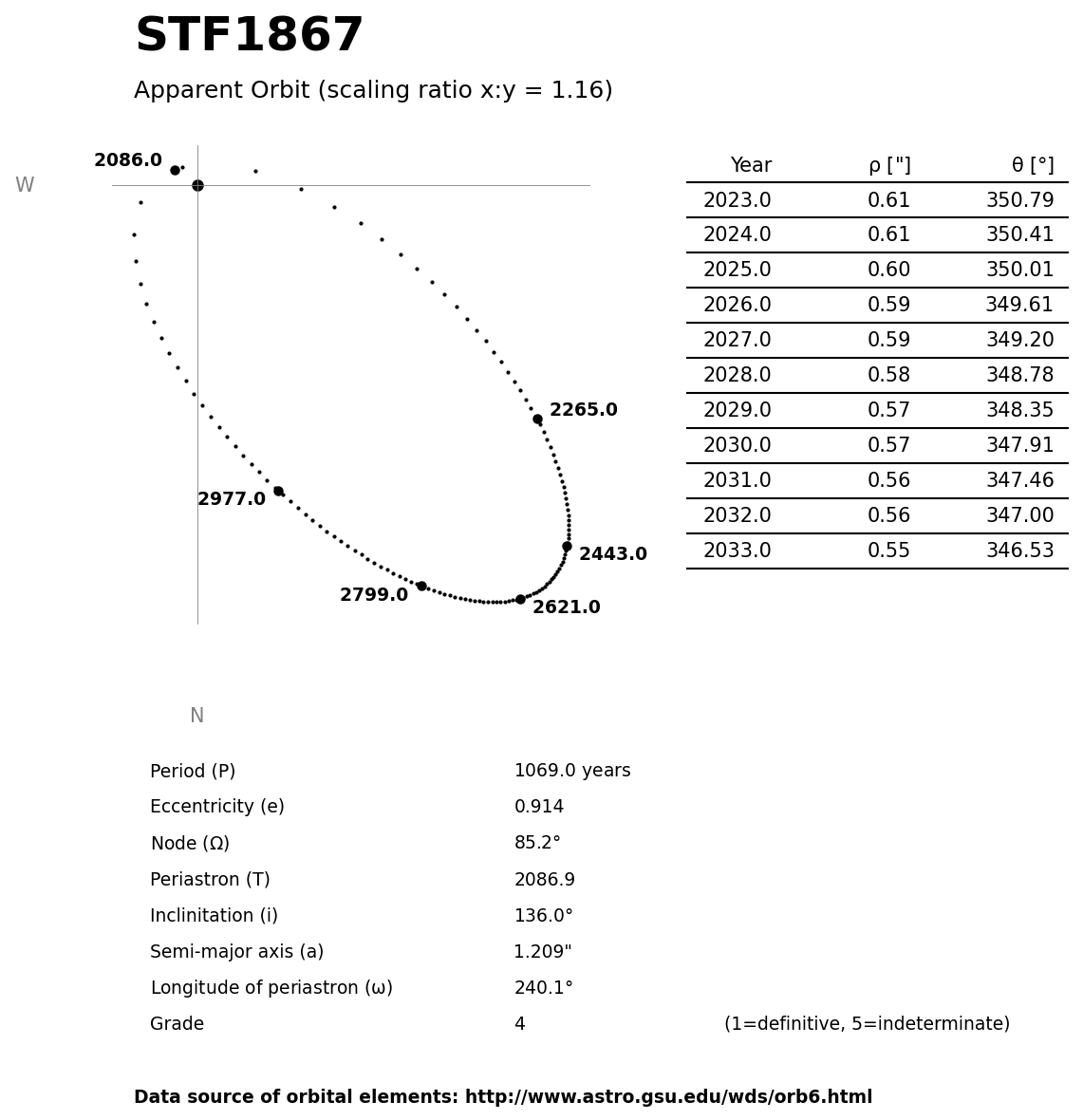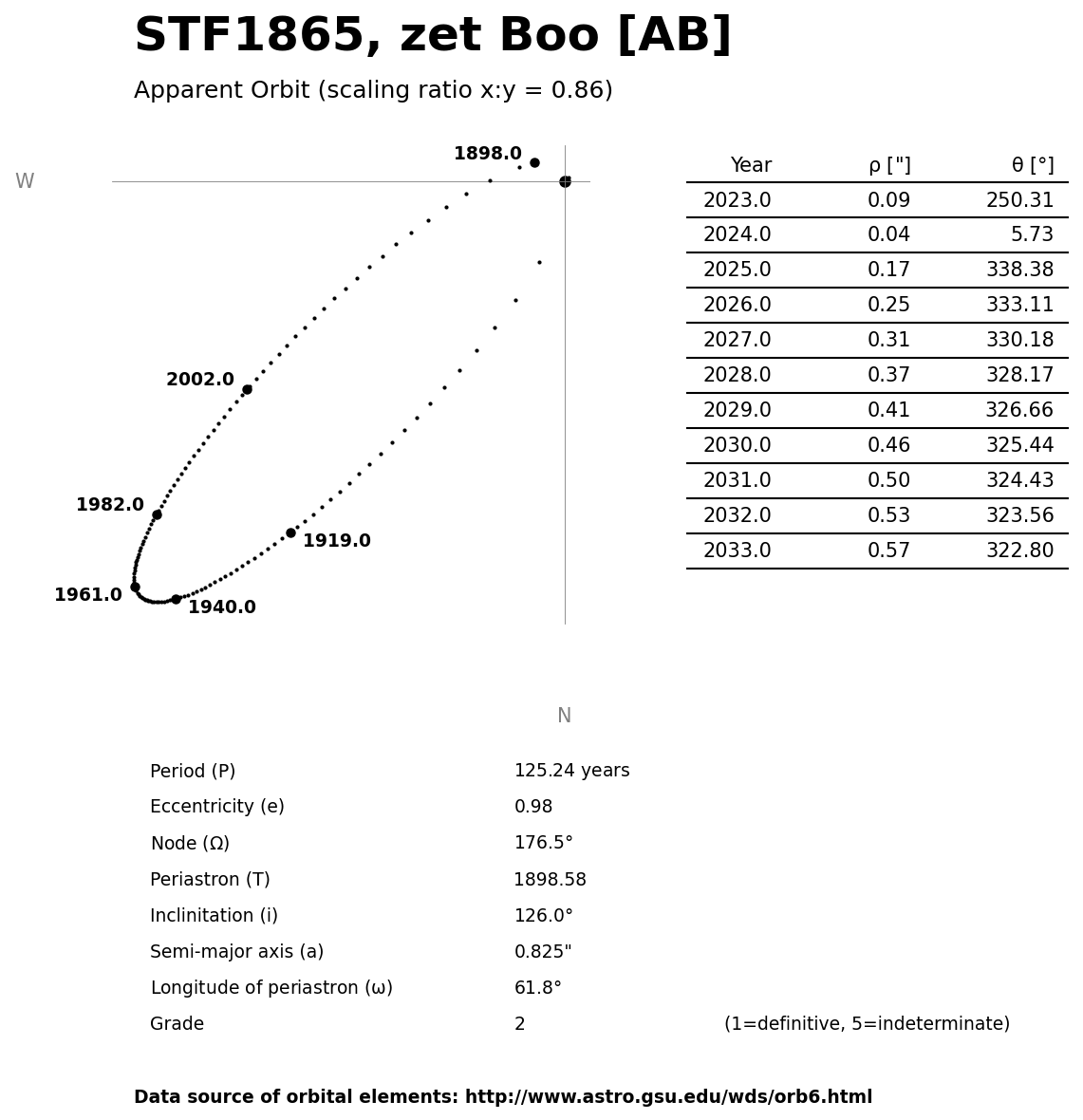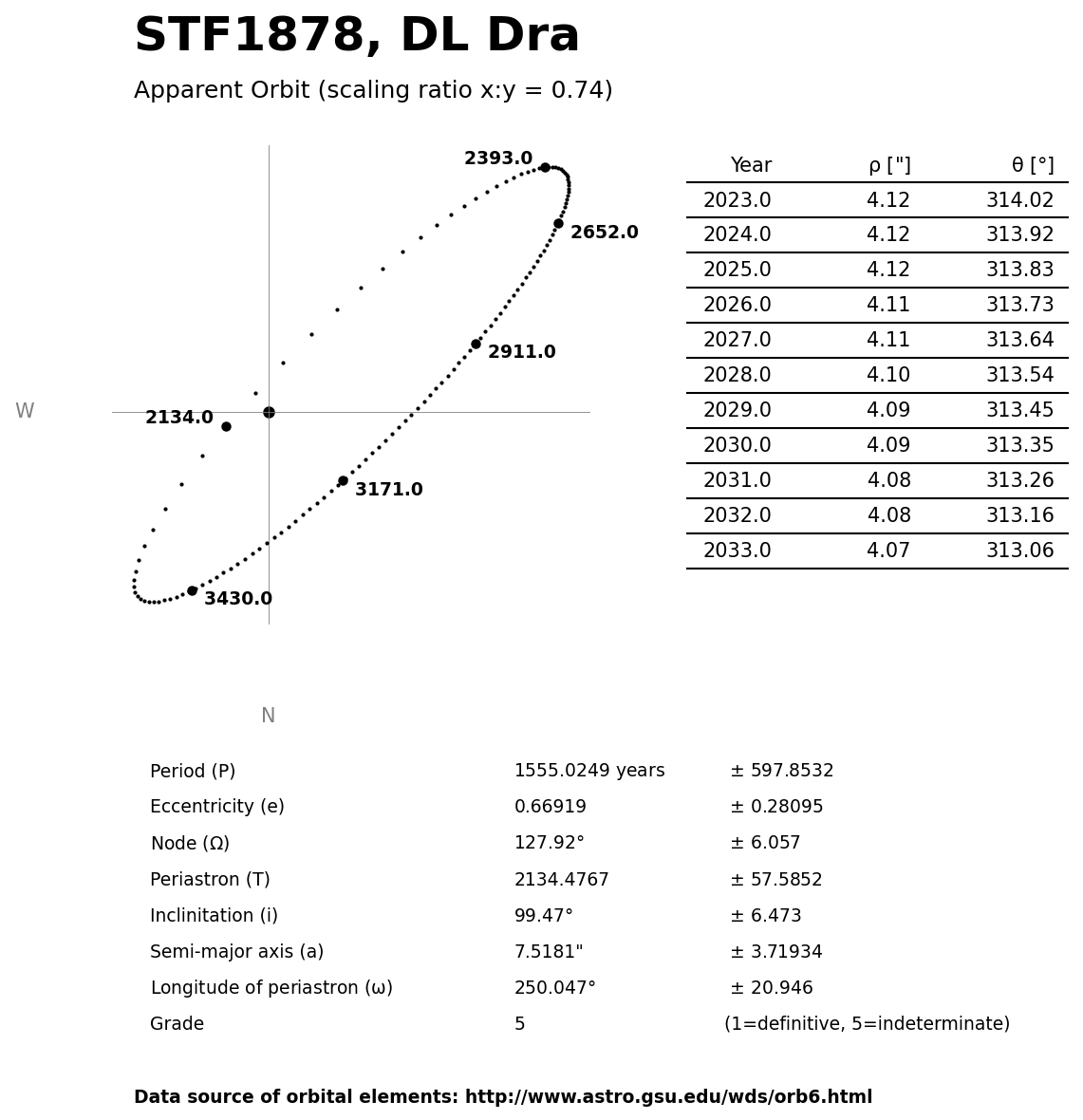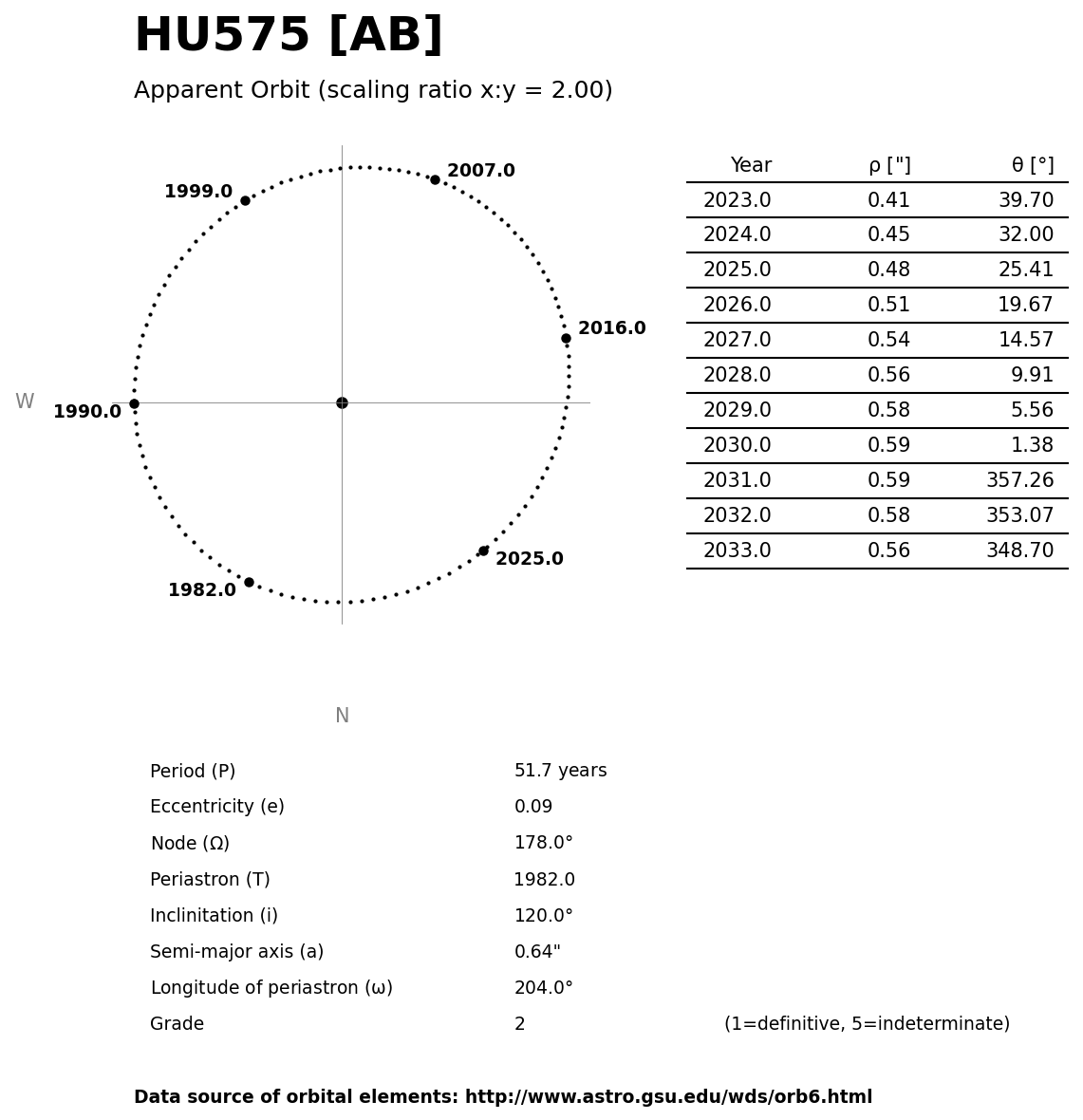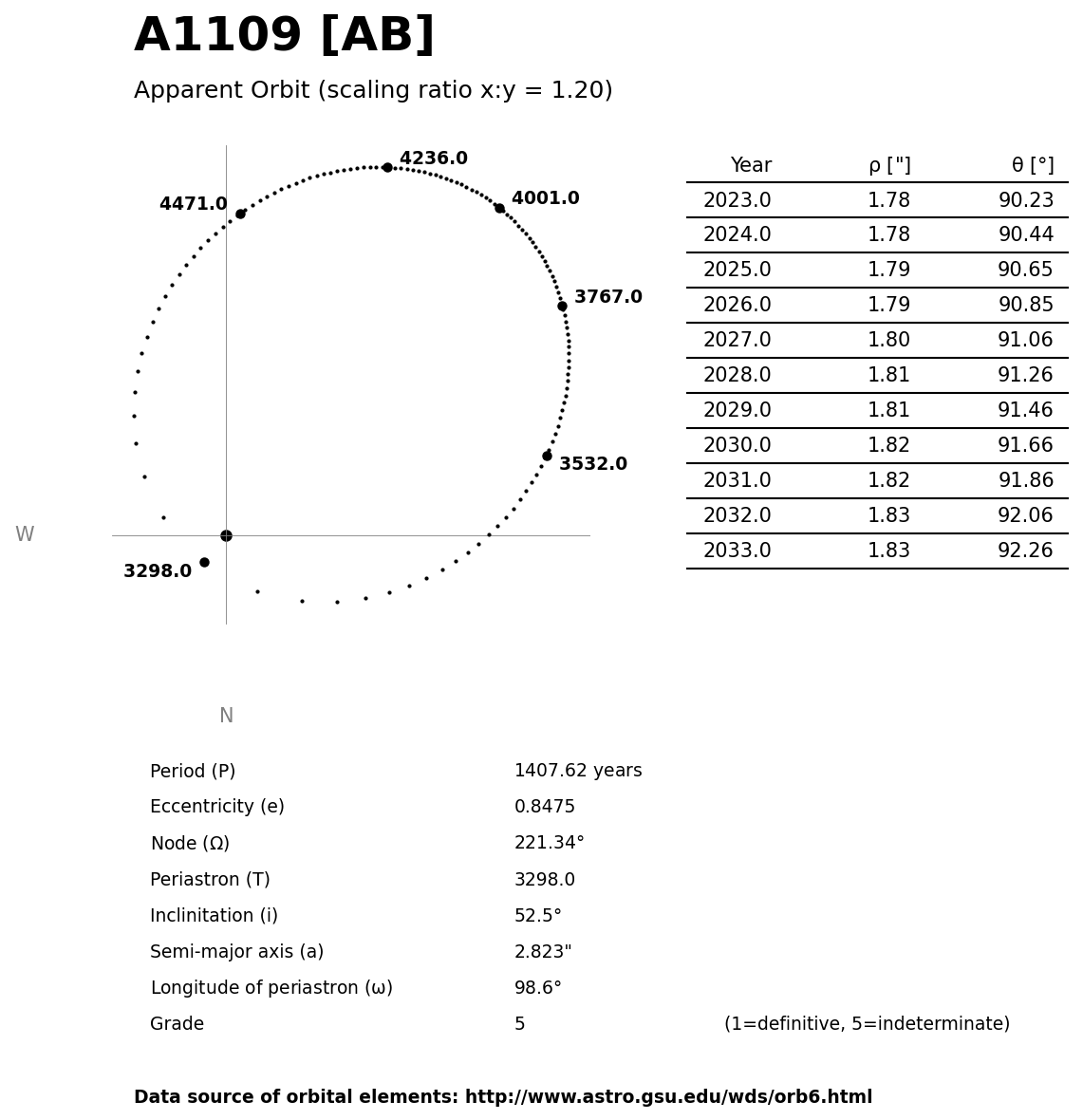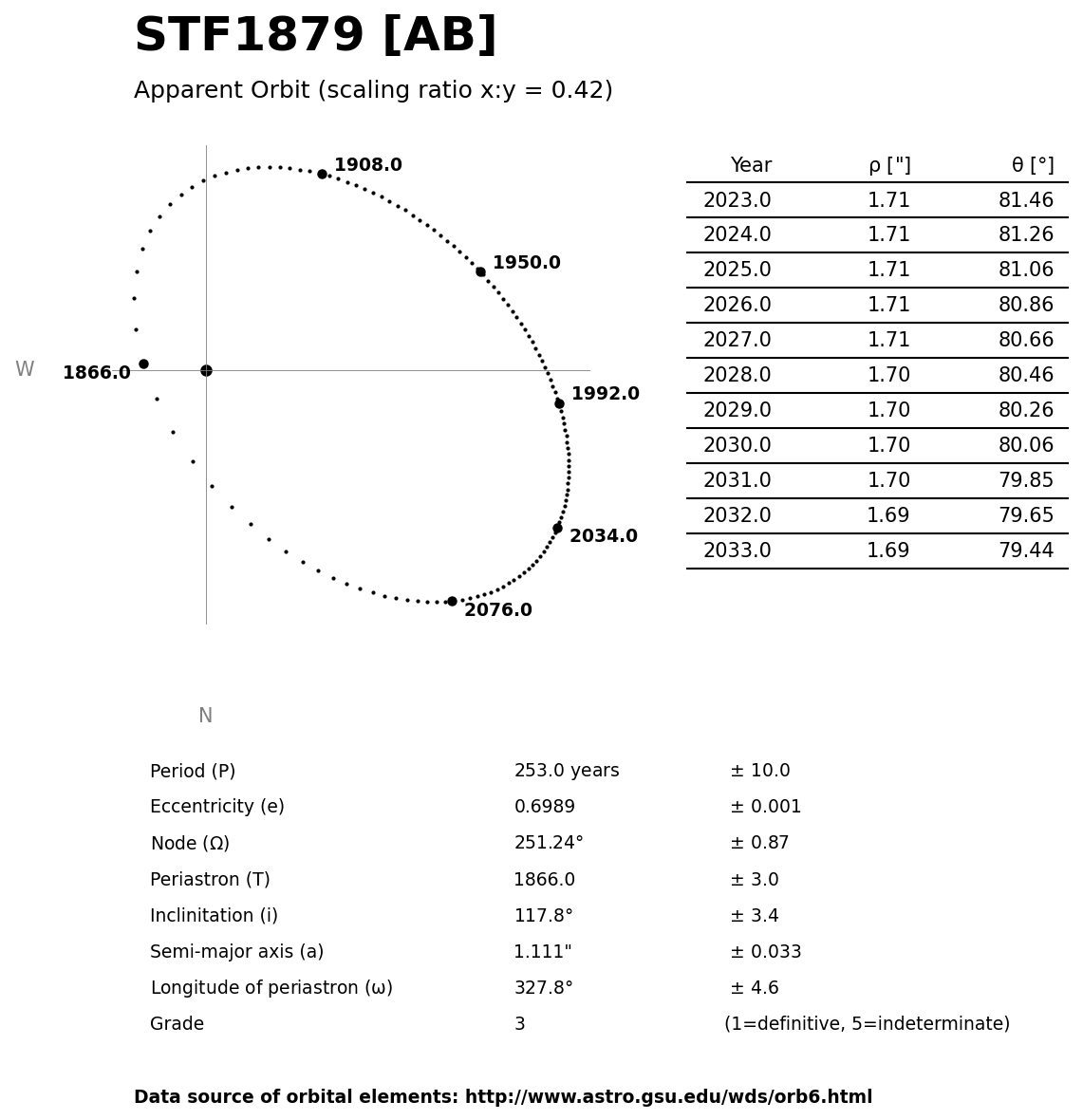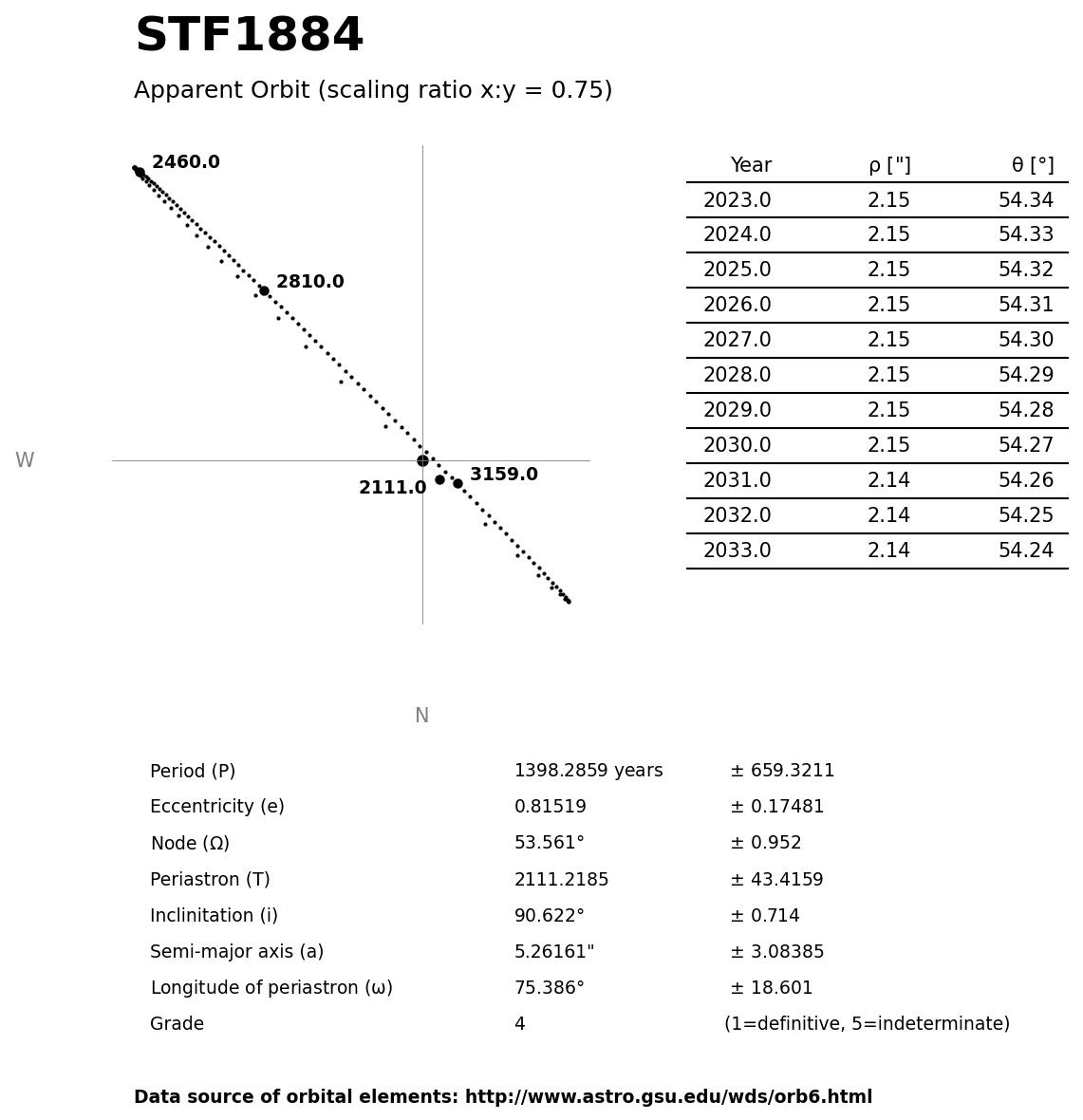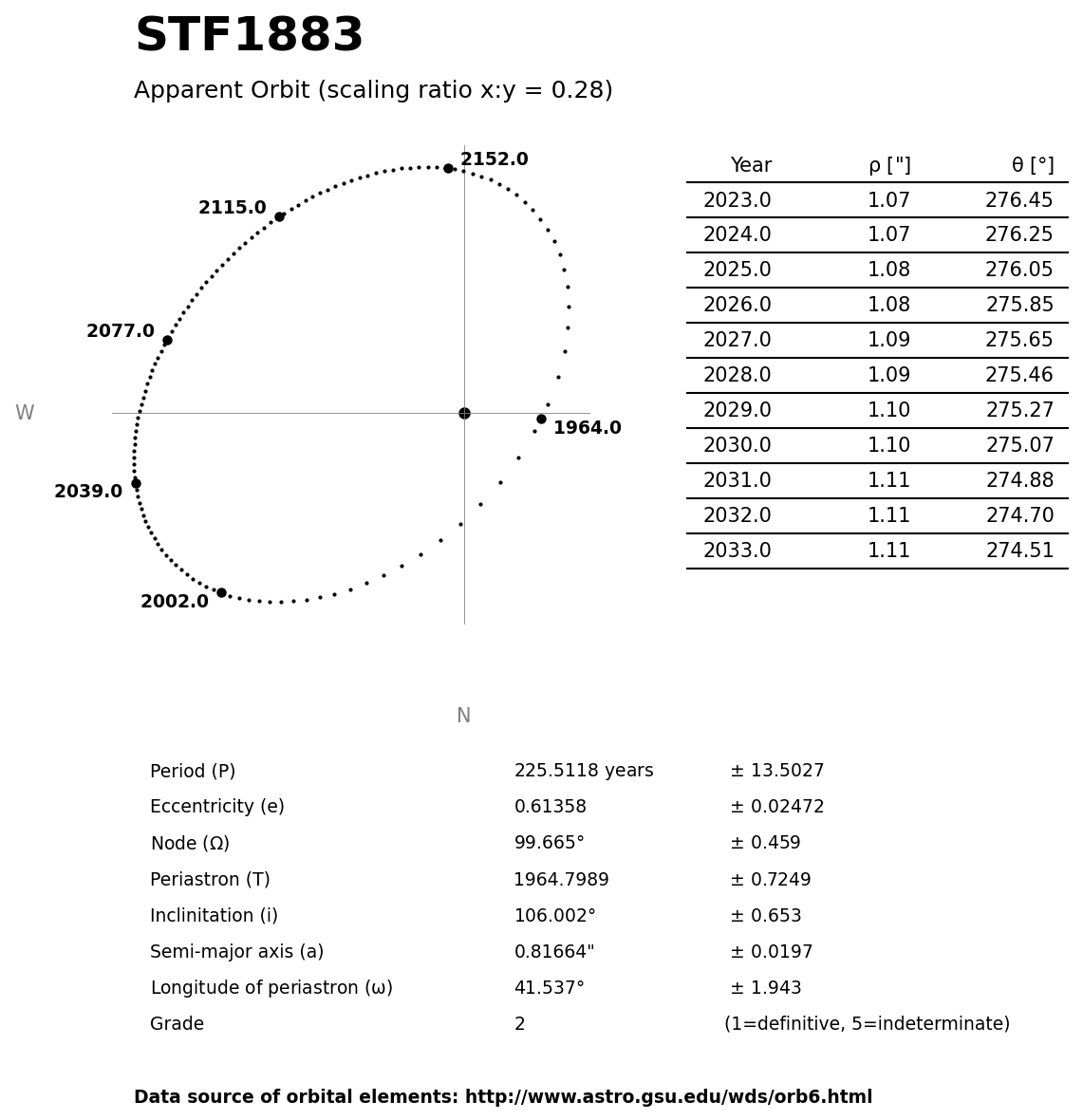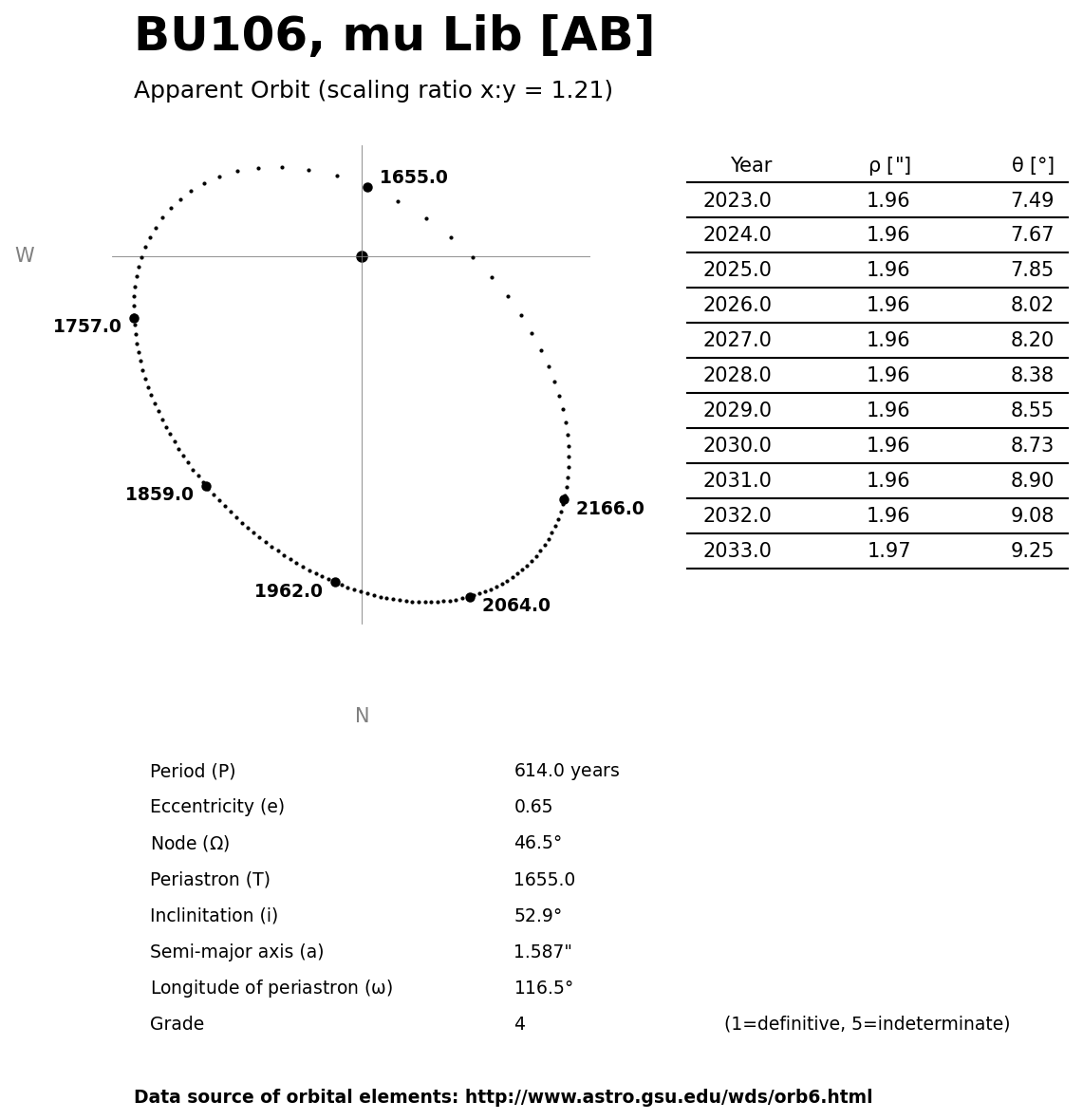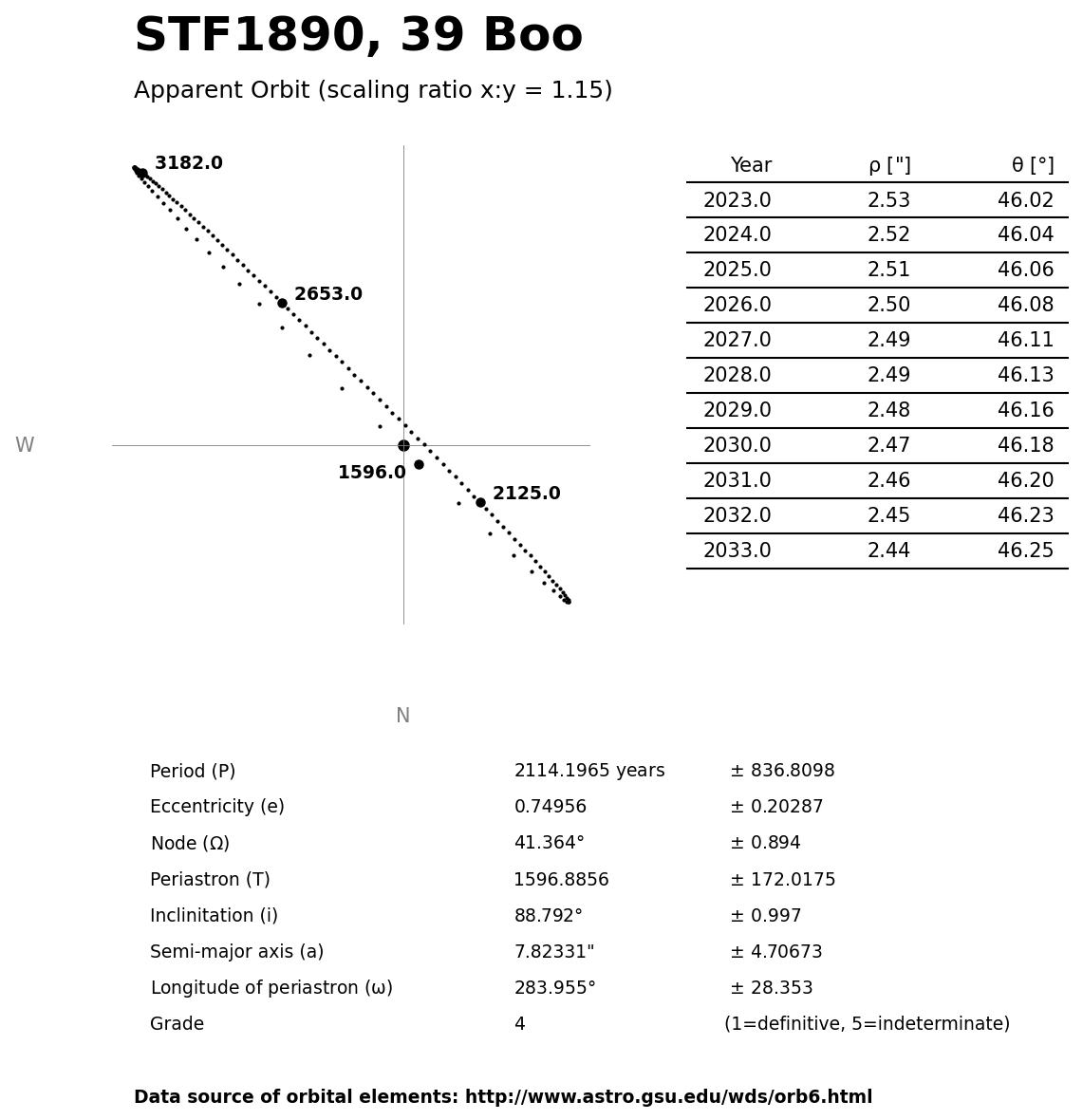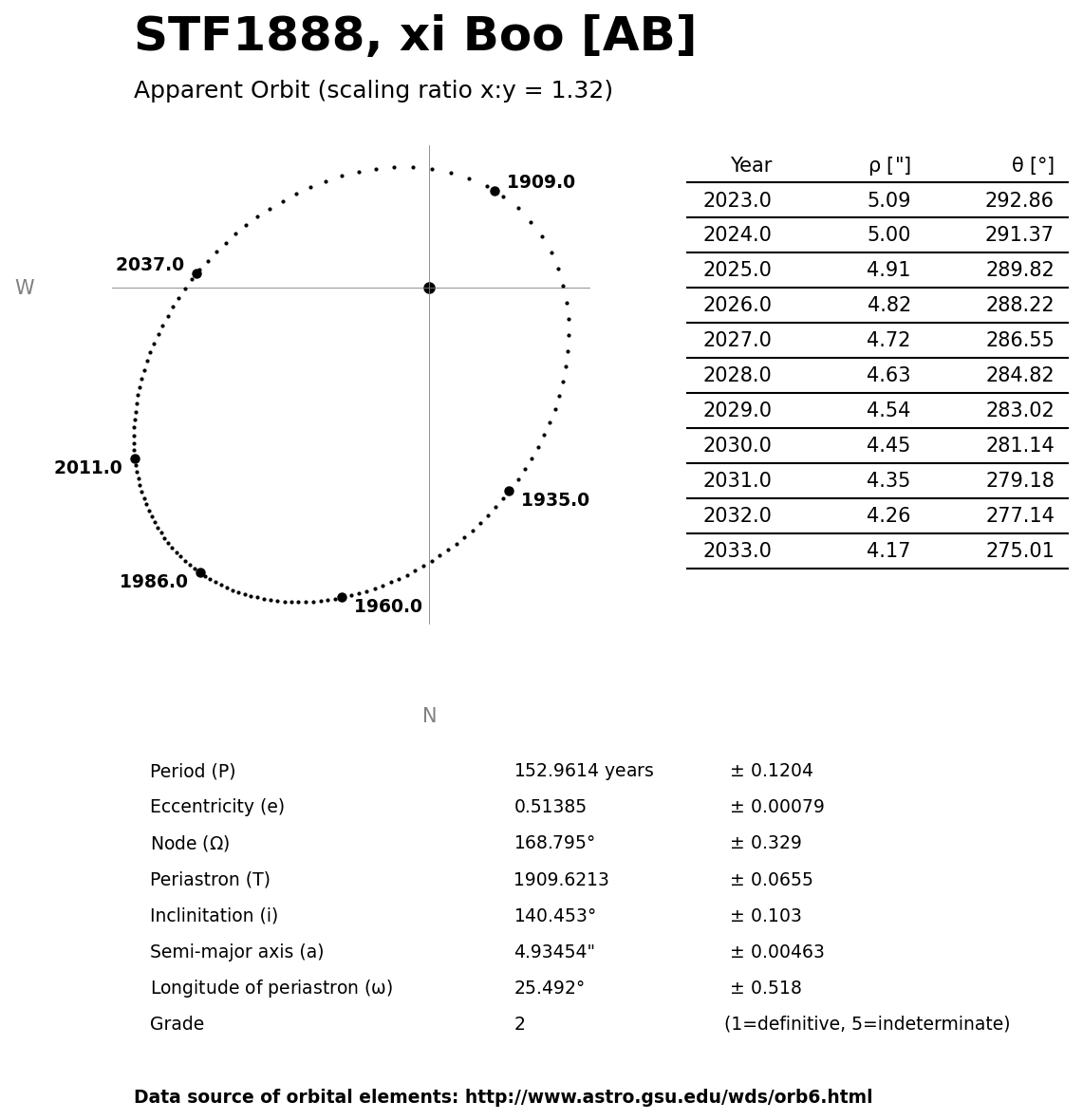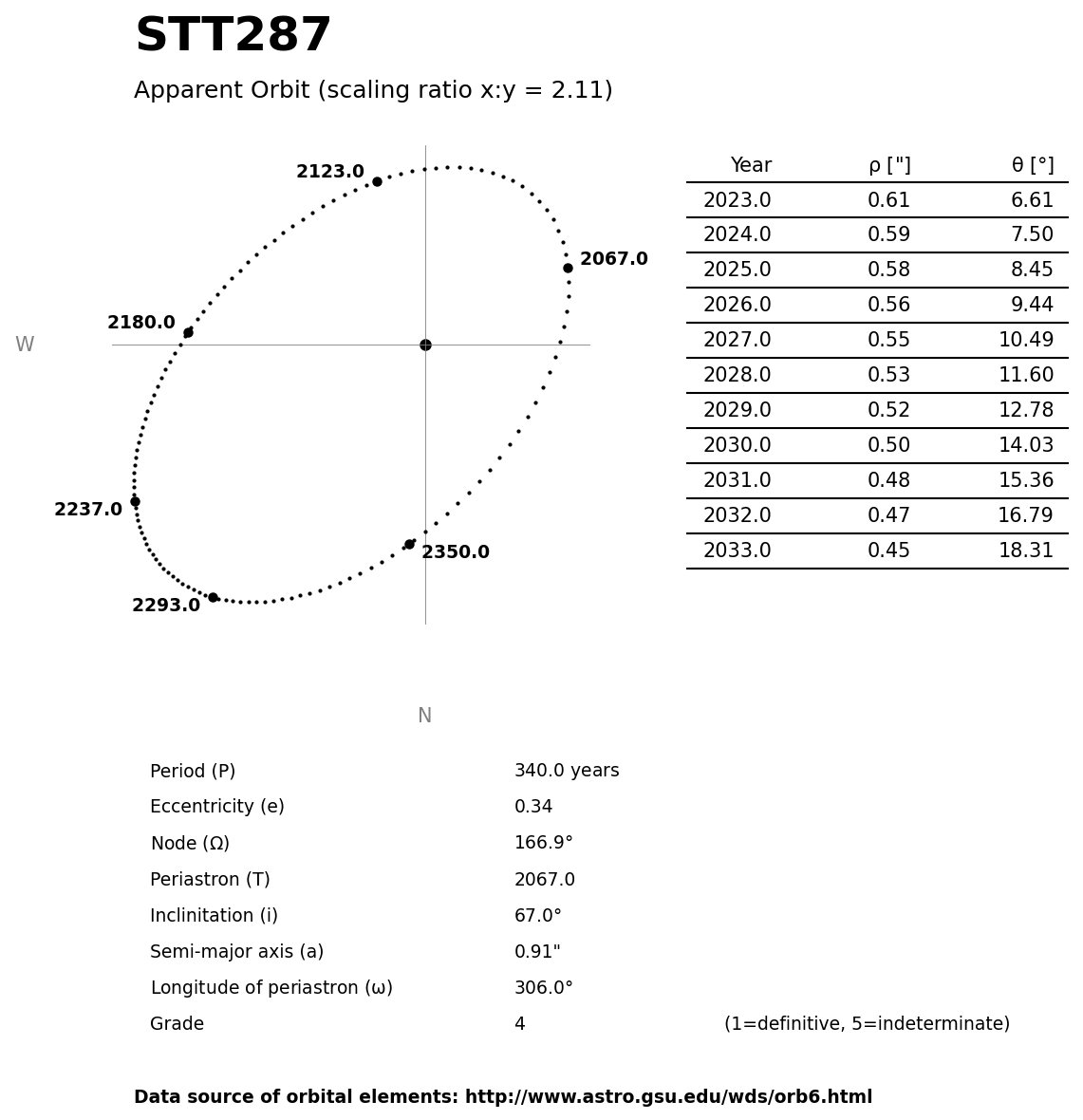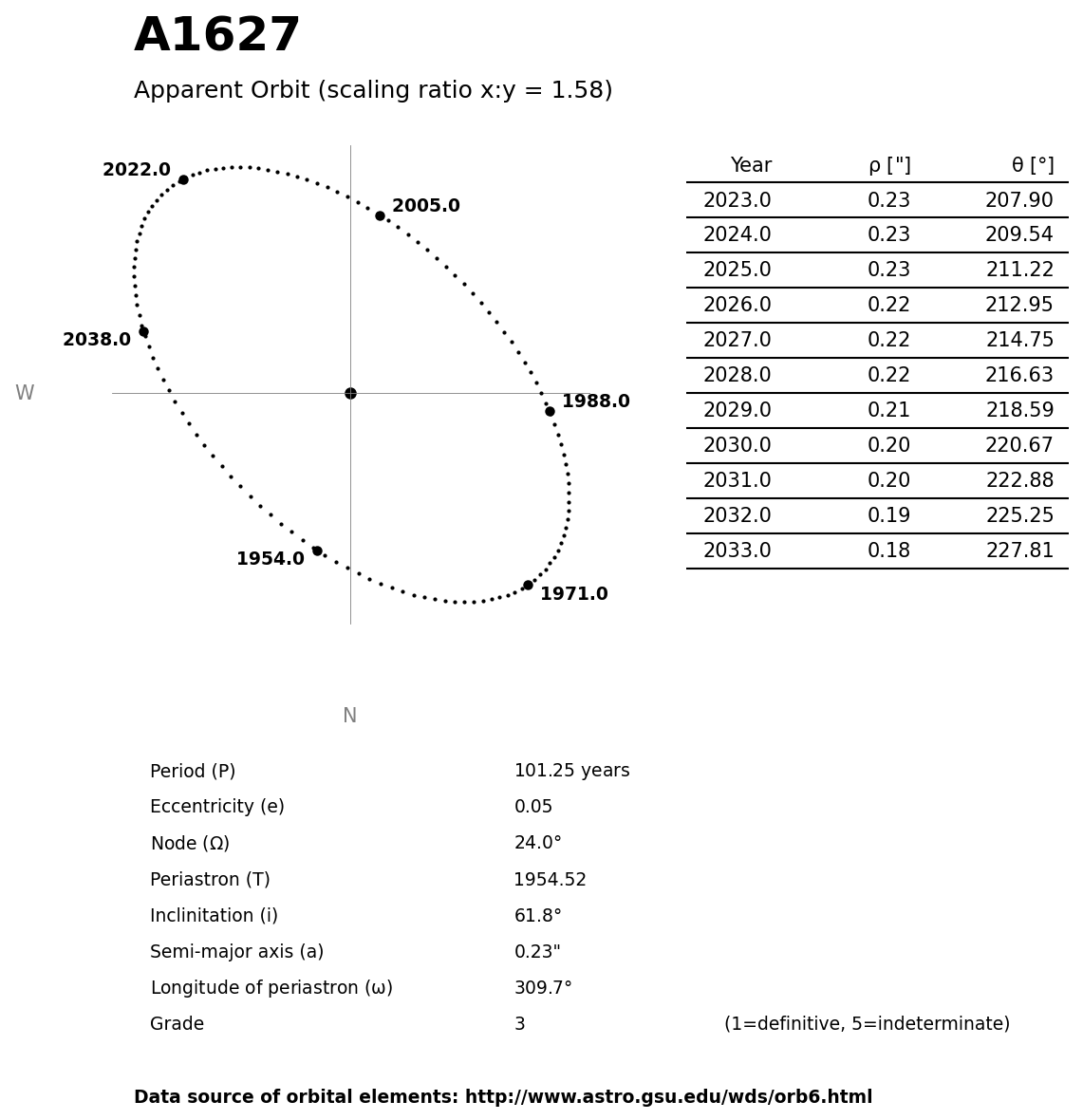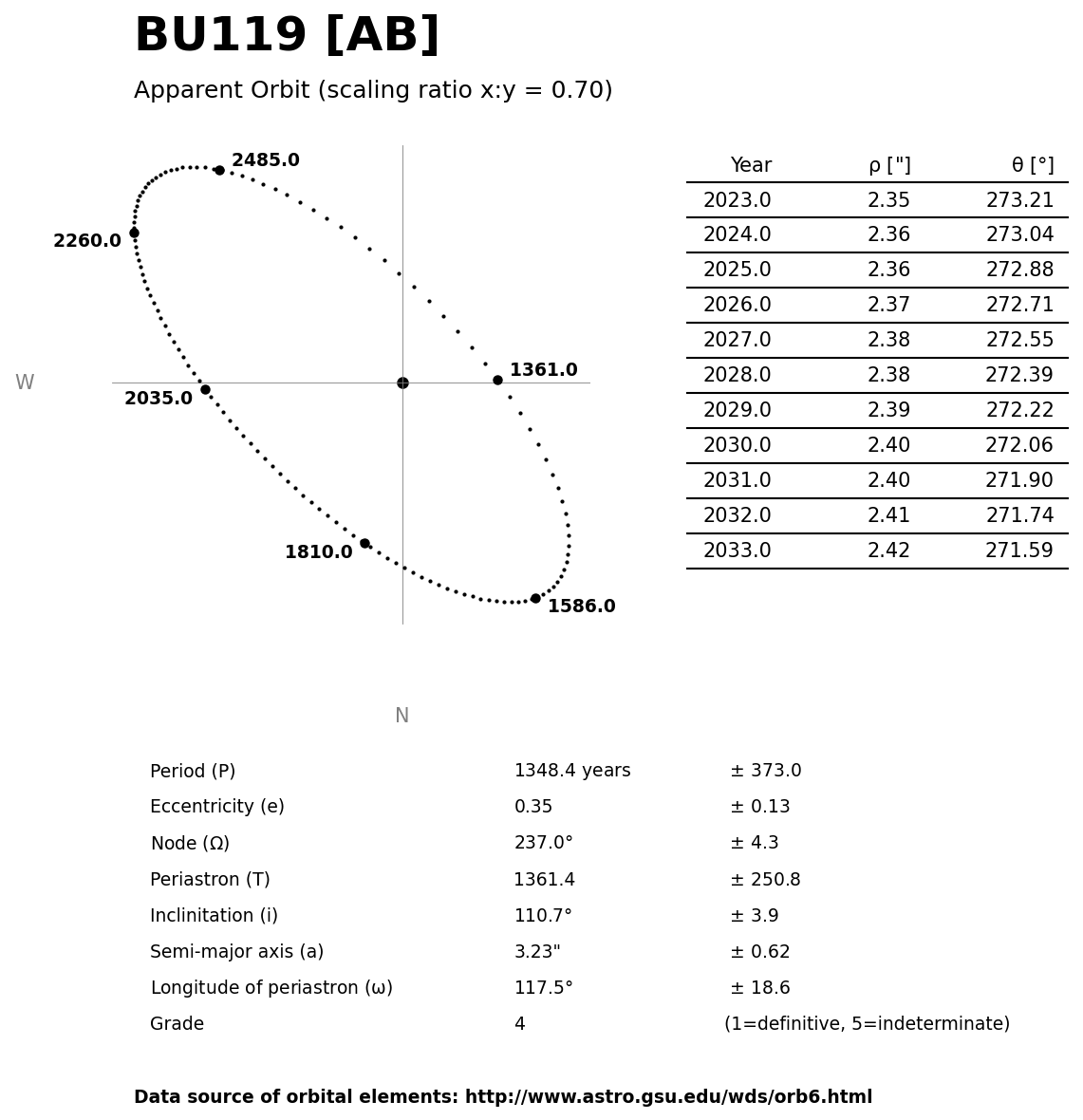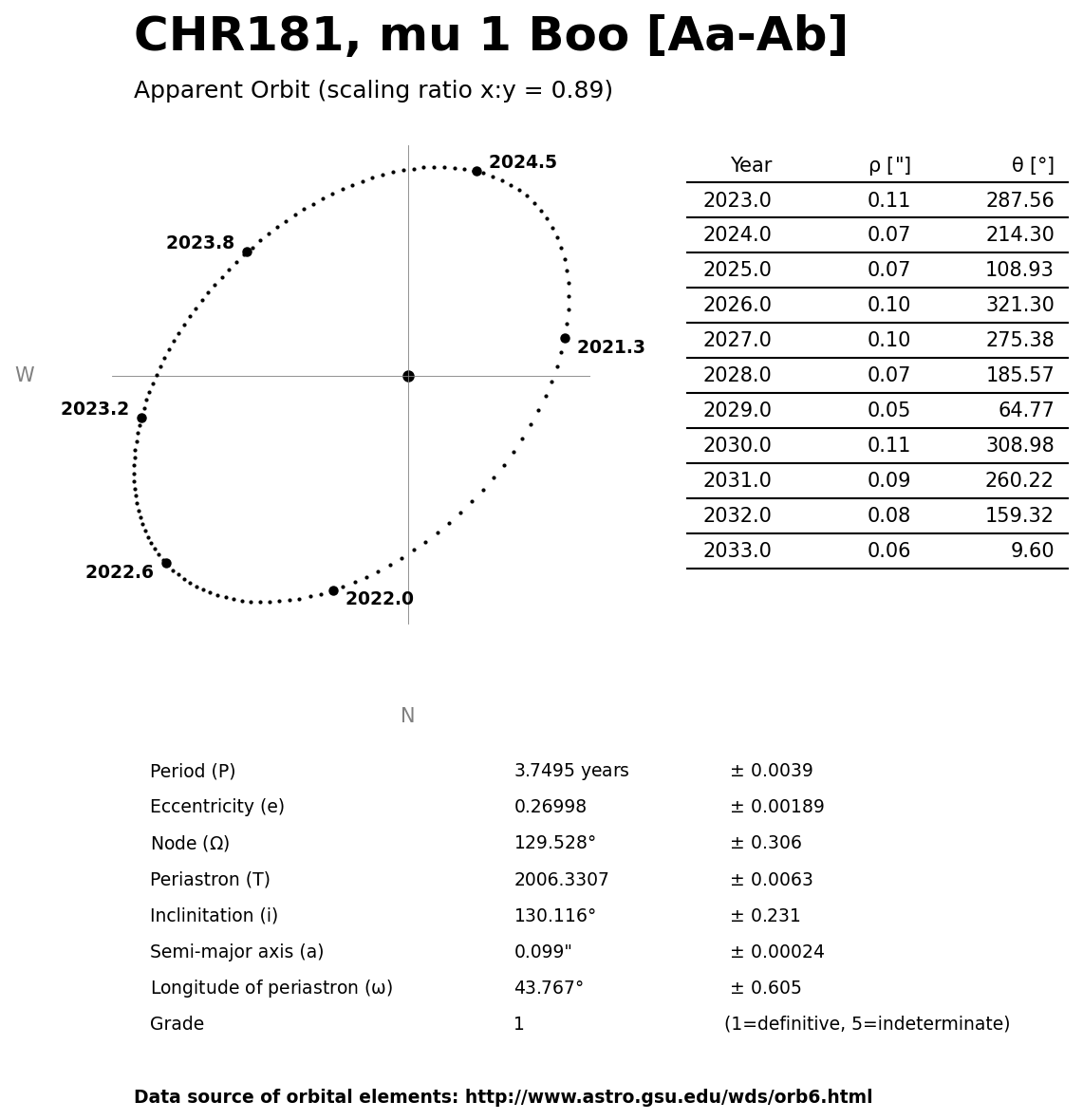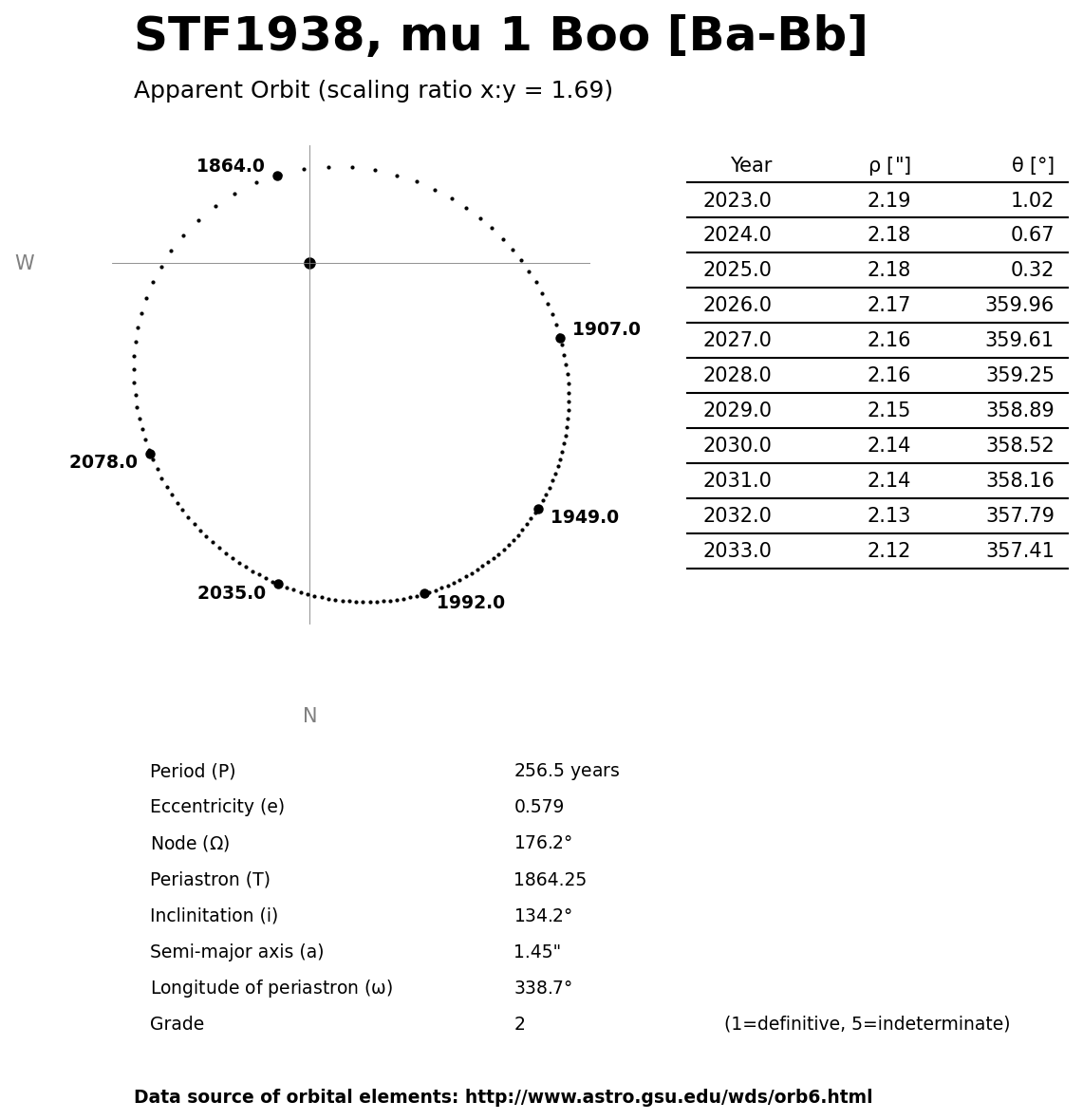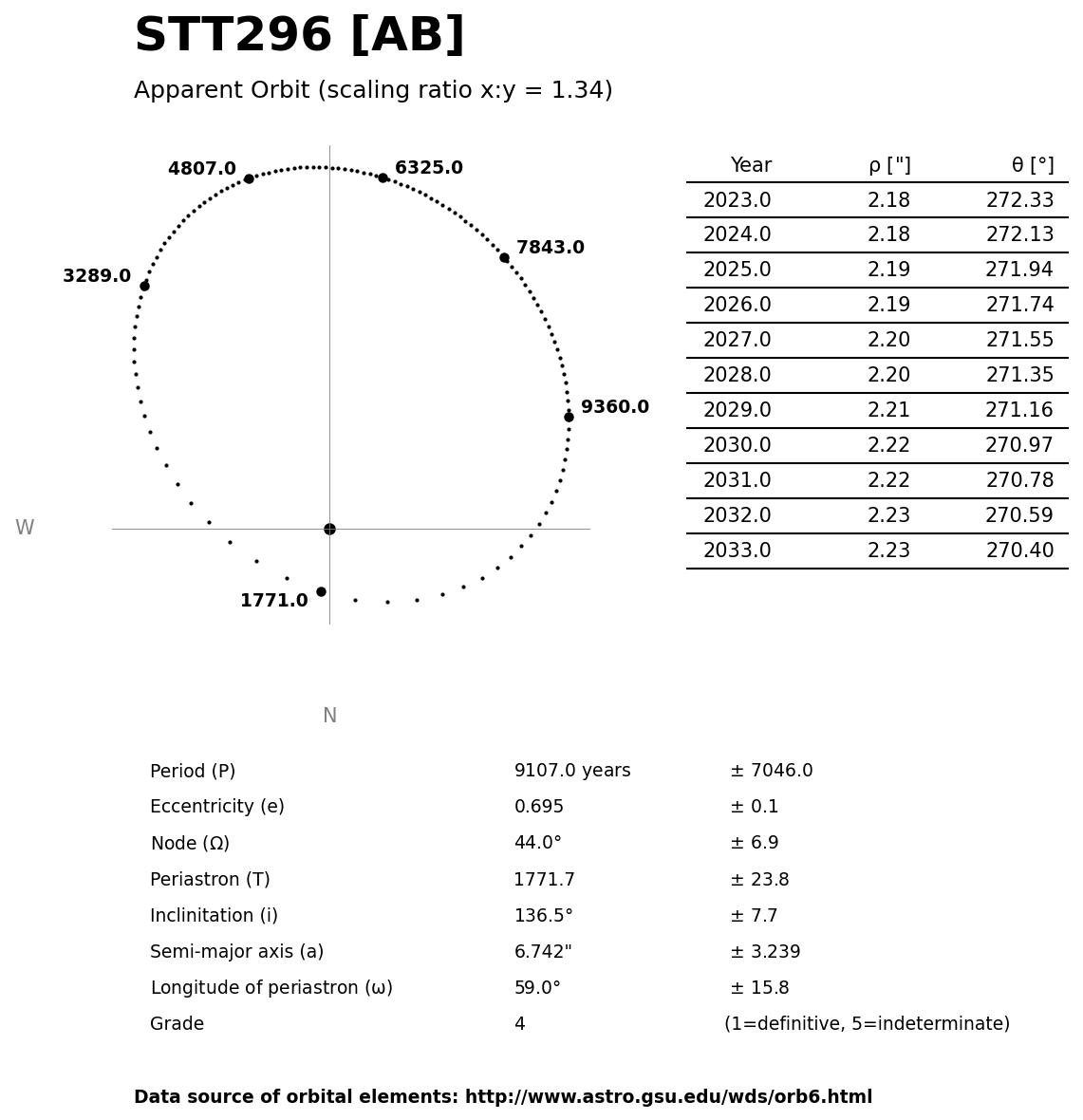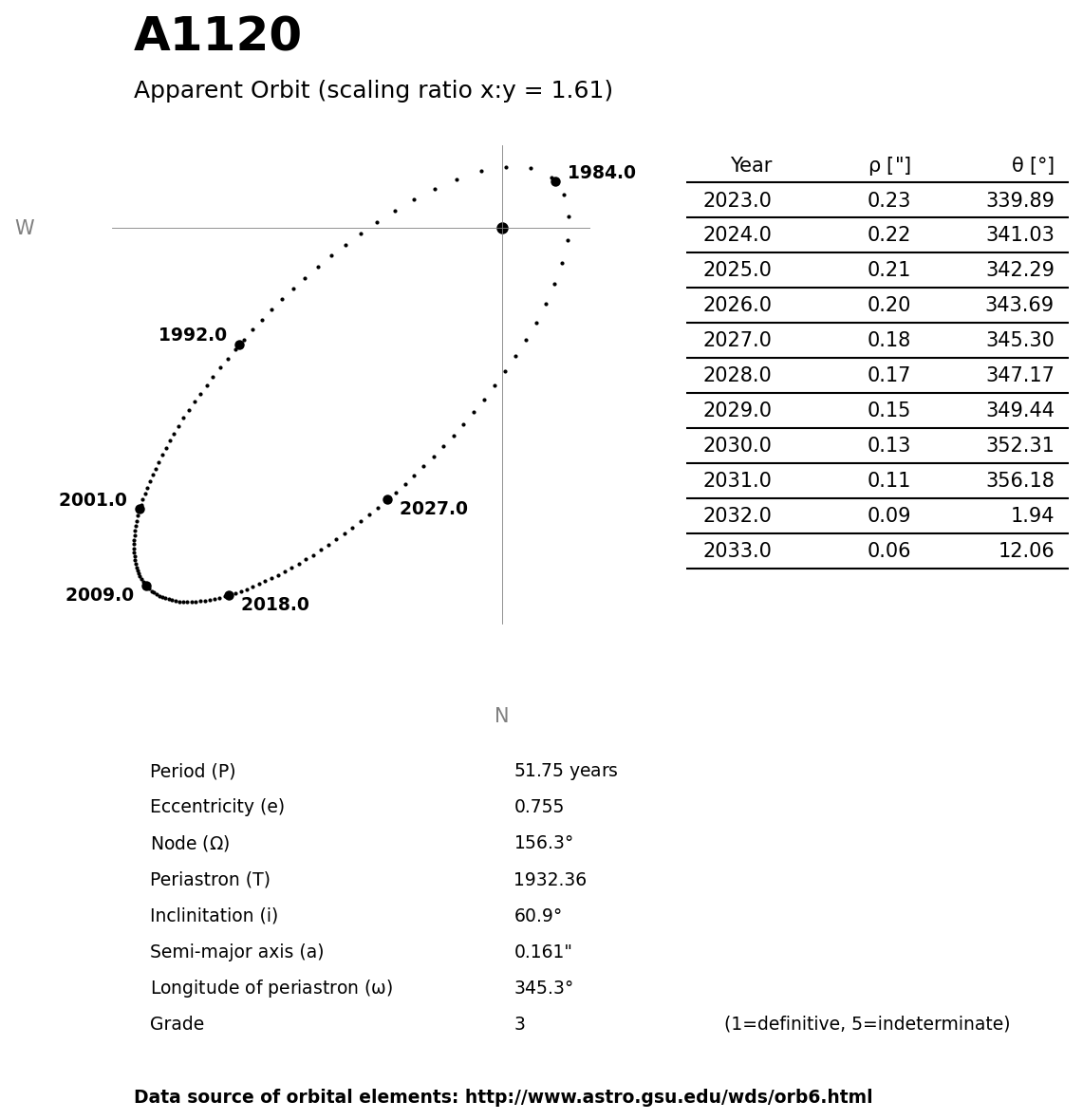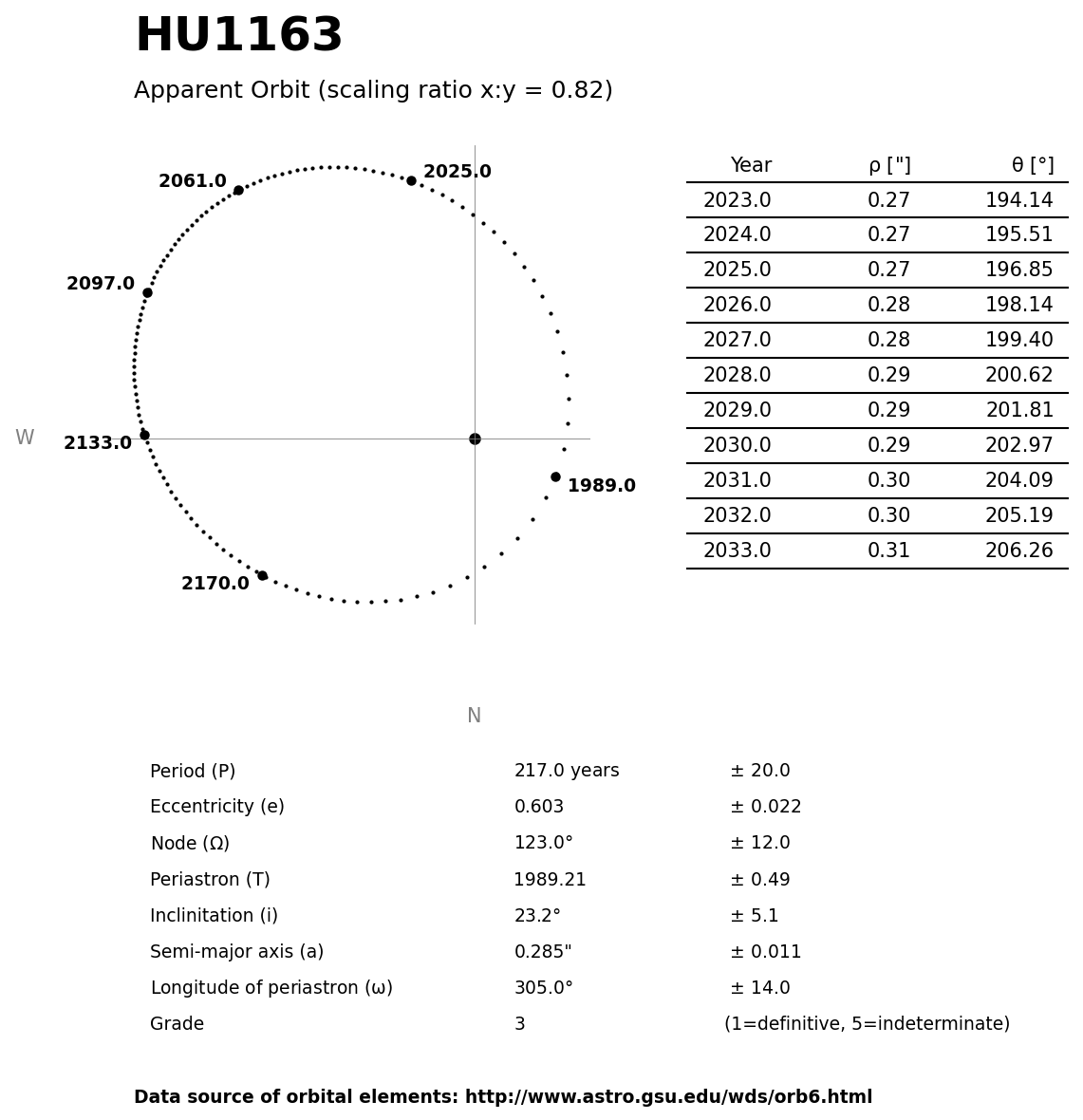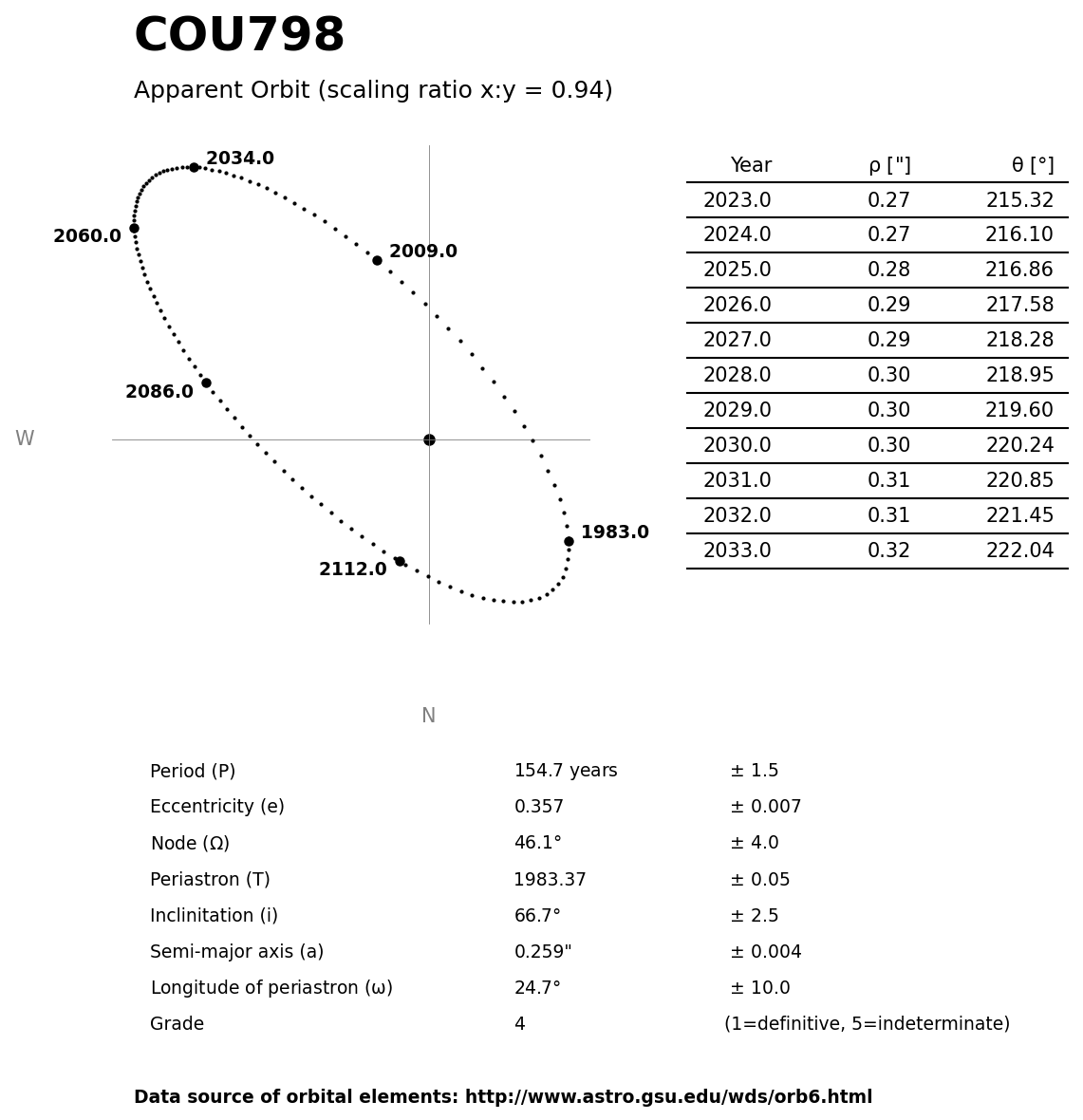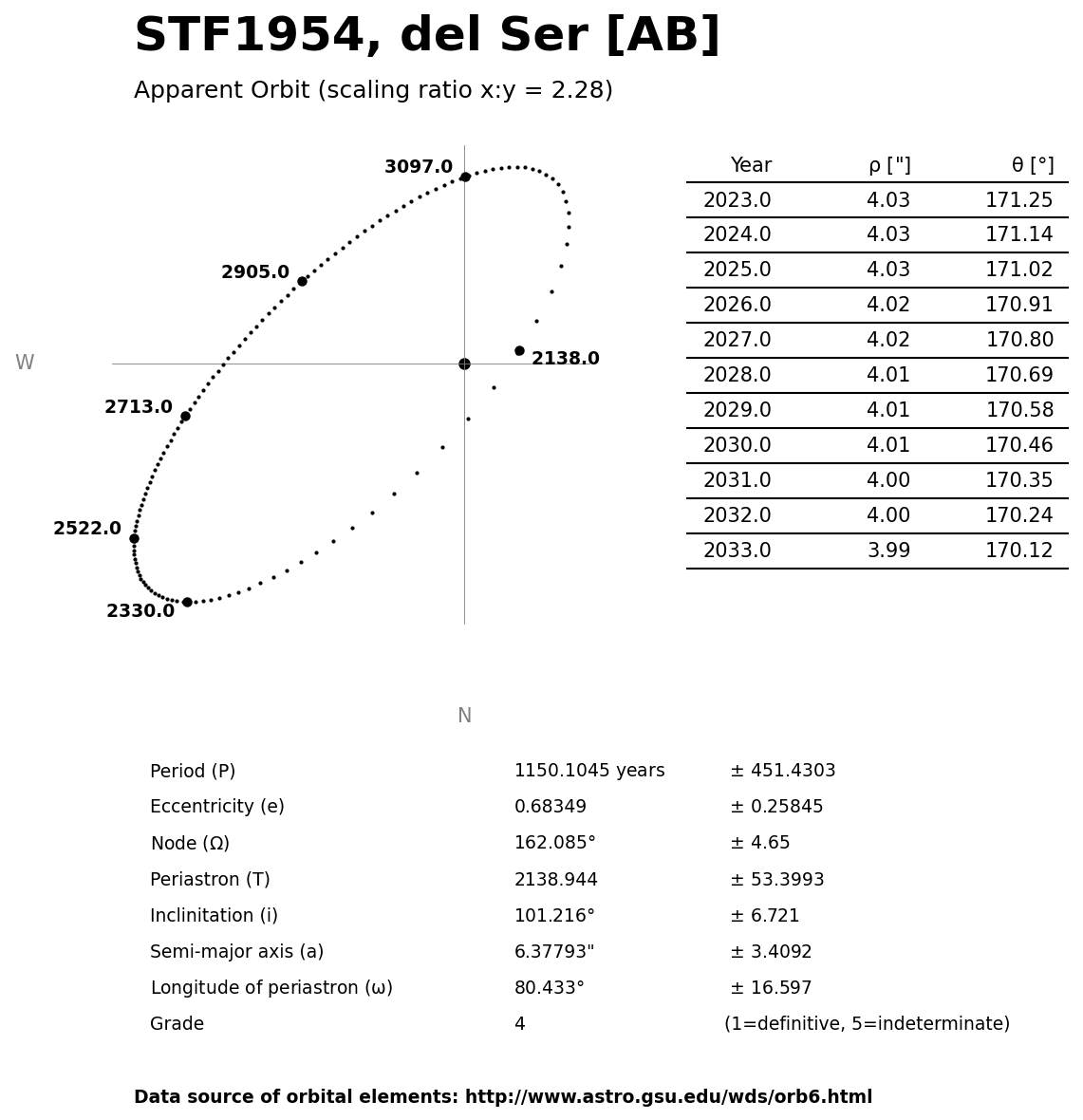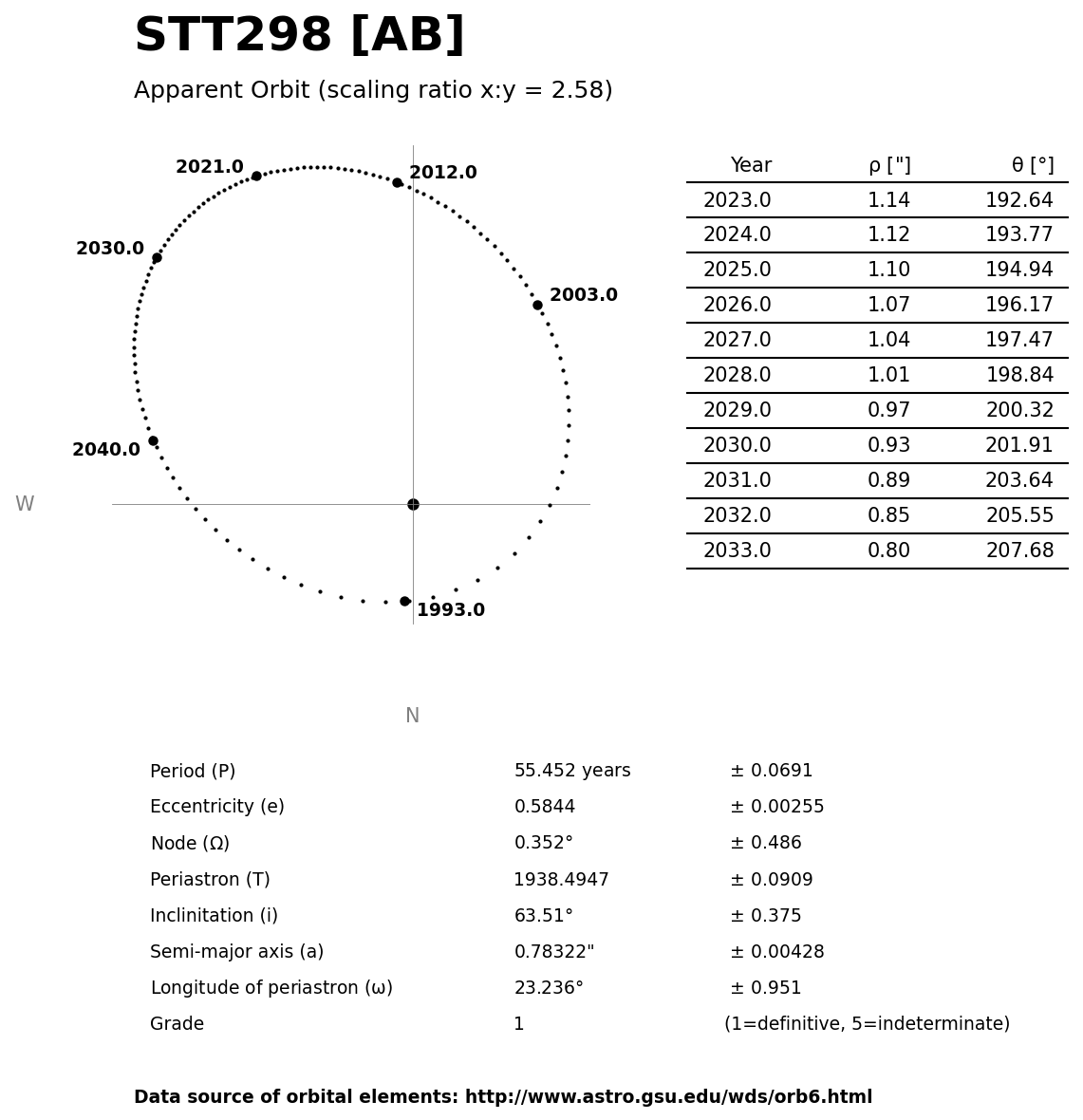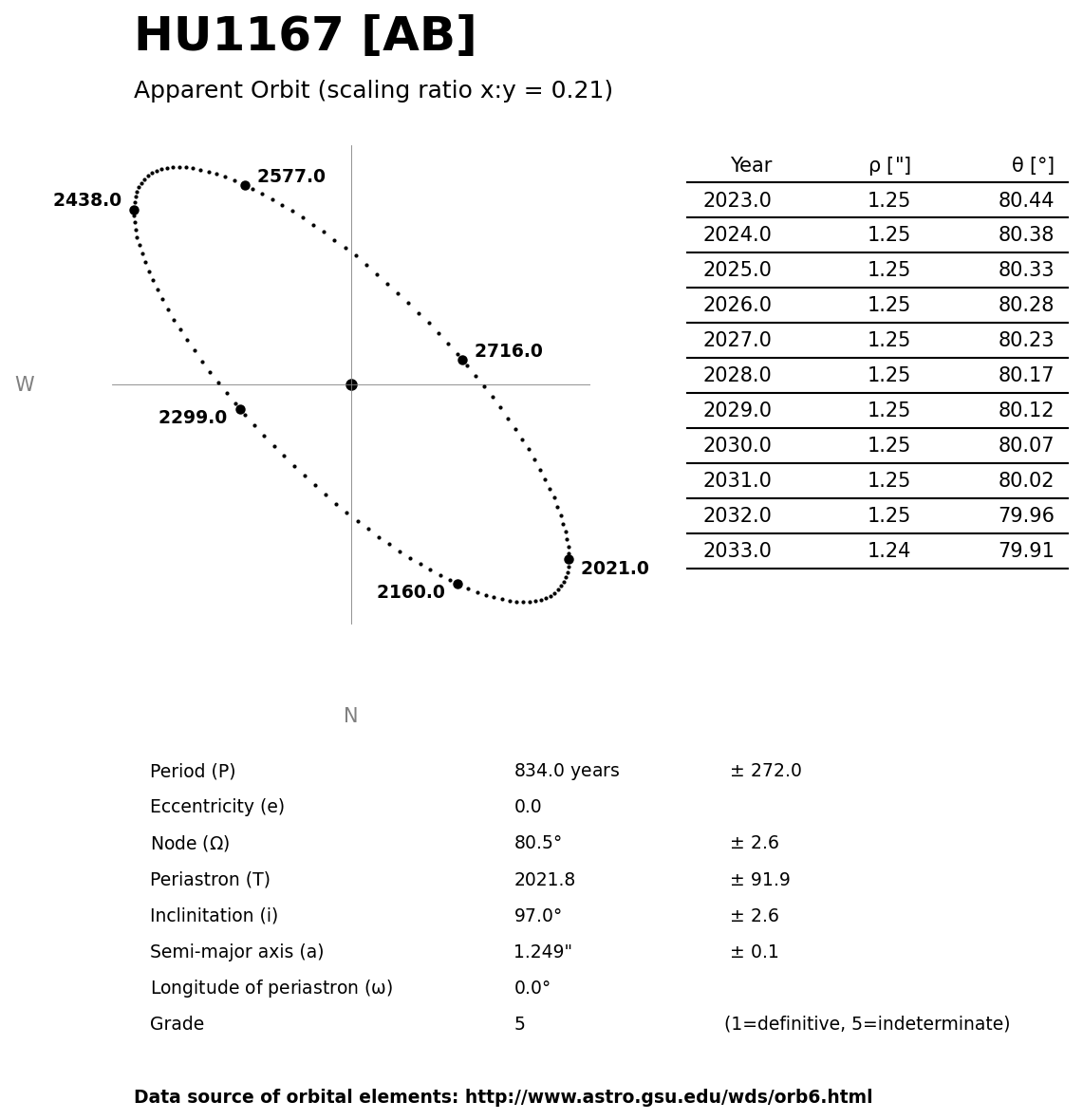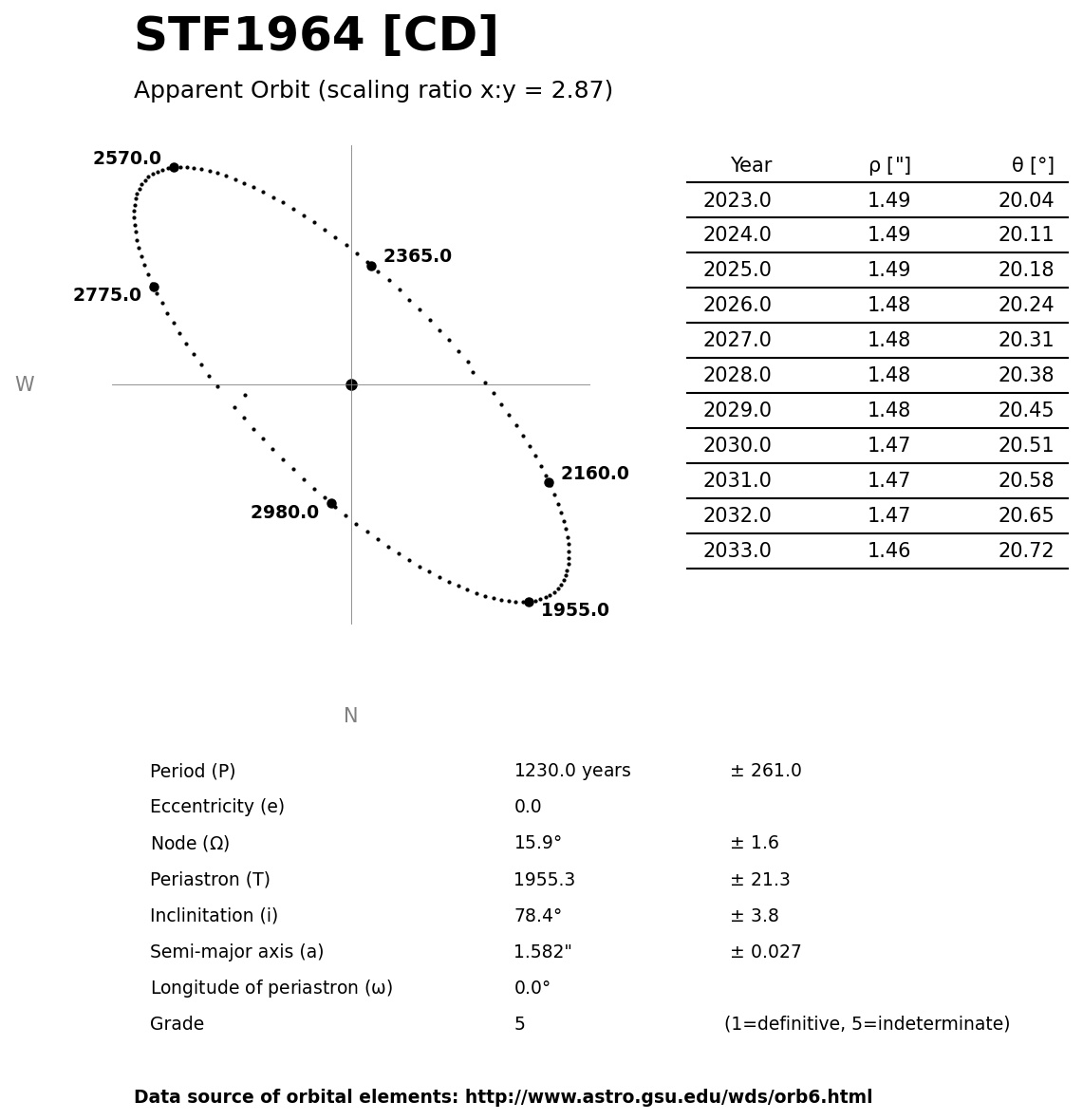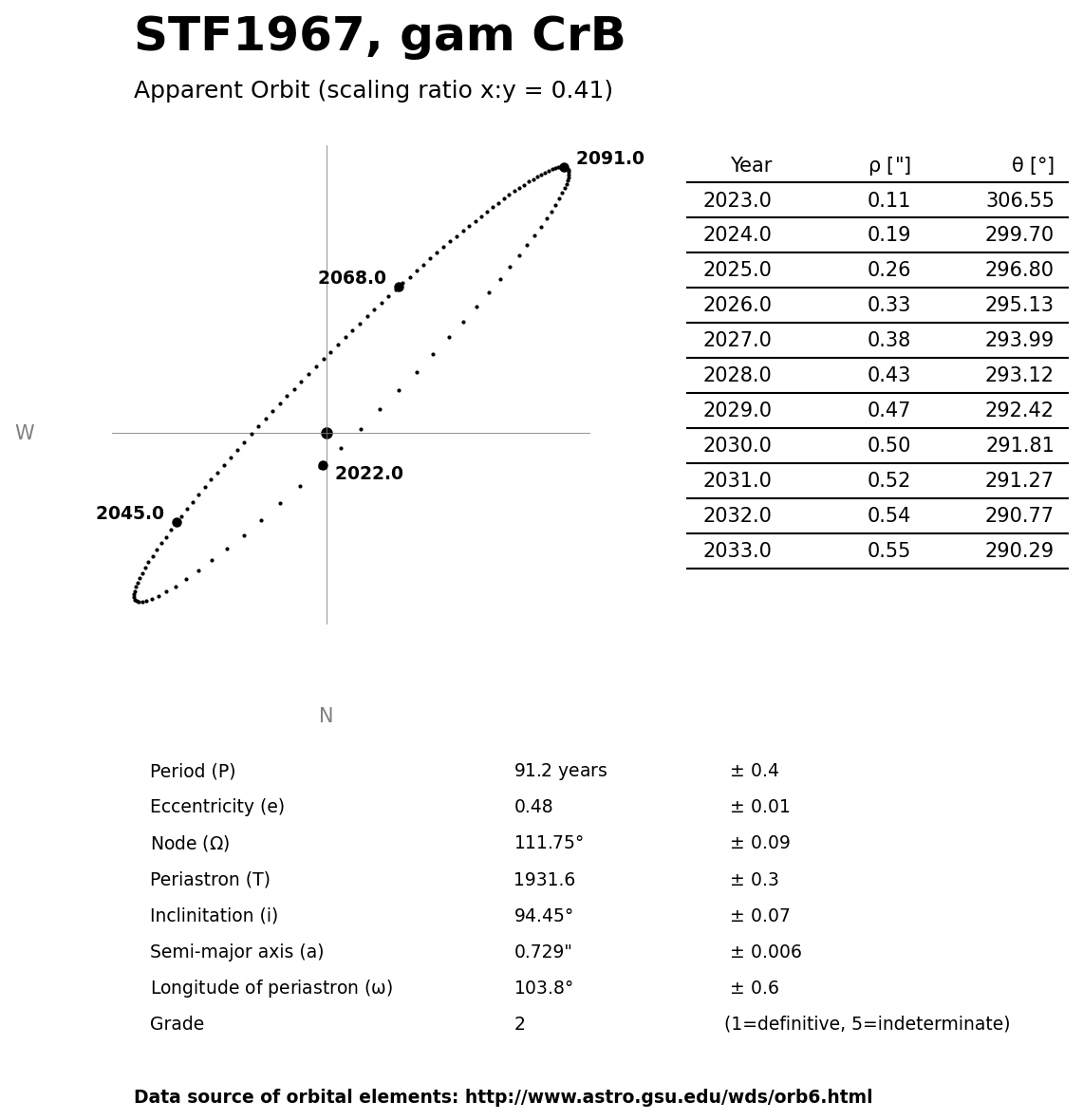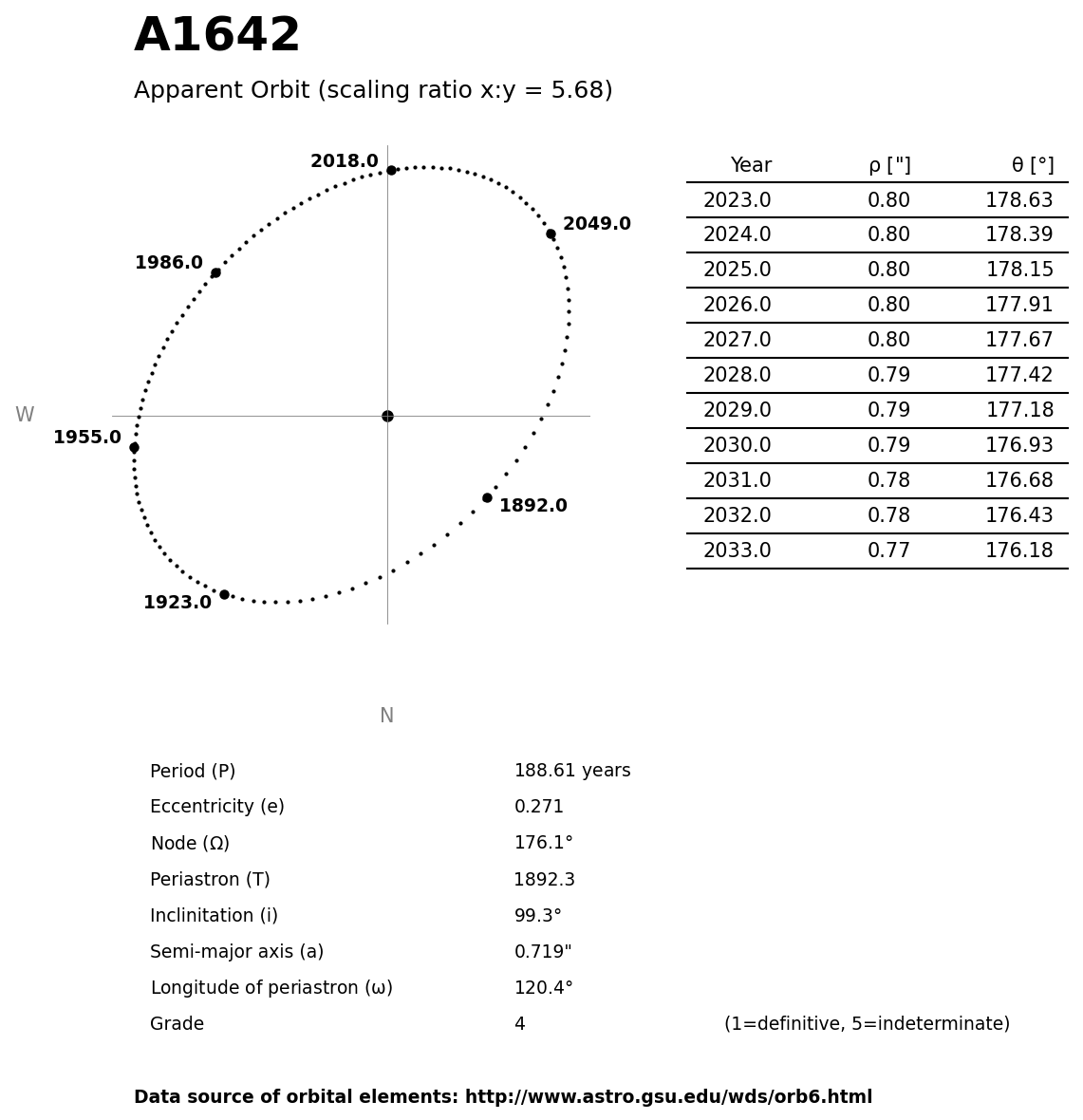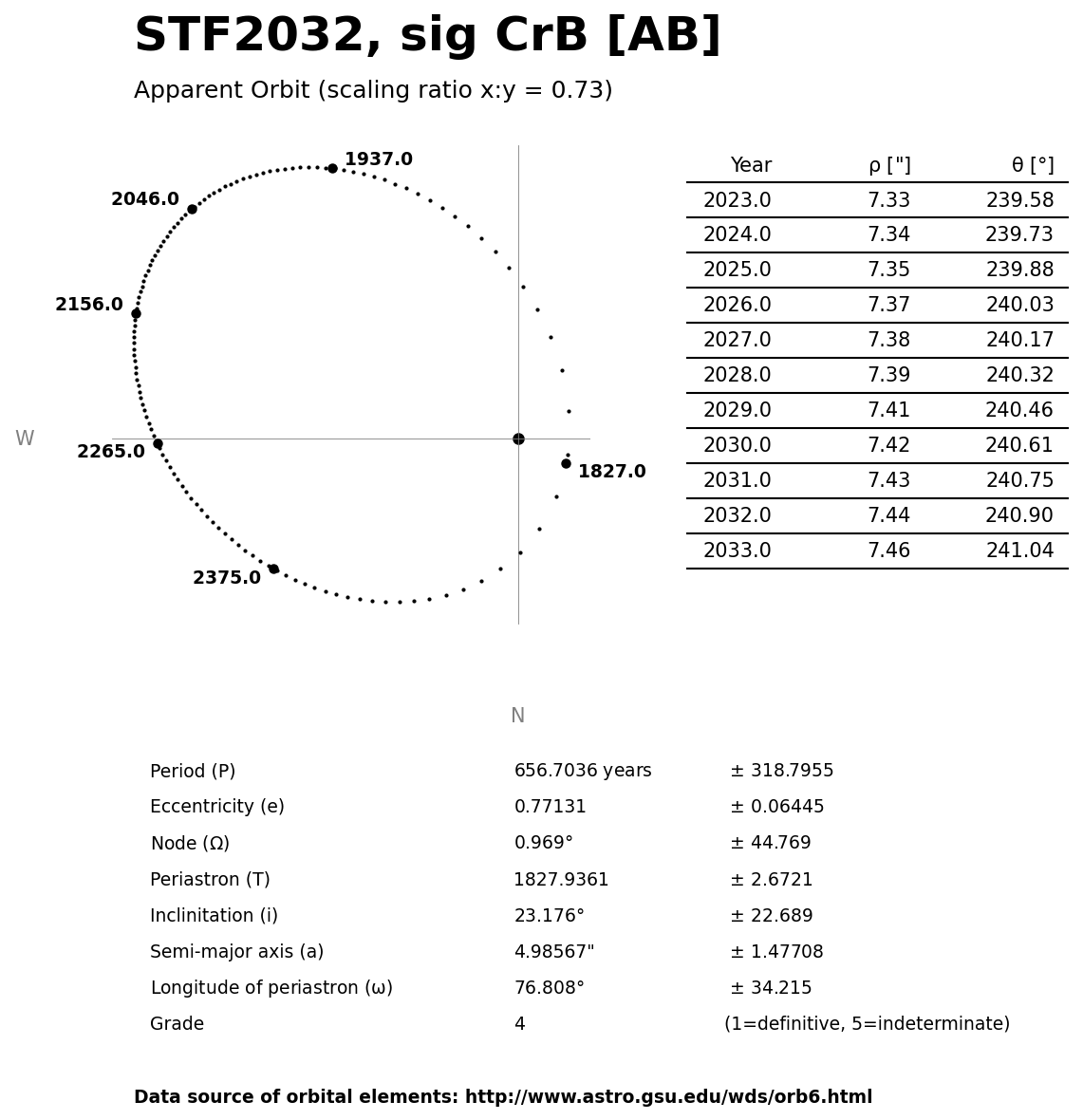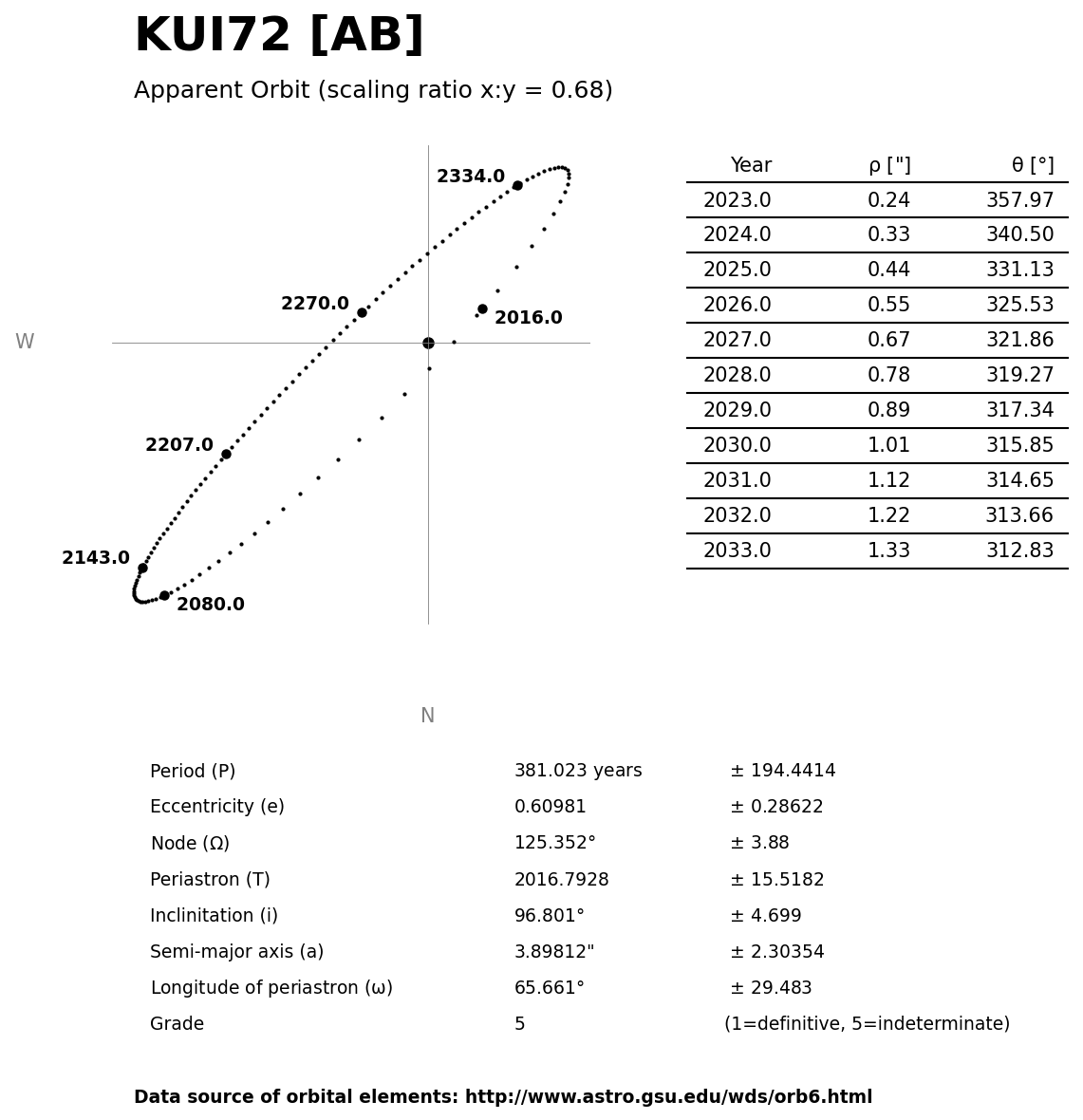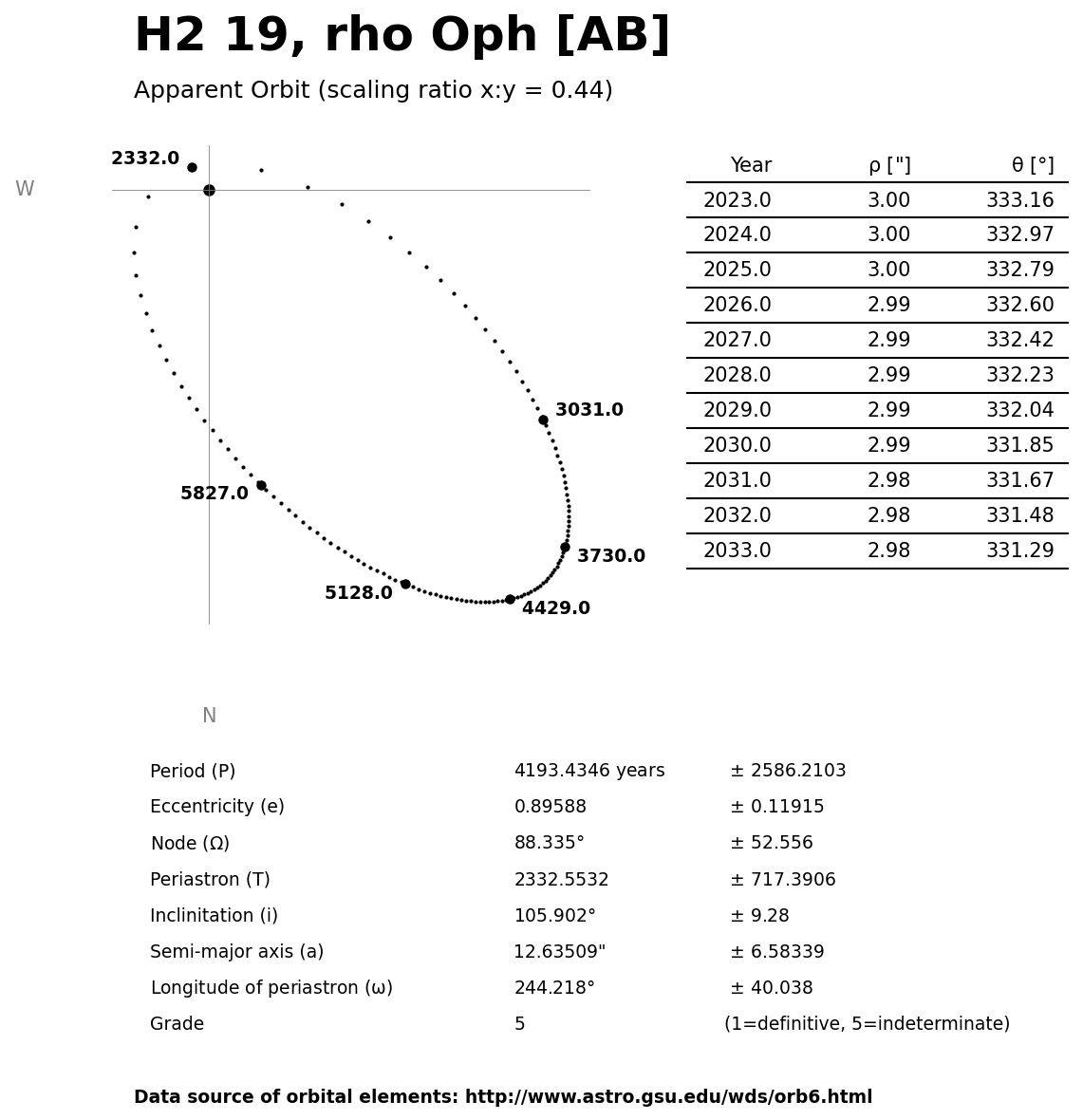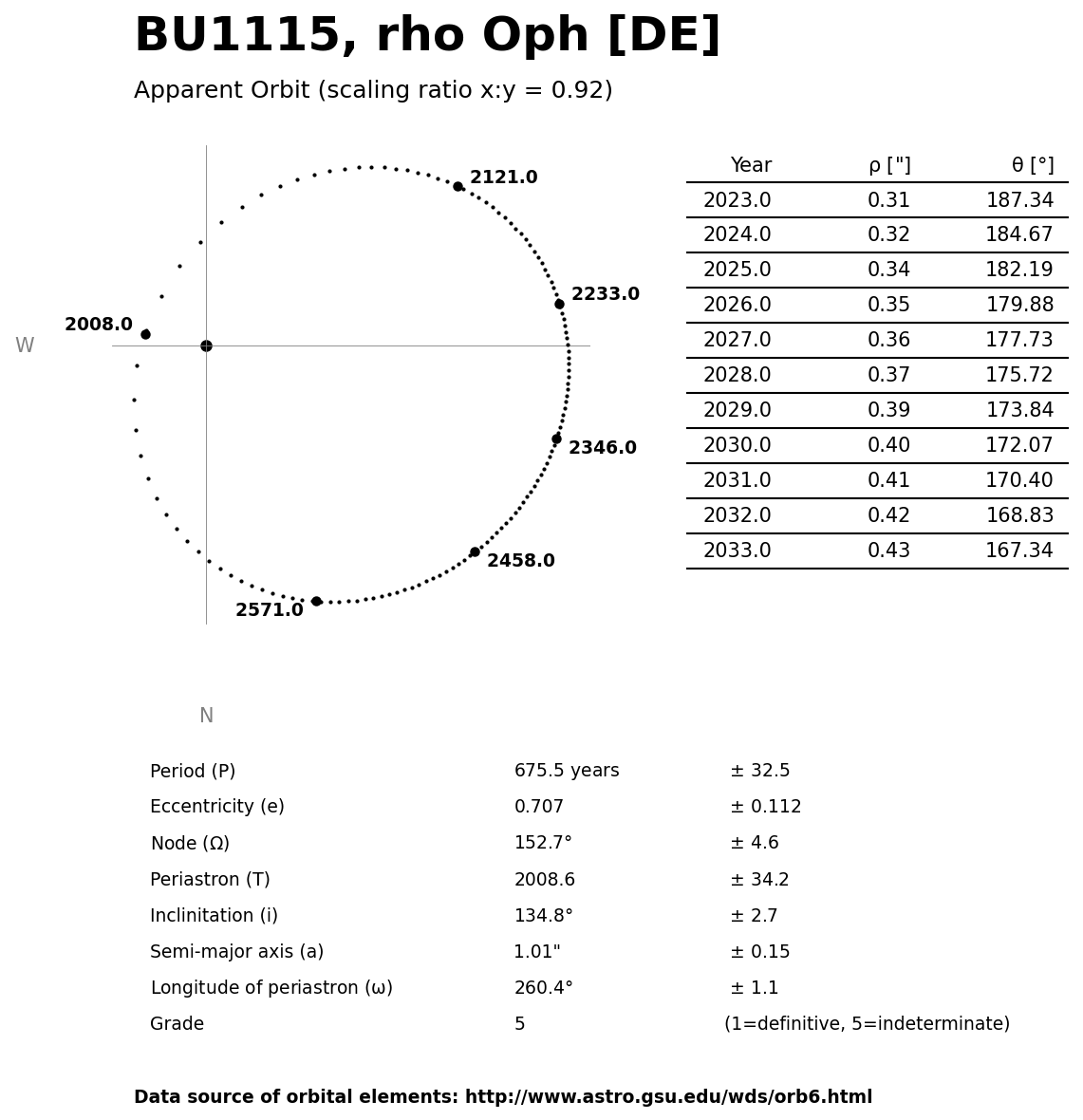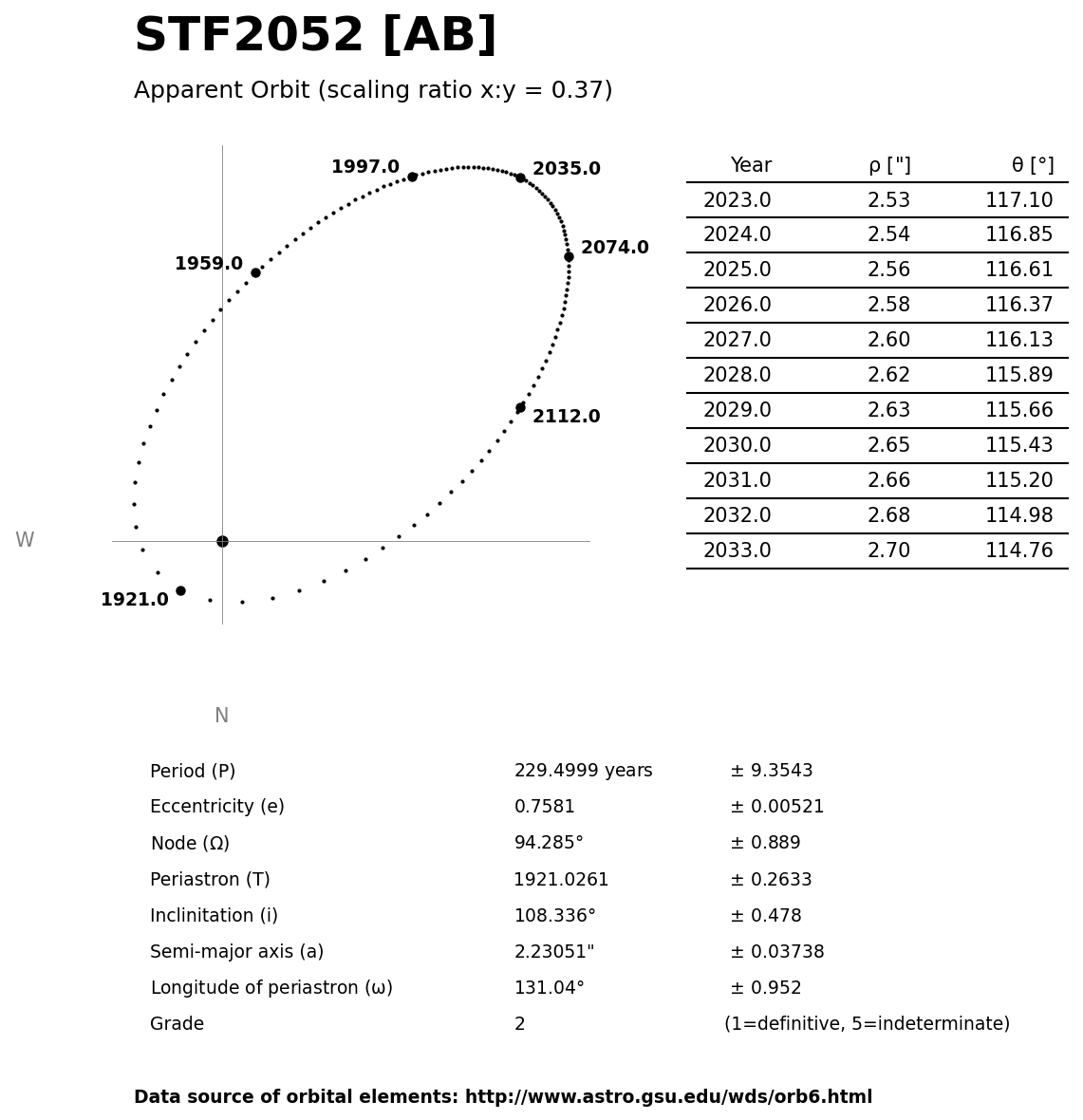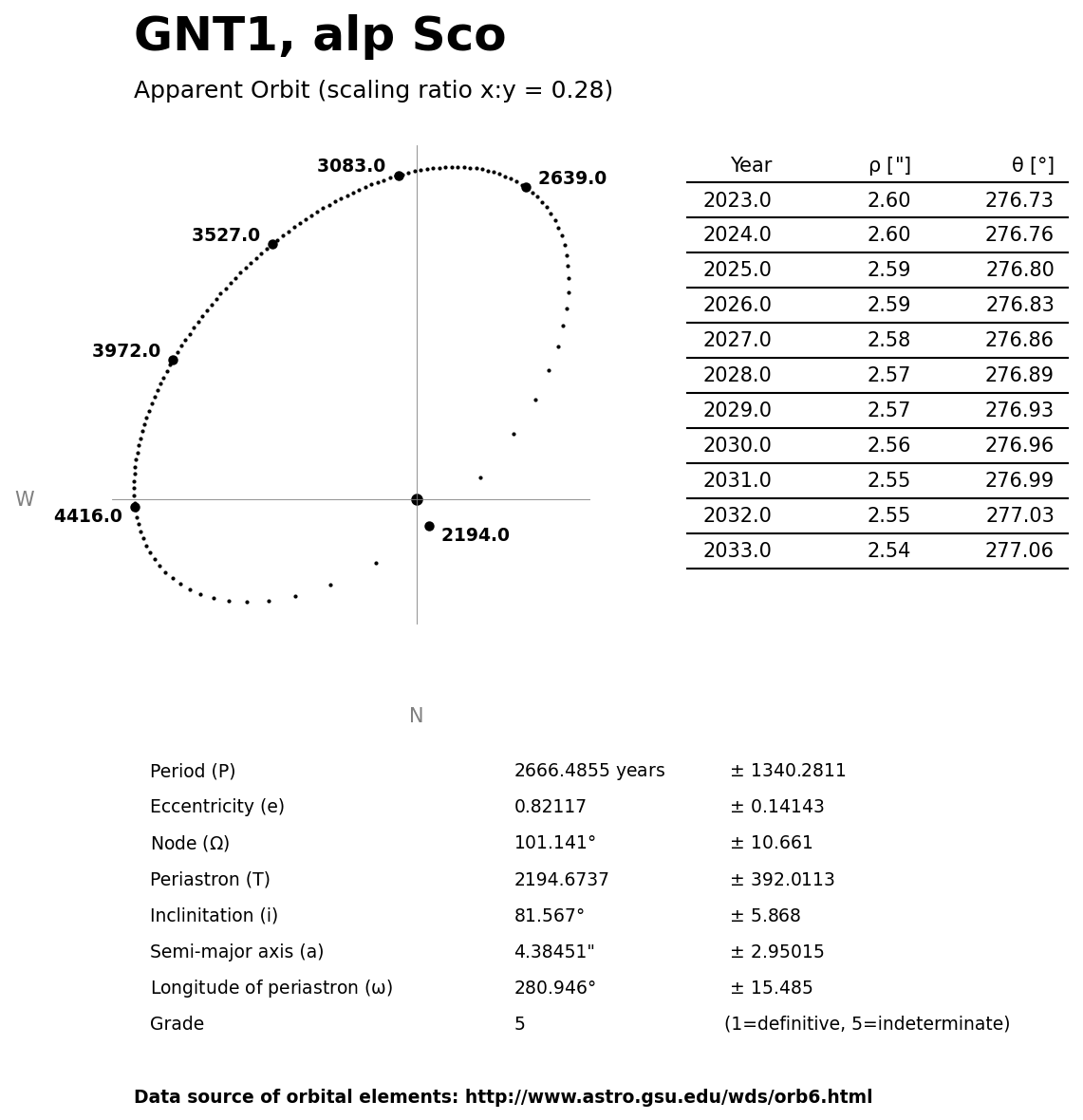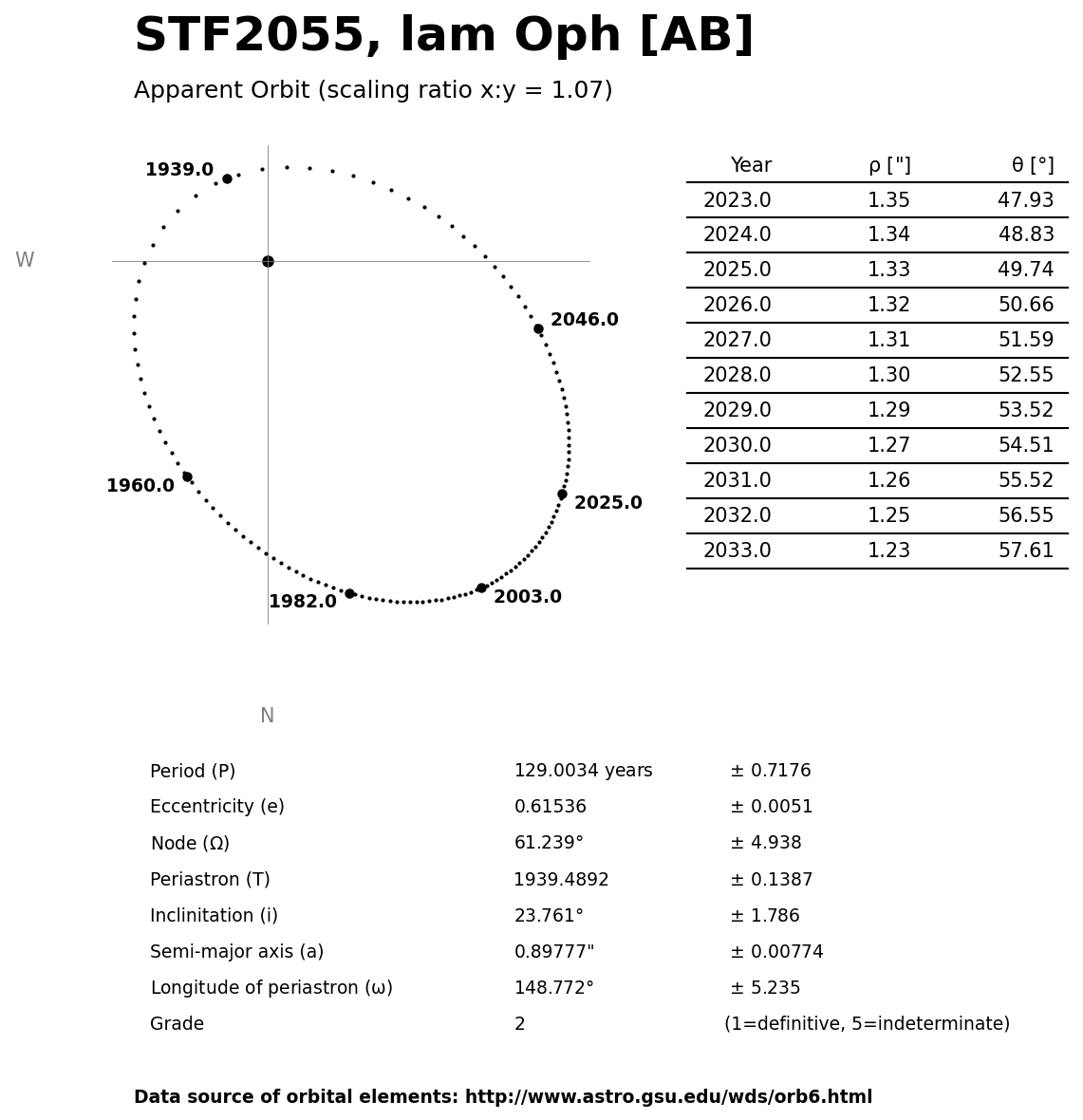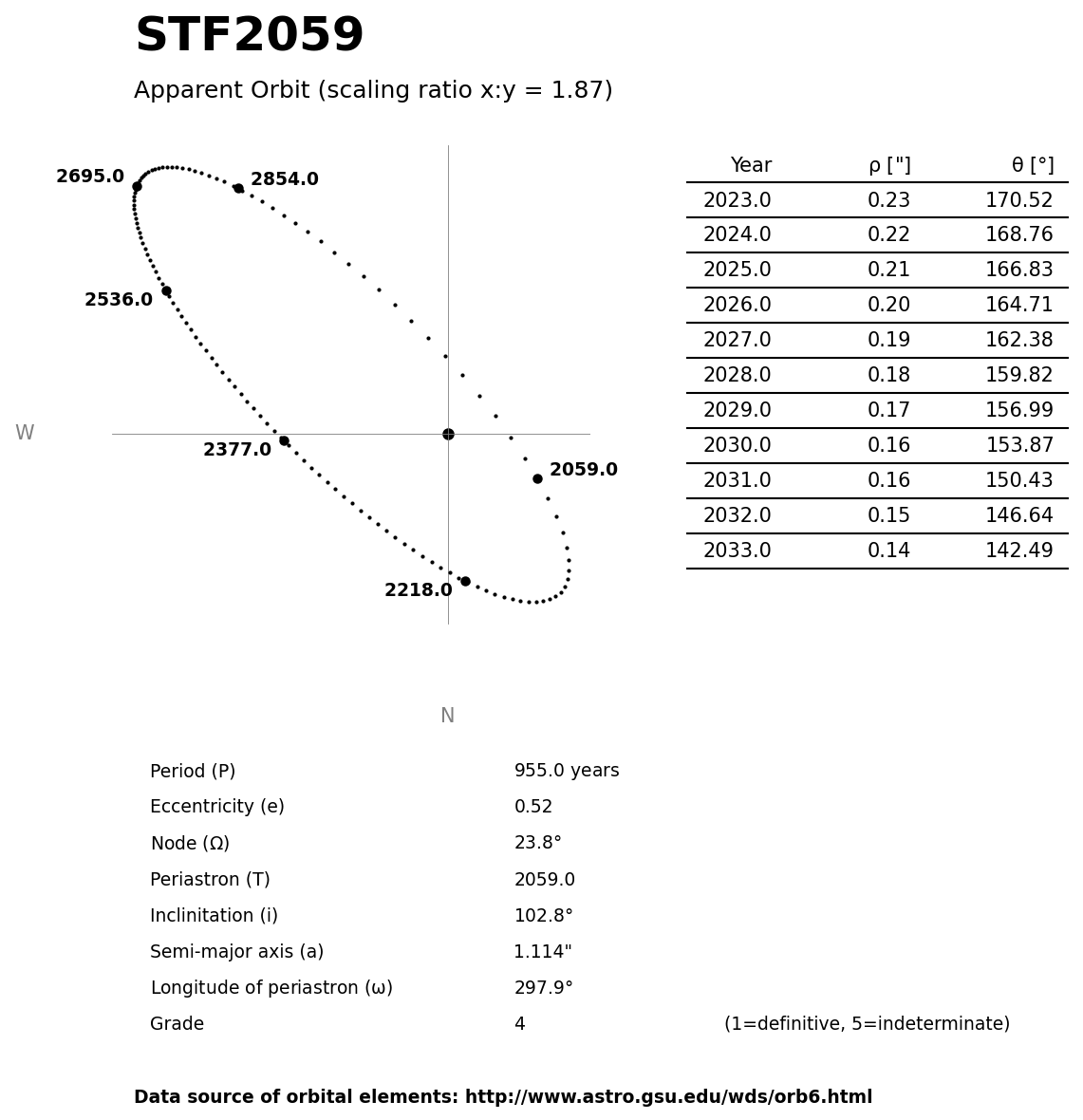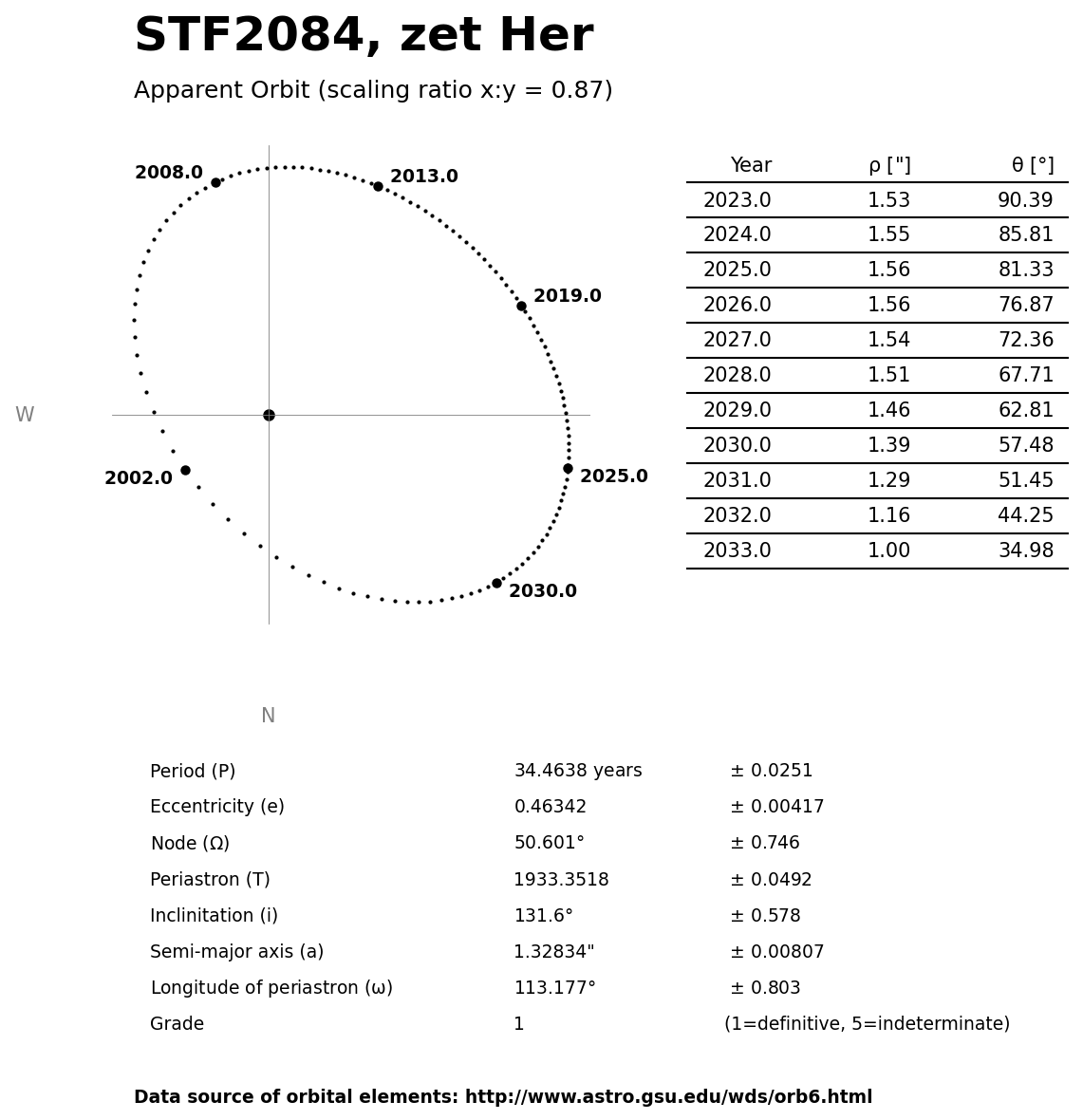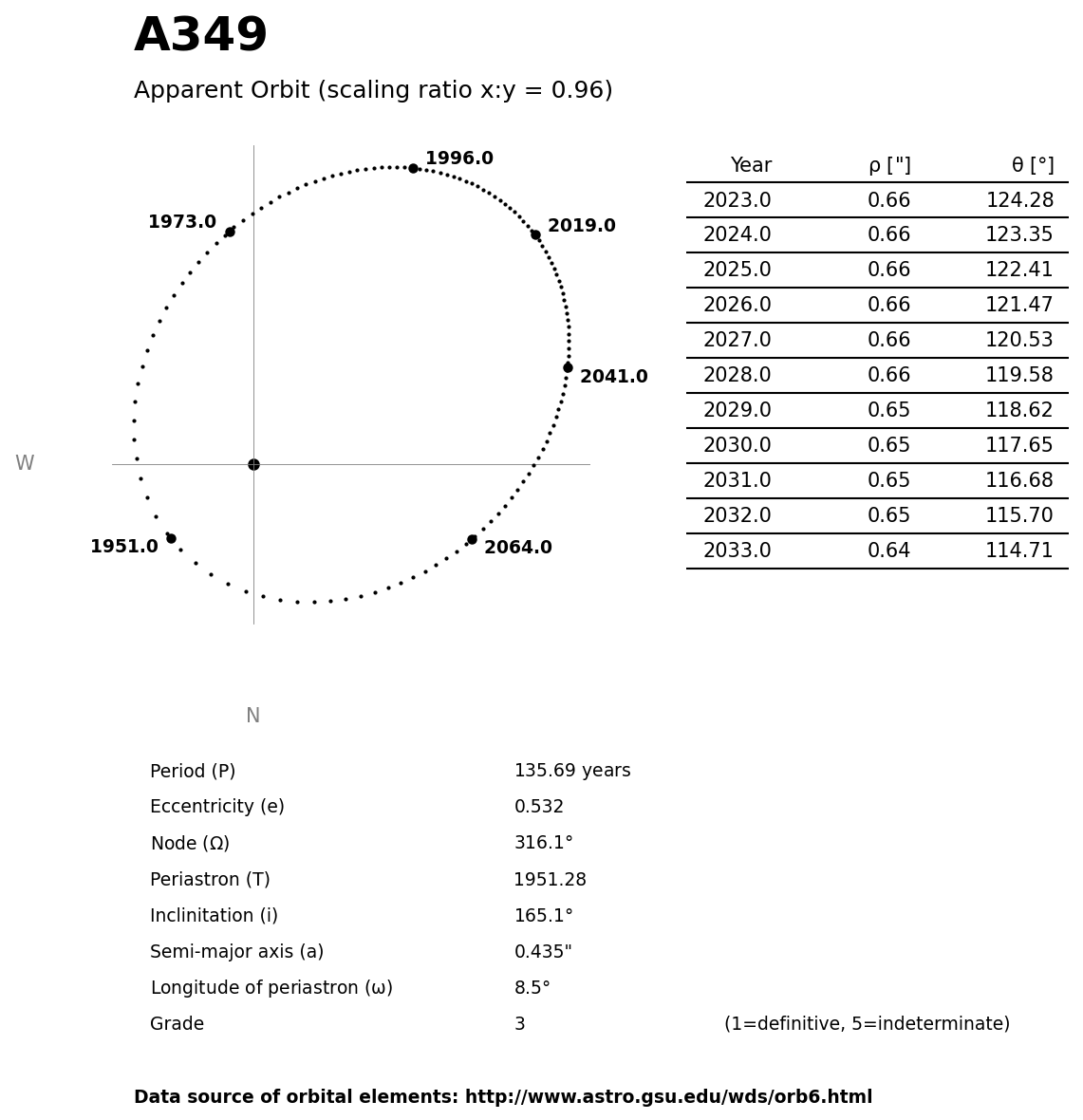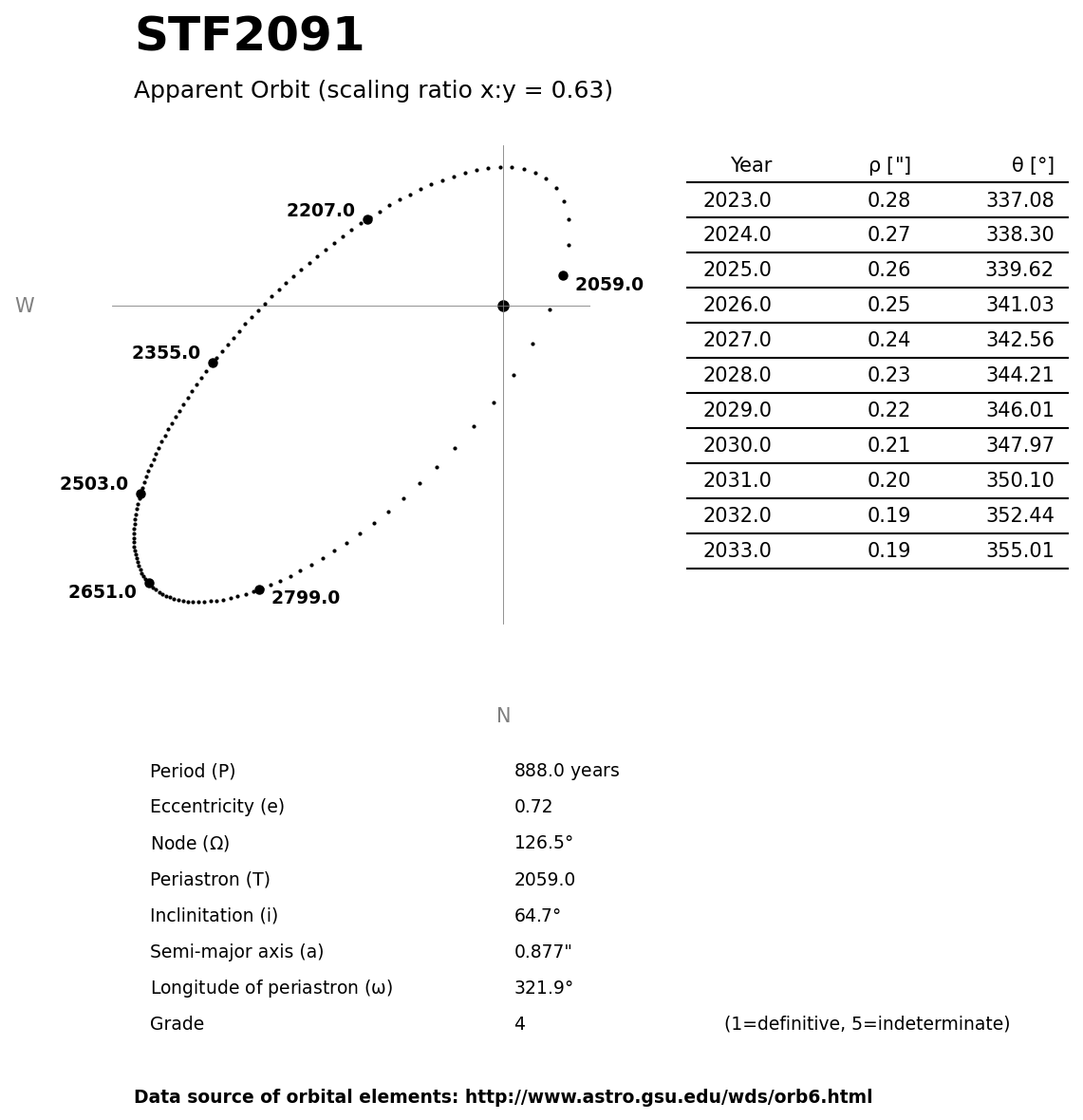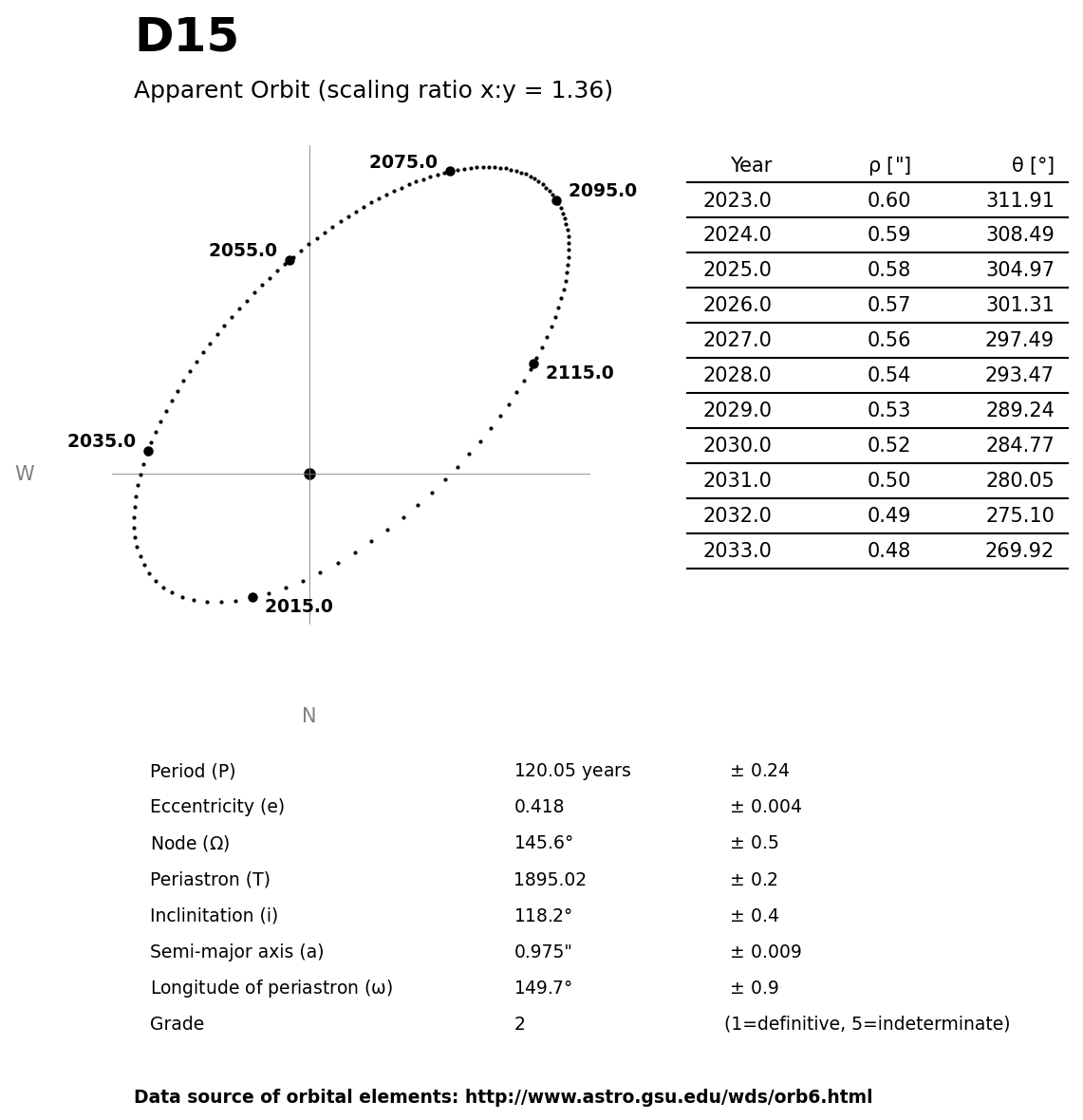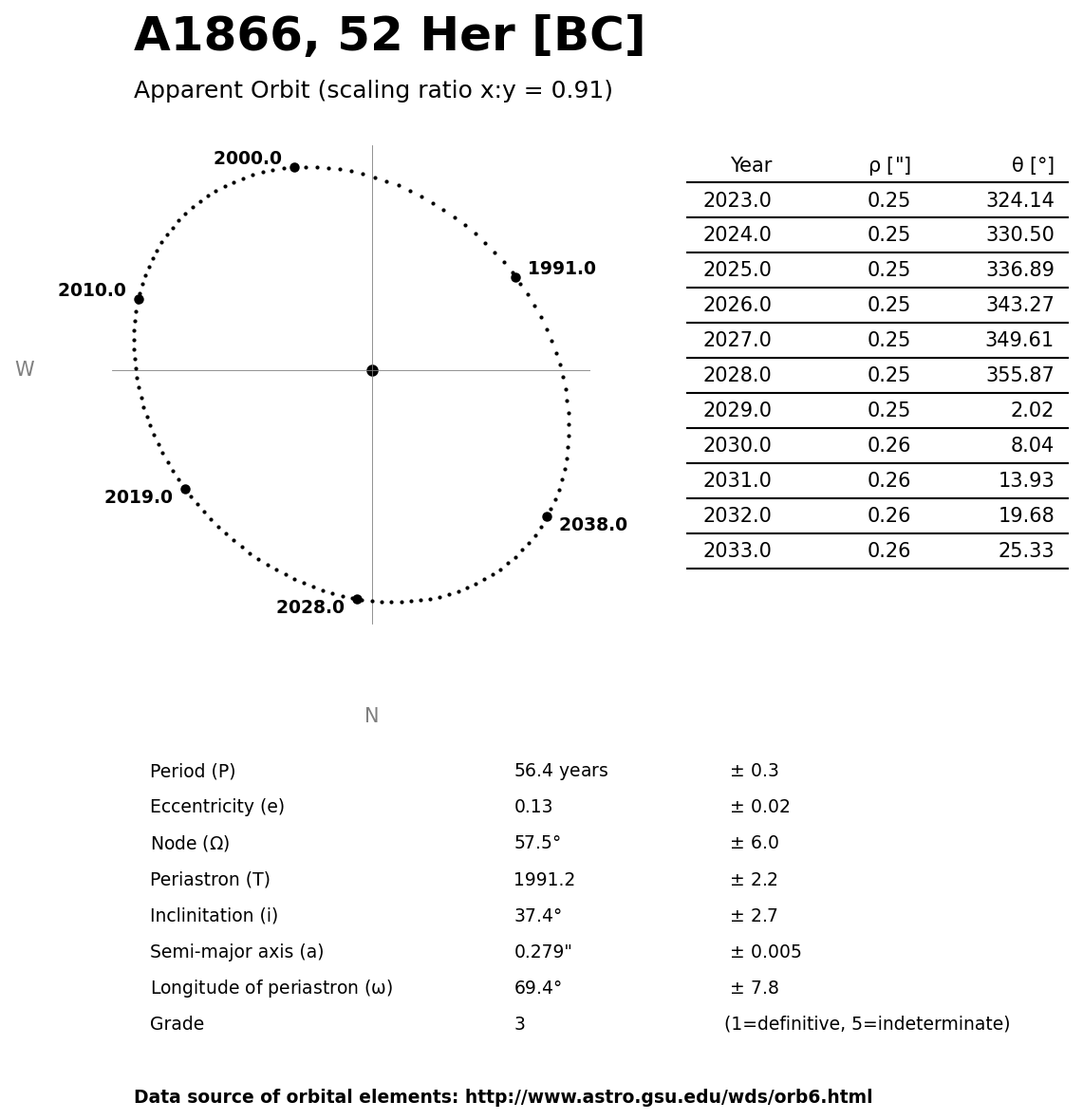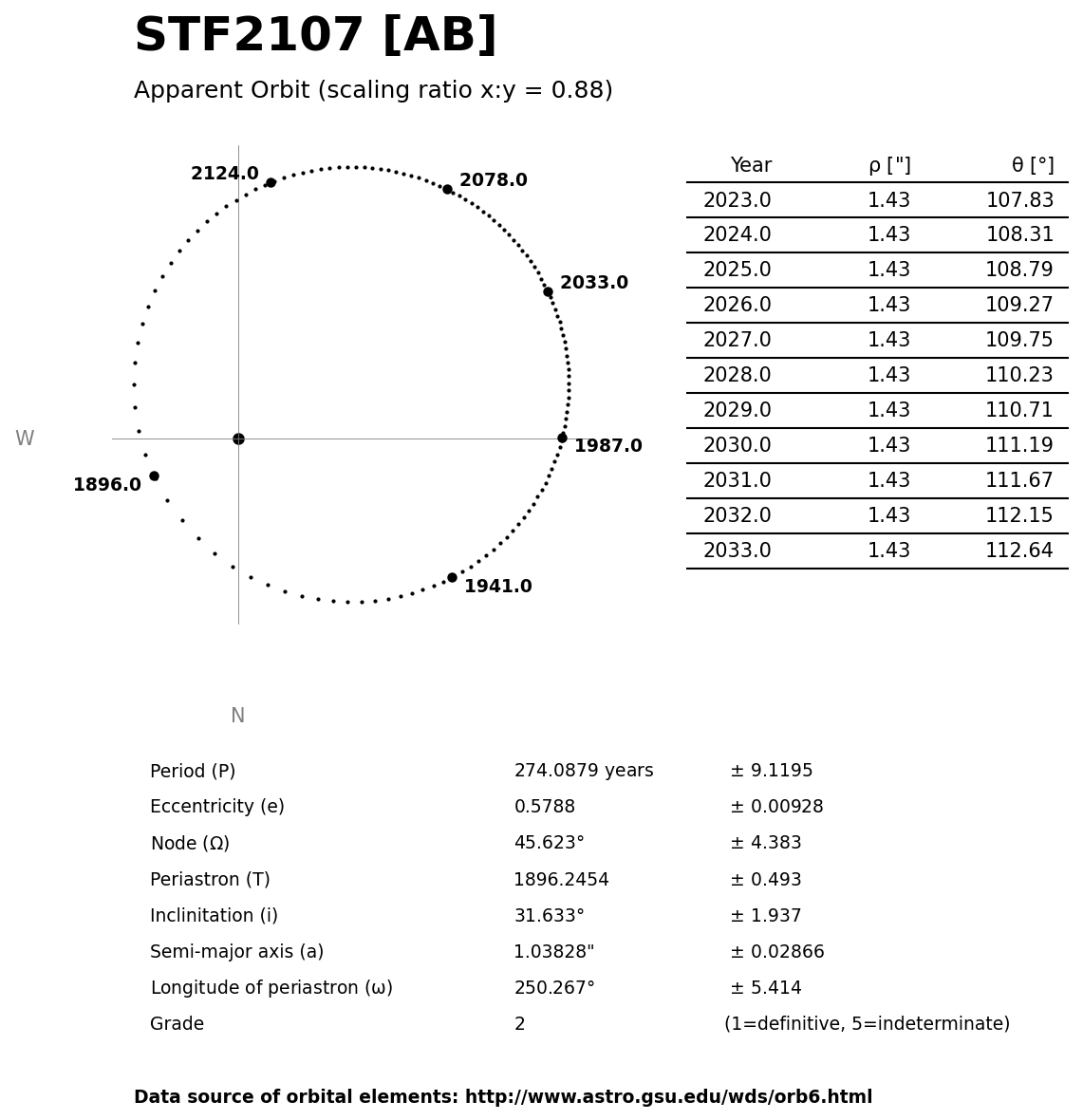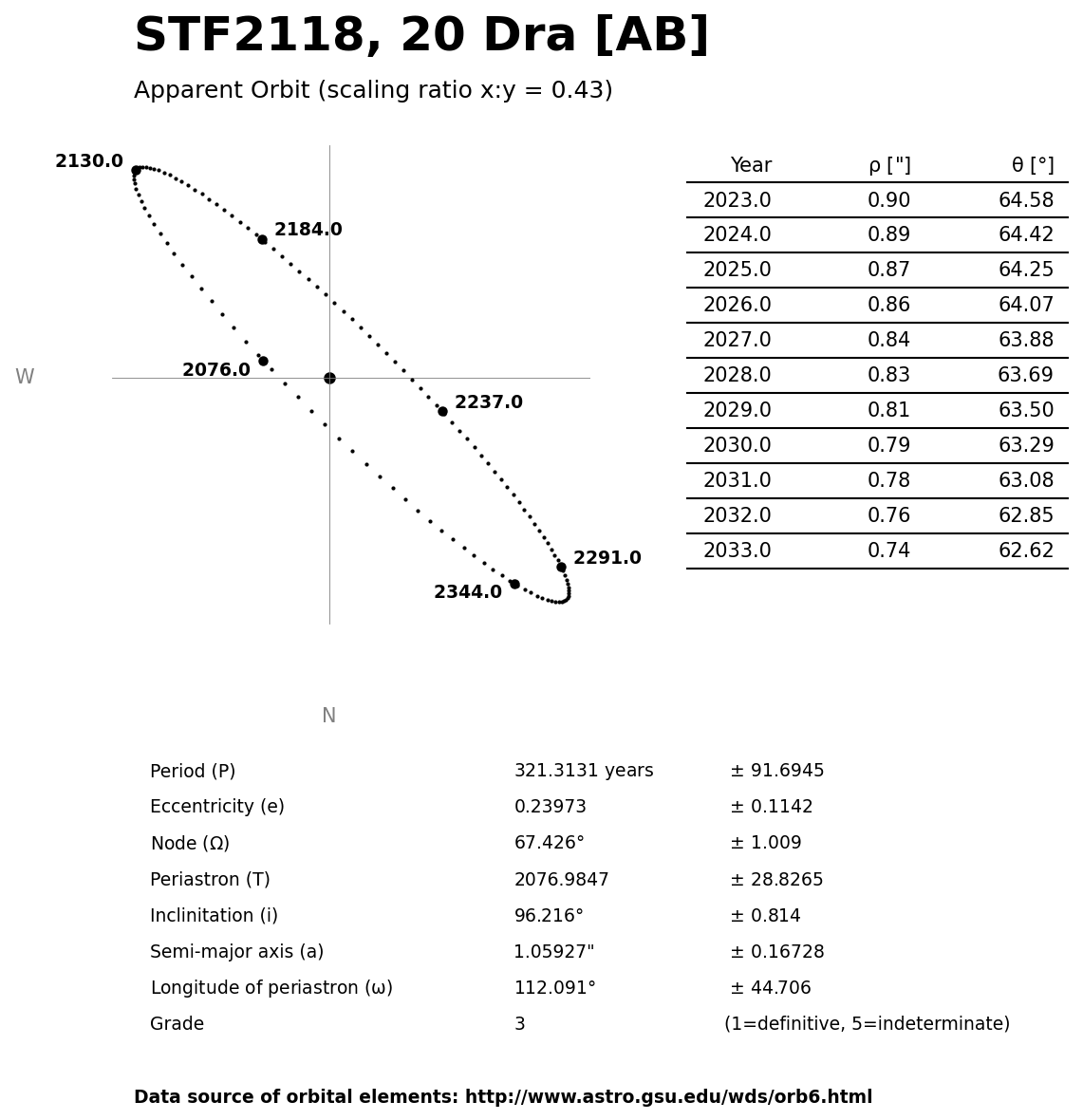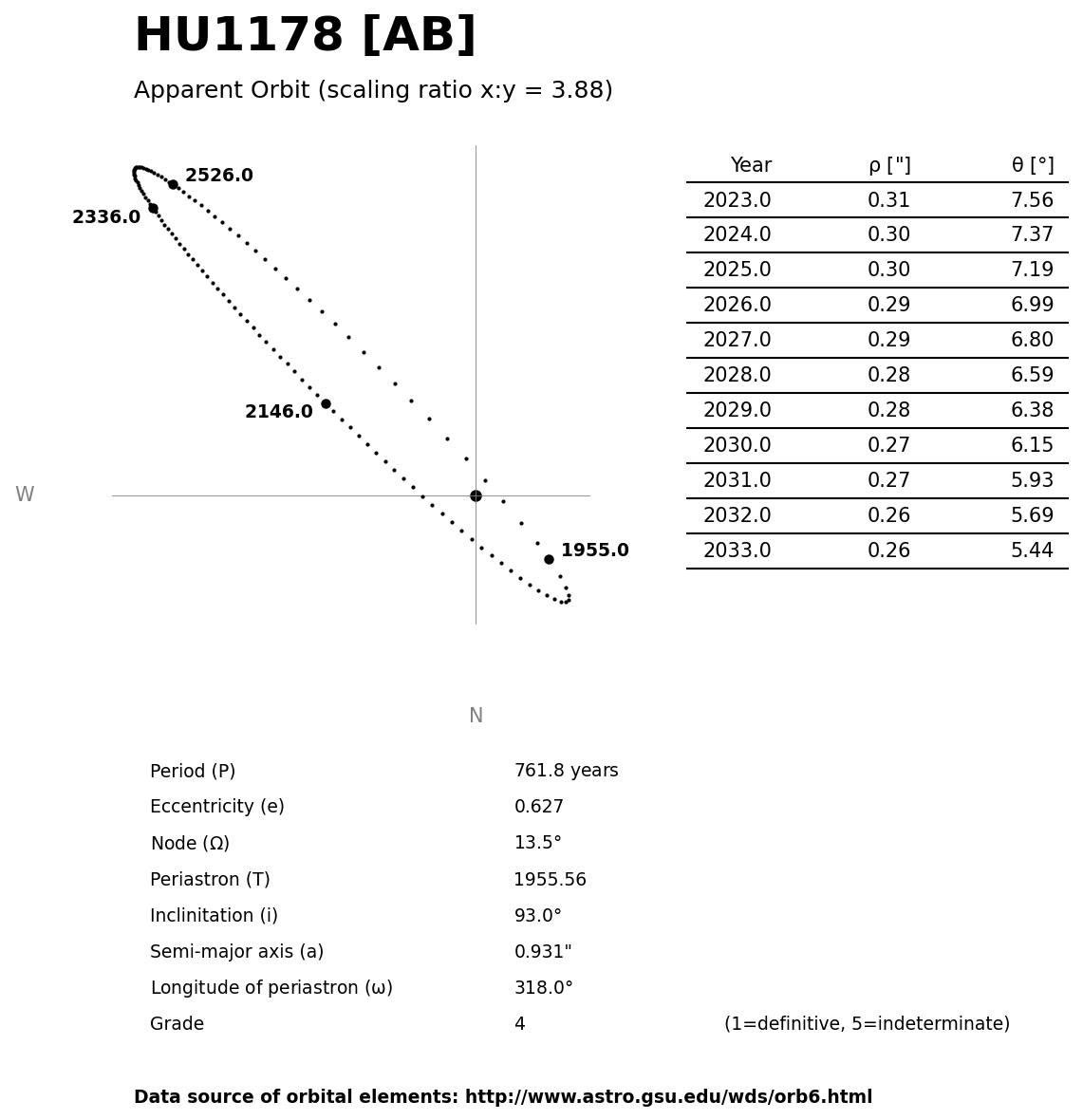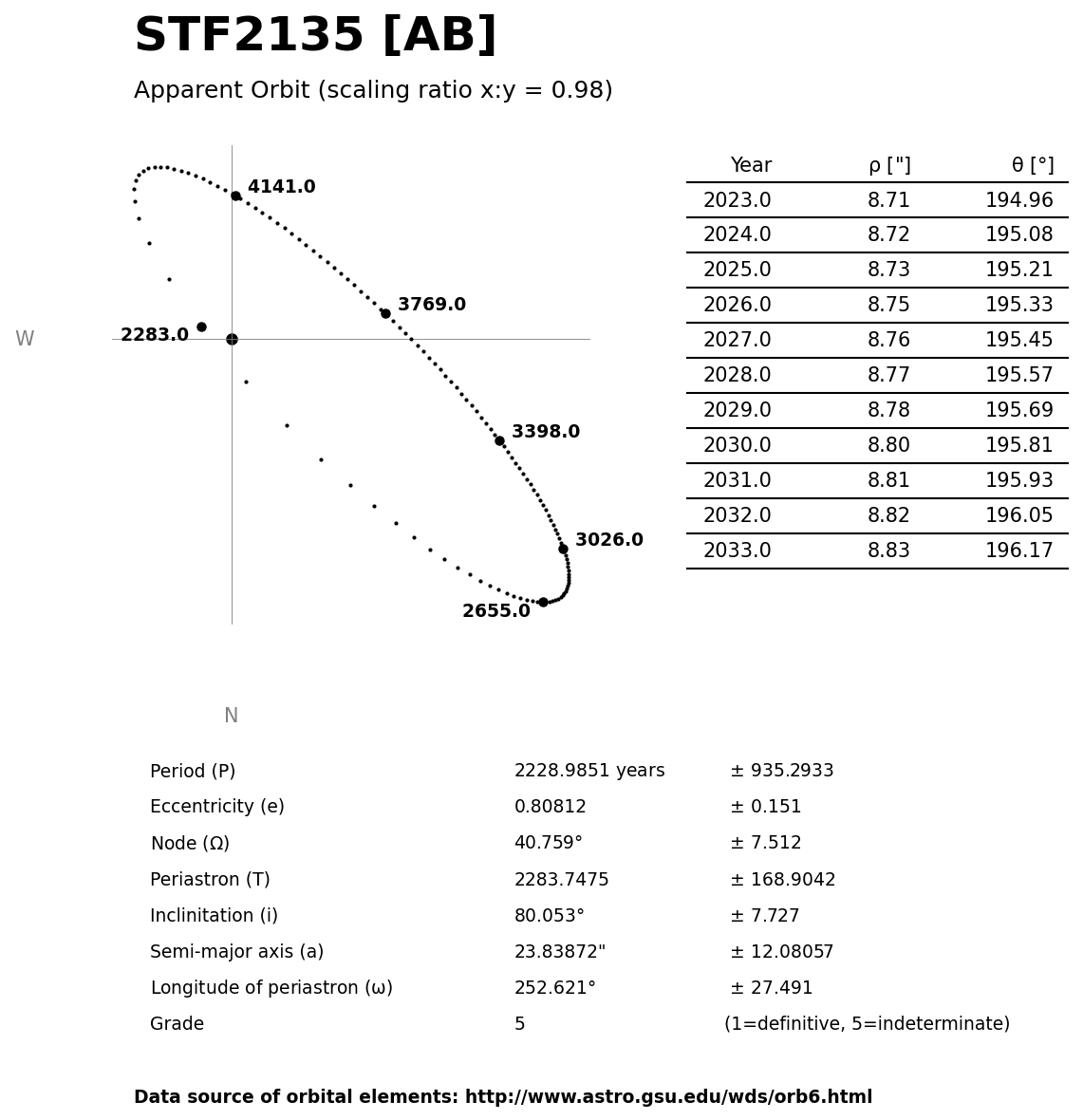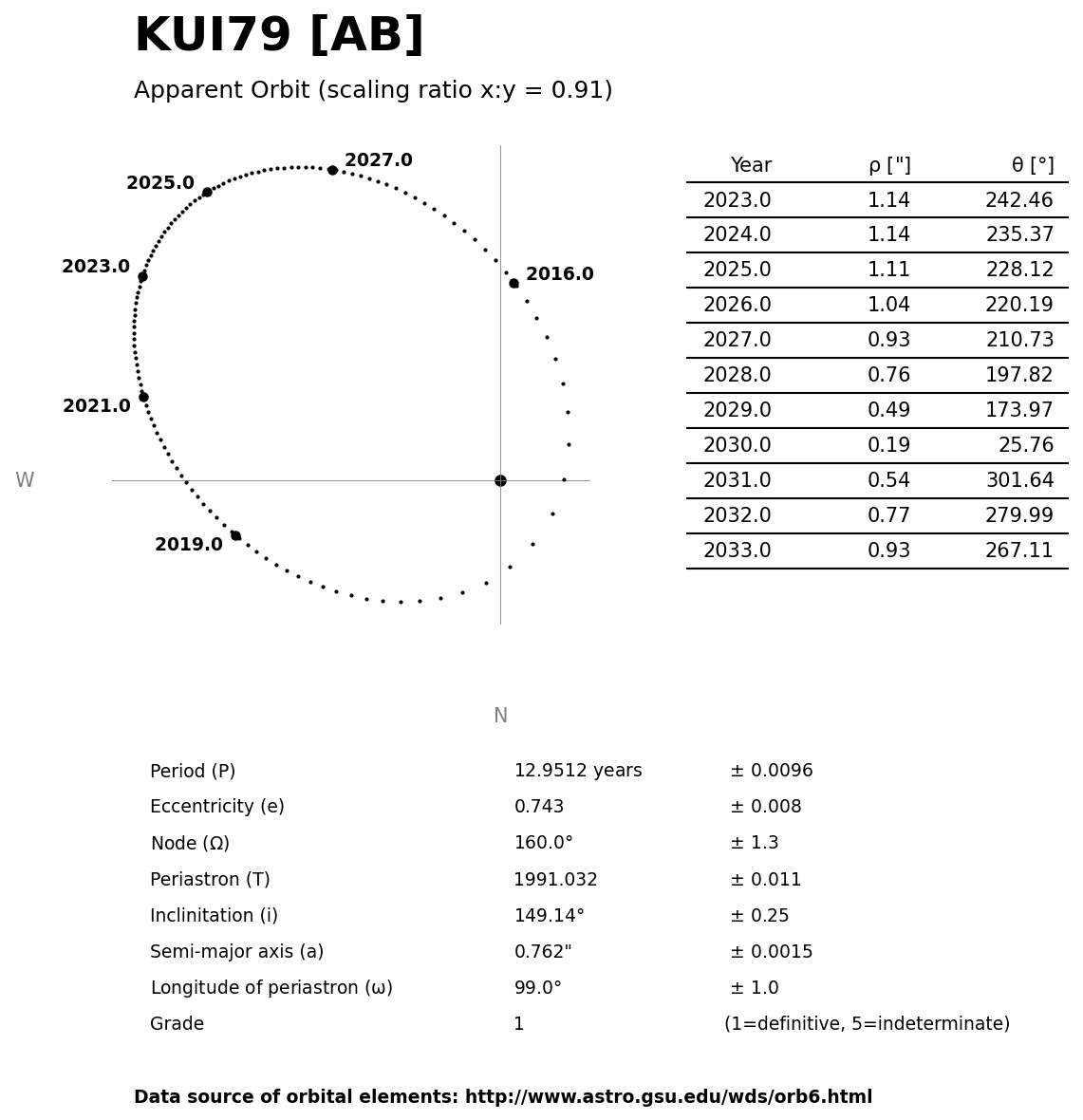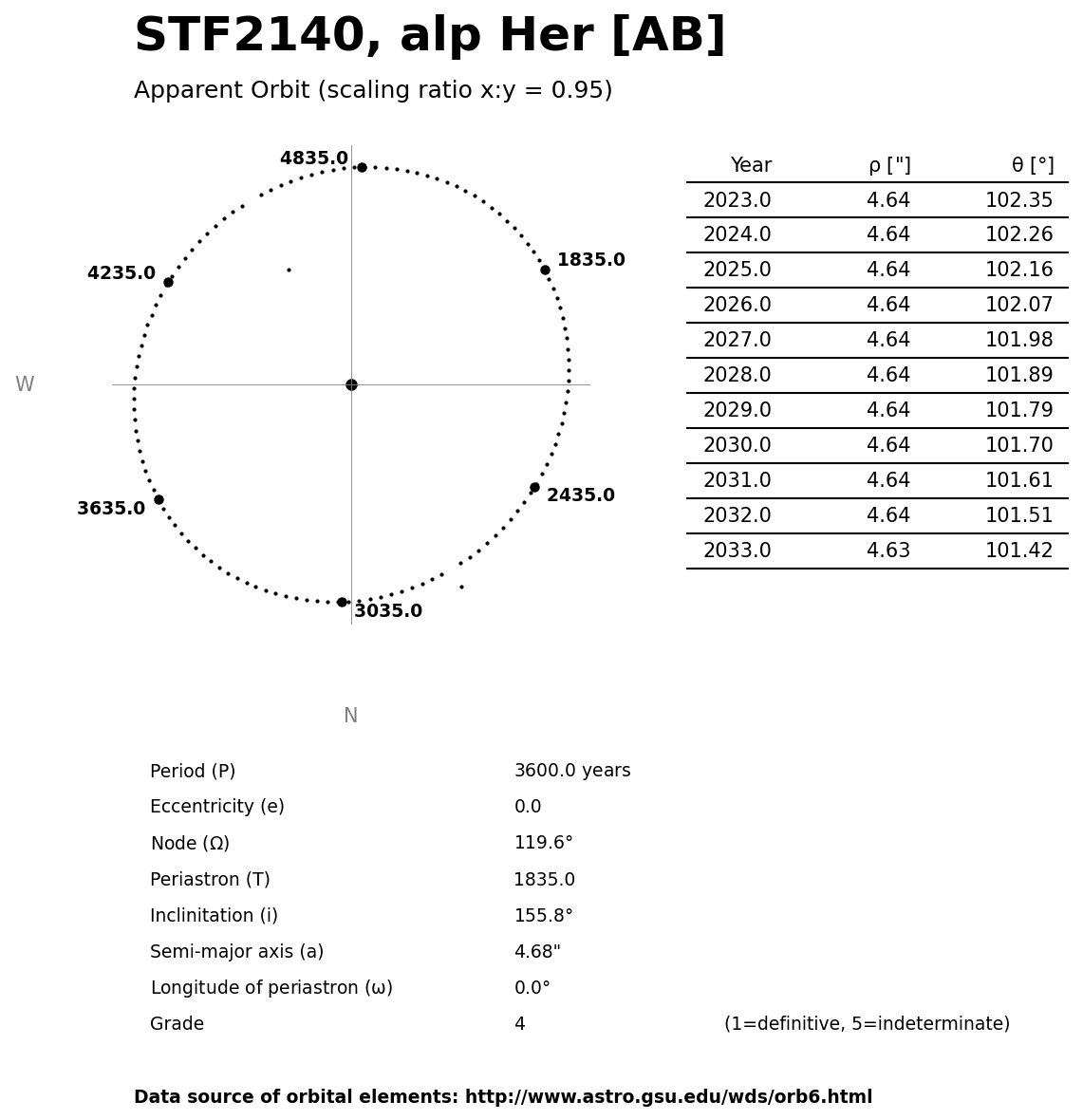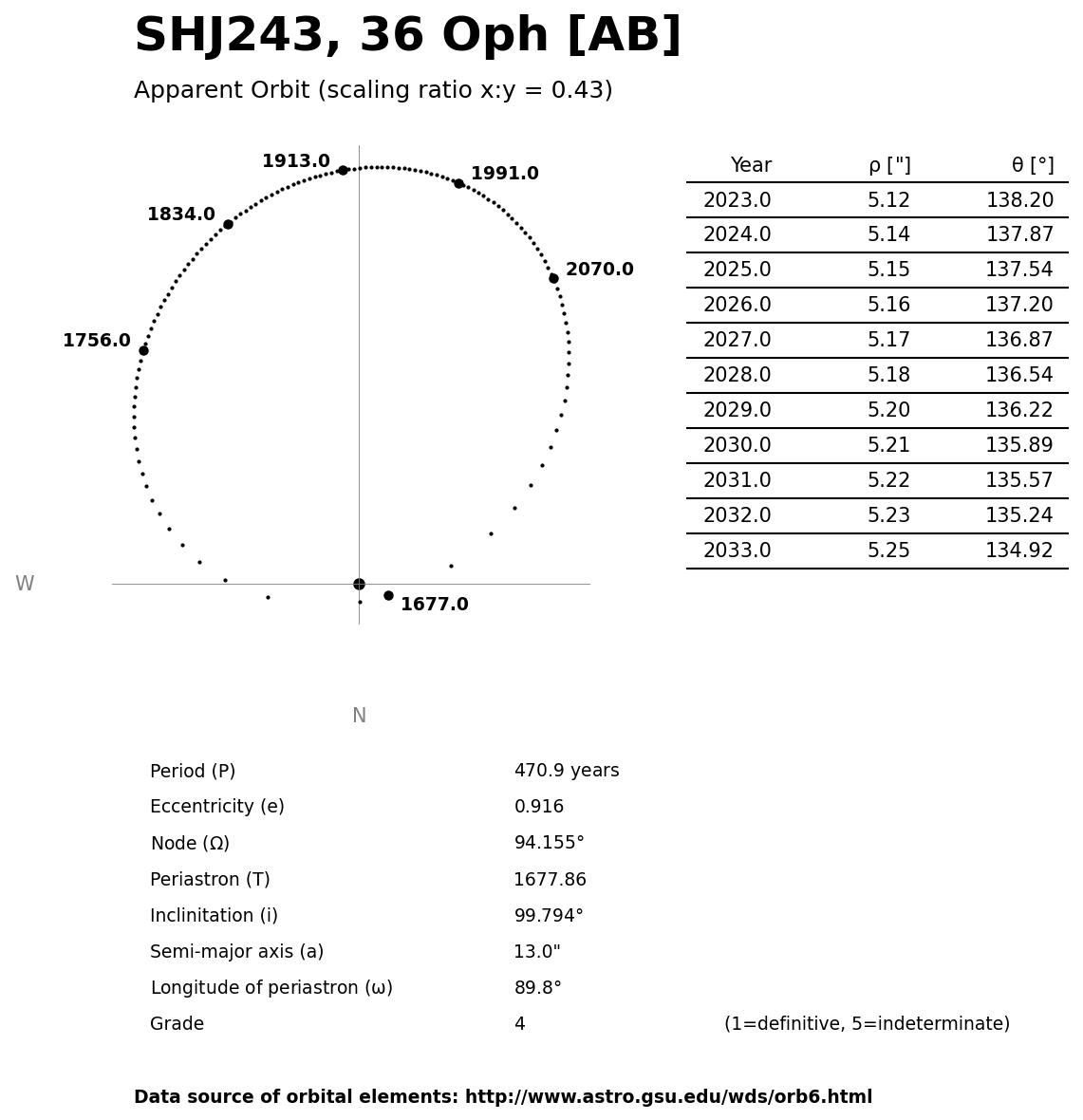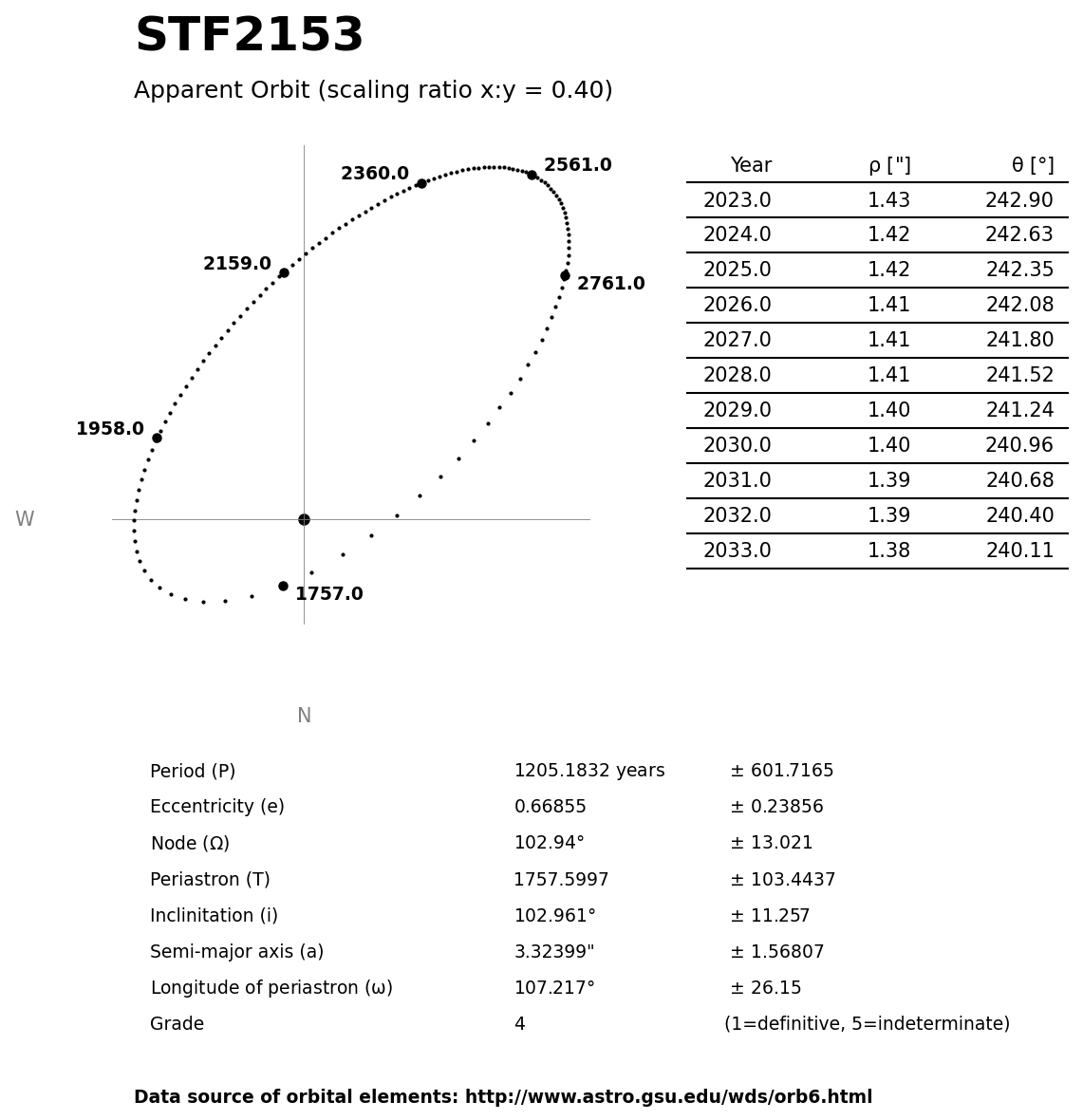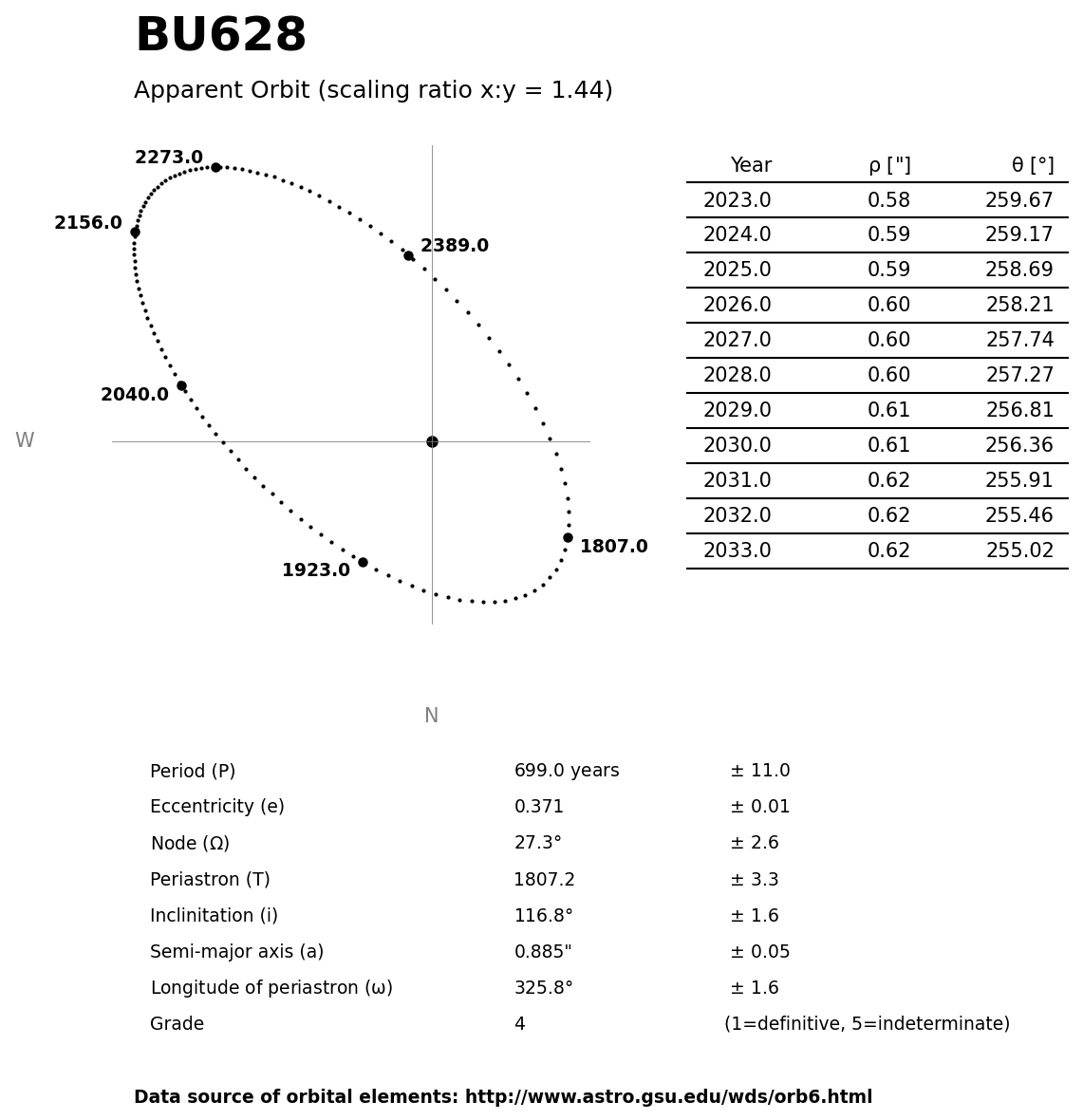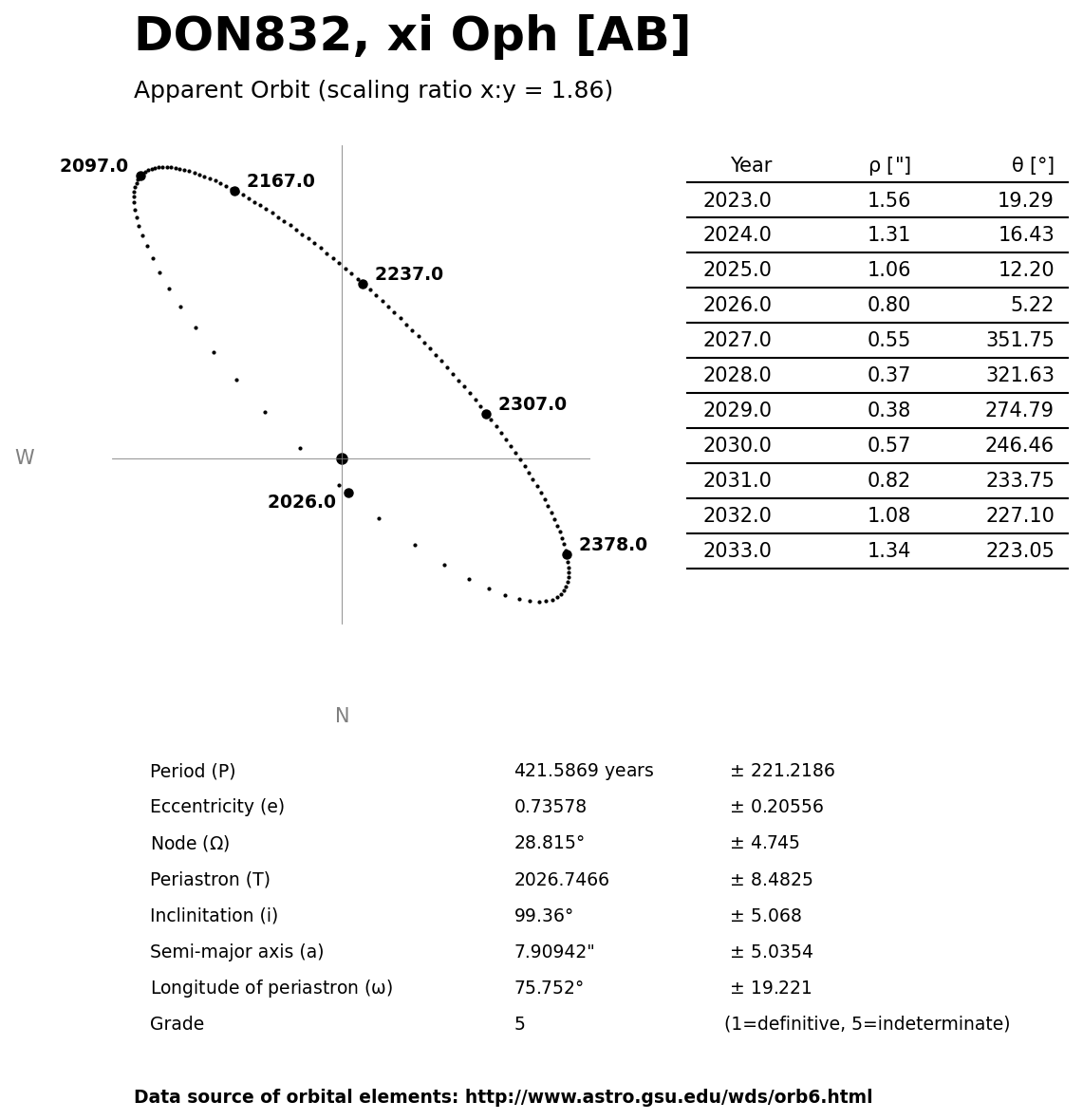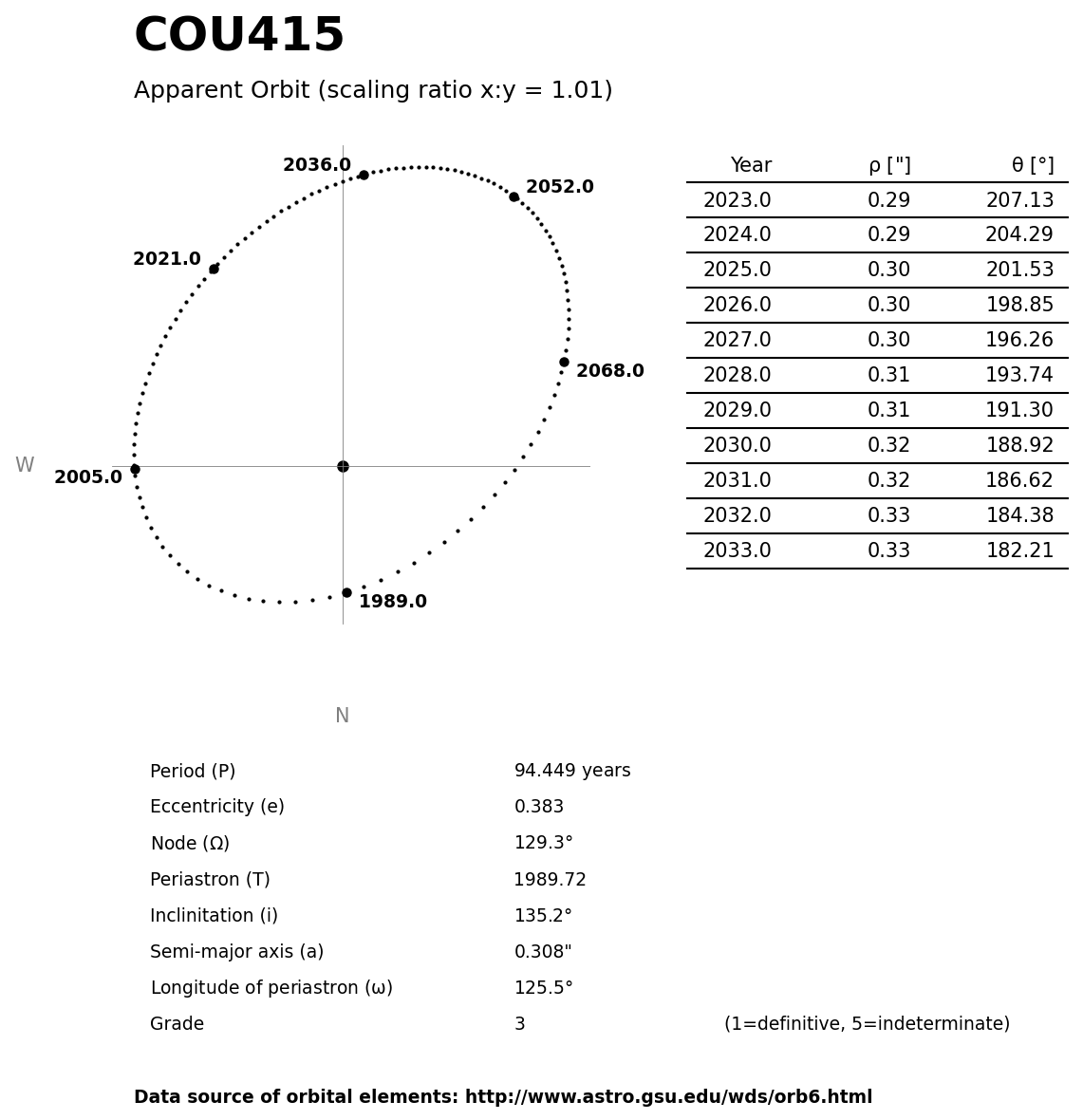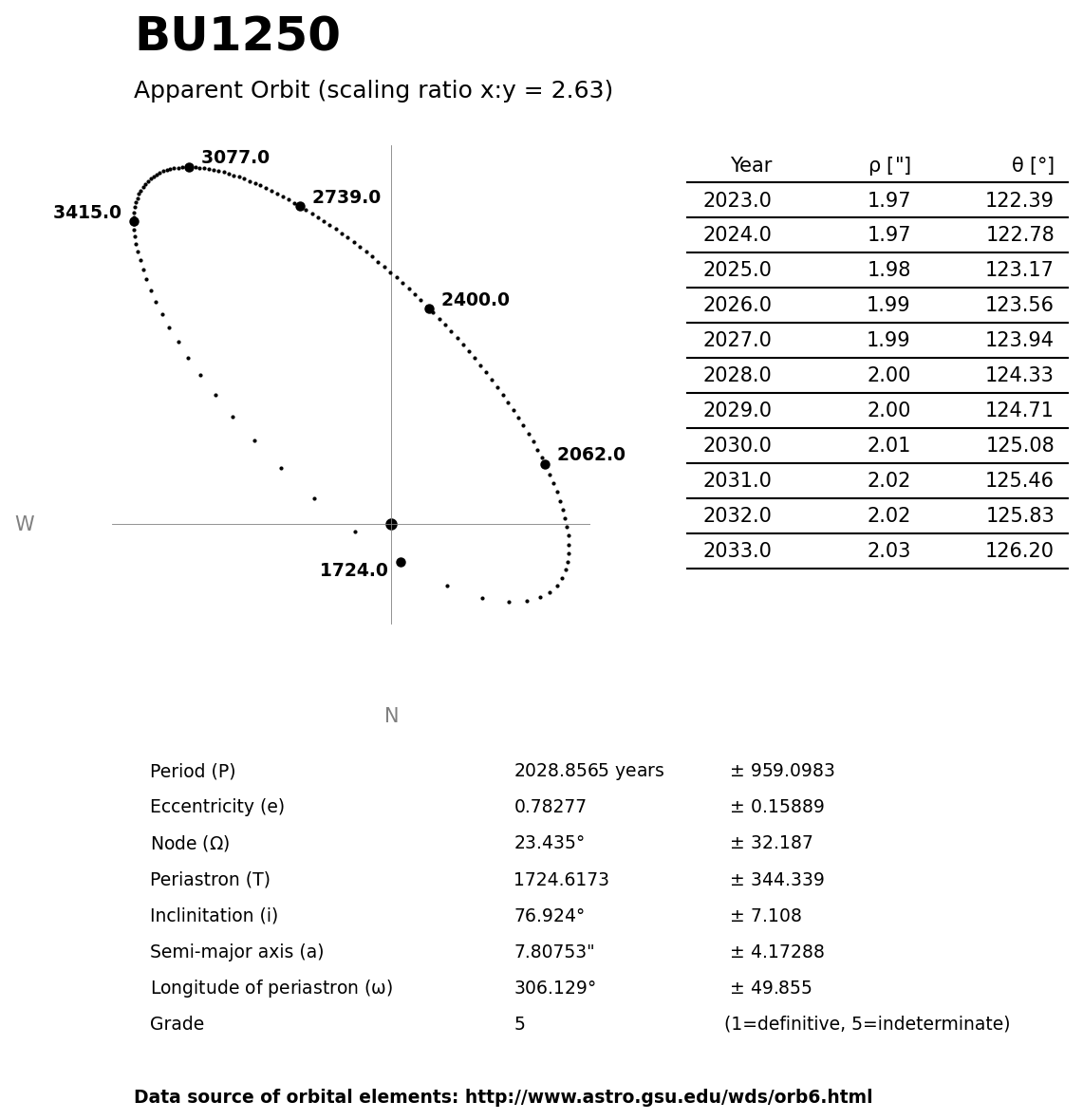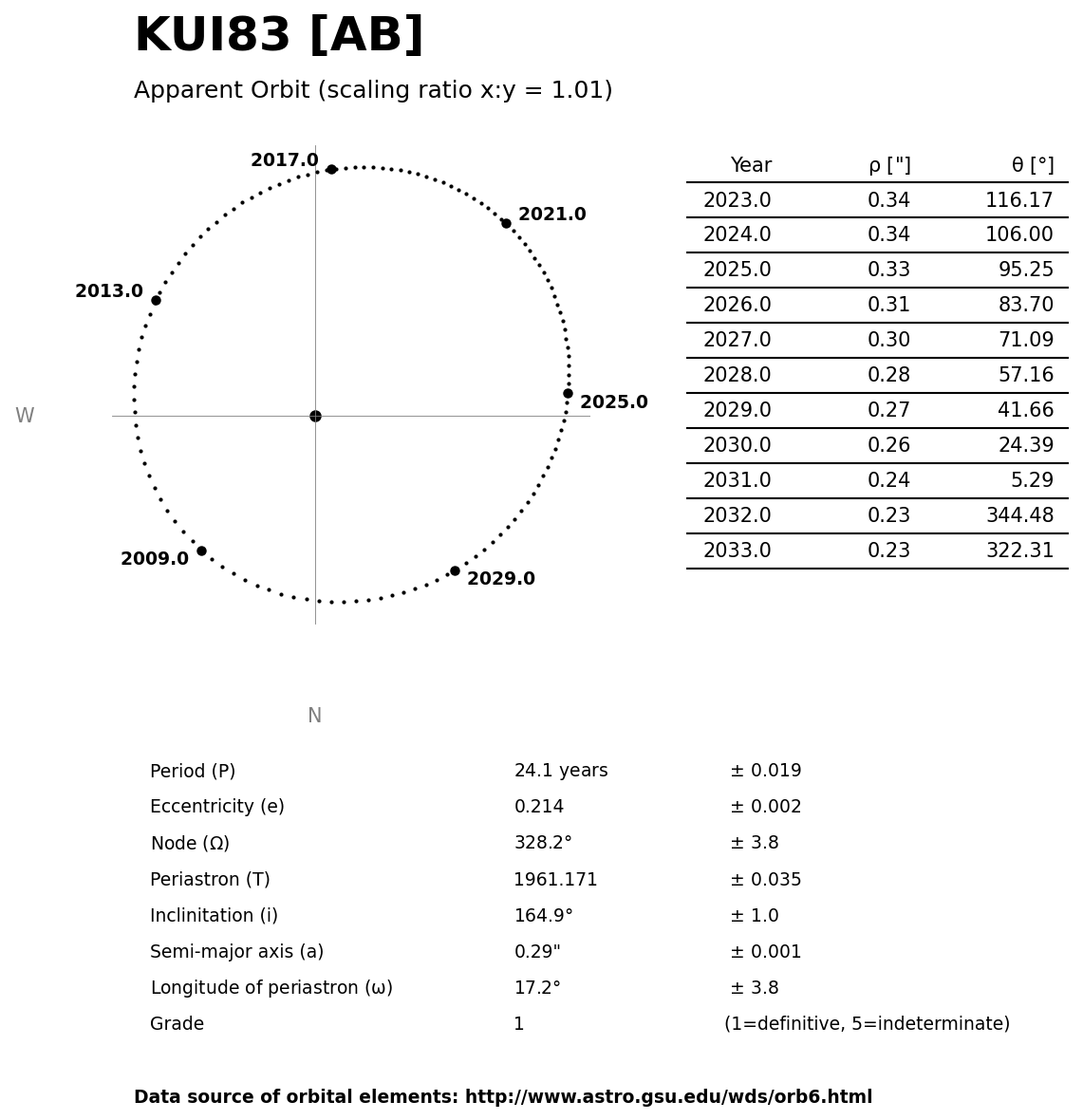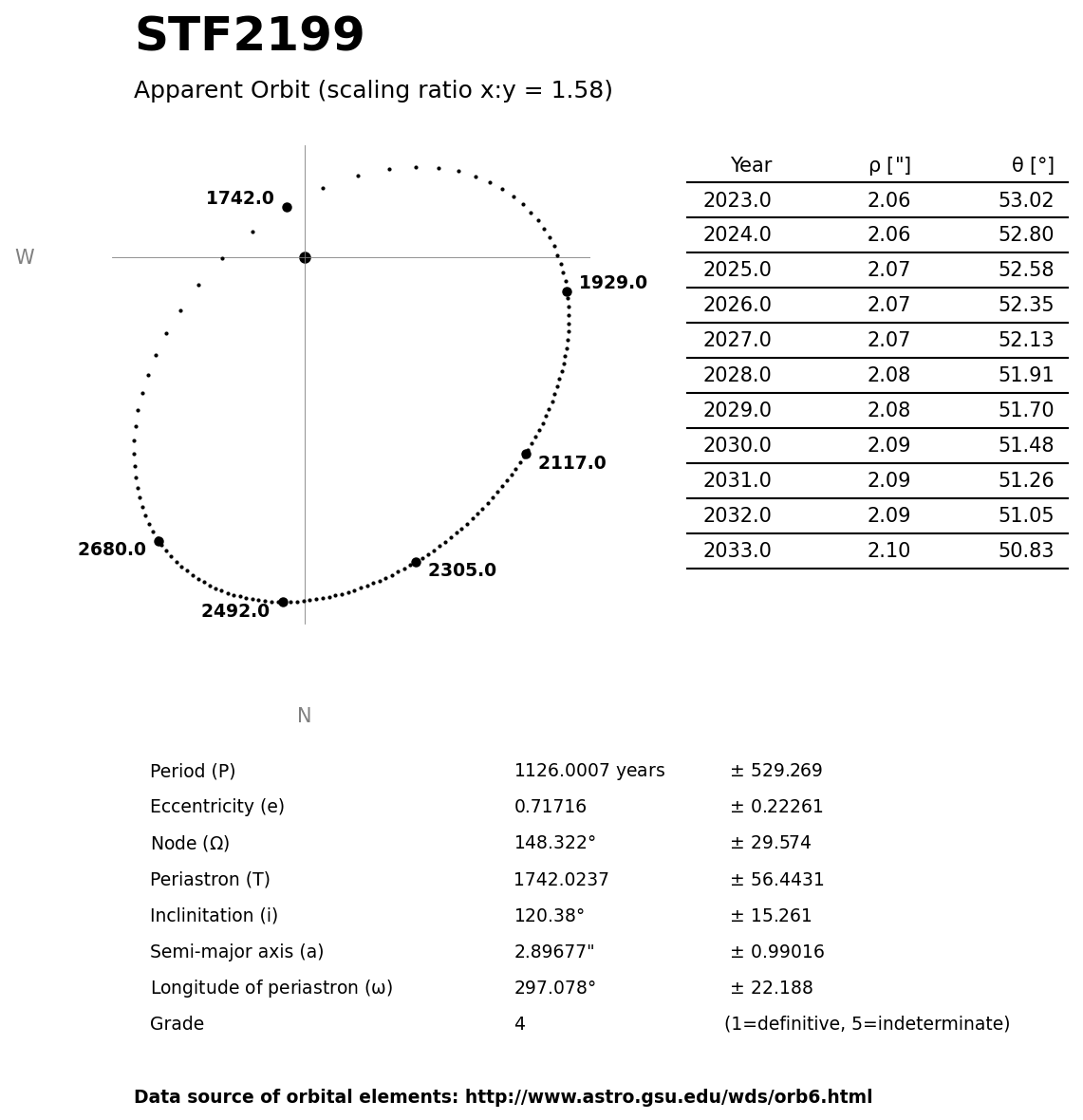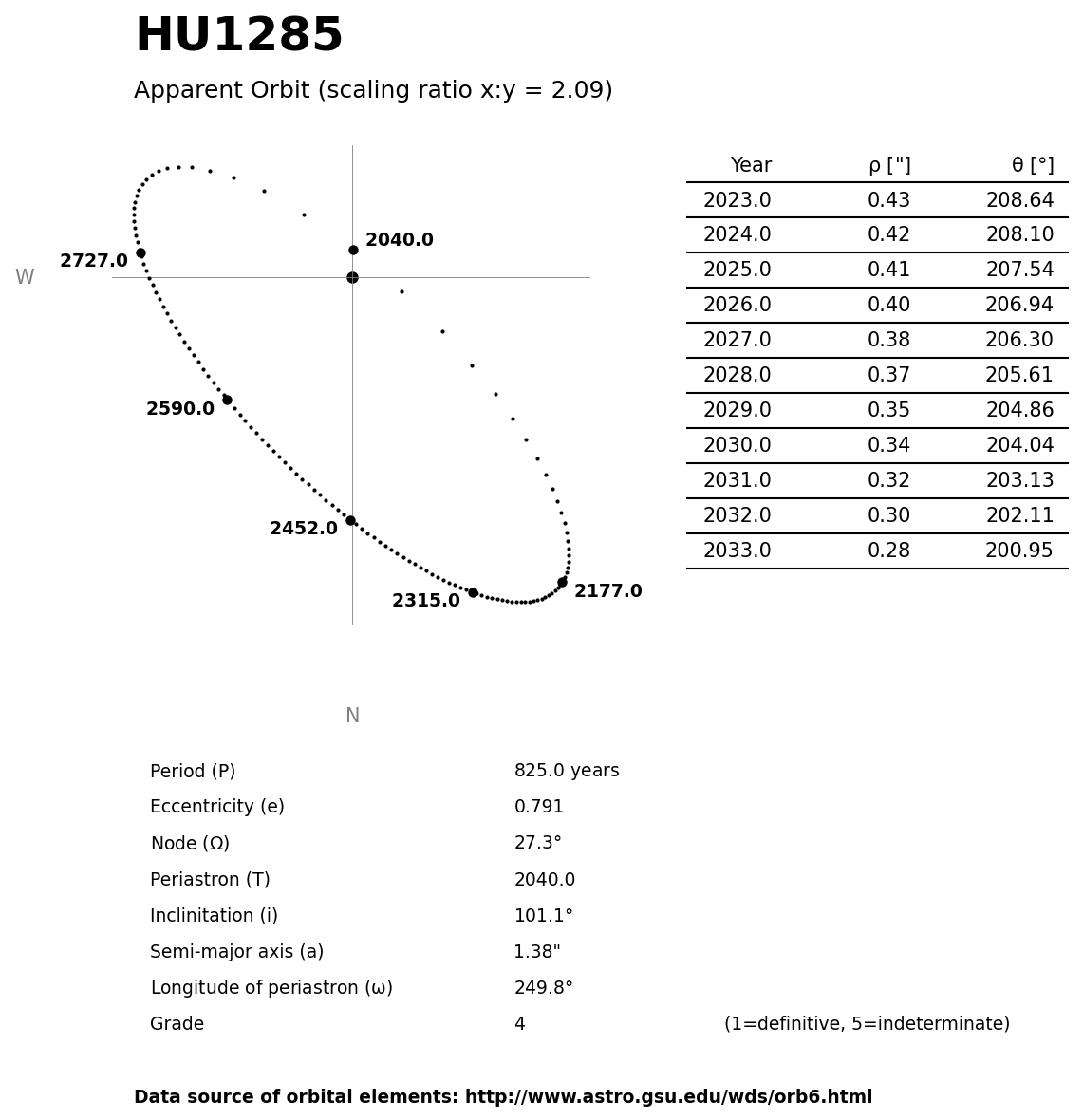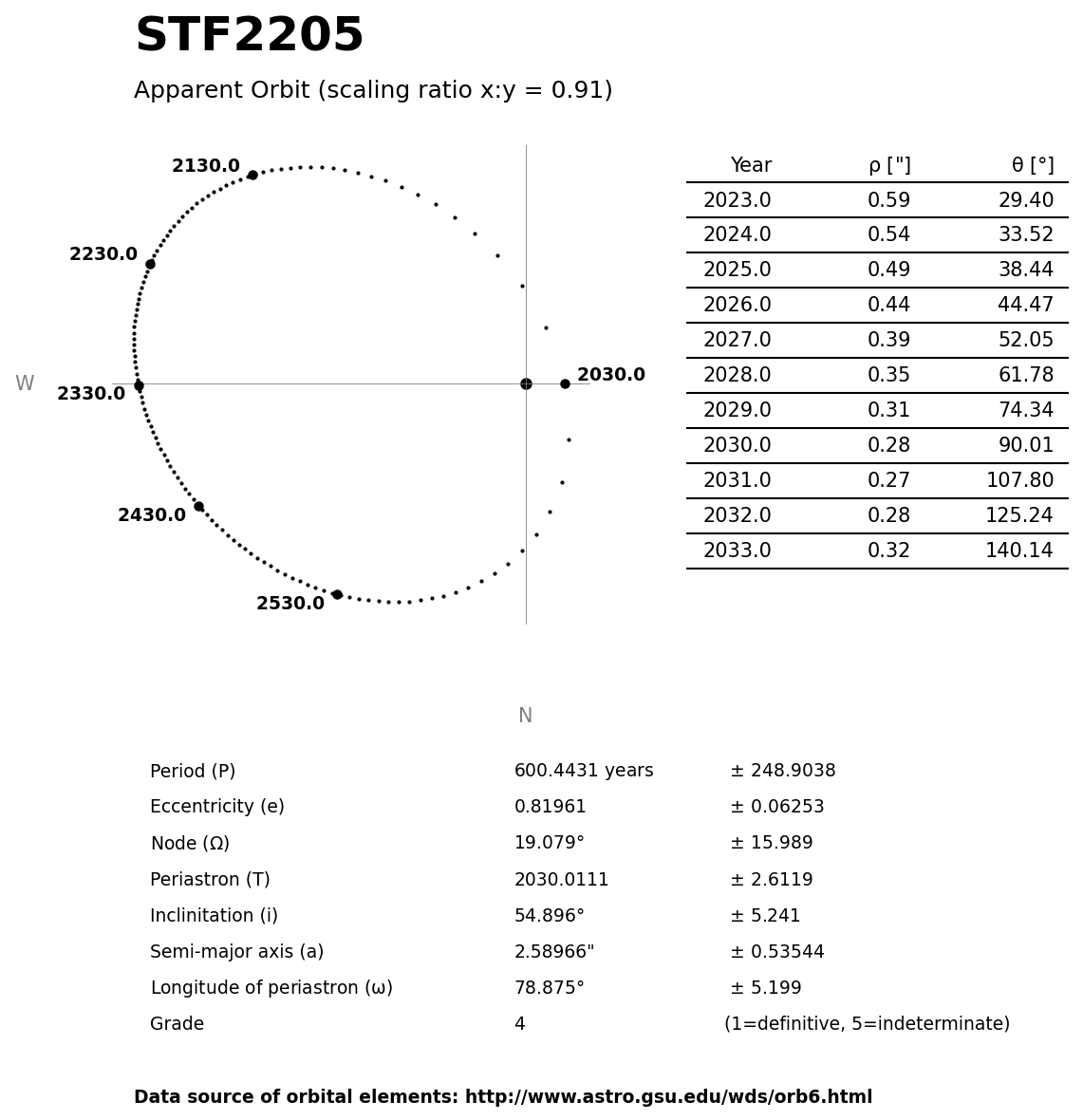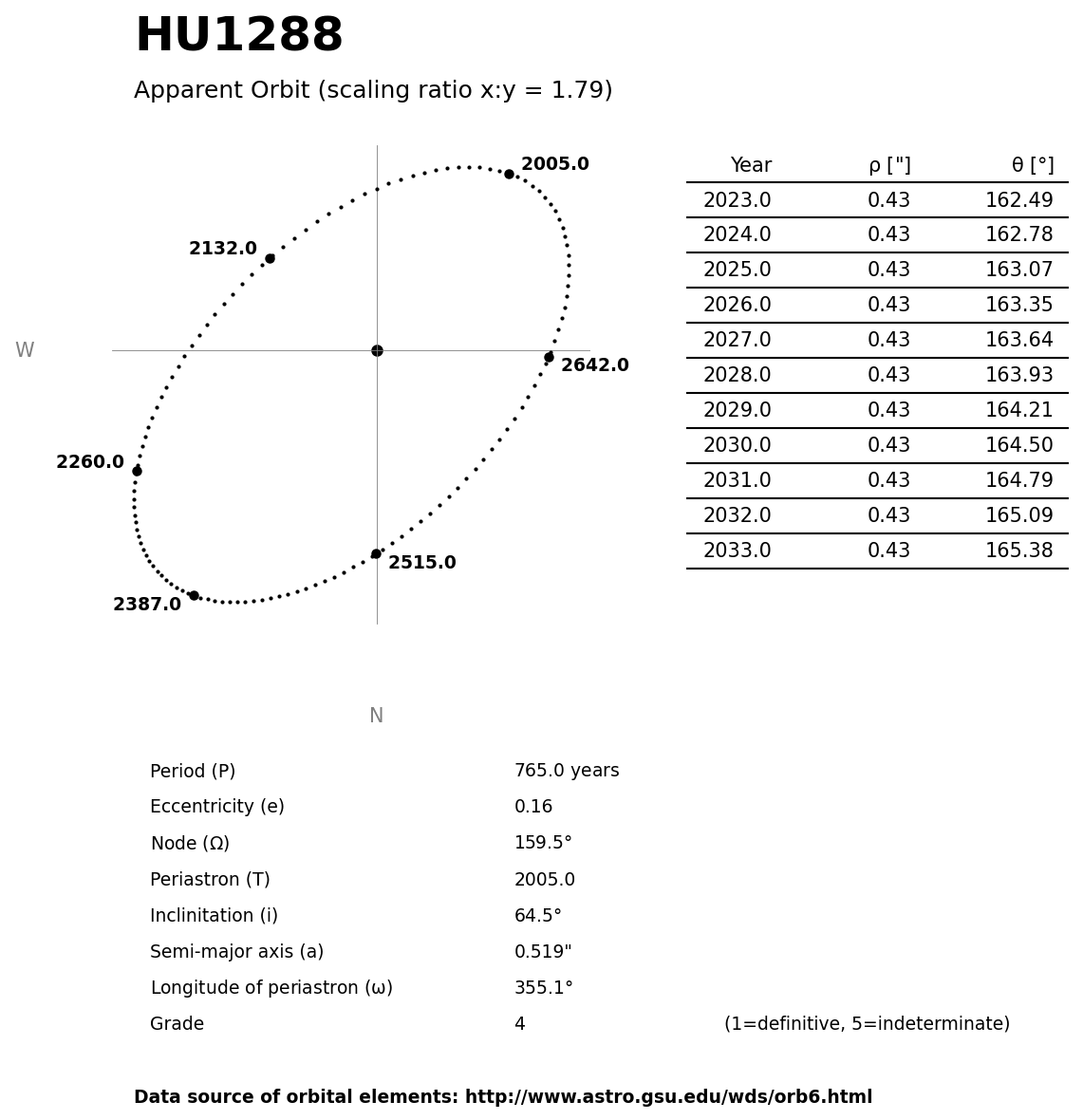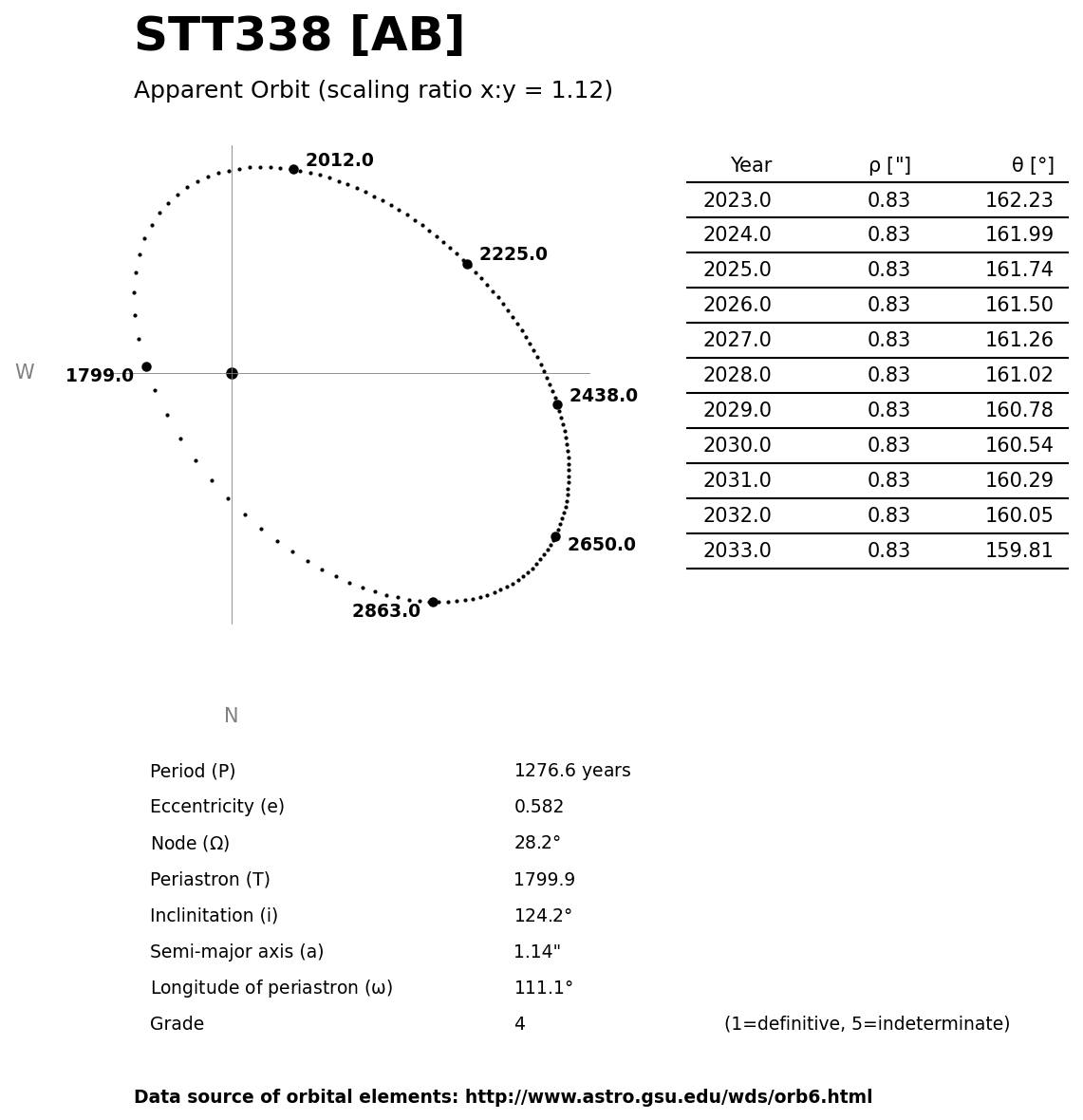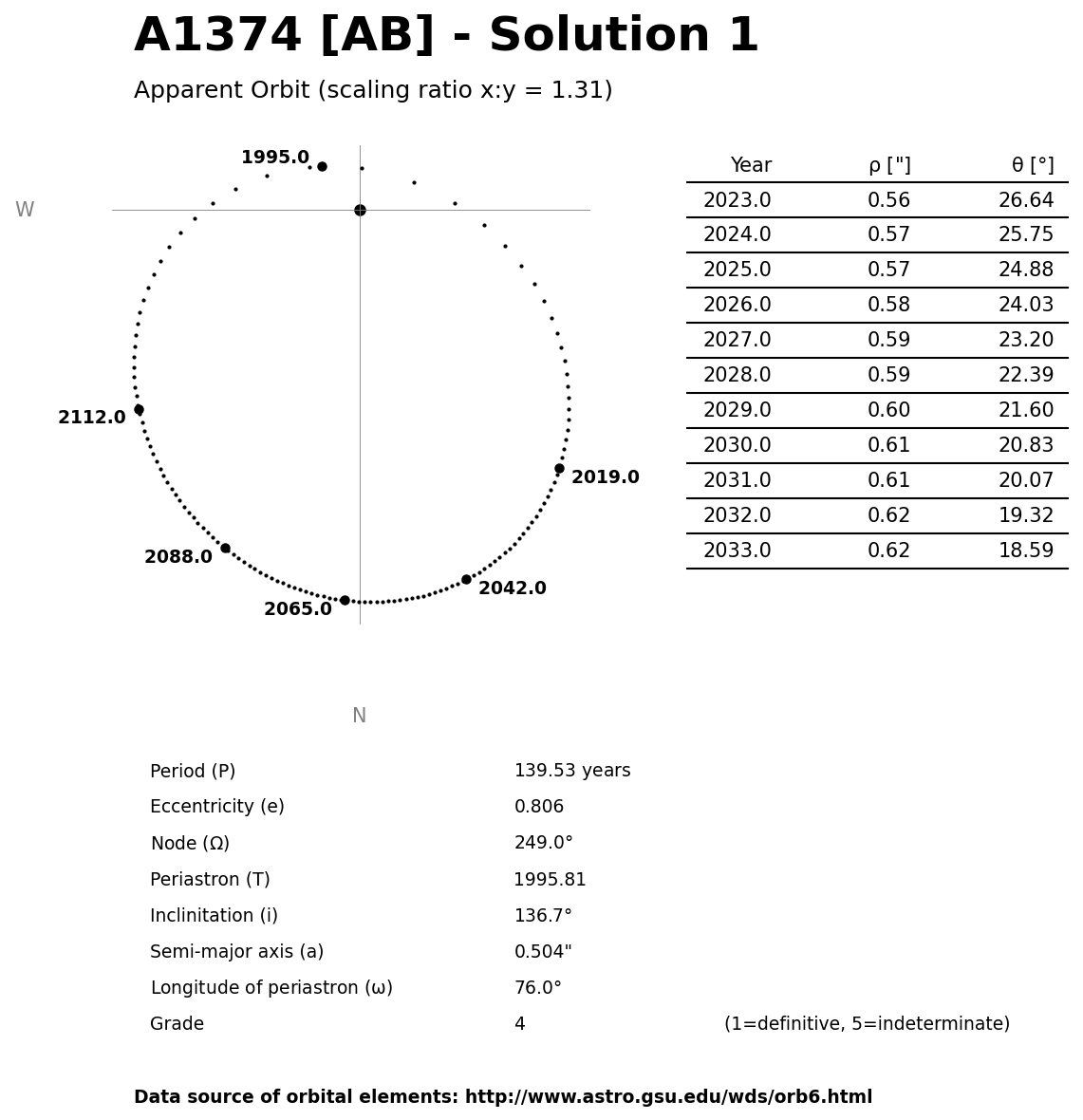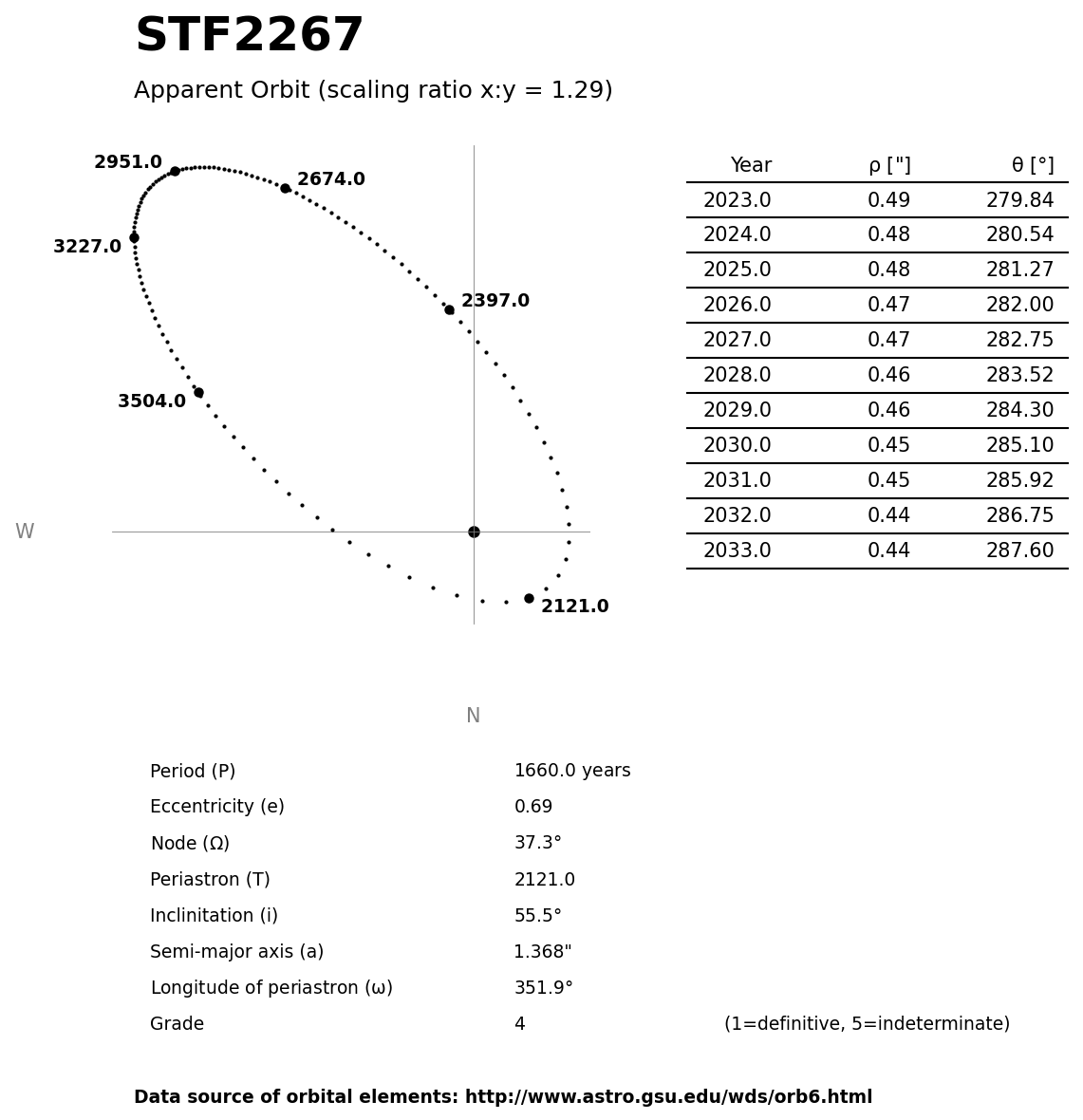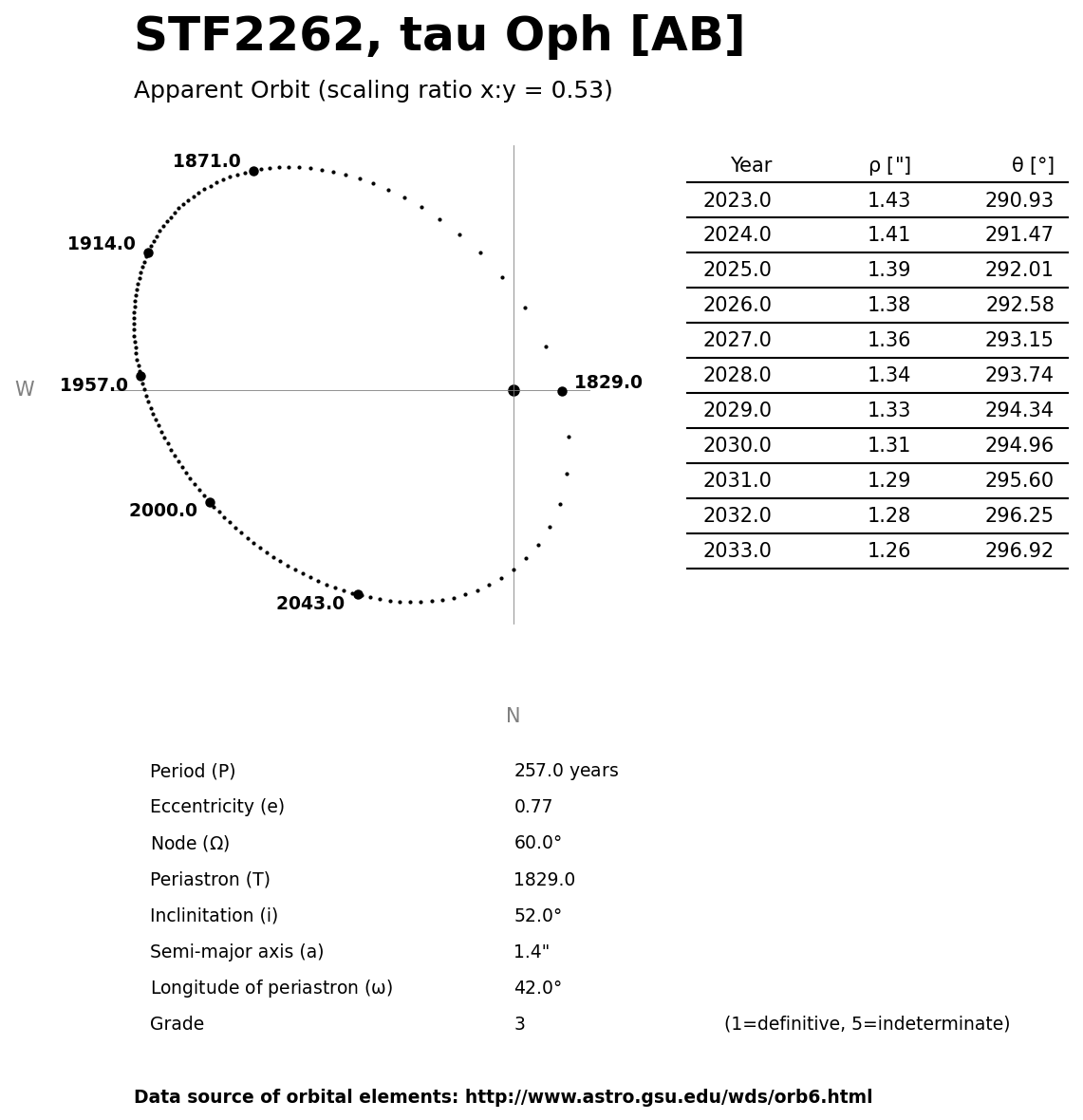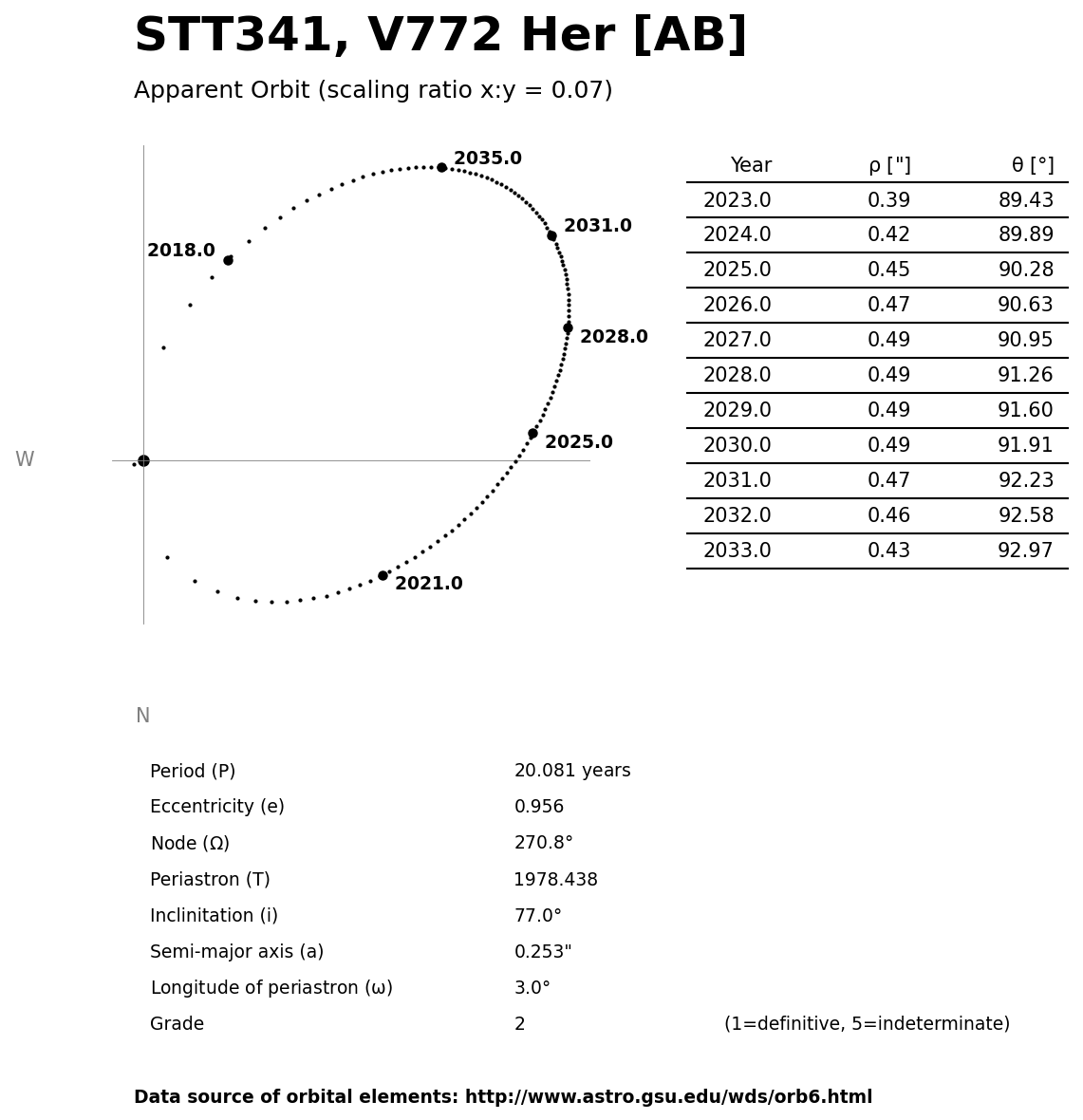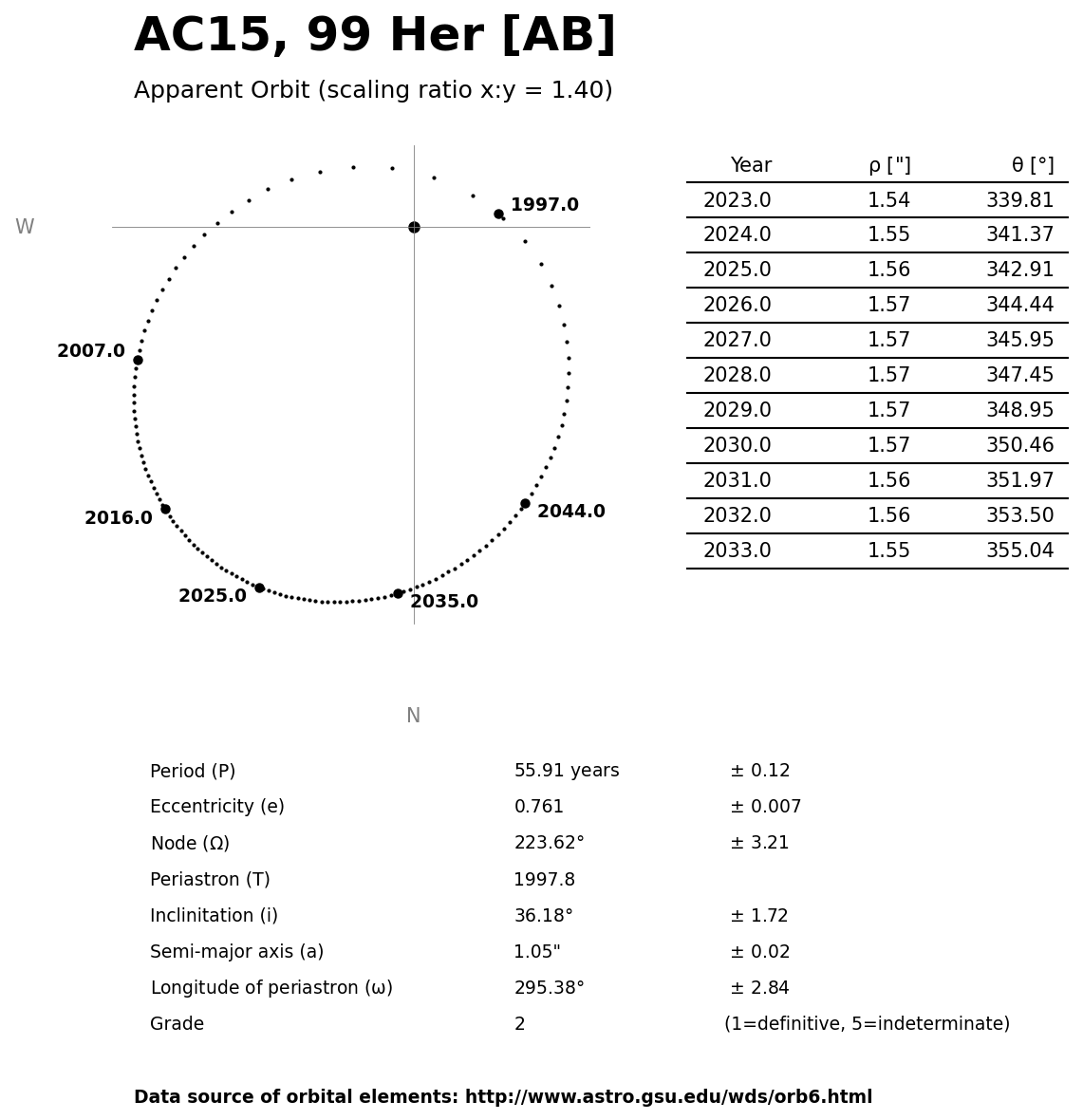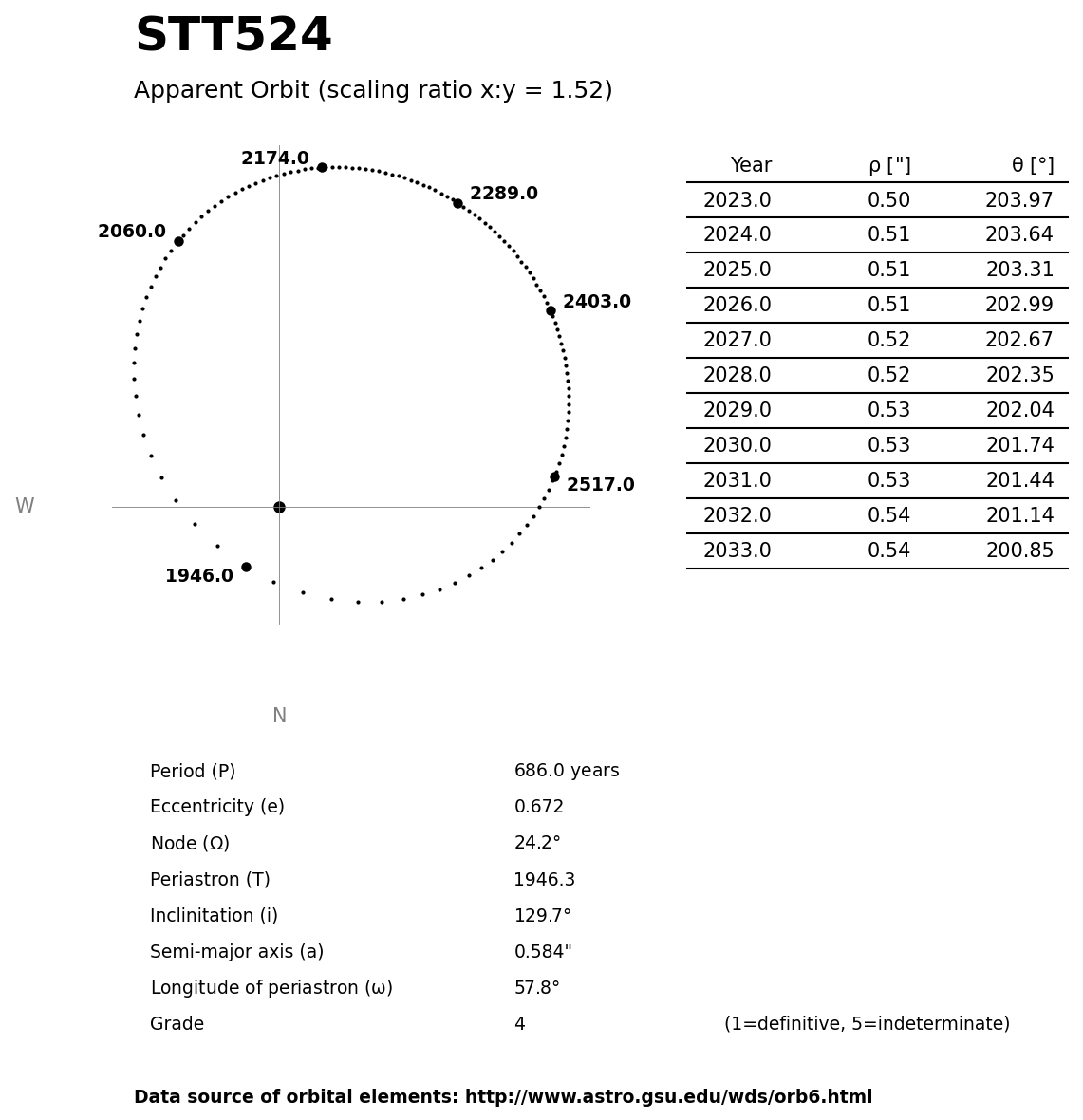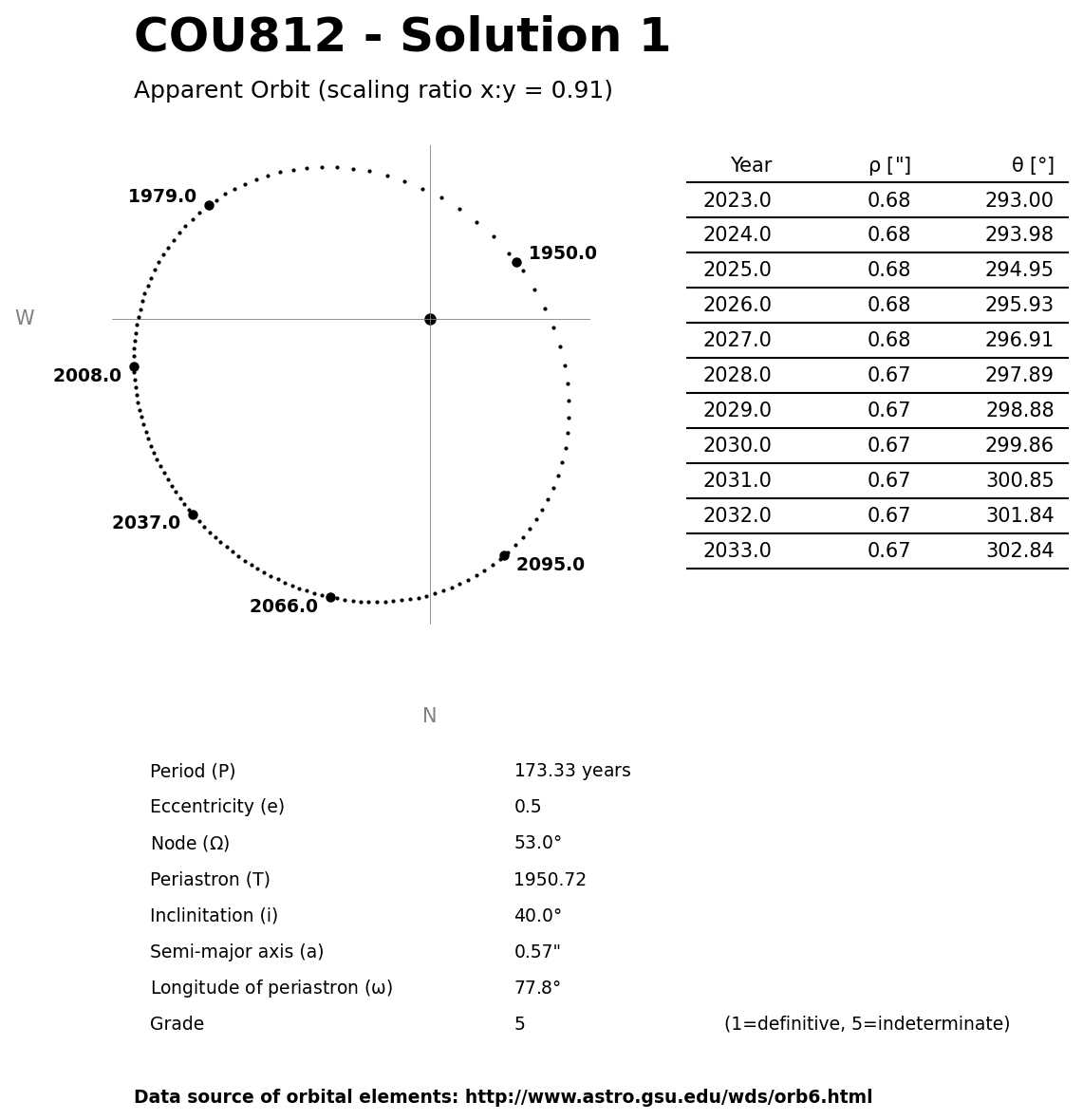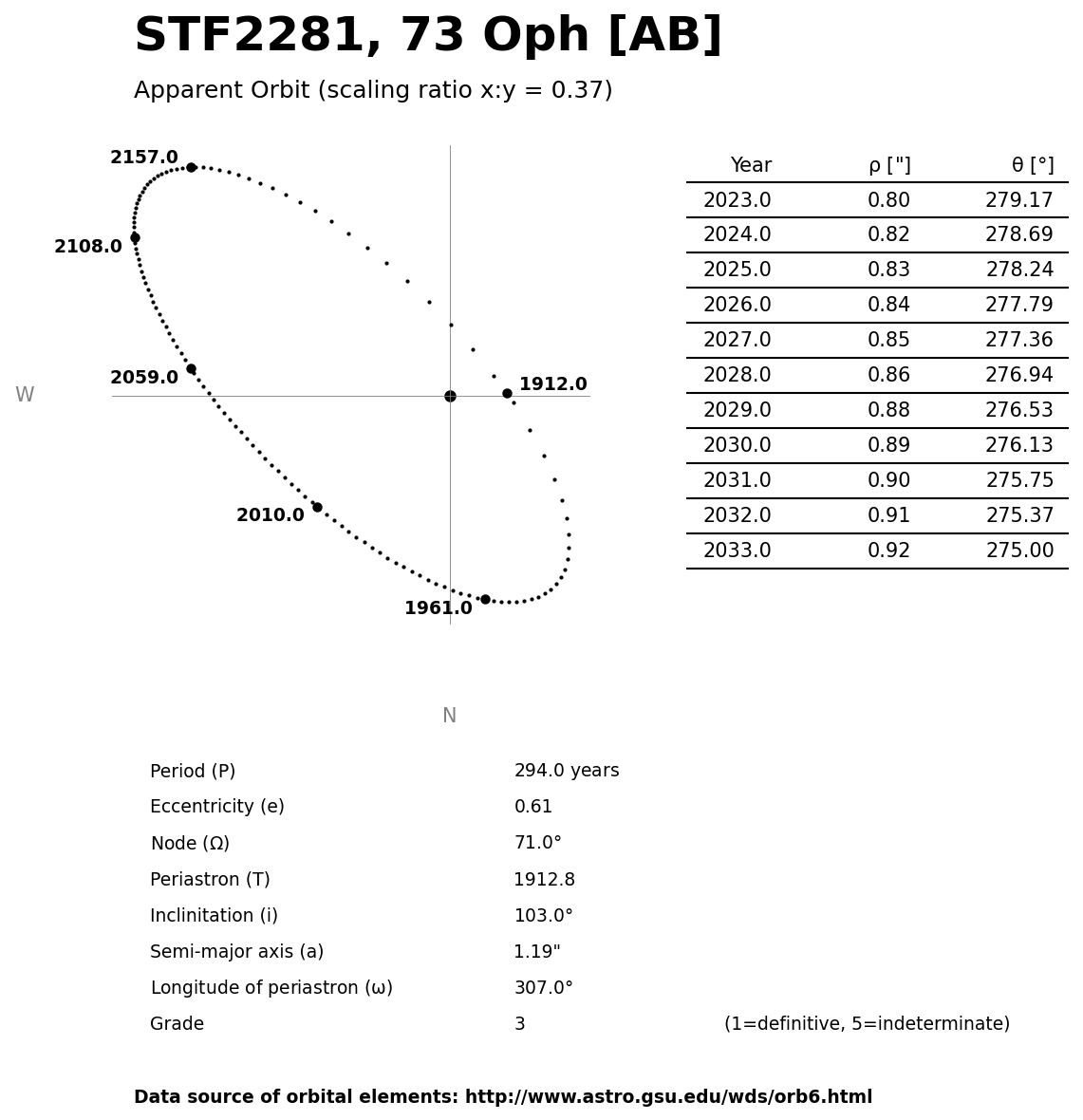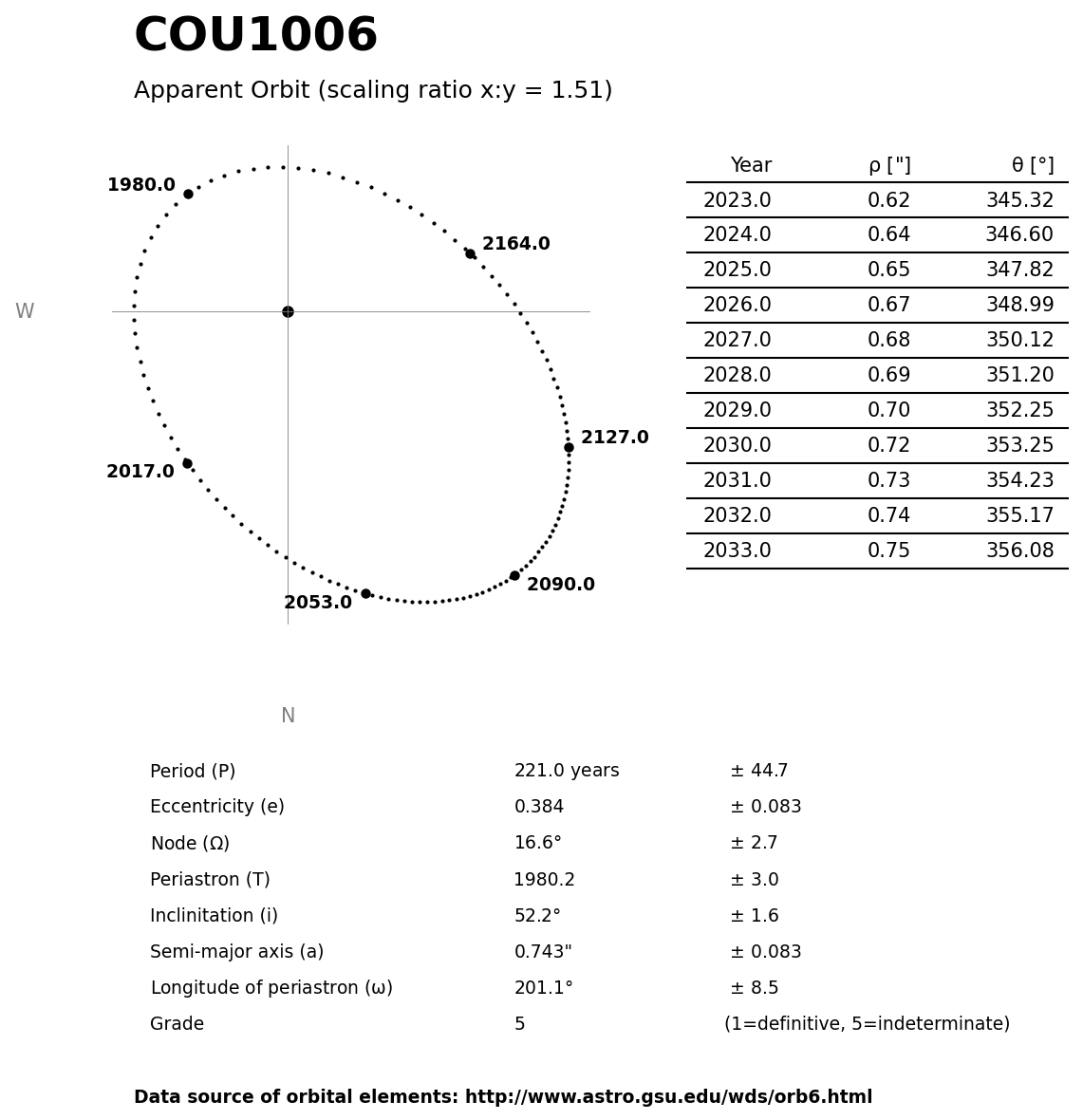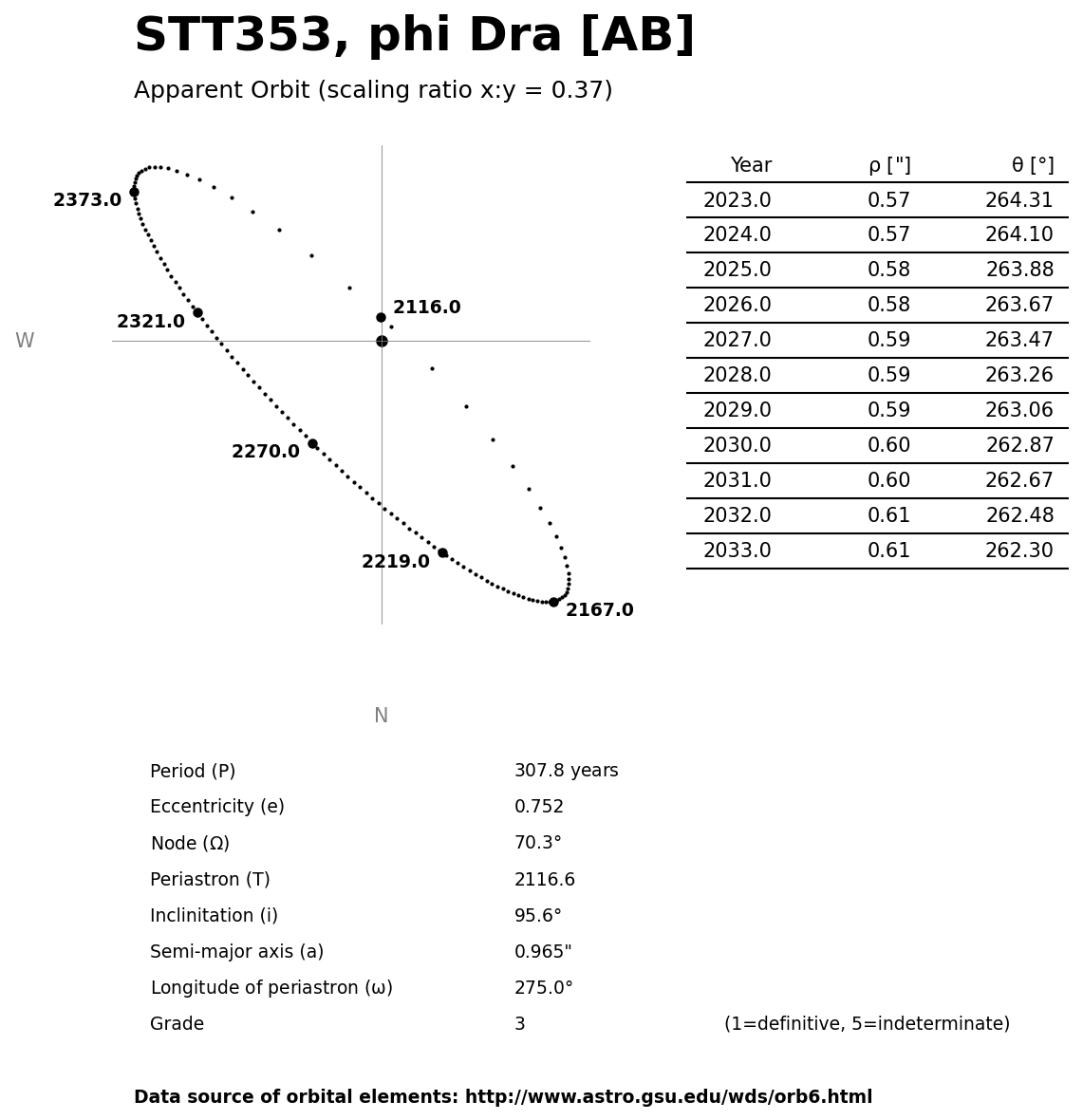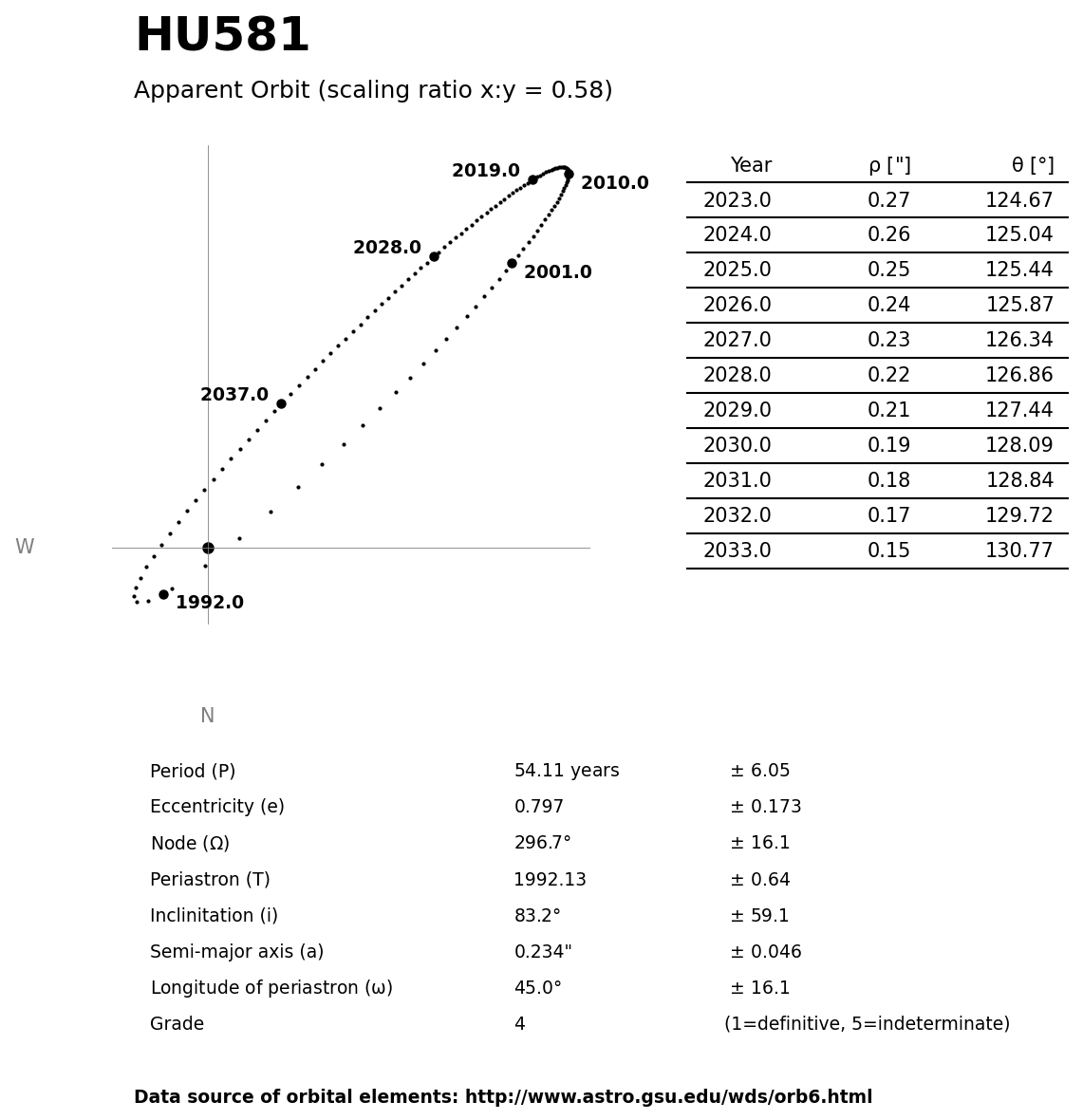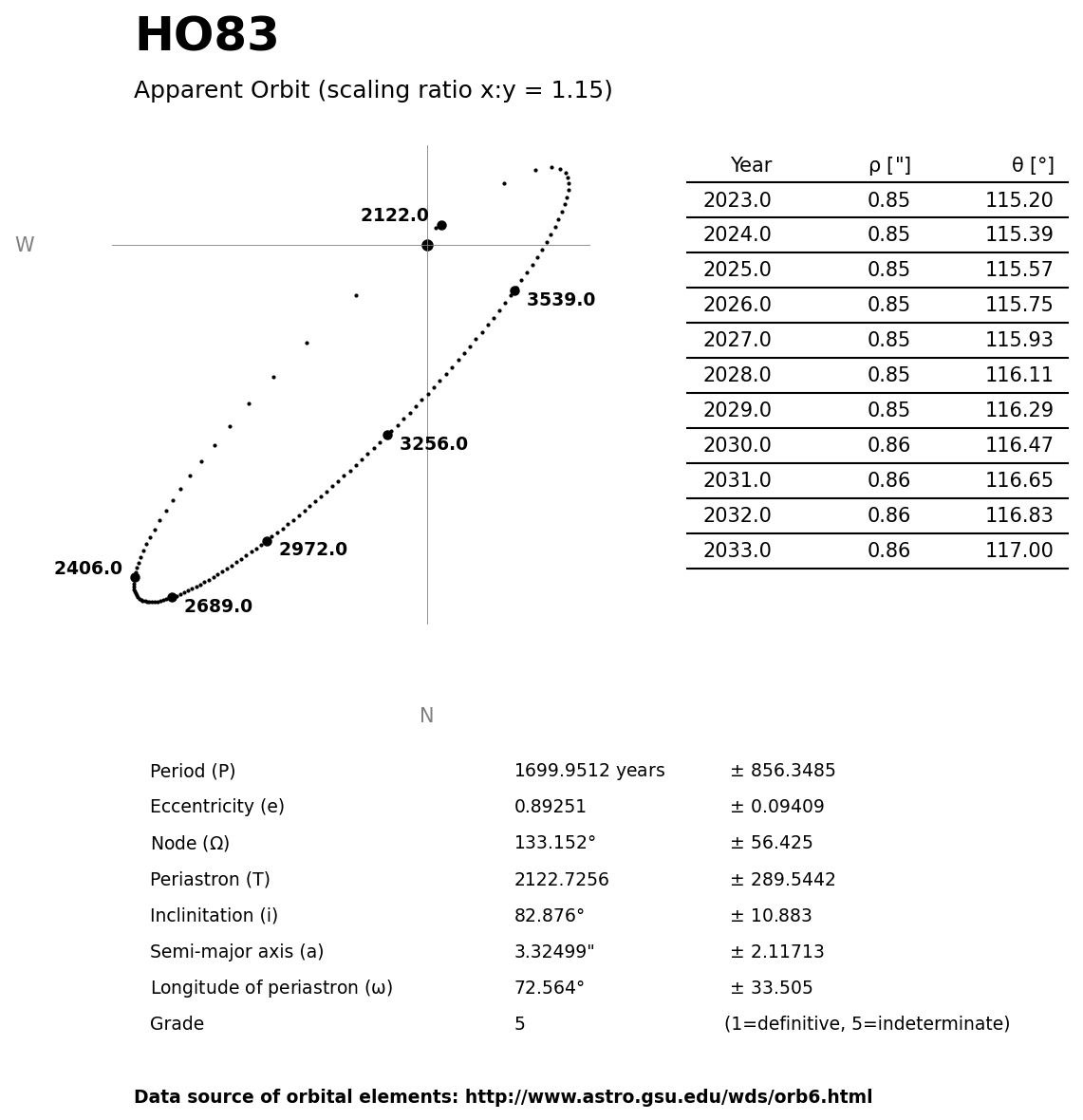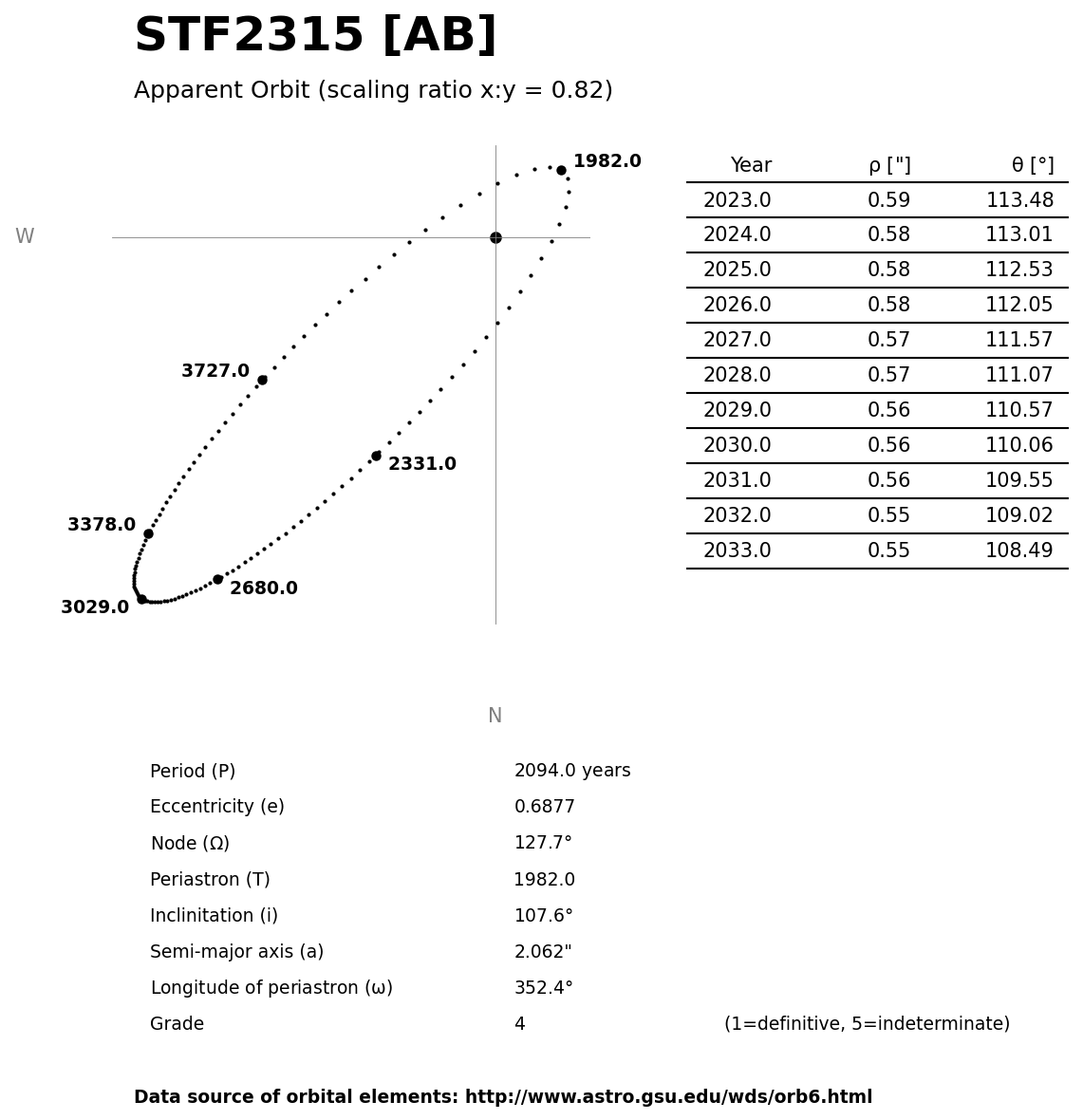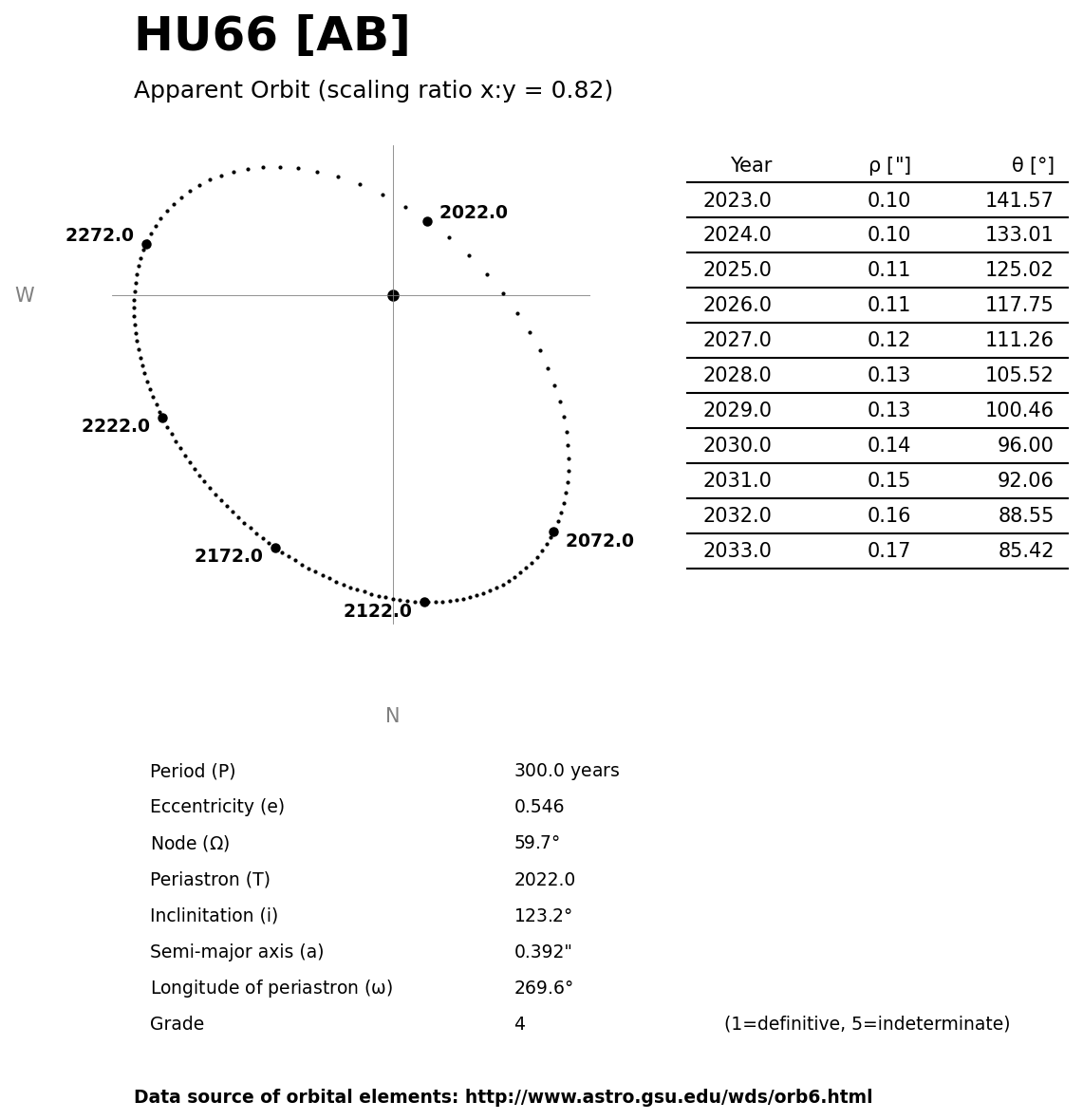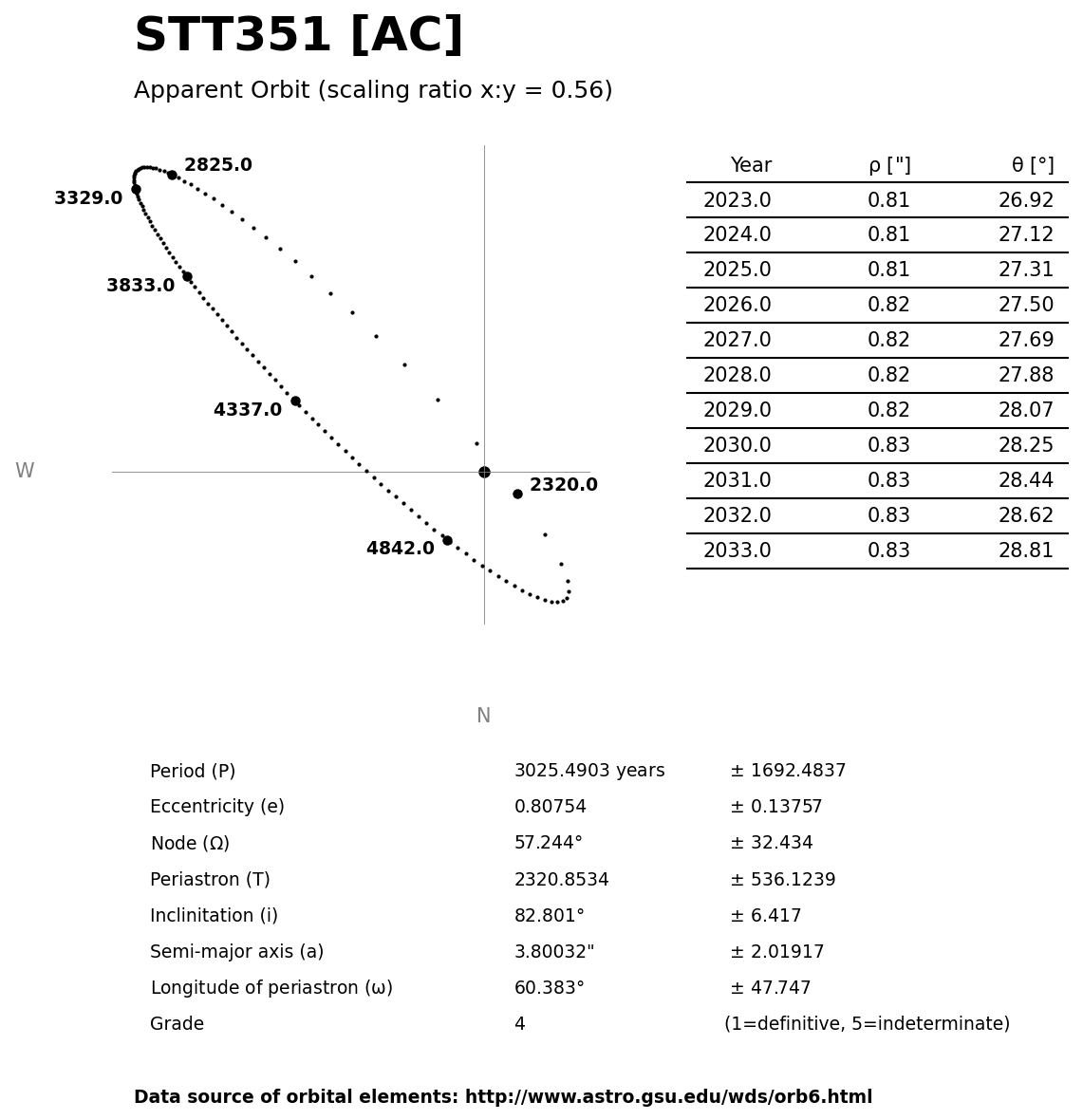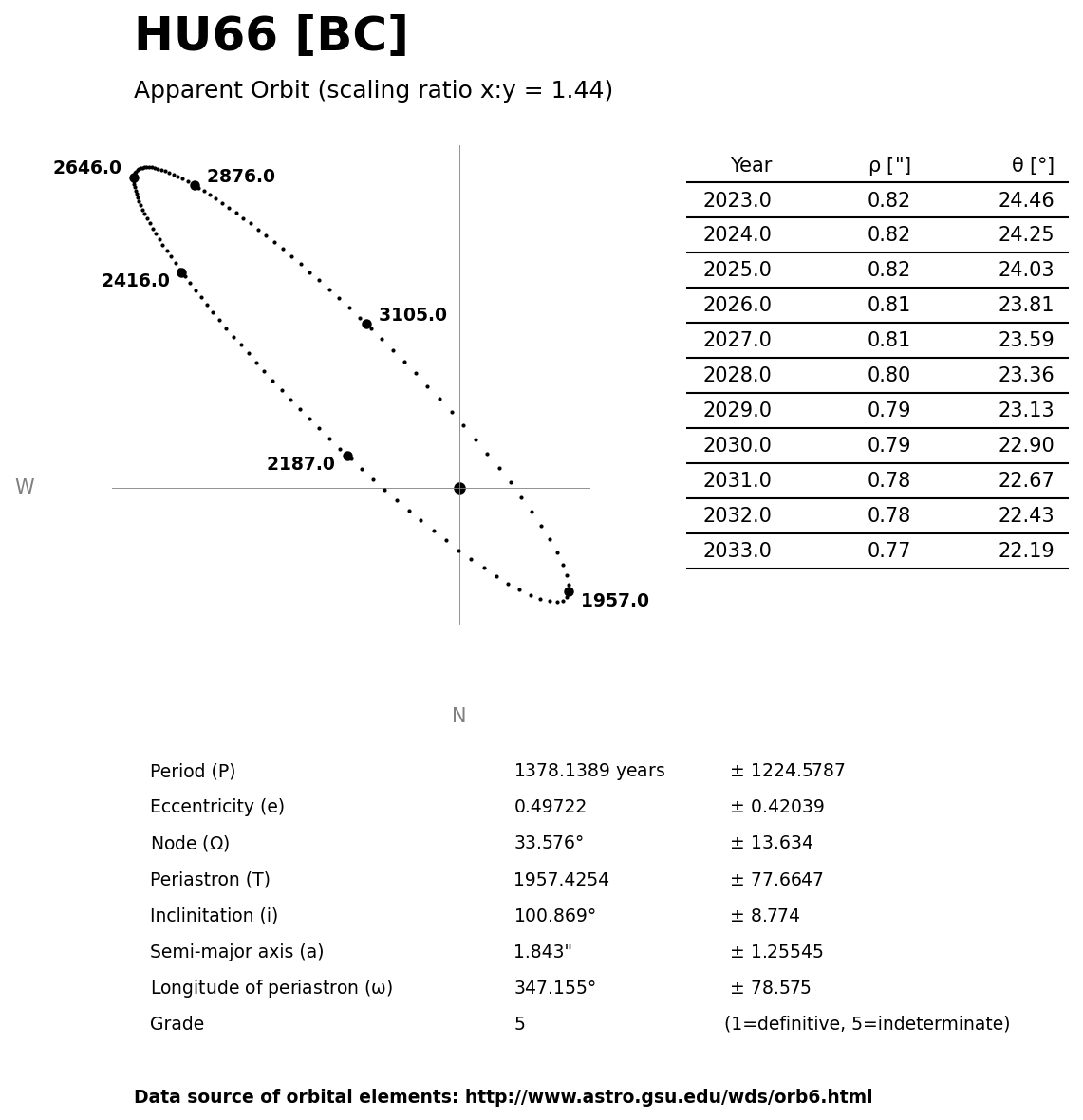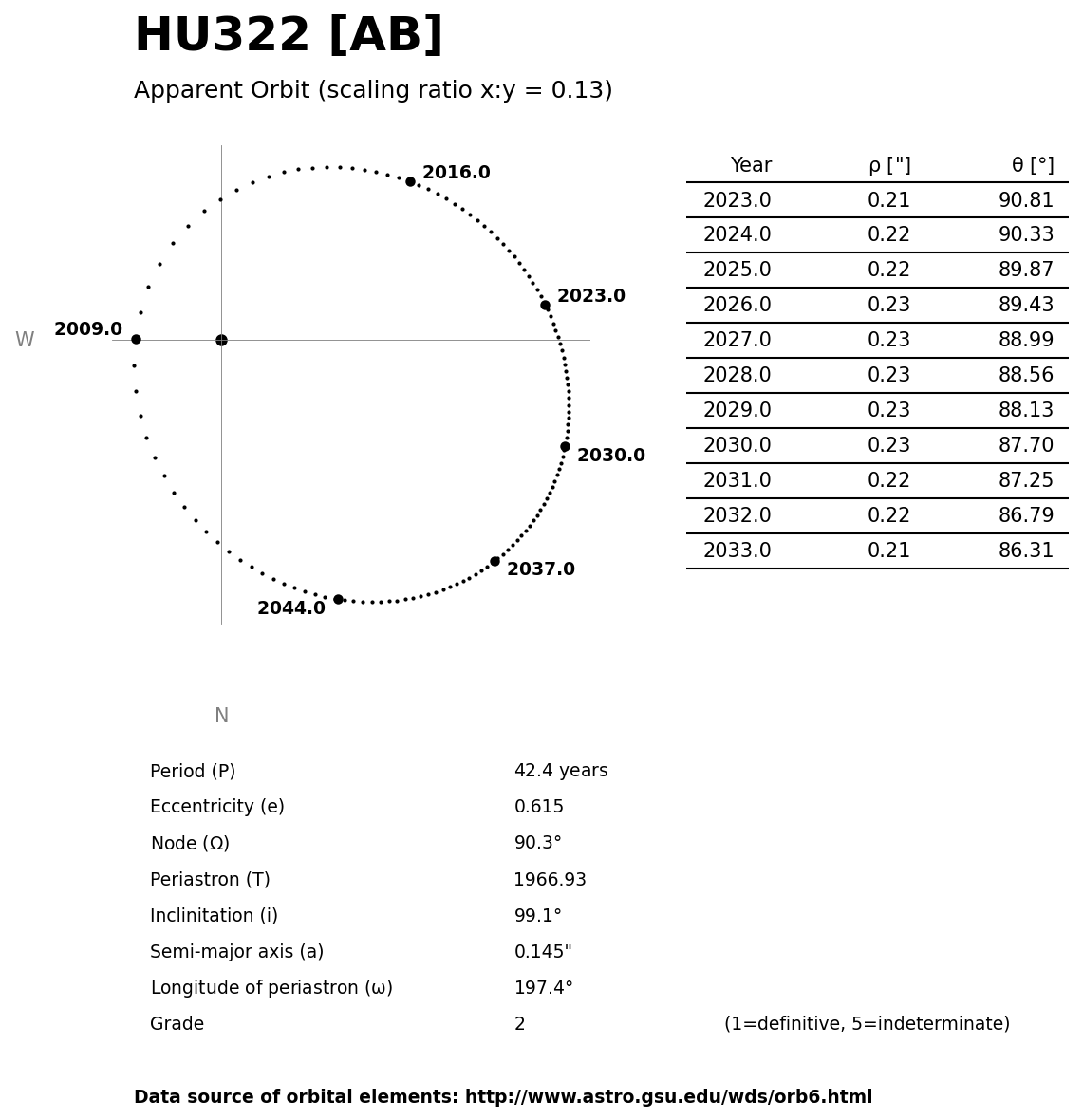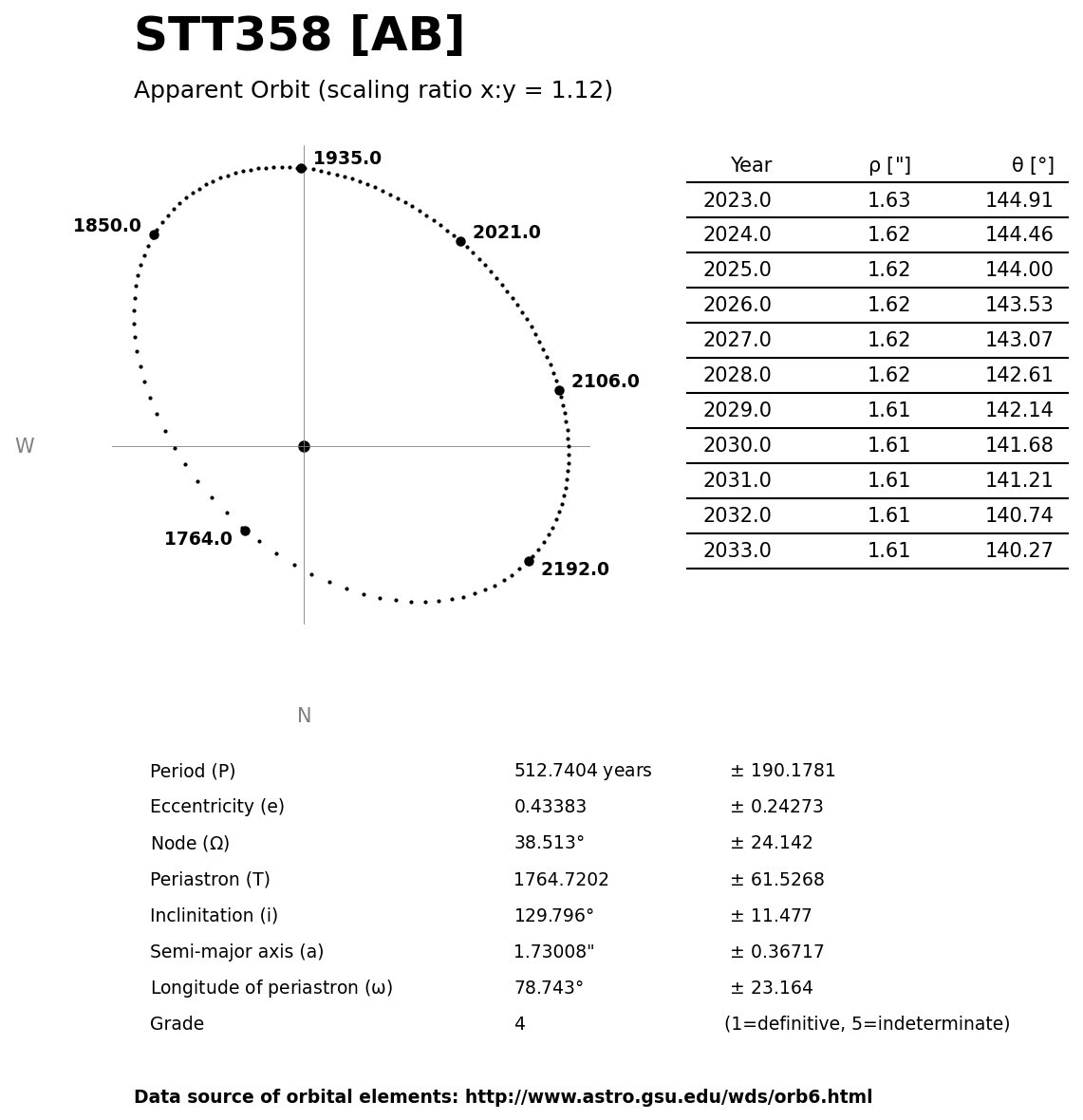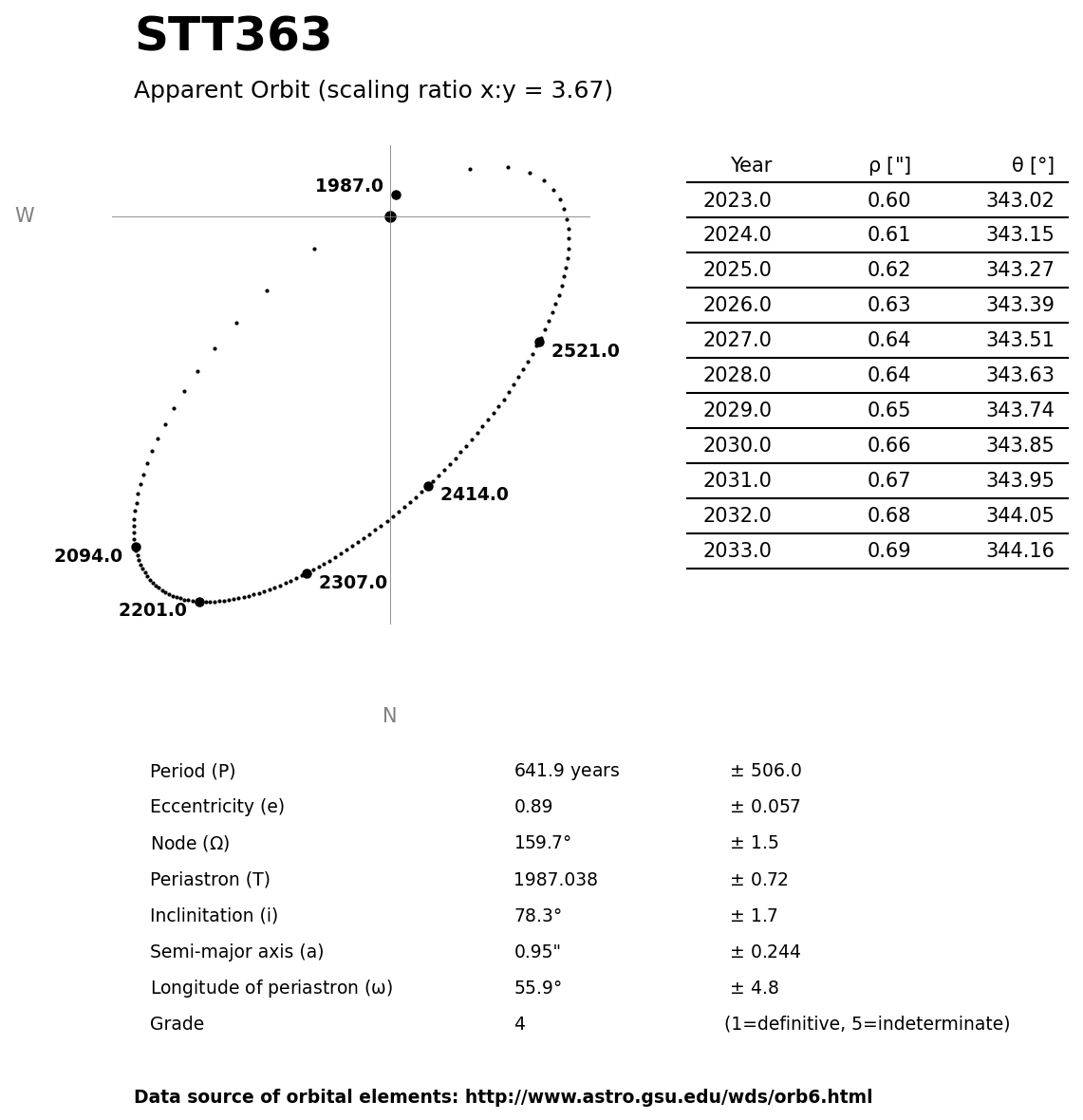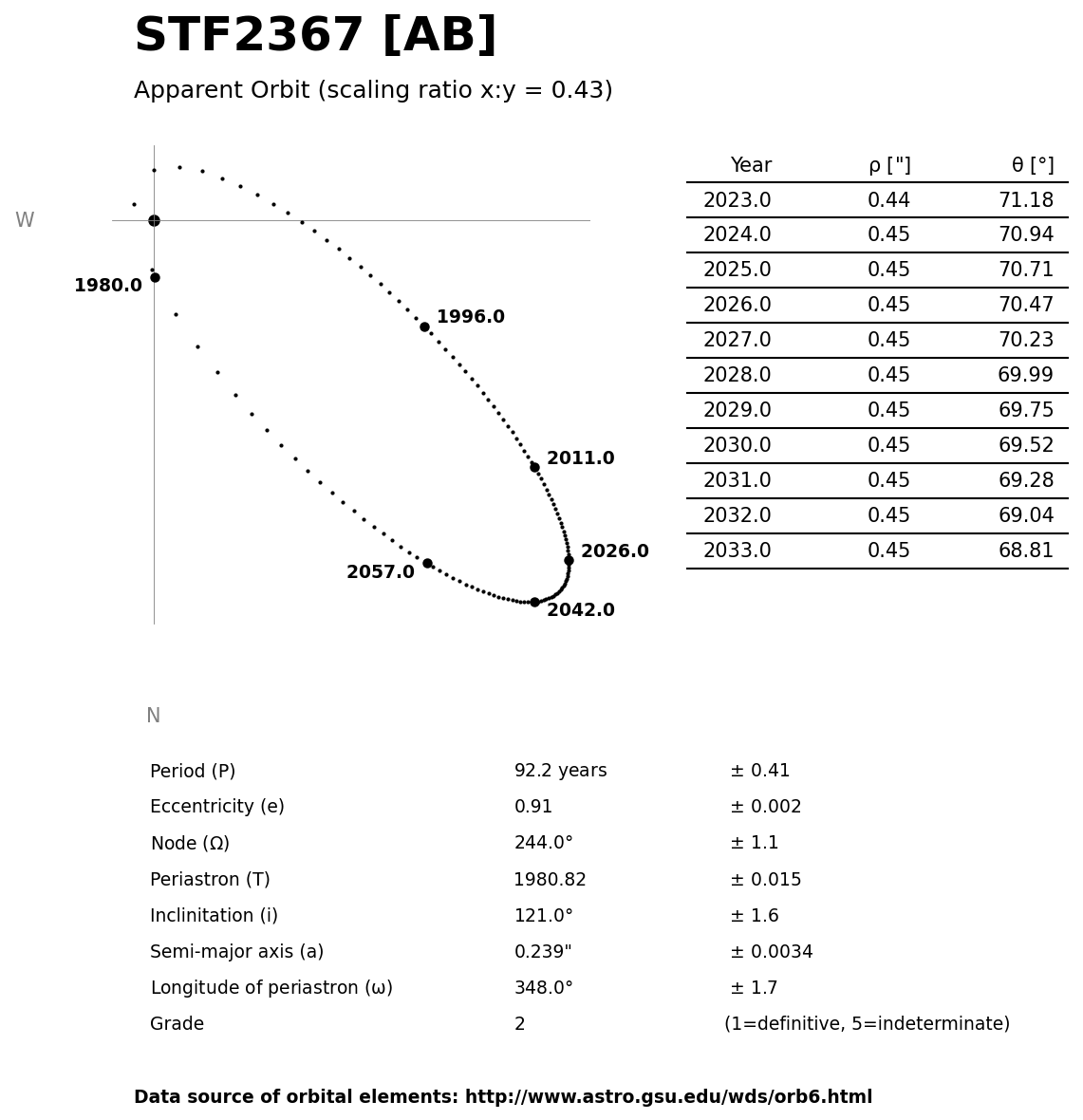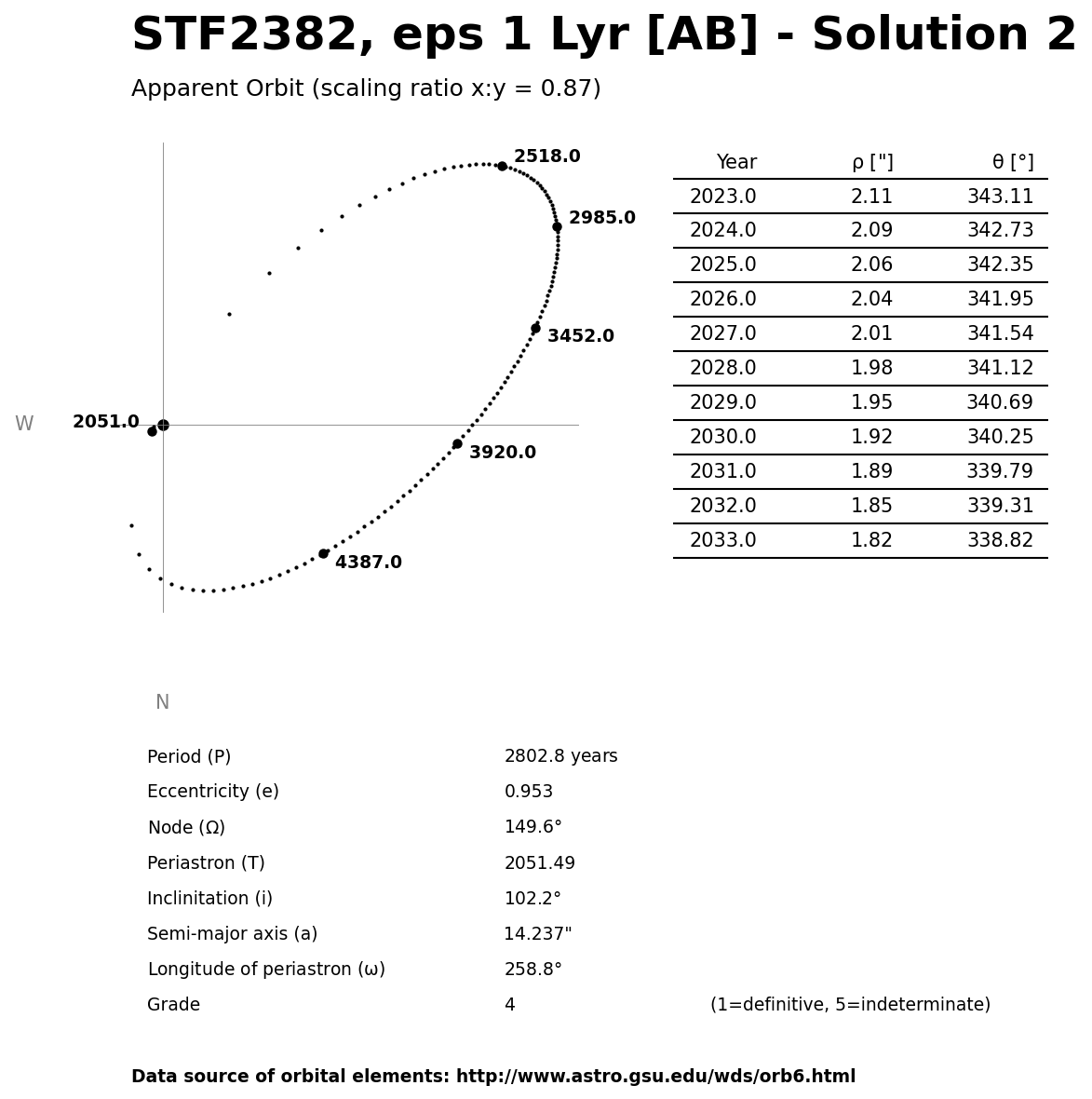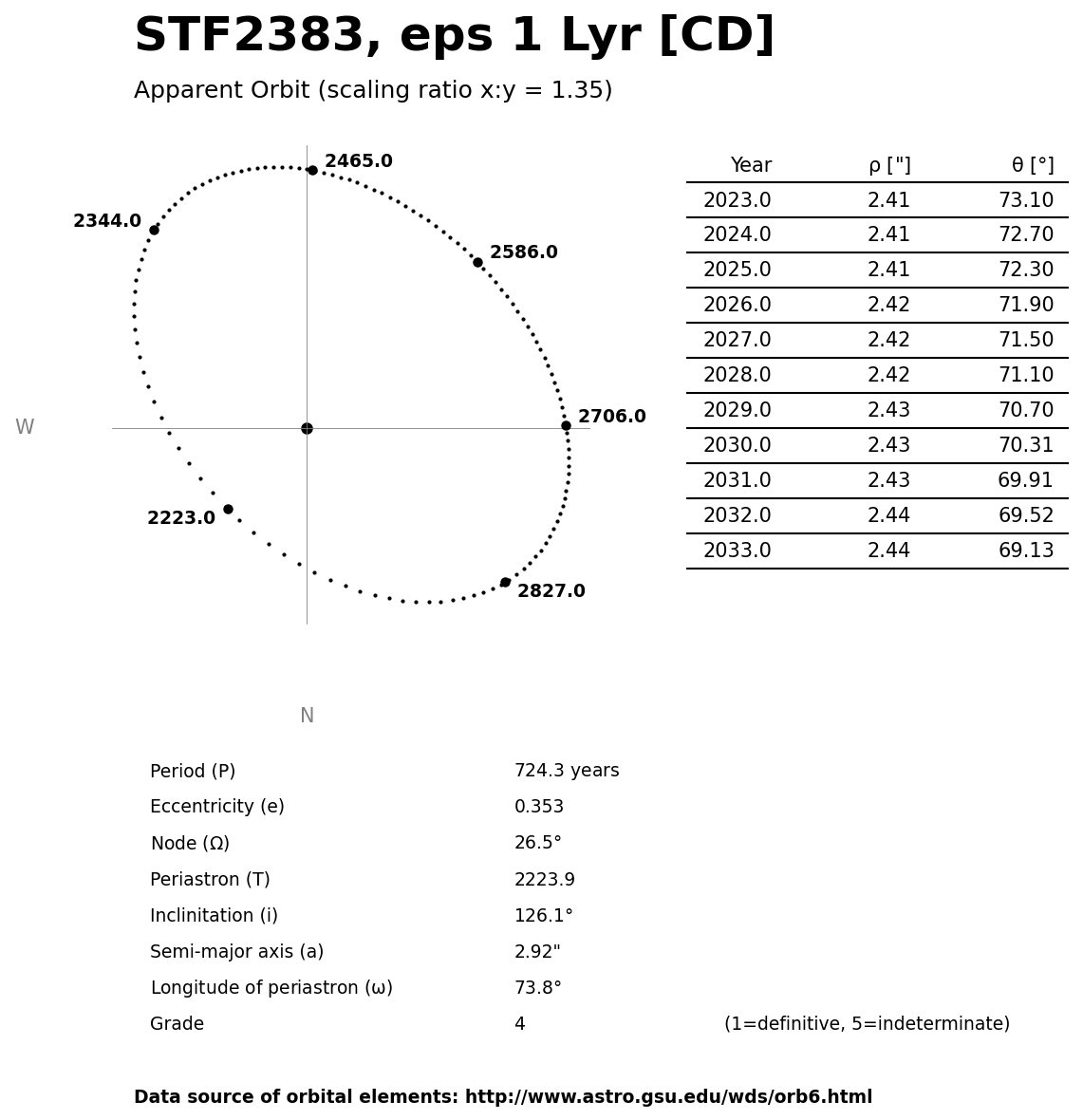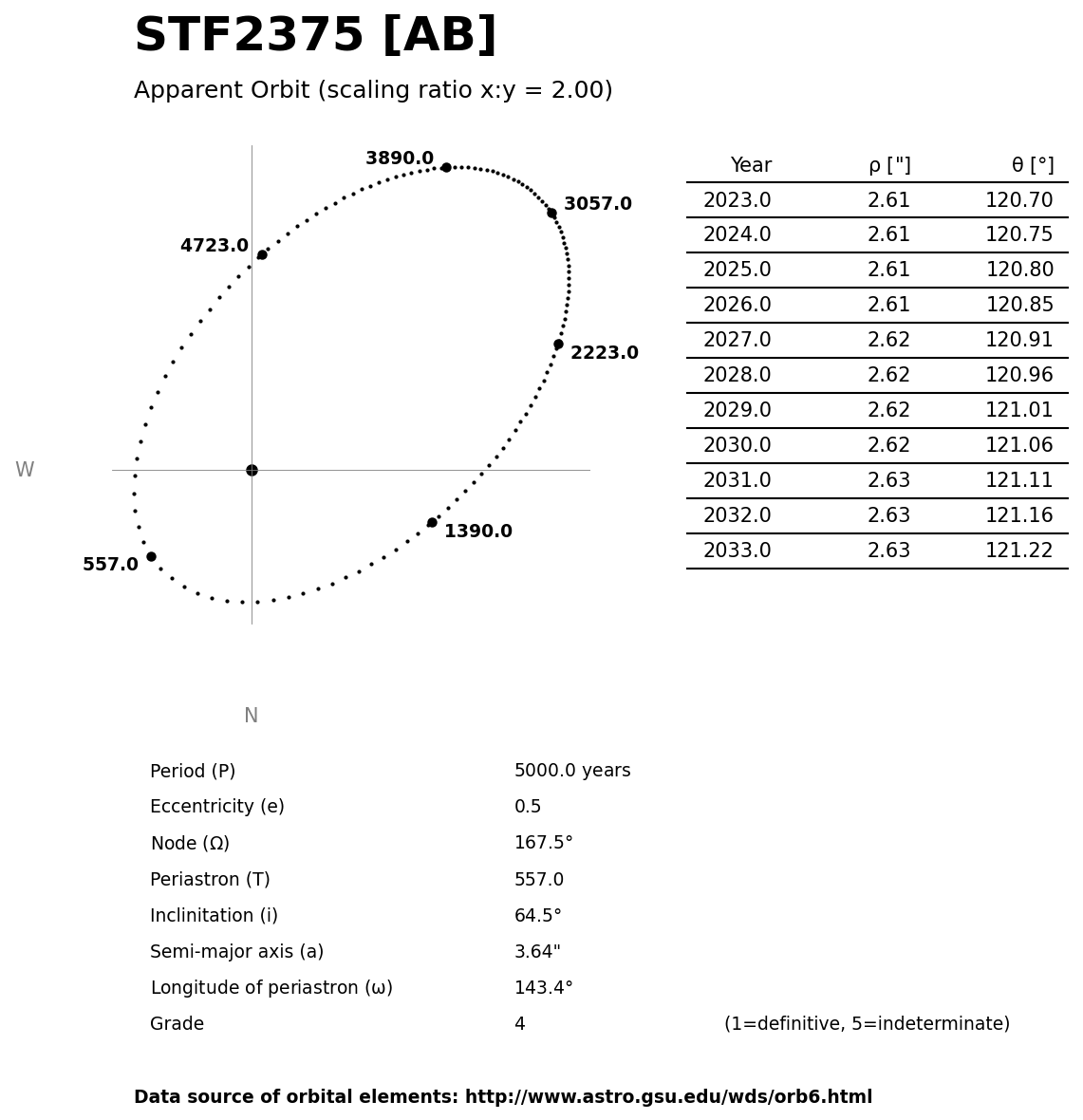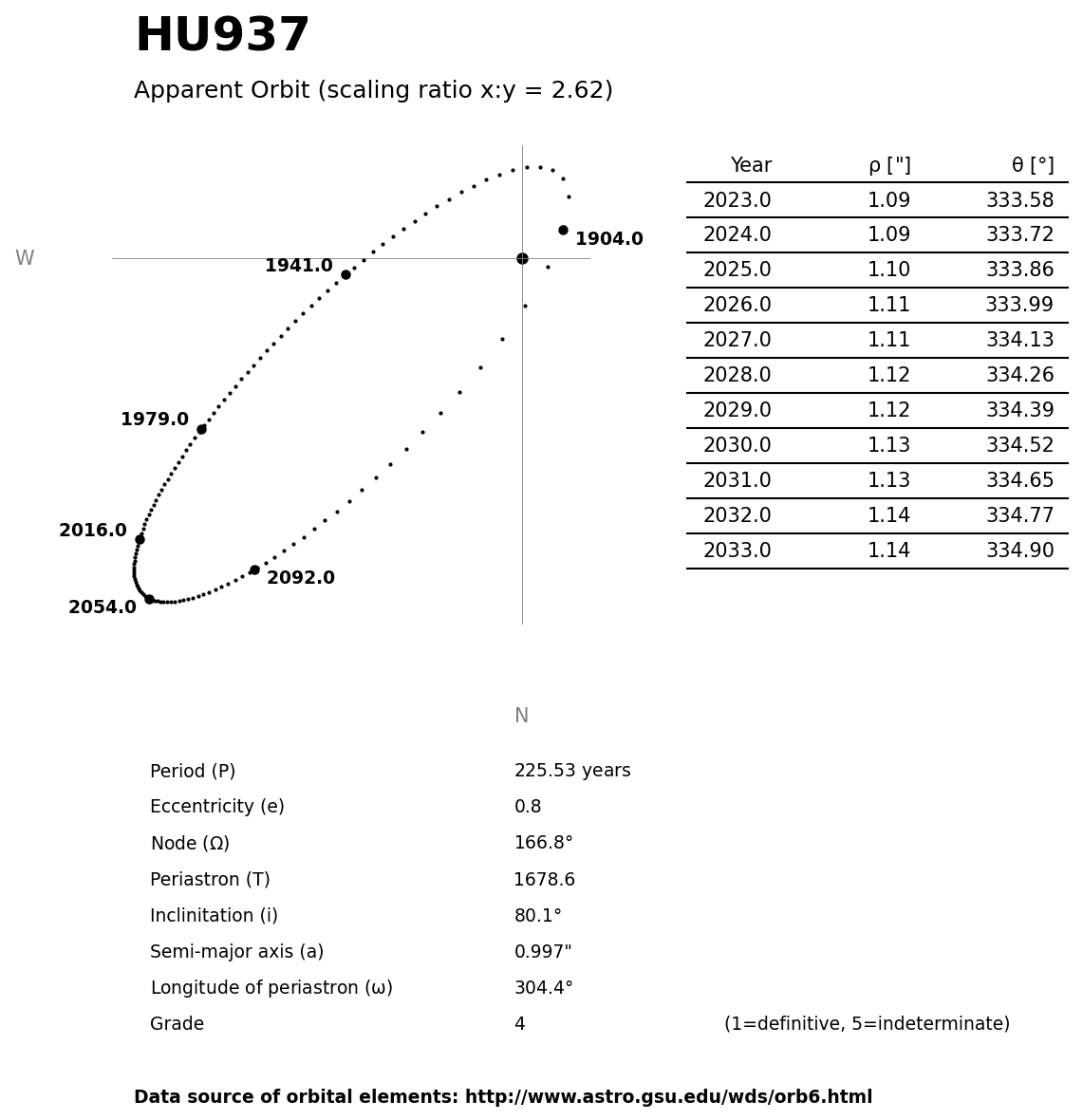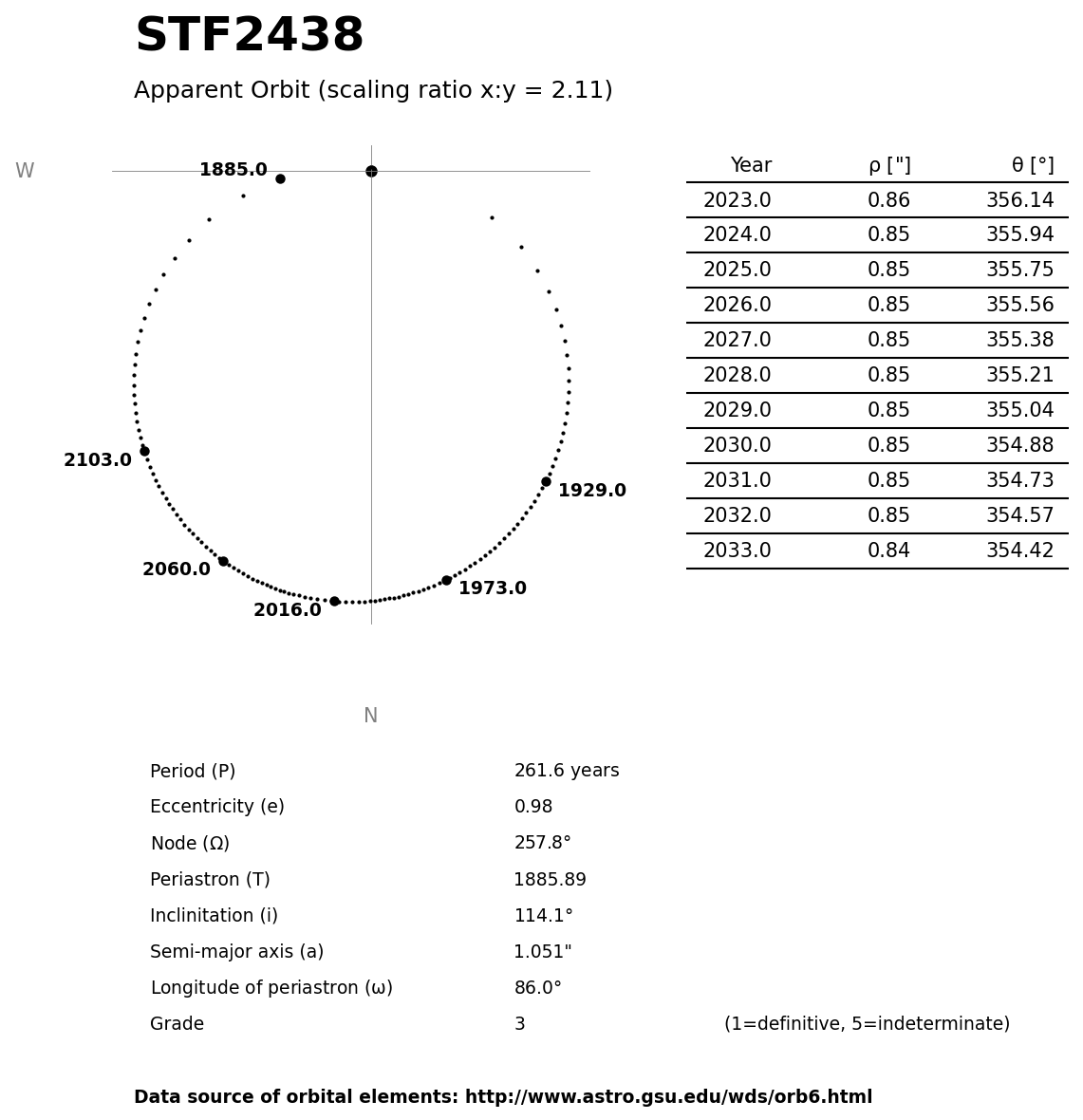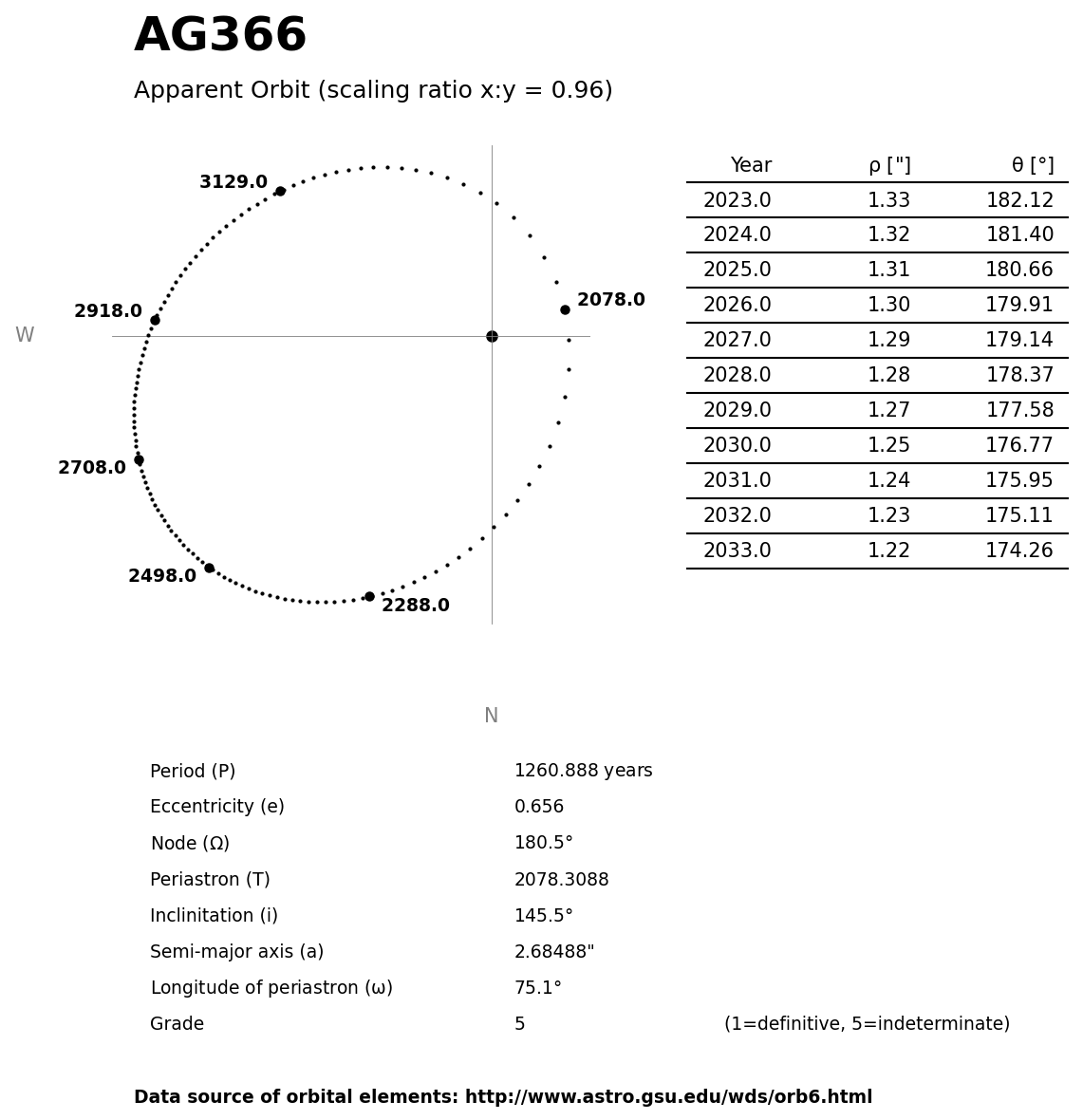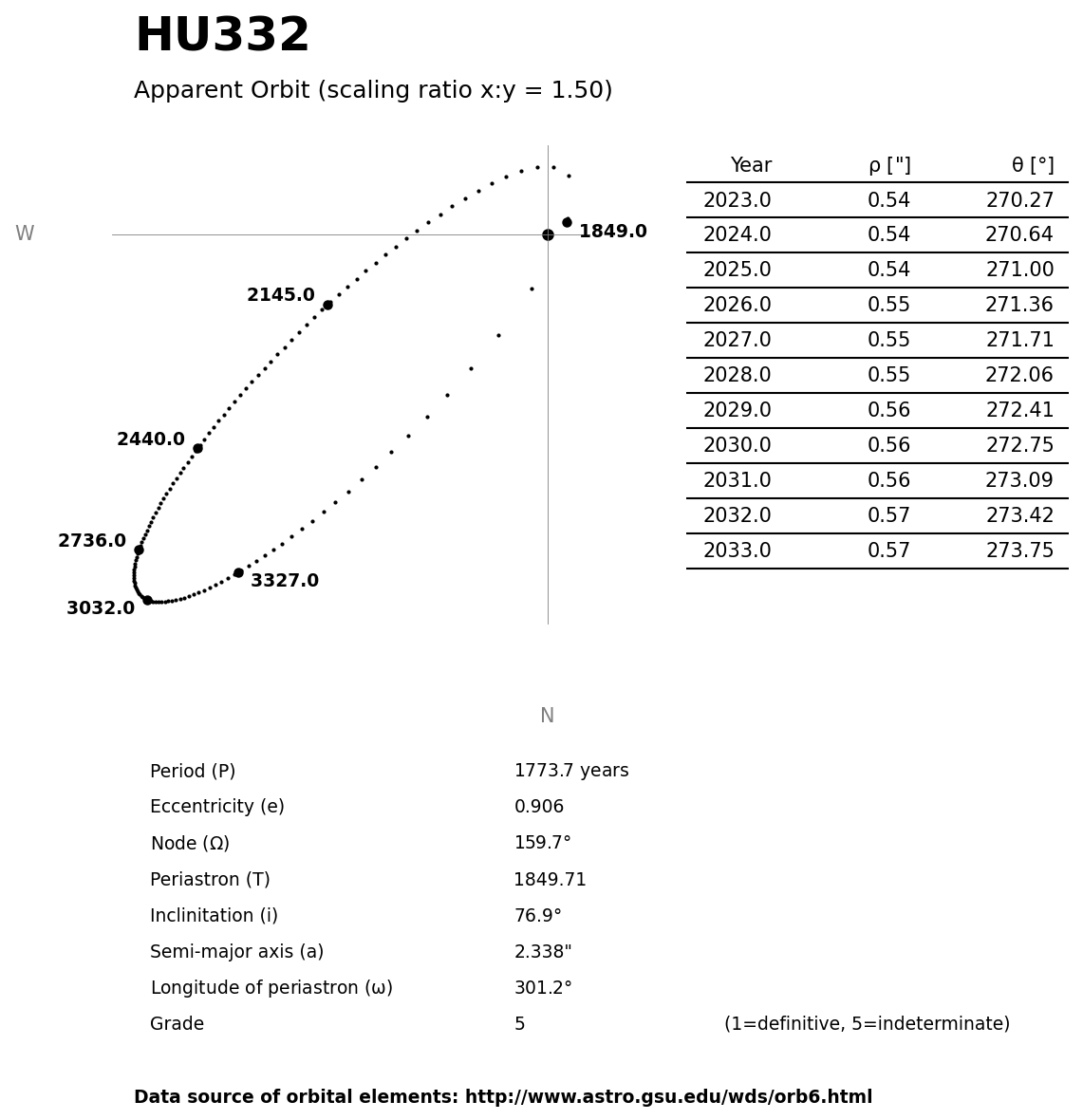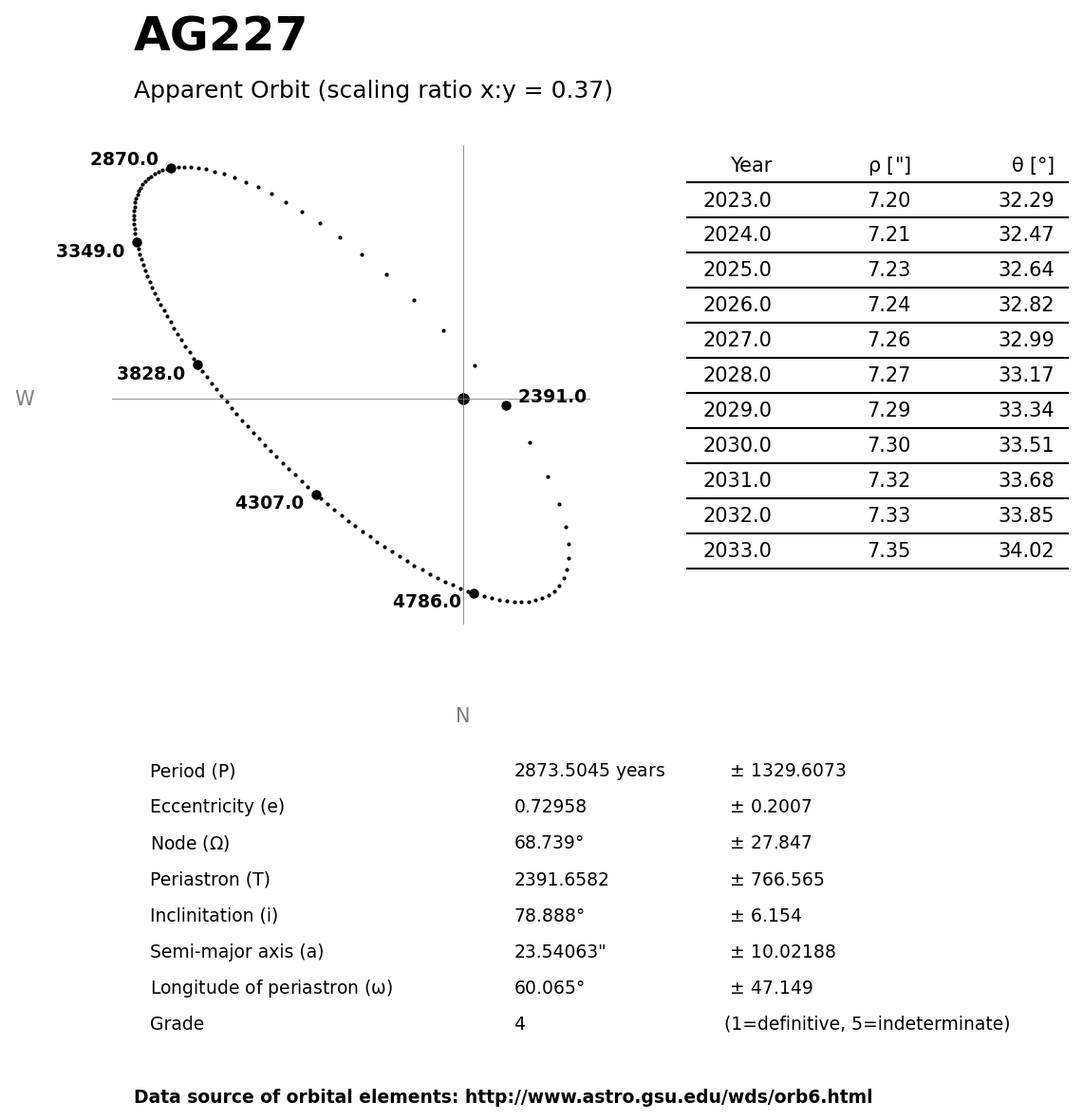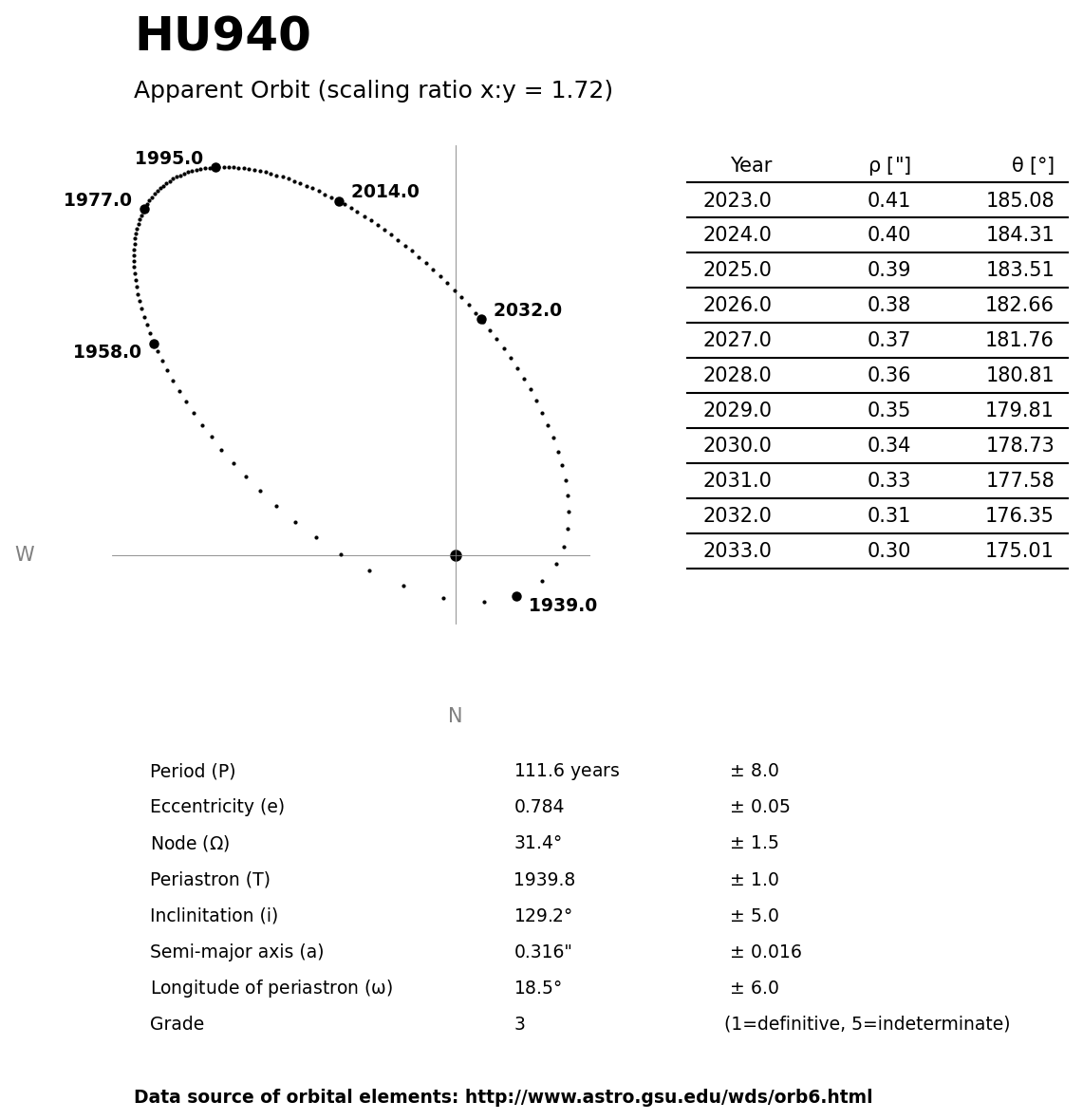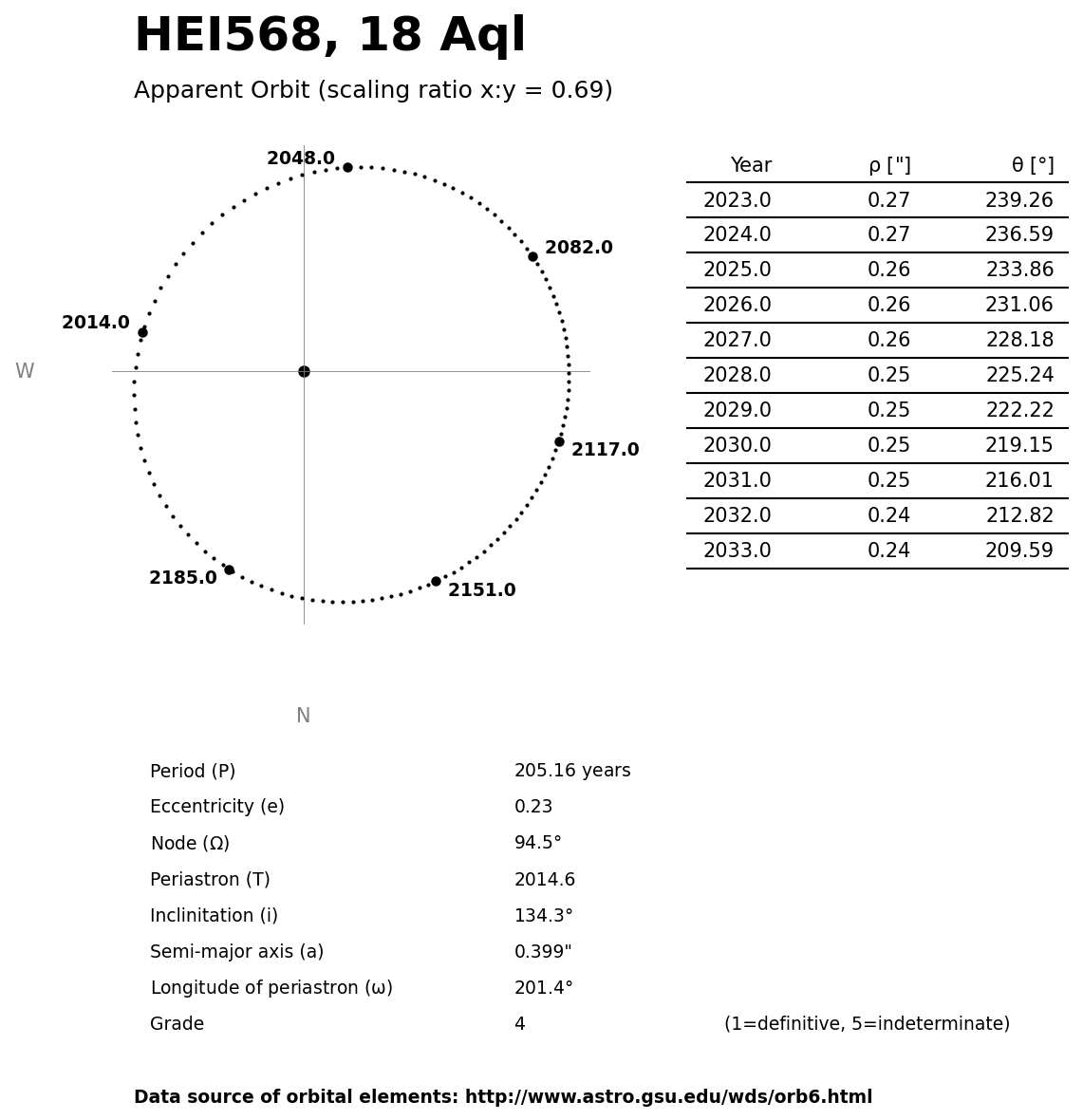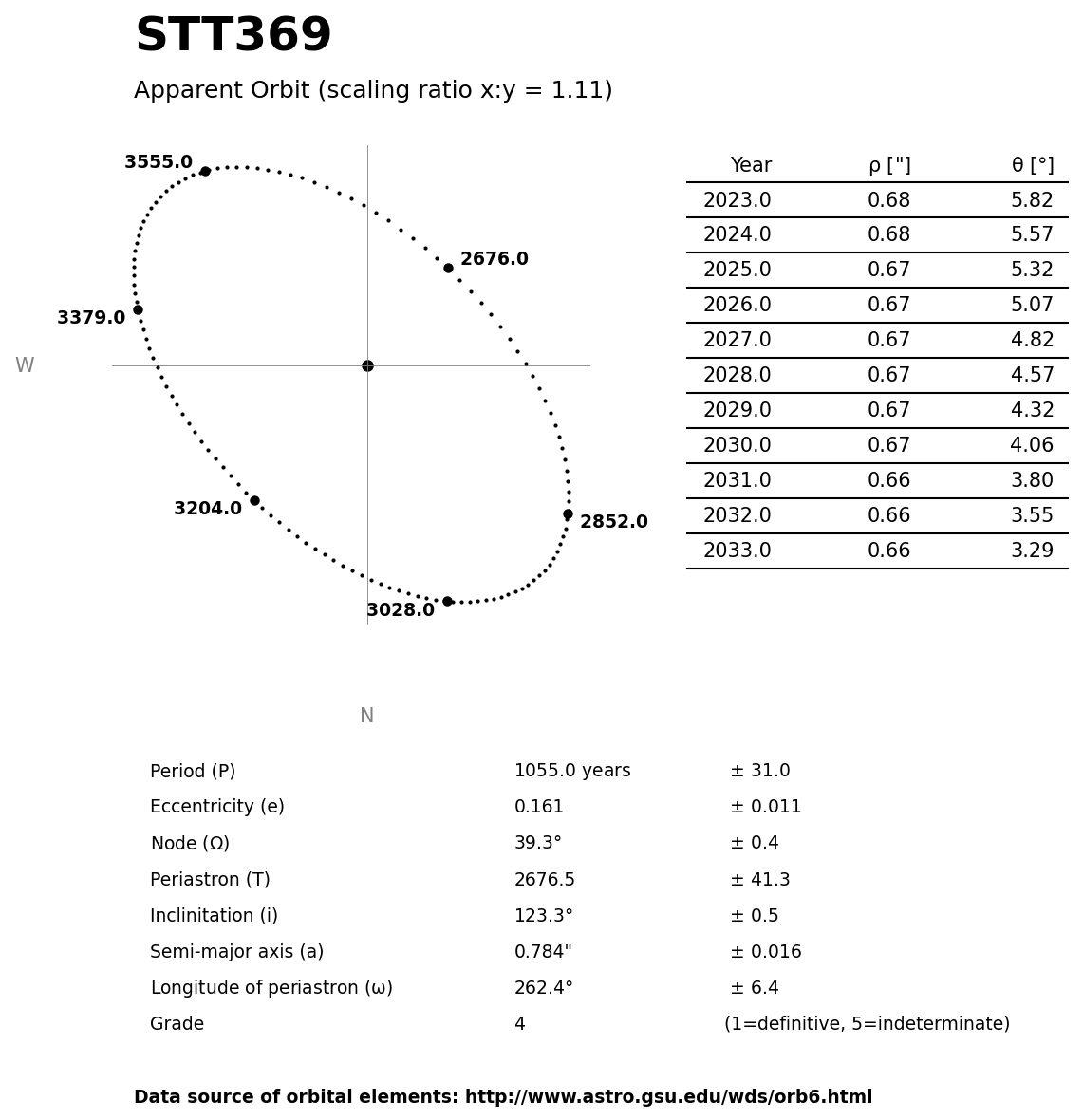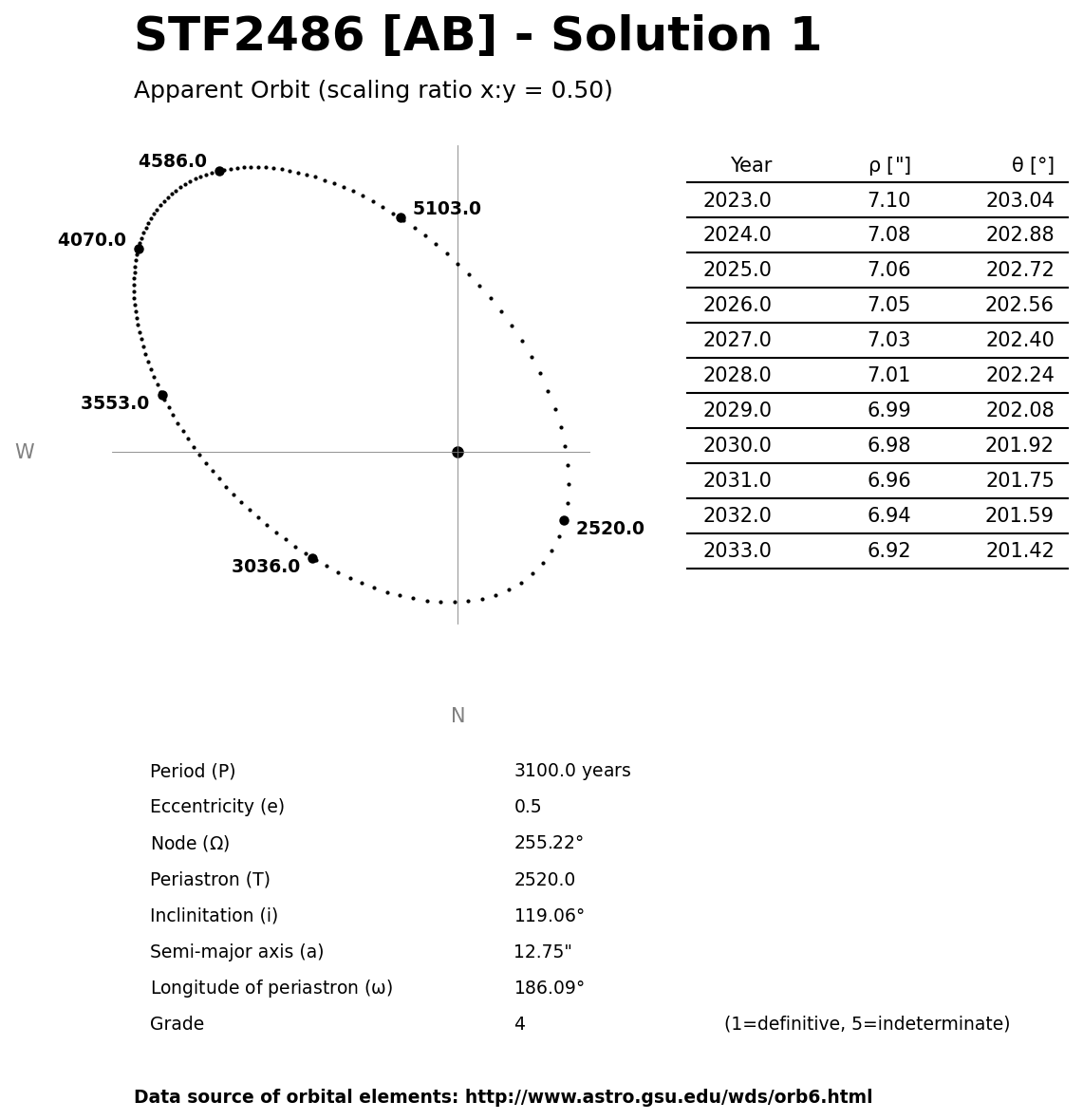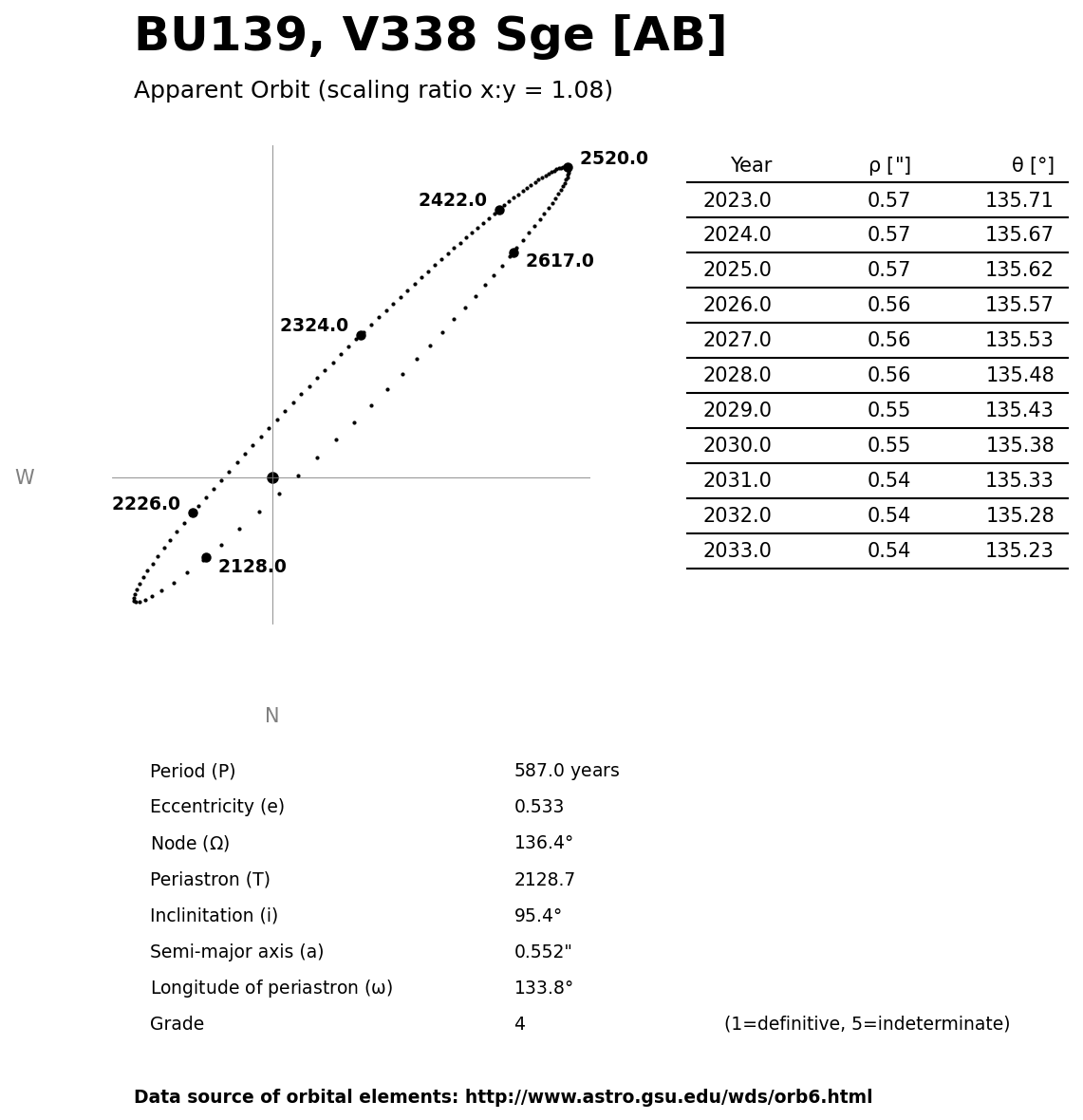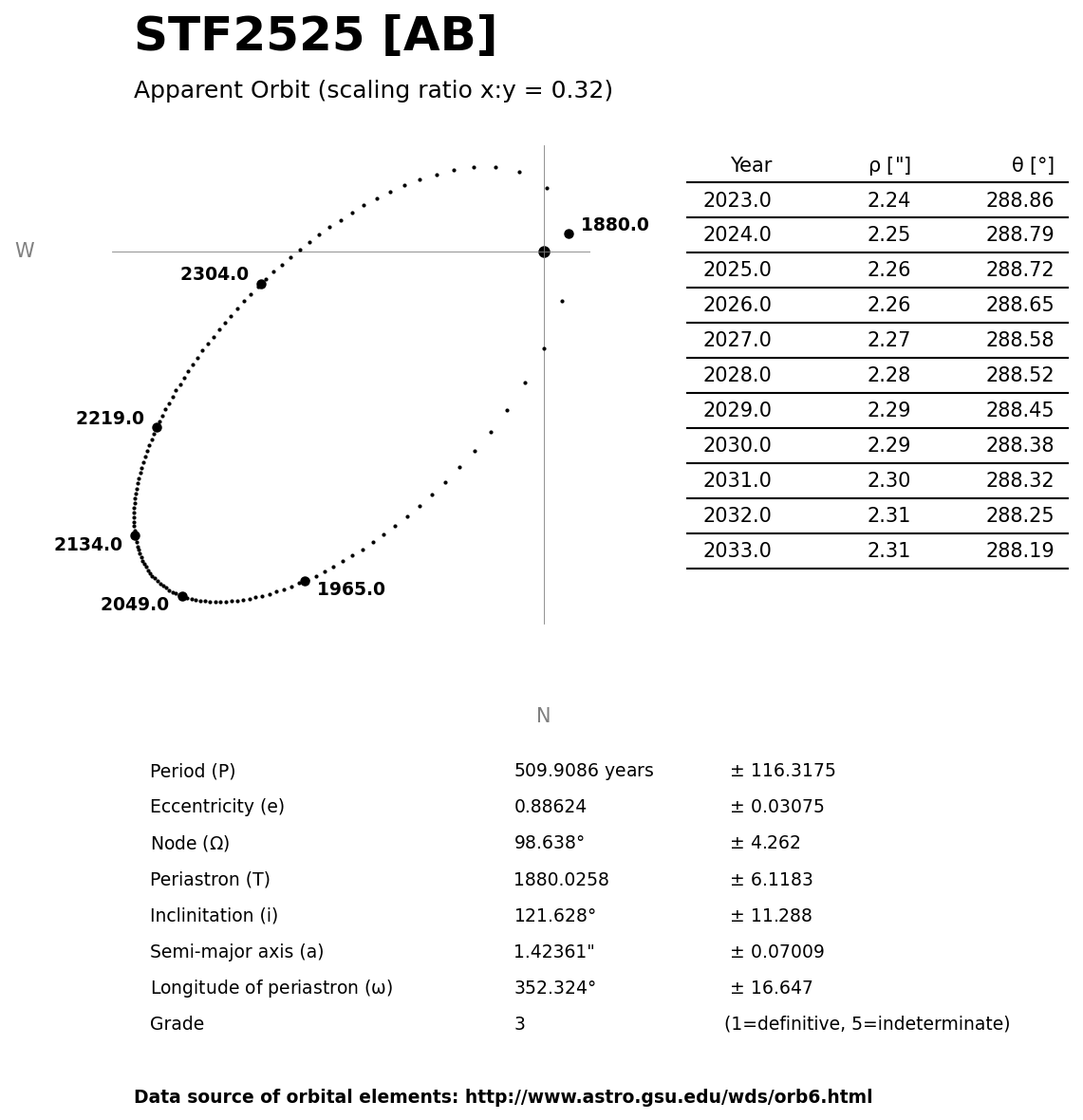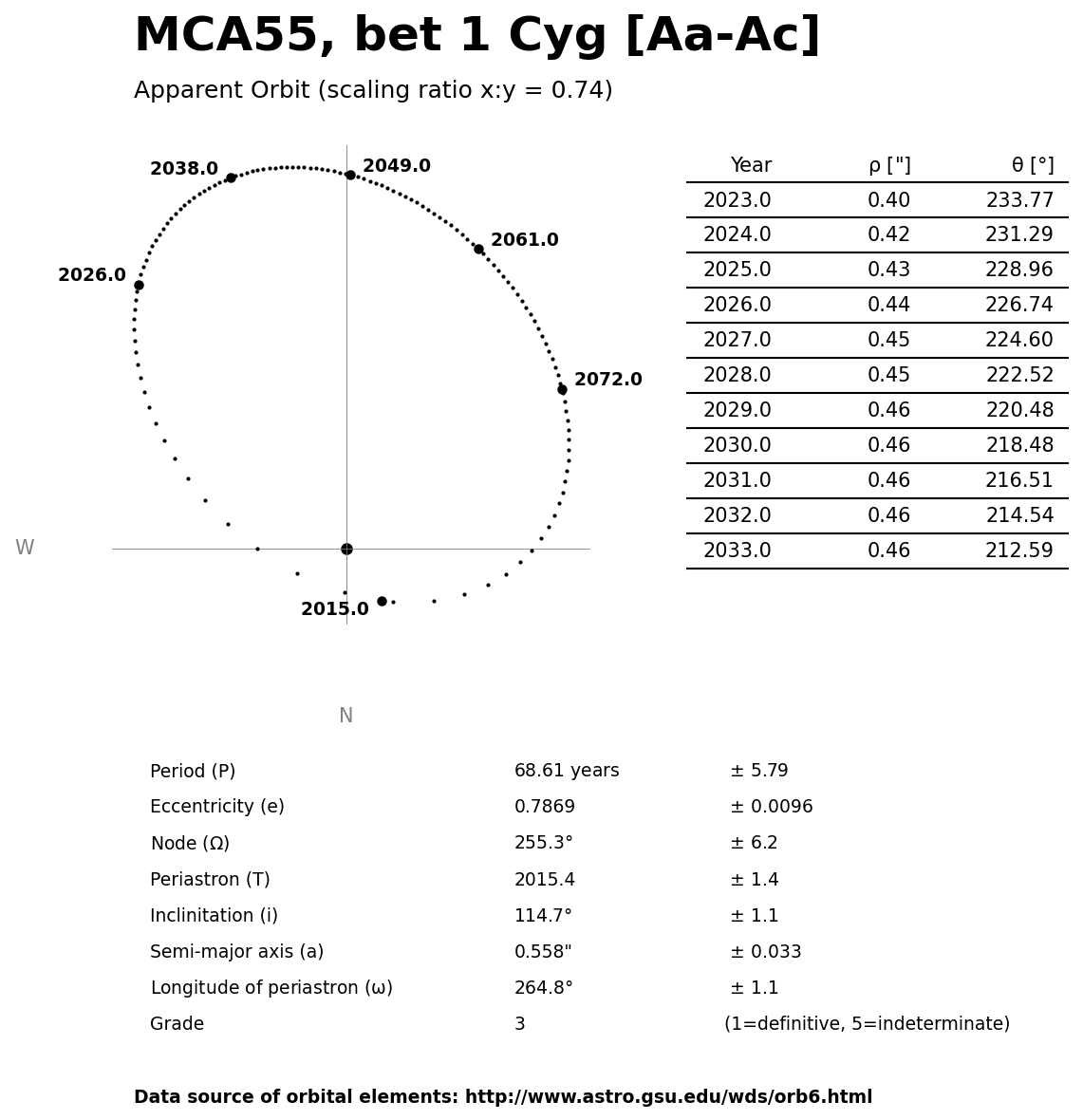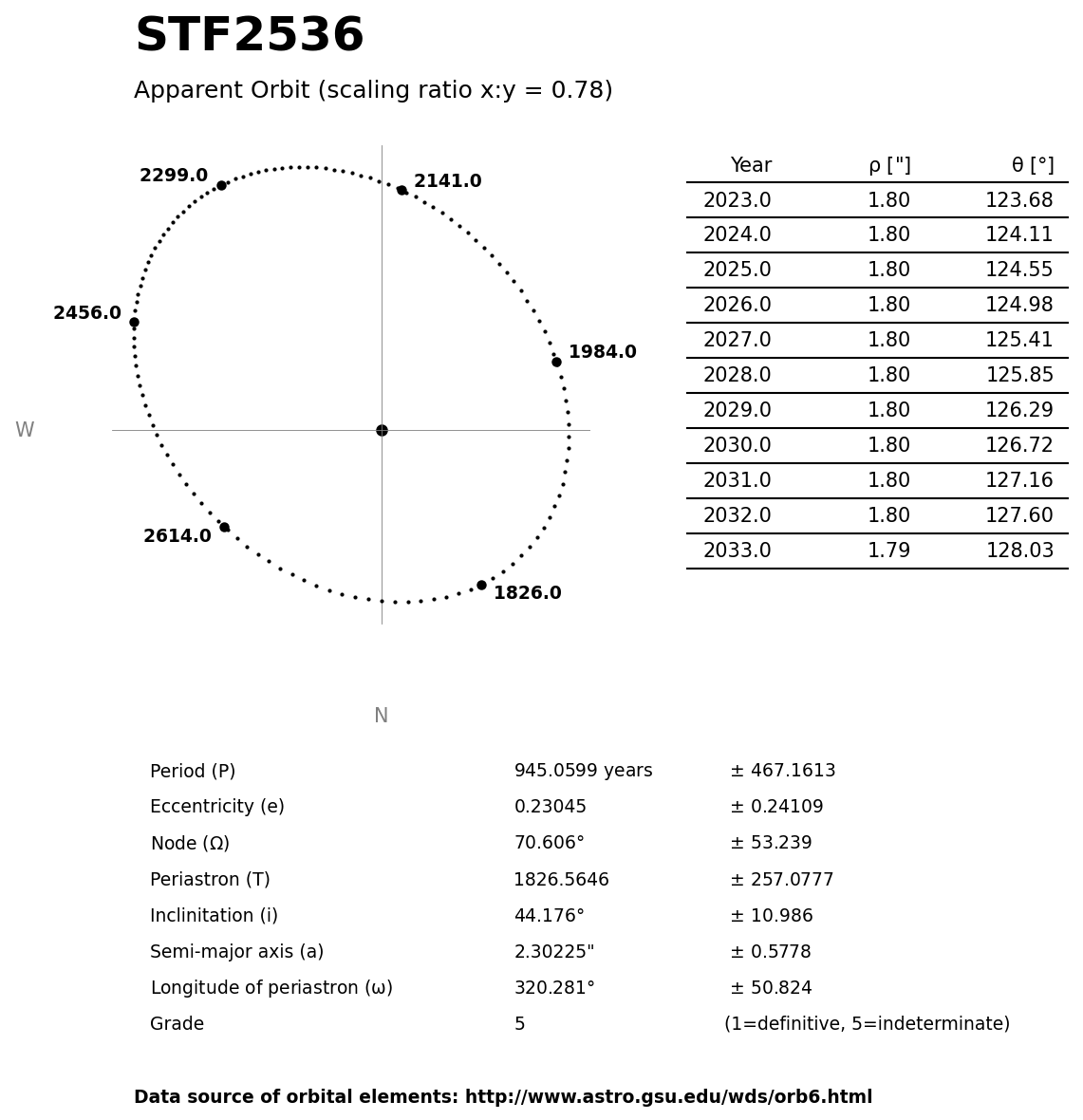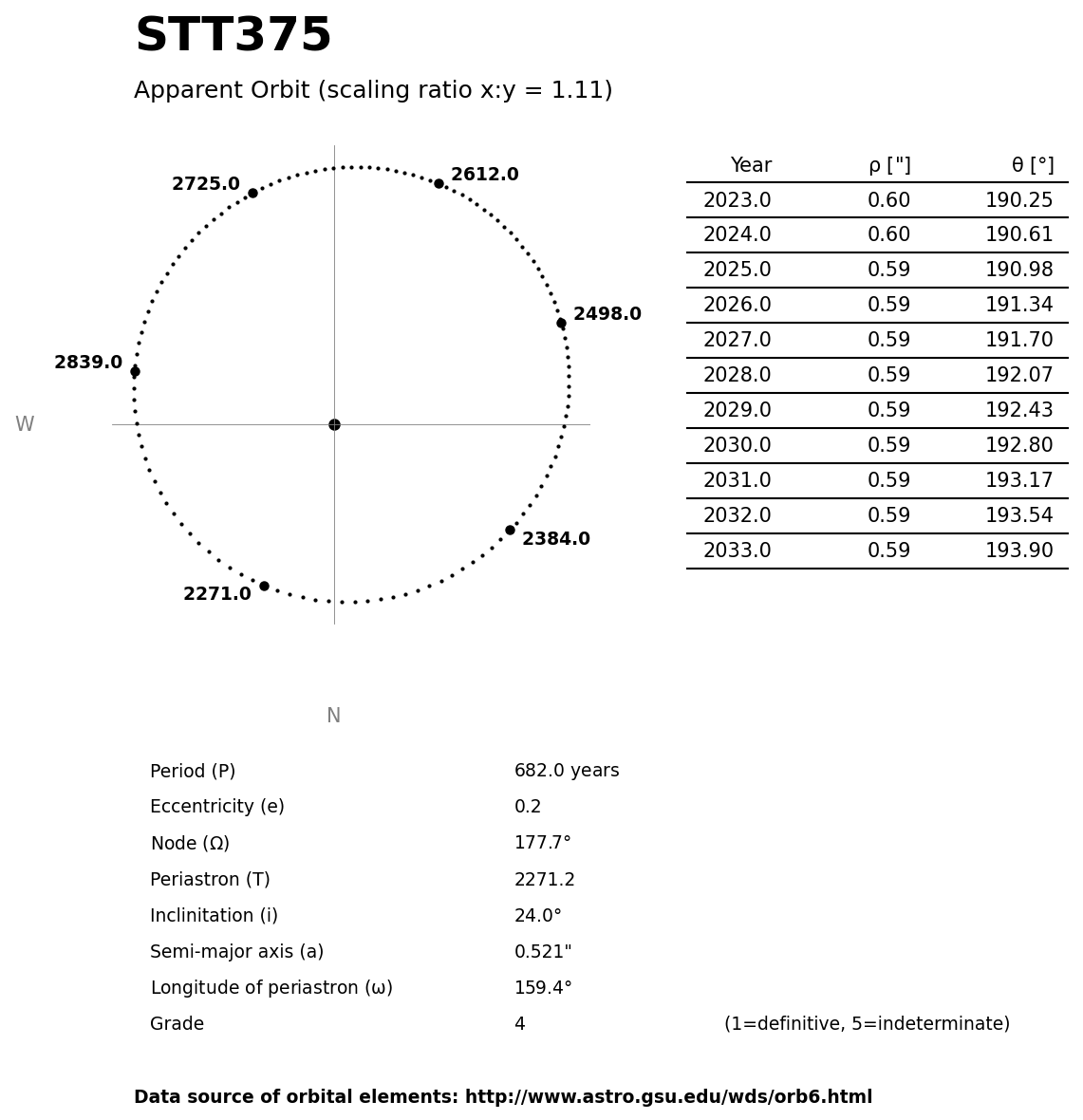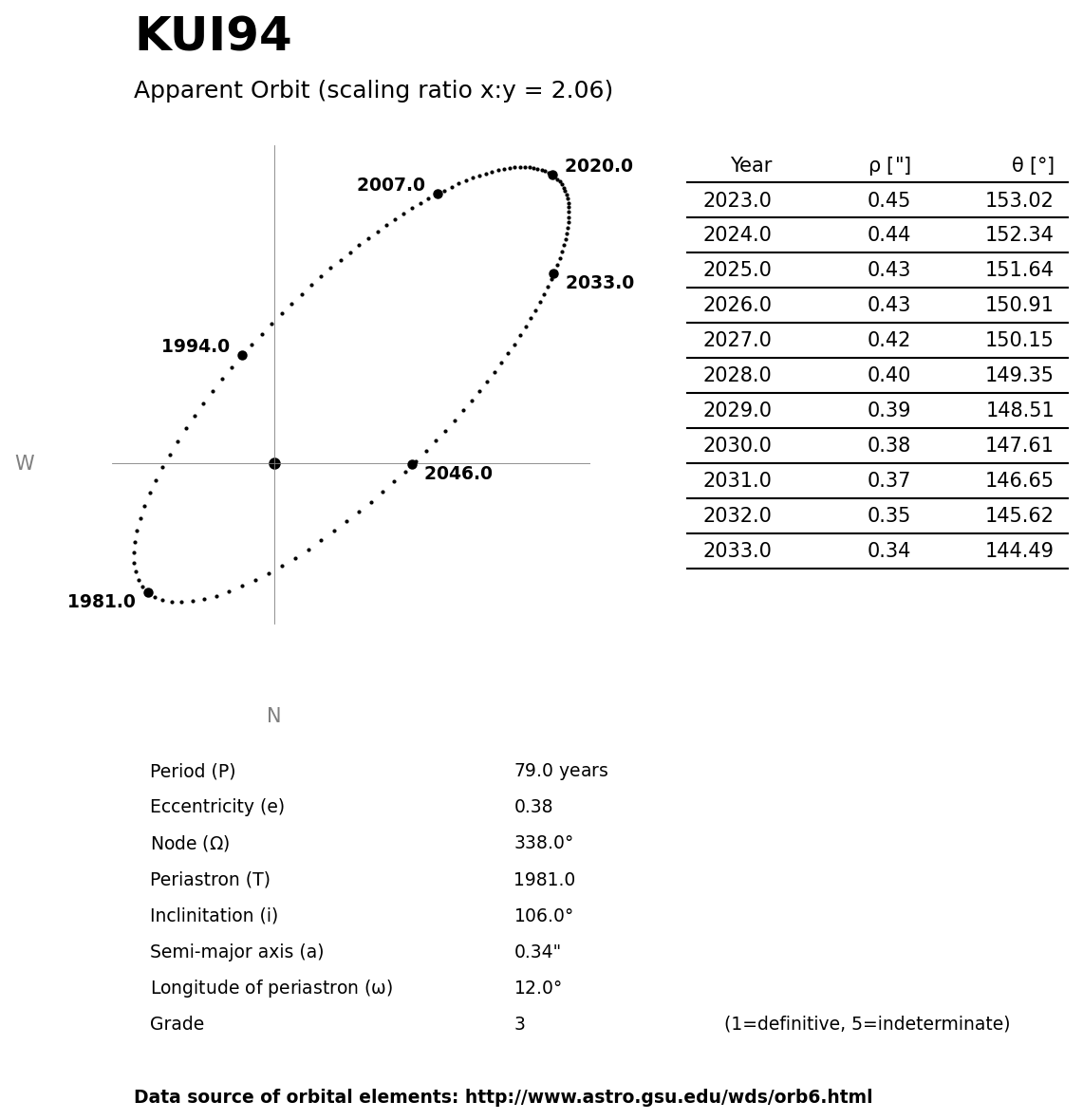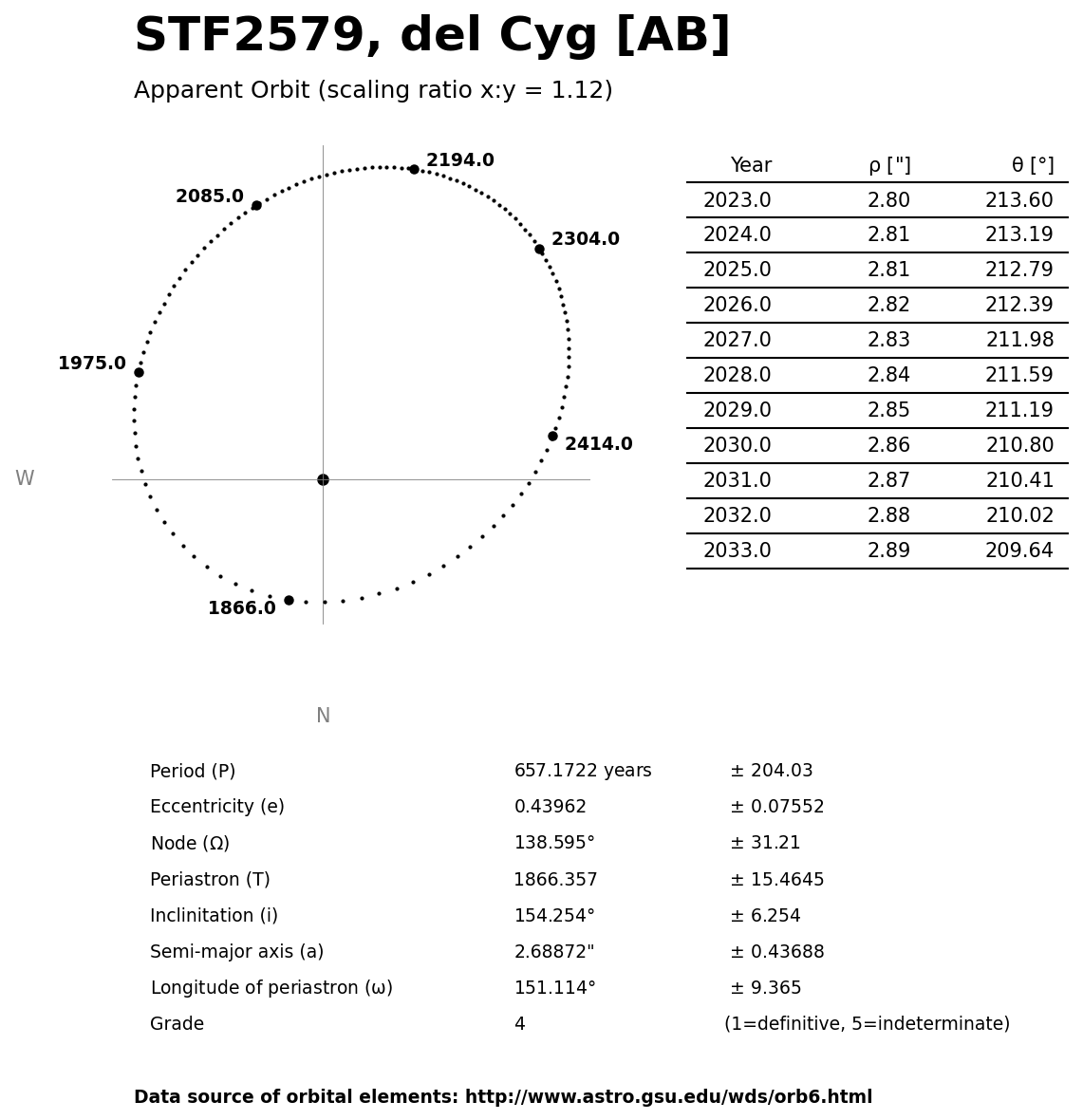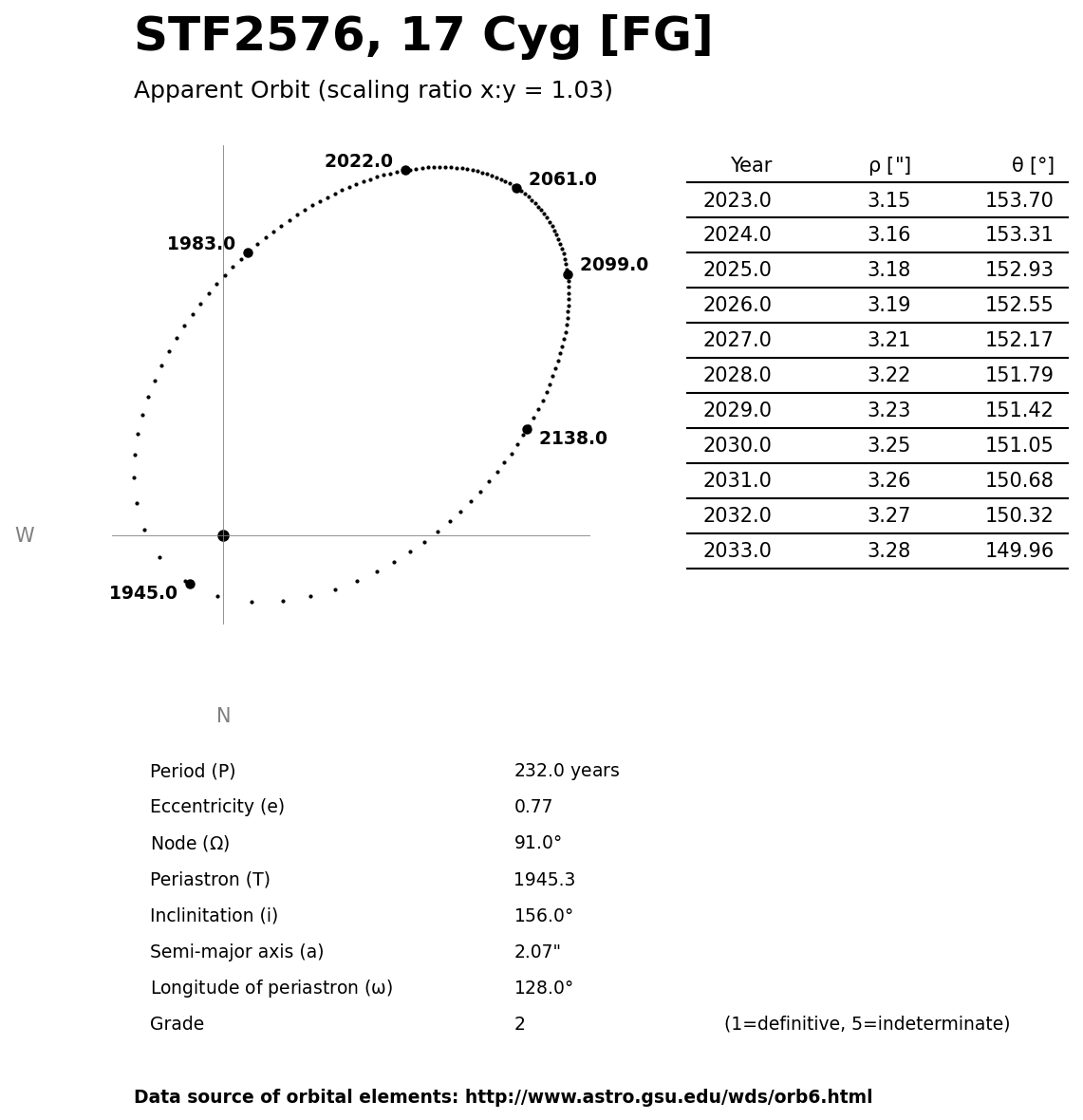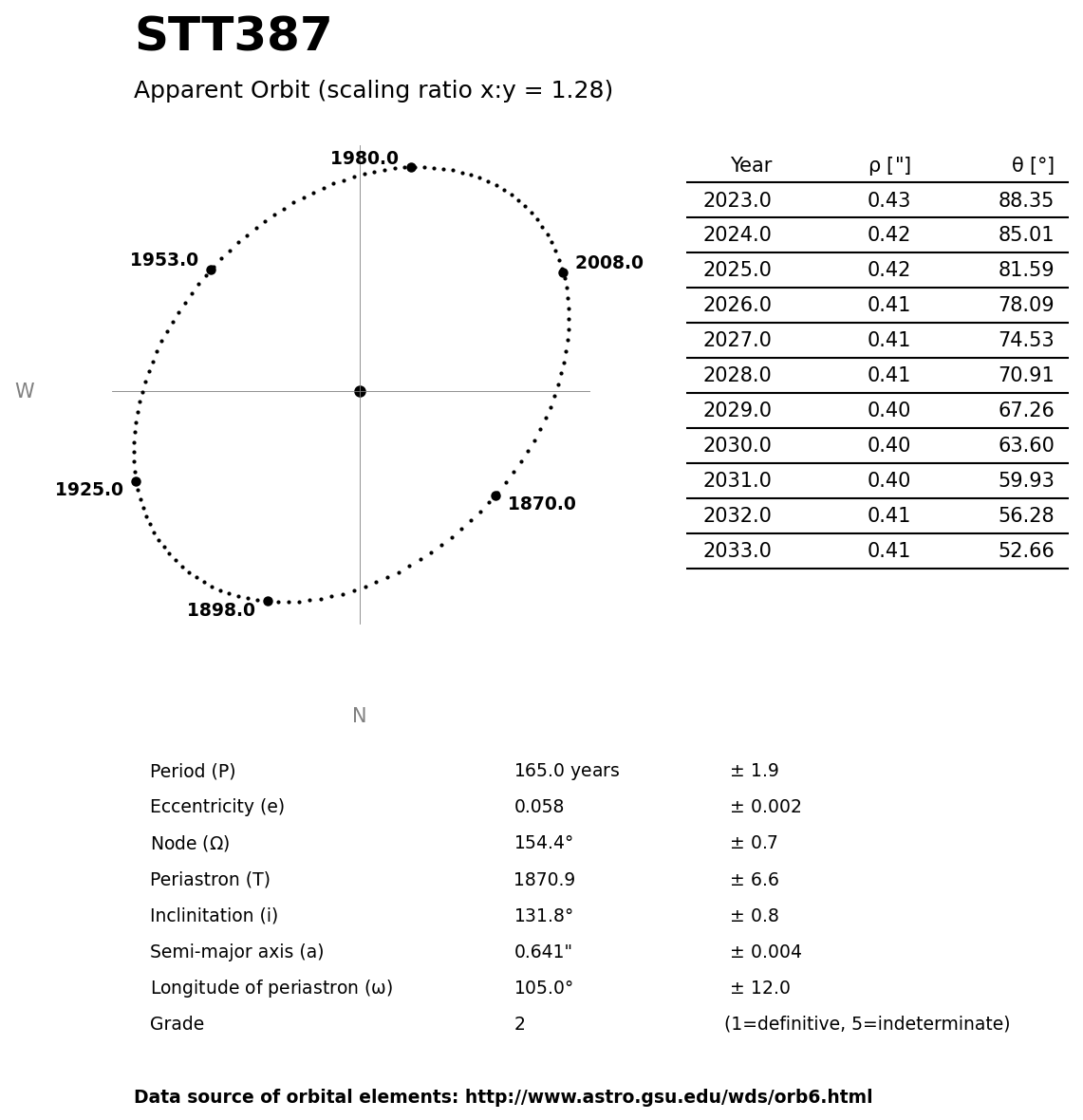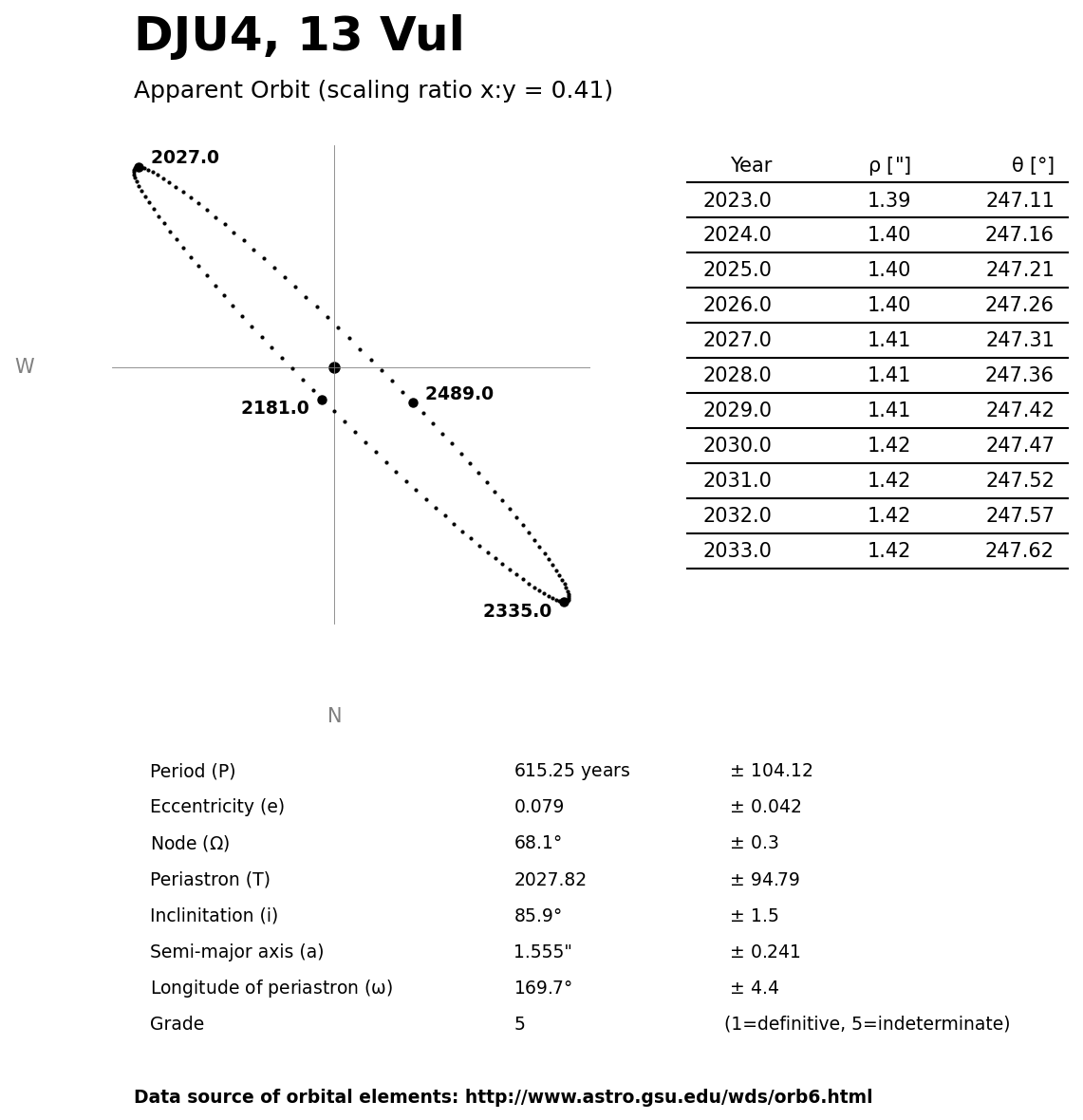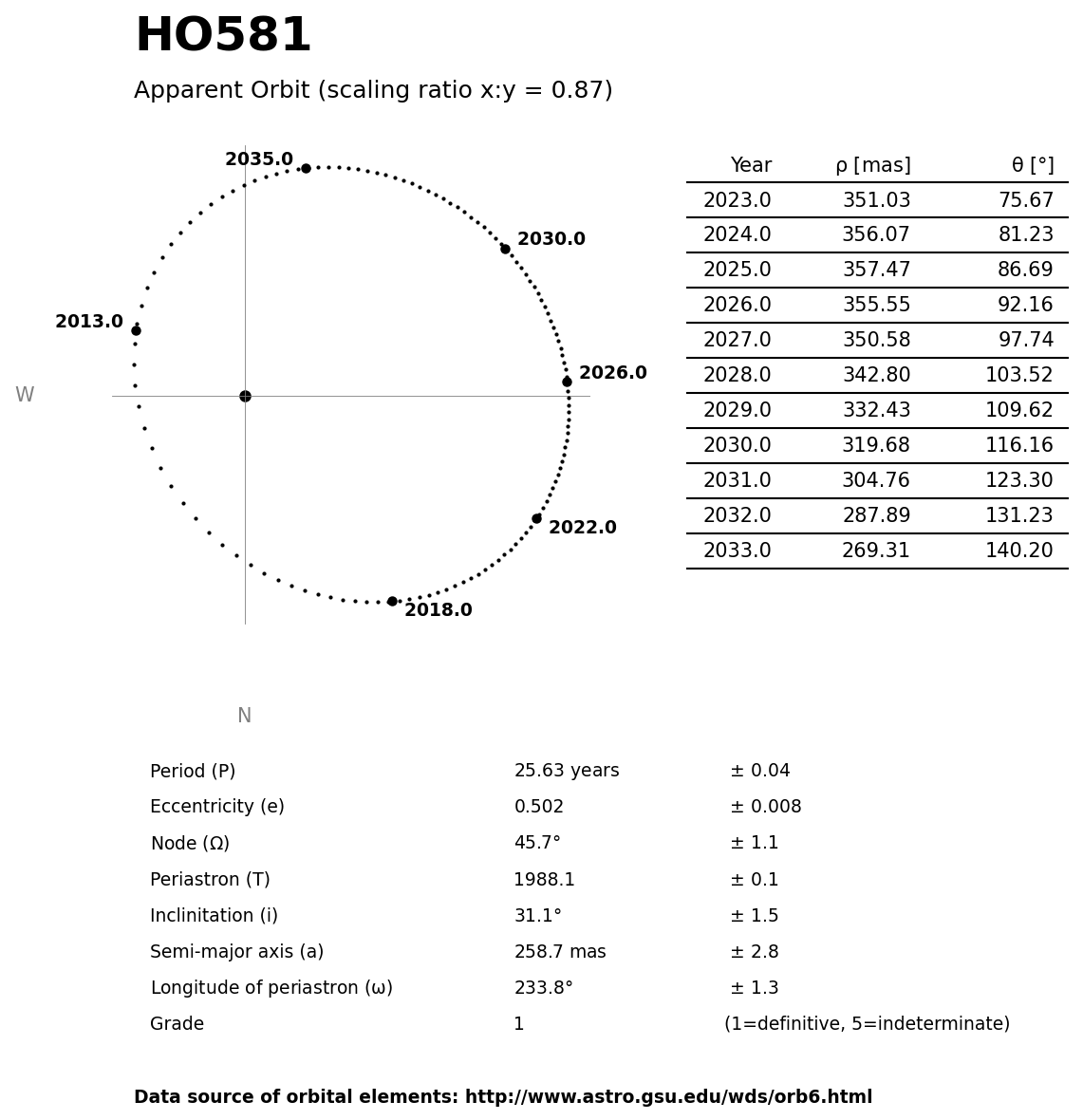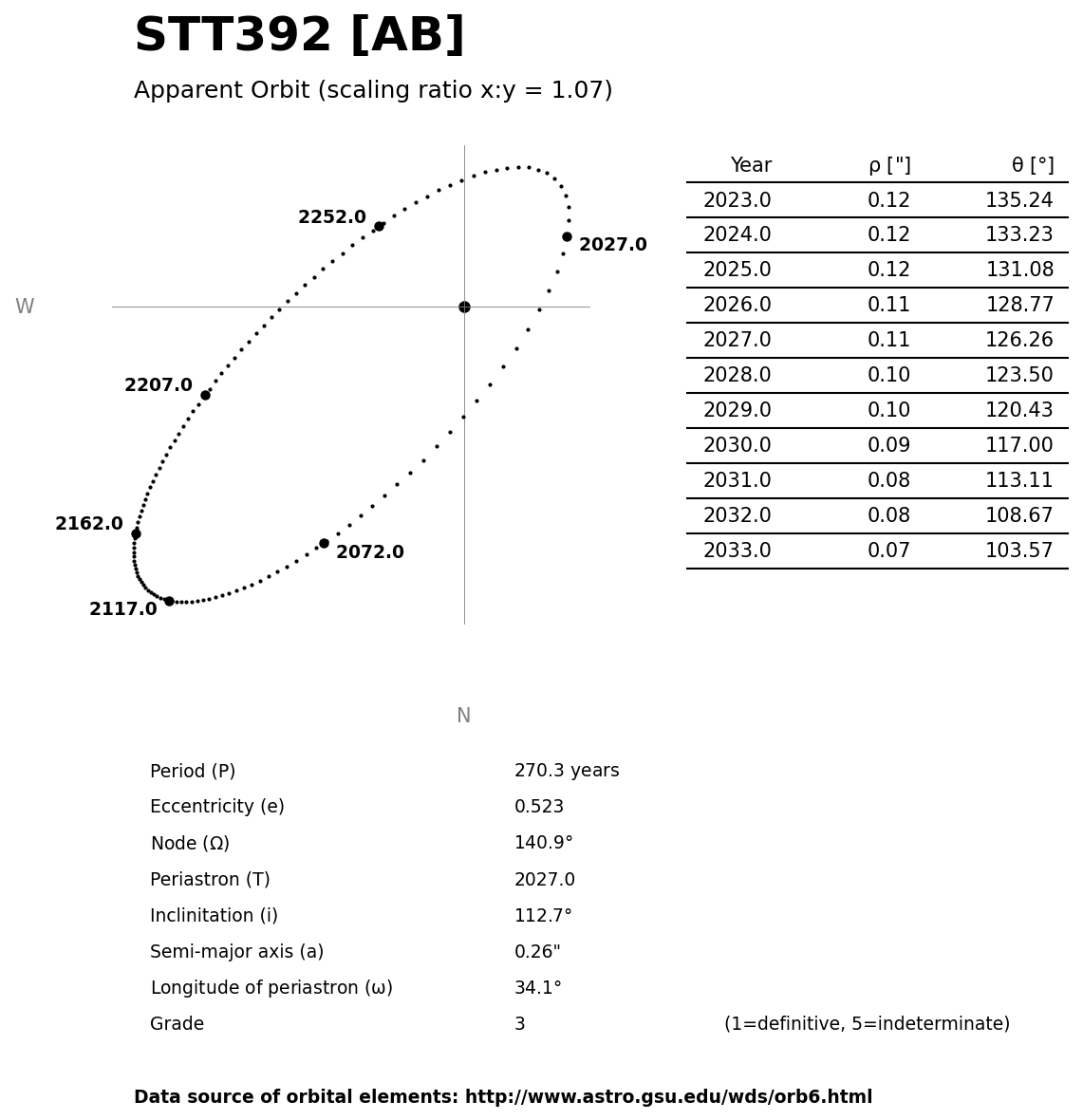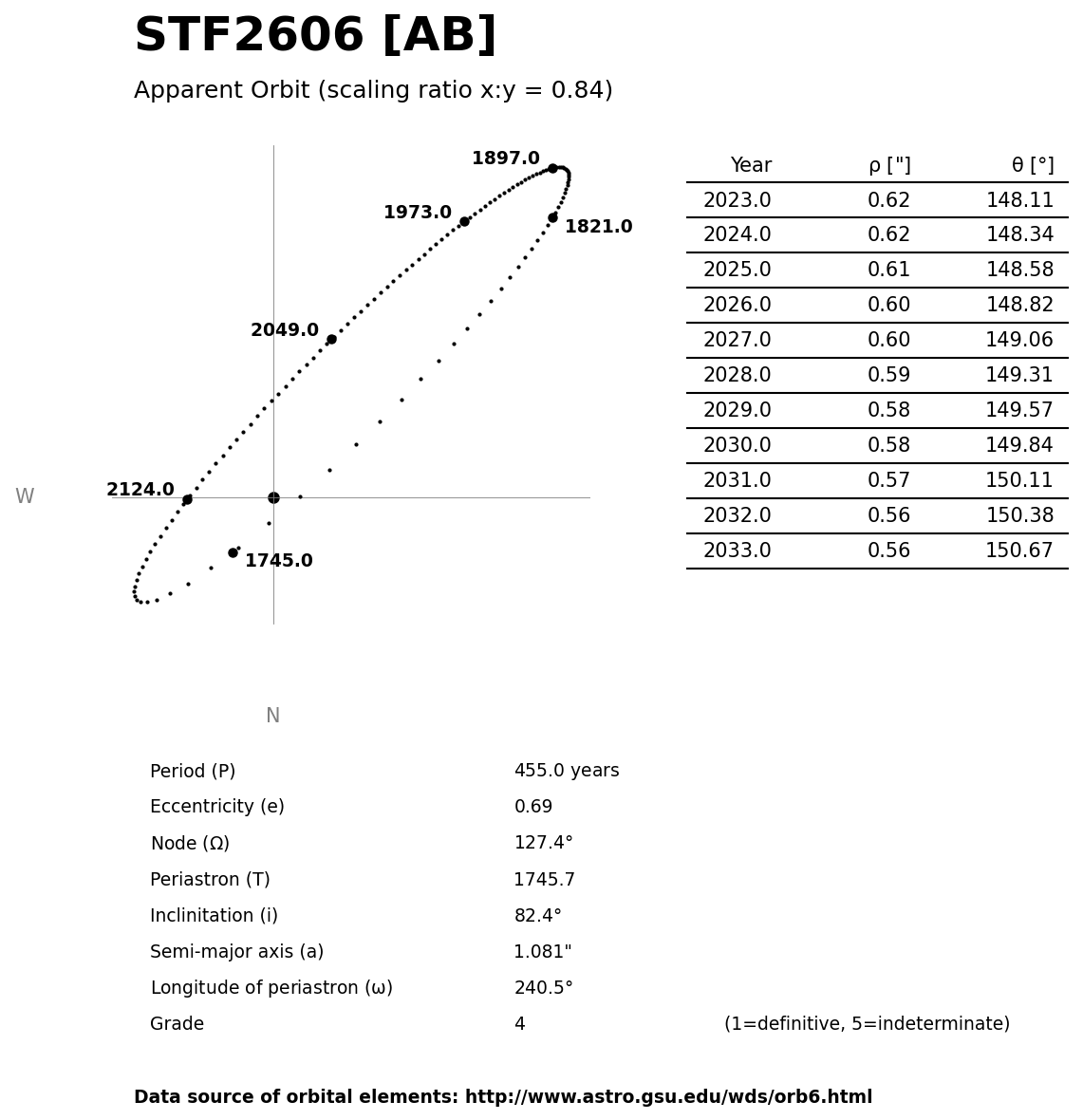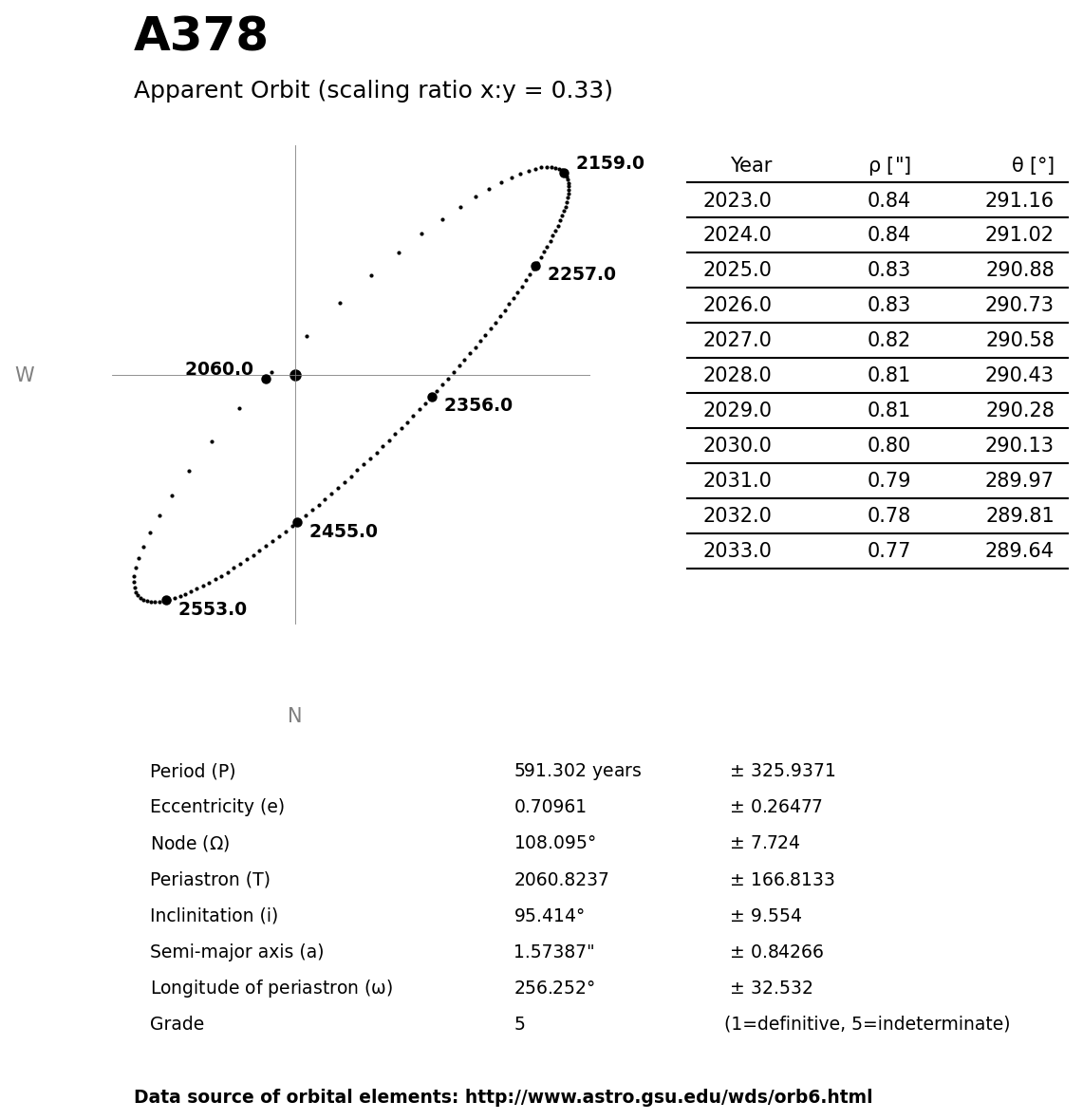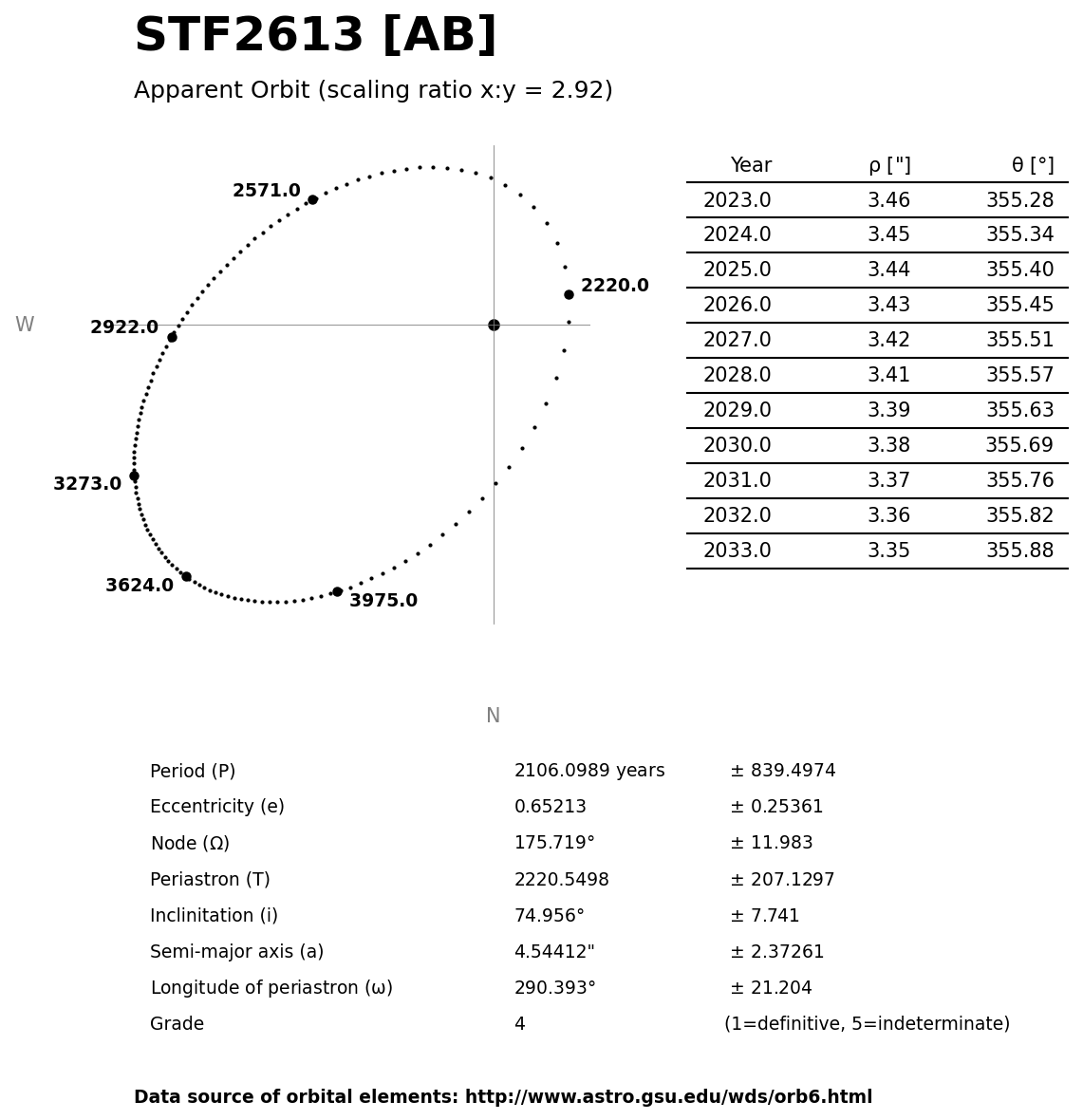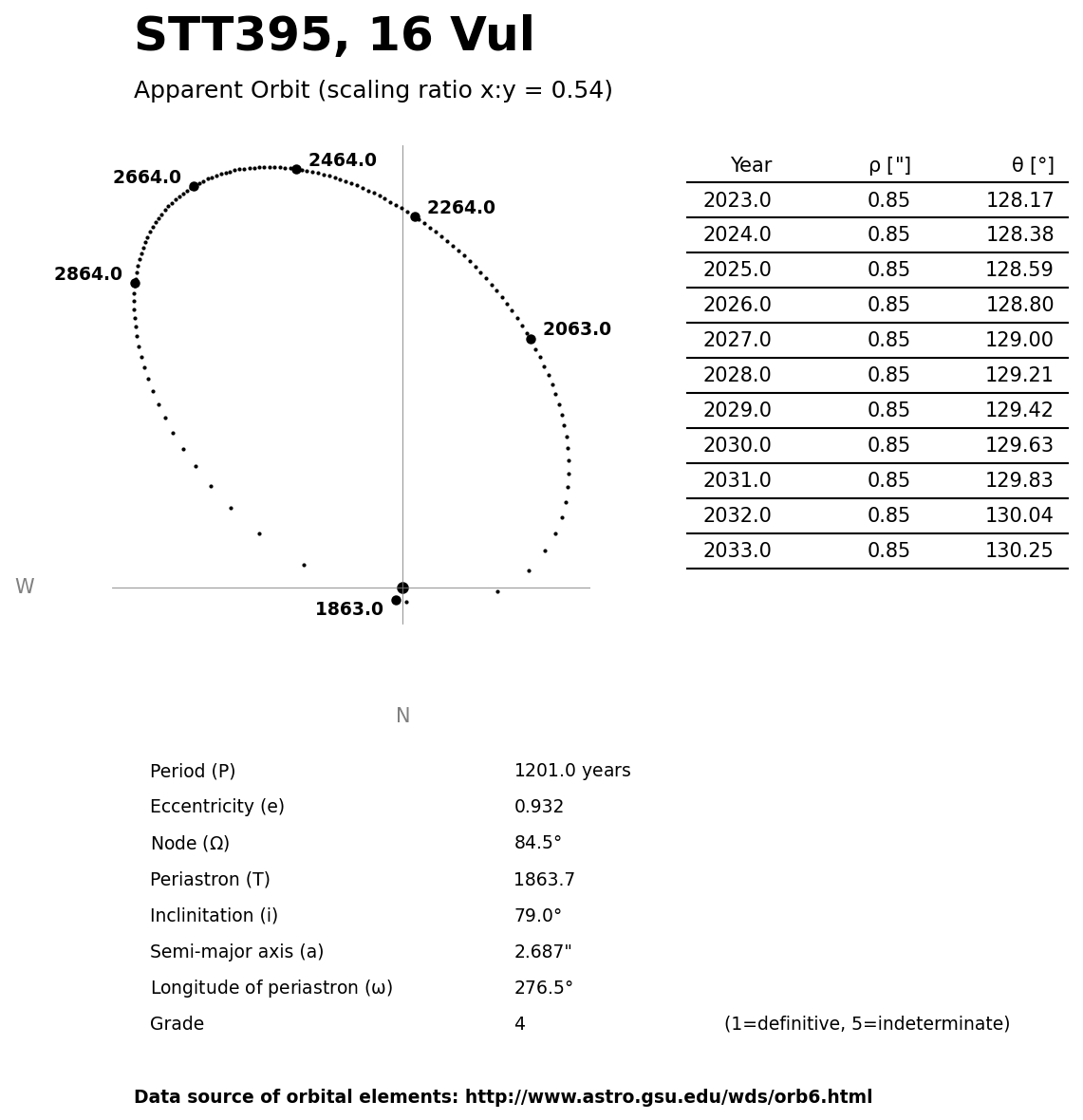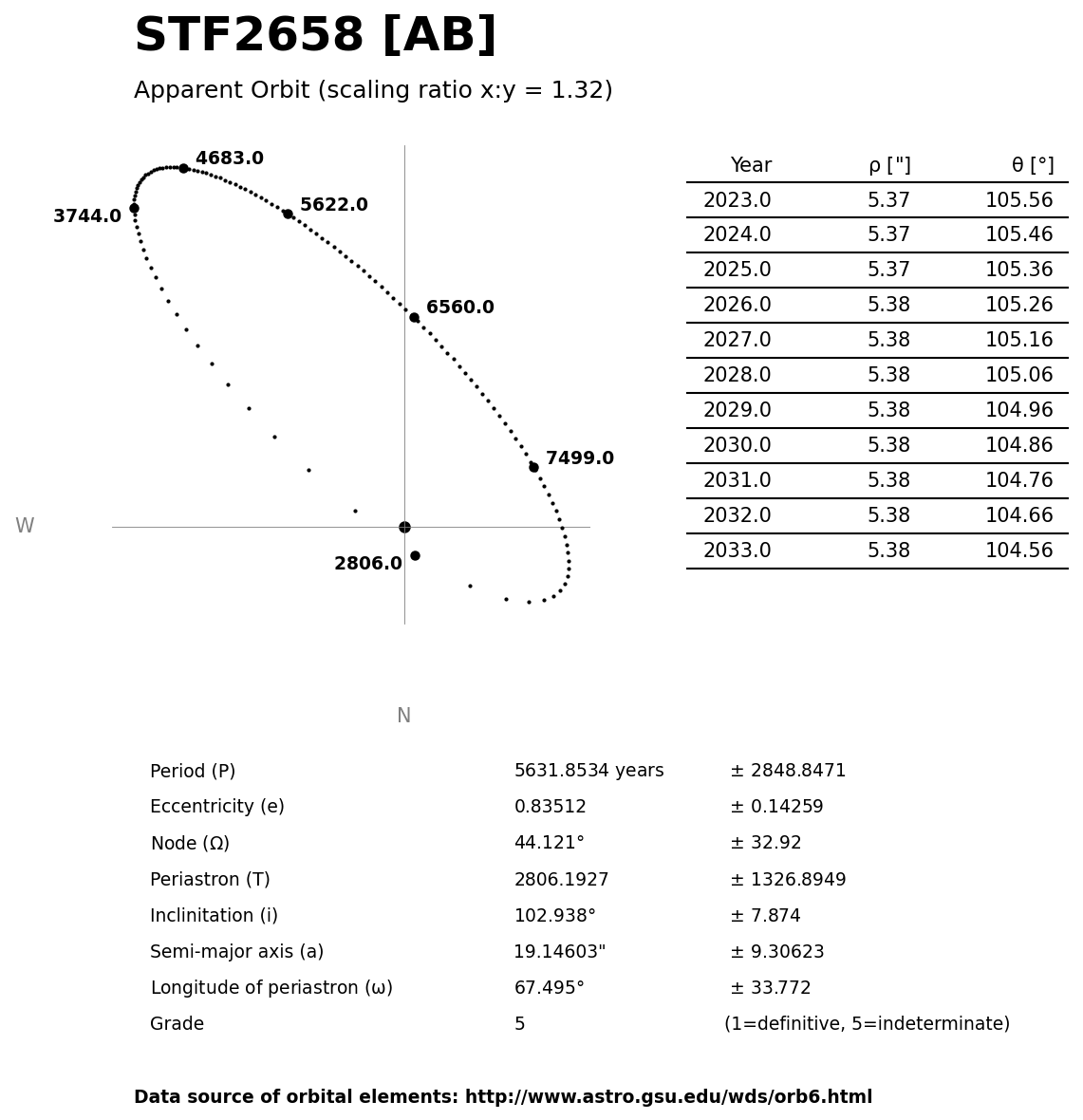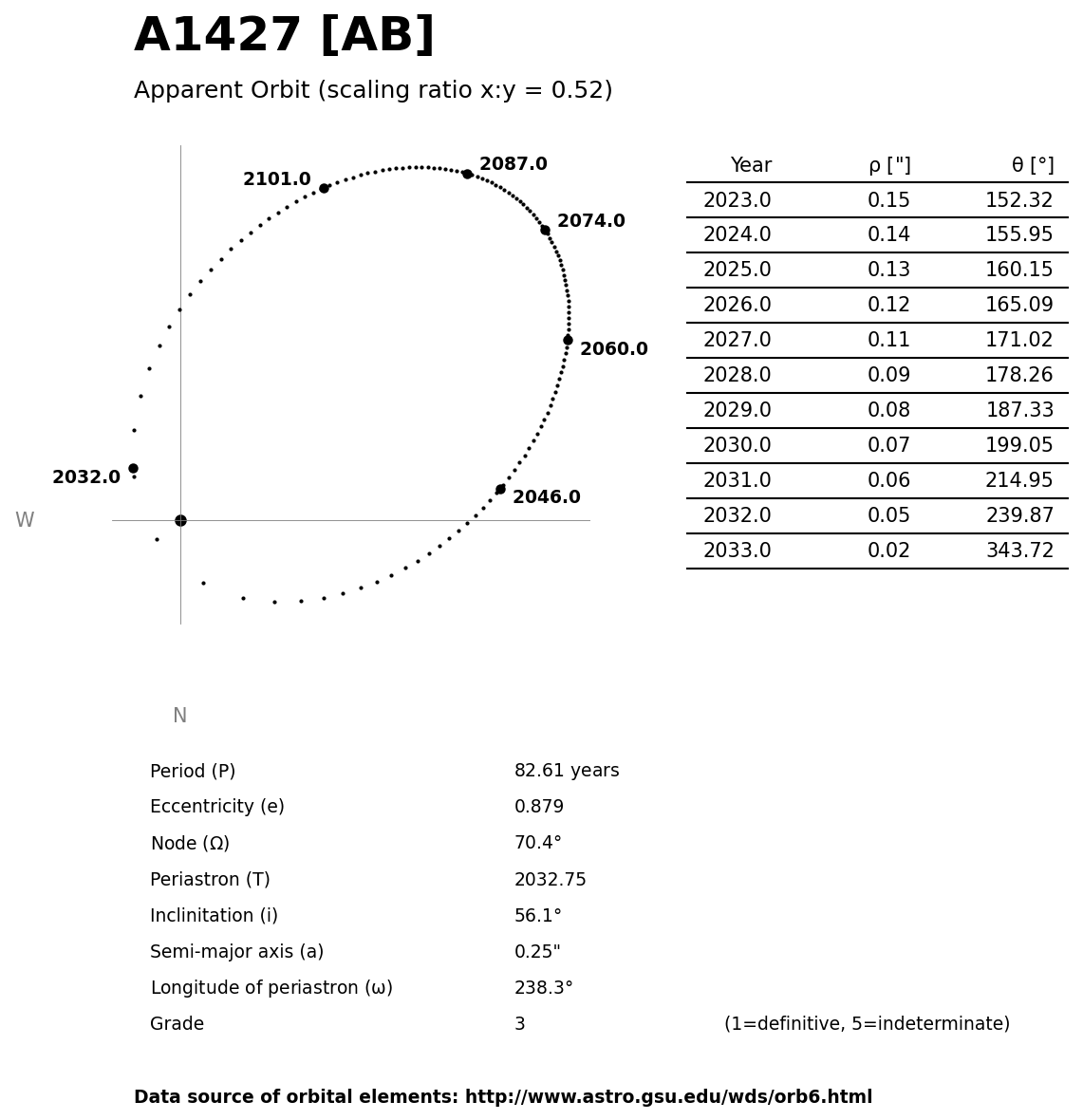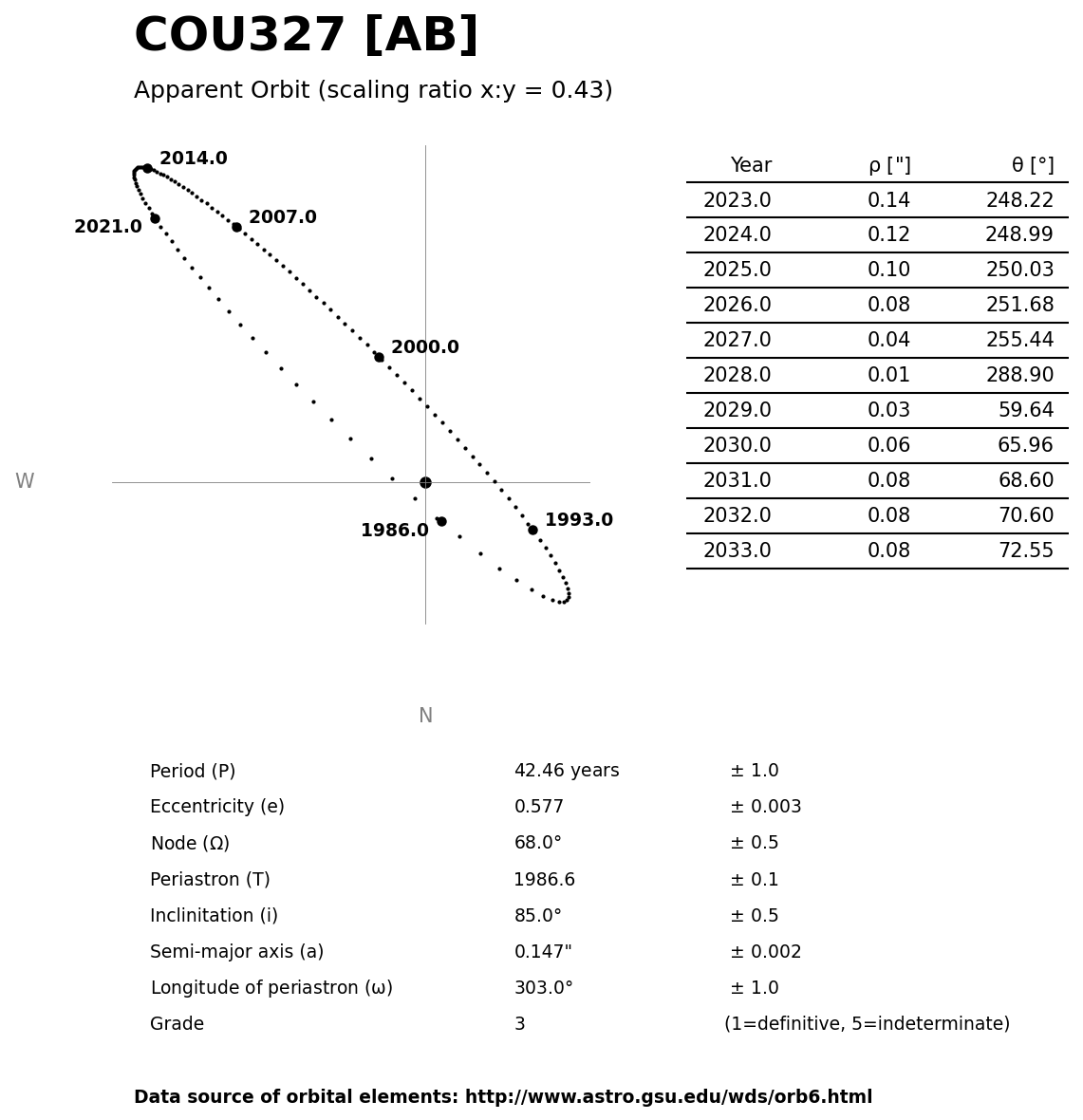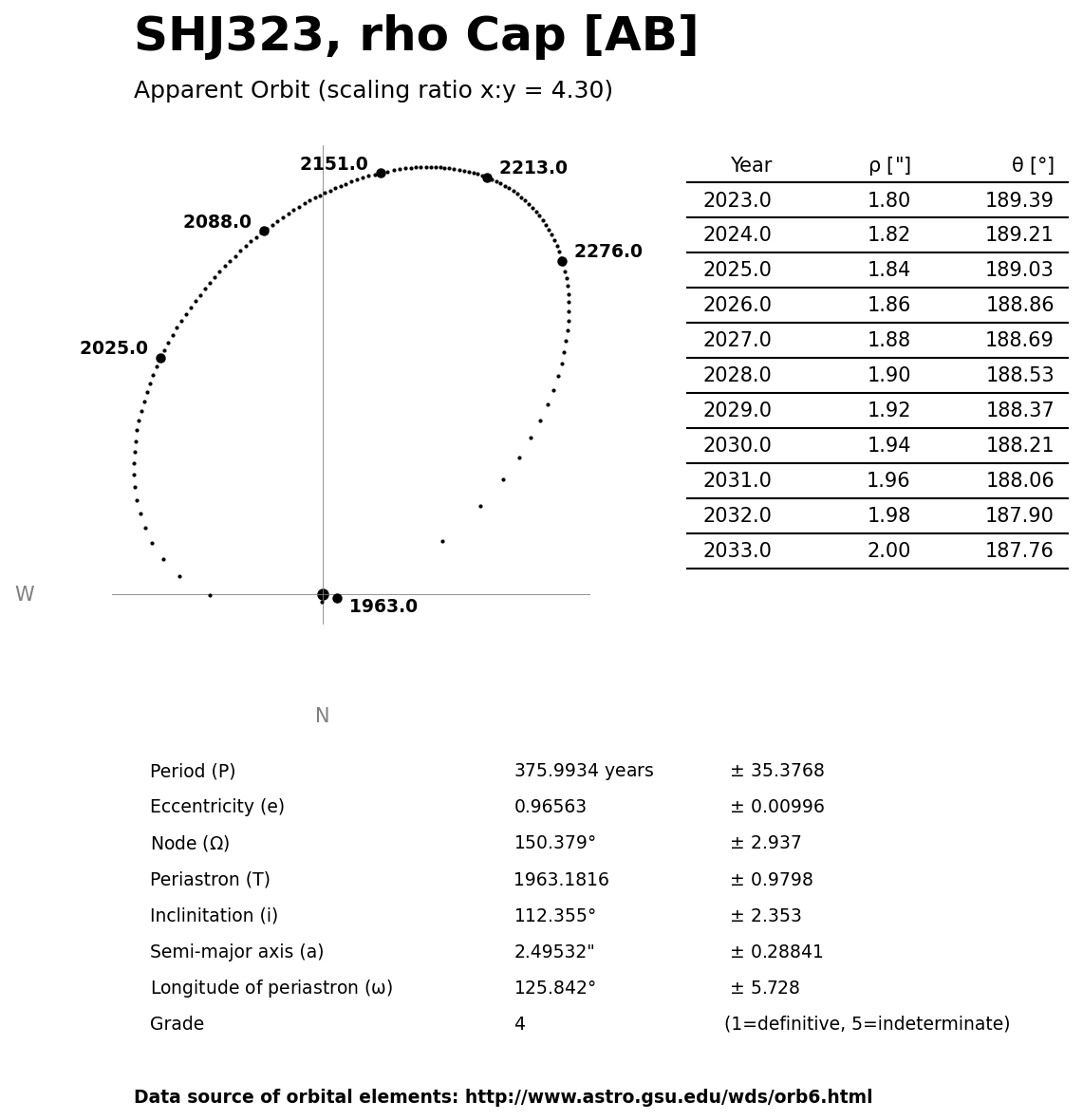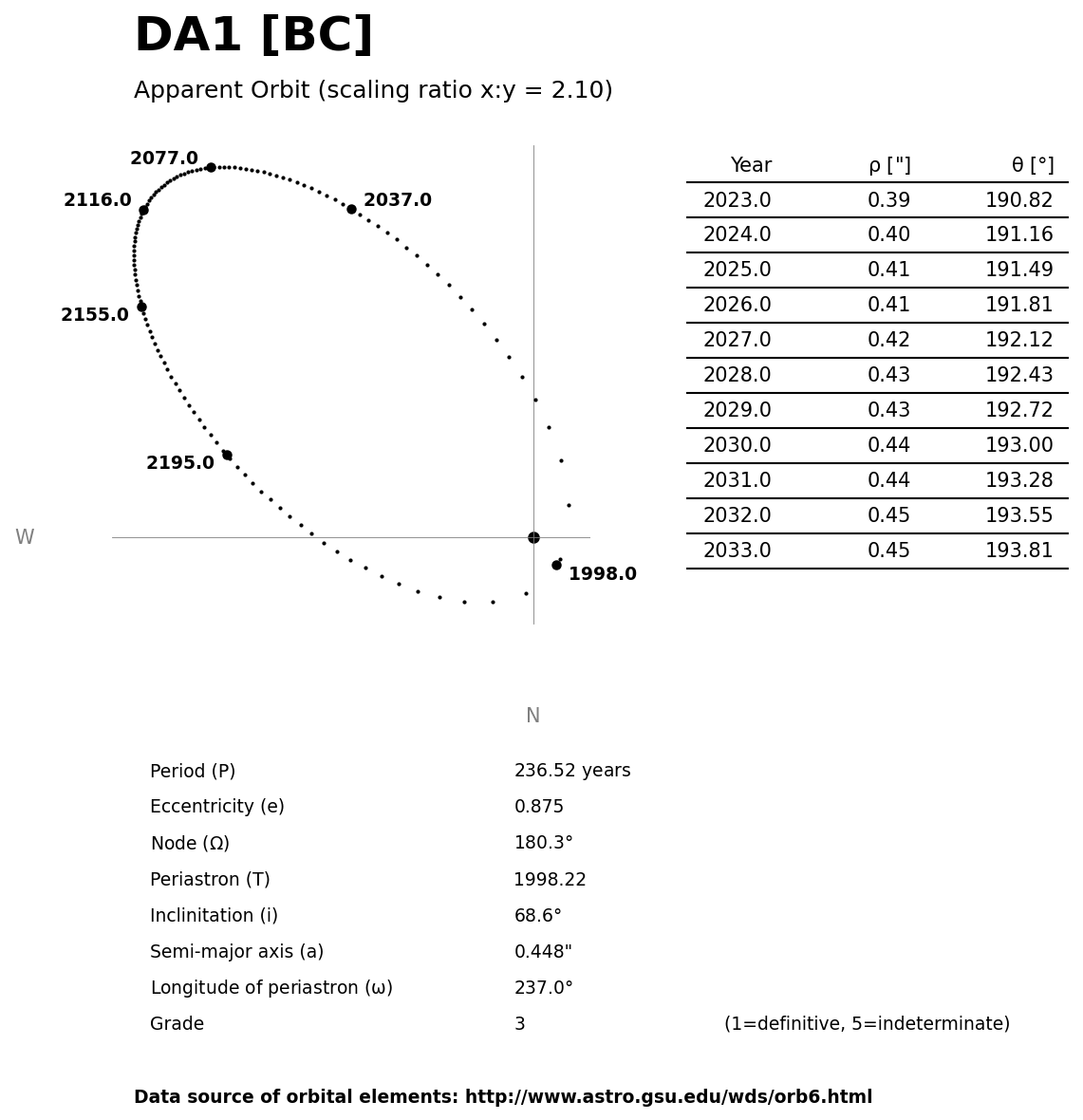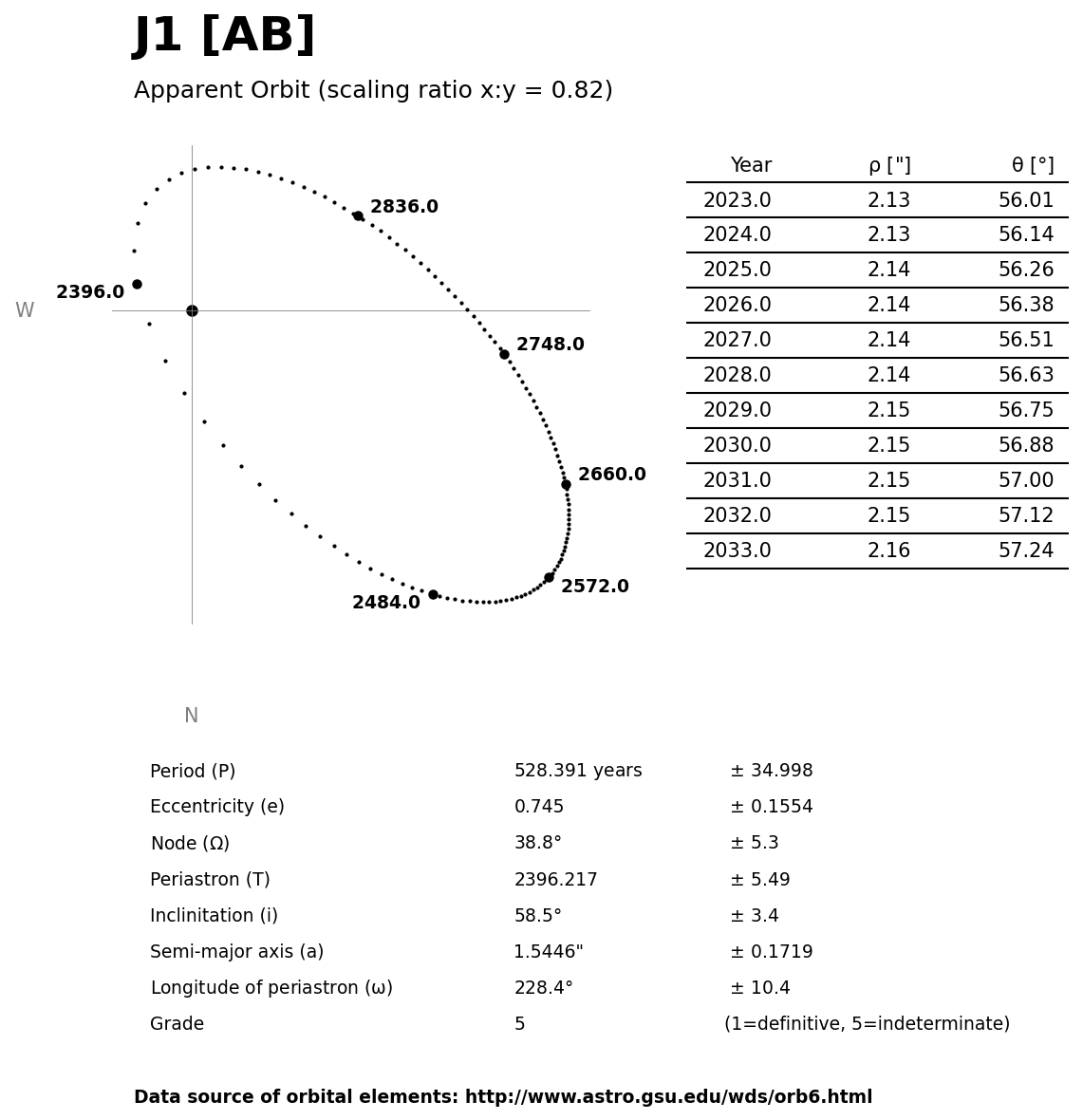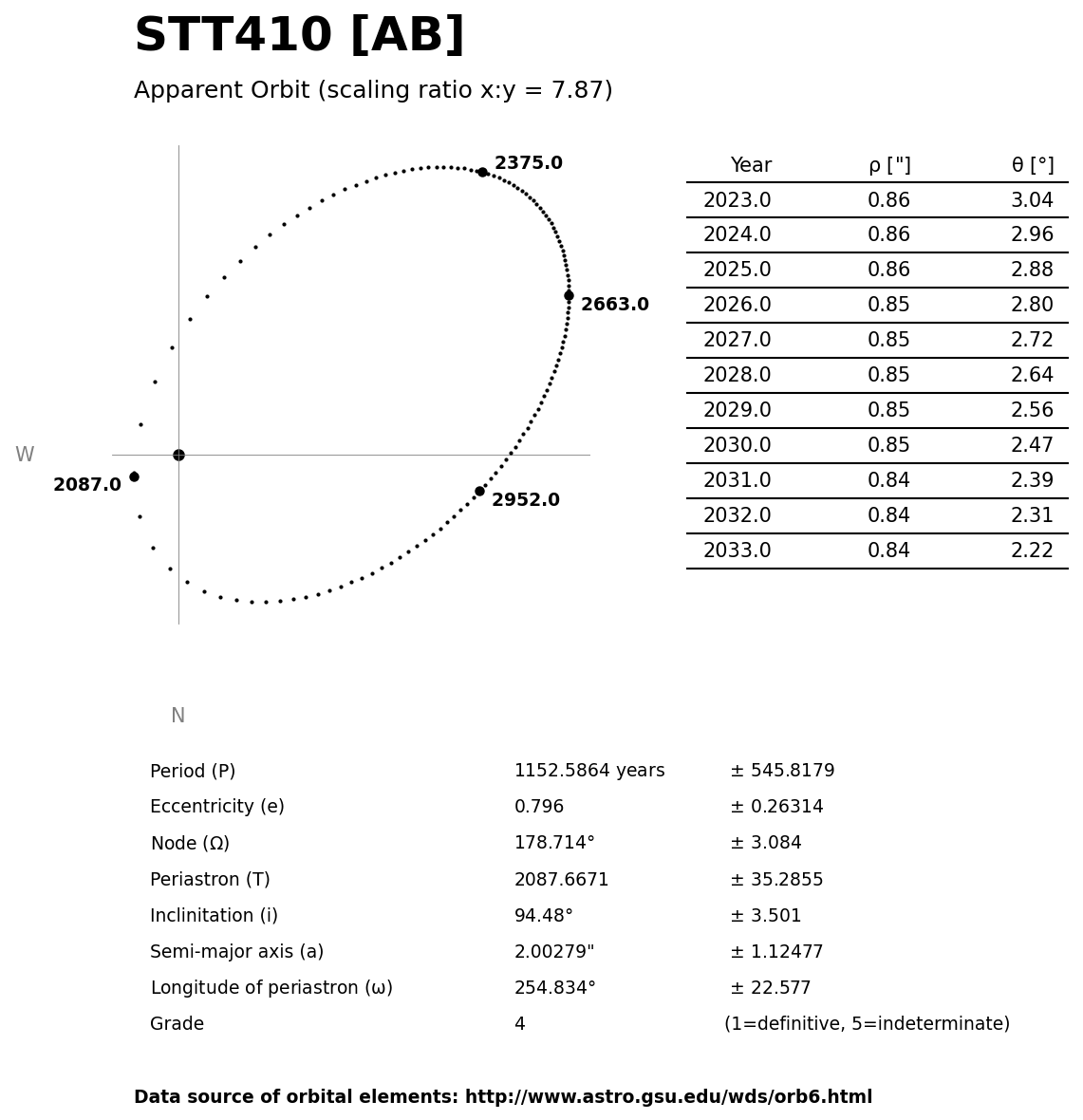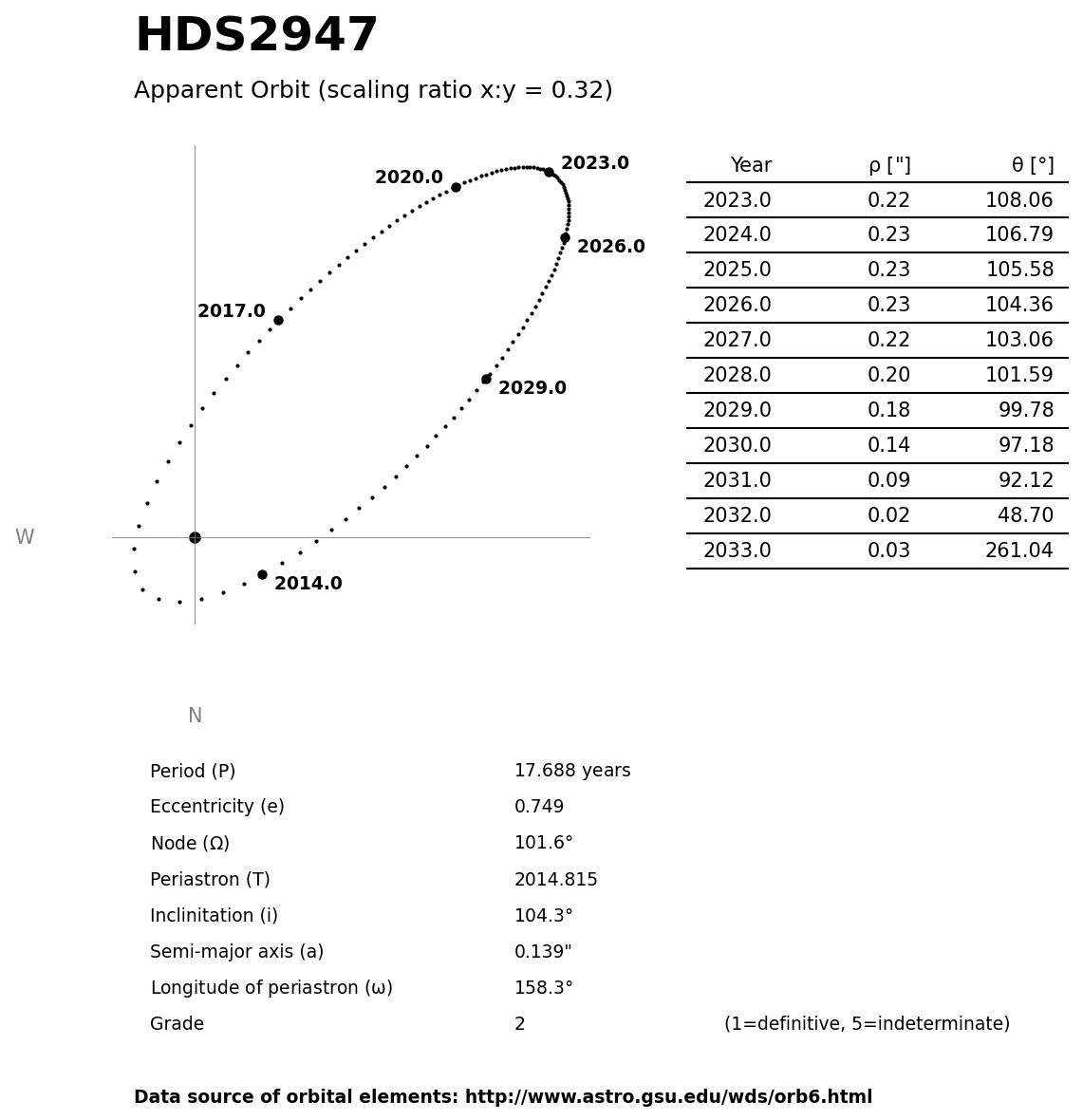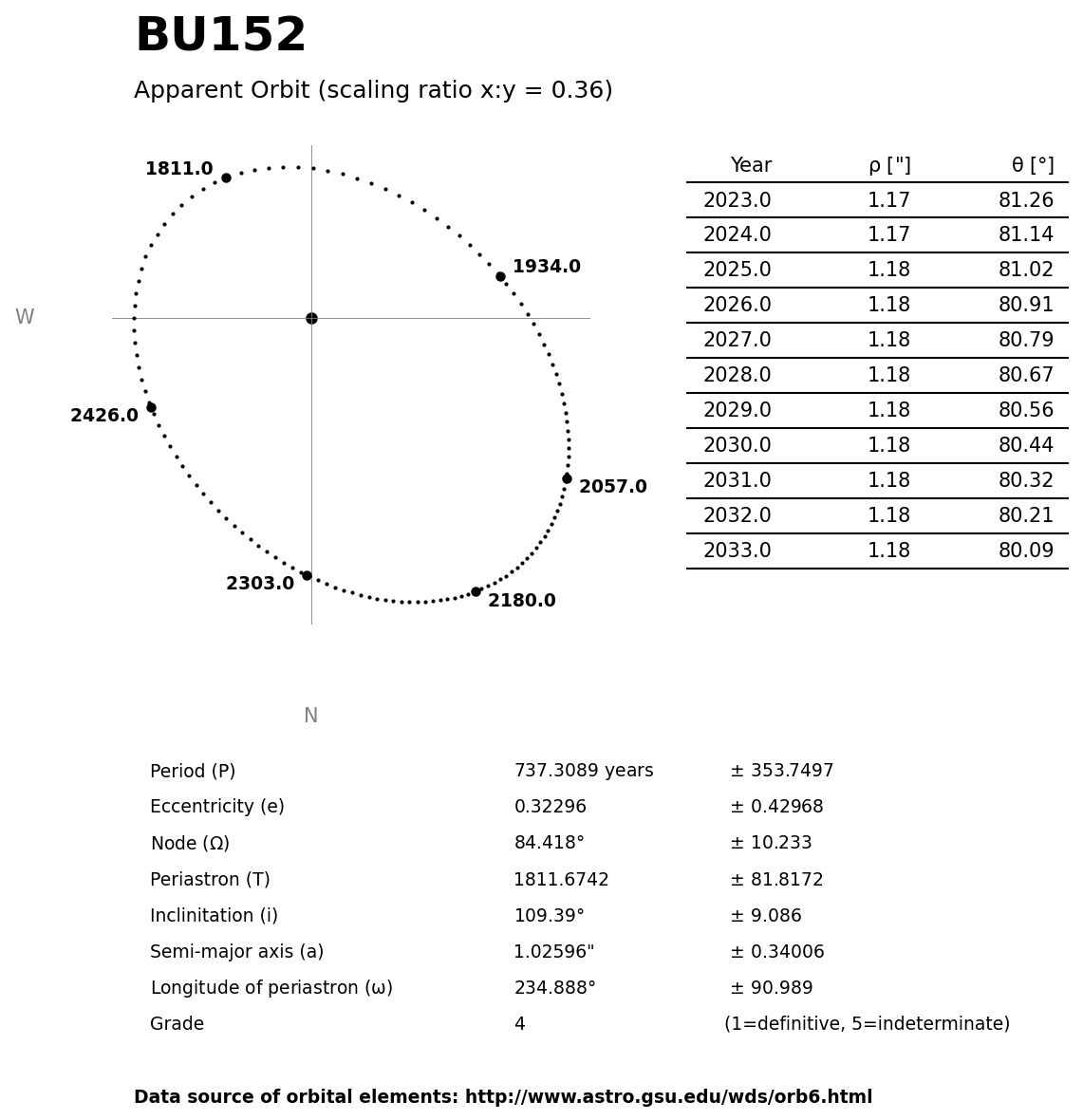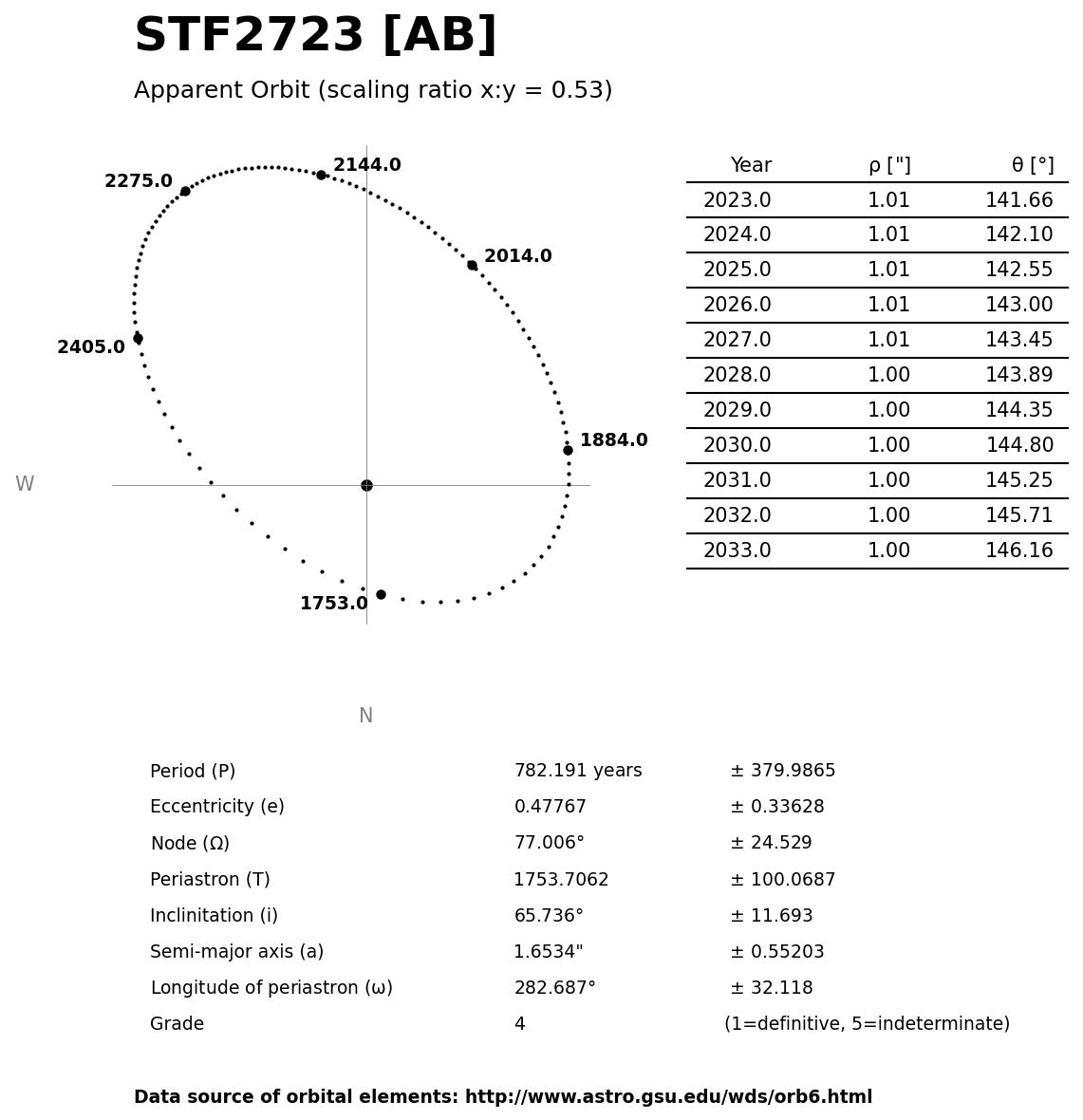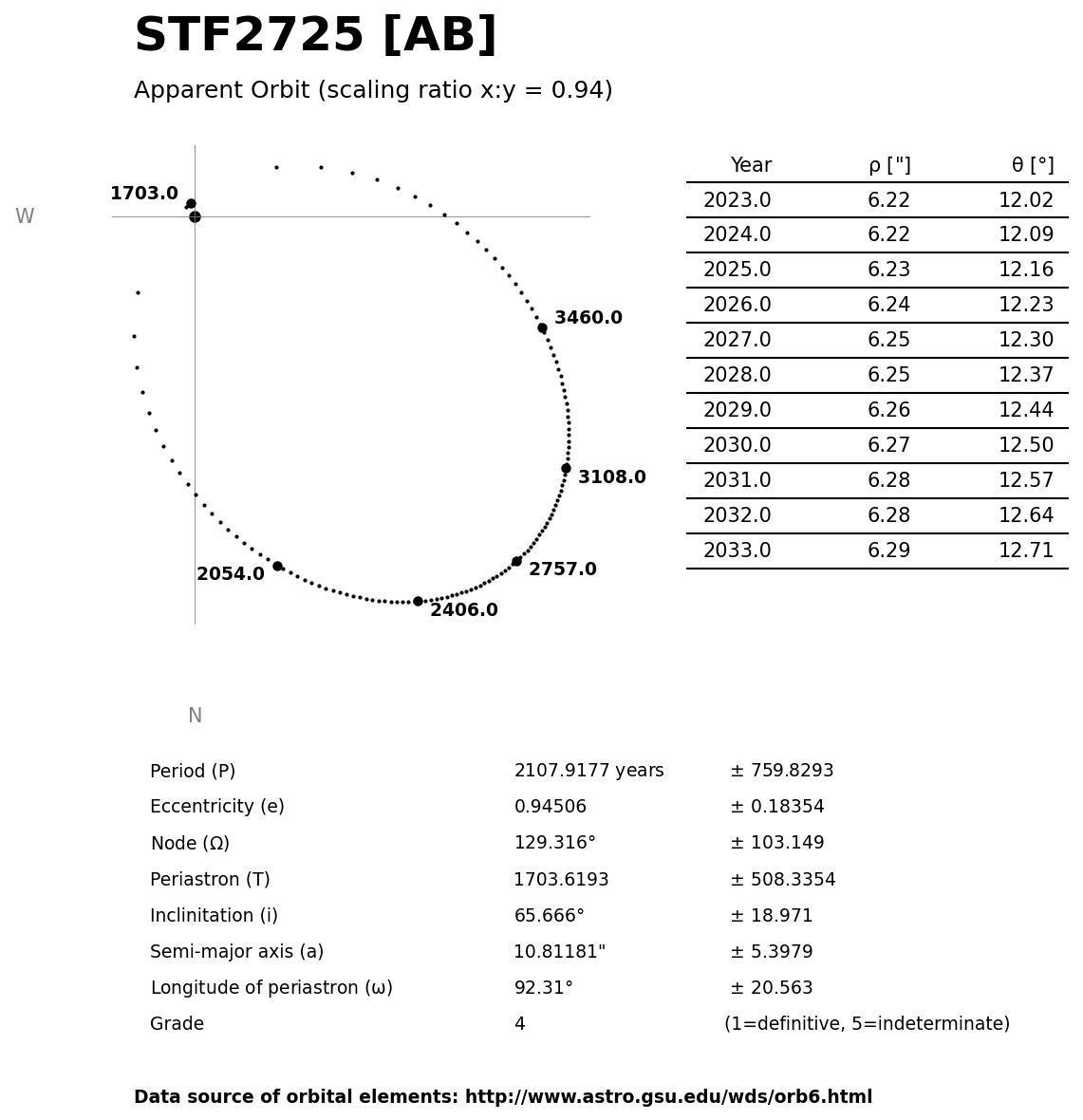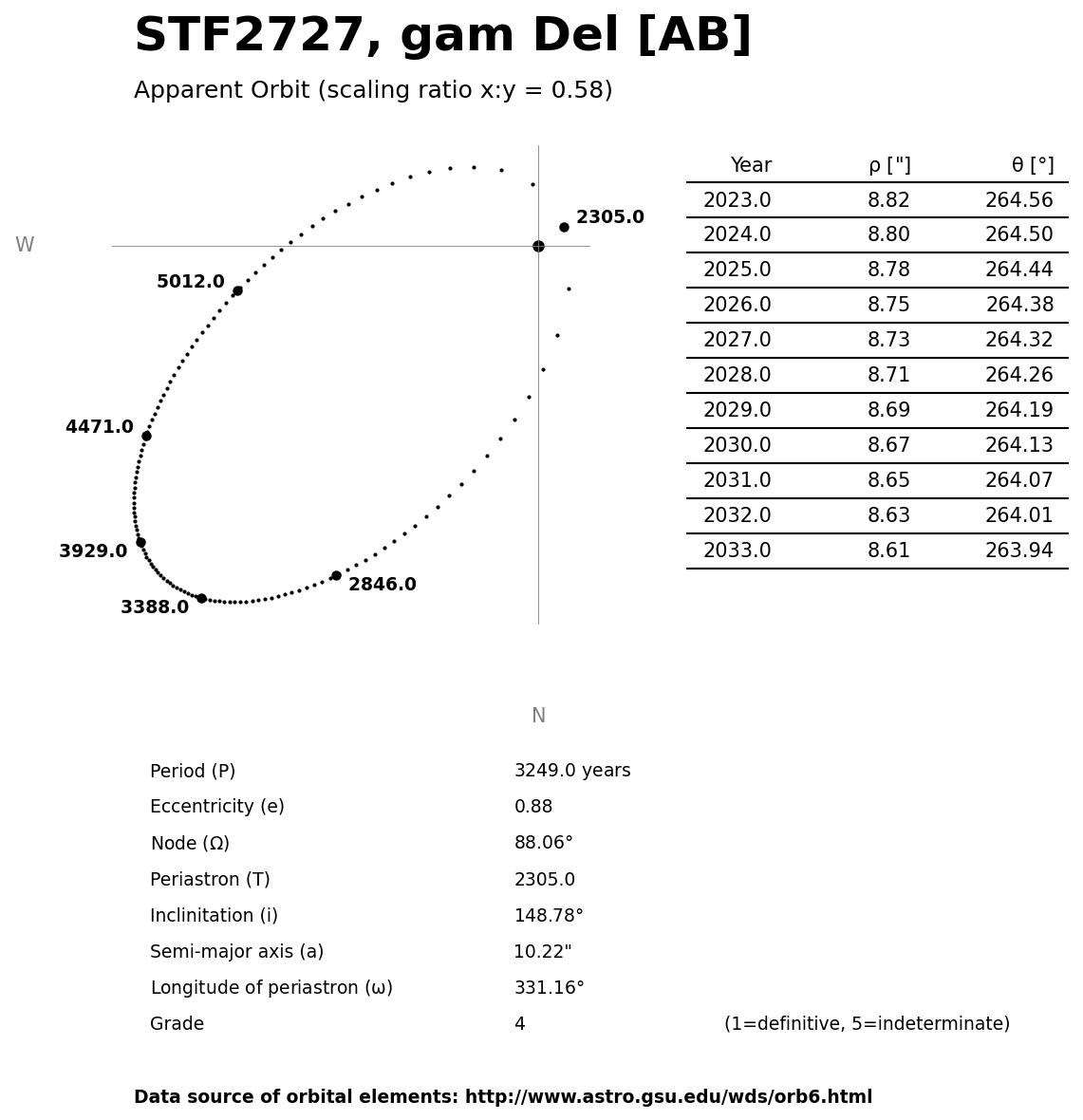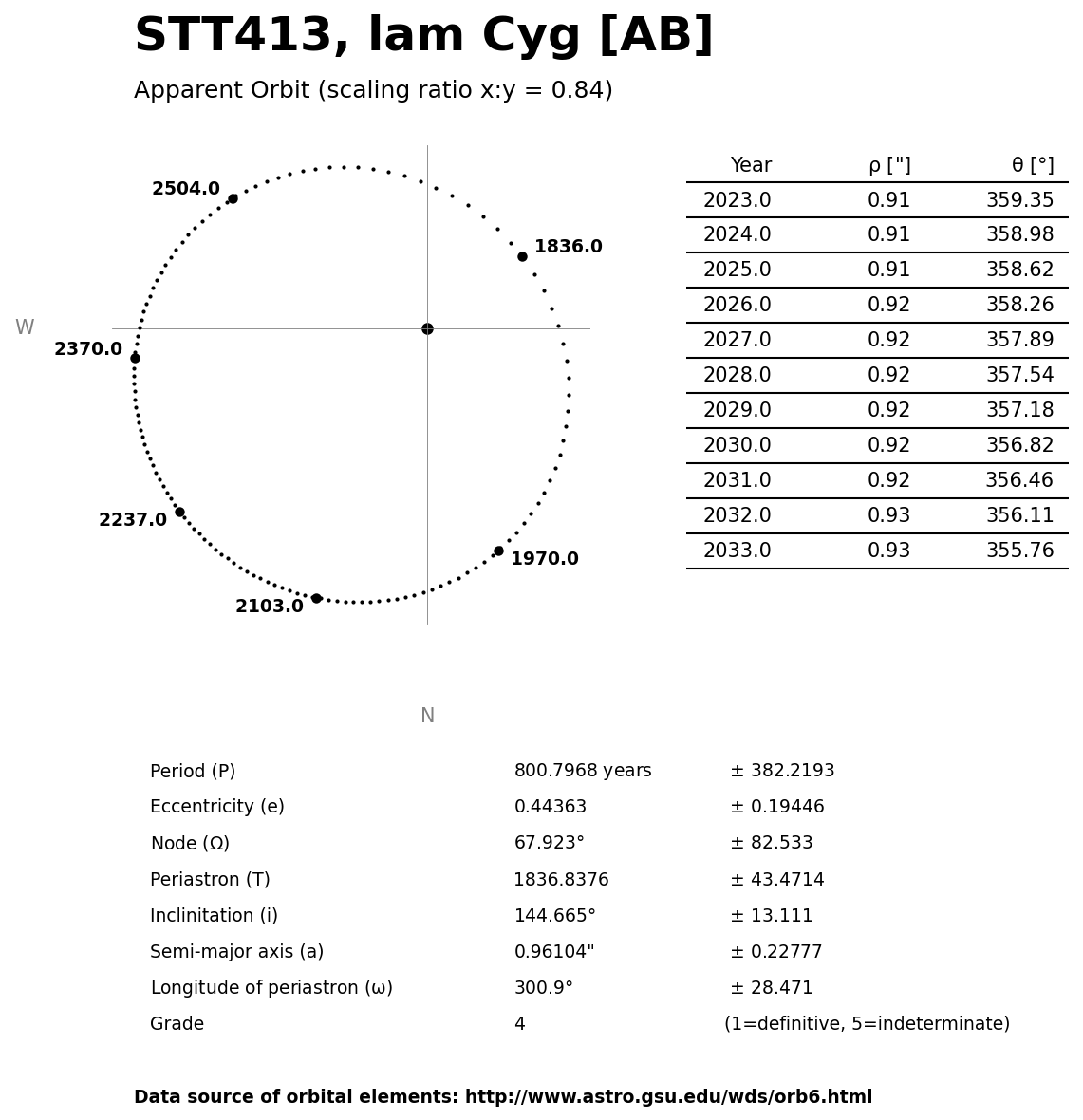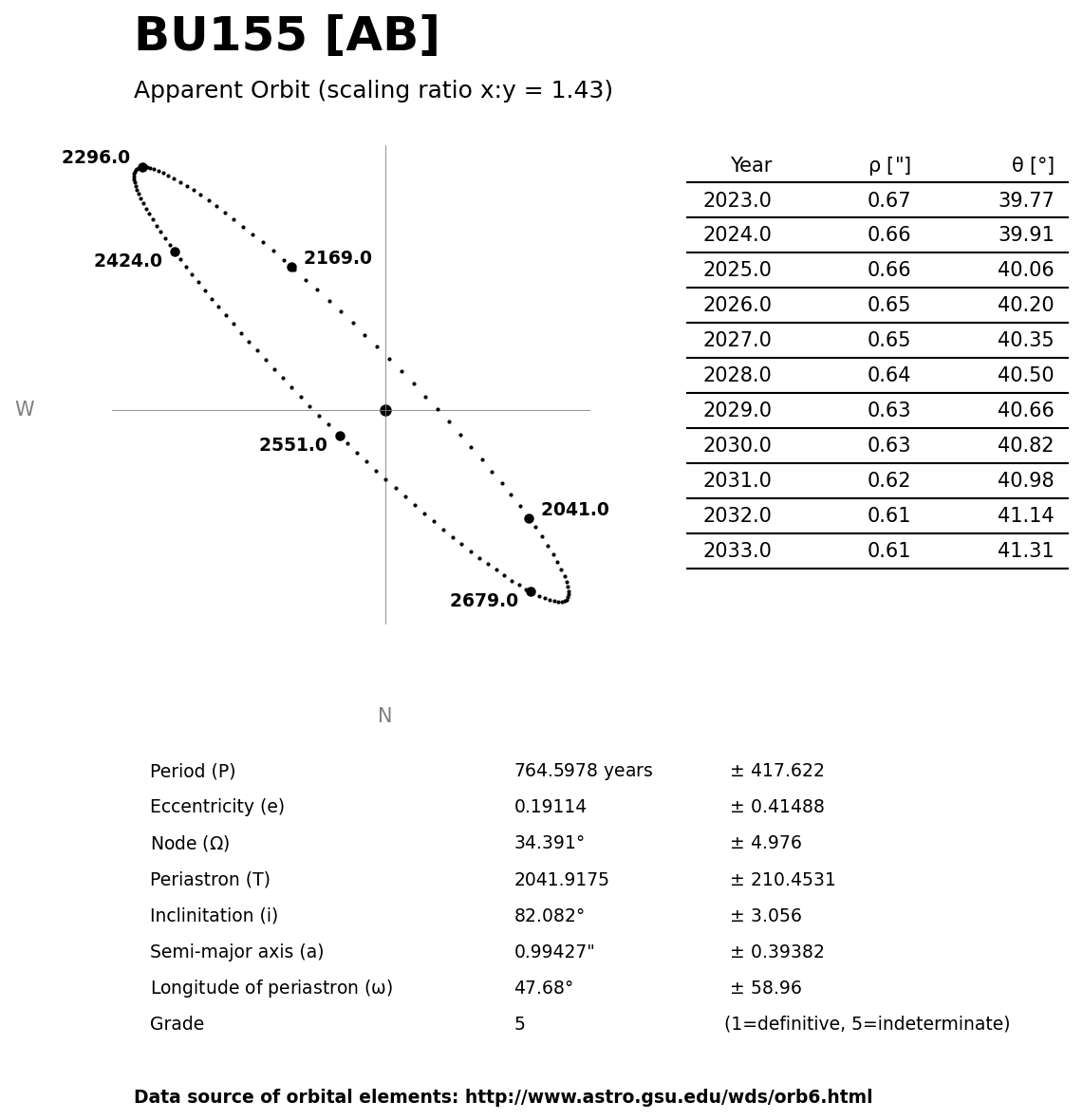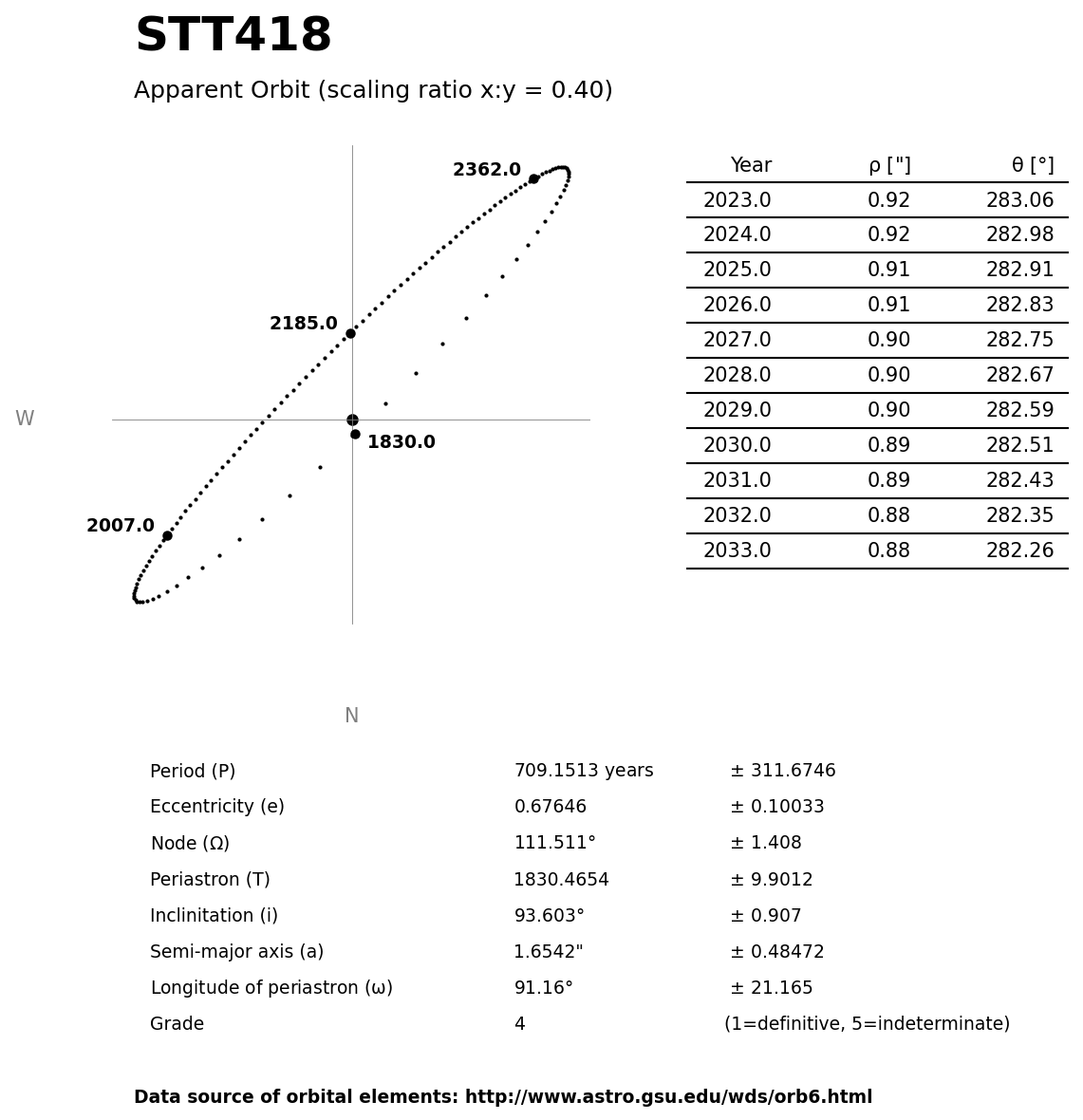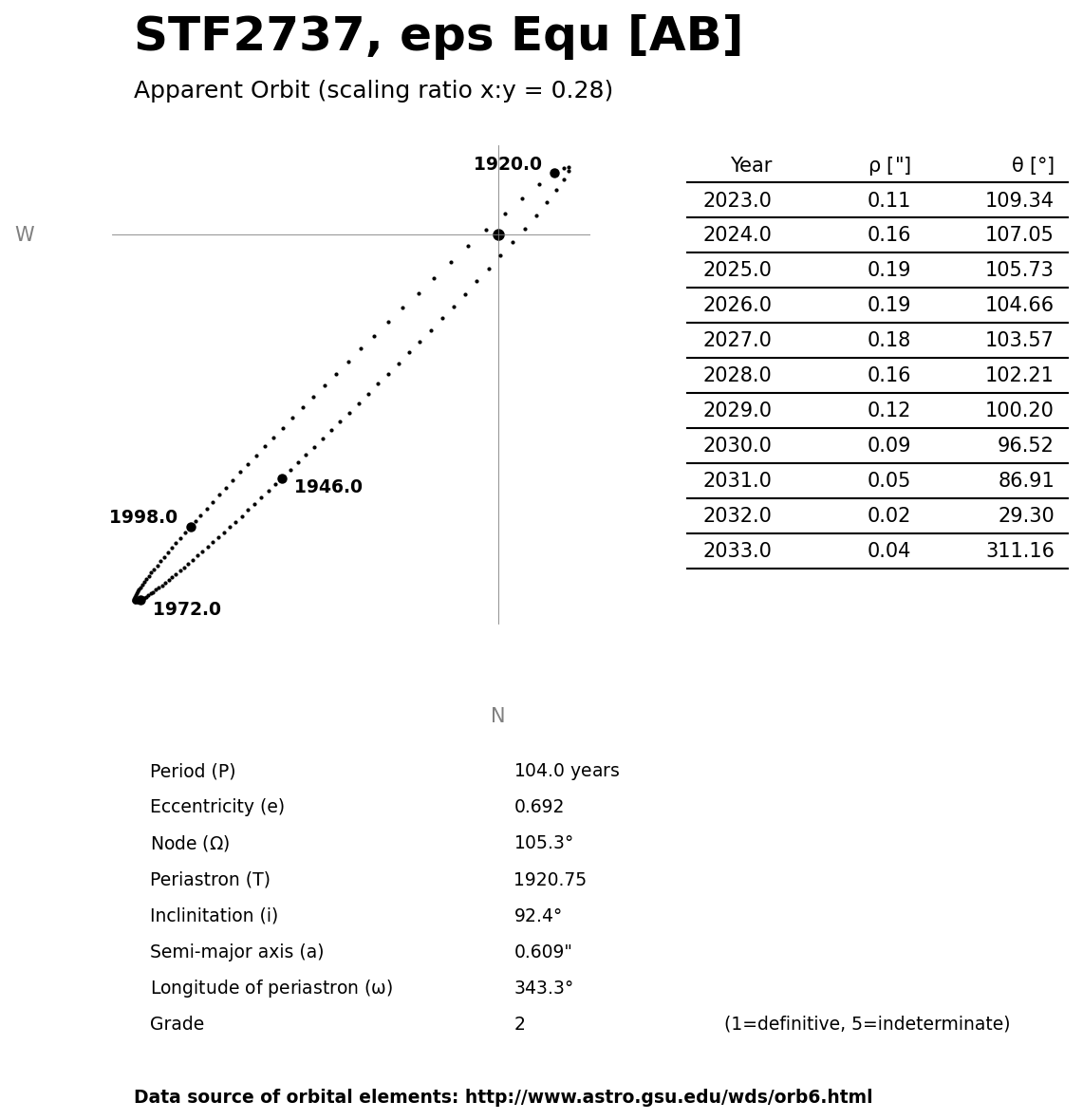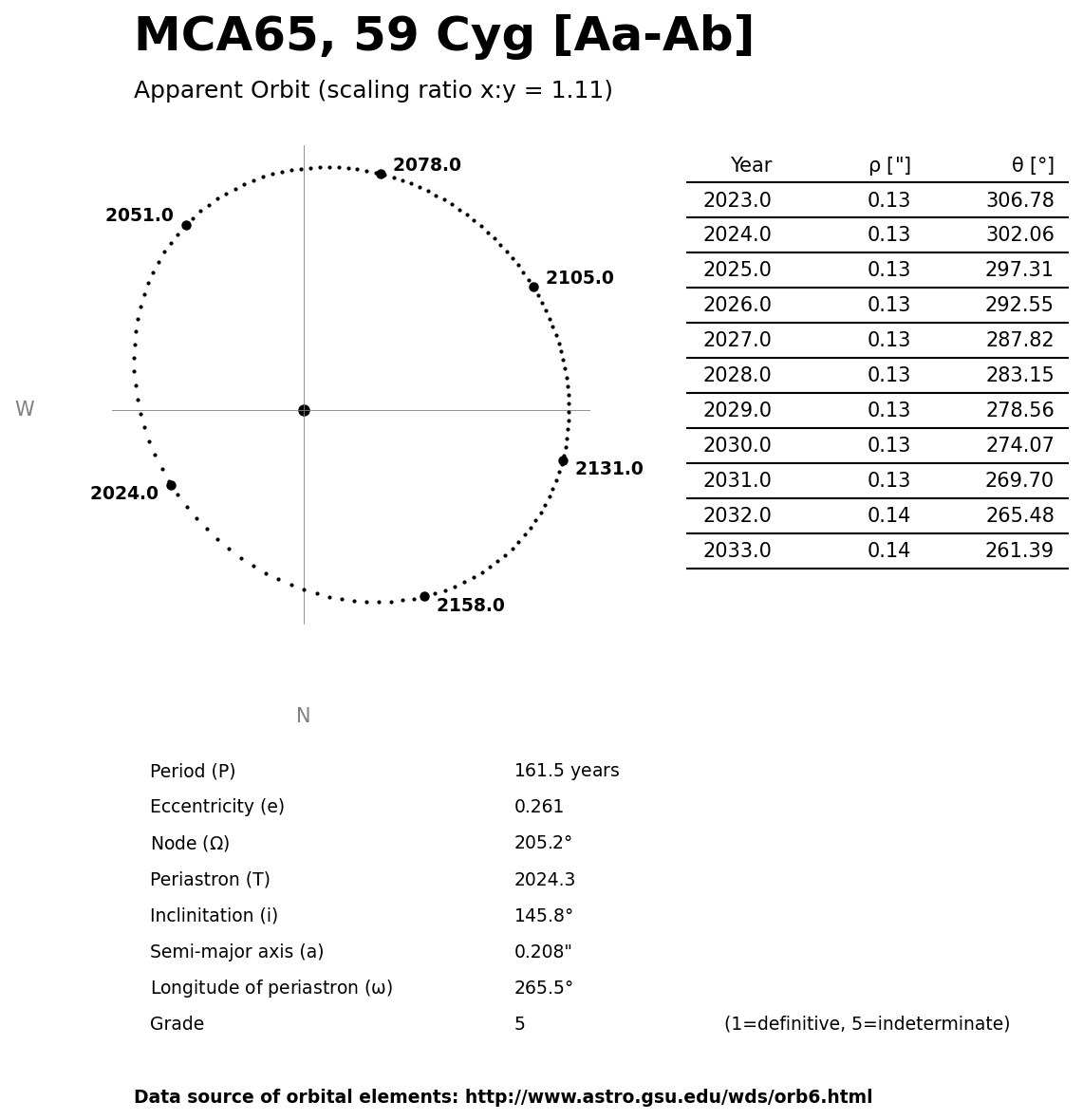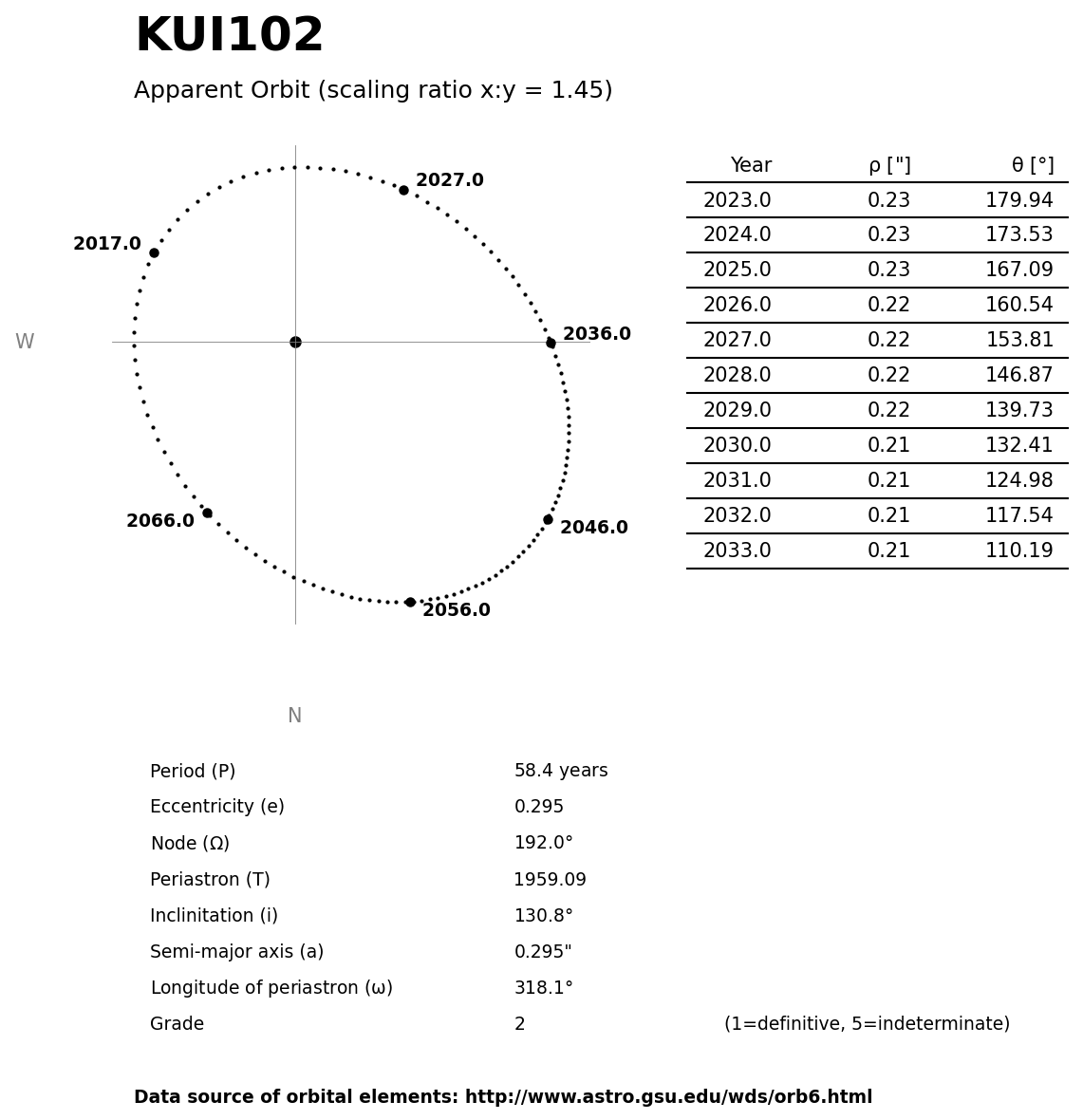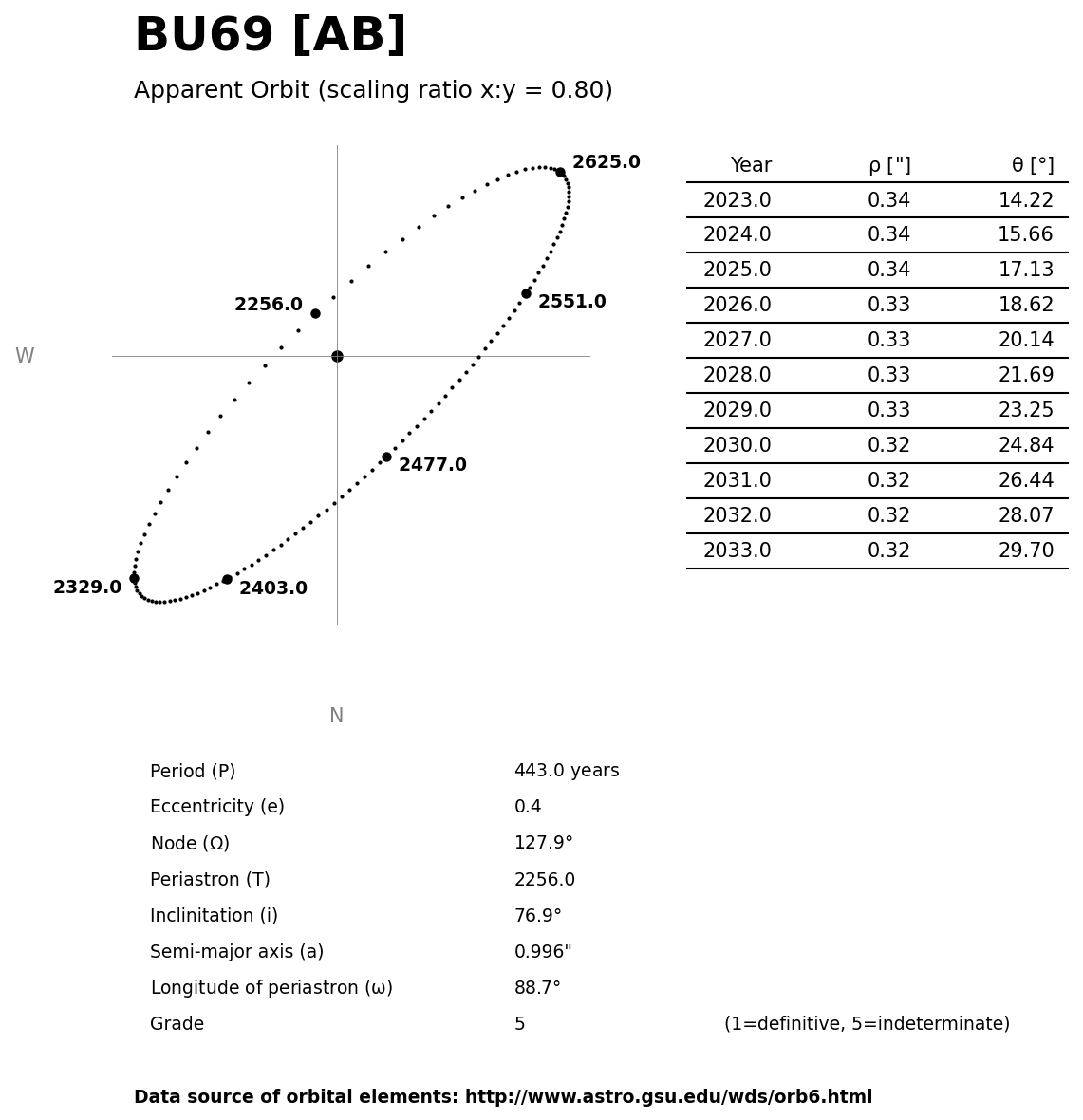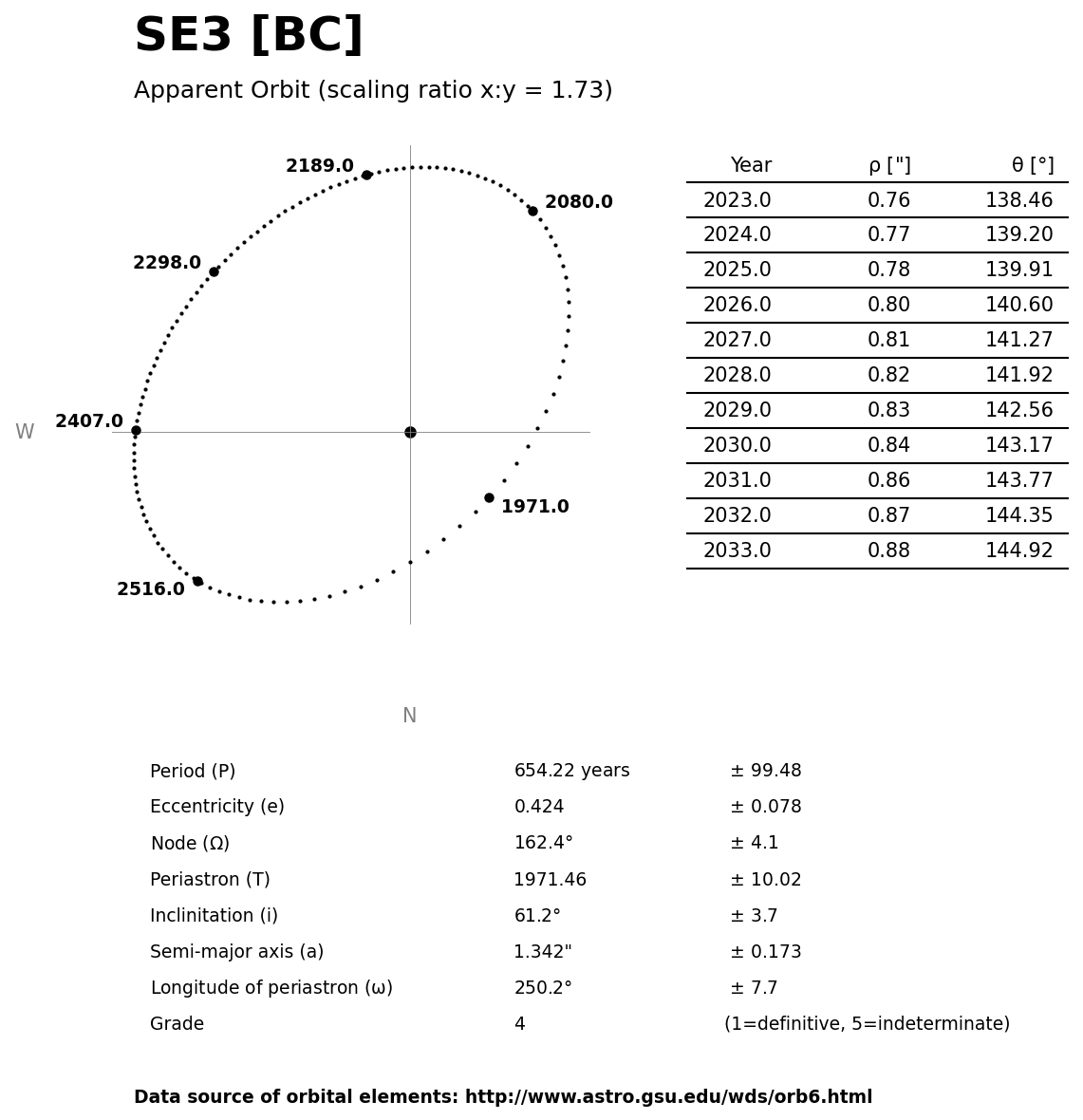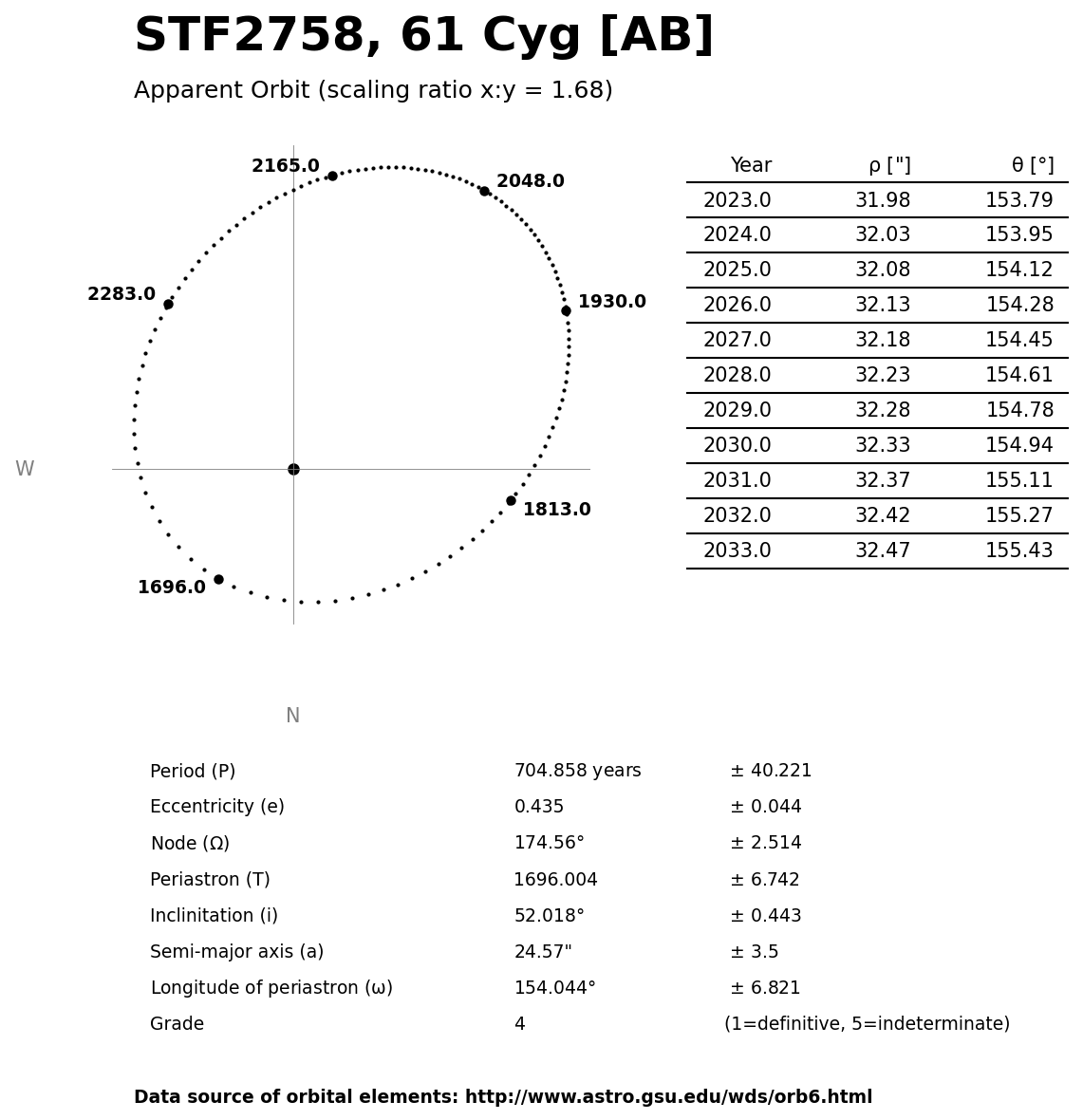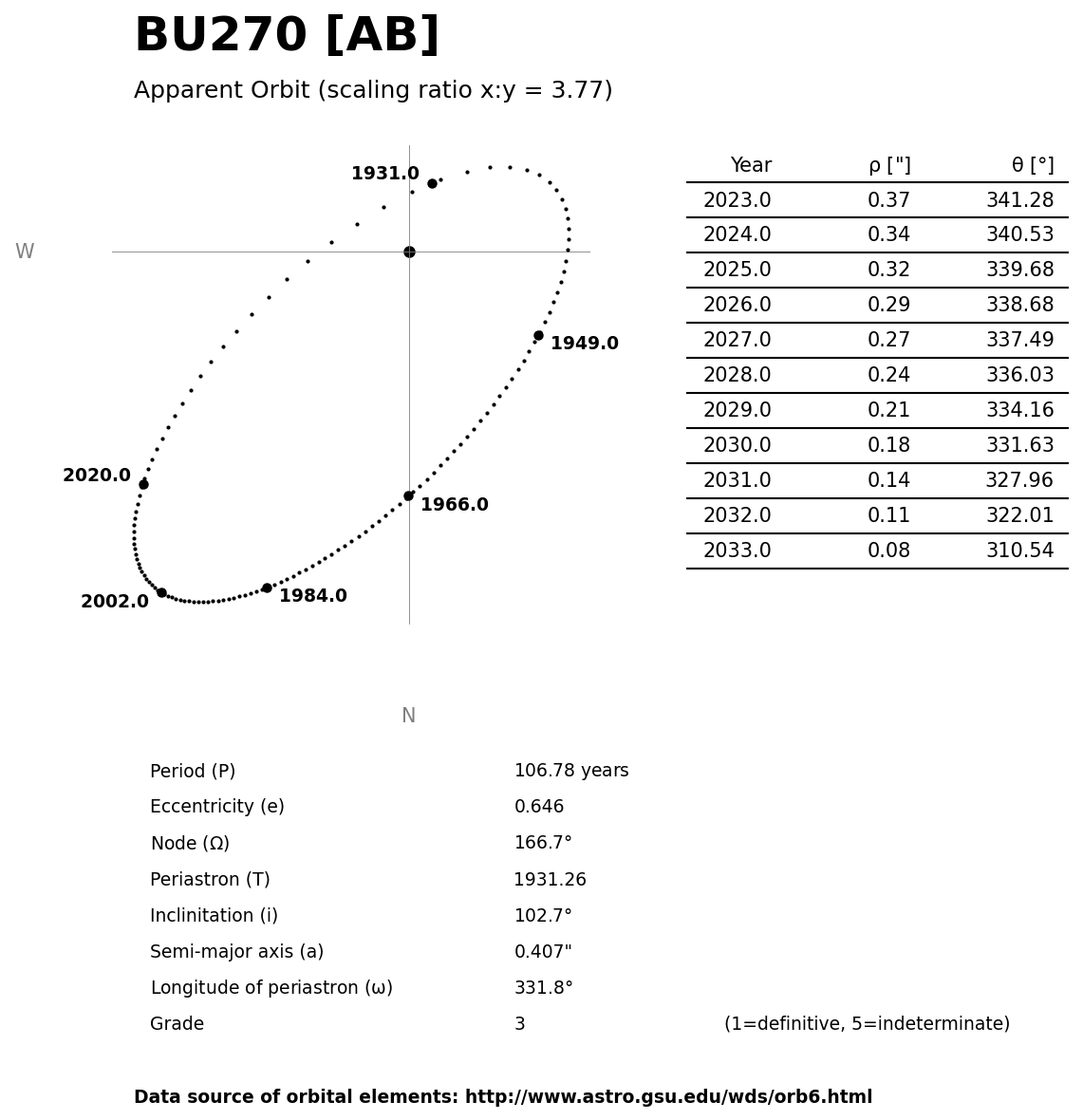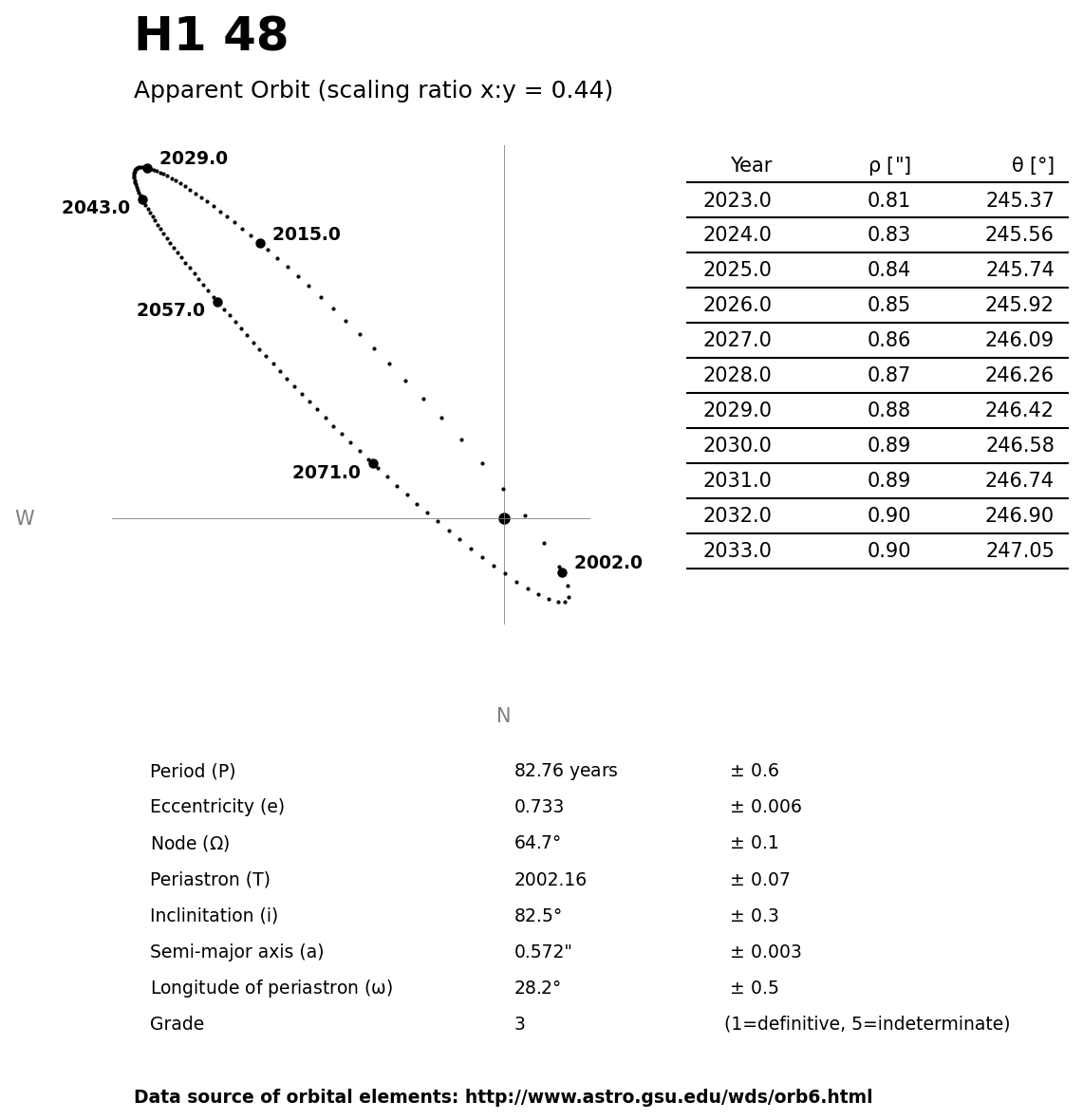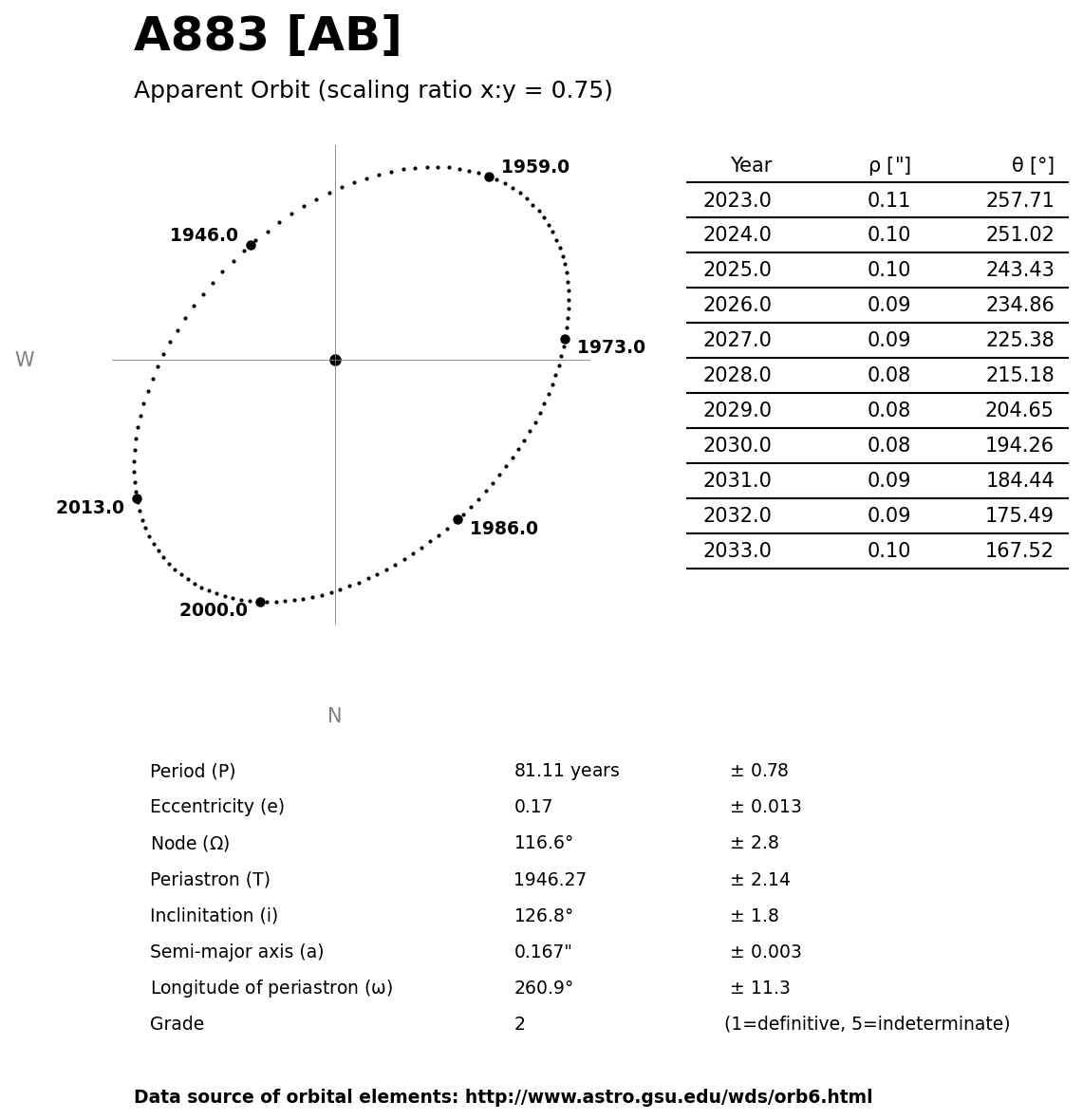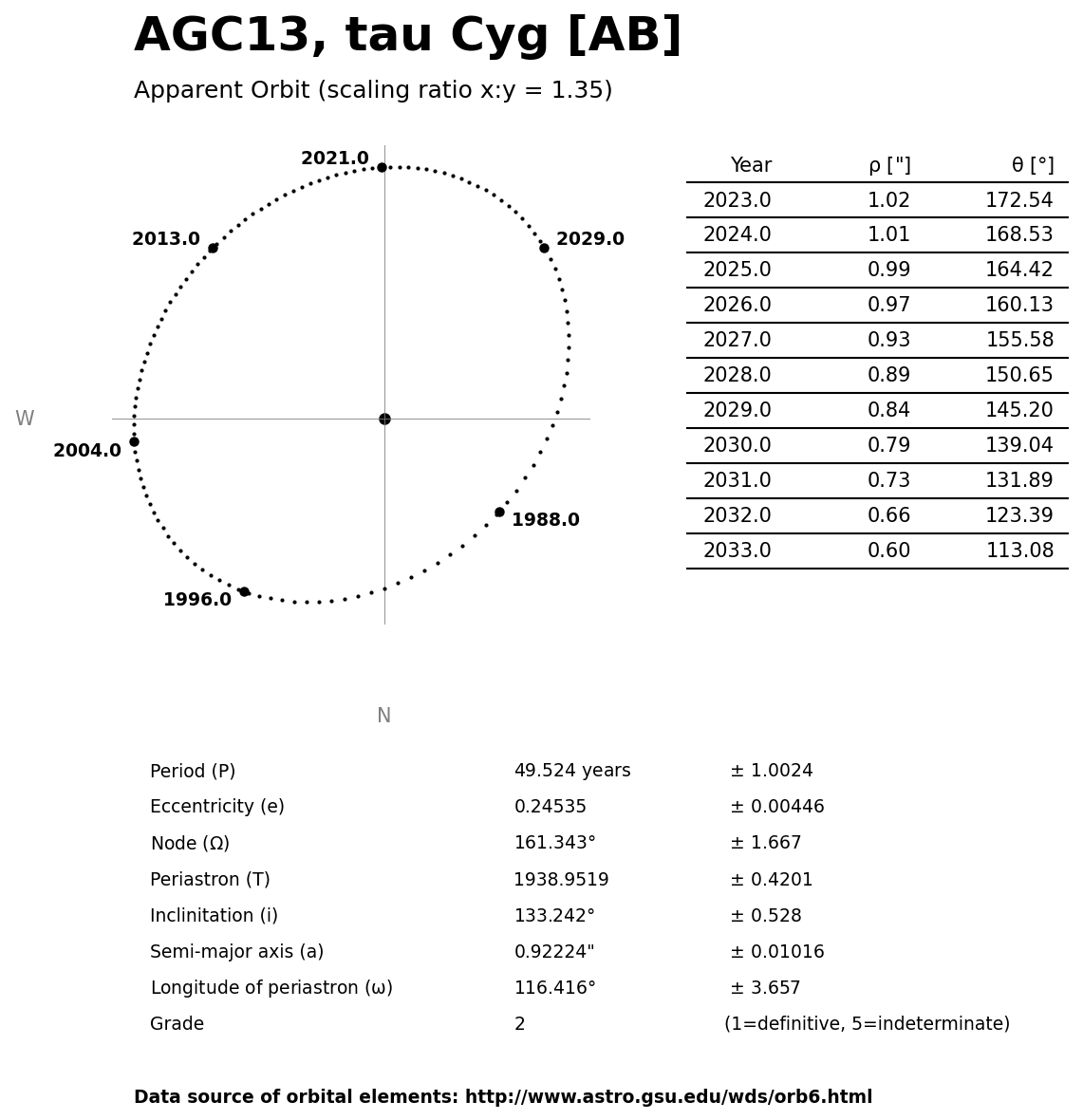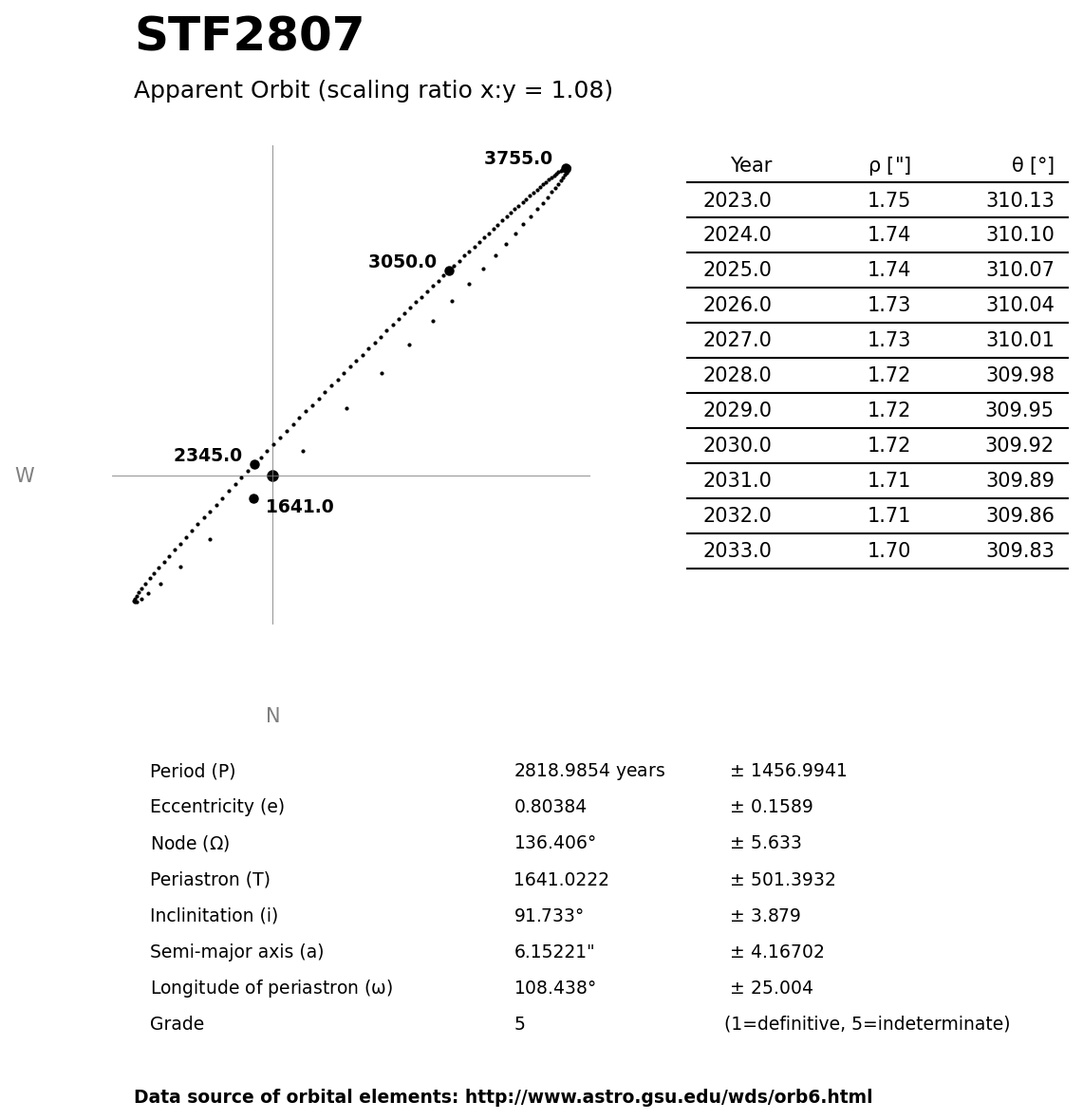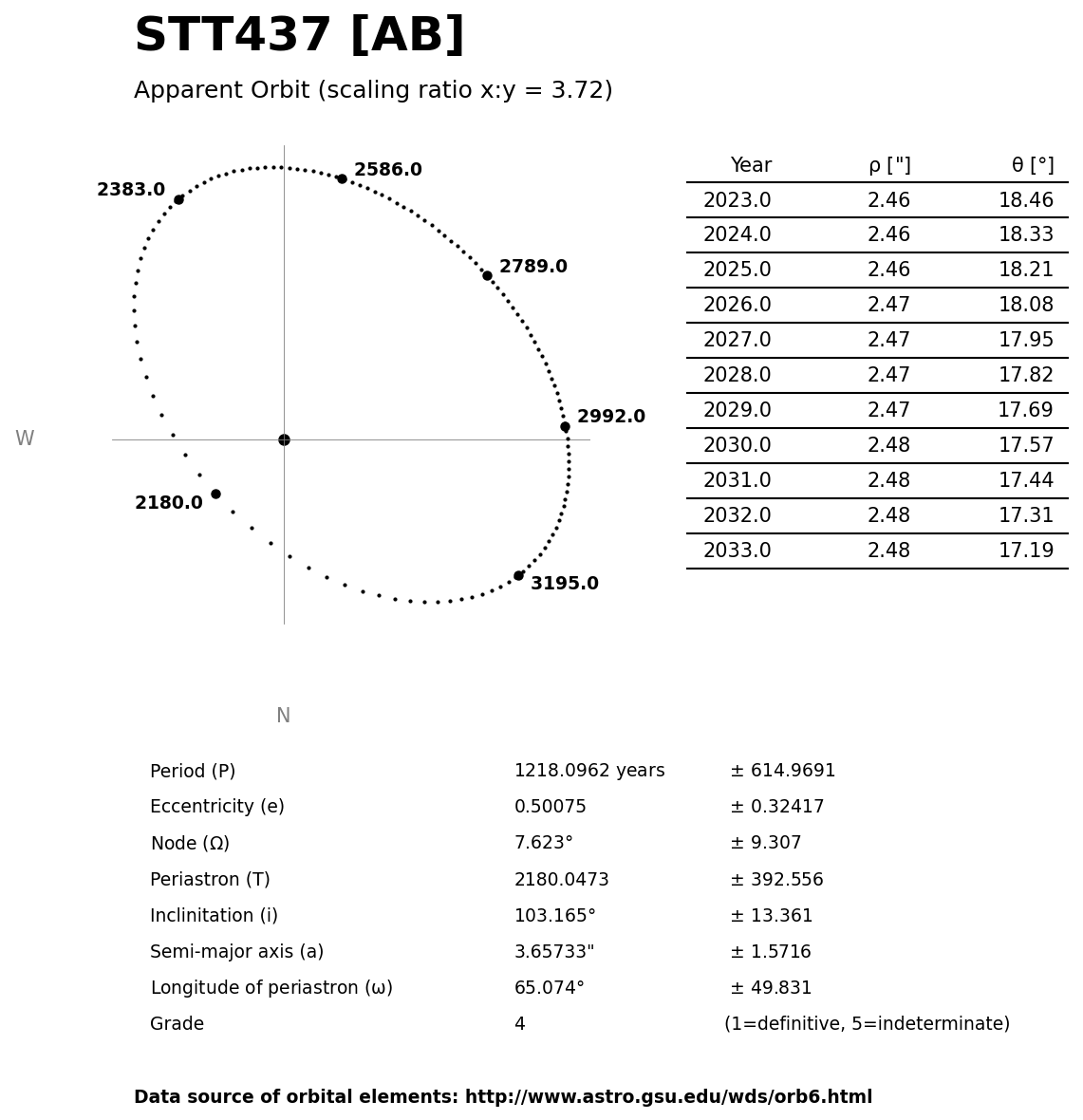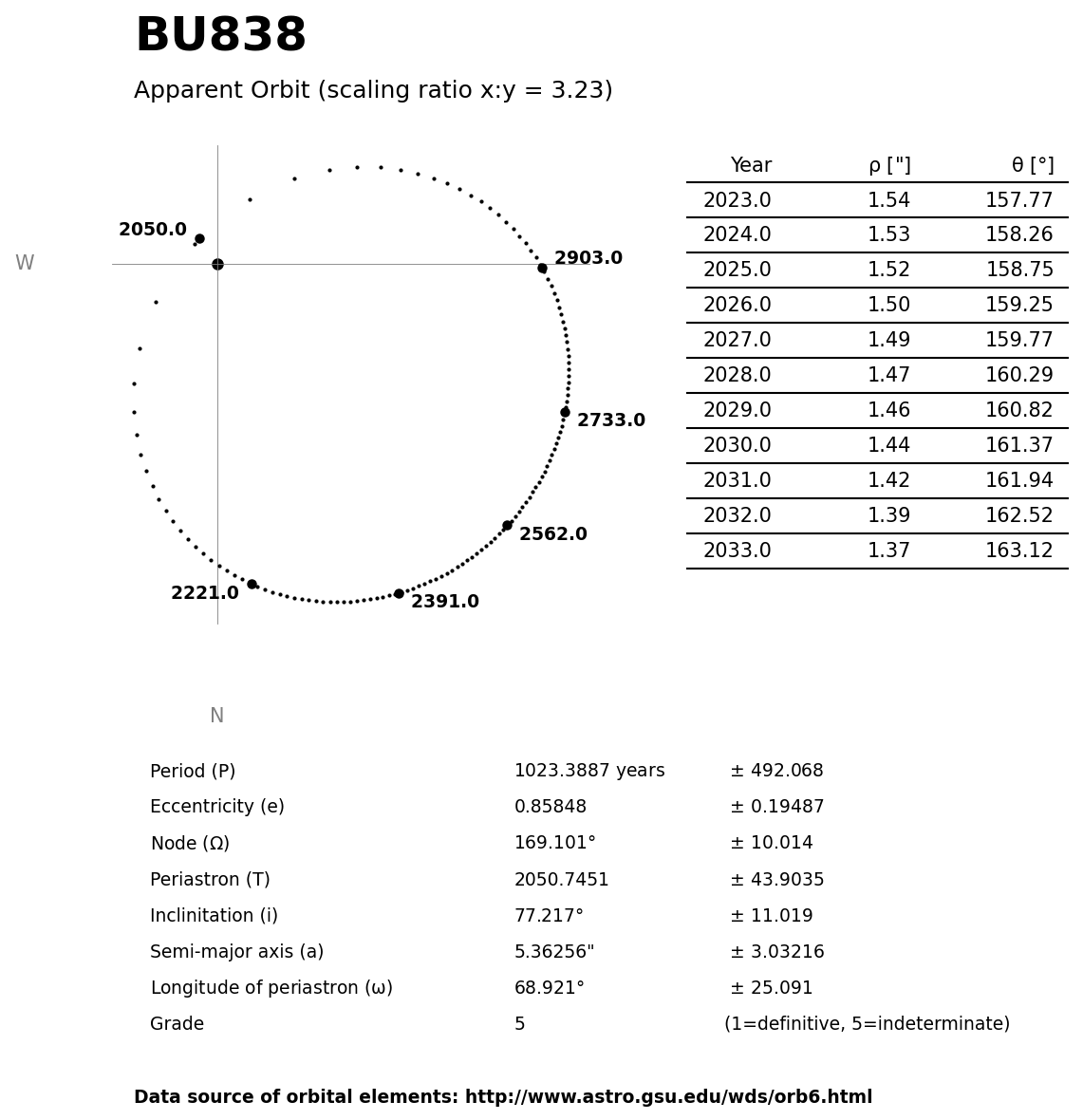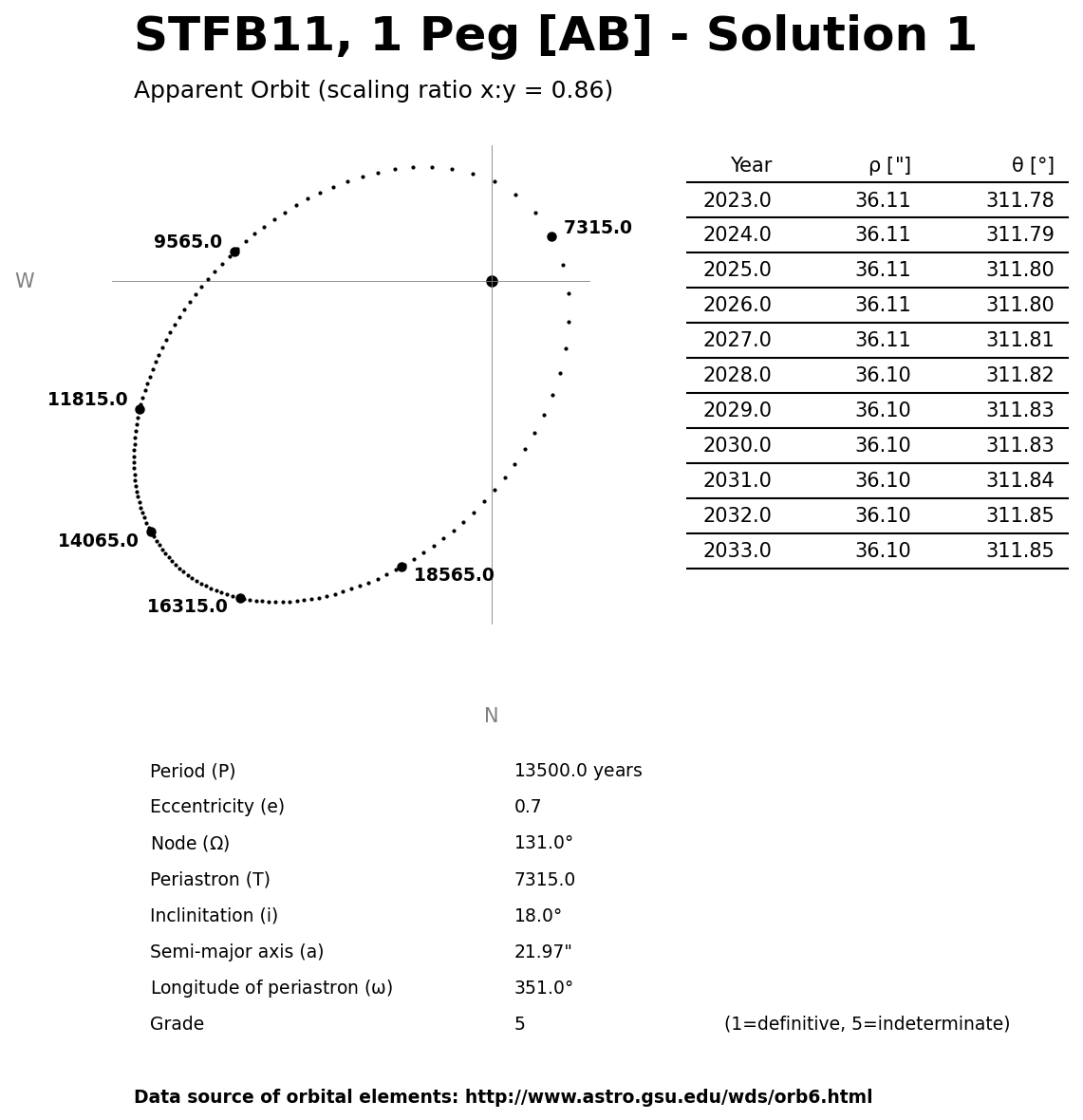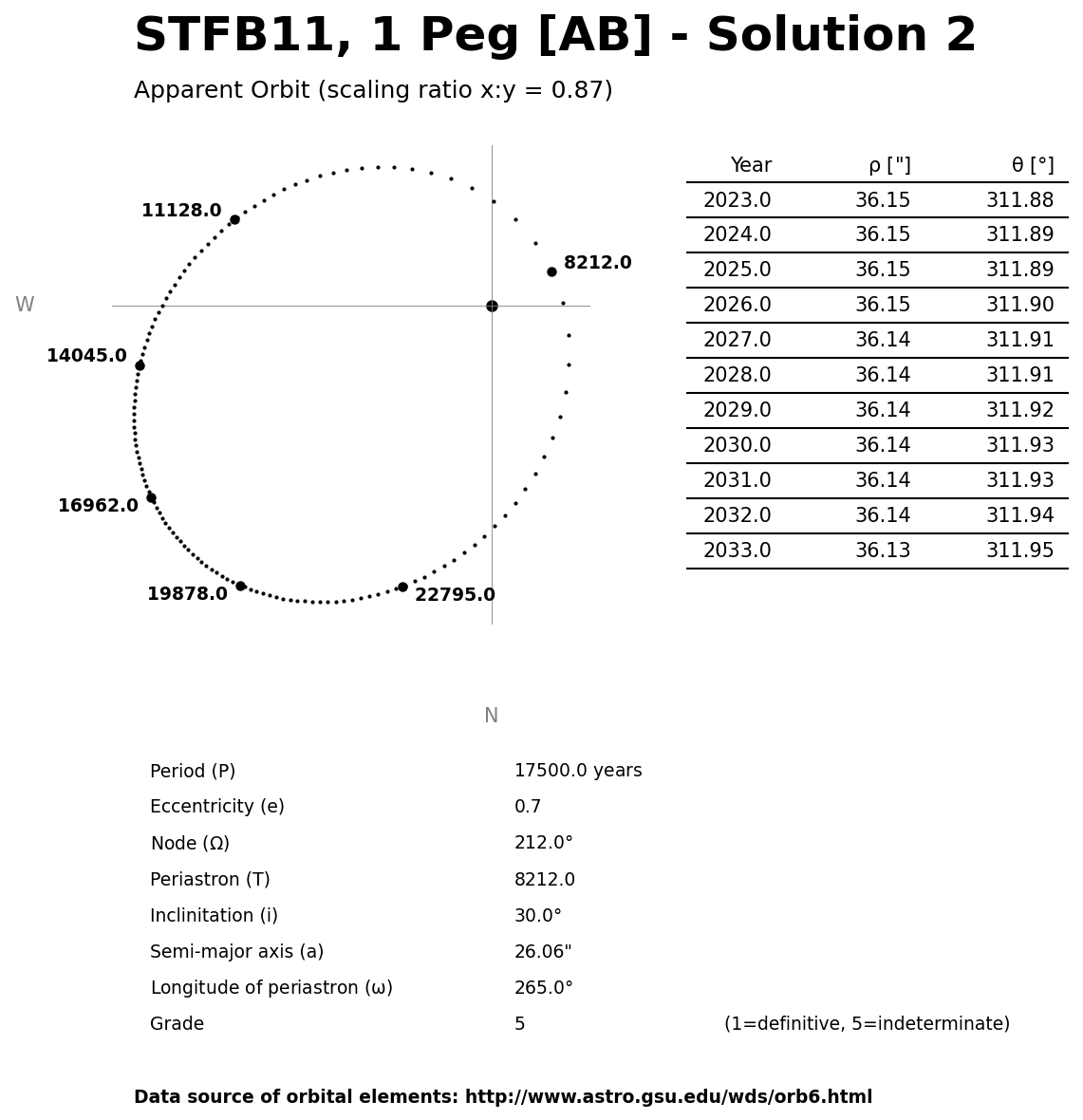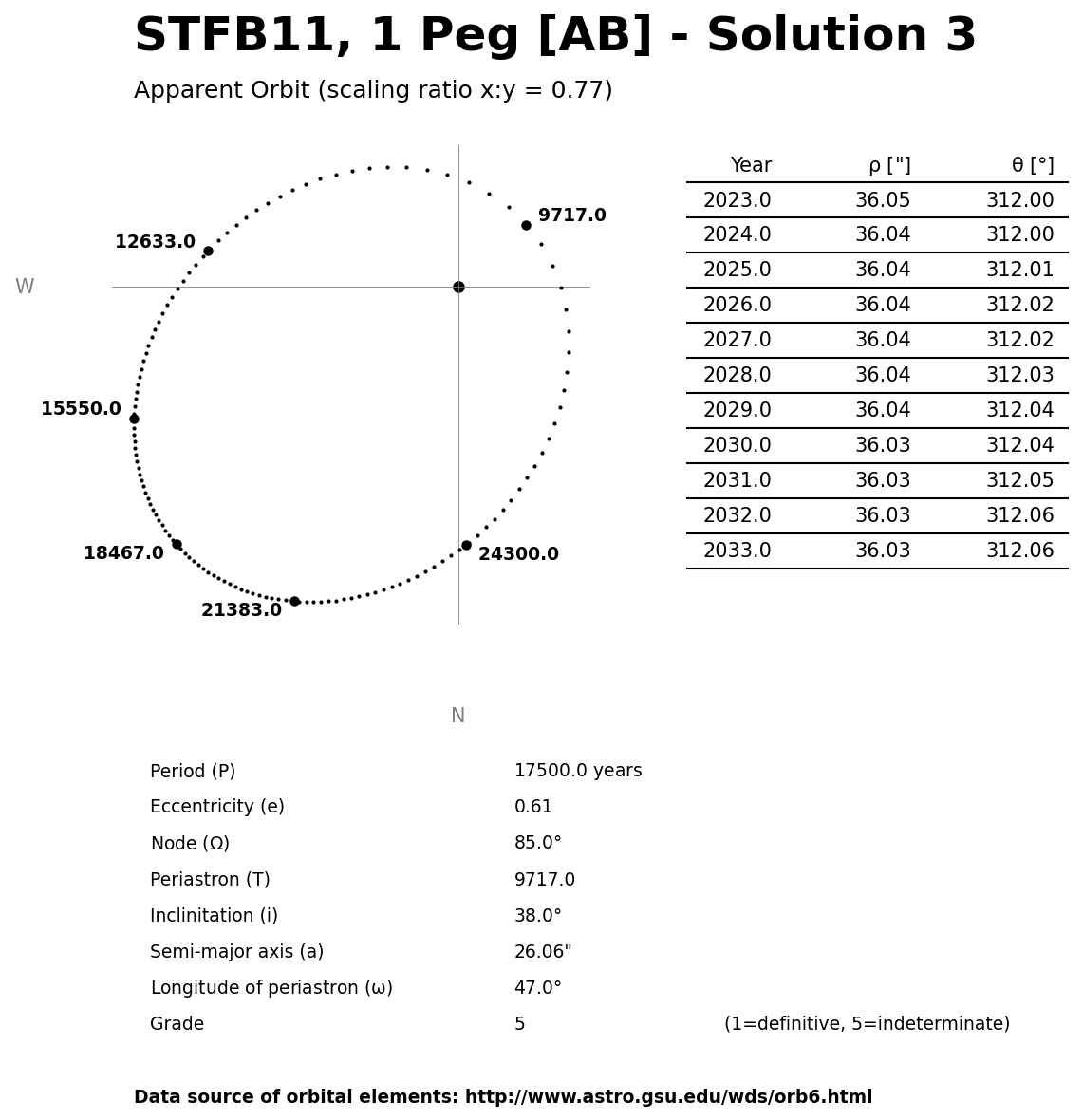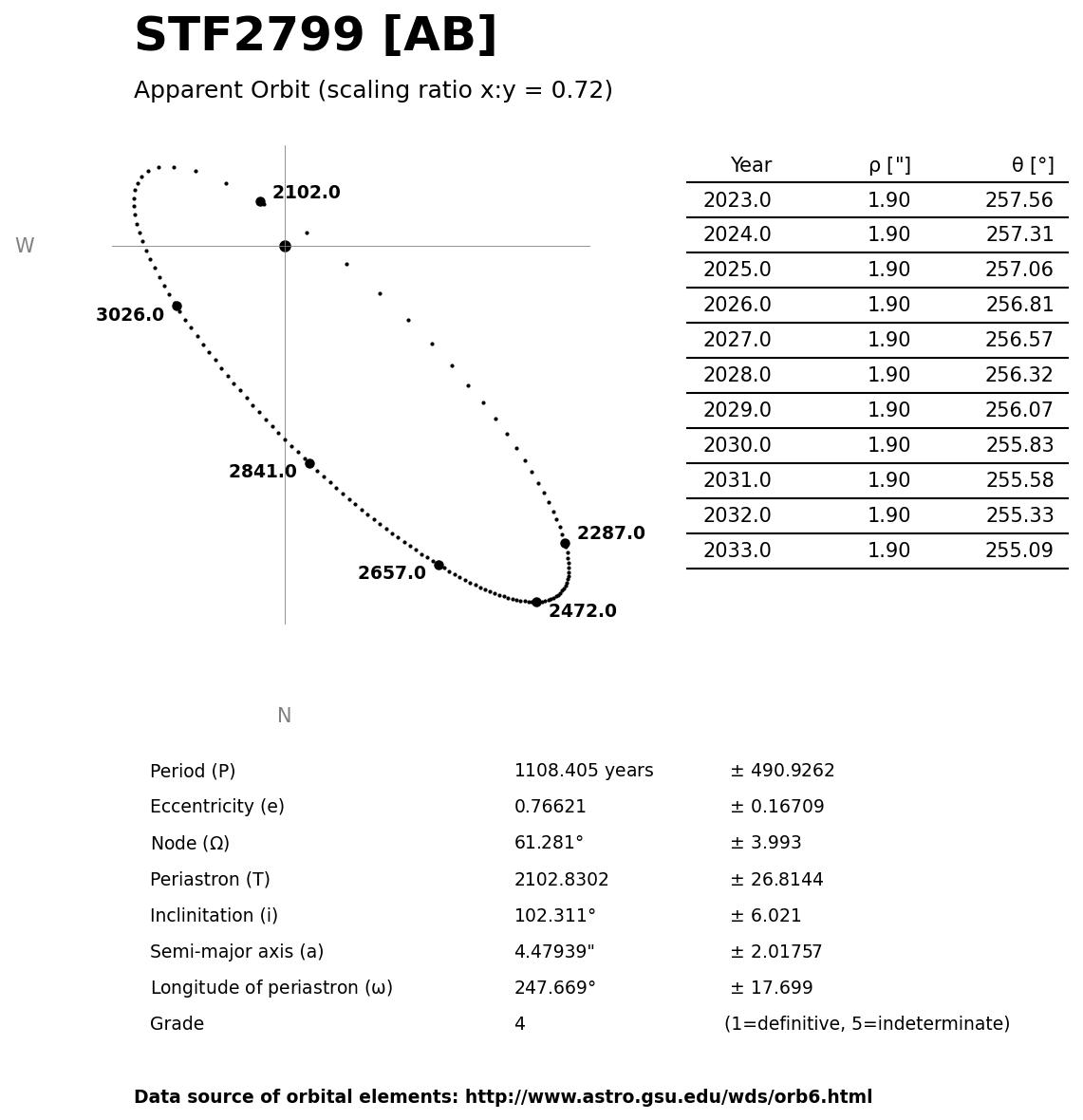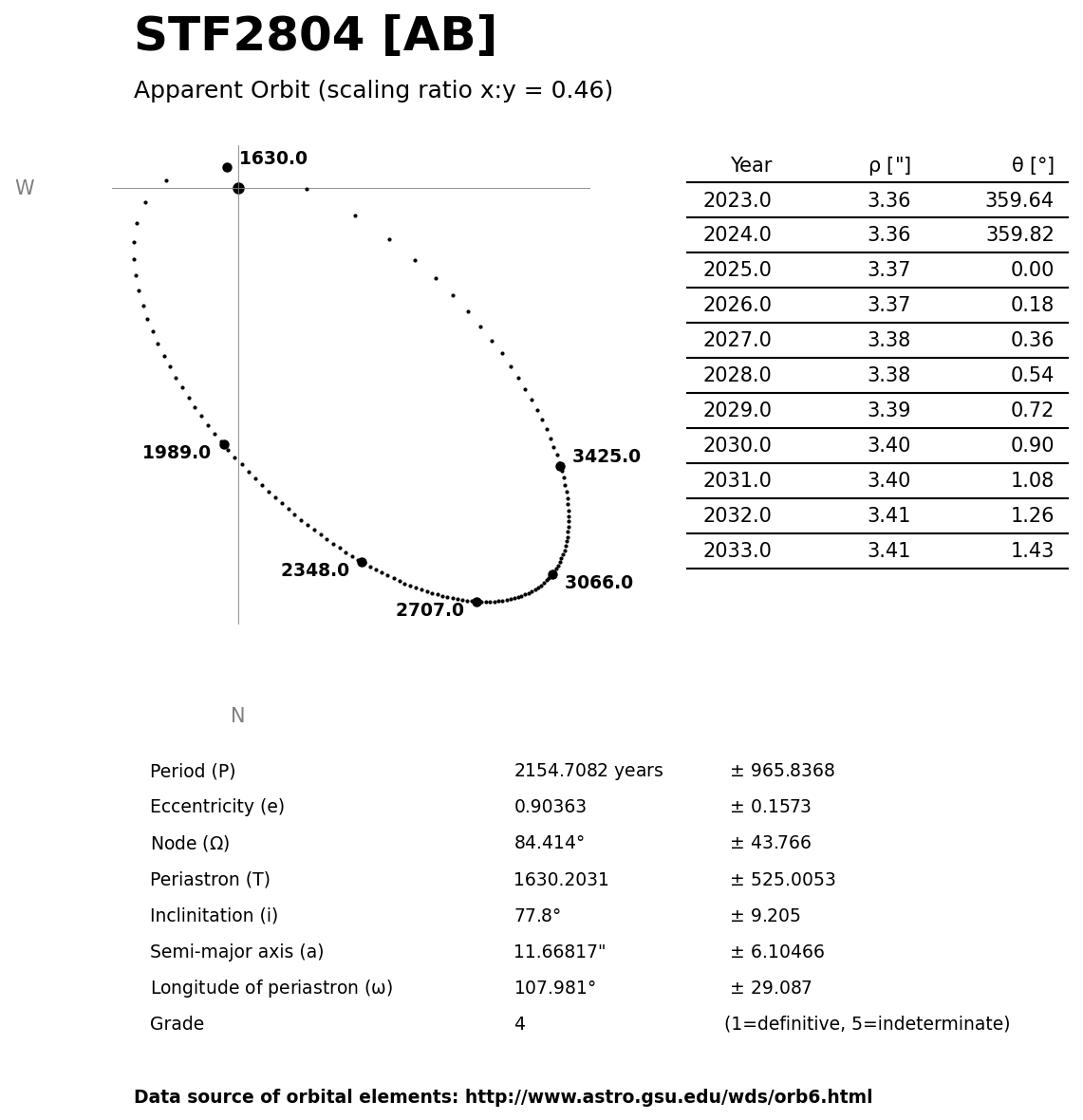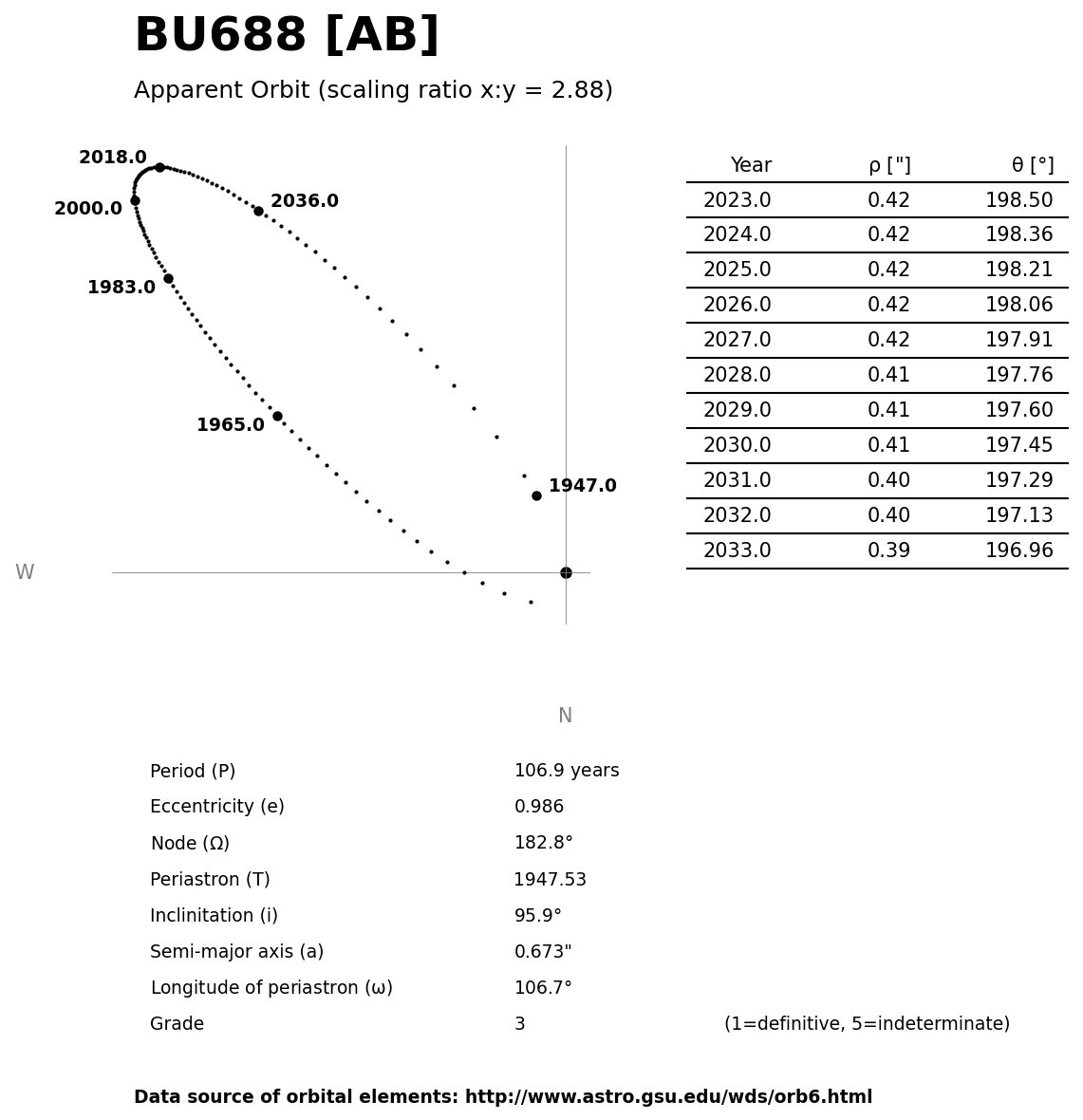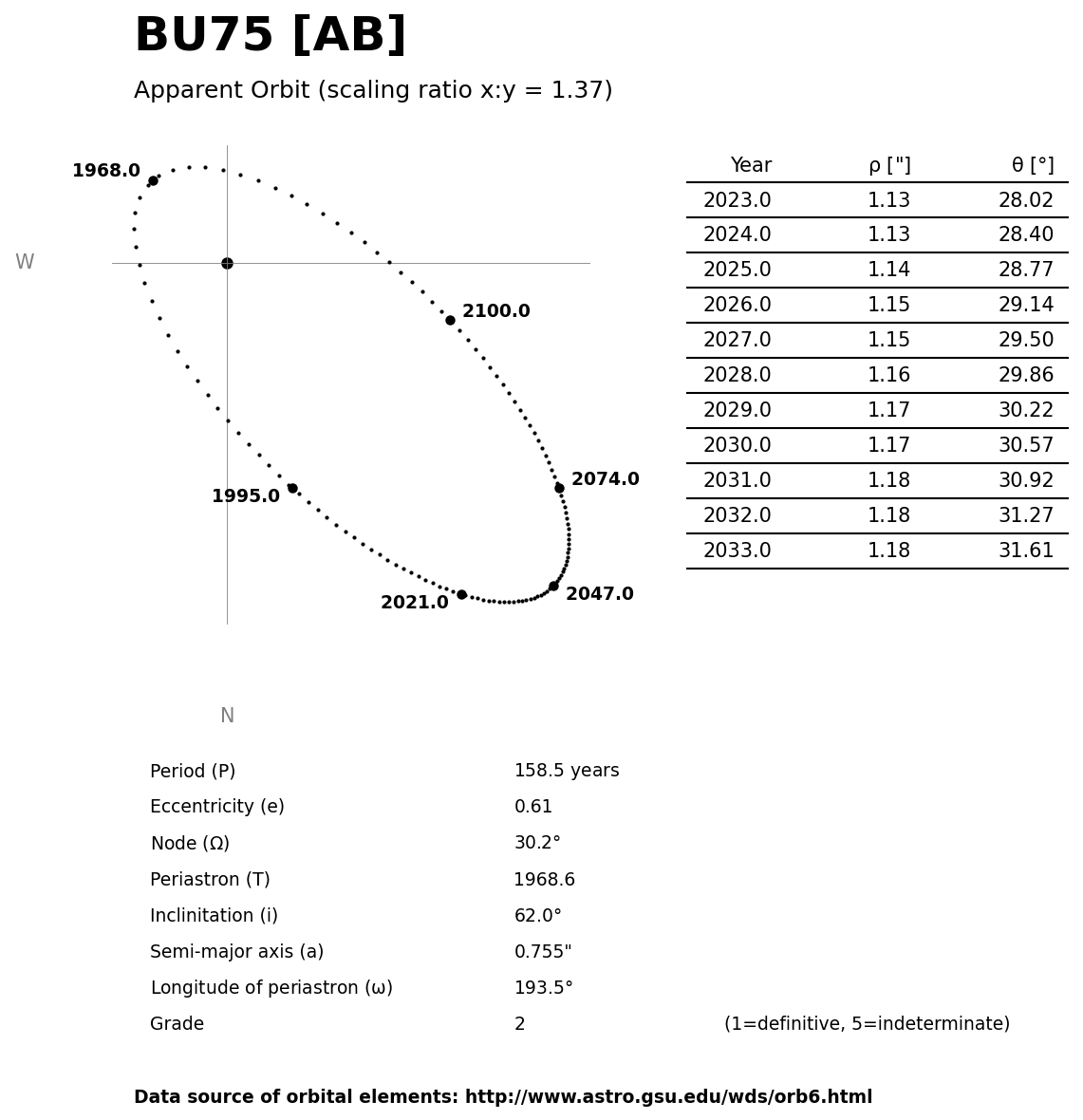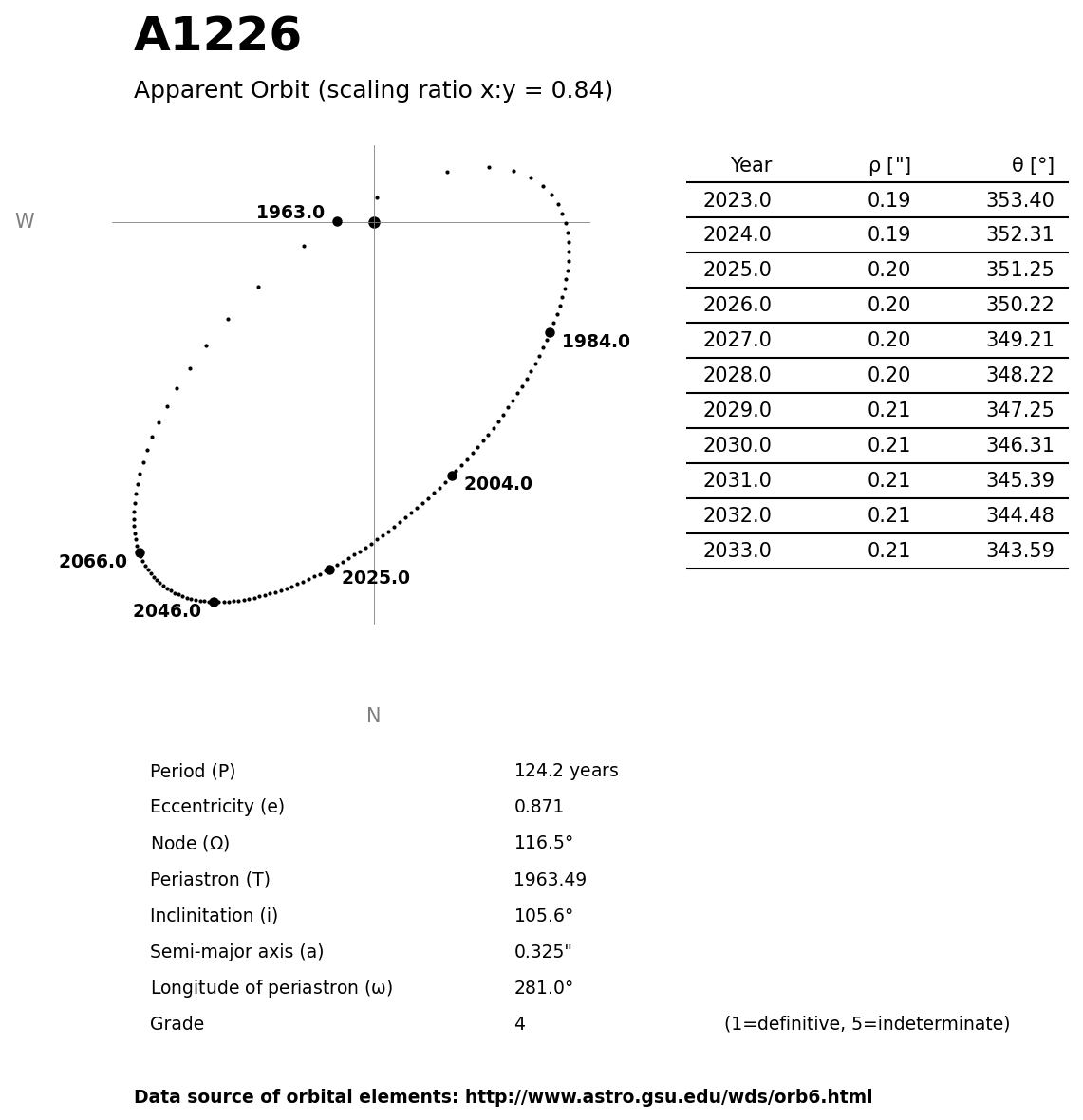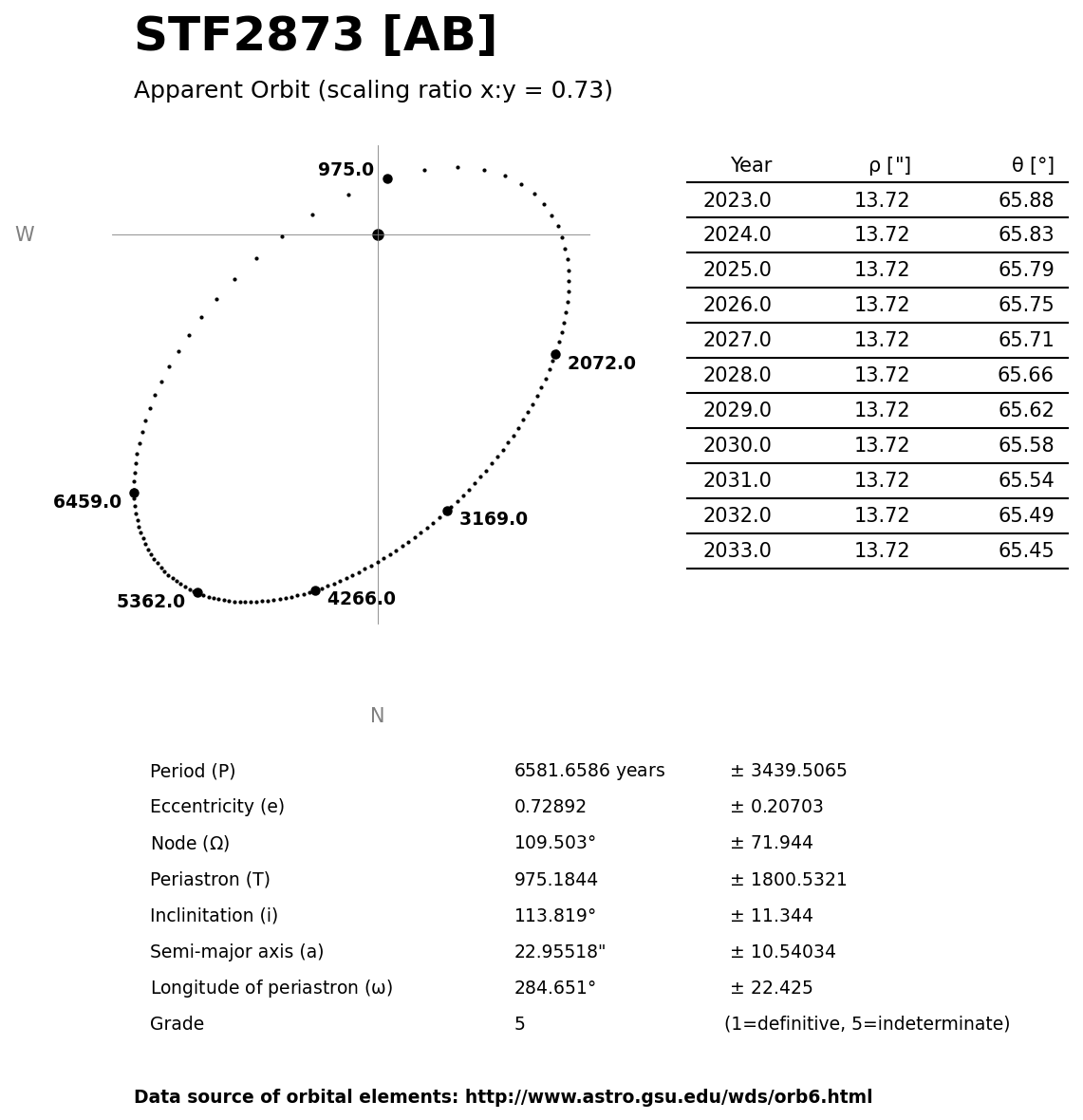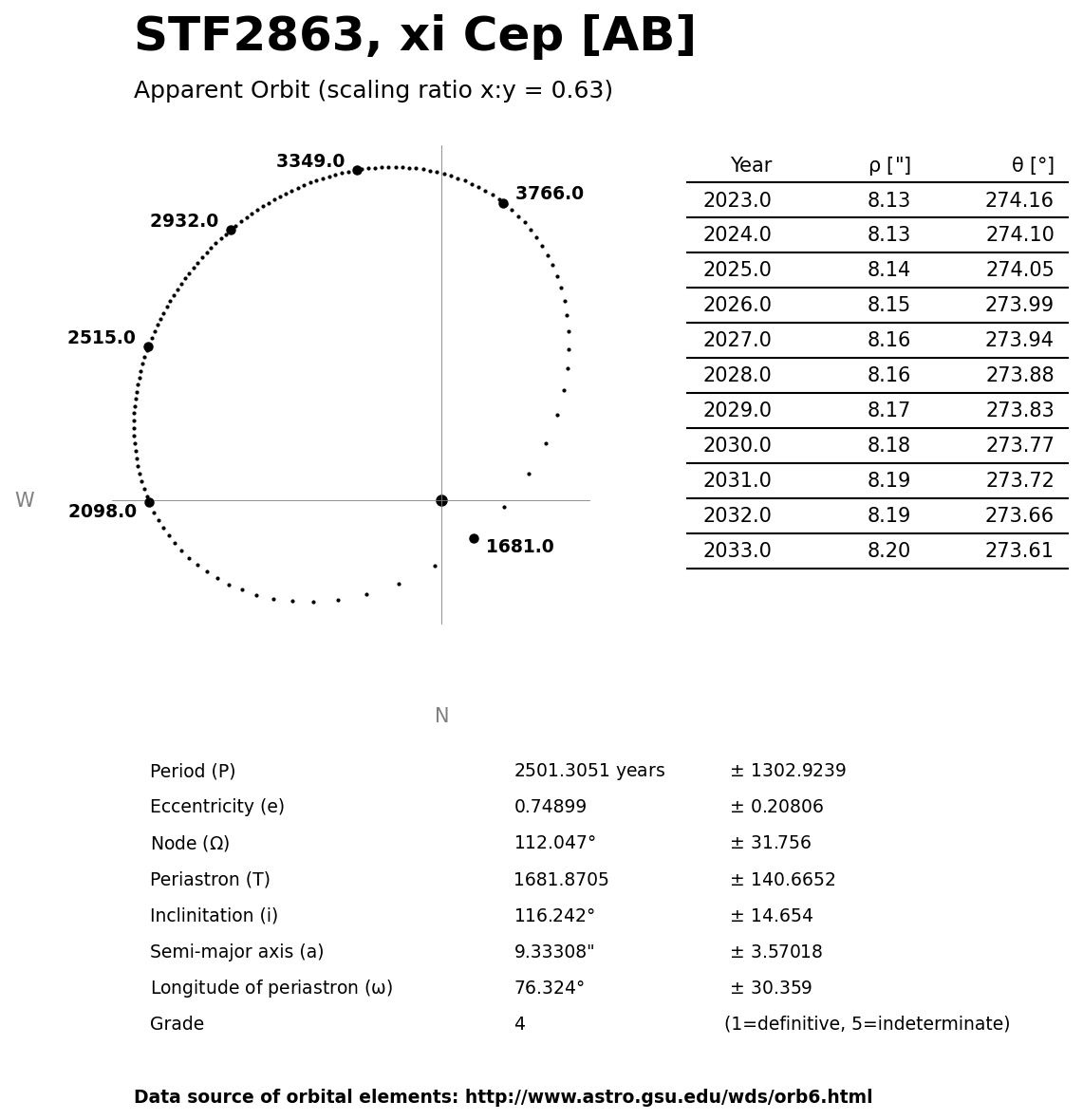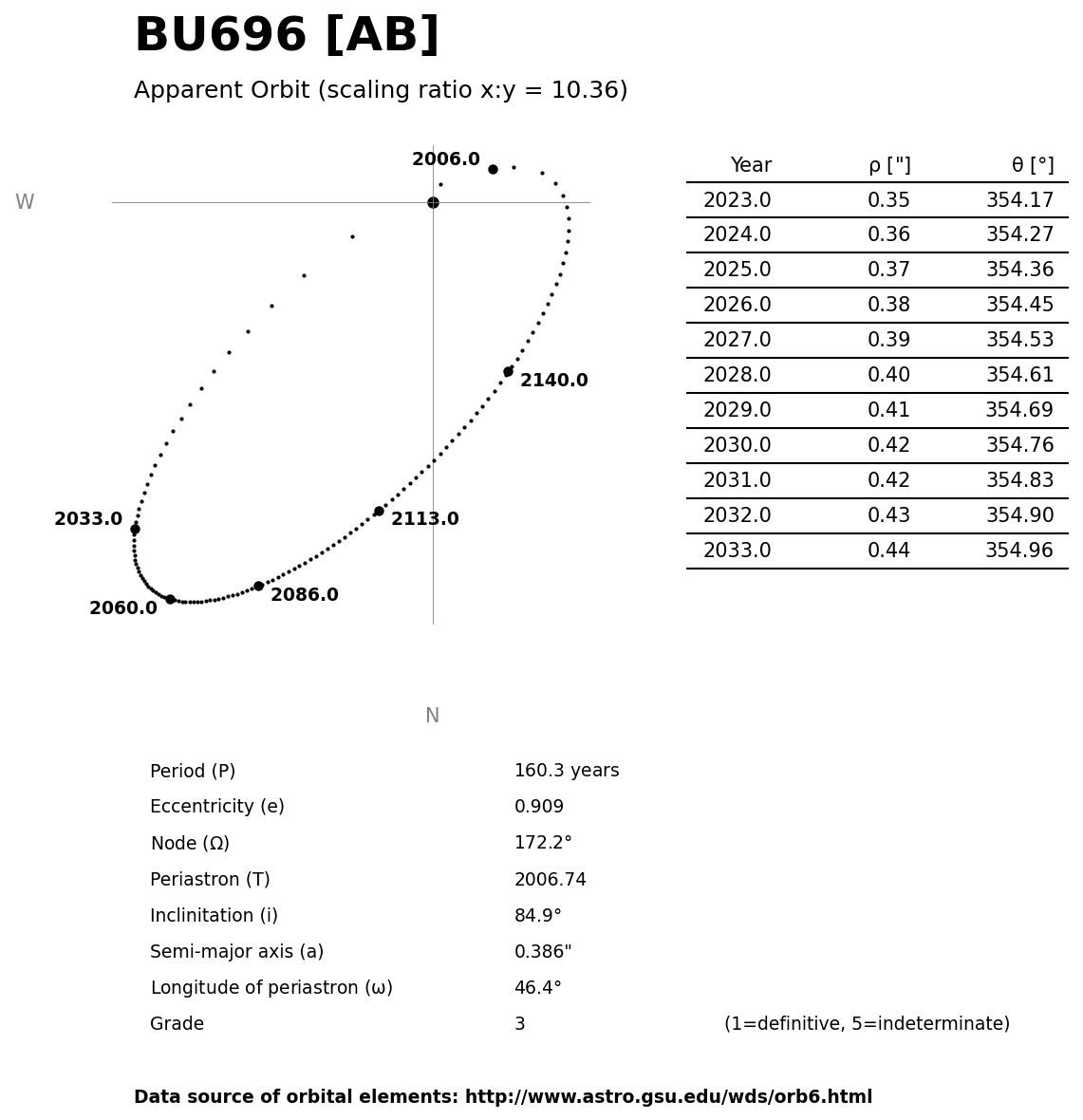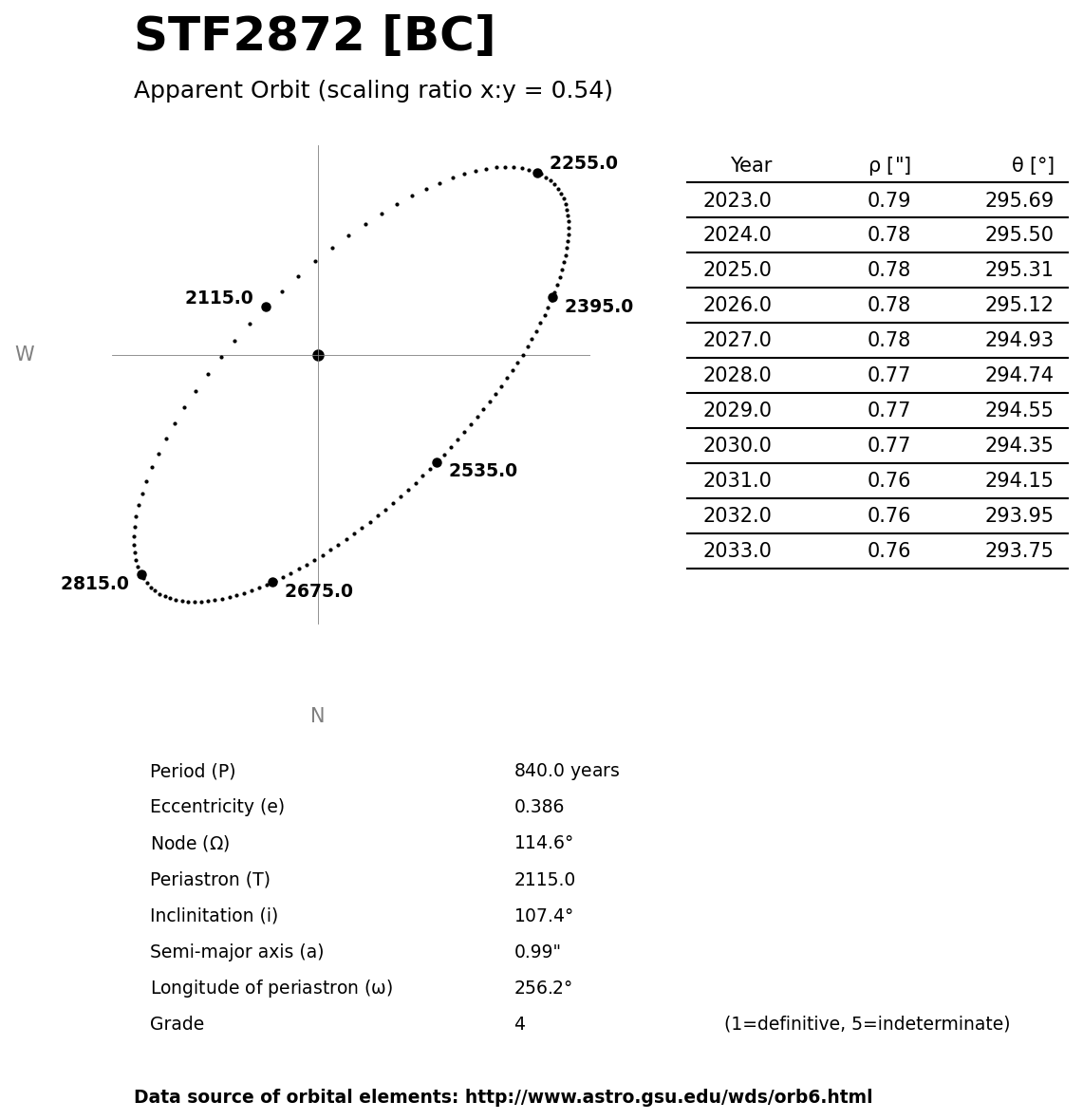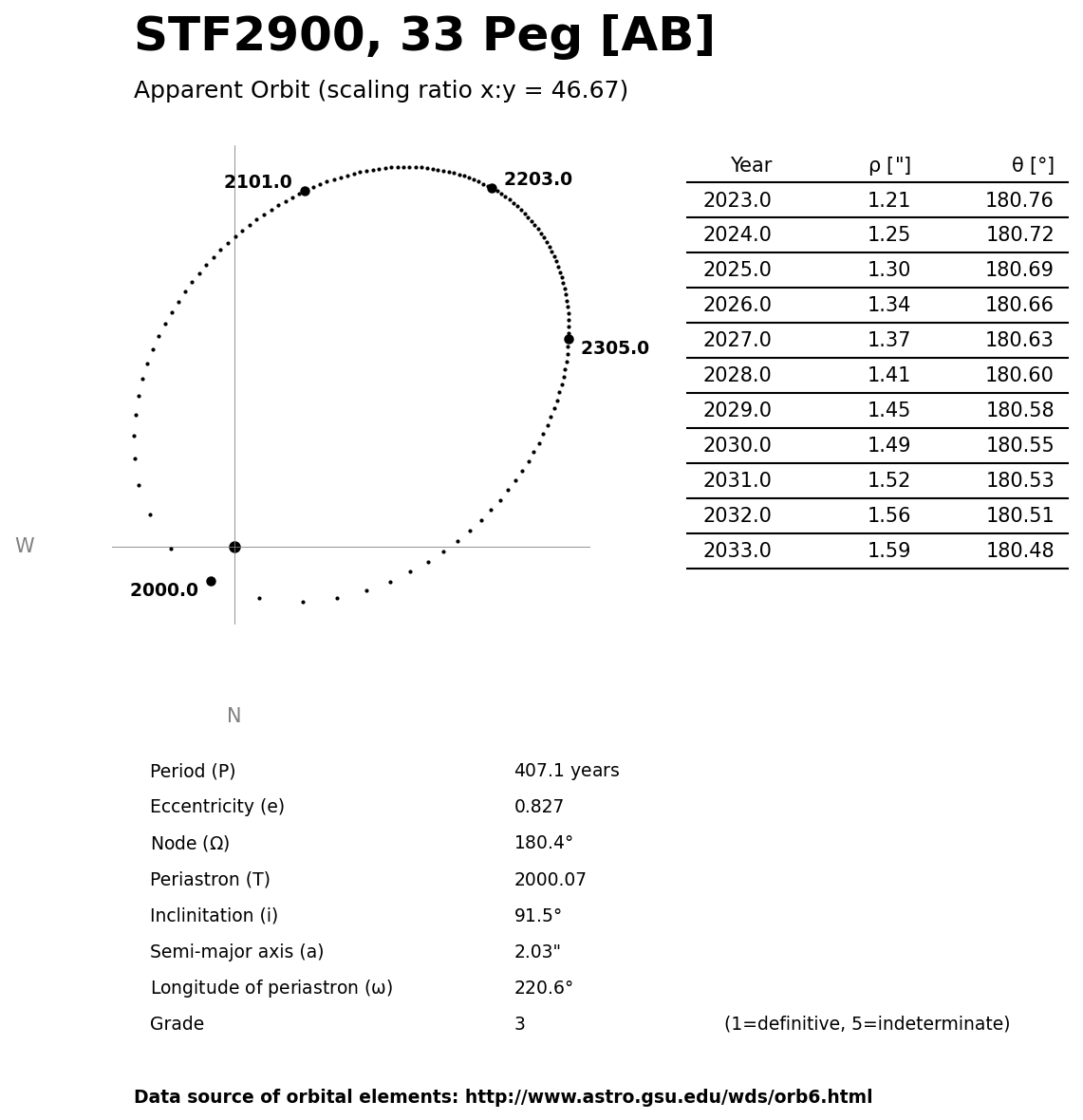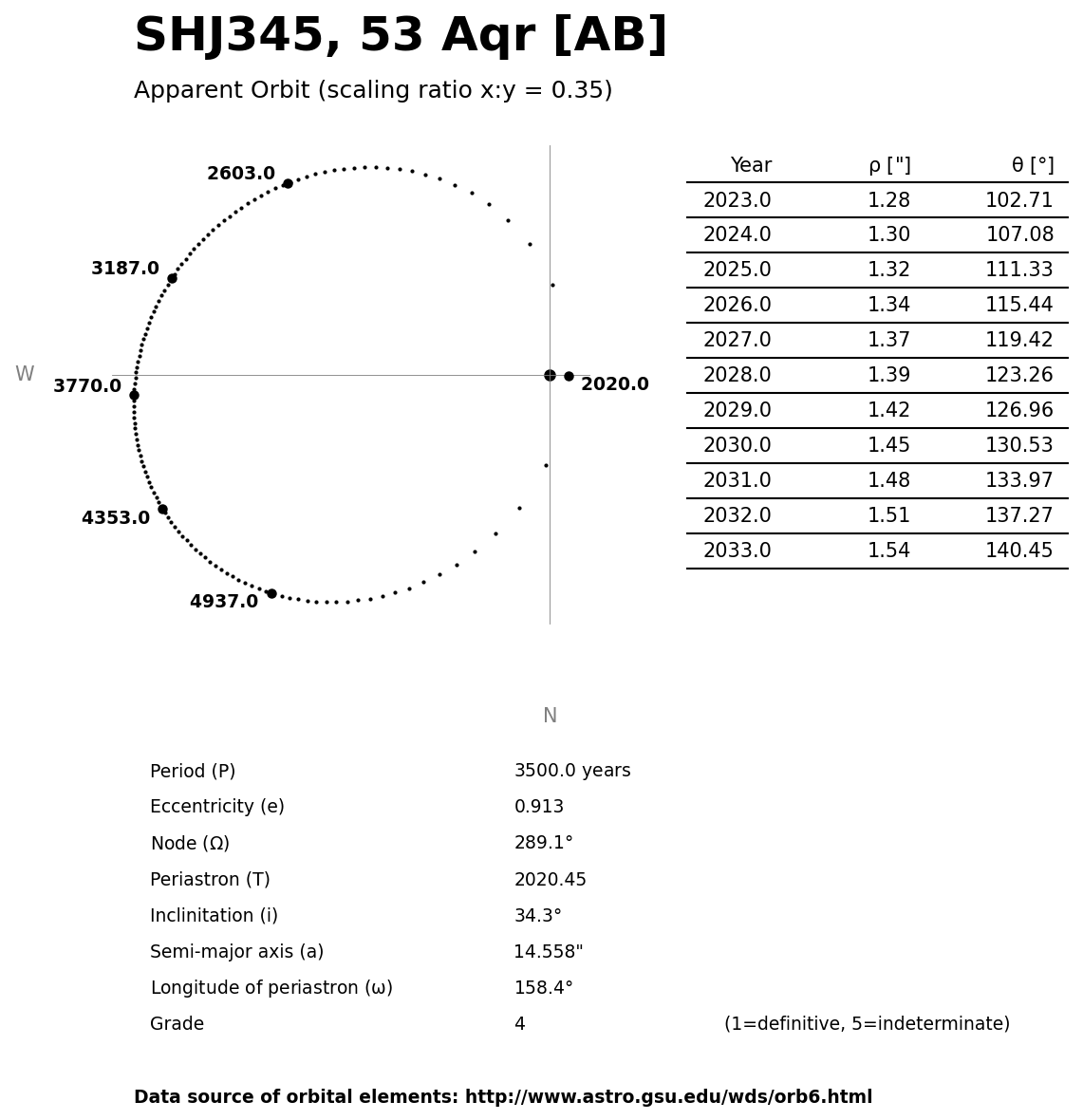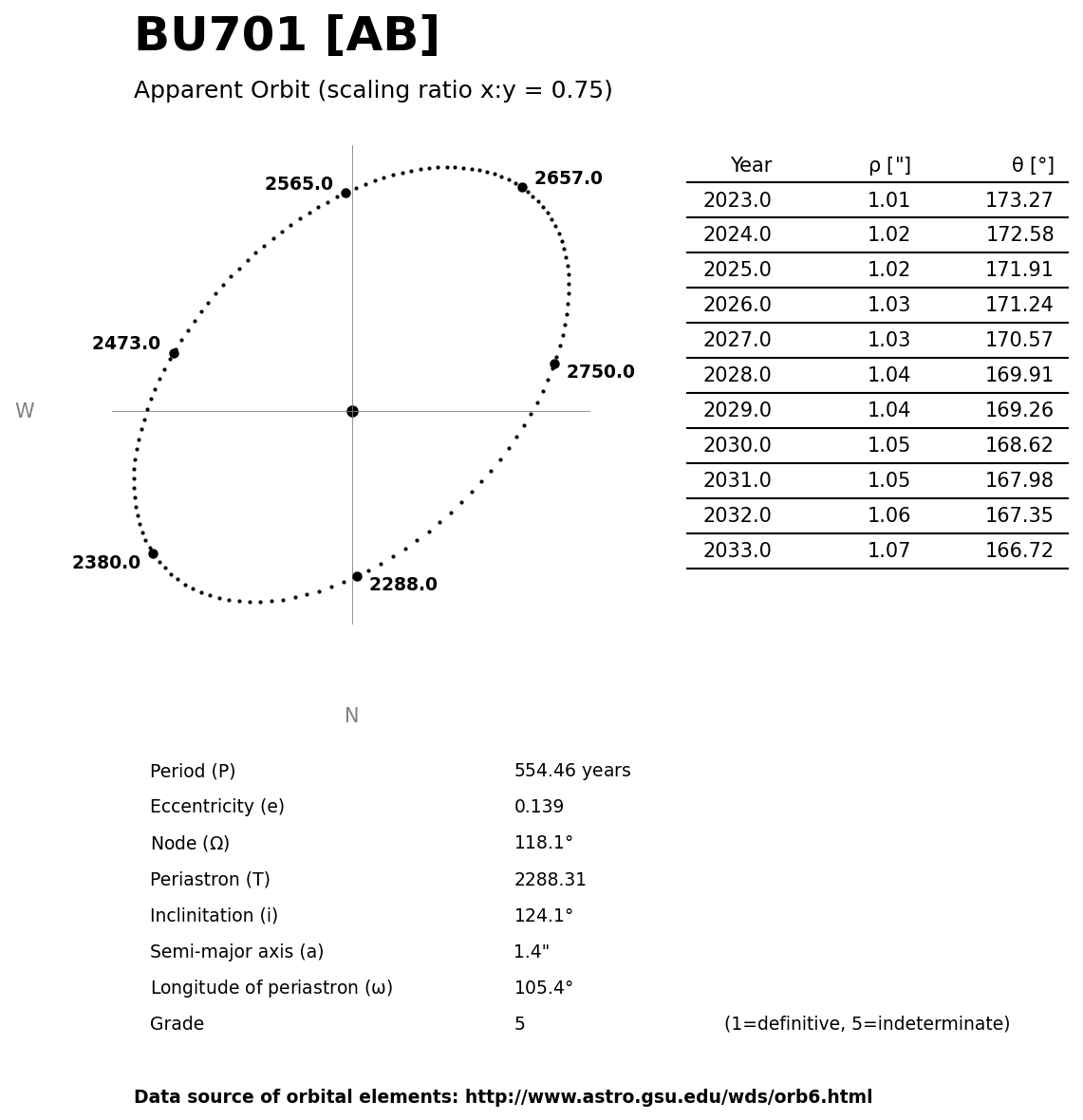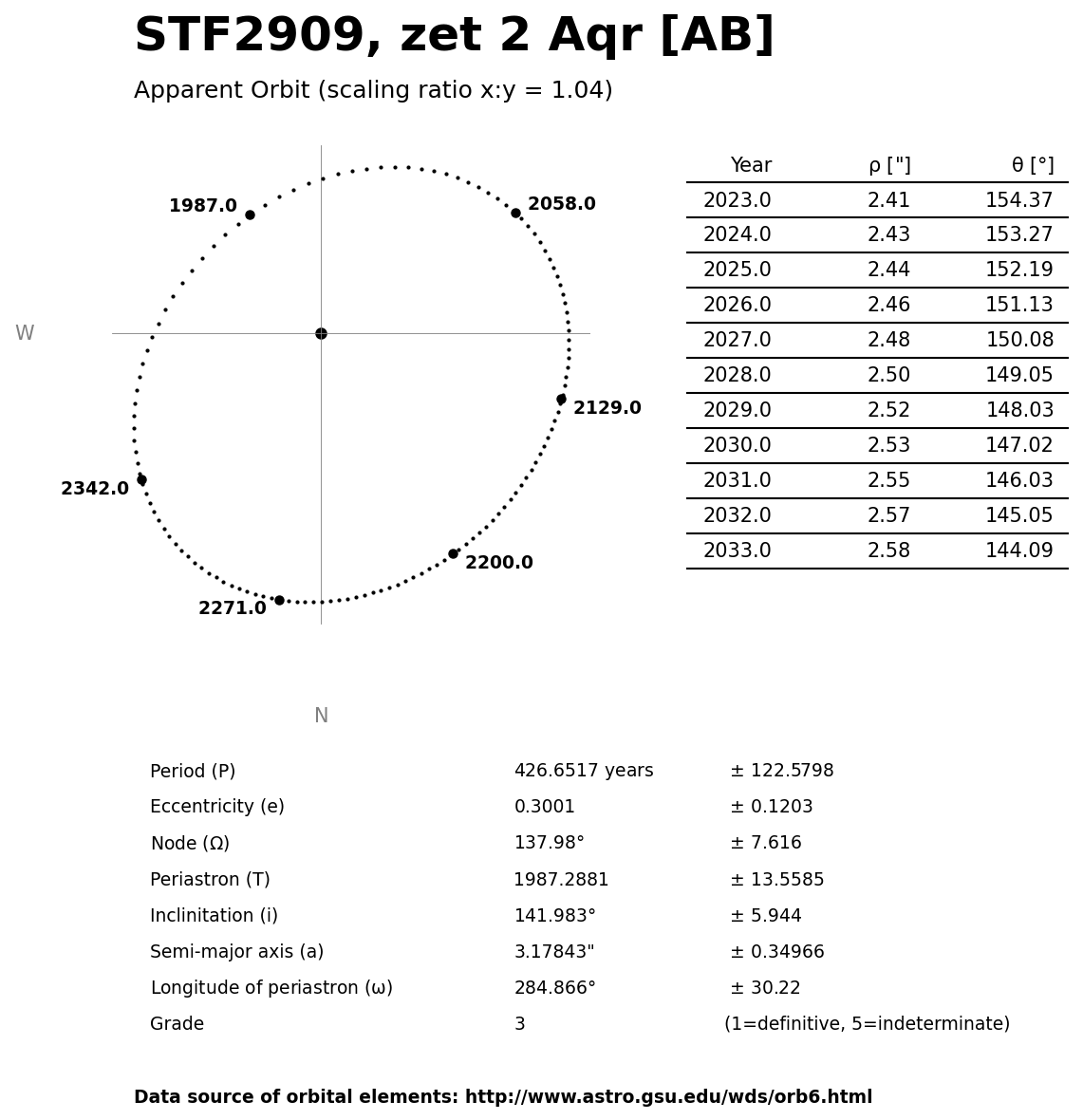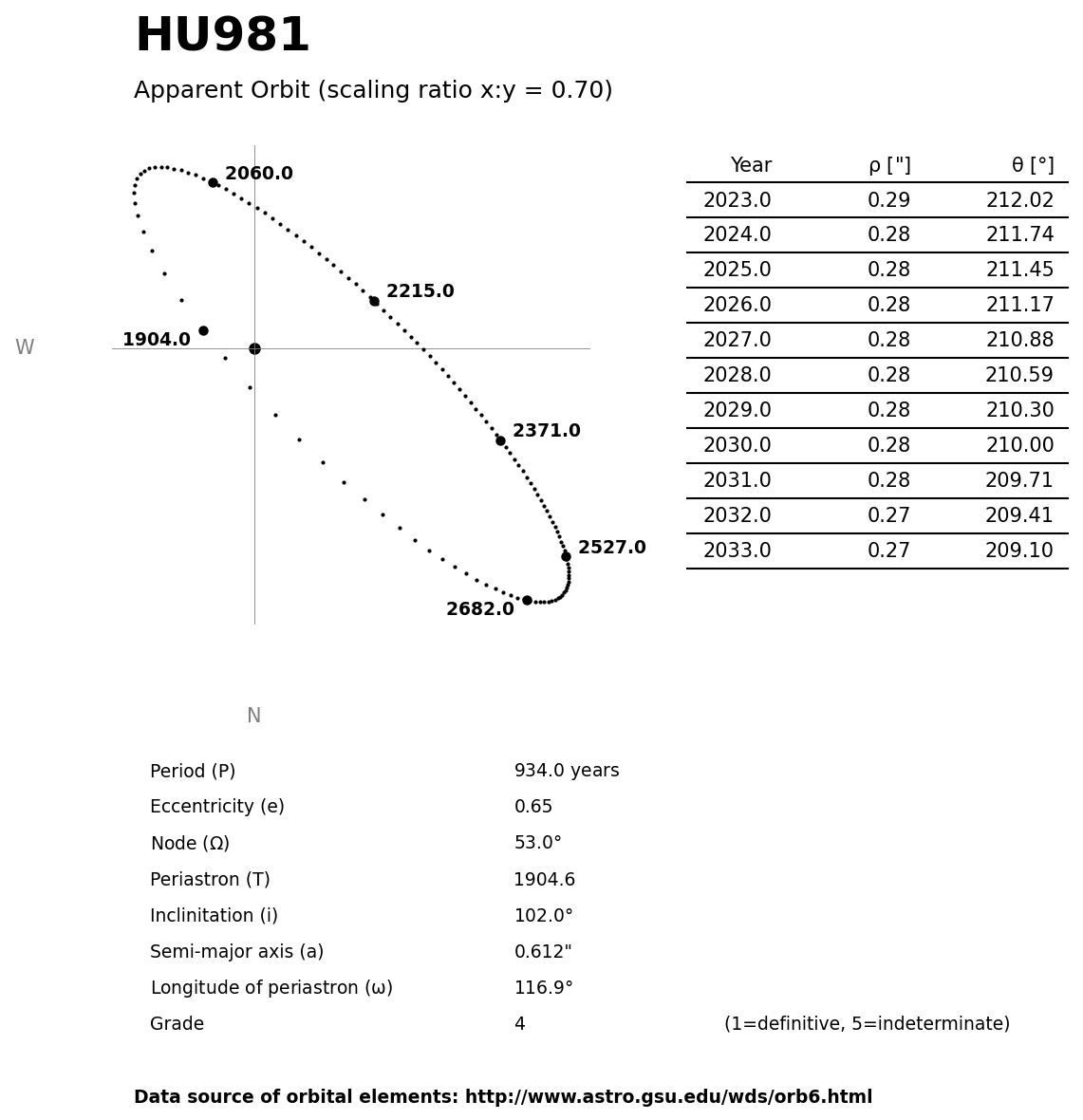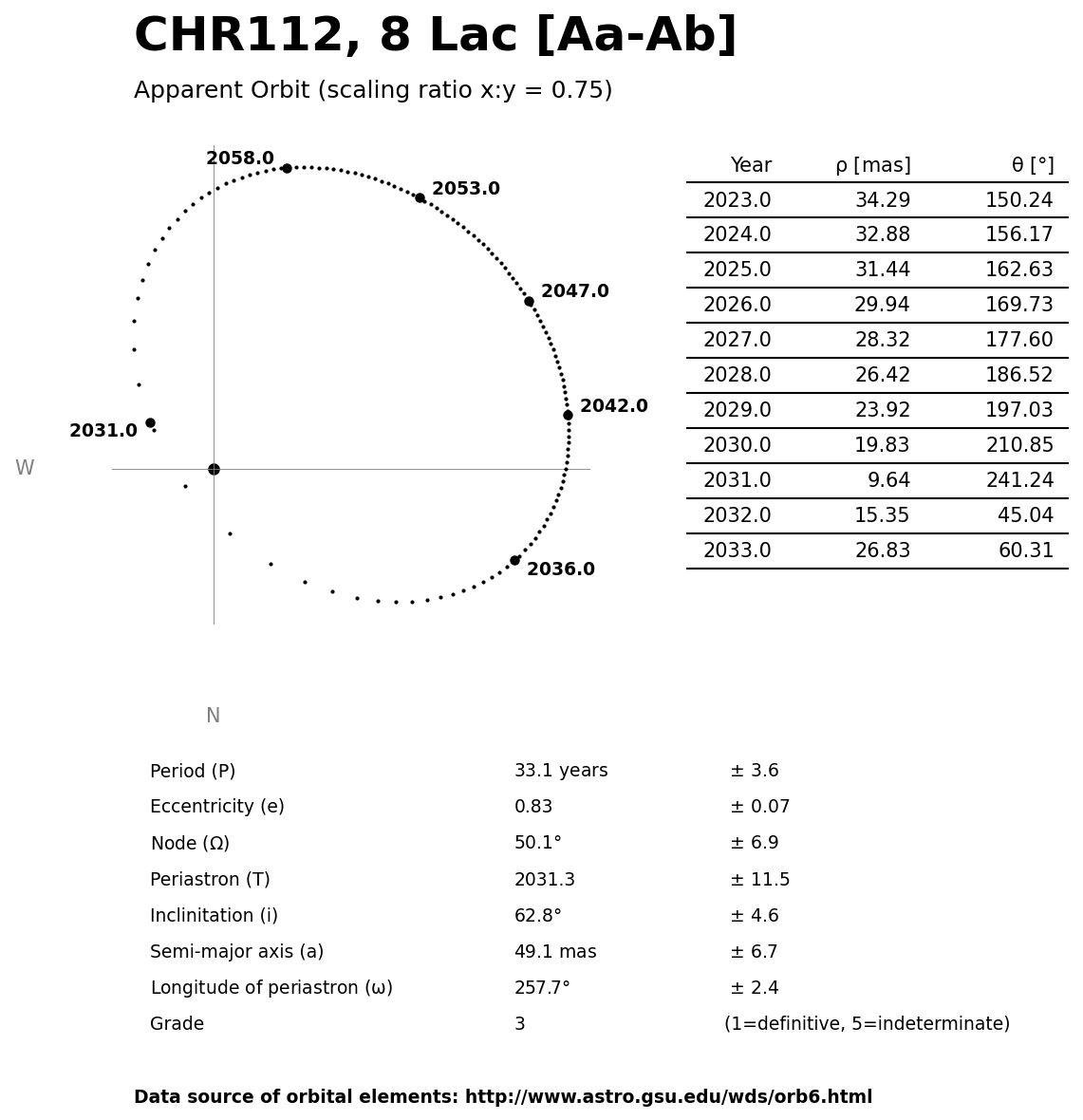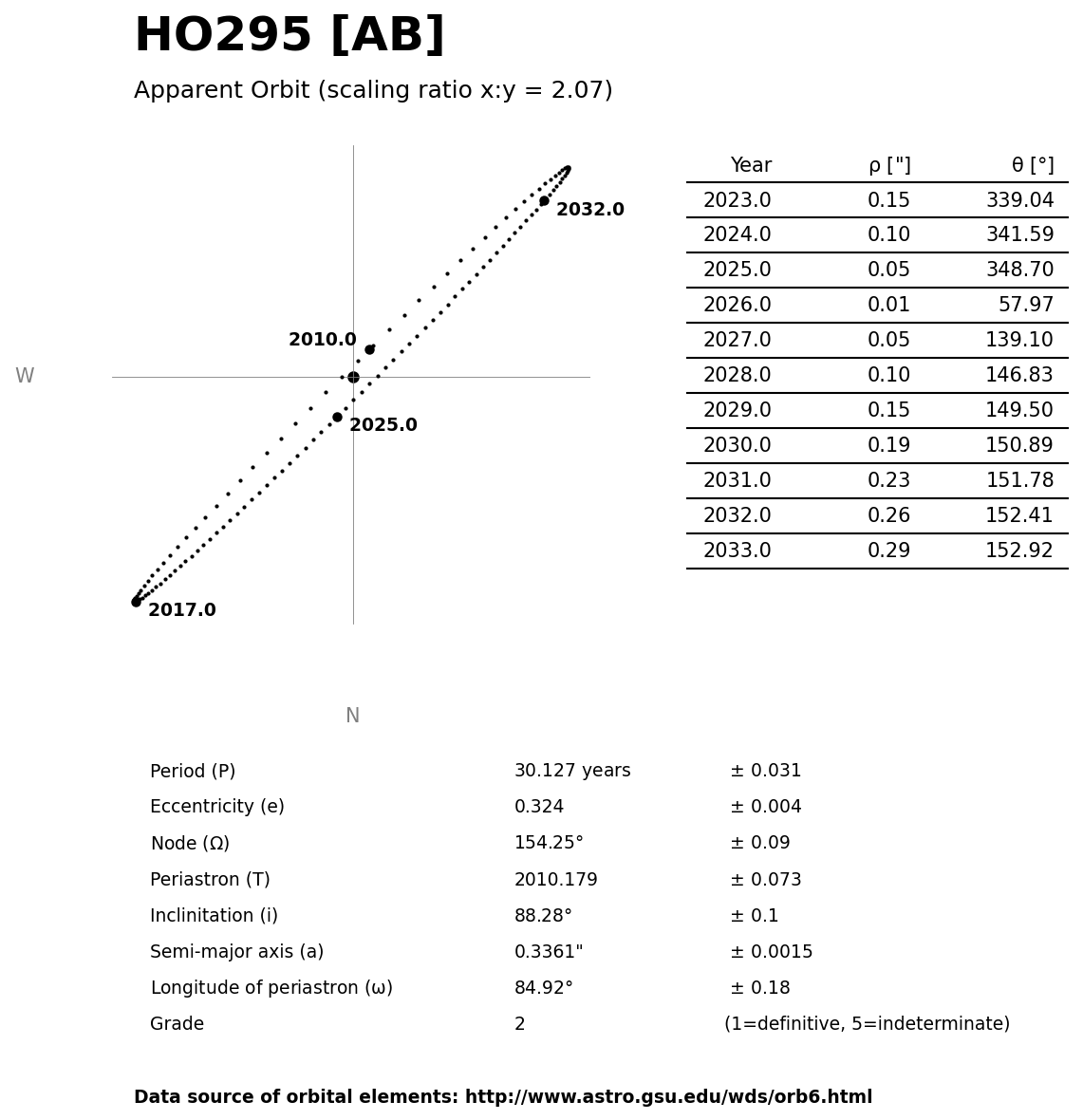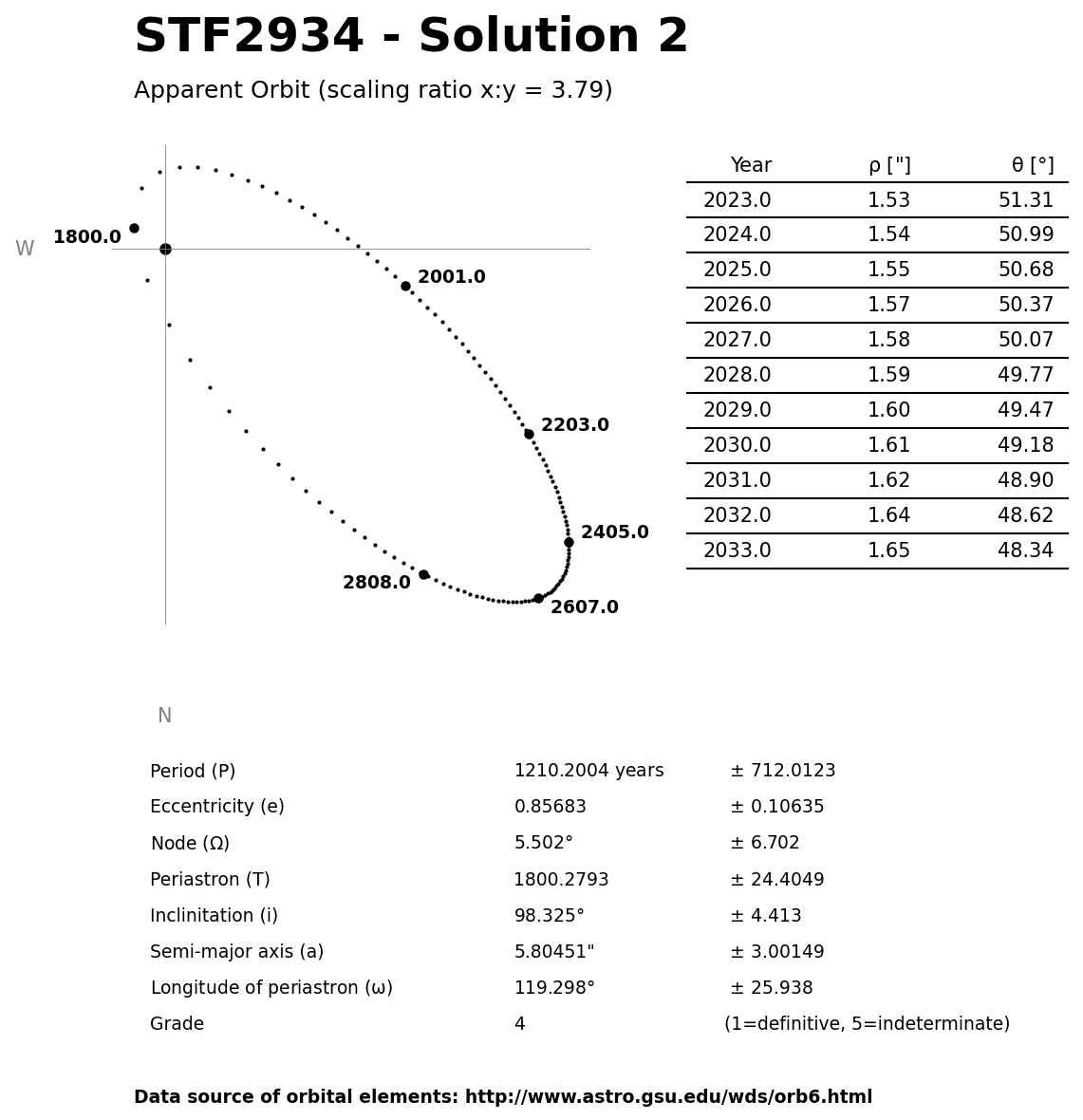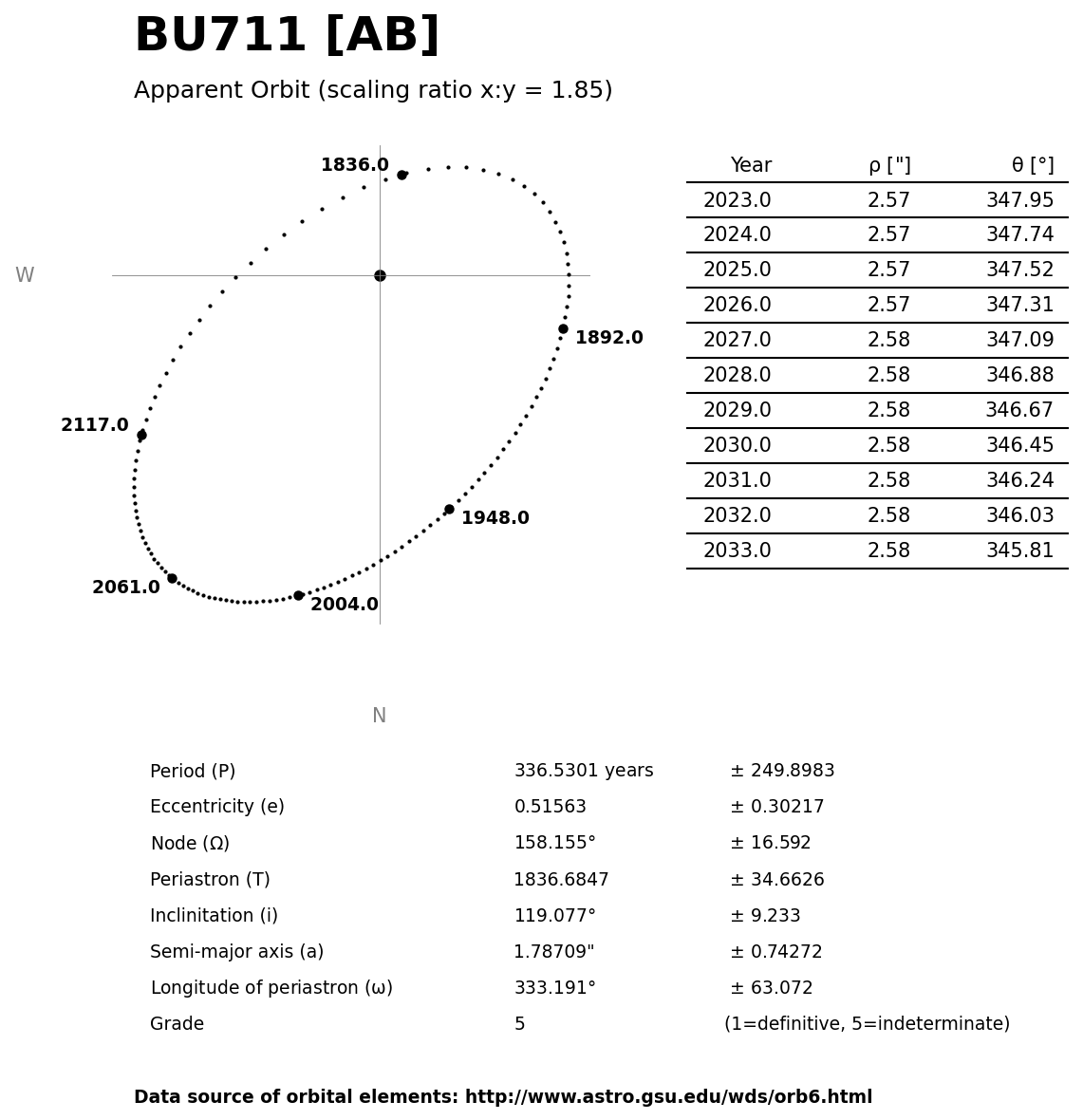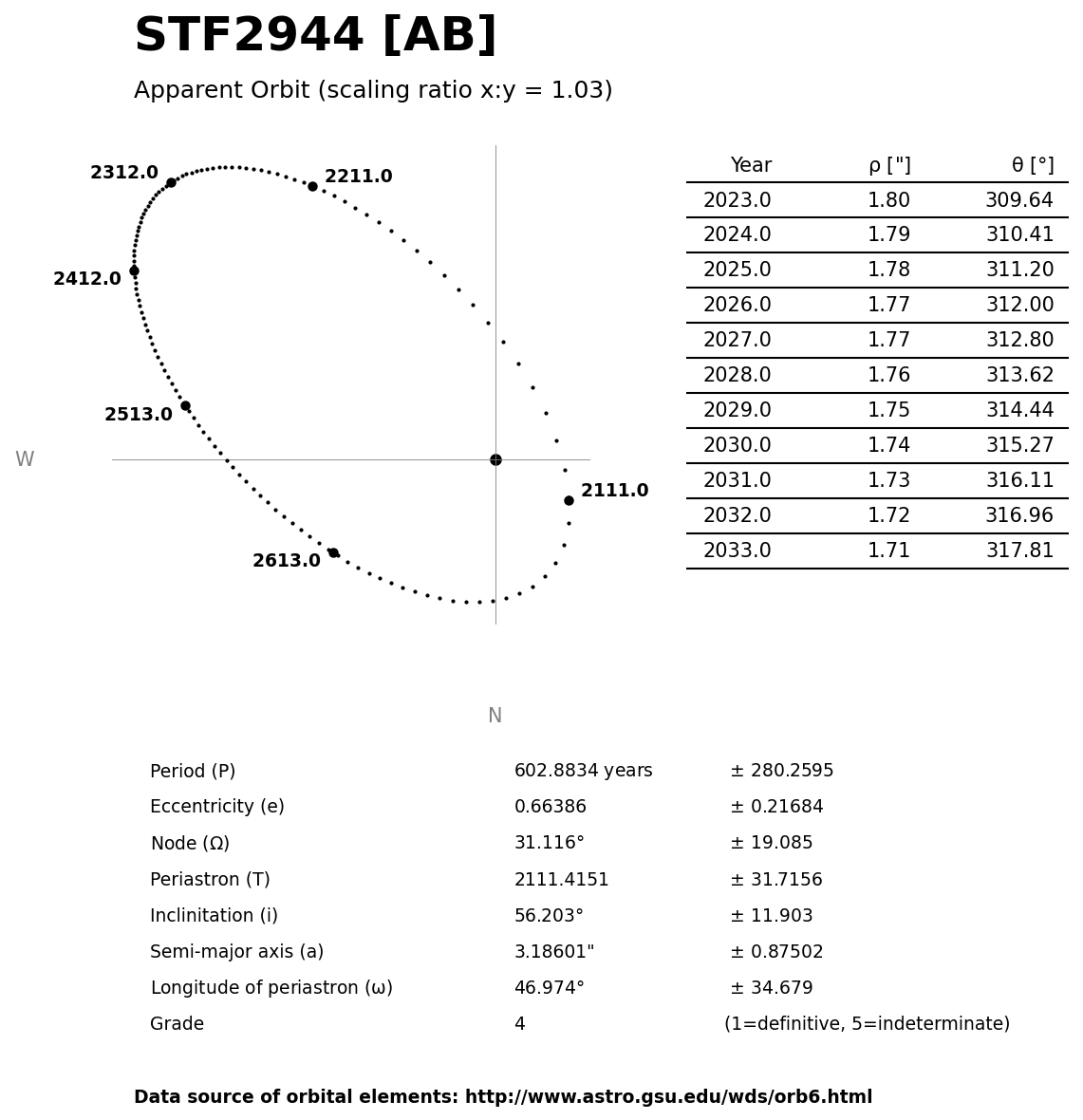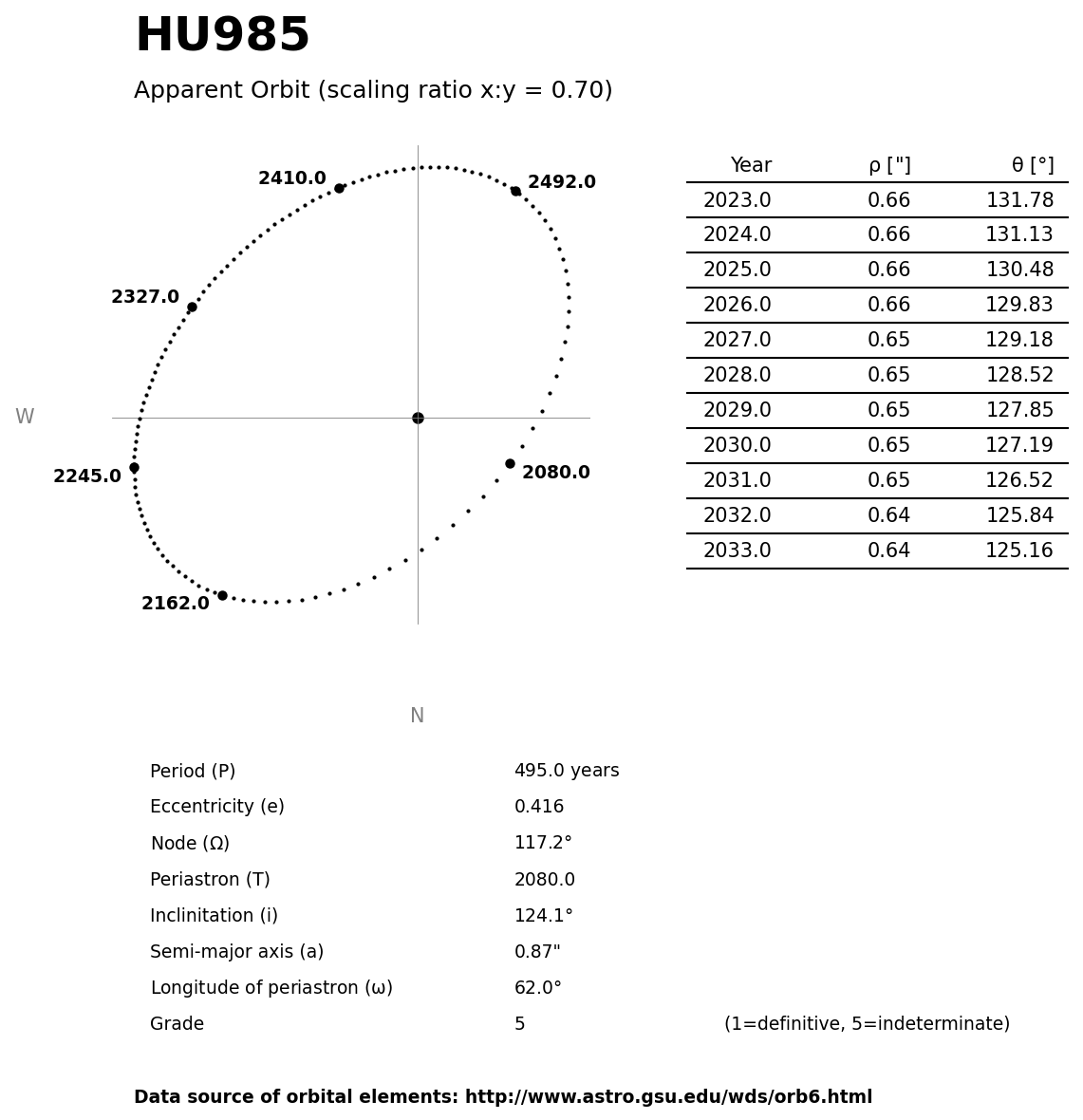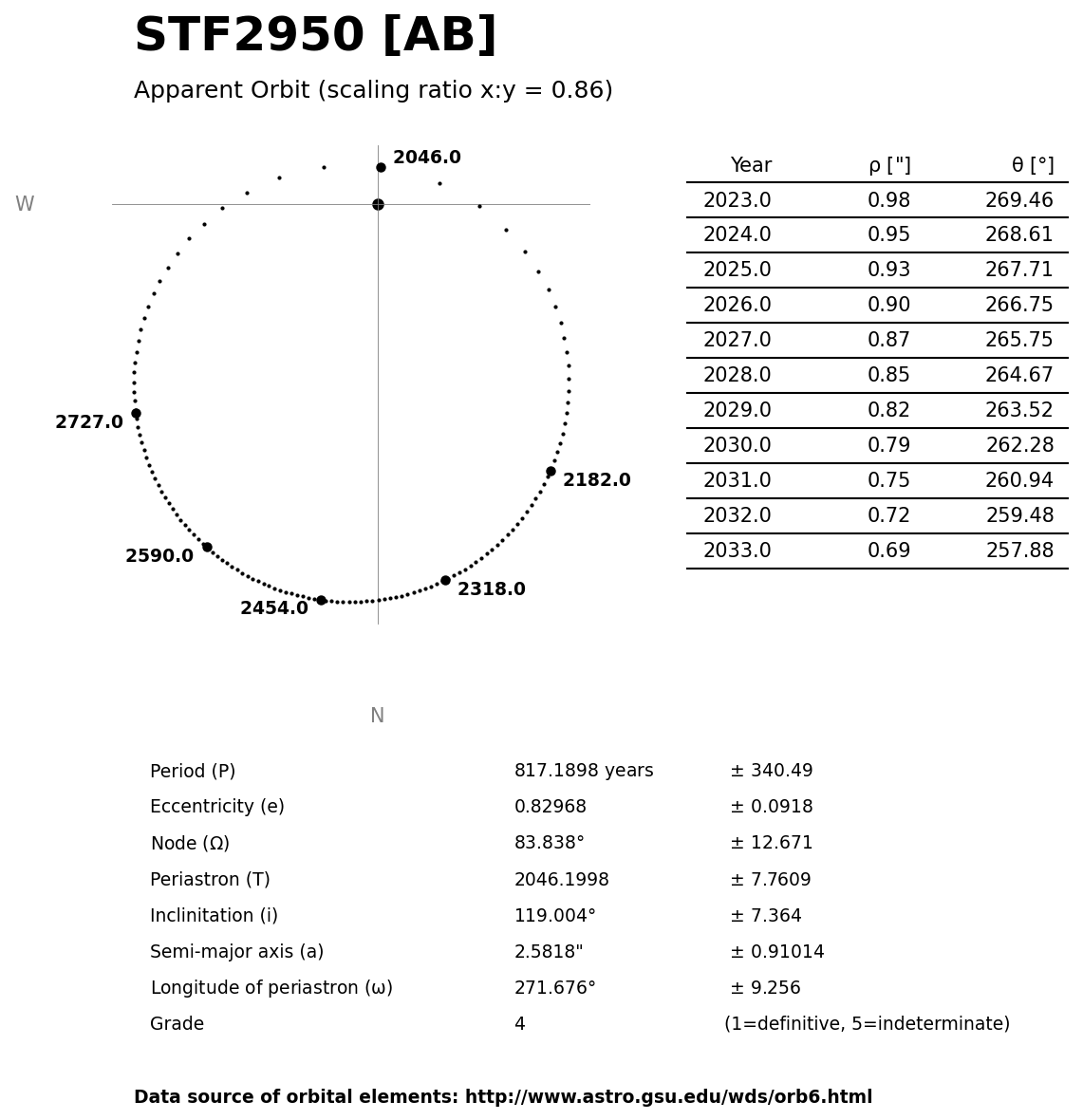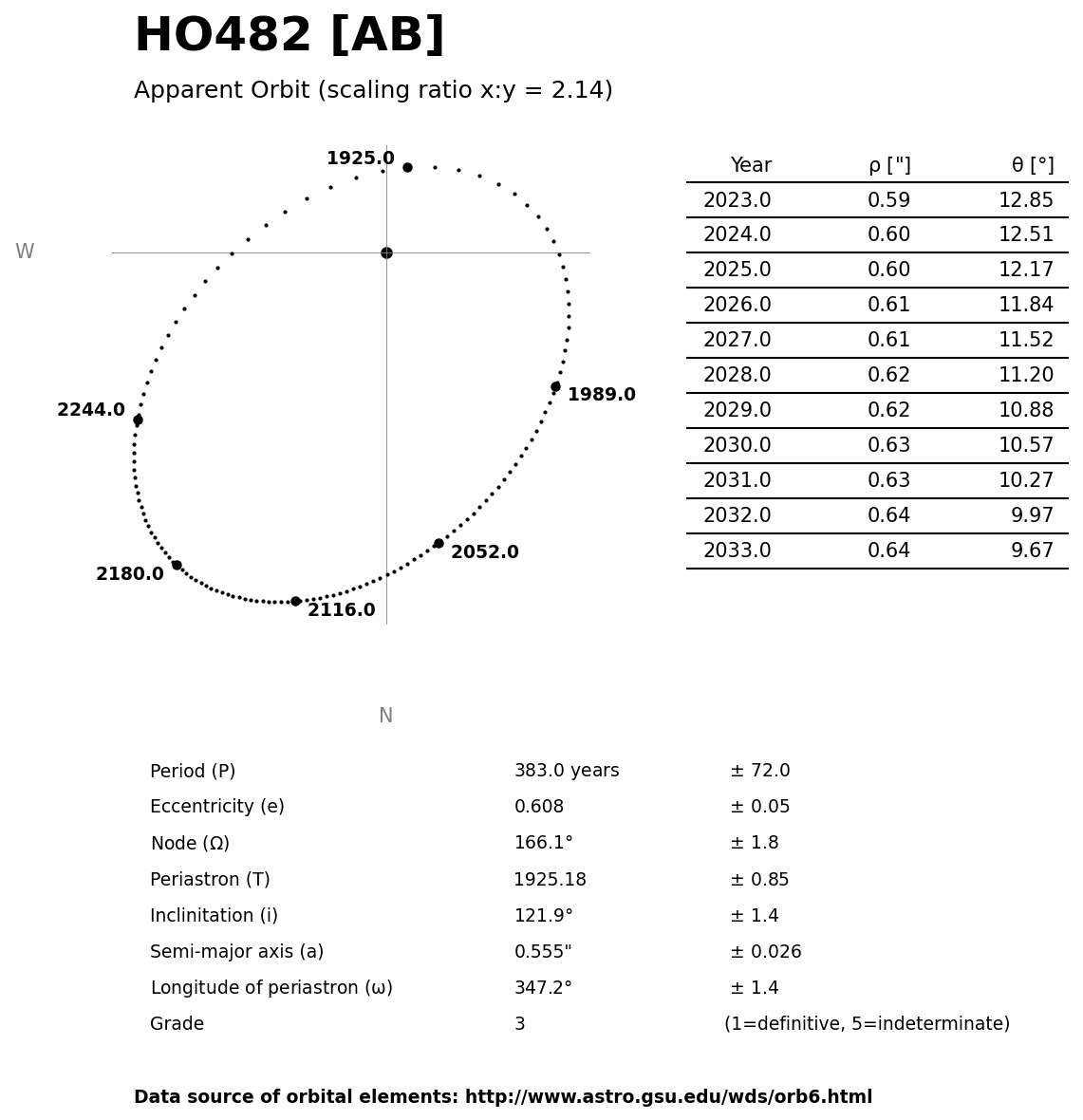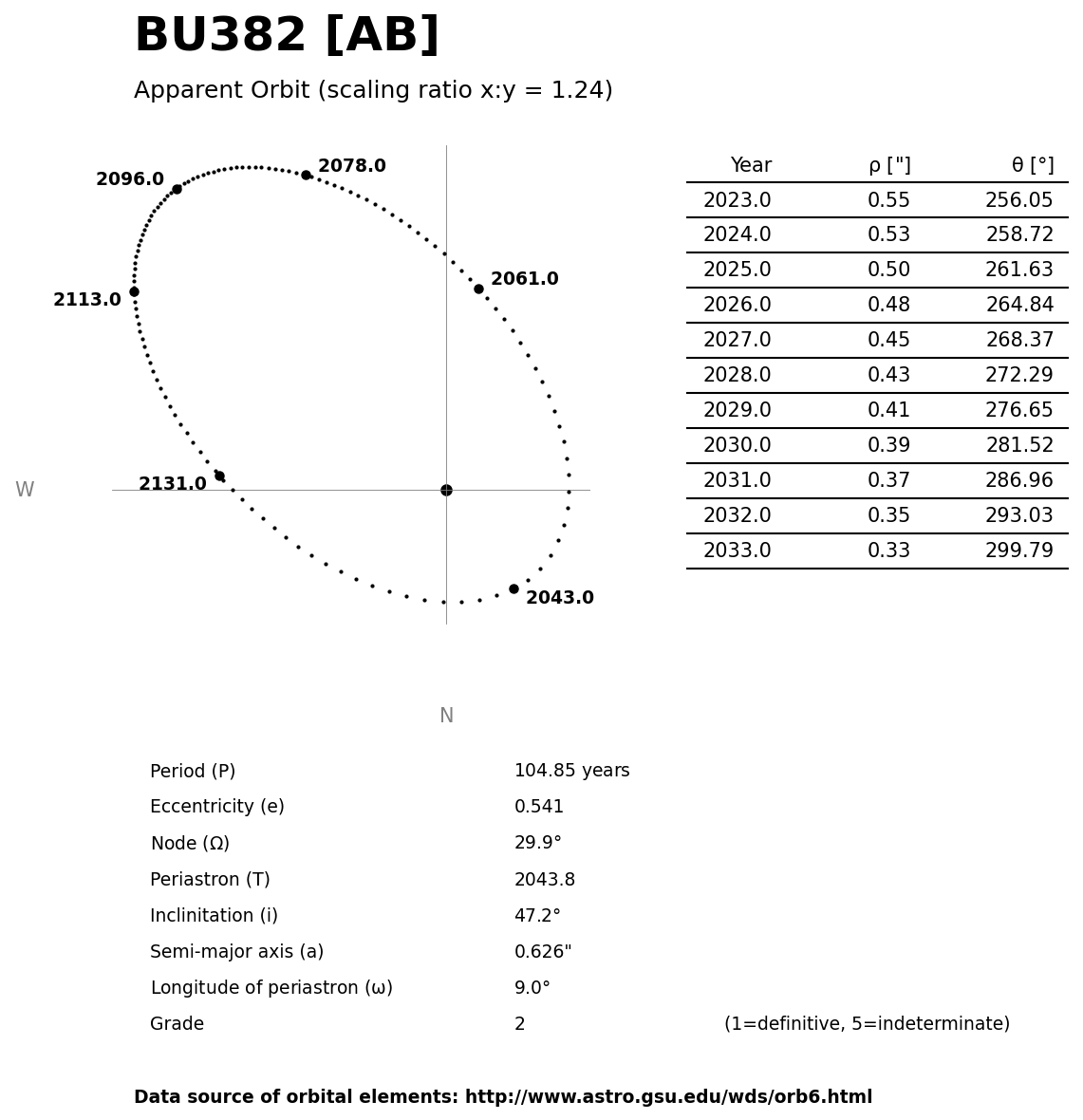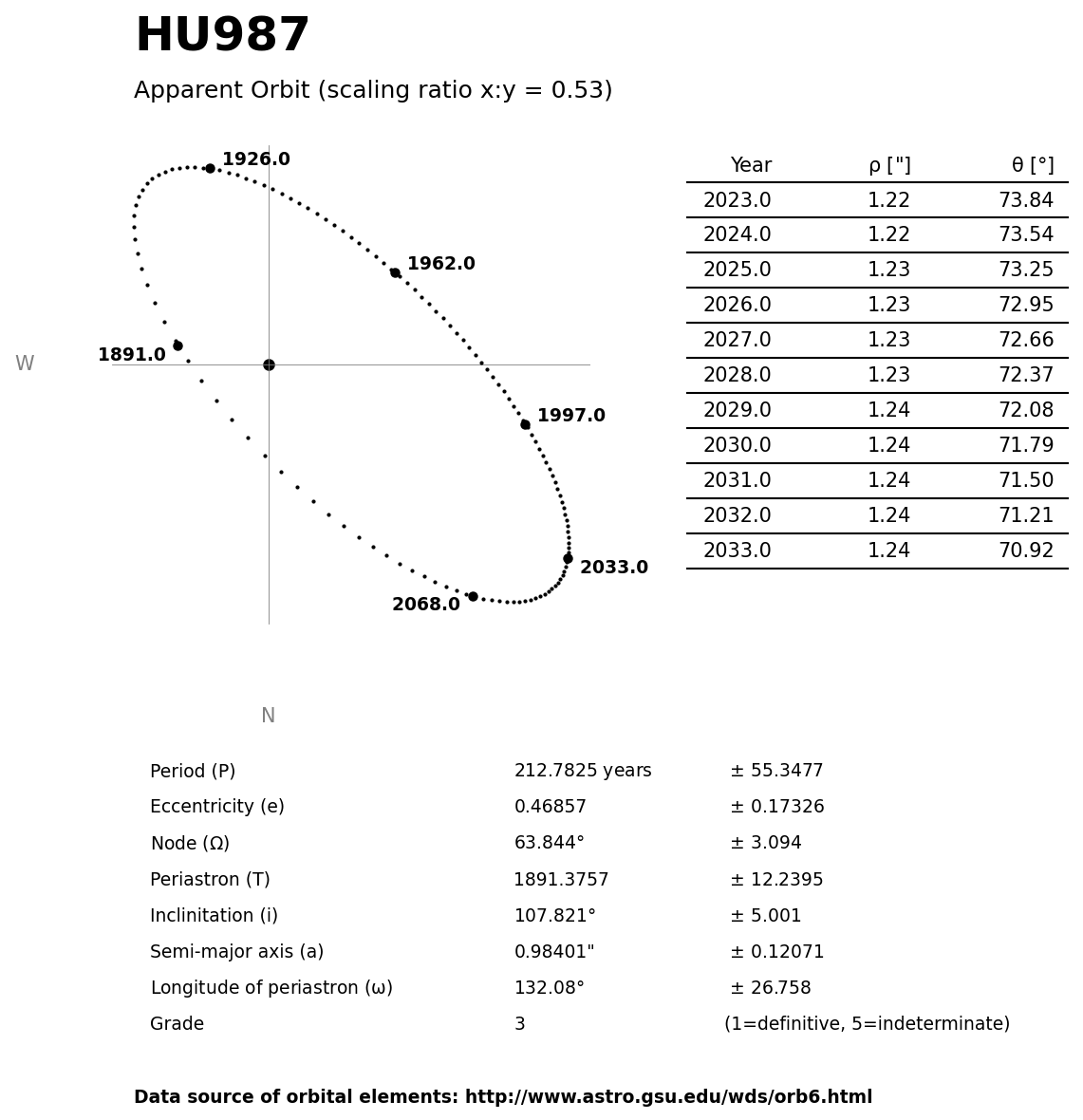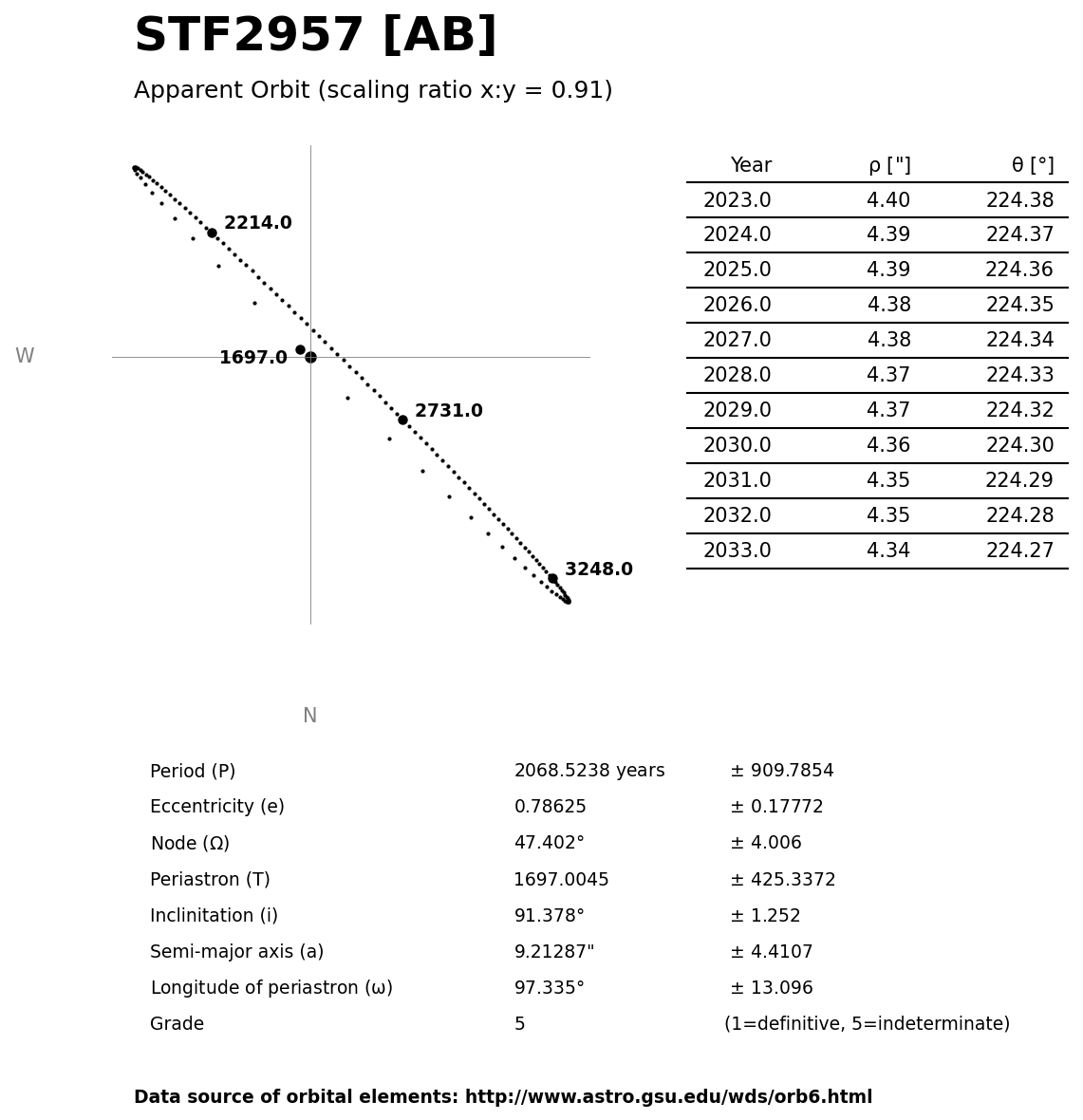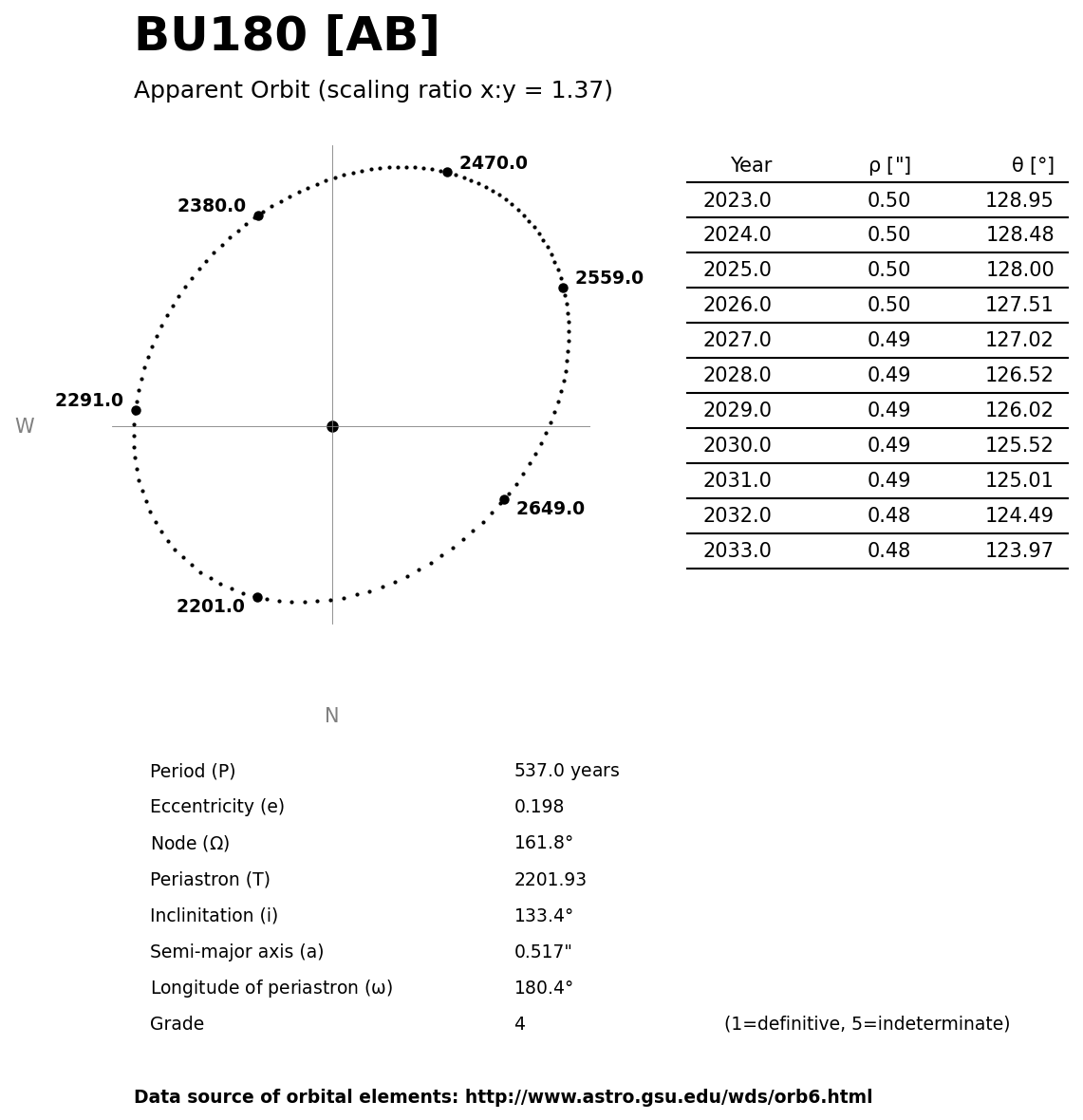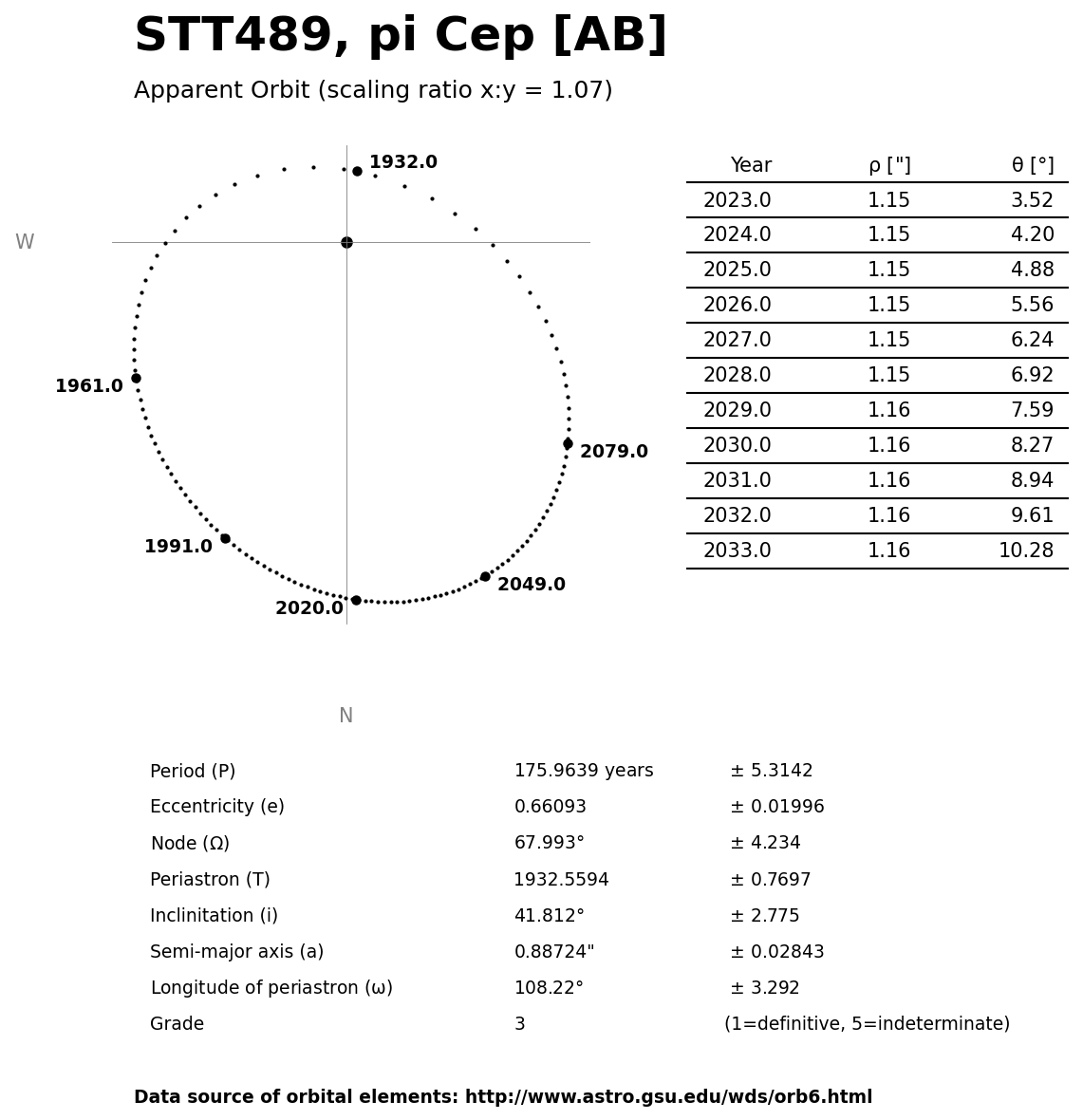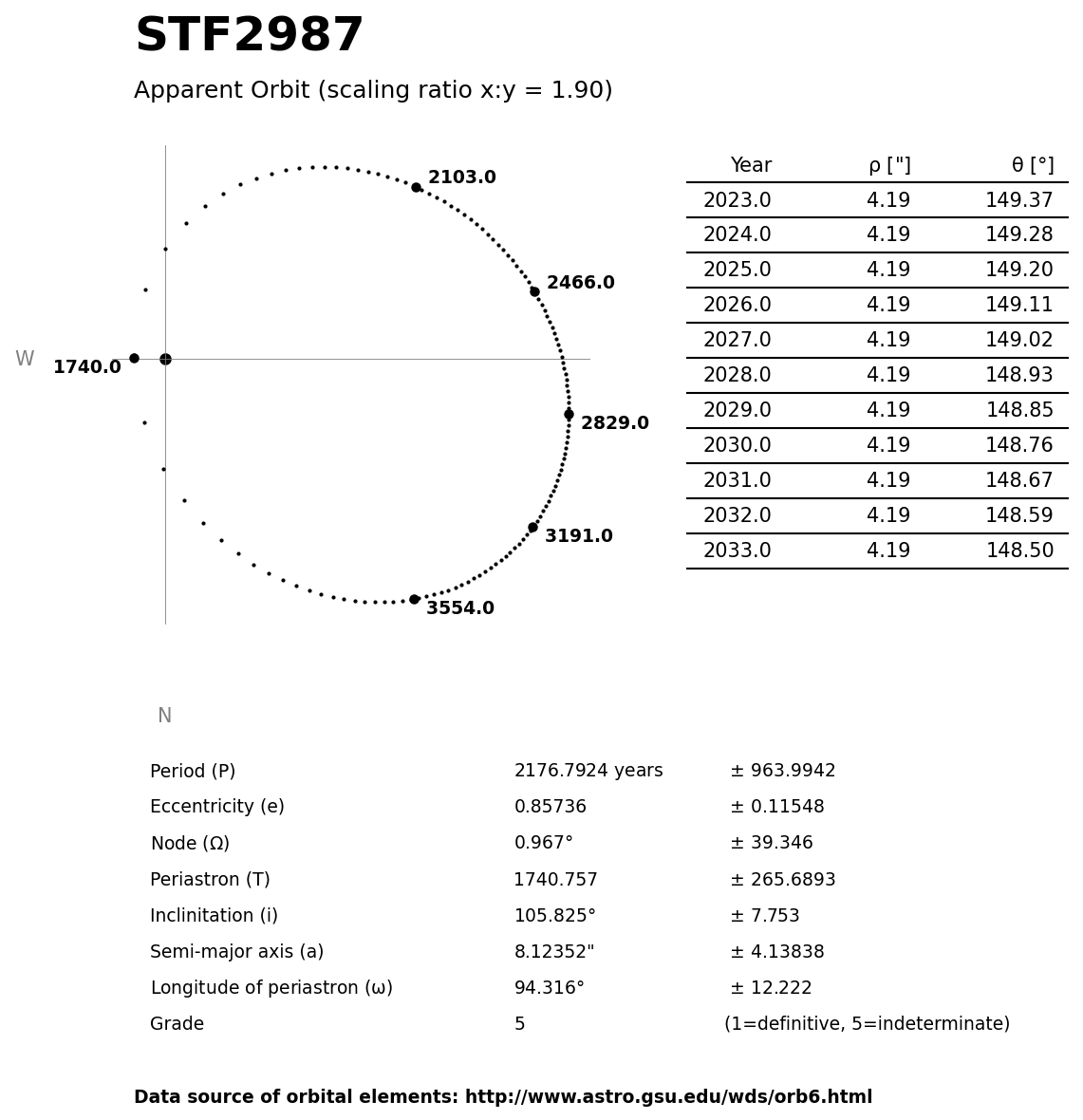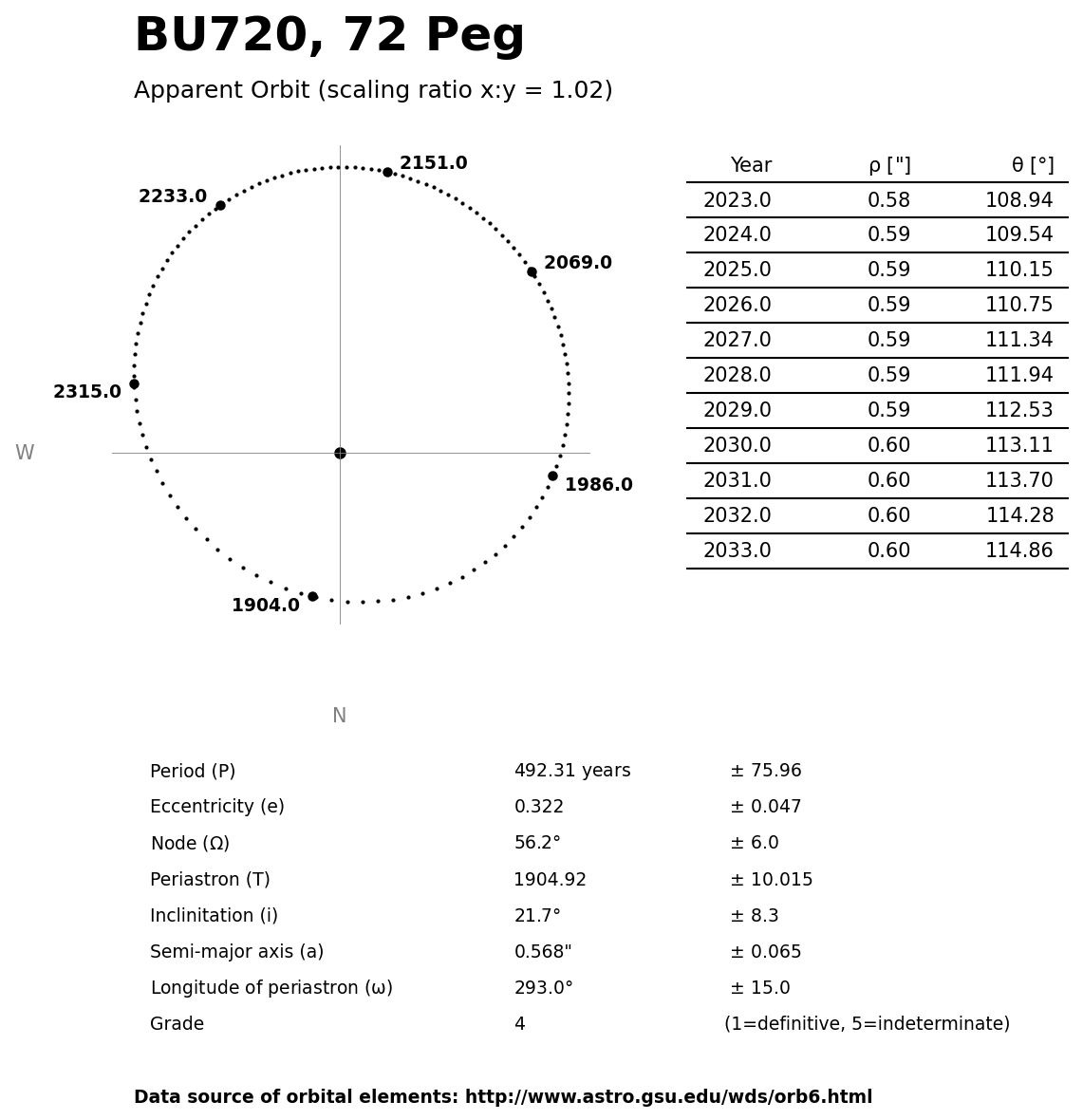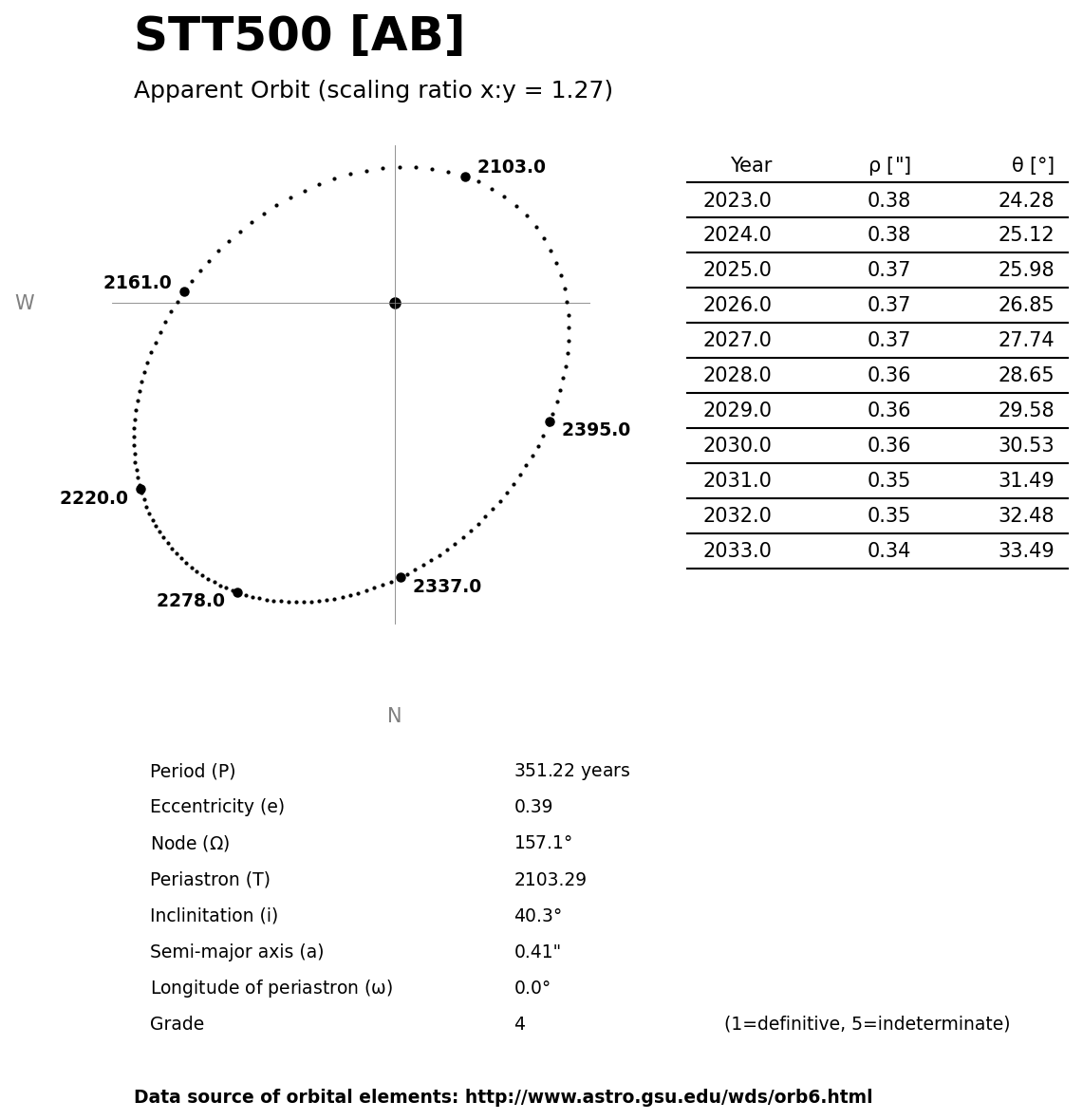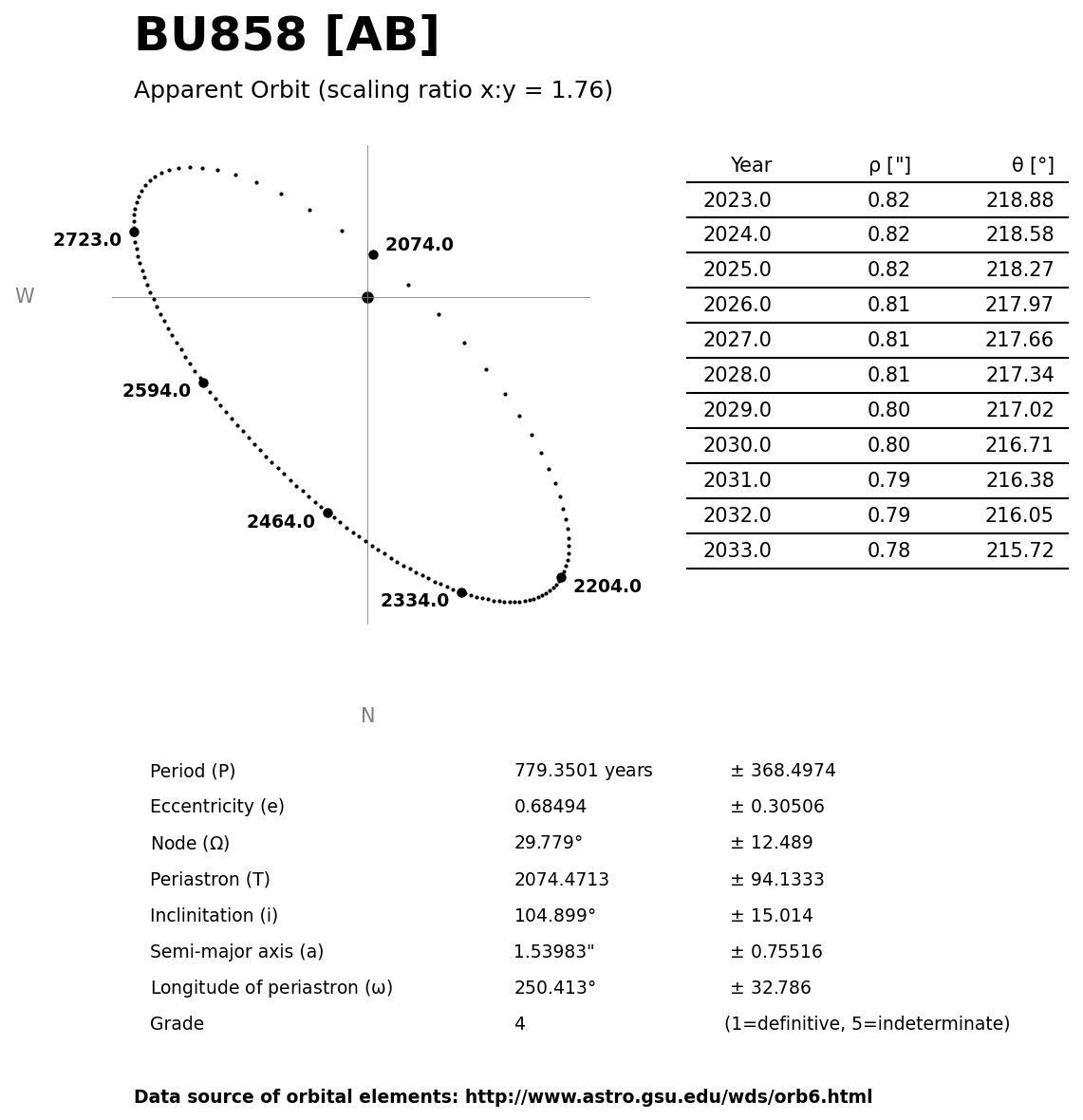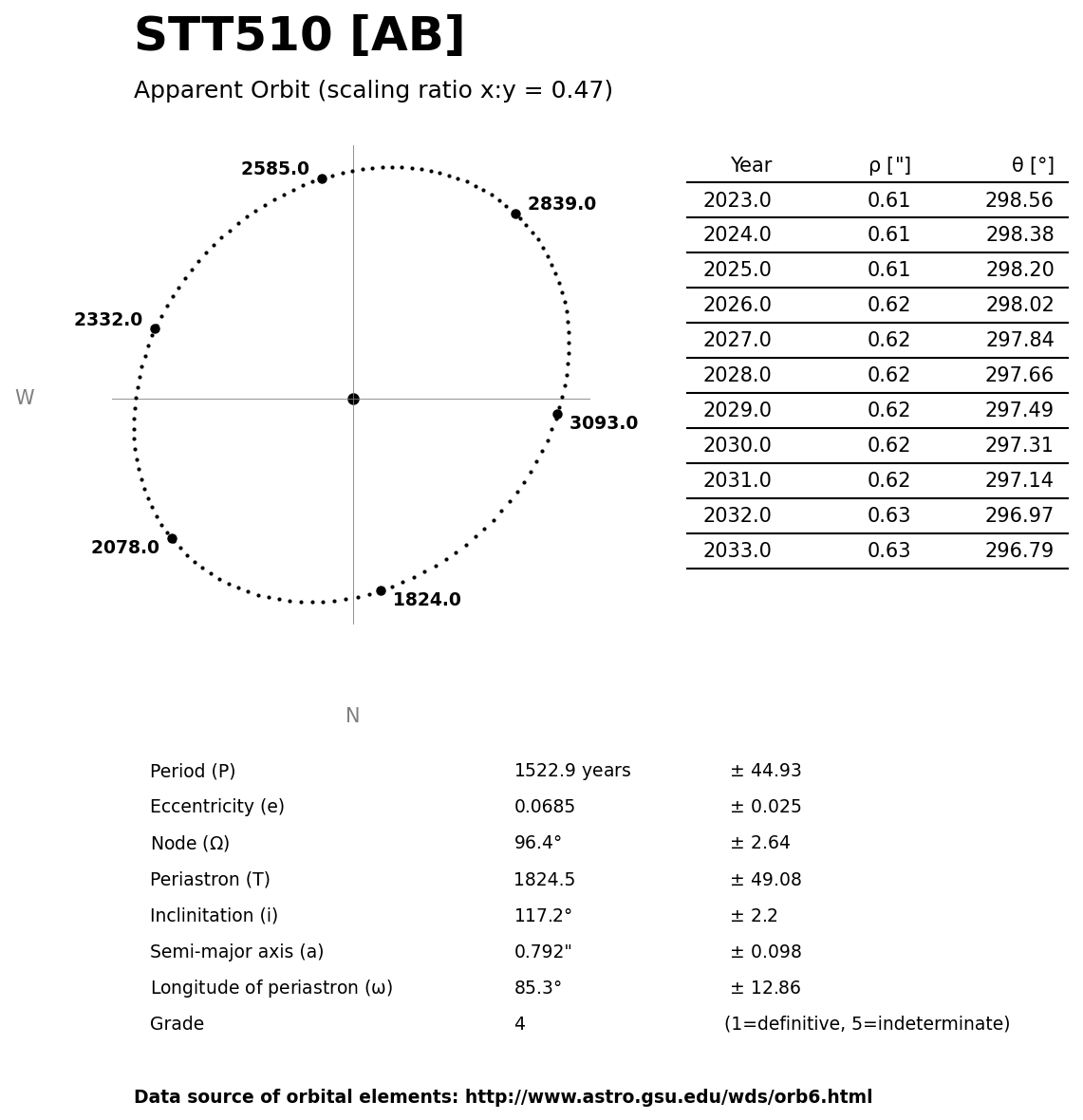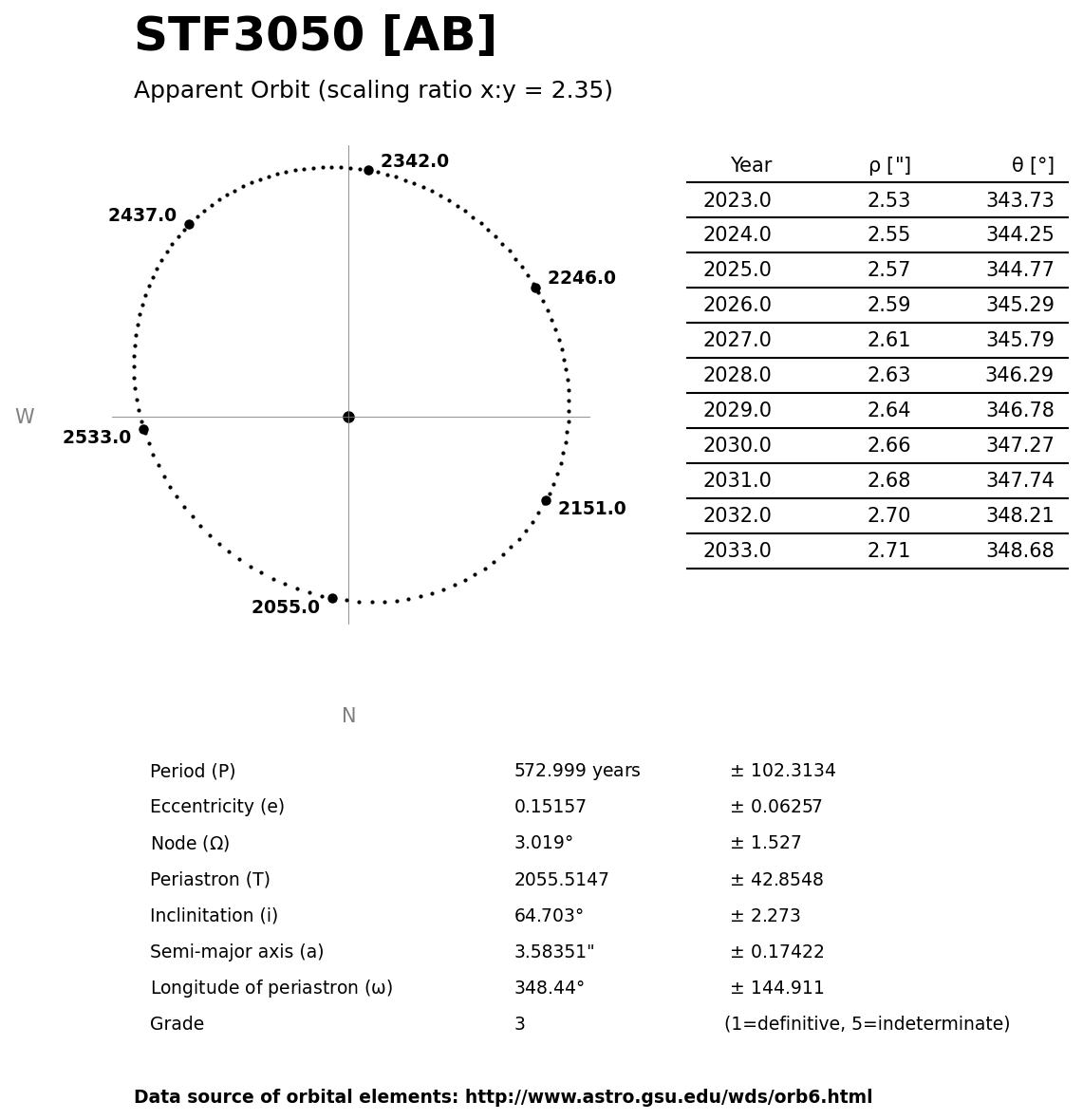|
m1 |
m2 |
ρ |
θ |
Jahr |
|
Koordinaten (J2000.0) |
|
|
HO208 |
|
|
8m.2 |
9m.8 |
1.1" |
186° |
2016 |
Peg |
00h01m29.19s / +30°44'08.70" |
|
|
Mark McCarthy
Fremont (California/USA) |
508mm (333x) |
Light orange stars, split with 333x. WDS calls it physical and even provides an orbit with a 649-year period, but they do not share parallax ranges (-54%), in spite of a very close 154 AU weighted separation, 1.63/1.15 Msol, the radial velocity delta (15.51) greatly exceeds the escape velocity (6.18) -- so these are not gravitational |
|
|
|
|
BU733, 85 Peg |
|
AB |
5m.8 |
8m.9 |
0.6" |
96° |
2017 |
Peg |
00h02m10.18s / +27°04'55.60" |
|
|
Mark McCarthy
Fremont (California/USA) |
508mm (667x) |
85 Peg. With apodising mask. Difficult, see a brightening with averted vision and foveal coaxing, but does show as faint star briefly. My PA is ENE, which is slightly incorrect. 26.28 year period, this one is widening for apastron in 2035 |
|
|
|
|
STF3056 |
|
AB |
7m.7 |
8m.1 |
0.7" |
142° |
2018 |
And |
00h04m40.09s / +34°15'54.70" |
|
|
|
|
AB-C |
7m.1 |
10m.1 |
26.3" |
4° |
2017 |
|
|
|
|
|
|
AB-D |
7m.1 |
10m.6 |
95.2" |
238° |
2020 |
|
|
|
|
|
|
CD |
10m.1 |
10m.6 |
113.1" |
227° |
2015 |
|
|
|
|
René Merting
Drachhausen (Germany) |
76mm (29x) |
AB-C: bei 29x ist nördlich von AB eine ganz schwache Komponente erkennbar, gut getrennt - AB wirkt leicht gelblich, C eher kupfer-grau |
|
Sarah Gebauer
Germany |
100mm (73x) |
die Komponenten AB erscheinen als ein Stern, C liegt nördlich davon und ist wesentlich schwächer und Komponente D, die ähnlich hell wie C erscheint, liegt westlich von AB gesehen |

|
René Merting
Drachhausen (Germany) |
320mm (45x) |
AB-C: bei 45x ist Komponente C im Norden gut abgesetzt von AB zu erkennen - Helligkeitsunterschied 2-3 Größenklassen - AB ist weiß-gelblich, C wirkt kupfer-grau |
|
|
|
|
STT547 |
|
AB |
9m.0 |
9m.2 |
5.9" |
191° |
2021 |
And |
00h05m41.03s / +45°48'43.30" |
|
|
René Merting
Drachhausen (Germany) |
100mm (32x) |
bei 64x klare Trennung - ein relativ schwaches Pärchen - zurück auf 32x stehen beide dichter zusammen und können knapp getrennt werden |
|
Uwe Pilz
Leipzig (Germany) |
105mm (144x) |
Der nahe gelegene ß997 konnte nicht getrennt werden |
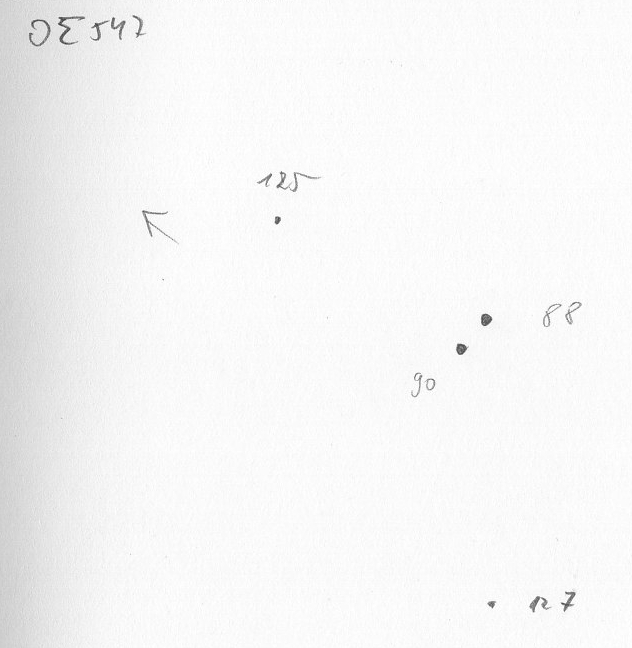
|
|
|
|
STF3060 |
|
AB |
9m.3 |
9m.7 |
3.4" |
136° |
2020 |
Peg |
00h05m55.56s / +18°04'34.40" |
|
|
Mark McCarthy
Fremont (California/USA) |
317mm (553x) |
Very close, ~3", equal brightness, pretty faint. |
|
Mark McCarthy
Fremont (California/USA) |
508mm (205x) |
Light orange stars, near equal, well split. [Spectral class F8 (yellow-white)]. WDS physical with a 3804-year period. There is 79% overlap of their parallax ranges, a very close 129 AU weighted separation, 0.75/0.71 Msol, and the radial velocity delta (0.69) is far less than the escape velocity (4.48). so these are gravitational |
|
|
|
|
STF3062, V640 Cas |
|
|
6m.4 |
7m.3 |
1.5" |
7° |
2020 |
Cas |
00h06m15.81s / +58°26'12.50" |
|
|
Robert Zebahl
Leipzig (Germany) |
152mm (129x) |
Schöner Anblick, klar getrennt, aber recht dicht beisammen mit sichtbarem Helligkeitsunterschied. |
|
Mark McCarthy
Fremont (California/USA) |
152mm (175x) |
: A nice double-double with STF 3057, near equal and closely split |
|
Axel Tute
Küssaberg (Germany) |
200mm (250x) |
12.10.2006: Bedingt durch eine relativ hohe Luftunruhe, war es nur zeitweise möglich zwei Komponenten im 8mm RKE (250x) zu beobachten. Am 26.10.2006 waren die Bedingungen besser und die beiden Komponenten waren immer deutlich sichtbar. Die Zeichnung stammt vom 26.10.2006. |
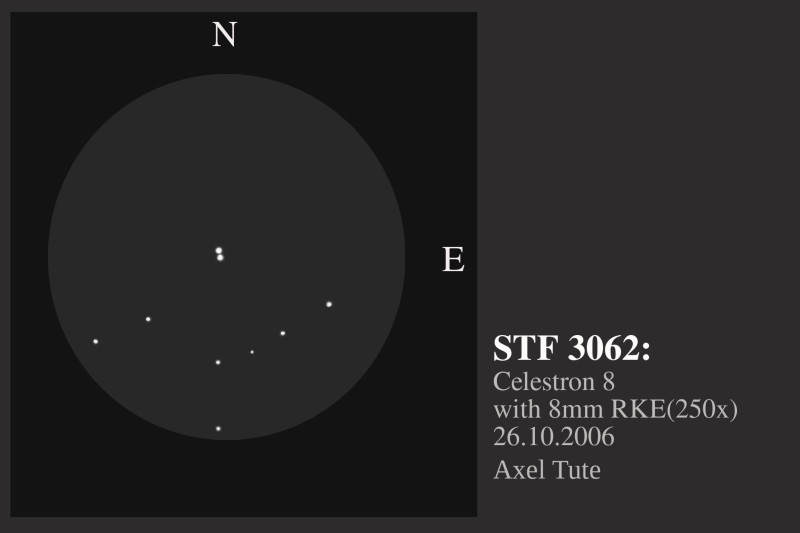
|
Frederik Wanink
Itterbeck (Germany) |
254mm (460x) |
leicht |

|
Mark McCarthy
Fremont (California/USA) |
317mm (277x) |
Light yellow and a more orange yellow B, 3-4", 1 delta mag. PC (70.07 L.Y.) |
|
René Merting
Drachhausen (Germany) |
320mm (320x) |
erst bei 320x ist Komponente B knapp getrennt nördlich von A zu erkennen - beide Sterne sind relativ hell und haben relativ große Beugungsscheibchen, so dass die Trennung nur knapp zu sehen ist - nicht wirklich schön, wenn man in den Nächten vorher mit einem Refraktor Doppelsterne beobachtet hat |
|
|
|
★
|
STF2 |
|
|
6m.7 |
6m.9 |
0.9" |
15° |
2019 |
Cep |
00h09m20.18s / +79°42'52.40" |
|
|
Uwe Pilz
Leipzig (Germany) |
105mm (198x) |
Schneemann-Figur. Abstand 0“91 |

|
Mark McCarthy
Fremont (California/USA) |
152mm (175x) |
Light orange stars, very tight, hairline split, near equal mag. Physical with a 540-year period it is to slowly widen. 22% parallax overlap, only 82 AU weighted separation, 2.16/2.10 solar mass |
|
Frederik Wanink
Itterbeck (Germany) |
254mm (640x) |
getrennt |

|
|
|
|
BU1026 |
|
AB |
7m.2 |
8m.5 |
0.4" |
325° |
2018 |
Cas |
00h12m08.05s / +53°37'26.10" |
|
|
Mark McCarthy
Fremont (California/USA) |
508mm (533x) |
Split with seeing, 2 delta mag, fairly difficult, PA WNW. Currently 0.345" it will tighten and have a northerly PA by 2040 |
|
|
|
★
|
STF13 |
|
|
7m.0 |
7m.1 |
1.0" |
49° |
2018 |
Cep |
00h16m14.02s / +76°57'03.00" |
|
|
Mark McCarthy
Fremont (California/USA) |
152mm (175x) |
Equal white stars, hairline split. Nice! Physical with a 1245-year period. 69% parallax range overlap, 173 AU weighted separation, 2.63/2.47 Msol |
|
|
|
★
|
AC1 |
|
|
7m.3 |
8m.3 |
1.9" |
291° |
2020 |
And |
00h20m54.10s / +32°58'40.90" |
|
|
Robert Zebahl
Leipzig (Germany) |
102mm (125x) |
Sehr schön, relativ dicht bei deutlich sichtbarem Helligkeitsunterschied. In unmittelbarer Nähe strahlt ein hellerer Stern in einem schönen Orange. Sehr schöner Kontrast! |
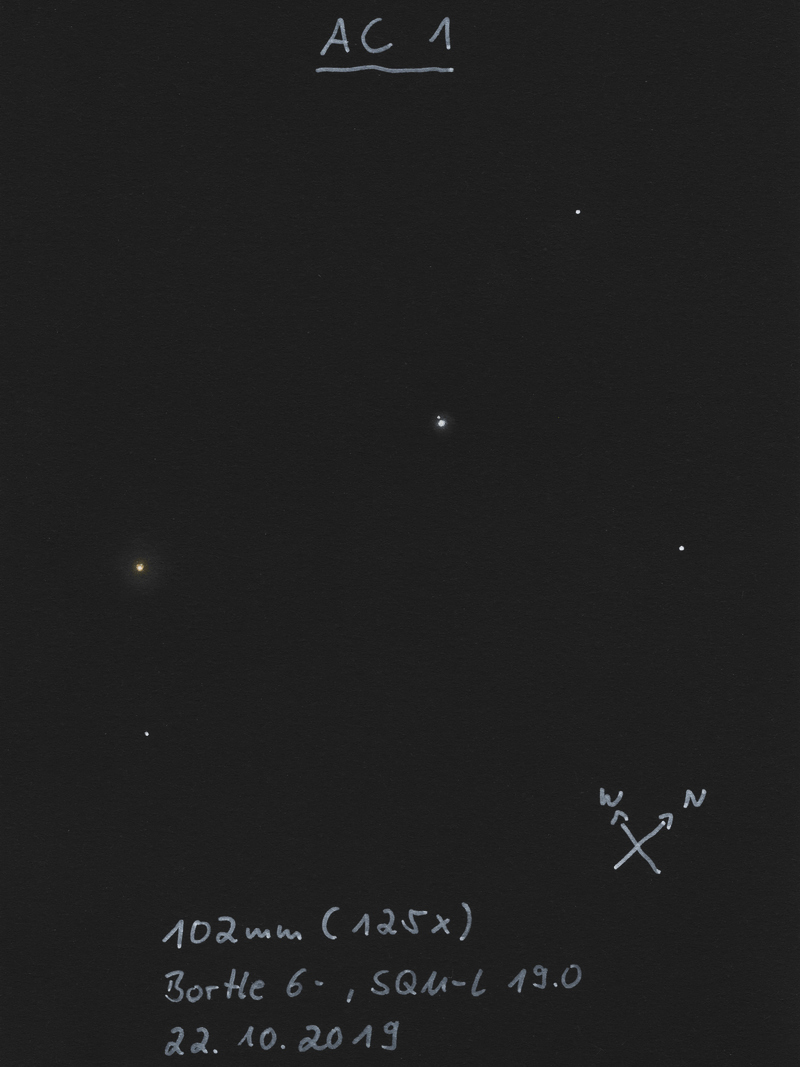
|
Uwe Pilz
Leipzig (Germany) |
105mm (200x) |
orange. Leuchtend gelber Stern in 5' Abstand |
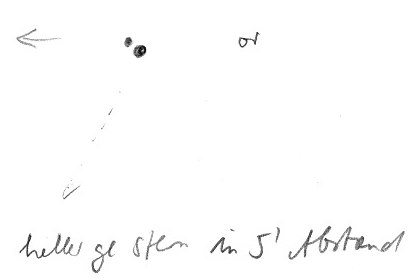
|
Mark McCarthy
Fremont (California/USA) |
152mm (175x) |
Around half a delta mag, nice and close split. Physical with a 525-year period. At apastron |
|
|
|
★
|
BU394 |
|
AB |
8m.5 |
8m.8 |
0.8" |
278° |
2018 |
Cas |
00h30m45.56s / +47°31'47.50" |
|
|
Mark McCarthy
Fremont (California/USA) |
317mm (553x) |
Very fine, pop split with seeing, near equal. |
|
|
|
|
STT12, lam Cas |
|
|
5m.3 |
5m.6 |
0.1" |
220° |
2019 |
Cas |
00h31m46.32s / +54°31'20.30" |
|
|
Mark McCarthy
Fremont (California/USA) |
317mm (553x) |
Lambda Cas: Maybe out of round? Marginal |
|
Mark McCarthy
Fremont (California/USA) |
508mm (667x) |
Lam Cas. Very bright, through the speckle pattern I can see elongation with subtle notch with B maybe to the west? [Correct!] Two other stars in field. Short period, 245 year period but it's whipping around A at the moment, 0.112" now, will make a quarter turn by 2037 but still be nearly the same impossible separation. |
|
|
|
|
VYS2, V547 Cas |
|
AB |
10m.6 |
12m.2 |
3.5" |
186° |
2020 |
Cas |
00h32m29.43s / +67°14'08.80" |
|
|
Mark McCarthy
Fremont (California/USA) |
508mm (333x) |
V547 Cas. Faint, very fine pair, seen at 205x and had a better look at 333x. Wide, ~4" slightly reddish faint stars. SkyTools brought this up as a short period pair, however it won't make a significant change in my time. It turns out A is also a pair, MCY 1 Aa-Ab, 10.8/12.5 0.5" with a period of only 15.59 years -- discovered by one D.W. McCarthy (no relation!) in 1989 during the first results of the Steward Observatory Infrared Speckle Camera using their 2.3 meter telescope. The Ab star has a mass of only 0.18 of the sun. I think it is gettable visually with the Challenger on a good transparent night, or with the Lick Great Refractor if I ever have the good fortune to observe with it |
|
|
|
★★
|
eta Cas, 24 Cas |
STF60 |
AB |
3m.5 |
7m.4 |
13.6" |
326° |
2020 |
Cas |
00h49m06.29s / +57°48'54.70" |
|
|
|
STF60 |
AC |
3m.5 |
11m.4 |
225.0" |
260° |
2000 |
|
|
|
|
|
STF60 |
AD |
3m.5 |
12m.8 |
189.4" |
354° |
2011 |
|
|
|
|
|
STF60 |
AE |
3m.5 |
10m.2 |
75.6" |
126° |
2015 |
|
|
|
|
|
STF60 |
AF |
3m.5 |
11m.5 |
378.3" |
276° |
2000 |
|
|
|
|
|
STF60 |
AG |
3m.5 |
9m.5 |
419.7" |
259° |
2012 |
|
|
|
|
|
STF60 |
AH |
3m.5 |
8m.4 |
701.1" |
355° |
2012 |
|
|
|
|
|
SMR2 |
AI |
3m.5 |
11m.6 |
90.3" |
73° |
2012 |
|
|
|
|
|
SMR2 |
AJ |
3m.5 |
12m.3 |
237.1" |
262° |
2012 |
|
|
|
|
Robert Zebahl
Leipzig (Germany) |
70mm (57x) |
AB: Einfach trennbar bei großem Helligkeitsunterschied. Schwächere Komponente tief orange bis leicht rötlich, hellere Komponente eher leicht gelblich. |
|
René Merting
Drachhausen (Germany) |
76mm (29x) |
AB: Mondscheinbeobachtung - bei 29x zeigt sich Komponente A in einem schönen hellen und doch intensiven Gelb - Komponente B ist knapp getrennt nordwestlich von A erkennbar, das wirkt aber noch nicht richtig souverän - riesiger, nicht abschätzbarer Helligkeitsunterschied - B wirkt kupferbraun, manchmal auch nur grau - bei 57x sind beide Sterne etwas mehr als knapp getrennt zu erkennen und das kupferbraun bei B setzt sich durch |
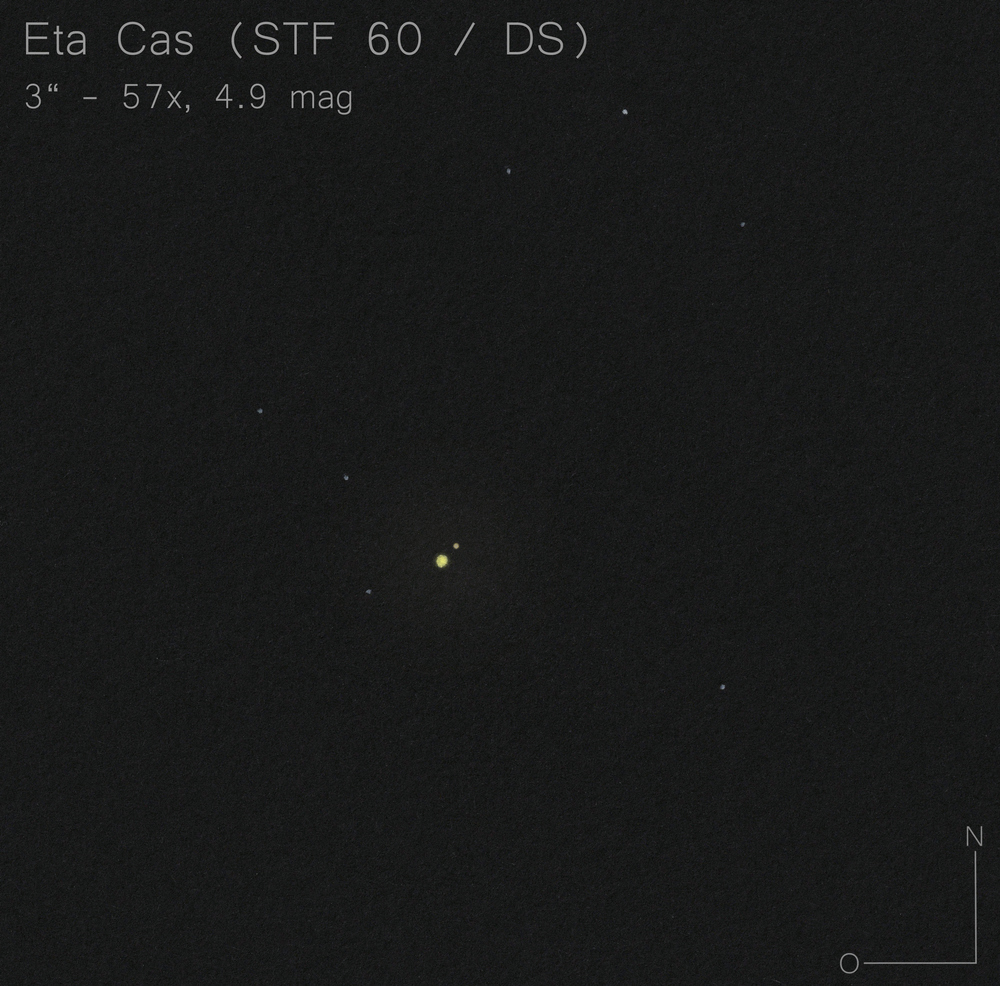
|
René Merting
Drachhausen (Germany) |
100mm (32x) |
AB: bei 32x ist Komponente A so hell, dass B trotz des augenscheinlich großen Abstandes von 13,4" nur knapp getrennt zu sehen ist - Komponente A ist gleißend hell-gelb, B dürfte mindestens 3 Größenklassen schwächer sein und wirkt dadurch dumpfer |
|
Sarah Gebauer
Germany |
100mm (49x) |
AB: bei 49-fach schmal und schön getrennt - so ein starker, warmgoldener Farbton, der richtig leuchtkräftig ist, ein echter Blickfang - der Begleiter zeigt eine ähnliche Farbe, aber doch matter und bräunlicher |
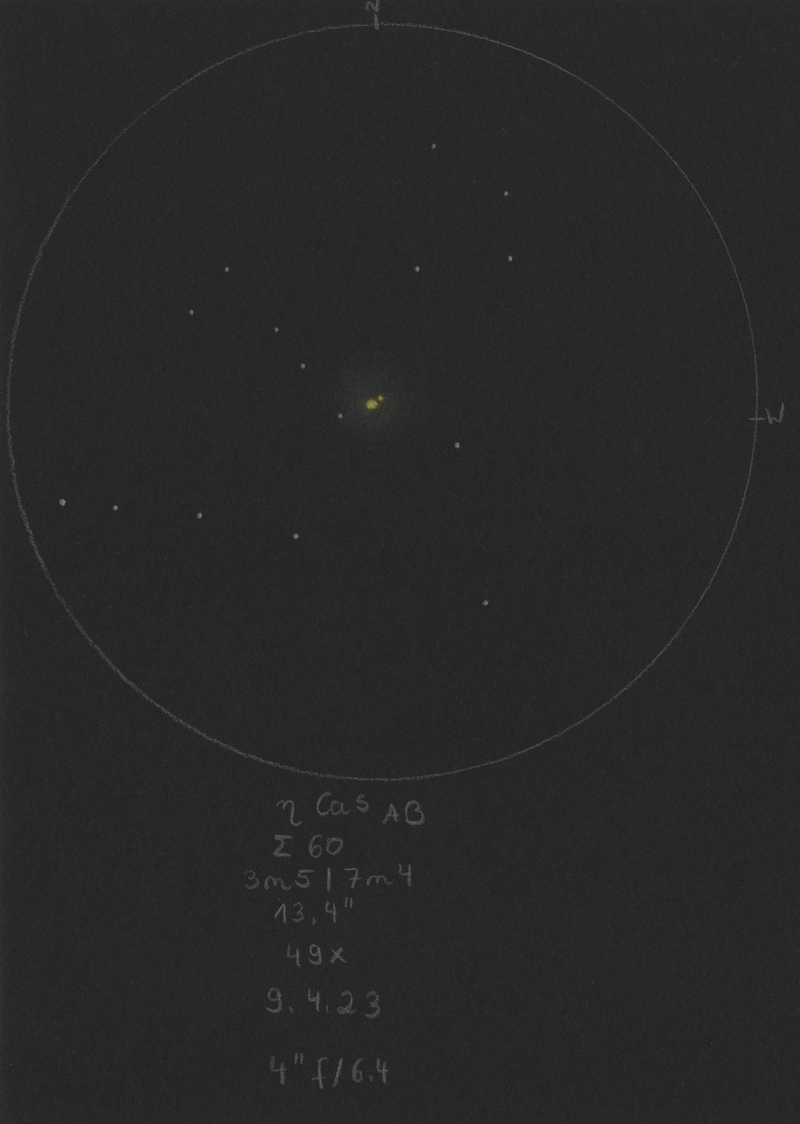
|
Uwe Pilz
Leipzig (Germany) |
105mm (53x) |
AB: leicht |
|
Uwe Pilz
Leipzig (Germany) |
105mm (288x) |
kein Sternentstehungsgebiet! |

|
Sarah Gebauer
Germany |
150mm (54x) |
AB: bei 54x erst nur einen Stern gesehen, doch da, ganz schwach darunter doch die wesentlich schwächere, zweite Komponente entdeckt |
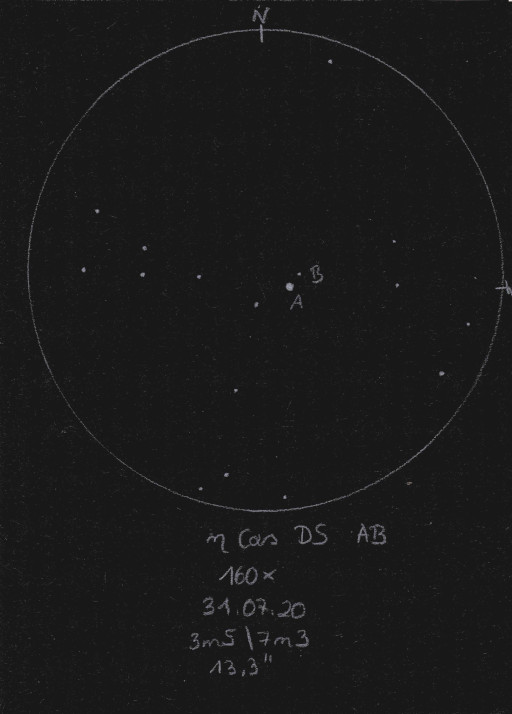
|
Robert Zebahl
Leipzig (Germany) |
152mm (30x) |
AB: 11.09.2021: Hellgelb & rot-bräunlich. |
|
Winfried Kräling
Marburg (Germany) |
152mm (175x) |
|
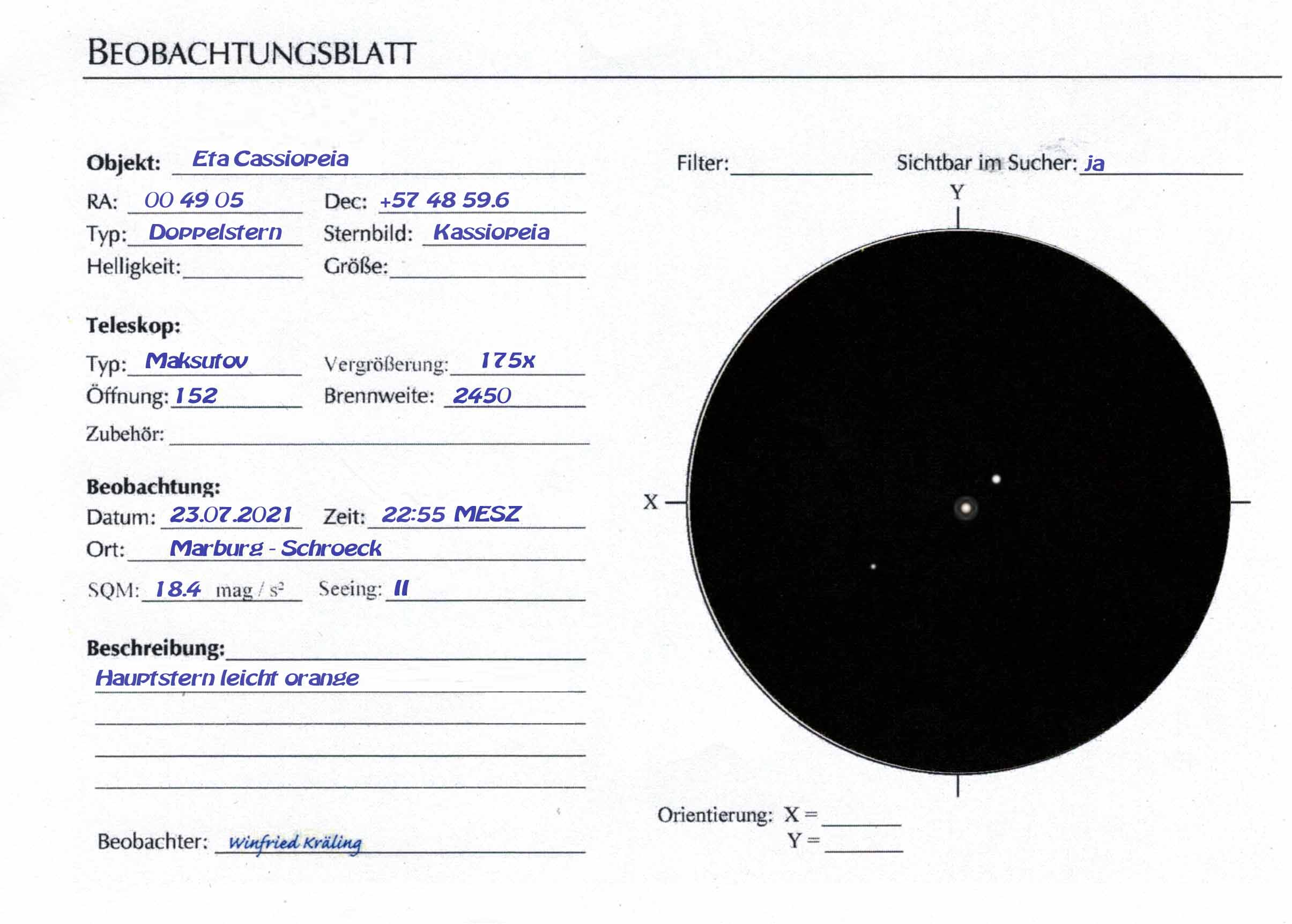
|
Axel Tute
Küssaberg (Germany) |
200mm (77x) |
AB: 30.10.2006: Einfach zu trennen im C8 mit dem 26mm Plössl Okular. A ist bläulich. B ist rötlich. PA geschätzt 300°. |
|
Mark McCarthy
Fremont (California/USA) |
317mm (553x) |
AB: Nice yellow pair. A is a red tainted yellow, B is cleaner. |
|
René Merting
Drachhausen (Germany) |
320mm (72x) |
AB: bei 72x ein echt fetter Farbkontrast, Komponente A ist gleißend hell und zitronengelb, B zeigt sich knallig orange - beide Sterne sind gut getrennt voneinander zu beobachten - sehenswert |
|
|
|
★
|
BU232 |
|
AB |
8m.5 |
8m.8 |
0.9" |
256° |
2018 |
Cas |
00h50m25.10s / +50°37'49.60" |
|
|
|
|
AB-C |
8m.5 |
10m.1 |
24.5" |
299° |
2018 |
|
|
|
|
Mark McCarthy
Fremont (California/USA) |
203mm (533x) |
AB: Nice, well split, near equal. Part of a triple, the next one much wider in same PA and two delta mag. [AB-C is 10.06 24.5"] |
|
Mark McCarthy
Fremont (California/USA) |
317mm (553x) |
AB: Neat near equal orange and yellow. Split with seeing, 1". |
|
Mark McCarthy
Fremont (California/USA) |
317mm (553x) |
AB-C: C 2 delta mag fainter than B, about 25" separated, is the +1 star with BU232AB |
|
|
|
|
BU1099 |
|
AB |
6m.1 |
6m.6 |
0.2" |
9° |
2010 |
Cas |
00h56m46.94s / +60°21'46.30" |
|
|
Mark McCarthy
Fremont (California/USA) |
508mm (889x) |
Obvious elongation but no notching, PA seems NNE, in a lot of diffraction. 83.1-year period, currently 0.157", it will make more than a quarter turn and widen to 0.2" by 2038. Burnham discovered in 1889 with the Lick 36-inch at 0.2" and says it's a "close and difficult" pair |
|
|
|
|
HLD4 |
|
|
9m.0 |
9m.5 |
0.4" |
50° |
2016 |
Cas |
00h57m35.79s / +54°23'44.80" |
|
|
Mark McCarthy
Fremont (California/USA) |
508mm (533x) |
Yellowish stars, nicely split, a near equal. [this pair is widening, will get a little easier, was 1" at discovery in 1881 -- Holden, Lick director.] |
|
|
|
|
STF79, 164 And |
|
|
6m.0 |
6m.8 |
7.9" |
194° |
2018 |
And |
01h00m03.56s / +44°42'47.70" |
Robert Zebahl
Leipzig (Germany) |
55mm (25x) |
Schöner Doppelstern, relativ dicht zusammen mit sichtbarem Helligkeitsunterschied. |
|
René Merting
Drachhausen (Germany) |
320mm (45x) |
ein wunderschöner Doppelstern für 45x - im Umfeld fallen zwei relativ helle Sterne sehr dicht stehend auf - B ist eine halbe Magnitude schwächer und strahlt zwar auch weiß wie A, aber etwas schmutziger |
|
Mark McCarthy
Fremont (California/USA) |
508mm (205x) |
164 And. Dual white headlights, slight mag difference. Physical |
|
|
|
★
|
MAD1 |
|
|
7m.7 |
9m.1 |
0.9" |
0° |
2020 |
And |
01h00m35.58s / +47°19'14.60" |
|
|
Mark McCarthy
Fremont (California/USA) |
508mm (533x) |
Exceptionally fine split with 333x, obvious with 533x, getting really nice airy disks. ~2 delta mag, <1", pale yellow A and very light green B. Physical pair with a 925 year period. |
|
|
|
★
|
A2901 |
|
|
7m.1 |
7m.8 |
0.4" |
64° |
2018 |
Cas |
01h01m30.15s / +69°21'30.70" |
|
|
Mark McCarthy
Fremont (California/USA) |
152mm (285x) |
Seems a very subtle out of round, but not certain. Physical with a 1517-year orbit, will not significantly widen in my lifetime. Discovered at 0.2", 0.4" now. No Gaia data |
|
Mark McCarthy
Fremont (California/USA) |
317mm (885x) |
Elongated to notched with seeing |
|
|
|
|
STT21 |
|
|
6m.8 |
8m.1 |
1.3" |
176° |
2020 |
And |
01h03m01.54s / +47°22'34.10" |
|
|
Robert Zebahl
Leipzig (Germany) |
102mm (160x) |
02.11.2020: Der Doppelstern erscheint klar länglich, aber ohne erkennbare Einkerbung. |
|
Uwe Pilz
Leipzig (Germany) |
120mm (180x) |
weiß |

|
Mark McCarthy
Fremont (California/USA) |
508mm (333x) |
Nice pale yellow bright stars, ~2 delta mag, needed 333x clearly resolve, ~1". Physical pair with 450 year period |
|
|
|
|
STT515, phi And, 42 And |
|
AB |
4m.6 |
5m.6 |
0.5" |
114° |
2021 |
And |
01h09m30.12s / +47°14'30.60" |
|
|
Robert Zebahl
Leipzig (Germany) |
102mm (280x) |
04.11.2020: Seeing 3-4/5; In keinster Weise trennbar oder als Doppelstern erkennbar. |
|
Uwe Pilz
Leipzig (Germany) |
120mm (180x) |
|

|
Robert Zebahl
Leipzig (Germany) |
152mm (300x) |
06.11.2020: Seeing 3/5; Nicht als Doppelstern erkennbar. |
|
Mark McCarthy
Fremont (California/USA) |
508mm (677x) |
Phi And. I get elongation in the speckle matter, but no better resolution. Bright 0.52" pair |
|
|
|
★
|
BU235 |
|
Aa-Ab |
7m.5 |
7m.8 |
0.8" |
142° |
2018 |
Cas |
01h10m34.31s / +51°00'47.80" |
|
|
Frederik Wanink
Itterbeck (Germany) |
254mm (640x) |
Mehrfachsystem |
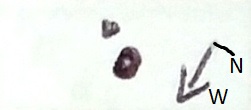
|
Mark McCarthy
Fremont (California/USA) |
508mm (333x) |
Amazing system with five faint pairings, but the main attraction is Aa-Ab, near equal bright A, hairline at 205x and and a nice clean split at 333x, light yellow stars, slight magnitude difference. Seeing giving me nice round disks. Terrific. Physical pair with a 278 year period. Amazingly, Burnham discovered this with his 6-inch |
|
|
|
|
STT28 & STTA14 & BU1359 |
STT28 |
AB |
7m.5 |
8m.8 |
0.9" |
296° |
2006 |
Cep |
01h19m07.19s / +80°51'42.60" |
|
|
|
STTA14 |
AB-C |
7m.6 |
6m.7 |
127.6" |
24° |
2003 |
|
|
|
|
|
BU1359 |
CD |
6m.7 |
11m.6 |
70.2" |
154° |
2015 |
|
|
|
|
Christopher Hay
Seeheim (Germany) |
7x45 |
STTA14 (AB-C): Handgehalten. AB-C deutlich getrennt. |
|
Christopher Hay
Seeheim (Germany) |
10x42 |
STTA14 (AB-C): AB-C: Beim Herumschwenken auf der Suche nach S405 ist STTA14 sofort als Doppelstern auffällig, weit getrennt. |
|
Christopher Hay
Seeheim (Germany) |
15x60 |
STTA14 (AB-C): AB-C: Weites Paar, starke Präsenz in 3,3° Gesichtsfeld. Nördliche Komponente (C) deutlich heller. Schönes Sterndreieck 1,5° südlich. |
|
Christopher Hay
Seeheim (Germany) |
180mm (200x) |
STT28 (AB): AB: Blickweise blitzt der Begleiter auf. Ohne vorheriges Wissen Positionswinkel auf 295° geschätzt.
Ein physikalischer Doppelstern in 510 Lichtjahren Abstand zu uns. Beobachtet 1. März 2021, aktueller Winkelabstand 0,846" laut Stelledoppie. |
|
|
|
|
BU4 |
|
AB |
7m.1 |
8m.9 |
0.6" |
114° |
2018 |
Psc |
01h21m19.23s / +11°32'12.30" |
|
|
Mark McCarthy
Fremont (California/USA) |
152mm (175x) |
Very subtle out of roundness. There is another very faint wide B (AC, 7.12/13.60 29.3"). Discovered at 0.5" with his 6-inch, so Burnham must have had a great night. WDS says physical, but not Gaia data on the primary |
|
|
|
★
|
STF115 |
|
AB |
7m.1 |
7m.3 |
0.5" |
156° |
2020 |
Cas |
01h23m21.27s / +58°08'35.60" |
|
|
Mark McCarthy
Fremont (California/USA) |
317mm (553x) |
Peanut, near equal. in nearly the same FOV with Detla Cas, V 465 pretty orange star, and NGC 457, a loose moderately rich open cluster |
|
Mark McCarthy
Fremont (California/USA) |
508mm (533x) |
Wonderful split, more than hairline, white stars, near equal. Nice airy disks. Physical with 222 year period, Struve discovered at 0.7" approaching apastron |
|
|
|
|
V773 Cas |
BU870 |
AB |
6m.3 |
8m.7 |
0.6" |
332° |
2010 |
Cas |
01h44m17.96s / +57°32'11.80" |
|
|
|
GUI2 |
AC |
6m.3 |
16m.0 |
18.3" |
57° |
2015 |
|
|
|
|
|
ARN55 |
AD |
6m.3 |
9m.9 |
160.5" |
45° |
2003 |
|
|
|
|
Mark McCarthy
Fremont (California/USA) |
317mm (553x) |
AD: Very wide separation 1 delta mag. physical double. This is the AD pair of a more complicated system. AB = V773 Cas = BU 870 which is 6.29/8.68 0.3", AC = GUI 2, 6.29/16.00 16.8". |
|
Mark McCarthy
Fremont (California/USA) |
317mm (553x) |
AD: Picking up a pinpoint in A's diffraction, very faint with seeing, <1", 3-4 delta mag, white. Marginal. |
|
Mark McCarthy
Fremont (California/USA) |
508mm (1067x) |
AB: Elongated at 667x, with 1067x it is a clear elongation with the B star sticking out like a stump, but not notched. It is now near periastron, and will widen rapidly to 0.448" by 2030. 184.9 year period. Need to go back and make a sketch, since it will be on the opposite side of the A star in 2030 |
|
|
|
|
STF158 |
|
AB |
9m.0 |
9m.4 |
2.2" |
271° |
2018 |
Tri |
01h46m44.07s / +33°09'45.50" |
|
|
Mark McCarthy
Fremont (California/USA) |
203mm (205x) |
Nice split, pretty wide considering low magnification. Orange-yellow stars about half delta mag |
|
Karsten Kopp
Köln (Germany) |
600mm (180x) |
Doppelstern noch gut zu trennen. Der Helligkeitsunterschied beträgt knapp eine Magnitude und der etwas hellere Stern leuchtet gelblich und der schwächere orange gelb. |
|
|
|
|
HO311 |
|
|
8m.2 |
7m.8 |
0.4" |
178° |
2018 |
Ari |
01h51m13.34s / +24°39'08.00" |
|
|
Mark McCarthy
Fremont (California/USA) |
508mm (1067x) |
Nice clear split with seeing, more near equal but there is a noticeable magnitude difference, white stars |
|
|
|
|
BU260 |
|
|
8m.8 |
9m.0 |
1.1" |
260° |
2018 |
Ari |
01h53m14.21s / +15°26'00.30" |
|
|
Mark McCarthy
Fremont (California/USA) |
203mm (533x) |
Fine pair, well split, half delta mag |
|
|
|
|
STF183 |
|
AB |
7m.7 |
10m.0 |
0.3" |
142° |
2013 |
Tri |
01h55m07.39s / +28°47'52.60" |
|
|
|
|
AB-C |
7m.7 |
9m.3 |
5.6" |
162° |
2018 |
|
|
|
|
Sarah Gebauer
Germany |
100mm (73x) |
AB-C: die schwächere Komponente wurde erst auf den zweiten Blick sichtbar, eine reizvolle Konzentrationsübung |
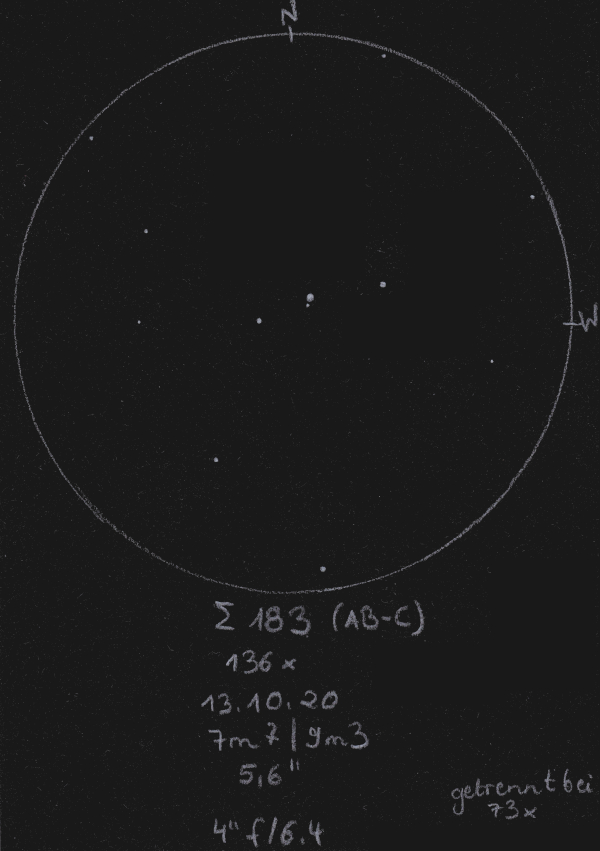
|
René Merting
Drachhausen (Germany) |
320mm (103x) |
AB-C: bei 103x ist die B-Komponente etwas mehr als knapp getrennt südlich von A erkennbar - Helligkeitsunterschied 1.5 Magnituden - A ist warmweiß bis hellgelb, B weißgrau |
|
|
|
|
BU513, 48 Cas |
|
AB |
4m.7 |
6m.7 |
0.6" |
320° |
2013 |
Cas |
02h01m57.55s / +70°54'25.40" |
|
|
Mark McCarthy
Fremont (California/USA) |
152mm (285x) |
Overlapping disks at all powers, 1 delta mag. Burnham says: "This most interesting binary was discovered with the 18.5-inch, but at that time it was easily seen with the 6-inch. It is now (1898) a very difficult object, and only measurable with a large aperture under the best conditions." 1.0" at discovery, it is now 0.4" and found to have a 61.14-year period and will continue to tighten until the 2040s. I don't find Gaia data on the secondary |
|
Mark McCarthy
Fremont (California/USA) |
317mm (553x) |
Searched around the swollen, shimmering bright A star disk and felt there was a faint close B trying to resolve in the first diffraction at 553x. Apodizing mask cleaned up the image but no B resolved |
|
|
|
|
alpha Psc, 113 Psc, Alrischa, Kaitain, Okda |
STF202 |
AB |
4m.1 |
5m.2 |
1.9" |
264° |
2019 |
Psc |
02h02m02.80s / +02°45'49.40" |
|
|
|
PWL1 |
AC |
4m.1 |
8m.2 |
404.9" |
63° |
2006 |
|
|
|
|
|
PWL1 |
AD |
4m.1 |
8m.6 |
434.5" |
335° |
2006 |
|
|
|
|
Winfried Kräling
Marburg (Germany) |
102mm (178x) |
AB |
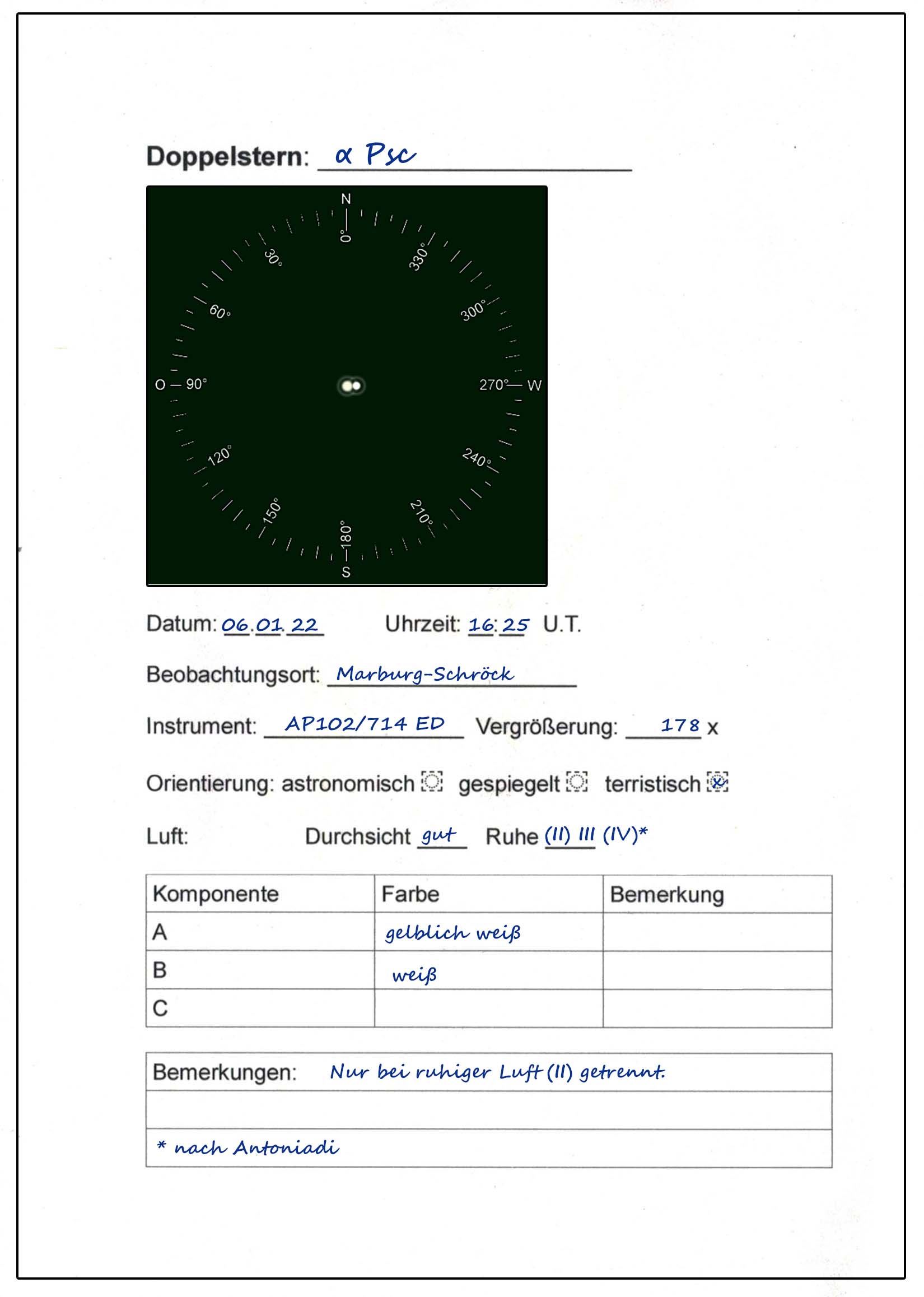
|
Uwe Pilz
Leipzig (Germany) |
105mm (88x) |
AB: der hellere Stern ist weiß |

|
|
|
★
|
STF208, 10 Ari |
|
AB |
5m.8 |
7m.9 |
1.3" |
349° |
2018 |
Ari |
02h03m39.26s / +25°56'07.60" |
|
|
Uwe Pilz
Leipzig (Germany) |
105mm (200x) |
helle Stelle im ersten Ring |
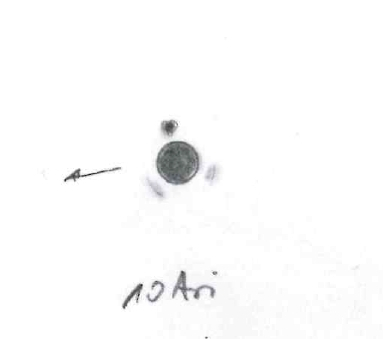
|
Mark McCarthy
Fremont (California/USA) |
317mm (553x) |
~2 delta mag, ~1" very nice. ~1 disk split. Nice! |
|
|
|
★★★
|
gamma And, 57 And, Alamak |
STF205 |
A-BC |
2m.3 |
5m.0 |
9.5" |
63° |
2021 |
And |
02h03m53.92s / +42°19'47.50" |
|
|
|
BAR22 |
AD |
2m.3 |
15m.0 |
27.9" |
245° |
1898 |
|
|
|
|
|
STT38 |
BC |
5m.3 |
6m.5 |
0.3" |
120° |
2021 |
|
|
|
|
Robert Zebahl
Leipzig (Germany) |
63mm (42x) |
A-BC: Einfach trennbar bei recht großem Helligkeitsunterschied. |
|
Christopher Hay
Seeheim (Germany) |
71mm (32x) |
Fein getrennt. Hauptkomponente A ist mandarinorange. Begleiter BC hat Schwierigkeiten, Farbigkeit zu zeigen wegen Überstrahlung, ist aber blickweise klar blau.
A-BC ist ein physikalischer Doppelstern in 393 Lichtjahren Abstand zu uns.
BC ist ebenfalls physikalisch, mit einer relativ schnellen Periode von 63 Jahren für einen Umlauf von C um B und sehr engem Periastron. In 2013 unbeobachtbar im Periastron mit weniger als 0.1" Abstand. Seitdem weitet sich der Abstand rapide und erreicht 0,4" in 2029. B-C wird dann 30 Jahre lang mit Amateurmitteln beobachtbar bis C wieder schnell auf B zustürzt. |
|
René Merting
Drachhausen (Germany) |
76mm (29x) |
A-BC: bei 29x äußerst knapp getrennt - Komponente A strahlt buttergelb, BC schmiegt sich im Nordosten an |
|
Uwe Pilz
Leipzig (Germany) |
105mm (52x) |
A-BC: einfach |
|
Uwe Pilz
Leipzig (Germany) |
120mm (128x) |
A-BC |

|
Robert Zebahl
Leipzig (Germany) |
152mm (100x) |
A-BC: Sehr einfach. A: orange, BC: eher weiß. |
|
Christopher Hay
Seeheim (Germany) |
180mm (110x) |
Ein mächtiges Paar in 0,6° Gesichtsfeld mit heftigem Farbkontrast, A gelb, BC eisblau. |
|
Sarah Gebauer
Germany |
254mm (96x) |
A-BC: in Dänemark als Startstern für die Suche nach der Galaxie NGC 891 gewählt und ohne Vorwissen spontan als sehr schönen Doppelstern erkannt: die Hauptkomponente strahlt richtig schön goldgelb, der Begleiter nordöstlich davon ist richtiggehend reinweiß und klein, wirklich toll! |
|
René Merting
Drachhausen (Germany) |
320mm (45x) |
A-BC: bei 45x ein knapp getrenntes Pärchen - Komponente A knallgelb mit einem Anhängsel nordöstlich - Komponente BC strahlt 3 Größenklassen schwächer - bei 144x wirkt BC grün-weiß, bei 45x war der Eindruck noch leicht gelblich |
|
Mark McCarthy
Fremont (California/USA) |
508mm (667x) |
BC: Component of STF 205, of which A is a brilliant orange and BC bright blue. In BC I can only see elongation through the speckle at 667x and 1067x. Short 62.63 year period which will get "easier" to about 0.2" by 2045 |
|
Mark McCarthy
Fremont (California/USA) |
508mm (1067x) |
BC: I spent a good long while on this one, and tried hard to nail down the position angle. At 1067x, both with and without an apodising mask, but both times with a #80A light blue filter, which did seem to calm the diffraction a little, I had a clear view of the elongation with a strong sense of the weaker end being to the East or to the ESE. I also tried a 78% central obstruction mask, and while the diffraction became a grid, and the disks much smaller, I could clearly see the same elongation and weaker end, though at a much smaller scale. To my delight the current orbital solution puts the PA at 120.6-degrees, 0.179" separation, so I think I have detected it. I can't wait until 2033 when this becomes an easy pair! |
|
|
Winfried Kräling
Marburg (Germany) |
127mm |
A-BC: Aufnahme vom 11.09.2020 am 127/1200mm Refraktor mit Barlowlinse (~2.5x)
Weit getrennt, Komponente A: goldgelb bis orange, Komponente BC: weißlich blau |

|
Werner E. Celnik
Rheinberg (Germany) |
150mm |
A-BC |
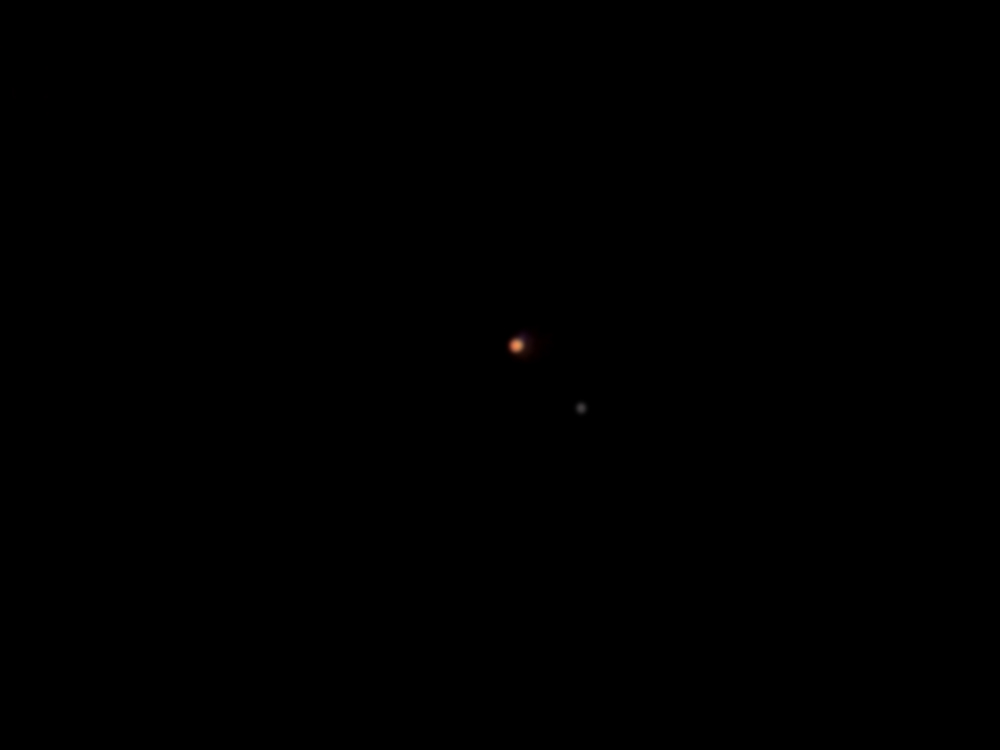
|
|
|
★★★
|
STF227, iota Tri, 6 Tri |
|
|
5m.3 |
6m.7 |
4.0" |
68° |
2019 |
Tri |
02h12m22.28s / +30°18'11.10" |
|
|
Robert Zebahl
Leipzig (Germany) |
70mm (57x) |
Bei 44x geradeso trennbar bei deutlichem Helligkeitsunterschied, wobei der Begleiter von der Hauptkomponente schon fast überstrahlt wird. Bei 57x einfach zu trennen. Hauptkomponente strahlt in hellem Orange, Begleiter leicht orangefarben. Wunderschöner Anblick zusammen mit STF232 in einem Gesichtsfeld! |
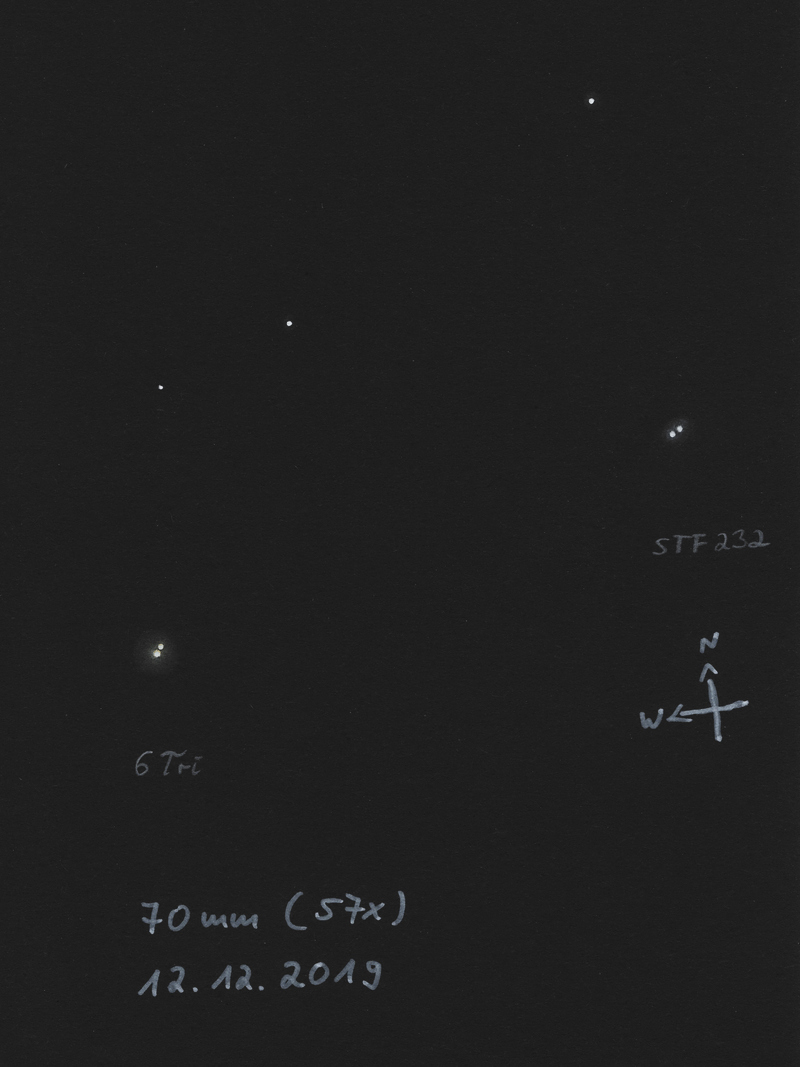
|
Sarah Gebauer
Germany |
100mm (80x) |
25.09.23: mit 49-fach ist dieser noch nicht getrennte Farbdoppelstern eindeutig die Kommandozentrale des imperialen TIE-Jägers - bei 80-fach zeigt die A-Komponente einen sehr dunklen, gelbgoldenen Farbton und die sehr dicht stehende B-Komponente einen weißgoldenen Farbton |
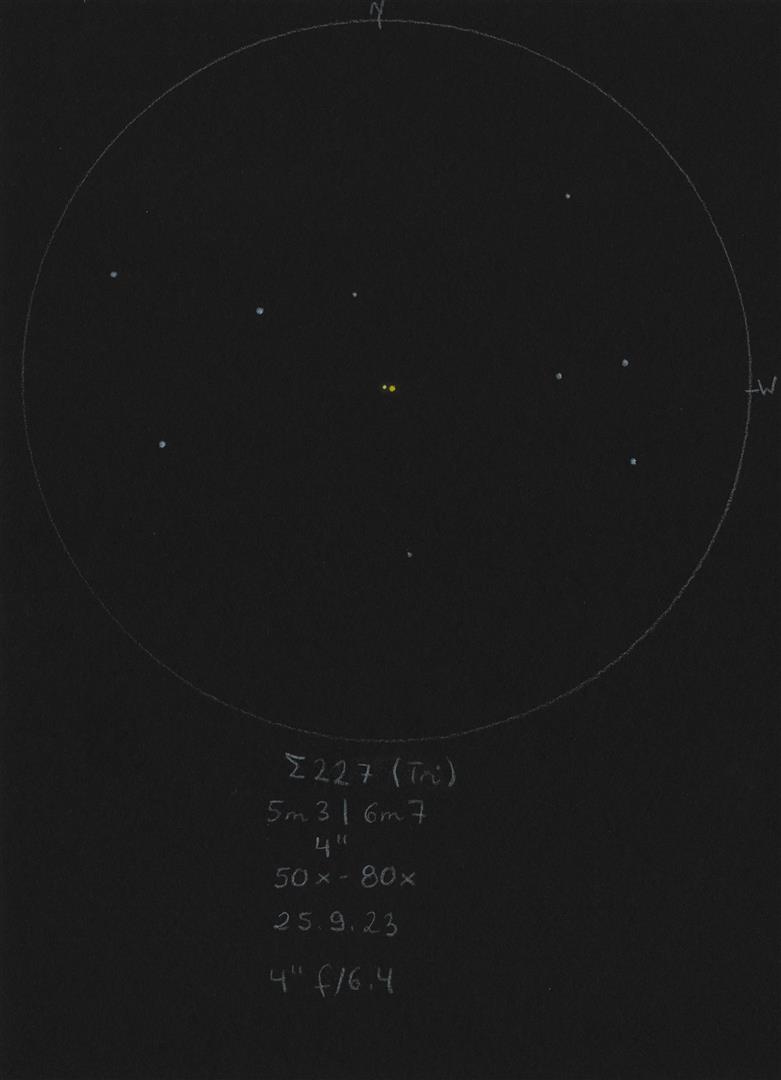
|
Uwe Pilz
Leipzig (Germany) |
105mm (88x) |
weiß und blau |

|
Christopher Hay
Seeheim (Germany) |
180mm (110x) |
Gut getrennt. Hauptkomponente gelblich, Begleiter leicht blau getönt. Während 6 Tri aus dem 0,6° Gesichtfeld driftet, kommt STF232 herein.
6 Tri ist ein physikalischer Doppelstern in 291 Lichtjahren Abstand zu uns. |
|
Mark McCarthy
Fremont (California/USA) |
203mm (205x) |
6 Tri. Yellow A, white b, pretty. Wide, about two delta mag |
|
Frederik Wanink
Itterbeck (Germany) |
254mm (200x) |
Helligkeitsunterschied deutlich |
|
René Merting
Drachhausen (Germany) |
320mm (103x) |
bei 103x zeigt A sich hellgelb, B ist getrennt, steht sehr dicht und ist auch noch sehr hell - Helligkeitsunterschied 1.5 Größenklassen, B ist grauweiß |
|
Karsten Kopp
Köln (Germany) |
600mm (180x) |
Doppelstern ist noch gut zu trennen und der Helligkeitsunterschied ist mit gut 1,5 mag schon sehr auffällig. Der hellere Stern erstrahlt schön gelblich, der schwächer weiß. In den Momenten der wirklich ruhigen Luft, ein sehr schöner Doppelstern |
|
|
|
★
|
STF234 |
|
AB |
8m.7 |
9m.4 |
0.6" |
222° |
2012 |
Cas |
02h17m23.00s / +61°21'06.50" |
|
|
Mark McCarthy
Fremont (California/USA) |
317mm (885x) |
Light orange star, definitely elongated, maybe notched, but no convincing split. Tough little Struve. |
|
|
|
|
HO216 |
|
|
7m.9 |
9m.4 |
1.4" |
6° |
2018 |
Tri |
02h27m00.99s / +31°17'17.30" |
|
|
Robert Zebahl
Leipzig (Germany) |
120mm (150x) |
10.12.2021: Unter den mäßigen Bedingungen bei 100x bis 150x in keinster Weise trennbar. |
|
René Merting
Drachhausen (Germany) |
320mm (288x) |
bei 144x ist zu erahnen, dass nördlich noch ein zweiter Stern sitzen muss - bei 288x its B im Norden dann knapp getrennt zu sehen - Helligkeitsunterschied eine dreiviertel Größenklasse (1.51 mag lt. Stelle Doppie) |
|
|
|
★★
|
iota Cas, STF262 & CHR6 |
CHR6 |
Aa-Ab |
4m.6 |
8m.5 |
0.6" |
42° |
2010 |
Cas |
02h29m03.96s / +67°24'08.70" |
|
|
|
STF262 |
AB |
4m.6 |
6m.9 |
2.9" |
230° |
2017 |
|
|
|
|
|
STF262 |
AC |
4m.6 |
9m.1 |
6.7" |
117° |
2015 |
|
|
|
|
|
STF262 |
AD |
4m.6 |
8m.5 |
210.9" |
60° |
2016 |
|
|
|
|
Robert Zebahl
Leipzig (Germany) |
55mm (27x) |
Nur die D-Komponente war gut sichtbar. Die Komponenten B & C waren selbst bei Vergrößerungen bis zu 167x nicht erkennbar. Der Himmel war deutlich aufgehellt (Bortle 7). |
|
Robert Zebahl
Leipzig (Germany) |
70mm (120x) |
Komponenten A,B und C recht dicht beieinander, D weit entfernt. Die Komponente B erschien leicht elongiert auf dem ersten Beugungsring der Hauptkomponente. Lohnend! |
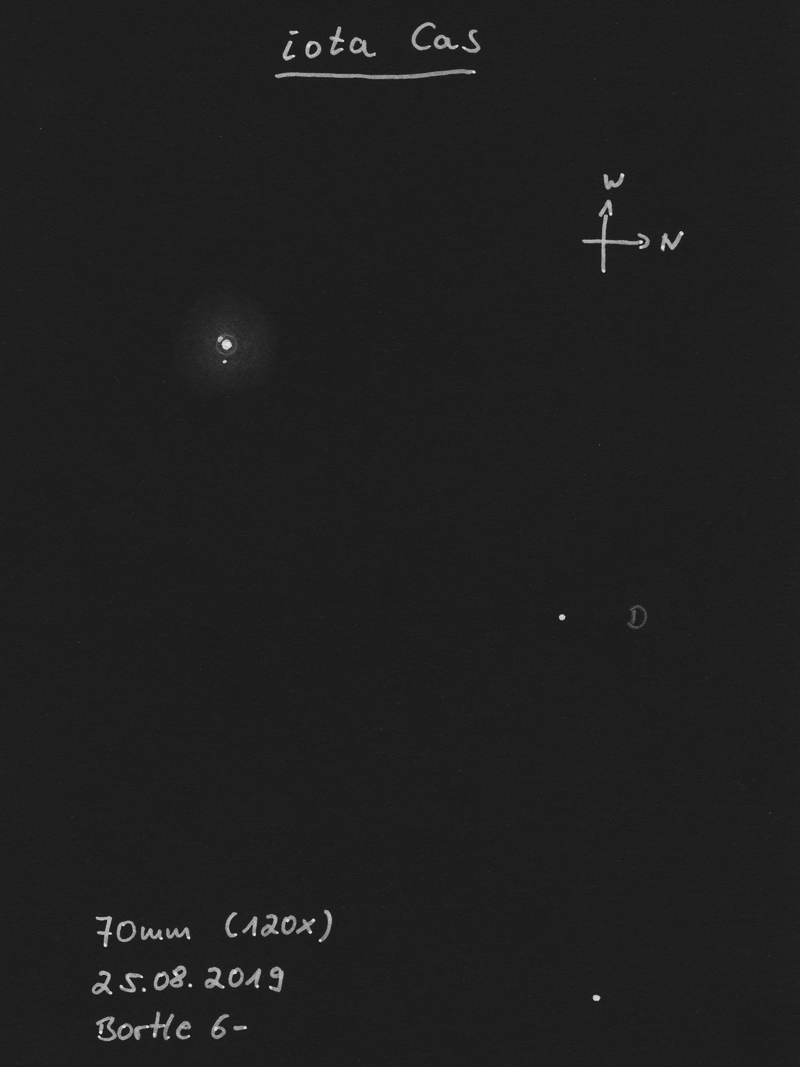
|
René Merting
Drachhausen (Germany) |
76mm (127x) |
AB: bei 95x zeigt sich Komponente B im SW im Beugungsring von A - bei 127x wird die Trennung dann eindeutiger, ein schönes Bild, B steht mitten im Beugungsring, der nur einen Bogen von 180° beschreibt, so sieht B aus wie ein Komet, der um A kreist
AC: bei 57x knapp getrennt, C zeigt sich östlich von A und ist ganz schwach
AD: leider nicht darauf geachtet |
|
Sarah Gebauer
Germany |
100mm (80x) |
bei 49-fach schon warmgelb als ein Stern zu sehen, bei 80-fach taucht dann östlich eine super schwache, sehr dicht stehende Komponente auf - südlich schmiegt sich noch eine sichelförmige Ausbuchtung an, die bei 136-fach zu einem haarfein getrennten Sternchen wird |

|
René Merting
Drachhausen (Germany) |
100mm (142x) |
AB: bei 142x zeigt sich Komponente B im SW mit gut einem Drittel das Abstandes AC, Helligkeitsunterschied 1.5 bis 2 Größenklassen
AC: bei 64x getrennt, schöner Farbkontrast, Komponente A ist weiß mit einem Stich ins Gelbe, C leicht bräunlich
AD: bei 32x extrem weiter Abstand zwischen A und D, Helligkeitsunterschied mehr als 2 Größenklassen (laut Stelle Doppie sogar 3.85 mag) |
|
Uwe Pilz
Leipzig (Germany) |
105mm (200x) |
Dreifachstern lohnend |

|
Sarah Gebauer
Germany |
150mm (160x) |
bei 160x sind die Komponenten AC getrennt, B leider nicht, die schwache Komponente C versinkt fast im Strahlen der hellen Komponente A, ein sehr reizvoller Anblick! Von Komponente D wusste ich während der Beobachtung noch nichts, sie taucht unter den Feldsternen der Zeichnung auch auf |
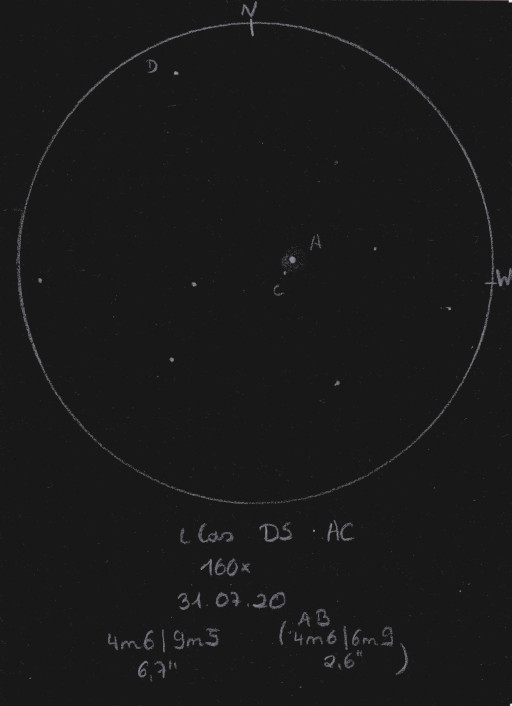
|
Robert Zebahl
Leipzig (Germany) |
152mm (129x) |
Komponente D schon bei schwächster Vergrößerung einfach zu sehen. Komponente C ist bei 49x ebenfalls einfach sichtbar. Bei 69x ist die Komponente B erahnbar, ab 100x klar erkennbar. C wirkt leicht grau-bläulich und sichtbar schwächer als B. Grandioser Anblick bei 129x! |
|
Mark McCarthy
Fremont (California/USA) |
508mm (1067x) |
CHR6 (Aa-Ab): This is a component of Iota Cas, STF 262 (which is a really pretty triple). CHR 6 at 1067x and seeing through the speckle image, I get elongation with a suspected blunter end which I assume is the B side, PA to the north [it's actually to the south -- my general orientation is correct but mis-interpret the brighter end]. Physical with 47 year period, currently at periastron and will tighten to 0.2" by 2036 |
|
|
|
|
STT43 |
|
|
7m.9 |
9m.0 |
0.6" |
343° |
2018 |
Ari |
02h40m42.29s / +26°37'20.50" |
|
|
René Merting
Drachhausen (Germany) |
320mm (288x) |
bei 288x bekomme ich den Doppelstern bestenfalls als 8 zu sehen in ruhigen Momenten - beide Sterne wirken annähernd gleich hell |
|
|
|
|
STF295, 84 Cet |
|
|
5m.8 |
9m.7 |
3.9" |
302° |
2016 |
Cet |
02h41m14.00s / -00°41'44.40" |
|
|
Robert Zebahl
Leipzig (Germany) |
102mm (160x) |
Recht einfach bei moderatem Abstand, wobei der Begleiter eher schwach erschien und am besten indirekt sichtbar war. |
|
Uwe Pilz
Leipzig (Germany) |
105mm (144x) |
trotz diesigem Himmel bei 144x indirekt erkennbar. Schwieriger bei 200x |

|
Robert Zebahl
Leipzig (Germany) |
152mm (129x) |
Einfach. Der recht schwache Begleiter ist trotz leichter, hoher Bewölkung sofort in mäßigem Abstand deutlich außerhalb des ersten Beugungsrings sichtbar. Die Hauptkomponente leuchtete weiß-gelblich. |
|
|
|
|
STF296, theta Per, 13 Per |
|
AB |
4m.2 |
10m.0 |
21.2" |
306° |
2020 |
Per |
02h44m11.99s / +49°13'42.40" |
|
|
|
|
AC |
4m.2 |
11m.1 |
94.8" |
244° |
2002 |
|
|
|
|
|
|
BC |
10m.0 |
11m.1 |
88.2" |
232° |
2007 |
|
|
|
|
René Merting
Drachhausen (Germany) |
76mm (57x) |
AB: bei 29x ist B relativ dicht nordwestlich von A erkennbar - Trennung ordentlich - B ist sehr schwach
AC: bei 57x wird C im Südwesten von A sichtbar, noch schwächer als B und deutlich weiter entfernt |
|
|
|
|
STF305 |
|
AB |
7m.5 |
8m.2 |
3.5" |
306° |
2020 |
Ari |
02h47m27.35s / +19°22'20.00" |
|
|
|
|
AC |
7m.5 |
13m.0 |
95.1" |
26° |
2015 |
|
|
|
|
René Merting
Drachhausen (Germany) |
76mm (95x) |
AB: bei 95x ist ein äußerst knapp getrenntes Pärchen erkennbar - zwei mittelhelle Sterne, wobei B im Nordosten eine halbe Magnitude schwächer ist |
|
|
|
★
|
A2906 & STF314 |
A2906 |
AB |
7m.3 |
8m.8 |
0.3" |
115° |
2018 |
Per |
02h52m52.03s / +52°59'50.60" |
|
|
|
STF314 |
AB-C |
7m.0 |
7m.3 |
1.6" |
316° |
2018 |
|
|
|
|
Robert Zebahl
Leipzig (Germany) |
152mm (129x) |
STF314 (AB-C): Wunderschön getrennt, recht dicht zusammen. Helligkeitsunterschied erkennbar, aber eher gering. Leicht zu finden und hell. Sehr schön. |
|
Frederik Wanink
Itterbeck (Germany) |
254mm (460x) |
STF314 (AB-C): ähnlich hell |
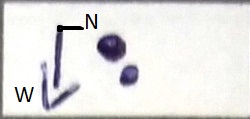
|
Mark McCarthy
Fremont (California/USA) |
317mm (553x) |
A2906 (AB): This is the brighter of the STF 314 pair. I have a feeling it is slightly elongated but nothing certain. |
|
Mark McCarthy
Fremont (California/USA) |
317mm (553x) |
STF314 (AB-C): near equal brightness, AB more yellow yellow-white of the two, ~2 disk separation |
|
|
|
|
BU525 |
|
|
7m.5 |
7m.5 |
0.5" |
275° |
2019 |
Ari |
02h58m53.11s / +21°37'03.90" |
|
|
Mark McCarthy
Fremont (California/USA) |
317mm (553x) |
Star is decidedly not round but does not show shape other than a stretching. |
|
|
|
★
|
STF333, eps Ari |
|
AB |
5m.2 |
5m.6 |
1.4" |
210° |
2020 |
Ari |
02h59m12.73s / +21°20'25.60" |
|
|
Uwe Pilz
Leipzig (Germany) |
120mm (250x) |
|

|
Mark McCarthy
Fremont (California/USA) |
203mm (205x) |
Eps Ari: Beautiful split of white stars, less than 1 delta mag, a little more than 1". Very nice pair. Physical with a 1215 year period |
|
|
|
★
|
STF346, 52 Ari |
|
AB |
6m.2 |
6m.2 |
0.5" |
256° |
2016 |
Ari |
03h05m26.69s / +25°15'18.70" |
|
|
|
|
AB-C |
5m.5 |
10m.8 |
5.1" |
358° |
2005 |
|
|
|
|
|
|
AB-D |
5m.5 |
13m.3 |
102.1" |
83° |
2013 |
|
|
|
|
|
|
AB-E |
5m.5 |
12m.8 |
133.5" |
192° |
2014 |
|
|
|
|
Mark McCarthy
Fremont (California/USA) |
203mm (333x) |
AB: What a great set! The closest are a near equal pair of white stars, elongated with a slight notch, There's a faint C ~5" and slight more than a right angle in PA. Interesting set. Physical with 227 year period |
|
Mark McCarthy
Fremont (California/USA) |
317mm (553x) |
AB-C: Bright yellow-white AB, orange C. ~4-5 delta mag, 5-6" PA to N. Did not notice AB 0.5" |
|
|
|
|
BU1030 |
|
AB |
7m.8 |
9m.7 |
0.8" |
102° |
2016 |
Ari |
03h10m06.57s / +21°44'49.50" |
|
|
Mark McCarthy
Fremont (California/USA) |
203mm (333x) |
Good clean split, slight magnitude difference, small pair. Really good. Physical with 571 year period |
|
|
|
|
STF360 |
|
|
8m.0 |
8m.3 |
2.9" |
125° |
2019 |
Per |
03h12m09.59s / +37°13'03.30" |
|
|
Robert Zebahl
Leipzig (Germany) |
70mm (67x) |
Recht schwacher Doppelstern. Bei 57x geradeso trennbar mit sich beinahe berührenden Beugungsscheibchen. Die Komponenten schienen ähnlich hell. Bei 67x noch immer sehr dicht zusammenstehend, bei 100x einfach zu trennen. |
|
Uwe Pilz
Leipzig (Germany) |
105mm (144x) |
|

|
Robert Zebahl
Leipzig (Germany) |
152mm (69x) |
Getrennt, aber dicht zusammen, ähnlich hell. Der Doppelstern wirkt insgesamt leicht orangefarben im Vergleich zu den umliegenden Sternen. |
|
|
|
★★
|
STT51 |
|
|
8m.5 |
8m.7 |
0.6" |
353° |
2019 |
Per |
03h12m57.08s / +44°17'14.70" |
|
|
Mark McCarthy
Fremont (California/USA) |
317mm (553x) |
Very fine clean split at the finest moments, which is once every 10 seconds. 0.5", equal mag. |
|
|
|
|
HU544 |
|
|
6m.7 |
8m.2 |
1.7" |
103° |
2018 |
Per |
03h15m48.70s / +50°57'21.20" |
|
|
Robert Zebahl
Leipzig (Germany) |
70mm (133x) |
Deutlich als '8' erkennbar mit deutlichem Helligkeitsunterschied. |
|
Uwe Pilz
Leipzig (Germany) |
105mm (196x) |
klebt am ersten Ring |
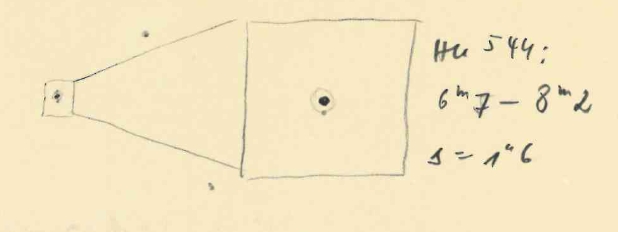
|
Uwe Pilz
Leipzig (Germany) |
105mm (260x) |
im ersten Ring |
|
Robert Zebahl
Leipzig (Germany) |
152mm (129x) |
Wunderschön getrennt in ebenso schönem Sternumfeld! Deutlicher Helligkeitsunterschied erkennbar. Östlich befindet sich ein hellerer Stern, welcher gelblich-orange strahlt. HU544 selbst wirkt farblich eher kühl. |

|
|
|
|
A2345 |
|
AB |
9m.7 |
10m.6 |
1.1" |
176° |
2013 |
Tau |
03h27m32.03s / +19°11'13.40" |
|
|
Mark McCarthy
Fremont (California/USA) |
508mm (333x) |
The faint companion is just split with seeing, around 1 delta mag, very tight <1". Physical with a 959-year period. The PA is currently precisely to the south |
|
|
|
|
BU787 |
|
AB |
7m.4 |
11m.9 |
5.2" |
293° |
2016 |
Per |
03h34m12.97s / +48°37'02.90" |
|
|
Mark McCarthy
Fremont (California/USA) |
203mm (121x) |
Very nice, white and very large delta mag B, but seen plainly with low magnification. Physical, 655.8 year period |
|
|
|
★★★
|
STF412, 7 Tau |
|
AB |
6m.6 |
6m.9 |
0.8" |
350° |
2019 |
Tau |
03h34m26.62s / +24°27'52.10" |
|
|
|
|
AB-C |
5m.9 |
9m.9 |
22.4" |
53° |
2014 |
|
|
|
|
Uwe Pilz
Leipzig (Germany) |
105mm (260x) |
AB: A-B länglich |
|
Christopher Hay
Seeheim (Germany) |
180mm (110x) |
Keine eindeutige Streckung von AB bei 110x gesehen, Seeing ist schlecht. Aber ein hübscher feiner Lichtpunkt ein gutes Stück nach Nordosten, sieht etwas bläulich aus, dies ist Komponente C.
AB-C ist physikalisch in 429 Lichtjahren Abstand zu uns. A-B ist ebenfalls physikalisch im selben Abstand, also ist dies ein physikalisches Dreifachsystem. Sehr leicht auffindbar 3° westlich der Pleiaden. |
|
Mark McCarthy
Fremont (California/USA) |
508mm (333x) |
AB: Exciting 2+1 set. AB is brilliant near equal white, nice close split <1". C is a much fainter wider star. I also cleanly split AB with the 8-inch mask, but the dark gap was narrower. Physical with a 522.16-year period |
|
|
|
|
BU533 |
|
AB |
7m.5 |
7m.7 |
1.0" |
221° |
2018 |
Per |
03h35m37.81s / +31°40'48.70" |
|
|
Robert Zebahl
Leipzig (Germany) |
152mm (225x) |
Bei 129x deutlich länglich mit Einschnürung. Bei 225x geradeso trennbar bei ähnlich hellen Komponenten. |
|
Mark McCarthy
Fremont (California/USA) |
152mm (285x) |
Excellent! Near equal light yellow-orange stars, hairline at 175x and close clean split at 285x. Burnham discovered with the 18.5-inch Dearborn refractor at 0.4". WDS has medium confidence of binarity with a 463-year period, currently coming off apastron. However there is no shared parallax range (-12%), despite only 103 AU weighted separation and 1.63/1.68 Msol. This may turn out not to be binary |
|
|
|
|
STF425 |
|
AB |
7m.5 |
7m.6 |
1.9" |
58° |
2018 |
Per |
03h40m07.24s / +34°06'59.30" |
|
|
Robert Zebahl
Leipzig (Germany) |
152mm (129x) |
Wunderschön getrennt, relativ dicht zusammen, sehr geringer Helligkeitsunterschied. |
|
|
|
★★
|
BU536 & S437, SAO76169 |
BU536 |
AB |
8m.1 |
9m.4 |
1.1" |
178° |
2016 |
Tau |
03h46m16.00s / +24°11'23.50" |
|
|
|
S437 |
AB-C |
8m.1 |
7m.7 |
38.8" |
308° |
2017 |
|
|
|
|
|
BU536 |
CD |
7m.7 |
12m.9 |
18.3" |
5° |
2015 |
|
|
|
|
Christopher Hay
Seeheim (Germany) |
10x42 |
S437 AB-C: Ein feines kompaktes Pärchen mitten im "Kasten" der Pleiaden. Im Gegensatz zu AB nicht physikalisch. |
|
Christopher Hay
Seeheim (Germany) |
71mm (13x) |
S437 AB-C: Gut getrennt. Das doppelsternigste Paar in den ganzen Pleiaden bei dieser Vergrößerung. |
|
Christopher Hay
Seeheim (Germany) |
76mm (20x) |
S437 AB-C: Gut getrennt. Komponente C geht etwas ins Orangene. |
|
Christopher Hay
Seeheim (Germany) |
180mm (200x) |
BU 536: AB scheint immer wieder aufzuploppen, aber unsicher.
S437 AB-C: Komponente C braun-orange, AB blau-weiss. |
|
Mark McCarthy
Fremont (California/USA) |
203mm (333x) |
BU536 (AB): Wow what a great pair. B is a clean split ~1" right next to A, approximately 1 delta. More amazing to see than I can describe. Aitken had a measure of 0.15" in 1899.70. Burnham discovered with the 18.5-inch at 0.4" and notes "It is important that the close pair should be watched and measured in the near future." Physical, 885.64 year period, now widening |
|
Karsten Kopp
Köln (Germany) |
600mm (180x) |
S437 (AB-C): S437 AB-C: Einfacher Doppelstern mit geringen Helligkeitsunterschied. |
|
Karsten Kopp
Köln (Germany) |
600mm (180x) |
BU536 (CD): BU536 CD: Hier liegt die Schwierigkeit bei Komponente D mit einer Helligkeit von 12,9 mag. Komponente C leuchtet orange. |
|
|
|
|
STF443 |
|
AB |
8m.2 |
8m.8 |
6.6" |
55° |
2020 |
Per |
03h47m02.11s / +41°25'38.10" |
|
|
|
|
AC |
8m.2 |
11m.4 |
106.2" |
331° |
2002 |
|
|
|
|
René Merting
Drachhausen (Germany) |
76mm (57x) |
AB: bei 29x sind zwei Perlchen zu erkennen, die noch aneinander kleben - bei 57x zeigt B sich dann östlich von A, knappe Trennung - Helligkeitsunterschied eine viertel bis halbe Magnitude |
|
Robert Zebahl
Leipzig (Germany) |
102mm (28x) |
AB: 08.11.2020: Sauber getrennt, relativ dicht zusammenstehend bei geringem Helligkeitsunterschied. |
|
|
|
|
STT65 |
|
|
5m.7 |
6m.5 |
0.4" |
202° |
2017 |
Tau |
03h50m18.91s / +25°34'46.70" |
|
|
Mark McCarthy
Fremont (California/USA) |
178mm (333x) |
Notched snowman, B is a little bluish to white A, can tell orientation, short period with PA to the SW. 61.2-year period, it will soon be at apastron. Given it's nearly edge-on orbit, I won't see significant change, except for a slightly better split, in my time |
|
Mark McCarthy
Fremont (California/USA) |
203mm (533x) |
For this one I used an 8-inch mask on my 20-inch telescope, since the star brightness washed out the image in full aperture. It appeared as a very tight pair, hairline split, and around 1 delta mag. I estimated the PA to the south. Approaching apastron, and won't make significant change in my lifetime in spite of the 61.2-year period |
|
|
|
|
STT66 |
|
|
8m.1 |
8m.5 |
1.0" |
146° |
2018 |
Per |
03h52m04.69s / +40°47'50.70" |
|
|
Robert Zebahl
Leipzig (Germany) |
102mm (187x) |
08.11.2020: Schon bei 125x als '8' erkennbar. Die Luft war zu unruhig für höhere Vergrößerungen. |
|
Mark McCarthy
Fremont (California/USA) |
317mm (270x) |
light orange equal magnitude, split with seeing, close ~1" |
|
|
|
|
STTA41 & A1831, V479 Tau |
STTA41 |
A-BC |
7m.5 |
8m.9 |
59.6" |
358° |
2014 |
Tau |
03h54m27.23s / +05°10'28.50" |
|
|
|
A1831 |
BC |
9m.4 |
10m.3 |
0.2" |
237° |
2021 |
|
|
|
|
René Merting
Drachhausen (Germany) |
76mm (29x) |
A-BC: bei 29x ein weit auseinanderstehendes Paar - Komponente BC im Norden ist sehr schwach wirkt durchsichtig grau, A dagegen schwach weiß |
|
|
|
|
STF483 |
|
|
7m.4 |
9m.3 |
1.6" |
53° |
2018 |
Per |
04h04m07.10s / +39°30'35.00" |
|
|
Mark McCarthy
Fremont (California/USA) |
317mm (270x) |
Yellow-orange star, very close, 1", 2 delta mag. |
|
|
|
|
STT531, 50 Per |
|
AB |
7m.3 |
9m.7 |
2.7" |
353° |
2018 |
Per |
04h07m34.35s / +38°04'28.30" |
|
|
|
|
AC |
7m.3 |
8m.8 |
225.1" |
217° |
2015 |
|
|
|
|
Robert Zebahl
Leipzig (Germany) |
102mm (125x) |
AB: 08.11.2020: Klar getrennt, relativ dicht zusammenstehend, recht großer Helligkeitsunterschied. Hauptkomponente erschien weiß-gelblich mit schwachem Begleiter. |
|
René Merting
Drachhausen (Germany) |
107mm (120x) |
AB: eine harte Nuss, bei 120x ist B als eine Minimurmel nördlich abgesetzt von A zu sehen, knappst getrennt und etwa 2,5 bis 3 Größenklassen Helligkeitsunterschied |
|
Mark McCarthy
Fremont (California/USA) |
317mm (270x) |
AB: AC is a finder split. The fainter of these has another star split 4", 2-3 delta mag., this is the AB pair. |
|
|
|
★
|
omicron 2 Eri, 40 Eri, STF518 |
|
A-BC |
4m.4 |
9m.3 |
82.7" |
102° |
2019 |
Eri |
04h15m16.32s / -07°39'10.30" |
|
|
|
|
BC |
9m.5 |
11m.2 |
8.2" |
330° |
2019 |
|
|
|
|
Winfried Kräling
Marburg (Germany) |
102mm (178x) |
|
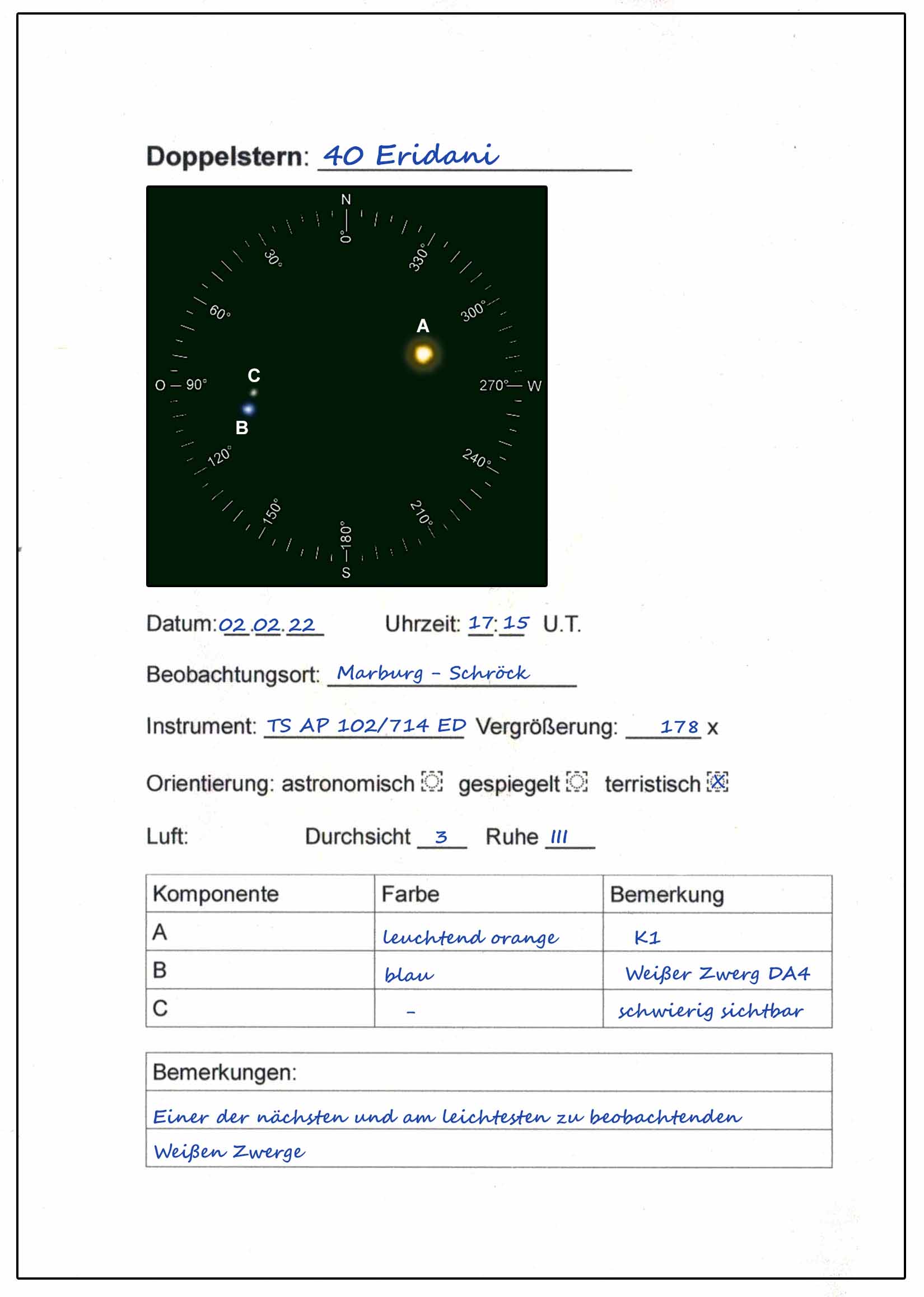
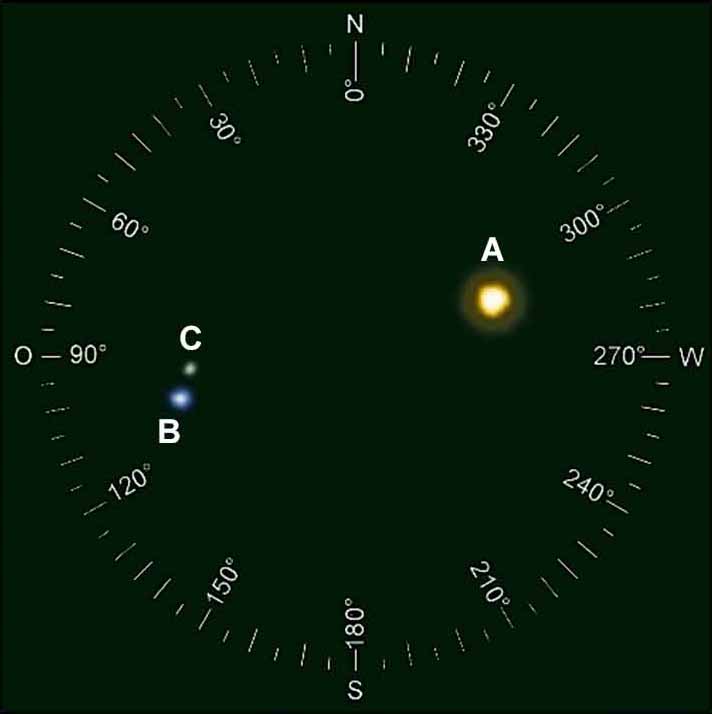
|
Uwe Pilz
Leipzig (Germany) |
105mm (244x) |
A ist gelblich. B fiel sofort ins Auge, auch bei 144x. C war extrem schwierig. A musste außerhalb des Gesichtsfeldes stehen, aber auch dann war er nur indirekt sichtbar. Dann aber überraschte der verhältnismäßig große Abstand B-C. ~ A ist ein Hauptreihenstern ähnlich der Sonne. B ist ein weißer Zwerg, einer der hellsten am Himmel. C ist ein Roter Zwerg, davon gibt es nicht viele in der Reichweite kleiner Instrumente. Insgesamt hat man drei Zwergsterne auf einen Blick: Einen gewöhnlichen (=Hauptreihen-) Zwerg, einen weißen und einen roten. |
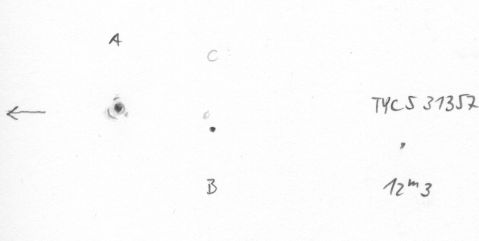
|
|
Berthold Fuchs
Wiesbaden (Germany) |
130mm |
A-BC: Dreifachsystem mit weißem Zwerg |
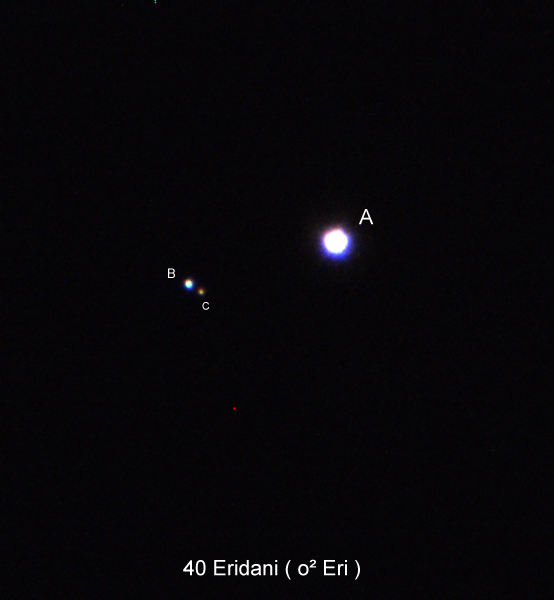
|
|
|
|
STT77 & STTA43 & POP226 |
STT77 |
AB |
8m.0 |
8m.2 |
0.5" |
304° |
2020 |
Per |
04h15m55.73s / +31°41'35.10" |
|
|
|
STTA43 |
AB-C |
7m.5 |
8m.6 |
56.2" |
42° |
2018 |
|
|
|
|
|
STT77 |
AB-D |
7m.5 |
9m.6 |
131.8" |
315° |
2014 |
|
|
|
|
|
POP226 |
AB-E |
7m.5 |
13m.8 |
62.0" |
157° |
2014 |
|
|
|
|
|
POP226 |
AB-F |
7m.5 |
14m.3 |
60.6" |
192° |
2014 |
|
|
|
|
René Merting
Drachhausen (Germany) |
15x56 |
STTA43 (AB-C): ein schön isoliert stehendes Pärchen - C zeigt sich gut getrennt im Nordwesten von AB und wirkt grau weiß gegen die hellgelbe AB-Komponente - Helligkeitsunterschied 1.5 Magnituden |
|
|
|
|
HO328 |
|
|
7m.4 |
9m.1 |
0.4" |
358° |
2016 |
Tau |
04h17m01.22s / +19°40'32.60" |
|
|
Mark McCarthy
Fremont (California/USA) |
317mm (553x) |
Very faint, very close ~0.8", emerges with seeing, hair split. Marginal |
|
|
|
★
|
STF520 |
|
|
8m.3 |
8m.4 |
0.6" |
82° |
2019 |
Tau |
04h18m14.55s / +22°48'24.60" |
|
|
Mark McCarthy
Fremont (California/USA) |
317mm (553x) |
Faint elongated to overlapping disks. |
|
|
|
|
STF513 & BU1333 |
STF513 |
A-BC |
7m.9 |
10m.5 |
5.1" |
60° |
2014 |
Cam |
04h19m13.78s / +61°35'02.30" |
|
|
|
BU1333 |
BC |
10m.5 |
9m.8 |
0.2" |
38° |
2018 |
|
|
|
|
René Merting
Drachhausen (Germany) |
76mm (57x) |
STF513 (A-BC): bei 57x zeigt BC sich ganz schwach östlich von A - knappe Trennung, BC wirkt wie ein geisterhafter kleiner Schatten von A |
|
|
|
|
STT82 |
|
AB |
7m.3 |
8m.6 |
1.2" |
323° |
2021 |
Tau |
04h22m44.10s / +15°03'22.10" |
|
|
Mark McCarthy
Fremont (California/USA) |
317mm (553x) |
Very close, 0.8" 1.5 delta mag, PA to N/NW. |
|
|
|
|
STF535 |
|
|
7m.0 |
8m.3 |
1.1" |
267° |
2018 |
Tau |
04h23m16.84s / +11°22'40.50" |
|
|
Uwe Pilz
Leipzig (Germany) |
120mm (225x) |
schwierig |

|
|
|
|
STT81, 56 Per |
|
AB |
5m.8 |
9m.2 |
4.2" |
13° |
2017 |
Per |
04h24m37.46s / +33°57'34.90" |
|
|
Mark McCarthy
Fremont (California/USA) |
317mm (270x) |
56 Per. Pretty yellow and slight red pair, 2 delta mag. |
|
|
|
|
HU1080 |
|
|
6m.8 |
8m.4 |
0.2" |
266° |
2016 |
Tau |
04h28m59.78s / +16°09'32.70" |
|
|
Mark McCarthy
Fremont (California/USA) |
508mm (533x) |
Used 533x & 667x. I could detect elongation at 533x, and significant notching with 667x, enough to tell which was A & B and the position angle, which I put at nearly E-W (B is tightly WSW currently). Physical with a 40.752-year period, it is widening and reaches apastron in 2029, so maybe I'll get a clean split and a more accurate PA estimate at that time |
|
|
|
|
STF554, 80 Tau |
|
|
5m.7 |
8m.1 |
1.4" |
15° |
2021 |
Tau |
04h30m08.60s / +15°38'16.20" |
|
|
Uwe Pilz
Leipzig (Germany) |
120mm (300x) |
schwierig |
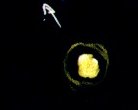
|
Mark McCarthy
Fremont (California/USA) |
317mm (553x) |
1" 2 delta mag, PA N. Nice! |
|
|
|
★★
|
STF572 |
|
AB |
7m.4 |
7m.2 |
4.5" |
188° |
2021 |
Tau |
04h38m29.58s / +26°56'25.60" |
|
|
Christopher Hay
Seeheim (Germany) |
42mm (12x) |
Leicht gestreckt. Positionswinkel eindeutig gesehen ohne vorheriges Wissen, im 3-Zöller bestätigt. |
|
Robert Zebahl
Leipzig (Germany) |
70mm (57x) |
Klar getrennt, einfach mit schönem Farbkontrast: A leicht orange, B weiß. |
|
Christopher Hay
Seeheim (Germany) |
76mm (83x) |
Gut getrennt, sehr gleichmäßiges Paar. |
|
Karsten Kopp
Köln (Germany) |
600mm (180x) |
Schöner Doppelstern mit nur minimalen Helligkeitsunterschied. Beide Komponente leuchten gelblich weiß. |
|
|
|
|
STF589 |
|
AB |
8m.8 |
8m.9 |
4.8" |
276° |
2020 |
Ori |
04h44m48.23s / +05°17'22.30" |
|
|
Sarah Gebauer
Germany |
100mm (49x) |
inmitten der vielen, schwachen Sterne in dieser Gegend ist er nicht auf Anhieb zu finden, die Hauptkomponente ist so schwach bei 49x, dass die angebliche Farbe nicht wirklich zu sehen ist, nicht getrennt |
|
|
|
|
COU2031 |
|
|
6m.9 |
7m.8 |
0.0" |
28° |
2011 |
Per |
04h46m26.92s / +42°20'54.20" |
|
|
Mark McCarthy
Fremont (California/USA) |
508mm (1067x) |
A badly misshaped star, elongated, SSE PA, but nothing really clear, very small scale. Physical with a 20.58 year period, it will close to periastron rapidly in the next 5 years, and really not be detectible visually until it returns to apastron in the late 2030s |
|
|
|
|
BU552 |
|
AB |
6m.4 |
8m.9 |
0.9" |
276° |
2021 |
Ori |
04h51m49.92s / +13°39'18.70" |
|
|
Mark McCarthy
Fremont (California/USA) |
508mm (533x) |
Light yellow A and light orange B, well separated when seeing stills and the stars form airy disks, short period pair with a 97.7 year period. This will continue increasing to apastron in 2030 and beyond, though the PA will remain about the same -- I think in the future it will be splittable in lower magnifications, which is how I would notice any change. Burnham writes: "This pair was discovered with the 18.5-inch, but in looking over the old observing books used with the 6-inch, I find that on December 14, 1874, this star was noted as 'possibly a close pair'…There seems to be something singular about the appearance and difficulty of this pair at times with larger apertures. It was not noted as difficult at the time of the observation in 1877. in 1890 it was a hard star with the 36-inch and on two nights in 1892, under favorable conditions, I failed to see it double at all." |
|
|
|
|
HU555 & STF608 |
HU555 |
AB |
8m.8 |
9m.1 |
0.2" |
70° |
2007 |
Aur |
04h56m16.87s / +52°05'52.20" |
|
|
|
STF608 |
AB-C |
8m.2 |
9m.5 |
4.7" |
114° |
2019 |
|
|
|
|
Uwe Pilz
Leipzig (Germany) |
105mm (144x) |
STF608 (AB-C): AB ist schwierig |
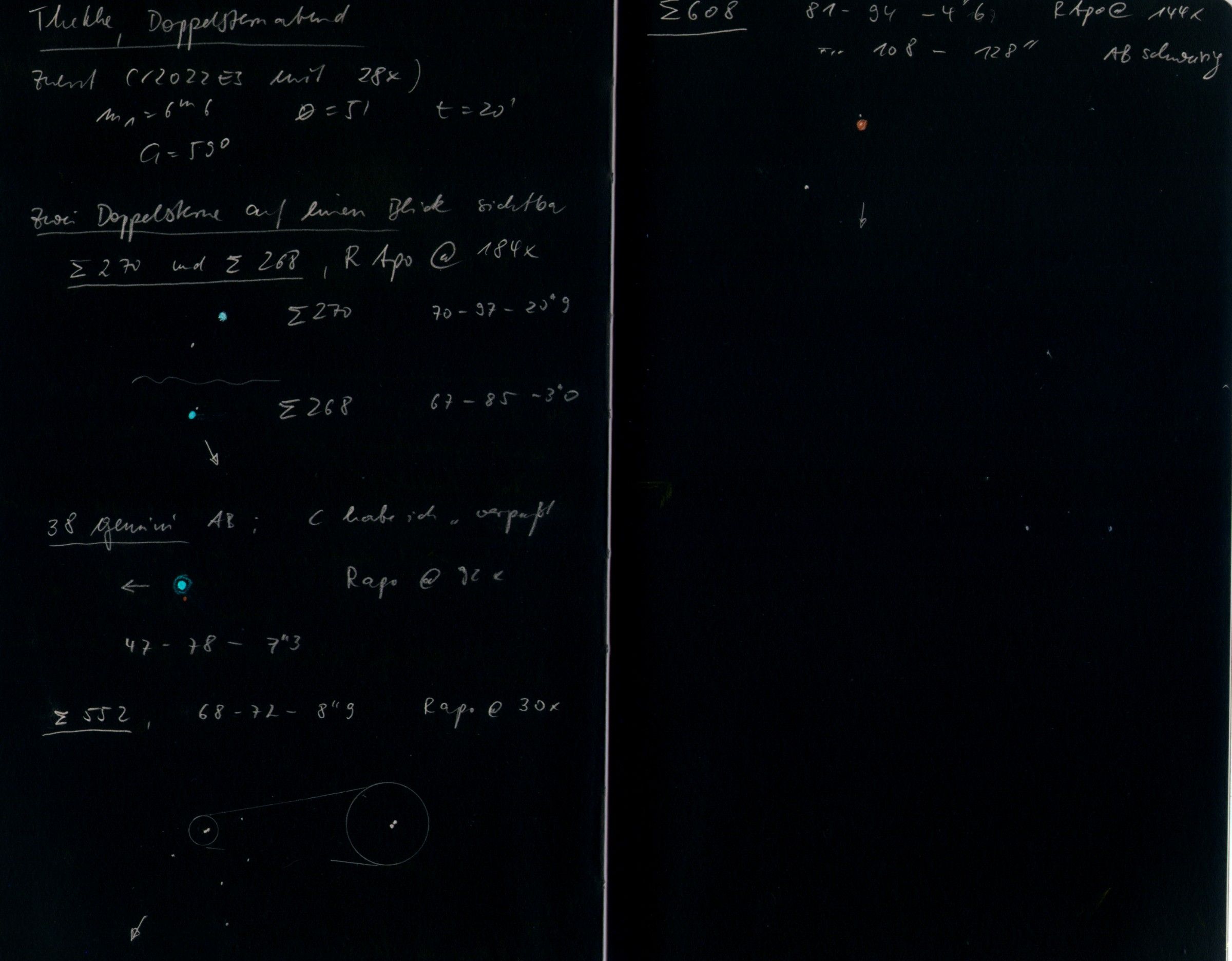
|
René Merting
Drachhausen (Germany) |
107mm (60x) |
STF608 (AB-C): bei 60x ist die C-Komponente ganz knapp getrennt im Süden von AB zu erkennen, insgesamt ein sehr schwaches Paar |
|
|
|
|
STT92, 5 Aur |
|
AB |
6m.0 |
9m.5 |
4.1" |
285° |
2017 |
Aur |
05h00m18.35s / +39°23'40.90" |
|
|
Uwe Pilz
Leipzig (Germany) |
105mm (160x) |
schwierig |
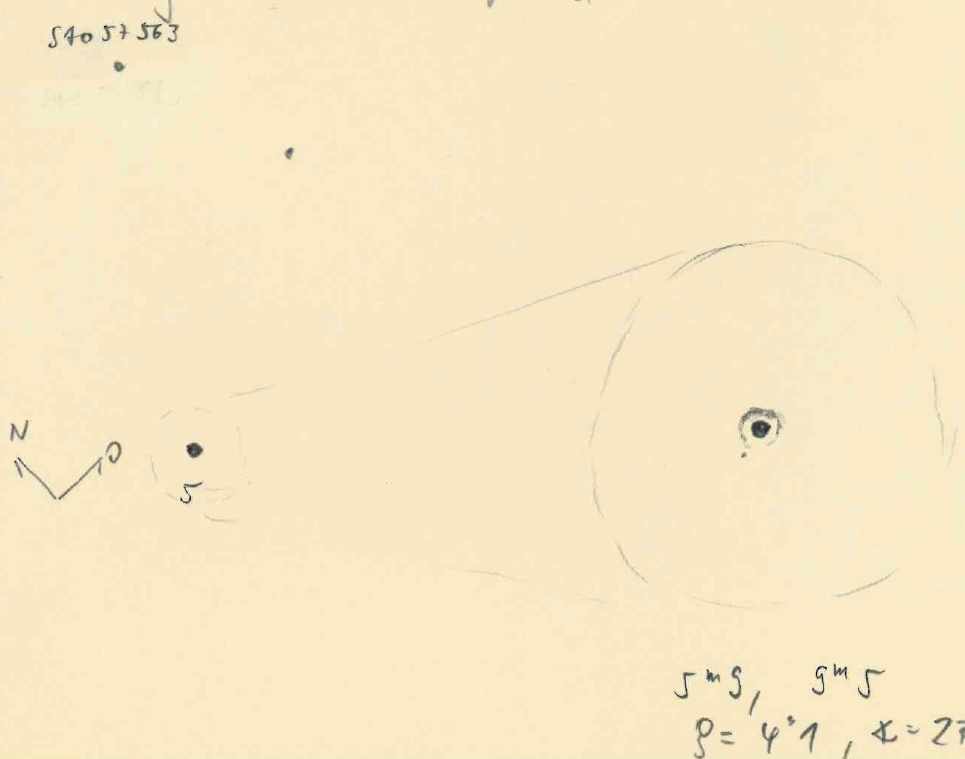
|
Uwe Pilz
Leipzig (Germany) |
105mm (288x) |
Nur bei sehr hoher Vergrößerung überhaupt zu trennen, schwierig |

|
|
|
★
|
STF645 & BU1047 |
STF645 |
A-BC |
6m.0 |
9m.1 |
11.3" |
29° |
2017 |
Tau |
05h09m45.06s / +28°01'50.20" |
|
|
|
BU1047 |
BC |
9m.1 |
9m.7 |
0.3" |
90° |
2014 |
|
|
|
|
Uwe Pilz
Leipzig (Germany) |
105mm (88x) |
STF645 (A-BC) |

|
Mark McCarthy
Fremont (California/USA) |
317mm (270x) |
STF645 (A-BC): White and grey, 2 delta mag, wide. BC is BU 1047 0.3" near equal, but not seen |
|
Mark McCarthy
Fremont (California/USA) |
508mm (667x) |
BU1047 (BC): Component of STF 645. Awesome flex on Struve. Near equal BC stars suspected at 533x, hairline split at 667x. A really fine little blue pair near bright white A. Physical with a 32.1-year period, it is at apastron now and will get impossibly close in the 2030s, becoming visually detectible again in the later part of that decade. Burnham discovered in 1889 with the Lick 36-inch, and recorded 0.4" separation |
|
Karsten Kopp
Köln (Germany) |
600mm (180x) |
STF645 (A-BC): Gut zu trennender Doppelstern mit einem großen Helligkeitsunterschied von 3,0 mag. |
|
|
|
|
STF648 |
|
AB |
8m.1 |
8m.9 |
5.0" |
64° |
2020 |
Aur |
05h10m59.19s / +32°02'19.50" |
|
|
Robert Zebahl
Leipzig (Germany) |
55mm (40x) |
Bei 40x getrennt mit geringem Abstand und deutlich schwächerer Komponente. |
|
Robert Zebahl
Leipzig (Germany) |
70mm (33x) |
Trennbar, aber dicht zusammen bei sichtbarem Helligkeitsunterschied. |
|
Uwe Pilz
Leipzig (Germany) |
105mm (144x) |
beide Komponenten gelb |
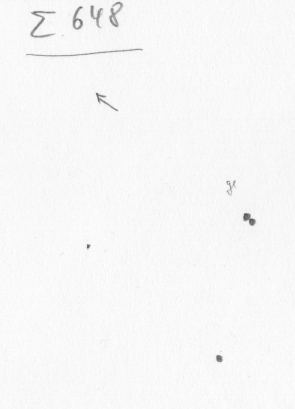
|
Mark McCarthy
Fremont (California/USA) |
317mm (270x) |
Light orange, half delta mag, wide. |
|
|
|
|
STT517 |
|
AB |
6m.8 |
7m.0 |
0.7" |
243° |
2019 |
Ori |
05h13m31.55s / +01°58'03.70" |
|
|
Uwe Pilz
Leipzig (Germany) |
105mm (144x) |
Es erforderte einige Mühe zu sehen, welches der hellere Stern ist, |

|
Mark McCarthy
Fremont (California/USA) |
203mm (333x) |
Consistently split but images are bloated by poor seeing, yellowish white stars, <1", near equal |
|
|
|
|
Winnecke 2, WNC2 |
|
A-BC |
6m.9 |
7m.0 |
3.1" |
159° |
2020 |
Ori |
05h23m51.32s / -00°51'59.80" |
|
|
Robert Zebahl
Leipzig (Germany) |
70mm (44x) |
Doppelstern erschien länglich. |
|
René Merting
Drachhausen (Germany) |
100mm (64x) |
bei 64x ein extrem eng stehendes wunderschönes Pärchen zweier gleich heller gelber Sterne - keine 8 mehr, beide sind schon getrennt - bei 107x kommt etwas mehr Luft zwischen beide, aber sie scheinen auch ein wenig Farbe zu verlieren |
|
Robert Zebahl
Leipzig (Germany) |
120mm (150x) |
Deutlich getrennt bei nahezu gleich hellen Komponenten. |
|
Mark McCarthy
Fremont (California/USA) |
203mm (333x) |
Nice near equal, light yellow-white stars, well split. nice pair [BC is A 847 7.67/7.84 0.3" and could have been gotten on a better night!] |
|
Mark McCarthy
Fremont (California/USA) |
508mm (533x) |
Easy and obvious pair, bright 7th mag stars ~3". [This was a first try at the short period list but I missed the object, which is A 847 BC, 7.67/7.84 0.3" -- need to try again.] |
|
|
|
|
A848 |
|
|
6m.9 |
7m.9 |
0.3" |
179° |
2016 |
Ori |
05h25m31.08s / -00°32'38.20" |
|
|
Mark McCarthy
Fremont (California/USA) |
203mm (533x) |
Suspect elongation at 333x, at 533x I get a snowman, very definite with seeing. White stars, noticeable mag difference |
|
|
|
|
STF728, 32 Ori |
|
|
4m.4 |
5m.8 |
1.3" |
44° |
2021 |
Ori |
05h30m47.06s / +05°56'53.30" |
|
|
Uwe Pilz
Leipzig (Germany) |
105mm (288x) |
sauber getrennt, Beugungsscheiben berühren sich gerade |

|
Mark McCarthy
Fremont (California/USA) |
203mm (333x) |
32 Ori White and off white pair, 1.5 delta mag, ~1.5". Nice and very clean with seeing |
|
|
|
★
|
STF742 |
|
|
7m.1 |
7m.5 |
4.1" |
275° |
2019 |
Tau |
05h36m26.38s / +21°59'35.10" |
|
|
Christopher Hay
Seeheim (Germany) |
76mm (83x) |
Gerade so getrennt, etwas schwierig. Bemerkenswert schwieriger als STF572 etwa 15° im Nordwesten, obwohl die Daten ganz ähnlich sind und beide Systeme in identischer Horizonthöhe zur Beobachtungszeit stehen. Bei 40x ist STF742 nicht mehr eindeutig getrennt, dafür wird M1 sehr stark in 2° Gesichtsfeld. |
|
Robert Zebahl
Leipzig (Germany) |
102mm (62x) |
Wunderschön getrennt, relativ dicht zusammen mit gut sichtbarem Helligkeitsunterschied. Zeigt direkt auf Messier 1 und kann mit diesem in einem Gesichtsfeld beobachtet werden. Sehr schön! |
|
Robert Zebahl
Leipzig (Germany) |
120mm (48x) |
Schöner, auffälliger Doppelstern nahe Messier 1. Einfach zu trennen bei nahezu gleich hellen Komponenten. |
|
Robert Zebahl
Leipzig (Germany) |
152mm (69x) |
Bei 49x geradeso, bei 69x einfach trennbar. Die schwächere Komponente wirkte farblich etwas wärmer. Toller Anblick zusammen mit Messier 1 im Gesichtsfeld. |
|
Robert Zebahl
Leipzig (Germany) |
200mm (80x) |
Schöner Doppelstern mit nahezu gleich hellen Komponenten. |
|
Mark McCarthy
Fremont (California/USA) |
203mm (333x) |
Well separated, ~1 delta mag white stars. Physical with 2959-year period |
|
Karsten Kopp
Köln (Germany) |
600mm (180x) |
Gut zu trennender Doppelstern mit leichten Helligkeitsunterschied von vielleicht 0,3 mag. Beide Sterne leuchten weißlich. |
|
|
|
|
STF749 |
|
AB |
6m.5 |
6m.5 |
1.1" |
324° |
2019 |
Tau |
05h37m08.84s / +26°55'28.30" |
|
|
|
|
AC |
6m.5 |
10m.5 |
181.6" |
299° |
2011 |
|
|
|
|
Robert Zebahl
Leipzig (Germany) |
70mm (133x) |
AB: Ich meinte im richtigen Positionswinkel, ohne diesen bei der Beobachtung zu kennen, eine minimale Elongation zu erkennen. Beobachtung aber grenzwertig und zu unsicher. |
|
Mark McCarthy
Fremont (California/USA) |
203mm (333x) |
AB: Lovely near equal pair, close around 1", like distant headlights, slightly blue-green white color. Physical with 773.2358-year period |
|
Mark McCarthy
Fremont (California/USA) |
317mm (277x) |
AB: Hair-split, equal brightness white stars. Nice. |
|
|
|
|
STF774, zeta Ori, 50 Ori, Alnitak |
|
AB |
1m.9 |
3m.7 |
2.4" |
166° |
2021 |
Ori |
05h40m45.52s / -01°56'33.30" |
|
|
|
|
AC |
1m.9 |
9m.6 |
58.5" |
10° |
2017 |
|
|
|
|
Robert Zebahl
Leipzig (Germany) |
70mm (128x) |
AB: Großer Helligkeitsunterschied. Die schwächere Komponente konnte ich nahe des ersten Beugungsrings der helleren Komponente erkennen. |
|
Winfried Kräling
Marburg (Germany) |
102mm (178x) |
AB |


|
Uwe Pilz
Leipzig (Germany) |
105mm (288x) |
AB: sauber getrennt, Beugungsscheiben berühren sich gerade |
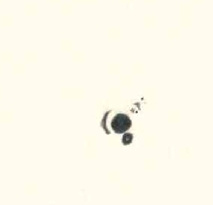
|
Mark McCarthy
Fremont (California/USA) |
203mm (333x) |
AB: Alnitak. Easy, 2 delta mag,~2", white |
|
Mark McCarthy
Fremont (California/USA) |
317mm (207x) |
AC: Alnitak:AC is a very faint star widely separated outside of the main star's glare. |
|
Mark McCarthy
Fremont (California/USA) |
317mm (207x) |
AB: about 2" and 1.5 delta mag. |
|
|
|
|
BU1052 |
|
|
6m.7 |
8m.2 |
0.7" |
183° |
2021 |
Ori |
05h41m40.34s / -02°53'47.30" |
|
|
Mark McCarthy
Fremont (California/USA) |
508mm (533x) |
Suspected at 333x, easily split with 533x & apodising mask, light orange stars approximately 1.5 delta. Short period with 105.692-year period. Burnham discovered with the 36-inch at 0.7". Currently at apastron, close to the discovery separation, it will be difficult to notice change in the next 20 years, but after 2050 it will close rapidly |
|
|
|
|
BU560 |
|
|
7m.8 |
8m.2 |
1.7" |
124° |
2019 |
Aur |
05h47m24.87s / +29°39'26.90" |
|
|
Robert Zebahl
Leipzig (Germany) |
70mm (100x) |
Deutlich als Doppelstern mit sich überlappenden Beugungsscheibchen ('8') und geringem Helligkeitsunterschied erkennbar. |
|
Robert Zebahl
Leipzig (Germany) |
152mm (129x) |
Getrennt mit sehr geringem Helligkeitsunterschied, relativ dicht zusammen. Insgesamt einfach. |
|
|
|
|
STT119 |
|
|
8m.1 |
8m.9 |
0.7" |
354° |
2019 |
Ori |
05h47m54.88s / +07°57'37.50" |
|
|
Mark McCarthy
Fremont (California/USA) |
508mm (333x) |
Suspect elongations with 8" 533x & 20" 533x, but image not good enough. But I got a nice clean split with apodizing mask, nearly perfrect disks. Orange stars well split, <1", about 1 delta mag |
|
|
|
|
STF795, 52 Ori |
|
|
6m.0 |
6m.0 |
1.0" |
220° |
2021 |
Ori |
05h48m00.21s / +06°27'14.50" |
|
|
Sarah Gebauer
Germany |
150mm (125x) |
bei 125x und 250x nicht getrennt im April 2020 |
|
Mark McCarthy
Fremont (California/USA) |
317mm (553x) |
Bright white, near equal magnitude, near touching disks hairline split |
|
Mark McCarthy
Fremont (California/USA) |
508mm (533x) |
52 Ori. Close but well split, near equal, ivory white. with apodising mask |
|
|
|
|
STF3115 |
|
|
6m.5 |
7m.5 |
0.9" |
337° |
2017 |
Cam |
05h49m04.64s / +62°48'29.60" |
|
|
Frederik Wanink
Itterbeck (Germany) |
254mm (640x) |
gerade eben trennbar mit schwarzem Zwischenraum |
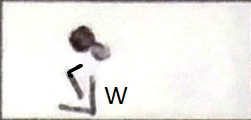
|
|
|
★★
|
BU1053 |
|
|
6m.9 |
8m.8 |
1.9" |
0° |
2019 |
Aur |
05h53m28.64s / +37°20'20.70" |
|
|
Robert Zebahl
Leipzig (Germany) |
70mm (133x) |
Grenzbeobachtung! Begleiter ist im richtigen Positionswinkel zeitweise als extrem schwache Aufhellung des ersten Beugungsrings der Hauptkomponente auszumachen. |
|
Mark McCarthy
Fremont (California/USA) |
317mm (270x) |
Nice!! Blazing white and close but nicely split light blue B, 2 delta mag. |
|
|
|
|
STT124 |
|
|
6m.1 |
7m.4 |
0.6" |
299° |
2018 |
Ori |
05h58m53.23s / +12°48'29.80" |
|
|
Mark McCarthy
Fremont (California/USA) |
317mm (170x) |
Seeing not good. Bloated yellow star with bluish B just attached to the edge, like a wart. B is very faint, small. |
|
Mark McCarthy
Fremont (California/USA) |
317mm (553x) |
Briefly split in the best moments, 1 second out of 10. A star yellow-white and small, hard blue B. |
|
|
|
|
STT545, 37 Aur, theta Aur |
|
AB |
2m.6 |
7m.2 |
4.2" |
304° |
2019 |
Aur |
05h59m43.24s / +37°12'45.90" |
|
|
Robert Zebahl
Leipzig (Germany) |
70mm (57x) |
Bei 57x auf den ersten Blick nichts zu erkennen. Bei 133x war nach kurzer Zeit die sehr viel schwächere Komponente als kleines Sternchen im richtigen Positionswinkel sichtbar. Mit dieser Erkenntnis gelang auch die Beobachtung bei 57x, auch wenn man sehr genau hinschauen muss. Die Herausforderung liegt weniger im Winkelabstand sondern mehr in dem großen Helligkeitsunterschied. |
|
Uwe Pilz
Leipzig (Germany) |
105mm (200x) |
blauweiß. Wegen der etwas unruhigen Luft und des Helligkeitsunterschiedes nicht einfach. |
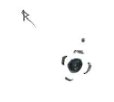
|
Mark McCarthy
Fremont (California/USA) |
178mm (222x) |
Brilliant white A and light orange B, which is very much fainter and on the outside of A's third diffraction ring. A is causing a lot of diffraction in average to poor seeing. Physical with a 473 year period, it is now near apastron and will hang there for the rest of my lifetime |
|
|
|
|
J335 |
|
|
8m.4 |
9m.5 |
1.1" |
270° |
2019 |
Ori |
06h04m08.29s / +11°00'57.00" |
|
|
Mark McCarthy
Fremont (California/USA) |
203mm (205x) |
White A, B resolves with seeing, hairline split and two delta mag. Tough at this aperture |
|
|
|
|
STT132 |
|
|
7m.2 |
9m.6 |
1.8" |
332° |
2012 |
Aur |
06h08m11.68s / +37°58'57.90" |
|
|
Mark McCarthy
Fremont (California/USA) |
317mm (270x) |
White A and slightly red B. Fine pair. 2 delta mag. |
|
|
|
|
KUI24 |
|
|
6m.3 |
7m.2 |
0.3" |
144° |
2014 |
Ori |
06h14m28.59s / +17°54'22.80" |
|
|
Mark McCarthy
Fremont (California/USA) |
508mm (667x) |
Bright white, olive shape is the best I can see. Physical with 260-year period, it will tighten to invisibility the next 15 years |
|
|
|
|
BU1008, eta Gem, 7 Gem, Propus |
|
|
3m.5 |
6m.2 |
1.8" |
258° |
2020 |
Gem |
06h14m52.69s / +22°30'24.60" |
|
|
Uwe Pilz
Leipzig (Germany) |
105mm (260x) |
Aufhellung im ersten Ring |
|
Uwe Pilz
Leipzig (Germany) |
105mm (288x) |
sehr schwierig |

|
Robert Zebahl
Leipzig (Germany) |
152mm (225x) |
Bereits bei 180x vergleichsweise einfach. Der schwache Begleiter ist als recht deutliche, leicht längliche, teils runde Aufhellung gut zu sehen. Ab 225x einfach und sofort auffällig, auch wenn die Beugungsringe der Hauptkomponente bedingt durch das Seeing nicht dauerhaft klar zu sehen sind. Die Hauptkomponente strahlte in einem hellen Orange. |
|
Mark McCarthy
Fremont (California/USA) |
203mm (333x) |
Propus. Yellow A and blue-yellow B, 2 delta mag, 1.5" very nice |
|
|
|
|
STF881, 4 Lyn |
|
AB |
6m.1 |
7m.7 |
0.7" |
149° |
2020 |
Lyn |
06h22m03.57s / +59°22'19.50" |
|
|
Frederik Wanink
Itterbeck (Germany) |
254mm (640x) |
schwierig wegen Helligkeitsunterschied |
|
|
|
|
STF932 |
|
|
8m.3 |
8m.5 |
1.6" |
305° |
2019 |
Gem |
06h34m21.57s / +14°45'08.30" |
|
|
Robert Zebahl
Leipzig (Germany) |
70mm (150x) |
Leider störte eine nahestehende Lampe bei der Beobachtung. Ich konnte den Stern zumindest ansatzweise länglich erkennen. |
|
Mark McCarthy
Fremont (California/USA) |
203mm (333x) |
Very neat near equal white stars, well split |
|
|
|
★★★
|
AGC1, 9 CMa, alpha CMa, Sirius |
|
AB |
-1m.5 |
8m.4 |
11.3" |
67° |
2021 |
CMa |
06h45m08.92s / -16°42'58.00" |
|
|
Robert Zebahl
Leipzig (Germany) |
102mm (86x) |
14.02.2023: In einer ruhigen Phase ist der Begleiter inmitten des Halos der Hauptkomponente deutlich zu sehen, aber sehr schwach. |
|
Uwe Pilz
Leipzig (Germany) |
105mm (198x) |
mit ADV, ohne nicht trennbar. Eindeutig |
|
Robert Zebahl
Leipzig (Germany) |
120mm (150x) |
02.03.2021: Vergrößerungen von 86x bis 200x unter Verwendung einen Baader-Gelbfilters benutzt. Das Beugungsscheibchen war relativ gut zu sehen, die Beugungsringe dagegen deutlich in Bewegung (Seeing 3/5). |
|
Jörg S. Schlimmer
Germany |
127mm (136x) |
Visuell nicht zu trennen, die Beugungsringe sind wesentlicht heller wie der Begleiter, so dass dieser überstrahlt wird. Während die Beugungsringe gut zu sehen sind, ist der zentrale Teil der Abbildung nicht klar definiert. Speckles erscheinen radial vom Zentrum nach außen. Atmosphärische Refraktion deutlich sichtbar. |
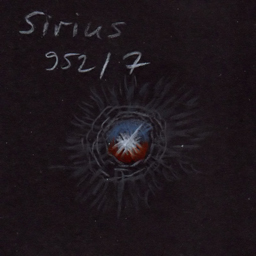
|
Mark McCarthy
Fremont (California/USA) |
203mm (368x) |
Small disk formed on diffraction spike at correct separation and PA (Feb. 2016) |
|
Mark McCarthy
Fremont (California/USA) |
317mm (443x) |
A faint yellow-orange disk, to the edge of Sirius A's diffraction and just below my spider's diffraction spike. I let Sirius pass beyond the field stop, and for an instant there was Sirius B, clearly separated, before it too passed beyond the field stop. |
|
|
Jörg S. Schlimmer
Germany |
305mm |
Visuell nicht zu trennen. Bei gutem Seeing ist der Begleiter mit Hilfe einer CMOS Video Kamera hingegen deutlich zu sehen. |

|
|
|
|
A122 |
|
|
8m.9 |
9m.4 |
0.4" |
24° |
2016 |
Gem |
06h45m27.02s / +29°21'59.80" |
|
|
Mark McCarthy
Fremont (California/USA) |
508mm (533x) |
Nice light orange stars, hairline split with indifferent seeing, PA to the SW. Slight magnitude difference. Physical with 102.3-year period, I have the PA reversed in my estimate, it's to the NE -- still can claim it though. It is coming off apastron and will close slightly in the next 20 years. Aiken discovered in 1900 with the Lick 36-inch also at 0.4" -- 118 years since, so it has made a little more than one revolution |
|
|
|
★★★
|
STF948, 12 Lyn |
|
AB |
5m.4 |
6m.0 |
1.9" |
65° |
2020 |
Lyn |
06h46m14.15s / +59°26'30.10" |
|
|
|
|
AC |
5m.4 |
7m.0 |
8.9" |
309° |
2019 |
|
|
|
|
Robert Zebahl
Leipzig (Germany) |
55mm (27x) |
AC: Komponenten A/B und C gut trennbar, aber dicht zusammen. Helligkeitsunterschied deutlich. Die schwächere C-Komponente wirkte leicht orange, die Komponente A/B weiß-bläulich. |
|
Robert Zebahl
Leipzig (Germany) |
55mm (167x) |
AB: Die Komponenten A und B trennbar, wobei sich die Beugungsscheibchen leicht überlappen. Der Helligkeitsunterschied war gut zu sehen. |

|
Robert Zebahl
Leipzig (Germany) |
63mm (140x) |
AB: Die Komponenten A und B trennbar mit nahezu keinem Zwischenraum. Sichtbarer Helligkeitsunterschied. |
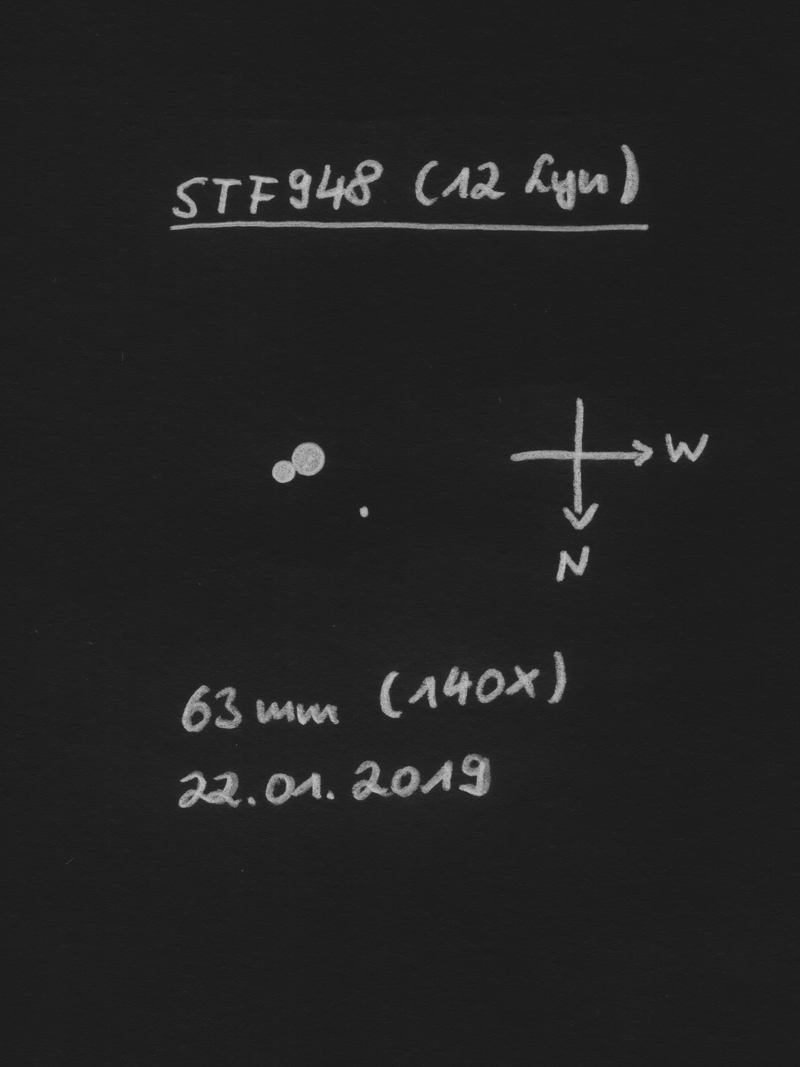
|
Robert Zebahl
Leipzig (Germany) |
70mm (22x) |
AC: Gut trennbar, relativ dicht zusammen bei deutlicher Helligkeitsdifferenz. |
|
Robert Zebahl
Leipzig (Germany) |
70mm (133x) |
AB: Die beiden Komponenten A + B deutlich voneinander getrennt, wobei die Beugungsringe miteinander verschmolzen. Ein sehr schöner Anblick zusammen mit der Komponente C. Ich habe eine Zeichnung angefertigt, welche meinen Eindruck gut wiedergibt. Leider sind Abstand und Positionswinkel nicht besonders gut erfasst. Auch den Helligkeitsunterschied der Komponenten A und B habe ich nicht bewusst gesehen. |
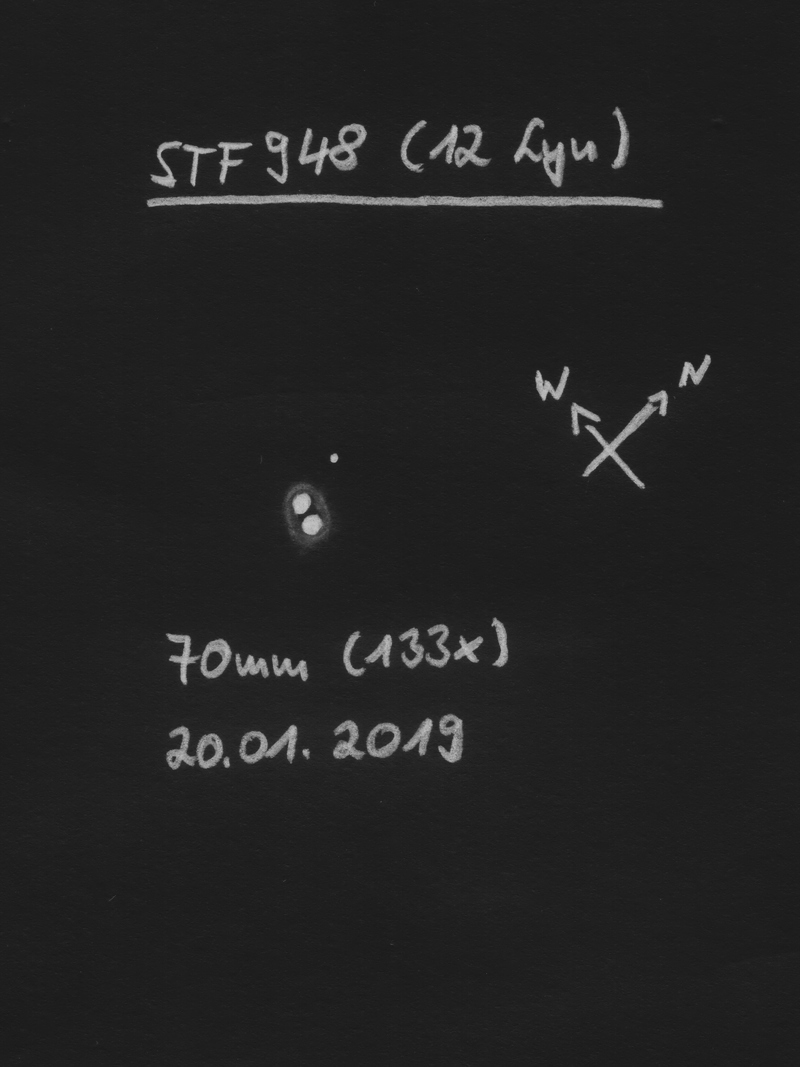
|
Robert Zebahl
Leipzig (Germany) |
102mm (129x) |
Bei 28x ist ohne Probleme das Paar AC schön getrennt. Das enge Paar AB ist bereits bei 86x als deutliche '8' erkennbar, bei 125x wunderbar getrennt. Die Komponenten A & B erscheinen gelblich. Sehr schöner Anblick zusammen mit STF 946 in einem Gesichtsfeld! |
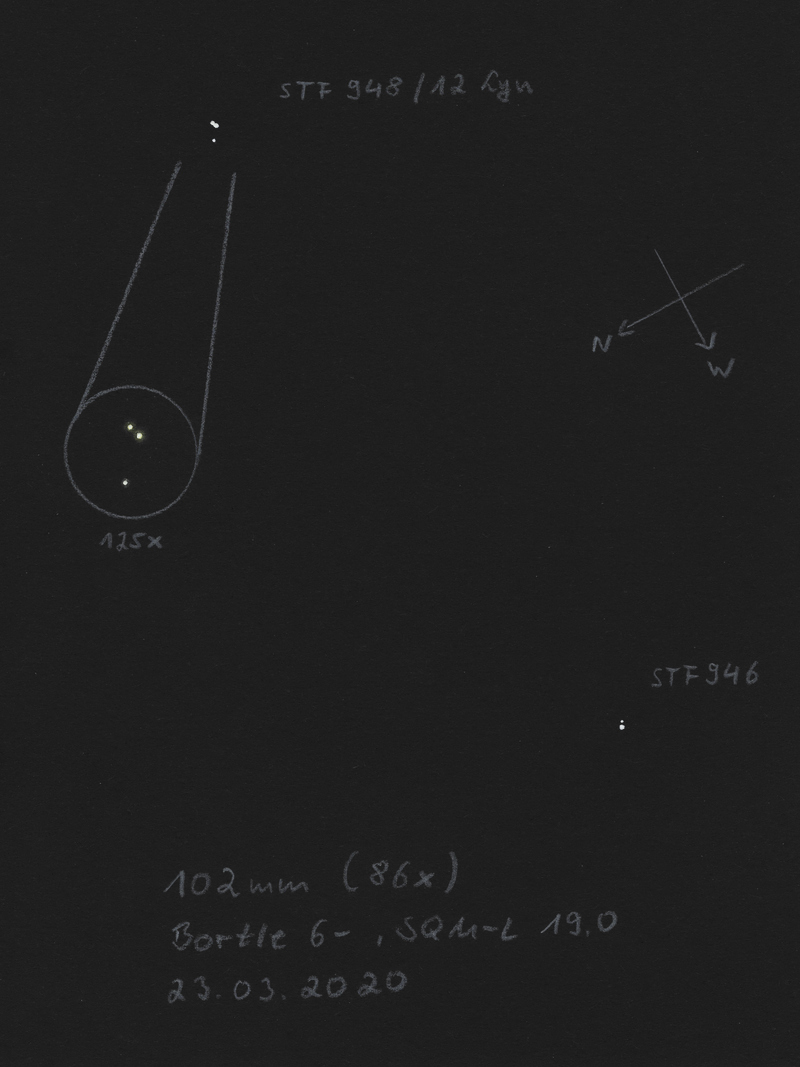
|
Uwe Pilz
Leipzig (Germany) |
105mm (88x) |
im selben Feld mit STF 946 |
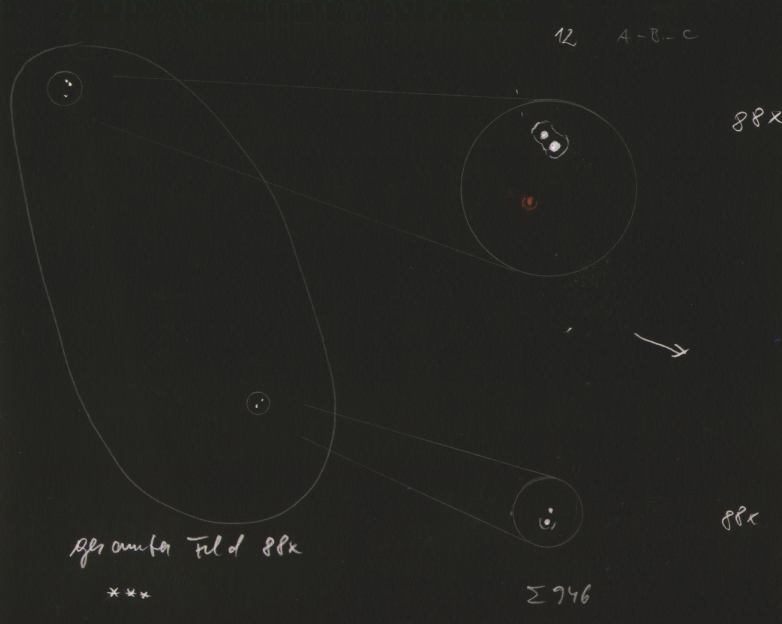
|
Robert Zebahl
Leipzig (Germany) |
152mm (129x) |
Bei 49x ist das Paar AC wunderschön getrennt mit deutlichem Helligkeitsunterschied. Bei 100x zeigt sich dann auch das enge Paar AB getrennt, wenn auch noch sehr dicht zusammenstehend. Ein geringer Helligkeitsunterschied ist erkennbar. Bei 129x ist der Anblick grandios. Die beiden hellen Komponenten A & B präsentieren sich gelblich, die schwächere Komponente C eher gräulich. STF 948 lässt sich wunderbar in einem Gesichtsfeld mit dem benachbarten Doppelstern STF 946 beobachten. Beide zeigen ein schönes Gesamtbild. |
|
Mark McCarthy
Fremont (California/USA) |
178mm (148x) |
AB: Gorgeous triple star, pale yellow A and B, and 1 delta blue C. really stunning. AB physical with a 733-year period |
|
|
|
|
STT157 |
|
|
7m.2 |
9m.2 |
0.6" |
161° |
2018 |
Mon |
06h47m47.56s / +00°20'24.50" |
|
|
Mark McCarthy
Fremont (California/USA) |
317mm (277x) |
Yellow A, widely separated from blue B. 2 magnitude difference. Did not notice 0.8" separation in A |
|
|
|
★
|
STF958 |
|
AB |
6m.3 |
6m.3 |
4.5" |
77° |
2021 |
Lyn |
06h48m12.29s / +55°42'15.10" |
|
|
Robert Zebahl
Leipzig (Germany) |
70mm (33x) |
Deutlich getrennt, gleich hell, dicht zusammen. Schöner Anblick. |
|
Robert Zebahl
Leipzig (Germany) |
102mm (62x) |
Sehr schön getrennt. Beide Komponenten wirken gleichhell und weiß-gelblich. |
|
Mark McCarthy
Fremont (California/USA) |
178mm (148x) |
Near equal dull white typical Struve. Not much to look at but it's physical with a 2023 year period, with not much movement now but will whip around the A star pretty quickly when it reaches periastron 150 years from now |
|
|
|
|
A2731 |
|
AB |
8m.2 |
9m.5 |
1.3" |
67° |
2016 |
Mon |
06h48m39.38s / +07°37'20.40" |
|
|
Mark McCarthy
Fremont (California/USA) |
178mm (205x) |
Excellent pair, around 2 two delta mag, more than 1" separated, very fine, dull white A and light yellow B. Physical with a 247 year period |
|
|
|
★
|
STF982, 38 Gem |
|
AB |
4m.8 |
7m.8 |
7.3" |
145° |
2018 |
Gem |
06h54m38.63s / +13°10'40.10" |
|
|
Robert Zebahl
Leipzig (Germany) |
55mm (27x) |
Bei 27x recht dicht zusammmen mit deutlich schwächerer Komponente. Bei 71x klar getrennt bei deutlicher Helligkeitsdifferenz. Hellere Komponente wirkte leicht gelblich, Schwächere leicht bläulich. |
|
Robert Zebahl
Leipzig (Germany) |
70mm (33x) |
Einfach zu trennen mit deutlichem Helligkeitsunterschied. Die schwächere Komponente wirkte leicht orange, die hellere eher weiß. |
|
René Merting
Drachhausen (Germany) |
76mm (29x) |
AB: bei 29x ist die B-Komponente im Südosten von A angedeutet erkennbar - bei 57x dann ist die Trennung etwas mehr als knapp - B wirkt bräunlich gegen die buttergelb strahlende A-Komponente - ein schön enges, ungleiches Pärchen
AC: bei 57x ist C schwach und weit abgesetzt westlich von A zu erkennen - C liegt außerhalb des relativ großen Halos von A |
|
Sarah Gebauer
Germany |
100mm (49x) |
das Doppel ist freiäugig trotz aufgehellten Himmels sehr gut als ein Stern zu sehen, die B-Komponente ist bei 49x sichtbar getrennt, deutlich schwächer und versteckt sich beinahe hinter der A-Komponente, diese erscheint sehr warmweiß im Farbton |
|
Uwe Pilz
Leipzig (Germany) |
105mm (92x) |
|

|
Uwe Pilz
Leipzig (Germany) |
105mm (130x) |
recht attraktiv |
|
Mark McCarthy
Fremont (California/USA) |
203mm (333x) |
38 Gem. Light yellow A and blue B, quite wide, very pretty. AC much wider separation much fainter not noticed |
|
Mark McCarthy
Fremont (California/USA) |
317mm (553x) |
Bright orange and slightly red star, 2-3 delta mag. |
|
Mark McCarthy
Fremont (California/USA) |
317mm (553x) |
Pretty yellow and orange, 2 delta mag, wide separation |
|
|
|
|
STF981 |
|
|
8m.7 |
9m.0 |
0.9" |
119° |
2016 |
Gem |
06h55m28.54s / +30°09'42.30" |
|
|
Mark McCarthy
Fremont (California/USA) |
317mm (553x) |
Very close orange pair, equal magnitude. Clean split, ~1". |
|
Mark McCarthy
Fremont (California/USA) |
508mm (333x) |
Very finely split, white stars, nearly 1 delta mag. Appeared as a rod at 205x. Physical with a 1089.7-year period. Discovered in 1831 at 3.7", near apastron, it has narrowed considerably since |
|
|
|
|
STT159, 15 Lyn |
|
AB |
4m.5 |
5m.5 |
0.7" |
237° |
2020 |
Lyn |
06h57m16.60s / +58°25'23.00" |
|
|
Uwe Pilz
Leipzig (Germany) |
105mm (200x) |
nicht getrennt im April 2020 |
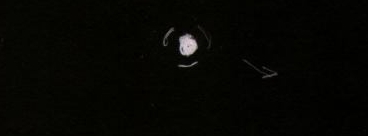
|
Frederik Wanink
Itterbeck (Germany) |
254mm (640x) |
relativ einfach |
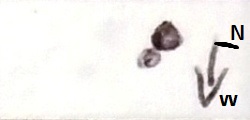
|
|
|
|
A1061 & STF1000 |
A1061 |
AB |
8m.9 |
9m.1 |
0.1" |
73° |
2014 |
Gem |
06h59m21.15s / +25°14'00.20" |
|
|
|
STF1000 |
AB-C |
8m.1 |
9m.0 |
22.1" |
67° |
2016 |
|
|
|
|
René Merting
Drachhausen (Germany) |
100mm (32x) |
STF1000 (AB-C): bei 32x ein bequem getrenntes Pärchen - Komponente AB kühlweiß - Komponente C im Osten ist eine dreiviertel Größenklasse schwächer und grauweiß |
|
Sarah Gebauer
Germany |
100mm (73x) |
STF1000 (AB-C): sieht fast so aus, als hätte die westliche Komponente einen Gelbstich, bei 73x weit und deutlich getrennt |
|
Robert Zebahl
Leipzig (Germany) |
152mm (30x) |
STF1000 (AB-C): 27.02.2022: Bei 30x durchaus auffälliger, mittelheller Doppelstern mit schönem Abstand. AB wirkt zart gelblich, die Farbe des etwas schwächeren Begleiters C kann ich nicht definieren. Der Farbeindruck ändert sich auch bei 92x nicht. |
|
|
|
|
STT163 |
|
AB |
7m.2 |
8m.2 |
0.2" |
115° |
2011 |
Mon |
07h01m09.85s / +11°46'28.70" |
|
|
Mark McCarthy
Fremont (California/USA) |
317mm (553x) |
Not perfectly round AB, a faint bluish haze in the diffraction to the south. Marginal |
|
|
|
|
BU573 |
|
|
7m.2 |
7m.8 |
0.8" |
311° |
2018 |
Mon |
07h01m49.89s / -10°52'56.30" |
|
|
Uwe Pilz
Leipzig (Germany) |
105mm (144x) |
|

|
Uwe Pilz
Leipzig (Germany) |
105mm (247x) |
schwach gekerbt |

|
|
|
★
|
A2462 |
|
AB |
9m.2 |
9m.0 |
0.2" |
246° |
2020 |
Gem |
07h02m37.42s / +15°58'26.50" |
|
|
Mark McCarthy
Fremont (California/USA) |
508mm (1067x) |
Short period list. Notched, noticeable magnitude difference, B star pointed in direction of apex of right triangle it forms with two other eighth magnitude stars. Light orange stars |
|
|
|
|
STF1037 |
|
AB |
7m.2 |
7m.3 |
0.8" |
302° |
2021 |
Gem |
07h12m49.08s / +27°13'30.20" |
|
|
Uwe Pilz
Leipzig (Germany) |
105mm (260x) |
eingekerbt |
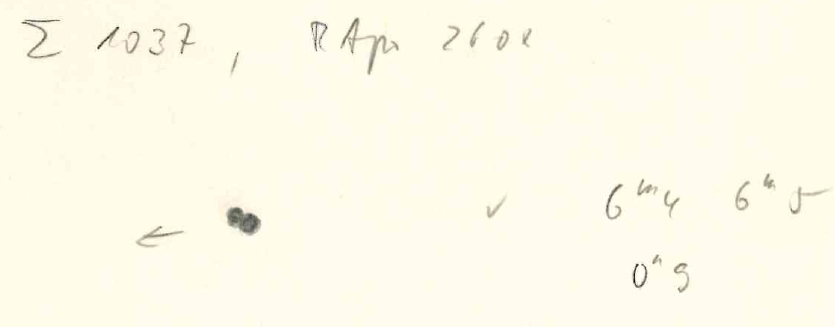
|
Uwe Pilz
Leipzig (Germany) |
105mm (288x) |
bei 200x trennbar, beide gelb |

|
Mark McCarthy
Fremont (California/USA) |
178mm (205x) |
Hairline split at 205x but went to 533x to get clear view of it to drift through the field to tell PA. Slight magnitude difference. Really nice looking pair, masked down to 7-inches to get clean disks. Physical with a 118.35-year period, it will close rapidly and become undetectable during the 2030s, widening again in the 2040s |
|
Frederik Wanink
Itterbeck (Germany) |
254mm (640x) |
leichter, gleich hell |
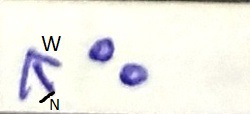
|
|
|
|
BU575 & STF1057 |
BU575 |
AB |
8m.3 |
7m.9 |
0.4" |
315° |
2021 |
CMa |
07h14m48.26s / -15°28'33.50" |
|
|
|
STF1057 |
AB-C |
8m.3 |
9m.9 |
15.7" |
1° |
2019 |
|
|
|
|
René Merting
Drachhausen (Germany) |
76mm (29x) |
Bedingungen in der Zielregion: SQM-L 19.8
STF1057 (AB-C): Bedingungen in der Zielregion: SQM-L 19.8
bei 29x ist dir C-Komponente sehr schwach nördlich von AB erkennbar - knappe Trennung - C wirkt mindestens 2 Größenklassen schwächer |
|
|
|
|
STT170 |
|
AB |
7m.4 |
7m.7 |
0.6" |
283° |
2020 |
CMi |
07h17m38.51s / +09°17'31.50" |
|
|
Mark McCarthy
Fremont (California/USA) |
203mm (333x) |
Notched, near equal at 333x. At 667x, hairline split very easy to see, near equal white stars |
|
|
|
★
|
STF1066, delta Gem, 55 Gem |
|
|
3m.5 |
8m.2 |
5.5" |
229° |
2018 |
Gem |
07h20m07.39s / +21°58'56.40" |
|
|
Robert Zebahl
Leipzig (Germany) |
55mm (71x) |
Sehr großer Helligkeitsunterschied. Die schwache Komponente war gut trennbar, aber nur als schwaches Sternchen sichtbar. |
|
René Merting
Drachhausen (Germany) |
76mm (127x) |
alle Vergrößerungen bis 127x probiert, eine Trennung war nicht möglich - Transparenz und Seeing waren einfach zu schlecht, B hat das Versteckspiel gewonnen |
|
Sarah Gebauer
Germany |
100mm (80x) |
bei 20-fach nicht getrennt, aber schon ein sehr warmgelber Farbeindruck - bei 80-fach getrennt mit einem großen, schönen Halo um den hellen, warmgelben Stern, der winzig kleine, graue Begleiter so dicht dran |
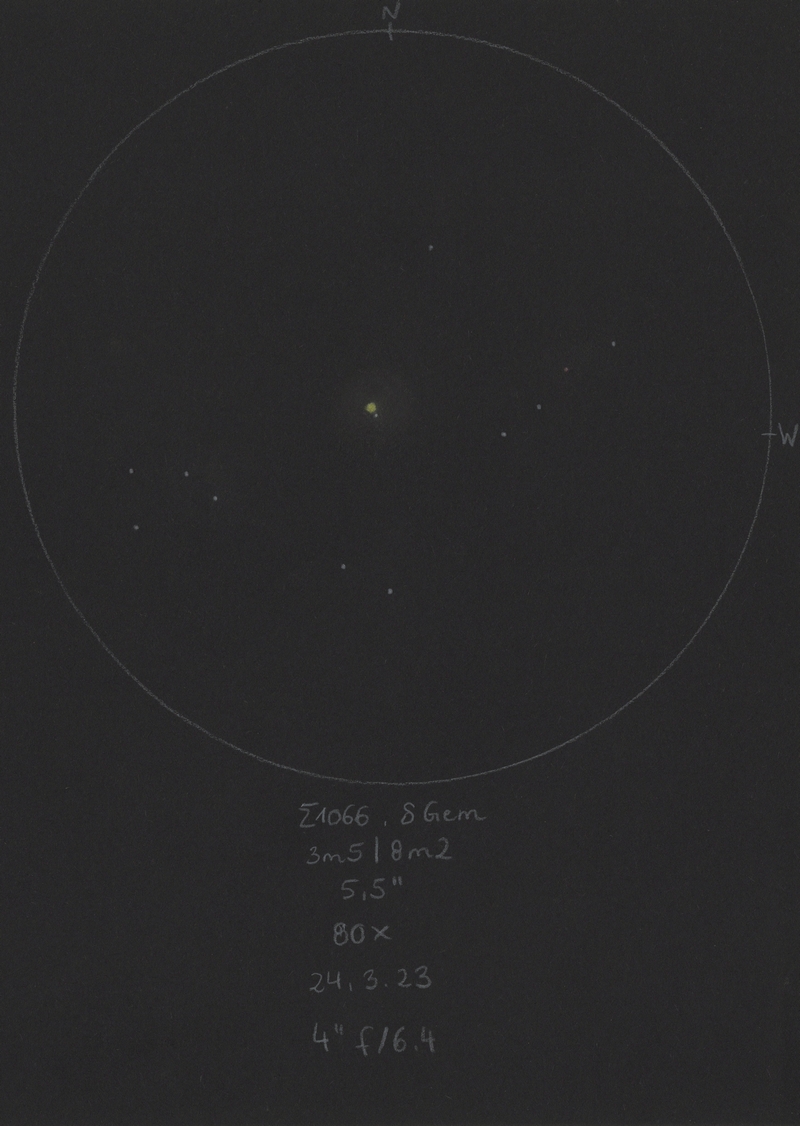
|
Axel Tute
Küssaberg (Germany) |
100mm (271x) |
23.03.2010: Wasat liess sich nicht mit dem 12mm RKE(108x) und dem 8mm RKE (163x) trennen. Erst mit dem 4.8mm Plössl geling eine deutliche Trennung. |

|
Robert Zebahl
Leipzig (Germany) |
102mm (160x) |
Einfach zu trennen bei relativ großem Abstand. Der Begleiter erschien als feines, schwaches Sternchen. |
|
Winfried Kräling
Marburg (Germany) |
102mm (178x) |
|
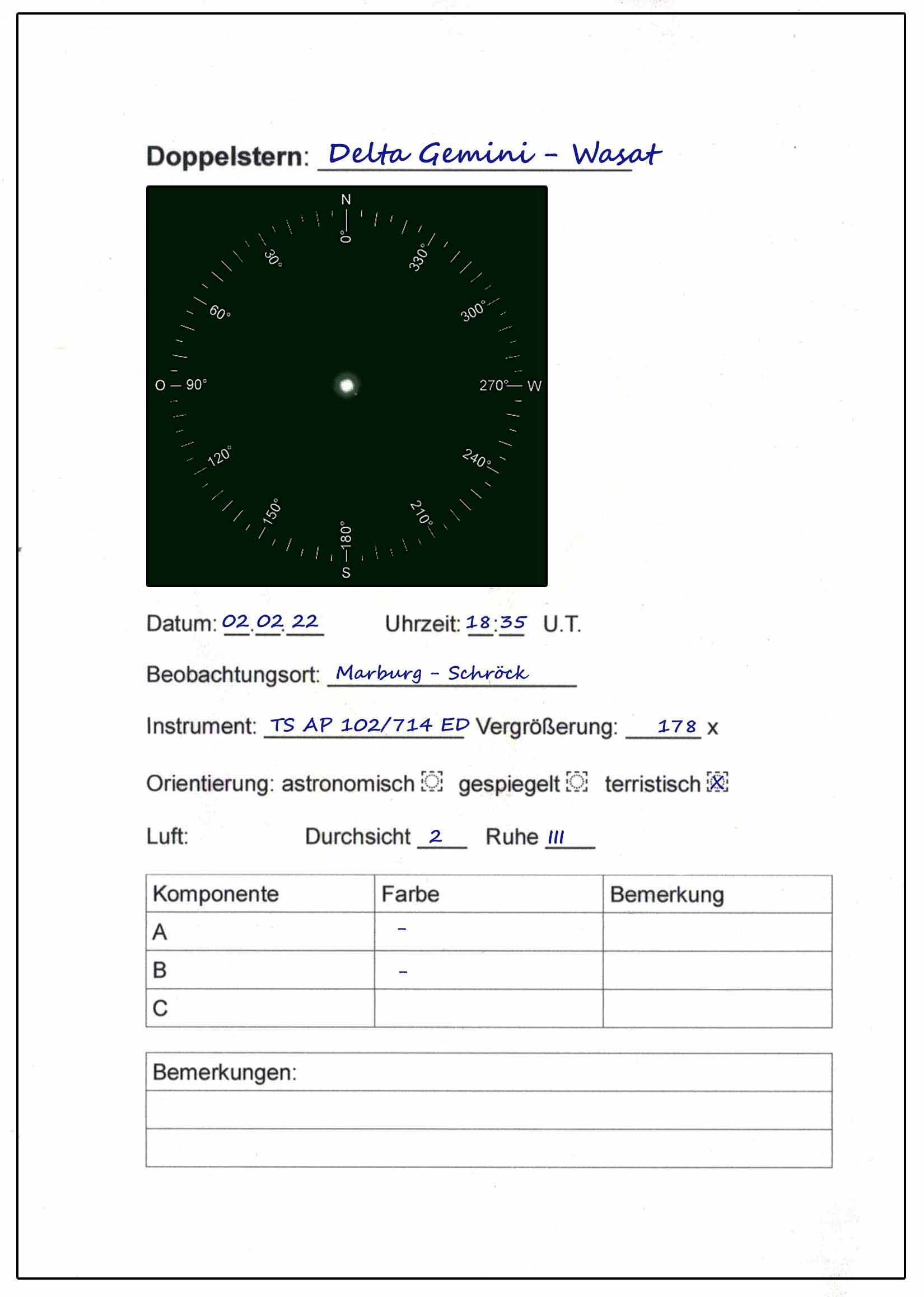
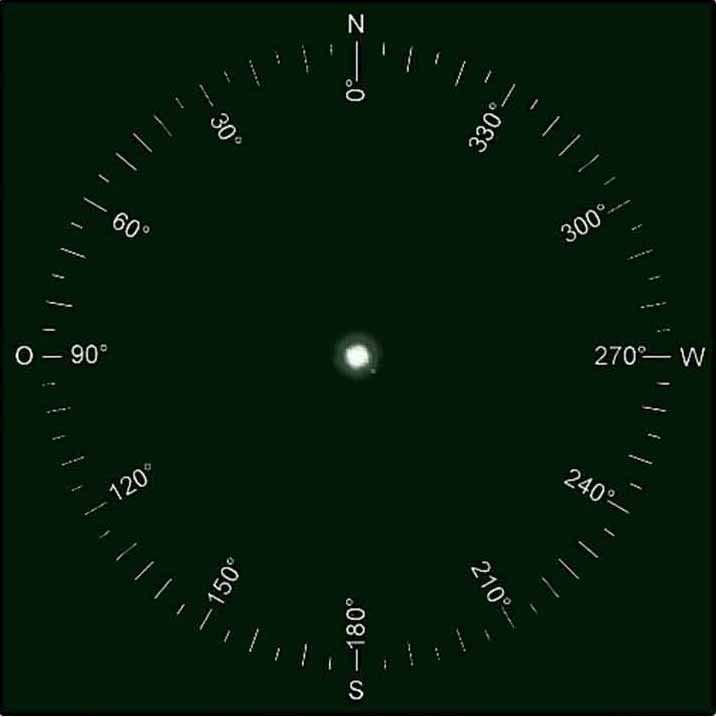
|
Uwe Pilz
Leipzig (Germany) |
105mm (200x) |
Nicht gesehen, wahrscheinlich ist der Begleiter zu schwach für leicht diesigen Himmel |
|
Uwe Pilz
Leipzig (Germany) |
105mm (288x) |
erster Ring in SSW heller, zweiter nur an dieser Stelle sichtbar |
|
Mark McCarthy
Fremont (California/USA) |
178mm (205x) |
Bright light yellow A and much fainter light orange B, wide about 6". Physical |
|
Axel Tute
Küssaberg (Germany) |
200mm (167x) |
13.03.2007: Das C8 braucht für die Trennung schon das 12mm RKE. PA geschätzt auf 180°. A ist grünlich |
|
Mark McCarthy
Fremont (California/USA) |
317mm (553x) |
Wasat = Delta Geminorum: Pretty white-yellow and red-orange pair, PA to west, ~4". |
|
|
|
★★★
|
STF1110, alpha Gem, 66 Gem, Castor |
|
AB |
1m.9 |
3m.0 |
5.4" |
53° |
2020 |
Gem |
07h34m35.86s / +31°53'17.80" |
|
|
|
|
AC |
1m.9 |
9m.8 |
71.6" |
164° |
2020 |
|
|
|
|
|
|
AD |
1m.9 |
10m.1 |
179.8" |
221° |
2017 |
|
|
|
|
Christopher Hay
Seeheim (Germany) |
20x60 |
AB: Handgehalten im Liegestuhl, Fernglas mit interner Stabilisierung. 16. April 2022 (5,5" Distanz nach Datenbank):
Deutlich gestreckt, wie ein längliches Rechteck an der Schwelle zu einer '8'. |
|
Christopher Hay
Seeheim (Germany) |
26x42 |
AB: 13. Mai 2022 (5.5" Distanz nach Datenbank). Mond vierfünftel-voll wenige Grad nördlich von Spica in der Jungfrau. 70mm-Fernglas auf 42mm Öffnung abgeblendet. Direkt nach Mondbeobachtung konnte ich Castor AB sicher trennen und die Trennung eine volle Minute halten, erst dann fing sie an, unsicher zu werden. Wiederholte die Beobachtung mehrfach, jedesmal mit sicherer Trennung. |
|
Christopher Hay
Seeheim (Germany) |
32x70 |
AB: 13. März 2022 (5.5" Distanz nach Datenbank): Mond nur 6° entfernt und zweidrittel-voll mitten in den Zwillingen. Nach konzentrierter Beobachtung des Mondes schwenkte ich schnell nach Castor um die kurzzeitig erhöhte Sehschärfe nach Betrachtung des hellen Mondes auszunutzen. Castor fein und klar getrennt mit schwarz zwischen A und B. Trennung wurde nach einer Weile schwieriger, konnte aber gehalten werden.
Steckte zum Vergleich dasselbe Okular, welches ich im achromatischen 70/400 Fernglas verwendet hatte, in ein 71/400 Fluorit-Apo Teleskop, folglich wieder mit der Vergrößerung von 32x. Wieder konnte ich A und B direkt nach Mondbeobachtung trennen. Die Trennung war jedoch mit dem Mono-Apochromat schwieriger zu halten als zuvor mit dem Bino-Achromat. |
|
Christopher Hay
Seeheim (Germany) |
36mm (33x) |
AB: 16. April 2022 (5,5" Distanz nach Datenbank): Mit Polfilter des Typs Käsemann (KSM) bei 33x berühren sich die Beugungsscheibchen, scheinen in guten Momenten auseinander zu gehen, dies jedoch unsicher. Ohne Polfilter bei 33x nur eine gedrungene '8' weit von der Trennung entfernt.
Mit Polfilter bei 40x eindeutig getrennt, hübscher erster Beugungsring der Komponente A. Ohne Filter eine gestreckte '8' ohne Trennung.
Bei 50x klar und stabil getrennt mit und ohne Filter. Bei 66x bester Anblick, ein zartes Paar vor pechschwarzem Himmelshintergrund, die ersten Beugungsringe von A und B sich vereinigend, jener von B sehr schwach.
Ähnliche Effekte im Vergleich zum KSM Polfilter bei 33x sowie 40x mit einem Baader Neodymium Filter, Klarheit der Trennung jedoch nicht ganz so gut wie mit dem Polfilter. |
|
Robert Zebahl
Leipzig (Germany) |
55mm (27x) |
AB: Bei 27x sichtbarer Helligkeitsunterschied. Doppelstern erscheint als '8'. Bei 38x klar getrennt, aber dicht zusammen. |
|
Robert Zebahl
Leipzig (Germany) |
63mm (26x) |
AB: Experiment zur Ermittlung der kleinsten Vergrößerung zur Trennung von Castor. Ich beobachtete am 09.05.2022, 11.05.2022 & 18.05.2022.
Bei 26x und 30x deutlich als Doppelstern erkennbar, aber durch Überstrahlung nicht klar trennbar. Bei 70x natürlich einfach getrennt. Abgeblendet auf 30mm Öffnung erschien Castor bei 26x teils getrennt, aber sehr knapp. Die richtige Einblickposition am Okular war wichtig. Bei 30x mit 30mm Öffnung war Castor sauber getrennt, aber extrem dicht.
Einem Hinweis von Christopher Hay folgend nutzte ich auch einen Rotfilter von Baader, um eine Überstrahlung bei voller Öffnung zu vermeiden. Nun war auch eine Trennung bei 26x möglich, wobei die Komponenten extrem dicht beieinander standen.
In Summe scheint für mich eine Vergrößerung von 26x das Minimum zu sein, um Castor sauber zu trennen, sofern die Helligkeit der Komponenten hinreichend reduziert wird. |
|
Robert Zebahl
Leipzig (Germany) |
70mm (44x) |
AB: Bei 44x als '8' sichtbar, bei 100x klar getrennt bei deutlichem Helligkeitsunterschied. Beide Komponenten wirkten weiß. |
|
Axel Tute
Küssaberg (Germany) |
70mm (146x) |
AB: 11.03.2009: Mit dem 6mm Ortho und dem 4.8mm Plössl getrenn. A: bläulich B: orange |

|
Axel Tute
Küssaberg (Germany) |
70mm (146x) |
AB: 23.03.2010: B mit deutlichem Abstand. |
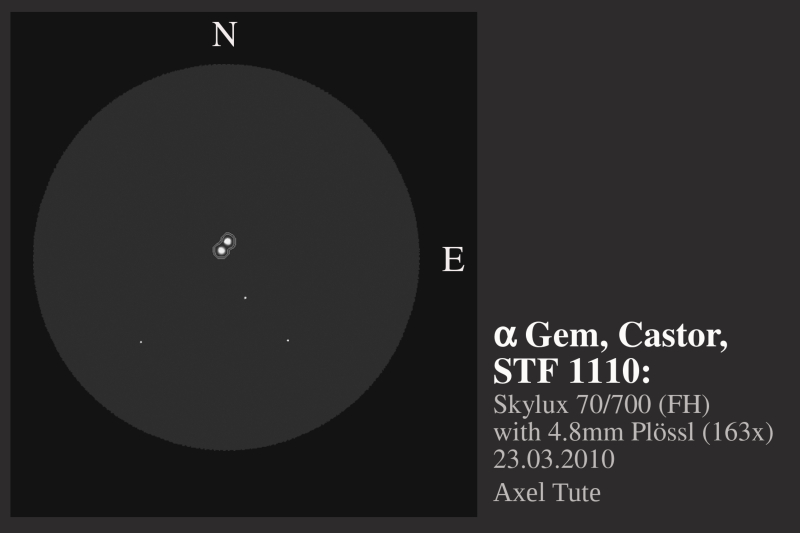
|
Christopher Hay
Seeheim (Germany) |
76mm (50x) |
AB: 18. Februar 2021: Bei 23x oval-elongiert mit eindeutiger Position von A. Bei 50x fein getrennt. Bei 83x bester Anblick mit leichter Überlappung der ersten Beugungsringe. Bei 100x schönes Muster der Beugungsscheibchen und der überlappenden ersten und zweiten Beugungsringe beider Komponenten. |
|
René Merting
Drachhausen (Germany) |
76mm (81x) |
AB: bei 57x sind zwei Murmeln erkennbar, die noch knappst aneinander kleben - bei 81x dann zeigen sich zwei helle Sterne knapp getrennt mit leichtem Farbkontrast, die A-Komponente im Süden schimmert leicht gelblich, B ist eine dreiviertel Magnitude schwächer und schön weiß |
|
René Merting
Drachhausen (Germany) |
100mm (107x) |
AB: bei 32x wirkt der Stern leicht länglich - bei 107x stehen die beiden Sterne schön eng mit überlagernden Beugungsscheibchen, die Komponenten sind dennoch getrennt erkennbar - Komponente B im Osten ist eine halbe Magnitude schwächer - ganz schwacher Farbkontrast |
|
Axel Tute
Küssaberg (Germany) |
100mm (163x) |
AB: 23.03.2010: Um A und B jeweils einen Beugungsring. Zwischen dem Beugungsringen noch eine deutliche Lücke |
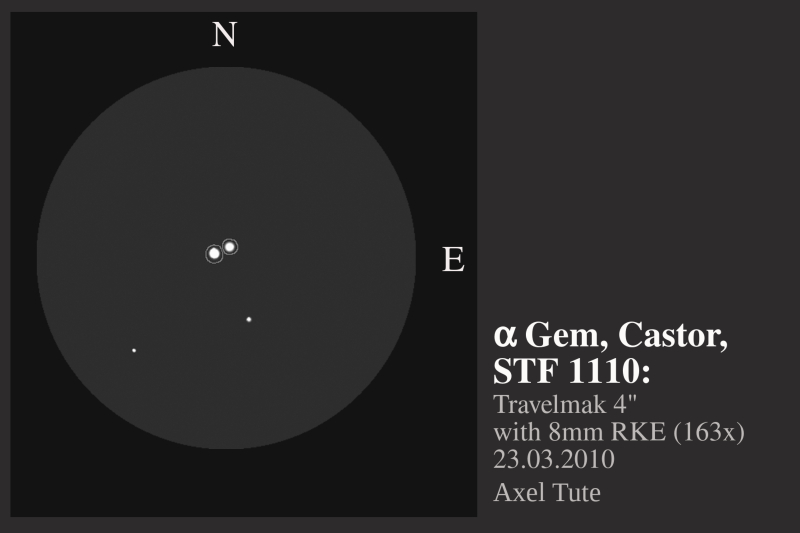
|
Uwe Pilz
Leipzig (Germany) |
105mm (144x) |
AB: blauweiß-weiß |
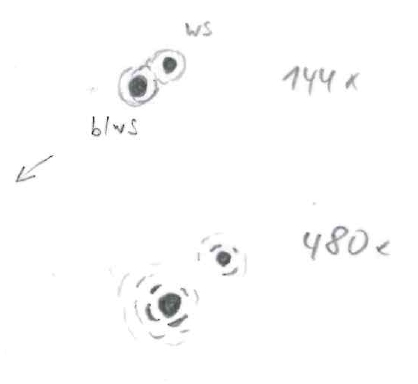
|
Winfried Kräling
Marburg (Germany) |
127mm (250x) |
AB: 13.03.2017: Beide Komponenten gelblich mit geringem Helligkeitsunterschied, bereits bei V=60x getrennt. |

|
Mark McCarthy
Fremont (California/USA) |
178mm (205x) |
AB: Castor. A is a very pale yellow and B is yellow-green, 2 delta mag, very bright, pretty wide, some fainter stars about. Physical with a 459.8-year period |
|
Christopher Hay
Seeheim (Germany) |
180mm (200x) |
AB: Zwei fette Scheinwerfer im All. Komponente B scheint auf den ersten Blick grünlich (farbreine Spiegeloptik), jedenfalls eine andere Tönung als Komponente A. Die zweiten Beugungsringe von A und B vereinigen sich. |
|
|
Frederik Wanink
Itterbeck (Germany) |
254mm |
AB |

|
|
|
★★
|
STF1126 |
|
AB |
6m.5 |
7m.0 |
0.9" |
176° |
2021 |
CMi |
07h40m06.99s / +05°13'51.90" |
|
|
Uwe Pilz
Leipzig (Germany) |
105mm (288x) |
beide gelb. Es war schwierig, die hellere Komponente zu erkennen. Direkt neben Prokyon. |

|
Mark McCarthy
Fremont (California/USA) |
317mm (553x) |
Wow, very close <1" hair-split, near equal brightness |
|
|
|
|
HO247 |
|
|
7m.7 |
9m.2 |
0.5" |
260° |
2014 |
Gem |
07h46m07.95s / +21°07'19.20" |
|
|
Mark McCarthy
Fremont (California/USA) |
508mm (533x) |
Clean split with seeing, 1 delta mag, fairly bright pair. I found the apodizing mask worked better than the 8-inch mask, gave more resolving power. The 8-inch was only snowman |
|
|
|
|
WRH15, 82 Gem |
|
AB |
6m.8 |
7m.3 |
0.3" |
28° |
2016 |
Gem |
07h48m33.65s / +23°08'27.50" |
|
|
Mark McCarthy
Fremont (California/USA) |
508mm (1067x) |
82 Gem. I see an elongated misshape, PA to the NNE, but not firm. Physical with a 580-year period. R.H. Wilson |
|
|
|
★
|
BU101, 9 Pup |
|
|
5m.6 |
6m.5 |
0.3" |
313° |
2021 |
Pup |
07h51m46.31s / -13°53'52.80" |
|
|
Mark McCarthy
Fremont (California/USA) |
508mm (1067x) |
9 Pup. Elongated to notched, orientation correct, light orange. Very tough. [B is coming off it's furthest orbit and will be exceptionally difficult in 10 years, but easier in 15 years] |
|
|
|
|
STT182 |
|
|
7m.8 |
7m.9 |
0.9" |
9° |
2017 |
CMi |
07h52m42.12s / +03°23'02.20" |
|
|
Mark McCarthy
Fremont (California/USA) |
203mm (333x) |
Compact white pair, more near equal than Sky Tools says, white, easy split |
|
Mark McCarthy
Fremont (California/USA) |
317mm (553x) |
Very close, ~1", near equal brightness white. |
|
|
|
★
|
STT185 |
|
|
7m.1 |
7m.3 |
0.4" |
22° |
2020 |
CMi |
07h57m16.39s / +01°07'37.30" |
|
|
Mark McCarthy
Fremont (California/USA) |
508mm (1067x) |
Without the apodizing mask I get a clean split with seeing but constant split with the mask. Light orange stars, noticeable mag difference |
|
|
|
★
|
BU581 |
|
AB |
8m.5 |
8m.8 |
0.5" |
242° |
2021 |
Cnc |
08h04m23.10s / +12°17'23.80" |
|
|
Mark McCarthy
Fremont (California/USA) |
317mm (553x) |
Light orange near equal, very small, elongated to notched. |
|
Mark McCarthy
Fremont (California/USA) |
508mm (1067x) |
With apodizing mask. Beautiful clean split, almost wide, light orange stars, slight mag difference. There is a third 2x fainter star further out, might be plus one. Wow. [3rd is AB-C, 8.46/11.78 5.5"] |
|
|
|
|
STF1187 |
|
AB |
7m.2 |
8m.0 |
3.1" |
21° |
2020 |
Cnc |
08h09m30.45s / +32°13'18.80" |
|
|
Robert Zebahl
Leipzig (Germany) |
70mm (57x) |
Getrennt. Komponenten sehr dicht zusammenstehend bei deutlichem Helligkeitsunterschied. |
|
Mark McCarthy
Fremont (California/USA) |
178mm (205x) |
White stars, a little more than 1 delta mag, wide about 4". Physical with a 1385.156-year period |
|
Mark McCarthy
Fremont (California/USA) |
317mm (553x) |
Yellow and orange, 1 delta mag, 5" |
|
Karsten Kopp
Köln (Germany) |
600mm (180x) |
Noch gut zu trennender Doppelstern mit leichtem Helligkeitsunterschied. Komponente A leuchtet gelblich weiß und Komponente B gelb. |
|
|
|
★★★
|
zeta Cnc, 16 Cnc |
STF1196 |
AB |
5m.3 |
6m.2 |
1.1" |
359° |
2021 |
Cnc |
08h12m12.79s / +17°38'51.20" |
|
|
|
STF1196 |
AB-C |
4m.9 |
5m.8 |
6.0" |
64° |
2020 |
|
|
|
|
|
STF1196 |
AC |
5m.3 |
5m.8 |
6.2" |
62° |
2020 |
|
|
|
|
|
HUT1 |
Ca-Cb |
6m.2 |
7m.1 |
0.3" |
344° |
2021 |
|
|
|
|
Robert Zebahl
Leipzig (Germany) |
70mm (133x) |
Das weite Paar AB-C ist bereits bei 22x trennbar. Das Paar AB zeigt dagegen bei 133x zwei sich deutlich überlappende Beugungsscheibchen mit geringem Helligkeitsunterschied, allerdings ohne Einschnürung. |

|
Christopher Hay
Seeheim (Germany) |
71mm (32x) |
AB-C: Fein getrennt. AB gelblich. Erheblicher Helligkeitsunterschied. |
|
Robert Zebahl
Leipzig (Germany) |
102mm (86x) |
AB-C: Einfach trennbar. A: helles Grau, B: blasses Orange. |
|
Stefan Loibl
Rosenheim (Germany) |
102mm (164x) |
AB-C leicht trennbar, AB deutlich elongiert aber nicht getrennt |
|
Uwe Pilz
Leipzig (Germany) |
105mm (288x) |
weißblau-gelb-gelb |
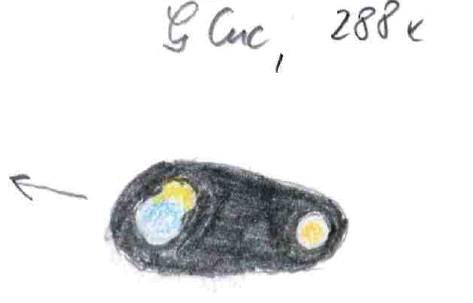
|
Robert Zebahl
Leipzig (Germany) |
120mm (67x) |
AB-C: Deutlicher Helligkeitsunterschied, einfach zu trennen. Farbe beider Komponenten ähnlich. |
|
Robert Zebahl
Leipzig (Germany) |
120mm (200x) |
AB: Sehr dicht zusammen. Die Beugungsscheibchen berührten sich noch. Leichter Helligkeitsunterschied erkennbar. Extrem schöner Dreifachstern! |
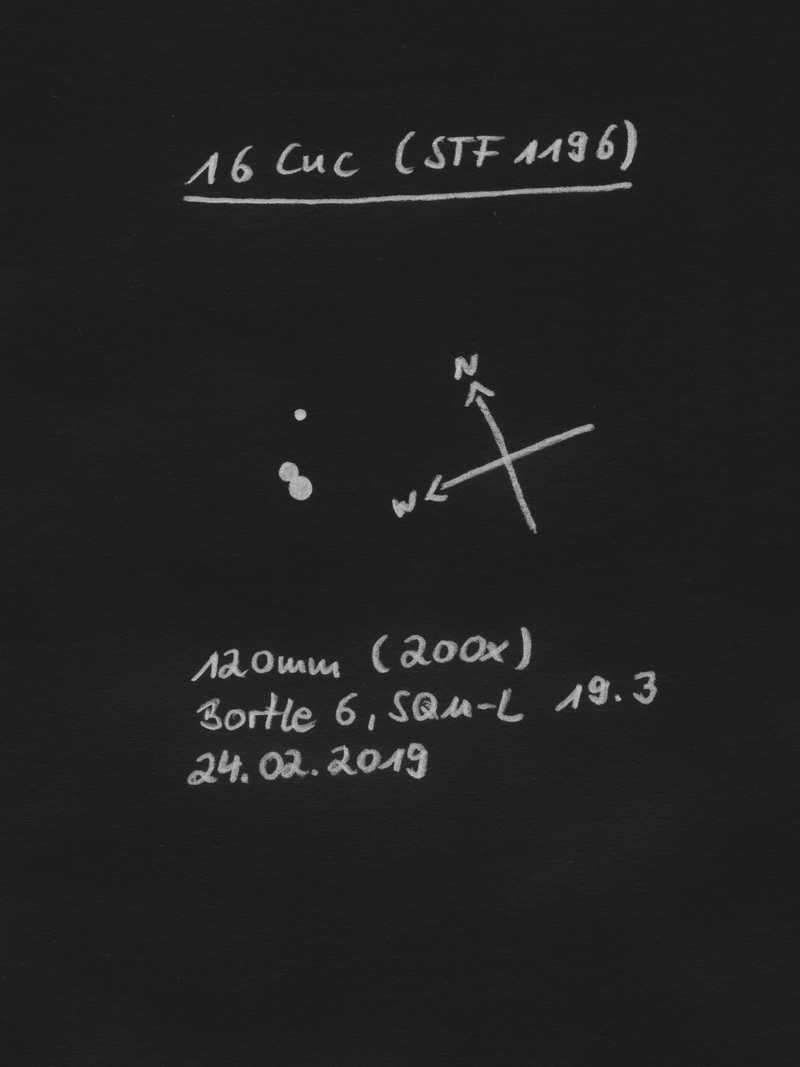
|
Winfried Kräling
Marburg (Germany) |
127mm (250x) |
08.04.2018: Sehr schön, 3-fach Stern, A = weißgelb, B = weißgelb, C = weißgelb |
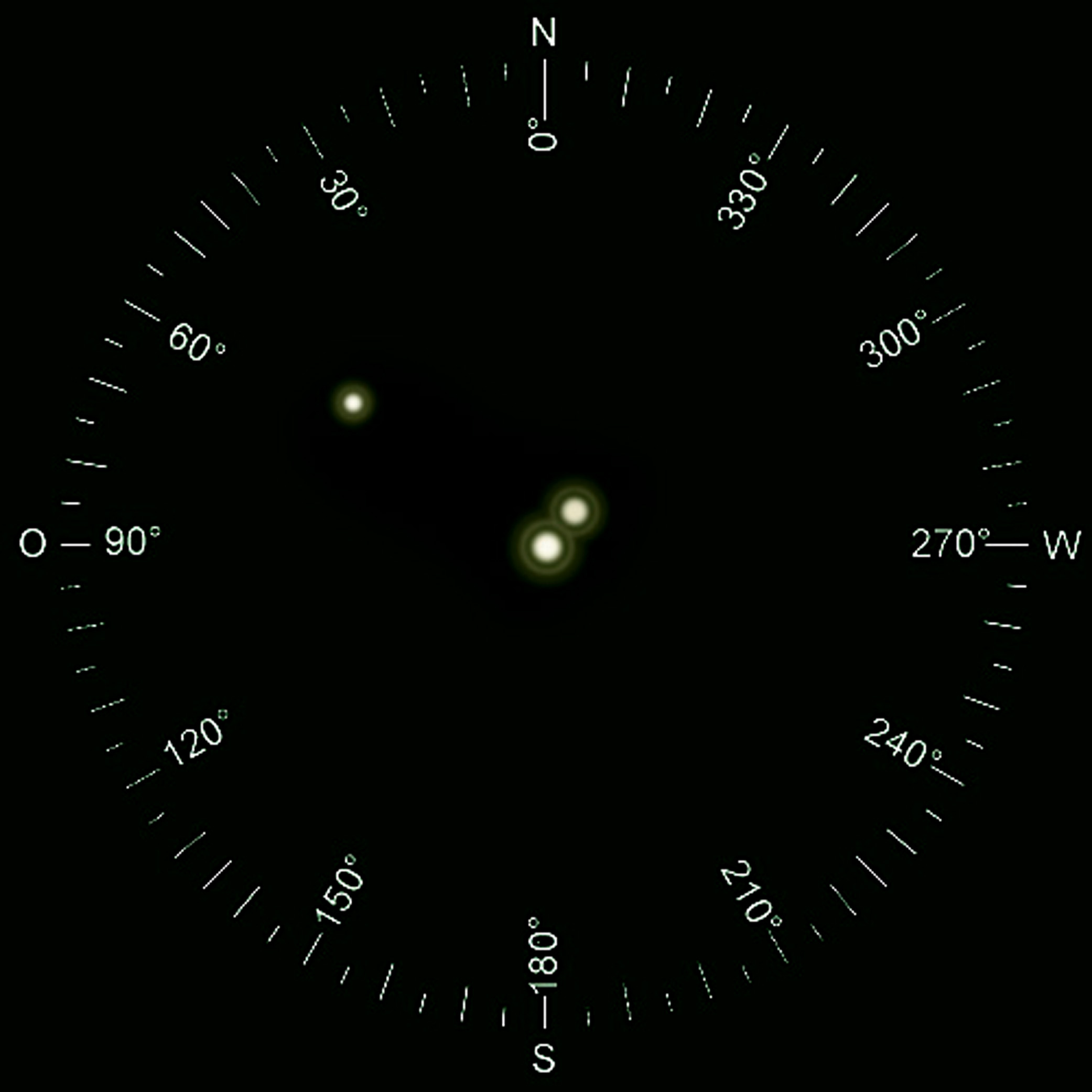
|
Sarah Gebauer
Germany |
150mm (83x) |
AB-C: bei 83x sind AB-C sauber getrennt, laut Atlas 2020 6,1'' Abstand, die Komponenten A und B mit 1,1'' lassen sich nicht trennen, viele schöne Feldsterne dabei |
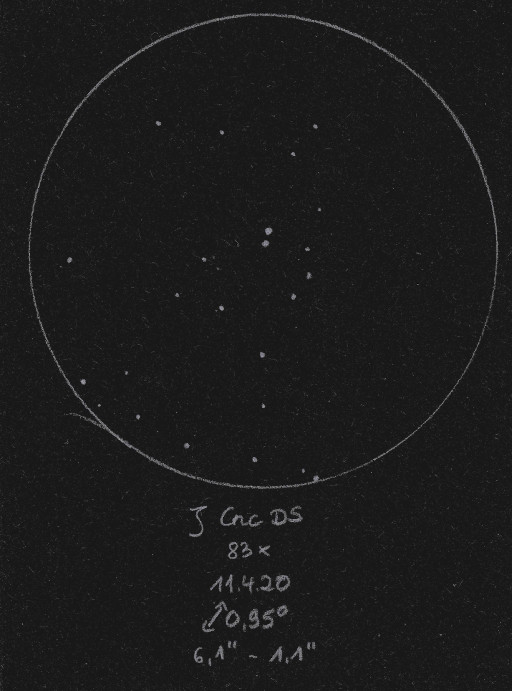
|
Christopher Hay
Seeheim (Germany) |
180mm (200x) |
AB: Haarfein getrennt. A und B gelblich-weiss. C weit von AB abgesetzt, blau-weiss, schöner Farbkontrast zu AB. |
|
Mark McCarthy
Fremont (California/USA) |
317mm (553x) |
Ca-Cb: not quite round, oval/olive shaped. It is the AB-C of STF 1196. |
|
Mark McCarthy
Fremont (California/USA) |
317mm (553x) |
AB: Triple, all near equal magnitude, yellow-white. AB ~0.8", hair split. |
|
Mark McCarthy
Fremont (California/USA) |
317mm (553x) |
AC: Triple, all near equal magnitude, yellow-white. AC ~6", wide split. |
|
Karsten Kopp
Köln (Germany) |
600mm (257x) |
AB: Die Komponenten AB-C bei etwas größerem Helligkeitsunterschied einfach zu trennen und auch schön anzusehen. Sterne erstrahlen weißlich gelb. Komponente AB war nicht zu trennen. |
|
|
Frederik Wanink
Itterbeck (Germany) |
254mm |
AB-C |

|
|
|
★
|
A1746, 24 Cnc |
|
BC |
8m.5 |
8m.5 |
0.2" |
4° |
2007 |
Cnc |
08h26m39.82s / +24°32'03.70" |
|
|
Mark McCarthy
Fremont (California/USA) |
508mm (1067x) |
Component of STF1224. I see a very subtle notched elongation, PA SSW, noticeable mag difference. Physical with a 21.78-year period, it is a nearly circular orbit and near periastron, it's apastron will be in 2029 at 0.16" |
|
|
|
|
HU714 |
|
Ba-Bb |
9m.8 |
10m.1 |
0.8" |
313° |
2012 |
Cnc |
08h26m56.47s / +32°11'47.30" |
|
|
Mark McCarthy
Fremont (California/USA) |
508mm (533x) |
Nicely split with seeing, 0.5-1.0 delta mag, 0.5" separation. Short period of 195.5 years, it is at apastron now and will remain there the rest of my lifetime |
|
|
|
★
|
A551, LO Hya |
|
AB |
7m.0 |
7m.1 |
0.4" |
63° |
2018 |
Hya |
08h28m29.16s / -02°31'01.60" |
|
|
Mark McCarthy
Fremont (California/USA) |
508mm (1067x) |
LO Hya. With apodizing mask. Easy split, noticeable half delta mag. Another fainter star further out likely +1 [The +1 is STF 1233 AB-C, 6.42/10.49 18.3". AB at furthest extent of orbit, will tighten considerably the next 20 years] |
|
|
|
|
AG154 |
|
|
9m.6 |
9m.8 |
2.7" |
1° |
2019 |
Cnc |
08h36m55.78s / +23°14'49.10" |
|
|
Mark McCarthy
Fremont (California/USA) |
508mm (533x) |
HO Cnc. Near equal well separated, light orange stars |
|
|
|
★★★
|
11 Hya, epsilon Hya |
SP1 |
AB |
3m.5 |
5m.0 |
0.1" |
324° |
2021 |
Hya |
08h46m46.51s / +06°25'07.70" |
|
|
|
STF1273 |
AB-C |
3m.5 |
6m.7 |
2.9" |
311° |
2020 |
|
|
|
|
|
STF1273 |
AB-D |
3m.5 |
12m.5 |
18.1" |
201° |
2017 |
|
|
|
|
|
STF1273 |
AB-E |
3m.5 |
10m.8 |
340.5" |
2° |
2015 |
|
|
|
|
|
STF1273 |
AB-F |
3m.5 |
10m.4 |
406.5" |
265° |
2015 |
|
|
|
|
Robert Zebahl
Leipzig (Germany) |
70mm (133x) |
AB-C: Nicht getrennt. Es war zwar eine leichte Aufhellung im ersten Beugungsring sichtbar, könnte aber auch von der leichten Koma des Refraktors kommen. |
|
Sarah Gebauer
Germany |
100mm (200x) |
AB-C: ist ein heller Stern vom Hydra-Kopf, nicht zu trennen, vermutlich, weil die Komponente AB zu hell strahlt |
|
Robert Zebahl
Leipzig (Germany) |
102mm (160x) |
AB-C: 27.03.2020: Der deutlich schwächere Begleiter ist gut als beinahe runder Knoten direkt am Beugungsring der Hauptkomponente zu sehen. Sehr schöner Anblick. Die Luft war mäßig ruhig (3/5). |
|
Uwe Pilz
Leipzig (Germany) |
105mm (200x) |
AB-C: bei 144x schwierig |
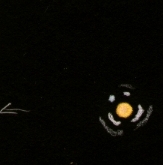
|
Robert Zebahl
Leipzig (Germany) |
152mm (150x) |
AB-C: 27.03.2020: Der Begleiter ist sofort als kleines Sternchen dicht an der Hauptkomponente zu sehen. Durch den Farbfehler des Achromaten kommt es zu einer leichten Überstrahlung. Dennoch ein schöner Anblick. Die Luft war mäßig ruhig (3/5). |
|
Mark McCarthy
Fremont (California/USA) |
508mm (533x) |
AB-C: Epsilon Hya A is bright orange-yellow, B is much fainter and a little blue, ~3". [SP 1 AB is 3.49/5.00 0.2" not seen] |
|
|
|
★
|
A2552 |
|
|
9m.1 |
8m.5 |
0.3" |
208° |
2018 |
Hya |
08h48m40.30s / +00°56'31.00" |
|
|
Mark McCarthy
Fremont (California/USA) |
508mm (533x) |
Wow fine split. Pale yellow A and blue B, about one delta mag. Nice split, amazing [82.4 year period] |
|
|
|
|
VDK3 |
|
|
9m.9 |
10m.1 |
1.0" |
199° |
2020 |
Cnc |
08h50m42.33s / +07°51'52.40" |
|
|
Mark McCarthy
Fremont (California/USA) |
508mm (410x) |
With apodising mask. A surprise short period find. Light orange stars -- they are carbon, HP Cnc. About 1 delta mag, more than 1" separation. Seeing is bloating the stars a bit, but can recorded the PA by drift, it follows a S-N line. J. Vanderdonck, who has three discoveries to his name in the WDS. Physical with a 223.9709-year period, it will make a quarter turn by 2040 |
|
|
|
|
STF1282 |
|
AB |
7m.6 |
7m.8 |
3.5" |
279° |
2019 |
Lyn |
08h50m44.28s / +35°04'15.40" |
|
|
Robert Zebahl
Leipzig (Germany) |
70mm (57x) |
Klar getrennt, aber dicht zusammenstehend mit sehr geringem Helligkeitsunterschied. Der Doppelstern bildet zusammen mit zwei weiteren Sternen ein spitzwinkliges Dreieck. |
|
|
|
|
A1584 |
|
|
9m.0 |
7m.7 |
0.6" |
97° |
2022 |
UMa |
08h53m08.05s / +54°57'11.00" |
|
|
Mark McCarthy
Fremont (California/USA) |
508mm (333x) |
Tight white stars, seeing is not very good but can still split it. It has a noticable magnitude difference, however I need to guess which one is A. I am able to estimate PA by drifting it across the field. [My PA is in the correct line but my A and B are reversed.] 70.89-year period, it is now at apastron and will make a very small turn in its arc by 2040 |
|
|
|
★
|
STF1291, 57 Cnc |
|
AB |
6m.1 |
6m.4 |
1.5" |
310° |
2019 |
Cnc |
08h54m14.65s / +30°34'45.80" |
|
|
|
|
AB-C |
5m.5 |
9m.2 |
54.6" |
204° |
2015 |
|
|
|
|
Robert Zebahl
Leipzig (Germany) |
70mm (133x) |
AB: Sofort als Doppelstern erkennbar. Beugungsscheibchen überlappen sich leicht ('8'). Helligkeitsunterschied erkennbar. |
|
Uwe Pilz
Leipzig (Germany) |
105mm (144x) |
gelb |
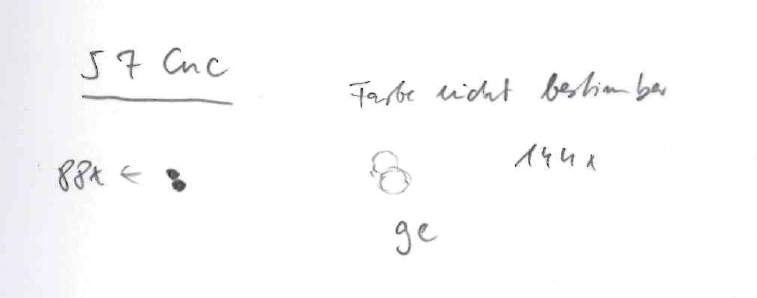
|
Sarah Gebauer
Germany |
150mm (125x) |
AB: sowohl bei 83x als auch bei 125x knapp vorm Trennen |
|
Mark McCarthy
Fremont (California/USA) |
203mm (205x) |
AB: 57 Cnc. Very nice pair, strong orange yellow colors, ~1 delta mag, bright, nice close split |
|
|
|
|
AG338 |
|
AB |
9m.0 |
9m.2 |
2.1" |
163° |
2021 |
Cnc |
08h54m41.52s / +16°36'39.70" |
|
|
Mark McCarthy
Fremont (California/USA) |
508mm (148x) |
IK Cnc. White stars, near equal, well split. Physical with a 1790-year period. A is TOK 196 0.2", not attempted, with just a 15-year period, need to go back! |
|
|
|
|
STF1280 |
|
AB |
8m.8 |
9m.1 |
3.8" |
359° |
2022 |
UMa |
08h55m24.82s / +70°47'39.20" |
|
|
|
|
AC |
8m.8 |
12m.4 |
398.4" |
88° |
2015 |
|
|
|
|
|
|
BC |
9m.1 |
12m.4 |
398.5" |
88° |
2015 |
|
|
|
|
Robert Zebahl
Leipzig (Germany) |
70mm (67x) |
AB: 03.04.2021: Eher schwacher Doppelstern mit noch recht dicht zusammenstehenden Komponenten und geringem Helligkeitsunterschied. |
|
René Merting
Drachhausen (Germany) |
320mm (72x) |
AB: bei 72x ein knapp getrenntes Sternpaar - beide Sterne sind annähernd gleich hell und strahlen rein weiß - bei 144x eine ordentlichere Trennung, Komponente A im Süden strahlt in einem wärmeren Weiß |
|
|
|
|
iota UMa, 9 UMa, Talitha |
HJ2477 |
A-BC |
3m.1 |
9m.2 |
2.4" |
90° |
2017 |
UMa |
08h59m12.45s / +48°02'30.60" |
|
|
|
HU628 |
BC |
9m.9 |
10m.1 |
0.9" |
206° |
2017 |
|
|
|
|
Robert Zebahl
Leipzig (Germany) |
152mm (300x) |
A-BC: 24.04.2020: Das Seeing (3/5) war nicht ausreichend gut für eine Trennung. |
|
Mark McCarthy
Fremont (California/USA) |
508mm (213x) |
A-BC: Iota UMa = Talitha. Using 25mm occulting bars with barlow, no mask, putting the bright star's diffraction spikes under the bars, I can see the hard point of the B star, brighter & closer than Procyon B outside of A's glare. One other field star. [HJ 2477's period is 2735 years. The short period is BC is HU 628 9.90/10.10 0.9" 39 year period -- how in the world did he see that?] |
|
|
|
|
STF1300 |
|
AB |
9m.5 |
9m.7 |
5.0" |
178° |
2022 |
Cnc |
09h01m17.48s / +15°15'56.80" |
|
|
Mark McCarthy
Fremont (California/USA) |
508mm (148x) |
Very light orange stars, one more white than the other, well separated, near equal. Physical with 878-year period |
|
|
|
★★
|
STF1306, sigma 2 UMa, 13 UMa |
|
AB |
4m.9 |
8m.8 |
4.4" |
346° |
2020 |
UMa |
09h10m23.53s / +67°08'03.30" |
|
|
|
|
AC |
4m.9 |
10m.3 |
197.8" |
148° |
2003 |
|
|
|
|
Robert Zebahl
Leipzig (Germany) |
70mm (100x) |
AB: Begleiter nahezu dauerhaft als längliche, nicht kondensierte Aufhellung des ersten Beugungsrings der Hauptkomponente im richtigen Positionswinkel sichtbar. |
|
Christopher Hay
Seeheim (Germany) |
76mm (20x) |
AB, April 2021: Kein Glück mit AB bei allen Vergrößerungen von 83x bis 167x.
AC: Komponente C sehr schwach und recht weit entfernt, wirkt nicht visuell wie ein Doppelstern. |
|
Mark McCarthy
Fremont (California/USA) |
80mm (150x) |
AB: Suspected very close unequal white stars. 920-year period, slowly widening |
|
Uwe Pilz
Leipzig (Germany) |
105mm (144x) |
AB: sehr schwierig bei 88x |

|
|
|
★★
|
STF1321 |
|
AB |
7m.8 |
7m.9 |
16.9" |
99° |
2019 |
UMa |
09h14m22.79s / +52°41'11.80" |
|
|
|
|
AC |
7m.8 |
14m.5 |
145.7" |
64° |
2010 |
|
|
|
|
|
|
AD |
7m.8 |
11m.9 |
136.4" |
129° |
2015 |
|
|
|
|
Robert Zebahl
Leipzig (Germany) |
16x70 |
AB: 05.07.2020: Sehr schöner Anblick, auffällig, einfach trennbar. Ein leichter Helligkeitsunterschied ist erkennbar. Auf den ersten Blick erschien der Doppelstern im Vergleich zu den umliegenden Sternen auffällig orange, bei genauem Hinsehen war ein Farbunterschied der beiden Komponenten sichtbar: orange & eher weiß. |
|
Robert Zebahl
Leipzig (Germany) |
70mm (22x) |
AB: 11.04.2020: Bei 22x recht weites Paar mit gleich hellen Komponenten. Farblich auffällig: leicht orange & weiß-bläulich, wobei die Zuordnung der Farben zu den Komponenten etwas schwierig war. Bei 44x etwas bessere Farbwahrnehmung. |
|
Robert Zebahl
Leipzig (Germany) |
70mm (31x) |
AB: 19.04.2020: Zusammen mit STF1312 in einem Gesichtsfeld. Bei 22x sehr schöner Anblick, einfach trennbar, schöner Abstand. Sofort auffällig. Ein Farbunterschied ist erkennbar: dunkelgelb, orange. Auch bei 44x schön anzuschauen. Bester Anblick bei 31x. |
|
Christopher Hay
Seeheim (Germany) |
71mm (32x) |
AB: April 2021: Gut getrenntes, gleichmäßiges Paar. Beide ins Orangene gehend.
Mit 180mm bei 200x ein weites, gleichmäßiges, visuell starkes Paar. Komponente A merklich heller als B. Beide zeigen eine zarte mandarinorangene Färbung, sehr ansprechend. |
|
René Merting
Drachhausen (Germany) |
76mm (29x) |
bei 29x ein wunderschön eng stehendes Sternpaar - bei beiden Sternen fällt sofort auf, dass sie nicht weiß sind - der westliche Stern strahlt intensiver, aber ein genauer Farbeindruck lässt sich nicht festmachen |
|
Sarah Gebauer
Germany |
100mm (49x) |
AB: bei 21-fach getrennt - zwei ganz feine Murmelchen, dicht beieinander - zunächst ein spontan warm orangefarbener Eindruck, bei näherem Hinsehen ist B goldorange, A leicht roségold - bei 49-fach verstärkt sich der Farbeindruck deutlich hin zu Orange mit Roségold - steht das Pärchen mittig im Gesichtsfeld, befinden sich ein paar wunderschön versprenkelte Sterne mit im Bild, das Pärchen dominiert jedoch durch seine Helligkeit und Farbe |
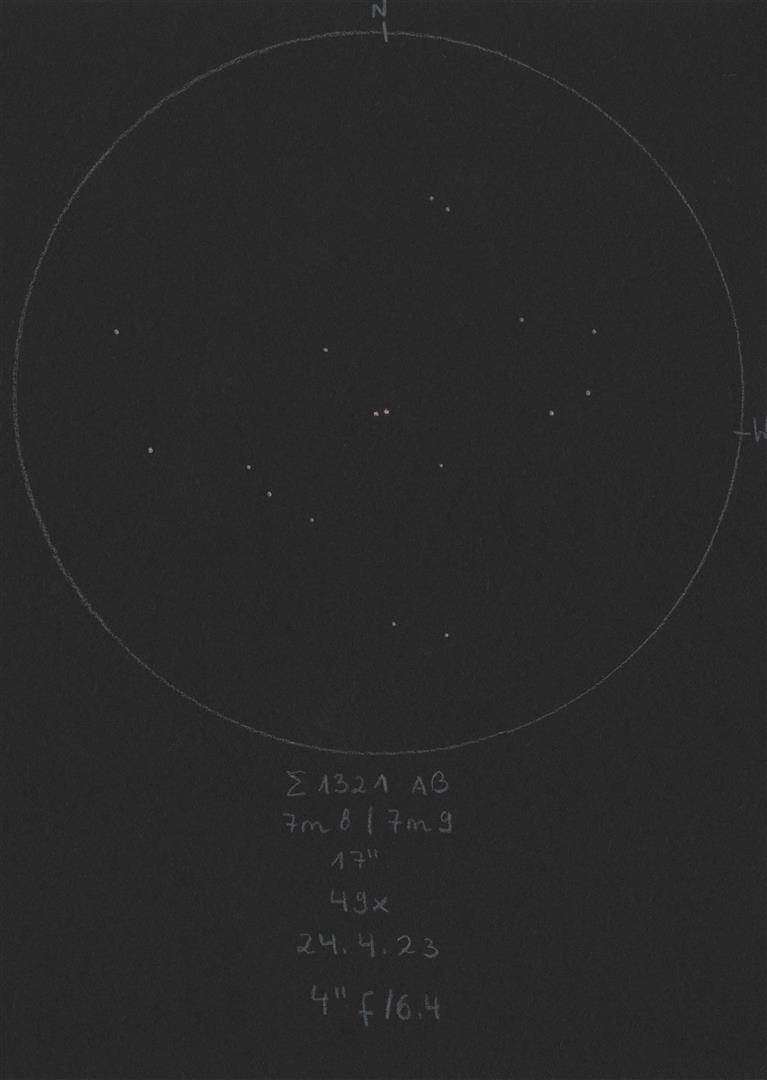
|
|
|
|
STF1332 |
|
|
7m.9 |
8m.1 |
5.9" |
29° |
2019 |
Cnc |
09h17m19.21s / +23°39'09.80" |
|
|
Christopher Hay
Seeheim (Germany) |
100mm (44x) |
Klar getrennt, etwas enger und visuell viel weniger mächtig als STF 1311 zwei Grad nach Nord-Südwesten.
STF 1332 ist 233 Lichtjahre von uns entfernt und hat den Vorzug einer dokumentierten Umlaufbahn, während STF 1311, in 190 Lichtjahre Abstand von uns, ein Common Proper Motion Pair ist. Folglich sehen wir hier zwei physikalische Paare, die sowohl an unserem Himmelszelt als auch tatsächlich im Raum recht nahe beieinander stehen. |
|
Mark McCarthy
Fremont (California/USA) |
203mm (333x) |
Near equal wide pair, ~5", maybe half delta mag |
|
|
|
★
|
STF3121 |
|
AB |
7m.9 |
8m.0 |
0.5" |
220° |
2021 |
Cnc |
09h17m53.45s / +28°33'37.70" |
|
|
Mark McCarthy
Fremont (California/USA) |
508mm (533x) |
IP Cnc Split at 533x, used 1067x to recheck orientation. With apodizing mask. Light yellow-orange stars, nice and clean split, very slight mag difference. Real nice |
|
Mark McCarthy
Fremont (California/USA) |
508mm (533x) |
IP Cnc. Light yellow-orange stars, 1 delta mag, clean well split. 34.17-year period, it's coming off apastron and will make a quarter turn by 2030. PA to the NE |
|
|
|
★
|
HO43 |
|
|
9m.3 |
9m.5 |
0.6" |
97° |
2017 |
Cnc |
09h18m36.25s / +20°48'49.40" |
|
|
Mark McCarthy
Fremont (California/USA) |
508mm (410x) |
Fine white stars, not quite 1 delta mag, very nice clean split. Wow. Physical with 358.6-year period, it will widen a couple tenths in the next 20 years |
|
|
|
★
|
STF1334, 38 Lyn |
|
AB |
3m.9 |
6m.1 |
2.6" |
224° |
2019 |
Lyn |
09h18m50.64s / +36°48'09.30" |
|
|
Uwe Pilz
Leipzig (Germany) |
60mm (198x) |
Aufhellung im ersten Ring |
|
Robert Zebahl
Leipzig (Germany) |
63mm (140x) |
Schwächere Komponente nur als dauerhafte Aufhellung auf dem ersten Beugungsring erkennbar. |

|
Christopher Hay
Seeheim (Germany) |
71mm (32x) |
Eine "8" mit eindeutigen Positionen und relativen Helligkeiten der Komponenten. Blau-weiss. |
|
Uwe Pilz
Leipzig (Germany) |
105mm (288x) |
gelb, trennbar bei 66x |
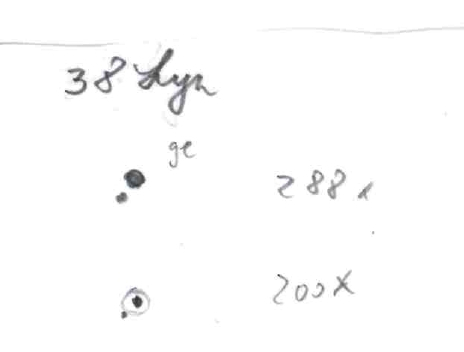
|
Mark McCarthy
Fremont (California/USA) |
178mm (205x) |
Very bright light blue A and 3 delta magnitude greenish B, close, about 3" separation. Physical with 2782 year period |
|
Christopher Hay
Seeheim (Germany) |
180mm (113x) |
Sauber getrennt, grosser Helligkeitsunterschied. Winkelabstand ungefähr 1.5mal so gross wie beim nahen STF1333. |
|
|
|
|
STF1338 |
|
AB |
6m.7 |
7m.1 |
1.2" |
318° |
2022 |
Lyn |
09h20m59.40s / +38°11'17.90" |
|
|
Mark McCarthy
Fremont (California/USA) |
508mm (333x) |
Wonderful light yellow stars, near equal, ~1" separation |
|
|
|
|
STT201 |
|
AB |
8m.5 |
9m.5 |
1.4" |
206° |
2017 |
Leo |
09h23m54.55s / +27°53'54.90" |
|
|
Mark McCarthy
Fremont (California/USA) |
203mm (205x) |
Extremely fine split, with seeing only, finest of the night, significant mag difference, just above 1" separation |
|
|
|
★★
|
STF1348 |
|
AB |
7m.5 |
7m.6 |
2.0" |
314° |
2018 |
Hya |
09h24m28.48s / +06°21'01.80" |
|
|
Robert Zebahl
Leipzig (Germany) |
70mm (100x) |
10.04.2020: Bei 67x deutlich länglich, bei 80x klar als '8' erkennbar. Bei 100x war ein sehr geringer Helligkeitsunterschied erahnbar, bei 133x sichtbar. Nahe dem Doppelstern STF 1355. |
|
Uwe Pilz
Leipzig (Germany) |
105mm (144x) |
Im selben Aufsuchfeld wie stf1355, ähnliche Erscheinung |
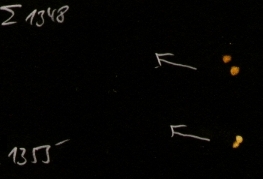
|
Mark McCarthy
Fremont (California/USA) |
203mm (333x) |
Very pretty half delta mag, ~2" pair, white. Sharp despite low declination |
|
|
|
|
A2477 |
|
|
7m.5 |
9m.2 |
0.5" |
5° |
2016 |
Leo |
09h24m31.21s / +18°08'29.10" |
|
|
Mark McCarthy
Fremont (California/USA) |
178mm (410x) |
Notched elongation, slight magnitude difference, light yellow stars. Physical with a 250 year period in a nearly circular orbit (we see it face-on) |
|
|
|
|
A222 |
|
|
9m.1 |
9m.4 |
0.4" |
4° |
2022 |
Leo |
09h26m02.33s / +28°39'01.50" |
|
|
Mark McCarthy
Fremont (California/USA) |
508mm (667x) |
Suspect it at all powers up to 667x, where I get a persistent clean split through the seeing. Light orange stars, 1 delta, PA just east of north. 155.08-year period, it will only cross the north line to head west by 2030 |
|
|
|
★★
|
STF1355 |
|
|
7m.7 |
7m.8 |
1.7" |
356° |
2021 |
Hya |
09h27m16.69s / +06°13'59.00" |
|
|
Robert Zebahl
Leipzig (Germany) |
70mm (100x) |
10.04.2020: Bei 67x deutlich länglich, gleich hell. Bei 80x ist eine Einkerbung wahrnehmbar. Bei 100x und 133x deutlich als '8' erkennbar. Nahe dem Doppelstern STF 1348. |
|
Uwe Pilz
Leipzig (Germany) |
105mm (144x) |
Im selben Aufsuchfeld wie stf1348, ähnliche Erscheinung |

|
Mark McCarthy
Fremont (California/USA) |
203mm (333x) |
Light yellow pair, near equal, very nice, ~2" |
|
|
|
|
HU1128, 11 LMi |
|
|
4m.8 |
12m.5 |
7.3" |
58° |
2018 |
LMi |
09h35m39.50s / +35°48'36.40" |
|
|
Mark McCarthy
Fremont (California/USA) |
317mm (553x) |
11 LMi: Very faint A & extremely faint B, wide separation. From the orbital chart this is approaching maximum elongation now (May 2017), by 2143 it will be 1". Only 39 light years away. |
|
|
|
★
|
STF1362 |
|
|
7m.0 |
7m.2 |
4.9" |
125° |
2017 |
Dra |
09h37m56.18s / +73°04'49.50" |
|
|
Robert Zebahl
Leipzig (Germany) |
70mm (31x) |
21.04.2020: Bei 22x noch extrem dicht beisammen, aber trennbar. Bei 31x sehr feine Trennung. Beide Komponenten wirkten weiß. Sehr schöner Anblick! Bei 57x gut getrennt, ähnlich hell. Eine Komponente erschien weiß-gelblich mit einem Hauch von Orange, die andere eher weiß. |
|
|
|
|
STF1374 |
|
AB |
7m.3 |
8m.7 |
2.8" |
312° |
2019 |
LMi |
09h41m21.88s / +38°57'01.90" |
|
|
Robert Zebahl
Leipzig (Germany) |
70mm (100x) |
01.04.2020: Bei 67x trennbar, aber schwierig wegen Überstrahlung durch die Hauptkomponente. Ab 80x klar trennbar mit deutlichem Helligkeitsunterschied. Der Begleiter steht dicht an der Hauptkomponente und erscheint als kleines Sternchen. Schöner Anblick. |
|
Robert Zebahl
Leipzig (Germany) |
120mm (168x) |
Bei 50x länglich, bei 75x als '8' erkennbar. Bei 168x klar getrennt mit deutlich schwächerer Komponente. |
|
Mark McCarthy
Fremont (California/USA) |
508mm (333x) |
Pretty orange-yellow stars, ~2 delta mag, ~3 separation |
|
Karsten Kopp
Köln (Germany) |
600mm (180x) |
Doppelstern ist gut zu trennen, mit klarem Helligkeitsunterschied. Beide Sterne erstrahlen weißlich. |
|
|
|
|
HO369 |
|
AB |
8m.0 |
9m.8 |
0.3" |
284° |
2020 |
LMi |
09h51m09.34s / +36°29'20.80" |
|
|
Mark McCarthy
Fremont (California/USA) |
508mm (1067x) |
With 533x I can tell this is not single, but the elongation is too tentative. At 1067x the best I can manage is elongated notched, with seeing. Seeing and transparency are not good enough |
|
|
|
★
|
STF1381 |
|
|
8m.9 |
9m.2 |
0.8" |
187° |
2017 |
UMa |
09h51m15.22s / +60°37'00.10" |
|
|
Mark McCarthy
Fremont (California/USA) |
178mm (205x) |
Finest split with seeing, very small scale at this magnification, light orange star, very significant magnitude difference. Physical with a 1787.6479-year period, this is actually one to watch because it is rapidly nearing periastron and will tighten over the next couple of decades |
|
|
|
★
|
STT208, phi UMa |
|
|
5m.3 |
5m.4 |
0.5" |
317° |
2022 |
UMa |
09h52m06.36s / +54°03'51.40" |
|
|
Uwe Pilz
Leipzig (Germany) |
105mm (260x) |
länglich, schwierig |
|
Mark McCarthy
Fremont (California/USA) |
178mm (333x) |
Tough in poor seeing and transparency. Bright white A, significant delta magnitude, B's PA a little north of west. There are three stars in a wide triangle in the field, B points to base line. Physical with 104.6-year period, it will widen slightly and will reach apastron by 2040 |
|
Christopher Hay
Seeheim (Germany) |
180mm (290x) |
4. April 2021 (0,43" Distanz nach Datenbank zum Zeitpunkt der Beobachtung): Bei 200x oval. Bei 290x deutlich elongiert mit klarem Positionswinkel. Mein persönlicher Rekord für Doppelstern-Erkennung und Positionswinkel-Wahrnehmung mit dem 7-Zöller. |
|
|
Frederik Wanink
Itterbeck (Germany) |
254mm |
|
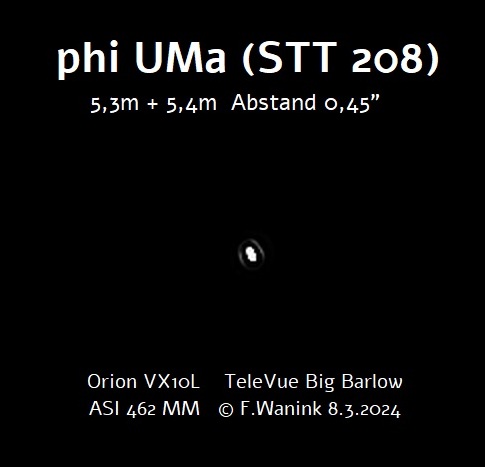
|
|
|
|
STF1389 |
|
|
9m.1 |
9m.5 |
2.4" |
290° |
2019 |
Leo |
09h52m26.17s / +26°58'53.80" |
|
|
Mark McCarthy
Fremont (California/USA) |
178mm (205x) |
White stars, around 1 delta mag, well separated. Physical with a 1454-year period |
|
|
|
|
AC5, gam Sex |
|
AB |
5m.4 |
6m.4 |
0.4" |
35° |
2021 |
Sex |
09h52m30.47s / -08°06'17.70" |
|
|
Mark McCarthy
Fremont (California/USA) |
508mm (533x) |
Gamma Sex: I get a split with seeing of nearly equal orange yellow stars, only momentarily |
|
|
|
|
STF1394 |
|
|
8m.9 |
9m.8 |
4.5" |
250° |
2019 |
UMa |
09h57m14.57s / +45°54'10.10" |
|
|
Mark McCarthy
Fremont (California/USA) |
178mm (205x) |
White stars, >1 delta mag, wide about 5". Physical |
|
|
|
|
HU874 |
|
|
6m.9 |
7m.9 |
0.1" |
291° |
2021 |
Leo |
10h11m38.19s / +13°21'18.70" |
|
|
Mark McCarthy
Fremont (California/USA) |
508mm (1067x) |
34 Leo. A notched elongation is the best I could see, not resolved well. Slight mag difference but really too hard to tell A from B. My PA estimate is off 90-degrees. This is rapidly closing and will be at periastron by the middle of 2022, opening again and should be better detectable again by 2029 when it will be 0.208". 17.962-year period |
|
|
|
|
STT213 |
|
AB |
8m.6 |
9m.8 |
1.1" |
125° |
2019 |
Leo |
10h13m08.88s / +27°25'10.50" |
|
|
Mark McCarthy
Fremont (California/USA) |
178mm (333x) |
Very tough at this aperture, I suspected it at 205x but can more consistently see it with 333x. A is a light orange star and B splits but is very tight, needed averted vision at first but it brightens and holds with foveal coaxing, but it s very faint indeed. Physical with a 192-year period, it's now at apastron and will stay there a while |
|
Mark McCarthy
Fremont (California/USA) |
317mm (277x) |
Bright yellow A, ~2 magnitudes fainter B, very wide separation. |
|
|
|
|
STT215 |
|
|
7m.2 |
7m.5 |
1.5" |
176° |
2019 |
Leo |
10h16m16.05s / +17°44'24.60" |
|
|
Robert Zebahl
Leipzig (Germany) |
70mm (133x) |
Teils getrennt wirkend, teils als '8' sichtbar. Kein Helligkeitsunterschied erkennbar. |
|
Uwe Pilz
Leipzig (Germany) |
105mm (288x) |
trennbar bei 120x |
|
Mark McCarthy
Fremont (California/USA) |
317mm (277x) |
very close split (1.7" separation) near equal bright white stars |
|
Mark McCarthy
Fremont (California/USA) |
508mm (333x) |
Near equal light yellow stars, ~1.5" |
|
|
|
★
|
STF1423 |
|
|
9m.4 |
10m.1 |
0.7" |
308° |
2018 |
Leo |
10h19m10.64s / +20°33'48.10" |
|
|
Mark McCarthy
Fremont (California/USA) |
317mm (553x) |
Tough! Elongated to hairline split. |
|
Mark McCarthy
Fremont (California/USA) |
508mm (533x) |
Split with seeing, light orange A and very faint, ~3 delta mag B, very close, within diffraction ring <1" |
|
|
|
★★
|
STF1424, gamma Leo, 41 Leo, Algieba |
|
AB |
2m.4 |
3m.6 |
4.7" |
127° |
2020 |
Leo |
10h19m58.35s / +19°50'29.40" |
|
|
René Merting
Drachhausen (Germany) |
12x42 |
ein unheimlich schöner, rapsgelber Stern - an eine Trennung ist natürlich nicht zu denken, aber das Gelb hat mich so fasziniert |
|
Christopher Hay
Seeheim (Germany) |
20x60 |
Handgehalten im Liegestuhl, Fernglas mit interner Stabilisierung. 14 May 2022 (4,7" Distanz nach Datenbank): Birnenförmig. Ein starkes orange-zitroniges Gelb, eine fruchtige Sache. Positionswinkel ohne vorherige Kenntnis auf 140° geschätzt, passt gut genug, zumal bei dieser niedrigen Vergrößerung, zum Datenbank-Wert von 127°. |
|
Christopher Hay
Seeheim (Germany) |
44x100 |
21. Mai 2022 (4,7" Distanz nach Datenbank): Haarfein getrennt, etwas schwierig wegen der mit diesem achromatischen (nicht apochromatischen) Fernglas aufgeblähten Sterne. Beide Komponenten orange, der Begleiter ins Gelbe gehend. Dünne durchziehende Wolken machen die Sternabbildung kompakter und die Trennung wesentlich deutlicher. Am Deutlichsten kurz bevor die Wolken so dicht werden, dass sie das Sternpaar verschlucken. |
|
Christopher Hay
Seeheim (Germany) |
36mm (50x) |
21. Mai 2022 (4,7" Distanz nach Datenbank): Bei 40x tief eingekerbt, bei 50x mit etwas Mühe getrennt, bei 66x klar und deutlich getrennt. |
|
Robert Zebahl
Leipzig (Germany) |
55mm (38x) |
Bei 38x trennbar, aber sehr dicht zusammen bei deutlichem Helligkeitsunterschied. Ab 56x wunderschöner Anblick beider Komponenten, deren Farbe ähnlich war. |

|
Robert Zebahl
Leipzig (Germany) |
55mm (59x) |
Sehr schön getrenntes, ungleiches Paar. A wirkte gelb-orange, B weiß-bläulich. |
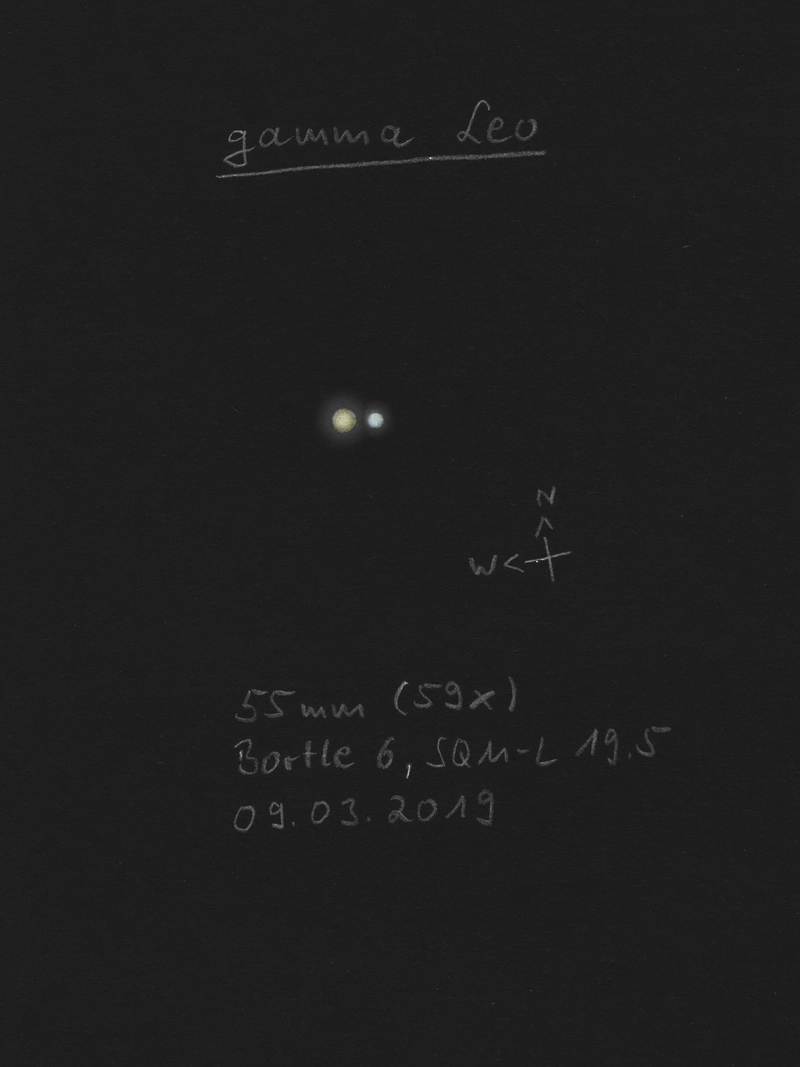
|
Christopher Hay
Seeheim (Germany) |
60mm (58x) |
Bei 25x ist Algieba schon sehr gestreckt. Bei 58x hauchfein getrennt mit deutlichem Helligkeitsunterschied. Bei 70x zwar stabiler getrennt, aber nicht so ansprechend wie bei 58x. Beide Komponenten erscheinen fett orange. |
|
Axel Tute
Küssaberg (Germany) |
70mm (88x) |
07.03.2009: Bei 88x Vergrösserung sind die Sterne noch zusammenhängend. Mit 117x Vergrösserung sind sie deutlich getrennt. A & B haben eine leicht gelbe Färbung. |
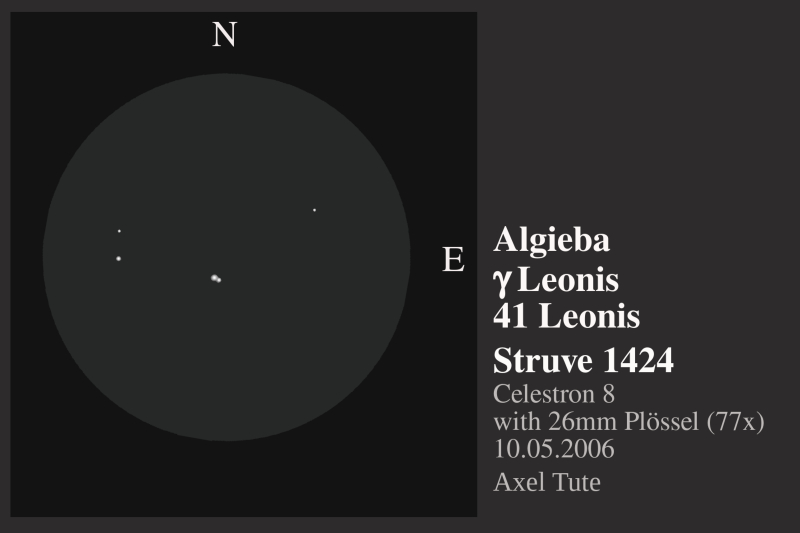
|
Robert Zebahl
Leipzig (Germany) |
70mm (100x) |
Bei 67x noch relativ enges Paar, aber gut getrennt bei recht deutlichem Helligkeitsunterschied. Bei 100x einfach zu trennen und sichtbarem Farbunterschied: A gelblich bis leicht orange, B weiß-gelblich. |
|
René Merting
Drachhausen (Germany) |
76mm (95x) |
Mondscheinnacht - bei 57x zwei goldgelbe Murmeln, die dicht aneinander kleben, die südöstliche, schwächere Murmel strahlt etwas tiefgelber - bei 95x dann zeigen sich beide Sterne mit unregelmäßig verlaufenden Beugungsringen und einem fetten gemeinsamen Halo - sie sind knapp getrennt erkennbar - B ist vielleicht eine Größenklasse schwächer - sehenswert |
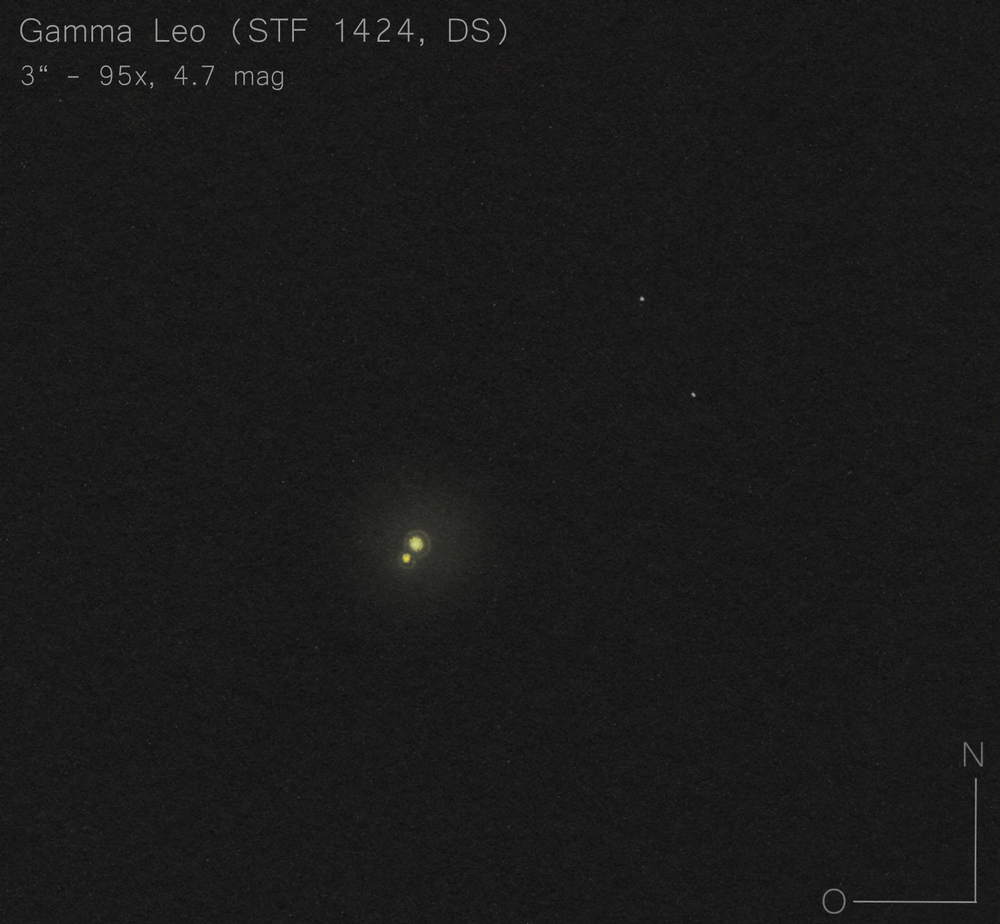
|
Sarah Gebauer
Germany |
100mm (80x) |
bei 80-fach fein, aber schön getrennt - Komponente A funkelt in einem warmen Goldgelb, die feinere und nur leicht schwächere Komponente B dicht östlich daneben zeigt einen ähnlichen Farbton, entsprechend ein bisschen weniger intensiv |
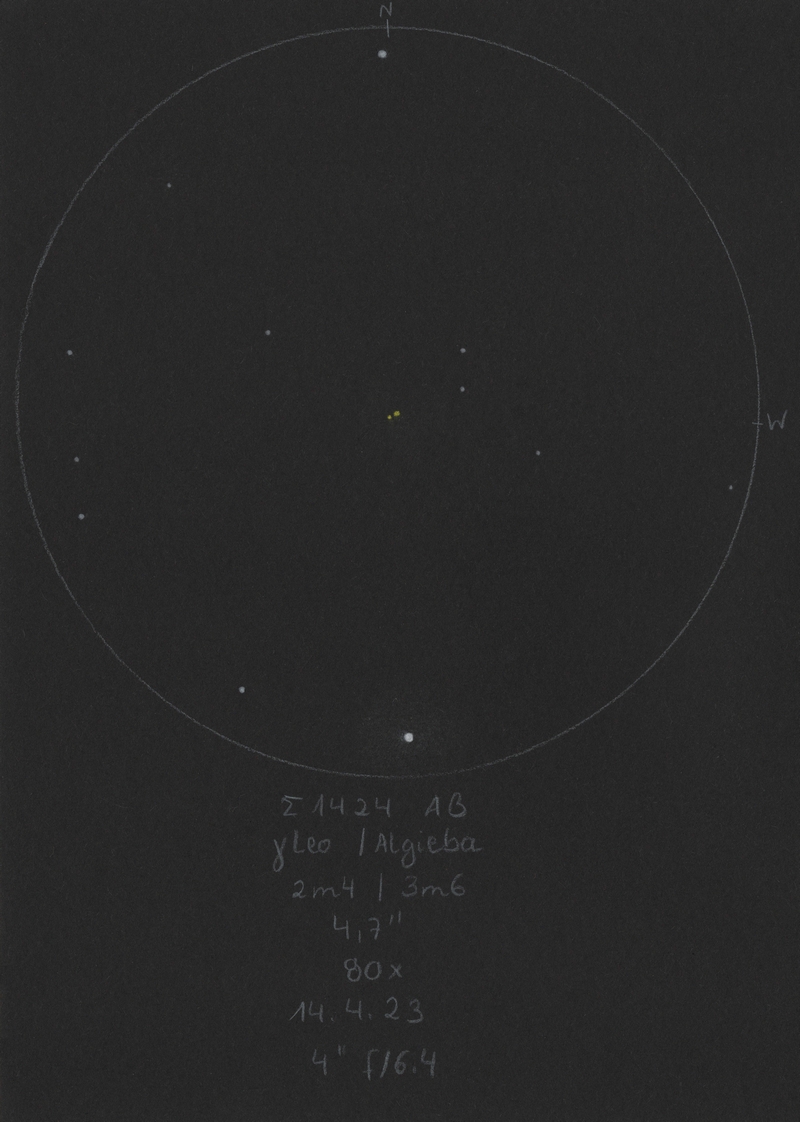
|
Robert Zebahl
Leipzig (Germany) |
102mm (125x) |
Sehr schön getrennt bei wunderbarem Helligkeits- und Farbkontrast. Hauptkomponente leicht orange, Begleiter gelblich. |
|
Stefan Loibl
Rosenheim (Germany) |
102mm (164x) |
sehr heller Doppelstern, mit leichtem Farbunterschied |
|
Uwe Pilz
Leipzig (Germany) |
105mm (120x) |
schon bei 37x sehenswert; trennbar bei 55x; orange-blauweiß |
|
Robert Zebahl
Leipzig (Germany) |
120mm (66x) |
Bei 48x als Doppelstern einfach zu erkennen. Erscheint als '8'. Bei 66x knapp, aber sicher getrennt bei sichtbarem Helligkeitsunterschied. |
|
Winfried Kräling
Marburg (Germany) |
127mm (250x) |
08.04.2018: merklicher Helligkeitsunterschied, A = gelb-orange, B = gelb-orange |

|
Sarah Gebauer
Germany |
150mm (83x) |
bei 83x sauber getrennt, ein leichter Farbunterschied (Weiß und helles Gelb) sichtbar |

|
Axel Tute
Küssaberg (Germany) |
200mm (77x) |
11.05.2006: Bei 77x sieht man deutlich, dass es ein Doppelstern ist. Eine 8 aber ohne Zwischenraum. Mit 167x ist dann ein deutlicher Zwischenraum zu sehen. A ist leicht bläulich. |
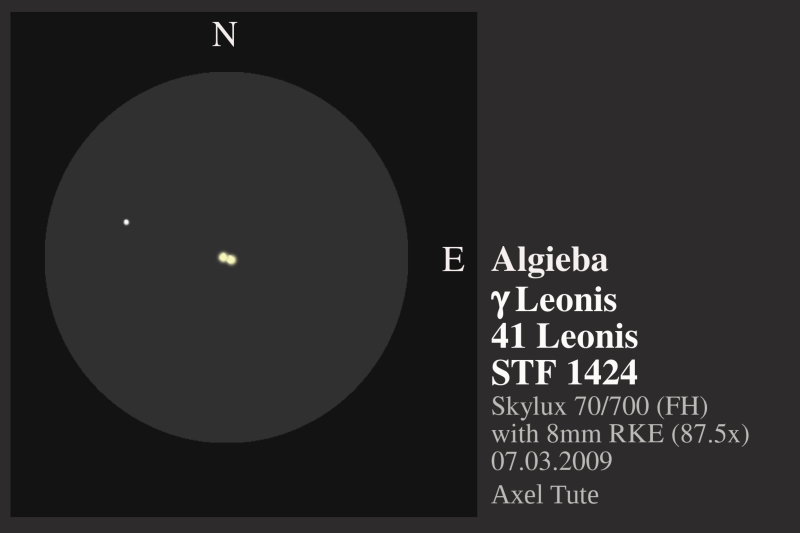
|
Mark McCarthy
Fremont (California/USA) |
317mm (277x) |
Algieba: Bright yellow and yellow-orange pair, 1 delta mag, 4-6" |
|
René Merting
Drachhausen (Germany) |
320mm (144x) |
bei 72x ist ein Stäbchen erkennbar - bei 144x zeigen sich zwei gelbe Murmeln, knapp getrennt |
|
René Merting
Drachhausen (Germany) |
320mm (240x) |
bei 240x sehe ich zwei ordentlich getrennte Sterne (naja, nicht wirklich Sterne, sondern wild zappelnde Glitzerbällchen) - Komponente A strahlt in einem zarten Gelb, B ist weiß - zurück auf 144x sehe ich nur ein Stäbchen mit leichter Einschnürung, so wild tanzen die Sterne |
|
Mark McCarthy
Fremont (California/USA) |
508mm (333x) |
Algieba. Very bright, A is yellow-orange and B is a blazing white orange, like a fire |
|
|
Frederik Wanink
Itterbeck (Germany) |
254mm |
|

|
|
|
★
|
STF1426 |
|
AB |
8m.0 |
8m.3 |
0.9" |
315° |
2022 |
Leo |
10h20m32.32s / +06°25'47.60" |
|
|
|
|
AB-C |
7m.3 |
9m.4 |
7.9" |
9° |
2022 |
|
|
|
|
René Merting
Drachhausen (Germany) |
100mm (107x) |
AB: bei 213x in guten Momenten als Stäbchen erkennbar
AB-C: bei 107x ist nördlich vom Hauptstern AB eine gut 2 Größenklassen schwächere Komponente erkennbar - AB ist weiß, C ist grau |
|
Robert Zebahl
Leipzig (Germany) |
102mm (160x) |
AB: Auf den ersten Blick länglich, bei genauem Hinsehen als '8' erkennbar. |
|
Robert Zebahl
Leipzig (Germany) |
102mm (160x) |
AB-C: Recht großer Abstand und damit einfach zu trennen. Die C-Komponente war allerdings ziemlich schwach. |
|
Stefan Loibl
Rosenheim (Germany) |
102mm (164x) |
AB-C leicht trennbar, A-B nicht trennbar |
|
Uwe Pilz
Leipzig (Germany) |
105mm (288x) |
A-B länglich, C weit |
|
Mark McCarthy
Fremont (California/USA) |
203mm (333x) |
AB: Split with seeing, white, very close, near equal. Part of plus one, a two delta mag not far away |
|
|
|
★★
|
STT216 |
|
|
7m.4 |
10m.3 |
2.5" |
228° |
2021 |
Leo |
10h22m43.81s / +15°20'39.70" |
|
|
Mark McCarthy
Fremont (California/USA) |
317mm (277x) |
A white and bright (7.3), B red & much fainter (10.3), a close split (2"). |
|
Mark McCarthy
Fremont (California/USA) |
508mm (333x) |
Yellow and very much fainter orange B, 1 delta mag, ~4" separated |
|
|
|
★
|
STF1429 |
|
|
9m.1 |
9m.3 |
0.8" |
155° |
2017 |
Leo |
10h25m01.79s / +24°36'44.10" |
|
|
Mark McCarthy
Fremont (California/USA) |
317mm (553x) |
Very tough. Faint, need averted vision to brighten and sharpen. Elongated to clean split in the best moments with seeing, near equal magnitude |
|
Mark McCarthy
Fremont (California/USA) |
508mm (533x) |
Elongated to hairline at 333x, split at 533x. Light orange stars, near equal |
|
|
|
★
|
STT217 |
|
|
7m.8 |
8m.6 |
0.8" |
150° |
2019 |
Leo |
10h26m53.01s / +17°13'09.90" |
|
|
Mark McCarthy
Fremont (California/USA) |
508mm (333x) |
Just split cleanly, ~1 delta mag, yellow-tinged white stars. Nice close pair |
|
|
|
★
|
STF1439 |
|
|
8m.3 |
8m.9 |
1.4" |
73° |
2019 |
Leo |
10h30m06.42s / +20°48'04.30" |
|
|
Mark McCarthy
Fremont (California/USA) |
508mm (333x) |
Very clean images, light yellow-orange stars, ~1 delta mag, well split, very pretty |
|
|
|
★
|
STF1454 |
|
|
9m.0 |
11m.0 |
1.3" |
358° |
2016 |
LMi |
10h38m11.10s / +26°36'24.80" |
|
|
Mark McCarthy
Fremont (California/USA) |
317mm (553x) |
Quite tough: averted vision only, very tight, similar magnitude, when seeing stills. |
|
|
|
|
STF1457 |
|
|
7m.7 |
8m.2 |
1.9" |
334° |
2021 |
Sex |
10h38m43.14s / +05°44'02.90" |
|
|
René Merting
Drachhausen (Germany) |
100mm (142x) |
bei 107x sehe ich in guten Momenten eine Stäbchen, manchmal auch schon leichte Einschnürungen - bei 142x zeigt sich das Sternpaar deutlich als 8 und mit etwas Geduld auch getrennt - B steht im NO und ist eine halbe Größenklasse schwächer - bei 213x dann eindeutige Trennung |
|
Mark McCarthy
Fremont (California/USA) |
508mm (333x) |
Attractive bright sunny yellow pair, more than 2" separation, slight mag difference |
|
|
|
|
A2768 |
|
|
6m.9 |
8m.4 |
0.6" |
237° |
2021 |
Sex |
10h42m37.53s / +03°34'58.90" |
|
|
Mark McCarthy
Fremont (California/USA) |
317mm (277x) |
Feels like a not round disk, but uncertain. |
|
Mark McCarthy
Fremont (California/USA) |
508mm (533x) |
34 Sex. Surprisingly difficult. Light orange A and a very small 2 delta mag pin prick appears within the first diffraction ring, so about 0.5" separation. Very tough. With seeing only |
|
|
|
|
A2771 |
|
|
9m.2 |
9m.7 |
0.6" |
109° |
2021 |
Sex |
10h44m38.71s / +05°29'55.00" |
|
|
Mark McCarthy
Fremont (California/USA) |
508mm (533x) |
Elongated with 333x but a good clean split with 533x. Stars settle to fine points with seeing , ~1 delta mag, ~0.5" separation |
|
|
|
|
STT228 |
|
|
8m.2 |
8m.9 |
1.7" |
170° |
2017 |
Leo |
10h47m16.93s / +22°34'32.00" |
|
|
Robert Zebahl
Leipzig (Germany) |
70mm (133x) |
27.04.2021: Leicht länglich. |
|
Mark McCarthy
Fremont (California/USA) |
508mm (533x) |
With fine focus, split with seeing, ~1 delta mag, ~1" separation. Pretty tough needed 533x to split, elongated at 333x |
|
|
|
★★
|
STT229 |
|
|
7m.6 |
7m.9 |
0.7" |
256° |
2020 |
UMa |
10h48m02.55s / +41°06'35.80" |
|
|
Mark McCarthy
Fremont (California/USA) |
317mm (553x) |
Just wider than a thin hair split of equal white stars, ~8th mag. 0.63"! in 40 years it will be 0.2" |
|
|
|
|
A2373 |
|
|
8m.8 |
8m.8 |
0.2" |
222° |
2013 |
Leo |
10h52m02.94s / +16°05'44.00" |
|
|
Mark McCarthy
Fremont (California/USA) |
508mm (889x) |
Just split hairline at best moments, touching disks otherwise, 1 delta mag, very tough. In my notes I put the PA to the NNE, but this is a reversal of what is listed as SE. 100.26-year period, 0.218" now, it will make a barely perceptible arc to the south in the next couple of decades |
|
|
|
|
STF1500 |
|
|
7m.9 |
8m.3 |
1.3" |
299° |
2021 |
Leo |
11h00m02.02s / -03°28'16.50" |
|
|
Mark McCarthy
Fremont (California/USA) |
178mm (205x) |
Very fine white stars, ~1 delta, ~1.5". Physical with a 680-year period |
|
|
|
★
|
UC2059 & HDS1574 & COU1422 |
HDS1574 |
Aa-Ab |
7m.6 |
11m.1 |
0.3" |
99° |
2019 |
UMa |
11h01m45.73s / +36°40'41.60" |
|
|
|
UC2059 |
AB |
7m.5 |
10m.7 |
46.6" |
46° |
2015 |
|
|
|
|
|
COU1422 |
Ba-Bb |
11m.2 |
11m.5 |
0.7" |
47° |
2016 |
|
|
|
|
Mark McCarthy
Fremont (California/USA) |
317mm (553x) |
UC2059 (AB): Pretty well separated, 1.5 delta mag, not remarkable as I hoped given the odd designation. |
|
Mark McCarthy
Fremont (California/USA) |
762mm (1219x) |
COU1422 (Ba-Bb): Cou 1422 is a pair of 11th magnitude stars very close to UC 2059 -- best I could get of Cou 1422 was an elongation with the seeing. Tried 1219x without improving the elongation. |
|
|
|
★
|
A1590 |
|
|
8m.9 |
9m.6 |
1.5" |
327° |
2017 |
UMa |
11h03m27.91s / +54°31'33.00" |
|
|
Mark McCarthy
Fremont (California/USA) |
178mm (205x) |
Light orange A and blue-green B, >1" separation, half delta mag. Physical with 163-year period, it's not at apastron and won't make significant change for several decades |
|
|
|
★★
|
BU1077, alpha UMa, 50 UMa, Dubhe |
|
AB |
2m.0 |
5m.0 |
0.8" |
342° |
2017 |
UMa |
11h03m43.84s / +61°45'04.00" |
|
|
|
|
AC |
2m.0 |
7m.2 |
384.5" |
206° |
2020 |
|
|
|
|
Christopher Hay
Seeheim (Germany) |
7x45 |
AC: Sehr weit auseinander aber dennoch zusammengehörig erscheinend. A ist goldgelb, C scheint blau zu sein, eine sehr attraktive Erscheinung.
A, B und C sind ein physikalisches Dreifachsystem in 123 Lichtjahren Abstand zu uns. Dies ist zufällig fast genau der gleiche Abstand zu uns wie SMA75 AB, ein weiteres Fernglas-Paar in UMa. |
|
René Merting
Drachhausen (Germany) |
18x70 |
AC: Dubhe oder Alpha Ursae Majoris - hm, naja - C zeigt sich im Süden in Riesenabstand zum intensivgelbem A - Komponente C wirkt dagegen wie eine graue Maus und der Helligkeitsunterschied ist so enorm, dass er nicht abschätzbar ist |
|
Christopher Hay
Seeheim (Germany) |
36mm (8x) |
Weit getrennt aber visuell noch zusammengehörig erscheinend (ist auch ein physikalisches Paar). A is cremig goldweiss. C wirkt sofort zartblau, der Farbeindruck schwindet jedoch nach einer Weile. Bei paralleler Beobachtung mit 3-Zöller bei 32x und 7-Zöller bei 67x will kein Farbeindruck von C aufkommen, ein interessanter Unterschied zur Beobachtung mit anderthalb Zoll. Ich schaue mit 7x42 Fernglas kurz hin, wieder erscheint C blau, wie immer mit Ferngläser aller Art. |
|
Robert Zebahl
Leipzig (Germany) |
70mm (22x) |
AC: 07.04.2020: Sehr weites, ungleiches & unscheinbares Paar. A erschien weiß-gelblich, bei C konnte ich keine Farbe ausmachen. |
|
René Merting
Drachhausen (Germany) |
76mm (29x) |
AC: die A-Komponente präsentiert sich bei 29x als wunderschön sattgelb strahlender Stern mit ordentlichem Halo - die B-Komponente steht weit entfernt im Süden, wirkt mehr als drei Größenklassen schwächer und wirkt weißgrau |
|
René Merting
Drachhausen (Germany) |
107mm (30x) |
AC: bei 30x weit, ach was, sehr weit auseinander stehend - Komponente B ist 3 Magnituden schwächer (nein, sogar 5 Magnituden lt. Stelle Doppie) - besonders imposant ist die Farbe von A, die sehr klar wirkt, champagnergelb würde ich sagen |
|
Uwe Pilz
Leipzig (Germany) |
120mm (120x) |
|
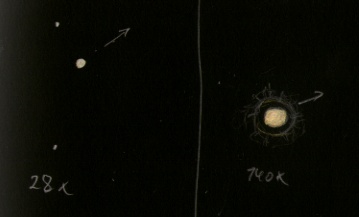
|
Robert Zebahl
Leipzig (Germany) |
152mm (43x) |
AC: 12.04.2022: Sehr weites und ungleiches Paar. Die Komponente A strahlt in einem hellen, glänzenden Orange, der Begleiter C wirkt eher weiß. |
|
Robert Zebahl
Leipzig (Germany) |
152mm (200x) |
AB: 12.04.2022: Bei Vergrößerungen zwischen 200x und 400x war nicht einmal ansatzweise etwas von einem Doppelstern zu sehen. Die Luft war einfach zu unruhig. |
|
|
|
★★
|
HO378 |
|
AB |
8m.2 |
9m.1 |
1.1" |
234° |
2020 |
UMa |
11h04m57.29s / +38°24'38.20" |
|
|
Mark McCarthy
Fremont (California/USA) |
317mm (553x) |
In a pretty cluster in the finder (~ 12 stars loose and poor, wide magnitude range, triangle shape). Pair is a fine split 1 delta mag 1", ice blue A and slightly yellow B. |
|
|
|
|
STF1510 |
|
|
7m.7 |
9m.0 |
5.6" |
328° |
2020 |
UMa |
11h08m00.06s / +52°49'17.90" |
|
|
René Merting
Drachhausen (Germany) |
100mm (64x) |
bei 32x wirkt der Stern leicht länglich - bei 64x dann gelingt die Trennung - Komponente B hängt nordwestlich über A und ist mehr als eine Größenklasse schwächer - ein schönes enges Paar bei dieser Vergrößerung - B wirkt trotz des Größenunterschiedes nicht so schmutzig grau, wie es sonst immer ist |
|
Mark McCarthy
Fremont (California/USA) |
178mm (205x) |
>1 delta mag, wide pair. Physical with a 3156.3519-year period |
|
|
|
★
|
STF1517 & BU1431 |
STF1517 |
AB |
7m.5 |
8m.0 |
0.7" |
313° |
2018 |
Leo |
11h13m40.99s / +20°07'43.30" |
|
|
|
BU1431 |
AB-C |
7m.5 |
10m.8 |
246.1" |
97° |
2015 |
|
|
|
|
Sarah Gebauer
Germany |
100mm (200x) |
STF1517 (AB): die Komponenten AB und C lassen sich natürlich problemlos bei geringer Vergrößerung trennen, für A und B reichen auch 200x nicht aus (Beobachtungsversuch erfolgte ohne vorherige Recherche, denn 0,7'' schafft mein Refraktor nicht) |
|
Robert Zebahl
Leipzig (Germany) |
102mm (187x) |
STF1517 (AB): 28.03.2020: Der Doppelstern erscheint sofort länglich. Bei genauem Hinsehen konnte der geringe Helligkeitsunterschied erkannt werden. Eine Einschnürung war nicht sichtbar. Höhere Vergrößerungen brachten keinen Gewinn. Beobachtung bei recht ruhiger Luft (4/5). |
|
Uwe Pilz
Leipzig (Germany) |
105mm (200x) |
STF1517 (AB): länglich |
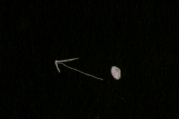
|
Robert Zebahl
Leipzig (Germany) |
152mm (225x) |
STF1517 (AB): 27.03.2020: Deutlich länglich. In ruhigeren Momenten war eine Einkerbung sowie ein geringer Helligkeitsunterschied erkennbar. Beobachtung bei mäßig ruhiger Luft (3/5). |
|
Mark McCarthy
Fremont (California/USA) |
317mm (340x) |
STF1517 (AB): Very tight, hair split small orange stars of equal magnitude. Wow! |
|
Mark McCarthy
Fremont (California/USA) |
508mm (533x) |
STF1517 (AB): Touching disks with 333x, clean slit with 533x, ~0.5" separation, Yellow-orange stars, near equal |
|
|
|
|
STF1516 & STT539 & HDS1603 |
STF1516 |
AB |
7m.8 |
8m.2 |
67.6" |
103° |
2017 |
Dra |
11h15m11.91s / +73°28'30.70" |
|
|
|
STT539 |
AC |
7m.8 |
11m.3 |
6.5" |
329° |
2017 |
|
|
|
|
|
STT539 |
BC |
8m.2 |
11m.3 |
72.2" |
287° |
2015 |
|
|
|
|
|
HDS1603 |
BD |
8m.2 |
10m.0 |
0.1" |
115° |
1991 |
|
|
|
|
Christopher Hay
Seeheim (Germany) |
15x45 |
STF1516 (AB): Fernglas handgehalten mit interner Stabilisierung. Weit getrennt. Recht gleichmäßiges Paar. Westliche Komponente etwas heller und wärmer. |
|
Sarah Gebauer
Germany |
100mm (49x) |
STF1516 (AB): 02.10.23: bei 21-fach ein recht schwaches, matt hellorangebraunes Pärchen - bei 49-fach ein sehr weit getrenntes Paar, recht dominant in der Bildmitte des ansonsten recht leeren Gesichtsfeldes - die östliche B-Komponente strahlt leicht in einem matten Orangebraun, die westliche A-Komponente warmweiß mit einem Hauch hellerem, kühlerem Orangebraun |
|
|
|
★★
|
STF1523, xi UMa, 53 UMa, Alula Australis |
|
AB |
4m.3 |
4m.8 |
2.3" |
152° |
2020 |
UMa |
11h18m10.90s / +31°31'45.00" |
|
|
Robert Zebahl
Leipzig (Germany) |
55mm (83x) |
09.02.2019: Bereits bei 83x als '8' erkennbar. Bei 125x konnte schön die Überlappung der beiden Beugungsscheibchen gesehen werden. Ein leichter Helligkeitsunterschied war erkennbar. |

|
Robert Zebahl
Leipzig (Germany) |
70mm (100x) |
18.02.2018: Sehr dicht zusammen bei nahezu gleicher Helligkeit. Auf den ersten Blick als '8' erkennbar, bei genauem Hinsehen teils auch getrennt sichtbar. Ähnlicher Anblick auch bei 128x. |
|
Robert Zebahl
Leipzig (Germany) |
70mm (133x) |
15.03.2020: Grandioser Anblick! Wunderschön getrennt bei sich fast berührenden Beugungsscheibchen. Der eher geringe Helligkeitsunterschied war gut sichtbar. Die Beugungsringe der beiden Komponenten verschmolzen miteinander. |
|
Mark McCarthy
Fremont (California/USA) |
80mm (150x) |
Alula australis. Slight magnitude difference, hairline split, light yellow A and darker yellow B. |
|
Sarah Gebauer
Germany |
100mm (136x) |
zwei gleich helle Murmelchen ganz dicht aneinander, sehr unruhiges Bild, beide Sterne strahlen warmweiß, ins Hellgoldene gehend, ohne Farbkontrast |
|
Robert Zebahl
Leipzig (Germany) |
102mm (160x) |
16.03.2020: Fantastisch! Hell mit schönen, zarten Beugungsringen. Der Abstand beider Komponenten ist kleiner als der Durchmesser der Beugungsscheibe der schwächeren Komponente. |
|
Uwe Pilz
Leipzig (Germany) |
105mm (288x) |
Gemessen: 162° |
|
Robert Zebahl
Leipzig (Germany) |
120mm (168x) |
14.02.2018: Gut trennbar bei leichtem Helligkeitsunterschied. |
|
Robert Zebahl
Leipzig (Germany) |
152mm (129x) |
06.02.2019: Wunderbar getrennt bei sichtbarem Helligkeitsunterschied. Die Farben der beiden Komponenten wirkten gleich. |
|
Mark McCarthy
Fremont (California/USA) |
508mm (333x) |
Alula Australis. Short period. Pretty orange-yellow stars, ~half delta mag, ~2" separation |
|
|
|
|
STF1527 |
|
|
7m.0 |
8m.0 |
0.5" |
308° |
2021 |
Leo |
11h18m59.91s / +14°16'06.90" |
|
|
Mark McCarthy
Fremont (California/USA) |
203mm (333x) |
At 205x I know something is up with this star. At 333x it is overlapping disks and notched. At 533x it is still only notched but a bit larger and hazier |
|
|
|
|
STF1534 |
|
|
8m.1 |
11m.1 |
5.1" |
314° |
2019 |
Leo |
11h21m49.34s / +18°11'24.00" |
|
|
Mark McCarthy
Fremont (California/USA) |
203mm (333x) |
Orange-yellow A, very faint B brightens with averted vision, but can hold direct. Wide, ~3 delta mag |
|
|
|
★
|
STF1536, iota Leo, 78 Leo |
|
AB |
4m.1 |
6m.7 |
2.3" |
92° |
2021 |
Leo |
11h23m55.37s / +10°31'46.90" |
|
|
|
|
AB-C |
4m.1 |
11m.1 |
332.1" |
346° |
2015 |
|
|
|
|
Robert Zebahl
Leipzig (Germany) |
70mm (133x) |
AB: 28.03.2020: Der Begleiter war gut als Aufhellung im Beugungsring der Hauptkomponente sichtbar. Zeichnung siehe Beobachtung mit dem 102-mm-Refraktor. |
|
Sarah Gebauer
Germany |
100mm (136x) |
AB: Iota Leo ist mit bloßem Auge schon zu erkennen - bei 49-fach taucht zunächst nur ein recht heller Stern in einem warmweißen Farbton auf - bei 80-fach wird die Farbe etwas gelblicher - bei 136-fach zeigt sich ostsüdöstlich eine Verdickung der Hauptkomponente |
|
Sarah Gebauer
Germany |
100mm (200x) |
AB: selbst bei 200x nur manchmal getrennt, eher schwierig mit Amiciprisma |
|
Robert Zebahl
Leipzig (Germany) |
102mm (125x) |
AB: 28.03.2020: Bei 125x deutlich getrennt zu sehen. Ein sehr schöner Anblick! Der Begleiter war als beinahe runde Aufhellung dicht am ersten Beugungsring der Hauptkomponente sichtbar. Der Beugungsring selbst erschien sehr zart. Bei 224x ebenfalls ein sehr schöner Anblick mit deutlichem Beugungsring und dem Begleiter, welcher nun rundlich wirkte. |
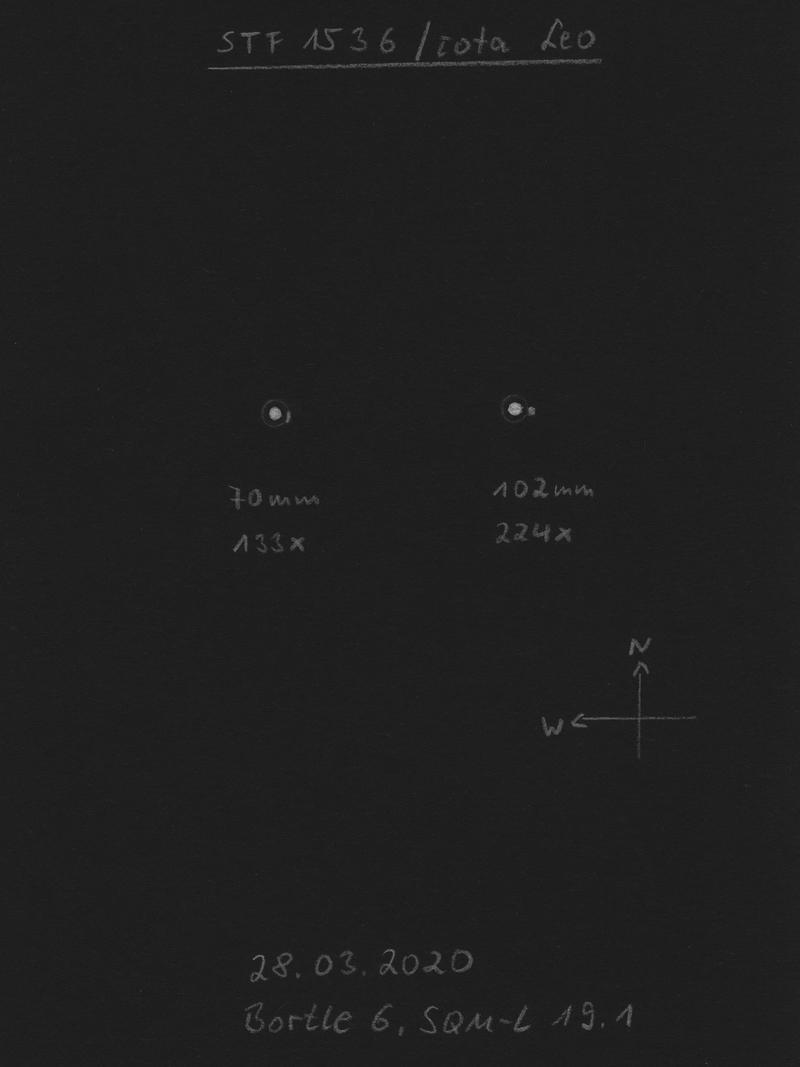
|
Sarah Gebauer
Germany |
254mm (96x) |
AB: bei 96-fach zeigen die Sterne einen warmweißen Farbton mit einem warmgelben Farbhauch |
|
Mark McCarthy
Fremont (California/USA) |
317mm (340x) |
AB: Quite close, very bright yellow white A and brownish B, split in A's diffraction ring |
|
Mark McCarthy
Fremont (California/USA) |
508mm (333x) |
AB: Iota Leo. Light orange A and a richer orange B, ~2 delta mag, ~2" separation |
|
|
|
★★
|
STF1540, 83 Leo |
|
AB |
6m.5 |
7m.5 |
28.6" |
146° |
2019 |
Leo |
11h26m45.32s / +03°00'47.20" |
Stefan Loibl
Rosenheim (Germany) |
10x50 |
klar trennbar, geringer Helligkeitsunterschied |
|
Christopher Hay
Seeheim (Germany) |
10x56 |
Auf Stativ. Sauber getrennt. Attraktives 6,3° Gesichtsfeld gesprenkelt mit einigen Sternen 5. bis 7. Magnitude südlich sowie Tau Leo weit getrennt direkt südöstlich.
In 15x60 auf Stativ deutlich getrennt, Komponente A leicht orange, ein schönes Doppel-Doppel mit Tau Leo.
83 Leo ist ein physikalischer Doppelstern in nur 58 Lichtjahren Abstand zu uns. |
|
Robert Zebahl
Leipzig (Germany) |
16x70 |
02.03.2021: Fantastischer Anblick zusammen mit dem Doppelstern tau Leo sowie 82 Leo. Wunderschönes Sternumfeld. 83 Leo sehr schön getrennt mit mäßigem Helligkeitsunterschied. Gelblich-orange & leicht orange. |
|
René Merting
Drachhausen (Germany) |
18x70 |
ein ordentlich getrenntes und dennoch schön eng stehendes Pärchen - Komponente A ist leicht gelblich, Komponente B im SO ist eine dreiviertel Magnitude schwächer und grauweiß |
|
Robert Zebahl
Leipzig (Germany) |
55mm (16x) |
Wunderschöner Doppelstern mit leichtem Farbkontrast in sehr schöner Umgebung. Zusammen mit tau Leo ein beeindruckender Anblick. Geringer Helligkeitsunterschied. A wirkte weiß-gelblich, B eher grau-bläulich. |
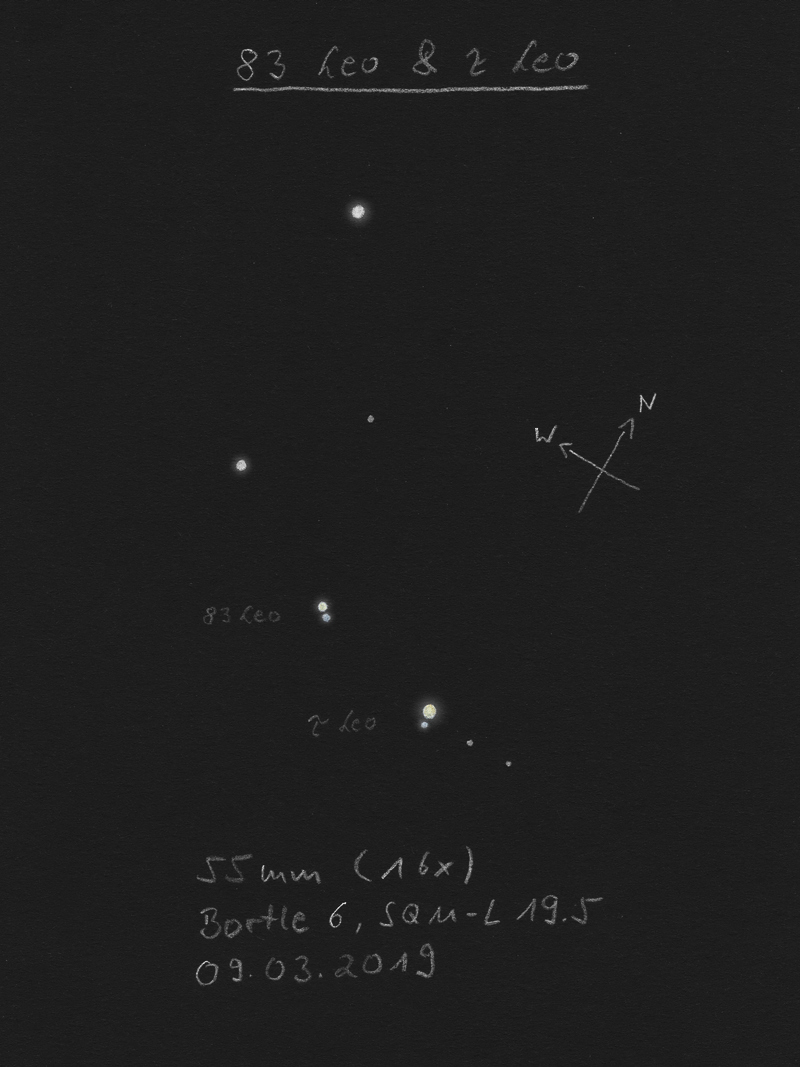
|
René Merting
Drachhausen (Germany) |
76mm (29x) |
Mondscheinnacht - bei 29x ein schönes Doppel-Doppel zusammen mit Tau Leo (STFA19) weiter östlich - beide Sterne von STF 1540 sind etwas mehr als ordentlich getrennt sichtbar - die B-Komponente im Südosten ist gut eine Größenklasse schwächer und wirkt grau gegen die warmweiß-gelblich strahlende A-Komponente, dadurch ein leichter Farbkontrast |
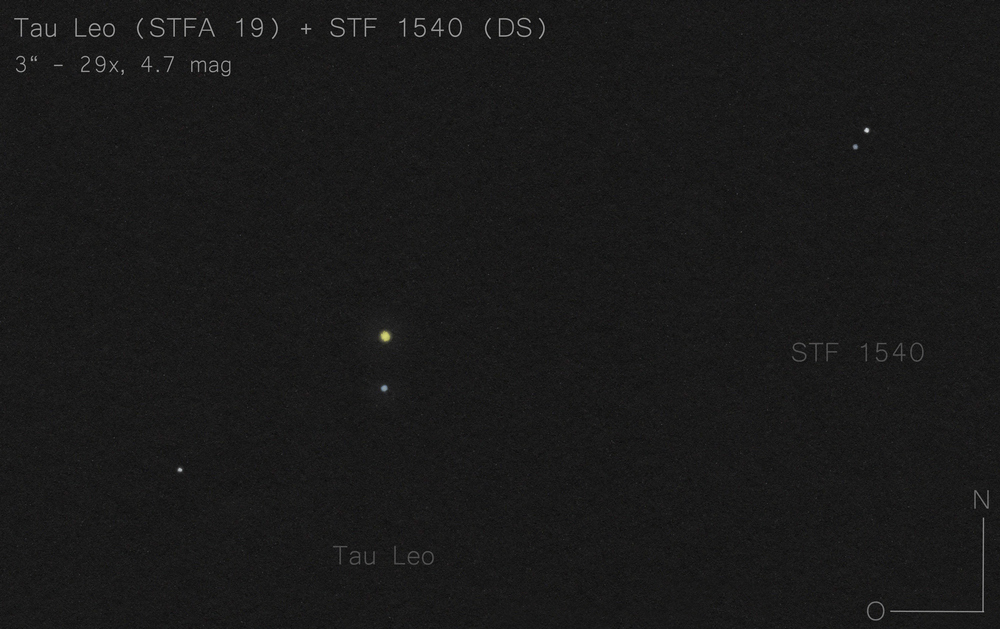
|
Mark McCarthy
Fremont (California/USA) |
80mm (13x) |
Finder split, in same field as Tau. |
|
Sarah Gebauer
Germany |
100mm (21x) |
bei 20-fach gut getrennt, ein wesentlich schwächeres, kleineres und engeres Paar als STFA 19 im selben GF - die nördliche Komponente strahlt warmgold, die südöstliche ähnlich, jedoch schwächer und matter |

|
Mark McCarthy
Fremont (California/USA) |
178mm (205x) |
Light orange-yellow A and light blue B, >1 delta mag, very wide. Physical with 32,000-year period. Running this through the Plot Tool with EDR3 data, it confirms it is physical, only 18 parsecs / 58 light years away (which is why it has such a high proper motion) and 520 AU separation |
|
Mark McCarthy
Fremont (California/USA) |
317mm (340x) |
Yellow A and reddish B wide separation. |
|
René Merting
Drachhausen (Germany) |
320mm (72x) |
bei 72x steht das Paar zwar weit auseinander, es wirkt aber trotzdem gut zusammengehörend - Komponente B im SO ist eine dreiviertel Magnitude schwächer |
|
|
|
|
STT234 |
|
|
7m.5 |
8m.1 |
0.4" |
189° |
2021 |
UMa |
11h30m49.91s / +41°17'12.70" |
|
|
Mark McCarthy
Fremont (California/USA) |
508mm (1067x) |
Surprisingly tough. Had indications of elongation at powers starting from 533x, but needed 1067x to get the clear bump, but even then it wasn't cleanly split |
|
|
|
★
|
STF1547, 88 Leo |
|
AB |
6m.3 |
9m.1 |
15.7" |
330° |
2020 |
Leo |
11h31m44.94s / +14°21'52.20" |
|
|
Robert Zebahl
Leipzig (Germany) |
55mm (42x) |
Gut trennbar bei mäßigem Abstand. Die Hauptkomponente erschien weiß-gelblich. Recht großer Helligkeitsunterschied. |
|
René Merting
Drachhausen (Germany) |
100mm (32x) |
bei 32x erscheint Komponente B nordwestlich von A etwas mehr als knapp getrennt ganz schwach, bestimmt 3 Größenklassen Helligkeitsunterschied - Komponente A warmweiß, B ist grau |
|
Sarah Gebauer
Germany |
100mm (45x) |
fein, aber gut getrennt, die südliche Komponente ist deutlich heller, die nordwestliche zeigt sich als ganz schwacher Punkt |
|
Sarah Gebauer
Germany |
100mm (49x) |
bei 49-fach ein gut getrenntes, schwaches Pärchen - die nordöstliche Komponente zeigt ein ganz zartes Orange, die südwestliche zeigt einen ähnlichen, lediglich abgeschwächten, dunklen und matten Farbton |
|
Uwe Pilz
Leipzig (Germany) |
105mm (88x) |
gelb und violett |

|
Mark McCarthy
Fremont (California/USA) |
178mm (205x) |
Very light yellow and 2 delta, very wide B. Physical, with a 3453-year period, it is also close-by at 23.33 pc |
|
Axel Tute
Küssaberg (Germany) |
200mm (80x) |
18.05.2007: Einfach. A ist leicht gelblich. B ist leicht rötlich. |
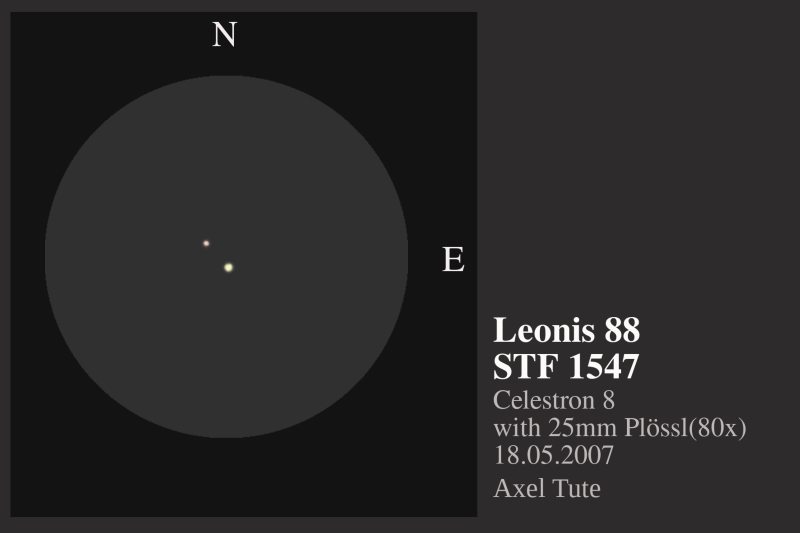
|
Gerd Kohler
Langenzenn (Germany) |
254mm (76x) |
Der Doppelstern ist getrennt.Bläulich-weiß - orange-leicht rötlich. Etwas schwächerer Begleiter. |
|
Mark McCarthy
Fremont (California/USA) |
317mm (340x) |
88 Leonis: A favorite! Yellow and blue pair, wide |
|
René Merting
Drachhausen (Germany) |
320mm (45x) |
bei 45x ein schönes enges Sternpaar, ordentlich getrennt - Komponente A strahlt hellgelb, B ist deutlich schwächer und empfiehlt sich mit einem Kupferton - ein schöner Farbkontrast |
|
|
|
★★
|
STT235 |
|
AB |
5m.7 |
7m.5 |
0.9" |
43° |
2017 |
UMa |
11h32m20.76s / +61°04'57.90" |
|
|
Mark McCarthy
Fremont (California/USA) |
317mm (553x) |
Nice! Yellow and orange, 1.5 delta mag, split when seeing shows perfect disks. The stars both show albedo effects, look like suns / globes with shadowing. |
|
Mark McCarthy
Fremont (California/USA) |
508mm (533x) |
Short period. Pretty yellow A, orange B, ~1" ~2 delta mag |
|
|
|
★
|
STF1555 & HJ503 |
STF1555 |
AB |
6m.4 |
6m.8 |
0.7" |
151° |
2022 |
Leo |
11h36m17.94s / +27°46'52.70" |
|
|
|
HJ503 |
AB-C |
5m.8 |
11m.2 |
22.5" |
156° |
2016 |
|
|
|
|
Frederik Wanink
Itterbeck (Germany) |
254mm (640x) |
STF1555 (AB): blickweise gerade eben trennbar |
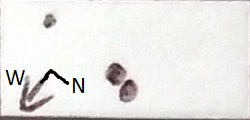
|
Mark McCarthy
Fremont (California/USA) |
317mm (443x) |
STF1555 (AB): Nice! AB tight hair-split white pair, with fainter & wide separated AB-C in a row to the east. |
|
Mark McCarthy
Fremont (California/USA) |
317mm (443x) |
HJ503 (AB-C): Nice! STF 1555AB tight hair-split white pair, with fainter & wide separated C in a row to the east. |
|
Mark McCarthy
Fremont (California/USA) |
508mm (553x) |
STF1555 (AB): Hairline split at 333x, clear split with 533x, very close ~0.5", bright. Part of plus one |
|
|
|
|
STF1553 |
|
|
7m.7 |
8m.2 |
6.2" |
165° |
2019 |
UMa |
11h36m35.69s / +56°08'07.30" |
|
|
Robert Zebahl
Leipzig (Germany) |
16x70 |
15.02.2023: Sofort als Figur '8' erkennbar, zeitweise beinahe getrennt. |
|
René Merting
Drachhausen (Germany) |
18x70 |
der Doppelstern zeigt sich länglich, aber nicht getrennt - die Einschnürung ist auch nur zu erahnen, aber man sieht auf jeden Fall, dass dort kein Einzelstern steht |
|
Robert Zebahl
Leipzig (Germany) |
70mm (31x) |
19.04.2020: Bei 22x mittelheller Doppelstern mit scheinbar ähnlich hellen Komponenten. Auf den ersten Blick als '8' erkennbar, bei genauem Hinsehen geradeso getrennt. Bei 31x sehr feine Trennung der Komponenten bei geringer Helligkeitsdifferenz. Die beiden Komponenten wirkten gelblich und leicht orange. |
|
Mark McCarthy
Fremont (California/USA) |
178mm (205x) |
White, pretty wide, 1 delta mag, typical Struve. Physical with a 1996-year period, slowly approaching apastron |
|
René Merting
Drachhausen (Germany) |
320mm (45x) |
bei 45x sehe ich zwei fast gleich helle Sterne ganz eng beieinander stehen, da passt sprichwörtlich kein Blatt Papier dazwischen - bei 72x Helligkeitsunterschied eine knappe halbe Magnitude - ein ganz feiner Farbunterschied, Komponente A leicht weißgelblich, B im Osten wirkt ein bisschen grau |
|
|
|
|
STF1561 |
|
AB |
6m.5 |
8m.2 |
8.9" |
246° |
2019 |
UMa |
11h38m44.90s / +45°06'30.30" |
|
|
|
|
AC |
6m.5 |
9m.5 |
176.8" |
90° |
2015 |
|
|
|
|
|
|
AD |
6m.5 |
7m.6 |
718.2" |
76° |
2015 |
|
|
|
|
|
|
AE |
6m.5 |
12m.1 |
60.7" |
338° |
2015 |
|
|
|
|
Christopher Hay
Seeheim (Germany) |
7x45 |
AD: So weit auseinander, dass die Komponenten A und D sich nicht wirklich wie ein Doppelstern ausnehmen, aber was soll's. Eine recht hübsche 5° lange Kette von Sternen der 6. bis 8. Magnitude läuft durch das Gesichtsfeld, im Süden mit STF 1542 beginnend. |
|
Robert Zebahl
Leipzig (Germany) |
70mm (31x) |
AB: 19.04.2020: Bei 22x getrennt, aber relativ dicht zusammen mit deutlichem Helligkeitsunterschied. Das Paar steht nahe 2 mittelheller Sterne. Beide Komponenten erscheinen weiß. Bei 31x schöner Anblick, wobei die Farbe der Komponenten leicht verschieden wirkt: weiß-gelblich mit dunklerem (leicht orange?) Begleiter. |
|
Robert Zebahl
Leipzig (Germany) |
70mm (44x) |
AB: 07.04.2020: Bei 22x getrennt. Der schwächere Begleiter steht noch sehr dicht an der Hauptkomponente. Bei 44x schöner Anblick mit deutlichem Helligkeitsunterschied. A: leicht gelblich, B: blass bläulich. |
|
|
|
★
|
BU603 |
|
AB |
6m.0 |
8m.5 |
1.0" |
329° |
2019 |
Leo |
11h48m38.71s / +14°17'03.20" |
|
|
Mark McCarthy
Fremont (California/USA) |
80mm (150x) |
Elongated but not split. 129-year period |
|
Uwe Pilz
Leipzig (Germany) |
105mm (200x) |
sehr schwierig |

|
Uwe Pilz
Leipzig (Germany) |
105mm (288x) |
nicht getrennt |
|
Mark McCarthy
Fremont (California/USA) |
203mm (533x) |
Suspected at 205x and 333x but needed higher magnification to see it. B is a very small point, with seeing, in the first diffraction ring. ~1" and ~3 delta mag |
|
|
|
|
STT241 |
|
|
6m.8 |
8m.7 |
1.8" |
147° |
2017 |
UMa |
11h56m17.24s / +35°26'53.30" |
|
|
Robert Zebahl
Leipzig (Germany) |
120mm (200x) |
04.04.2021: Gut trennbar mit deutlichem Helligkeitsunterschied. |
|
|
|
|
STF1606 |
|
|
7m.4 |
7m.9 |
0.7" |
143° |
2019 |
CVn |
12h10m47.34s / +39°53'29.50" |
|
|
Robert Zebahl
Leipzig (Germany) |
120mm (200x) |
04.04.2021: Der Doppelstern erschien leicht länglich. |
|
|
|
|
STF1608 |
|
AB |
8m.1 |
8m.3 |
13.6" |
221° |
2021 |
UMa |
12h11m27.76s / +53°25'17.50" |
|
|
René Merting
Drachhausen (Germany) |
18x70 |
wie gemacht für 18x - ein Paar gleich heller Sterne, minimalst getrennt - B scheint im Südwesten zu stehen, der Stern ist nur minimal schwächer |
|
Robert Zebahl
Leipzig (Germany) |
70mm (22x) |
19.04.2020: Einfach zu finden, mittelhell. Bei 22x recht auffällig bei recht geringem Helligkeitsunterschied. Ein Farbunterschied ist gut erkennbar: leicht orange, weiß-bläulich. Bei 31x schöner Farbkontrast mit etwas intensiveren Farben: hellorange & hellblau. |
|
Mark McCarthy
Fremont (California/USA) |
178mm (205x) |
Yellow-white stars, near equal, wide. Physical with a 2236-year period, it is nearing apastron now. It's also variable star MZ UMa, which as best as I can find has a 0.02 magnitude change over a 7.96 day period |
|
René Merting
Drachhausen (Germany) |
320mm (72x) |
bei 72x ein schönes helles Pärchen, beide Komponenten sind gleich hell und Zahncremeweiß |
|
|
|
|
STF1639 |
|
AB |
6m.7 |
7m.8 |
1.9" |
324° |
2019 |
Com |
12h24m26.81s / +25°34'56.70" |
|
|
|
|
AC |
6m.7 |
11m.4 |
91.4" |
159° |
2015 |
|
|
|
|
Robert Zebahl
Leipzig (Germany) |
70mm (133x) |
AB: 04.04.2020: Der Doppelstern zeigt sich klar länglich, wobei der schwächere Begleiter an der Hauptkomponente haftet. |
|
Mark McCarthy
Fremont (California/USA) |
203mm (205x) |
AB: White and slightly blue pair, close, around 3" |
|
Mark McCarthy
Fremont (California/USA) |
317mm (443x) |
AB: Close but well split, 1.5 delta mag, ~2.5" |
|
Mark McCarthy
Fremont (California/USA) |
508mm (333x) |
AB: Pretty yellow stars, ~2" separation, ~2 delta mag |
|
|
|
|
STF1643 |
|
AB |
9m.0 |
9m.4 |
2.8" |
3° |
2020 |
Com |
12h27m13.72s / +27°01'29.60" |
|
|
Mark McCarthy
Fremont (California/USA) |
317mm (553x) |
Equal orange pair, ~3", PA to north. |
|
Mark McCarthy
Fremont (California/USA) |
508mm (333x) |
Yellow-white stars, ~3" separation, ~2 delta mag |
|
|
|
|
STF1645 |
|
AB |
7m.5 |
8m.1 |
9.8" |
156° |
2017 |
CVn |
12h28m04.45s / +44°47'39.50" |
|
|
Mark McCarthy
Fremont (California/USA) |
178mm (205x) |
Slight delta, wide, pretty light yellow-white stars. WDS lists as physical, and I agree |
|
Gerd Kohler
Langenzenn (Germany) |
254mm (76x) |
Der Doppelstern ist getrennt. Bläulich-weiß - bläulich-weiß. Gleiche Helligkeit. |
|
Mark McCarthy
Fremont (California/USA) |
317mm (277x) |
Wide, bright yellowish-white pair, ~1 delta mag |
|
|
Berthold Fuchs
Wiesbaden (Germany) |
130mm |
einfacher DS |
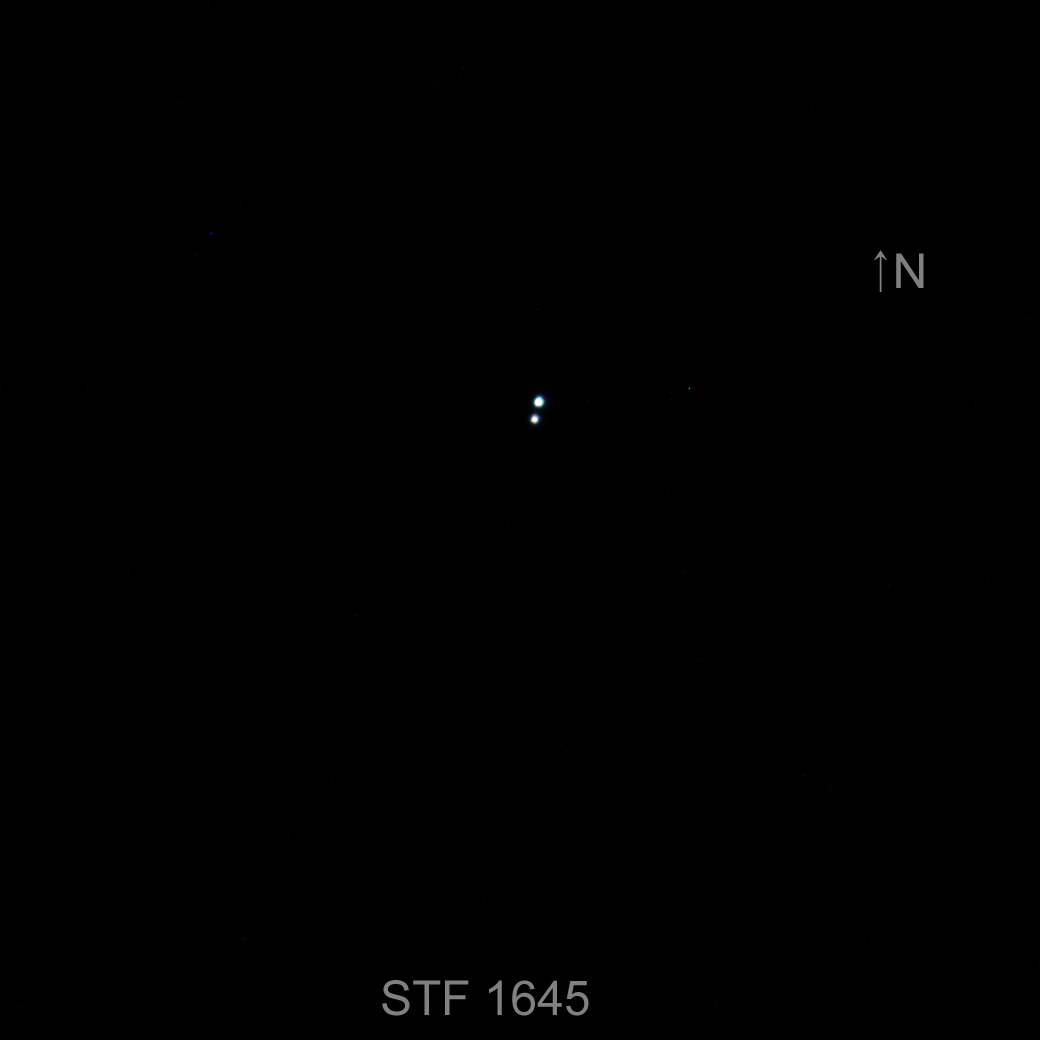
|
|
|
|
STT251 |
|
|
8m.3 |
9m.3 |
0.7" |
55° |
2018 |
CVn |
12h29m07.72s / +31°23'25.40" |
|
|
Mark McCarthy
Fremont (California/USA) |
317mm (553x) |
Decidedly not round disk -- there's also a brightening in the diffraction. Marginal. |
|
Mark McCarthy
Fremont (California/USA) |
508mm (667x) |
Best seen at 667x, but could also see at 533x and 445x. Split, much fainter B about 1.5 delta mag, light orange A and blue B. 540.56-year period, it will reach apastron in 100 years but makes a very close periastron in 400 years |
|
|
|
★★
|
WRH12, 23 Com |
|
|
5m.0 |
6m.9 |
0.4" |
8° |
2020 |
Com |
12h34m51.12s / +22°37'45.10" |
|
|
Mark McCarthy
Fremont (California/USA) |
508mm (1067x) |
23 Com. I get a definite snowman and can tell the larger from the smaller star, pointed in a certain direction in relation to a faint field star. Short Period double |
|
|
|
|
STF1663 |
|
|
8m.0 |
9m.2 |
0.5" |
65° |
2017 |
Com |
12h37m10.81s / +21°11'52.50" |
|
|
Mark McCarthy
Fremont (California/USA) |
203mm (333x) |
Hairline split, ~1 delta mag, tough. Light yellow-orange A |
|
|
|
★★★
|
STF1670, gamma Vir, 29 Vir, Porrima |
|
AB |
3m.5 |
3m.5 |
2.9" |
356° |
2021 |
Vir |
12h41m39.60s / -01°26'57.90" |
|
|
Christopher Hay
Seeheim (Germany) |
15x60 |
28.02.2021 bei 3" Winkelabstand: Ganz leichte Streckung. Positionswinkel mit 5° geschätzt (somit nur 9° daneben, was mir angesichts der Vergrößerung von 15x und der minimalen Streckung recht präzise erscheint).
Vor der Beobachtung absichtlich die Augen am fast vollen Mond geblitzt um die Sehschärfe zu erhöhen. Mehrfach mit dem ähnlich hellen Epsilon Vir (Vindemiatrix) verglichen um zu schauen, ob die Streckung eventuell ein Artefakt der Optik oder meines Wahrnehmungsapparats ist, dort jedoch keine Streckung gesehen. |
|
Robert Zebahl
Leipzig (Germany) |
16x70 |
23.05.2021: Nicht im Ansatz als Doppelstern erkennbar. Die Komponenten sind einfach zu hell, der Abstand zu gering. |
|
Robert Zebahl
Leipzig (Germany) |
55mm (56x) |
18.05.2019: Bei 38x leicht länglich. Bei 56x berührten sich die Beugungsscheibchen leicht. Bei 71x deutlich getrennt mit sehr kleinem Zwischenraum. |
|
Robert Zebahl
Leipzig (Germany) |
70mm (44x) |
26.05.2021: Bei voller Öffnung erscheint Porrima bei 44x beinahe getrennt. Die beiden Beugungsscheibchen sind gut erkennbar. Bei 31x fällt es dagegen schwer, überhaupt eine Elongation zu sehen.
Bei 40mm Öffnung kann Porrima bereits bei 31x deutlich länglich erkannt werden, ab 67x erscheint er als '8'. Bei nur 22x ist Porrima nicht als Doppelstern erkennbar. |
|
Robert Zebahl
Leipzig (Germany) |
70mm (104x) |
04.05.2019: Bei 47x deutlich als '8' erkennbar, bei 73x getrennt mit sich beinahe berührenden Beugungsscheibchen. Bei 104x deutlich getrennt, gleich hell und recht dicht zusammen. Der Zwischenraum wirkte kleiner als der Durchmesser des Beugungsscheibchen. |
|
Mark McCarthy
Fremont (California/USA) |
80mm (92x) |
Porrima. Nice and easy, yellow-white equal stars. 169-year period |
|
Robert Zebahl
Leipzig (Germany) |
102mm (125x) |
01.05.2019: Extrem schöner Doppelstern! Gleich hell und relativ dicht zusammen. Beide Komponenten wirkten gelblich-weiß. |
|
Uwe Pilz
Leipzig (Germany) |
105mm (200x) |
weiß-weiß, die nördliche Komponente ist eine Winzigkeit heller |
|
Winfried Kräling
Marburg (Germany) |
127mm (146x) |
21.04.2018: Bei V=100x erscheint dieser orangefarbene Doppelstern bereits als „8“. Bei V=146x ist Porrima voll getrennt. |

|
Sarah Gebauer
Germany |
150mm (166x) |
die 2,8'' entfernten Komponenten A und B konnten haarscharf bei 83x und 166x getrennt werden, beide strahlen gleich hell als ganz dichte Glanzpünktchen; Komponenten E und F wurden gesehen, C und D allerdings nicht; bei 83x waren AB ganz knapp nicht mehr voneinander getrennt |

|
Mark McCarthy
Fremont (California/USA) |
178mm (205x) |
Porrima. Bright near equal, dull white, well split about 4". Physical with a 169-year period, I missed my chance to witness the rapid periastron a few years ago |
|
Mark McCarthy
Fremont (California/USA) |
317mm (170x) |
Porrima. Very pretty yellow-white, near equal, close split at 170x. Star disks improved with apodizing mask. |
|
|
|
|
COU1579 |
|
|
9m.4 |
9m.7 |
0.3" |
141° |
2014 |
CVn |
12h53m17.33s / +42°46'16.80" |
|
|
Mark McCarthy
Fremont (California/USA) |
508mm (889x) |
Very tough notched elongation and instants of splits, I had difficulty sketching it and estimated PA west of north or along that line. Very small scale. Actual PA is SSE, so I had the alignment correct. It will be at periastron next year, and get to easy split by 2029 at around 0.231", at the opposite quadrant |
|
|
|
|
STF1687, 35 Com |
|
AB |
5m.2 |
7m.1 |
1.2" |
203° |
2020 |
Com |
12h53m17.77s / +21°14'42.10" |
|
|
|
|
AC |
5m.2 |
9m.8 |
28.5" |
127° |
2016 |
|
|
|
|
Mark McCarthy
Fremont (California/USA) |
203mm (205x) |
AC: Rich light yellow and much fainter wide blue B. Near M64. [Need to re-observe. I saw the wide AC, but not the AB which is 5.15/7.08 1.2" |
|
Mark McCarthy
Fremont (California/USA) |
317mm (205x) |
AC: Rich light yellow and much fainter wide blue B. Near M64. (Need to re-observe. I saw the wide AC, but not the AB which is 5.15/7.08 1.2") |
|
Mark McCarthy
Fremont (California/USA) |
317mm (443x) |
AC: Orange and blue, 3 delta mag, very wide separation to the east. Did not notice AB |
|
Mark McCarthy
Fremont (California/USA) |
317mm (553x) |
AB: 35 Com: Bright orange & fainter B, showpiece, ~1.5" |
|
Mark McCarthy
Fremont (California/USA) |
508mm (533x) |
AB: 35 Com. Can see the 7th magnitude B at 333x, but it's easier to resolve with 533x. Part of plus one. Bright orange A and deeper orange B |
|
|
|
|
STT256 |
|
|
7m.3 |
7m.6 |
1.1" |
101° |
2017 |
Vir |
12h56m26.59s / -00°57'16.60" |
|
|
Mark McCarthy
Fremont (California/USA) |
317mm (553x) |
Wide separation equal brightness white stars |
|
|
|
|
78 UMa, BU1082 |
|
|
5m.0 |
7m.9 |
0.7" |
141° |
2019 |
UMa |
13h00m43.59s / +56°21'58.80" |
|
|
Uwe Pilz
Leipzig (Germany) |
105mm (260x) |
nicht getrennt |
|
|
|
|
STT261 |
|
|
7m.4 |
7m.6 |
2.5" |
337° |
2020 |
CVn |
13h12m02.02s / +32°05'07.90" |
|
|
Robert Zebahl
Leipzig (Germany) |
70mm (57x) |
20.04.2020: Bei 44x sofort als '8' sichtbar, geradeso trennbar bei genauem Hinsehen. Die Komponenten wirkten ähnlich hell. Insgesamt eher schwach. Bei 57x klar getrennt, aber noch sehr dicht zusammen mit geringer Helligkeitsdifferenz. |
|
René Merting
Drachhausen (Germany) |
107mm (86x) |
bei 86x sind in ruhigen Phasen beide Sterne wunderbar getrennt zu erkennen - Komponente B im Nordwesten ist minimal schwächer - das Paar steht relativ isoliert |
|
Mark McCarthy
Fremont (California/USA) |
203mm (205x) |
Light yellow-white equal pair, ~1.5" |
|
|
|
|
RST3829 & SHJ162 |
RST3829 |
Aa-Ab |
7m.3 |
9m.1 |
0.5" |
166° |
2018 |
Vir |
13h14m55.72s / -11°22'09.90" |
|
|
|
SHJ162 |
AB |
7m.1 |
8m.2 |
114.2" |
45° |
2021 |
|
|
|
|
|
SHJ162 |
BC |
8m.2 |
13m.3 |
66.2" |
136° |
2015 |
|
|
|
|
René Merting
Drachhausen (Germany) |
18x70 |
Bedingungen in der Zielregion: SQM-L 20.8
im Fernglas ein einfacher Doppelstern, weite Trennung - die B-Komponente steht im Nordosten von A und ist eine dreiviertel Größenklasse schwächer - B wirkt wie so oft grau gegen die weiß strahlende A-Komponente |
|
René Merting
Drachhausen (Germany) |
100mm (32x) |
SHJ162 (AB): bei 32x weit auseinander stehend - ein eigentümlicher Farbkontrast, A strahlt weiß, B kupfern |
|
Mark McCarthy
Fremont (California/USA) |
317mm (340x) |
SHJ162 (AB): a widely separated yellow A and orange B, 1 magnitude difference. |
|
|
|
★
|
BU800 |
|
AB |
6m.7 |
9m.5 |
7.7" |
104° |
2020 |
Com |
13h16m51.05s / +17°01'01.90" |
|
|
Christopher Hay
Seeheim (Germany) |
125mm (36x) |
AB, März 2019: Klar getrennt in guten Momenten, Begleiter kommt und geht jedoch in unruhiger Luft.
Ein physikalischer Doppelstern in nur 36 Lichtjahren Abstand zu uns. |
|
Mark McCarthy
Fremont (California/USA) |
203mm (333x) |
Nice pair, A is a light but rich yellow, B is blue-white. Wide, ~2 delta mag |
|
Mark McCarthy
Fremont (California/USA) |
317mm (553x) |
Not difficult, orange-yellow A with bluish B, 3 delta mag. pretty wide to east. |
|
|
|
★★
|
HU644 |
|
AB |
9m.1 |
9m.9 |
0.1" |
354° |
2019 |
CVn |
13h19m45.58s / +47°46'41.10" |
|
|
Uwe Pilz
Leipzig (Germany) |
120mm (250x) |
|

|
Mark McCarthy
Fremont (California/USA) |
317mm (443x) |
Orange-red pair, near equal mag, split with seeing at 443x |
|
Mark McCarthy
Fremont (California/USA) |
508mm (533x) |
Quite perfect star images, light orange stars, nearly 2 delta mag, well separated, PA northwest. Grade 2, physical, 48.776-year period. It has a slightly out of round orbit from our perspective, near it's periastron now and will widen to an easy 1.584" by 2030 |
|
|
|
|
STF1734 |
|
|
6m.8 |
7m.3 |
1.1" |
173° |
2017 |
Vir |
13h20m41.57s / +02°56'31.90" |
|
|
Robert Zebahl
Leipzig (Germany) |
70mm (104x) |
Doppelstern erschien leicht elongiert ohne erkennbare Einschnürung. |
|
Mark McCarthy
Fremont (California/USA) |
203mm (333x) |
Blue-white A, light orange B, half delta mag, close ~1.5". Nice! |
|
|
|
|
HO260 |
|
|
9m.6 |
9m.9 |
1.7" |
89° |
2019 |
CVn |
13h23m32.82s / +29°14'15.00" |
|
|
Mark McCarthy
Fremont (California/USA) |
203mm (205x) |
Close pair, nicely split ~2", ~1 delta mag, light orange stars |
|
|
|
|
A1609 |
|
AB |
9m.5 |
8m.8 |
0.3" |
87° |
2020 |
CVn |
13h25m48.12s / +44°29'38.30" |
|
|
Mark McCarthy
Fremont (California/USA) |
508mm (889x) |
Notched elongation with the fainter end PA just south of east, very difficult, with seeing only. 44.24-year period, it is nearing periastron and won't appreciably widen, at the opposite PA, until the mid 2030s |
|
|
|
|
STT266 |
|
|
8m.0 |
8m.4 |
1.9" |
355° |
2020 |
Com |
13h28m26.68s / +15°42'30.50" |
|
|
Mark McCarthy
Fremont (California/USA) |
203mm (333x) |
~0.5 delta mag, ~2 separation, nice looking pair |
|
Mark McCarthy
Fremont (California/USA) |
317mm (553x) |
Close 2" near equal white. Period of 1954.11 years. Near its closest separation now (May 2017), will be ~4" by the year 2822. |
|
|
|
|
STF1752 |
|
AB |
8m.2 |
9m.9 |
1.0" |
107° |
2017 |
UMa |
13h28m49.82s / +59°55'41.70" |
|
|
Mark McCarthy
Fremont (California/USA) |
317mm (553x) |
Orange star perhaps a little elongated, tough. |
|
|
|
|
VYS6, VW Com |
|
|
11m.4 |
11m.3 |
2.6" |
55° |
2018 |
Com |
13h32m44.59s / +16°48'39.00" |
|
|
Mark McCarthy
Fremont (California/USA) |
317mm (553x) |
VW Com. Seen best with averted vision and when seeing stills. Close but pretty well split, ~2-3". Extremely faint reddish pair, PA NE. |
|
|
|
|
STT269 |
|
AB |
7m.3 |
8m.1 |
0.3" |
222° |
2019 |
CVn |
13h32m51.02s / +34°54'25.80" |
|
|
Mark McCarthy
Fremont (California/USA) |
508mm (1067x) |
Strong notch, good star images, not quite split. I saw it as a rod at 205x, and the notch increased in strength with each magnification step up. PA to SW. Physical with grade 2 orbit and 53.2-year period (having made nearly one revolution in my lifetime so far!), it is 0.297" now and is coming off apastron, it will rapidly close to undetectability by the late 2030s |
|
|
|
|
A1095 |
|
|
9m.0 |
9m.3 |
0.3" |
288° |
2016 |
CVn |
13h33m33.77s / +29°44'16.90" |
|
|
Mark McCarthy
Fremont (California/USA) |
508mm (889x) |
Hairline split, >1 delta mag. 187-year period, it will make a slight movement to the north in my lifetime but will be closer to periastron |
|
|
|
|
STF1757 |
|
AB |
7m.8 |
8m.8 |
1.6" |
144° |
2019 |
Vir |
13h34m16.38s / -00°18'49.80" |
|
|
Uwe Pilz
Leipzig (Germany) |
105mm (200x) |
schwierig |

|
Mark McCarthy
Fremont (California/USA) |
203mm (205x) |
Close, ~2", a dull orange, ~1.5 delta mag. |
|
Mark McCarthy
Fremont (California/USA) |
317mm (553x) |
Orange-yellow, half a delta mag, pretty, ~1.5" |
|
|
|
|
BU932, y Vir |
|
AB |
6m.3 |
7m.3 |
0.4" |
67° |
2019 |
Vir |
13h34m40.48s / -13°12'51.50" |
|
|
Mark McCarthy
Fremont (California/USA) |
317mm (170x) |
Out of round with apodizing mask |
|
|
|
★
|
25 CVn |
STF1768 |
AB |
5m.0 |
7m.0 |
1.6" |
95° |
2020 |
CVn |
13h37m27.70s / +36°17'41.40" |
|
|
|
STF1768 |
AC |
5m.0 |
11m.6 |
214.3" |
321° |
2015 |
|
|
|
|
|
KZA73 |
AD |
5m.0 |
13m.0 |
335.6" |
92° |
2015 |
|
|
|
|
|
KZA73 |
AE |
5m.0 |
12m.7 |
371.6" |
139° |
2020 |
|
|
|
|
|
KZA73 |
AF |
5m.0 |
9m.4 |
437.3" |
118° |
2015 |
|
|
|
|
Robert Zebahl
Leipzig (Germany) |
60mm (160x) |
AB: 16.03.2020: 102/1122mm ED-Refraktor auf 60mm abgeblendet. Der Beugungsring der Hauptkomponente ist praktisch kaum wahrnehmbar. Der Begleiter erscheint nur in wenigen Momenten als extrem schwache, längliche Aufhellung im Beugungsring. Sehr schwierig. Teleskop sollte optisch in sehr gutem Zustand sein! |
|
Robert Zebahl
Leipzig (Germany) |
70mm (160x) |
AB: 16.03.2020: 102/1122mm ED-Refraktor auf 70mm abgeblendet. Begleiter nur als zarte, längliche, nicht dauerhaft sichtbare Aufhellung erkennbar. Der Beugungsring der Hauptkomponente ist nur zeitweise zu sehen. Schwierig. Teleskop sollte optisch in gutem Zustand sein! |
|
Robert Zebahl
Leipzig (Germany) |
80mm (160x) |
AB: 16.03.2020: 102/1122mm ED-Refraktor auf 80mm abgeblendet. Begleiter dauerhaft als längliche Aufhellung im Beugungsring sichtbar. Der Beugungsring selbst ist aber eher schwach erkennbar. Mäßig schwierig. |
|
Robert Zebahl
Leipzig (Germany) |
90mm (160x) |
AB: 16.03.2020: 102/1122mm ED-Refraktor auf 90mm abgeblendet. Begleiter recht deutlich als längliche Aufhellung im Beugungsring erkennbar. Relativ einfach. |
|
Robert Zebahl
Leipzig (Germany) |
102mm (160x) |
AB: 16.03.2020: Der schwache Begleiter ist sofort als deutliche, leicht längliche Aufhellung im Beugungsring erkennbar. Einfach. |
|
Robert Zebahl
Leipzig (Germany) |
152mm (150x) |
AB: 19.03.2020: Bei 150x ist der deutlich schwächere Begleiter als rundliche Aufhellung zu sehen. Aufgrund des Farbfehlers des Achromaten (152mm f/5.9) wird der Begleiter aber beinahe überstrahlt. Bei 180x ist der Begleiter dann gut, bei 225x und 300x sehr gut als kleines, abgesetztes Sternchen sichtbar. |
|
Mark McCarthy
Fremont (California/USA) |
203mm (205x) |
AB: Very tight pair, a little more than hairline split, ~2 delta mag. |
|
Mark McCarthy
Fremont (California/USA) |
203mm (205x) |
AB: Very tight pair, a little more than hairline split, ~2 delta mag. 8" 333x: white and dull blue, ~1", Nice! |
|
Frederik Wanink
Itterbeck (Germany) |
254mm (640x) |
AB: schwierig wegen Helligkeitsunterschied |
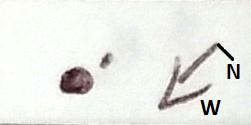
|
Mark McCarthy
Fremont (California/USA) |
317mm (277x) |
AB: Very pretty pale yellow and orange, 2-3 delta mag, ~2" |
|
|
|
|
STF1769 |
|
AB |
7m.9 |
10m.4 |
1.6" |
45° |
2015 |
CVn |
13h38m01.95s / +39°10'41.00" |
|
|
|
|
AC |
7m.9 |
9m.3 |
56.2" |
259° |
2015 |
|
|
|
|
|
|
AD |
7m.9 |
13m.0 |
149.4" |
187° |
2015 |
|
|
|
|
|
|
CD |
9m.3 |
13m.0 |
141.8" |
165° |
2015 |
|
|
|
|
René Merting
Drachhausen (Germany) |
100mm (32x) |
AC: bei 32x ein weit auseinander stehendes Pärchen - B im Westen ist eine Größenklasse schwächer als die weiße Komponente A und wirkt gegen A richtiggehend blaugrau |
|
Mark McCarthy
Fremont (California/USA) |
203mm (333x) |
AC: Wide separated blue stars, half delta mag. 2+1 system? 1 delta mag fainter star quite more widely separated. (Sextuple system. I missed the 1.6" AB, need to re-observe. Saw the AC pair only -- the fainter star noticed may be part of the system.) |
|
|
|
|
BU612 |
|
AB |
6m.3 |
6m.5 |
0.1" |
118° |
2021 |
Boo |
13h39m34.68s / +10°44'46.70" |
|
|
Mark McCarthy
Fremont (California/USA) |
508mm (1067x) |
Lightest orange, notched elongation to snowman at best moments. Burnham discovered in 1878 with the Dearborn 18.5-inch, and in 1899 wrote: "It was very soon apparent from the measures that this was a binary system in rapid motion. In the twenty years covered by the measures, the companion has passed over an arc of 175-degrees. Glasenapp…has computed an orbit from which he finds a period of 30.00 years....This represents the observations as well as could be desired, but evidently the arc was too short for any very accurate determination, and even now widely differing apparent orbits will satisfy the observed positions equally. It is probably that the measures of the next ten years will furnish sufficient data for an orbit which shall substantially correct." In the period since, there have been many measures, and a grade 1 Definitive orbit is established. WDS lists it as physical with a 22.46-year period, currently at 0.1 but will widen to 0.3" by 2030 -- I can hope for a clean split by then |
|
|
|
|
STF1781, HT Vir |
|
AB |
7m.9 |
8m.1 |
1.1" |
198° |
2020 |
Vir |
13h46m06.75s / +05°06'56.10" |
|
|
Mark McCarthy
Fremont (California/USA) |
203mm (333x) |
White A and slightly yellow B, ~2", half delta mag |
|
|
|
★★★
|
STF1785 |
|
|
7m.4 |
8m.2 |
2.7" |
193° |
2021 |
Boo |
13h49m04.00s / +26°58'47.70" |
|
|
Christopher Hay
Seeheim (Germany) |
71mm (67x) |
4. Juni 2023. Haarfein getrennt. Hauptkomponente gelblich. Begleiter scheint matter, ins Rote gehend.
Orbit führt dazu, dass der Abstand der Komponenten stetig schrumpft. In zehn Jahre vielleicht nicht mehr mit 67x trennbar. |
|
Sarah Gebauer
Germany |
100mm (49x) |
der angeblich Farbe zeigende DS ist bei 80x getrennt – zwei nahezu gleich helle Murmelchen, die ganz klein und dicht beieinander stehen – bei 50x zeigen die nun nicht mehr getrennten, aber länglichen Sterne einen leicht warmgelben Farbton, leicht ins Hellorange gehende |
|
Mark McCarthy
Fremont (California/USA) |
203mm (333x) |
Slightly orange-tinged white stars, near equal, well separated |
|
Christopher Hay
Seeheim (Germany) |
280mm (110x) |
4. Juni 2023. Bei 110x deutlich getrennt. Hauptkomponente zeigt ein klares, zartes, kaltes Gelb. Farbe des Begleiters schwer zu fassen.
Bei 180x behält Hauptkomponente die beschriebene Farbe und Begleiter zeigt ein zartes Mandarinenorange.
Schon in der visuellen Erscheinung sehr attraktiv, wird das Paar dadurch umso interessanter, dass es ein echtes physikalisches Paar ist, wobei Komponente B alle 156 Jahre einmal um A fliegt. Recht leicht auffindbar 2° SW des Kugelsternhaufens Messier 3. |
|
Karsten Kopp
Köln (Germany) |
600mm (180x) |
Im CLT bei 180 x Vergrößerung gut zu trennen. Leichter Helligkeitsunterschied und beider Sterne erscheinen gelborange. |
|
|
|
|
STF1789 |
|
|
8m.6 |
9m.0 |
6.7" |
328° |
2021 |
CVn |
13h54m05.19s / +32°49'35.20" |
|
|
Robert Zebahl
Leipzig (Germany) |
70mm (31x) |
20.04.2020: Bei 22x deutlich als '8' erkennbar und beinahe getrennt. Bei 31x feine Trennung des noch engen Paares. Ein geringer Helligkeits- und Farbunterschied ist erkennbar: weiß-gelblich, gelblich-orange. |
|
Mark McCarthy
Fremont (California/USA) |
317mm (277x) |
Pretty equal magnitude white, well separated. |
|
|
Berthold Fuchs
Wiesbaden (Germany) |
130mm |
schwieriger DS |

|
|
|
★
|
STF1788 |
|
AB |
6m.7 |
7m.3 |
3.7" |
100° |
2019 |
Vir |
13h54m58.20s / -08°03'31.90" |
|
|
Robert Zebahl
Leipzig (Germany) |
70mm (47x) |
Sehr schöner Anblick! Ziemlich dicht zusammen bei mäßigem Helligkeitsunterschied. |
|
René Merting
Drachhausen (Germany) |
100mm (64x) |
bei 107x zeigt sich ein schönes, knapp getrenntes Pärchen - B im Osten ist nur knapp schwächer als A - Komponente A ist weiß, B ist grau, wirkt aber auch leicht gelb gefärbt - zurück auf 64x kann ich die beiden Sterne auch schon knapp getrennt erkennen |
|
Mark McCarthy
Fremont (California/USA) |
317mm (340x) |
bright pair of near equal magnitude, both yellow-while color. |
|
|
|
|
A1097 & STF1800 |
A1097 |
AB |
9m.1 |
8m.2 |
0.4" |
259° |
2016 |
UMa |
14h02m00.60s / +57°13'28.60" |
|
|
|
STF1800 |
AB-C |
7m.8 |
10m.4 |
28.4" |
20° |
2015 |
|
|
|
|
Mark McCarthy
Fremont (California/USA) |
317mm (553x) |
A1097 (AB): Hair-split at best moments, half delta mag, <0.8". A fainter star likely in the system about 30" distant -- this is STF 1800 AB-C. |
|
Mark McCarthy
Fremont (California/USA) |
317mm (553x) |
STF1800 (AB-C): Faint star ~30" from A1097 |
|
|
|
|
STT277 & STF1812 |
STT277 |
AB |
8m.7 |
8m.6 |
0.2" |
37° |
2013 |
Boo |
14h12m26.68s / +28°43'02.30" |
|
|
|
STF1812 |
AB-C |
7m.9 |
9m.4 |
14.1" |
108° |
2016 |
|
|
|
|
|
STF1812 |
AB-D |
7m.9 |
12m.1 |
72.6" |
153° |
2015 |
|
|
|
|
René Merting
Drachhausen (Germany) |
18x70 |
STF1812 (AB-C): mit etwas Geduld zeigt sich C sehr schwach und knapp abgesetzt östlich von AB - nur mit hoher Konzentration, aber machbar |
|
René Merting
Drachhausen (Germany) |
100mm (20x) |
STF1812 (AB-C): bei 20x ist die C-Komponente östlich knapp getrennt von AB gerade so erkennbar - bei 32x dann schön getrenntes Pärchen, C-Komponente deutlich schwächer, vielleicht 2 mag weniger |
|
Mark McCarthy
Fremont (California/USA) |
203mm (205x) |
STF1812 (AB-C): A 2+1 system with AB-D. Main pair 2.5 delta mag, pretty wide. The third, fainter pair about 4x the other separation. |
|
|
|
|
STF1820 |
|
|
9m.1 |
9m.4 |
2.8" |
123° |
2019 |
UMa |
14h13m00.76s / +55°19'31.10" |
|
|
René Merting
Drachhausen (Germany) |
320mm (144x) |
bei 72x ist ein Stäbchen mit einer angedeuteten Einschnürung erkennen - bei 144x sind beide Komponenten getrennt voneinander sichtbar - beide sind gleich hell |
|
|
|
★
|
BU224 |
|
|
8m.9 |
9m.3 |
0.6" |
101° |
2016 |
Boo |
14h13m26.94s / +12°34'26.20" |
|
|
Mark McCarthy
Fremont (California/USA) |
203mm (333x) |
Hairline split with seeing, light yellow-white stars, noticeable mag difference. Snowman when seeing is not stable |
|
|
|
★★
|
STF1821, kappa Boo, 17 Boo, Asellus Tertius |
|
AB |
4m.5 |
6m.6 |
13.8" |
236° |
2021 |
Boo |
14h13m29.00s / +51°47'23.80" |
|
|
Christopher Hay
Seeheim (Germany) |
15x60 |
Auf Stativ. Fein getrennt. Hübsch zusammen mit dem deutlich getrennten Iota Boo in 3,3° Gesichtsfeld.
Johannes Bayer nannte Iota, Kappa und Theta „Aselli“, die Esel. Die Gruppe ist gut mit blossem Auge unter einem 5mag-Himmel zu sehen. Kappa Boo ist Asellus Tertius, Der Dritte Esel.
Ein physikalischer Doppelstern in einem Abstand zu uns von 163 Lichtjahren. |
|
René Merting
Drachhausen (Germany) |
18x70 |
Komponente A strahlt so hell, dass B deutlich schwächer ganz knapp im SW von A abgesetzt sichtbar ist - Helligkeitsunterschied schätzungsweise 3 Magnituden (nur 2.09 mag laut Stelle Doppie) |
|
Robert Zebahl
Leipzig (Germany) |
70mm (22x) |
24.04.2020: Klar getrennt mit deutlichem Helligkeitsunterschied. Die Hauptkomponente strahlte blass gelblich-orange mit gräulichem Begleiter. Südöstlich befindet sich noch der Doppelstern STFA 26. |
|
Sarah Gebauer
Germany |
100mm (49x) |
02.10.23: die nordöstliche A-Komponente strahlt bei 49-fach warmweiß mit einem Hauch Zitronengelb, die südwestliche, sehr dicht stehende und getrennte B-Komponente wirkt weißlicher - zusammen ergeben sie ein Gelbgold-Weißgold-Schmucksternpaar in einem schönen Sternumfeld mit STFA 26 südöstlich, der eine ähnliche Farbe zeigt |
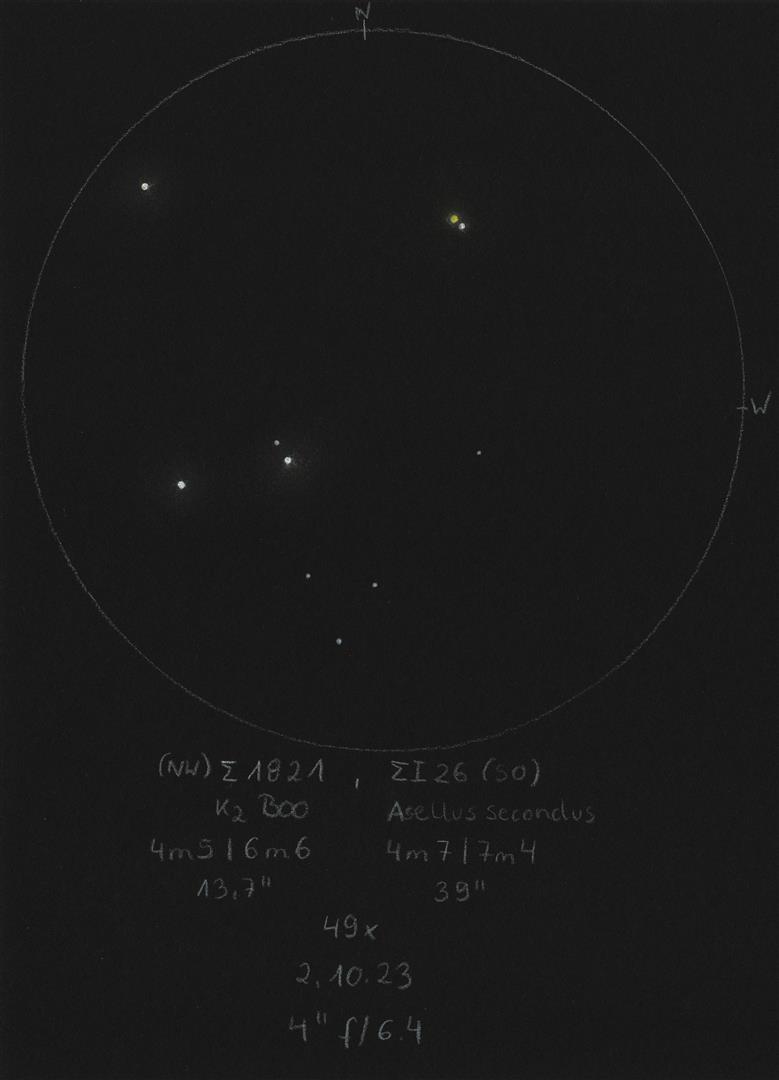
|
Sarah Gebauer
Germany |
100mm (73x) |
sehr schön zusammen mit STFA 26 in einem Gesichtsfeld bei 73x, dabei sehr schön getrennt |
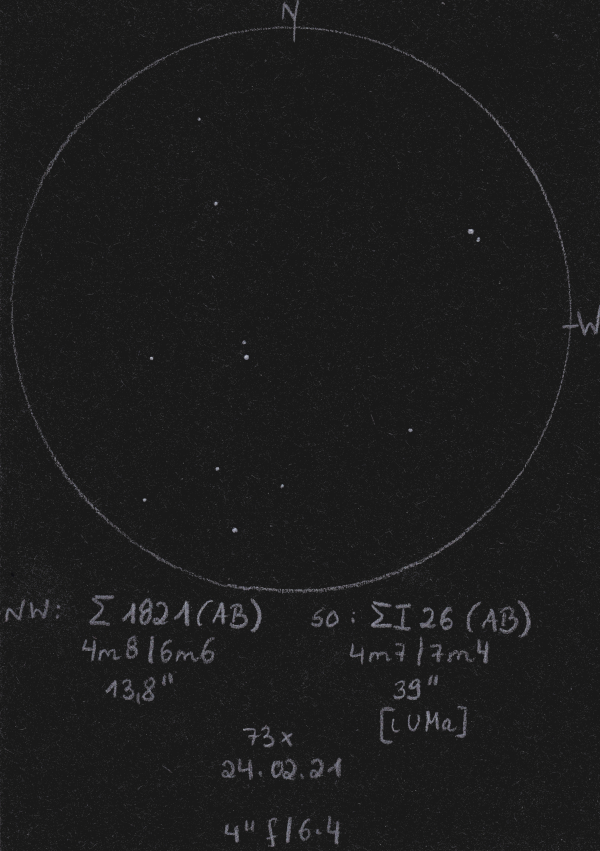
|
Uwe Pilz
Leipzig (Germany) |
105mm (144x) |
weiß-grau, trennbar bei 22x |
|
René Merting
Drachhausen (Germany) |
320mm (45x) |
bei 45x schicker Anblick und schön zusammen im Gesichtsfeld mit sehr ähnlichen Doppelstern STTA 26 - hier aber eine knappere Trennung und B steht im Südwesten von A - ähnlicher Farbkontrast wie beim Nachbardoppelstern, A ist weiß-gelb, B ist blau-grau |
|
Karsten Kopp
Köln (Germany) |
600mm (180x) |
Im CLT leicht zu trennen. Beider Sterne erscheinen weißlich. |
|
|
|
★
|
STF1816 |
|
|
7m.4 |
7m.8 |
0.4" |
100° |
2019 |
Boo |
14h13m54.63s / +29°06'19.50" |
|
|
Uwe Pilz
Leipzig (Germany) |
105mm (88x) |
gelb |

|
Mark McCarthy
Fremont (California/USA) |
178mm (533x) |
Notched elongation, unequal pair, seeing won't support higher magnification. Physical with 1340-year period, it is near periastron now and will remain there the rest of my lifetime |
|
Mark McCarthy
Fremont (California/USA) |
317mm (553x) |
Rod-shaped equal white. July 2017 |
|
|
|
★★
|
A1101 |
|
AB |
9m.7 |
10m.3 |
0.3" |
221° |
2020 |
Boo |
14h15m50.57s / +10°17'59.30" |
|
|
Mark McCarthy
Fremont (California/USA) |
508mm (1067x) |
I stared for a long time and had brief instants of an elongation or bump, and even a tentative split of a star. Sketched the orientation will check the PA later [I think I have it. My orientation on the sketch is in the correct position as in relation to the AB-C & AB-D pairs.] |
|
|
|
★
|
STF1825 |
|
|
6m.5 |
8m.4 |
4.2" |
154° |
2019 |
Boo |
14h16m32.84s / +20°07'18.70" |
|
|
Mark McCarthy
Fremont (California/USA) |
80mm (94x) |
Very fine split, >2 delta mag, white A and blue B, nice |
|
Mark McCarthy
Fremont (California/USA) |
203mm (333x) |
Cream white A and light blue B, wide ~5", ~2 delta mag |
|
Mark McCarthy
Fremont (California/USA) |
317mm (277x) |
White and orange, 3 delta mag, well split. |
|
|
|
|
STF1834 |
|
|
8m.1 |
8m.3 |
1.6" |
103° |
2019 |
Boo |
14h20m17.60s / +48°30'25.10" |
|
|
Robert Zebahl
Leipzig (Germany) |
120mm (150x) |
Bei 108x länglich, bei 150x knapp getrennt bei ähnlich hellen Komponenten. |
|
|
|
★★
|
STF1835 & BU1111 |
STF1835 |
A-BC |
5m.0 |
6m.8 |
6.4" |
197° |
2020 |
Boo |
14h23m22.74s / +08°26'47.90" |
|
|
|
BU1111 |
BC |
7m.4 |
7m.7 |
0.3" |
25° |
2020 |
|
|
|
|
René Merting
Drachhausen (Germany) |
100mm (64x) |
STF1835 (A-BC): bei 32x erscheint der Stern leicht unrund, verschmiert - bei 107x präsentiert sich BC gut getrennt im Süden von A - Helligkeitsunterschied eine Größenklasse (1.75 mag laut Stelle Doppie) - bei 64x sind beide Sterne auch getrennt erkennbar, BC strahlt warmweiß |
|
Robert Zebahl
Leipzig (Germany) |
102mm (62x) |
STF1835 (A-BC): Bei 28x gerade noch trennbar bei erkennbarem Helligkeitsunterschied. Bei 62x einfach trennbar. Die Farben wirkten ähnlich. |
|
Mark McCarthy
Fremont (California/USA) |
317mm (277x) |
STF1835 (A-BC): In a line of three stars, white and slightly red B. Wide, ~6", 2 delta mag. Did not detect BC 0.3" |
|
Mark McCarthy
Fremont (California/USA) |
508mm (1067x) |
BU1111 (BC): Short period pair, it is a component of STF 1835. I get a nothed near equal elongation with a clear direction in relation to the A star. Very cool |
|
Karsten Kopp
Köln (Germany) |
600mm (180x) |
STF1835 (A-BC): Doppelstern konnte im CLT gut getrennt werden. Helligkeitsunterschied ist merklich, aber nicht extrem. Der hellere erscheint eher weißlich und der kleinere eher bläulich. Der Farbunterschied ist aber minimal. |
|
|
Berthold Fuchs
Wiesbaden (Germany) |
130mm |
STF1835 (A-BC): enger DS |
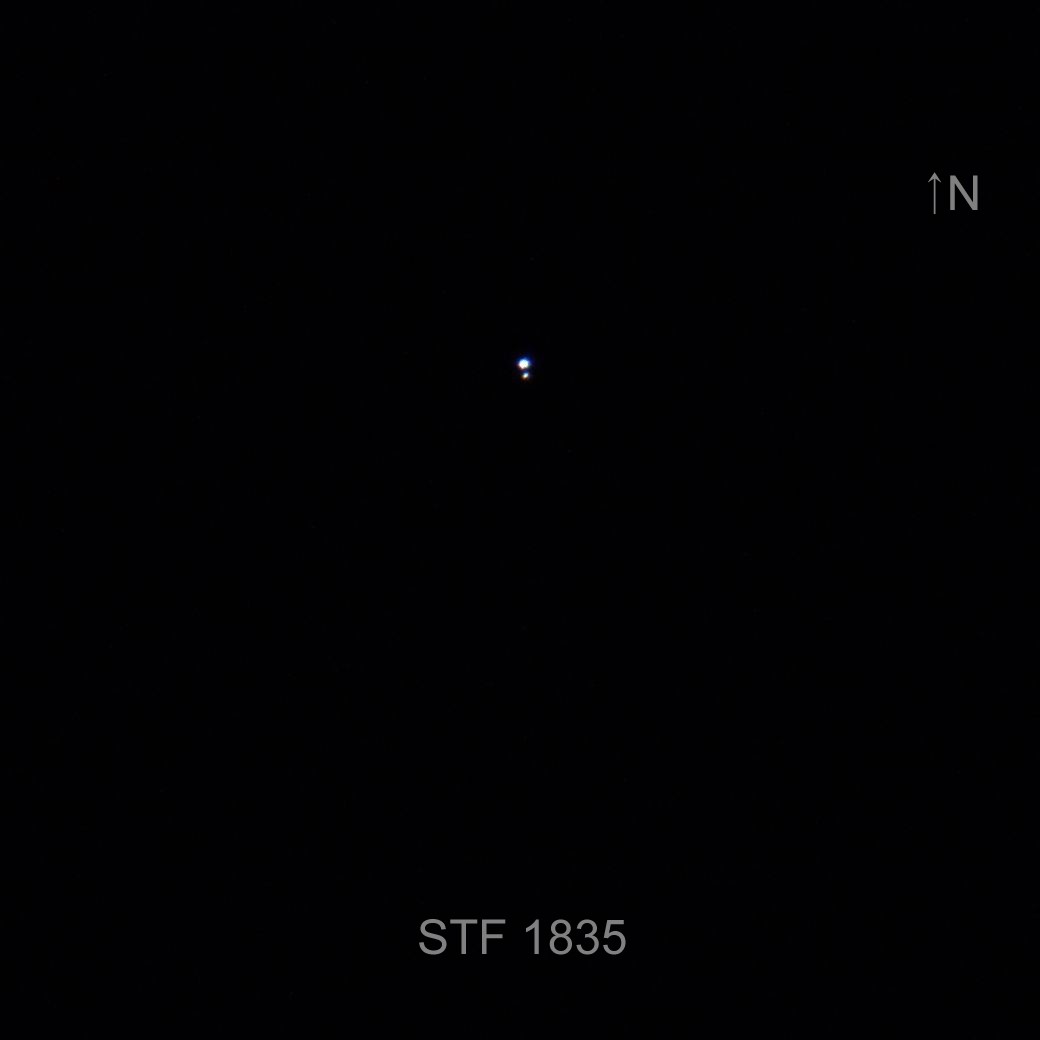
|
|
|
|
HU1268 |
|
|
9m.8 |
9m.9 |
0.4" |
338° |
2019 |
Boo |
14h29m32.75s / +36°12'26.00" |
|
|
Mark McCarthy
Fremont (California/USA) |
203mm (533x) |
Notched elongation, white, near equal |
|
|
|
|
STF1858 |
|
AB |
8m.1 |
9m.0 |
3.1" |
38° |
2020 |
Boo |
14h33m36.45s / +35°35'08.00" |
|
|
|
|
AC |
8m.1 |
14m.3 |
19.6" |
336° |
2016 |
|
|
|
|
|
|
AD |
8m.1 |
14m.7 |
39.2" |
326° |
2016 |
|
|
|
|
René Merting
Drachhausen (Germany) |
100mm (142x) |
AB: bei 64x ein extrem dicht stehendes Pärchen, Trennung fast greifbar - bei 142x stehen die Sterne noch immer sehr eng, die Trennung ist nun aber eindeutig - Komponente B im NO ist etwas schwächer - beide Sterne leicht gelblich, hin und wieder mit Farbkontrast in Richtung orange |
|
Uwe Pilz
Leipzig (Germany) |
105mm (288x) |
AB: nicht getrennt |
|
Mark McCarthy
Fremont (California/USA) |
203mm (205x) |
AB: Nice white pair, ~1.5 delta mag, wide ~5". (Check the orbit on this one! Oh to be alive in the 3530s to see B whip around A) |
|
Mark McCarthy
Fremont (California/USA) |
317mm (553x) |
AC: 13th magnitude, a wide pair? Seen with averted vision, comes and goes with seeing |
|
|
|
|
A347 |
|
|
8m.7 |
8m.4 |
0.5" |
236° |
2018 |
Boo |
14h36m56.24s / +48°13'17.90" |
|
|
Mark McCarthy
Fremont (California/USA) |
508mm (445x) |
Near equal white stars, suspected double at 205x, easy split at 445x. Binary with 236.4-year period |
|
|
|
★
|
STF1863 |
|
|
7m.7 |
7m.8 |
0.6" |
58° |
2021 |
Boo |
14h38m00.71s / +51°34'42.10" |
|
|
Robert Zebahl
Leipzig (Germany) |
102mm (280x) |
16.05.2021: Der Doppelstern wirkte länglich bei einem geschätzten Positionswinkel von 60°. |
|
Christopher Hay
Seeheim (Germany) |
180mm (200x) |
30. Mai 2021, gegenwärtiger Komponentenabstand 0,65” nach Stelledoppie. Bei der Beobachtung weder vorherige Kenntnis des Positionswinkels noch der Helligkeitsdifferenz.
Ständige Streckung gesehen. Eindeutige Stellung der Hauptkomponente innerhalb dieser Streckung, eindeutiger als die relativen Helligkeiten (erst nach Beobachtung konsultiert) mich hätten erwarten lassen. Geschätzter Positionswinkel 60°.
In guten Momenten erscheinen Fragmente eines birnenförmigen ersten Beugungsringes um das System, besonders auf der Seite der Hauptkomponente. Ein interessantes, ansprechendes Bild. |
|
Frederik Wanink
Itterbeck (Germany) |
254mm (640x) |
gerade trennbar |

|
|
|
|
STF1867 |
|
|
8m.4 |
8m.8 |
0.7" |
355° |
2017 |
Boo |
14h40m44.21s / +31°17'23.50" |
|
|
Mark McCarthy
Fremont (California/USA) |
203mm (533x) |
Hairline split best moments, noticeable mag difference |
|
Mark McCarthy
Fremont (California/USA) |
317mm (553x) |
0.5 delta mag, hair to figure 8 split, white. |
|
|
|
|
STF1872 |
|
AB |
7m.5 |
8m.3 |
7.4" |
50° |
2019 |
Dra |
14h41m00.84s / +57°57'28.10" |
|
|
|
|
AC |
7m.5 |
10m.6 |
75.7" |
42° |
2015 |
|
|
Sarah Gebauer
Germany |
100mm (49x) |
AB: bei 49-fach bereits fein getrennt - A strahlt warmweiß mit einem zarten Hauch von Gelb und etwas heller als B, der eher warmgrau erscheint - bei 80-fach verstärkt sich der Farbeindruck ganz leicht - ein sehr filigranes, dünnes Pärchen |
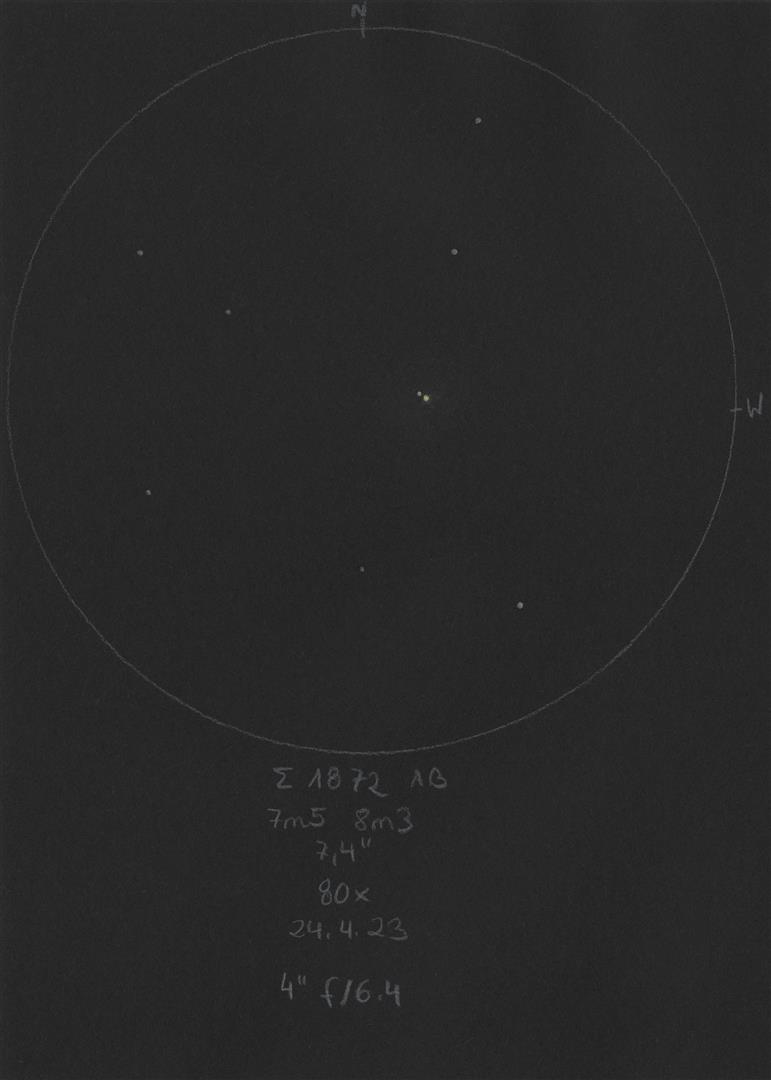
|
René Merting
Drachhausen (Germany) |
320mm (45x) |
AB: bei 45x ist die B-Komponente nordöstlich über A erkennbar, ein Blatt Papier passt zwischen die beiden - leichter Farbunterschied - bei 72x zeigt sich ein gut getrenntes Pärchen, B ist eine dreiviertel Magnitude schwächer und blauweiß, A ist gelbweiß |
|
René Merting
Drachhausen (Germany) |
320mm (144x) |
AB: bei 45x ein schönes enges, knapp getrenntes Sternpaar mit einem schönen Farbkontrast - Helligkeitsunterschied eine Magnitude - Komponente A wirkt orangegelb und B … irgendwie anders - bei 72x ist A zart cremegelb, B ist stahlgraublau - bei 144x ist A buttergelb (er verliert eigenartigerweise immer mehr Farbe) und B mit noch mehr Blauanteilen |

|
Karsten Kopp
Köln (Germany) |
600mm (180x) |
AB: Doppelstern ist gut zu trennen. Helligkeitsunterschied ist erkennbar, aber nicht besonders auffällig. Der hellere Stern erscheint weißgelblich und der schwächere gelblich. |
|
|
|
★★
|
zeta Boo |
STF1865 |
AB |
4m.5 |
4m.5 |
0.2" |
273° |
2021 |
Boo |
14h41m08.92s / +13°43'42.00" |
|
|
|
H6 104 |
AB-C |
4m.5 |
11m.0 |
104.3" |
259° |
2020 |
|
|
|
|
Uwe Pilz
Leipzig (Germany) |
105mm (88x) |
AB-C |

|
Uwe Pilz
Leipzig (Germany) |
120mm (250x) |
AB |

|
Mark McCarthy
Fremont (California/USA) |
508mm (1067x) |
AB: Zeta Boo. Short period. First impression was moderately well notched overlapping disks (eg. not barely notched, but not strongly notched either). With more time observing & getting used to the image, and in moments of better seeing, the notch became more distinct. It would not separate in spite of moments of better seeing. I could also see the elongation, but only subtly notched due to the smaller scale, at 667x |
|
|
|
|
STF1871 |
|
|
8m.0 |
8m.1 |
1.8" |
313° |
2019 |
Boo |
14h41m35.50s / +51°23'51.30" |
|
|
Robert Zebahl
Leipzig (Germany) |
102mm (187x) |
16.05.2021: Klar getrennt, aber noch recht dicht zusammenstehend bei ähnlich hellen Komponenten. |
|
|
|
|
STF1878, DL Dra |
|
|
6m.3 |
9m.2 |
4.2" |
314° |
2019 |
Dra |
14h42m03.25s / +61°15'42.90" |
|
|
Uwe Pilz
Leipzig (Germany) |
105mm (198x) |
starke Aufhellung im ersten Ring |

|
René Merting
Drachhausen (Germany) |
320mm (144x) |
bei 144x sieht der Doppelstern genauso aus wie der benachbarte östlich stehende STF 1882 bei 45x - B steht knapp abgesetzt im Nordwesten von A und ist 2 Größenklassen schwächer (2.83 mag laut Stelle Doppie) - leichter Farbkontrast |
|
|
|
★★
|
HU575 |
|
AB |
9m.8 |
10m.1 |
0.4" |
284° |
2017 |
Boo |
14h42m33.63s / +19°28'46.90" |
|
|
Mark McCarthy
Fremont (California/USA) |
508mm (1067x) |
Short period. Small, faint, but definite split of these orange-red near equal stars. I sketched a clear orientation to field stars. Awesome |
|
|
|
★
|
A1109 |
|
AB |
7m.4 |
9m.4 |
1.9" |
88° |
2017 |
Vir |
14h42m47.60s / +06°35'26.40" |
|
|
Mark McCarthy
Fremont (California/USA) |
203mm (333x) |
Both stars light yellow, big magnitude difference, ~3-4 delta mag, about 2". Not difficult |
|
|
|
|
STT285 |
|
AB |
7m.8 |
8m.7 |
0.5" |
76° |
2019 |
Boo |
14h45m29.74s / +42°22'56.40" |
|
|
Mark McCarthy
Fremont (California/USA) |
508mm (445x) |
Nicely split white stars, 1 delta mag, noted the PA with drift. Short period, 88.993-year period, it is at apastron and will hang there for the next decade |
|
|
|
|
STF1879 |
|
AB |
7m.8 |
8m.4 |
1.7" |
82° |
2021 |
Boo |
14h46m15.58s / +09°38'48.20" |
|
|
Mark McCarthy
Fremont (California/USA) |
317mm (553x) |
Fairly close yellow and orange-yellow, ~1 delta mag, ~3" |
|
Karsten Kopp
Köln (Germany) |
600mm (180x) |
Doppelstern konnte gerade so getrennt werden. Beide erscheinen weißlich. |
|
|
|
★
|
STF1884 |
|
|
6m.6 |
7m.5 |
2.3" |
55° |
2020 |
Boo |
14h48m23.37s / +24°22'01.00" |
|
|
Mark McCarthy
Fremont (California/USA) |
80mm (94x) |
Extremely fine, 1 delta mag, notched, to overlapping disks at best moments. Physical with a 1398.2859-year period, it has a nearly edge-on orbit and is currently at the shorter of the two furthest reaches of its orbit |
|
René Merting
Drachhausen (Germany) |
100mm (64x) |
bei 64x ist der Doppelstern als 8 erkennbar, 107x reicht dann für die knappe Trennung - die B-Komponente im NO ist nur unwesentlich schwächer - ein sehenswertes Pärchen |
|
Robert Zebahl
Leipzig (Germany) |
102mm (86x) |
Bei 86x knapp getrennt bei sichtbarem Helligkeitsunterschied. Bei 160x einfach zu trennen. A: weiß, B: leicht orangefarben. |
|
Mark McCarthy
Fremont (California/USA) |
203mm (333x) |
Prototypical pair, >1 delta mag, ~3" separation, white to off white color |
|
Frederik Wanink
Itterbeck (Germany) |
254mm (640x) |
einfach |

|
Karsten Kopp
Köln (Germany) |
600mm (180x) |
Doppelstern konnte gerade so getrennt werden. Beide Sternen leuchten weißlich. |
|
|
|
|
BU346 |
|
|
7m.5 |
7m.9 |
2.8" |
278° |
2021 |
Lib |
14h48m31.71s / -17°20'24.40" |
|
|
Mark McCarthy
Fremont (California/USA) |
317mm (553x) |
Easy, well split, yellow-orange stars, half delta mag. |
|
|
|
|
STF1883 |
|
|
7m.0 |
8m.9 |
1.1" |
277° |
2021 |
Vir |
14h48m53.22s / +05°57'15.90" |
|
|
Mark McCarthy
Fremont (California/USA) |
317mm (553x) |
Strongly suspect a split / elongation in 80mm finder. In the scope it is a tight 2 delta mag orangish-white pair, ~1" |
|
|
|
|
BU106, mu Lib, 7 Lib |
|
AB |
5m.6 |
6m.6 |
1.9" |
7° |
2019 |
Lib |
14h49m19.09s / -14°08'56.30" |
|
|
|
|
AC |
5m.6 |
14m.7 |
12.3" |
295° |
2016 |
|
|
|
|
|
|
AD |
5m.6 |
14m.1 |
25.0" |
165° |
2016 |
|
|
|
|
|
|
AE |
5m.6 |
12m.6 |
26.6" |
232° |
2016 |
|
|
|
|
Mark McCarthy
Fremont (California/USA) |
203mm (333x) |
AB: Close, 1.5-2", half to one delta mag, off-white stars. |
|
Gerd Kohler
Langenzenn (Germany) |
254mm (346x) |
AB: Bläulich-weiß - bläulich-weiß. A und B haben nur einen geringen Helligkeitsunterschied. |
|
Gerd Kohler
Langenzenn (Germany) |
254mm (346x) |
AE: Bläulich-weiß - weiß. Stern E ist sehr schwach. |
|
Frederik Wanink
Itterbeck (Germany) |
254mm (640x) |
AB: getrennt, schwierig wegen Südlage |
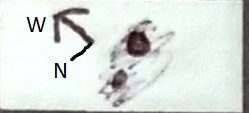
|
|
|
★
|
STF1890, 39 Boo |
|
|
6m.3 |
6m.7 |
2.6" |
46° |
2020 |
Boo |
14h49m41.37s / +48°43'15.60" |
|
|
Robert Zebahl
Leipzig (Germany) |
70mm (67x) |
01.04.2020: Bei 44x länglich, teils mit Einschnürung. Bei 67x getrennt, aber sehr dicht zusammen. Ein Helligkeitsunterschied war nicht erkennbar. Bei 133x deutlich getrennt bei geringem Helligkeitsunterschied. A wirkte blass-gelblich, B eher warm-weiß. |
|
Robert Zebahl
Leipzig (Germany) |
70mm (100x) |
18.04.2020: Bei 57x sehr fein getrennt mit extrem dicht zusammenstehenden Komponenten, welche gleich hell wirkten. Bei 100x sehr schönes Paar mit geringem Helligkeitsunterschied. Fantastischer Anblick! Farblich wirkten die Komponenten leicht verschieden: creme-weiß & Hauch von gelb-orange. |
|
Sarah Gebauer
Germany |
100mm (49x) |
02.10.23: das dünnste und feinste Sternpaar, das ich bei 80-fach bisher gesehen habe, zwei hauchfein getrennte Ameisenpünktchen - die südwestliche Komponente erscheint minimal heller und größer, beide wirken hellgold mit einem weißen Tupfen |
|
Robert Zebahl
Leipzig (Germany) |
102mm (187x) |
16.05.2021: Einfach. Schöner Doppelstern mit leichtem Helligkeitsunterschied. Gelblich & eher weiß. Den Positionswinkel schätzte ich auf 40°. |
|
Frederik Wanink
Itterbeck (Germany) |
254mm (640x) |
gleich hell |

|
Mark McCarthy
Fremont (California/USA) |
317mm (553x) |
Bright white pair, well split |
|
|
|
★
|
xi Boo, 37 Boo |
STF1888 |
AB |
4m.8 |
7m.0 |
5.0" |
296° |
2021 |
Boo |
14h51m23.38s / +19°06'01.70" |
|
|
|
STF1888 |
AC |
4m.8 |
13m.8 |
71.3" |
340° |
2015 |
|
|
|
|
|
STF1888 |
AD |
4m.8 |
11m.7 |
160.8" |
286° |
2015 |
|
|
|
|
|
ARN11 |
AE |
4m.8 |
8m.7 |
271.5" |
98° |
2015 |
|
|
|
|
|
ARN11 |
AF |
4m.8 |
9m.2 |
335.4" |
39° |
2020 |
|
|
|
|
|
STF1888 |
BC |
7m.0 |
13m.8 |
67.0" |
343° |
2016 |
|
|
|
|
|
STF1888 |
BE |
7m.0 |
8m.7 |
273.1" |
99° |
2016 |
|
|
|
|
Robert Zebahl
Leipzig (Germany) |
70mm (44x) |
AB: 24.04.2020: Wunderschön getrennt mit recht großem Helligkeitsunterschied in einem schönen Sternumfeld. Die Hauptkomponente leuchtet gelblich mit einem schwachem Begleiter. |
|
Mark McCarthy
Fremont (California/USA) |
80mm (94x) |
AB: Yellow A and orange B, 2 delta mag, nice. Only 22 light years distant, it is physical with a 298-year period, and will tighten the next 30 years |
|
Sarah Gebauer
Germany |
150mm (83x) |
AB: die 6'' entfernten Komponenten A und B konnten mühelos bei 83x getrennt werden, Komponente E war zu sehen, C, D und F waren nicht sichtbar |

|
Mark McCarthy
Fremont (California/USA) |
508mm (333x) |
AB: Xi Boo. Short period. Richly colored yellow and orange stars, ~1 delta mag, ~5" separation, with several other stars in view. Very pretty |
|
Karsten Kopp
Köln (Germany) |
600mm (180x) |
AB: Ein recht schöner Doppelstern, wobei neben dem Helligkeitsunterschied von 2,2 mag auch die Sternfarben ein schönes Gesamtbild geben. Der hellere Stern erstrahlt gelblich weiß und der schwächere orangegelb.
Hier handelt es sich auch um ein recht nahes System mit 21,9 Lichtjahren Entfernung. |
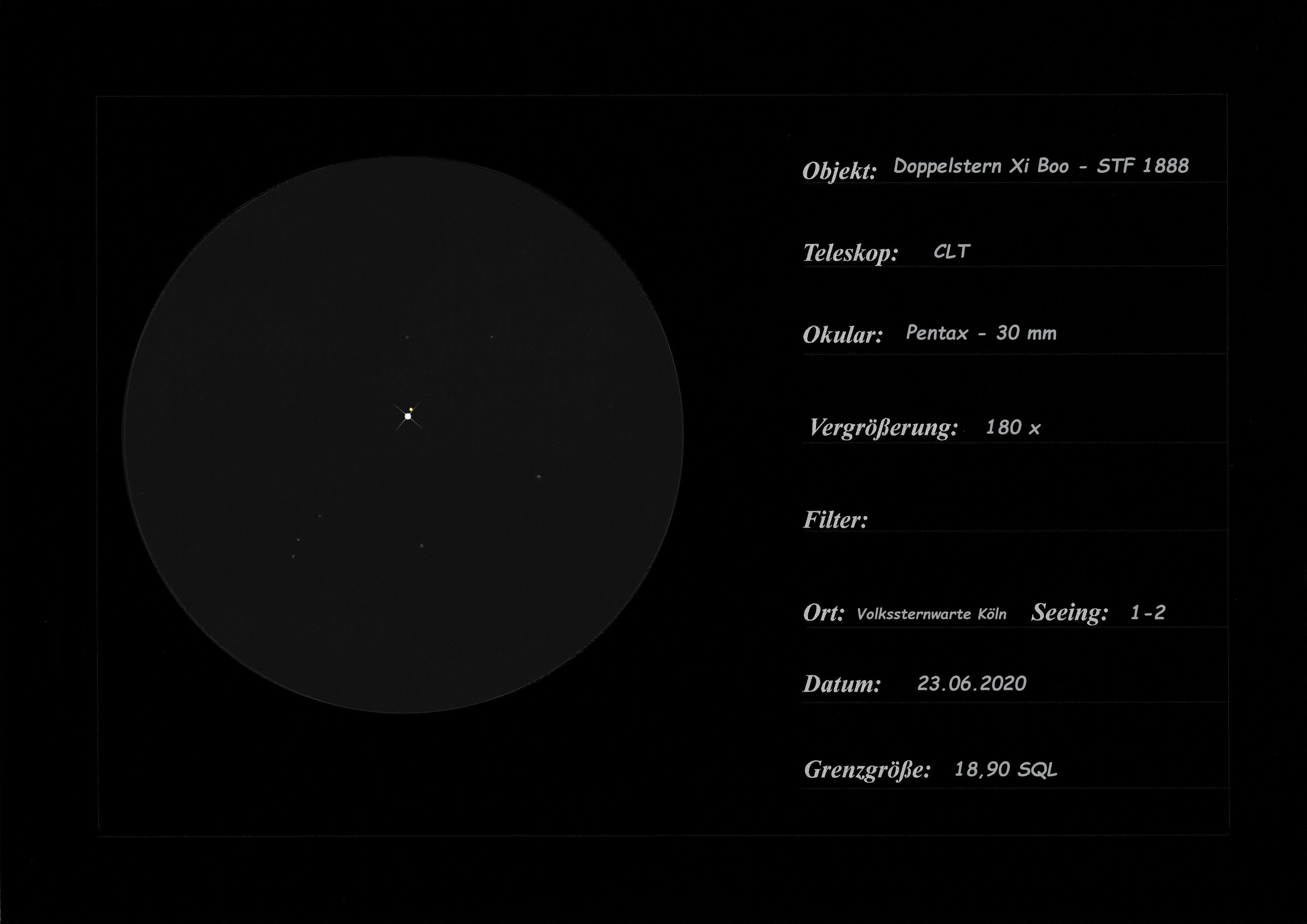
|
|
Frederik Wanink
Itterbeck (Germany) |
254mm |
AB |
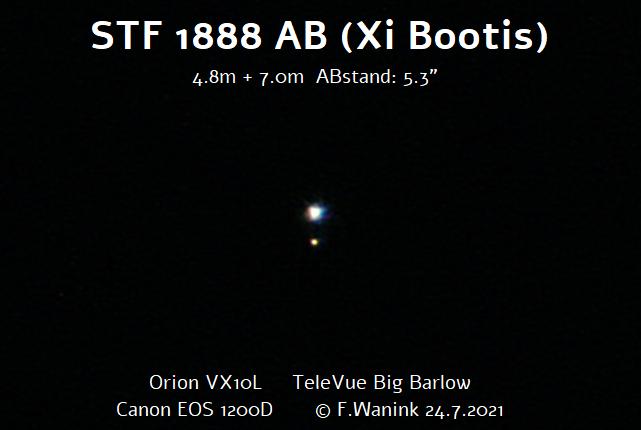
|
|
|
★
|
STT287 |
|
|
8m.4 |
8m.6 |
0.6" |
11° |
2021 |
Boo |
14h51m27.53s / +44°55'42.60" |
|
|
Mark McCarthy
Fremont (California/USA) |
317mm (553x) |
Wow! Hair-split, ~0.7", near equal to half a delta mag. |
|
Mark McCarthy
Fremont (California/USA) |
508mm (533x) |
An elongated smear at 205x, split with seeing at 445x, stead split at 533x. <1", near equal white stars. Binary with 340-year period, currently tightening to periastron around 2044 |
|
|
|
★
|
BU31 |
|
AB |
8m.5 |
10m.3 |
1.8" |
225° |
2021 |
Boo |
14h52m30.05s / +18°44'19.50" |
|
|
Mark McCarthy
Fremont (California/USA) |
203mm (333x) |
White A and light yellow B, finely split, ~2 delta mag |
|
Karsten Kopp
Köln (Germany) |
600mm (180x) |
Doppelstern konnte gerade so getrennt werden. Die Distanz von 2,0 Bogensekunden und die Helligkeit beider Sterne, macht die Sichtung nicht leicht. |
|
|
|
|
STT288 |
|
|
6m.9 |
7m.5 |
1.0" |
154° |
2021 |
Boo |
14h53m23.35s / +15°42'18.30" |
|
|
Mark McCarthy
Fremont (California/USA) |
203mm (333x) |
Consistent split, better with seeing, ~1 delta mag, ~1" separation, blue-white stars |
|
Frederik Wanink
Itterbeck (Germany) |
254mm (640x) |
rel. einfach |

|
Mark McCarthy
Fremont (California/USA) |
317mm (553x) |
Notched / figure 8 with 277x, split with 553x. |
|
Mark McCarthy
Fremont (California/USA) |
317mm (553x) |
Needed 553x to separate, resolved with the seeing. Near equal yellow-white, ~1" or less. |
|
|
|
|
A1627 |
|
|
8m.8 |
8m.8 |
0.2" |
200° |
2016 |
Boo |
14h55m46.57s / +39°38'54.30" |
|
|
Mark McCarthy
Fremont (California/USA) |
508mm (889x) |
Elongated at 533x, notched at 889x, stronger notch at 1334x. Light orange A, light blue B, equal magnitude. Currently 0.237", it has a 101.25-year period, seen nearly face in, and is at apastron to the SW and will make a quarter turn toward the W and tighten to <0.15" by 2041. Interestingly Gaia lacks data for these stars, so the orbit must be derived from historical measures only |
|
|
|
|
HU907 |
|
|
10m.2 |
10m.2 |
0.2" |
284° |
2014 |
Boo |
15h00m10.00s / +21°28'48.80" |
|
|
Mark McCarthy
Fremont (California/USA) |
508mm (889x) |
Very subtly notched olive, very tough. WDS says physical but Gaia lacks data on the stars |
|
|
|
★
|
STF1909, 44 Boo |
|
|
5m.2 |
6m.1 |
0.2" |
138° |
2020 |
Boo |
15h03m47.30s / +47°39'14.60" |
|
|
Frederik Wanink
Itterbeck (Germany) |
254mm (640x) |
2015 getrennt zu sehen (1") |
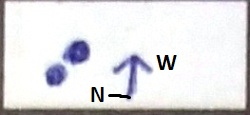
|
Mark McCarthy
Fremont (California/USA) |
317mm (553x) |
I Boo. Figure 8 to hair split, ~0.9". This pair shrinking separation fast, will be <0.5" in a couple of years. Only 40 LY away. (July 2017) |
|
|
|
|
BU119 |
|
AB |
8m.1 |
8m.8 |
2.3" |
274° |
2019 |
Lib |
15h05m31.91s / -07°00'48.80" |
|
|
Mark McCarthy
Fremont (California/USA) |
203mm (333x) |
Tried 667x at first but it was too much power, too dim and seeing too choppy. 333x was perfect, clean and well split ~2" near equal, slightly orange |
|
|
|
★★
|
STFA27, delta Boo, 49 Boo |
|
AB |
3m.6 |
7m.9 |
105.0" |
78° |
2021 |
Boo |
15h15m30.16s / +33°18'53.40" |
Christopher Hay
Seeheim (Germany) |
15x45 |
Handgehalten, Fernglas mit interner Stabilisierung. Sehr weit getrennt. Komponente A hat eine leichte gelb-orange Tönung, während der Begleiter zu schwach ist um eine Farbwahrnehmung zu bekommen (FST 5m0 im Zielgebiet).
Hübsch in 4,5° Gesichtsfeld zusammen mit Mu Boo AB, welcher sichtlich etwas weiter als Delta Boo ist und dessen Komponente B etwas heller ist als jene von Delta Boo.
Delta Boo ist ein physikalischer Doppelstern in einem Abstand zu uns von 122 Lichtjahren. |
|
René Merting
Drachhausen (Germany) |
18x70 |
ein sehr ungleiches, weit auseinander stehendes Sternpaar - Komponente A im Westen strahlt gleißend cremegelb, die wesentlich schwächere Komponente B im Osten ist weißgrau bis bräunlich |
|
Robert Zebahl
Leipzig (Germany) |
70mm (22x) |
24.04.2020: Weit getrenntes Paar mit großem Helligkeitsunterschied. Weniger auffallend. Die helle Hauptkomponente strahlt in einem hellen Gelb. |
|
Mark McCarthy
Fremont (California/USA) |
80mm (13x) |
Split in 80mm finder. Very wide pair, very bright A, 3 delta mag B. Orange-yellow and blue-white B |
|
Mark McCarthy
Fremont (California/USA) |
80mm (94x) |
Delta Boo. Wide, large delta mag B, a 76,000-period pair! |
|
Sarah Gebauer
Germany |
100mm (49x) |
bei 49-fach zeigt A ein schönes, zartes Gelb, der weit entfernte Begleiter ist sehr fein, wesentlich schwächer und schafft es nicht über einen grauen Farbeindruck hinaus |
|
René Merting
Drachhausen (Germany) |
107mm (30x) |
bei 30x deutlich getrennt - Komponente A strahlt ein einem seidenen Gelb, B ist mehr als zwei Größenklassen schwächer und wirkt weißlich |
|
Mark McCarthy
Fremont (California/USA) |
203mm (205x) |
Bright star with many nearby faint stars. Didn't bother trying to figure out which are which. |
|
|
Frederik Wanink
Itterbeck (Germany) |
254mm |
|

|
|
|
|
STF1932 |
|
AB |
7m.3 |
7m.4 |
1.6" |
267° |
2019 |
CrB |
15h18m20.19s / +26°50'24.70" |
|
|
Frederik Wanink
Itterbeck (Germany) |
254mm (640x) |
gleich hell, getrennt |
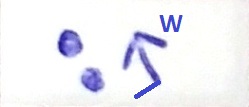
|
Mark McCarthy
Fremont (California/USA) |
317mm (553x) |
Near equal yellow-white, very close but clean split, ~1.5". Nice! |
|
|
|
★★★
|
mu Boo, 51 Boo, Alkalurops |
CHR181, mu 1 Boo |
Aa-Ab |
4m.3 |
|
0.1" |
188° |
2012 |
Boo |
15h24m29.54s / +37°22'37.10" |
|
|
|
STFA28, mu 1 Boo |
AB |
4m.3 |
7m.1 |
109.2" |
171° |
2020 |
|
|
|
|
|
STF1938, mu 2 Boo |
Ba-Bb |
7m.1 |
7m.6 |
2.2" |
2° |
2020 |
|
|
|
|
Christopher Hay
Seeheim (Germany) |
7x45 |
STFA28 (AB): Handgehalten. Weit getrennt. Ein kompaktes, ungleiches Paar. Komponente A bläulich-weiss.
Sehr schön in 8,6° Gesichtsfeld zusammen mit Nu1/2 Boo, welcher mit entzückendem Farbkontrast aufwartet, nämlich gold-orange zu eisblau, womit Nu1/2 Boo sicher einer der stärksten Farbkontrastpaare für Feldstecher ist und den Anblick von Mu Boo nochmal deutlich verstärkt.
Im 15x45 Fernglas ist STFA28 AB sehr weit getrennt, Komponente A dabei bläulich-weiss, Komponente B in wärmerem Farbton. |
|
Robert Zebahl
Leipzig (Germany) |
8x40 |
STFA28 (AB): Einfach trennbar bei deutlichem Helligkeitsunterschied. |
|
Robert Zebahl
Leipzig (Germany) |
16x70 |
STFA28 (AB): 14.06.2021: Weites, relativ auffälliges Paar. Zartgelb & dunkelorange. |
|
René Merting
Drachhausen (Germany) |
16x70 |
STFA28 (AB): weit getrenntes Pärchen, aufgrund der großen Helligkeitsunterschiedes schöner Farbkontrast - Komponente A im Norden gelblich, B im Süden mehr grau-braun |
|
Robert Zebahl
Leipzig (Germany) |
70mm (22x) |
STFA28 (AB): Auffällig, großer Abstand und Helligkeitsunterschied. A: weiß-gelblich, B: grau. |
|
Mark McCarthy
Fremont (California/USA) |
80mm (94x) |
STFA28 (AB): Alkalurops Bright yellow-white A and bluish B, which is itself a slightly unequal close double, finely split (STF 1938 Ba,Bb) -- 256.5-year period, now coming off apastron |
|
Sarah Gebauer
Germany |
100mm (21x) |
STFA28 (AB): 02.10.23: bei 21-fach sehr eindeutig auszumachen, das Paar sticht durch eine sehr helle, blass zitronengelbe A-Komponente und eine graue bis schmutzig weiße, weit abgesetzte B-Komponente hervor |
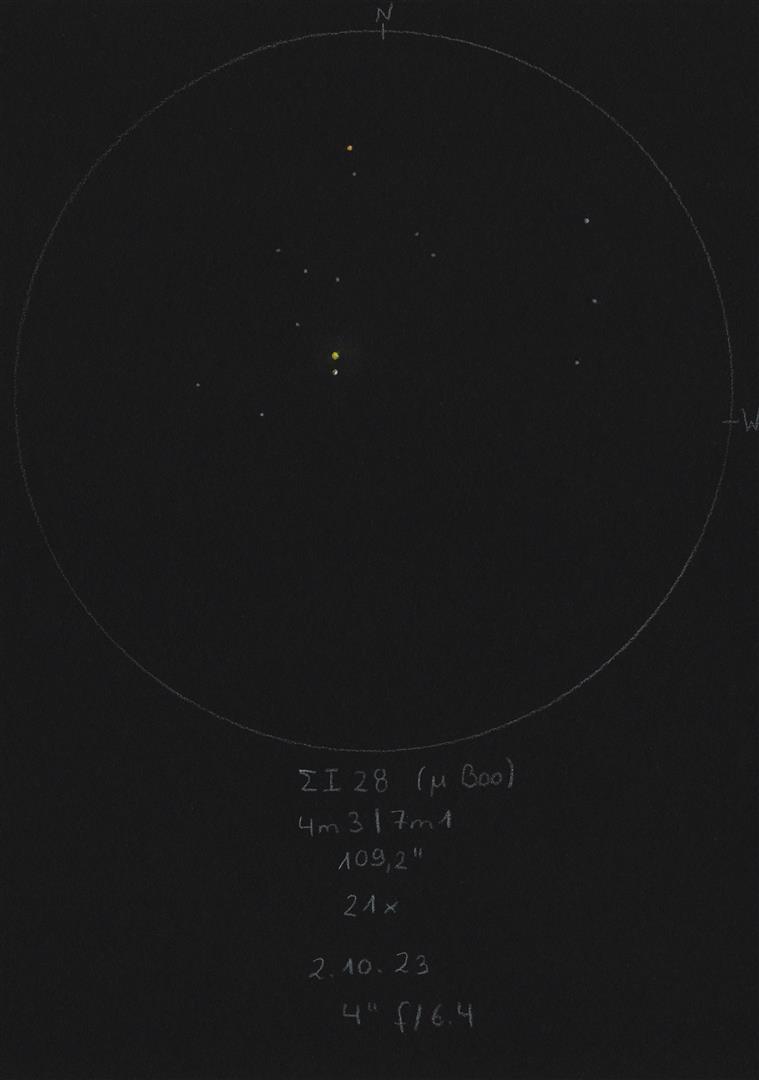
|
Sarah Gebauer
Germany |
100mm (49x) |
STFA28 (AB): bei 49-fach sehr hell und sehr weit, unterschiedlich hell und dominiert das ohnehin schon eher leere Gesichtsfeld |
|
Robert Zebahl
Leipzig (Germany) |
102mm (125x) |
Wunderschöner Anblick! Bei diesem Dreifachsystem handelt es sich um STFA 28 und STF 1938. |
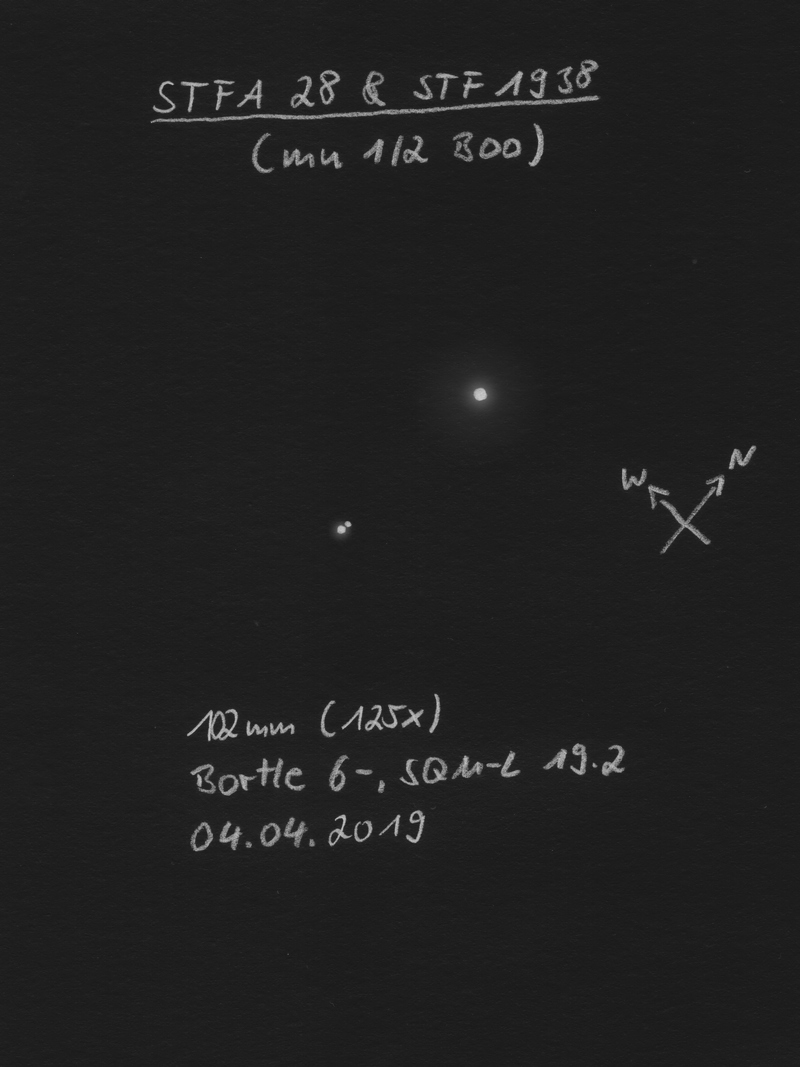
|
Uwe Pilz
Leipzig (Germany) |
105mm (288x) |
ein heller 4m und zwei nahe dunkle 7m, lohnend. |
|
René Merting
Drachhausen (Germany) |
107mm (30x) |
STFA28 (AB): AB: das Paar ist bei 30x komfortabel getrennt erkennbar, A strahlt leicht gelblich - Komponente B besteht aus zwei Sternen Ba, Bb (STF 1938), die ab 120x getrennt zu sehen sind - Bb im Norden ist gut eine viertel bis halbe Größenklasse schwächer als Ba |
|
René Merting
Drachhausen (Germany) |
107mm (120x) |
STF1938 (Ba-Bb): bei 86x ist nördlich von Ba ein zweiter etwas schwächerer Stern erkennbar, er klebt noch an Ba - 120x reichen dann für eine knappe Trennung - Bb im Norden ist eine viertel bis halbe Größenklasse schwächer |
|
Robert Zebahl
Leipzig (Germany) |
120mm (23x) |
STFA28 (AB): Einfach trennbar bei großem Abstand und deutlichem Helligkeitsunterschied. |
|
Sarah Gebauer
Germany |
150mm (125x) |
A-BC mit 109'' sind bei 125x sehr weit getrennt, es ist der Ansatz eines engen Doppelsterns zu erkennen, der sich mit 2,2'' Abstand auch bis 250x nicht auftrennen ließ |
|
Christopher Hay
Seeheim (Germany) |
180mm (105x) |
STF1938 (Ba-Bb): Bei 105x in schlechtem Seeing ein sich berührendes, gleichmäßiges Paar. Bei 180x trotz des schlechten Seeings klar getrennt, südliche Komponente (Ba) is etwas heller als Bb. |
|
Mark McCarthy
Fremont (California/USA) |
203mm (205x) |
STFA28 (AB): Bright A star does not seem round. The B star is a tight equal pair, pretty set. [Aa,Ab is CHR 181 0.1", and I'd be shocked if I actually detected it. STFA 28 is technically the bright star and the tight pair, the tight pair is Ba,Bb = STF 1938, 7.09/7.63, 2.2"] |
|
Mark McCarthy
Fremont (California/USA) |
203mm (205x) |
STFA28 (AB): Bright A star does not seem round (CHR181). B star is a tight equal pair (STF1938 Ba-Bb). Pretty set. STFA 28 is technically the bright star and the tight pair |
|
Mark McCarthy
Fremont (California/USA) |
203mm (205x) |
CHR181 (Aa-Ab): Bright A star does not seem round (CHR181). B star is a tight equal pair (STF1938 Ba-Bb). Pretty set. STFA 28 is technically the bright star and the tight pair |
|
Mark McCarthy
Fremont (California/USA) |
203mm (205x) |
STF1938 (Ba-Bb): Bright A star does not seem round (CHR181). B star is a tight equal pair (STF1938 Ba-Bb). Pretty set. STFA 28 is technically the bright star and the tight pair |
|
Frederik Wanink
Itterbeck (Germany) |
254mm (640x) |
STF1938 (Ba-Bb): 3er System, schön |

|
Mark McCarthy
Fremont (California/USA) |
317mm (277x) |
STFA28 (AB): Bright white star with tight yellow pair STF 1938 as its companion. |
|
Mark McCarthy
Fremont (California/USA) |
317mm (553x) |
STFA28 (AB): Striking. Bright star with near equal double STF 1938 paired with it. A star is a spectroscopic binary |
|
Mark McCarthy
Fremont (California/USA) |
317mm (553x) |
STF1938 (Ba-Bb): Near equal close but well split double also paired with STFA28 |
|
Karsten Kopp
Köln (Germany) |
600mm (257x) |
Hier handelt es sich um ein Dreifachsternsystem, welches jetzt aber nicht durch eine besondere Färbung der Sterne auffällt. Die A - B/C Komponenten stehen noch sehr weit auseinander, wobei auch die A-Komponente um einiges heller erscheint. Die beiden Komponenten B/C sind wesentlich näher beieinander und unterscheiden sich auch kaum in ihrer Helligkeit. |

|
|
|
|
HU149 |
|
|
7m.5 |
7m.6 |
0.7" |
271° |
2017 |
Dra |
15h24m35.30s / +54°12'46.10" |
|
|
Frederik Wanink
Itterbeck (Germany) |
254mm (640x) |
mit Zwischenraum zu sehen |

|
|
|
★★
|
STT296 |
|
AB |
7m.8 |
9m.1 |
2.3" |
273° |
2020 |
Boo |
15h26m26.56s / +44°00'13.20" |
|
|
|
|
AC |
7m.8 |
12m.7 |
80.7" |
313° |
2016 |
|
|
|
|
Mark McCarthy
Fremont (California/USA) |
203mm (205x) |
AB: Very fine but well split, ~2", yellow-white A, reddish B, 2 delta mag. |
|
Mark McCarthy
Fremont (California/USA) |
317mm (553x) |
AB: Very beautiful, 2", 2 delta mag, with very faint third (AC) seen with averted vision widely separated. |
|
Mark McCarthy
Fremont (California/USA) |
317mm (553x) |
AC: Very beautiful, 2", 2 delta mag, with very faint third (AC) seen with averted vision widely separated. |
|
Mark McCarthy
Fremont (California/USA) |
317mm (553x) |
AB: Close near equal, 1 delta mag, white. |
|
|
|
|
A1120 |
|
|
8m.5 |
9m.1 |
0.3" |
334° |
2018 |
Ser |
15h27m18.03s / +09°42'01.10" |
|
|
Mark McCarthy
Fremont (California/USA) |
508mm (889x) |
Fairly strong notch but no split, not separated, snowman PA to west of north, >1 delta mag. Physical with 51.75-year period, grade 3 orbit (likely), 0.246" now. It is now coming off apastron and will close by the early 2030s, detectible visually again by 2045 or so |
|
|
|
|
STF1944 |
|
|
8m.3 |
8m.8 |
0.7" |
293° |
2019 |
Ser |
15h27m42.14s / +06°06'04.50" |
|
|
Mark McCarthy
Fremont (California/USA) |
178mm (445x) |
Hairline split wit seeing, significant magnitude difference, difficult. Physical with a 1030-year period, on the historical measures alone since there is no Gaia data for the secondary. It will continue to tighten to 0.4" by 2090, moving in the fastest part of its orbit |
|
|
|
|
HU1163 |
|
|
9m.2 |
9m.7 |
0.3" |
178° |
2015 |
Boo |
15h30m44.95s / +38°09'48.70" |
|
|
Mark McCarthy
Fremont (California/USA) |
508mm (667x) |
Barest hairline split at the best moments, snowman otherwise, very noticeable magnitude difference, PA to south. 0.257" now, it will widen slightly the next 30 years, reaching apastron around 2090 at ~0.4". Grade 3 orbit, 217-year period |
|
|
|
|
COU610, 4 CrB, theta CrB |
|
|
4m.3 |
6m.3 |
0.8" |
198° |
2016 |
CrB |
15h32m55.78s / +31°21'32.90" |
|
|
Uwe Pilz
Leipzig (Germany) |
120mm (250x) |
blau; gerade eben länglich, PW richtig. Richtung des schwächeren Sterns war erkennbar. |
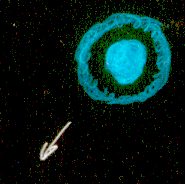
|
Robert Zebahl
Leipzig (Germany) |
152mm (300x) |
23.07.2021: Theta CrB stand nur wenige Grad über dem Hausdach und der Refraktor war unzureichend ausgekühlt. In keinster Weise als Doppelstern erkennbar. Ich habe Vergrößerungen von 200x bis 400x genutzt. |
|
Mark McCarthy
Fremont (California/USA) |
203mm (667x) |
Notched/snowman at best moments. B definitely fainter and almost blue. Very faintly split, looks like a blue appendage. |
|
Frederik Wanink
Itterbeck (Germany) |
254mm (640x) |
nicht als DS gesehen |
|
Mark McCarthy
Fremont (California/USA) |
317mm (738x) |
Tried pretty hard at 553x with apodizing screen, but dances too much. Used 6mm ortho with barlow, 738x, and at best moment it is olive shaped, but marginal. Observation August 2018 |
|
Mark McCarthy
Fremont (California/USA) |
762mm (915x) |
The CrB: Fractured and dancing seeing. 915x, at full aperture and with 8-inch aperture mask, I see a slight out of roundness. |
|
|
|
|
COU798 |
|
|
9m.5 |
9m.8 |
0.2" |
211° |
2014 |
CrB |
15h34m40.64s / +26°54'42.80" |
|
|
Mark McCarthy
Fremont (California/USA) |
508mm (889x) |
Barest of notches, white stars, noticeable magnitude difference. PA to the south. It's in the same low power (205x) field of view with Gemma, alpha CrB, so it looks like a piece of debris from the bright star explosion as seen in the eyepiece. Grade 4 orbit, 0.256" now, will widen only slightly by 2050 apastron. 154.7-year period |
|
|
|
|
STF1954, delta Ser, 13 Ser |
|
AB |
4m.2 |
5m.2 |
4.0" |
171° |
2020 |
Ser |
15h34m48.14s / +10°32'20.00" |
|
|
|
|
AC |
4m.2 |
13m.9 |
66.6" |
18° |
2014 |
|
|
|
|
|
|
CD |
13m.9 |
14m.6 |
4.0" |
341° |
2018 |
|
|
|
|
Robert Zebahl
Leipzig (Germany) |
70mm (57x) |
AB: Einfach zu trennen mit relativ dicht zusammenstehende Komponenten und deutlichem Helligkeitsunterschied. A wirkte eher weiß, B leicht orangefarben. |
|
René Merting
Drachhausen (Germany) |
100mm (107x) |
AB: bei 142x zwei gut getrennte reinweiße Komponenten - B wirkt eine halbe Größenklasse schwächer - zurück auf 107x ist die Trennung ebenfalls einfach - zurück auf 64x ist es eine 8 mit tiefen Einschnürungen, kurz vor der Trennung |
|
Stefan Loibl
Rosenheim (Germany) |
102mm (102x) |
AB: wenige Begleitsterne in unmittelbarer Umgebung |
|
Sarah Gebauer
Germany |
150mm (85x) |
AB: Mit 85x schon schön getrennt, ein leichter Größenunterschied der Sterne zu erkennen, einige schwache Feldsterne im Okular bei 0,95° Gf. |

|
Frederik Wanink
Itterbeck (Germany) |
254mm (640x) |
AB: getrennt, Del Ser |
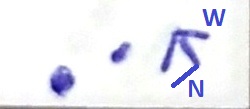
|
|
|
★
|
STT298 |
|
AB |
7m.2 |
8m.4 |
1.2" |
191° |
2021 |
Boo |
15h36m02.22s / +39°48'08.90" |
|
|
|
|
AB-C |
6m.9 |
7m.8 |
120.4" |
328° |
2017 |
|
|
|
|
|
|
AB-D |
6m.9 |
13m.9 |
167.4" |
224° |
2002 |
|
|
|
|
|
|
AB-E |
6m.9 |
12m.1 |
456.0" |
335° |
2002 |
|
|
|
|
Robert Zebahl
Leipzig (Germany) |
102mm (28x) |
AB-C: Weites, mäßig ungleiches Paar. Leichter Farbunterschied: Hauptkomponente erschien etwas mehr orangefarben. |
|
Robert Zebahl
Leipzig (Germany) |
120mm (23x) |
AB-C: Einfach trennbar bei großem Abstand und deutlichem Helligkeitsunterschied. |
|
Mark McCarthy
Fremont (California/USA) |
203mm (205x) |
AB: At zenith, but worth the effort to slew to. Another great 2+1. The tight pair [AB] is near equal and split a little more than a hairline |
|
Mark McCarthy
Fremont (California/USA) |
317mm (553x) |
AB: One component of compicated 6 star system, some of which is split in 80mm finter. This is a close equal pair, ~2". |
|
|
|
★★
|
STF1964 & HU1167 |
HU1167 |
AB |
8m.1 |
9m.9 |
1.4" |
80° |
2016 |
CrB |
15h38m12.91s / +36°14'48.60" |
|
|
|
STF1964 |
AC |
8m.1 |
8m.1 |
14.5" |
90° |
2017 |
|
|
|
|
|
STF1964 |
AD |
8m.1 |
9m.0 |
15.1" |
83° |
2018 |
|
|
|
|
|
STF1964 |
CD |
8m.1 |
9m.0 |
1.5" |
21° |
2019 |
|
|
|
|
Robert Zebahl
Leipzig (Germany) |
16x70 |
STF1964 (AC): 13.06.2021: Schönes Sternpaar mit nahezu gleichhellen Komponenten und dezentem Farbunterschied: weiß-bläulich & leicht orange. |
|
René Merting
Drachhausen (Germany) |
18x70 |
STF1964 (AC): zu erkennen sind zwei gleich helle, sehr dicht stehende Sterne - Trennung ein wenig mehr als knapp |
|
René Merting
Drachhausen (Germany) |
100mm (20x) |
STF1964 (AC): bei 20x ein gut getrenntes Pärchen gleich heller Sterne, auffallend im Sternumfeld |
|
Sarah Gebauer
Germany |
100mm (49x) |
STF1964 (AC): zusammen mit STF 1965 im Gesichtsfeld, zwei recht unterschiedliche Doppelsterne - bei 49-fach getrennt, recht hell und besonders eng - der Farbeindruck ist zunächst strahlend weiß, bei 80-fach zeigt A dann einen Gelbtupfer |
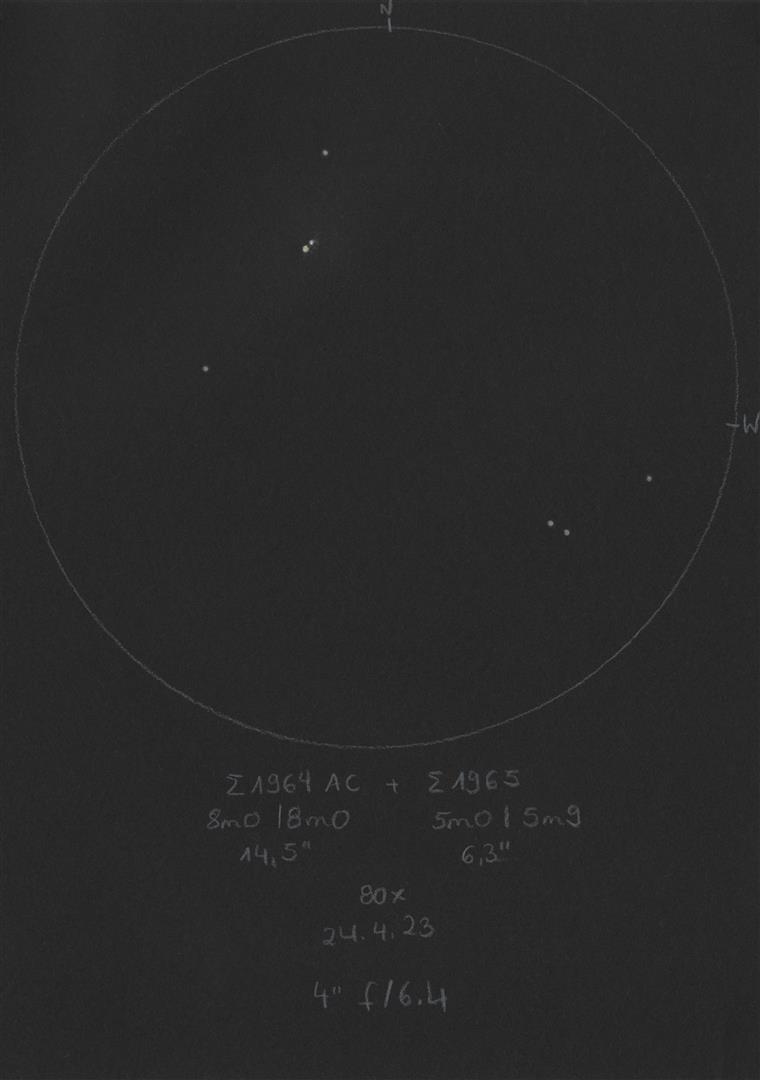
|
Robert Zebahl
Leipzig (Germany) |
102mm (62x) |
STF1964 (AC): Recht weit auseinander, gleich hell ohne erkennbarem Farbunterschied. |
|
Uwe Pilz
Leipzig (Germany) |
105mm (16x) |
Dreifachstern nicht trennbar |
|
René Merting
Drachhausen (Germany) |
107mm (30x) |
STF1964 (AC): bei 30x ein kleines, feines Paar zweier gleich heller Sterne - gleiche Farbe - schöner Anblick zusammen mit STF 1965 |
|
Robert Zebahl
Leipzig (Germany) |
120mm (23x) |
STF1964 (AC): Wunderschöner Doppelstern, gut trennbar bei gleich hellen Komponenten. |
|
Mark McCarthy
Fremont (California/USA) |
317mm (277x) |
STF1964 (AC): Well split equal pair. I suspect B is pair as it is an elongated orange smear at 277x -- it is STF 1964CD. |
|
Mark McCarthy
Fremont (California/USA) |
317mm (553x) |
STF1964 (CD): Faint near equal pair about 3" separation. In the same field with HU 1167. Magnificent |
|
Mark McCarthy
Fremont (California/USA) |
317mm (553x) |
HU1167 (AB): Bright star with much fainter pair, about 1" separation, 3-4 delta mag. In same field with STF 1964. Magnificent |
|
|
|
|
COU612 |
|
|
9m.2 |
9m.0 |
0.3" |
342° |
2016 |
CrB |
15h39m02.60s / +25°44'47.00" |
|
|
Mark McCarthy
Fremont (California/USA) |
508mm (889x) |
Very slight elongation all powers, PA N-S but can't tell A from B. Physical with 63.09-year period, it's coming off apastron and will be difficult to detect visually until the 2060s |
|
|
|
|
STF1989, pi UMi |
|
|
7m.3 |
8m.2 |
0.7" |
23° |
2013 |
UMi |
15h39m38.61s / +79°58'59.60" |
|
|
Frederik Wanink
Itterbeck (Germany) |
254mm (640x) |
blickweise als 8 zu sehen, schwierig |
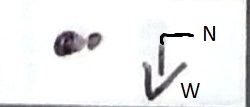
|
|
|
★
|
STF1967, 8 CrB, gamma CrB |
|
|
4m.0 |
5m.6 |
0.5" |
110° |
2015 |
CrB |
15h42m44.57s / +26°17'44.30" |
|
|
Robert Zebahl
Leipzig (Germany) |
152mm (300x) |
23.07.2021: Gamma CrB stand nur wenige Grad über dem Hausdach und der Refraktor war unzureichend ausgekühlt. In keinster Weise als Doppelstern erkennbar. Ich habe Vergrößerungen von 200x bis 400x genutzt. |
|
Mark McCarthy
Fremont (California/USA) |
203mm (667x) |
Definite mis-shape, oval to egg, observation made June 2019 |
|
|
|
|
STF1985 |
|
|
7m.0 |
8m.7 |
6.2" |
354° |
2020 |
Ser |
15h55m54.63s / -02°09'51.30" |
|
|
Mark McCarthy
Fremont (California/USA) |
178mm (205x) |
Ice blue color A and slightly red B, >1 delta mag, pretty wide. 2307.2358-year period, it will slowly widen |
|
|
|
|
STT303 |
|
AB |
7m.7 |
8m.1 |
1.6" |
175° |
2019 |
Ser |
16h00m54.16s / +13°16'18.20" |
|
|
Mark McCarthy
Fremont (California/USA) |
317mm (553x) |
Near equal white, ~1.5". Nice! |
|
|
|
|
S676, rho CrB |
|
|
5m.5 |
10m.5 |
141.4" |
47° |
2020 |
CrB |
16h01m02.65s / +33°18'12.60" |
Mark McCarthy
Fremont (California/USA) |
508mm (667x) |
Rho CrB. bright orange star with very obvious wide B, 3 delta mag |
|
|
|
|
STF2028 |
|
|
9m.9 |
9m.1 |
0.5" |
147° |
2016 |
CrB |
16h12m48.11s / +39°21'35.60" |
|
|
Mark McCarthy
Fremont (California/USA) |
508mm (533x) |
Nice delicate split with 445x, well split clean with 533x, white stars, ~1 delta, PA to SE. Grade 3 orbit, 105.34-year period, 0.519" now it's at apastron now and will sit there until 2050 when it will start close again in its nearly edge-on orbit |
|
|
|
★
|
STF2021, 49 Ser |
|
AB |
7m.4 |
7m.5 |
4.0" |
0° |
2021 |
Her |
16h13m18.45s / +13°31'37.20" |
|
|
Robert Zebahl
Leipzig (Germany) |
70mm (57x) |
Wunderschön getrennt, nahezu gleiche Helligkeit und relativ dicht zusammen. |
|
René Merting
Drachhausen (Germany) |
100mm (64x) |
bei 32x zeigen sich zwei gleich helle weiße Sterne, die sich gerade noch berühren - bei 64x dann knappe Trennung, B ist nur minimal schwächer |
|
Axel Tute
Küssaberg (Germany) |
200mm (77x) |
02.07.2006: Das enge Paar AB konnte mit dem 26mm Plössl (77x) getrennt werden. C kann bei einem geschätzen PA von 120° beobachtet werden. |
|
Mark McCarthy
Fremont (California/USA) |
203mm (205x) |
49 Ser. Light yellow orange, near equal, bright, wide ~4". Physical, 1354 year period |
|
Karsten Kopp
Köln (Germany) |
600mm (180x) |
Doppelstern ist gut zu trennen, bei fast identischer Helligkeit. Ein weißliches Augenpaar schaut mich an. |
|
|
|
|
A1642 |
|
|
8m.9 |
9m.4 |
0.8" |
181° |
2016 |
Her |
16h13m43.62s / +46°38'23.10" |
|
|
Mark McCarthy
Fremont (California/USA) |
508mm (333x) |
Momentarily split with seeing, ~2 delta mag, <1". 188 year period |
|
|
|
|
RST3936 & STF2019 |
RST3936 |
AB |
8m.2 |
8m.4 |
0.3" |
269° |
2018 |
Sco |
16h14m16.53s / -10°24'52.00" |
|
|
|
STF2019 |
AB-C |
7m.4 |
9m.8 |
22.3" |
153° |
2018 |
|
|
|
|
René Merting
Drachhausen (Germany) |
15x56 |
STF2019 (AB-C): es dauert, aber irgendwann ist Komponente B sehr schwach knapp getrennt südöstlich von A erkennbar - mitunter dauert es, bis man B wiederfindet, wenn man neu ansetzt |
|
|
|
★
|
sigma CrB, 17 CrB, STF2032 |
|
AB |
5m.6 |
6m.5 |
7.2" |
240° |
2021 |
CrB |
16h14m40.85s / +33°51'31.00" |
|
|
Robert Zebahl
Leipzig (Germany) |
16x70 |
13.06.2021: Deutlich als Doppelstern mit gut sichtbarem Helligkeitsunterschied erkennbar. Er erscheint klar als '8' und ist gefühlt beinahe trennbar. |
|
Robert Zebahl
Leipzig (Germany) |
70mm (22x) |
Bei 22x klar getrennt, aber dicht zusammen mit deutlichem Helligkeitsunterschied. Bei 57x einfach ohne Auffälligkeit bezüglich der Farbe. |
|
Axel Tute
Küssaberg (Germany) |
70mm (58x) |
30.05.2009: A rötlich, B orange |
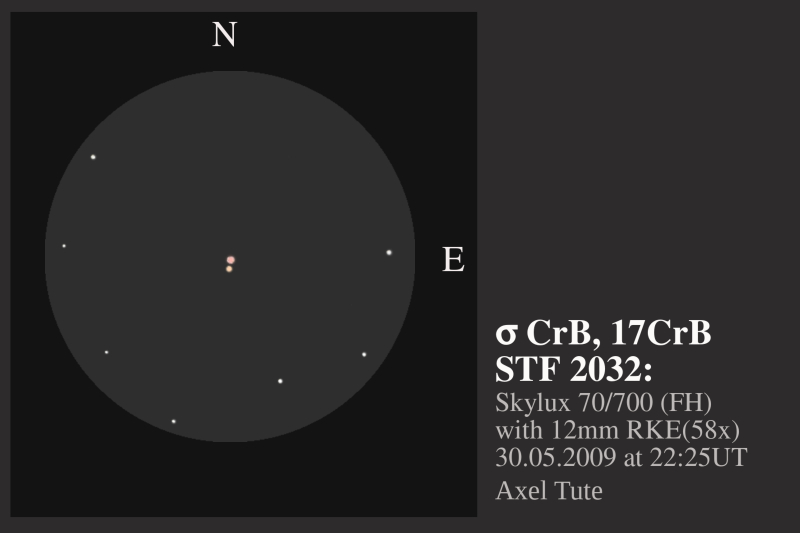
|
René Merting
Drachhausen (Germany) |
100mm (32x) |
bei 20x zwei knapp zusammenstehende Sterne mit tiefer Einschnürung - bei 32x dann ein knapp getrenntes Pärchen - B-Komponente südwestlich gut eine halbe Größenklasse schwächer - beide Sterne mit weißem Brautkleid |
|
Sarah Gebauer
Germany |
100mm (49x) |
bei 49-fach ein ganz entzückendes, feines Murmel-Pärchen mit zwei warmweißen Komponenten mit einem Hauch Gold, A leicht heller und stärker als B |
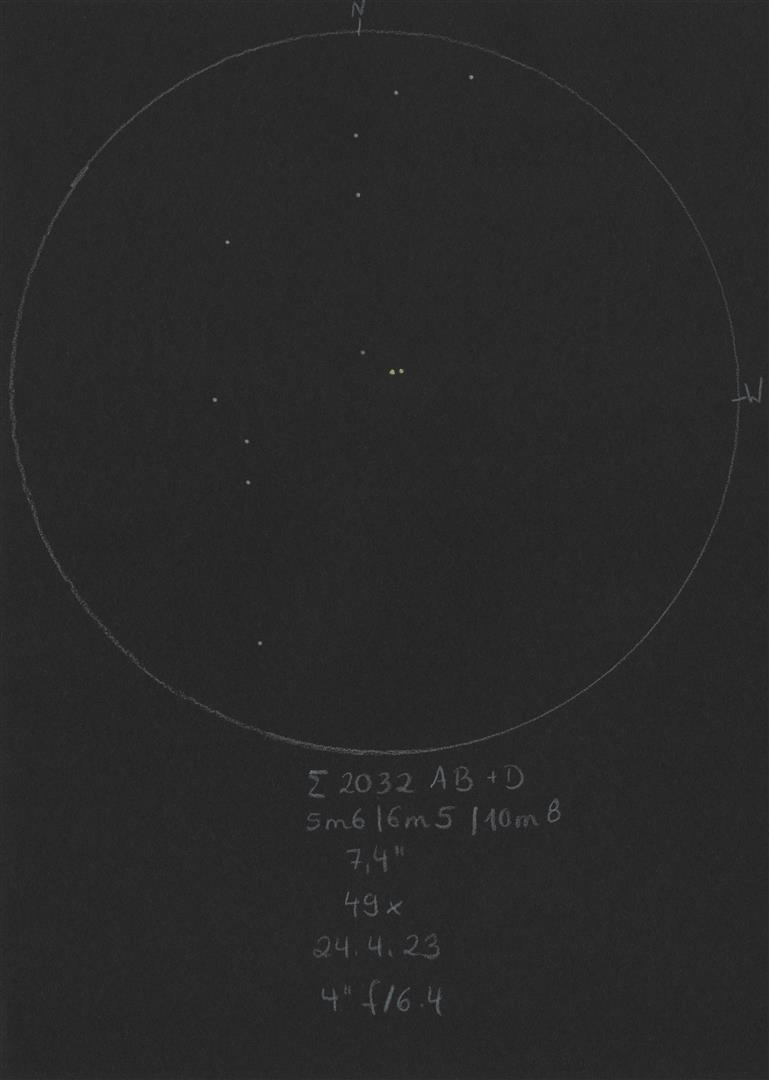
|
Stefan Loibl
Rosenheim (Germany) |
102mm (26x) |
Bereits bei 26x getrennt. Komponente A orange, B gelblich. |
|
René Merting
Drachhausen (Germany) |
107mm (30x) |
bei 30x zeigt sich B im Westen von A, Helligkeitsunterschied eine halbe Größenklasse, farblich unauffällig - bei 60x dann ein schöner Farbkontrast, A strahlt in einem schönen, sanften Gelb, B im Kontrast Roséweiß |
|
René Merting
Drachhausen (Germany) |
320mm (72x) |
bei 72x ein schick anzusehendes, knapp getrenntes Pärchen - A im Osten ist hellgelb - B ist vielleicht eine halbe Größenklasse schwächer und auch gelblich, aber nicht so stark wie A |
|
Mark McCarthy
Fremont (California/USA) |
508mm (667x) |
Sigma CrB. AB nice bright half delta mag wide. two more stars in system, one (AC) closer fainter, other (AD) further away. |
|
Karsten Kopp
Köln (Germany) |
600mm (135x) |
Sehr einfaches, auffälliges Objekt im Okular, ansonsten keine weiteren Auffälligkeiten. |
|
|
|
|
STF2026 |
|
AB |
9m.5 |
9m.9 |
3.5" |
16° |
2019 |
Her |
16h15m57.07s / +07°21'24.80" |
|
|
René Merting
Drachhausen (Germany) |
100mm (107x) |
bei 64x sind die Sterne so schwach, dass ich hellere Sterne im Umfeld zum Fokussieren nutzen muss - beide Komponenten sind als 8 erkennbar, die Einschnürung ist aber nur in guten Momenten da - bei 107x dann gelingt die Trennung, B wirkt deutlich schwächer (in Wirklichkeit ist B nur 0m4 schwächer), aber vielleicht liegt es daran, dass die beiden Sterne ohnehin nur sehr schwach beobachtbar sind - das hat wenig Freude bereitet |
|
Mark McCarthy
Fremont (California/USA) |
178mm (205x) |
Wide, <1 delta mag white stars. 433.7911-year period it is approaching apastron. The AC pair is LEP 78 AC, sep 581.7 mag 9.48,17.49, discovered in 2000, which claims to be physical, however Gaia data shows there is no overlap in the parallax ranges and even the proper motions are divergent |
|
|
|
|
KUI72 |
|
AB |
5m.5 |
10m.0 |
3.2" |
125° |
2016 |
Her |
16h19m55.24s / +39°42'30.90" |
|
|
Mark McCarthy
Fremont (California/USA) |
317mm (553x) |
Distinct faint point appears with perfect seeing ~2-3". Much smaller and fainter than A. |
|
|
|
★★★
|
rho Oph, 5 Oph |
H2 19 |
AB |
5m.1 |
5m.7 |
3.0" |
335° |
2021 |
Oph |
16h25m35.03s / -23°26'47.00" |
|
|
|
H2 19 |
AC |
5m.1 |
7m.3 |
151.1" |
0° |
2021 |
|
|
|
|
|
H2 19 |
AD |
5m.1 |
6m.8 |
156.1" |
253° |
2021 |
|
|
|
|
|
KOU63 |
CF |
5m.8 |
11m.7 |
4.8" |
206° |
2000 |
|
|
|
|
|
BU1115 |
DE |
6m.8 |
8m.4 |
0.3" |
196° |
2018 |
|
|
|
|
Stefan Loibl
Rosenheim (Germany) |
102mm (102x) |
AB: mögliche Komponenten (DE) und (CF) ebenfalls bereits bei 27x Vergrößerung sichtbarmit ca 2' Abstand |
|
|
|
★
|
STF2052 |
|
AB |
7m.7 |
7m.9 |
2.5" |
118° |
2020 |
Her |
16h28m52.67s / +18°24'50.60" |
|
|
|
|
AC |
7m.7 |
11m.8 |
136.4" |
44° |
2016 |
|
|
|
|
Axel Tute
Küssaberg (Germany) |
70mm (117x) |
AB: 30.06.2009: Bei 88x Vergrösserung erkennt man zwei Sterne, die sich berühren. Bei 117x Vergösserung sieht man das deutlicher, aber keinen Zwischenraum. |
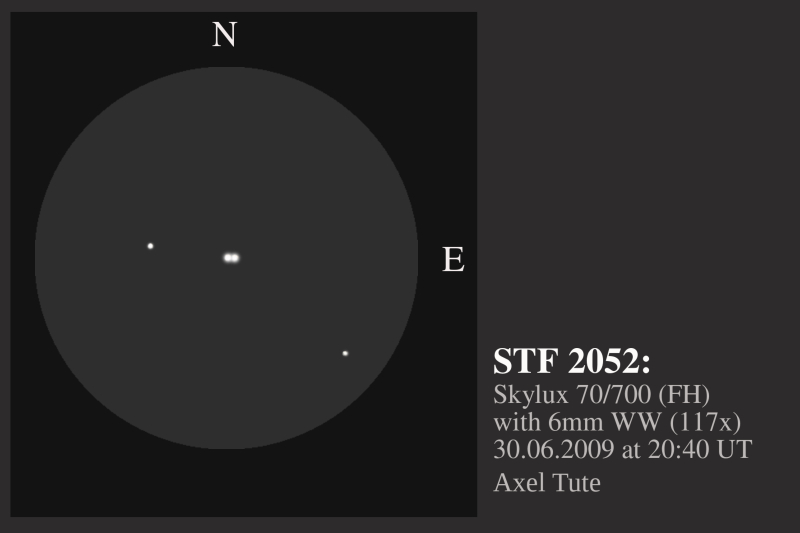
|
René Merting
Drachhausen (Germany) |
76mm (95x) |
AB: bei 57x kann ich eine schwache 8 erkennen, die beiden gleich schwachen Sterne stehen kurz vor der Trennung - bei 95x dann sind beide Komponenten knapp getrennt sichtbar |
|
René Merting
Drachhausen (Germany) |
100mm (107x) |
AB: bei 64x zwei gleichhelle Sterne, die sich gerade so berühren - bei 107x ein knapp getrenntes Pärchen, Komponente B im SO ist nur marginal schwächer |
|
Stefan Loibl
Rosenheim (Germany) |
102mm (102x) |
AB: Bei 26x kein Mehrfachstern-Charakter erkennbar, bei 68x elongiert, bei 102x getrennt. Komponente A bläulich, B rötlich. Sichtung der Komponente C zweifelhaft. An passender Stelle blitzt zeitweise ein Stern auf. |
|
Mark McCarthy
Fremont (California/USA) |
317mm (277x) |
AB: Pretty pale yellow-orange pair of equal magnitude, about 2" separation. |
|
Karsten Kopp
Köln (Germany) |
600mm (180x) |
AB: Doppelstern war noch gut zu trennen, bei fast identischer Helligkeit. Komponente A wirkt weißlich, während die etwas schwächere Komponente B gelblich orange strahlt. |
|
|
|
|
alpha Sco, 21 Sco, Antares, GNT1 |
|
|
1m.0 |
5m.4 |
2.7" |
277° |
2019 |
Sco |
16h29m24.47s / -26°25'55.00" |
|
|
Mark McCarthy
Fremont (California/USA) |
80mm (133x) |
A shows as an airy disk with tremulous diffraction rings, but the very faint B star was steady within the diffraction ring. Current separation is 3.2" and its PA is to the west, which matched what I saw. A star is a bright orange, B is light green but faint |
|
|
|
★
|
lambda Oph, 10 Oph, STF2055, Marfic |
|
AB |
4m.2 |
5m.2 |
1.4" |
44° |
2019 |
Oph |
16h30m54.84s / +01°59'02.80" |
|
|
Stefan Loibl
Rosenheim (Germany) |
102mm (205x) |
Komponenten können bei 205x nicht getrennt werden |
|
Uwe Pilz
Leipzig (Germany) |
105mm (288x) |
schöner Farbkontrast, lohnend. |
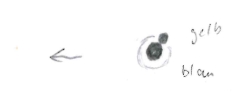
|
Sarah Gebauer
Germany |
150mm (160x) |
habe den Doppelstern zwar gefunden und konnte auch erkennen, dass es zwei Sterne sind, eine Trennung war aber heute Abend nicht möglich |
|
Mark McCarthy
Fremont (California/USA) |
203mm (205x) |
Marfic. Nice blazing white pair, ~1 delta, ~2". 129 year period, but not much change in the next few years |
|
Frederik Wanink
Itterbeck (Germany) |
254mm (640x) |
getrennt |
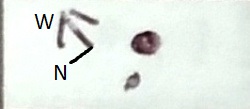
|
|
|
★
|
STF2059 |
|
|
8m.8 |
8m.8 |
0.3" |
179° |
2016 |
Her |
16h30m55.71s / +38°03'52.60" |
|
|
Frederik Wanink
Itterbeck (Germany) |
254mm (640x) |
nicht als DS gesehen |
|
Mark McCarthy
Fremont (California/USA) |
317mm (553x) |
Overlapping disks, notched. Need perfect seeing. This was 1.2" at Struve's discovery, so easier for him to see -- I doubt he would have found it now, near its closest separation. August 2017 |
|
|
|
★
|
STF2084, zeta Her, 40 Her |
|
|
3m.0 |
5m.4 |
1.6" |
110° |
2019 |
Her |
16h41m17.16s / +31°36'09.80" |
|
|
Sarah Gebauer
Germany |
100mm (136x) |
auf Anhieb ganz haarscharf getrennt, aber leider nur wenige Sekunden haltbar; dennoch erfolgreiche Trennung! |
|
Robert Zebahl
Leipzig (Germany) |
102mm (224x) |
Schwacher Begleiter als deutliche Aufhellung auf dem ersten Beugungsring, in ruhigeren Momenten als kleine, rundliche Kondensation zu sehen. |
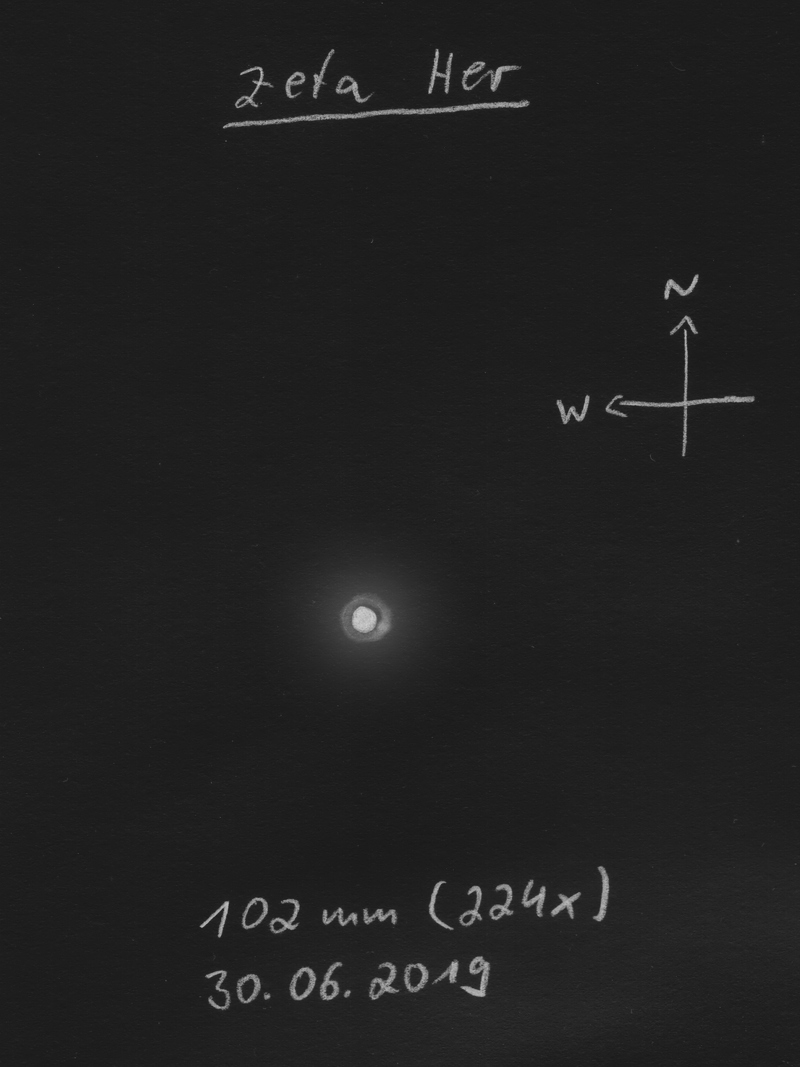
|
Robert Zebahl
Leipzig (Germany) |
102mm (280x) |
Nach längerer, konzentrierter Beobachtung konnte im richtigen Positionswinkel dauerhaft eine Aufhellung des ersten Beugungsrings der Hauptkomponente gesehen werden. Die Aufhellung erschien nur bogenförmig ohne erkennbare Verdichtung. |
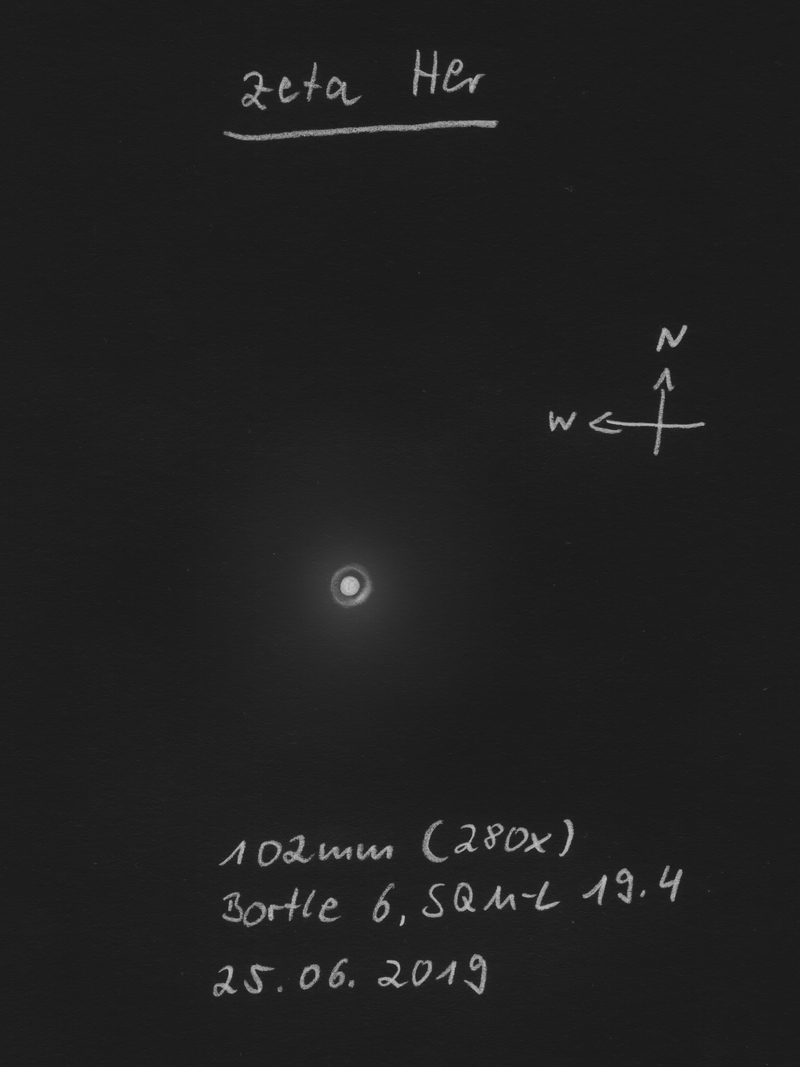
|
Uwe Pilz
Leipzig (Germany) |
105mm (288x) |
äußerst schwierig |
|
Uwe Pilz
Leipzig (Germany) |
105mm (288x) |
Bei sehr ruhiger Luft ohne Probleme sichtbar, trotz der störenden Restkoma meines Refraktors |

|
Mark McCarthy
Fremont (California/USA) |
152mm (285x) |
Zeta Her. A lot of diffraction but there is a persistent bulge, brightening to a split, at the first diffraction ring. Suspected at 175x |
|
Axel Tute
Küssaberg (Germany) |
200mm (300x) |
29.07.2006: Konnte nicht getrennt werden. |
|
Mark McCarthy
Fremont (California/USA) |
203mm (533x) |
Zeta Her. B was seen, not too difficult as a disk within the diffraction of bright A, just outside first ring so ~1.5", like a diamond ring, significant mag difference |
|
Frederik Wanink
Itterbeck (Germany) |
254mm (640x) |
nicht als DS gesehen |
|
Frederik Wanink
Itterbeck (Germany) |
254mm (640x) |
getrennt |

|
René Merting
Drachhausen (Germany) |
320mm (320x) |
in der Nacht konnte ich nur bis 320x gewinnbringend vergrößern - Komponente A zeigt schöne Beugungsscheibchen, B offenbarte sich mir nicht |
|
|
|
|
A349 |
|
|
10m.7 |
10m.9 |
0.7" |
127° |
2018 |
Her |
16h41m17.67s / +30°06'36.20" |
|
|
Mark McCarthy
Fremont (California/USA) |
203mm (333x) |
V908 Her. Elongation with averted vision, can't coax any better view. Light yellow. Physical, 135.69 year period |
|
|
|
|
STF2091 |
|
|
8m.4 |
9m.3 |
0.4" |
328° |
2012 |
Her |
16h42m09.74s / +41°11'42.90" |
|
|
Frederik Wanink
Itterbeck (Germany) |
254mm (640x) |
nicht als DS gesehen |
|
Mark McCarthy
Fremont (California/USA) |
317mm (553x) |
I "see" rod shape once I know it is 0.4" separation. Marginal. (This one 1.3" at Struve's discovery, so easy for him! August 2017) |
|
|
|
|
D15 |
|
|
9m.0 |
9m.3 |
0.6" |
335° |
2016 |
Her |
16h43m56.29s / +43°28'31.20" |
|
|
Mark McCarthy
Fremont (California/USA) |
317mm (553x) |
Light orange elongated, with notch, near equal. (0.9" at discovery). |
|
Mark McCarthy
Fremont (California/USA) |
508mm (333x) |
Close split with seeing, slight mag difference, ivory white stars |
|
|
|
★★
|
52 Her |
BU627 |
A-BC |
4m.8 |
8m.4 |
2.2" |
44° |
2018 |
Her |
16h49m14.21s / +45°58'59.90" |
|
|
|
A1866 |
BC |
9m.5 |
9m.6 |
0.3" |
267° |
2013 |
|
|
|
|
René Merting
Drachhausen (Germany) |
100mm (142x) |
BU627 (A-BC): bis 142x probiert, hat nicht funktioniert - der Helligkeitsunterschied ist vermutlich zu groß und das Beugungsscheibchen von A so hell wie BC selbst |
|
Robert Zebahl
Leipzig (Germany) |
102mm (280x) |
BU627 (A-BC): Bei 160x ist die schwache Komponente bereits ansatzweise als Aufhellung im ersten Beugungsring erkennbar. Bei 280x ist die Aufhellung recht deutlich sichtbar und erscheint teilweise klar als kleiner Knoten im ersten Beugungsring. |
|
Uwe Pilz
Leipzig (Germany) |
105mm (288x) |
BU627 (A-BC) |
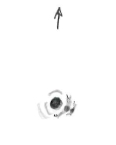
|
Uwe Pilz
Leipzig (Germany) |
120mm (180x) |
BU627 (A-BC) |
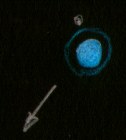
|
Mark McCarthy
Fremont (California/USA) |
317mm (553x) |
BU627 (A-BC): 52 Her. Very bright white star with a companion disk 2", 4-5 delta mag. Wow! B appears as if it is illuminated by A's light. Did not detect BC, 0.3" |
|
|
|
★★
|
STF2107 |
|
AB |
6m.9 |
8m.5 |
1.4" |
112° |
2020 |
Her |
16h51m50.10s / +28°39'58.70" |
|
|
Mark McCarthy
Fremont (California/USA) |
152mm (175x) |
! Extremely fine hairline split with seeing, 1.5 delta mag white stars. Obvious split with 285x. Physical with a 274 year orbit, now at apastron. 1.1" at discovery in 1828 |
|
Mark McCarthy
Fremont (California/USA) |
317mm (553x) |
Yellow and orange pair, very close ~1.5", 1 delta mag. Very pretty. |
|
Mark McCarthy
Fremont (California/USA) |
508mm (667x) |
Nice pair yellow and slightly blue two delta mag, about 1.5" (AC is 11.5 and much further separated) |
|
Karsten Kopp
Köln (Germany) |
600mm (385x) |
Doppelstern ist bei 180-facher Vergrößerung gerade so als 8 zu erkennen. Bei 385-facher Vergrößerung in den seltenen Augenblicken des ruhigen Seeings gerade so eben zu trennen. Sehr schwierig auch wegen des Helligkeitsunterschied von 1,6 mag. |
|
|
|
|
STF2118, 20 Dra |
|
AB |
7m.1 |
7m.3 |
0.9" |
65° |
2018 |
Dra |
16h56m25.32s / +65°02'20.60" |
|
|
Frederik Wanink
Itterbeck (Germany) |
254mm (640x) |
sehr einfach |
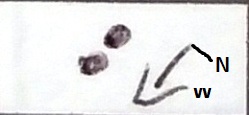
|
|
|
|
STF2128 |
|
|
8m.8 |
10m.3 |
12.2" |
42° |
2019 |
Dra |
17h03m18.66s / +59°35'07.30" |
|
|
René Merting
Drachhausen (Germany) |
320mm (45x) |
bei 45x ordentlich getrennt - B ist 1.5 Magnituden schwächer - A wirkt weiß und B geht etwas die Farbe aus |
|
Mark McCarthy
Fremont (California/USA) |
508mm (205x) |
Wide stars, light orange, ~2 delta mag. 1200 year period |
|
|
|
★★
|
mu Dra, 21 Dra, Alrakis, Arrakis |
STF2130 |
AB |
5m.7 |
5m.7 |
2.5" |
358° |
2020 |
Dra |
17h05m20.20s / +54°28'14.30" |
|
|
|
BU1088 |
AC |
5m.7 |
13m.7 |
12.2" |
174° |
2015 |
|
|
|
|
Christopher Hay
Seeheim (Germany) |
80mm (100x) |
Mai 2019 knapp getrennt ohne Farbeindruck. Ein physikalischer Doppelstern mit einer Umlaufperiode von 812 Jahren. 1946 war Periastron, seitdem läuft das Paar langsam auseinander, 2025 wird ein Winkelabstand von 2,7“ erreicht, 2030 2,8“. |
|
René Merting
Drachhausen (Germany) |
100mm (107x) |
AB: bei 107x zeigen sich zwei knapp getrennte Perlchen, beide gleichhell und weiß schimmernd - ein schickes Paar |
|
Sarah Gebauer
Germany |
100mm (130x) |
AB: bei 130-fach nicht dauerhaft getrennt - gleich helle Sterne mit einem warmweißen, leicht gelben Farbton |
|
Robert Zebahl
Leipzig (Germany) |
102mm (125x) |
AB: Einfach zu trennen. Wunderschöner Anblick. Komponenten gleich hell ohne erkennbaren Farbunterschied. |
|
Uwe Pilz
Leipzig (Germany) |
105mm (144x) |
AB |
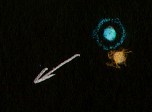
|
Mark McCarthy
Fremont (California/USA) |
203mm (205x) |
AB: Mu Dra. "Arrakis" (which was the name of the planet in the book Dune, but means "Dancer" in Arabic). Light yellow-orange stars, well split, equal. 812 year period |
|
Frederik Wanink
Itterbeck (Germany) |
254mm (460x) |
AB: gleich hell |
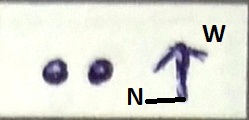
|
René Merting
Drachhausen (Germany) |
320mm (240x) |
AB: bei 240x zeigen sich beide Komponenten wunderschön und etwas mehr als knapp getrennt zu erkennen - Farben Fehlanzeige |
|
|
|
|
A1145 |
|
|
6m.3 |
7m.8 |
0.7" |
340° |
2018 |
Oph |
17h08m13.65s / -01°04'46.10" |
|
|
Mark McCarthy
Fremont (California/USA) |
203mm (667x) |
Marginal observation of a very faint, very close-in star which briefly resolves as a point and not a flare. |
|
|
|
|
eta Oph, 35 Oph |
BU1118 |
AB |
3m.0 |
3m.3 |
0.4" |
225° |
2021 |
Oph |
17h10m22.66s / -15°43'30.50" |
|
|
|
BU1118 |
AB-C |
2m.4 |
12m.3 |
99.8" |
148° |
2012 |
|
|
|
|
|
BU1118 |
AD |
2m.4 |
11m.2 |
101.2" |
281° |
2012 |
|
|
|
|
|
DAL52 |
AE |
2m.4 |
11m.1 |
62.7" |
317° |
2012 |
|
|
|
|
Stefan Loibl
Rosenheim (Germany) |
102mm (205x) |
B-Komponente zeichnet sich als schwache Aufhellung im Beugungsscheibchen ab, E-Komponente nicht sichtbar |
|
|
|
|
HU1178 & STF2136 & WAL78 |
HU1178 |
AB |
9m.2 |
9m.3 |
0.3" |
8° |
2016 |
Her |
17h11m34.85s / +39°15'31.40" |
|
|
|
STF2136 |
AB-C |
8m.5 |
10m.5 |
15.3" |
112° |
2020 |
|
|
|
|
|
WAL78 |
AB-E |
8m.5 |
12m.8 |
57.4" |
311° |
2020 |
|
|
|
|
|
HU1178 |
CD |
10m.5 |
13m.5 |
1.4" |
77° |
2016 |
|
|
|
|
René Merting
Drachhausen (Germany) |
107mm (60x) |
STF2136 (AB-C): bei 60x strahlt AB schon eher schwach, C ist lediglich ein etwas mehr als knapp abgesetzter Schatten von AB |
|
|
|
|
STF2135 |
|
AB |
7m.6 |
8m.9 |
8.7" |
194° |
2018 |
Her |
17h12m06.06s / +21°13'44.40" |
|
|
|
|
AC |
7m.6 |
12m.9 |
162.1" |
208° |
2015 |
|
|
|
|
Axel Tute
Küssaberg (Germany) |
70mm (78x) |
AB: 12.08.2009: A rötlich. |
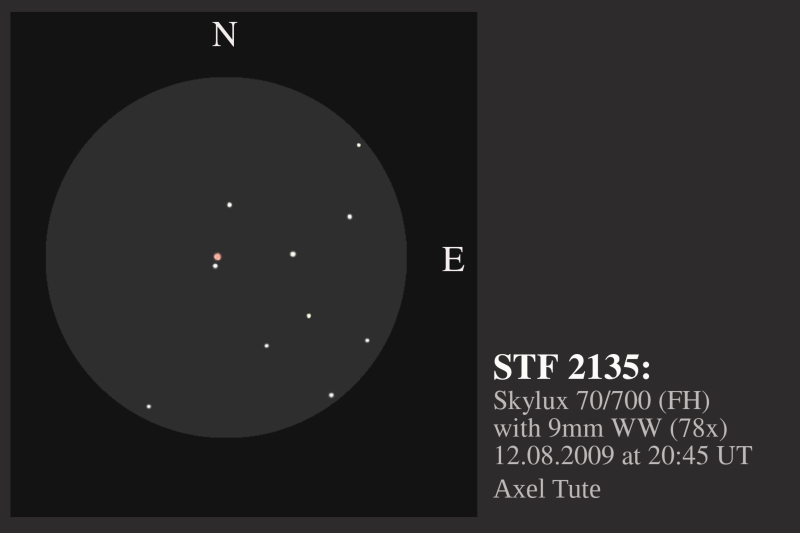
|
René Merting
Drachhausen (Germany) |
100mm (32x) |
AB: bei 64x ein locker getrenntes Pärchen - Komponente B im Süden halb so hell wie A - zurück auf 32x sind beide Sterne als enges Pärchen erkennbar, nicht zu knapp getrennt - noch weiter zurück auf 20x sehe ich ein längliches Sternchen, Trennung bei dieser Vergrößerung noch nicht möglich |
|
Mark McCarthy
Fremont (California/USA) |
203mm (667x) |
AB: Pretty yellow star with widely separated 2 delta mag bluish B. (Not physical) |
|
|
|
|
KUI79 |
|
AB |
10m.0 |
10m.2 |
0.7" |
289° |
2018 |
Her |
17h12m07.78s / +45°39'57.60" |
|
|
Mark McCarthy
Fremont (California/USA) |
508mm (333x) |
Fine split ~1", noticeable mag difference. 12.91 year period! |
|
|
|
★★
|
STF2140, alpha Her, 64 Her, Ras Algethi |
|
AB |
3m.5 |
5m.4 |
4.7" |
103° |
2020 |
Her |
17h14m38.86s / +14°23'24.90" |
|
|
Christopher Hay
Seeheim (Germany) |
36mm (50x) |
Bei 50x löst sich der Begleiter blickweise vom ersten Beugungsring der Hauptkomponente als winziger Lichtpunkt, Delta-Mag wirkt riesig.
Bei 66x wird Trennung viel klarer. Kann Begleiter 80% der Zeit als feinen Punkt am äußeren Rand des ersten Beugungsrings der Hauptkomponente halten. Hauptkomponente orange-gelb, Begleiter viel zu schwach mit dieser Öffnung für einen Farbeindruck. Ein merkwürdig attraktiver Anblick. Siehe zum Vergleich meine gleichzeitige Beobachtung mit 210mm bei 68x. |
|
Robert Zebahl
Leipzig (Germany) |
55mm (41x) |
Gut getrennt mit deutlichem Helligkeitsunterschied. |
|
René Merting
Drachhausen (Germany) |
100mm (64x) |
bei 32x ist noch nichts erkennbar - bei 64x wird östlich von Rasalgethi der schwache Begleiter B knapp getrennt sichtbar - A ist strahlend gelb, B mit einer Tendenz zum gelb, eher ein warmes weiß |
|
Uwe Pilz
Leipzig (Germany) |
105mm (88x) |
himmelblau und hellgelb, getrennt bei 53x |
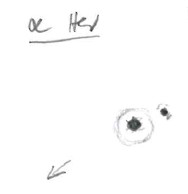
|
Uwe Pilz
Leipzig (Germany) |
105mm (288x) |
gelb-lachsfarben |
|
René Merting
Drachhausen (Germany) |
107mm (86x) |
bei 30x zeigt sich das Paar noch zusammen und zeigt ein auffallendes Gelb - bei 86x präsentiert sich A in Zitronenschalengelb, im Südosten zeigt sich knapp getrennt die B-Komponente, zwar deutlich schwächer, aber immernoch hell und auch farblich ein schwächerer Abklatsch von A in Hellgelb |
|
Robert Zebahl
Leipzig (Germany) |
120mm (100x) |
Einfach zu trennen mit deutlichem Helligkeitsunterschied. A: intensiv orangefarben, B: leicht orange. |
|
Christopher Hay
Seeheim (Germany) |
125mm (133x) |
Bei 133x gut getrennt and mit schönem Farbkontrast, orange zu taubenblau. Jeder Schritt zu 160x, 200x und schliesslich 266x fördert die Ästhetik, zieht das Paar auseinander und macht den Farbkontrast eindeutiger. Bei 266x erscheint die Hauptkomponente gelblich orange und der Begleiter zart graublau. Schönes Beugungsmuster bei 266x mit erstem Ring um Begleiter und einer Andeutung eines zweiten Rings um die Hauptkomponente. |
|
Karsten Kopp
Köln (Germany) |
140mm (94x) |
Konnte erst mit 94-facher Vergrößerung gut getrennt wahrgenommen werden. |
|
Sarah Gebauer
Germany |
150mm (85x) |
bei Halbmond auf der Schwäbischen Alb: sehr eng, aber sauber getrennt, eine Komponente ist viel heller und größer, mein Farbeindruck ist allerdings unerwartet eher gelb |
|
Sarah Gebauer
Germany |
150mm (160x) |
richtig gold, es strahlt mich richtiggehend an, auch sehr schön getrennt, ein toller Doppelstern! |
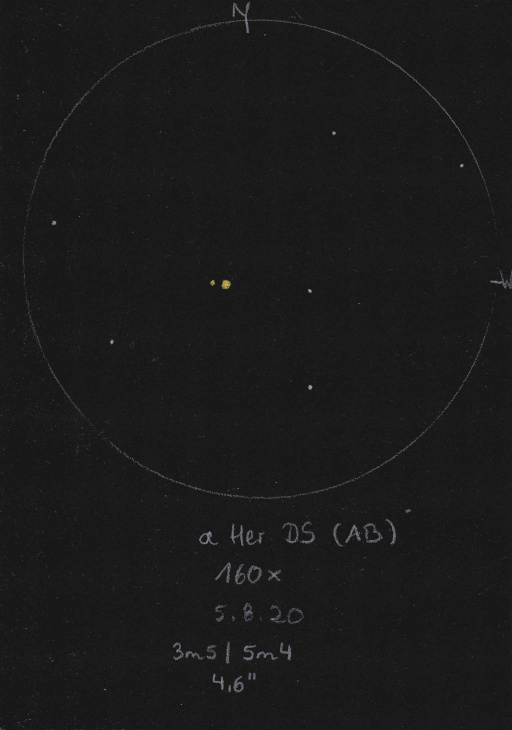
|
Mark McCarthy
Fremont (California/USA) |
152mm (175x) |
Rasalgethi. Wow best ever view, perfect disks with no flaring. Light orange A and 2 delta mag light aqua B. Physical with a 3600-year period |
|
Mark McCarthy
Fremont (California/USA) |
203mm (667x) |
Rasalgethi. 8" inch mask due to seeing. AB orange and blue 4 delta mag. Faint AD seen very wide separation. pretty star. |
|
Christopher Hay
Seeheim (Germany) |
210mm (68x) |
Obwohl die Hauptkomponente im mittelprächtigen Seeing ein wenig aufgebläht ist, ist der Begleiter gut als feiner Lichtpunkt abgesetzt. Beide orange-gelb, sehr hübsch. Siehe zum Vergleich meine gleichzeitige Beobachtung mit 36mm bei 66x. |
|
Sarah Gebauer
Germany |
254mm (96x) |
bei 96-fach ein sehr enges Pärchen mit einem weiten Lichthof, das hübsch umkreist wird von etwa einem halben Dutzend schwacher Sterne – beide Komponenten leuchten in einem warmen Gold, die Hauptkomponente deutlich heller und stärker |
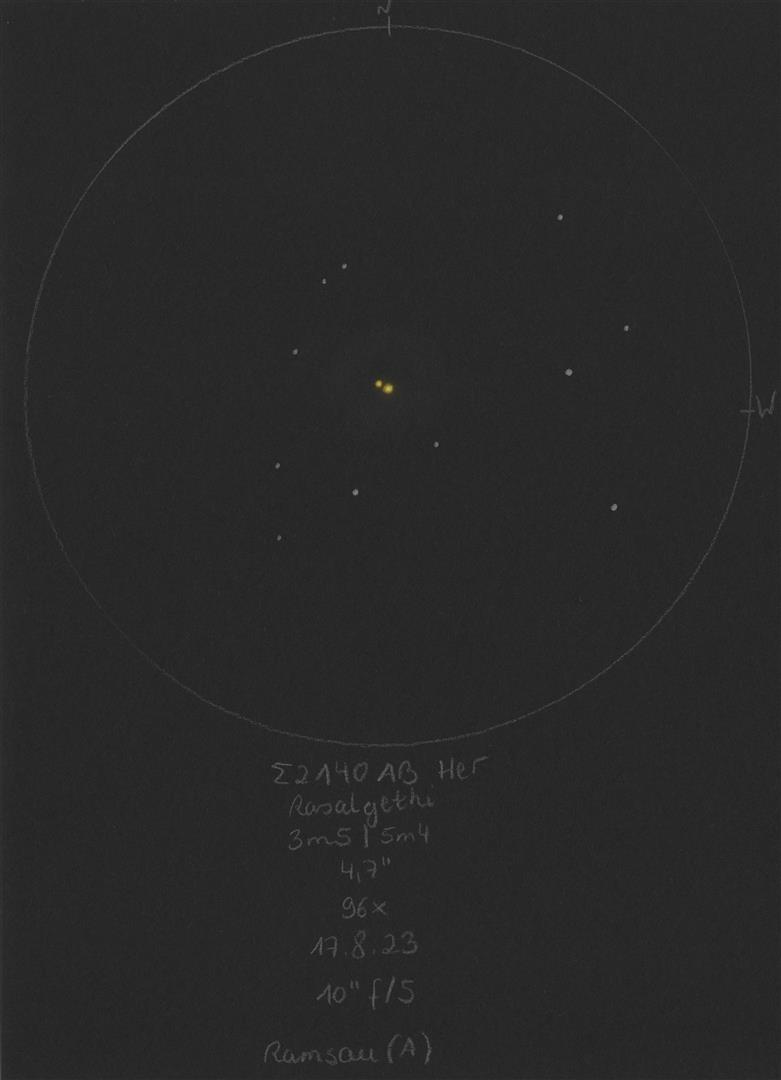
|
Christopher Hay
Seeheim (Germany) |
254mm (170x) |
Bei dieser Vergrößerung sind die Komponenten weit genug auseinander gezogen, und die Austrittspupille ist gross genug mit dieser Teleskopöffnung, um einen entzückenden Kontrast zwischen zwei verschiedenen Sorten gelb zu sehen. Die Hauptkomponente geht deutlich ins Orangene, während der Begleiter zitronengelb strahlt. Das Gesichtsfeld von etwas unter 0.5° rahmt das Paar sehr gut ein. Bei geringeren Vergrößerungen überschwemmt die Haupkomponente den Begleiter, mit dem Ergebnis, dass beide ähnlich orange-gelb erscheinen. |
|
Frederik Wanink
Itterbeck (Germany) |
254mm (640x) |
gelblich und bläulicher Stern |

|
Mark McCarthy
Fremont (California/USA) |
317mm (277x) |
Rasalgethi, Bright orange A & pale green much fainter B. Very nice! |
|
Karsten Kopp
Köln (Germany) |
600mm (135x) |
Leicht zu trennen. Komponente A erscheint orange, Komponente B gelblich. |
|
Karsten Kopp
Köln (Germany) |
600mm (180x) |
Doppelstern ist gut zu trennen. Komponente A erstrahlt orange und Komponente B gelblich. |

|
|
Frederik Wanink
Itterbeck (Germany) |
254mm |
|
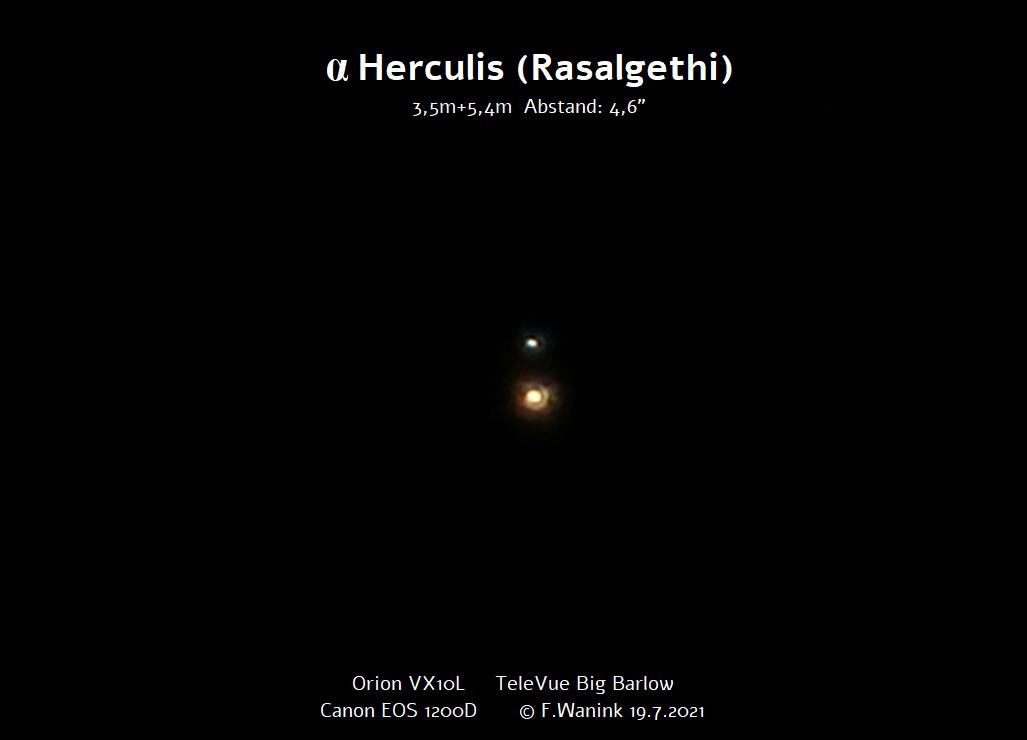
|
Jens Leich
Germany |
130mm |
|

|
|
|
|
SHJ243, 36 Oph |
|
AB |
5m.1 |
5m.1 |
5.1" |
138° |
2021 |
Oph |
17h15m20.78s / -26°36'06.10" |
|
|
|
|
AC |
5m.1 |
6m.5 |
732.5" |
74° |
2021 |
|
|
|
|
|
|
AD |
5m.1 |
7m.8 |
295.5" |
342° |
2021 |
|
|
|
|
|
|
AE |
5m.1 |
12m.3 |
38.2" |
313° |
2000 |
|
|
|
|
Stefan Loibl
Rosenheim (Germany) |
102mm (68x) |
Komponente AB bei 68x getrennt, kein Farbunterschied, Komponente C weit entfernt 12,2' |
|
|
|
|
STF2153 |
|
|
9m.4 |
9m.7 |
1.6" |
244° |
2020 |
Her |
17h17m53.03s / +49°18'18.50" |
|
|
Mark McCarthy
Fremont (California/USA) |
203mm (333x) |
Near equal, ~2", white |
|
|
|
★★★
|
BU628 |
|
|
9m.5 |
9m.6 |
0.6" |
262° |
2016 |
Her |
17h18m22.22s / +32°39'38.50" |
|
|
Mark McCarthy
Fremont (California/USA) |
508mm (1067x) |
Wow split clean, amazing. No resolution at 667x but at 1067x two airy disks, sep by half disk, half delta mag. Remarkable |
|
|
|
|
DON832, xi Oph |
|
AB |
4m.4 |
8m.9 |
4.1" |
26° |
2016 |
Oph |
17h21m00.37s / -21°06'46.50" |
|
|
Stefan Loibl
Rosenheim (Germany) |
102mm (205x) |
schwache 9m-Komponente nicht sichtbar |
|
|
|
★
|
COU415 |
|
|
8m.8 |
9m.8 |
0.2" |
236° |
2013 |
Her |
17h22m04.55s / +23°09'40.40" |
|
|
Mark McCarthy
Fremont (California/USA) |
508mm (1067x) |
Notched elongation at 533x & 667x. I get an instantaneous split with perfect seeing at 1067x, it stays notched. ~1 delta. 90 year period. |
|
|
|
|
BU1250 |
|
|
10m.8 |
11m.1 |
1.9" |
118° |
2015 |
Her |
17h24m49.67s / +30°44'24.00" |
|
|
Mark McCarthy
Fremont (California/USA) |
178mm (205x) |
Can see it steadily split at small scale at 205x, bluish stars at one corner of a triable of near equal magnitude stars. I get a wider split but needing more averted vision at 445x. Discovered with his 6-inch, Burnham notes: "It is the s star of a small equilateral triangle, all in the field." No parallax overlap, not physical |
|
|
|
|
A351 |
|
AB |
9m.7 |
9m.9 |
0.5" |
58° |
2016 |
Her |
17h29m20.05s / +29°23'30.80" |
|
|
Mark McCarthy
Fremont (California/USA) |
508mm (333x) |
Very finely split with just 333x, near equal light orange stars. Busy field, easy to make sketch to capture the orientation for short period project. 59 year period, near apastron, will tighten considerably by 2032. |
|
|
|
|
KUI83 |
|
AB |
9m.8 |
10m.4 |
0.3" |
212° |
2014 |
Her |
17h37m10.76s / +27°53'47.10" |
|
|
Mark McCarthy
Fremont (California/USA) |
508mm (667x) |
AC is an ordinary wide pair 2 delta mag ~10". AB is a hairline split with 533x, and an obvious well split with 667x. Light orange stars, ~1 delta mag. Short period, 24.1 years, nearly circular orbit so it will be fun to follow it around. |
|
|
|
|
STF2199 |
|
|
8m.0 |
8m.6 |
2.0" |
53° |
2020 |
Dra |
17h38m38.32s / +55°45'34.90" |
|
|
Mark McCarthy
Fremont (California/USA) |
203mm (205x) |
Light yellow stars, ~2" and ~1 delta mag. 1298 year period |
|
René Merting
Drachhausen (Germany) |
320mm (144x) |
bei 144x zwei schöne Perlchen knappst getrennt - die östliche Komponente wirkt minimal schwächer - beide Sterne strahlen weiß |
|
|
|
|
STF2218 |
|
|
7m.1 |
8m.4 |
1.5" |
310° |
2016 |
Dra |
17h40m18.07s / +63°40'31.40" |
|
|
Mark McCarthy
Fremont (California/USA) |
203mm (205x) |
~2 delta, split but quite close, with seeing. White A & yellow-white B. 2130 year period |
|
|
|
★★
|
STF2241, psi 1 Dra, 31 Dra |
|
AB |
4m.6 |
5m.6 |
29.6" |
14° |
2019 |
Dra |
17h41m56.36s / +72°08'55.80" |
Sarah Gebauer
Germany |
12x42 |
sehr hell und schon schön getrennt mit warmweißem Farbeindruck |
|
Christopher Hay
Seeheim (Germany) |
15x45 |
Fernglas mit interner Stabilisierung, handgehalten. Angenehm aufgelöst. A scheint perlweiß, B ziegelrot. Ein sehr schönes Paar für 15x. Im stabilisierten 10x42 auch aufgelöst aber etwas mühsam. Psi1 Dra ist ein physikalischer Doppelstern mit einer Umlaufzeit von etwa 10.000 Jahren. |
|
René Merting
Drachhausen (Germany) |
16x70 |
ein auffälliges Pärchen in einem wilden Sterngewimmel vieler heller Sterne, beide Komponenten sind knapp getrennt zu erkennen - Komponente B ist mindestens eine Größenklasse schwächer und strahlt nicht so schön reinweiß wie A |
|
Christopher Hay
Seeheim (Germany) |
80mm (30x) |
Weit getrennt. A zartgelb, B zartblau. |
|
Sarah Gebauer
Germany |
100mm (21x) |
bei 20-fach ein schmales, helles und warmweiß-golden strahlendes Pärchen, sehr dominant und schön |

|
Uwe Pilz
Leipzig (Germany) |
105mm (55x) |
weiß-orange |
|
Sarah Gebauer
Germany |
254mm (49x) |
bei 49-fach ein fast gleich helles Paar mit zwei sehr warmen, hell strohgelben Komponenten – ein sehr durchdringendes Augenpaar – die dritte Komponente, die direkt nach Osten weist, ist auch noch ganz schwach zu sehen |
|
René Merting
Drachhausen (Germany) |
320mm (144x) |
die beiden bei 144x gut getrennten Sterne strahlen blass goldgelb mit relativ großen Halos, die sich überlagern, B im Nordosten ist etwa eine halbe bis dreiviertel Größenklasse schwächer als A |

|
René Merting
Drachhausen (Germany) |
320mm (144x) |
die beiden bei 144x gut getrennten Sterne strahlen blass goldgelb mit relativ großen Halos, die sich überlagern, B im Nordosten ist etwa eine halbe bis dreiviertel Größenklasse schwächer als A |
|
|
|
|
HU1285 |
|
|
8m.9 |
9m.2 |
0.5" |
211° |
2016 |
Her |
17h43m38.76s / +22°36'43.20" |
|
|
Frederik Wanink
Itterbeck (Germany) |
254mm (640x) |
unsicher, sehr schwierig |
|
Mark McCarthy
Fremont (California/USA) |
508mm (533x) |
Hairline split at 445x, better split at 533x and 667x. White, slightly unequal. Physical with an 825-year period, it will make a very rapid periastron pass over the next couple of decades and appear on the opposite side, so it is worth watching |
|
|
|
|
STF2205 |
|
|
9m.4 |
9m.6 |
0.8" |
21° |
2021 |
Her |
17h45m41.03s / +17°43'00.70" |
|
|
Mark McCarthy
Fremont (California/USA) |
508mm (667x) |
Half delta mag light orange star about 1" separated (in this scope it is quite wide) |
|
|
|
★
|
mu Her, 86 Her |
STF2220 |
A-BC |
3m.5 |
9m.8 |
35.4" |
249° |
2016 |
Her |
17h46m27.51s / +27°43'14.30" |
|
|
|
AC7 |
BC |
10m.2 |
10m.7 |
1.0" |
27° |
2021 |
|
|
|
|
Sarah Gebauer
Germany |
100mm (80x) |
STF2220 (A-BC): bei 80-fach recht weit getrennt, ein extrem ungleich helles Pärchen, A strahlt richtig schön goldgelb, BC steht extrem schwach im Schatten davon |

|
Robert Zebahl
Leipzig (Germany) |
120mm (86x) |
STF2220 (A-BC): Einfaches, recht weites Paar mit deutlichem Helligkeitsunterschied. A: gelblich-orange. Die schwache BC-Komponente war direkt gerade noch erkennbar. |
|
Mark McCarthy
Fremont (California/USA) |
203mm (333x) |
STF2220 (A-BC): Pretty, bright canary yellow A and much fainter bluish B. Nice! (Missed AC 7 BC which are near equal 0.6") |
|
Mark McCarthy
Fremont (California/USA) |
317mm (277x) |
STF2220 (A-BC): Bright yellow with diffraction spikes and some haze around it (poor transparency). 4 delta mag small star on the edge of the haze, wide separation. |
|
Mark McCarthy
Fremont (California/USA) |
508mm (533x) |
AC7 (BC): Mu Her. Nice one to star with. STF 2220 A is a very bright light orange, and BC is widely separated blue, much fainter. I suspected B was also a pair at 333x, and could get a nice clean split with seeing at 533x, so I could tell an orientation and make a sketch (43-year period). Indeed it is a short period pair and I should be able to get at least a quarter turn out of it |
|
|
|
★★★
|
HU1288 |
|
|
8m.3 |
9m.4 |
0.4" |
163° |
2016 |
Her |
17h47m09.16s / +15°02'13.80" |
|
|
Mark McCarthy
Fremont (California/USA) |
508mm (1067x) |
Awesome! clean split, very clean star images. Split by half disk, half delta mag. very cool great catch! suspected at 667x, ramped up power to 1067x to split. |
|
|
|
★
|
STT338 |
|
AB |
7m.2 |
7m.4 |
0.9" |
168° |
2018 |
Her |
17h51m58.46s / +15°19'34.90" |
|
|
Uwe Pilz
Leipzig (Germany) |
120mm (250x) |
|

|
Frederik Wanink
Itterbeck (Germany) |
254mm (640x) |
getrennt |
|
Mark McCarthy
Fremont (California/USA) |
317mm (553x) |
Just split, a pair of bright near equal orange stars. |
|
Mark McCarthy
Fremont (California/USA) |
508mm (667x) |
Yellow-white very clean split stars seem more equal than what the data says |
|
|
|
|
A235 |
|
|
8m.4 |
9m.3 |
0.4" |
76° |
2021 |
Her |
17h53m18.60s / +24°59'29.00" |
|
|
Mark McCarthy
Fremont (California/USA) |
508mm (533x) |
Nice clean split, more than hairline, white stars, significant mag difference. With apodising mask. Currently at apastron, will make nearly half turn by 2040. |
|
|
|
★★
|
STF2308 |
40/41 Dra |
AB |
5m.7 |
6m.0 |
18.9" |
232° |
2022 |
Dra |
18h00m09.07s / +80°00'13.70" |
|
|
|
|
AC |
5m.7 |
8m.3 |
225.3" |
129° |
2017 |
|
|
|
|
Robert Zebahl
Leipzig (Germany) |
8x44 |
27.06.2020: Das enge Paar AB getrennt, aber sehr dicht bei gleich hellen Komponenten. Im spitzen Winkel weit abstehend war noch die Komponente C sichtbar. |
|
Christopher Hay
Seeheim (Germany) |
15x45 |
AB: Fernglas mit interner Stabilisierung, handgehalten. Sauber getrennt, hellere Komponente erscheint bläulich. Eins der schönsten Doppelsterne für diese Vergrößerung. Im stabilisierten 10x42 dagegen nur gerade so zu trennen. |
|
René Merting
Drachhausen (Germany) |
16x70 |
ein schön eng stehendes Pärchen, die Himmelsrichtungen erschließen sich mir hier leider nicht, aber die Komponenten sind beide ähnlich hell und weiß - schöner Anblick im Fernglas |
|
Christopher Hay
Seeheim (Germany) |
50mm (8x) |
AB: Eine 8 ganz kurz vor der Auflösung. |
|
Christopher Hay
Seeheim (Germany) |
80mm (30x) |
AB: Sehr deutlich getrennt, das gesamte Feld dominierend mit interessantem Sterngesprenkel über die 2,5° Gesichtsfeld. |
|
Sarah Gebauer
Germany |
100mm (49x) |
AB: bei 50-fach sehr eindeutig getrennt - zwei helle Augenpunkte, die beide warmweiß und leicht gelb strahlen |

|
Robert Zebahl
Leipzig (Germany) |
102mm (28x) |
Sehr schönes Paar mit geringem Helligkeitsunterschied. Komponenten wirkten gelblich-weiß. Schönes Umfeld. Auf der Zeichnung sind die Komponenten A,B und C zu sehen. |
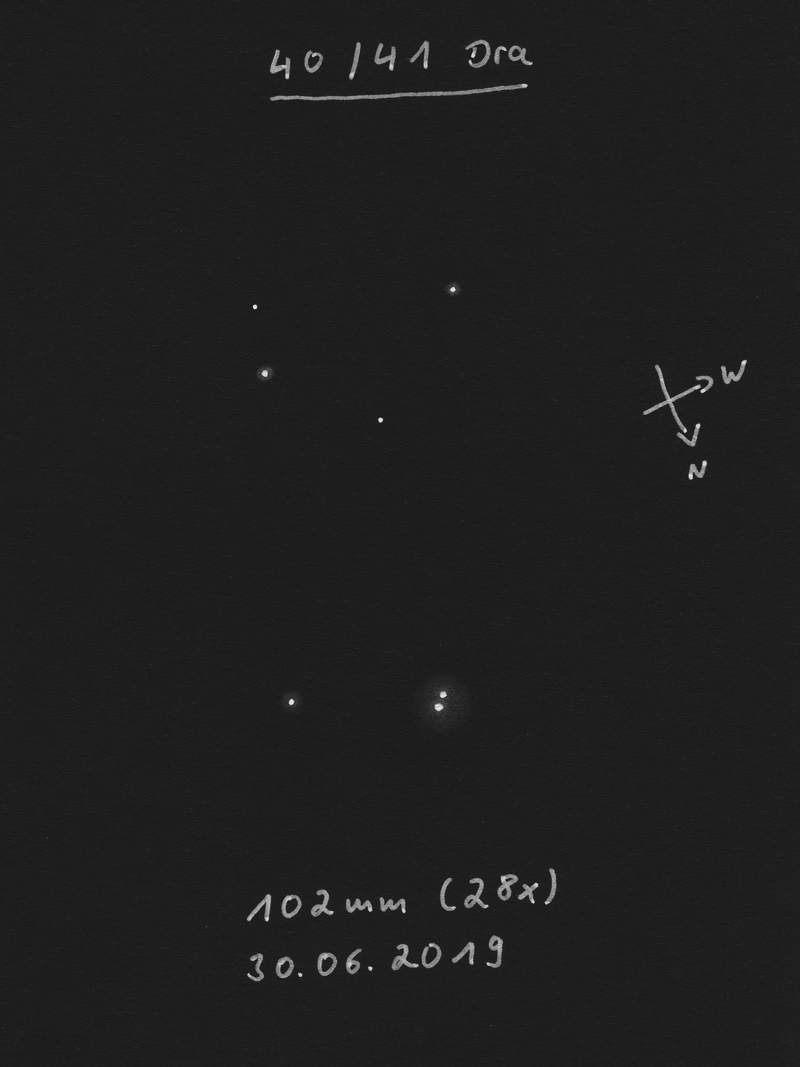
|
Uwe Pilz
Leipzig (Germany) |
105mm (100x) |
AB: =40/41 Dra. Auffallend |
|
Christopher Hay
Seeheim (Germany) |
140mm (75x) |
AB: Weit getrennt, das Feld absolut dominierend, mit hübschem Sterngesprenkel nach Westen. Ganz zarter Farbkontrast, der mit 3 Zoll nicht recht zu fassen war, wird mit dieser Öffnung stabil, Komponente B (40 Dra) eher bläulich, Komponente A (41 Dra) eher gelblich. |
|
|
|
|
A1374 |
|
AB |
8m.9 |
10m.9 |
0.5" |
210° |
2021 |
Her |
18h00m17.93s / +21°53'47.50" |
|
|
Mark McCarthy
Fremont (California/USA) |
508mm (205x) |
Very tough, the extraordinarily fine point of the B star appears with seeing. around 3 delta mag from light yellow A. Spectral class G0, yellow. Worth waiting for the seeing on this one. Physical with a 139.53-year period, it is slowly widening and will take another 30 years to reach apastron |
|
|
|
|
STF2267 |
|
|
8m.4 |
8m.8 |
0.4" |
280° |
2018 |
Her |
18h01m41.17s / +40°10'41.90" |
|
|
Frederik Wanink
Itterbeck (Germany) |
254mm (640x) |
nicht als DS gesehen |
|
|
|
|
STF2262, tau Oph |
|
AB |
5m.3 |
5m.9 |
1.4" |
291° |
2021 |
Oph |
18h03m04.91s / -08°10'48.90" |
|
|
Frederik Wanink
Itterbeck (Germany) |
254mm (240x) |
getrennt |
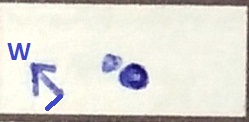
|
|
|
|
70 Oph, P Oph, STF2272 |
|
AB |
4m.2 |
6m.2 |
6.9" |
121° |
2021 |
Oph |
18h05m27.37s / +02°29'59.30" |
|
|
Uwe Pilz
Leipzig (Germany) |
16x70 |
nicht einfach; der helle ist gelb |

|
Christopher Hay
Seeheim (Germany) |
25x80 |
Sauber getrennt, Komponente A erscheint gelblich.
70 Oph ist der linke Nasenflügel des Stieres im alten Sternbild Taurus Poniatowski (Poniatowskis Stier). Zu den Zusammenhängen mit 67, 68 und 73 Oph siehe Eintrag zu 67 Oph. |
|
René Merting
Drachhausen (Germany) |
100mm (64x) |
bei 32x wirkt der Stern nicht rund, sondern ein wenig nach SO verschmiert - bei 64x dann eindeutig ein knapp getrenntes schön anzusehendes Pärchen - Komponente A hell-gelb, B orange-gelb |
|
Jörg S. Schlimmer
Germany |
127mm (136x) |
einfach zu trennen |

|
Sarah Gebauer
Germany |
150mm (85x) |
ein ganz leicht goldener Farbeindruck des Sternpaares, die Sterne stehen recht dicht beisammen und sind dennoch schön getrennt |

|
Robert Zebahl
Leipzig (Germany) |
200mm (80x) |
Bedingungen in der Zielregion: SQM-L 20.1
Bei 80x schön getrennt. Hellere Komponente eher weiß, schwächere leicht orangefarben. |
|
|
Berthold Fuchs
Wiesbaden (Germany) |
130mm |
schwieriger DS |

|
|
|
|
STT341 |
|
AB |
7m.4 |
8m.8 |
0.3" |
89° |
2021 |
Her |
18h05m49.72s / +21°26'45.60" |
|
|
|
|
AB-C |
7m.2 |
10m.6 |
28.2" |
171° |
2015 |
|
|
|
|
|
|
AB-D |
7m.2 |
10m.5 |
39.5" |
99° |
2009 |
|
|
|
|
|
|
AB-E |
7m.2 |
10m.2 |
66.5" |
38° |
2018 |
|
|
|
|
|
|
AB-F |
7m.2 |
11m.5 |
111.6" |
357° |
2009 |
|
|
|
|
|
|
AB-G |
7m.2 |
7m.6 |
132.5" |
239° |
2018 |
|
|
|
|
René Merting
Drachhausen (Germany) |
100mm (32x) |
AB-C: bei 32x ist Komponente C weit getrennt südlich von AB als Hauch von einem Stern erkennbar
AB-D: bei 32x ist Komponente D im Osten von AB ist ähnlich schwach erkennbar wie C im Süden - D ist etwas weiter weg als C
AB-E: bei 32x ist Komponente E im NO von AB ähnlich schwach erkennbar wie C im Süden und D im Osten - Entfernung zu A doppelt so weit wie AB-C
AB-F: bei 64x ist F im Norden von AB in vierfacher Entfernung AB-C erkennbar - im Grunde spiralen die vier schwachen Komponenten von Süden kommend von Osten nach Norden aus |
|
|
|
★
|
AC15, 99 Her |
|
AB |
5m.1 |
9m.0 |
1.4" |
331° |
2018 |
Her |
18h07m01.61s / +30°33'42.70" |
|
|
Mark McCarthy
Fremont (California/USA) |
203mm (667x) |
99 Her.Very nice. B star resolves just outside first diffraction ring when that ring has faded with good seeing, a very fine faint point. large delta mag. There are many other pairings in this system, including 0.2" for the A star] |
|
|
|
|
STT524 |
|
|
7m.9 |
8m.9 |
0.5" |
206° |
2018 |
Her |
18h07m29.52s / +19°39'59.10" |
|
|
Mark McCarthy
Fremont (California/USA) |
508mm (533x) |
Suspected hairline with 333x, nice clean split at 533x, white stars, significant magnitude difference, ~0.5". 686 year period |
|
|
|
|
COU812 |
|
|
10m.8 |
10m.8 |
0.7" |
265° |
2016 |
Her |
18h09m09.93s / +31°29'10.50" |
|
|
Mark McCarthy
Fremont (California/USA) |
203mm (667x) |
Elongation, marginal notch, but a bit too hazy to make a good observation |
|
|
|
|
STF2281, 73 Oph |
|
AB |
6m.0 |
7m.5 |
0.8" |
282° |
2021 |
Oph |
18h09m33.86s / +03°59'35.80" |
|
|
Frederik Wanink
Itterbeck (Germany) |
254mm (640x) |
als 8 zu sehen, schwierig |
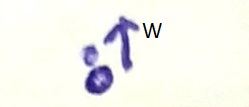
|
|
|
★★
|
HU674 |
|
|
7m.7 |
8m.6 |
0.7" |
213° |
2018 |
Her |
18h09m40.64s / +50°24'07.40" |
|
|
Frederik Wanink
Itterbeck (Germany) |
254mm (640x) |
getrennt, ähnlich hell |
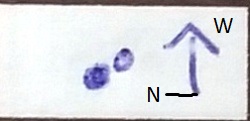
|
Mark McCarthy
Fremont (California/USA) |
508mm (333x) |
Split with seeing at 333x, near equal white. |
|
|
|
|
STF2289 |
|
|
6m.7 |
7m.2 |
1.2" |
217° |
2019 |
Her |
18h10m08.69s / +16°28'35.00" |
|
|
Mark McCarthy
Fremont (California/USA) |
203mm (333x) |
Just split in 20" at 205x, but flaring. 333x had messy diffraction. 8" mask at 333x gave clean disks, split, ~0.7". Dull yellow and yellow-red colors. |
|
Frederik Wanink
Itterbeck (Germany) |
254mm (640x) |
Hauptstern gelb, Begleiter scheint bläulich |
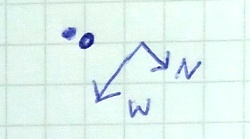
|
|
|
|
COU1006 |
|
|
9m.2 |
11m.3 |
0.5" |
337° |
2016 |
Her |
18h12m58.00s / +33°17'53.90" |
|
|
Mark McCarthy
Fremont (California/USA) |
508mm (667x) |
B is very much fainter and can only be seen when A is perfectly still and round, with seeing. Fairly well separated about 0.5", can tell PA with drift. Physical with 119.2-year period, it is coming off periastron and slowly widening |
|
|
|
|
STT353, phi Dra |
|
AB |
4m.5 |
5m.9 |
0.5" |
262° |
2021 |
Dra |
18h20m45.44s / +71°20'15.80" |
|
|
Frederik Wanink
Itterbeck (Germany) |
254mm (640x) |
nicht als DS gesehen |
|
|
Frederik Wanink
Itterbeck (Germany) |
254mm |
|
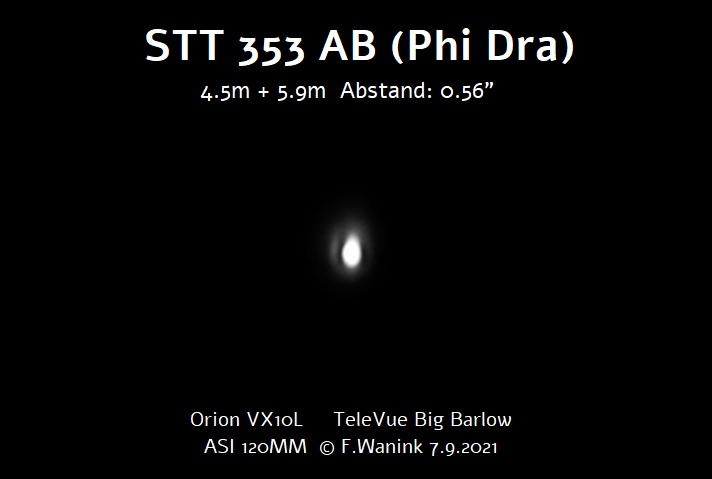
|
|
|
|
BU640 |
|
|
7m.0 |
12m.0 |
0.7" |
322° |
2008 |
Her |
18h20m49.23s / +27°31'48.30" |
|
|
Mark McCarthy
Fremont (California/USA) |
178mm (533x) |
Very much fainter B seen with averted vision and foveal coaxing only, can only hold it briefly. Physical with a 951.7127-year period (to be exact), it is now making a very fast turn around apastron -- though I think the orbital solution is predicting an incorrect position (too close to apastron at this moment) -- unfortunately I did not record the PA so I can't tell if it's on the west or east side of apastron. Will need to re-observe this, since I don't think I'd see 0.2" at 533x (likely around >0.5" given the delta mag) |
|
|
|
★
|
HU581 |
|
|
8m.8 |
9m.4 |
0.4" |
122° |
2016 |
Her |
18h22m54.84s / +14°58'11.00" |
|
|
Mark McCarthy
Fremont (California/USA) |
508mm (1067x) |
Snowman at 533x & 667x, clean split at 1067x & apodising mask, one delta mag. Amazing. Coalesces into two points, can easily tell orientation & magnitude difference for sketch. At apastron, it is on a nearly edge on orientation, will close rapidly within the next ten years to be too close for me to detect. |
|
|
|
|
HO83 |
|
|
10m.1 |
10m.4 |
0.8" |
115° |
2016 |
Her |
18h23m20.34s / +27°31'24.10" |
|
|
Mark McCarthy
Fremont (California/USA) |
178mm (445x) |
Pretty difficult, B appears with averted vision only and fades with direct. Much fainter, about 1". Physical with a 1699.9512-year period, it will soon make a turn toward periastron and tighten over the next few decades. Discovered in 1883 at 0.3" |
|
|
|
★
|
STF2323, 39 Dra |
|
AB |
5m.1 |
8m.1 |
3.6" |
348° |
2020 |
Dra |
18h23m54.65s / +58°48'02.10" |
|
|
|
|
AC |
5m.1 |
8m.0 |
88.9" |
20° |
2020 |
|
|
|
|
Robert Zebahl
Leipzig (Germany) |
55mm (27x) |
AC: Recht weites Paar mit deutlichem Helligkeitsunterschied. Die helle A-Komponente wirkte weiß. |
|
Robert Zebahl
Leipzig (Germany) |
55mm (71x) |
AB: Sehr schön. Die B-Komponente erschien ähnlich schwach wie die C-Komponente. |
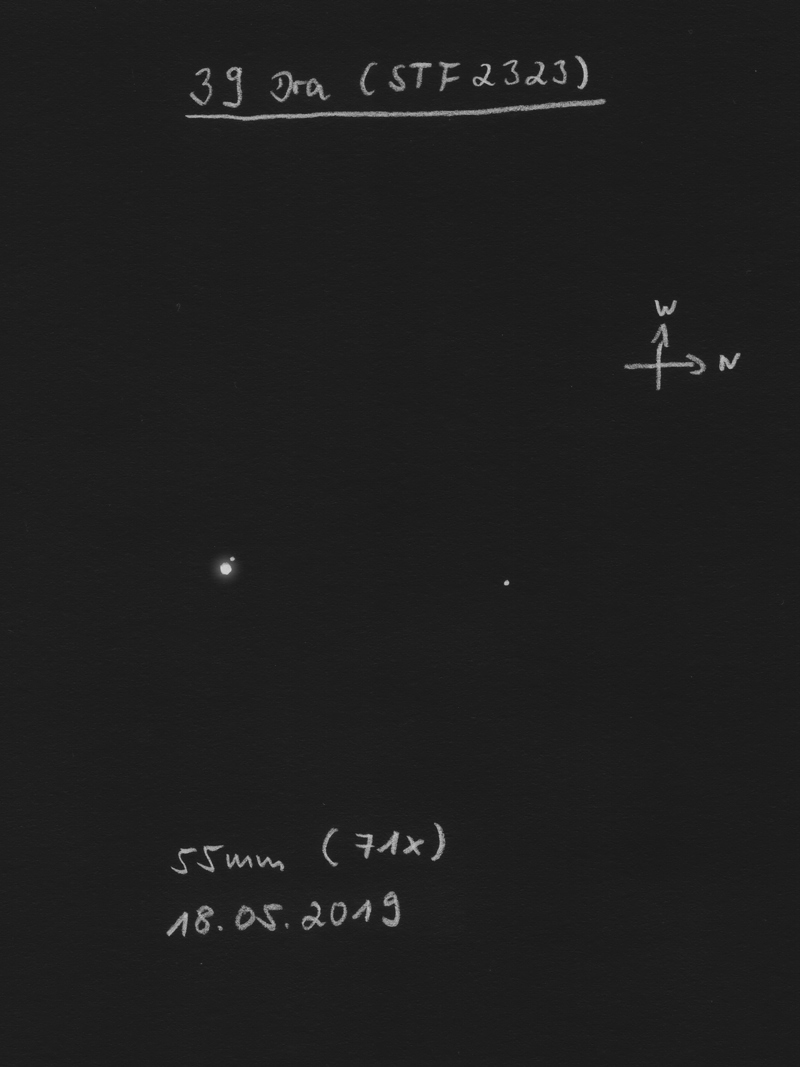
|
Mark McCarthy
Fremont (California/USA) |
203mm (205x) |
AB: 39 Dra. Brilliant white A and slightly ruddy B, ~3 delta mag, ~4" sep. 3962.5 year period. |
|
René Merting
Drachhausen (Germany) |
320mm (144x) |
bei 144x ein richtig schöner Mehrfachstern - an der strahlend weißen A-Komponente klebt eine kleine Murmel (B), die ab und an auch schon getrennt zu erkennen ist - B ist auch noch relativ hell und weiß strahlend - Komponente C steht nördlich von den beiden in weitem Abstand - Helligkeit zwischen A und B |
|
|
|
★
|
STF2315 |
|
AB |
6m.6 |
7m.8 |
0.6" |
117° |
2018 |
Her |
18h24m58.46s / +27°23'41.30" |
|
|
Frederik Wanink
Itterbeck (Germany) |
254mm (640x) |
als 8 zu sehen |

|
Mark McCarthy
Fremont (California/USA) |
317mm (277x) |
! Hairline split @ 553x near equal mag. Suspected elongation at 277x.: |
|
Mark McCarthy
Fremont (California/USA) |
508mm (533x) |
Barely split with seeing, resolves to two disks, more than hairline but almost 2 delta mag, very tough, need perfect seeing. 2094 year period |
|
|
|
|
STT351 & HU66 |
HU66 |
AB |
7m.9 |
8m.4 |
0.2" |
197° |
2016 |
Dra |
18h25m18.20s / +48°45'42.50" |
|
|
|
STT351 |
AC |
7m.9 |
8m.2 |
1.0" |
26° |
2021 |
|
|
|
|
|
HU66 |
BC |
8m.4 |
8m.2 |
0.8" |
26° |
2019 |
|
|
|
|
Mark McCarthy
Fremont (California/USA) |
203mm (305x) |
STT351 (AC): Split, better with seeing, light orange stars, significant mag difference. Did not notice HU 66 AB, 7.9/8.4 0.1" or HU 66 BC, 8.40/8.25 0.9 -- need to go back to this one! |
|
Frederik Wanink
Itterbeck (Germany) |
254mm (640x) |
HU66 (BC): getrennt |
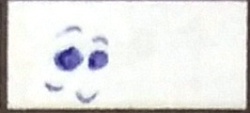
|
Mark McCarthy
Fremont (California/USA) |
317mm (553x) |
HU66 (BC): Very fine near equal pair, yellowish A and blue-white B. ~1" or less. |
|
René Merting
Drachhausen (Germany) |
320mm (288x) |
STT351 (AC): bei 288x kann ich zwei gleich helle Sternperlen erkennen, knappe Trennung - die nordöstliche Komponente wirkt minimal schwächer |
|
Mark McCarthy
Fremont (California/USA) |
508mm (333x) |
STT351 (AC): Orange stars, noticeable magnitude difference ~0.5, separated just less than ~1". What's curious is the AB pair is HU 66 AB listed as 7.90/8.40 0.1" currently, with HU 66 BC as 8.40/8.25 0.9". So my question is, if AC is physical, and if BC are physical too, why is AC uncertain? It would seem they should all be sharing orbits? Perhaps it just cries out for additional measures -- AB is grade 4 and BC is grade 5, so they are confident of physicality but there's not enough data to nail it down. |
|
|
|
|
HU322 |
|
AB |
7m.7 |
8m.9 |
0.2" |
92° |
2019 |
Her |
18h33m45.62s / +17°43'55.90" |
|
|
Mark McCarthy
Fremont (California/USA) |
508mm (889x) |
Very subtle notched elongation, PA on an E-W line but a little cocked from WAK 21. Component of STF 2339 AB-CD |
|
|
|
★★
|
STT359 |
|
|
6m.3 |
6m.6 |
0.8" |
5° |
2021 |
Her |
18h35m30.40s / +23°36'19.90" |
|
|
Robert Zebahl
Leipzig (Germany) |
102mm (160x) |
11.10.2020: Deutlich länglich mit leichter Einkerbung und geringem Helligkeitsunterschied. Den Positionswinkel schätzte ich auf 0°. |
|
Uwe Pilz
Leipzig (Germany) |
105mm (198x) |
leicht eingekerbt, Abstand 0“75 |
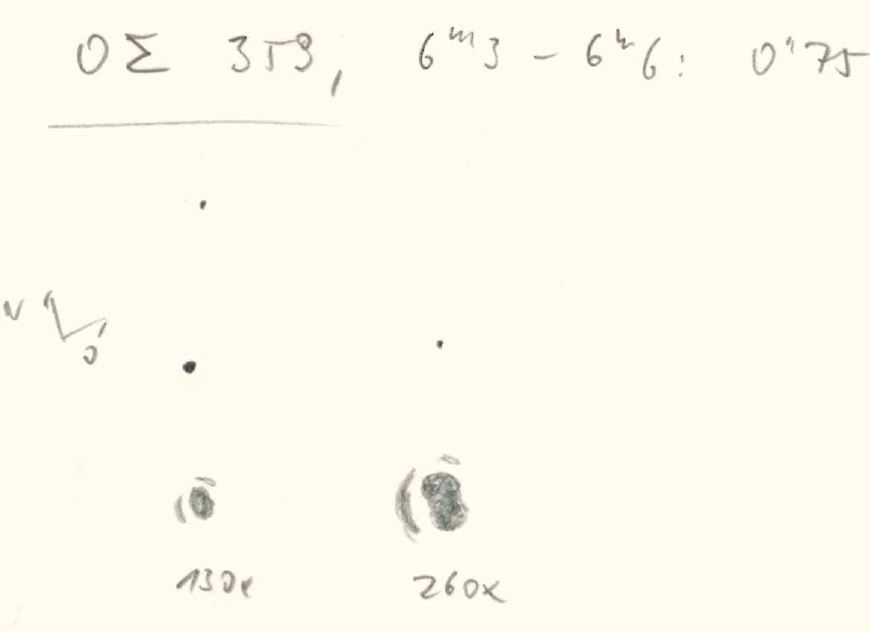
|
Uwe Pilz
Leipzig (Germany) |
120mm (250x) |
|
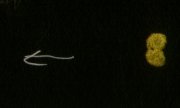
|
Mark McCarthy
Fremont (California/USA) |
152mm (175x) |
Light orange near equal stars, notched elongation, overlapping disks. Physical with a 219-year period, at apastron now |
|
Mark McCarthy
Fremont (California/USA) |
203mm (667x) |
Kissing 8" 333x, hairline split 667x. Near equal white A and bluish white B. |
|
Frederik Wanink
Itterbeck (Germany) |
254mm (640x) |
getrennt |

|
Mark McCarthy
Fremont (California/USA) |
317mm (553x) |
Nice! ~0.8" equal yellow-orange stars. |
|
Uwe Pilz
Leipzig (Germany) |
320mm (388x) |
ein sehr ruhiger Abend gestattete die Nutzung von 12 Zoll |
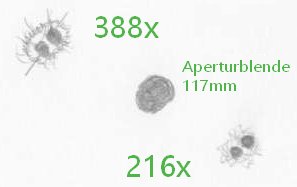
|
Mark McCarthy
Fremont (California/USA) |
508mm (333x) |
Light yellow near equal split, very close. 219 year period |
|
|
|
★★
|
STT358 |
|
AB |
6m.9 |
7m.1 |
1.7" |
146° |
2019 |
Her |
18h35m53.22s / +16°58'32.50" |
|
|
Uwe Pilz
Leipzig (Germany) |
105mm (110x) |
fast gleich hell, deutlich trennbar |
|
Mark McCarthy
Fremont (California/USA) |
203mm (333x) |
Pretty, near equal white, perfect disks. |
|
Mark McCarthy
Fremont (California/USA) |
508mm (205x) |
Yellow-white stars, half delta mag, well split. 380 year period |
|
|
|
|
STT363 |
|
|
7m.5 |
8m.1 |
0.6" |
335° |
2018 |
Dra |
18h37m23.92s / +77°41'12.40" |
|
|
Frederik Wanink
Itterbeck (Germany) |
254mm (640x) |
als 8 zu sehen |
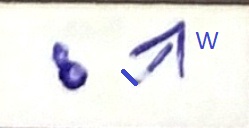
|
|
Frederik Wanink
Itterbeck (Germany) |
254mm |
|

|
|
|
|
STF2367 |
|
AB |
7m.7 |
8m.0 |
0.4" |
73° |
2019 |
Lyr |
18h41m16.36s / +30°17'40.90" |
|
|
|
|
AB-C |
7m.0 |
8m.8 |
14.1" |
192° |
2019 |
|
|
|
|
|
|
AB-D |
7m.0 |
12m.0 |
21.9" |
84° |
2007 |
|
|
|
|
|
|
AB-E |
7m.0 |
11m.0 |
151.7" |
341° |
2002 |
|
|
|
|
René Merting
Drachhausen (Germany) |
100mm (32x) |
AB-C: bei 32x einfach zu trennen - A-Komponente leicht gelblich, Komponente C südlich ist deutlich schwächer und strahlt zinnober |
|
Mark McCarthy
Fremont (California/USA) |
178mm (205x) |
AB-C: Light yellow-orange A and light blue B, >1 delta mag, very wide. (Need to return to this one, AB is a short 94-year period 0.45", nearing apastron.) WDS calls AB-C physical on the similar proper motions, unfortunately there is no parallax data for A |
|
Frederik Wanink
Itterbeck (Germany) |
254mm (640x) |
AB: nicht als DS gesehen |
|
|
|
|
STF2398 |
|
AB |
9m.1 |
10m.0 |
11.4" |
181° |
2020 |
Dra |
18h42m46.69s / +59°37'49.40" |
|
|
|
|
AC |
9m.1 |
12m.2 |
216.8" |
158° |
2013 |
|
|
|
|
|
|
BC |
10m.0 |
12m.2 |
202.7" |
157° |
2000 |
|
|
|
|
René Merting
Drachhausen (Germany) |
76mm (29x) |
AB: bei 29x ein äußerst schwaches, knapp getrenntes Sternpaar - bei 57x wirkt die B-Komponente im Süden eine halbe Magnitude schwächer |
|
Mark McCarthy
Fremont (California/USA) |
203mm (205x) |
AB: Very light orange stars, ~1 delta mag, wide. 408 year period |
|
René Merting
Drachhausen (Germany) |
320mm (45x) |
AB: bei 45x zeigen sich zwei schwache Sternchen, ordentlich getrennt - die südliche Komponente ist eine viertel Größenklasse schwächer - ein unauffälliges Sternpaar |
|
|
|
★★★
|
epsilon Lyr |
STF2382, 4 Lyr, epsilon 1 Lyr |
AB |
5m.2 |
6m.1 |
2.2" |
345° |
2021 |
Lyr |
18h44m20.34s / +39°40'12.40" |
|
|
|
STFA37 |
AB-CD |
4m.7 |
4m.6 |
209.4" |
172° |
2021 |
|
|
|
|
|
STFA37 |
AI |
5m.2 |
10m.1 |
150.4" |
137° |
2021 |
|
|
|
|
|
STF2383, 5 Lyr, epsilon 2 Lyr |
CD |
5m.2 |
5m.4 |
2.3" |
75° |
2021 |
|
|
|
|
Christopher Hay
Seeheim (Germany) |
bl. Auge |
STFA37 (AB-CD): Beim Warten auf Komet Neowise um 3 Uhr morgens im Juli 2020 gelang mir beiläufig meine erste Trennung von Alpha1 und Alpha2 Capricornis mit blossem Auge. Hiervon ermuntert legte ich mich auf die Liege und schaute, ob eine Ersttrennung von Epsilon Lyrae möglich wäre. Zunächst erschien Epsilon Lyrae als ganz kurzer Lichtstrich. Und dann ploppte der Strich auf und wurde zu zwei Sternen. Konnte dies mehrfach wiederholen. Endlich, nach 15 Jahren im Hobby und im Alter von 60, Eps Lyr geknackt! Hatte kein exaktes Wissen des Positionswinkels der Komponenten vor dem Trennungsversuch. Nach Einprägen des mit blossem Auge gesehenen Winkels konnte ich ihn mit Fernglas bestätigen. Dies ist der dritt-einfachste (sprich: ziemlich schwerer) physikalischer Doppelstern für das blosse Auge im Sommerhimmel, nach Zeta UMa (viel einfacher) und Alpha Lib (geringfügig einfacher). |
|
Christopher Hay
Seeheim (Germany) |
2x54 |
STFA37 (AB-CD): Sauber getrennt. Angenehmer als im 4x10-Fernglas, vermutlich weil handgehalten das Bild schon bei 4x etwas mehr wackelt als bei 2x-Vergrößerung. |
|
Robert Zebahl
Leipzig (Germany) |
55mm (59x) |
STF2382 (AB): Bei 42x leicht länglich, bei 59x länglich mit deutlicher Einschnürung. |
|
Robert Zebahl
Leipzig (Germany) |
55mm (59x) |
STF2383 (CD): Bei 42x deutlich länglich, aber ohne erkennbare Einschnürung. Bei 59x getrennt bei sich berührenden Beugungsscheibchen. |
|
Robert Zebahl
Leipzig (Germany) |
70mm (57x) |
STF2382 (AB): Deutlich als '8' erkennbar. |
|
Robert Zebahl
Leipzig (Germany) |
70mm (57x) |
STF2383 (CD): Getrennt, aber extrem dicht beisammen. Die Beugungsscheibchen berührten sich beinahe. |
|
René Merting
Drachhausen (Germany) |
76mm (95x) |
AB-CD: bei 29x schön getrennt erkennbar, ohne dass sich AB und CD schon trennen lassen
AB: bei 57x leicht länglich mit kleiner Einschnürung - bei 95x schön eng getrennt, B nördlich wirkt etwas schwächer- bei 127x wunderschön, das Sternpaar hat zwei Beugungsscheibchen, die wie ein Heiligenschein um die beiden Sterne stehen
CD: bei 57x eine 8 - bei 95x ein schön eng getrenntes Pärchen gleichheller Sterne - bei 127x wunderschön, das Sternpaar hat zwei Beugungsscheibchen, die wie ein Heiligenschein um die beiden Sterne stehen
EF und I: bei 127x sind alle drei Sterne (I 10.1 mag / E 12.3 mag / F 12.7 mag) erkennbar |
|
René Merting
Drachhausen (Germany) |
100mm (107x) |
AB: bei 64x ist das Sternpaar mit leichter Einschnürung und Nord-Süd-Ausdehnung erkennbar - beide Sterne stehen minimal enger zusammen als das südlichere Paar CD - bei 107x knappe Trennung, Komponente B nördlich ist mindestens eine halbe Größenklasse schwächer als A
CD: bei 64x als 8 mit Ost-West-Ausdehnung erkennbar - bei 107x knapp getrennt, beide Komponenten sind etwa gleich hell |
|
Sarah Gebauer
Germany |
100mm (136x) |
ein Test mit dem neuen Refraktor, um einen Vergleich zum 6''-Newton zu ziehen: bei 136x schon astrein getrennt, natürlich ziemlich eng und ganz fein getrennt, aber dennoch ein überraschend positives Ergebnis |
|
Robert Zebahl
Leipzig (Germany) |
102mm (125x) |
Fantastischer Anblick der Komponenten A-D und I! |
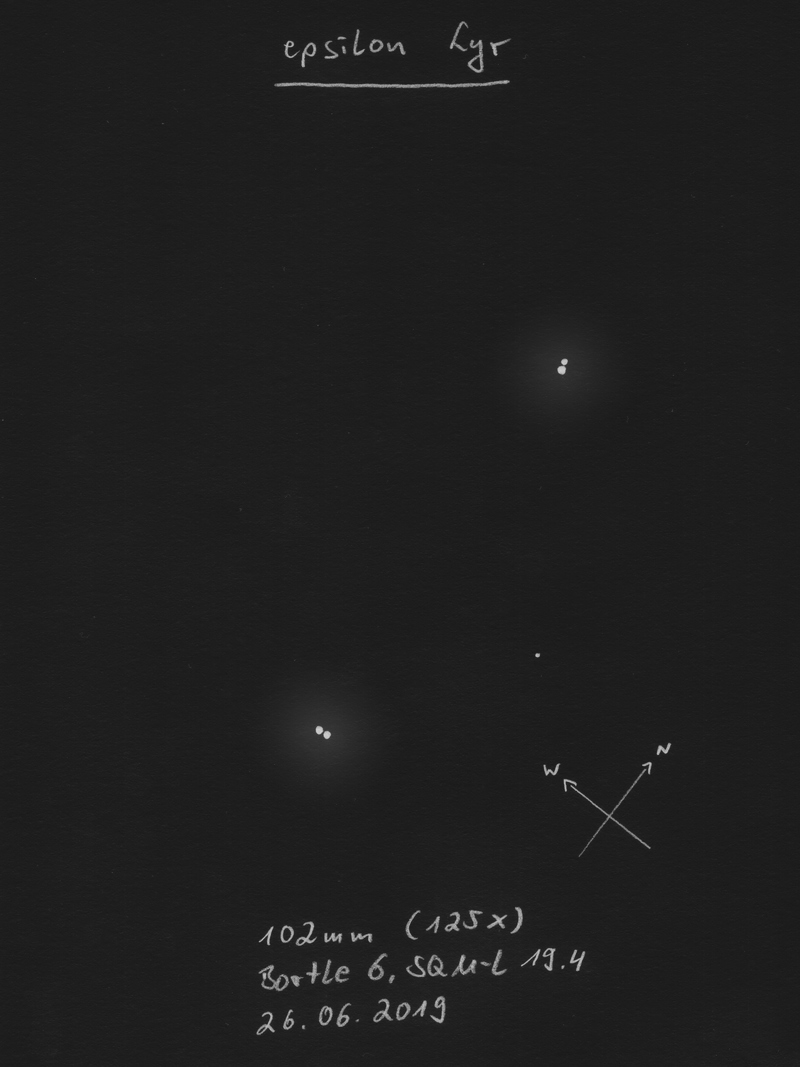
|
Uwe Pilz
Leipzig (Germany) |
105mm (26x) |
bei 22x nicht trennbar |
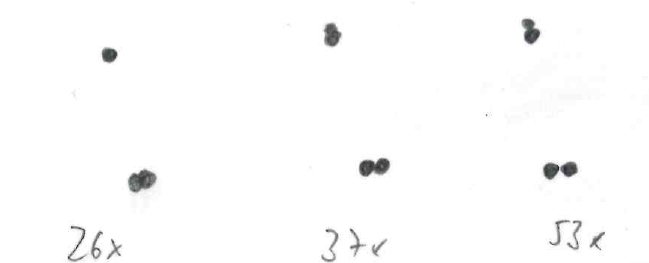
|
Jörg S. Schlimmer
Germany |
127mm (203x) |
alle Komponenten einfach zu trennen |
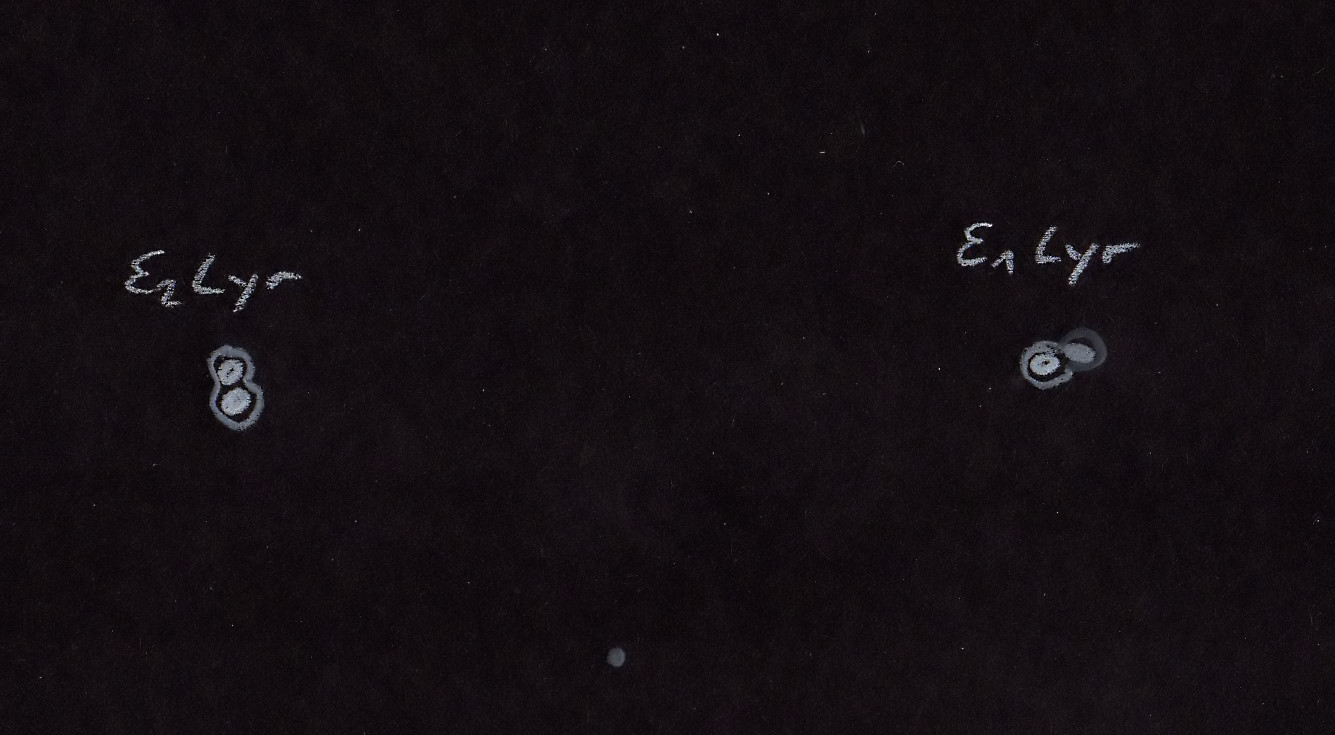
|
Sarah Gebauer
Germany |
150mm (250x) |
August 2019 zum ersten Mal die nah beieinanderstehenden Komponenten sauber getrennt, ein grandioser Doppel-Doppel-Anblick |
|
Winfried Kräling
Marburg (Germany) |
152mm (175x) |
|
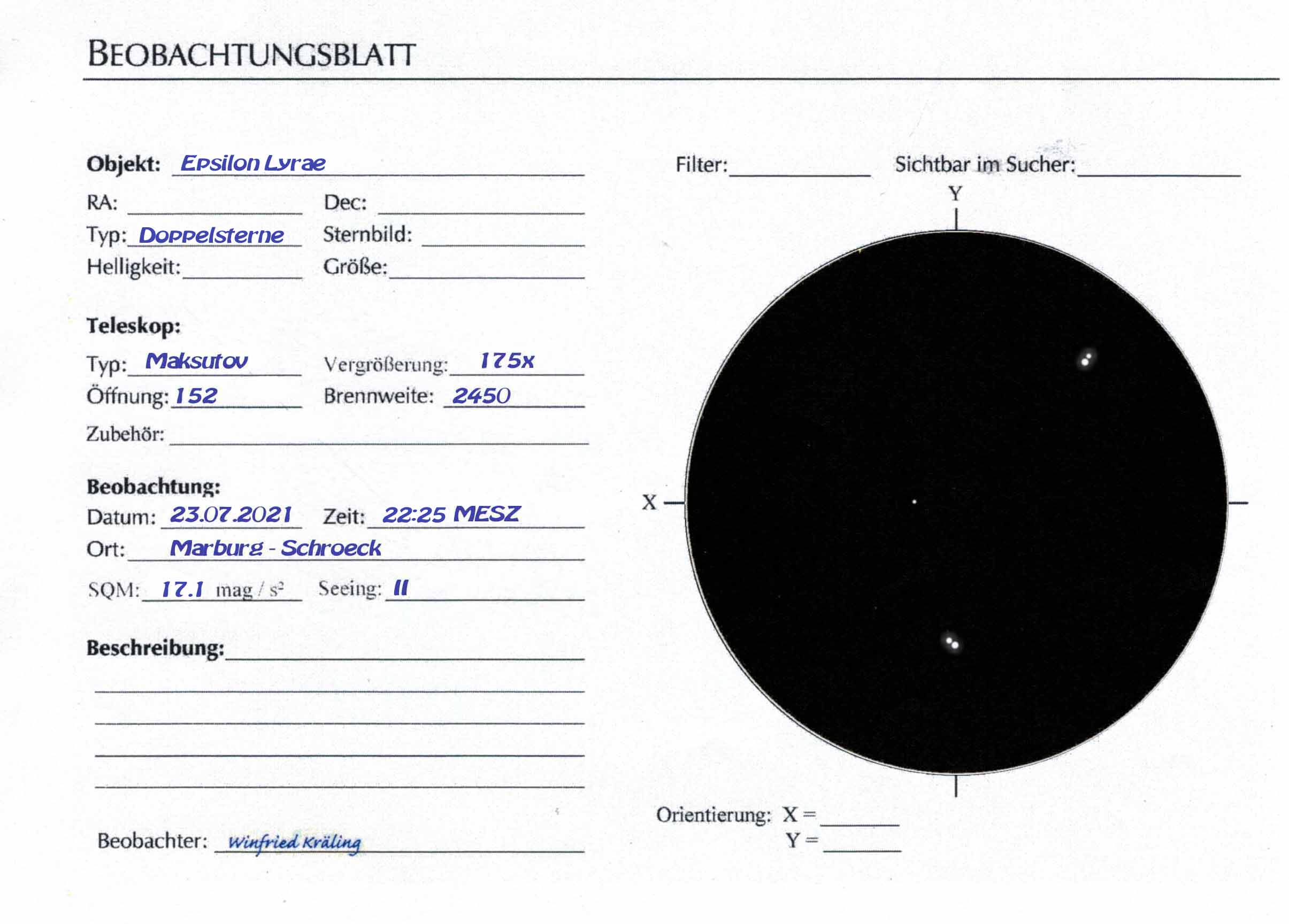
|
René Merting
Drachhausen (Germany) |
320mm (144x) |
AB: bei 72x ist erkennbar, in welche Richtung die Sterne elongieren, bei 43x dann ist eine deutliche 8 sichtbar - erst bei 206x lassen sich A und B zweifelsfrei trennen, zeigen sich aber auch schon ordentlich aufgebläht
CD: bei 103x ist die südliche Komponente als 8 erkennbar - bei 144x kann ich C und D trennen |
|
René Merting
Drachhausen (Germany) |
320mm (144x) |
bei 144x sind die Komponenten von AB und CD gerade so getrennt voneinander erkennbar, sie tanzen wie wild miteinander - mit Arperturmaske und Abblendung auf 120 mm zeigen die vier nun deutlich schwächeren Sterne schöne Beugungsscheibchen und sind besser getrennt voneinander sichtbar |
|
Uwe Pilz
Leipzig (Germany) |
320mm (200x) |
7 Komponenten!! A-B-C-D-E-F-I |

|
|
Berthold Fuchs
Wiesbaden (Germany) |
130mm |
Vierfachsystem |
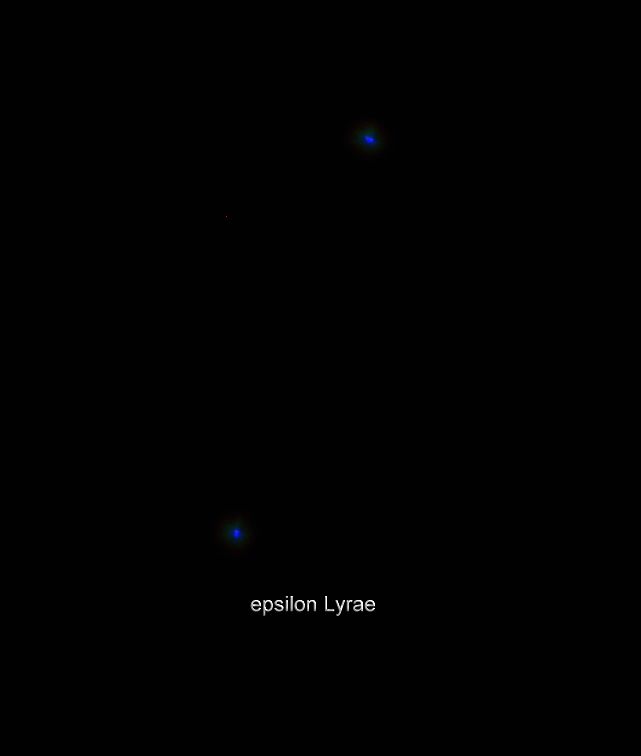
|
|
|
★
|
STF2375 |
|
AB |
6m.3 |
6m.7 |
2.6" |
120° |
2019 |
Ser |
18h45m28.36s / +05°30'00.40" |
|
|
René Merting
Drachhausen (Germany) |
76mm (95x) |
bei 57x erkenne ich eine Ameisen - beide Sterne stehen kurz vor der Trennung - bei 95x dann ein wunderschönes Bild, es zeigen sich zwei gleich helle Sterne, äußerst knapp getrennt |
|
René Merting
Drachhausen (Germany) |
100mm (64x) |
bei 64x sehe ich zwei sehr dicht stehende Sterne, mit etwas Geduld wird ab und an eine knappe Trennung deutlich - beide sind in gleich hell (ich habe sogar A und B falsch zugeordnet, weil ich B knapp heller fand) und strahlen um die Wette in weiß |
|
Stefan Loibl
Rosenheim (Germany) |
102mm (102x) |
'Tweedledum' und 'Tweedledee', mit 68x als Doppelstern erkennbar, mit 102x klar getrennt, Komponenten gleich hell, Vierfachsystem als visueller Doppelstern |
|
|
|
|
HU937 |
|
|
8m.8 |
9m.9 |
1.0" |
333° |
2016 |
Dra |
18h46m13.38s / +64°11'44.40" |
|
|
Mark McCarthy
Fremont (California/USA) |
508mm (333x) |
Hairline split at 205x, more definite split with 333x, ~1 delta mag. A is yellow-white, B is a deeper yellow-orange. 225.53 year period |
|
|
|
|
HU1191 |
|
|
8m.7 |
9m.4 |
0.2" |
338° |
2016 |
Lyr |
18h46m34.62s / +38°21'04.00" |
|
|
Mark McCarthy
Fremont (California/USA) |
508mm (1067x) |
V595 Lyr. Very tough! In unsettled seeing it is an elongation or lopsided at all powers. However at best moments it tightens enough to show a very subtle notch & also different brightness and color, A being light orange-yellow, and ~1 delta mag B a deeper orange. Discovered in 1902 at 0.2, it has only a 14.64 year period, it will make a rapid circuit to the other side by 2026 (though only 0.1"), and "widen" to 0.2" again by 2030. Should be fun to observe! |
|
|
|
|
STF2402 |
|
|
8m.9 |
9m.3 |
1.5" |
208° |
2016 |
Aql |
18h49m44.14s / +10°40'35.40" |
|
|
Mark McCarthy
Fremont (California/USA) |
203mm (667x) |
Lovely near equal, tight but well split. Forms a perfect triangle with two other stars |
|
|
|
★
|
BU137 |
|
AB |
8m.7 |
9m.0 |
1.6" |
167° |
2022 |
Lyr |
18h53m57.56s / +37°22'49.70" |
|
|
Frederik Wanink
Itterbeck (Germany) |
254mm (640x) |
|
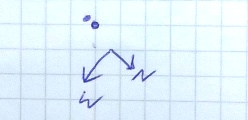
|
Mark McCarthy
Fremont (California/USA) |
317mm (553x) |
Fine near equal light orange, ~2". Rich finder field. In Steph 1 open cluster. |
|
Mark McCarthy
Fremont (California/USA) |
508mm (667x) |
Nice bright white near equal stars, 1.5", in a two plus one system with much fainter farther C. (AC 12th mag 23.6") |
|
|
|
|
A258 |
|
|
8m.9 |
9m.9 |
0.3" |
228° |
2018 |
Lyr |
18h54m59.91s / +30°52'45.50" |
|
|
Mark McCarthy
Fremont (California/USA) |
508mm (667x) |
Very tough. I get elongation at 553x, and more clear elongation at 667x, but no split, not even notching, more like an unevenly illuminated rod. Seeing not support higher power. |
|
|
|
|
BU648 |
|
AB |
5m.3 |
8m.0 |
1.2" |
232° |
2020 |
Lyr |
18h57m01.61s / +32°54'04.60" |
|
|
Mark McCarthy
Fremont (California/USA) |
152mm (285x) |
Orange A and a just split, very small, very faint B, seen only with 285x --175x suspected, 456x image quality not good. Short period pair, it will make a half revolution by 2045 |
|
Mark McCarthy
Fremont (California/USA) |
317mm (553x) |
277x an orange not quite round disk, suspected a close pair. At 553x it splits with seeing, 0.8", 3 delta mag, in diffraction. |
|
|
|
|
STF2438 |
|
|
7m.0 |
7m.4 |
0.8" |
356° |
2019 |
Dra |
18h57m28.47s / +58°13'30.00" |
|
|
Frederik Wanink
Itterbeck (Germany) |
254mm (640x) |
leicht; beide gleich hell |
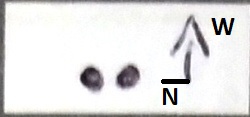
|
Mark McCarthy
Fremont (California/USA) |
508mm (333x) |
Hairline split, white stars, near equal. 261.6 year period, look how fast it will move in the years 2150-2160! |
|
|
|
|
AG366 |
|
|
8m.5 |
8m.7 |
1.4" |
183° |
2019 |
Lyr |
18h58m03.46s / +47°11'30.10" |
|
|
Mark McCarthy
Fremont (California/USA) |
508mm (205x) |
Near equal yellow-white easy split |
|
|
|
|
HU332 |
|
|
9m.7 |
9m.6 |
0.5" |
267° |
2016 |
Vul |
18h59m03.72s / +22°30'03.20" |
|
|
Mark McCarthy
Fremont (California/USA) |
508mm (533x) |
Beautiful close split, a little more than hairline, light orange stars near equal |
|
|
|
★
|
STF2437 |
|
|
8m.4 |
8m.8 |
0.6" |
334° |
2021 |
Sge |
19h01m53.16s / +19°10'11.70" |
|
|
Mark McCarthy
Fremont (California/USA) |
178mm (333x) |
Light orange, snowman only. Physical with a 804.6-year period |
|
Mark McCarthy
Fremont (California/USA) |
317mm (553x) |
Small faint, notched peanut when seeing stills. Orange. |
|
René Merting
Drachhausen (Germany) |
320mm (411x) |
bis 411x hoch vergrößert, dann endlich zeigen sich in ruhigen Momenten zwei Perlchen, knapp getrennt und in den Beugungsringen des Partner stehend - Schwerstarbeit |
|
|
|
|
STF2450 & HU757 |
STF2450 |
A-BC |
6m.5 |
9m.5 |
5.2" |
300° |
2021 |
Dra |
19h02m07.04s / +52°15'40.10" |
|
|
|
HU757 |
BC |
10m.3 |
10m.4 |
0.2" |
168° |
2010 |
|
|
|
|
René Merting
Drachhausen (Germany) |
320mm (103x) |
STF2450 (A-BC): bei 103x knapp getrennt zu erkennen - A strahlt Samtgelb, BC im Nordwesten ist, obwohl mindestens 3 Magnituden schwächer, noch in einem schönen Weiß erkennbar |
|
Mark McCarthy
Fremont (California/USA) |
508mm (205x) |
STF2450 (A-BC): Bright yellow and fainter yellow orb for B. 2-3 delta mag, ~5". |
|
|
|
|
AG227 |
|
|
10m.7 |
11m.2 |
7.1" |
31° |
2015 |
Lyr |
19h05m22.05s / +38°03'20.60" |
|
|
Mark McCarthy
Fremont (California/USA) |
508mm (667x) |
This is the brighter pair of the double-double pair mentioned in last entry (ALI 614). White stars, brilliant, wide separation |
|
|
|
|
HU940 |
|
|
9m.2 |
9m.8 |
0.4" |
187° |
2016 |
Lyr |
19h05m30.86s / +33°52'21.50" |
|
|
Mark McCarthy
Fremont (California/USA) |
508mm (667x) |
Hairline at 445x, split with 667x, slightly unequal white stars. Physical with 111.6-year period, it will tighten in the next couple of decades |
|
|
|
|
STF2454 |
|
AB |
8m.3 |
9m.7 |
1.3" |
291° |
2016 |
Lyr |
19h06m09.37s / +30°26'18.80" |
|
|
Mark McCarthy
Fremont (California/USA) |
317mm (553x) |
Fine yellowish pair, ~1.5" |
|
Mark McCarthy
Fremont (California/USA) |
508mm (667x) |
Nice well split 2 delta mag, white A reddish B. (DRD 2 AC is 13.50 mag and 31.3") |
|
|
|
|
HEI568, 18 Aql |
|
|
5m.4 |
6m.4 |
0.3" |
243° |
2021 |
Aql |
19h06m58.60s / +11°04'16.70" |
|
|
Mark McCarthy
Fremont (California/USA) |
508mm (410x) |
18 Aql. The A star is elongated / smeared but 410x does not resolve, seeing not good enough. |
|
|
|
|
STT369 |
|
|
7m.8 |
7m.9 |
0.7" |
4° |
2018 |
Dra |
19h07m06.37s / +72°04'26.60" |
|
|
Frederik Wanink
Itterbeck (Germany) |
254mm (640x) |
zeitweilig gut erkennbar |
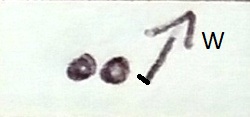
|
|
|
|
SE2 |
|
BC |
8m.3 |
9m.4 |
0.1" |
21° |
2010 |
Lyr |
19h11m07.99s / +38°46'52.40" |
|
|
Mark McCarthy
Fremont (California/USA) |
508mm (1334x) |
This is a component of STF2481 which I viewed through the 6-inch recently. I see a very slight elongation to B all powers, but no resolution or notching. Physical with a 62.79-year period, it will thankfully widen and be a far easier target (at 0.3") by 2030 |
|
|
|
★
|
STF2486 |
|
AB |
6m.5 |
6m.7 |
7.2" |
204° |
2020 |
Cyg |
19h12m05.03s / +49°51'20.70" |
|
|
René Merting
Drachhausen (Germany) |
15x56 |
eine Ameise mit Nordost-Südwestausdehnung - Einschnürung nur leicht |
|
Robert Zebahl
Leipzig (Germany) |
16x70 |
03.07.2020: Fein getrennt, aber sehr dicht bei gleich hellen Komponenten. |
|
Robert Zebahl
Leipzig (Germany) |
70mm (22x) |
Bei 22x gerade noch trennbar bei geringem Helligkeitsunterschied. Bei 44x wirkte A orangefarben. Dem Begleiter konnte ich keine Farbe zuordnen. |
|
Mark McCarthy
Fremont (California/USA) |
317mm (553x) |
Near equal yellow pair. |
|
|
|
★
|
BU139 & STTA177, V338 Sge |
BU139 |
AB |
7m.1 |
8m.0 |
0.6" |
135° |
2017 |
Sge |
19h12m34.45s / +16°50'47.20" |
|
|
|
STTA177 |
AC |
7m.1 |
8m.0 |
98.4" |
276° |
2017 |
|
|
|
|
|
BU139 |
AE |
7m.1 |
11m.2 |
28.8" |
101° |
2015 |
|
|
|
|
|
BU139 |
CD |
8m.0 |
11m.2 |
138.9" |
269° |
2015 |
|
|
|
|
René Merting
Drachhausen (Germany) |
12x42 |
STTA177 (AC): zwei komfortabel getrennte Sterne - Komponente C im Westen wirkt grauweiß und ist gut eine bis eineinhalb Größenklassen schwächer |
|
Mark McCarthy
Fremont (California/USA) |
80mm (13x) |
STTA177 (AC): Near equal wide pair split in finder |
|
Mark McCarthy
Fremont (California/USA) |
152mm (456x) |
BU139 (AB): Very subtle notched unequal elongation at all powers. Physical with a 587-year period, currently coming of apastron, it will continue to tighten. Component of STT 177. Burnham discovered with his 6-inch in at 0.5", about what it is now, an astounding catch |
|
Frederik Wanink
Itterbeck (Germany) |
254mm (640x) |
BU139 (AB): getrennt, schwierig, 0,6"? |
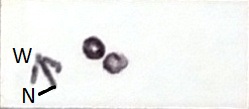
|
Mark McCarthy
Fremont (California/USA) |
317mm (553x) |
STTA177 (AC): Very wide orange-yellow and blue, ~2-3 delta mag. |
|
René Merting
Drachhausen (Germany) |
320mm (45x) |
STTA177 (AC): bei 45x weit auseinanderstehend - A wirkt weiß und B schmutzig gelblich, was sich bei 103x bestätigt |
|
|
|
|
STF2484 |
|
|
7m.9 |
9m.5 |
2.1" |
241° |
2017 |
Sge |
19h14m15.66s / +19°03'50.30" |
|
|
René Merting
Drachhausen (Germany) |
100mm (142x) |
bis 142x probiert, keine Chance, Komponente B zeigt sich nicht |
|
Mark McCarthy
Fremont (California/USA) |
178mm (205x) |
Cream white A and yellow B, 2" separation, 2 delta mag, very pretty. Physical with a 1500-year period |
|
Mark McCarthy
Fremont (California/USA) |
317mm (553x) |
Very close, ~2", orange, 1.5 delta mag. |
|
|
|
|
BU1129 |
|
|
7m.7 |
7m.8 |
0.3" |
344° |
2016 |
Cyg |
19h21m36.09s / +52°22'34.90" |
|
|
Mark McCarthy
Fremont (California/USA) |
508mm (889x) |
Light orange stars, obviously not single at 445x, and the disks separated as I powered up. Less than 1 delta mag, the best view with 889x, which showed a constant hairline split even with wavering seeing, PA NNW. A really nice pair. Spectral class A8III (white). 121.7-year period, currently 0.328" separated, it is approaching apastron now and will hang there until the 2050s. Burnham discovered in 1889 on the Lick 36-inch at 0.3" and noted "If [the proper motion in Ast. Gess. Catalogue]...is substantially correct, this is a physical system." |
|
|
|
|
STF2525 |
|
AB |
8m.2 |
8m.4 |
2.3" |
290° |
2020 |
Vul |
19h26m33.71s / +27°19'21.90" |
|
|
Robert Zebahl
Leipzig (Germany) |
152mm (100x) |
24.06.2020: Bei 49x leicht länglich, bei 69x knapp getrennt mit sichtbarem Helligkeitsunterschied. Bei 100x schöner Anblick bei klarer Trennung und leichter Helligkeitsdifferenz, aber ohne erkennbare Farben. |
|
Mark McCarthy
Fremont (California/USA) |
152mm (175x) |
Close near equal white stars. Physical with 289-year period |
|
Mark McCarthy
Fremont (California/USA) |
508mm (205x) |
Near equal yellow-white stars, wide. An amazingly precise 882.894 year period. I will not notice the change |
|
|
|
|
MCA55, bet 1 Cyg |
|
Aa-Ac |
3m.4 |
5m.2 |
0.3" |
46° |
2021 |
Cyg |
19h30m43.29s / +27°57'34.90" |
|
|
Mark McCarthy
Fremont (California/USA) |
508mm (445x) |
Alberio A. Using all powers at both 20-inch and 7-inch, A is consistently out of round with the weaker end in the southern direction. Alberio B remains relatively round in the diffraction dance. Currently 0.365", it is widening to apastron by 2035 and might even be splitable by then |
|
|
|
|
STF2536 |
|
|
8m.4 |
11m.4 |
1.8" |
120° |
2018 |
Sge |
19h31m37.80s / +17°46'58.60" |
|
|
Mark McCarthy
Fremont (California/USA) |
508mm (205x) |
Blue-white A and much fainter ~3 delta B, split close, dull orange color. Very fine. Physical with 672.5 year period |
|
|
|
|
STT375 |
|
|
7m.7 |
8m.9 |
0.7" |
183° |
2018 |
Sge |
19h34m37.45s / +18°07'41.20" |
|
|
Mark McCarthy
Fremont (California/USA) |
317mm (553x) |
Sense an elongation or rod, marginal. |
|
Mark McCarthy
Fremont (California/USA) |
508mm (533x) |
Snowman at 205x, 333x, split with 533x, >1 delta mag, ~0.5". A is orange-yellow and B is blue-white. Physical with 682 year period, just coming apastron now. |
|
|
|
★★
|
STFA46, 16 Cyg |
|
AB |
6m.0 |
6m.2 |
39.7" |
133° |
2020 |
Cyg |
19h41m49.09s / +50°31'31.60" |
Christopher Hay
Seeheim (Germany) |
3x63 |
Selbstbau-Fernglas aus zwei Telekonvertern, daher die ungewöhnliche Spezifikation. Farbfehlerfrei und randscharf.
Mit blossem Auge ist 16 Cyg unter gutem Vorstadthimmel gerade so auszumachen. Im 3x-Fernglas ist das Sternpaar in guten Momenten tatsächlich trotz der geringen Vergrößerung in zwei feinste Lichtpunkte getrennt. Laut Stelledoppie ein physikalisches Paar.
Mit zwei Empfehlungssternen bewertet, weil dies ein echtes physikalisches Paar ist, das mit kleinsten Ferngläsern getrennt werden kann und mit steigender Fernglas-Größe zunehmend mehr zeigt (Helligkeitsunterschied A-B mit 7x50, Farbunterschied mit 15x45). |
|
Christopher Hay
Seeheim (Germany) |
7x50 |
Ein fein getrenntes Sternpaar. A-Komponente erscheint marginal heller als B-Komponente. Ein sehr schönes Fernglas-Paar. |
|
Christopher Hay
Seeheim (Germany) |
15x45 |
Weit getrennt und visuell eine starke Präsenz, 4,5° Gesichtsfeld dominierend. A-Komponente erscheint ganz zart orange, B-Komponente ebenso zart bläulich. |
|
Robert Zebahl
Leipzig (Germany) |
16x70 |
01.06.2021: Sehr auffällig, hell bei moderatem Abstand und geringem Helligkeitsunterschied. Weiß-gelblich & weiß. |
|
René Merting
Drachhausen (Germany) |
18x70 |
zwei ordentlich getrennte fast gleich helle Sterne - beide Komponenten sind reinweiß und die hellsten Sterne im unmittelbaren Umfeld - auffällig |
|
Christopher Hay
Seeheim (Germany) |
44x100 |
Ein visuell ausserordentlich starkes Paar in 1,9° Gesichtsfeld. Nördliche Komponente marginal heller und mit einem Hauch Gelb. |
|
Sarah Gebauer
Germany |
100mm (21x) |
27.09.23: bei 21-fach ein schmales, sehr helles, warmweiß bis leicht goldenes Farbsternpaar mit nahezu gleich hellen und gleichfarbigen Komponenten - westlich strahlt noch R Cyg etwas heller und in einem leicht intensiveren Gelb |
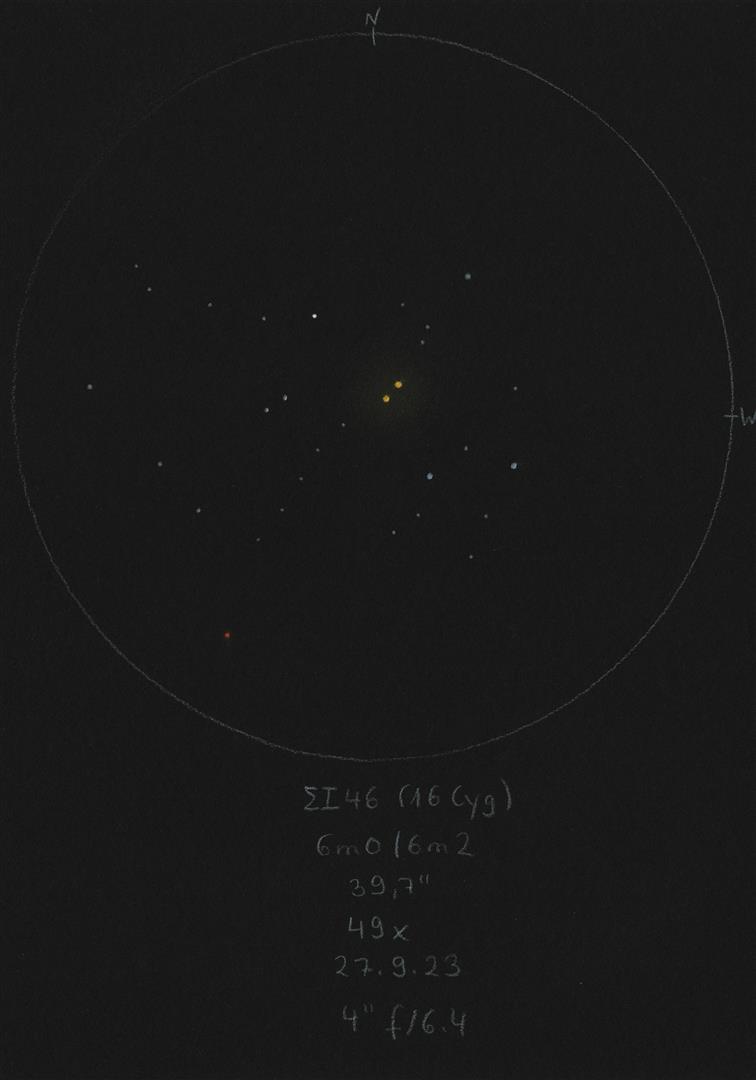
|
Sarah Gebauer
Germany |
100mm (80x) |
der Doppelstern springt mich regelrecht an bei der Suche nach dem Blinking PN, es sind zwei ganz durchdringende, gleich helle Sternpunkte, die zwar schon einem sternreichen Umfeld stehen, aber dennoch deutlich heller hervortreten; südlich davon befindet sich rein optisch betrachtet eine abgeschwächte Kopie davon |

|
Mark McCarthy
Fremont (California/USA) |
317mm (553x) |
16 Cyg: Wide equal orange-yellow, also split in 80mm finder |
|
|
|
|
KUI94 |
|
|
6m.5 |
7m.8 |
0.5" |
158° |
2014 |
Cyg |
19h41m57.63s / +40°15'14.60" |
|
|
Frederik Wanink
Itterbeck (Germany) |
254mm (640x) |
unsicher, 8förmig |
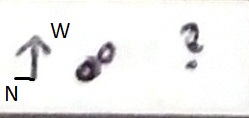
|
|
Frederik Wanink
Itterbeck (Germany) |
254mm |
|
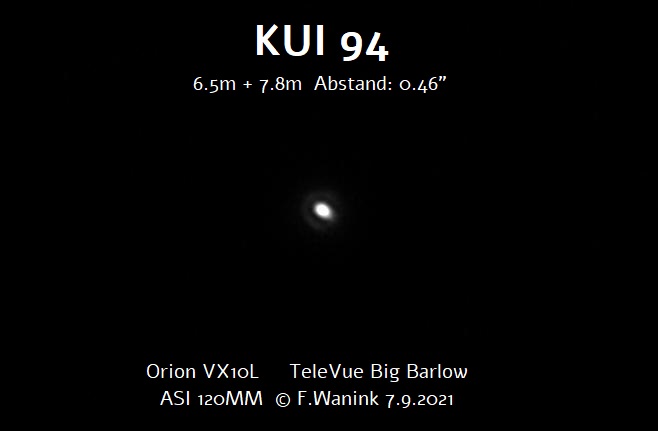
|
|
|
|
STT383 |
|
AB |
7m.0 |
8m.3 |
0.8" |
15° |
2014 |
Cyg |
19h42m56.26s / +40°43'18.30" |
|
|
|
|
AC |
7m.0 |
11m.6 |
45.2" |
99° |
2002 |
|
|
|
|
|
|
AD |
7m.0 |
12m.4 |
68.1" |
43° |
2002 |
|
|
|
|
Robert Zebahl
Leipzig (Germany) |
152mm (240x) |
AB: 07.08.2022: Unter den durchschnittlichen Bedingungen ist der Doppelstern als solcher gut erkennbar. Der schwächere Begleiter klebt als verwaschenes Sternchen an der Hauptkomponente. In ruhigen Momenten sind gut die sich überlappenden Beugungsscheibchen sichtbar. |
|
Frederik Wanink
Itterbeck (Germany) |
254mm (640x) |
AB: getrennt |
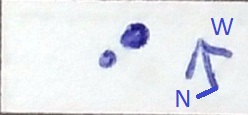
|
|
Frederik Wanink
Itterbeck (Germany) |
254mm |
AB |

|
|
|
★
|
STF2579, delta Cyg, 18 Cyg |
|
AB |
2m.9 |
6m.3 |
2.7" |
213° |
2020 |
Cyg |
19h44m58.44s / +45°07'50.50" |
|
|
Robert Zebahl
Leipzig (Germany) |
70mm (200x) |
28.07.2019: Bei 100x nur angedeutet. Bei 200x ist die vielfach schwächere B-Komponente als leicht elongierte Aufhellung auf dem ersten Beugungsring erkennbar. |
|
Uwe Pilz
Leipzig (Germany) |
105mm (288x) |
blauweiß |
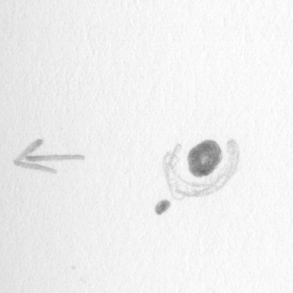
|
Robert Zebahl
Leipzig (Germany) |
152mm (133x) |
21.09.2022: Bei 92x klar getrennt, aber noch recht dicht. Hauptkomponente leicht gelblich mit deutlich schwächerem Begleiter. Bei 133x einfach zu trennen. Der schwache Begleiter wirkt orange-bräunlich. |
|
Mark McCarthy
Fremont (California/USA) |
317mm (553x) |
Very bright white with ruddy B, ~4", 4 delta mag. Nice! |
|
|
|
|
17 Cyg |
STF2580 |
AB |
5m.1 |
9m.2 |
25.9" |
68° |
2020 |
Cyg |
19h46m25.60s / +33°43'39.30" |
|
|
|
STF2580 |
AC |
5m.1 |
9m.4 |
106.3" |
122° |
2020 |
|
|
|
|
|
WNO56 |
AF |
5m.1 |
8m.5 |
792.0" |
235° |
2002 |
|
|
|
|
|
STF2580 |
BG |
9m.2 |
8m.6 |
817.7" |
235° |
2016 |
|
|
|
|
|
STF2576 |
FG |
8m.5 |
8m.6 |
3.2" |
155° |
2020 |
|
|
|
|
René Merting
Drachhausen (Germany) |
100mm (20x) |
AB: bei 20x locker getrennt - Komponente A satt gelb, B wegen des großen Helligkeitsunterschiedes gräulich-bräunlich |
|
Uwe Pilz
Leipzig (Germany) |
120mm (140x) |
|
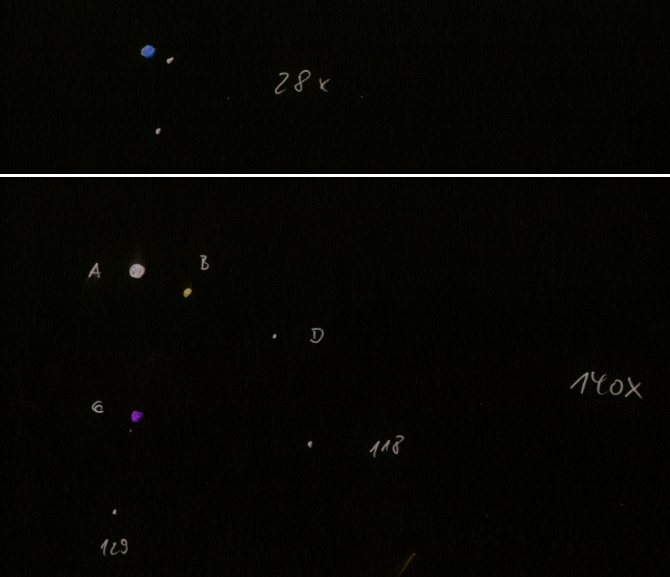
|
Robert Zebahl
Leipzig (Germany) |
152mm (92x) |
24.07.2021: Bei 30x sind die Komponenten A, B & C bereits einfach sichtbar, wobei A & B noch recht dicht beisammen stehen. Die helle Komponente A erscheint dabei in einem zarten Gelb. Bei 92x ist dann auch das Paar FG einfach trennbar und wirkt weniger zum System zugehörig aufgrund des großen Abstands zu den anderen Komponenten. Insgesamt dennoch sehenswert. |

|
Winfried Kräling
Marburg (Germany) |
152mm (175x) |
A, B & C |
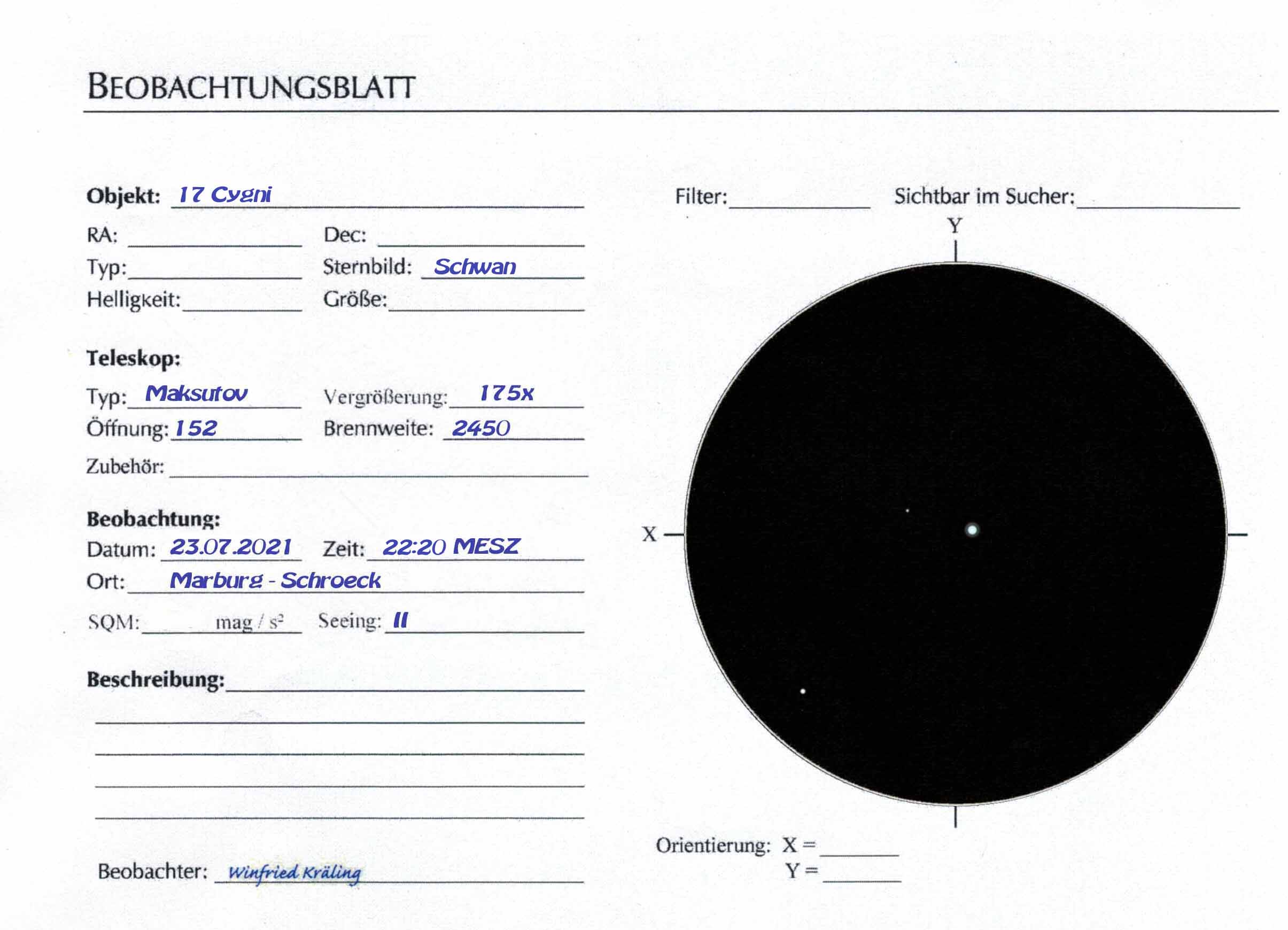
|
Mark McCarthy
Fremont (California/USA) |
317mm (277x) |
AB: 17 Cyg: Yellow and slightly red, well separated, 1 delta mag. (This is an amazingly complex system with 11 stars in all sorts of combinations. Why not just call it an open cluster?) |
|
René Merting
Drachhausen (Germany) |
320mm (45x) |
AB: bei 45x ordentlich getrennt, die A-Komponente strahlt in einem schönen Cremegelb - bei 103x geht A mehr ins Warmweiße und verliert eigenartigerweise Farbe - B ist etwa 3.5 bis 4 Größenklassen schwächer, steht recht weit abgesetzt und wirkt kühlweiß |
|
|
|
|
STF2603, 63 Dra, epsilon Dra |
|
|
4m.0 |
6m.9 |
3.5" |
20° |
2022 |
Dra |
19h48m10.35s / +70°16'04.50" |
|
|
René Merting
Drachhausen (Germany) |
76mm (114x) |
bei 114x hat die sattgelbe A-Komponente einen schönen, aber nicht durchgehenden Beugungsring und auf genau diesem Beugungsring steht B mattgrau - ganz knappe Trennung, zwei Blatt Papier passen da dazwischen |
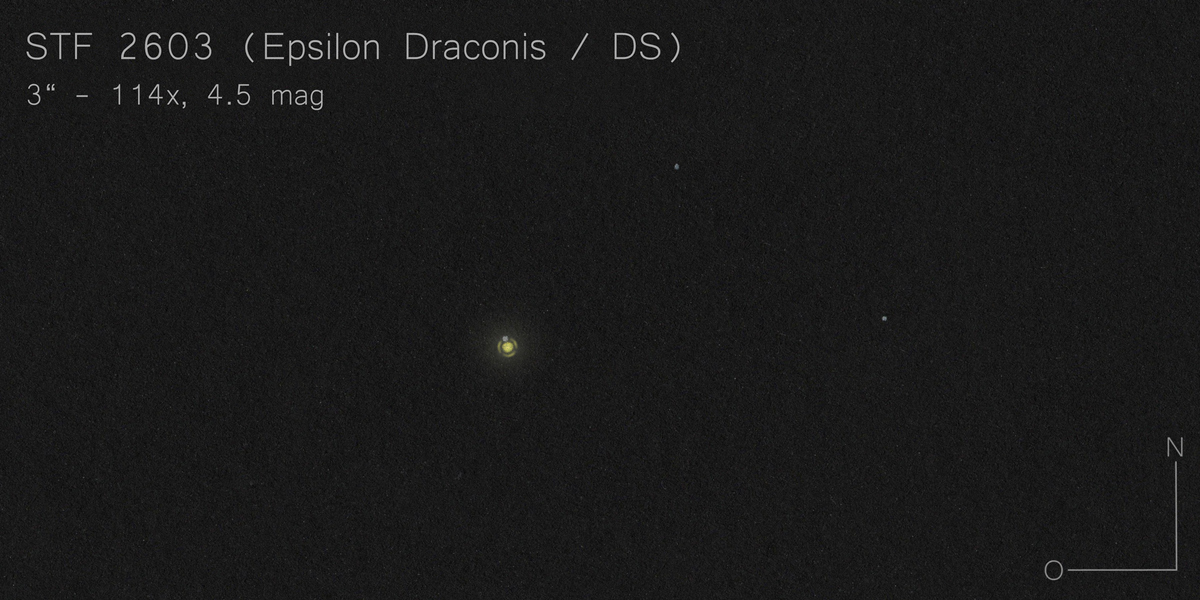
|
Sarah Gebauer
Germany |
100mm (130x) |
ganz knapp ist manchmal die schwache, zweite Komponente sichtbar, die Luft ist etwas zu unruhig, um bei 130-fach ein klares Bild zu bekommen |
|
Sarah Gebauer
Germany |
254mm (49x) |
bei 49-fach fast getrennt, blickweise mit Einkerbung – ein typisches, warmes Strohgelb |
|
|
|
★
|
STT387 |
|
|
7m.1 |
7m.9 |
0.5" |
94° |
2020 |
Cyg |
19h48m43.81s / +35°18'41.30" |
|
|
Frederik Wanink
Itterbeck (Germany) |
254mm (640x) |
zeitweise als 8 zu sehen |
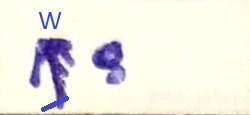
|
Mark McCarthy
Fremont (California/USA) |
317mm (277x) |
Red, very close pair? Seeing not supporting higher magnification. Marginal. |
|
Mark McCarthy
Fremont (California/USA) |
317mm (553x) |
Overlapping disks, to a nearly hairline split with seeing. Half delta mag. |
|
|
Frederik Wanink
Itterbeck (Germany) |
254mm |
|
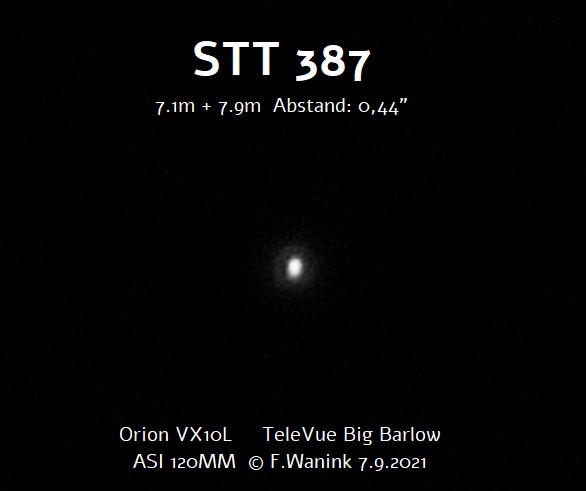
|
|
|
★
|
DJU4, 13 Vul |
|
|
4m.6 |
7m.4 |
1.5" |
248° |
2020 |
Vul |
19h53m27.69s / +24°04'46.60" |
|
|
Mark McCarthy
Fremont (California/USA) |
152mm (285x) |
Gorgeous! Bright A and 3 delta mag B appears as a fine point just beyond A's diffraction. Seen at 175x, best at 285x. Physical with a 615-year period, at apastron |
|
Frederik Wanink
Itterbeck (Germany) |
254mm (640x) |
schwierig wegen Helligkeitsunterschied |

|
|
|
|
STF2596 |
|
|
7m.3 |
8m.7 |
2.1" |
297° |
2016 |
Aql |
19h54m01.95s / +15°17'31.70" |
|
|
René Merting
Drachhausen (Germany) |
100mm (107x) |
bei 107x ist Komponente B knapp abgesetzt nordwestlich von der A-Komponente sichtbar, knappe Trennung - Helligkeitsunterschied gut 1.5 Größenklassen |
|
Mark McCarthy
Fremont (California/USA) |
152mm (175x) |
Light yellow A and light blue B, nicely separated, very pretty. Physical with a 2971-year period |
|
Mark McCarthy
Fremont (California/USA) |
203mm (533x) |
Orange pair with 2 delta mag companion, about 2", well split. |
|
|
|
|
HO581 |
|
|
8m.0 |
8m.7 |
0.1" |
230° |
2012 |
Cyg |
19h54m58.40s / +41°52'17.60" |
|
|
Mark McCarthy
Fremont (California/USA) |
508mm (667x) |
Very subtly notched elongation at best, light orange stars. 25.63 year period, near apastron in a nearly circular orbit, it will widen slightly in the next 5 years and still be a detectable 0.2" in 2035. |
|
|
|
|
STT392 & STF2607 |
STT392 |
AB |
6m.6 |
8m.4 |
0.1" |
184° |
1996 |
Cyg |
19h57m56.12s / +42°15'38.90" |
|
|
|
STF2607 |
AB-C |
6m.6 |
9m.1 |
3.0" |
289° |
2012 |
|
|
|
|
René Merting
Drachhausen (Germany) |
100mm (107x) |
STF2607 (AB-C): bei 107x ist C knapp westlich von AB zu erkennen, in guten Momenten sind die Komponenten getrennt sichtbar - trotz des großen Helligkeitsunterschiedes von schätzungsweise 1,5 bis 2 Größenklassen wirkt C ggü. AB auch erstaunlich weißlich |
|
Robert Zebahl
Leipzig (Germany) |
152mm (92x) |
STF2607 (AB-C): 07.08.2022: Bei 92x klar getrennt, aber relativ enges Paar mit deutlichem Helligkeitsunterschied. AB wirkt gelblich, C bräunlich. Bei 171x einfach zu trennen mit etwas anderem Farbeindruck: AB erscheint gelblich, teils hellorange, C eher grau-bläulich. |
|
Mark McCarthy
Fremont (California/USA) |
152mm (175x) |
STF2607 (AB-C): Pretty light yellow-white A and reddish B, 2 delta mag, around 4". Nice. AB is STT 392 6.60/8.40 0.1", not seen (and only 0.2" at discovery in 1843; physical with a 270-year period). AB-C is uncertain in WDS, but I find the stars do not share parallax ranges, -10% |
|
Mark McCarthy
Fremont (California/USA) |
317mm (553x) |
STF2607 (AB-C): Very close clean split though B is in A's diffraction, somewhat bluish. |
|
|
|
★★
|
STF2606 |
|
AB |
7m.7 |
8m.4 |
0.7" |
146° |
2018 |
Cyg |
19h58m32.66s / +33°16'38.80" |
|
|
Frederik Wanink
Itterbeck (Germany) |
254mm (640x) |
sehr schwierig, Luftunruhe |
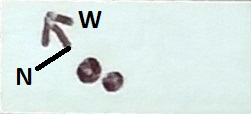
|
Mark McCarthy
Fremont (California/USA) |
317mm (553x) |
Hair split to clean split when seeing stills and there is only an airy disk. Near equal, half a delta mag. ~0.8" |
|
Mark McCarthy
Fremont (California/USA) |
508mm (333x) |
Close pair 2 delta mag. |
|
|
|
|
A378 |
|
|
8m.5 |
9m.0 |
1.0" |
294° |
2016 |
Cyg |
19h59m22.02s / +32°06'28.00" |
|
|
Mark McCarthy
Fremont (California/USA) |
508mm (205x) |
Excellent near equal split, light orange stars. Spectral class G5 (yellow). WDS 591-year period, and it appears to be starting to make a rapid closure to periastron by 2060. There is 37% parallax range overlap, 139 AU weighted separation, and 1.84/1.56 solar mass |
|
|
|
|
STF2613 |
|
AB |
7m.5 |
8m.0 |
3.5" |
354° |
2020 |
Aql |
20h01m26.66s / +10°44'54.80" |
|
|
René Merting
Drachhausen (Germany) |
100mm (64x) |
64x reicht für die Trennung, dann stehen die beiden Sterne aber noch sehr dicht - beide mit gleicher Helligkeit und strahlend weiß - schick |
|
Mark McCarthy
Fremont (California/USA) |
152mm (175x) |
Lovely near equal white stars, good split. Physical with 2106-year period |
|
Mark McCarthy
Fremont (California/USA) |
152mm (285x) |
White, ~1 delta mag, nice wide split |
|
|
|
|
STT395, 16 Vul |
|
|
5m.8 |
6m.2 |
0.7" |
129° |
2020 |
Vul |
20h02m01.45s / +24°56'16.80" |
|
|
Mark McCarthy
Fremont (California/USA) |
152mm (456x) |
Slightly unequal snowman at all powers. Notching increases in strength with increasing power. Physical with 1201-year period |
|
Mark McCarthy
Fremont (California/USA) |
203mm (667x) |
16 Vul. Hairline split at 8" 333x. At 667x I see a more definite split. It appears only half delta mag, rather than the 1 delta mag in Sky Tools. Nice star. |
|
Frederik Wanink
Itterbeck (Germany) |
254mm (640x) |
fast getrennt, eher 8, ähnlich hell |

|
|
Frederik Wanink
Itterbeck (Germany) |
254mm |
|

|
|
|
|
STT400 |
|
|
7m.6 |
9m.8 |
0.7" |
329° |
2017 |
Cyg |
20h10m13.32s / +43°56'44.20" |
|
|
Mark McCarthy
Fremont (California/USA) |
152mm (245x) |
Tough, notched elongation, near equal white stars. Physical with 85-year period, it is at apastron now will close entirely in the next 30 years |
|
Mark McCarthy
Fremont (California/USA) |
508mm (445x) |
Easy, nice clean disks, nicely split, 1 delta magnitude cream white A and light orange B, three field stars forming a triangle around it as reference. PA to NW. Spectral class G3V (yellow). Physical with 85.61-year period, it is 0.647" separated at apastron now and with make a quarter turn and tighten to 0.2" in the 2040s |
|
|
|
|
STF2658 |
|
AB |
7m.2 |
9m.4 |
5.2" |
106° |
2020 |
Cyg |
20h13m40.74s / +53°07'30.30" |
|
|
René Merting
Drachhausen (Germany) |
100mm (107x) |
bei 107x ist Komponente B schwach erkennbar östlich von A, es ist schon ordentlich Luft zwischen den beiden - Helligkeitsunterschied 2 Magnituden |
|
Uwe Pilz
Leipzig (Germany) |
105mm (144x) |
orangegelb |
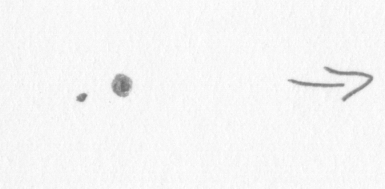
|
Uwe Pilz
Leipzig (Germany) |
320mm (225x) |
|

|
|
|
|
A1427 & STF2668 |
A1427 |
AB |
6m.6 |
8m.2 |
0.2" |
132° |
2012 |
Cyg |
20h20m15.22s / +39°24'11.80" |
|
|
|
STF2668 |
AB-C |
6m.3 |
8m.5 |
3.5" |
280° |
2016 |
|
|
|
|
René Merting
Drachhausen (Germany) |
100mm (107x) |
STF2668 (AB-C): bei 64x klebt Komponente C ganz dicht westlich an AB - Helligkeitsunterschied gut 2.5 Größenklassen - bei 107x sind beide Sterne eindeutig knapp getrennt |
|
Mark McCarthy
Fremont (California/USA) |
317mm (277x) |
STF2668 (AB-C): White and reddish-brown B, ~3 delta mag., 2" or so. |
|
|
|
★
|
COU327 |
|
AB |
9m.1 |
9m.1 |
0.2" |
245° |
2019 |
Del |
20h21m35.69s / +19°29'40.10" |
|
|
Mark McCarthy
Fremont (California/USA) |
508mm (1067x) |
The AB-C pair is easy at 205x, C is a faint star ~4" separated from bright A (8.41/11.97 4.0"). AB is much more difficult. At 1067x it is mostly overlapping disks & I can tell its orientation. But at repeated best moments, I get an instant of the finest hairline split with noticeable magnitude difference & I can estimate an orientation relative to nearby stars. It's PA [246-degrees] is nearly perpendicular to AB-C [131-degrees] -- this is how I confirmed I have it. Cocteau discovered it in 1968 with the Nice 30-inch refractor at 0.2". 42.46 year period, last observation in 2005, with grade 3 orbit (which is certain but not definitive). It is currently coming off apastron with the current orbital solution at 0.167" separation. It will tighten very rapidly the next few years, but even on the opposite side of it's orbit it will not be detectable by me, I need to wait until 2050 to try again -- but since the PA will be similar I won't notice that change. I can only look forward to the tightening, and maybe detectability again. If is the 0.167" is correct I have exceeded the Raleigh, Dawes, and Sparrow criteria and it's a new personal best -- and given I did not split some similar pairs later in the night, I was very lucky with the seeing at the time of the observation |
|
|
|
|
HO128 |
|
AB |
6m.4 |
8m.8 |
1.4" |
357° |
2016 |
Cyg |
20h22m55.49s / +42°59'00.40" |
|
|
Mark McCarthy
Fremont (California/USA) |
508mm (333x) |
Nice gold and blue pair, split at 205x, wider split at 333x. WDS gives physical with a 1027.9807-year period, and the orbit will rapidly close to periastron the next few decades. While an orbit is given, there is NO parallax range overlap, -59%, so likely with time this will prove not to be a gravitationally bound pair |
|
|
|
★
|
A288 |
|
|
8m.7 |
9m.0 |
0.2" |
296° |
2012 |
Del |
20h23m08.98s / +20°51'51.10" |
|
|
Mark McCarthy
Fremont (California/USA) |
508mm (1067x) |
Hairline split, noticeable mag difference, white. Very fine pair. 163y period, it won't make an appreciable change in my time, though it will widen to the 1901 discovery separation of 0.3" in 2075 |
|
|
|
|
rho Cap, 11 Cap |
SHJ323 |
AB |
5m.0 |
6m.9 |
1.7" |
189° |
2018 |
Cap |
20h28m51.62s / -17°48'49.20" |
|
|
|
BU61 |
AC |
5m.0 |
13m.3 |
54.6" |
150° |
2008 |
|
|
|
|
|
SHJ323 |
AD |
5m.0 |
6m.7 |
258.7" |
150° |
2011 |
|
|
|
|
|
BU61 |
BC |
6m.9 |
12m.5 |
53.5" |
149° |
2015 |
|
|
|
|
|
DOB13 |
DE |
6m.7 |
10m.6 |
53.5" |
93° |
2020 |
|
|
|
|
René Merting
Drachhausen (Germany) |
12x50 |
AD: einfach, ein helles, weit auseinander stehendes Paar - Komponente D im SO ist gut 1.5 Magnituden schwächer und wirkt grau ggü. der weiß strahlenden Komponente A |
|
René Merting
Drachhausen (Germany) |
15x56 |
AD: wieder eines jener Fernglaspaare, die unheimlich weit auseinander stehen - trotzdem auffällig, weil das Sternpaar recht isoliert erscheint - Komponente D wirkt grau und gut 1.5 Magnituden schwächer |
|
René Merting
Drachhausen (Germany) |
320mm (45x) |
AD: bei 45x ein schön weit getrenntes Paar, A im Norden strahlt zitronengelb, D scheint etwa 1,5 Größenklassen schwächer und auch leicht gelblich
A-E: im Südosten ist ein weiterer, ganz schwacher Begleiter zu sehen, der nochmals 2-3 Größenklassen schwächer wirkt |
|
|
|
|
A610 |
|
|
9m.5 |
9m.9 |
0.6" |
99° |
2021 |
Del |
20h29m02.58s / +07°09'29.30" |
|
|
Mark McCarthy
Fremont (California/USA) |
508mm (333x) |
Very finely split, white near equal, nice. 170.62y period, will make less than a quarter turn the next couple of decades. |
|
|
|
|
COU1962 |
|
|
9m.0 |
9m.5 |
0.3" |
294° |
2014 |
Cyg |
20h31m07.72s / +33°32'33.60" |
|
|
Mark McCarthy
Fremont (California/USA) |
508mm (889x) |
Very tough, light orange stars, just barely split at best moments, almost 1 delta mag, PA to S. =V2425 Cyg, for which I don't find a light curve on AAVSO -- I assume it's easier to observe the split when this is at minima. Spectral class K0 (yellow-orange). Currently 0.119" ! Only a 20.414-year period, it will make a quarter turn and widen slightly by 2028, and reach apastron by 2033 |
|
|
|
★
|
STF2690 & HJ269 & DA1 |
STF2690 |
A-BC |
7m.1 |
7m.4 |
17.8" |
255° |
2020 |
Del |
20h31m11.94s / +11°15'33.70" |
|
|
|
HJ269 |
AD |
7m.1 |
12m.1 |
23.0" |
108° |
2016 |
|
|
|
|
|
DA1 |
BC |
7m.9 |
8m.0 |
0.3" |
184° |
2016 |
|
|
|
|
René Merting
Drachhausen (Germany) |
10x50 |
STF2690 (A-BC): ein ganz enges Sternpaar mit zwei gleich hellen Sternen - ich würde beide als 8 mit tiefer Einschnürung bezeichnen, also kurz vor der Trennung |
|
Robert Zebahl
Leipzig (Germany) |
12x42 |
STF2690 (A-BC): 09.10.2021: Sehr schön. Sauber getrennt bei nahezu gleich hellen Komponenten. |
|
René Merting
Drachhausen (Germany) |
12x42 |
STF2690 (A-BC): ein superenges, schönes Paar gleich heller Sterne - da passen maximal eineinhalb Blatt Papier zwischen - schön im Zusammenspiel mit den beiden hellen Sternen südöstlich und südwestlich |
|
Robert Zebahl
Leipzig (Germany) |
16x70 |
STF2690 (A-BC): 19.08.2020: Auffällig, moderat hell mit schönem Abstand der ähnlich hellen Komponenten in schöner Umgebung. Die östliche Komponente schien etwas heller und farblich kühler. |
|
Uwe Pilz
Leipzig (Germany) |
16x70 |
STF2690 (A-BC) |

|
Uwe Pilz
Leipzig (Germany) |
16x70 |
STF2690 (A-BC): etwa gleichhell, sauber getrennt |
|
René Merting
Drachhausen (Germany) |
100mm (20x) |
STF2690 (A-BC): bei 32x ein schön getrenntes Sternpaar mit leichtem Farbkontrast - Komponente A im Osten ist weiß, BC im Westen ist leicht gelblich und dumpfer, aber kaum ein Helligkeitsunterschied zwischen beiden Sternen - zurück auf 20x ist das Paar noch schöner anzusehen, weil beide Sterne dichter zusammen stehen |
|
Sarah Gebauer
Germany |
100mm (49x) |
STF2690 (A-BC): weit getrennt, zwei simple Glupschäuglein im Leeren, mehr nicht |
|
Robert Zebahl
Leipzig (Germany) |
102mm (28x) |
STF2690 (A-BC): 11.09.2021: Sehr schön, nahezu gleichhell mit dezentem Farbkontrast: zart gelb-orange & weiß-bläulich. |
|
Robert Zebahl
Leipzig (Germany) |
152mm (30x) |
STF2690 (A-BC): 08.09.2021: Auffällig in schönem Sternumfeld, einfach zu trennen bei geringem Helligkeitsunterschied. Beide Komponenten wirkten leicht gelblich. |
|
Mark McCarthy
Fremont (California/USA) |
317mm (277x) |
STF2690 (A-BC): Widely separated near equal white stars. |
|
Mark McCarthy
Fremont (California/USA) |
508mm (533x) |
DA1 (BC): This is part of STF 2690 A-BC, which is a white, wide, near equal, pair (7.12/7.39 17.7") observed with 8-inch at 205x. I suspected BC at 8-inch 333x, & had overlapping disks with 8-inch 533x. With 20-inch 533x I see a hairline split, slight magnitude difference. Seeing is not supporting it well, but it's clear. Very nice. Dawes discovered in 1840 at 0.7" -- DA 1 was discovered when Dawes was working at "Mr Bishop's observatory" in London, from 1839 to 1844. It had a 7-inch refractor by Dollond (1836) who had made both mounting and telescope. So at current 0.369" it's not surprising I only had overlapping disks at 8-inch. It's a physical pair, with a 236.52 year period, and will widen another 0.1" in the next 15 years |
|
Karsten Kopp
Köln (Germany) |
600mm (180x) |
STF2690 (A-BC): STF 2690: Gut zu trennender Doppelstern mit leichtem Helligkeitsunterschied. Komponente A leuchtet weiß und die Komponente B geht ins gelbliche. |
|
|
|
★
|
STF2695 |
|
|
6m.6 |
8m.8 |
0.3" |
257° |
2020 |
Vul |
20h31m58.19s / +25°48'18.10" |
|
|
Mark McCarthy
Fremont (California/USA) |
508mm (1067x) |
Using 8" mask at 667x, no sign of elongation. With 20" and progressively higher magnifications, I can get to olive shape at 1067x, but extremely marginal. [0.8" at discovery, so easier for Struve] |
|
|
|
|
J1 |
|
AB |
10m.0 |
10m.6 |
2.1" |
63° |
2021 |
Del |
20h32m52.76s / +11°44'37.20" |
|
|
Mark McCarthy
Fremont (California/USA) |
203mm (205x) |
Nice close pair, well split ~2", equal. Physical, at apastron, 528.391 year period (to be exact!) |
|
|
|
|
HEI7, VW Cep |
|
|
7m.7 |
10m.5 |
0.7" |
231° |
2007 |
Cep |
20h37m21.54s / +75°36'01.50" |
|
|
Mark McCarthy
Fremont (California/USA) |
508mm (333x) |
Just glimpsed a speck in the diffraction ring when seeing stills, marginal |
|
|
|
|
STT410 |
|
AB |
6m.7 |
6m.8 |
0.9" |
3° |
2018 |
Cyg |
20h39m33.31s / +40°34'46.80" |
|
|
|
|
AB-C |
6m.8 |
8m.7 |
68.6" |
70° |
2018 |
|
|
|
|
|
|
AB-D |
6m.8 |
10m.0 |
106.6" |
327° |
2018 |
|
|
|
|
Uwe Pilz
Leipzig (Germany) |
105mm (198x) |
AB: nur mäßig schwierig, Abstand 0“87 |
|
Uwe Pilz
Leipzig (Germany) |
105mm (288x) |
AB: nicht getrennt |
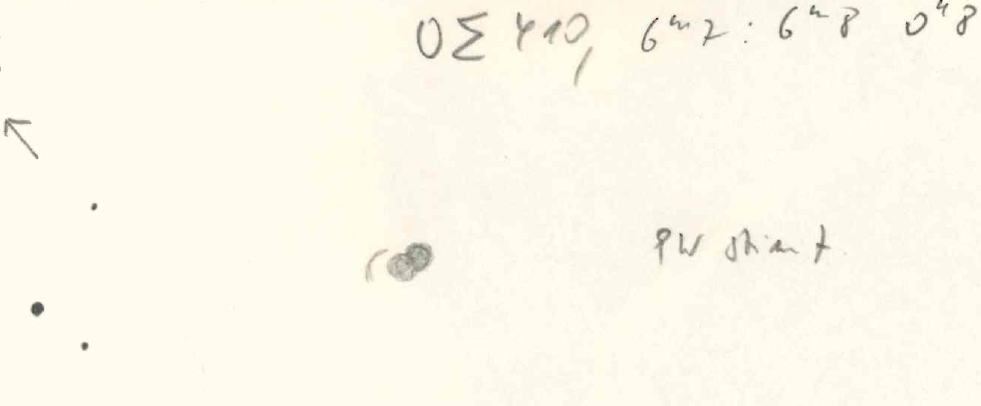
|
Robert Zebahl
Leipzig (Germany) |
152mm (240x) |
AB: 07.08.2022: Zwei klar sichtbare Beugungsscheibchen, die sich leicht berühren. In wenigen Momenten ist ein Hauch von Trennung möglich. Ansatzweise ist ein sehr geringer Helligkeitsunterschied erkennbar. |
|
Mark McCarthy
Fremont (California/USA) |
152mm (245x) |
AB: Near equal, hairline split at best moments at 175x, good split at 245x. Blue-white stars with perfect airy disks! Physical with 1152-year period, is is nearing periastron and will make a relatively quick turn around the primary in the coming decades |
|
Robert Zebahl
Leipzig (Germany) |
152mm (270x) |
Alle vier Komponenten einfach sichtbar. Das Paar AB zeigt zwei deutliche, gleichhelle, sich überlappende Beugungsscheibchen. |

|
Frederik Wanink
Itterbeck (Germany) |
254mm (640x) |
AB: gleich hell, getrennt |

|
|
|
|
HDS2947 |
|
|
7m.3 |
8m.1 |
0.2" |
111° |
2021 |
Del |
20h40m35.25s / +15°38'35.30" |
|
|
Mark McCarthy
Fremont (California/USA) |
508mm (1067x) |
With apodising mask. Not round is best I can say, marginal. Coming off apastron and only getting more difficult. Discovered 1991 by the Hipparcos satellite at 0.2" |
|
|
|
|
BU152 |
|
|
7m.2 |
8m.8 |
1.2" |
82° |
2016 |
Cep |
20h42m16.81s / +57°23'07.40" |
|
|
Mark McCarthy
Fremont (California/USA) |
152mm (245x) |
Beautifully fine, 2 delta mag, just split with 175x, better split at 245x. StelleDoppie says physical with a 737-year period, however there is no parallax range overlap (-25%), so they are not actually gravitationally bound! |
|
|
|
|
STF2723 |
|
AB |
7m.0 |
8m.3 |
1.0" |
140° |
2018 |
Del |
20h44m54.58s / +12°18'45.60" |
|
|
Mark McCarthy
Fremont (California/USA) |
203mm (333x) |
Very nice, light blue A and light yellow B, fine split, almost 2 delta mag. Really nice pair |
|
|
|
★★
|
STF2725 |
|
AB |
7m.5 |
8m.2 |
6.2" |
12° |
2019 |
Del |
20h46m13.31s / +15°54'26.40" |
|
|
Robert Zebahl
Leipzig (Germany) |
16x70 |
02.09.2021: Der Doppelstern erscheint im richtigen Positionswinkel deutlich länglich, mehr aber auch nicht. |
|
René Merting
Drachhausen (Germany) |
100mm (32x) |
bei 32x ein schöner Kontrast zum 15' nördlich stehenden viel helleren Sternpaar STF2727 - hier bei dem wesentlich schwächeren Sternpaar zeigt sich bei 32x die Komponente B knapp getrennt nördlich von A - Helligkeitsunterschied etwas mehr als eine halbe Magnitude, aber Komponente A ist noch deutlich schwächer als die Komponente B von STF2727 |
|
Sarah Gebauer
Germany |
100mm (45x) |
das Doppel lässt sich bei 45x sauber trennen und bildet mit Gamma2 Delphini ein optisches Doppel-Doppel, da beide Doppelsterne sehr gut in ein Gesichtsfeld passen |

|
Sarah Gebauer
Germany |
100mm (80x) |
01.10.23: südwestlich versetzt von Gamma2 Del zeigt STF 2725 eine dunkelgelb, matt schimmernde A-Komponente und eine dicht stehende, sauber getrennte B-Komponente, die silbrig wirkt |
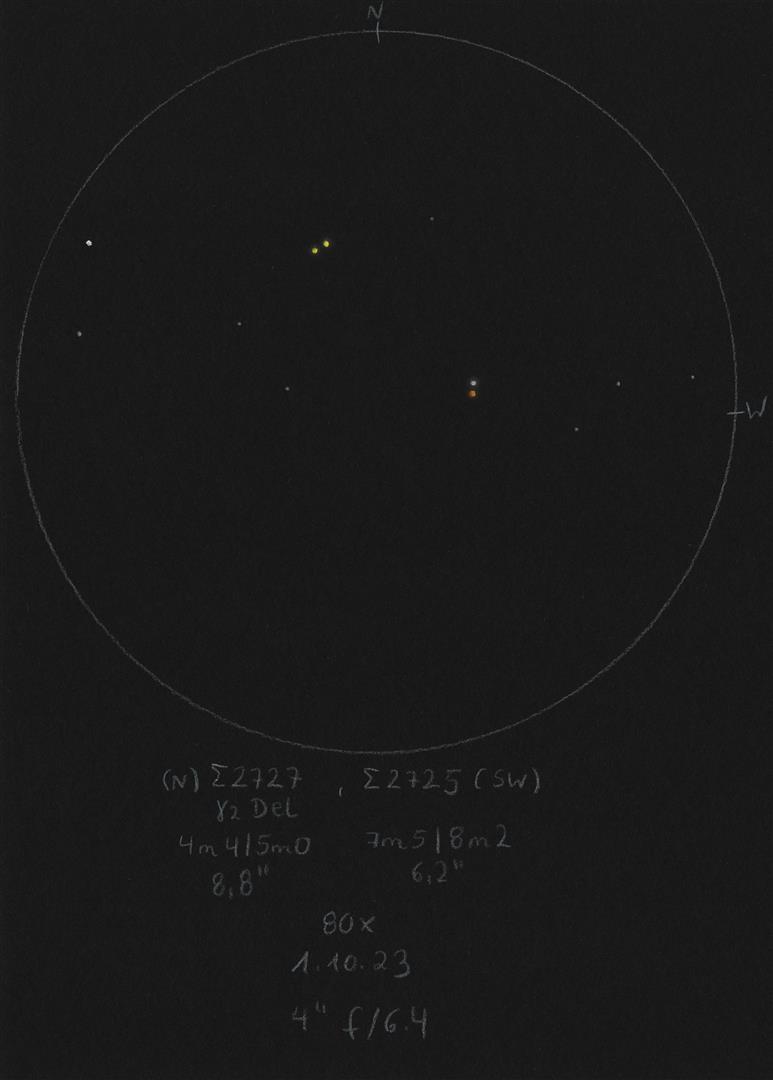
|
Uwe Pilz
Leipzig (Germany) |
105mm (66x) |
im selben Feld mit gamma Del |
|
Uwe Pilz
Leipzig (Germany) |
105mm (88x) |
|
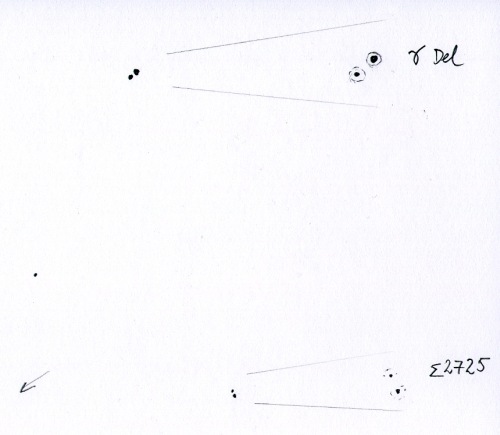
|
Robert Zebahl
Leipzig (Germany) |
152mm (30x) |
11.09.2021: Getrennt, aber noch sehr dicht zusammenstehende Komponenten mit moderatem Helligkeitsunterschied. |
|
Mark McCarthy
Fremont (California/USA) |
203mm (205x) |
OR Del. Light yellow stars, half delta mag, wide. Physical pair with a 2945.18 year period. In same field with bright pair STF 2727 |
|
Mark McCarthy
Fremont (California/USA) |
317mm (553x) |
Super wide, 1 magnitude difference, both faint yellow-white. |
|
Mark McCarthy
Fremont (California/USA) |
508mm (333x) |
Easy, half delta mag and wide. I was after the super close WSI 110 Aa-Ab 0.1" but had no hope of seeing it. |
|
Karsten Kopp
Köln (Germany) |
600mm (180x) |
Leicht zu trennender Doppelstern mit leichtem Helligkeitsunterschied von ca. 0,5 mag. Komponente A leuchtet weißlich und die Komponente B b gelblich. |
|
|
Berthold Fuchs
Wiesbaden (Germany) |
130mm |
enger DS |
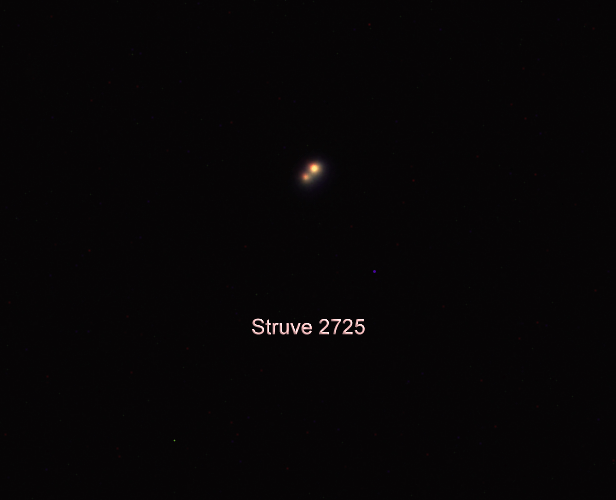
|
|
|
★★
|
STF2727, 12 Del, gamma Del |
|
AB |
4m.4 |
5m.0 |
8.8" |
266° |
2020 |
Del |
20h46m39.50s / +16°07'27.40" |
|
|
Christopher Hay
Seeheim (Germany) |
8x42 |
Auf Stativ. Eindeutig gestreckt, wobei das östliche Ende des Mini-Strichs (d.h. Komponente A) deutlich heller als das andere Ende ist. Positionswinkel ohne vorherige Kenntnis auf 240° geschätzt. |
|
Christopher Hay
Seeheim (Germany) |
15x45 |
Fernglas mit interner Stabilisierung, handgehalten. Eine sehr gestreckte 8 ganz kurz vor der Trennung. Laut Stelledoppie ein physikalischer Doppelstern mit einer Periode von 3249 Jahren. Beobachtet im Juni 2019, Trennung dann 8,89“. Wird laut Stelledoppie in 2030 8,67“ sein. |
|
Robert Zebahl
Leipzig (Germany) |
16x70 |
02.09.2021: Wunderschöner Anblick in sehr schönem Umfeld. Einfach trennbar, aber recht geringer Abstand. Ein eher kleiner Helligkeitsunterschied ist deutlich erkennbar. Vor allem die Hauptkomponente erscheint goldfarben. |
|
Christopher Hay
Seeheim (Germany) |
18x80 |
Sauber getrennt mit haarfeinem Schwarz zwischen den Komponenten. Juli 2019 beobachtet bei einem Abstand von 8,89“. Ein hervorragendes Testobjekt für die Auflösungsfähigkeit von Großferngläsern. Struve 2725 einige Bogenminuten südwestlich bietet ein weiteres Testobjekt für Vergrößerungen >20x. |
|
Christopher Hay
Seeheim (Germany) |
40x80 |
Weit getrennt, eine visuell starke Erscheinung. Komponente A erscheint gelblich im Vergleich zu Komponente B. Struve 2725 im selben Gesichtsfeld fein getrennt. |
|
René Merting
Drachhausen (Germany) |
100mm (32x) |
bei 32x knapp getrennt - Komponente A ist schön gelb, B im Westen ist gut 1.5 Magnituden schwächer (lt. Stelle Doppie Helligkeitsunterschied nur 0.67 mag) - zusammen mit dem wesentlich schwächeren STF2725 gut 15' südlich sehenswert |
|
Sarah Gebauer
Germany |
100mm (45x) |
bei 45x sauber getrennt und zusammen mit dem DS STF 2725 in einem Gesichtsfeld, dadurch wirken sie wie ein optisches Doppel-Doppel, sehr schön! Beide DS bilden auch einen auffälligen Lichthof |

|
Sarah Gebauer
Germany |
100mm (80x) |
01.10.23: bei 80-fach zeigt sich der DS sehr hell, gut getrennt und strahlend maisgelb - schön zusammen mit dem südwestlich stehenden Doppelstern STF 2725, der ebenfalls leicht Farbe zeigt |

|
Uwe Pilz
Leipzig (Germany) |
105mm (66x) |
im selben Feld mit STF2725 |
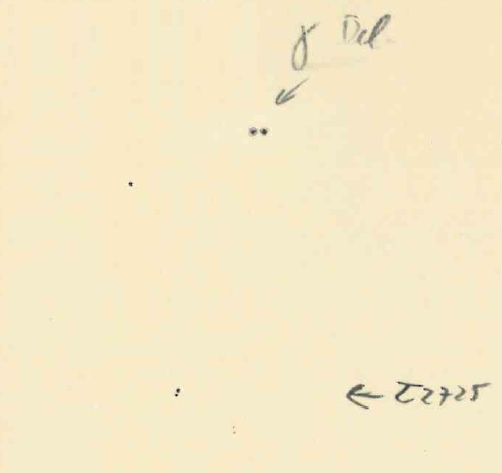
|
Uwe Pilz
Leipzig (Germany) |
105mm (144x) |
schon trennbar bei 26x. In einem Feld mit STF2725 |

|
Robert Zebahl
Leipzig (Germany) |
152mm (30x) |
11.09.2021: Helligkeitsunterschied gut sichtbar. Hellgelb/goldfarben & zitronengelb. |
|
Mark McCarthy
Fremont (California/USA) |
152mm (175x) |
Gam2 Del. Gorgeous, light yellow-orange A and blue-green B, I like this better than Albireo. Physical with 3249-year period, it will slowly tighten the next couple of hundred years |
|
Mark McCarthy
Fremont (California/USA) |
152mm (285x) |
Gam 2 Del. ! Most beautiful light orange-yellow A and ~1 delta mag blue-green B |
|
Mark McCarthy
Fremont (California/USA) |
317mm (277x) |
Gamma Delphinus. Rich gold-yellow A, blue-white B, ~6" separation estimated by eye. Very pretty pair. |
|
Karsten Kopp
Köln (Germany) |
600mm (180x) |
Recht heller und auch leicht zu trennender Doppelstern mit ca. 0,5 mag Helligkeitsunterschied. Komponente A leuchtet schön gelblich und Komponente B weiß. |
|
|
|
★
|
STT413, 54 Cyg, lambda Cyg |
|
AB |
4m.7 |
6m.3 |
0.9" |
1° |
2020 |
Cyg |
20h47m24.53s / +36°29'26.70" |
|
|
Robert Zebahl
Leipzig (Germany) |
102mm (280x) |
Das Beugungsscheibchen der Hauptkomponente wirkte gen Norden dauerhaft leicht elongiert. Die Luft war hier aber zu unruhig für eine genaue Beobachtung. |
|
Uwe Pilz
Leipzig (Germany) |
105mm |
schwierig |
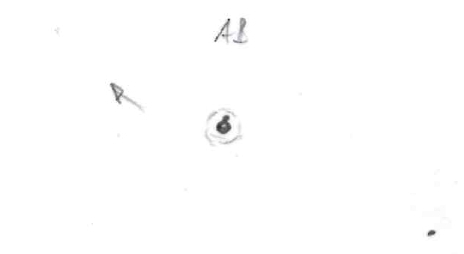
|
Mark McCarthy
Fremont (California/USA) |
152mm (175x) |
Very unequal mag snowman. Physical with an 800-year period |
|
Robert Zebahl
Leipzig (Germany) |
152mm (300x) |
Beobachtung mit einem Achromaten. Die schwächere Komponente ist als dauerhafte Aufhellung im ersten Beugungsring sichtbar. |
|
Robert Zebahl
Leipzig (Germany) |
152mm (300x) |
24.08.2020: Beobachtung mit einem ED-Refraktor. Bei 171x ansatzweise, bei 200x klar als '8' erkennbar. Bei 300x zwei deutliche, sich überlappende Beugungsscheibchen unterschiedlich heller Komponenten. |
|
Frederik Wanink
Itterbeck (Germany) |
254mm (640x) |
schwierig aber getrennt |
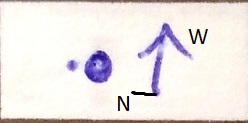
|
Mark McCarthy
Fremont (California/USA) |
317mm (553x) |
Lambda Cyg: ~1.5 delta mag, blue-white. Bright mess resolves to two disks 0.8-1.0", with seeing. |
|
|
|
|
BU155 |
|
AB |
7m.4 |
8m.1 |
0.7" |
40° |
2018 |
Cyg |
20h51m05.41s / +51°25'01.70" |
|
|
|
|
AC |
7m.4 |
12m.6 |
14.8" |
40° |
2015 |
|
|
|
|
|
|
AD |
7m.4 |
11m.5 |
191.8" |
48° |
2015 |
|
|
|
|
Robert Zebahl
Leipzig (Germany) |
152mm (300x) |
AB: 07.08.2022: Bei 200x leicht länglich, bei 240x deutlich länglich, bei 300x in ruhigen Momenten leicht eingekerbt. |
|
Mark McCarthy
Fremont (California/USA) |
152mm (380x) |
AB: Can tell it is not single ay 175x, and appears slightly notched at 245x. Strongly notched but not split at 380x. WDS physical with a 764-year period, unfortunately there is no parallax data for the companion. Burnham discovered with his 6-inch at 0.6" and notes "A fine pair, but no material change." He does not say whether he split it, though to do so would require a night of exceptional seeing to carry high magnification. Dembowski -- who had a 7-inch -- must also have had a good night to be able to put it under the wire for measurement. The thing about Burnham is he was a very attentive observer, I could imagine many others passing this over had they not studied the airy disk carefully |
|
Frederik Wanink
Itterbeck (Germany) |
254mm (640x) |
AB: getrennt |

|
|
|
|
A613 |
|
|
9m.1 |
9m.0 |
0.7" |
324° |
2018 |
Del |
20h51m54.49s / +05°44'29.50" |
|
|
Mark McCarthy
Fremont (California/USA) |
203mm (533x) |
Getting the briefest hairline split, but this one is very marginal seeing is a problem |
|
|
|
|
STT418 |
|
|
8m.2 |
8m.3 |
0.9" |
283° |
2018 |
Cyg |
20h54m49.84s / +32°42'23.20" |
|
|
Mark McCarthy
Fremont (California/USA) |
152mm (285x) |
Incredibly fine split, near equal. Suspected at 175x. Physical with a 709-year period |
|
Frederik Wanink
Itterbeck (Germany) |
254mm (640x) |
getrennt, gleich hell |
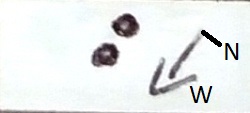
|
Mark McCarthy
Fremont (California/USA) |
317mm (553x) |
Near equal 1" split, white. |
|
|
Frederik Wanink
Itterbeck (Germany) |
254mm |
|

|
|
|
★
|
STF2737, epsilon Equ, 1 Equ |
|
AB |
6m.0 |
6m.3 |
0.0" |
125° |
2021 |
Equ |
20h59m04.54s / +04°17'37.80" |
|
|
|
|
AB-C |
5m.3 |
7m.0 |
10.6" |
67° |
2019 |
|
|
|
|
|
|
AD |
6m.0 |
13m.1 |
69.3" |
293° |
2013 |
|
|
|
|
René Merting
Drachhausen (Germany) |
12x50 |
AB-C: in ruhigen Momenten präsentieren sich beide Sterne länglich mit Einschnürung, dann sieht das System aus wie eine kleine Ameise |
|
Robert Zebahl
Leipzig (Germany) |
70mm (22x) |
AB-C: Bei 22x gut trennbar, noch relativ dicht zusammen mit deutlichem Helligkeitsunterschied. Bei 44x wirkte AB eher weiß. Die Farbe von C war nicht erkennbar. |
|
Christopher Hay
Seeheim (Germany) |
80mm (30x) |
AB-C: Gut getrennt, C bläulich, AB ohne bestimmten Farbeindruck, ein schönes Paar bei dieser Vergrößerung. Laut Stelledoppie bilden B und C ein physikalisches Paar mit einer Umlaufzeit von 5200 Jahren, A und B sind wiederum ein enges physikalisches Paar mit einer Umlaufzeit von 104 Jahren. |
|
René Merting
Drachhausen (Germany) |
100mm (32x) |
AB-C: bei 32x knapp getrennt - Komponente AB mit einem schönen cremegelb, C steht nordöstlich und ist gut 1.5 Größenklassen schwächer |
|
Sarah Gebauer
Germany |
100mm (45x) |
AB-C: bei 45x ganz eng, aber sauber getrennt, die hellere Komponente AB ist gelbstichig und die nordöstliche, schwächere Komponente C hat phasenweise einen Blaustich, wie ein ganz enger, ganz kleiner und schwächerer Albireo |
|
Sarah Gebauer
Germany |
100mm (49x) |
AB-C: 24.09.23: mit 49x sind AB und C schmal, aber sauber getrennt - A zeigt sich auf den ersten Blick richtig hell zitronengelb, B eher kühlweiß bis grau im Nordosten - mit 80x verändert sich der Farbton von AB in Richtung Orange - das übrige Sternumfeld ist bis auf wenige schwache Sternen und einen etwas helleren im Südwesten sehr leer |
|
Mark McCarthy
Fremont (California/USA) |
317mm (553x) |
AB-C: Easy yellow stars, very wide, 1 delta mag. |
|
Mark McCarthy
Fremont (California/USA) |
317mm (553x) |
AB: 1 Equ / Epsilon Equ / Strongly feel an oval AB pairing, marginal |
|
René Merting
Drachhausen (Germany) |
320mm (45x) |
AB-C: bei 45x schon getrennt - bei 72x ordentlich getrennt - AB zeigt sich in einem schönen, strahlenden Hellgelb und mit einem großen Halo bis über den Begleiter hinaus, die etwa 2 Größenklassen schwächere B-Komponente strahlt weißgelblich bis weiß |
|
|
Berthold Fuchs
Wiesbaden (Germany) |
130mm |
AB-C: enger DS |
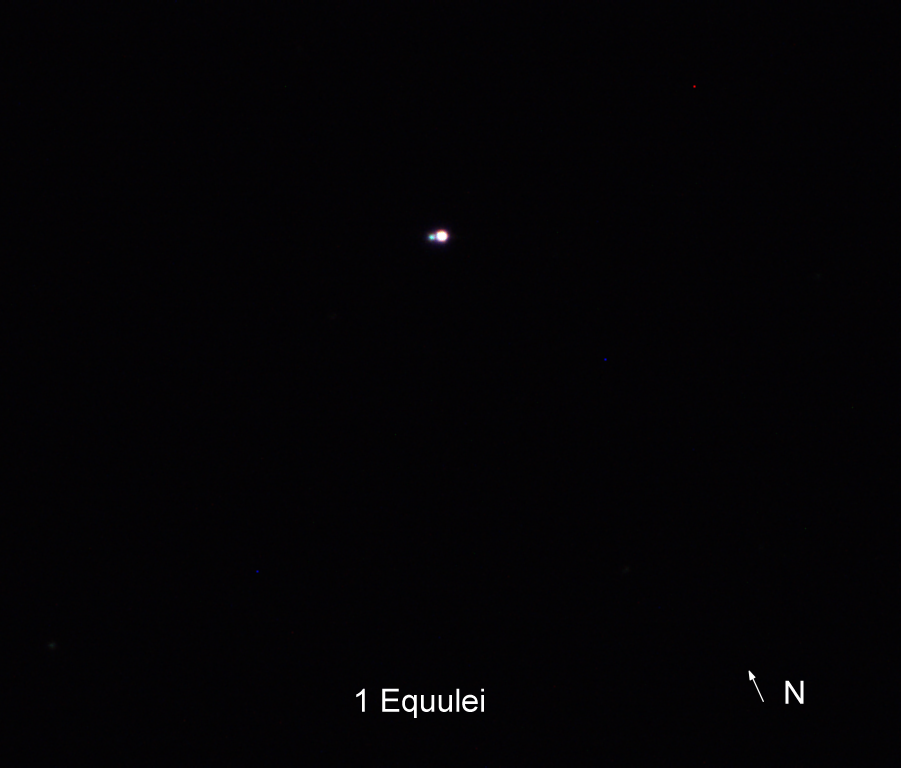
|
|
|
|
59 Cyg, STF2743 |
MCA65 |
Aa-Ab |
4m.8 |
7m.6 |
0.1" |
334° |
2015 |
Cyg |
20h59m49.55s / +47°31'15.40" |
|
|
|
STF2743 |
AB |
4m.7 |
9m.4 |
21.0" |
353° |
2012 |
|
|
|
|
|
STF2743 |
AC |
4m.7 |
11m.6 |
26.5" |
140° |
2012 |
|
|
|
|
|
STF2743 |
AD |
4m.7 |
11m.2 |
39.3" |
222° |
2012 |
|
|
|
|
|
STF2743 |
AE |
4m.7 |
12m.0 |
70.6" |
59° |
2003 |
|
|
|
|
Christopher Hay
Seeheim (Germany) |
125mm (64x) |
AB: Weit getrennt und ein auffälliges Paar, da etwas ausserhalb der südlich angrenzenden Sternwolke am Schwanz des Schwans. A-Komponente erscheint leicht gelblich. Der Reiz liegt in der B-Komponente mit Delta-Mag 4m6, der sich als feinen graublauen Lichtpunkt präsentiert. Alias 59 Cygni. |
|
Sarah Gebauer
Germany |
254mm (42x) |
AB: bei 42-fach knapp, aber gut getrennt, noch dicht beieinander - A zeigt einen leichten Farbton in Richtung zartem Dunkelgelb - B ist bedeutend schwächer wirkt ganz grau dagegen |
|
René Merting
Drachhausen (Germany) |
320mm (72x) |
AB: bei 45x ist Komponente B nördlich von A erkennbar - Komponente A strahlend weiß, bei B ist keine Farbe erkennbar, mindestens 4 Größenklassen Helligkeitsunterschied
AD: bei 72x ist Komponente D südwestlich von A in doppeltem Abstand wie AB erkennbar
AE: bei 72x ist Komponente E nordöstlich von A in doppeltem Abstand wie AD und noch schwächer als D erkennbar |
|
|
|
|
KUI102 |
|
|
6m.2 |
8m.1 |
0.2" |
191° |
2021 |
Equ |
21h00m03.95s / +07°30'58.20" |
|
|
Mark McCarthy
Fremont (California/USA) |
508mm (667x) |
Overlapping disks, strongly notched, white stars, PA to south. Currently 0.22" it will continue to widen into the 2040s. 58.4-year period |
|
|
|
★
|
BU69 |
|
AB |
8m.3 |
9m.8 |
0.4" |
6° |
2017 |
Vul |
21h02m36.08s / +21°41'28.20" |
|
|
Mark McCarthy
Fremont (California/USA) |
317mm (553x) |
I sense overlapping disks at 553x, but marginal. |
|
|
|
★
|
BU1138 |
|
AB |
7m.1 |
7m.3 |
0.1" |
172° |
2006 |
Cyg |
21h02m48.62s / +45°50'56.00" |
|
|
Mark McCarthy
Fremont (California/USA) |
508mm (1067x) |
Notched elongation with seeing and apodising mask, white, can tell A and B's orientation by difference in magnitude. Current separation 0.155". 314 year period, it will only make modest position angle change in my time. Burnham discovered in 1888 with the Lick 36-inch at 0.3"! It seems Hough also discovered it in 1888 but published his results later, HO 282 |
|
|
|
|
STF2744 |
|
AB |
6m.8 |
7m.3 |
1.2" |
107° |
2020 |
Aqr |
21h03m03.09s / +01°31'55.90" |
|
|
|
|
AC |
6m.8 |
12m.9 |
97.8" |
99° |
2000 |
|
|
|
|
|
|
AD |
6m.8 |
14m.3 |
73.9" |
300° |
2011 |
|
|
|
|
Frederik Wanink
Itterbeck (Germany) |
254mm (640x) |
AB: getrennt |
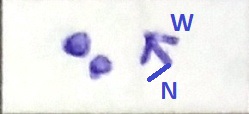
|
Mark McCarthy
Fremont (California/USA) |
317mm (553x) |
AB: Split, ~1.5", near equal yellow-orange stars |
|
René Merting
Drachhausen (Germany) |
320mm (144x) |
AB: bei 144x ist das Pärchen als Ameise zu erkennen, nicht zu sauber zu trennen - warum nur habe ich da nicht höher vergrößert, vielleicht vergessen zu diktieren? |
|
|
|
|
STF2749 & SE3 |
STF2749 |
A-BC |
8m.1 |
9m.4 |
3.2" |
179° |
2018 |
Equ |
21h04m45.11s / +03°32'02.00" |
|
|
|
STF2749 |
AC |
8m.1 |
9m.4 |
3.5" |
176° |
2020 |
|
|
|
|
|
SE3 |
AD |
8m.0 |
9m.6 |
114.3" |
78° |
2016 |
|
|
|
|
|
SE3 |
BC |
9m.6 |
10m.2 |
0.7" |
136° |
2017 |
|
|
|
|
Mark McCarthy
Fremont (California/USA) |
203mm (533x) |
STF2749 (AC): Pretty yellow A and slightly red B, about 2 delta mag, wide about 3" [several other pairs in system] |
|
René Merting
Drachhausen (Germany) |
320mm (144x) |
STF2749 (A-BC): bei 144x ist das Doppel etwas mehr als knapp getrennt zu erkennen, A strahlt schön weiß, die graue BC-Komponente im Süden strahlt etwa 1,5 bis 2 Größenklassen schwächer |
|
|
|
★★★
|
STF2758, 61 Cyg |
|
AB |
5m.2 |
6m.0 |
31.9" |
154° |
2021 |
Cyg |
21h06m53.95s / +38°44'57.90" |
|
|
Christopher Hay
Seeheim (Germany) |
8x42 |
Auf Stativ. Klar getrennt, nordliche Komponente A deutlich heller als B. Beide orange, wobei A deutlich gelblicher als B (Himmelsqualität ähnlich wie bei früherer 15x45 und 10x42 Beobachtung). Erscheint auch handgehalten mit 8x42 getrennt, aber Handzittern macht dies unsicher |
|
Christopher Hay
Seeheim (Germany) |
15x45 |
Klar, fast schon weit, getrennt. Beide Komponenten gehen in’s Orangene. Die hellere, nördlichere Komponente scheint dabei etwas gelblich. Mit 10x42 auch klar getrennt, wobei nördlichere Komponente in’s Orangene geht, südlichere Komponente mit unbestimmtem Farbeindruck (Himmel zur Zeit der Beobachtung nicht ganz dunkel genug um 61 Cyg mit bloßem Auge zu sehen). Piazzi’s Flying Star, läuft mehr als 5” jährlich Richtung Nordosten. Echter physikalischer Doppelstern mit einer Periode von 678 Jahren. |
|
Robert Zebahl
Leipzig (Germany) |
16x70 |
14.06.2021: Schöner Anblick. Hellorange & orange. |
|
Sarah Gebauer
Germany |
100mm (21x) |
20.09.23: der DS hebt sich bei 20-fach sehr stark vom Umfeld ab, das typisch für das Sternbild Schwan fein und üppig funkelnd wirkt - absolut mittig, wie auf dem Präsentierteller, zeigt sich der DS kupferbraun leuchtend mit einem geringen Helligkeitsunterschied, ein fantastischer Anblick - bei 49-fach ist der Farbeindruck leicht abgeschwächt, auch der Gesamteindruck leidet aufgrund geringeren Gesichtsfeldes |
|
René Merting
Drachhausen (Germany) |
100mm (32x) |
bei 32x sind beide Sterne gut getrennt, Komponente A strahlt in einem schmutzig dunklem gelb, schwächere Komponente B leicht orange |
|
Uwe Pilz
Leipzig (Germany) |
105mm (200x) |
gelb und orange. Der weitere Stern im Bild ist TYC 3168-6781 |
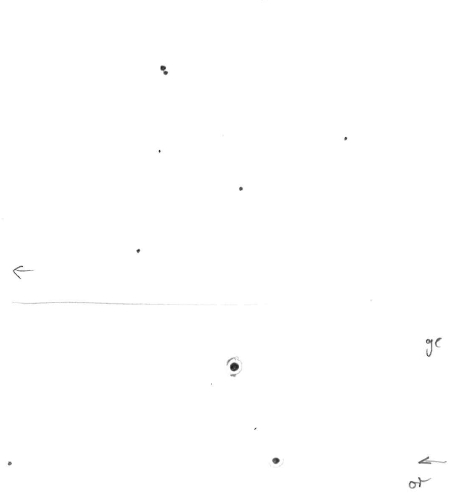
|
Uwe Pilz
Leipzig (Germany) |
105mm (200x) |
TYC 3168-5901 kann dazu dienen, den sich ändernden Positionswinkel abzuschätzen. |
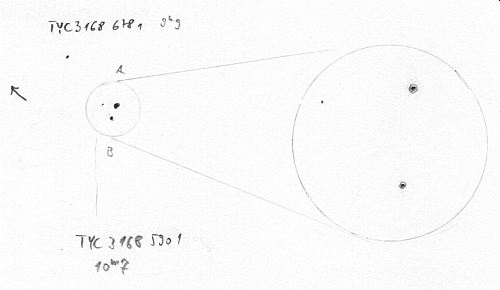
|
Jörg S. Schlimmer
Germany |
127mm (203x) |
Intensive Farbe |
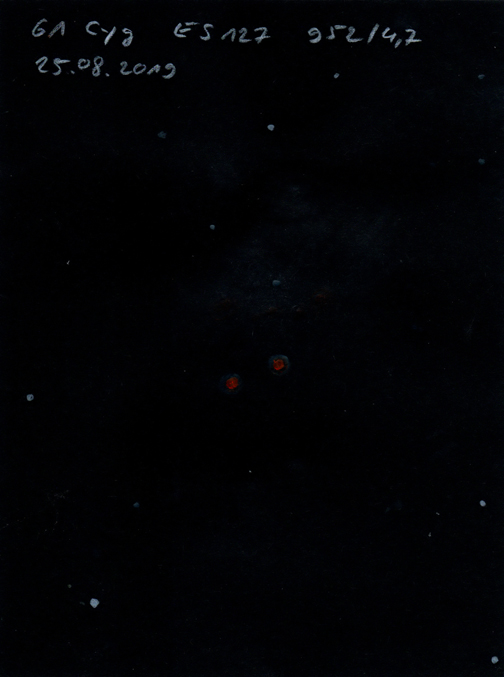
|
Robert Zebahl
Leipzig (Germany) |
152mm (22x) |
24.06.2020: Wunderschön getrennt, hell, auffällig, besonders die Farben: hell orange und orange. |
|
Mark McCarthy
Fremont (California/USA) |
152mm (175x) |
61 Cyg. Stunning pair, yellow A and orange B, half delta mag, wide. Spectral class K5V+K7V (yellow-orange/yellow-orange). Only 11.38 light years away! Physical with a 618.6911-year period, it is now at apastron. There are 18 stars in the system but none of the visible ones are, and those only detected in K-band are uncertain |
|
Mark McCarthy
Fremont (California/USA) |
203mm (121x) |
61 Cyg. Nice near equal wide orange pair, bright [18 stars in system -- if so should be an OC] |
|
René Merting
Drachhausen (Germany) |
320mm (45x) |
bei 32x sind beide Sterne gut getrennt, Komponente A strahlt in einem schmutzig dunklem gelb, schwächere Komponente B leicht orange |
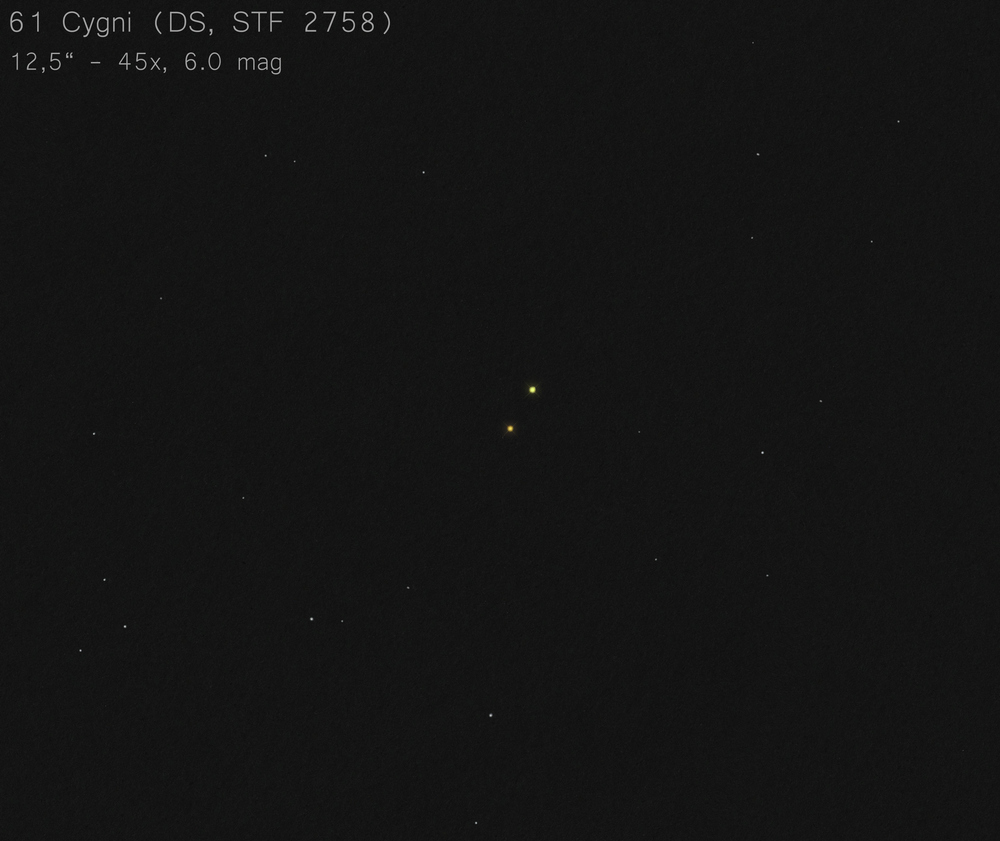
|
Uwe Pilz
Leipzig (Germany) |
320mm (121x) |
Der Doppelstern bildet 2021 mit dem 11-mag-Stern ein fast gleichschenkliges Dreieck |

|
|
Berthold Fuchs
Wiesbaden (Germany) |
130mm |
einfacher DS |
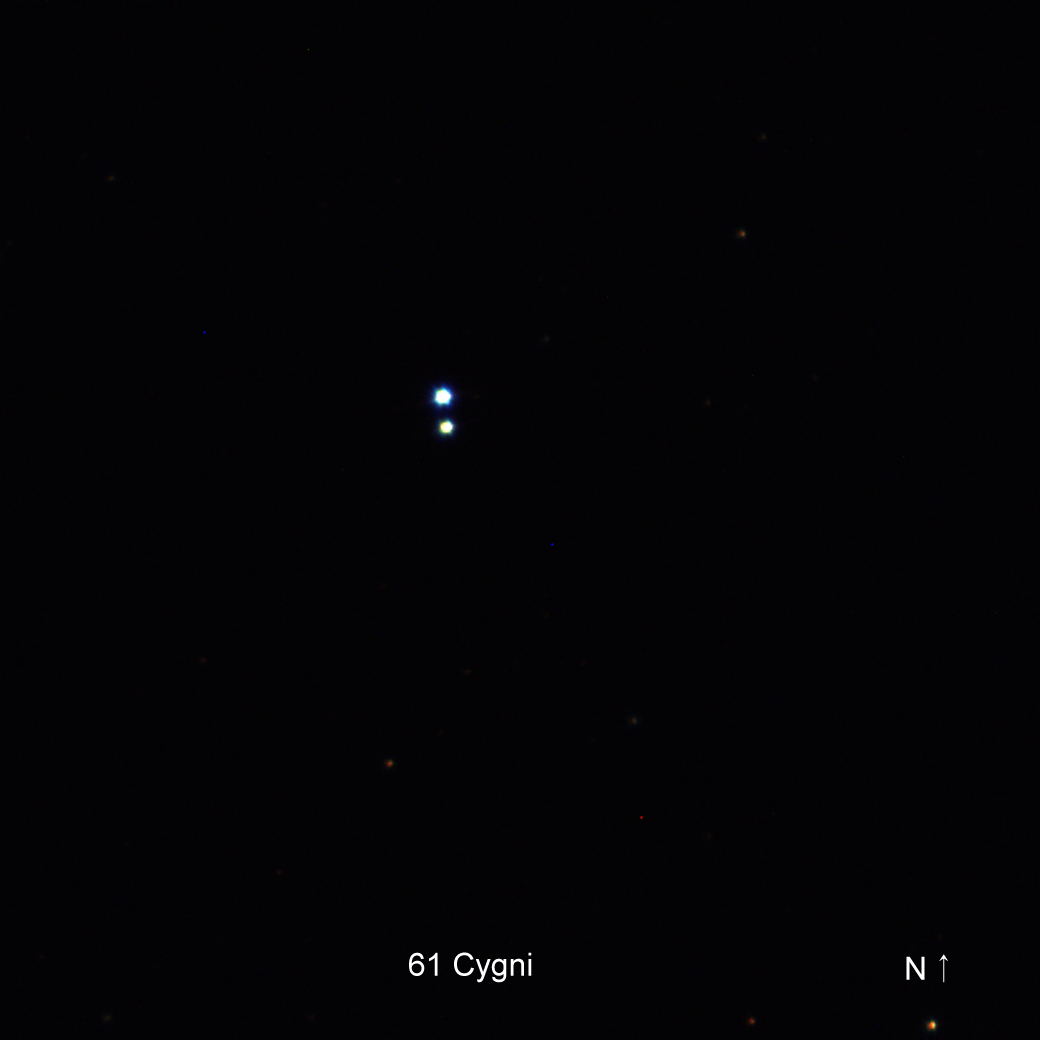
|
|
|
|
A884 |
|
|
8m.7 |
9m.5 |
0.4" |
111° |
2016 |
Cyg |
21h13m20.32s / +46°54'55.50" |
|
|
Mark McCarthy
Fremont (California/USA) |
508mm (533x) |
Excellent pair, nicely split, nearly 1 delta mag, white A and blue-white B |
|
|
|
|
BU270 & S781 |
BU270 |
AB |
7m.4 |
9m.4 |
0.4" |
342° |
2021 |
Equ |
21h13m27.24s / +07°13'04.90" |
|
|
|
BU270 |
AB-C |
7m.2 |
14m.0 |
30.8" |
26° |
2014 |
|
|
|
|
|
S781 |
AB-D |
7m.2 |
7m.2 |
184.1" |
172° |
2014 |
|
|
|
|
René Merting
Drachhausen (Germany) |
12x50 |
S781 (AB-D): ein sehr helles Sternpaar, weit auseinander stehend - beide gehen gerade so als Doppelsternpaar durch, im Umfeld gibt es einige gleich helle Sterne |
|
Mark McCarthy
Fremont (California/USA) |
80mm (13x) |
S781 (AB-D): Finder split, super-wide, equal yellow-orange stars. I looked at the time in case one of these stars had a close pair, I did not see any -- checking data later one of them is a BU 270, 7.42/9.40 0.5" |
|
René Merting
Drachhausen (Germany) |
320mm (45x) |
S781 (AB-D): bei 45x sind die beiden Sterne deutlich getrennt voneinander zu erkennen, beide Komponenten sind gleich hell und wirken weiß |
|
|
|
★
|
H1 48 |
|
|
7m.2 |
7m.3 |
0.8" |
246° |
2020 |
Cep |
21h13m42.46s / +64°24'15.10" |
|
|
Mark McCarthy
Fremont (California/USA) |
152mm (245x) |
This was a surprise since most Herschel doubles are wide. Can tell is not single at 175x, and I get a near equal hairline split at 245x |
|
Robert Zebahl
Leipzig (Germany) |
152mm (270x) |
Deutlich länglich, gleichhell mit teils erkennbarer, leichter Einschnürung. |
|
Frederik Wanink
Itterbeck (Germany) |
254mm (640x) |
getrennt |

|
|
|
|
STF2783 |
|
|
7m.7 |
8m.1 |
0.7" |
348° |
2019 |
Cep |
21h14m04.90s / +58°17'49.80" |
|
|
Mark McCarthy
Fremont (California/USA) |
152mm (175x) |
Challenging. Near equal white stars, elongated at lower powers, and I can get stronger notching with more magnification, until I had hairline split with seeing at 570x. 2.0" at discovery, so no problem for Struve! WDS gives physical with a 1760-year period. There is no parallax data for the primary, and the secondary is entirely missing |
|
Frederik Wanink
Itterbeck (Germany) |
254mm (640x) |
nicht leicht trennbar wegen Luftunruhe |
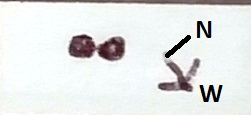
|
|
|
|
A883 & STF2775 & LYR39 |
A883 |
AB |
7m.5 |
8m.3 |
0.1" |
264° |
2021 |
Aqr |
21h14m41.11s / -00°49'54.90" |
|
|
|
STF2775 |
AB-C |
7m.5 |
10m.4 |
21.3" |
178° |
2014 |
|
|
|
|
|
STF2775 |
AB-D |
7m.5 |
11m.1 |
170.3" |
200° |
2014 |
|
|
|
|
|
LYS39 |
AF |
7m.5 |
10m.5 |
185.0" |
297° |
2014 |
|
|
|
|
|
LYS39 |
AH |
7m.5 |
12m.2 |
262.6" |
126° |
2014 |
|
|
|
|
|
STF2775 |
DE |
11m.1 |
11m.5 |
74.5" |
125° |
2015 |
|
|
|
|
|
LYS39 |
FG |
10m.5 |
12m.6 |
20.0" |
11° |
2015 |
|
|
|
|
René Merting
Drachhausen (Germany) |
320mm (45x) |
STF2775 (AB-C): bei 45x ist die 2-3 Größenklassen schwächere, dunkelgraue C-Komponente ordentlich getrennt südlich von der reinweißen AB-Komponente zu sehen |
|
|
|
|
AGC13, tau Cyg |
|
AB |
3m.8 |
6m.6 |
1.1" |
190° |
2017 |
Cyg |
21h14m47.49s / +38°02'43.10" |
|
|
Mark McCarthy
Fremont (California/USA) |
203mm (667x) |
Tau Cyg. I get a persistent brightening in A's diffraction. The brightening holds steady in one spot of A's diffraction wobble, and it's a different color: orange compared with A's yellow-white. Needed the 8-inch mask to reduce A's disk size |
|
|
|
|
STF2807 |
|
|
8m.7 |
8m.8 |
1.8" |
310° |
2019 |
Cep |
21h17m33.47s / +82°31'03.70" |
|
|
Robert Zebahl
Leipzig (Germany) |
70mm (128x) |
Gerade noch trennbar ohne Helligkeitsdifferenz. |
|
|
|
|
BU163 |
|
AB |
7m.3 |
8m.9 |
1.0" |
257° |
2021 |
Equ |
21h18m34.85s / +11°34'08.20" |
|
|
Mark McCarthy
Fremont (California/USA) |
152mm (245x) |
B is just detectable, very, very faint, tangent to or touching A. Physical with a 78.54-year period, it is at apastron and will remain there for another 20 years before making a rapid closure |
|
Mark McCarthy
Fremont (California/USA) |
203mm (533x) |
Can resolve in 20" and once know where B is, can split with 8", but B is much fainter and is more a brightening in the first diffraction than at star [Several other fainter pairs] |
|
|
|
★
|
STF2789 |
|
AB |
7m.7 |
7m.9 |
6.9" |
113° |
2019 |
Cyg |
21h19m58.84s / +52°58'44.10" |
Robert Zebahl
Leipzig (Germany) |
70mm (44x) |
Bei 22x beinahe getrennt. Der Doppelstern wirkte insgesamt auffällig orange und bildet ein markantes, nahezu gleichschenkliges Dreieck mit benachbarten Sternen. Bei 44x klar getrennt, relativ dicht zusammen mit geringem Helligkeitsunterschied. |
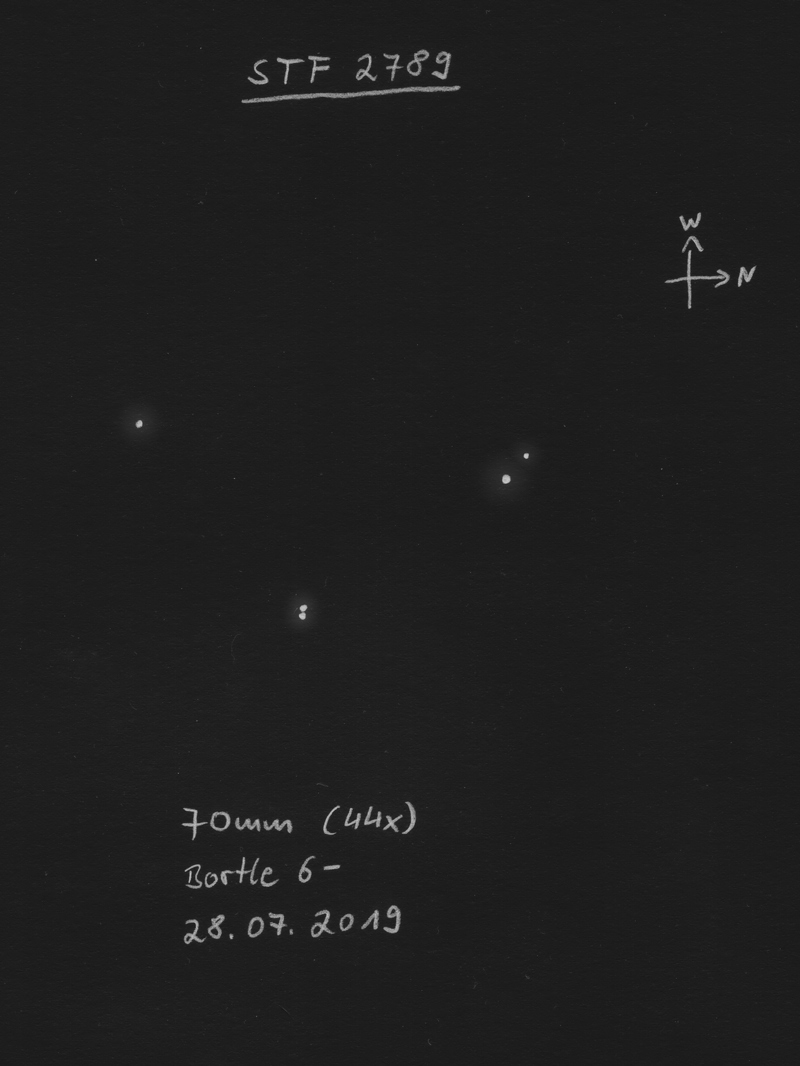
|
René Merting
Drachhausen (Germany) |
100mm (32x) |
bei 32x zwei gleichhelle ganz dicht beieinander stehende weiße Lichtpünktchen, ganz knapp getrennt - wunderschön mit dieser Teleskopöffnung |
|
Mark McCarthy
Fremont (California/USA) |
152mm (175x) |
Well separated equal pair. WDS says physical with a 180 century period, and provides an orbit. 98% parallax range overlap, 565 AU weighted separation, 1.55/1.51 solar mass, and the delta radial velocity is less than the escape velocity, so that's a confirmed gravitational pair |
|
|
|
|
STT437 |
|
AB |
7m.2 |
7m.4 |
2.5" |
19° |
2020 |
Cyg |
21h20m50.12s / +32°27'10.20" |
|
|
Robert Zebahl
Leipzig (Germany) |
63mm (93x) |
15.08.2021: Bei 65x beinahe getrennt. Die Beugungsscheibchen berührten sich noch leicht. Bei 93x sehr saubere Trennung bei geringem Helligkeitsunterschied. |
|
Robert Zebahl
Leipzig (Germany) |
70mm (57x) |
Bei 57x getrennt, aber dicht zusammen. Nahestehender, leicht hellerer Stern in schönem Kontrast. Der Doppelstern zeigt eine deutliche Orangefärbung. Bei 100x geringer Helligkeitsunterschied erkennbar. |
|
René Merting
Drachhausen (Germany) |
76mm (95x) |
bei 95x zeigt sich ein enges äußerst knapp getrenntes Sterndoppel - die B-Komponente im Norden ist maximal eine Viertel Größenklasse schwächer |
|
René Merting
Drachhausen (Germany) |
100mm (107x) |
bei 64x eine schöne 8, die beiden etwa gleich hellen Sterne berühren sich noch ganz leicht und scheinen fast getrennt zu sein - bei 107x ist die Trennung dann knapp, aber deutlich |
|
Uwe Pilz
Leipzig (Germany) |
105mm (200x) |
orange und orangegelb, schön auch bei 88x |

|
Frederik Wanink
Itterbeck (Germany) |
254mm (640x) |
einfach |

|
|
|
|
BU838 |
|
|
7m.9 |
10m.0 |
1.6" |
156° |
2016 |
Equ |
21h20m55.78s / +03°07'05.60" |
|
|
Mark McCarthy
Fremont (California/USA) |
508mm (205x) |
A is white, B is very lightly orange, very close >1", ~2 delta mag, nice pair. Physical with a 1280 year period. Burnham discovered with the 15.5-inch Washburn refractor at 1.29" |
|
|
|
|
STT435 |
|
|
8m.3 |
8m.2 |
0.7" |
239° |
2018 |
Equ |
21h21m23.70s / +02°53'14.60" |
|
|
Frederik Wanink
Itterbeck (Germany) |
254mm (640x) |
nicht als DS gesehen |
|
Mark McCarthy
Fremont (California/USA) |
508mm (333x) |
Clean split, near equal, light orange stars. |
|
|
|
★
|
STFB11 & TOK9001, 1 Peg |
STFB11 |
AB |
4m.2 |
9m.3 |
36.6" |
313° |
2020 |
Peg |
21h22m05.13s / +19°48'15.70" |
|
|
|
STFB11 |
AC |
4m.2 |
12m.9 |
64.3" |
13° |
2017 |
|
|
|
|
|
TOK9001 |
AD |
4m.2 |
9m.6 |
5.3" |
151° |
1993 |
|
|
|
|
René Merting
Drachhausen (Germany) |
18x70 |
STFB11 (AB): ein heller Doppelstern mit einer samtgelben A-Komponente - B gut abgesetzt im Nordwesten von A, ein schwacher grauer Fleck - Helligkeitsunterschied enorm |
|
René Merting
Drachhausen (Germany) |
76mm (29x) |
STFB11 (AB): bei 29x zeigt sich die B Komponente deutlich abgesetzt nordwestlich von A und ist viel schwächer - Komponente A ist gelblich, B eher grau |
|
Uwe Pilz
Leipzig (Germany) |
105mm (88x) |
STFB11 (AB): der helle Stern ist weiß. |
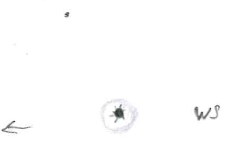
|
Mark McCarthy
Fremont (California/USA) |
317mm (553x) |
STFB11 (AB): 1 Peg: Easy yellow-orange & wide separated B |
|
|
|
|
STF2799 |
|
AB |
7m.4 |
7m.4 |
1.9" |
259° |
2021 |
Peg |
21h28m52.79s / +11°05'05.20" |
|
|
Robert Zebahl
Leipzig (Germany) |
70mm (100x) |
Bei 100x knapp, bei 128x klar getrennt mit gleich hellen Komponenten. |
|
Uwe Pilz
Leipzig (Germany) |
105mm (200x) |
beide Komponenten gelb |

|
Mark McCarthy
Fremont (California/USA) |
152mm (175x) |
Very nice near equal yellow-white stars, closely separated, near M15. WDS uncertain, their parallax ranges do not overlap |
|
Mark McCarthy
Fremont (California/USA) |
203mm (533x) |
Very nice pair, only slightly unequal, ~3" |
|
|
|
★★
|
B1008 |
|
AB |
8m.9 |
8m.1 |
0.1" |
206° |
2021 |
PsA |
21h30m57.70s / -36°32'49.70" |
|
|
Mark McCarthy
Fremont (California/USA) |
317mm (553x) |
Propus (means "forefoot") = Eta Geminorum: So cool! Bright orange star with B very close, ~1.5", just preceding, ~3 delta mag. B is in diffraction but is well separated & has its own airy disk, bluish white. |
|
|
|
★
|
STF2804 |
|
AB |
7m.7 |
8m.0 |
3.3" |
359° |
2019 |
Peg |
21h32m58.30s / +20°42'44.50" |
|
|
Robert Zebahl
Leipzig (Germany) |
70mm (57x) |
Klar getrennt, ziemlich dicht zusammen, mäßiger Helligkeitsunterschied. Die hellere Komponente wirkte leicht orange. Sehr schönes Paar. |
|
Uwe Pilz
Leipzig (Germany) |
105mm (88x) |
der südliche Stern ist einen Hauch heller. Gelb und orange. |

|
Mark McCarthy
Fremont (California/USA) |
203mm (533x) |
Nice light orange and light blue, sharp, 1 delta mag 3". pretty. |
|
René Merting
Drachhausen (Germany) |
320mm (144x) |
bei 144x ein ganz knapp getrennter DS mit zwei gleich hellen, weißen Sternen - B im Norden scheint etwas schwächer zu sein |
|
|
|
|
BU688 |
|
AB |
8m.1 |
8m.6 |
0.4" |
198° |
2018 |
Cyg |
21h42m33.41s / +41°02'51.00" |
|
|
Frederik Wanink
Itterbeck (Germany) |
254mm (640x) |
länglich, unsicher |

|
|
|
|
HU374 |
|
|
9m.4 |
9m.4 |
0.2" |
121° |
2012 |
Peg |
21h43m25.99s / +23°53'05.40" |
|
|
Mark McCarthy
Fremont (California/USA) |
508mm (1067x) |
Slightly notched elongation at 667x, strongly notched snowman at 1067x. Wants to split but won't. It's listed as equal magnitude but it's my impression they are not, there's a noticeable magnitude difference, probably half a mag delta. Physical with 130 year period, it is approaching apastron but will not make appreciable change in my time |
|
|
|
|
HO166 |
|
|
8m.4 |
8m.2 |
0.2" |
233° |
2021 |
Peg |
21h43m54.25s / +27°50'48.80" |
|
|
Mark McCarthy
Fremont (California/USA) |
508mm (667x) |
Snowman / overlapping disks at 667x & 1067x. Cleaner view at 667x & I can tell which one is A and which is B, and their orientation to other stars. Discovered 1886 at 0.4" it has a 79.29 year period, and I should be able to detect a quarter turn in the next 15 years and it will widen slightly |
|
|
|
★
|
mu Cyg, 78 Cyg, STF2822 |
|
AB |
4m.8 |
6m.2 |
1.6" |
325° |
2020 |
Cyg |
21h44m08.57s / +28°44'33.40" |
|
|
|
|
AD |
4m.8 |
6m.9 |
197.0" |
43° |
2019 |
|
|
|
|
Uwe Pilz
Leipzig (Germany) |
60mm (198x) |
AB: Aufhellung innerhalb des ersten Rings |
|
Robert Zebahl
Leipzig (Germany) |
70mm (128x) |
AB: Bei 128x konnte ich den Doppelstern zumindest länglich entsprechend des Positionswinkels erkennen. |
|
Sarah Gebauer
Germany |
150mm (160x) |
AD: bei der Sichtung noch eher unsicher, welche der hellen Sterne die Komponenten AB enthalten, denn diese habe ich nicht getrennt, AD mit einem Abstand von 196'' stehen mit drei weiteren Feldsternen in einer mehr oder minder interessanten Konstellation |

|
Mark McCarthy
Fremont (California/USA) |
152mm (175x) |
AB: Very pretty color contrast, yellow and orange, 2 delta mag. Physical with a 692.0588-year period, it is coming off periastron and will slowly widen |
|
Robert Zebahl
Leipzig (Germany) |
200mm (171x) |
AB: Relativ klar getrennt mit deutlich schwächerer Komponente. |
|
Frederik Wanink
Itterbeck (Germany) |
254mm (640x) |
AB: getrennt |

|
Mark McCarthy
Fremont (California/USA) |
317mm (553x) |
AB: Yellow and light orange pair, ~1", 1 delta mag. Very pretty, subtle colors |
|
|
|
|
HO467 |
|
AB |
8m.1 |
10m.3 |
2.6" |
221° |
2010 |
Peg |
21h50m37.14s / +22°15'31.00" |
|
|
Mark McCarthy
Fremont (California/USA) |
508mm (205x) |
Fine pair, bright white A and ~2 delta dull yellow B, close ~1" |
|
|
|
|
BU75 |
|
AB |
8m.4 |
8m.6 |
1.1" |
26° |
2018 |
Peg |
21h55m31.42s / +10°52'49.50" |
|
|
|
|
AB-C |
7m.7 |
12m.5 |
35.3" |
211° |
2012 |
|
|
|
|
Mark McCarthy
Fremont (California/USA) |
203mm (533x) |
AB: With patience for poor conditions and some critical focus I get a good clean split, slightly unequal |
|
Mark McCarthy
Fremont (California/USA) |
508mm (333x) |
AB-C: Yellow white and faint blue, well split. Did not see AB 1.1" |
|
|
|
|
A1226 |
|
|
9m.3 |
9m.9 |
0.1" |
181° |
2011 |
Peg |
21h57m17.70s / +32°40'32.40" |
|
|
Mark McCarthy
Fremont (California/USA) |
508mm (1067x) |
Olive shape at 667x & 1067x, best I can see. It's a physical pair but it won't make an appreciable change in its 120.4 year period in my time |
|
|
|
★
|
STF2873 |
|
AB |
7m.0 |
7m.5 |
14.6" |
66° |
2022 |
Cep |
21h58m13.53s / +82°52'10.80" |
|
|
Robert Zebahl
Leipzig (Germany) |
55mm (25x) |
27.09.2018: Einfach zu trennen bei sichtbarem Helligkeitsunterschied. Fällt sofort auf. |
|
René Merting
Drachhausen (Germany) |
100mm (20x) |
bei 32x ein gut getrenntes Pärchen, B ist eine halbe Magnitude schwächer und strahlt ein wenig kühler als A - eine richtig schöne Vergrößerung ist 20x, dann stehen beide Sterne sehr dicht und zeigen schön ihren leichten Farbkontrast |
|
Robert Zebahl
Leipzig (Germany) |
152mm (30x) |
25.10.2022: Sehr hübscher, auffälliger Doppelstern mit schönem Abstand und leichtem Helligkeitsunterschied. Die Farbzuordnung der Komponenten fiel schwer: hellorange & weiß-bläulich. |
|
|
|
★★
|
STF2863, xi Cep, 17 Cep |
|
AB |
4m.5 |
6m.4 |
8.2" |
274° |
2022 |
Cep |
22h03m47.45s / +64°37'40.70" |
|
|
Robert Zebahl
Leipzig (Germany) |
55mm (27x) |
Bei 27x gut trennbar, aber recht dicht zusammen bei deutlichem Helligkeitsunterschied. Bei 71x sehr schöner Anblick. |
|
Sarah Gebauer
Germany |
100mm (80x) |
bei 20x ansatzweise länglich und leicht gelblich zu erkennen – bei 80x wirkt die Trennung sehr schön und A hat einen richtig warmorange Farbton, B wirkt kaltweißer und deutlich feiner – beide zusammen wirken wie ein Schmuckstück, das aus Gelbgold und Weißgold gearbeitet wurde |
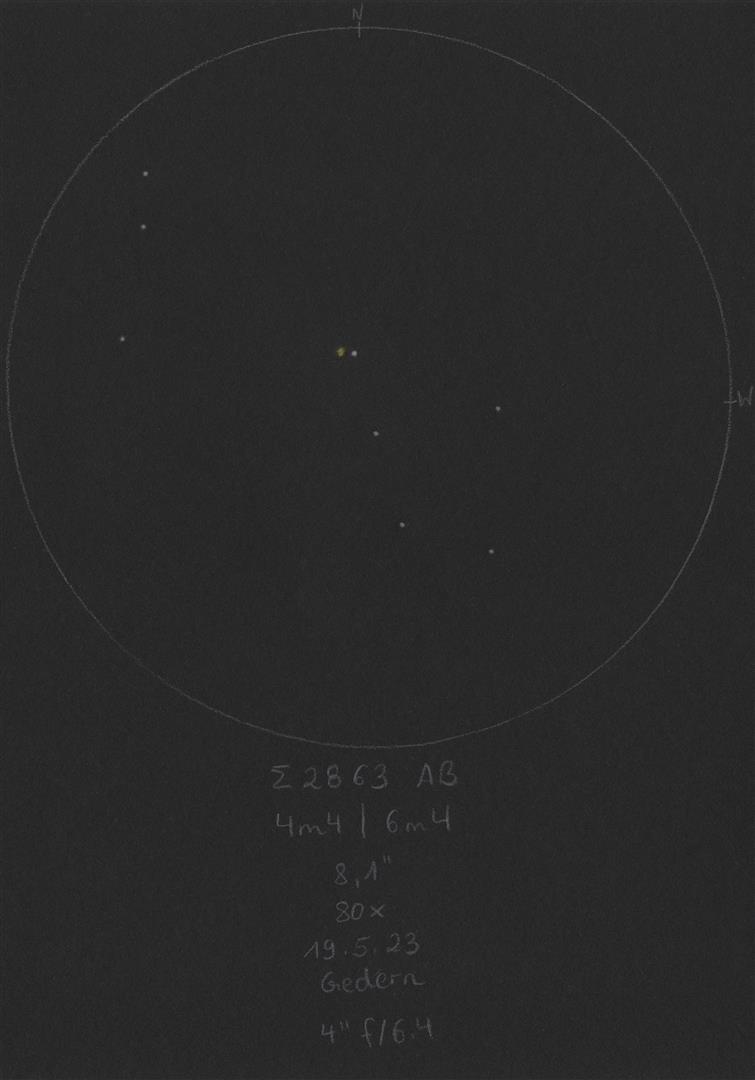
|
René Merting
Drachhausen (Germany) |
107mm (43x) |
bei 43x sind beide Komponenten dicht beieinander - B ist deutlich schwächer und kann sich nicht trennen vom großen Bruder - 60x reichen dann aber für eine knappe Trennung - Komponente A strahlt in einem schönen Gelbweiß, B schätze ich 2 Magnituden schwächer, aber immernoch hell genug, um weiß zu strahlen |
|
Mark McCarthy
Fremont (California/USA) |
203mm (205x) |
Alkurhah. Pretty very light yellow bright A star, and ~2 delta mag, very light orange B, wide. Physical pair with a 3800 year period |
|
René Merting
Drachhausen (Germany) |
320mm (45x) |
bei 45x sind beide Sterne noch dicht aneinander klebend zu erkennen, in guten Momenten gelingt aber auch schon die Trennung - A wirkt warmweiß, B ist gut 1.5 Magnituden schwächer und ist weiß |
|
|
|
|
BU696 |
|
AB |
8m.0 |
9m.6 |
0.2" |
174° |
2012 |
Peg |
22h04m30.12s / +15°51'28.60" |
|
|
Mark McCarthy
Fremont (California/USA) |
508mm (667x) |
At finest moments very clean clear split, round disks, 1.5 delta, PA just west of north, with two field stars forming a triangle. 160.3-year period, it is approaching apastron and will widen by 2050, currently 0.329". Burnham discovered in 1877 with the Dearborn 18.5-inch at 0.5" and says: "Obviously the movement of both stars is the same" |
|
|
|
★
|
COU537 |
|
|
8m.6 |
8m.8 |
0.2" |
328° |
2013 |
Peg |
22h07m40.20s / +26°21'35.80" |
|
|
Mark McCarthy
Fremont (California/USA) |
508mm (1067x) |
Suspected with 667x. Exceedingly difficult, it's an elongated rod pointed a particular way from the reference star in the field. At moments of best seeing I detect two brightened ends of that rod, not quite split, but can tell is double. PA is now to the north and this closely matches my sketch, however my sense of which is A and B is reversed. 47.3 year period, at apastron now, it will not be detectable after 2030 |
|
|
|
|
STF2872 |
|
A-BC |
7m.1 |
8m.0 |
22.0" |
315° |
2022 |
Cep |
22h08m36.04s / +59°17'22.20" |
|
|
|
|
AD |
7m.1 |
11m.8 |
117.3" |
153° |
2014 |
|
|
|
|
|
|
BC |
8m.0 |
8m.0 |
0.8" |
296° |
2018 |
|
|
|
|
René Merting
Drachhausen (Germany) |
15x56 |
A-BC: ich sehe zwei gleich helle Sterne ohne Farbkontrast, etwas mehr als knapp getrennt und isoliert stehend |
|
René Merting
Drachhausen (Germany) |
100mm (20x) |
A-BC: bei 32x einfach zu trennen, die B-Komponente im NW ist nur knapp schwächer - dezenter Farbunterschied, A leuchtet weiß-bläulich und BC weiß-gelblich - zurück auf 20x zeigt sich der Doppelstern weiter gut getrennt |
|
Frederik Wanink
Itterbeck (Germany) |
254mm (640x) |
BC: BC in ruhigen Momenten trennbar |
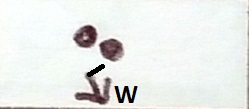
|
|
|
★
|
COU136 |
|
|
9m.2 |
7m.6 |
0.4" |
19° |
2015 |
Peg |
22h10m02.22s / +23°07'33.00" |
|
|
Mark McCarthy
Fremont (California/USA) |
508mm (1067x) |
Awesome hairline at 533x, nice clean split at 1067x. The stars are split the diffraction patters merge at the boarders, perfect images. Appears more near equal than SkyTools data suggests |
|
|
|
|
STF2881 |
|
|
7m.7 |
8m.2 |
1.3" |
76° |
2017 |
Peg |
22h14m34.67s / +29°34'20.60" |
|
|
Mark McCarthy
Fremont (California/USA) |
152mm (175x) |
Nice! Hairline at best moments, unequal <1 delta mag. Physical with a 1345-year period, it will very slowly widen |
|
Mark McCarthy
Fremont (California/USA) |
508mm (205x) |
Close white stars, ~1 delta mag, >1", nice |
|
|
|
|
BU1216 |
|
|
8m.6 |
9m.2 |
0.9" |
276° |
2017 |
Peg |
22h20m12.75s / +29°31'07.80" |
|
|
Mark McCarthy
Fremont (California/USA) |
508mm (333x) |
White stars, nicely split, noticeable delta mag. Physical with 503 year period. Discovered in 1890 with the 16-inch of the Warner Observatory at 0.6" |
|
|
|
|
33 Peg |
STF2900 |
AB |
6m.3 |
9m.2 |
1.0" |
1° |
2017 |
Peg |
22h23m39.56s / +20°50'54.00" |
|
|
|
STF2900 |
AC |
6m.3 |
8m.5 |
92.7" |
306° |
2015 |
|
|
|
|
|
COU139 |
CD |
8m.5 |
10m.7 |
0.3" |
88° |
2013 |
|
|
|
|
René Merting
Drachhausen (Germany) |
15x56 |
AC: leicht zu trennen - die B-Komponente ist mindestens 2.5 Magnituden schwächer - das Paar steht schön isoliert, beide Komponenten könnten bei der Vergrößerung ein wenig mehr zusammenstehen |
|
Mark McCarthy
Fremont (California/USA) |
508mm (533x) |
AB: 33 Peg. A is bright yellow and B is orange, close to 1" separation, very large delta mag. AB is physical with at 407 year period but will widen by 1" over the next 27 years |
|
Mark McCarthy
Fremont (California/USA) |
508mm (667x) |
CD: appears as a notched elongation at best moments all powers, though the clearest view is at 667x, noticeable magnitude difference. |
|
|
|
|
SHJ345, 53 Aqr |
|
AB |
6m.3 |
6m.4 |
1.3" |
98° |
2021 |
Aqr |
22h26m34.30s / -16°44'31.90" |
|
|
Frederik Wanink
Itterbeck (Germany) |
254mm (240x) |
länglich, horizontnah |
|
|
|
|
KR60, DO Cep, Kruger 60 |
|
AB |
9m.9 |
11m.4 |
2.1" |
207° |
2020 |
Cep |
22h27m59.20s / +57°41'43.80" |
|
|
Uwe Pilz
Leipzig (Germany) |
105mm (288x) |
Unsicher – nur des Positionswinkel wurde zwar blickweise erkannt, aber die Komponenten verwechselt. |
|
Robert Zebahl
Leipzig (Germany) |
152mm (150x) |
Bei Vergrößerungen zwischen 129x und 300x beobachtet. Die Luftruhe und Transparenz des Himmels (Bortle 6-) waren nur durchschnittlich. Die ziemlich schwache B-Komponente schien hin und wieder aufzublitzen. |
|
Robert Zebahl
Leipzig (Germany) |
152mm (150x) |
Das Seeing war eher durchschnittlich (3/5). Beobachtung unter Vorstadtbedingungen (Bortle 6, SQM-L 19.1). Anfangs bei 270x, später bei 300x beobachtet. Der extrem schwache Begleiter war bei ausreichend ruhiger Luft immer wieder an der selben Stelle zu erkennen. Schwierig aufgrund der geringen Helligkeit! |
|
Uwe Pilz
Leipzig (Germany) |
320mm (387x) |
äußerst schwierig, nur blickweise sichtbar |
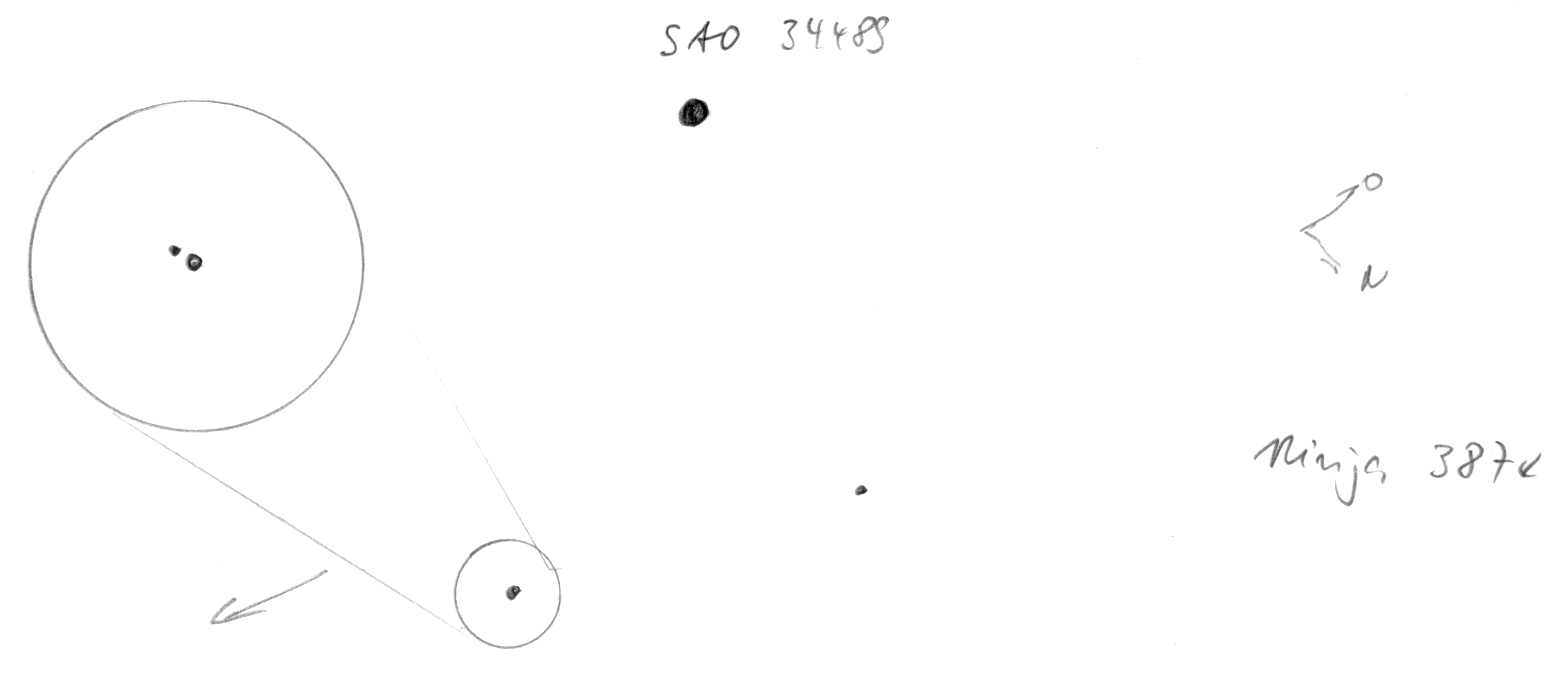
|
Mark McCarthy
Fremont (California/USA) |
508mm (205x) |
DO Cep. Easy pair, reddish B, lots of stars around including a near equal double to the WNW separated about 5". KR 60 will make a quarter turn in its orbit by 2035 |
|
|
|
|
BU701 |
|
AB |
7m.3 |
9m.6 |
1.1" |
179° |
2017 |
Peg |
22h28m07.24s / +12°14'55.50" |
|
|
|
|
AC |
7m.3 |
12m.0 |
126.7" |
133° |
2015 |
|
|
|
|
Mark McCarthy
Fremont (California/USA) |
152mm (175x) |
AB: Extremely fine, B appears with seeing on A's diffraction ring, ~1", a very fine point. Burnham discovered with 18.5-inch, at 1.24", and it has narrowed since then |
|
Mark McCarthy
Fremont (California/USA) |
317mm (513x) |
AC: very wide separated bluish star 2-3 delta mag. |
|
|
|
★★
|
STF2909, zet 2 Aqr |
|
AB |
4m.3 |
4m.5 |
2.4" |
157° |
2021 |
Aqr |
22h28m49.81s / -00°01'12.20" |
|
|
Sarah Gebauer
Germany |
100mm (80x) |
bei 80-fach blickweise getrennt, etwas unruhig, dennoch deutlich mit Einkerbung und leuchtet insgesamt schon buttergelb - bei 130-fach dann knapp und eindeutig getrennt, sehr buttrig gelb - die südliche der gleich hellen Komponenten wirkt minimal mehr orange - das sonstige Sternumfeld ist sehr leer, dadurch steht der DS sehr dominant im Bild |
|
Christopher Hay
Seeheim (Germany) |
180mm (120x) |
Sauber getrennt, wobei die ersten Beugungsringe beider Komponenten die Beugungsscheibchen der jeweils anderen Komponente berühren. Fast identische Helligkeiten der Komponenten. A nördlich scheint eine Spur gelblicher als B südlich zu sein.
Zeta Aqr heisst Sadaltager, was soviel wie „Händlerglück“ bedeutet. Umrahmt wird er von Pi, Gamma und Eta Aquarii, mit denen er ein auffälliges dreieckiges Sternmuster bildet, das auch als „Das Zelt“ bekannt ist. Er ist zudem ein echter physikalischer Doppelstern. Wegen dieser Situation und der schönen teleskopischen Erscheinung zwei Bewertungssterne vergeben. |
|
Frederik Wanink
Itterbeck (Germany) |
254mm (240x) |
einfach |
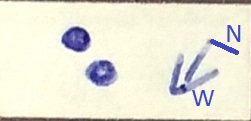
|
Mark McCarthy
Fremont (California/USA) |
317mm (277x) |
Very bright white, equal magnitude, fairly close ~2". |
|
|
|
|
HU981 |
|
|
7m.6 |
7m.9 |
0.3" |
215° |
2008 |
Cep |
22h30m32.63s / +61°37'25.60" |
|
|
Mark McCarthy
Fremont (California/USA) |
203mm (667x) |
Notched elongation with 33x & 667x. Slight mag difference. Need more aperture (934 year period, 0.29" now!) |
|
|
|
|
8 Lac |
CHR112 |
Aa-Ab |
5m.7 |
|
0.0" |
138° |
2020 |
Lac |
22h35m52.28s / +39°38'03.60" |
|
|
|
STF2922 |
AB |
5m.7 |
6m.3 |
22.5" |
186° |
2020 |
|
|
|
|
|
A1469 |
AC |
5m.7 |
10m.4 |
48.8" |
167° |
2016 |
|
|
|
|
|
A1469 |
AD |
5m.7 |
9m.1 |
81.6" |
145° |
2017 |
|
|
|
|
|
A1469 |
AE |
5m.7 |
7m.2 |
335.2" |
239° |
2016 |
|
|
|
|
|
DAL28 |
AG |
5m.7 |
14m.1 |
77.6" |
193° |
2015 |
|
|
|
|
|
COM8 |
BF |
6m.3 |
11m.0 |
127.6" |
175° |
2012 |
|
|
|
|
|
A1469 |
CD |
10m.4 |
9m.1 |
42.4" |
115° |
2016 |
|
|
|
|
|
A1469 |
DI |
9m.1 |
13m.3 |
10.0" |
227° |
2015 |
|
|
|
|
|
DAL28 |
GJ |
14m.1 |
13m.0 |
6.5" |
78° |
2016 |
|
|
|
|
René Merting
Drachhausen (Germany) |
100mm (32x) |
AB: bei 32x sind beide Komponenten gut getrennt sichtbar - B im Süden ist eine halbe Größenklasse schwächer
BC: bei 32x schimmert südöstlich von der Komponente B ein ganz schwacher Lichtpunkt, die Komponente C, durch - Komponenten BC mit gleichem Abstand wie AB
CD: interessant ist das Mehrfachsystem allemal, denn in doppelter Entfernung weiter südöstlich steht eine vierte Komponente D (eigene Bezeichnung: A1469, D mit Helligkeit 9.08 mag), so dass 4 Sterne problemlos mit dieser Öffnung zu erfassen sind |
|
|
|
|
BU1092 |
|
AB |
8m.3 |
8m.3 |
0.4" |
227° |
2018 |
Cep |
22h36m08.65s / +72°52'51.10" |
|
|
Mark McCarthy
Fremont (California/USA) |
152mm (245x) |
AB is a near equal snowman to 245x, power limited by average seeing. Wide 1 delta star, which is STTA AB-D, 7.56/8.42 42.2". Physical with a 48.93-year period, currently at apastron and will close rapidly by 2040. Burnham discovered with the 36-inch at 0.3" and later noted "The very recent measures of AB by Aitken with the 36-inch (power 1900) show decided change in angle and distance. It is probably in rapid motion." |
|
|
|
|
HO295 |
|
AB |
7m.5 |
8m.0 |
0.3" |
336° |
2016 |
Lac |
22h38m47.47s / +44°18'49.90" |
|
|
Mark McCarthy
Fremont (California/USA) |
508mm (1067x) |
Very subtly notched elongation, can tell B from A. Elongation suspected at 667x. One field star another just out of view. Short 30 year period, it will tighten rapidly and return to 0.3" in 2034 |
|
|
|
|
STF2934 |
|
|
8m.6 |
9m.6 |
1.4" |
55° |
2021 |
Peg |
22h41m51.68s / +21°25'53.00" |
|
|
Frederik Wanink
Itterbeck (Germany) |
254mm (640x) |
schwieriger wegen schwacher Sterne |
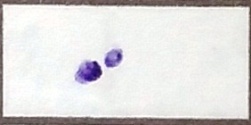
|
Mark McCarthy
Fremont (California/USA) |
508mm (533x) |
1.5 delta mag, well split, ~1.5", bluish white stars |
|
|
|
|
BU711 |
|
AB |
10m.2 |
11m.4 |
2.6" |
348° |
2020 |
Peg |
22h45m27.86s / +11°11'30.90" |
|
|
Mark McCarthy
Fremont (California/USA) |
508mm (205x) |
Very fine, ~1.5 delta mag, >1" separation, nice |
|
|
|
|
STF2944 |
|
AB |
7m.3 |
7m.7 |
1.8" |
309° |
2021 |
Aqr |
22h47m50.05s / -04°13'43.60" |
|
|
|
|
AC |
7m.3 |
8m.6 |
60.6" |
85° |
2017 |
|
|
|
|
|
|
AD |
7m.3 |
12m.9 |
220.3" |
348° |
2000 |
|
|
|
|
|
|
BC |
7m.7 |
8m.6 |
59.3" |
85° |
2013 |
|
|
|
|
René Merting
Drachhausen (Germany) |
15x56 |
AC: C steht gut abgesetzt im Osten von A und ist gut 1.5 Magnituden schwächer - A strahlt weiß, C eher grauweiß |
|
Mark McCarthy
Fremont (California/USA) |
317mm (277x) |
AB: Pretty close equal white pair, ~2.0", split. |
|
|
|
★
|
HU985 |
|
|
9m.6 |
9m.9 |
0.7" |
134° |
2016 |
Peg |
22h47m54.00s / +12°58'36.20" |
|
|
Mark McCarthy
Fremont (California/USA) |
508mm (533x) |
Wow I got it! Light orange star and a very faint star just outside first diffraction, very subtle and tough |
|
|
|
|
STF2950 |
|
AB |
6m.0 |
7m.1 |
1.1" |
272° |
2021 |
Cep |
22h51m22.51s / +61°41'47.90" |
|
|
Sarah Gebauer
Germany |
100mm (136x) |
bei 136x ist neben der Hauptkomponente etwas ganz Schwaches zu sehen, aber eher unsicher und nicht sauber getrennt, höhere Vergrößerung ist an diesem Abend nicht möglich |
|
Mark McCarthy
Fremont (California/USA) |
152mm (245x) |
Wonderful hair split with 175x, nice very clean at 245x. 2 delta mag, light yellow A and blue. WDS physical with a 817-year period, with 73% parallax range overlap, 102 AU weighted separation, 2.16/1.64 solar mass, for sure gravitationally bound. It will have a dramatic and rapid closure to periastron in the coming few years, down to 0.2", and one worth tracking |
|
Mark McCarthy
Fremont (California/USA) |
203mm (333x) |
Nice pair indeed. Bright yellow-white A and 2 delta mag B, clean split, ~2". May be third fainter much wider split (AC, 39.2" 11.05) |
|
Sarah Gebauer
Germany |
254mm (156x) |
bei 156-fach getrennt – die Hauptkomponente zeigt einen warmweißen Farbton, der Begleiter sehr dicht an ihr dran verschwindet fast, er ist bedeutend schwächer |
|
|
|
★★
|
HO482 |
|
AB |
7m.3 |
8m.3 |
0.6" |
13° |
2017 |
Peg |
22h51m26.66s / +26°23'27.90" |
|
|
Mark McCarthy
Fremont (California/USA) |
152mm (285x) |
Notched elongation, blue-green stars. 383-year period, missing data in EDR3 |
|
Mark McCarthy
Fremont (California/USA) |
508mm (533x) |
!! Excellent split, white stars, slight magnitude difference, really good. Physical with 383 year period |
|
|
|
|
BU382 |
|
AB |
6m.0 |
7m.8 |
0.7" |
244° |
2016 |
Lac |
22h53m40.16s / +44°44'57.10" |
|
|
Frederik Wanink
Itterbeck (Germany) |
254mm (640x) |
schwierig, Helligkeitsunterschied stark |

|
|
|
|
HU987 |
|
|
9m.2 |
9m.7 |
1.2" |
75° |
2021 |
Peg |
22h55m43.52s / +15°46'45.50" |
|
|
Mark McCarthy
Fremont (California/USA) |
508mm (533x) |
Well separated one delta mag pair, nice |
|
|
|
|
STF2957 |
|
AB |
9m.2 |
10m.9 |
4.6" |
224° |
2016 |
Peg |
22h56m23.64s / +17°27'08.60" |
|
|
Mark McCarthy
Fremont (California/USA) |
508mm (205x) |
Dull yellow stars, ~2 delta mag, wide |
|
|
|
|
STT483, 52 Peg |
|
|
6m.1 |
7m.3 |
0.4" |
31° |
2020 |
Peg |
22h59m11.82s / +11°43'43.80" |
|
|
Mark McCarthy
Fremont (California/USA) |
152mm (175x) |
52 Peg. Very slightly out of round, not notched, weaker at one end. 254-year period |
|
Mark McCarthy
Fremont (California/USA) |
152mm (285x) |
52 Peg. Snowman/notched but not split. I'll need the 20-inch for this one |
|
Mark McCarthy
Fremont (California/USA) |
508mm (333x) |
Elongation, very subtle notch. Physical with 249 year period |
|
|
|
★
|
BU180 |
|
AB |
8m.0 |
9m.2 |
0.5" |
134° |
2016 |
Cep |
23h07m09.99s / +60°49'57.10" |
|
|
Mark McCarthy
Fremont (California/USA) |
203mm (533x) |
Snowman through 533x. Just too much of a delta mag. Burnham discovered with his 6-inch at 0.57"! Physical, 537 year period |
|
Mark McCarthy
Fremont (California/USA) |
508mm (667x) |
Exceedingly fine split at best moments, hairline, 1 delta mag. |
|
|
|
|
STT489, pi Cep |
|
AB |
4m.6 |
6m.8 |
1.1" |
1° |
2020 |
Cep |
23h07m53.84s / +75°23'15.30" |
|
|
Mark McCarthy
Fremont (California/USA) |
152mm (380x) |
Pi Cep. Round star image only, though I have feelings of brightening in the diffraction, but it does not resolve. Physical with 556-year period |
|
Frederik Wanink
Itterbeck (Germany) |
254mm (640x) |
nicht als DS gesehen |
|
|
|
|
S825 |
|
AB |
7m.8 |
8m.3 |
67.7" |
318° |
2019 |
And |
23h10m02.57s / +36°50'53.90" |
Sarah Gebauer
Germany |
254mm (49x) |
bei 49-fach ein gleichfarbiges Paar aus fast gleich hellen Komponenten - die südöstliche erscheint minimal heller - beide tragen einen subtilen, warm gelborange Farbton ins Kupferfarbene gehend |
|
|
|
|
BU385 & HJ5532 & ARN25 |
BU385 |
AB |
7m.4 |
8m.2 |
0.7" |
84° |
2018 |
Peg |
23h10m17.15s / +32°29'13.40" |
|
|
|
HJ5532 |
AB-C |
7m.1 |
9m.4 |
57.9" |
77° |
2014 |
|
|
|
|
|
ARN25 |
AB-D |
7m.1 |
10m.3 |
223.9" |
117° |
2014 |
|
|
|
|
Mark McCarthy
Fremont (California/USA) |
152mm (175x) |
HJ5532 (AB-C): White A and very wide, 2 delta mag B. I did not notice that A is BU 385, 0.7" 7.44/8.23. WDS calls the HJ physical, however their parallax ranges do not overlap |
|
Frederik Wanink
Itterbeck (Germany) |
254mm (640x) |
BU385 (AB): in ruhigen Momenten getrennt |
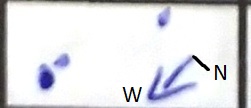
|
René Merting
Drachhausen (Germany) |
320mm (45x) |
HJ5532 (AB-C): bei 45x zeigt sich C bereits weit getrennt von AB und wirkt grau - Helligkeitsunterschied 1.5 Magnituden (tatsächlich sind es 2.33 mag), die Trennung von AB (Sep. 0,7") habe ich auch probiert, dann aber bei 240x aufgegeben, das Seeing war grottig |
|
|
|
|
STF2987 |
|
|
7m.4 |
10m.4 |
4.2" |
150° |
2017 |
And |
23h10m21.28s / +49°01'06.00" |
|
|
Mark McCarthy
Fremont (California/USA) |
203mm (205x) |
Nice white and blue-white pair, ~3 delta mag, wide ~4" |
|
|
|
★
|
STFB12 & BU1220, 91 Aqr, psi 1 Aqr |
STFB12 |
A-BC |
4m.4 |
9m.9 |
48.9" |
312° |
2014 |
Aqr |
23h15m53.50s / -09°05'15.90" |
|
|
|
BU1220 |
AD |
4m.4 |
13m.5 |
110.1" |
273° |
2008 |
|
|
|
|
|
BU1220 |
BC |
10m.5 |
10m.7 |
0.4" |
107° |
2021 |
|
|
|
|
|
BU1220 |
BC-E |
9m.9 |
14m.3 |
42.3" |
294° |
2008 |
|
|
|
|
Christopher Hay
Seeheim (Germany) |
30x80 |
A-BC: Sehr weit getrennt aber noch als zusammengehörig empfunden. BC ein einzelner feiner Lichtpunkt.
Attraktiv zusammen mit STF2993 im Gesichtsfeld von 1,6°. Psi1 Aqr und STF2993 stehen an Januarabenden auf gleicher Horizonthöhe, eine hübsche Konstellation. |
|
Sarah Gebauer
Germany |
100mm (49x) |
A-BC: 02.10.23: bei 21-fach als nordwestlichster der drei "Psi-Aquarii-Sterne" und gleich warmgold zu sehen - bei 49-fach taucht nordwestlich von der vor allem im Gegensatz zu Psi 2 und Psi 3 schön goldgelben A-Komponente mit weißem Farbtupfer mittig weit abgesetzt der ganz schwache, dunkelgraue Begleiter auf |
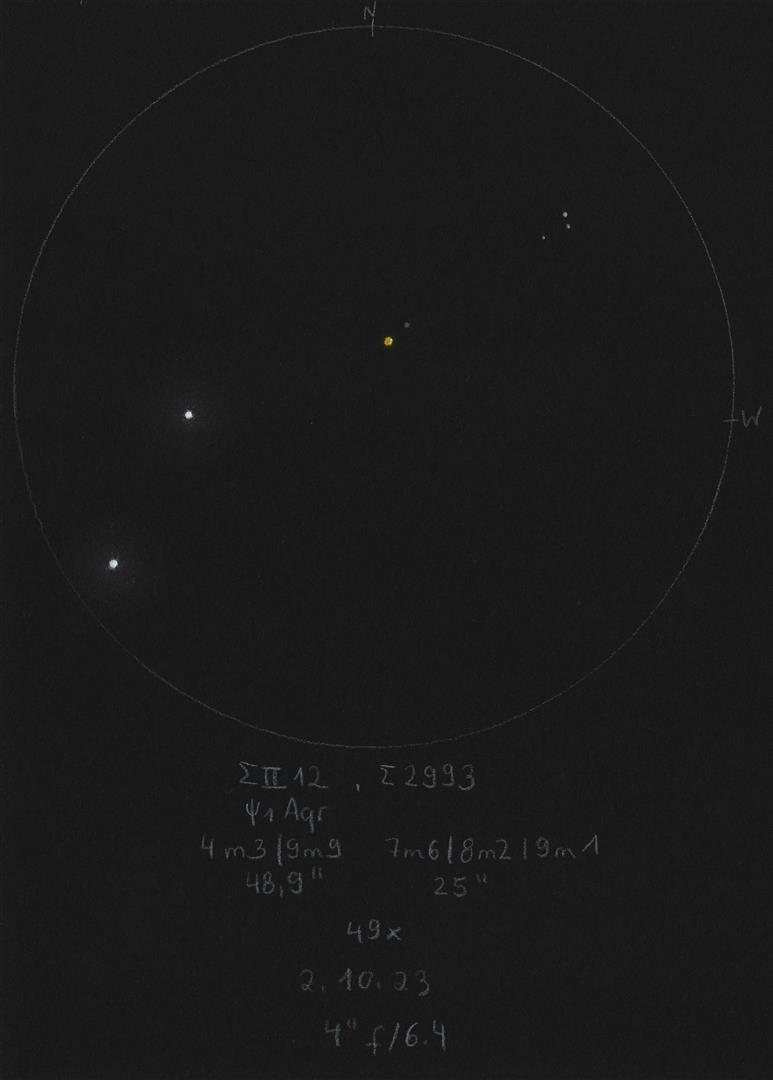
|
Christopher Hay
Seeheim (Germany) |
200mm (170x) |
A-BC: Laut Stelledoppie bilden A und BC ein physikalisches Paar, und B und C sind wieder ein enges physikalisches Paar, also ein echtes Dreifachsystem in 150 Lichtjahren Entfernung. Für die Trennung von A-BC reicht eigentlich eine kleinere Öffnung, aber mit 8 Zoll kommt der Farbkontrast von A zu BC heraus und das Paar dominiert das Sehfeld von 0,3°. Sehenswert, denn A ist zitronengelb, BC ziegelrot. |
|
|
|
|
STF3001, omicron Cep |
|
AB |
5m.0 |
7m.3 |
3.4" |
223° |
2020 |
Cep |
23h18m37.41s / +68°06'41.10" |
|
|
|
|
AC |
5m.0 |
12m.9 |
44.0" |
356° |
2012 |
|
|
|
|
Sarah Gebauer
Germany |
100mm (80x) |
26.09.23: bei 80-fach gerade so getrennt zu sehen, der Doppelstern zeigt einen besonders warmen Farbton - die nördliche, hellere Komponente strahlt sehr orange und wertet sich mit einem weiß getupften Sternzentrum auf, der Begleiter im Süden erscheint wie eine kleinere Schneemannkugel und weißlicher |
|
Mark McCarthy
Fremont (California/USA) |
152mm (175x) |
AB: Bright orange A seems out of round [this is AB]. 2 delta mag bluish C, well separated. Physical with a 2198-year period, B is slowly coming off periastron. 88% parallax range overlap, 204 AU weighted separation, 2.60/1.46 solar mass |
|
Mark McCarthy
Fremont (California/USA) |
203mm (205x) |
AB: A is bright yellow, B dull yellow, ~3 delta mag and ~3 separation, a striking pair. Physical, 1505 year period |
|
|
|
|
HEI88 |
|
|
9m.1 |
9m.8 |
0.2" |
211° |
2020 |
Peg |
23h20m52.91s / +16°42'39.20" |
|
|
Mark McCarthy
Fremont (California/USA) |
508mm (889x) |
Difficult observation and my notes are a very simple "Maybe?" showing a PA to the SSW. This turns out to be correct! 35.46-year period, near apastron now, it will widen and turn slightly north to a more westerly PA by 2030. Currently 0.256" |
|
|
|
|
STF3007 |
|
AB |
6m.7 |
9m.8 |
5.5" |
92° |
2017 |
Peg |
23h22m48.67s / +20°33'32.20" |
|
|
|
|
AC |
6m.7 |
10m.9 |
103.8" |
305° |
2017 |
|
|
|
|
René Merting
Drachhausen (Germany) |
100mm (64x) |
AB: bei 64x ist Komponente B ganz schwach östlich von A knapp getrennt zu erkennen - ein riesiger Helligkeitsunterschied von 3.5 Größenklassen |
|
Mark McCarthy
Fremont (California/USA) |
508mm (533x) |
AB: Yellow-white A and a bit orange B, ~6" and three delta mag, nice pair [Ba,Bb is TOK 704, 8.4 and 0.8", should have been noticeable! try again!] |
|
|
|
|
BU1266 & STF3018 & LV25 |
BU1266 |
AB |
8m.3 |
8m.1 |
0.2" |
193° |
2011 |
Peg |
23h30m26.29s / +30°49'54.60" |
|
|
|
STF3018 |
AB-C |
7m.4 |
9m.8 |
18.8" |
202° |
2015 |
|
|
|
|
|
LV25 |
AB-D |
7m.4 |
13m.8 |
39.0" |
355° |
2015 |
|
|
|
|
René Merting
Drachhausen (Germany) |
76mm (29x) |
STF3018 (AB-C): bei 29x ein sehr ungleiches Paar - C zeigt sich südwestlich von AB mit ordentlich Abstand und wirkt sehr schwach, Helligkeitsunterschied bestimmt 3 Größenklassen (2.32 lt. Stelle Doppie) - dadurch wirkt C farblos ggü. der weiß strahlenden AB-Komponente |
|
Mark McCarthy
Fremont (California/USA) |
152mm (175x) |
STF3018 (AB-C): Light orange stars, 1 delta mag, wide. Spectral class F7V (yellow-white). AB is BU 1266, 0.2" 8.35/8.14. WDS says proper motion indicates physical, and unfortunately there is no parallax data for the primary |
|
Mark McCarthy
Fremont (California/USA) |
508mm (533x) |
BU1266 (AB): Very subtle elongation, seen as merely a bump on one side. Very tough. Light orange stars. My estimated PA is 90-degrees off. 48.4 year period, now nearing periastron, it will get a little easier, and make a quarter turn by 2037 |
|
|
|
★
|
72 Peg, BU720 |
|
|
5m.7 |
6m.1 |
0.6" |
106° |
2018 |
Peg |
23h33m57.19s / +31°19'31.00" |
|
|
Uwe Pilz
Leipzig (Germany) |
120mm (250x) |
gelb und orange |
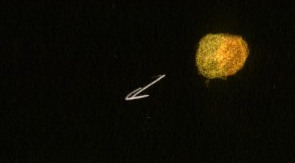
|
Mark McCarthy
Fremont (California/USA) |
152mm (175x) |
Light orange, probably elongated, but seeing is too poor to resolve. Physical with a 492 year period. Spectral class K4IIIb (yellow-orange) |
|
Frederik Wanink
Itterbeck (Germany) |
254mm (640x) |
als 8 zu sehen |
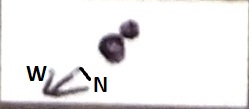
|
Mark McCarthy
Fremont (California/USA) |
317mm (553x) |
72 Peg. Small, hard, faint point very tight to A, but split. Stays with seeing. |
|
|
|
|
STT500 |
|
AB |
6m.1 |
7m.4 |
0.5" |
20° |
2018 |
And |
23h37m32.03s / +44°25'44.50" |
|
|
Mark McCarthy
Fremont (California/USA) |
152mm (175x) |
White A obviously not round at 175-245x, elongated at 380x. Physical with a 351-year period. No parallax data on the primary |
|
Mark McCarthy
Fremont (California/USA) |
317mm (553x) |
Disk seems not round, but unsure |
|
|
|
|
BU858 |
|
AB |
7m.8 |
8m.8 |
0.8" |
220° |
2018 |
Peg |
23h41m17.56s / +32°33'39.90" |
|
|
Mark McCarthy
Fremont (California/USA) |
152mm (175x) |
White star, not round. Physical with a 779-year period, but no data for the secondary. Burnham discovered at 1.1" with the 18.5-inch Dearborn refractor and said: "A more difficult pair than the distance and magnitude would indicate." |
|
|
|
|
STT507 & FOX278 |
STT507 |
AB |
6m.8 |
7m.8 |
0.7" |
323° |
2018 |
Cas |
23h48m39.03s / +64°52'35.30" |
|
|
|
STT507 |
AC |
6m.8 |
8m.4 |
50.6" |
350° |
2018 |
|
|
|
|
|
FOX278 |
AD |
6m.8 |
13m.0 |
47.0" |
107° |
2015 |
|
|
|
|
René Merting
Drachhausen (Germany) |
76mm (29x) |
STT507 (AC): bei 29x zeigen dich beide Komponenten weit getrennt - A strahlt weiß, B im Norden wirkt kupfergrau und ist 2 Größenklassen schwächer |
|
Mark McCarthy
Fremont (California/USA) |
203mm (333x) |
STT507 (AB): Snowman at 205x, hairline split with 333x, A is a soft white and B is light blue, ~1 delta mag. Physical with 565 year period |
|
Frederik Wanink
Itterbeck (Germany) |
254mm (640x) |
STT507 (AB): eindeutig zu trennen, 3er System |

|
|
|
|
STT510 |
|
AB |
7m.9 |
8m.4 |
0.6" |
119° |
2018 |
And |
23h51m33.03s / +42°04'57.70" |
|
|
Frederik Wanink
Itterbeck (Germany) |
254mm (640x) |
3er System, gerade getrennt zu sehen |
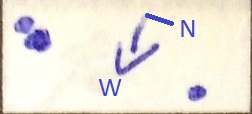
|
|
|
★
|
STF3050 |
|
AB |
6m.5 |
6m.7 |
2.5" |
343° |
2021 |
And |
23h59m29.33s / +33°43'26.90" |
|
|
Robert Zebahl
Leipzig (Germany) |
55mm (83x) |
Bei 83x als '8' erkennbar. Bei 100x bis 166x als '8', zeitweise mit Zwischenraum sichtbar. |
|
Robert Zebahl
Leipzig (Germany) |
70mm (100x) |
Wunderschöner Doppelstern. Gut zu trennen bei leichter Helligkeitsdifferenz. |
|
René Merting
Drachhausen (Germany) |
76mm (95x) |
bei 57x deutet sich an, dass es sich um einen Doppelstern handeln könnte - bei 95x zeigt sich dann ein extrem knapp getrenntes Pärchen - beide Sterne sind gleich hell |
|
Sarah Gebauer
Germany |
100mm (136x) |
ui, schön! Ein sehr enges Pärchen, bei 136x ganz knapp getrennt, zwei winzig kleine, gleich helle Äuglein nebeneinander |
|
Frederik Wanink
Itterbeck (Germany) |
254mm (640x) |
einfaches Paar, gleich hell |
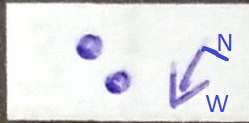
|
Mark McCarthy
Fremont (California/USA) |
317mm (277x) |
Nice near equal yellow-white, ~3" |
|
|
